Warmachine by Mors Rattus
Warmachine Prime Mk. II
Original SA post Warmachine Prime Mk. II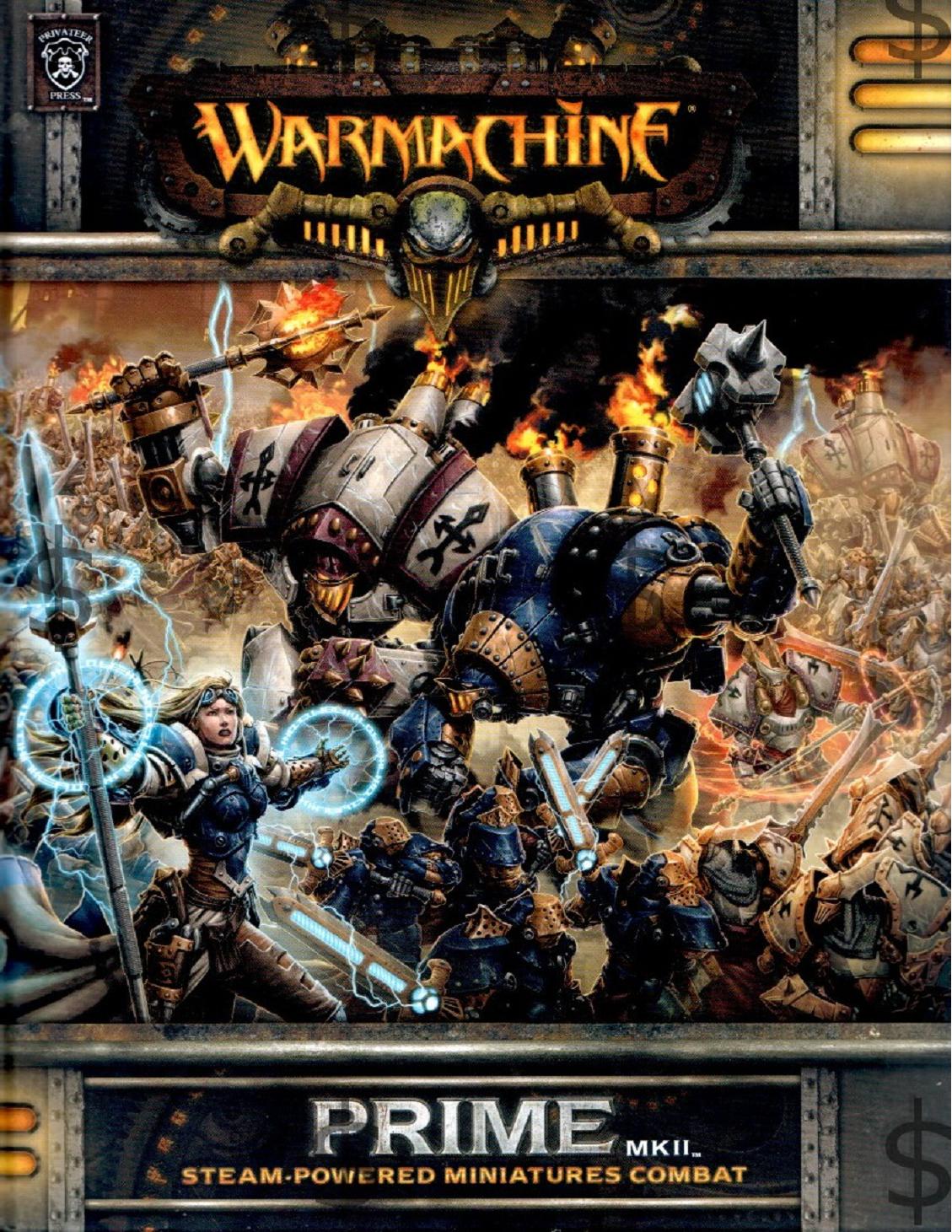
Warmachine Prime Mk. II is the core for the second addition of Warmachine. It changed up rules, but for the moment it still used their rather unfortunate slogan, Play like you've got a pair. That changed later after some people criticized it as kind of misogynistic. Anyway, this is the half of Warmachine/Hordes that is all about technology and giant robots duking it out. I prefer Hordes because I like monsters better, but what can you do? We open up with some IC discussion of history by Rhupert Carvolo, an Ordic mercenary also known as the Piper of Sorrows. He is a tarveler with no real home, but he loves to write about all of the lands he visits in the realm of Caen, the name of the world, though he has mostly traveled the part known as western Immoren, which is where Warmachine tends to focus. In the north is frozen Khador, which recently declared itself an empire. The Khadorans have a long tradition of war and conquest, so this isn't a huge change. To the east of Khador, in the high mountains, is Rhul, the nation of dwarves, which predates all human civilizations. Politically, the Rhulic seem to be highly internal and uninterested in war, but recently several Rhulic mercenaries and adventurers have been seen on the battlefield.
In the west is the small kingdom of Ord, hardy and tough but covered in foggy moors and hills and not much in the way of resources. The Ordic people primarily make their money in shopping and sea travel. To the northeast of Ord was once the rich land of Llael, famous for wine and merchants, but recently fallen to Khador conquest and turned itno a battlefield between Khador, KCygnar and Menoth. Some Llaelese resistance fight against these occupiers, though, in hopes of freedom. East of Llael is Ios, the elven land. The Iosans are even more insular than the Rhulfolk, and rarely seen outside their very strong borders, but some say their soldiers are beginning to march, and they have a great reputation for skill.
To the south is the mighty kingdom of Cygnar, the traditional and hated foe of Khador. It is a large, rich kingdom and has the largest population and one of the strongest armies in Immoren, holding the entire southern peninsula and the largest stretch of shoreline. Its navy is nothing to sneeze at, either, though a lot of its land is full of the Wyrmwall mountains, never yet tamed. The Cygnarans are diverse and educated, but their leadership tend to become distracted by internal arguments and so they don't always commit very well. They are also surrounded by enemies and have been for years, fighting on all sides against Khador, Menoth and Cryx, and now dealing with the Bloodstone Marches, once a wasteland, that has begun to brim with a hostile race known as the skorne.
Cryx stands apart from the other nations - it is barely a nation, really, lying southwest of Cygnar in the swampy Scharde Islands. It is overrun by immortal, unimaginably potent undead creatures, who rule over the mortal islanders. The dead walk among the living, and the land itself is tainted by the islands' ruler, a dragon who is worshipped as a god. Many of the people of Cryx become pirates and raiders, stealing from other lands and even sending armies onto the mainland these days. For some reason the author skips mentioning the Protectorate of Menoth in favor of jumping to ancient history.
He talks about his time in Caspia, the Cty of Walls in Cygnar, one of the few places he still feels safe. Caspia has seen many, many wars, but even before that there was history. Once, he says, the Creator, Menoth, made humanity, and for an age it wandered in savage tribes without recorded history, for Menoth wanted to test the strength of man. After a time, they came together and formed civilizations. The first priests rose, chosen by Menoth to give forth law. Menoth is the first and eldest god, the Shaper of Man. It is a fact, as real as anmything, that Menoth once walked the lands of Caen, that his priests shaped the earliest villages. The city of Caspia was once Calacia, home to the priest-king Golivant, who built the great wall against the Molgur tribes and brought the first true order. This, the Warlord Era, was a time of endless battles, to test and strengthen the people.
It was in Caspia that the Twins were born, originally mortals, but they transcended their flesh and became gods. Morrow and his isster Thamar, bright and dark, but they were joined in destiny. Morrow taught that there was more to life than battle and law. He claimed that a good man must think of others first. Thousands followed his teachings, looking inward for answers. He claimed that to live a good life, you must have the will to protect others, to fight injustice and to act honorably even in war. Morrow was a warrior-philosopher unlike any other, and even the priests of Menoth could not contain his ideas. His sister, Thamar, was as selfish as he was not, fascinated by the dark powers. She felt that true power was boundless, given from the strength to exert your will over others. She taught that morality was the prison of truth and freedom, seeking occult lore and dark secrets in pursuit of power. She ascended by freeing her mind from all shackles of conscience, becoming the goddess of temptation, indulgence and deception. This marked the start of the Thousand Cities Era, when the Twins ascended to Urcaen, the land of gods and the dead.
Western Immoren fractured into city-states, each led by a warlord or king, with treaties and alliances lasting only long enough to raise an army. The wars of man extended to face the trollkin and ogrun tribes, and into the ancient lands of the Rhulic dwarves and Iosan elves, who pushed back just as fiercely, though they did not try to conquer in turn. The kingdoms began to expand and consolidate. Caspia grew, Thuria rose and was consumed by Tordor, and the Midlands unified. The Khardic Empire stretched from the north to absorb the Kos, Skirov, Umbrean and Ryn peoples. Caspia underwent a renaissance of reason, and the Khardic engineers invented the steam engine. However, it was cut short. Eight centuries ago, black ships landed on the shores: the Orgoth had arrived.
The Orgoth hungered for death and slavery. They were human, but crueler and more manipulative than any humans of past centuries. The warlords of Immoren understood goals, codes and honor. The ORgoth were cruel beyond measure. Orgoth sank the navies of Tordor, spawning the Sea of a Thousand Souls, and they spilled onto the continent. The Thousand Cities united, but they were unable to stop the invasion. The Orgoth used infernal magic and terrible wqeapons. Menites and Morrowans alike called on the gods for aid, but it was not enough. The Orgoth subjugated Immoren, enslaving the land and defeating all armies, conquering every city by Caspia. For 400 years, the Orgoth ruled over Immoren. The eventual revolt was long and terrible, spanning two full centuries before it succeeded. And it could not have succeeded without Thamar, who gave humanity the Gift: sorcery. Before then, miracles had been the sole province of gods and those priests they chose to directly empower. The magic of the Gift of Thamar was more than that - the power to manipulate natural law solely by the will. It would be cventuries before anyone truly understood that power, if they really do, but it was a potent weapon for the Rebellion.
Alchemy and the first guns were developed by the survivors of the Battle of the Hundred Wizards, but even that was not enough to tear down the Orgoth, who had their own wicked weapons and vicious warwitches. No - it was te development of mechanika, coupling engineering and magic, which provided the key to vicotry. The early workers built the first colossal - a fifty foot tall war-construct of gears and iron. It could not be done, though, without the aid of the Rhul, who admired humanity's resourcefulness. They had never fallen to the Orgoth, having failed to capture the great fortress Horgenhold, and so had ignored the Rhulfolk and left them to their mountains. Rhul did not send soldiers, but iron, steel and mechanical knowledge, allowing the colossals to be built. They were towering constructs wielding weapons even the gods would envy, but they relied on the control of those few warcasters who could master them. Shortly after the first was built, some wizards awakened to their potential communicate mentally with the cerebral matrices that served as the artificial minds of the colossals, guiding them in battle. This sharing of minds was something even the Orgoth could not match, and over the next few years, their fortresses fell, one by one. The Orgoth fled to the sea, razing cities, poisoning wells and salted the earth as they went, in a campaign remembered now as the Scourge.
After the defeat of the Orgoth, the leaders of the victorious armies, known as the Council of Ten, met in Corvis, the Cygnaran City of Ghosts. They prepared a map of the new Iron Kingdoms, negotiating and devising the Corvis Treaties, which drew the borders of the kingdoms of Cygnar, Khador, ORd and Llael. Briefly, there was a time of peace, but it was not long before they were once more at each other's throats. The author recalls the Day of Markus, when he always tries to return to the city of Madfast. Khador attacked that Ordic city in the year 305 AR, and the soldier Markus ascended to join Morrow, sacrificing his life to buy time for reinforcements to arrive and proving that the few can defend against the many if they have courage. The author despises Khador, but he favors truth more, and attempts to keep his hatred to a minimum in his writings.
The people of Khador are tough, proud and have endured much. They remember the ancient days, when strength and cruelty were all that kept them alive. They have ancient customs from the times of the barbaric horselords of the Khardic Empire and their Menite priests. They took to Morrow's message later and only in part - they liked his advice on nobility in battle, but not his condemnation of aggression. For five months each year, Khador is frozen solid. Only a harsh people could have survived, and the Khadorans are nothing if not harsh and strong, using immense warjacks and soldiers armed to the teeth. Their soldiers have always been conscripts - every adult male and any woman who wants to and is not pregnant serves at least one tour of duty. They are skilled with mechanika, nearly as much so as Cygnar, and are primarily Morrowan, but not the overhwleming majority that faith has in Cygnar, Ord and Llael. The Menite faith is stronger in Khador than anywhere outside the Protectorate. However, all Khadorans, Menite or Morrowan, love their ruler above all else. They are patriots, and that is why so many outsiders find them so obnoxious.
Khador has never liked the compromises of the Corvis Treaties, longing for the glory days of the old Khardic Empire. Every generation, a new rulers takes the throne and decides it's time to reclaim 'stolen' lands. The Kossites and Skirov no longer remmeber their own kingdoms, only their service to the Khards, and the Khadorans are all devoted to the rebirth of their empire. Recent events have proven that they have the power to do it, too. After the occupation of Llael, Queen Aya Vanar named herself Empress of the Khadoran Empire, to the great approval of her subjects. She is likely to be unsatisfied until all of Immoren bows to her, and their conquest of Llael has been followed by war against Cygnar.
Next time: Ord, Llael and Cygnar.
Warmachine Prime Mk. II
Original SA post Warmachine Prime Mk. IIOrd, according to our author, is a tough nation which holds a solid and powerful core. It has little in the way of resources, to be sure, but it is a sailor's paradise, home to the best sailors in the world. Its army is not nearly so powerful, but its people are tough and courageous. They just lack, you know, modern weapons and engineering. Khador has come after them several times, but they've never fallen. Not like Llael did, anyway. Llael's great advantage, its sharing of borders with four kingdoms and its easy trade due to a lack of natural barriers, was also its weakness - it was easy for armies to move in. Llael was a land of merchants, serving as middlemen for all kinds of trade routes, but it was always a lucrative target. Cygnar allied with Llael three centuries back, and with that protection, Llael survived Khador's assaults...until 604 AR, when it was finally overrun. Though Ord was no friend of Llael, their fall has driven the Ordic people to a harsh and defensive mindset, fully aware of how vulnerable they really are now.
Cygnar was the strongest and wealthiest nation after the Corvis Treaties, uniting the peoples of Caspia, the Midlands, Thuria and the Morridanes of the Thornwood, who descend fro mthe Morrdh. Cygnar is rich in resources - all kinds of resources - and often did not appreciate how much it truly had. It is on the cutting edge of technology, alchemy and particularly mechanikal engineering, with inventive and potent warjacks trained in the finest military academy in the world. They have bordered all four of the other nations, and until the Cygnaran Civil War they controlled the Bloodstone Marches. After the war, that land was used for the establishment of the Protectorate of Menoth, the newest of the Iron Kingdoms. The Cygnarans helped to defend Llalel, but proved unable to, and the loss of the Thornwood to Khador has seperated them from their Llaelese border.
Cygnar, to the author, is preferable to Khador, but believes they are too eager to shove their head where it doesn't belong, and that their rivalry with Khador may set Immoren aflame, especially if both powers do not turn to focus on Cryx or keeping the Protectorate in check. Cygnar has recently endured much upheavel, as Leta Raelthorne ousted his tyrant brother, King Vinter IV, who managed to escape before trial, only to reappear from the Bloodstone Marches after nearly a decade, armed with strange and inhuman allies, the skorne. Since his return, these invaders have been a constant peril in the east, and even tried to seize Corvis in 603 AR. Leto has suffered quite a bit. Still, even diminished by the loss of Llael and the Thornwood, Cygnar is one of the mightiest powers of the region. They have suffered invasion of their capital by the Menites, but drove them out. Their borders have been compromised, but they remain ready to fight and die. They are stubborn beyond measure, and Khador may have underestimated them.
So, what of the Protectorate of Menoth? They distrust outsiders, especially in the city of Sul, for all parts of their life are full of religious ritual. For years, scholars and politicians have pretended they were not a true nation due to the agreements after the cygnaran Civil War leaving them technically beholden to the Cygnaran crown. Gowever, time has proven those obligations to be a farce, and it's clear that the Protectorate of Menoth is a nation of its own, outlasting Llael and gaining great power. The capital of Caspia was divided after the War, with the eastern portion becoming Sul, then capital of the Protectorate. And that was a keg waiting to go off, to be sure. Sul-Menites are a strict religious group, believing that endless punishment awaits them if they do not obey the True Law. The terror of the clergy is instilled from an early age, and the people are taught to obey without question, to expect pain for any doubt. Nowhere but in Menoth are the priests obeyed so completely, as in the days of old. The Menite faith has been in slow decline for centuries, perhaps due to its harshness, and it was clear the ruling priests wanted some means to rise back to prominence.
The spark came with the mergence of the Harbinger, a young woman from the fringe of the Protectorate who bears clear signs of miraculous divine contact - most notably, her feet will not touch the unclearn earth, and some say she communes directly with Menoth and speaks his words. There has always been the threat of violence between the Protectorate and Cygnar, but it only erupted into war after the fall of Llael. The leadership of Menoth took advantage of Cygnar's distraction to launch their great crusade, and the Harbinger's support of that campaign has driven the Sul-Menites to terrifying fervor and willingness to die for their cause. The violence has escalated even beyond the old Civil War. The Protectorate besieged Caspia in 605 AR but were repulsed, and Sul itself was breached. After a year of city fighting, the Protectorate drove Cygnar back and invaded Caspia, marching on Castle Raelthorne. Cygnar narrowly defeated them, and for a time the war was quieted, but that could change at any time. The war in Caspia and Sul is satelmated, but elsewhere, the Protectorate has been growing stronger, seizing Llaelese lands from Khador, including the fortress-city Leryn, a center of alchemical study and production. While the Protectorate is young, its divine favor gives it an unpredictable strength.
But it is not the only danger. The Scharde island, now the heart of Cryx, is there as well. From it come the undying hordes and necromechanikal constructs of that terrifying nation. The Nightmare Empire is made of the Scharde Islands off the Broken Coast of southern Cygnar. Their capital is the city of Skell, a terrifying place where, sixteen centuries ago, the dragon Lord Turuk landed and claimed those islands. Turuk is the unquestioned ruler of Cryx, the father of all dragons, who has laid entire towns to waste. Cryxian raiders sail forth to hunt for plunder and blood, armed with terrifying bonejacks and helljacks. They enslave many, and then turn them into undead thralls, fusing them with mechanika or using their souls to feed the appetites of the Dragonfather's liches. The army of Cryx only grows with every victory. Their strength has long been underestimated, as for centuries their attacks were random and isolated pirate strikes. However, as war has erupted elsewhere, Cryx has begun striking even at those areas once believed safe. Cryxian soldiers nad necromancers have been seen deep in the mianland, emerging after the Llaelese conflict. No one knows what they want, but they clearly have interest in the politics of men and their wars. Maybe all they want is carnage, and they certainly have the tools for that, but perhaps what they want is even more terrifying.
The Iron Kingdoms, technically, refer only to those of the Corvis Treaties and the Protectorate of Menoth, but in practice the term aslo refers to all of the adjoining lands as well. Ios, the eleven kingdom, lies in avast vallery between great mountain ranges that prevent the encroachment of the Bloodstone Marches. Even in friendlier times, no one truly understood the Iosans, for they seldom took visitors or conducted trade. Their borders have been utterly sealed for the entirety of the author's adult life, and he has never been there - those who violate the border do not return. Little is known of Iosan history, but it's said that they have potent magic and their own unique mechanika, quite unlike those of humans or the Rhulfolk. At one time, the Iosans sent ambassadors, but even then they went veiled, o hide their faces. The Rhulfolk say that in ancient times, Ios was uninhabited, and the Iosans have claimed to have traveled there from further east after some catastrophic upheaval that even the Rhul remember only as fire and smoke covering the eastern horizon. There has been death quite close to the Iosan border these days.
Rhul, on the other hand, is a mountain nation ruled by a council of clan lords. On top of dwarves, it is also populated by a lot of towering ogrun with whom the Rhulfolk have long been allies. The dwarves of Rhul are an honorable people with a culture that has changed little over millenia. They are masters of stone, but have also erected immense castles, halls and towers. The Rhulfolk trace their heritage back to thirteen founding clans, and worship the clanfathers as gods. The Rhulfolk obey the Codex, a holy text and a summary of their complex laws. Unlike the Iosans, the Rhulfolk enjoy the company of humans. They defend themselves fiercely against intrusion, but trade vast quantities of metal and manufactured goods to Khador and Cygnar in exchange for wood, food and other things hard to get in the mountains. The Iosans are rare in human lands, but the Rhulfolk are widley accepted as valuable members of any community. The recent wars have seen a larger number of armed Rhulic warriors turning to a life as mercenaries. They seem to enjoy fighting - not for any cause, just a genuine satisfaction with a battle well fought. Their long stability seems to make them vew war as a kind of entertaining diversion.
The Bloodstone Marches have long been a wasteland, where practically no one has ever survived. The howling winds and the terrible beasts are one thing, but there are also the Stormlands, plagued by constant lightning and thunder. Other than the Protectorate's current capital of Imer, the only human settlement near the Marches is a small collection of shacks and hovels known as Ternon Crag, where miners hunt for gold and coal in constant danger. After the Lion's Coup of 594 AR, Vinter Raelthorne IV fled his capital in an imperfect balloon intended to fly high over the ground. It was believed he died on that unlikely and ridiculous contraption, as no one has ever made it across the wastes alive. However, he returnex inexplicably in 603 AR, allied with the skorne. Little is known of the skorne save that they are potent and cruel warriors, armed with great beasts and strange weapons of their own invention. They have yet to pierce the Cygnaran border, but not for lack of trying, having built fortresses just east of the Black River, on land that humans assumed could not be settled. The skorne seem to be doing just fine. They are hardly the only dangers from the wilderness, though. Strange horrors have emerged from the northern mountains of Khador, unexplainable beasts alongside twisted and deformed warriors, all bent on slaughter.
Violence has also erupted among the trollkin kriels, once peacefully settled in the untamed regions. Now, they harass trade routes and train lines in cygnar, Khador and even Ord. Some claim that the Cygnarans have been using the trollkin as a buffer against the skorne, but it doesn't seem to matter if that's true - the cygnarans recently faced the trollkin in a series of bloody battles with great casualties on both sides. And if that weren't bad enough, an ominous group of mystics, the Blackclads, have been seen on the move with well-armed bands, guarded by wild beasts. The world seems on the brink of disaster, and all must choose a side now - better to fall in battle than to waste away.
That brings us to the rules of play. It's a wargame, so it can get pretty complex, and the rules aren't really what I'm trying to sell you. I'm trying to sell you the setting. So I'm going to, instead, bring up rules only as and when I feel they'll enhance our understanding of things. Suffice to say that I think it's a good wargame and you should play it. I will, however, note the two special kinds of unit in the Warmachine armies: warjacks and warcasters. Warcasters are your army leaders and commanders of the warjacks, the giant robot death machines. Warcasters are all wizards of various types, able to give orders to nearby warjacks and cast spells and use a Feat once per battle that usually is some really potent effect that can turn the tide of a match. Warjacks are bigass giant robots. They are tough and often hard to damage, but also rather slow. If they have hands, they can pick up and hurl things around or headlock other robots, but often they don't actually have hands to use for that. Unlike any other unit, they have a Damage Grid - they take damage to a randomized location, and when a location is damaged enough it can shut down parts of their body, like an arm or, if you're real lucky, their cortex, rendering them a giant pile of useless metal.
Certain warcasters also have Theme Forces - armies that limit what you can deploy, but the more limits you obey, the more benefits they get. These often show how a character's strategy is meant to be. There are also mercenary warcasters and warjacks, usable only in full mercenary armies or when you have enough of a force to bring along multiple warcasters.
Cygnaran armies focus on their ability to deliver lots of ranged damage - they're masters at rifles and cannons as well as combined-arms tactics and the use of electricity. They have some of the most advanced warjacks in the world. The Protectorate, on the other hand, are somewhat lacking in sophsitication but have huge numbers as they can call on their entire population for war, and also have a ton of protective spells and ways to deny their foes' strengths, nullifying magic and also setting people on fire. Khador focuses pretty much entirely on giant-ass heavy warjacks and regged reliability, favoring brute force to speed or mobility. They are extremely tough and often call on the powers of ice and wind as well as potent artillery. Cryx are the corrupting forces of Draglond Toruk, specializing in speed and exploiting the weaknesses of others, as well as sacrificing their own. They can field lots of troops, even creating new ones mid-battle, and excel at weakning foes and taking advantage of that weakness with corrosion and corruption.
While not covered much in this book, Ios is backed by the once-outlawed sect known as the Retribution of Syrah, who believe that they can save their dying god, Scyrah, by eliminating human magic, and they wield mighty myrmidons, a kind of warjack protected by regenerating forcefields. They use both professional soldiers and quick, stealthy assassins. The Rhulfolk are often mercenaries, working alongside their brethren, the immense ogrun. Their machines are slow industrial tools turned to weapons, but immensely powerful, and they understand well the use of guns and explosives. Ord is a haven for mercenaries and pirates, and the Ordic forces are known for bravery and stubbornness if not technological might. The Llaelese are mostly fallen, but the few that have escaped as mercenaries, conscripts of Khador or political exiles are noted for their skilled alchemy.
Next time: Cygnar in detail.
Warmachine Prime Mk. II
Original SA post Warmachine Prime Mk. II
The watermarking is from the PDF, that's not going away.
We get our explanation of Cygnaran history from Professor Gertrude Wickens of Corvis University. Caspia, once Calacia, stood thousands of years ago as the center of civilizaiton in the Midlands against the Molgur barbarians. They brought stability and commerce to a region of war and bloodshed. The Thorians of the west were the intellectual powerhouses of their age. Cygnar descends from the Thorians and Midlanders, and it is just as much a bastian or reason, morality and civilization. In 202 AR, the Corvis Treaties brought a brief era of peace and prosperity, giving rise to Cygnar and its borders from the Thornwood and the Dragon's Tongue River in the north to the Broken Coast and Gulf of Caspia in the south. It was expansive and fertile, and also full of wilderness, like the Wyrmwall Mountains, the Gnarls or the Thornwood. Cygnar's wealth was only achieved by hard work and determination. The peace could not last, for the people of the new lands of Khador and Cygnar had been long rivals since the days of the Khardic empire.
The kings of Cygnar have often been both warriors and sages, most notably King Woldred the Diligent. He was the fourth king of Cygnar, before the royal bloodline was firmly established, and his rule was hotly contested. Still, he was the first great king, who laid a solid foundation for the succession. He had to fight after the death oif his father, King Benewic II, in the Colossal War, a great clash that foresaw the modern nature of warfare. The colossals that overthrew the Orgoth were used as weapons against each other. Woldred led a coalition of Cygnar, Ord and Llael to defeat the conquering Kahdorans, forcing them to accept the harsh terms of the Disarmament Conferences of 257 AR, which dismantled the northern colossals and established the Colossal Guard, preventing Khador from waging war for another 40 years. In 287 AR, Woldred voluntarily dismantled Cygnar's own colossals after skirmishes with the trollkin of the interior demonstrated their inherent vulnerabilities. Their maintenance costs were too high and the Colossal Guard could not be sustained. This gave rise to the modern warjacks, smaller but still formidable constructs that could better negotiate a battlefield.
Woldred's final act was the Woldred's Covenant, reforming the Cygnaran laws of succession. Each king could abdicate the throne and choose any successor, with primogeniture applying only if other terms were not provided. The Temple of Menoth, still the state religion despite dwindling numbers, supported this only on the condition that the priesthood had the exclusive right to witness and notarize each king's terms. The Morrowan faith was dominant among the population, but Menites were still a political and spiritual force in the capital. Woldred's unexpected death in 289 AR kept his terms of succession from being found, though the Menites insisted they'd been drafted. Within a fortnight, his nephew Malagant the Grim seized the palace with a force 500 strong, claiming the throne. The Temple of Menoth refuted his right to rule and named him usurper, and so Malagant had more than 200 Menite preists arrested and hanged. In 293 AR, Malagant proclaimed the Church of Morrow the official religion of Cygnar and dissolved all Menite governmental authority, much to the delight of the people. He was seen as a beloved champion of the faith by all but the Menite minority.
However, the growing strife led the Khadoran Queen Cherize to start a border war from 293 to 295, when she suddenly vanished. Malagant died soon after, and both were surrounded by rumor suggesting that the Queen had relied on dark cultists and forbidden gods. Her successor, Quen Ayn Vanar V, was merely five years old, and so was overseen by Lord Regent Velibor, who led an aggressive expansionist campaign. However, Khador struggled with its own tribal natives on the periphery, particularly in the forests and hills, and the tribes assembled in one last, great alliance. Velibor met with them, convincing the horde that the south, notably Ord, had riches to be gained. He planned to send his own forces in their wake. It might have worked, if not for the Siege of Midfast in 305 AR. Captain Markus Graza, a Morrowan champion, singlehandedly defeated the barbarian chieftains, holding them off until reinforcements could arrive and sweep them from the field. The Khadorans, howevere, were left unharmed and kept fighting for another decade, seizing both Ordic and Llaelese land, including the city once known as Radahvo, now Port Vladovar. In time, it would become a vital city to the Khadoran Navy.
A formal alliance was sealed between Llael and Cygnar, but not Ord, which remained neutral. For a hundred and fifty years, Cygnar then dealt with simmering tides of religious conflict. The Menites sowed unrest, vilifying the Morrowans and denouncing them as heretics, despite attempts at appeasement. Many innocents on both sides were killed. But it was nothing to the rift that would tear Caspia in two in 383 AR. It had always been a haven for Menites, and their charismatic leader, Visgoth Sulon, called for a pilgrimage to rally to him. Menites in their tens of thousands gathered, and Sulon named himself Hierarch of the Faith, seizing control of the eastern half of Caspia, pushing out any non-Menites. Unaware of the organized nature of the 'rioters,' the Caspian watch tried to disperse them, but the pilgrims rose against them and slew over 300 guards. This ignited the Cygnaran Civil War of 482-484. The Menites razed the river distrcits of Caspia in the fighting, and theb attles were so fierce that even the normally restrained Morrowan priests and defenders joined the fight. The capital might have burned were it not for the death of Sulon, which destroyed Menite morale and allowed for peace.
High Prelate Shevann, head of the Morrowan Church treasury and a woman of foremost honesty, came forth as the spokeswoman for King Bolton Grey V, entreating Sulon's successor, Visgoth Ozeall, to end the violence. Eventually, the Protectorate of Menoth was created, temporarily ending the strife. The Menites were given an expanse east of the Black River and the entirety of eastern Caspia, named Sul in honor of Sulon. They were given right to govern as they sew fit without interference, and it was understood that they were nominally Cygnaran and subject to disarmament and taxation. Five years later, King Grigor Malfast led the nation through frowth not seen since the days of Woldred. Steamjacks became more common, and Cygnar became wealthy once more. At his side was his most rusted vassal, Archduke Vinter Raelthorne II, who was instrumental in implementing Malfast's plans. The Raelthornes had been kings before, and their blood dated back to the ancient kings of Calacia. Without Vinter II, Malfast would have wasted most of his funding poorly. The Khadoran king, however, was Ruslan Vygor, a misanthrope who envied Cygnar's riches. He gathered the greatest army yet seen, invading in late 510 AR to conquer Llael. He knew this would force Malfast to respond with warjacks and riflemen, but the invasion was a ruse. Vygor personally led the greater force of his army straight into the forest, to take key Cygnaran territories unopposed, razing a path two hundred miles long through the Thornwood, later known as Warjack Road.
If not for Fellig scouts, Cygnar would have been caught entirely unprepared. Soldiers were hastily raised to meet the army at the Dragon's Tongue as the army sent to Llael turned back. The Battle of the Tongue, in 511, was one of the bloodiest battles in Cygnaran history, and the river was barely held. More warjacks were lost than in any other battle in all of western Immoren, and only recently has the count been exceeded. It took decades to replace and repair the weapons lost in the four-month Thornwood War, which ended with Vygor's death on Vinter Raelthorne's blade. A few years later, Malfast fell ill and drafted terms to hand the crown to Vinter. In 515, he was crowned king. Vinter II wruled prudently, priding utilitarianism over all. He was known as the Stone-Faced King, surviving two assassinations and earning a reputation as a master sorcerer and great leader of men, with no patience for religion. In 439, the crown went to his son, Vinter Raelthorne III, who filled his coffers by heavy taxation in order to bolster the navy and fund privateers to seize the sea from pirates. Many hated him for his demands despite his success, and he became known as the Stoneheart.
He was stern and non-nonsense, trusting no one around him. He had no use for priests or the court, looking only to his own mind. He was not widely praised, but he did enrich and strengthen Cygnar, putting debtors to work. Many died, but the kingdom prospered. He had two sons, Vinter IV and Leto. When Vinter died, some say suspiciously, in 576 AR, Vinter IV became king. He was a paranoid tyrant, of dark and violent temper. He hated the Church of Morrow for no reason any could fathom, and he saw enemies everywhere. He set up a network of spies and secret courts, ruling by terror and murder. The people wanted reassurance that the government was protecting them, believing that those taken in were dark sorcerers rather than innocents. The Scharde Invasions of 584-588 hardly helped, as black ships emerged to send raiders into unsuspected villages, bent on slaughter and pillage. Graves were despoiled and corpses stolen to feed the Nightmare Empire of Cryx, but counterstrikes ended only in death. For years, the survivors related the stories of King Vinter the Elder leading battle personally, always at the front. Both Vinter and Leto fought in this war, driving the Cryxians from Cygnar, and so the people came to accept more readily King Vinter's tyranny.
Prince Leto, however, watched his brother and was appalled. He tried to mitigate his brother's tyranny by good works, and he was a pious PMorrowan, a friend to Primarch Arius and nearly a priest himself. This played a role in the eventual Lion's Coup of 594, a decade after the battles against Cryx. Leto was named Warmaster General, and he filled the army with the most pious and noble officers he could find. They would be instrumental in his coup, including Magus Arland Calster, now head of Caspia's Fraternal Order, Kielon Ebonhart IV, heir to the Norther Midlunds, Alain Runewood, heir to the Eastern Midlunds, and the war hero Commander Adept Sebastian Nemo. They fought through Castle Raelthorne's east wing. Vinter, whatever his failings, was the finest swordsman laive, practically invincible, and he slew scores of Leto's soldiers himself, bearing the sword of his grandfather, Kingslayer. In the end, he stood alone, all his allies defeated, refusing all surrenders. Leto could not match him, and Vinter gave him what might seem a fatal wound. However, somehow, in the next moment, Vinter was disarmed and Leto's wound had vanished. Most say that it was Morrow's intervention via Primarch Arius.
Leto declared himself king, casting Vinter into the royal dungeon, but he had secret allies, who tok Leto's wife, Lady Danae Cresswell, hostage. Leto released Vinter, but his queen was never seen again. Vinter escaped in an experimental airship, rising out of reach of his pursuers, but he was caught by the wind and drifted east, over the Bloodstone Marches. Leto was crowned in a grim ceremony, and Vinter was put to trial in absentia and stripped of all of his Cygnaran rights. He was convicted of treason and sentenced to death, if he returned. Leto abolished the Inquisition and led Cygnar in an age of unprecedented growth for the next decade. However, Cryx began striking at the shores, and skirmishes with the Protectorate's zealots began to escalate. The war truly began in 03 AR, when Corvis was invaded by the skorne from across the Bloodstone Marches, led by Vinter Raelthorne IV. Somehow, he had survived and led an army across the deserts to strike at Cygnar. Fortunately, the skorne were driven off, and some say Morrow himself sent ghostly soldiers of King Malagant to aid the battle. Corvis was recused and the skorne withdrew for a time.
Leto considered a preemptive strike against the enemies of Cygnar, but chose not to attack Cryx or Menoth for fear of high casualties. Khador, meanwhile, hatched new plans of conquest, massing against Llael in the hopes that Cygnar was too busy to help. Some say Llael's own prime minister betrayed them, for the country fell rapidly - mere days. Cygnar rushed to the defense, getting caught up in desperate battles at Redwall Fortress and the Llaelese capital, Merywyn. Khador took the country like a flood, slauthering citizens and raizing the city of Riversmet. The entire war was a mere six months before Llael's nobles surrendered. That was when the Menites rose in full defiance, attacking Caspia under Hierarch Garric Voyle's direction. Cryx, too, launched an attack on the Thornwood, filling it with the living dead and assaulting the city of Highgate with pirate attacks.
The Cygnarans have been forced to isolate Cygnaran Menites for fear of treachery, especially after the rise of the Harbinger, who has united the Menite faith. Allegedly, merely seeing her can turn a formerly rational Menite into a zealot for the cause. The Cygnarans attacked Sul, breaching its walls and sweeping in, but they were faced with a year of bitter street fighting before being repelled. Caspia was invaded by Voyle's army, and Leto led the battle himself, but was grievously injured. The tide was only turned at the gates of Castle Raelthorne, where Voyle was killed. The Menites carved a swathe of destruction through Caspia, and it has not yet recovered. This has been the darkest year in all of Cygnar's history, with trench fighting against Khador, which has taken Northguard and the Thornwood, constant fights against Cryx and Menoth, and new battles against the Skorne Empire on the eastern border, while the trollkin in the interior have risen to harass the trains.
Next time: The faces of Cygnar
Warmachine Prime Mk. II
Original SA post Warmachine Prime Mk. II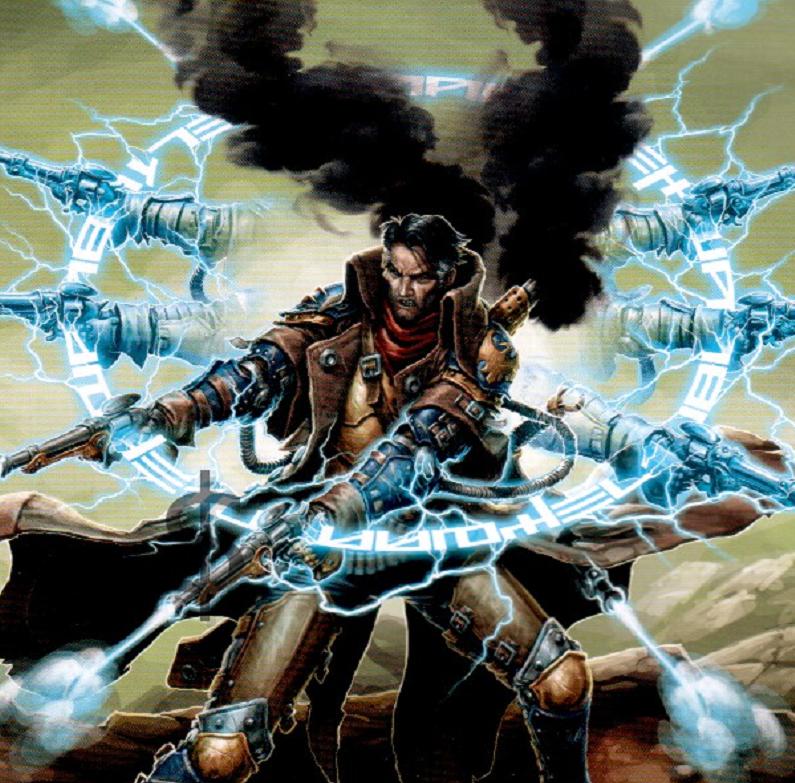
Lieutenant Allister Caine is a graduate of the Militant Order of the Arcane Tempest, which generally expects a great deal of control over its students. When they signed on a former hoodlum, they had no idea what they were getting, or that he'd singlehandedly pioneer gunplay as a strategy of war. Caine's ability as a warcaster was revealed accidentally during his gunmage training, and his instructors were pretty relieved because it meant getting him off their hands quickly. Even with Leto himself urging him to enlist, Caine was not a good student, looking instead to fight. After his graduation, he went back to his hometown, Bainsmarket, and was imprisoned for the murder of a gangster, which he never bothered to even deny doing. Rumor has it that the army had to step in to get him out of trouble, and that black mark has never really faded. Despite his skill, his ego and irreverence make him hard to get along with, and he quickly got a reputation as a loner, drifter and scoundrel, frequently seen in the seedy border bars. He enjoys slumming it and showing off his unmatched gun skills for coin, and often ends up sleeping in jail cells. His drunkenness, womanizing, swagger and insubordination all keep him from advancing, and in fact he is the only warcaster in recent memory to lose his captain's rank just weeks after his promotion for conduct not befitting an officer. Despite all that, though, he is a peerlessly determined soldier, particularly when outnumbered, and his skill has kept him his commission. He has an uncanny knack for finding trouble, and often trouble that letsh im neutralize key threats to Cygnar - it's almost as if something is guiding him to these trouble spots. Caine's entire gimmick is guns, using guns, teleporting around using guns, blessing guns and shooting lightning. His Feat, Maelstrom, lets him shoot guns at everyone even slightly nearby by jumping into the air and doing a pirouette, shooting wildly.
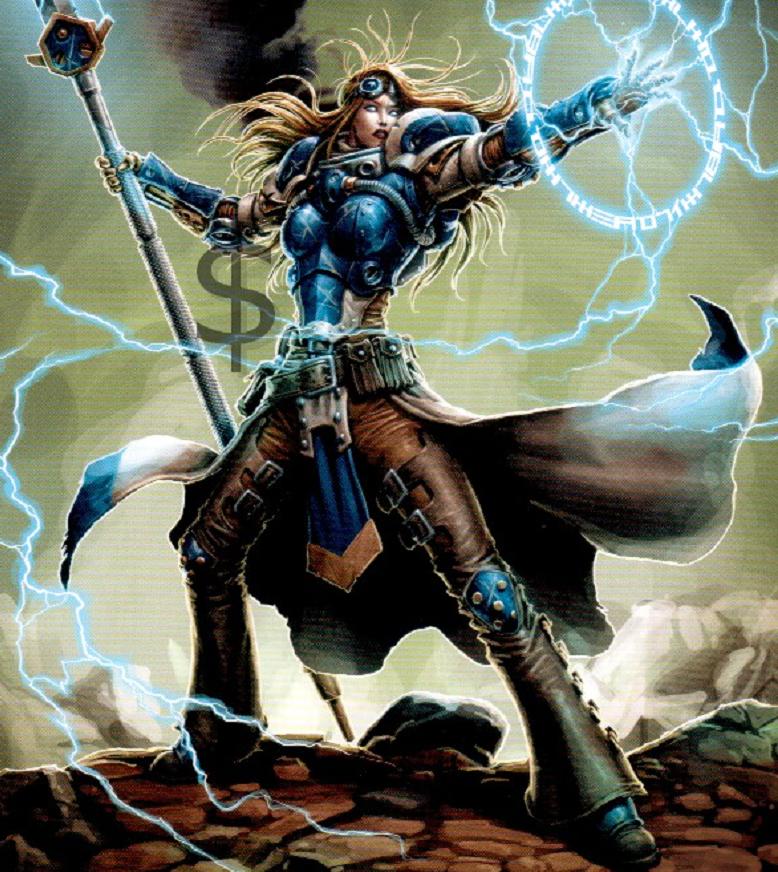
Captain Victoria Haley is a resolved and heroic woman, born in the fishing village of Ingrane. Her parents were humble, enduring much to provide for Victoria and her twin sister, Gloria. It was a simple yet happy life, and would have remained so if not for Cryxian raiders. The girls were but five years old in 584 AR, when raiders from Scharde landed on the docks. Their mother had barely time to shove the girls in the cellar before the Cryxians came to their home, and Victoria had to watch her mother's murder through the floorboard cracks. She hid in a dark corner as Gloria was spotted and dragged away, never to be seen again. Nothing but dark memories remain of Ingrane, now a place of shadow and icy winds. The survivors headed for the town of Ramarck, and Victoria was fostered in a Morrowan abbey nearby. She was treated well, but they tried to curb her budding magical power, believing it unhealthy. At 13, she fled, making her way to New Larkholm and work assisting a fishmonger. It was during her time there, near a laboring steamjack, that her warcaster talents appeared, and she caught the eye of the military. In the army, her power was fostered and unleashed. Two years later, age 20, she finished her arcane training and joined the army. Captain Victoria Haley especially hates the Cryxians, and she will hurl all of her great power against them. She has attracted the attention of the warwitch Deneghra, and the two have faced each other several times so far. All Haley wants is to kill as many Cryxians as possible, but she can never kill enough to balance what happened in Ingrane. Haley doesn't really have a gimmick - she can counter spells, scramble warjacks and support her buddies with lightning and shields. Her big trick is training her soldiers in a special tactic so that once a battle she can give a command and have them all attack an additional time.
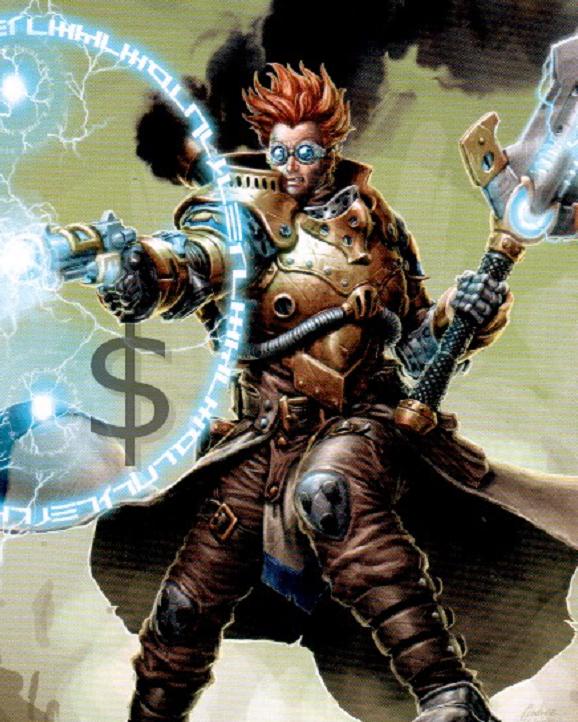
Commander Coleman Stryker was but 19 when Leto took the throne. He fought in the Lion's Coup, and though he started out on Vinter's side, in the end he was instrumental to Leto's success. He was born a hotheaded sorcerer, wanting little but to be a hero. His passion was tempered by experience and the mentorship of Sebastian Nemo. Under Commander Adept Nemo's tutoring, Stryker mastered spells and his ability to control warjacks. They obey him with unnatural precision, and he had none of the uncertainty of other fresh warcasters. He was even able to tame and control the ornery Ironclad nicknamed Ol' Rowdy, which fights alongside him to this day. He was quite proud to hit full warcaster rank, having come a long way from his early induction the darker path set for him when the Lion's Coup first began. However, under Nemo's guidance, his course was realigned and he became a champion of Cygnar. He is committed to proactive hunting of the enemy, and he knows that sometimes, sacrifices have to be made for Cygnar. His dedication has seen him rise meteorically through the ranks, and Leto has called him the nation's finest young battlefield leader. Stryker sees himself as just another soldier, and his age can lead some to believe he hasn't really earned his rank, but he has experience beyond many older generals, and he goes to great lengths to keep his men alive. His gimmick is primarily built around shooting magical attacks and keeping his dudes protected by magic armor. His feat is the ability to channel his arcane powers into a protective shield over his entire army for a little while.
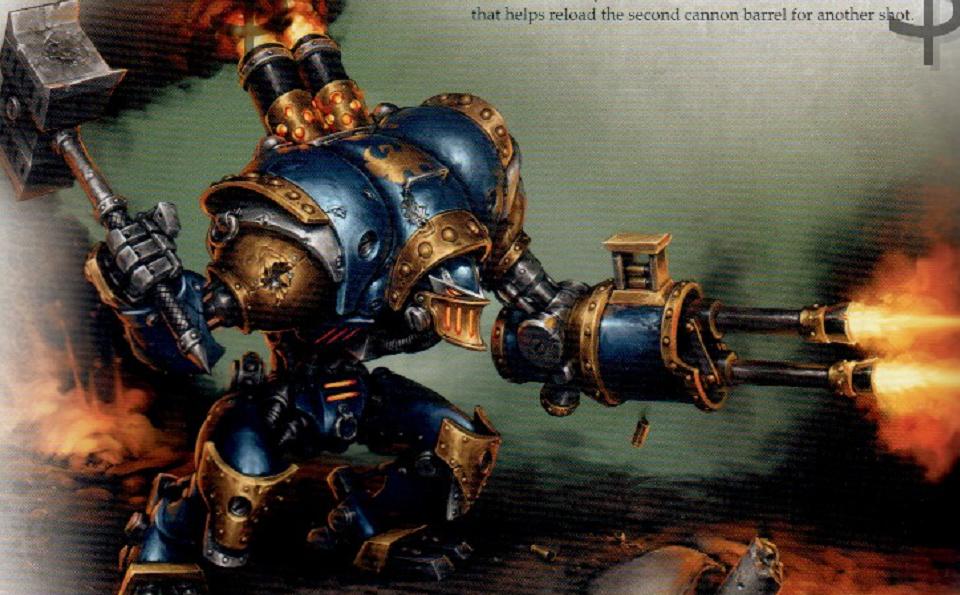
The Charger is the most-produced light warjack in history, an old reliable for its versatile armaments. It's just over eight and a half feet tall, weighs just over two and a half tons and is armed with a dual cannon and giant battle hammer, which allows it to work reliably in melee and ranged capacities. It's the favored jack of most journeyman warcasters, and it's an imprvement over its predeecessor, the Talon, which also had the compact steam engine and potent pistons that allow the Charger to move at shocking speeds. It's had upgrades to the leg and hip for greater articulation, allowing faster reaction time. The gun reloads itself by taking advantage of the recoil to reload the second barrel.
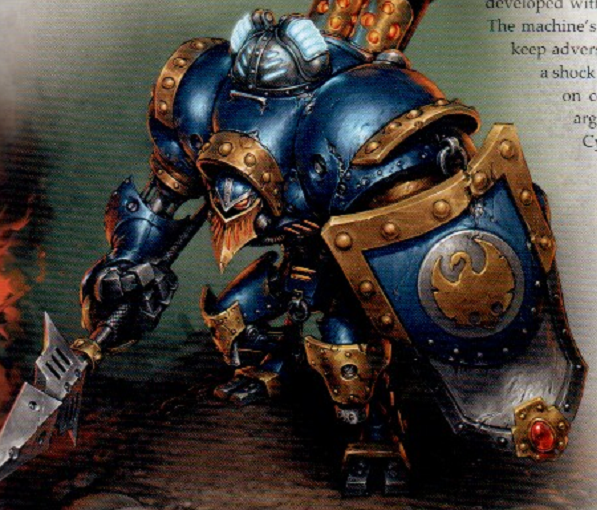
The Lancer is larger, at just over 9 feet tall and 3 tons. It's reliant on the arc node (and before that, the arcantrik relay), a modern tool that allows a warcaster to channel spells through the warjack itself. For years before the Lancer was made, Cygnarna warcasters bemoaned the lack of any arc node-equipped modern chassis. The field had been pioneered by the JAvelin and Arcane of earlier years, but neither performed adequately. After several Cryxian victories, Leto pushed Warmaster General Turpin to develop a better arc node platform. The Lancer is built on a modified Charger chassis, with an emphasis on survival and defense, using the heavy spear to keep enemies at bay and a shield equipped with a potent shock field that can burn out attacking warjack cortexes on contact. These have made the Lancer one of the most valued light 'jacks in the Cygnaran arsenal.
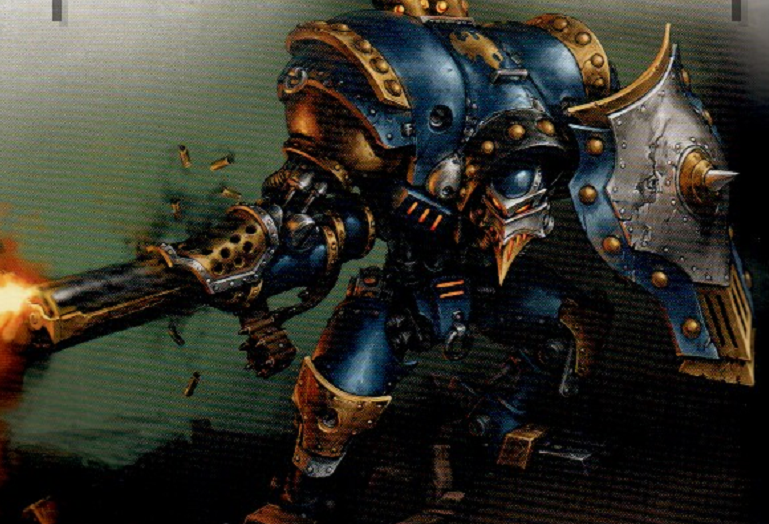
The Sentinel is only eight and a half feet tall, but three and a quarter tons. It's the first Cygnaran warjack ever to be armed with a chaingun, and its job is simple: mow down infantry. Those who close with it are no safer, however, because the powerful assault shield, which allows it to smash enemies and guard nearby allies.
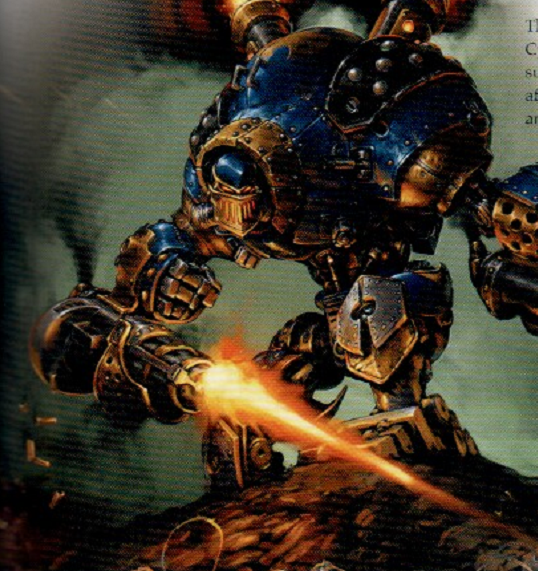
The Cyclone is a heavy warjack, coming in at just over 12 feet tall and weighing six and a half tons. It is armed with a pair of chain guns refined from the older counterparts on the Sentinel, with smoother cycling and less likelihood of a jam. The guns have been nicknamed the Metal Storms, as they tear foes apart quite literally in a hail of smoke and lead. Even better, they're attached to the arms rather than held in the hand, so the 'jack has full use of both hands for locks or throws. Thanks to its suppressive fire, the Cyclone has given Cygnaran commanders a tool to support sweeping advances, allowing them greater ability to choose when and where they engage the enemy.
Next time: More Heavy Warjacks and troops.
Warmachine Prime Mk. II
Original SA post Warmachine Prime Mk. II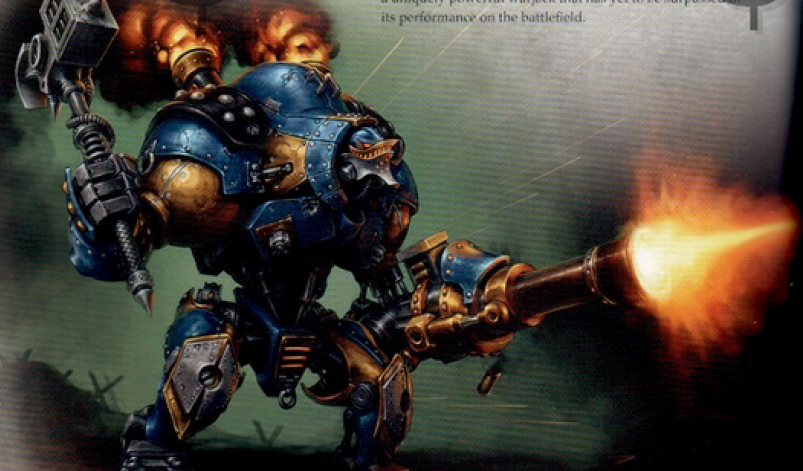
The Defender is a solid heavy, just over 12 feet tall and six and a half tons. Its job is simple: range. It is armed with an exceptonally long-range and accurate cannon known as the heavy barrel, a deceptively simple-looking device with a rapid reloading mechanism and stability enhancers allowing for accurate and rapid fire over immense range, aided by custom targeting protocols in the highly advanced cortex. The Defender's other hand is taken up by a shock hammer, an electrified weapon meant to disable enemy cortexes. The design's a significant evolution in Cygnaran tactics, designed after the battles under Vinter III in which generals wanted more accurate and long-range firepower. It's based on a modified Ironclad frame.
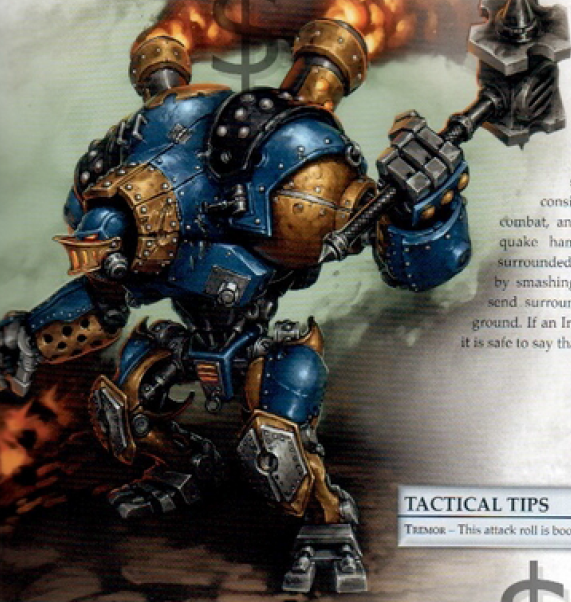
The Ironclad is 6 tons and a few inches over 12 feet. It was designed in the 550s, during a large update of Cygnaran military machines. Earlier weapons used principles started in common laborjacks, but the Ironclad was designed from the first as a weapon. It has a significantly advanced and sophisticated cortex, allowing for finer combat performance. It also wields the potent quake hammer, allowing it to fight effectively even when surrounded by smashing the ground itself and sending foes tumbling. The Ironclad only needs one hand to use that powerful too, too, so it can make a go with wrestling moves if you like.
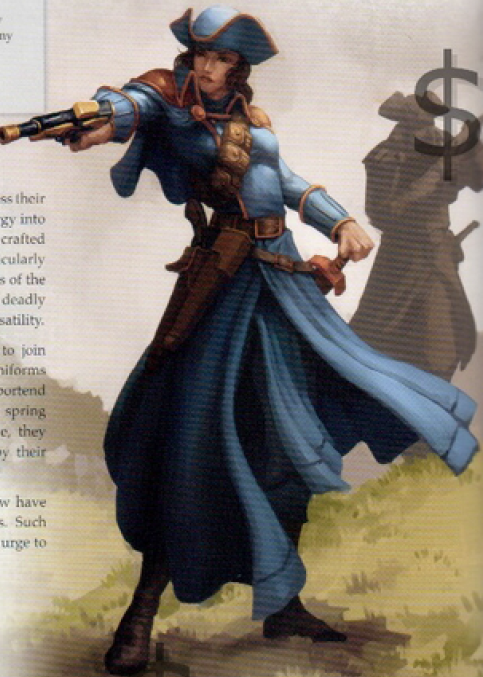
The Arcane Tempest Gun Mages are the elite gunfighters of Cygnar. Over the past two decades, they have trained pistol-attuned sorcerers to harness their unique abilities in war, focusing arcane power on their ammunition via their magelock pistols, crafted from an expensive steel alloy to be response to arcane force. They inspire confidence in other Cygnaran troops, thanks to their reputation for masterful accuracy and pyrotechnics. Only a few are born with the talent for gun magic, and only recently did Cygnar decide to organize their formerly secret fellowship of duelists into the Arcane Tempest, allowing them to give the gunfighters discipline and loyalty. Even a gun mage must earn the right to wield the magelock and wear the uniform, after all. They're very powerful gunmen, able to snipe from long range, blast foes to bits with lightning shots and more.
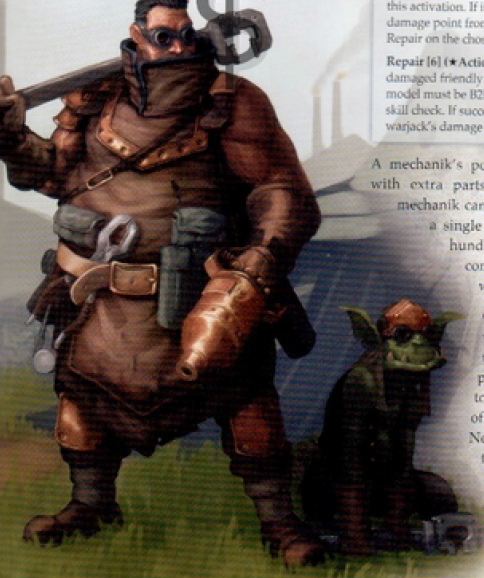
Field Mechaniks exist because even in the best of times, shit breaks. And battle? Not the best of times. Any failure of technology could mean defeat for Cygnar. That's why they train the mechaniks, who carry parts and tools into battle. There's never enough gear, because any single piece could be the linchpin of a battle. And that's also why mechaniks keep the gobber bodgers around. Gobbers love tinkering more than anything, and while they don't get paid well at all, they find the work itself immensely rewarding, even when shot at. Still, they are also infamous for tossing aside their tools and diving for cover when danger comes near.
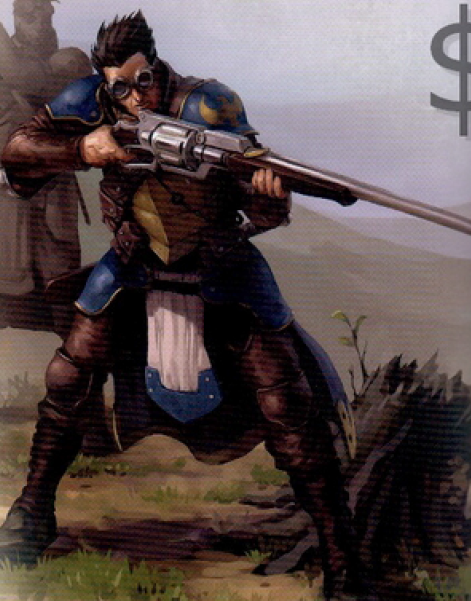
The Cygnaran long gun has always been the backbone of Cygnar's forces since its invention, even back when they were muzzle-loaders. Breechloaders only made it better, and the modern crank-operated revolver rifles have improved things even further. Preloaded replacement wheels are easy to substitute even in battle, allowing for near-constant fire. The long gunners are the majority of Cygnar's army. Once, they were only seen in small squads supporting the main line, but now they man the garrisons and guard the borders as the face of Cygnar.
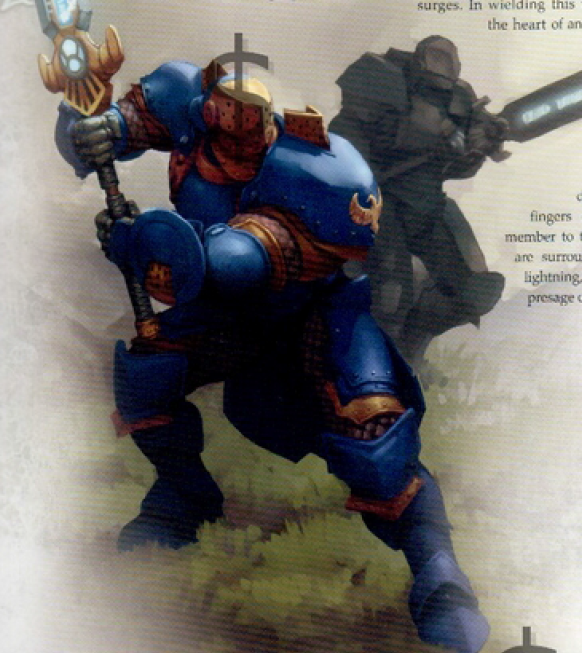
Stormblade Infantry wield the most advanced mechanikal weapons Cygnar has. Leto started the program under his brother's rule, handpicking each storm knight and forging them into the best fighting unit of Cygnar, mixing ancient tradition and modern weapons. They wield the storm glaive, a weapon that mixes sword combat with electrical power. Essentially, the blade holds a lattice of conductive material to direct the energies from the storm chamber, and in proper hands it can even shoot lightning. Each sergeant wields a modified storm glaive, designed to synergize with the glaives of the unit to amplify each other. Stormblades use armor that insulates them against shocks and current, allowing them to fire off without fear.
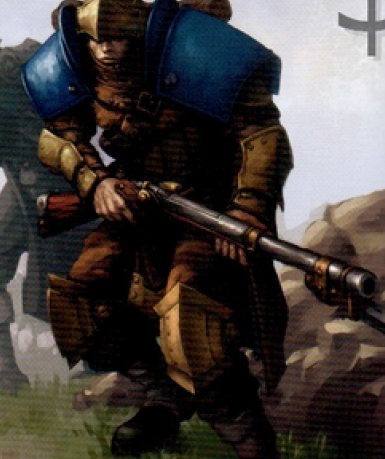
Cygnaran Trencher Infantry have a great reputation for grit and endurance. They're always on the front lines, and they've been called gravediggers, as they are often last off the field. They take and hold ground, the bravest of all Cygnaran troops in their willingness to defend any land with their lives. They die pretty often, and all they have is a long bayonet, a heavy rifle and some smoke bombs. They began as an experiment to see if hard training could turn even callow youths into hardened warriors, and the training of a trencher is harsh in the extreme, with veterans often called back to teach the next generation. Once a Trencher, always a Trencher.
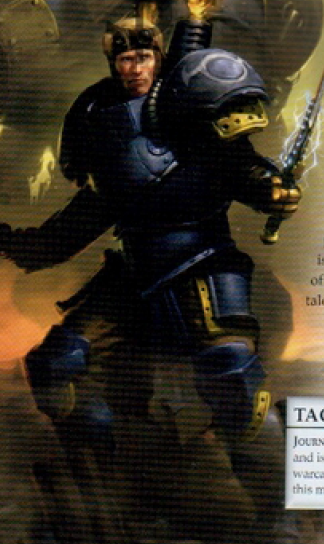
Most warcasters spend a good amount of time as Journeyman Warcasters . Many have been soldiers for a long time before finding they had the talent and need to work hard to master their new skills. They practice on disarmed warjacks and can eventually earn the right to command an old, often battered 'jack in battle. By Strategic Academy tradition, each journeyman must serve a full tour under a veteran warcaster before graduating. In wartime, that means vital lessons while avoiding death, and a chance you don't survive. Journeymen are juicy targets, after all, because of their potential. Still, only real combat is enough to forge someone into a solid warcaster rather than some naive fool who can shoot magical blasts and move a 'jack around.
Next time: The glory of Menoth!
Warmachine Prime Mk. II
Original SA post Warmachine Prime Mk. II
This bit of history is given to us by Grand Scrutator Severius. For as long as man has worshipped, man has worshipped Menoth, the Creator. All that is belongs to Him, and He may reclaim it as it suits Him. Humanity did not have it easy, for Menoth wished to strengthen them by trial. Tribes arose, wandering for millenia and learning to survive. They did not realize that, in growing stronger and more worthy, they fought the ancient foe of Menoth, the Devourer Wurm. It is known that Menoth gave the knowledge of fire, stonework and agriculture to the worthy, and the first and greatest of the worthy whose names are known was the man Cinot, to whom Menoth gave the True Law inscribed in stone, the Canon, at Icthier.
By Menoth's favor, the first priest-kings arose to rule lesser citizens, and each man know his place. Menoth's covenant ensured obedience to the True Law. Thus was born the Temple and the Sacred Flame, an imperishable fire in every temple, uniting all humanity with Menoth's promises. However, men are like children and easily go astray. After millenia, the tribes broke apart and men forgot their places. They fell to false idols and ancestral worship rather than the way of Menoth, and some even betrayed the world by worshiping the Devourer Wurm, the Beast of All Shapes, who is the great foe of Menoth. Lesser gods arose, allowed to exist only by the benevolence of Menoth, and those who were led astray forgot to praise Him.
It took Menoth some time to notice, for time is as nothing to Him. When He did, He was angered, but he chose not to destroy His creation. Instead, he sent the Orgoth to test humanity, as a lesson on what happened when man lost his faith. Menoth allowed the Rebellion to succeed in order to give them a second chance. The priests rebuilt the temples and spread the word of Menoth, and some chose to listen while others did not. The worst of these were the Morrowans, a dangerous but popular faith. The only more wretched god was Morrow's sister, Thamar. They were seduced by his easy teachings, requiring no discipline or adherence to the True Law. They were tolerated, so long as praise was given to Menoth, but this was too indulgent.
Man is, after all, lazy. Weak. Under Woldred the Diligent, the right of Menites to oversee the passing of the crown was made law, as Woldred understood that the priesthood should be given to recognize a just and worthy king. However, heretics plotted against the Menites, and the usurper Malagant toppled the rightful order by removing the priesthood from power and replacing them with the more amenable Morrowans. He even murdered hundreds of priests, his blasphemy going unstopped by the people. This was a sign of how far Cygnar had fallen. The Menite priests fought in court when they should have fought in the streets with blades. Menoth was displeased by how His people turned away, and so, He sent Sulon.
Sulon was a visionary, the greatest mortal leader since the priest-kings Khardovic and Golivant. He quickly rose to be Visgoth of Caspia, and he called for a pilgrimage of the faithful to his side. He organized those who came, initiating scrutators and training them as knights, warriors and war priests. Knights Exemplar and others willing to take up arms were called from their posts and temples to join Sulon. They chose the City of Walls as their place to stand, for it had been Calacia, birthplace of Golivant. It was holy ground.
By 482, Sulon stood atop the ancient Great Temple of the Creator, his army prepared. Eastern Caspia had become the largest temple to Menoth in the world. On the holy day now called the Birth of Sulon, he donned new vestments and became the first Hierarch since the coming of the Orgoth. The Khadoran visgoths were too proud to acknowledge this claim, but all those gathered embraced Sulon as leader. He banished all remaining unbelievers, to make room for the faithful, but he was overly indulgent - he let them leave in peace. They would soon take arms against him. The heretic puppets of Cygnar's court and their Morrowan master sent soldiers to disrupt the holy gathering, a transparent ploy to assassinate Sulon. He knew it would come, and so he had his army send them to Urcaen, and the fury of the righteous was unleashed. The battle destroyed the city's bridges, and it s two halves were barricaded against each other.
The battle lasted two full years, to test the faith of the righteous. Sulon fell in battle in 484, for it was Menoth's will that the Hierarch should join Him, having done enough. The Menites stood down, remembering the death of Sulon with a holy day of silence. Shortly after, King Bolton Grey V sent an emissary to Visgoth Ozeall, Sulon's second, and the conflict was ended. The land to the east was given to the Menites to rule, and the Cygnarans lied, claiming they would not impose political will over this Protectorate. They gave up the holy land of eastern Caspia, and the Menites renamed it Sul, to free themselves of names tied to Cygnaran title.
The land they were given was bitter and hot, but hardship is the coin of Urcaen, as Sulon said. Within the Protectorate, a theocracy was formed, dedicated to service of the True Law and the Creator. Of course, taxes would need to be paid to Cygnar, but that was a small price for control over their own destiny. They were forbidden a standing army, but given permission to raise what was needed to defend their realm from the eastern tribes, and that would be the seed of the Protectorate's military. Many came forth from the walls of Sul to settle the new land and win it from the wild. It was not easily worked, but Menoth provided for His children. It was difficult, but rewarding. Ancient relics of Icthier were unearthed from its ruins.
The Idrian tribes attacked again and again, always rebuffed. The greatest clash came in 504 AR, far east of Sul, when the Menites marched on the 'city' of Imer, the greatest the Idrians had. Menoth's hand struck the earth as a sign, an immense earthquake that destroyed the city walls but left the faithful untouched. And so, the Menites realized, slaughter would serve far less than conversion. The Idrians were ignorant, but they recognized the hand of the divine. The majority of the tribes converted on the spot. It did not end the battles - that would take decades of bloodshed - but it began the conversion of the Idrians. They brought numbers to the Protectorate as well as capable warriors. Imer was remade into a modern city, and the diamonds of the Marches were discovered, ready to be sold to the heretics who valued them so highly, given the Menites the wealth needed to prosper in their lands without the tax collectors realizing what they did. It was also the Idrians who revealed the oil of the wastes, which the Menites refined into the weapon named Menoth's Fury under Hierarch Turgis. Oil itself is useful for the forges and hearths, and when refined, it became a potent weapon, roaring like the wrath of Menoth when it touched air.
Fifty years after the Protectorate's formation, Vinter Raelthorne III was made King of Cygnar. He taxed the Menites mercilessly, starving the people even after the diamonds were given. Tensions rose, and after his death in 576, the crown went to his corrupt son, Vinter IV. He was a deserved plague on Cygnar, and this allowed Menoth's church to gather strength in secret. The transfer of the title of Hierarch has always required some turmoil and a good deal of time - it was eighteen years after the death of Hierarch Turgis before Ravonal became Hierarch, and only eight years after his death to the next. The Synod selects the new Hierarch, but it takes time and deliberation. Garrick Voyle rose from the chaos to their attention, becoming the latest of the great Hierarchs. In 588 AR, Voyle seized his title and forced those few who opposed him to see the error of their ways. It was miraculously clear how right a choice he was, for the text of the True Law had emblazoned itself upon his skin.
Voyle raised the Protectorate to new heights, relocating the capital to Imer and ensuring that they acquired the warjack cortexes they would need, and the tools to make more. He instituted the Vassals of Menoth, who kidnapped foreign mages to turn their unholy skills to the purpose of the church, and found the ways to bless their output with Menoth's favor. At last, when Leto overthrew his brother, it was time once more to turn attention towards Cygnar. They waited for Cygnar to be surrounded by foes, but in the last year, the greatest sign was found: the emergency of the prophetess and oracle foretold in the Canon.
She is the Harbinger of Menoth, the embodiment of His will and speaker of His voice. She arrived in Imer before the Synod and gave her blessing to Voyle's crusade and his work with the hidden factories and mages. Now, the Protectorate will finish what Sulon began. They will convert and conquer all lesser faiths, and even the estranged Khadorans will recognize the Harbinger and return to the fold.
We then cut to the writings of Visgoth Juviah Roven responding to the above. Severius, it seems, led an army that would become the Northern Crusade, after he was told of a vision from the Harbinger, who revealed that an imminent threat was rising in the Thornwood. The Harbinger herself went to war, with Severius at her side. Deep in the Thornwood, long a bastion of the Devourer Wurm, the Harbinger and her army faced darkness incarnate, of which even Juviah cannot write. It took place in a ruined Orgoth temple, however, that had been site to many atrocities. During the battle, the Harbinger gave up her own life to thwart a plan that threatened Urcaen itself. Her body was returned to Imer for burial, despite all dangers to the journey, but Menoth showed His will. He gave Hierarch Voyle the power to return the Harbinger to life. Hundreds of thousands witnessed this miracle as the Northern Crusade marched on. Severius would not be dismayed, even by the loss of the Harbinger.
He razed the heretic town of Fisherbrook and obliterated the Morrowan monastery outside Fellig, marching into Llael. Eventually, he even reached the fort-town of Leryn, which he took and sanctified as the northern bastion of Menoth. In Sul, a great attack on Caspia was prepared in 606 AR. However, the Cygnarans achieved the impossible - they breached the holy walls of Sul. The Menites underestimated them, and many died that day. Still, the Great Temple was protected. The battle lasted a full year, reversal upon reversal. At last, Cygnar was pushed out of Sul, and the Menites invaded Caspia. They were unable to totally defeat the Cygnarans, however, and Hierarch Voyle knew he had to go personally.
Voyle fought his way to Castle Raelthorne itself, but at last he reached his limit, and Menoth took him home. The Menite army withdrew in grief, but had reclaimed Sul. Severius returned to speak of how the Menites are best with a strong leader, and it was unanimously decided: for the first time, a new Hierarch could be chosen immediately. It was to be Severius. The Crusade continues.
Next time: The heroes of Menoth!
Warmachine Prime Mk. II
Original SA post Warmachine Prime Mk. II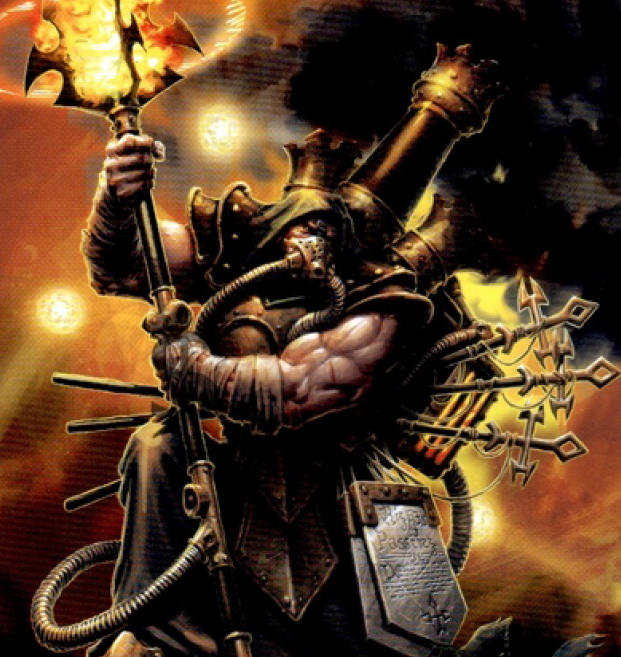
He is the High Reclaimer , the leader of the Reclaimant Order that assists Menoth in destroying, returning souls to help him in his wars in Urcaen. Even the other Protectorate Orders are worried by them. They keep their iron masks bolted shut when outside the cells in which they eat and sleep. They say nothing after taking their oaths - ever. Even their prayers are silent. The High Reclaimer rises above the rest, channeling Menoth's power with ease and hurling forth burning ash and flame. He has been given the title of High Reclaimer for his absolute unity with Menoth's will. He is the first Reclaimer to have warcaster talent, as well. He wielders the ceremonial torch Cremator, kept fueled by a constant supply of Menoth's Fury. It is a potent enough weapon to tear through 'jack armor as if it were flesh, and anything it touches burns. Those who march alongside the High Reclaimer know his will without being told it. He meditates and exercises ceaselessly, fasting to make his skin like iron. None are safe from being reclaimed for Menoth, and it is said that Menoth whispers to him in his prayers, telling him the names of those that must die, friend and foe alike. Failing him, of course, always means reclamation. His gimmick is setting people on fire. Everyone, his side or the other side. And his feat? He can resurrect the dead , calling on Menoth to send some souls back to keep the battle going.
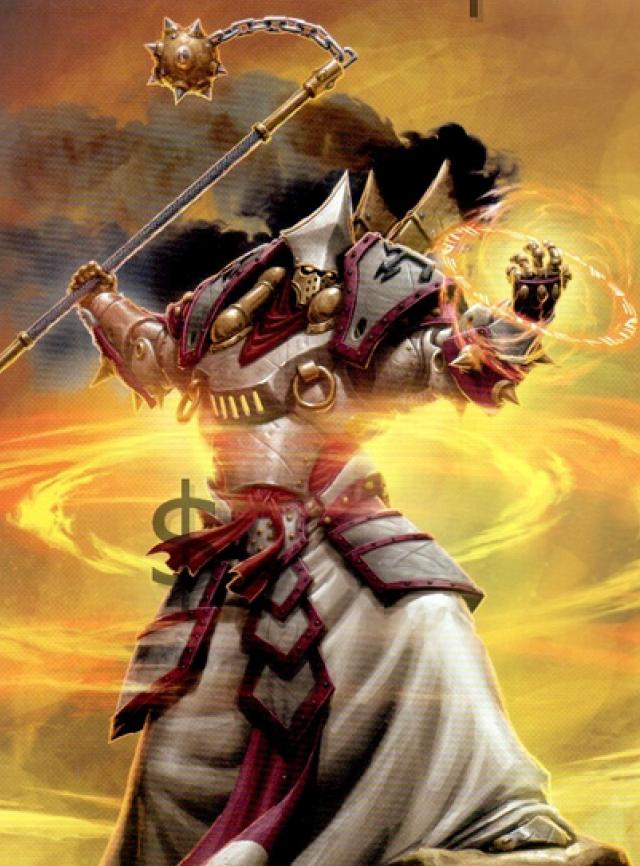
High Exemplar Kreoss (first name: Mikael) is a leader of the Knights Exemplar, a devoted example of Menoth's will in the form of man. He is Khadoran by birth, motherless in childhood and aspiring to be one of the Order of the Wall, a guardian of the people, after his father became conscripted for labor for his debts. The work overwhelmed him as he tried to raise Mikael, and so he gave Mikael to some Protectorate pilgrims in the hopes of a better life. They took the boy back to the Protectorate, and Mikael channeled his pain from seperation into his quest to perfect himself. He became a priest, where he found heathens robbing a holy crypt. Enraged, Mikael beat them to death with his bare hands, then realized his place in life was as a Knight Exemplar. They soon invited him to join, and he rose quickly. He was effective at stamping out heretics and blasphemers, dedicated to setting the wayward on the right path. He has killed many for being unworthy of the gift of life. His concentration is unmatched, both as a leader and a warcaster, and a mere touch with his holy blade can dissolve magic. He is a living legend in the Protectorate, and one whom the leaders of the faith count on. He doesn't have too much of a gimmick - he can set folks on fire, end magic, buff his guys, that kind of thing. His Feat is that he can call on Menoth's wrath to knock every enemy even a little close to him over.
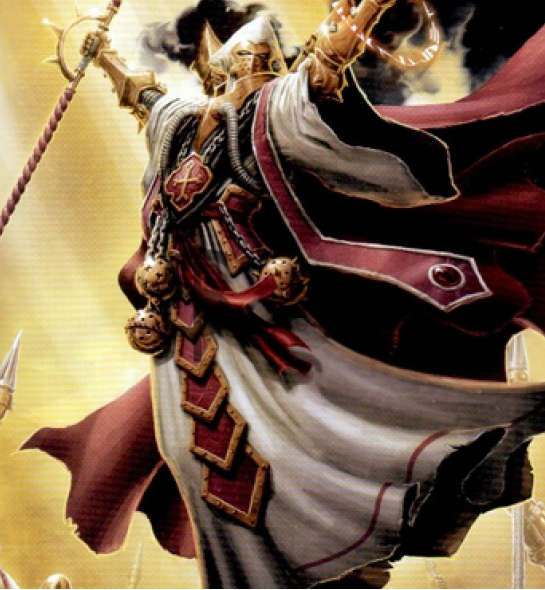
Grand Scrutator Severius is one of the scrutators - the internal affairs of the church, who police their own clergy. He is the greatest of them, and was given command over the entire military of Menoth. He has singlehandedly converted thousands as the unofficial ambassador of the faith, and in fact he's been banned from Khador for converting too many people. (Banned by Khador, that is.) Since the Protectorate got more aggressive in its crusades, his focus on conversion has turned towards the villages he conquers. Severius loves battling the enemies of the faith, and he brings his 'jacks to life with the same fervor he holds. He is a master strategist, and he plans for the long game. The very, very long game. He plans to, eventually, return the world to its state at the dawn of time, as Menoth intended. (He knows he will die before this is complete.) Age has sapped his strength, but his holy power makes up for it. Magic seems to wither against him, and he can slip into someone's mind with a single word. If he chooses, Severius can recite the Litany of Menoth so powerfully that it rends the connection between warcasters and their heathen warjacks, shutting down all arc nodes nearby for a few minutes. (This is, in fact, his Feat.) His gimmick? He can take control of enemy units and have them join his side for the rest of the game, and he likes buffs and debuffs.
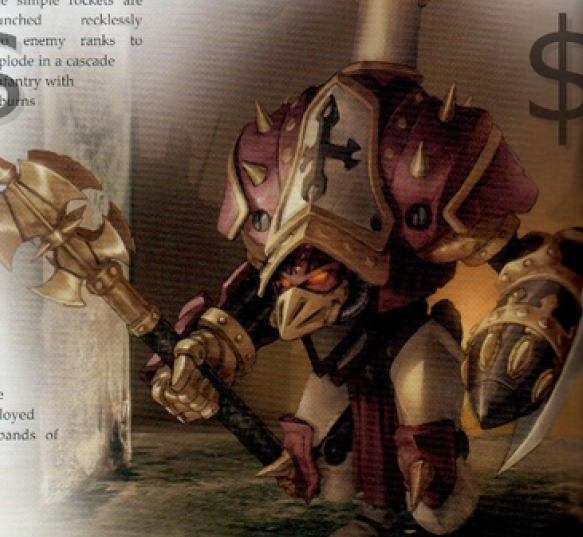
The Redeemer is big for a light 'jack - nearly ten feet tall and nearly 5 tons. It is, well, an artillery piece, armed with explosive rockets. It was designed as a long-range weapon, carrying vast amounts of explosives and a rig to launch them with, the Skyhammer. Using technology developed for the Repenter's ignition systems, it can use its engine-heart to ignite the rocket propellant and fire it off. It is not, however, especially accurate, so it's more for taking out wide areas. In the early decades of production, it was mostly deployed against Idrian holdouts who refused to convert, but has more recently been turned to war with Cygnar and other foes. Its explosives are designed to create lots of shrapnel, which is really good at making wounds that don't heal properly or which kill outright. If it has to fight in melee, it has been thoughtfully given a big mace.
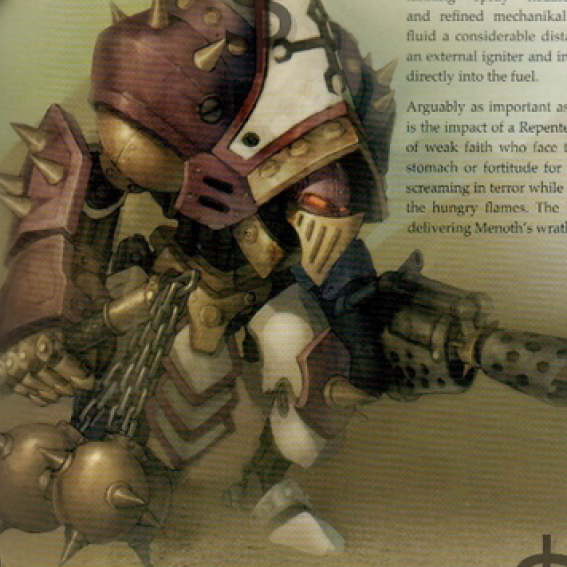
The Repenter is almost ten feet tall and four and a quarter tons. It is outfitted with a crude, unrefined supply of the weaponized oil known as Menoth's Fury, since they have so much of it. Originally meant as a border police unit, it set trespassers on fire. When it was designed several decades ago, it was given a three-headed flail and a flamethrower arm, you see - at first, just a pipe with an igniter attached to a pump and reservoir. Newer versions have a fanning spray nozzle and refined propellant systems to shoot the flaming oil further, and the latest version skips the external igniter in favor of venting the heartfire of the engine into the fuel. The morale-destroying impact of the flamethrower is just as important as the damage it does, as those without strong faith in Menoth fear burning alive.
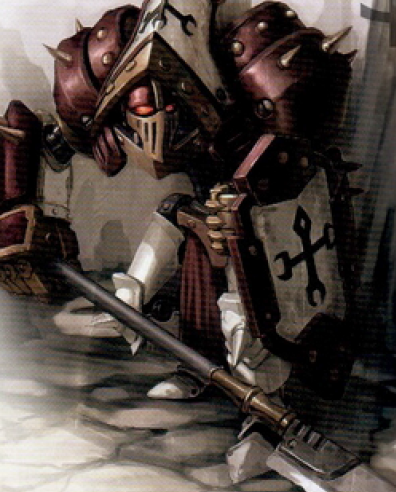
The Revenger is a little over nine and a half feet tall and almost four and a half tons. The idea was that the reach of the prayers of the faithful had to be extended, and Menoth had managed to capture a few Cygnaran Javelin 'jacks, using their arcantrik relays to aid their research. They reverse-engineered the things into the arc nodes used in the Revenger. While celebrated today, their origin was highly controversial at the time, since it was based on Cygnaran tech. The mechaniks ended up using the same procedures used to sanctify warjacks, purifying the device by prayer as they rebuilt it into a 'divinity node.' The visgoths took it as a divine sign of favor. They gave the thing a halberd, then developed a potent repulsor shield to protect it, using holy runes that hurl back anything that is struck by the shield. This gives the Revenger the power to keep potent foes out of range - very handy, especially against slower enemies.
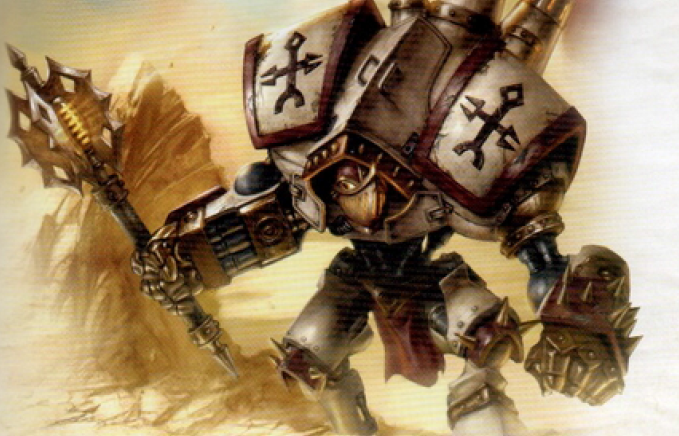
The Crusader is a heavy 'jack, twelve feet tall and weighing a full 8 tons. It was designed after the civil war, in secret, using Khadoran cortexes and Cygnaran parts scavenged from the field. The Crusader was the greatest of their early designs, a massive 'jack covered in heavy armor and armed with a giant mace. The chassis came from the time of Hierarch Luctine, who used it to subjugate the Idrian tribes. The development of Menoth's Fury only made it more potent, allowing the creation of the Inferno Mace, which is superheated and can tear through almost any armor. Plus, it only needs one hand to wield, so it can punch, too!
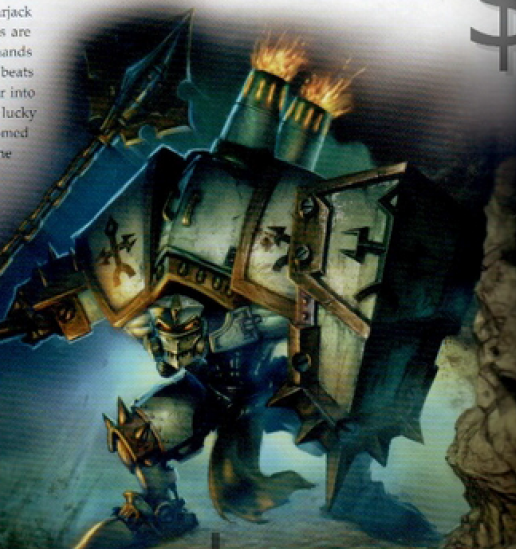
The Templar is over twelve feet tall and weighs almost eight and a half tons. It's the embodiment of the simple Protectorate philosophy of overwhelming force. Its iron flail is immensely powerful and hurls enemies around, smashing right through shields and armor and chasing them as it goes. When Hierarch Caltor Turgis reunited the Temple in 535, he broadened the Protectorate's borders and ordered the building of the Tower Judgment, with the first Templars made to guard it. It was so isolated that they didn't even need to disguise the warjacks as laborjacks, and so the shield and flail meant for the Templar are bold and impressive. Now, they are a common sight among the ranks.
Next time: The armies of God.
Warmachine Prime Mk. II
Original SA post Warmachine Prime Mk. II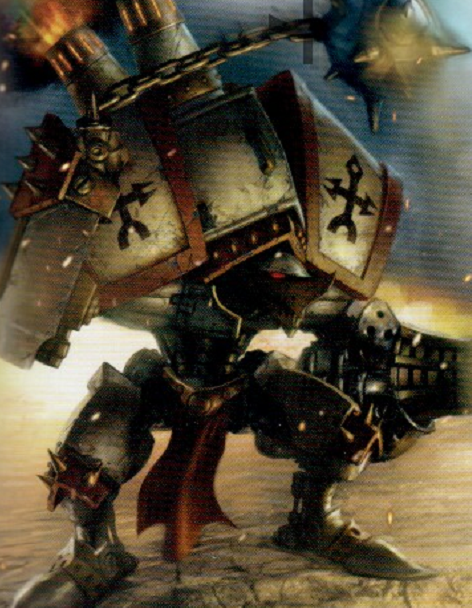
The Vanquisher is 12 feet tall and nearly ten tons. It's one of the most recently designed Protectorate 'jacks, originally made in the late 590s in secret. It's not a very subtle machine, though - it's armed with an immense flail capped in a 'blazing star' - a sort of giant spiked ball. It smashes things with the blazing star, and when it can't hit them in melee it turns to its flame belcher. The flame belcher is a cannon that fires a shell that bursts in impact. Inside the shell is a refined form of Menoth's Fury, which ignites merely on exposure to air. It burns hot enough to melt metal, though it burns out relatively quickly.
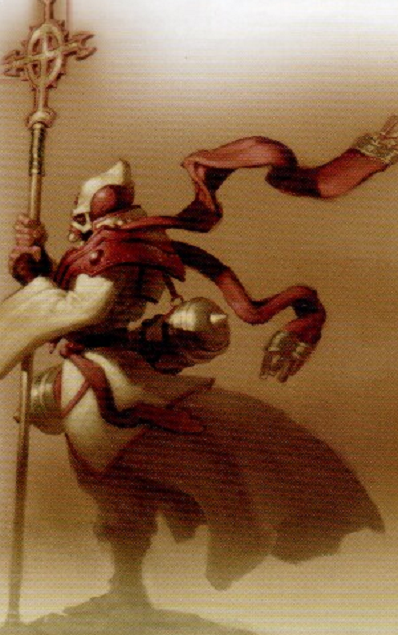
The Choir of Menoth is all part of one of the Protectorate's big problems: tehcnically pseaking, all the mechanikal tools they use are inherently blasphemous to Menoth. Hierarch Luctine found a way to sanctify these arcane machines via purifying prayer, and their success in battle has been taken as a sign of Menoth's favor. The Choirs are sent to accompany the 'jacks that have been blessed, further empowering them by holy chant. They are led by devout warpriests chosen from among those believed most likely to have the talent for controlling warjacks. They then use an ancient canticle to reinforce the bond between warjack and warcaster. Their prayers can turn aside bullets, unravel spells or divinely guide a warjack's weapons. It takes perfect concentration to achieve these chants, and that's the one job the Choir has. (Well, they also get to hit people with sticks, but if it comes to that they're not having a good day.)
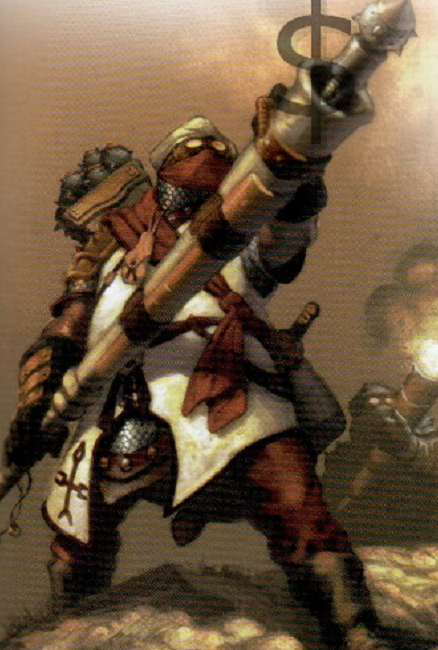
Deliverers are armed with the same Skyhammer rockets as Redeemers. They were once a niche auxiliary unit until Hierarch Voyle decided to reform the military. Redeemers are long-range artillery, and that has a real use on the modern battlefield. Plus, they're cheaper to replace than warjacks, so you can use a lot more of them. Early units fired self-propelled explosives by hand, using a length of wood to light the fuse and send the rocket off. Most of the time, the rockets landed in enemy lines before exploded, but sometimes they'd detonate early or land too soon. The Protectorate developed reinforced cylindrical tubes that could be aimed with more control. Even so, only the most devoted become deliverers, given it means going into battle carrying vast quanities of explosive. (Also they're still not the most accurate weapons.)
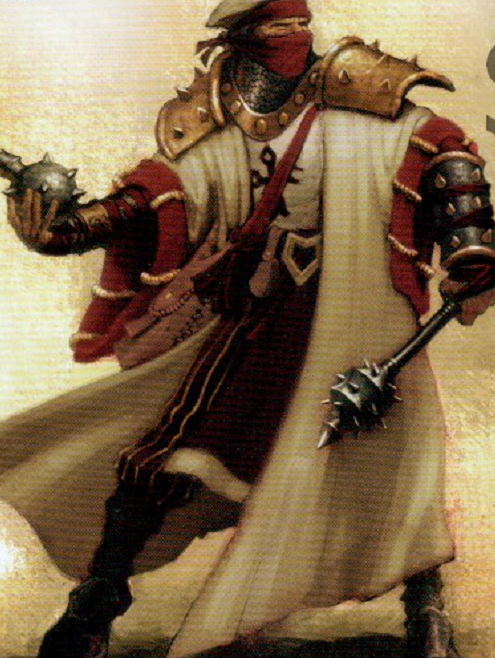
By treaty, The Protectorate could not have a standing army...but they'd never lack for volunteers. Holy Zealots are those volunteers, willing to use any weapon to serve the cause. They were secretly trained in combat by the clergy, then given locations of weapons caches if they needed to fight. Even after the need for secrecy ended, the system remained in place, because it was effective. Protectorate citizens can do whatever they like, so long as they're ready to fight when claled. To bolster their faith, the priests will lead the zealots in combat, giving sermons and leading them in prayer, to protect them from magic or to guide their blows. Should a priest fall in battle, one of the zealots will take up the prayers as well, though without the power behind them. Oh, and they gave these guys fire bombs as well as maces.
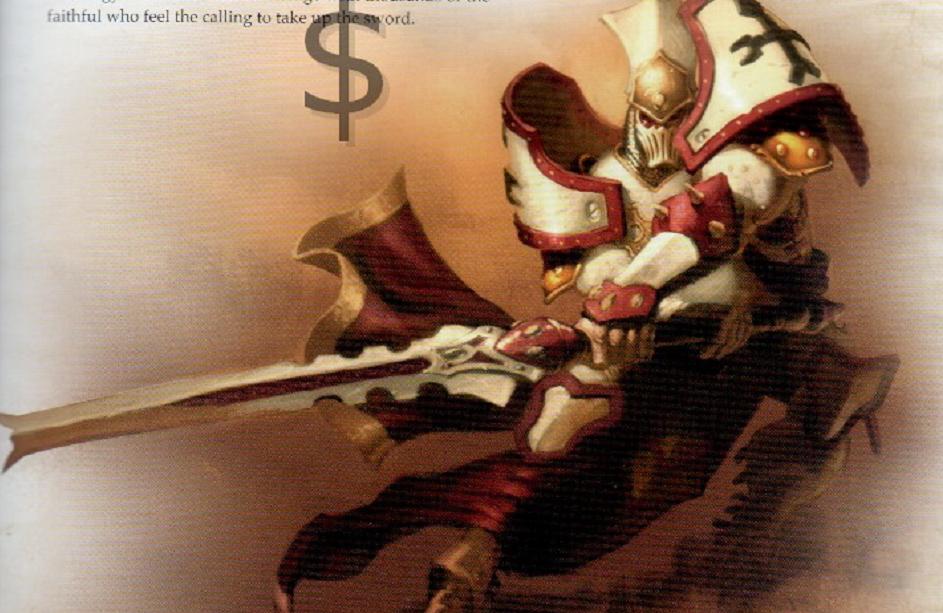
The Knights Exemplar are the weapons of Menoth. They wear blessed plate armor engraved with protective wards, and that armor can stand up to most things. The sound of their relic blades unsheathing is a sacrament. Their true power, however, comes from their divine gifts. The more of their brethren that die in battle, the stronger they become, fuelled by righteous anger. The first time they took up arms as a large force was during the Cygnaran Civil War, at which point there were no more than a few hundred of these holy warriors. Now, they number in the thousands.
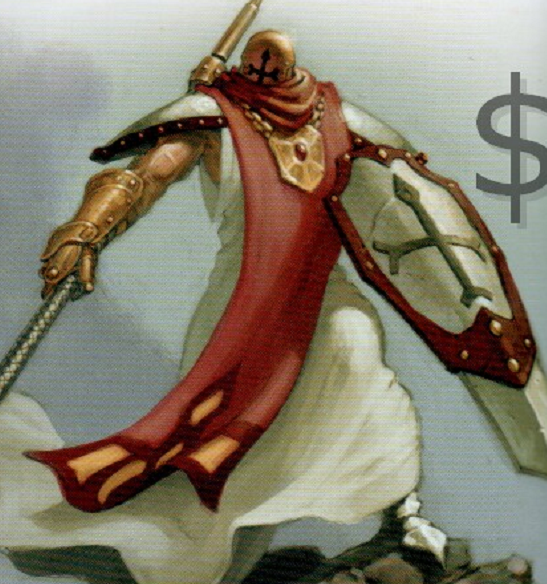
The Temple Flameguard are the vigilant guardians of the temples. Sulon created the order as it is known today by conscripting Menites leading up to the Civil War. The temples had always had armed guardians, but the Flameguard were the first to be unified in instruction and discipline. Their armor and garb are meant to be impressive, and they protect both temples and holy sites, ensuring the sacred flames remain burning. In return, they are given indulgences and favored status, as well as comfort for their families. The Flameguard never stop training with their seven foot spears, the hafts of which are full of Menoth's Fury, which is piped into surface vents on the barbed tip and ignited by a trigger mechanism in the base. In battle, they drip oily fire and can cause terrible wounds. Since the time of Sulon, the stated purpose of the Flameguard has increasingly been used as a justification for training a military. Over time, they have become elite infantry, the first and last line of defense. They are a living wall that protects the clergy.
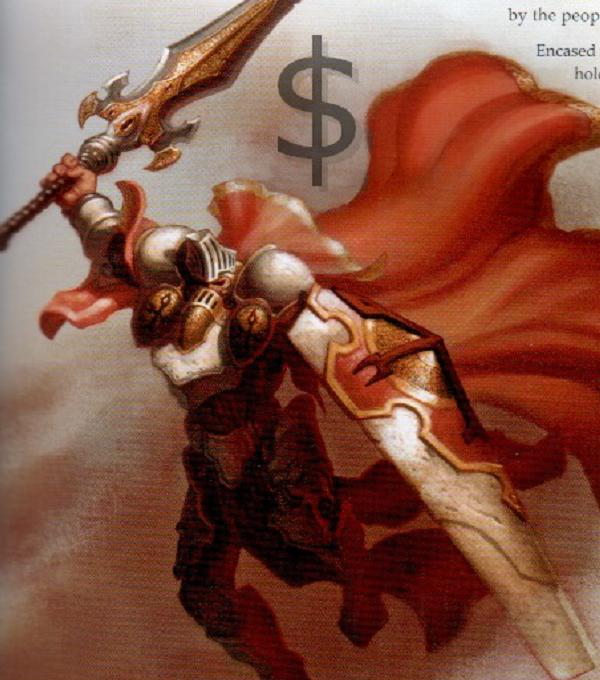
The Paladin of the Wall is the embodiment of an ideal. These paladins, however, are often at odds with the ruling scrutators, and the Order of the Wall has a turbulent past. Its enrollment periodically dwindles to near nothing, only to surge back in times of turmoil to reassure the population that Menoth is not just wrath, but also protection. They have served humanity since the first words of the Canon of the True Law, bastions of stability when the wilderness threatened. The wall of their namesake is not just one wall, but any barrier that was ever made to shield a community. The Paladins prioritize mercy and protecting the innocent even over orders. The priests say this is a sign that they lack obedience, but the Paladins prefer to protect the flock rather than drown them in blood, and they believe even the wayward can return to the path of Menoth, which makes them well-beloved by the people. They are armored in tempered steel and trained to hold against any foe. There is little more difficult to harm or move than a Paladin of the Wall, and their Firebrand swords erupt in holy flame when they strike, a sign of Menoth's favor. For every soul saved by a paladin, however, two are lost to the tortures of the scrutators. The paladins cannot be deterred in protecting the faithful, however, believing that it is their function in Menother's temple. If that means endless sacrifice, so be it.
Next time: Mother
Warmachine Prime Mk. II
Original SA post Warmachine Prime Mk. II
Khador's history is written by Kommandant Grezko Autonovich. Once, before the coming of the Orgoth, most of western Immoren was ruled by the Khardic Empire. They united the Kossites, the Skirov, the Umbreans, the Ryn and the Tordor, and they were on the brink of taking over the entirety of Immoren when the Orgoth arrived. The Khards were the ancestors of the Khadorans, and that rule is the right of Khador. The Orgoth defeated them, using sorceries and weapons against which there was no defense, but the Khards fought them hard for their victory, sending many to Urcaen. Had all the other nations fought so hard, the Orgoth would never have won. They ruled for generations, and it was the Khards who suffered worst under them as punishment. Still, they endured, for their spirit could not be broken.
It is true that the Iron Fellowship, the first rebellion, took place in Cygnar. It failed utterly. The Tordorans and Thurians were crushed at the Battle of the Hundred Wizards, and so were the Llaelese Army of Thunder. It was not until the Khadoran horselords that the first true victory was won in 147 AR. They destroyed the first Orgoth city, razing it utterly and wiping its name from history, so that none might recall it. Then they seized the city of Korsk back from the Orgoth. The Orgoth fought as best they could, using terrible engines of metal, flesh and fire, but Korsk never fell, as it has never fallen since. Inspired, the other nations joined with Khador to form the Iron Alliance in 160 AR. The other nations pretend, however, that the Council of Ten ruled united, that there was no treachery. They lie. The southerners feared the strength of the Khadorans, and they spoke poison to the Rhulfolk, convincing them to aid in the making of the colossals, but only to build them in Caspia, and they isolated Khador. The Rhulfolk agreed, for they have always feared the horselords.
When the Khadorans learned of this, they secretly duplicated the colossal plans and prepared hidden factories in Korsk to make their own. After all, it was Khador that invented the steam engine, and Khador that is finest at technology, even without the aid of the Rhul. In 188 AR, however, either the southerners or Rhulfolk betrayed them to the Orgoth, having discovered the factories by spying. The Orgoth brought an immense army of inhuman warriors against Korsk, but the Motherland itself awoke, conjuring a terrible winter. The wind and snow trapped the Orgoth, and they died by the might of Khador itself. However, the Korsk factories were destroyed. The Khadorans, exhausted by the ordeal, chose to help the Council of Ten despite their treachery, for the Orgoth were the greater threat.
The Caspian colossals attacked the Orgoth in 191 AR, with aid from Khadoran generals. By 198, a final push was organized that risked all for victory. The ORgoth fled, destroying the land behind them in the Scourge. At last, they fled across the sea andvictory was head. In 202 AR, the Council of Ten met in Corvis. They debated and debated, and overruled the reinstatement of the Khardic Empire, instead choosing to use the boundaries set by Orgoth provinces. The Khadorans were forced to agree, losing much of their land to Ord and Llael, once the Tordor and Ryn. They never forgot this taking of what was theirs. And it soon became clear that Cygnar had manipulated this to turn Ord and Llael into buffer states, puppets of the Caspian kings. Much blame does lie with the Khadoran representatives, who agreed to this, but they had few choices. Strength had to be rebuilt.
After decades, however, the men of Korsk learned that there were no surviving heirs of the first councilors - perhaps a sign of Menoth's approval of Khador's respect for the law. After all, by the wording of the treaties, they no longer had any hold. None who had agreed to them yet lived, nor did their descendants hold power. In 242 AR, King Lavash Tzepesci sent forth a call for all loyal Khadorans to return home from other lands. They had spread to earn money and learn skills, but had not forgotten their loyalty. They returned home - and most important were the arcanists, who cut their ties to the Fraternal Order of Wizardry and, in 243 AR, formed the Greylords' Covenant. They brought magic back to Khador, along with modern weaponry, including the knowledge of cortex construction, allowing Khador to at last build its own colossals. By 250 AR, a mighty army had been built, and for 7 years, the colossals warred on the southerners. It took all three nations coming together to defeat them, and though in the end the colossals were dismantled, Khador had proved its might.
In 293 AR, Queen Cherize renewed the struggle against the southern foe. She was a strong but strange leader, calling on the strange savage tribes of the Tharn to aid her. They proved insufficient, due to the taint of their bestial god. Cherize vanished mysteriously in 295 AR, and the battle continued under Lord Regent Velibor, who represented the throne while the child-queen Ayn Vanar V grew up. These Border Wars were fought by steel, cannon and the first warjacks, which were an important part of the Khadoran army, particularly around Ravensgard and the Ironfields in 300 AR. In the years to come, they reclaimed much land from Llael and Ord. In early 305 AR, an alliance of barbarian tribes came down from the mountains, the last tide of savagery and heathen tribes that never joined Khador, though some did descend from the once-great horselords. Lord Velibor saw they could be used, so he convinced them to seek treasure in Ord. However, the men of Midfast proved themselves to stand above the other southerners, enduring against the colossals, the barbarian horde and even the Khadoran army that followed them. It almost worked, but divine will stood against them. It was clear that only a true royal leader of Khador could do it, not a regent. This is the will of the gods.
Even Khador recognizes the might of the Tordoran named Markus, perhaps descended from Khadoran blood. He led the defense of Midfast alone, challening the chiefs of the barbarian tribes to single combat. It lasted an entire week, and despite all wounds he continued on. It was only after the last champion was beaten that he succumbed to death, and by then, the Ordic reinforcements had arrived just as Markus ascended to join Morrow. It was a true miracle, witnessed even by the Khadorans. Still, it cost Khador nothing but pride. Lord Velibor was ambitious, and that does not always serve, especially in those that lack royal blood. When Ayn Vanar V came of age, se decided we had done enough for a time, and she called for peace in 313 AR. Khador had taken Port Vladovar and many lands, so it was time to grow and build. Port Vladovar would become the heart of the Khadoran navy.
Sadly, the lands taken from Llael were lost in the negotiations for peace. At the time it was believed that they had lost most of their resources in the Orgoth Scourge, and the ruins were left to the Llaelese. It is then that the Umbreans began to cause trouble. They were part of the Khardic Empire, former horselords, but they became divided in the peace negotiations, for the land given to Llael was home to thousands of Umbreans, a proud and patriotic people who loved their land. In letting them go, it gave the otherwise meek Ryn allies, true Umbrean warriors. The Ryn helped the Umbreans, rebuilding Old Korska into the city of Laedry, winning over the hearts and minds of several Umbrean lords and confusing their loyalties. While many remained loyal to Khador, almost as many claimed to be Llaelese. Some say what came next was peace for Khador, but there is no rest for soldiers. The Cygnaran Civil War began, though in Khador Morrowan and Menite work side by side. Even the rise of the Harbinger of Menoth has not lured away too many Khadoran Menites, who are Khadoran first. In any case, Cygnar could not do this.
King Ruslan Vygor was a devoted Menite who hated the Cygnar, and who claimed, perhaps mad or perhaps rightly, to be the reborn Priest-King Khardovic. He saw the Civil War as an opportunity, and in 511 he gathered Khador's forces, carving the Warjack Road through the Thornwood towards Corvis and facing Cygnar's army at the Dragon's Tongue River. They refused to fight directly, evading Vygor and bombarding the army. Thousands died in the battles, and scores of warjacks were lost. What sealed the loss, however, was the betrayal of the Ironbear mercenaries, who were to protect the flank. They abandoned it, bribed by coin, and Vygor fell in battle. Even in defeat, however, many would not give up the fight. The Fifth Border Legion swore vengeance, and for them, the Thornwood War has never truly ended. They are constantly vigilant.
Then came the crowning of Queen Ayn Vanar XI, who helped to usher in a new era with the aid of her mentor, Lord Regent Simonyev Blaustavya, toady Great Vizier Blaustavya. He was a giant of a man who did much to strengthen Khador while Ayn Vanar grew to adulthood and took the crown. It was he who pioneered the railway that connects Khador's cities, who helped build factories and ironworks. He laid the foundation for Ayn Vanar. People may have been uncertain when she took the thrown at 18, in 587. They were unsure if they could trust the young queen, but it soon became clear she was no meek and content sovereign. She spent her early years strengthening the nation and military further, purging the corrupt and self-indulgent from High Kommand and replacing them with more faithful servants. She loved her people fiercely, and so she bridged the divide between Morrow and Menoth. She was a pious Morrowan, but convinced the visgoths of her deep reverenvce for the Creator as well, giving both faiths a voice on her councils. She grew the army and armed it well. All of this was to ensure the nation stood with her when she initiated her plan of conquest.
When Khador attacked Llael's border in 604 AR, they were utterly unready. There is no finer example of Khadoran military genius. It was a three-pronged assault on Laedry, Redwall Fortress and Elsinberg. Many try to cheapen the victory by denying tha the Llaelese army was a worthy foe. True, they could not match Khador, but they were valorous and strong. The Umbreans fought hard and well for them, and Cygnar sent many warjacks with great weapons. It was an immense battle, and but for Khadoran genius it might have lasted years. Still, in a bare few months, the capital, Merywyn, was conquered and its prime minster had surrendered. Some few rebels clung to the dream of recovering Llael, fleeing east. They are but a minor inconvenience. The harder job is reintregating the Umbreans, who have been infected by Llaelese lies for centuries. Still, even the Ryn will soon learn their life and new culture are far superior.
History was made when Ayn declared that she no longer ruled the kingdom of Khador, but the Khadoran Empire. The battle was not, of course, over. Cygnar pushed back, but Khador chased them from Llael and besieged them at Northguard and Fellig. Cygnar held fast, but they were bled unrelentingly, and after years, the border fortress Northguard fell to Khadoran cannon. The Thornwood was seized, though Cygnar still hopes to reclaim it. Enemies are at every turn - rebels, Cygnarans, strange monsters from the frozen mountains and the western coasts. Worse, the fanatical Sul-Menites have been trying to undermine Khadoran sovereignty with their Harbinger. Menites through Khador have begun to flock south to witness her, abandoning their lloyalties. The empress has been forced to be harsh to prevent treason, making an example of any who would forsake their vows. The hierarch of the Protectorate is, after all, a foreign sovereign, not just the head of the southern Menite faith. Searing fealty to him and Empress Ayn both cannot be done. Fortunately, the majority of Khadoran Menites are loyal. Now, Khador rises, to defend and fight for the Motherland and to continue the grand and ancient tradition of war.
Next time: Lots of red.
Warmachine Prime Mk. II
Original SA post Warmachine Prime Mk. II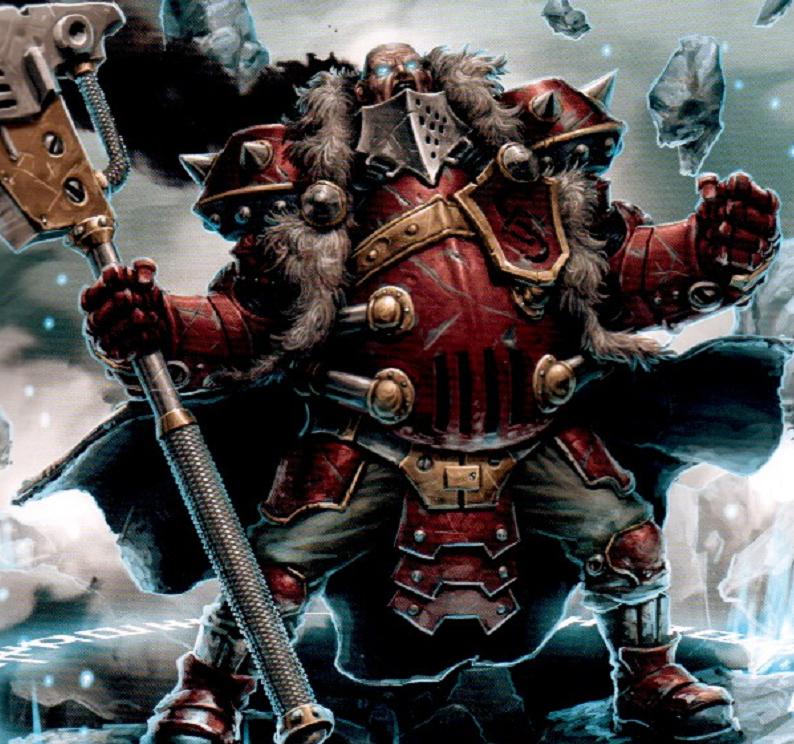
None really know the parentage or past of the immense Orsus Zoktavir, the Butcher of Khardov . One day, he just appeared in Korsk with two old warjacks, demanding to join the army. He was sent to the Orgoth fortress-turned-industrial city Khardov, which would be his only home. He was soon given a command on the souhtern border. He became notorious in 587 AR when a village north of Boarsgate Keep announced it was going to withdraw from Khador to join Ord. ORsus crushed this 'traitorous rebellion,' charging them during a parley and slaughtering the militiamen who were negotiating. Halfway through, they surrendered, but he kept killing. His men tried to restrain him, so he killed them, as well. Eighty-eight warriors were dismembered that day, at the Boarsgate Massacre. Word soon spread of the Butcher of Khadrov, and ultimately it became a matter for Queen Ayn Vanar. She absolved Zoktavir of all blame, condoning his action as that of any true patriot. Most of her kommanders guessed her intent: by parading her new weapon against dissent, she made everyone too afraid to speak or act against her. It worked - everyone knew then she would be a strong monarch. The Butcher is now an embodiment of both her strength and the consequences of treachery. Younger warcasters view him disdainfully and do not understand the leniency he is given, while more traditional warcaster like Vladimir Tzepesci see him as only a weapon. Orsus Zoktavir wields the axe Lola, rumored to be named for a dead lover. He wears a modified suit of steam-pwoered armor shaped from the hull of a warjack, and he is a terrifying one-man wrecking crew, the Khadoran face of war. His gimmick? That's easy. He smashes things. He smashes things real good. His Feat lets him drive his soldiers to a blood frenzy, improving their damage for a while.
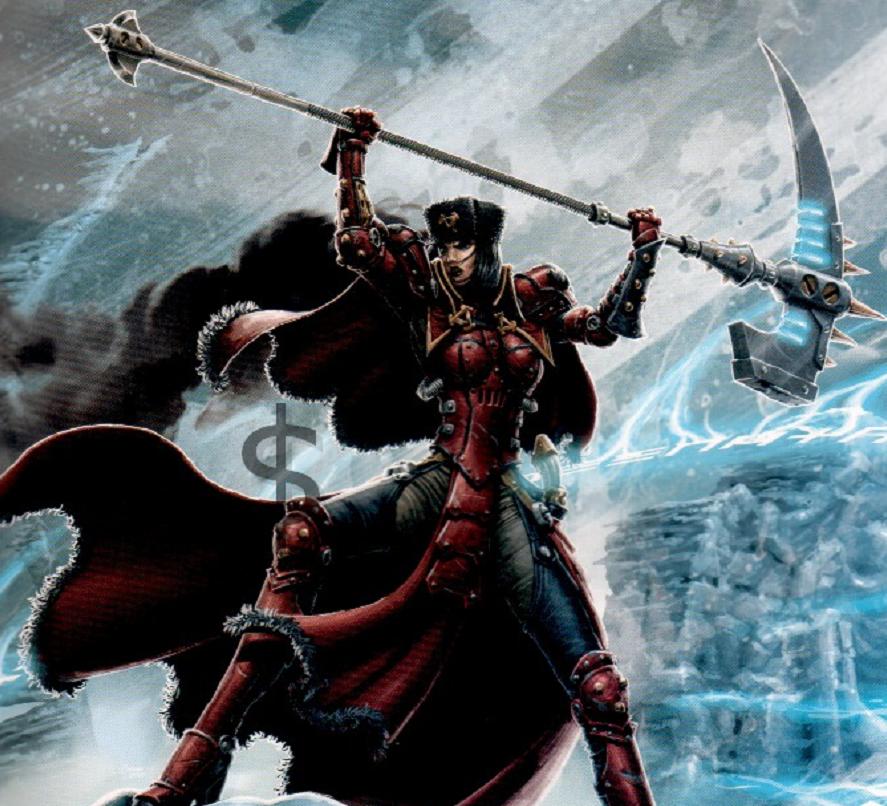
Kommander Sorscha (of the Krattikoff family) was only 13 when she decided she wanted to be a soldier like her father. Later that month, he died in the massacare at Boarsgate, at the hands of Orsus Zoktavir. Two years later, she lied about her age and joined the Winter Guard. She fought against all odds, fueled by the iamge of her father's death. She did three consecutive tours at the border, fighting Llaelese mercenaries and Cygnaran soldiers. She proved her tactical skill and was made an officer - a lieutenant. She advanced quickly to Kapitan and then Kovnik. A warcaster named Torisevich valued her opinion over all others and took her as an aide, perhaps sensing her gift for warcasting. She had already had sorcerous talents, but had hidden them for fear of being called a witch. Her potential surfaced when Torisevich died in an ambush and she was forced to fight alone. She fell, and the world froze - literally. Her enemies around her were encased in frost, and she was able to reach out to the dormant warjacks, reactivating them by mimicking her kommander's methods and sending them against her foes. Days later, she stood before the queen, showed her powers and was sent to train under Vladimir Tzepesci. In that year, they fell in love, having a brief romance before duty took her away. Since then, she seems to have become bitter, pouring her strength into battle. Only in the rare presence of the Dark Prince does she warm up, but only briefly. She claims there is no room for warmth or comfort, but many believe her fate cannot be broken from that of Tzepesci. Her gimmick is ice. Lots of ice. Her feat is that she can, one a battle, freeze any enemy not immune to cold in place for a while.
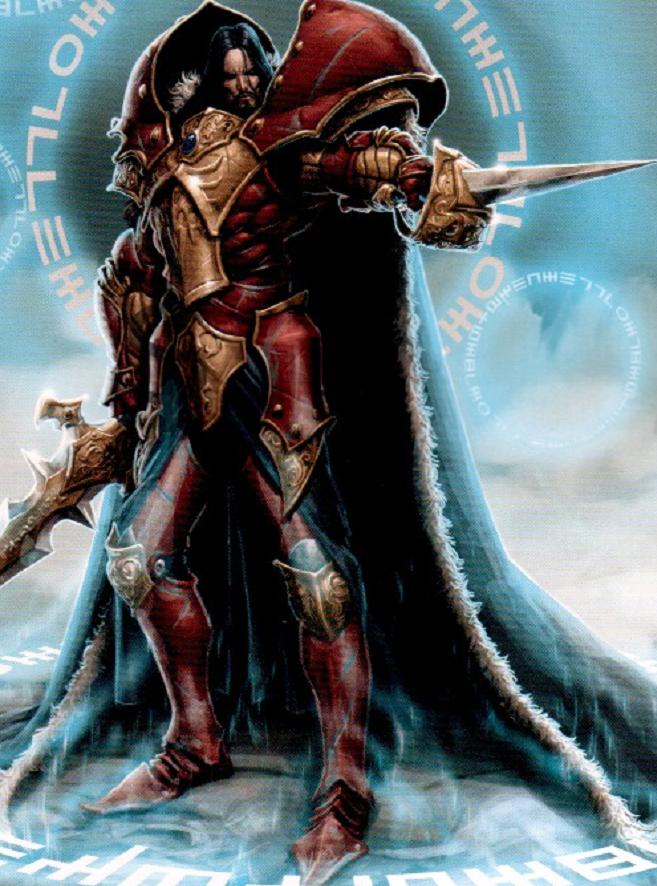
Vladimir Tzepesci, the Dark Prince can trace his line back to the noble horselords of ancient Khador. The Tzepesci are one of the old ruling families of Old Umbrey, the last of them to remain. A millenia ago, they were governors of Old Korska before it fell, and they even ruled Khador for a time. The name still resonates deeply with the eastern Khadoran peoples. Vladimir is the Great Prince of Korskovny Volozkya, one of the eighteen great houses of Khador, but he reprsents so much more. The ruling families of Umbresk and Gorzytska owe him fealty by old oaths, and his influence is enough for some to think he wants the throne. He is of a noble and ancient lineage, and a prophecy delivered to the Tzepesci kings of old foretells a great doom for Khador when the Tzepesci line is ended. Those who know it call him the Dark Prince, and men fear his gaze. He is a man of few but powerful words. He was born for war, and he has led many campaigns as a brilliant tactician and master warcaster. He is a nearly peerless swordsman as well, killing weaker foes in an instant and lingering to test his skill on the strong. He proudly wears the ancient plate of his forebears, once worn against the Orgoth by Prince Buruvan Tzepesci. He has trained other warcasters, and it's no real secret that he had a relationship with Sorscha Kratikoff, which ended abruptly and changed her. There is some speculation that he turned her aside for her low birth, but those who know him cannot believe such a thing and think it must be far more complicated than it seems. Whatever the case, Vladimir is determined to stay true to his legacy, to be strong and faithful even if it means giving up happiness. Some say his adherence to ancient tradition is just vanity, but for him, it is a defining code. He is respected for what he has done, but some say the time of Tzepesci is over, and that he is just an unpleasant reminder of bygone days. They anticipate the day he dies and his family treasures are claimed for Khador. His gimmick? Buffs. He buffs himself and his allies, fights in melee with his dual blades Skirmisher and Ruin, and he can call on his feat to force his 'jacks to expend extra effort in movement briefly.
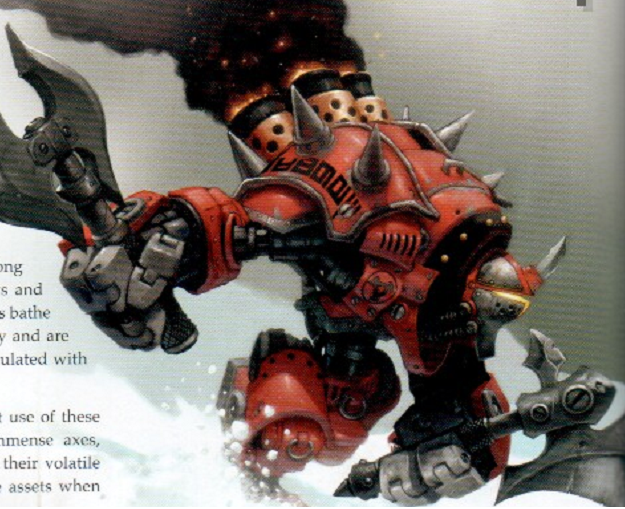
Khador doesn't do light 'jacks. The Berserker is as heavy as they come, nearly 11 feet tall and almost 8 and a half tons. It is the oldest Khadoran warjack still in service, and among the oldest used in any modern nation. Some say that is proof of Khadoran engineering genius and the timelessness of their weapons. Berserker cortexes, however, have become unstable since their first manufacture over a century ago, and they're prone to charge without orders when near combat. They are legendarily bloodthristy machines, and when critically compromised, they explode in a massive concussive overload. Those who know how to use them find them immensely brutal and useful engines, armed with a pair of giant axes. Their propensity for mindless violence and tendency to explode are actually rather useful in the right context, after all.
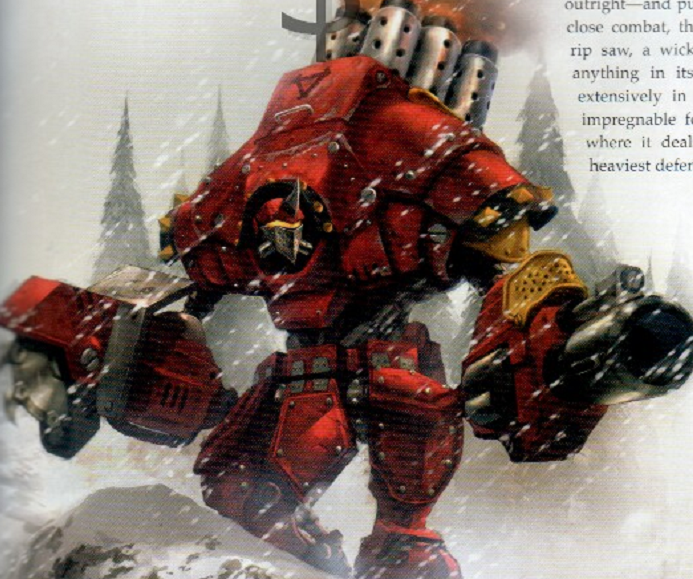
The Decimator is just over 11 and a half feet tall and nearly 10 tons. It was designed to annihilate armored targets, using the immense cannon known as the Dozer. It's got a revolving chamber housing giant ammo, which tends to send anything that it hits flying, even if it doesn't immediately get destroyed. In close combat, it uses a giant ripsaw to shred enemies. The Decimator has been used extensively in recent years to assault supposedly impregnable fortifications. It does really, really well at that.
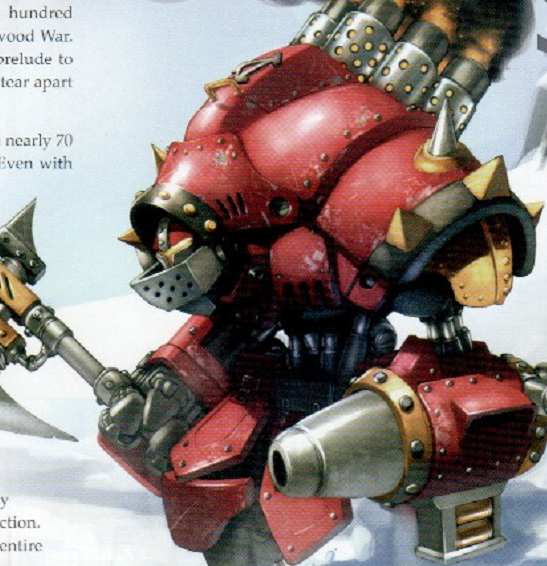
The Khadoran advancement of 'jacks has always been slow, mostly because they get built to last, like the 11-and-a-half foot, 9-and-a-half ton Destroyer . Various iterations of it have served as siege-assault weapons for almost a century, particularly in the First Thornwood War. Its current design hasn't changed in almost 70 years, and the series dates back to 480 AR. Its arms are antiquated - a simple axe and bombard cannon - but it's performed quite well against Cygnaran fortifications, and in 537 AR the cannon was improved, making the Destroyer the centerpiece of the Khadoran war engineers. It is most famous for ists bombbardments, but it's no less dangerous in closer combat - the iron-plated chassis is very tough, and the axe is strong enough to remove limbs from warjacks.
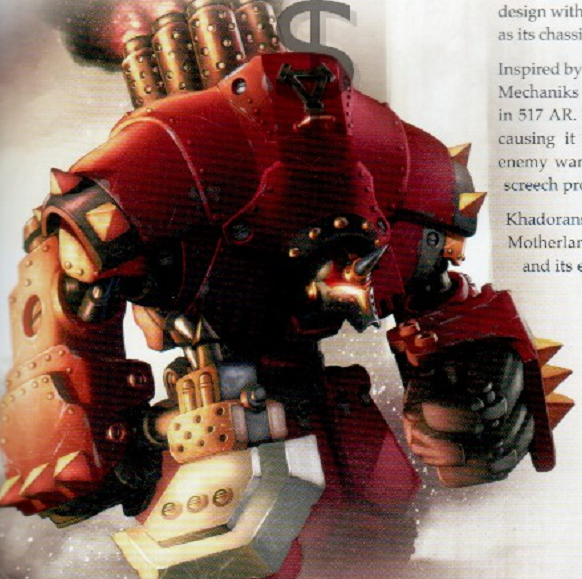
The Juggernaut is proof that bigger is better. It's over 11 and a half feet tall and weights 9 tons. The Juggernaut is brutally efficient, a giant wall of plated armor. Fewer are made today than in past decades, but they can take all kinds of punishment and get rebuilt or repaired without issue. Some Juggernauts have been serving on the front for more than a century. The current Juggernaut weapons and chassis date back to 516 AR, but the original chassis was designed in 465 to replace the Berserker. The Juggernaut forms the basis for most modern Khadoran warjacks, combining powerful steam engines with as much armor as it could be made to carry. Inspired by the Greylords Covenant, the Khadoran Mechaniks Assembly created an ice axe for the Juggernaut in 517, which encases targets in a layer of ice, making them seize up. EVen a glancing blow can freeze a warjack in its tracks. And the free hand lets it wrestle a little!
Next time: Khadoran power!
Warmachine Prime Mk. II
Original SA post Warmachine Prime Mk. II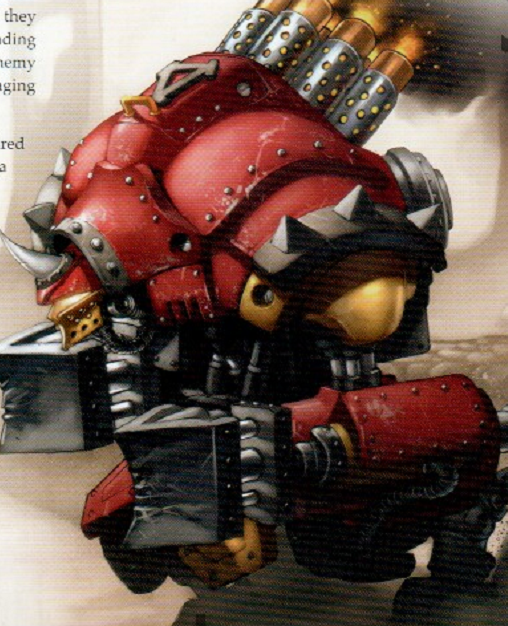
The Marauder was designed to smash 'jacks and buildings, armed with a pair of pneumatic rams. While originally meant for siege warfare, their ability to smash and hurl around 'jacks proved more useful. The thing is over 11 and a half feet tall and more than 10 tons, but can easily shove around ten tons of enemy warjack with no difficulty. The design was made by a mechanik named Targh Fedro after observing stonemasons at a quarry. He replaced a laborjack's arms with battering rams and nearly brought down an entire rock face in one blow. He took the design to the military to use with the Juggernaut chassis, and its power astonished everyone. Any warjack can smash into someone at a full charge, but the Marauder doesn't have to move to do it. With the power of its ram pistons, it can hurl lesser machines through walls with ease.
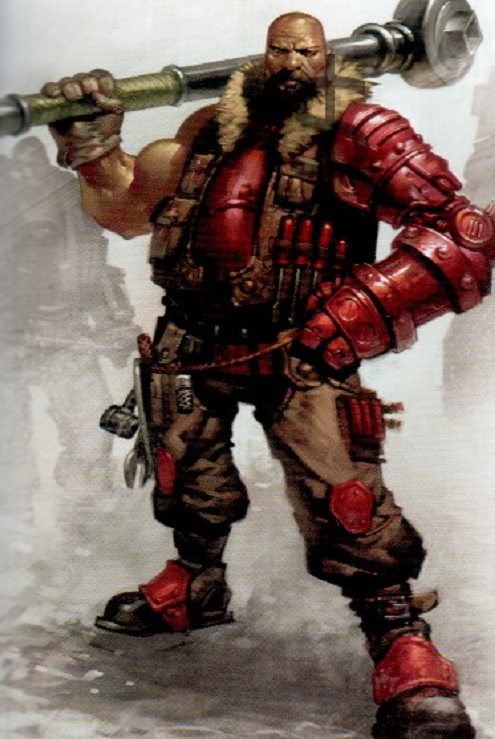
Even a Khadoran 'jack can be damaged, and in the field, it's up to the Battle Mechaniks to get them moving again. They are patriots as much as any soldier and often have to weather the worst fire to do their jobs. Most are former Winter Guard and general older than average soldiers. They're just as much at home smacking people with their immense wrenches as repairing 'jacks. They are led by the mechanik chiefs, who will do their jobs even while grievously injured, often repairing their own bodies with makeshift mechanikal limbs.
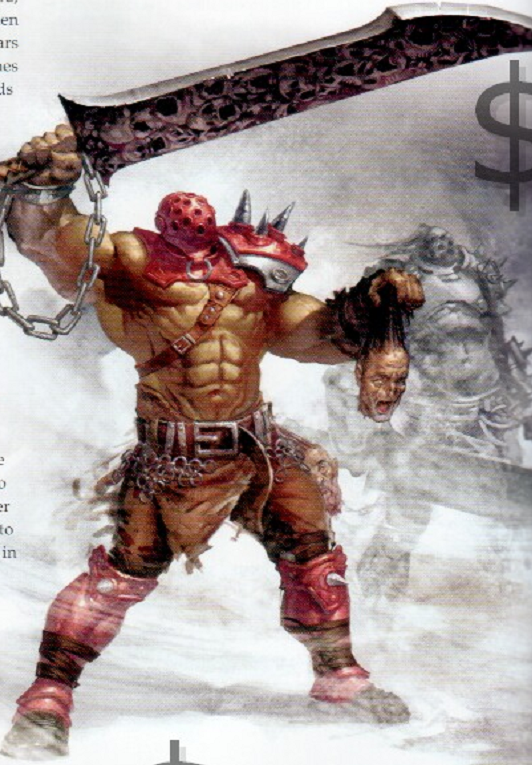
Khador is full of Orgoth ruins, and the Greylords Covenant discovered the infamous fellblades in one of them, full of dark magic that comes alive when they're wielded. The Doom Reavers are those unfortunate enough to wield them, listening to the homicidal whispers of the blades and, inevitably, going mad and lashing out with berserk fury. The crown decided to, you see, strap these swords to criminal soldiers, chaining them to the blades and using their mad urges in battle. They can only nominally be controlled, though Khadoran wizards have done their best to restrain them. They undermine morale of even the most veteran soldiers, but they've earned their share of bloody victory. So long as they work, they'll keep getting used even with the argument that fellblades are too dark and dangerous to have been unleashed.
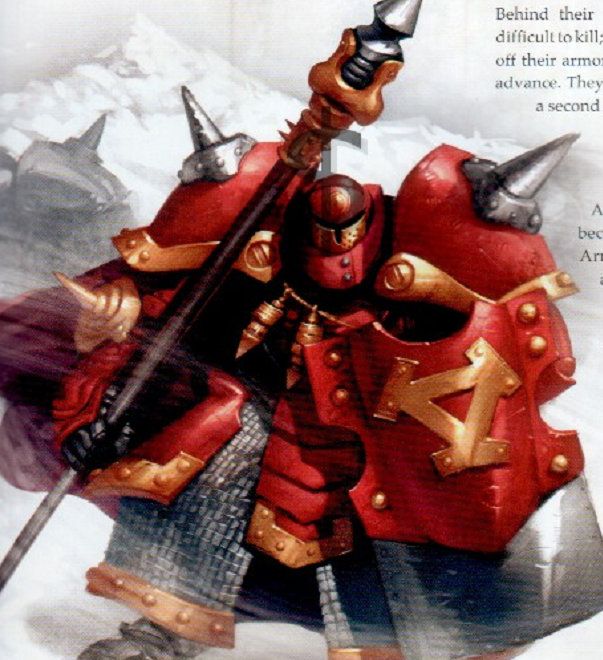
The Iron Fang Pikemen are proud warriors, able to go toe-to-toe with warjacks without fear. They are part of an ancient spear tradition, once used to fight bears and later evolved by the Khards into pikemen to face the horselords. Now, they use their powerful shields and explosive-tipped pikes to face warjacks, blasting through armor with ease. Their immense shields and heavy armor are notoriously hard to pierce with small arms fire, and they are trained to live in their armor like a second skin, even able to sleep in it. In battle, they move like a machine of death, forming impenetrable walls. Their fraternal bonds are legendary - once you join, you swear a blood oath to forget your old life and live for your fellow soldiers, your country and war itself.
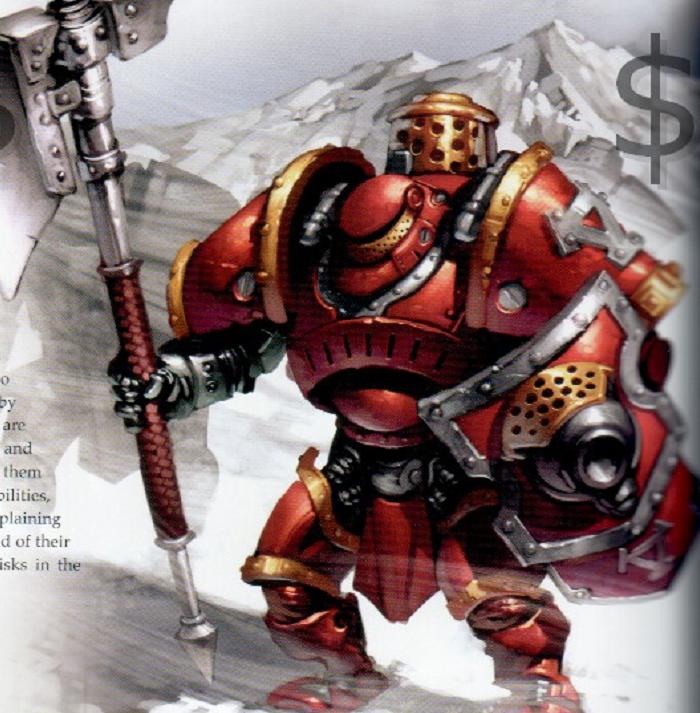
Because warjack cortexes use materials rare in Khador, the Mechaniks Assembly long sought ways to supplement them. In 470 AR, Jachemir Venianminov came up with the solution: transforming men into the steam-powered Man-O-War Shocktroopers . The suit of armor warn by a man-o-war imbues the wearer with nearly the strength, durability and protection from the elements that a warjack enjoys. There's drawbacks to wearing a giant steam-powered battle suit, though. Men-o-war are susceptible to heat stroke, exhaustion and occasional horrible death by steam leakage. Still, they are proud of their tradition and never complain or ask for comfort. The shocktroopers wield immense annihilator blades, able to split light warjack armor with a single blow. They are also trained in the use of the shield wall, but their shields are also armed by powerful short-range cannons, though the shock troops prefer to relyo n their blades. Only the most steadfast earn the right to become men-o-war, though many seek the chance. After all, it's not every day a man gets to pretend to be a warjack.
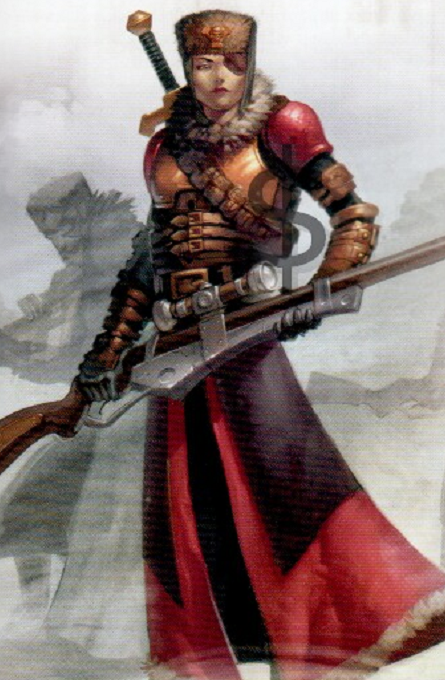
The Widowmakers are the elite scouts and snipers of Khador, and they are national heroes. The standards to join their ranks are the hardest of all specialist forces in the Khadaron army, and only those with the greatest skill with a rifle are taken. They are a merit-based corps, and open to anyone, of any blood. Their oversized hunting rifles are extremely accurate, able to take apart enemy warjacks with a few well-placed shots. Killing a man? That's even easier. Their main job is to take out officers to cause chaos in enemy ranks. They frequently go ahead of the main battlegroup and are only noticed because officers abruptly fall over before the gunshot is heard. They also support strategic withdrawals to keep the wounded from being captured...or to kill the wounded if they are. After all, a true patriot knows it's better to die of a bullet than to be tortured. Widowmakers know that fear and hatred are part of their job. Officially, they are not used in domestic conflict, but rumor has it that they've been employed to take out dissenters, rabble-rousers and corrupt nobles. They expect little charity if captured, and Cygnar generally hangs them without trial.
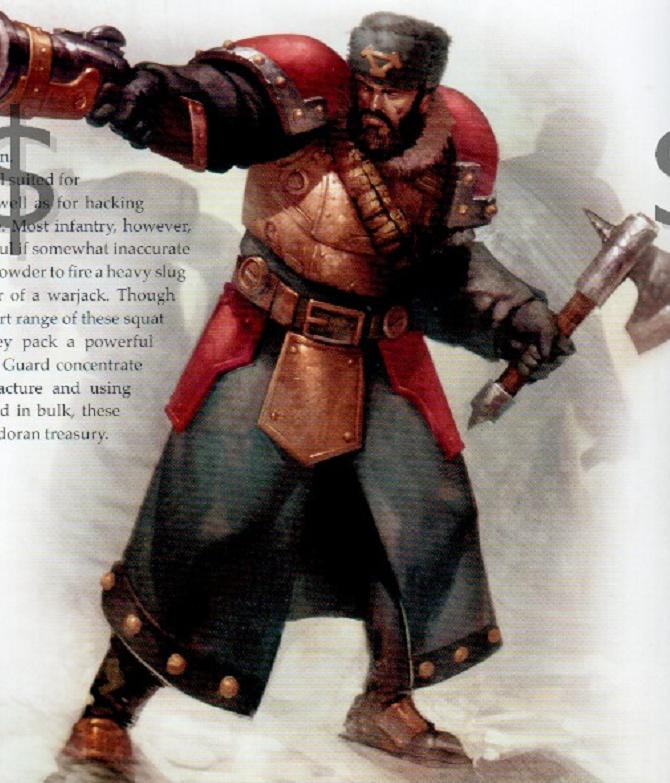
Every Khadoran boy of 17 is conscripted into the Winter Guard Infantry . Women can also join, but are discouraged if they are mothers or caring for children. Some Winter Guard are police forces patrolling towns and cities, while others fight on the front line. Increasingly, people look to them as protecotrs against unexpected threats. Their equipment has changed only slightly since they were founded so long ago - their battle axes are strong and useful for mundane tasks as well as killing people. Their main weapon, though, is the blunderbuss, a powerful if rather inaccurate firearm that can shoot a heavy slug right through warjack armor. The southern nations prefer rifles for their range, but the blunderbuss definitely packs a punch, especially in concentrated fire. They're cheap to make and their ammo is easy to produce, so they don't strain the budget much, either. The Winter Guard are the majority of the Khadoran military and are the core of every garrison or sizable combat force. Their training is designed to get them ready for battle as soon as possible, and so far, Empress Ayn Vanar has been able to maintain a constant flow of reinforcements affordably by running many Winter Guard training camps, from the largest complex in Volningard to the rural outposts near Uldenforst. Through their training, they learn patriotism and bravery more than anything else.
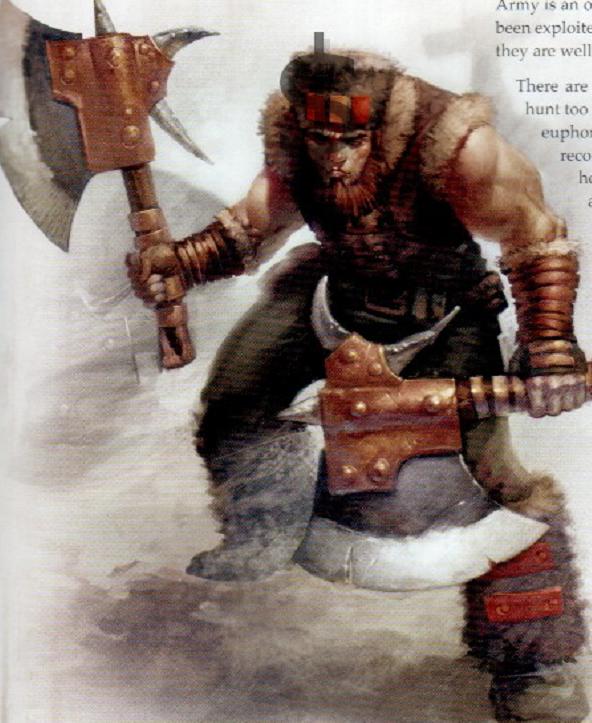
The finest Khadoran hunters and trackers become Manhunters , at home in the hostile wilderness. They are masters of camouflage, working as scouts and assassins if paid well enough. They often accompany recon teams of Widowmakers and Kossites to strike from behind enemy lines. You wouldn't think big muscleman with dual axes would be stealthy, but they really are, and they're very efficient killers. Hiring them is an old, old army tradition, and their value has been exploited in many wars. They are paid quite well for their work. There's rumors of manhunters who love the hunt too much, who give in to their animal urges and the euphoria of murder. They often have track records good enough to offset the rumors, though - there's no one better at chasing an enemy down.
Next time: FOR THE DRAGONFATHER
Warmachine Prime Mk. II
Original SA post Warmachine Prime Mk. II
The Cryx text is written by Darragh Wrathe of Cryx. Cryx is in service to Lord Toruk, the Dragon God. Toruk's ancient plan is now reaching its final stages, and Cryx exists to ensure his vision is realized. The Dragonfather's goal is simple: he's going to take over the world. Cryx has hidden its strength for a millenium, to avoid humanity uniting against it and delaying the inevitable and unstoppable success of the Dragonfather. Now, with every gunshot, the numbers of Cryx grow. Death strengthens them as it saps their foes, and nothing can stop them and their tide of blood and plague. Every village is a lgion, every city slaughtered a fortress gained. No army is more loyal. But they do not war for the sake of conquest - Cryx has no care for resources or land. Everything they have is a weapon to be expended in the name of Lord Toruk, every resource committed to Toruk's total victory. Good service is rewarded with existence beyond death, while poor service means your bones will fuel the engines of necromancy and your soul the fires of power.
Toruk himself is old beyond mortal comprehension. The only creatures worthy of his attention are his children, who alone have the power to hinder his goals. In a time long before all that live, Lord Toruk was alone, and thus sought to duplicate his own perfection by creating a brood to serve him. He took his essence, his heart-stone, the athanc, and he divided it into slivers of living crystal, from which the dragons were born. The essence of them was, however, too pure - they could not humble themselves, even before their creator. Each considered itself a god and would not bow to the Dragonfather. Instead, they turned on him, and he realized his mistake only after they attacked. This was the War of the Dragons, a battle that has persisted for millenia. Over the centuries, Toruk has slowly annihilated his children, with each kill restoring a fraction of his athanc. The names of the fallen are forgotten in some cases, but Cryx known of the deat h of Shakzk over the island that would become Satyx, and the death of Gaulvang, but there have been others. Each was a mighty serpent that died under Toruk's claws, leaving their searing blood to mark the land as reminder to others. However, the dragons realized the inevitability of their destruction. Even the mightiest could not, alone, face Toruk. Sixteen centuries ago, the survivors put aside their differences to create an alliance. Acting as one, they struck and the skies burned.
Toruk is, of course, immortal and imperishable, but he could not defeat the dragons, nor they him. At last, Toruk conceded and withdrew, descending on the Scharde Islands, where he built his empire. For sixteen centuries, Cryx has evolved with Toruk shaping all aspects of life and death, forged as a weapon to end the Dragon War. Toruk is not alone, for there are among Cryxians his greatest servants, witness to all of history in their immortal undeath. The Dragonfather has left rule of Cryx to his twelve lich lords, who stand above all others. Once, you see, fourteen pirate kings ruled the Scharde Islands. When Lord Toruk came, they were fools and could not recognize his power. Each thought themself a master of a great fleet, and together, they tried to defeat Toruk. He could have annihilated them, but he knew he needed the seeds of empire. He sent an emissary with his demands, but the pirate kings slew the messenger. The mightiest of these kingds was Threnodax, and it was he who led the others in defiance.
Among the fleets was one ship mightier than the rest: Atramentous, once a Tordor warship stolen by Threnodax as his flagship. Even then, it had a reputation for terror. Toruk chose to take this vessel and turn its crew against their king. He came to the Atramentous and slew the crew and captain in one blast of flame. He took their souls and gave them new life in death, making them revenants bound to the ship such that it could retain them even past the destruction of their flesh. This was Toruk's lesson on the futility of resistance. The ghost ship came to the pirate kings in the fortress of Darkmoor, its unliving crew setting the harbor ablaze and culling the living crewmen. Each death added to their number. Thirteen of the kings gathered in a fortress tower to watch in horror. The only one absent was King Moorcraig, who had perhaps heard of the Dragon God's coming from some oracle. His time would come soon enough.
The Dragon King smashed the fortress to ruin with his weight, leaving only the kings' tower. All but Threnodax bowed in fear, but he alonbe spoke defiance. Toruk consumed them all in one breath, but the twelve who had bowed were reborn, their souls enslaved as the first lich lords, Toruk's new vassals. Threnodax was consumed for special torment, and perhaps still dances in endless agony today. Moorcraig hid within his castle, hoping his ancient relics would save him. The Dragonfather destroyed the castle and Moorcraig in terrible fire. The lich lords, for their part, wasted no time founding the empire, privy to the secrets of the Dragonfather. Their efforts gave rise to an unstoppable army and a unique nation, worthy of Toruk and capable of defeating his wayward progeny. Few of the original lich lords remain today, but Rouk ensures there are always only twelve. He allows them to rise and fall by their virtue and ambition, with the weak destroyed by the strong, who replace them.
In the early centuries, the lich lords divided governance between themselves, each finding a role in the empire. They gathered and united servants with their new powers, bringing the pirate holds and villages to heel and making examples of the resistors. They crushed whatever petty religions these fools clung to, giving them a choice: serve in life, or serve forever in death. Toruk became the sole god of the islands. He began a tradition of occult lore and organization, of which the latest generation are the inheritors, translated by such undead masters as Daeamortus, Asphyxious, Tenebrus, Fulmenus, Venethrax, Morbus and Corripio. They have mastered the arts of reanimation and soul extraction, using those potent energies to reshape the land and people themselves. Some call it blight, and it seeps into all things, inevitably, the brand of the Dragon God. Other servants were gathered for knowledge, potential and martial skill. They helped the lich lords raise armies and conquer. One of the first sent to the mainland was the iron lich Asphyxious, who had a great mastery of death. He was not one of the pirate kings, but dates back to that era, and Toruk saw he was a peerless weapon, gaining a form like that of the lich lords to perform his mission.
The arrival of Orgoth, however, gave pause to the lich lords. They decided to wait, bide their time and strengthem themselves while Orgoth broke the mainlanders. The Orgoth came to the Scharde, but Toruk sent their ships to the bottom of the sea, still burning. He chose to allow them to occupy the island of Garlghast, but any ship heading through Windwatcher's Passage was destroyed utterly. The Orgoth were worthy foes, and they were carefully observed to see why Toruk willed patience rather than immediate destruction. For over two centuries, they watched the mainlanders rebel and fail, over and over, and they learned much. They learned of mainlander tactics and skills, and through it came invention. Even though the lich ;ords had created an entire occult science to perfect their war machines, they were not so arrogant to refuse useful innovations. They have always turned the tools of their foes against them, after all. When the colossals fell against the Orgoth, Cryxian agents stole their debris and the corpses of their controllers. By this, they learned how to make their own war engines.
They have fueled all industries with the advancements of the mechaniks of the mainland. When one of them dies, Cryx is there to steal the corpse and the soul for secrets. Through necromechanikal principles, they have created the thralls, bonejacks and helljacks. They mine necrotite from those places of mass torture and death, where life energy bleeds into the mud and stone themselves. It is a great resource, but even moreso are the souls of the living, which are fuel for the engines. When the Orgoth were finally driven back to their stronghold on Garlghast, Drer Drakkerung, by the mainlanders, Toruk was ready. For years, the necrotechs of Skell, Dreggsmouth and Blackwater had made weapons to equal those of Orgoth, and while the invaders were wizards of great skill, and their corpses proved resistant to interrogation, subtlety defeated them.
At last, the forces of Cryx attacked. The mainlanders foolishly believe they set the Orgoth fleeing across the Meredius sea, but it was only the first blow. The final victory was at the hands of Cryx at Garlghast, when five lich lords led the battle ten thousand soldiers strong. It was an immense power, unrivaled in all of Caen. The Orgoth sought to leave ruin alone in their wake, that none might profit from their defeat. When they saw they were losing, they invoked a final conflagration to try and destroy themselves and Cryx alike. Drer Drakkerung was blown open in a massive eruption that slew three lich lords instnatly. The two survivors were forever changed, forced into sleep after the near destruction of their physical forms, and their minds were forever warped, unsuitable for war. They serve still, but now in Skell, where their minds contemplate deeper mysteries. Toruk deemed this a fair price - even the loss of so great an army was inconsequential to his plan. But time would needed to recover. Time is nothing to the dead, so this was no problem.
At last, the secrets of the Orgoth were torn from their dead. The lich lord Terminus personally found their method of making the blackships, revolutionizing Cryx naval warfare and giving birth to the modern Black Fleet. Even now, the other nations are unaware of the full strength of Cryx's navy. The pirates that threaten their coasts are but a fraction of the true power that waits. Toruk chose that time to extend control into the continent, choosing Daeamortus and Terminus to replace the fallen generals at Garlghast. Under their supervision, Cryxian influence was extended throughout Immoren, searching for the Dragon's children.
Today, even Cryx's apparent defeats at Highgate, Ceryl and Westwatch are part of Toruk's plans. The loss of an army is nothing. His brood is arrogant, but shrewd, not revealing itself openly. They hide among men, lashing out at those that get close. Each holds a sliver of Toruk's power and immortality, and even the last dragon is a match for legions. Cryx knows the general locations of several dragons. Blighterghast is the nearest, haunting the southern Wyrmwall mountains, always watching Cryx. It was the first to organize the lesser spawn against Toruk, and even now it watches to be sure Toruk does not stir, or it will summon the others to fight. Discovering Blighterghast's lairs has proven difficult, however, as it hides its movements among those of Cygnar's navy and army, though it knows Cygnar would slay it as much as Cryx would, so it has not interfered with them. Thus, to get to Blighterghast, the fleets of Cygnar must first be destroyed. Thralls await in the mountains for that day, when Blighterghast can be rooted out, but it may not be the best initial target.
Other spawn are further - including Scarfang and Halfaug, who roam Khador and Rhul. Others dwell on the remote end of the Abyss. These are but mere annoyances to Toruk, but great problems for Cryxian legions. Diversionary attacks on Khador's coastline have allowed other troops to reach its interior, seeking the two dragons there. The last several years have shown much hunting for the dragons. Cygnar remembers another such string of raids, the Scharde Invasions, orchestrated to lay the foundation for future conquest of Immoren. From 584 to 588, Treminus and Daeamortus attacked the Cygnaran coast in order to diver their forces from noticing the construction of permanent bases on the continent. Once those were ready, the raiding ended. Cygnar believed themselves victorious, but they were just dupes. For decades, the agents deeper inland have had only sporadiic support, though - supply lines are too distant and tenuous, too vulnerable. Under the cover of the Scharde Invasions, Asphyxious was sent to start a plan for a self-sustaining infrastructure that could operate autonomously.
Agents scouted necrotite harvesting sites for years inland, constructing vast underground networks to house secret necrofactoriums. In these tunnels, new machines and soldiers could move about undetected, and the undead armies began to grow beneath the soil. The invasions ended, and the larger operations were hidden for a time, until 604 AR and Khador's invasion of Llael. Ctgnar responded predictably, and Cryx had only to pick clean the battlefields. Asphyxious' army gathered beneath the Thornwood, sweeping into the heart of the war to steal corpses and materials. It only got more porfitable when Menoth got involved, adding their own corpses to the harvest. However, the Menites are a unique obstacle to the plans of Toruk. Cryx needs not only access to the dead, but to their souls, and those who serve Menoth interfere with that by His intervention, taking His followers' souls away from Cryxian industry.
Cryx has been secretly working against the Menite faith, stealing relics and desecrating tombs, even assassinating leaders. One great plan focused on the corruption of the Harbinger of Menoth, who gives much strength to her nation. So far, she has evaded all assassinations and subversions. She must die. Recent years, however, have shown strange movements from one of Toruk's lesser children. Its unusual behavior suggests that the subtle war between Toruk and his spawn may soon be an open one. The lich lords have known for some time of the dragon Everblight, weakest of Toruk's spawn. It is said that Toruk nearly devoured Everblight almost four centuries before Cryx was formed. Everblight fled towards the lair of Gaulvang, who was eaten in its place.
Little else was known until 390 AR, when Everblight obliterated the Iosan city of Issyrah and was then defeated by the combined might of all of Ios. Despite its apparent destruction, it did not die. Every dragon holds a piece of the imperishable Toruk, so only a dragon can kill a dragon. They will return from even the total destruction of the flesh. However, Everblight became even more elusive and unpredictable. All that is known is that it exists and its minions are proliferating and gaining power, and even the mortal nations have noticed. Everblight had nothing to do with the dragons' alliance, and even attacked and consumed the weakened dragon Pyromalfic that once lived beneath the Castle of the Keys. This made it an enemy to the other dragons, which Toruk might take advantage of. There are many opportunities now for the patient, and the victory of Cryx and the Dragonfather are, of course, inevitable.
Next time: Service In Death
Warmachine Prime Mk. II
Original SA post Warmachine Prime Mk. II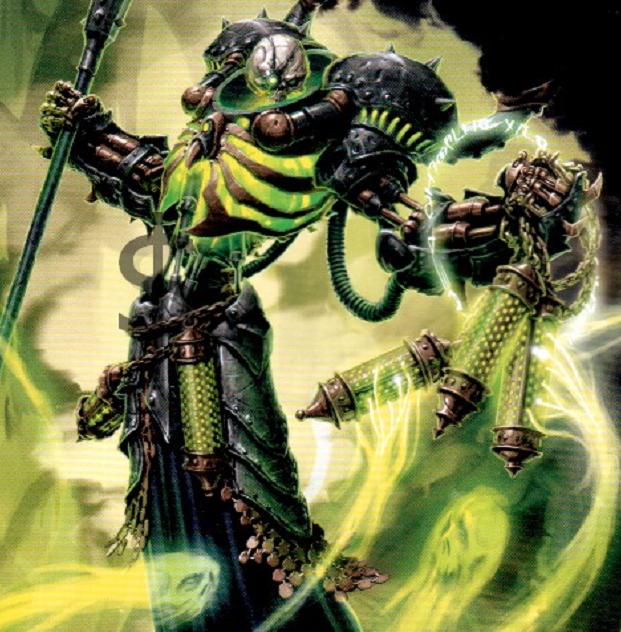
The Iron Lich Asphyxious is Toruk's chosen instrument on the mainland and the leader of all of Cryx's armies. He has carved out a bastion for Cryx in the Thornwood, where he harvests evil and despair from old battlefields. He has almost forgotten his mortal life - it was much shorter than the 16 centuries of unlife. He once was a member of the Circle Orboros, tasked to watch over the Scharde Islands. When he saw Toruk claiming the islands, he realized the true shape of power. He was a druid who watched the birth of Cryx and the death of the pirate kings, jealous as he saw them remade into lich lords. He renounced his vows and went to Lord Toruk at the site later known as Dragon's Roost, in the shadow of a great volcano. He offered himself up in exchange for even a fraction of draconic power. Toruk made no promises, but instead asked Asphyxious to leap into the volcano. The man didn't hesitate at all, and Toruk scooped his bones from the magma and raised them up with the druid's dark soul, which eh placed in a metal vessel of power that Urcaen could not take it. Thus was the Iron Lich born. After the forges of Skell were completed and began to make the firs weapons of Toruk, Asphyxious and the Lich Lords had their brittle bones wrapped in dark steel, given strength and durability beyond that of their human frames. Asphyxious then began to master necromancy, studying for sixteen centuries. He looks now to serve his god on the mainland, to destroy its cities and release an unending tide of souls to gain power from. He destroys all he comes across, corrupting and withering it. His body must be powered by fresh souls, which he harvests with the two-pronged spear Soulsplitter, which is bathed in raw entropy. He is a crafty and terrible foe with no qualms about anything. His gimmick is firing corrosion and blasts aorund everywhere, then hoovering up souls to empower his 'jacks. His feat lets him hurt any nearby living foes to empower himself.
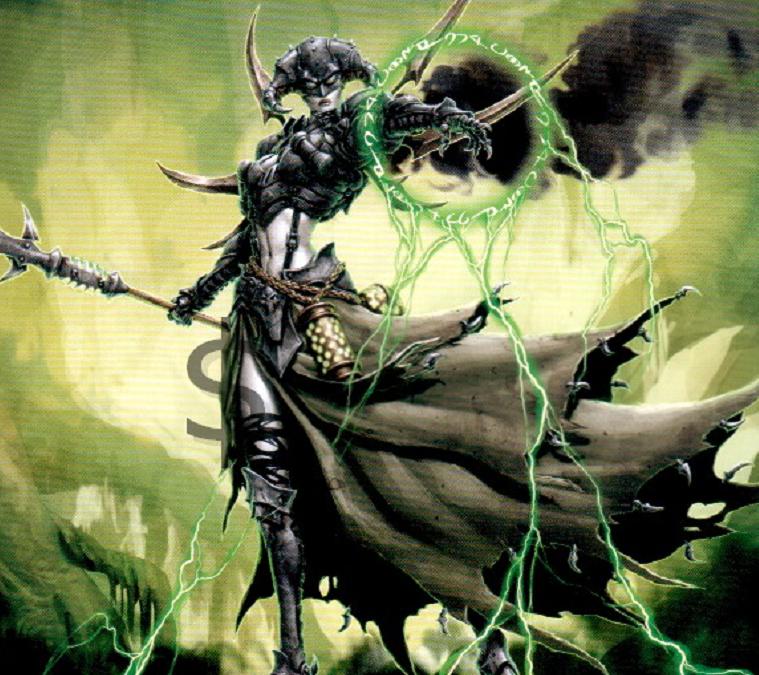
Warwitch Deneghra leaves a path of devastation in her wake. She is a terrifying beauty, wielding magic that drives men insane and then breaks them to her will. She dances and laughs in battle, easily avoiding the chaos around her and killing with her bladed armor and her great mechanikal spear, Sliver, which turns her enemies' own shadows against them, then traps their souls in cages hanging at her belt. The warwitches are always cruel and depraved, and Deneghra has been warped such by Toruk's influence that some think she has lost all humanity. None who knew her as a child would have guessed her eventual fate. She and her twin sister lived in a small village on the Cygnaran coast, but occult portents revealed by Skarre Ravenmane indicated that she was born a sorceress of immense potential. Asphyxious sent Skarre to ensure this asset was procured, and Skarre succeeded, taking the captive back...but what she did not realize was that the prophecy had in fact foretold the birth of twins, not one girl. Asphyxious discovered these misread signs later, too late to easily fix things. Still, Deneghra was an apt student, taught personally by Asphyxious. She excelled at magic and the command of helljacks, and when he deemed her ready, the iron lich told her the great secret: she had a twin sister who held the other half of her soul. A Cygnaran sorceress, he said, who had stolen her essence, keeping her from reaching her full potential. Deneghra begged him to let her join his invasion so she might find that twin and reclaim the stolen power. Pleased, Asphyxious made her his lieutenant. Deneghra now has only one goal: to kill her sister and claim her birthright. Her gimmick is debuffs and mind control, and her feat is a giant debuff to any enemy nearby.
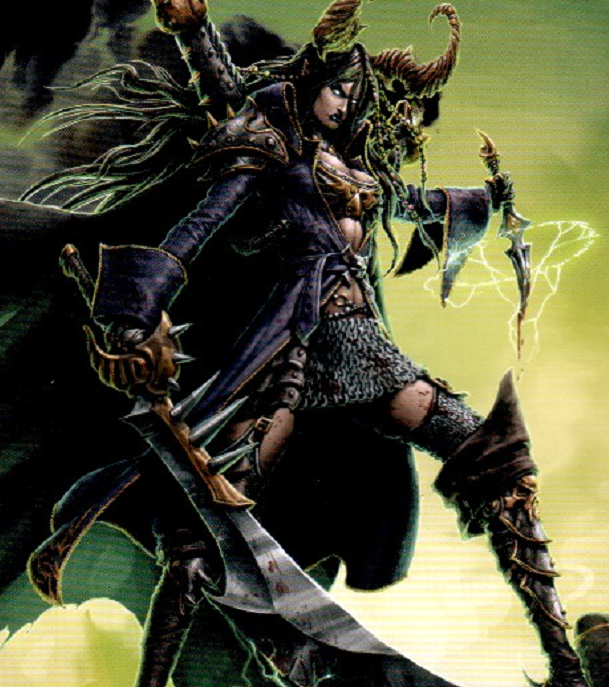
Skarre Ravenmane, better known as Pirate Queen Skarre , is the ruler of the Satyxis, the warrior-women of the island of Satyx who have been blighted by dragon blood to become something more than human. Her ship, Widower, strikes frequently on the western coast, often without apparent rhyme or reason, as she follows mystical omens revealed to her by rites of death and blood. For decades, admirals and captains have tried and failed to predict her movements, and any who faced her died. She sends forth the undead and helljacks from her ship to obliterate resistors. Even the Orgoth feared the Satyxis reaver witches, and few know better than Skarre the power of blood magic. Sacrifice is vital to her power, and she carries a millenia-old ritual dagger with which she drains the energies keeping her comrades together - living or dead, willing or not. That blade then unlashes potent curses on her foes. Skarre controls the Satyxis by strength and cunning. Her bloodline is famous, and her mother ruled before her, but Satyxis leadership is proven in battle, not inherited. Even as a youth she dominated her kind by magic and will, for she can see patterns in the spray of blood and the feelings of pain. She has always destroyed any who plotted against her, and the lich lords know her as an effective tool and weapon. Her true loyalty, however, is to Toruk, not any lich. Her gimmick is sacrificing allies for power, stealing health and then generalized leadership stuff. Her feat trades her own health to buff her allies.
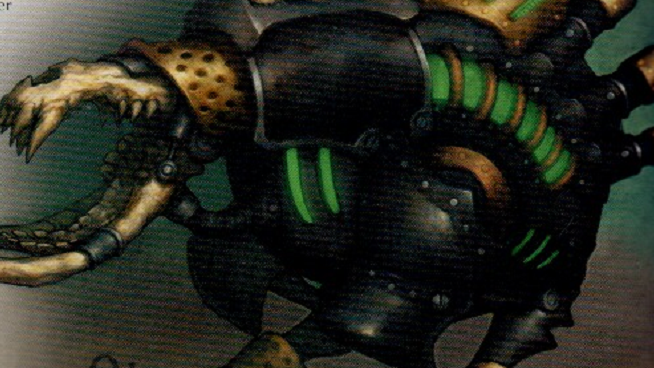
The Deathripper is the quintessential bonejack. It's not big - just under six and a half feet and only two and a half tons - but it's swift and fierce, and it serves as an excellent conduit for magical spells. Poison smoke and steam flow from its necrotite engines, and it produces a distinctive and terrifying keening. It is made mostly out of black iron and steel fused to the skulls and fangs of blighted beasts, which it uses to sever limbs and shear through armor. Just a few Deathrippers will make short work of a light warjack. While arc node technology was originally Cygnaran, Cryx figured it out very quickly by stealing the corpses of engineers and interrogating them. They improved on the arc node process via profane materials and unholy techniques to make it cheaper, so Cryxian warcasters often have a small swarm of node-equipped bonejacks.
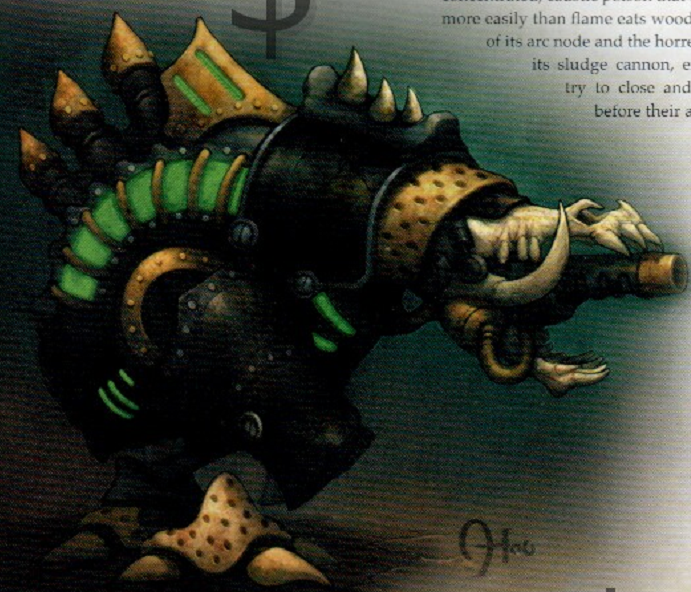
No two bonejacks are exactly alike, but they do come in common forms. The Defiler is an example of the fast and deadly little things, just under six and a half feet and just over two and a half tons. Cryx has few limits on cortex production, thanks to the necrotechs - mad, undead geniuses who produce a nearly endless supply of weapons. The Defiler is fast and mobile, able to cross batlefields quickly and rain down death froms its sludge cannon or arc node before the fight has really begun. It avoids close combat, unlike its Deathripper cousins, preferring to spew caustic, metal-eating sludge at foes. In close range, about all it can do is feebly headbutt things. The trick is getting there before you're torn apart.
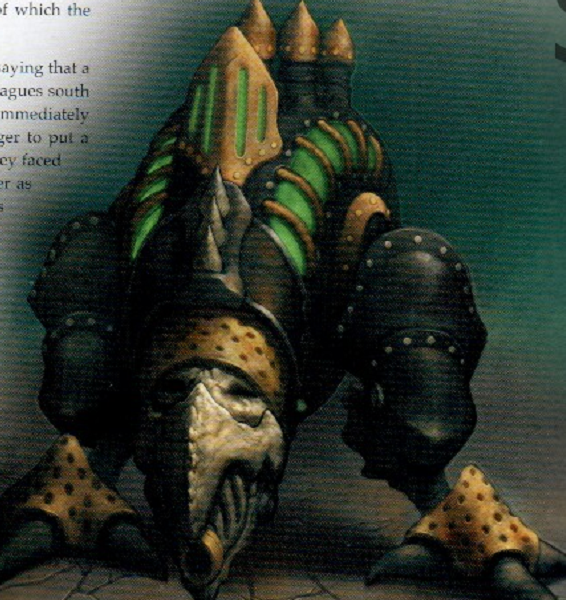
The Nightwretch , as many Cryxian weapons are, was tested on Cygnar. It's almost six and a half feet tall and almost 3 tons. While it isn't the toughest machine in the world, it's armed with a head-mounted cannon that fires a mix of lead shot and alchemical waste, causing the projectiles to explode in a concussive blast. The first testbed had no survivors - the entire company of Cygnaran troops was rendered a smoldering heap by the 'jacks, and they went into mass production. Like all bonejacks, they also serve as an arc node, and can feebly headbutt in a pinch.
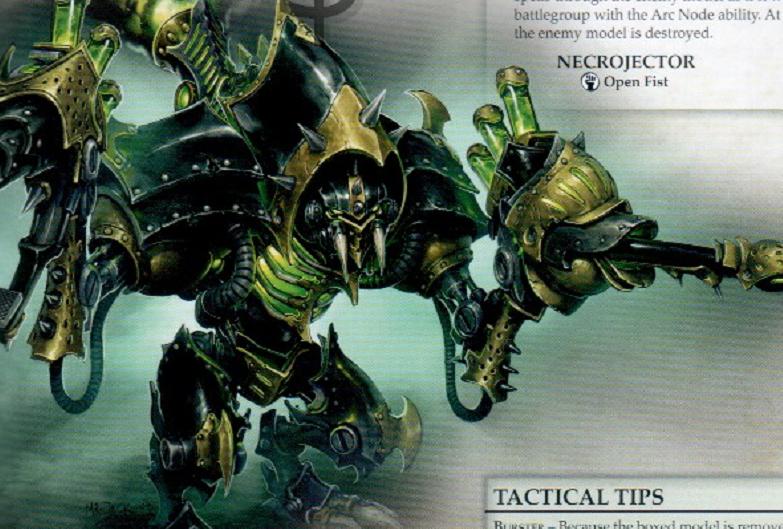
The Corruptor is a helljack, the Cryxian equivalent of a heavy 'jack. It's twelve feet tall and nearly seven tons, designed to deploy venomous weapons that consume both body and soul. It is armed with both a necrosludge cannon and a necrojector claw, which both use alchemical toxins that make the human body explode in acidic filth and strip out the victim's soul, which is channeled through the Corruptor to the warcaster, who can use the dying soul as an arc node and healer for the machine, or to heal themselves.
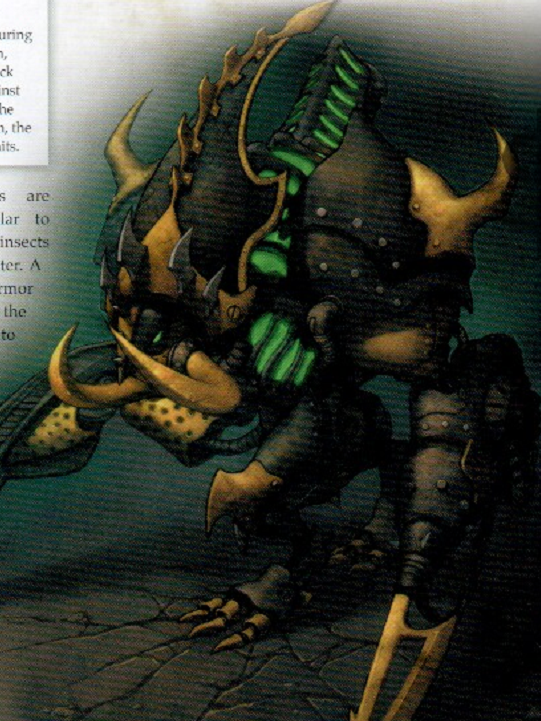
The Reaper is disturbingly reminescent of a giant insect. It's nearly twelve feet tall and six and a half tons, and the mix of bone and steel that makes it up often looks like living chitin. Its cortex is bloodthirsty, and it has only one job: kill. It fires harpoons into its foes, then reels them into range of its terrible helldrivers - a pair of arm-spikes driven by really powerful pistons, each easily capable of punching through steel plate and most warjacks.
Next time: Thralls
Warmachine Prime Mk. II
Original SA postSlayer's right here, ya jerk! I try to limit post sizes.
Warmachine Prime Mk. II
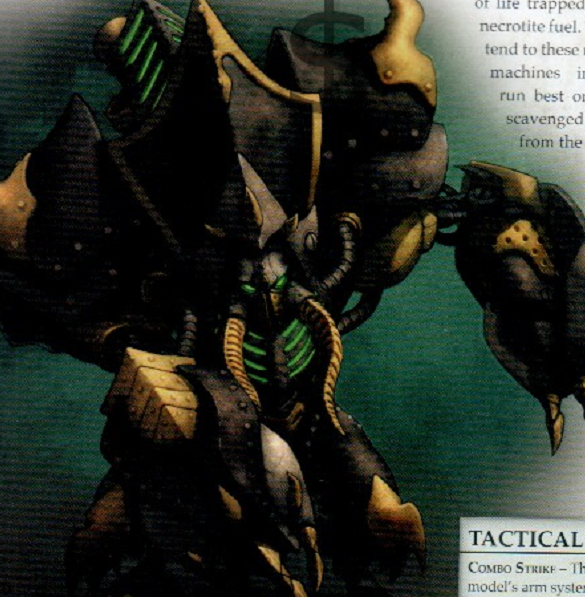
The
Slayer
's soulfire engine pushes it on and on to endless destruction. It stands nearly twelve feet tall and almost six and a half tons. The eerie glow from its furnace and eyes has given the name Cryxlight to any source of green light, like those often seen in bogs or fens. Its claws are strong enough to rend metal and bone, and its vicious tusks are taken from the skulls of great beasts and bolted onto the armored skull it uses for charging. The furnace is powered by the souls of the dead trapped in necrotite, and the necrotechs insist it runs best on necrotite scavenged directly from the field. The claws also make good tools for wrestling!
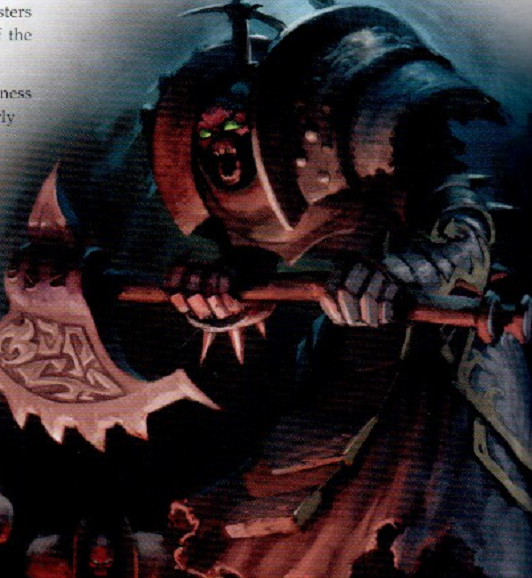
Bane Thralls
are undead warriors inscribed with runes that make them more than mindless zombies. They are excellent killers, full of an internal darkness. Few know how they are created saved the masters of necromancy. They are always surrounded by darkness that weakens flesh and saps light. Their forms are obscured even in bright daylight, and they are driven by a hateful intelligence. They love slaughter and death, and sometimes can be heard whispering to each other in some ancient tongue, as though planning an attack. They are disciplined soldiers and fearless in all things. Cryxians themselves only dimly understand the horrors they raise, which seem tied to some force beyond Caen that feeds on death. Some darkness never goes away.
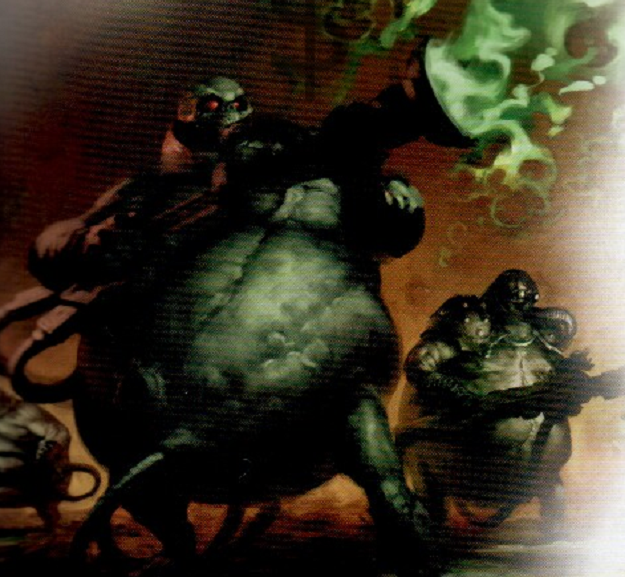
The
Bile Thralls
are notable for their bloated, distended bodies and the gurgling noise of the pumps inside them. They contain corrosive agents, which extend from tubes in their mouths and other orifices to end in firing mechanisms, allowing them to spray caustic fluids over wide areas. In the middle of enemy troops, they can also force themselves to perform an explosive discharge, decompressing their pressurized innards into an explosive shower of fluid and flesh, which quickly corrodes anything caught in it, metal or flesh. Bile thralls are typically deployed in the dozens, sending them slowly across the field until the right moment to blow themselves up. They destroy enemy morale very well - those who witness them have been known to go for days without eating.
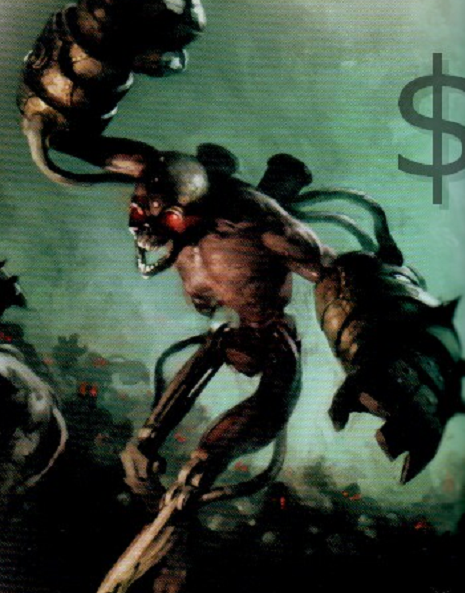
Mechanithralls are the favored tool of dark warcasters, undead armed with powerful steamfists that crush heads quite easily. They're made quite easily from the corpses of the dead, so they're definitely not in short supply, and they can be very disheartening to face, if they still have their old faces on. Mechanithralls have no fear, charging headlong into their own destruction and relying on their terrifying strength, which rivals that of steamjacks. They obvey blindly, but are capable of using basic tactics, perhaps remembered from life.
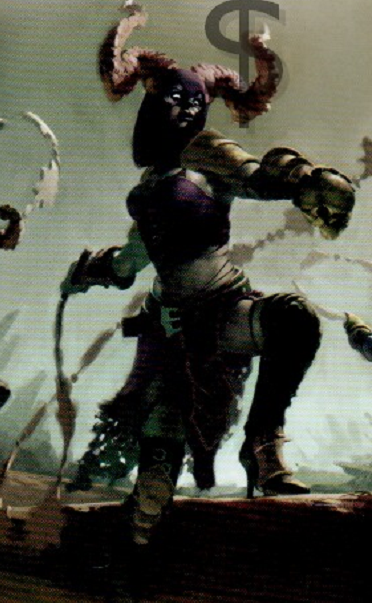
The
Satyxis Raiders
haunt the waters of the Meredius as pirates, filling the Sea of a Thousand Souls, the Windless Wastes, the Wailing Sea, the Dying Strands, Sailor's Lament and more. Even in a region renowned for pirates, the Satyxis are feared specially. They are an ancient sailing tradition, warrior-women who love nothing more than plunder and slaughter. Even when they were sitll human, they were brutal blood sorcerers and extremely cruel. In 1640 BR, the Satyxis were changed forever when the dragon Shazkz fought Toruk above their island, spilling blighted blood like rainfall. The men were reduced to withered husks, and the women became something more than human, horns growing from the skulls and their cruelty magnified. Over the next six centuries, Satyx became a mainland legend. When Toruk arrived to claim it, the Satyxis queen bowed to him, having foreseen his arrival. She offered a tithe of soldiers to serve his lich lords. The foremost of these are the raiders, who wield barbed whips main to cause pain and flay flesh. So skilled are they, in fact, that they can harm a warcaster through their 'jack.

A
Necrotech
is half necromancer, half mechanikal genius, with a dash of madman. Their job is to build the undead soldiers and machines of the Cryxian army, and they're not afraid to use their own undead flesh to test their work. When they're not designing horros, they take their
Scrap Thralls
into battle, where they can easily repair their infernal contraptions with whatever they happen to have lying around. They also often improvise scrap thralls from the bone and metal of corpses and ruined 'jacks. Once animated, these thralls wander around as delivery vehicles for necrotite bombs. They explode very easily when struck, and their main job is to grab an enemy and hold them in place until they detonate in a shower of metal and bone.
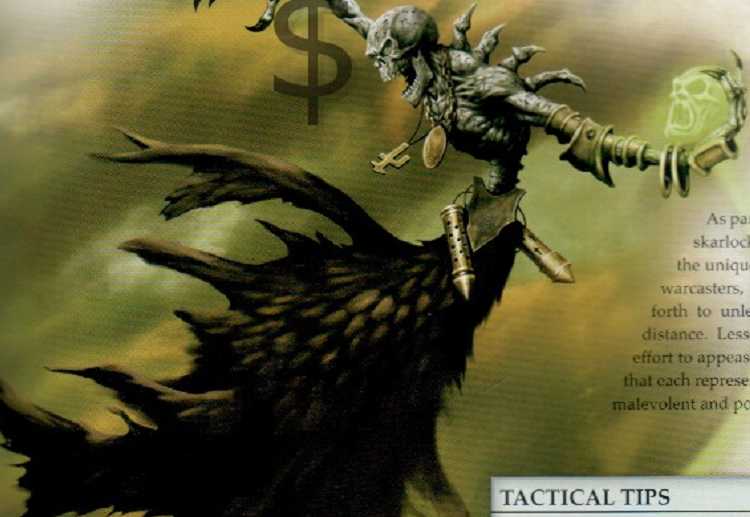
The
Skarlock Thrall
is an insidious creature, linked deeply and powerfully to a warcaster. Each is a unique being, with a personality and agenda all its own. More than any other thrall, they have the memories of life as well as the knowledge bound into them during their creation. From creation, each is bound to a master, utterly unable to feel any disloyalty to them. Their bones and flesh are blackened and desiccated by dark sigils, giving them powerful necromantic abilities. As part of the bond, they become conduits for their warcasters, who can send them forth to unleash their magic from a distance. Lesser minions always try to appease the skarlocks, who are the eyes and ears of the warcasters.
Next time: Mercenaries
Warmachine Prime Mk. II
Original SA postToruk was around at the same time as the Orgoth, so it might have been convergent evolution there. Certainly Cryx did destroy the Orgoth and plunder their souls for secrets, however.
Warmachine Prime Mk. II

The mercenary bit is a story told by Greygore Boomhowler. He talks about how many army assholes think they're better than mercenaries thanks to their uniforms. They aren't. Most are green recruits, barely able to tell one end of a gun from another. But a mercenary? They fight every chance they can, just to make enough to live on. Need coin, after all, to pay your crew, to buy supplies, to drink...and if you can't fight, you don't get paid. It's an honest job, yeah? And only skill will keep you alive. Being a merc's no joke - you need to be tough. If you want to be lazy, go work in a town. And it's not like there are no rules. You join a company, you sign to their charter, and anything you do is watched by your captain. It's not like you're a bandit. You live and die by the Charter. When hired, you see it through. Period. Don't matter if it gets rough. You don't swap sides for extra coin - that's for criminals and bandits, and it'll get you hanged. When you're a merc, your name is your fortune. Don't like that, go be a pirate.
When you're a merc, your captain's the boss, not your employers. You don't have to worry about the ranks of the army that hired you. There's no one to salute, no courts-martial. And a good merc company plays just as hard as it fights - what's the good of coin if you don't spend it? There's a lot of mercs out there, and they're all competitors. Everyone's got a specialty, and you should expect backstabbing. Some will pretend to be your friend, but keep your wits about you. Each would see you dead to get at a job. You might work alongside them, but you don't trust them beyond a contract. Some mercs just want coin, while others have their own grudges. Some pretend to be proper mercs but are just paid assassins, really, no honor. You be careful around them.
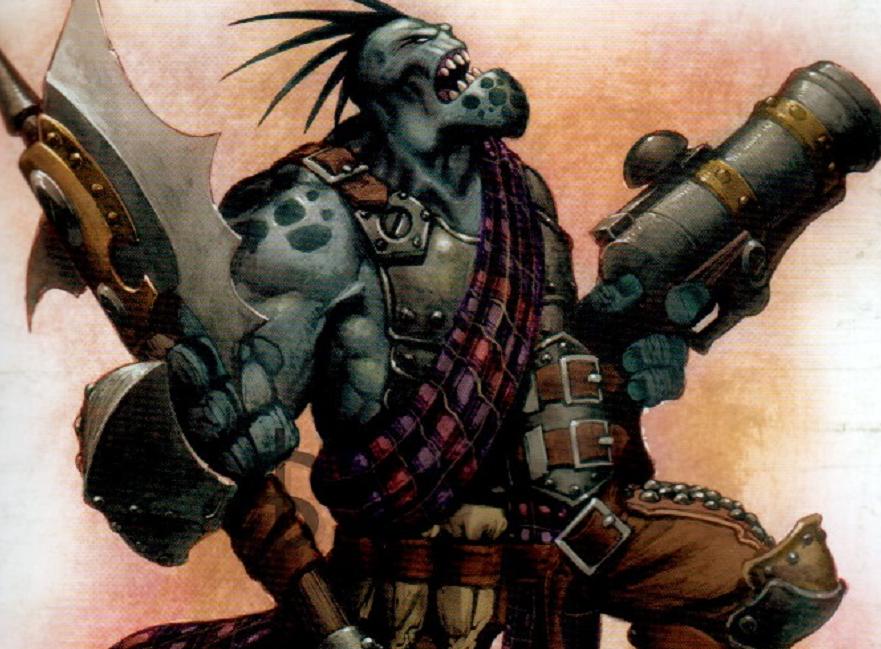
Greygore Boomhowler and Company
are trollkin. They'll work for Cryx, Cygnar, Khador or the Trollbloods. They say the legendary fell caller Bragg was very virile and sexy for a trollkin, and he spread children everywhere, all of whom inherited his fell calling powers, with voices that stagger the imagination. Greygore Boomhowler is one of the more notable examples, a crass mercenary with a great command of Bragg's Gift. He claims to be the reincarnation of Bragg, though he is an admitted outcast among the wild trollkin. He wears garish colors of his own design, unrelated to any of the trollkin quitari tartans, and he is never quiet, even in ambush. Sometimes he actually gets paid double to keep him and his boys from singing at all hours. Whne he is not singing, drinking or fighting, he's having sex - his voice has entranced women throughout the Kingdoms. He is skilled with both axe and blunderbuss, but his real weapon his his voice, which can rise above even a battle. It smashes wood, tears open warjacks and shatters glass. Some even say that his voice has won battles before any blood was spilled, pushing soldiers to great heights of action or raising them fro mthe worst wounds. He is friends with the outlaw warcaster Asheth Magnus, who seems to appreciate his vocal talents. Boomhowler's company of trollkin use their own axes and blunderbusses, but some more traditional trollkin dislike Boomhowler's fame and influecne among the young who have given up tribal ways. Greygore's certainly happier in cities than the wilds, but does occasionally go home to recruit. He's never without followers, though the number varies. Whether he actually is Bragg's reincarnation or not doesn't matter. He and his mercs are an impressive force, when they aren't drunk.
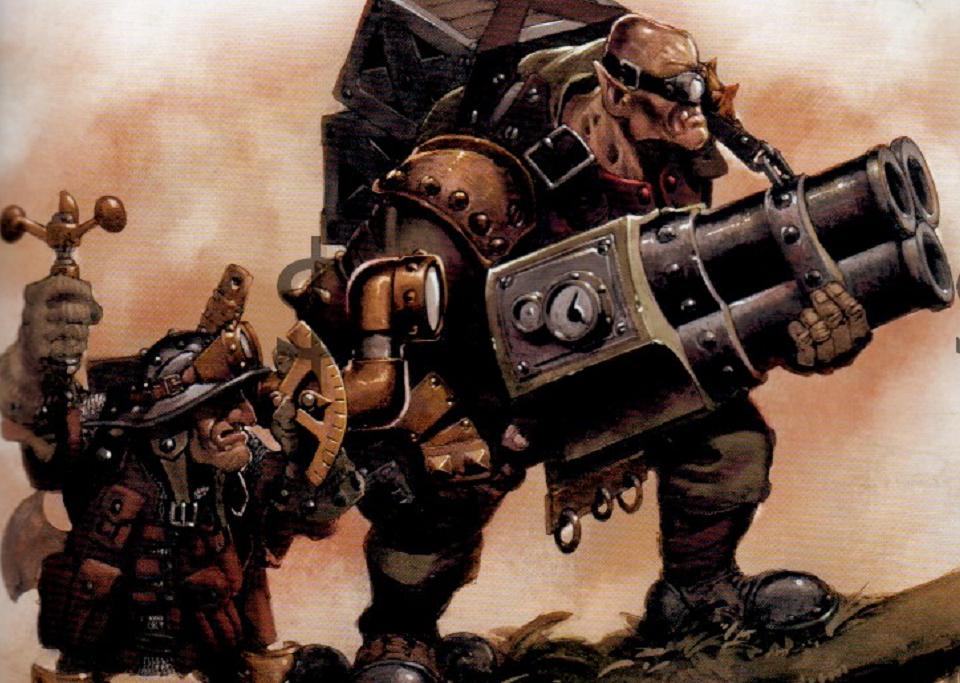
Herne and Jonne
are a team, willing to work for Cygnar, Khador or the Protectorate of Menoth. Herne Stoneground was a traveling alchemist's assistant who became curious about the sciences of gunsmithing and demolution. By the age of 20, he'd mastered the manufacture of double-barreled guns and had earned a reputation among traders and merchants. The Stoneground mark is a sign of quality. He has always insisted on personally delivering his wares, and a Stoneground original can earn a thousand Cygnaran crowns on the open market, so he used to keep bodyguards. That changed when he met the ogrun Jonne. Jonne was born and raised Rhulic, where his conclave had served as guards and smith hands to the Rhulfolk. He grew up on the Llaelese border and liked merchants, making a name for himself as a dockhand. It went to his head, and he signed on with the Rhulic mercenary group called Emberhold, where he learned martial skill. One day during the delivery of a Stoneground original to one of Jonne's employers, he met Herne as bandits attacked. Jonne snatched them up and restrained them by instinct, earning applause and an immediate job offer from Herne. The two are now one of the most famous mercenary teams out there, after fourteen years of friendship. The ogrun has saved Herne far beyond the call of duty, and he makes the dwarf feel safe. Herne would never allow Jonne to die to save himself - they are friends, and solid ones. Some years ago they turned to larger ordinance because small arms wasn't so lucrative any more, and Herne devised the Stoneground barrage arquebus, which he and Jonne have been demonstrating on the road. It's a triple-barreled contraption that fires three cannonballs at once, and it's so big that only Jonne can use it. Herne uses his mathematical skills to refine its trajcetories. It's not easy to aim, but you don't need to as much because its ammunition fragments. It's devastating at middle range and Jonne's just as deadly with an axe in close quarters, while Herne is no slouch with axe or pistol.
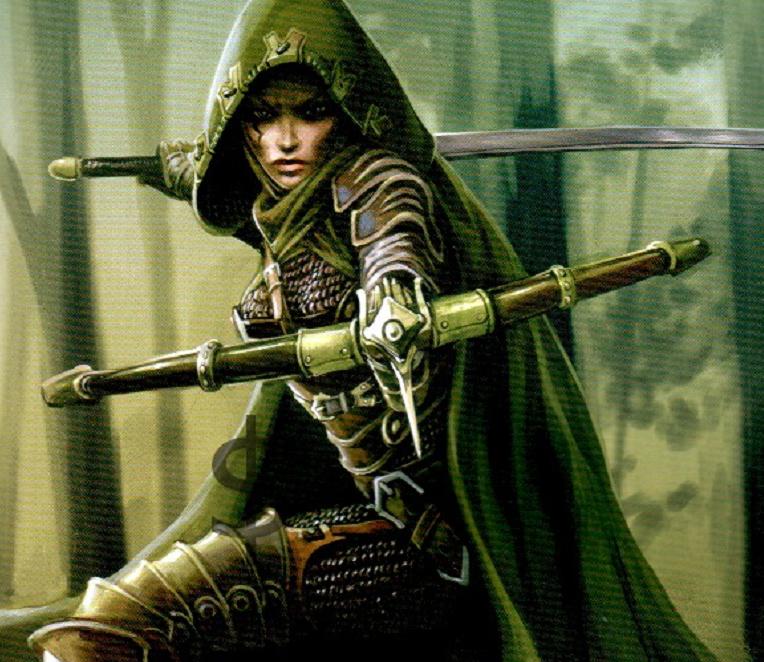
Eiryss, Mage Hunter of Ios
is one of the mysterious Iosan elves, willing to work for Cygnar, Khador, the Protectorate of Menoth and the Retribution of Scyrah. Eiryss is one of the few elves that has left Ios in recent years, and she's made a name for herself as a mercenary hunter. She is largely a mystery, however, among the mercenaries. Ios has rarely contributed to the mercenary culture of Immoren, but Eiryss does have a reputation for ruthless and efficient murder. Other mercenaries tend to dislike her. She does not haggle, and her fees are low for what she does. Some believe human currency means little to her. She is prompt and professional, often arriving early to battles to learn the layout. She tends to know the ground better than the actual commanders do. She interacts with everyone politely and with deference, and often seems to fade into the background, with people forgetting she's present during deliberations and planning. She never misses anything and can memorize a plan instantly, with perfect recall. She needs no instruction in battle, and she is very unnerving to arcanists and wizards. She is, after all, a specialist in hunting down wizards and warcasters, and she'll work cheaper if that's on the docket. She has never explained why she's so good at it, but she's clearly experienced. Her skill vastly multiplies her worth, and given her lack of actual loyalties, it's a matter of concern for mages on all sides. If she has one flaw, it is perhaps her dislike of normal warjacks, which she does not understand or appreciate. She is, however, quite good at disrupting their abilities.
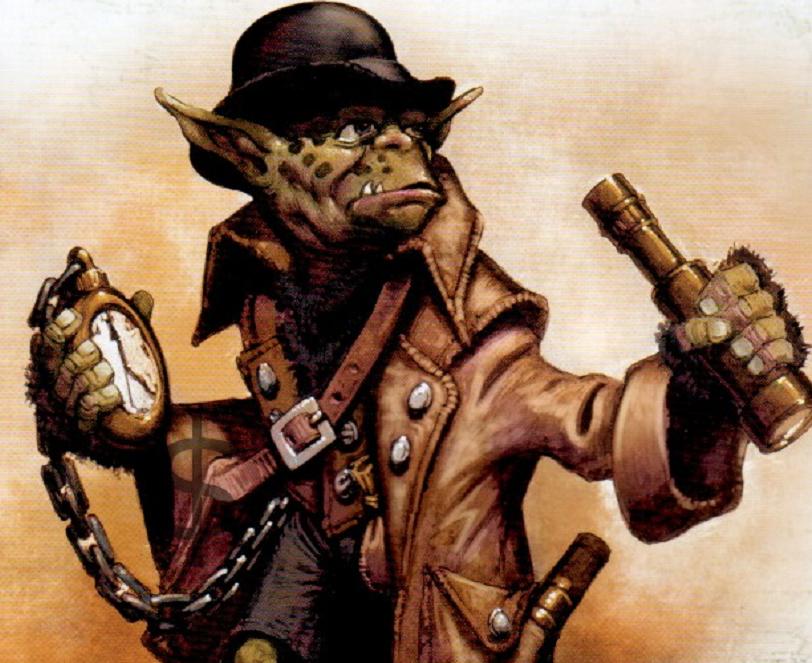
Reinholdt, Gobber Speculator
will work for Cygnar or Khador. He's been everywhere in the Iron Kingdoms - rare for a human, let alone a gobber. His full name is Reinbaggerinzenholdt, and he claims to have been literally everywhere. He has trinkets from across Immoren and his accent is always native to wherever he happens to be. He has an endless supply of esoteric facts and occasionally useful advice. He's expert in nothing but versed in everything. He may tell tall tales, but many will indulge and hire him. He has little aptitude for fixing things, despite claiming to have once been a bodger, but it seems he's more often hired for his conversational skills. He has proven his worth multiple times to many employers, though. He has a knack for quickly reloading guns, and he makes great use of his trinkets, particularly a fin Ordic spyglass that he claims he got for helping to beat back a Cryxian invasion. It lets him spot dangers from afar and judge distances quite well if disconcertingly (his measurement is generally in seconds to impact), a very useful skill. He also seems to bring luck to those around him, and certainly he's led a charmed life, without any serious injury in any of the battles he's been in. He once sneezed himself out of a moving carriage just before it burst into flames due to a powder trap. A blunderbuss shot once deflected harmlessly off a soup spoon he'd picked up earlier the same day. Most often, though, he just spots threats and goes the other way. He's not brave or heroic, and when the enemy gets close he tends to vanish, but if he has to he'll hit someone with stuff in his pockets until he gets away.
The End
Do you guys want to see the Hordes core next, or one of the Warmachine faction books (Retribution of Scyrah, Protectorate of Menoth, Cygnar, Khador, Cryx, Mercenaries and Convergence of Cyriss)?
Forces of Warmachine: Retribution of Scyrah
Original SA post Forces of Warmachine: Retribution of Scyrah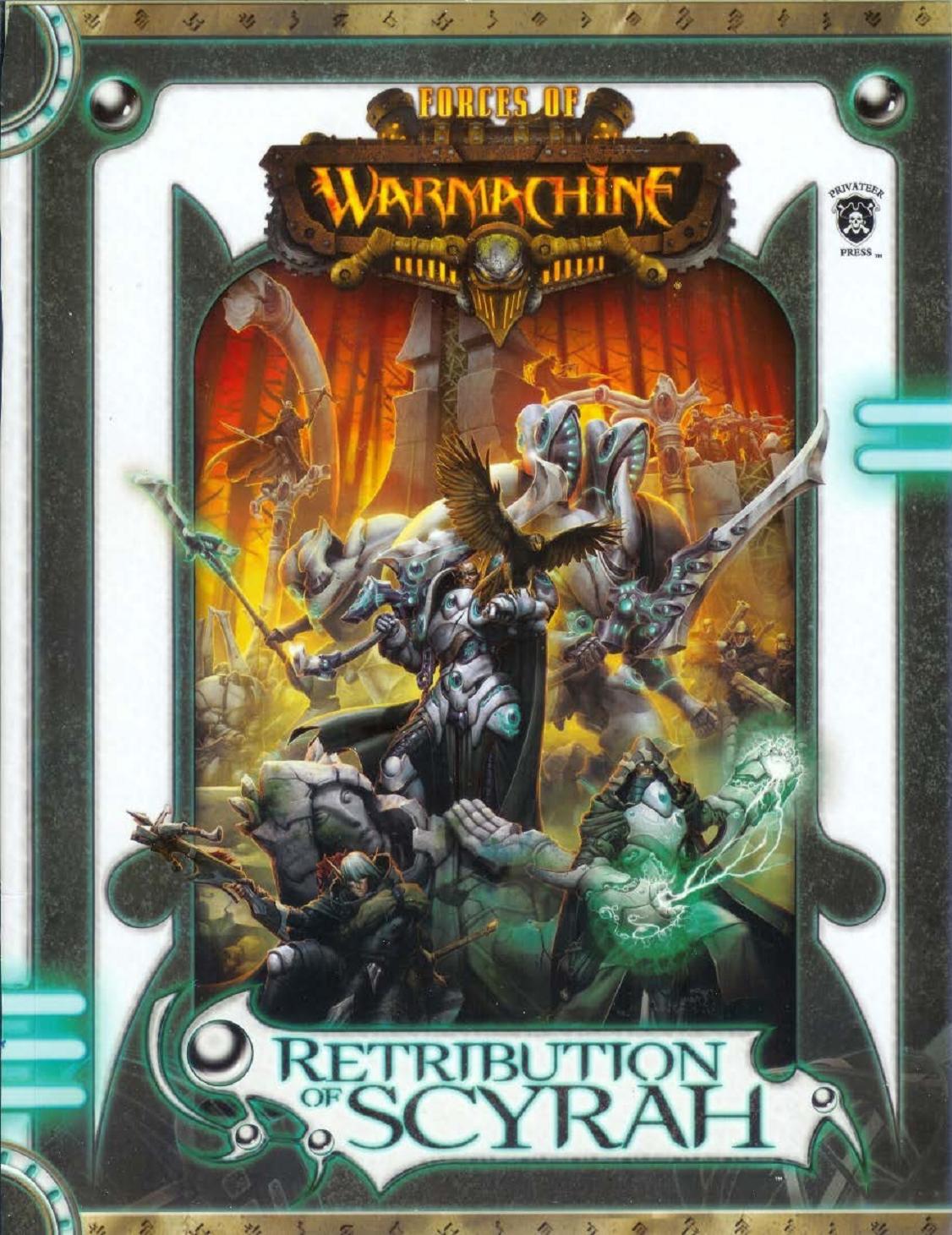
The Retribution of Scyrah was the first book released after Mark 2 came out, and it was an entirely new faction for the game: the Iosan elves. They are unique in a few ways. Firstly: they have Myrmidons. Myrmidons are a type of warjack that has a regenerating forcefield protecting it, allowing it to suck up a good chunk of damage. This makes up for the fact that behind the field, they are much more fragile than most non-Bonejack 'jacks. Also? They fucking hate human wizards. The Iosans are isolationist, and few of them are even willing to set foot outside the borders. The Retribution of Scyrah were a splinter sect long outlawed that was willing to leave to kill wizards. Recently, news that the Iosan god Nyssor was being held captive in Khador brought the Iosans to war, and the Retribution became the dominant sect. They are literally fighting for their gods. Their technology is far beyond that of humans, using force blasts and forcefields. They're an incredibly versatile faction, with units that shift roles as needed. However, they have lost some of the technological prowess they had millenia ago, due to a disaster that nearly destroyed their civilization.

The history of Ios is told to us by Ryvoas Vyre, a theologian and historian of House Vyre. It begins with the gods. None can say where they came from - they never said. There is a myth of them being born from union of the moons and sun, but that's just allegory. What is known is that, long before the creation of elves, the eight gods of Ios dwelt in the palace Lyoss, ruling over the Urcaen domain called the Veld. Their ruler was Lacyr, the Narcissar of Ages. At her side was Ossyris, the Incissar of Hours. It is known that the gods were warriors, for Ossyris is also the Sovereign of Conflict and General of Lyoss. Traditionally, this is depicted as spirit armies patrolling the Veld's borders, for he Veld was surrounded by enemies. Beneath Lacyr and Ossyris were Ayisla and Nyrro. Ayisla was Nis-Arsyr of Night and the Watcher of the Gates of Lyoss, while Nyrro was Arsyr of Day, Seneschal and Lorekeeper. Below them where the four gods of the seasons: Scyrah, Nis-Issyr of Spring and Healer of the Divine Court, Lurynsar, Issyr of Summer, Arms Master of Lyoss and Chief of Scouts, Lyliss, Nis-Scyir of Autumn, Court Assassin and Mistress of Poisons, and Nyssor, Scyir of Winter and Grand Crafter.
It was Lurynsar who first noticed mortal souls entering the afterlife. Lacyr investigated this, tracking them back to Caen and seeing the barbarity of their existence, but also the potential. Human souls multiplied, giving a bounty to their creator, Menoth. Lacyr was inspired to make her own people, but a more refined people. She wanted a species fit to inherit and subjugate Caen. She became Potentate of the Living by giving life to the elves, while the goddess Scyrah served as her midwife. The Divine Court watched from beyond the divide of mortality, guiding the new creatures, teaching them law and civilization as well as magic and war. The gods brought concepts - present, past, the passage of hours and division of seasons as Caen orbited the sun. They showed how the moons influenced wind, rain and tides. They embodied life and death, with life beginning in spring with Scyrah, governor of birth and growth, then passing ito Issyr's heat, Lyliss' waning autumn and the cold winter of Nyssor's death, as the land awaited rebirth. Nyrro watched the day, and the sun of life, while Ayisla oversaw night, and the passage into death as the Suzerain of the Fallen. The souls of the elves were borrowed from the gods, who regulated them in the afterlife. When a soul passed on, it met Ayislaat the gates of the Veld to be appraised. The worthy passed into the realm of gods, to live in grace for etenrity. The others were sent back to be reborn. The process has now been lost, perhaps eternally.
The gods granted the elves great knowledge - mathematics, engineering, architectyure, magic. They had a lifespan far longer than any other living creatures of Caen. It was not all bliss, of course. They competed with each other, sometimes bloodily. In time, though, the gods guided them together as the Empire of Lyoss, taking the name from the palace of the gods. The elves learned war in the struggle for unification, and used those skills against human and skorne savages afterwards. Eventually, they made contact with the dwarves of Rhul, the only true civilization of the time apart from Lyoss, but hidden away in a mountain region, neither threat nor competition. Had events gone differently, Lyoss would spread across Immoren, and to continents beyond.

The golden age was long, but little is known about it. It was thousands of years, now like a half-forgotten dream. It was so long ago that Immoren was different. The capital, Nyshyl, sat at the heart of what is now a rift dividing the continent. The sun never shines on the ruin, which is but dust now, cloaked in storm and lightning forever. The Empire of Lyoss sat at the center of the desert that is now, but was not then. Some of the ruins remain - the city of Osslarys, say. Even this podunk town was greater than anything that exists today. Nyshyl had over two million souls living there. Little else is known of ancient Lyoss. It was ruled by the eight fanes of the gods, with subordinate fanes ruling outlying regions. It was not a utopia - it had its poor. But it fed them all. It had its stife, but heavy-handed force would end that, and peace would reign again. The gods gave people great oversight in their daily life, but controlled the government through the priests. The only dissatisfaction was that the gods were seperate, living in Urcaen. Five thousand years ago, the eldest priests met at the Council of Anifaryl to resolve this issue. They drew up plans for the Bridge of Worlds, that they might share life and afterlife with the gods. Lacyr herself approved.
In modern days, no Iosan could discuss the Bridge of Worlds without rage and regret, but it was a thing of hope for the Lyossans. It took four hecyions to create - that is, 4 times 64 years. It was the greatest project ever attempted on Caen, and likely the greatest ever to be attempted in all of history. Mortals and divinities alike joined to build a conduit between worlds. It was a massive physical structure - a stone arch reaching into the sky, ending at its apex, like half a bridge. The missing half was built in spirit in the Veld, designed and manufactured by the gods for perfect mystical alignment with the material side. Hundreds of linked arcane generators were built into the foundation, and a lattice of sigils was inlaid into the streets themselves for miles around. The Bridge of Worlds was intended as a permanent road for the gods, that they might come and go at will. Its construction took over 250 years and cost more lived and materials than could be afforded ever again. It should have been the greatest wonder of the world. But when it was activated, something went terribly wrong. The Cataclysm occurred.
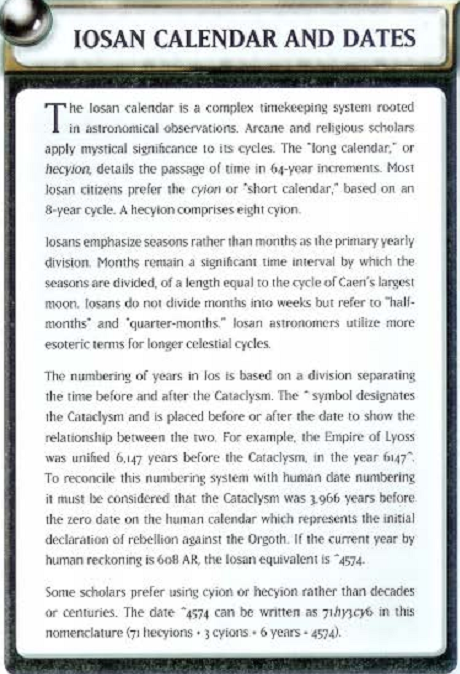
The moment the gods entered Caen, the Bridge of Worlds exploded in a rain of arcane power. Only the aftereffects of the veent are known, but they were extreme, beyond anything before or since. Survivors even hundreds of miles away wrote of great flaming stones raining down. Closer to the blast, the raw force disintegrated everything. It is believed everyone nearby died instantly. Immoren itself was sundered, opening the Abyss, a chasm so deep it reaches into the molten veins of the world. Nysyhl was obliterated utterly. Survivors write of blue-white fires burning unnaturally, with with no fuel, unable to be extinguished. The stones themselves burned. The weather patterns were altered permanently, and what was once a small desert near Nysyhl became a near impassable wasteland. Along the Abyss, the freakish energies of the event combined with the seismic changes to birth the Stormlands, an area that still has unending rain and lightning. Tens of millions died in an instant. The empire was over. Millions more died in the aftermath, and those on the fringes starved. Were it not for the gods, there would be no Ios.
The gods, you see, survived. They stood among the people, sheltering as many as they could. Over the next decade, they gathered the survivors and marched west. There were countless terrors, too many for even the gods to protect against. A host of warriors decided to sacrifice their own lives for the others. This was the Dawnguard, an ancient order serving Nyrro. They guarded the rear, battling endlessly against the horrors. Most of them, the remnants of ancient House Nyarr, died in the sands. Some say all bearing the name Nyarr died, but the modern house insist there were some survivors. The elves came to the lands of Ios on the advice of the gods, who saw it had the potential to recover and thrive. The Mistbough and Archenbough forests were vibrant, and there was fertile farmland. Contact was renewed the the Rhul, though they were told no more than necessary.
The first buildings constructed in Ios were the Aeryth Dawnguard and the Gate of Storms - the first a fortress monument to the fallen Dawnguard and the home of the new Dawnguard, sworn to offer their bodies in place of the fallen. The second was built in case the Rhulfolk chose to test the new land. Next was the Gate of Mists, a fortress that has grown greatly from its humble origins. It would be thousands of years again before humans were considered even a slight threat. The survivors settled, believing that they might heal and rise again, greater than before, for the gods stood with them. They spent years rebuilding, trying to rediscover the knowledge that was lost. Sadly, even now, it is unknown how much was lost in the Cataclysm. The first eight cities of Ios were each dedicated to a god, and at the heart of each a temple was built to house that god. These fanes were true homes, not just places of worship, and the builders knew they would never compare to the palace Nyssor built in the Veld. It's no wonder, then, that these great construction projects were begun - it was the only way to offer thanks to the gods, even in these desperate times. Today, most of those original cities no longer stand. The only one that has been retained in perfection was Shyrr, the capital built for Lacyr, the creator goddess. It is the center of the Iosan civilization, and home to the finest of the fanes, later the center of Iosan government.
The next largest surviving city is Iryss, and it has been maintained far less well. It was the home of Scyrah, and the fane is kept as if she were still in residence, though she later moved to Shyrr. The last remaining of the old cities is Lynshynal, the home of Lurynsar, built in the Archenbough. These days, it is an industrial city, and while the area is still untouched by winter, it is not the beauty it was. Five cities were lost. The most recent was Issyrah, fallen to a dragon two centuries ago, built for Ayisla. It was a city of night people, lit by great lamps. Shaeross, in the east, was home of Ossyris, second only to Shyrr in grandeur. Eversael was the first city, the northernmost, and it was Nyrro's. South was Shaelvas, the City of Wind, devoted to Lyliss. And last was the near-mythical Darsael, its existence expunged from written record over a thousand years ago, but once devoted to Nyssor. The leaders of the Iosan people were the surviving nobles, who became the 15 hallytyr, the high houses. Even then, the gods preferred to isolate themselves in their fanes, only traveling out periodically. Many wondered if they wished to return to the Veld.
It was centuries before anyone noticed a new, strange illness. The first sign came with the onset of old age and diseases among the elders. They aged now, far more than they had in the past. It was terrifying. Today, it is taken for granted that an elf will live often no more than three centuries, but for the first Iosans, it was unprecedented. Death from violence, sure, but age? Oh no. Disease epidemics tore through Ios in that first millenium. For the first time, the gods had no ready answers, though Scyrah and Lacyr cured as many as they could and Lyliss gave merciful deaths to countless others. It would be some time before any other aspects of their decline were noted - a greatly lessed birth rate, for example. Each family suffered in silence, for the shame of it, so it is hard to gauge how much. EVentually, though, it was notcied. The elves begged the gods for help, but there was no answer. They began to resent the gods, blaming those who ruled other cities than their own. Some thought it suspicious that Scyrah, lady of fertility and birth, had no solution. The most popular targets, however, were Lyliss and Nyssor, for they were autumn and winter. It even led to bloodshed between cities, and the stigma against Darsael is rooted in that era, eventually dividing the people. The gods tried to intervene, and for a time births surged and prosperity returned, but it was shortlived. Ios entered a three thousand year cycle of false hopes and disillusionment. Two more times, the gods tried to correct it after centuries of decline, and each time was only a brief respite before the problem came back, worse than ever.
This period was named the Great Malaise, as the Iosans sought to avoid the truth. Some say they still suffer it today. The Iosans isolated themselves, seeking distraction by entertainment and frivolity. They lost their unity, and the cities became disconnected. The priesthoods no longer communciated, focusing only on their own sovereign gods. Secrets grew, leading to violence between noble houses, and the Consulate Court that rules Ios became powerless. The gods likely realized early that saving the people would mean leaving. They studied the issue for years, trying to use mriacles to remain. At last, in the year ^3126, they made an announcement: they were leaving the world. They, too, were suffering and weakning, the longer they remained out of the Veld. Their arrival had caused a cosmic imbalance that made it hard for them to perform their functions. The lives of the Iosans were linked to their strength, and the only solution was for them to return to Urcaen. However, they had not found a way. They did not explain their plan, only that they would not be seen again. Their success, they said, would restore the balance. The fane of Ossyris, where this final ceremony was held, was thereafter considered utterly sacred, forbidden for any to enter. A powerful bane was raised there, that none might walk its halls until the gods returned. It has never been violated.
Next time: More fuckin' elf history.
Forces of Warmachine: Retribution of Scyrah
Original SA post Forces of Warmachine: Retribution of ScyrahThe exodus of the gods brought hope to Ios. At last, they had taken action, perhaps they might save the Iosans. For decades, faith and industry were at an all-time high. It was in this time that the people of Darsael, who worshipped Nyssor, abandoned their homes and began to leave Ios. The historians of the time ignored it, and in later centuries there was a systematic effort to erase the existence of Darsael from history. What records survived indicate they were led by a prophet named Aeric. Shortly after the gods left, he claimed to have a vision of Nyssor instructing him to lead his people away. There were never many of them, and they were long shunned, for Nyssor was unpopular, the god of the end of life. It may have been welcomed as a sign of better things to come, and end to the long winter. It is knopwn now that these people would become the Nyss, but for a thousand years, Ios had no contact with them. Darsael was abandoned, but many other cities followed. The priests of each fane kept up their duties, but the inhabitants left, heading inward. Shaelvas was next to fall, and even EVersael became little more than the ceremonial grounds of the Dawnguard.
Three centuries after the exodus of the gods, the Fane of Nyrro made an announcement, claiming that Nyrro had returned with good tidings. Eversael became the center of pilgrimages and offerings, of great festivals. For years, this new cult of NYrro multiplied, but not all believed them. The wise were skeptical, claiming it was strange that the priests continued not to reveal the god's full message, and that the stories of his sightings were so fantastic. Dark rumors began to spread that the priests were performing unholy rites in the fane, that some who went to Eversael just vanished. Then, a survivor escaped the dungeons and fled to Aeryth Dawnguard, affirming that the clergy killed any who would reveal their secrets. It was proven when he lled Dawnlord Chrylos Nyarr to a mass grave. It remains unclear what corrupted the holy men - perhaps it was nothing more than an attempt to bring back the influence of old Eversael. Perhaps they thought, at first, they were acting for good reasons.
The Dawnguard were infuriated, for Nyrro had been their patron god and they had long had close ties to the priesthood. This disgraced their order, and justice was their duty. They marched as one to EVersael, invaded the fane and shamed the priests into confession before the crowd. Dawnlord Nyarr executed the leaders himself and left the rest to his soldiers. The cult was destroyed, and EVersael was abandoned. It has since been avoided entirely, and it is rumored to be haunted and cursed. There is even evidence that some of the priests evaded execution and turned themselves into unholy creatures that feed on life to survive. After that incident, the Dawnguard divorced themselves from Nyrro. They may respect the god, but that is kept private. The spiritual belief of Ios never truly recovered.
Fear that something terrible might have happened to the gods was confirmed seven hundred years after their exodus. Across Ios, the priests suddenly fled the fanes, maddened and ranting. This began the Rivening, a calamity just as influential on the Iosans as the Cataclysm. The most detailed accounts of the time are from Shyrr. It was as if each priest went mad at once. One high priest went to the Consulate Court and slew the House Syllrynal consul befor being sotpped. Several lit themselves n fire, while others went into murderous frenzies. Most survivors believed their civilization was ending. It was not isolated to Shyrr, either, but all throughout Ios. Issyrah is said to have suffered even worse, as the priests tore out their own eyes in the open market and caused riots, arson and looting. Alarge portion of the city was burned and had to be revuilt. From that point on, the Fane of Ayisla was shunned as a cursed place.
Iryss suffered least, though it still suffered. The priests of Fane of Scyrah had milder dementias - gibberish-speaking, say, but not violence. They regained their wits relatively quickly, often after only a few hours, while many other priests never recovered. The most chilling madness was in Shaeross, however. Shyrr sent messengers there when contact was lost, and they find the city sealed but unguarded. Inside, they find citizens murdered and soldiers dead by suicide. No one has ever figured out quite what happened there. Some say that the Rivening spread to all the people of Shaeross. The death toll might have been far higher, had the city not been abandoned by thousands beforehand. It has never again been settled. The priests of Scyrah helped some others recover. They claimed that they had a sudden shock, followed by an utter sense of isolation from the gods. All Iosan priests but the FAne of Scyrah found they could no longer channel the divine through prayer, and so it was termed the Rivening, the violent severance from the gods. Many deduced that the gods might be lost or destroyed, and those priests sane enough to realize that fell into despair, often suicidal.
The news could not be hidden, though Ios tried. It spread quickly, and the Consulate Court could not bring order, for all they tried. They used soldiers to quell riots, but that only made things worse. In the time that followed, it was the priests of Scyrah who calmed things, for they at least still had their powers. One of the most disturbing manifestations, however, was the birth of Iosan children with no souls. Before the Rivening, there is no record of such an event. The soulless are born with black, empty eyes. They never cry, and only stare blankly. It was thankfully rare at first, but has slowly increased with each hecyion that passes. The most likely cause is the vanishing of Ayisla, the Watcher of the Gates, who was responsible for the processes of reincarnation and passage into the afterlife. With her gone, perhaps the reincarnating souls are incapable of returning from the Veld to Caen. Without the Fane of Scyrah, Ios might have been lost utterly to anarchy. Even with their aid, it was a time of sorrow and grief. The empire was shattered by bringing the gods to Caen, and now they were lost. The Divine Court began to be referred to as the Vanished. The fanes were used to honor the gods, but for many, these honors only reinforced the loss. Ios began to shift from worship of eight gods to only the one they hoped still lived.
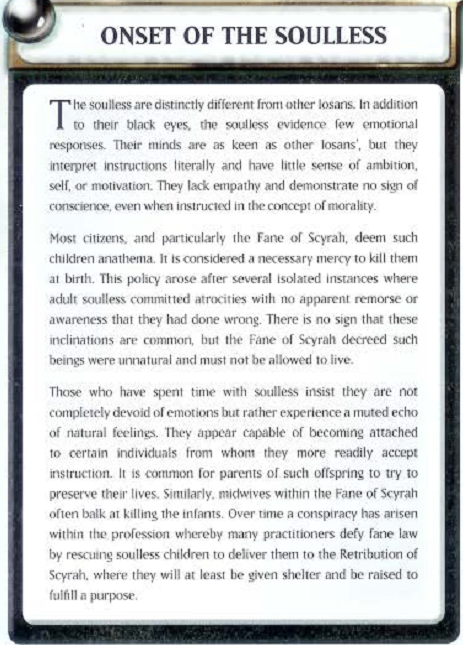
It was almost a century after the Rivening that the survival of Scyrah was confirmed. In the winter of ^3932, witnesses saw an approaching figure outside Shyrr - a beautiful woman who opened the great gates with ease. She headed to the city's heart, and word spread that Scyrah might have returned. All who vwitnessed it later described it as dreamlike, overwhelming to the senses. The fog added to the confusion, for the goddess of spring had always been youthful, nto this older woman who, while still beautiful, was full of sorrow and loss. This change is frequently seen in Iosan art. Her presence brought more concern than joy, due to her silence. She gave no reassurances, no hopes. Her priesthood awaited her outside the fane of Shyrr. She entered, and was never seen outside again. It would be centuries before the Fane of Scyrah admited she had not spoken since her return. They remained quiet about her condition, offering only empty reassurances and requests for prayer and patience. It preserved the faith of the people for a time, but the ongoing silence divided the people from the clergy.
Of course, the priests likely feared shattering what hope had returned. What is known now is that Scyrah collapsed after entering the Fane of Lacyr, and has slumbered ever since, though her mind remains active and her priests are still connected. The Auricant Velahn insists that Scyrah grants wisdom and instructions by subtle portents and whispers, that all her will and what strength remains are focused on maintaining the people. Perhaps most frightening is that Scyrah's malady was able to afflict a divinity embodying vitality itself. MAny have believed it was this that preserved her when the other gods died. Others suggest Lacyr sacrificed herself to save Scyrah, the only one who could preserve Ios. It was not until ^4296 that the fane announced that Scyrah was not recovering, but was in fact slowly dying. They predicted she would die within six hecyion. Now, there are but eighty years until that time comes.
Shortly after the Rivening, many theologians began to examine the cosmological dilemma at hand. It was bold, given the despair around the. Adeptis Hylesh Vyre and others were instrumental in these studies, documenting the manner in which the loss of the gods affected the people. Until then, Ios had ignored the outside, sending only a few emissaries to guard against unexpected threats - never safe in the best of times, as humanity had fractured into thousands of city-states. They did, however, learn to communciate. That all changed when the Orgoth humans came to conquer. Iosan ambassadors were slain on sight. The Orgoth eventually tried to invade the Rhul border and were driven back after killing many. Iosan forces prepared for them, and the COnsulate Court realized they needed spies, and began to watch the foreign powers in hopes of better understanding humans and particularly the Orgoth. It was the first time outsiders had seemed a significant threat.
Most surprising was the sudden proliferation of magic among humans, distributed almost systematically. Before then, it had been believed humans had no insight into the art. The ORgoth had been rumored to use sorceries, but it was assumed those were gifts of their dark gods. What puzzled Iosan agents was evidence that an increasingly organized resistance was using magic against the Orgoth that came from no god. This proved instrumental in the defeat of the Orgoth over many years, and the pace of the innovations regarding arcane principles was both staggering and ominous. Further investigation led to the discovery that the onset of this power coincided almost exactly with the Rivening. The first sorcerer was created but three years after that day. Coincidence? Hardly.
Decades of investigation showed that magic was gifted to humans by the goddess Thamar as a weapon, and even the human priests believed it left a taint on their souls. Research by Vyre arcanists discovered clues that human magic exacerbates the problems caused by the missing gods. The evidence is more suggestive than absolute, but it seems likely that human magic has increased the occurrence of soullessness. Similar studies have shown that this also extends to the proliferation of mechanika as well as magic-users, and this was the most important goad to the rise of what would become the Retribution of Scyrah. They and the Seekers emerged after the announcement of Scyrah's plight. Their basic purpose was the same: take action. Both knew the situation needed immediate response, but they disagreed on its nature.
The Seekers intended to save Scyrah, using principles laid down 270 years ago by the diviner Vyrillis Yryas. They have collected a wealth of historical and arcane lore, including texts the Fane of Scyrah has declared forbidden, which predate the Cataclysm. Yryas' heavy reliance on ancient texts and questionable prophecy, however, led the Seekers to many futile investigations. Further, they reject the idea of human magic and the Rivening being linked. Most still cling to the hope that the Vanished sitll exist and are waiting to be found. They have made their life's work the search for information on the Vanished outside Ios, and one of their fundamental prophecies holds that Lacyr said Ios would someday reuqire the help of outsiders to survive. They have had no notable gains in three centuries, but the discovery of Nyssor has reinvigorated their cause, and they insist he is but the first.
The Retribution, on the other hand, were pragmatic. They have a strong religious foundation, embodied in pious mage hunters, but at the core they are about research and reconnaissance. They realized the only hope of healing Scyrah was by eliminating human magic and its users. They have hidden bases throughout the human kingdoms, used to luanch assassinastions on mages. Not long after their founding, they were outlawed, as were the Seekers, as the Consulate Court feared both might weaken Ios and invite invasion. Both the hallytyr and the Fane of Scyrah wanted to quash these sects, but it didn't work. Much of Ios' citizens were content to pretend things hadn't changed, but not all.
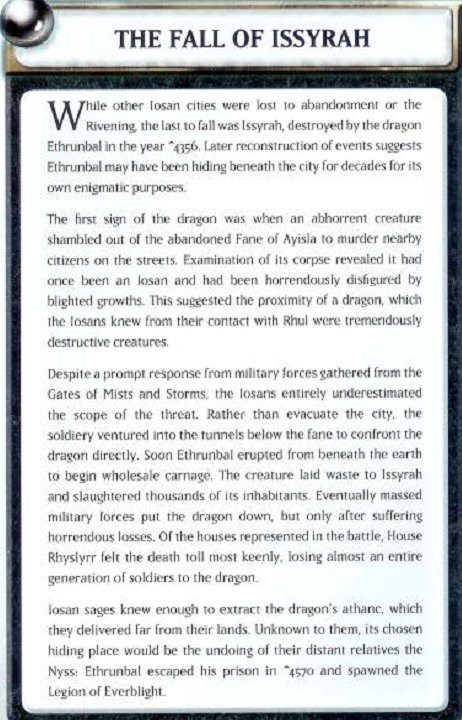
The human kingdoms after the Orgoth were defeated proved more amenable to ambassadors and trade. The Iosan merchants wer eager to use them, and had to be kept in check by the Five Great Military Houses. Still, some outsiders were even allowed beyond the Gate of Mists, though only a select few were allowed to see Iryss. The exiled sects continued their work, and Scyrah continued to weaken. For each mage killed, three more arose. The Retribution began to speak of the Consulate Court with open disdain, and their views were echoed elsewhere. Even the hallytyr realized only decisive action would rouse Ios. In ^4546, Lord Ghyrrshyld of House Vyre emerged, sweeping aside opposition to disband the incissar council ruling Vyre and declaring himself Narcissar and High Consul. He intended to rule over all Ios as a true Narcissar - an Emperor. He intended to force people to face the facts. He was a wizard of unparalleled skill, studying ancient texts, even those of the cult of Nyrro, humans or the Rhul. He studied all knowledge, and believed a single ruler was needed to bring salvation, He armed his kinsmen more than any other noble ever had, and the dissenters slowly quieted as Ghyrrshyld consolidated his control of House Vyre. Many were eager to follow him, using techniques to strengthen the myrmidons that had so often been the specialty of the rival House Shyeel. Ghyrrshyld tested his forces often, enjoying battle and killing no matter what the foe. He was aggressive, without any provocation as he attacked the trollkin to the south, and they sought vengeance, not realizing who they faced. The slaughter did little to quell dark rumors about Ghyrrshyld.
Next time: The elves go to war.
Forces of Warmachine: Retribution of Scyrah
Original SA post Forces of Warmachine: Retribution of ScyrahOutside of battle, Ghyrrshyld was eloquent and charismatic, so many were willing to follow him. However, in ^4547, his cousin's wife, Lysevyn, gave birth to a soulless child. There had been a lot of hope around the birth, as few direct lineage children of Vyre had been born in decades. When he heard, Ghyrrshyld rushed in, full of rage, seized the silent child and barged into the Consulate Court assembly, where he ranted about the failings of the court and then bashed the child's head in on the floor. His rantings got more and more intense about the need for war to avenge Scyrah, until his own men dragged him out. It was so shocking that no one was able to react for some time. but soon a warrant was issued for his arrest. When they tried to take him, House Vyre's guards opened fir, beginning the War of the Houses.
it spread quickly. House Vyre ralled the nobles of Iryss against the Consulate Court, while the other hallytyr did not understand or expect the alliance with so many lesser houses. The Five Great Military Houses could not expect anyone, much less a single house, to match their strength, especially after they beat a dragon at Issyrah. Ghyrrshyld's armor matched on Shyrr, using his knowledge of the place's defenses to seize it, with aid from internal collaborators. Most audiciously, he had riflemen and myrmidons lay siege to the House Silowuyr defenders, giving him time to march on the Consulariat. The key was that the defenses were meant to give a small force an advantage against a larger invader, so once entrenched, House Vyre was able to hold Shyrr's center for weeks. Still, the hallytyr refused to acknowledge him. He wanted this, so they were kept alive, but tortured. House Silowuyr fought the besieging forces with few casualties, but could not break free. However, this kept the Vyre army occupied and allowed Houses Nyarr and Ellowuyr to muster their forces with the aid of House Shyeel's myrmidons.
The clash was bloody but brief. The Vyre army soon realized that they couldn't keep this up, and Gyrrshyld would likely have slaughtered the consuls if not for a House Silowyr team that launched a desperate attack on the chamber, allowing the conuls to be rescued. The Vyre generals convinced their lord to withdraw in a fighting retreat to Iryss that started two years of war that would consume all of Ios...except for two of the Great Military Houses. House Rhyslyrr had suffered badly in the fall of Issyrah and remained guarding the Gate of Mists. House Issyen, however, simply did not participate. Some say they collaborated with Vyre, but no proof has ever been found. In any case, Ghyrrshyld spent ytwo years claiming he fought to unite Ios, but secretly gathered hundreds of infants, cruelly experimenting on them in the name of solving the soulless dilemma. The number of children killed this way can't be confirmed, but it was likely more than a thousand.
The Retribution of Scyrah was not directly involved until the end of the war, as they were outlawed and in exile. People sometimes believed Ghyrrshyld was Retritubtion, but this was not so. House Shyeel discovered the atrocities in late ^4548, leading the alliance against Vyre to greater urgency, committing to a full assault on Iryss led by the Dawnguard and Shyeel myrmidons. The hallytyr had avoided this before in hopes of sparing the sacred city, home of the fane of Scyrah, and the attackers attempted to protect the holy sites even as they assaulted it. Houses Nyarr and Shyeel convinced the Retribution to assist them in the attack, even those who had been members of House Vyre. It was a triumph, but not completely. Dawnlord Vyros Nyarr confronted Ghyrrshyld, but while he mortally wounded the warlord, the narcissar's bodyguard intervened and he escaped via trapped passageways. The rest of the Vyre army surrendered. House Vyre suffered much, justly, in those following decades. All known collaborators in Ghyrrshyld's deeper crimes were killed, and the house was almost destroyed entirely, stopped only by the begging of senior scholars. Perhaps out of guilt, many would go on to join the Seekers or the priesthood of Scyrah. It'd be years before anyone know what happened to Ghyrrshyld. Apparently, some time after his battle with Dawnlord Vyros, he became an unliving abomination, using the lore of the corrupt priests of Nyrro. It may have been willing or a last resort - that will never be known. He took refuge in the Nightmare Empire of Cryx.
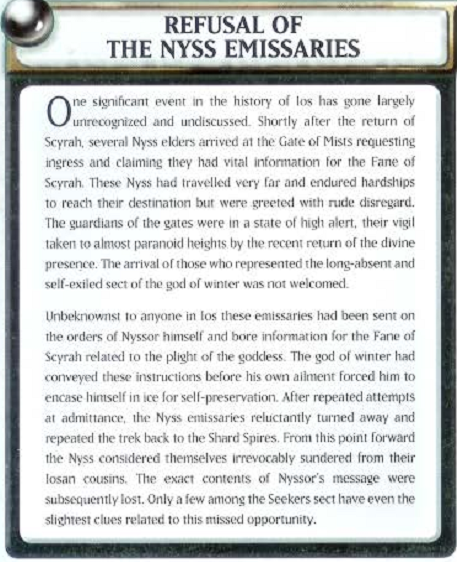
In any case, at the start of the war, the Iosan border was closed entirely and the ambassadors recalled, preventing humans from learning of the civil war and the damage done to Ios. In the past thirty years, little has changed. Soulless children continue to be born and killed or givne to the Retrribution. Little thought was given to the Nyss, who left Darsael over 22 hecyion ago. It is known that their culture has almost no resemblance to that of Ios - they are hunters and nomads, speaking a simpler language, and their time in the mountains made their bodies seem alien. Were it not for Retribution and Seeker intelligence, it might have been that none would remember they even existed. Only now that it is far too late, it has been proven that they truly were chosen by Nyssor. Only a few years ago, they suffered total upheaval. Hostile invaders bearing dragonblight attacked them, forcing them to flee to northern Khador. It appears they were attacked by the forces of the dragon Ethrunbal, who annihilated Issyrah and who was believed sealed forever.
The Retribution was the first to investigate, and it was Eiryss, the Angel of Retribution, who discovered a secret the Nyss had kept for centuries. At some point after the Rivening, Nyssor returned to them. When they fled Ethrunbal, they carried Nyssor among them to keep him safe. He had sheathed himself in ice to slow his degradation, and then was protected by a stone casket inscribed with holy sigils. They sealed this below the city of Korsk, and the Khadorans knew nothing of it, save that they had agreed to give the Nyss sanctuary. Eiryss realized the importance and made her way to Korsk, where she found the guards slaughtered. She made her way to Nyssor's vault, where she saw the partially thawed god being attacked by Goreshade, the monster that had once been Lord Ghyrrshyld Vyre. He had stolen NYssor's sword, Voass, profaning it. He was unable to slay a god in one blow, however, and he fled at the send of her approach. Eiryss pursued Goreshade, but was unable to kill him, and instead was gravely injured, though allowed to live to pass on word of Goreshade's actions. Apparently, he still believes he has the secret to Iosan salvation, and will do anything to enact his mad plans. Eiryss gathered her strength and returned to Nyssor, where she saw that Khadoran mages had secured his vault for transport.
Eiryss fled to Ios to bring the news to them, that Nyssor was captive to the hated foe, and that Goreshade was going to kill him and any other gods he found. It was clear that between Cryx and Ethrunbal, swift action was needed. This brings us to now. The Retribution has been brought back to Ios, for no one can ignore the very real threat of human wizardry. They have helped bring the Nyss back to Ios as well. Houses Nyarr and Shyeel have come forward to support the Retribution, giving them immense military assets. Nyssor will be recovered, whatever the cost, and Goreshade will be defeated. The time to act must be now, and the next few years will be vital to determining whether the elves of Ios will survive. Failure is not an option.

The military organization of Ios is evolving now that hte Retribution has been put in charge. They don't have to hide any more, and while they are minority still, it's a growing one. They have access to a large chunk of Iosan military might, including hundreds of myrmidons and the Dawnguard legions of Nyarr. They are, however, still small compared to human armies and competing for resources within the Iosan borders with the Homeguard Coalition, who defend the borders. This has led to unconventional strategies and a unique doctrine of engagement. They focus on striking at the weakest point in their foes' armor, using spying and recon mixed with rapid redeployment to determine where to fight. It helps that the humans know very, very little about them. Ios has never been involved in any external war, largely due to its isolationism and rabid border protection, but they are extensively trained and experienced in internal warfare. The real reason, after all, that they sealed the borders in 581 AR was to hide their civil war. Further, they are fighting for the survival of the elven species and to save a god.
For centuries, the Iosan border has been guared by five of the high houses, Ellowuyr, Issyen, Nyarr, Rhyslyrr and Silowuyr. Each has a key fortress to guard as well as border patrols, and each house has their own specialty, but as a whole they are the Homeguard Coalition, alongside troops from dozens of lesser houses. In theory, it's all voluntary enlistment, but many are pressured to enlist by social obligation or desire for advancement. Officer commissions are lucrative and socially beneficial - you pretty much need to be an officer to get higher station. A tour lasts ten years. Poor families encourage their children to enlist to save on resources and improve standing, while the affluent houses are expected to serve to learn skills needed for leadership. It's not uncommon for families to pressure a soldier to serve at least one or two tours before they do anything else. It's ensured a standing army, but they're not all very diligent or skilled, and the Homeguard is plagued by opportunists and inept officers seeking safe posts. The officers from the Five Great Military Houses, however, are among the best trained and dedicated of Ios, as their records of service are tied to their standing in their house.
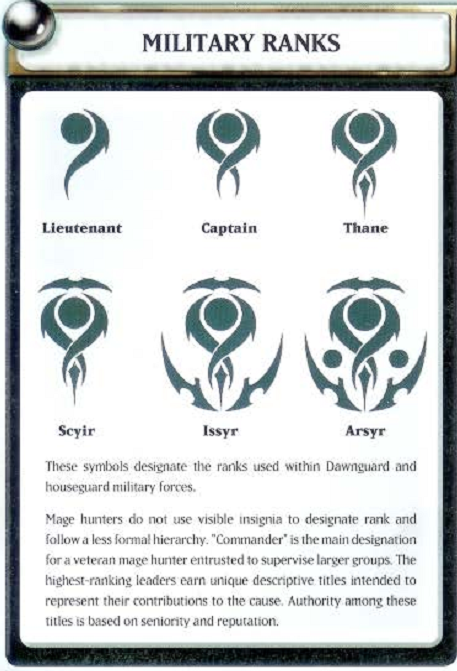
House Nyarr is noted for its heavy infantry traiend to fight alongside Myrmidons. House Elloweyr is famous for its renowned and aggressive swordsmen, while House Issyen is famous for cavalry. House Rhyslyrr is the home of peerless archers and riflemen, while House Silowuyr's soldiers are the post pious and the protectors of Shyrr. The largest border garrison is the Gate of Mists, guarding the entry to Ios. The next is the Gate of Storms on the Rhulic border, but Ios has never had any conflict with the Rhul. Recent increase in skorne activity has also led to constant alert at eastern Aeryth Dawnguard. The largest internal garrison is the training fortress Aeryth Ellowuyr, followed by the Shyrr garrison. Myrmidons are a rare accompaniment to the border patrols, which are largely infantry and cavalry supported by diviner surveillence. Superficially, little has changed with the rise of the Retribution, but in practice, House Nyarr is devoting two thirds of its soldiers to the Retribution and leaving only a third to cover their other responsibilities. Further, House Shyeel's myrmidons are all going to the Retribution, not the Homeguard, and they have a near monopoly on manufacturing and developing them, followed only by House Vyre, which hopes to take up the slack. An overt attack on Ios might exploit this defensive weakness, but the Retribution insists they will help fight, should that happen. Fortunately, the foreign reputation of Ios' border being impregnable may serve where the army cannot.
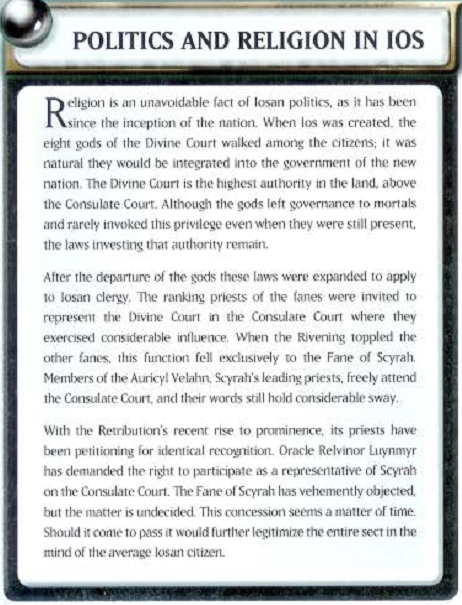
For now, the Retribution exists amidst turmoil. The government doesn't really like them, but they've been forced to recognize them by Nyarr and Shyeel, and the subtle threat of violence. No one wants another civil war. Therefore, the REtribution had to be accepted, and given the right to act with minimal oversight. The Consulate Court does not endorse or spport the REtribution as a state army. It does not act for Ios. Unfortunately, no human is really going to notice that, and they will still be held responsible for any Retribution attacks. The elves know that, and they don't like it. The leaders of the Retribution, the Nine Voices, have used the weakness of the Consulate Court to their advantage - they were willing to go to civil war if they had to, but were glad they didn't. They continue to try to convince houses to support their cause. Politically, they can't be vehemently opposed without giving the impression that whoever opposed them doesn't care about the gods, which makes for a very tense situation.
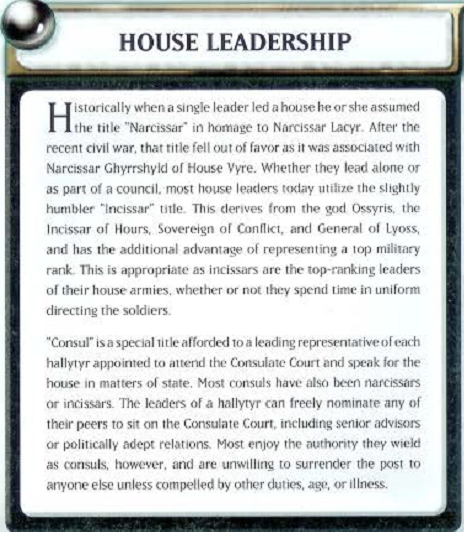
Next time: Force organization!
Forces of Warmachine: Retribution of Scyrah
Original SA post Forces of Warmachine: Retribution of ScyrahHouses Nyarr and Shyeel have been more tightly linked to the Retribution than anyone realized for decades. They've been secretly financing and giving military assistance to them for a long time, and now they're just open about it. They back it for pragmatic, not religious reasons, primarily. If they succeed, after all, they will have the unquesitoning support of the people and will be able to fundamentally transform and perhaps even rule Iosan society. It's a risky gamble, but they're committed now. With this open support, the Retribution ahs had to develop a hierarchy it didn't really have before. Not all of the mage hunters appreciate the new chain of command, but the military aid is great. Still, the partnership between them and the Dwanguard is tense and strained. The Dawnguard now have a lot of authority, while the mage hunters are advisors of them, pairing them for leadership. Dawnlord Vyros Nyarr is the head of the Retribution military, but his counterpart, Ravyn ('The Eternal Light') is the highest-ranking mage hunter. They have roughly comparable status but different areas of oversight. Resentment is common on both sides, and that can be a problem. Mage hunters tend to dislike the infelxible and regimented Dawnguard, and hate having to take barked orders. The Dawnguard see them as lacking discipline and respect.
Historically, the Retribution has been run by the Nine Voices from inside ios. Few had direct contact with them and they were shrouded in secrecy. However, that's begun to change. Most soldiers still don't have complete awareness of their identities, however. They just know that they have to obey. Technically, the Nine Voices are equal, but only technically. Four of them in particular prioritize Retribution goals and prepare the military. The most influential is Glyssor Syviis, an old guard assassin and spy whose deeds are legendary. He's the only one whose name is really known very well. Another respected leader is Espionage Liaisson Kelsyr Yrryel, a tough old veteran who helped shape the Retribution and served as an ambassador for 50 years. He returned to Ios at the start of the civil war, and no longer needed to keep his Retribution ties secret. Consuls Caelcyr Nyarr and Hyselle Shyeel were until recently the most secret members of the Nine Voices, but no longer have to be now that they've openly declared their loyalties. They are two of the most important shot callers thanks to their rank, but they often must send proxies due to their responsibilities.
The remaining five Voices are less overtly influential. Quaestor Nyr Voshan was a major crime boss in Shyrr who oversaw smuggling operations and now serves as the Retribution quartermaster. Keldeacon Synvas Uithuyr is a former mage hunter, retired after injury, who oversees training and recruitment. Jarmry of Eyvreyn is an old arcanist, a controversial master of magic whose techniques are currenly out of favor but who understands the threat of human magic more than anyone. Oracle Relvinor Luynmuyr works to ensure Scyrah's will is not forgotten, and he is arguably the most fanatical and charismatic of the Voices, working to spread their religious message throughout Ios. His top aide, Orator Lysenne Bylvesh, was once a more conservative member of the Fane of Scyrah before he met her, and she's done a lot to bring additional converts from the priesthood.
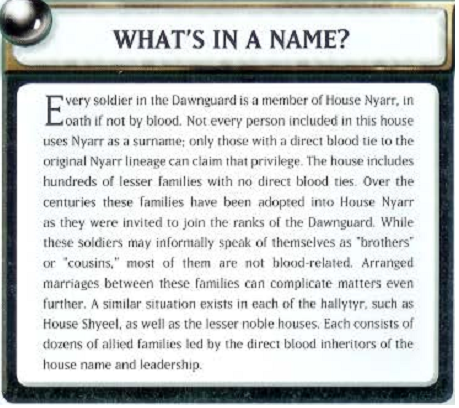
The Retribution mayb e greatly increased in size, but the core of the old organization remains. The mage hunters are still the fundamental embodiment of their goals. They opreate in cells to assassinate human wizards and warcasters, gather information and sabotage arcane research and mechanika production. They work to undermine human organizations of wizards, like the Greylords Covenant or the Militant Order of the Arcane Tempest, as well as private organizations like the Fraternal Order of Wizardry or the Order of the Golden Crucible. They are devoted to secrecy and speed, and they work as the Retribution's spies and assassins, helped by sleeper agents embedded throughout the Iron Kingdoms. Several of them are warcasters, and they are some of the deadliest strike leaders, moving as they are needed. A small but fanatical priesthood actively supports the mage hunters, using a radical interpretation of Scyrah's teachings, viewing her as a battle maiden, not a peaceful avatar of spring. They believe that human gods worked to strike her and the Divine Court down.
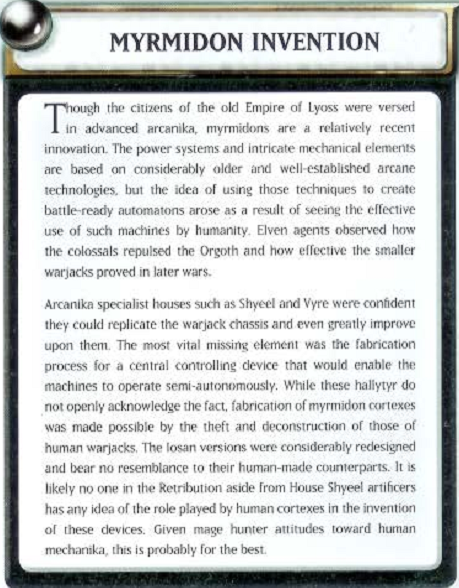
The mage hunters believe that every dead wizard helps Scyrah recover a little, as does every destroyed human mechanika. With full war, they hope to end human magic permanently and restore the goddess to health. No measure is too extreme. If they have to kill every warcaster, wizard and warjack, so be it. Finding skilled mage hunters and training them isn't easy, though, and most of the new Retribution members are soldiers. It takes a special mix of skill, ruthlessness and zeal to become a good mage hunter, and they're always looking for new recruits to train at the Syvash Stronghold. Those that survive the difficult early training can get more specialized training as trackers, swordsmen, marskman, mechanikal saboteurs or intrusion experts. At the top of the field are the living legnds like Eiryss or Garryth, Blade of Retribution.
The Dawnguard are a martial order dating back millenia, a verstaile army wielding the most advanced Iosan arms and armor. They are drilled and absolutely loyal to House Nyarr. They serve the Retribution out of orders, not personal commitment. They come in three branches. The Sentinals, the Invictors and the Destors. The first two are elite infantry, and the Destors are heavy cavalry. Officer commission in the Dawnguard is a mix of performance and blood ties to Nyarr, though in history there have been non-Nyarr leadership. Technically, all dawnlords are equal under Consul Nyarr, but Dawnlord Vyros Nyarr is the ranking field commander. The houseguard recruits are not nearly so simple or cohesive - they're loose volunteers or collections of House soldiers. They make up the rank and file, and most of them are veterans who actually believe in the Retribution cause. Others, of course, are there to try and make alliance with NYarr and Shyeel rather than for actual belief. These tend to be more pragmatic but no less skilled. Most of them are halberdiers or rifleman and serve as the man body of the Retribution army. They die most often in battle, which gets them deep respect.
The Retribution has divided its forces into three divisions. Two are standing strike armies, which include most of the Dawnguard and houseguard, while the third is primarily mage hunters. The main strike army, the Talons of Dawn, are led by Vyros NYarr personally. They handle high priority objectives, and most recently were dispatched to Khador to reclaim Nyssor. The secondary army, Scyrah's Blade, are there to support the main army or do simultaneous attacks on other targets. They are commanded by Dawnlord Cyrsyll Nyarr, a cousin of Vyros. She's been given the longterm job of expanding Ios' borders. The third division, the Unseen Spear, is made of ancillary strike teams that make smaller strikes and operations unrelated to the main armies. They are supervised by Dawnguard Issyr Rylavos, but sometimes receive orders directly from the Nine Voices. The senior warcaster commanding them is Kaelyssa, called Night's Whisper, an exemplary and loyal strike team leader. They largely work in enemy territory in secret, operating closely with field agents and using hidden bunkers and weapons caches. They are out of contact for long periods.
The Retribution has some unexpected allies, thanks to public sentiment. The Fane of Scyrah has sent advisors to them, knowing that thanks to the Retribution they've lost a lot of political clout and are seen as timid. They have to understand the Retribution if they wish to quell the unrest. Their religious differences seem irreconcilable, however. The fane believes any priestly magic drains Scyrah, which is why they really haven't wanted to commit to extreme action, and they believe the Retribution is causing great harm to the goddess. The Retribution, however, believe they have ways to use this power without harming Scyrah. Further, they insist that any energy they use in insignificant compared to the damage human arcanists do. Despite this, there are Fane priests who sympathize with the Retribution, even at high ranks. Aurican Avross Larisar and Glyssor Syviis periodically meet in secret to discuss Scyrah. In addition, several of the FAne Knights have accompanied Retribution armies, seeking to test their claims. The Seekers, a more moderate sect, have reluctantly also offered their advice, perhaps to try and encourage the Retribution away from widespread systematic violence. Their arcanists cooperate as necessary, but they never enjoy it. The Retribution knows some of this is about spying on them, but as long as they're useful, that's fine.
The Retribution lacks the same experience identifying and training warcasters as human armies have. Fortunately, Houses Shyeel and Nyarr have effective methods, which they've passed on to the Retribution. Finding new warcasters is a top priority. Their authority is less defined than in human armies - they may not always have complete command over their forces, though in practice they have a lot of operational oversight. The importance of their magic and myrmidons means they always have a central role, and the problem is when mage hunter warcasters try to give orders to Dawnguard officers. They don't like it. It's never a problem for warcasters in authority, though - Dawnguard Vyros Nyarr and Adeptis Rahn Shyeel are widely recognized by their houses, and Ravyn, the Eternal Light, speaks with the authority of the Nine Voices. The hard part is for folks like Garryth, Blade of Retribution, or Kaelyssa, Night's Whisper. They can expect mage hunter obedience but rarely lead large task forces.
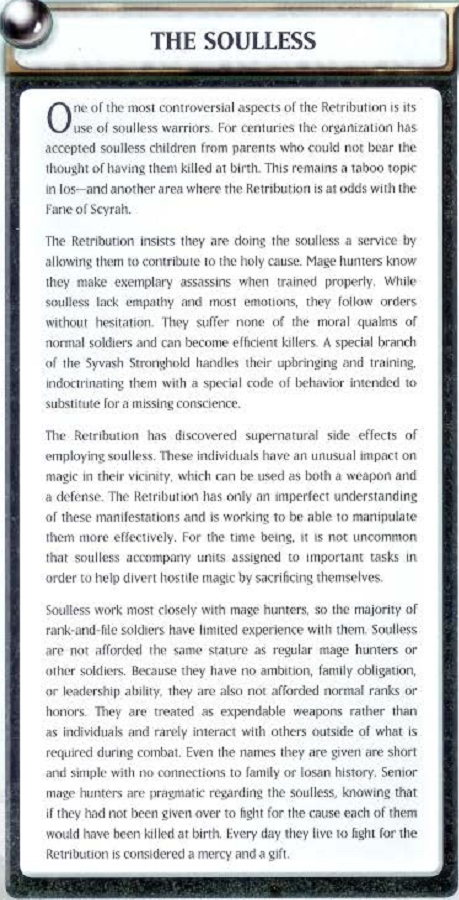
In the past, myrmidons were rarely used against humans for fear of their capture or discovery, though there were exceptions, kept carefully secret. Most humans don't even realize myrmidons exist, in fact. That'll change soon, but it's useful now. They differ from human and Rhulic warjacks significantly. They don't need convential supply lines due to their arcantrik power sources, allowing them much greater mobility. Damaged myrmidons still need parts and soliders still need food and ammo, so supply lines are still needed, but constant fuel supplies are not, which gives them greater speed and range of redeployment, and allows easier stockpiling of gear. However, myrmidons can't constantly run at peak capacity - it depletes their energy cells quickly and requires them to sit idle and recharge. That means planning and logistics are a huge deal - if a battle goes too long, they'll be depleted, and won't be ready for the unexpected. This weakness must be kept secret as long as possible. Unlike humans, myrmidons don't have to be hauled around on trains or wagons - the trickle of power from their arcane condensers is enough to allow constant movement at a moderate pace, typically leaving th arcantrik field, arms and weapons unpowered. Switching to full readiness can take several minutes, and in this state a myrmidon that is ambushed is easily destroyed before it's ready to fight, which is only made worse by rapid marches that gradually drain their energy reserves.
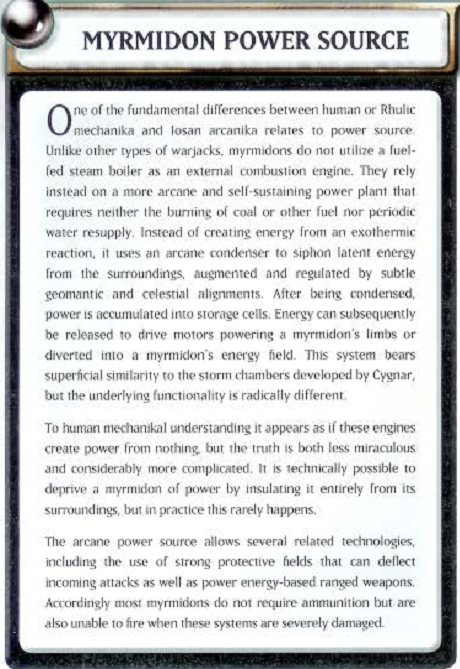
Established procedure is to move as quickly as possible between points of safety and avoid conflict. At each safe point, you recharge the myrmidons to full before moving on, ideally allowing them to become fully charged before fighting. Planning and proper recon are essential, and the Retribution is not good at handling surprised or protracted battle. Myrmidons are a limited resource, so warcasters don't always get the ones they want. The Talons of Dawn usually get first pick, then Scyrah's Blade, then the Unseen Spear. Myrmidon allocation is handled by House Shyeel, which sometimes uses it as political clout. Adeptis Rahn can expect whatever he fuckin' wants, for example, even over Vyros. Every officer knows the importance of treating House Shyeel with respect if they want the best out of their myrmidons.
Next time: Hands of Retribution
Forces of Warmachine: Retribution of Scyrah
Original SA post Forces of Warmachine: Retribution of Scyrah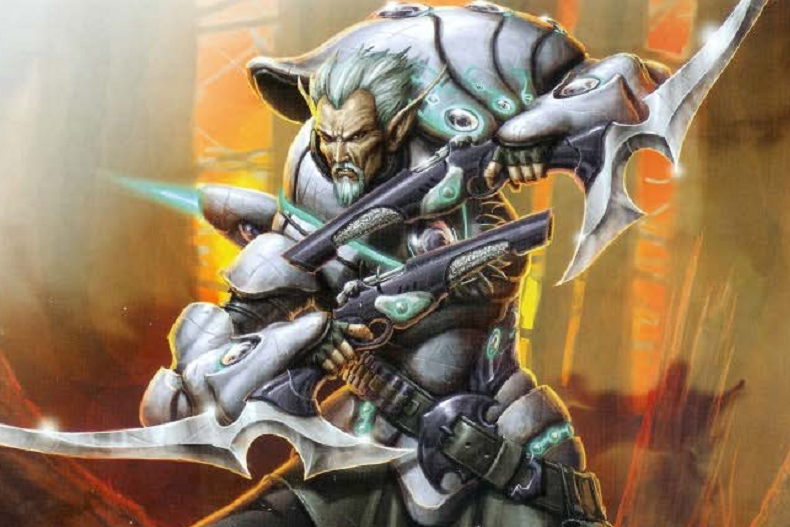
Garryth, Blade of Retribution , is a fanatic even among mage hunters. He is a cold-blooded killer who cares nothing for those he kills. No warcaster in all of Ios has his experience in fighting humans. He was discovered and recruited from the criminal underworld of Shyrr - a natural killer without regret, hesitation or remorse. He adapted quickly to mage hunter training, and was taught an ancient Lyossan fighting style once used by suicidal warrior-monks of Ossyria. They would stalk enemy commanders from the shadows in battle, taking them out one by one. Garryth seems himself similarly - he ends battles, he doesn't fight them. Though he can lead others, he prefers to estay aloof. Behind the brooding is a mind always working, torn between dedication to his mission and a desire to kill all humans right now. At times, he indulges his dark hatred, becoming an unstoppable fiend capable of doing things even the Retribution would shy away from. In his mind, Scyrah is a wounded warrior-maiden who demands vengeance. Unlike most warcasters of the Retribution, he has spent little time in Ios these past few decades. He lived in the field, studying his nation's foes, and he has more experience than most other warcasters at pitting myrmidons against humans - his only real peers are veterans like Narn and Eiryss. Garryth enjoys his work a lot, and has long waited for the day when the shackles on his killing urges would be removed. His gimmick is traps and debuffs, and his feat allows him to shut down any and all magic nearby.
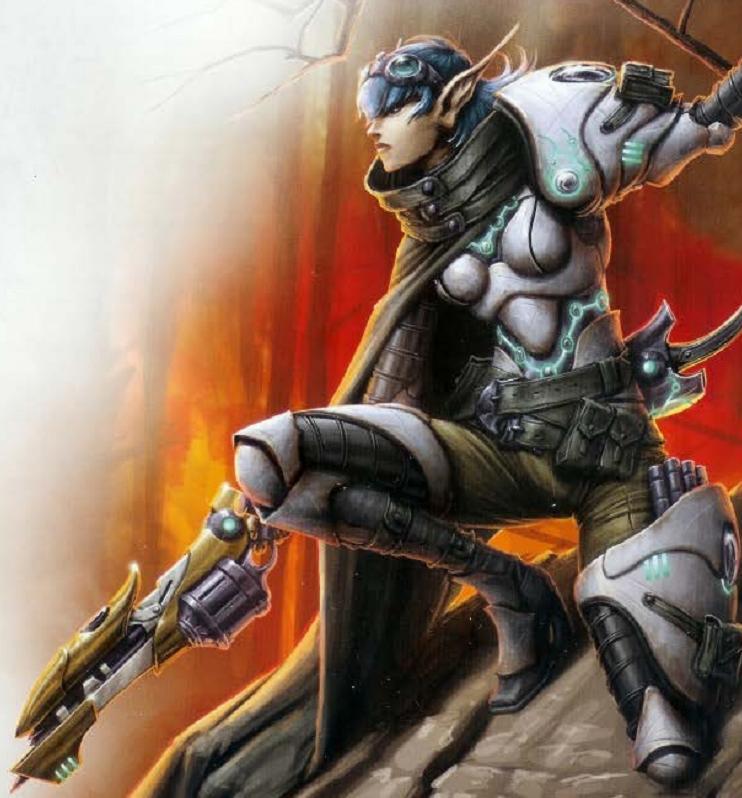
Kaelyssa, Night's Whisper , is the leader of the mage hunters. She's casual in her leadership and prefers to befriend her subordinates, mixing professionalism, cleverness and biting wit. In battle, however, she is a predator with an almost supernatural awareness of her surroundings. Her sergeants claim she can hear the heartbeats of her foes and taste their movements in the air. She prefers cover of darkness, firing runebolts through solid walls to kill her prey tracelessly. Outside of battle, her informal and relaxed personality can be confusing to some. What they mistake for impiety as actually a result of total immersion in the cause. Kaelyssa's parents were Retribution and she was raised among their cells. She saw them put themselves in danger and expects the same for herself. Her belief in Scyrah and mage hunting are bone-deep. It was early on that she showed her sorcerous talents, and the Shyeel fostered her ability at unraveling magic. She has integrated those powers into her combat style now, leaving wizards defenseless against her. She has risen rapidly despite her youth, leading over a dozen assaults abroad. She was recently put in charge of the Unseen Spear's operations, and refuses to accept failure. She finds her job dangerous but thrilling, and she tries to use all her talents every mission. No one doubts that she has potential - it just remains to be seen how far she'll rise. Her gimmick is countermagic and turning magic against the enemy, mixed in with stealth. Her feat allows her to stealth everyone nearby.
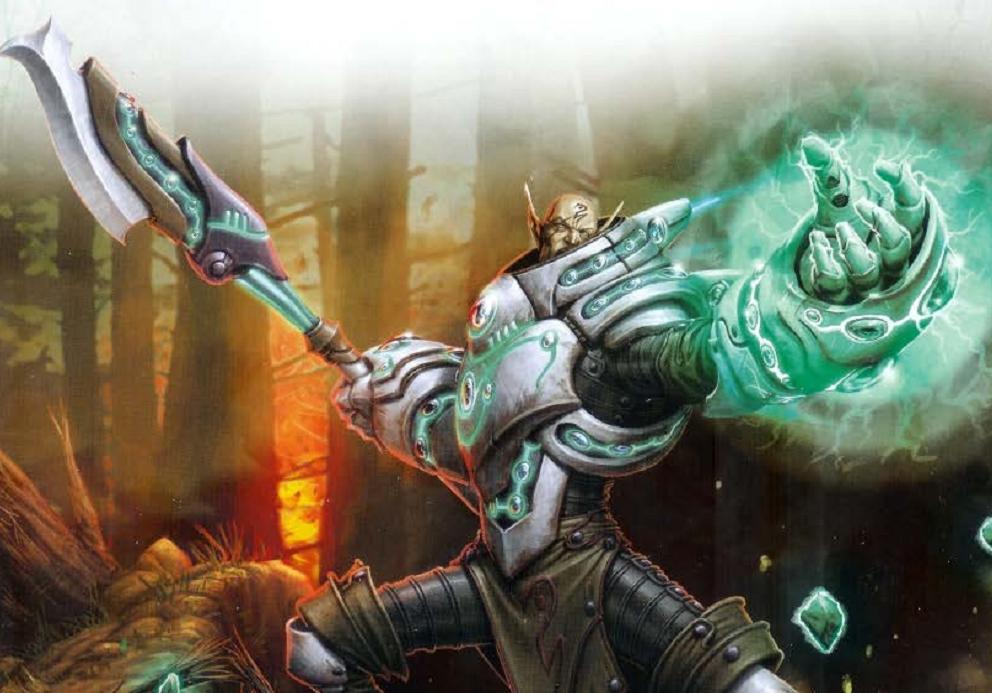
Adeptis Rahn Shyeel is one of the most powerful arcanists of the generation, a master of force manipulation. With a thought, he can generate storms of kinetic power. When he speaks, he backs down to no one, no matter what their rank - at least when it comes to his dominion, which is magic. He is the embodiment of the battle mage discilpine. He focuses on control of raw force, and in that he is an undisputed leader. He is imperious and unflinching, treating all discussions as if they were fights. He is arguably even more influential in House Shyeel than Consul Hyselle, whom he answers to. It is he, after all, who commands the battle mages. He is not an artificer, but has great sway over myrmidon design. Before he openly joined the Retribution, he toured Ios testing myrmidon chassis and making ties with House Nyarr over their needs in myrmidons. Rahn is a pragmatist, and not a true believer in the Retribution's cause. They are a convenient lever for social change, to raise himself House Shyeel to greater heights. Selfish? Sure. But he needs that confidence to wield his power. His philosophy is to utterly control all within his reach and ignore all that is not. Scyrah will not die before he does, so he doesn't bother himself about that. That's someone else's job. His power goes hand in hand with his ruthlessness, and he enjoys war. Violent magic is beautiful, to him, and he relishes battle. His gimmick is force blasts. So much force. So much force. His feat increases the range of spells and their damage.
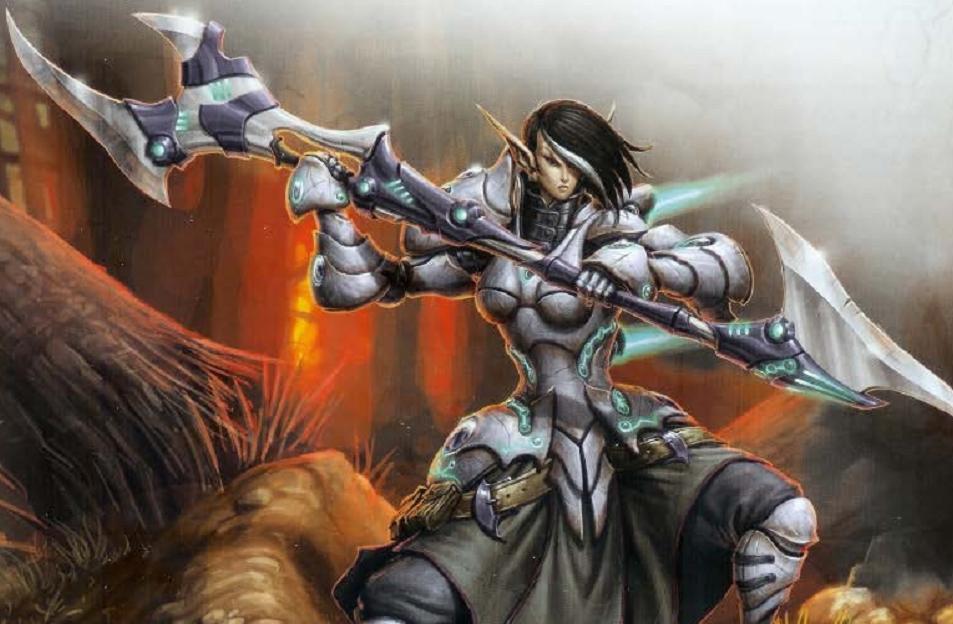
Ravyn, Eternal Light , is a beacon of hope within the Retribution, admired for her dedication to Shyeel and her skill as a leader and warrior. Off the field, she is calm and wise. In battle, she is invincible. She never holds back, entering a state of detachment as she accepts death. Her weapon, Hellebore, becomes an extension of her self as she fires, strikes with it, then fires again. She sweeps through the enemy in a whirlwind of death. She doesn't enjoy, but she does not hesitate. When Scyrah is restored, she will welcome peace. Ravyn spent most of her adult life as a FAne Knight, and she helped fight against House Vyre's atrocities. Her band was always at the front, and she turned the tirde with her team of ten knights, defeating an army five hundred strong by careful use of her myrmidons to kill the blockade leaders. She personally slaughtered dozens, and the army surrendered, as did many other forces when she confronted them, earning her the title of hero. Five years ago, she joined the Retribution unexpectedly, but it was no hasty decision. It was made only after long deliberation in secret with Orator Lysenne Bylvesh, second in command of the Retribution clergy and one of the Nine Voices. Ravyn was persuaded that the Retribution had evidence that they could restore Scyrah. She was given the title of Eternal Light to represent the hope she embodies. She is the primary battlefield liaison and will lead the fight abroad. Despite her short history with them, her name is synonymous with serving Scyrah and Ios, so she has been embraced as proof of their righteousness. Ravyn's gimmick is ranged combat. She's really good at it and supproting it, and her feat lets her boost the ranged attacks and movement of everyone around her.
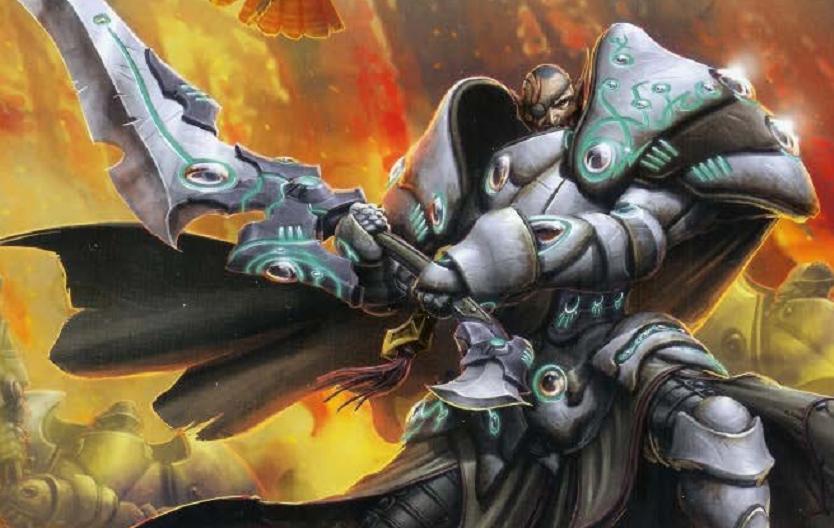
Dawnlord Vyros Nyarr is the heir presumptive of his house and one of the most politically powerful people in Ios. He's also a warcaster backed by the entire Dawnguard. Few know his full ambition, but his current actions are only the start of larger machinations. He is friends with Adeptis Rahn and his uncle, Consul Caelcyr Nyarr, and he believes the military might of the new Retribution is his to use against any obstacle. He is the son of Caelcyr's younger brother Hylos, dead of a wasting disease, and he is the clear choice for heir. Publicly, he's said he has no interest, but those who know him know that ruling Nyarr is key to his plans. He was pivotal in the War of the Houses and faced Ghyrrshyld directly, losing an eye but delivering what should have been a deathblow. (It wasn't his fault Ghyrrshyld turned himself into a
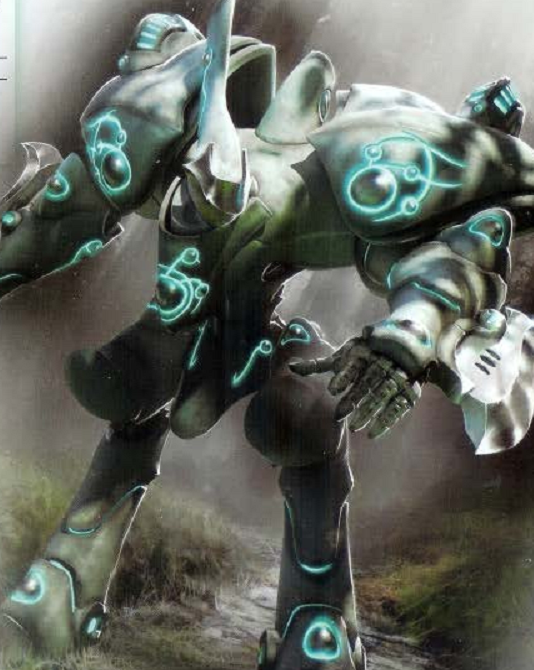
The Chimera is just over nine feet tall and just under 2 and a half tons. It can be unsettling to its enemies, because its active power field makes its form blur and fade, sometimes appearing several feet from its actual location. Even at rest, it seems to be moving. Once near the enemy, it serves as a delivery mechanism for magic channeled through its arc node as well as using its arm-mounted glaives to attack soldiers before appearing to vanish and reappear elsewhere. The components it uses are rare, so while it is in high demand, it's had limited production. Most warcasters would use as many as they could get their hands on, and arc nodes play into the old Iosan doctrine of extending magical power as the key to success. Best of all, its glaives are arm-mounted so it has free hands to wrestle with.
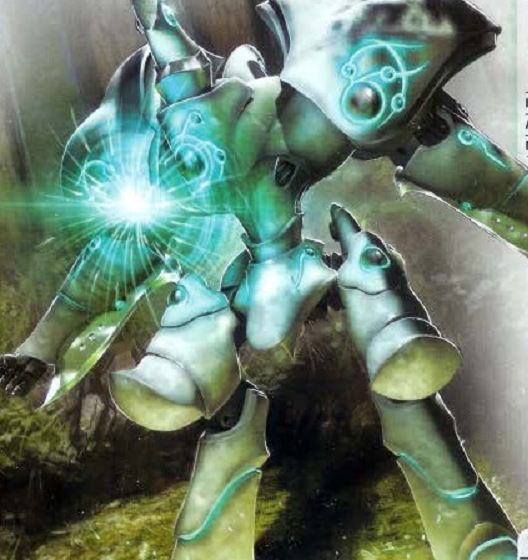
The Gorgon is nine feet tall and two and a quarter tons. Its job is simple: deprive the enemy of mobility. It relies on manipulation and generation of kinetic fields, firing force blasts from its force cannon that can stop forward momentum as well as do great damage. Its more potent fields requier clsoer proximity, however, and so it will rush in to grab 'jacks and pin them in place with its energy field, then punish them with the same sort of arm-mounted glaives as are used on the Chimera. It's taken decades to perfect those force manipulation technologies, and it means regulating the power field to create a kinetic anchor that can seize and lock things in place. That required a particularly powerful generator for the small chassis, which would later be applied to increase the efficiency of all Shyeel myrmidons.
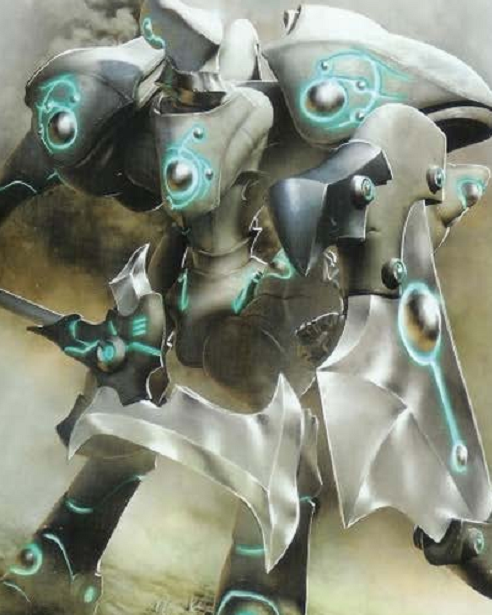
The Griffon is nine feet tall and just over two and a half tons. It is made for rapid deployment and flanking, with a power field that lets it become nearly weightless for short bursts, allowing it to leap impossible distances and negotiate terrain that would be difficult for machines of similar weight. It sweeps around entrenchments to attack from the rear or flank, often rushing well ahead of the main line. Its durability and long operational time make it a potent asset, especially because it's relatively cheap to build. It gets handed out liberally - in fact, there's twice as many Griffons as any other myrmidon.
Next time: Forces of Retribution
Forces of Warmachine: Retribution of Scyrah
Original SA post Forces of Warmachine: Retribution of Scyrah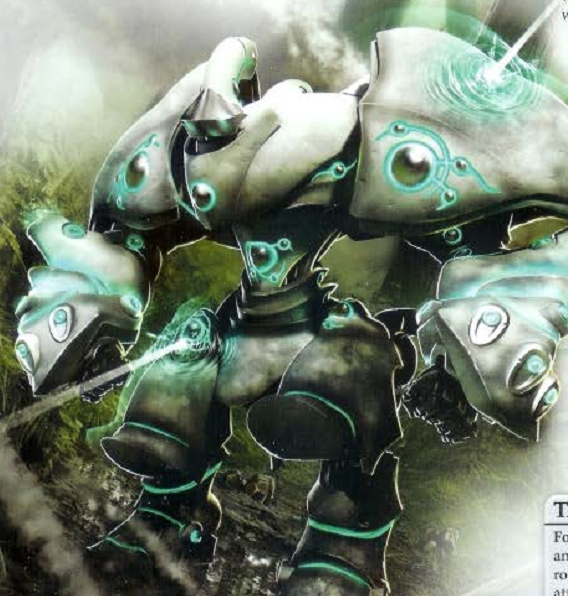
The Hydra is just over twelve feet tall and weighs 5 and a quarter tons. It is a highly self-reliant myrmidon, able to convert raw kinetic energy from incoming attacks into a retributive firestorm. It has force generators in its fights, which allow it to hurl crushing blows and toss aside even the strongest and most massive foes. Excess energy is stored in its arcane batteries to enhance its strength. Once powered, the Hydra's reserves last until they are used, making it a favorite for travel. Experienced commanders make it a top priority to keep them fully powered once battle starts, and after that they need little more than mental guidance, as the battery will keep topped up due to enemy attacks.
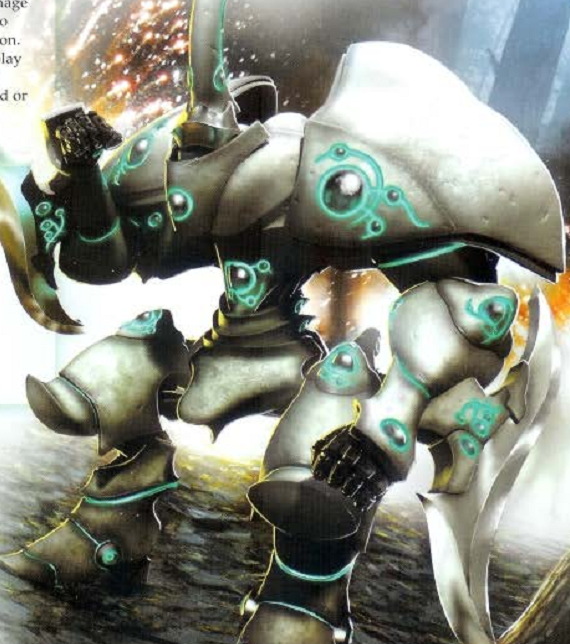
The Manticore is over twelve feet tall and nearly five and a half tons. It is the most physically potent of all Iosan myrmidons, ferocious and unforgiving. Its attacks are earthshaking, and its strength is only bolstered by its cyclone cannon, a force weapon fueled by the generator poerin its kinetic field. This equal capacity in melee or at range lends the Manticore to versatile tactics. The cannon is a rapid fire weapon, able to lay down suppressive fire in support or concentrated fire to take out several targets at once.
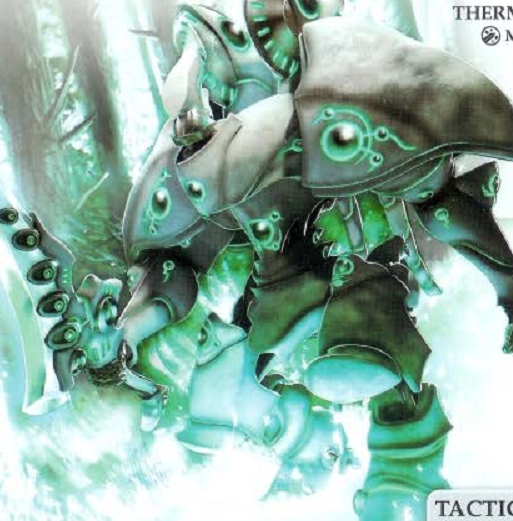
The Phoenix is over thirteen feet tall and weights six and a half tons. It is the embodiment of Iosan power, with a power field so potent that it is blindingly bright, and a thermal blade that ignites everything around it with liquid fire. It's costly to produce, but well worth it. It was designed to deliver its onboard arc node to the enemy's heart, extending the warcaster's reach extensively, but in a different way than the Chimera. The Phoenix is all durability and raw power, with a power field that regenerates automatically and which can ignite the very air around it, if the fiery sword, ready fist and flaming halo cannon weren't enough.
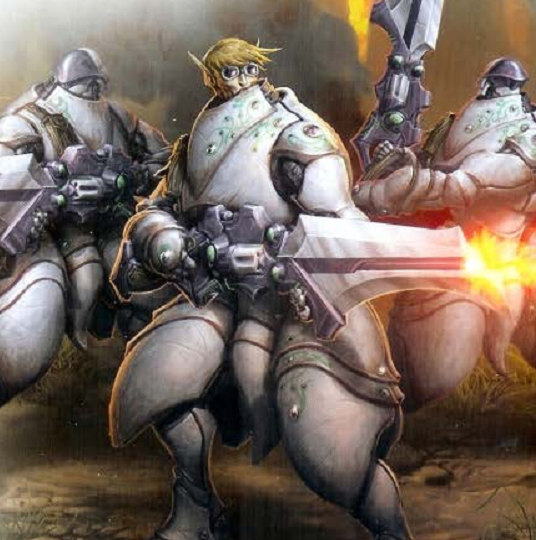
The Dawnguard Invcitors are the bulk of the Dawnguard, a versatile heavy infantry force specialized in supporting myrmidons. They use their sword cannons as they close with the foe, then just the blades in melee. They were originally founded in Lyoss as an auxiliary to the Sentinels and Destors, but have become the DAwnguard mainstay as weaponry and tactics evolved. The Invictors are deadly in range and melee, allowing them to fill many roles, and most Dawnguard forts are exclusively manned by Invictors. They are often the first to fire, engage and endure an attack. OVer the last few centuries, the use of myrmidons have become vital to Nyarr battle doctrine, and the Invictors drill alongside them, mastering support tactics. In fact, some Invictor commanders are given their own myrmidons as a mark of distinction, particularly Griffons.
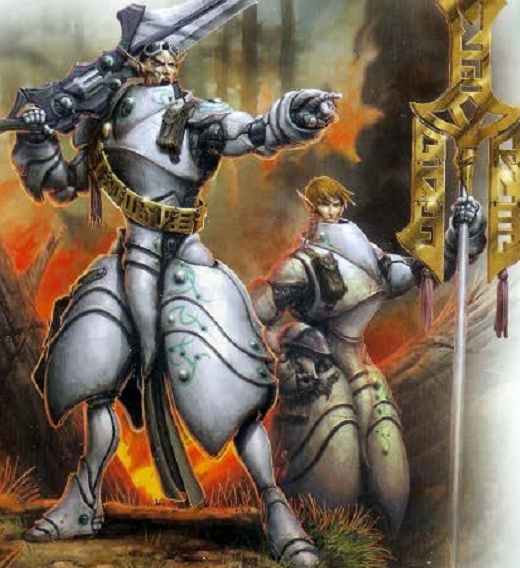
Occasionally an Invictor OFficer and Standard will accompany an Invictor unit. These captains are peerless veterans responsible for hundreds of subordinates, and they are devoted to the Dawnguard, sworn to live and die with weapons ready. They measure success by performance of the company and usually don't care about individual heroics, encouraging camaraderie and cooperation over individual accomplishment. That applies in both success and failure - the failures of one are the failures of all. Those who seek glroy but endanger their peers are shamed as much as those who fail to perform. The officers are stern and unforgiving, but willing to fight tooth and nail for their squads. All invictors are extensively drilled in coordinated actions, and that's particularly true of a captain's personal team. They instinctively obey the captain's orders, and this discipline allows for devastating combined fire at unprecedented range.
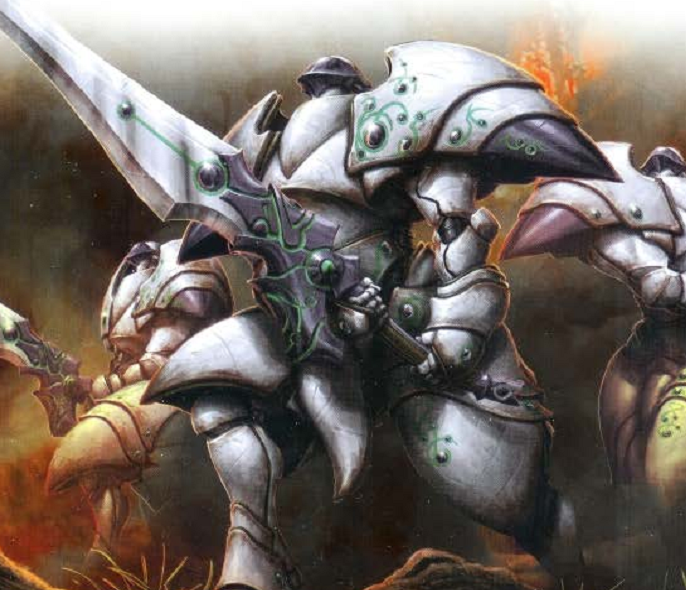
Dawnguard Sentinels are the shock troops of the dawnguard, armed with immense blades. They are heavily armored and can carve through pretty much anyone, even in the face of overwhelming casualties. They will fight to the last elf, no matter what. They see themselves as the timeless essence of the Dawnguard, inheritors of a legacy dating back to those who died to saved the Lyossan refugees after the Cataclysm. There is great prestige in being a Sentinel, and they are chosen only from the strongest and most resolute. They are trained for decades to die for their kin, and they see their family and order as identical, as a sort of destiny to serve. They are always vigilant, the guardians of the Dawnguard ideal, pure in doctrine. Some accuse them of obsession with ceremony and ritual, but they believe these symbols are essential to their purpose. Doctrine insists on constant readiness to march, fearing no death. The Sentinels are not guards - they are proactive in confronting the enemy.
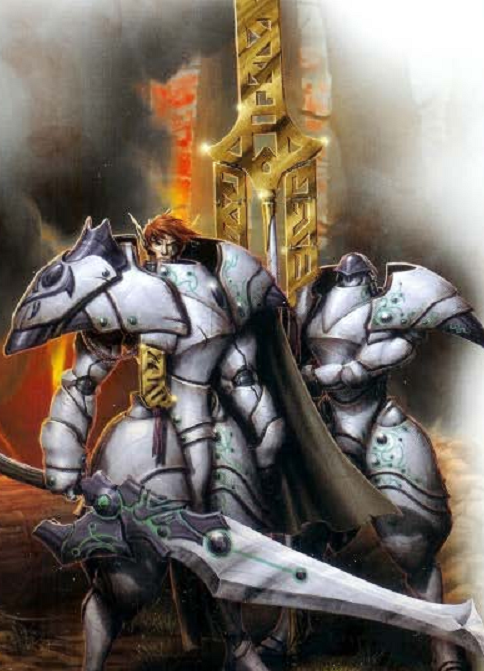
A Sentinel Officer and Standard sometimes joins the Sentinels in battle. Sentinel captains are the most disciplined of the Dawnguard, willing to do anything to honor the order and House Nyarr. They are most often of the Nyarr bloodline, educated from an early age. They begin training as soon as they can lift their blades, living in a constant pattern of practice, conditioning, drill and study in order to fulfill their obligations, viewing soldiery as a way of life and leadership a task trained in them from birth. They are unshakably loyal and devoted.
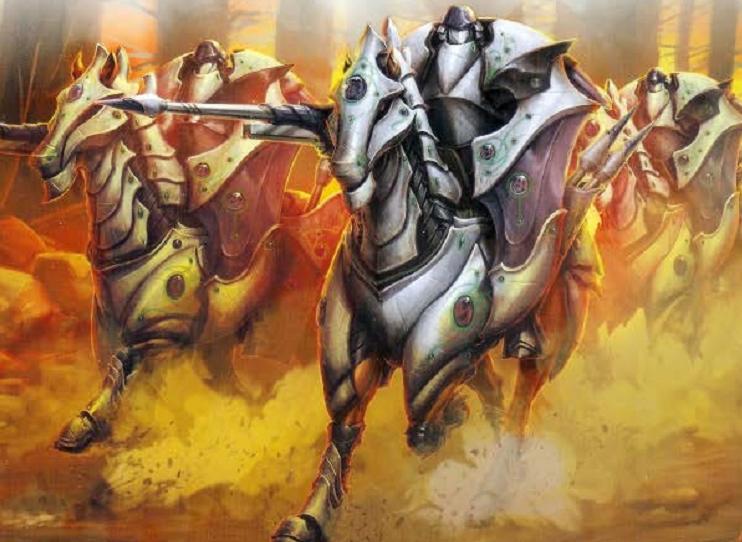
The Dawnguard Destors are the elite cavalry of the Dawnguard, used to support infantry offensives by attacking where the enemy is weakest. Once they penetrate the lines, they wheel around and fire with their ingenious lance cannons, which allow for shocking accuracy even at a full gallop. They Dawnguard is most known for infantry, and the Destors have always been the smallest part of the order. They are respected, but underrepresented. Those drawn to the life embrace their standing, working tirelessly to prove themselves on the battlefield. Firing accurately from horseback is very hard and takes a lot of practice even for those with a talent for it. The Destors are always used to cripple and destroy hard targets or to break some crucial part of the enemy line.
Next time: The Houseguard
Forces of Warmachine: Retribution of Scyrah
Original SA postWhat, you've never seen fantasy elf space marines before?
Forces of Warmachine: Retribution of Scyrah
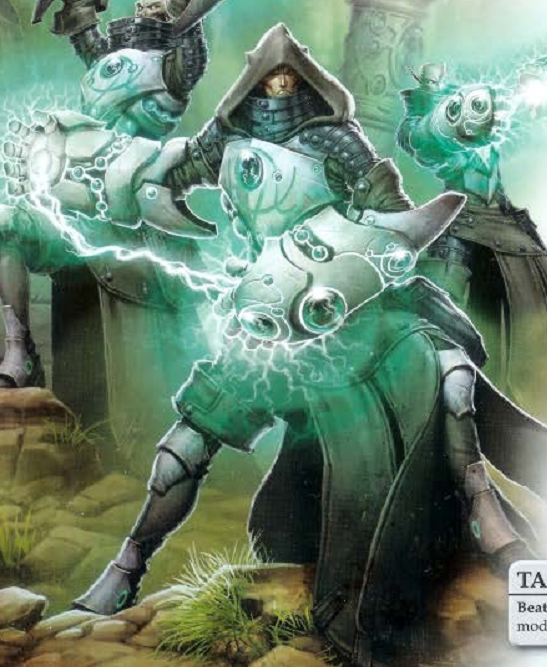
House Shyeel Battle Mages
make magic a military science. They travel in squads, wielding power like a weapon. They favore raw evoked force to any esoterica, and are typically as stern and direct as their spells. They mix the arcane and the martial, training for physical combat to refine their mental control. They are fearless, armed with massive arcanika-charged gauntlets that give them supernatural strength, while their magic allows them to deflect incoming fire and shrapnel. They are strategically deployed throughout the Retribution to involve House Shyeel in all major operations. House leaders don't want to sit around just making myrmidons, you see. They want to be on the front lines, preserving house interests, and some have said it's a step towards becoming a Great Military House.
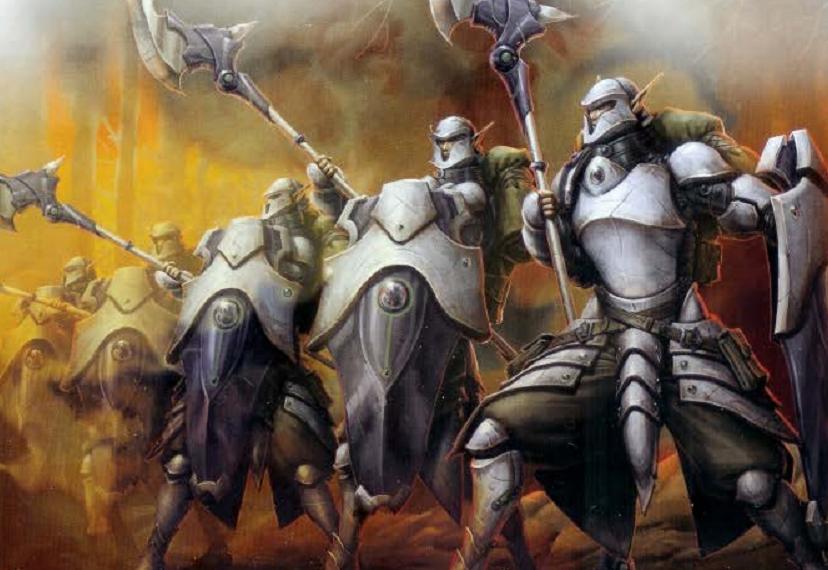
The
Houseguard Halberdiers
are an unbroken martial tradition predating even Lyoss. Even in the hands of a new recruit, the halberd is deadly, and most houseguard are career soldiers who've drilled for years in formation. They know all the maneuvers by heart, a tide of rising and falling steel. Because they are drawn from many lesser households, there's a lot of variance in their armor and uniforms, but the basic halberd is constant and based on ancient tradition. The manpower of the houseguard is what allows the Retribution to take their battles to human kingdoms, for the halberdiers are the lifeblood of the army, fully aware that they will be the most frequent casualties.
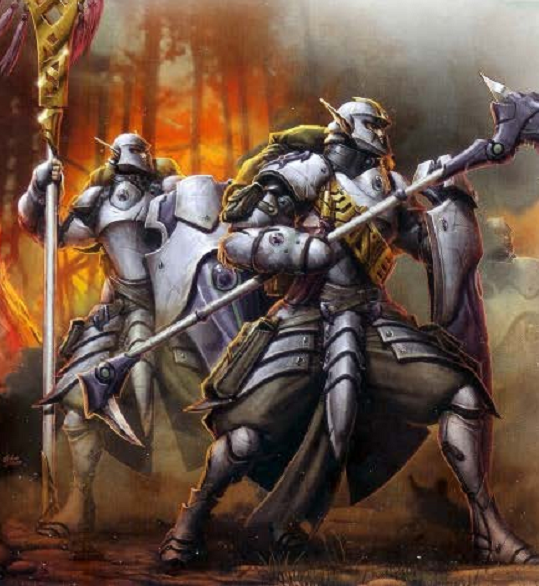
The best units get a
Halberdier Officer and Standard
. The officers are consummate warriors, leading by example. Most once served in the Homeguard Coalition, drilling at the border and interior garrisons. They have replaced safety for war, risking their lives on foreign soil - the chance to serve they always wanted, putting unused skills to the test. For many, the cause is holy. Their companies joined for many reasons, and so have the officers. Some are loyal to nobles who donated soldiers to the Retribution, while others embrace the cause. Some companies stay tight-knit due to kinship ties, but others are volunteers from many houses. Officers must forge their men into disciplined groups, acting as one body. In time, some will become heroes while others die, but there will always be another to pick up the banner.
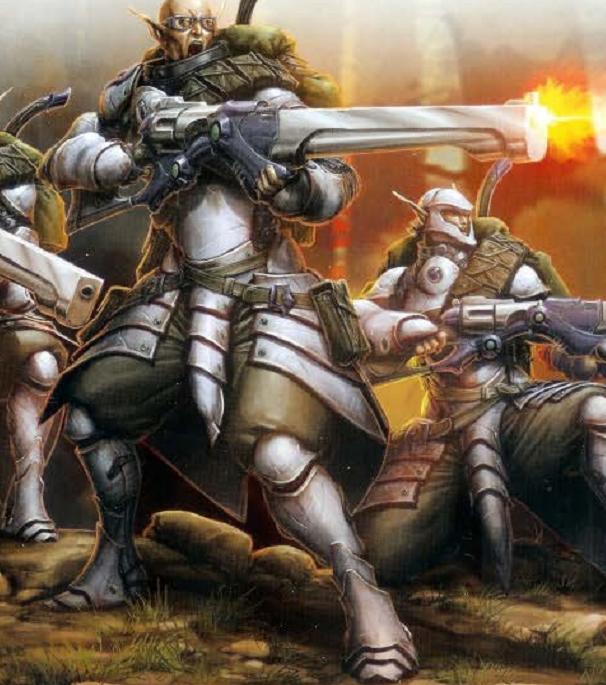
Houseguard Riflemen
come from all walks of Iosan life. Companies of them have joined the Retribution en masse, serving as the long-reaching line with their heavy rifles against the humans who vastly outnumber them. Each house keeps riflemen based on its needs and means, but they cost more than halberdiers. Outfitting and maintaining a company of rifleman isn't cheap, but it's worth it. A large force of them is quite powerful, and Ios prefers quality to quantity when it comes to them. Every rifleman has spent years drilling with their weapons and squads. They are professionals of the highest caliber, trained to carefully aim, that each trigger pull might be a kill.
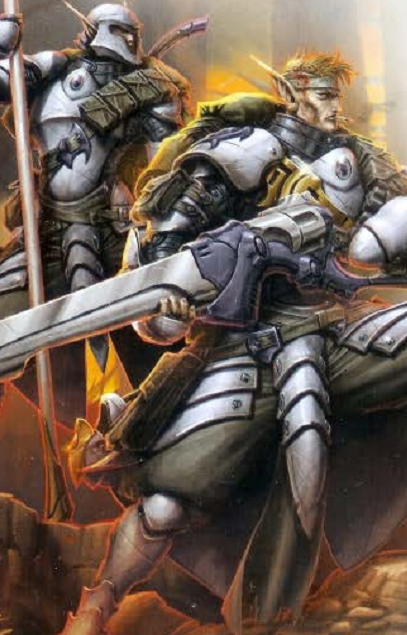
The best get a
Rifleman Officer and Standard
, leaders of the rifleman companies. They are even more vital to success than the training of the riflemen. Judgment calls are the difference between victory and defeat, and a rifleman captain must be able to gauge the strength of the foe accurately, directing fire where it's most needed. They have to work smoothly with the convoluted plans of the mage hunters and Dawnguard, knowing to hold fire until the first mage hunter ambush, ensuring patience and focus, keeping fears in check. After decades fo directing fire, they know better than anyone the pressure they can put on an enemy with just a few dozen rifles in the right place. Riflemen with a good captain will stay steady even in the face of the enemy, waiting until the last moment and so increasing the impect of every shot.
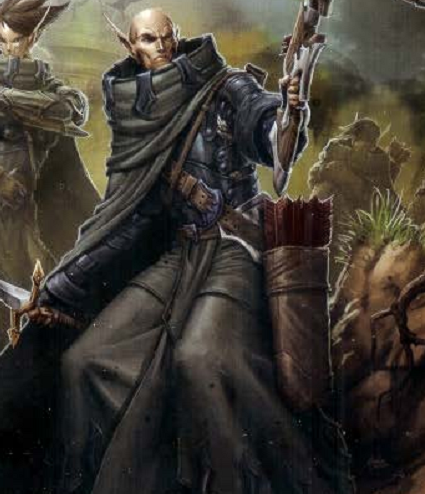
The
Mage Hunter Strike Forces
are the traditional core of the Retribution, waging a secret war on humanity for centuries. They have refined their ability to recruit agents with the right mix of dedication, talent and instinct to train into warriors and killers. Mage hunters function in situations soldiers rarely have to face, like surviving deep in enemy territory without support. They learn to be at home anywhere, to improvise and scavenge, and to kill without hesitation. EVen in battle, they use misdirection and stealth to ambush foes, always focusing on enemy arcanists and mechanikal constructs. They use personal experience as much as training to disable mechanikal systems easily. You're not a full hunter until you've been in the field, working on life and death odds. Those who lack the skill don't last long. Those who do are hardened, eventually becoming able to operate independently. Mage hunters are a zealous fellowship, all united by their firm belief in the Retribution cause. Failure is not just shame, but disappointment to Scyrah, and so each mage hunter has a firm conviction and amazing focus.
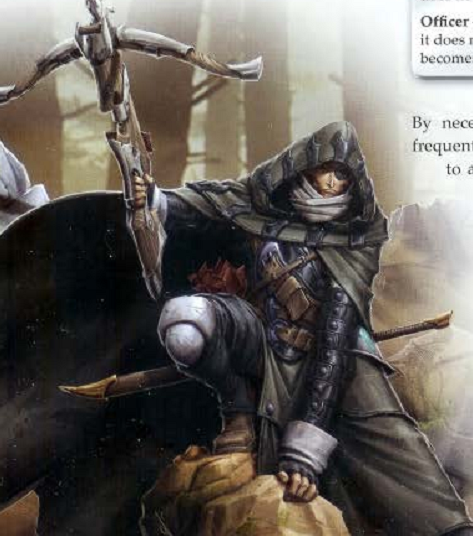
Mage Hunter Strike Force Commanders
are senior operatives, veterans who lead small teams. They are leaders as well as killers, promoted and entrusted with the lives of dozens, even entire cells. These commanders lead senior teams who are well-versed in Retribution tactics, planning everything to the last detail and evaluating foes precisely. They slip past the outer defenses before battle and can even fire bolts through walls, terrifying their foes from shadows and secrecy. This has been found useful in battle - they don't have to see enemies to shoot them. By necessity, they can't frequently contact Retribution leadership, so they are trained to act autonomously, even if it means they have to decide the mission is more important than survival.
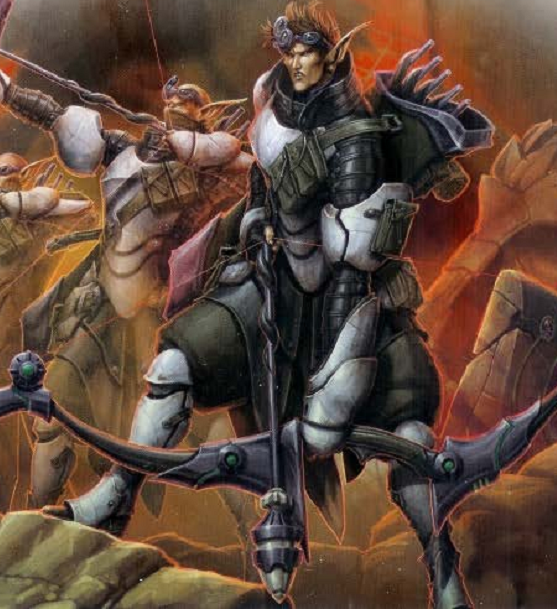
Stormfall Archers
are walking artillery, armed with alchemical arrows. They use immense compound bows to launch these arrows across entire battlefields, but they're far more agile than the slow-moving cannons of human kingdoms. They move in, open fire and fall back before anyone can respond - a very Retribution tactic. They originated with House Rhysfyrr, but their techniques quickly spread to many ancillary houses. While most remain with the Homeguard Coalition, a good number have joined the houseguard and Retribution. They are more likely to be discussing angles of descent and attack vectors than Scyrah's plight, but that doesn't mean they all lack piety - it's just that being a stormfall archer is a specialized job, and they take great pride in it and in constantly improving their skills.
Next time: The Soulless and the Solos
Forces of Warmachine: Retribution of Scyrah
Original SA post Forces of Warmachine: Retribution of Scyrah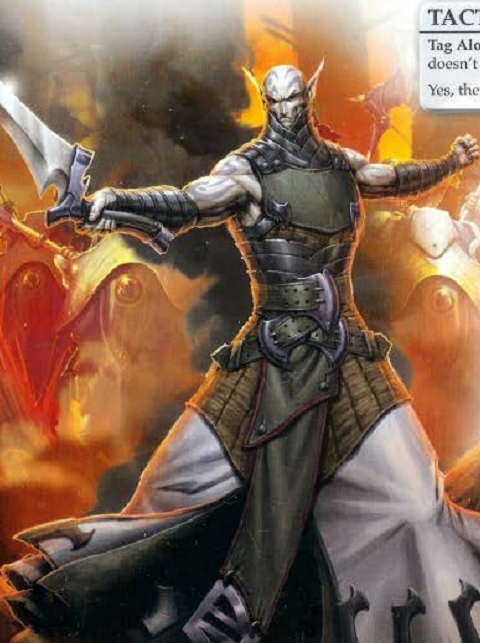
The parents of the Soulless Escorts might feel differently about the Retribution's 'mercy' if they know what their unwanted offspring were used for. They try to train the soulless as soldiers, but not all of them are suitable. Some are destined to serve other functions, as their unique state allows them to neutralize arcane energy by their very presence. Energy flows are siphoned into their bodies, leaving disfiguring burns. Too much causes organ failure - the heart and lungs burst from the energy, leaving those around them unharmed. Using the soulless this way is relatively new and experimental. For decades, sympathetic midwives and priests of Scyrah have smuggled the children to the Retribution, who are raised and trained in a sealed Iryss enclave to handle weapons and obey commands. However, their lack of self-will and motviation makes most of them lackluster at best, as killers, and one favored use of these individuals is to exploit their ability to interfere with magical energies. They serve as lightning rods for the lives of others against hostile magic. Most who have to deal with them do not take well to having a soulless around, and the escort is never considered truly part of the group. Some are treated as little more than pack mules, never spoken to at all.
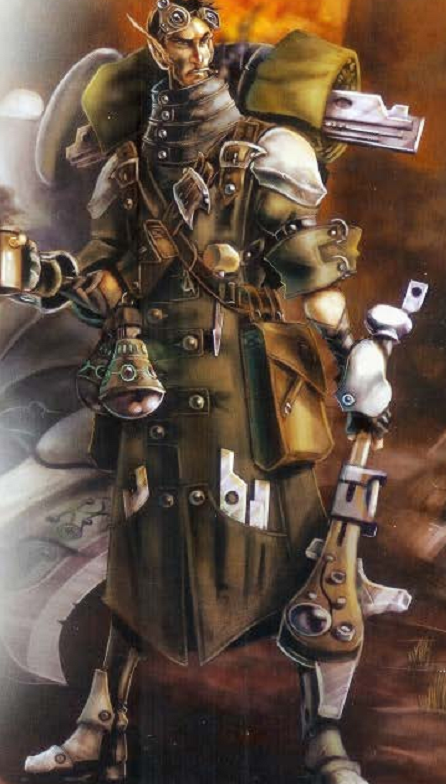
Even the best myrmidon needs repair and support, and that's what an Arcanist is for. They are seasoned mechanics with a working knowledge of arcanika that allows them to fix even mostly ruined myrmidons. Their expertise also gives them subtle arcane power to push these machines to their limits. It takes a lot of bravery to maintain focus in battle while the myrmidons they service are under fire. They have a more intimate working knowledge of myrmidon function than anyone else, since even the designers never have to rush to pry open access panels and replace focusing lenses while getting shot at. Most arcanists are House Shyeel, at least in the Retribution, or are affiliated with an allied house of lower standing. Each of the few houses able to produce myrmidons have their own techniques, secrets and standards, and maintaining the machines is a highly specialized skill taught master to apprentice. Every arcanist answers to their mentor or another house agent to ensure Shyeel secrets are kept. They rarely care much about politics or religion.
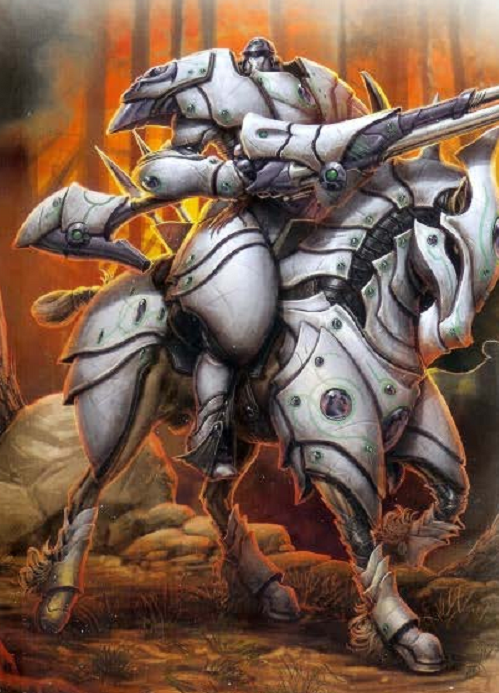
A Dawnguard Destor Thane is a veteran of the destor tradition, a ranking officer entrusted to oversee the execution of a battle plan involving multiple captains and their companies. They are very proud of their reputations as armies of one. After years in the saddle, they are supremely skilled with their lance cannons, able to firem ultiple blasts in sequence or charge to obliterate enemies under the hooves of their steeds. In the civil war against House Vyre, they made the difference in breaking through the defenders, and many went on to become prominent Dawnguard leaders. Warcasters rely heavily on the thanes not just for their martial skill, but their leadership in battle. Many destor officers believe the true potential of heavy cavalry has yet to be realized, and look to prove their value on the foreign battlefield. For years, the only true threats to Iosan armies have been from within, and now is the chance for an innovative officer to prove themselves against unpredictable threats. They embrace the chance to fight for the Retribution and test their theories.
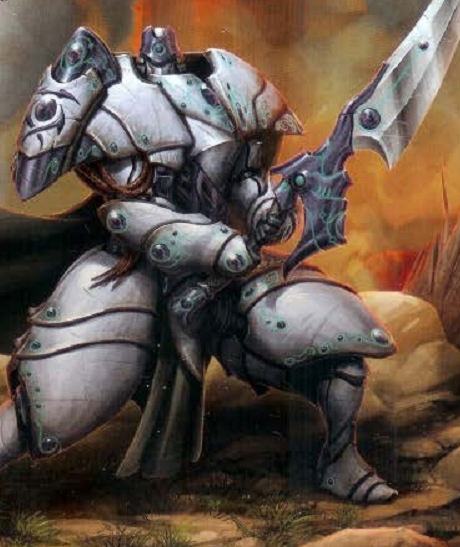
Dawnguard Scyirs are ranking officers, borriwng titles of the Divine Court. They are the elite of the elite, outranking even thanes, and often lead task forces of mixed units. They tend to be nobles, and for those that prefer the battlefield to politics, there's no need for higher rank than this. They are the pinnacle of martial coordination, allowed to focus all their energy on those tasks and ignore the distractions of logistics and politics, which are left for their superiors. Scyirs are the lords of the battlefield, and each one is a hero. They are both formidable and also capable of directing both myrmidons and all Dawnguard branches in the absence of a full warcaster. In recent years, they actually enjoyed unquestioned authority on the battlefield, but that shifted since House Nyarr joined the Retribution. Now, they must work with mage hunter commanders and high-ranking houseguard. Those who succeed will be the ones that can earn the genuine respect of their peers without expecting unquestioning obedience.
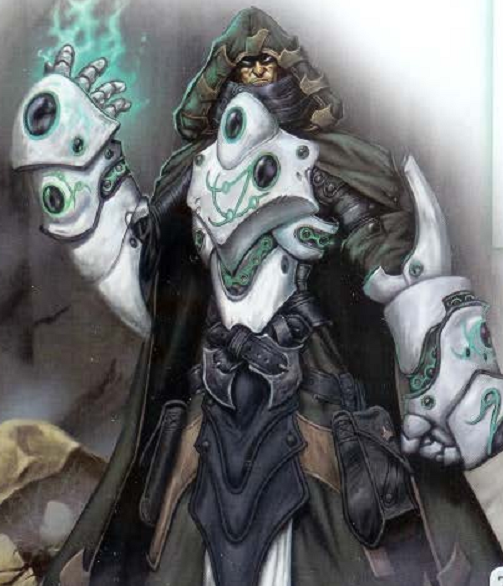
House Shyeel Magisters have even more control over raw force than their battle mage subordinates, able to simply ignore mortar and rifle fire. They use invisible energies to tear out limbs and haul machinery around with ease, but their immense arcanika gauntlets serve just well in beating things to death. Magisters do not forgive failure and are impatient at best with those they see as mental inferiors. Even among allies, they are treated as forces to be appeased, capble of unimaginable destruction. They don't take orders well, even from ranking Dawnguard or mage hunters, and do better with 'requests.' Magiesters often convey secret instructions and contingencies from House Shyeel leaders, so they have influence beyond their rank, and those who antagonize them may find themselves lacking myrmidons and support staff...or they might receive visits from angry wizards asking for apologies or duels.
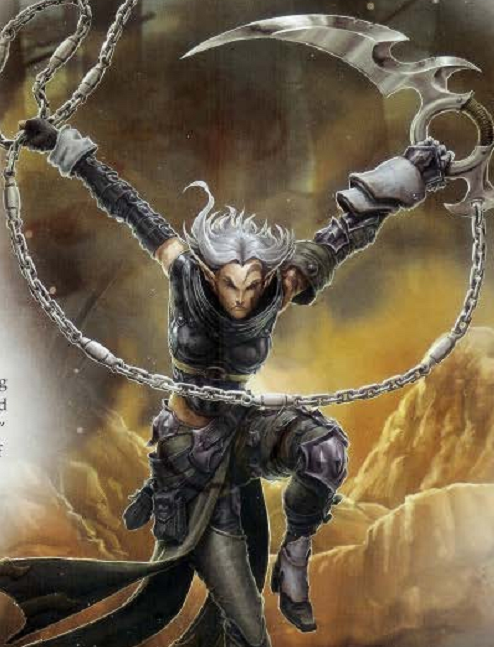
Mage Hunter Assassins are practiced killers, able to bring down even warcasters. They descend from an ancient cult brought in by the Retribution, a group of warrior-monks who mastered the fighting form of klyvenesh, the striking serpent, which served Lyliss. The Consulate Court had once used them as government assassins. The cult vanished along with the city Shaelvas, but its practices were carried on by those who would join the Retribution. They became a small, specialized offshoot of the mage hunters who kept to their old martial traditions. They are insular and highly proud of their skills. Recruitment is slow - chain blades are tricky weapons and take exceptional reflexes to not kill yourself with, but a skilled assassin can send one a huge distance in an instant, and be ready for close quarters in the next.
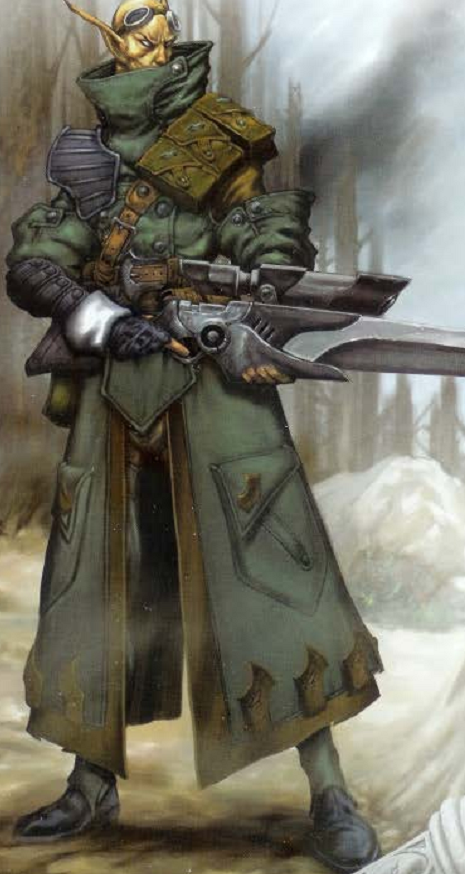
Ostensibly, Ghost Snipers are a specialized patrol soldier, but they have an ominous reputation with the Homeguard Coalition and the citizens of Ios, who say they are sometimes used to eliminate 'dangerous' Iosans. Many nobles would be horrified to learn that a sizable number have joined the Retribution. They are not an organization, so much as a group of people focused on the same skills and tasks. Snipers of lower houses take on this role to sell their services to the military, and many nobles can call on ghosts for escort protection or to assign them certain tasks. It's not uncommong for them to supplement regular military forces as fire support, either - occasionally in secret. When Houses Nyarr and Shyeel joined the Retribution, a number of ghost snipers offered their services, either already symphathetic or just seeking profit and a chance to use their skills on some humans.
Next time: Named characters.
Forces of Warmachine: Retribution of Scyrah
Original SA post Forces of Warmachine: Retribution of Scyrah
Eiryss, Mage Hunter of Ios , is still a mercenary who'll work for Cygnar, Khador and the Protectorate, but when she works for the Retribution she counts as one of them. She is unusual in that she has been able to stomach working with outsiders for decades now, selling her services to the people she is going to kill. She wins their trust and betrays them later, earning her both respect and confusion from her Retribution peers. Keldeacon Synvas Uithuyr first recognized Eiryss as unusually talented when he was training her, seeing that she had a very strong will. She quickly outpaced her teammates on her first covert assignment, achieving mission objectives alone or despite their blunders. In time, she gained the attention of Narn, who took her under his wing as an assassin trainee. She proved worthy and, after several years, found the limits of operating traditionally. She was good at killing people, but the traditional operations failed to gain access to information on high-priority targets, like military arcanists and warcasters. She had to infiltrate. She committed herself to work as a mercenary, and it's proven highly effective, amazing even the Nine Voices with her genius for assassinating people without alienating clients. It's been a tightrope, but she's walked it well, working alone and only briefly contacting Retribution cells with information. The intelligence she has sent has been key to otherwise impossible missions, and she very carefully manages her activities so that she is not suspected in those events. Both Khador and Cygnar often fail to keep detailed records of mercenary hires, which she uses to her advantage. She has a lot of information on warcasters and ranking human officers, helping the Retribution create a comprehensive picture of their foes, which they intend to use liberally now.
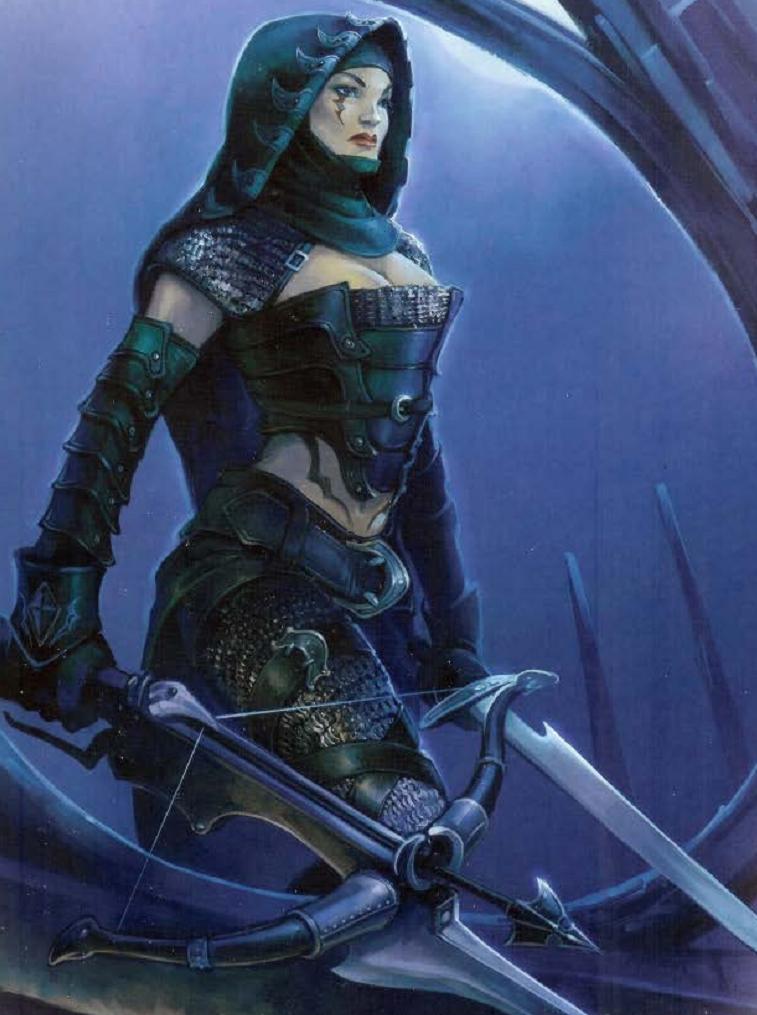
Eiryss, Angel of Retribution , is the first epic character we've seen. Basically, as the storyline advances, characters get new versions released, 'epic' in that they are from further in the storyline. They tend to be of about equal raw power as their old versions. Eiryss will still work for Cygnar, Khador or the Protectorate, or as a full Retribution unit. She has kept her hatred of humanity buried for years, and while her methods were never embraced by the Retribution, she was seen as a kind of legendary angel of wrath embodying their goals. She became something more when she confirmed Nyssor's survival in Korsk. She fought the eldritch Goreshade, though she now admits that chasing Goreshade was reckless, though he was a fool to let her live. He had felt compelled to explain his actions, to convince her they shared ap urpose. In doing so, he had revealed his plan to murder both Nyssor and Scyrah as part of a mad scheme to restore Ios' spiritual balance. Eiryss ignored her wounds to return to Nyssor, only to witness his frozen vault being stolen by Khadoran Greylords. She was too inured to chase them, but returned to Ios to relate what had happened, stirring the Retribution to full war readiness. She sees herself as just another soldier doing what must be done, but has become a rallying point for the Retribution and a legend among new recruits. She ignores their adoration to focus on her continuing crusade, fighting for Scyrah and murdering human wizards. The movements of the Retribution mean her usual tactics are riskier now, and she's convinced she's on borrowed time, but that just means she has to work harder. So long as Goreshade and human wizards live, she cannot rest. Eiryss believes her role abroad is just as vital now as ever, and has resumed her work, gathering intelligence that no one else can. This version of Eiryss is more focused on sniping and countermagic but is not significantly different than the older Eiryss.
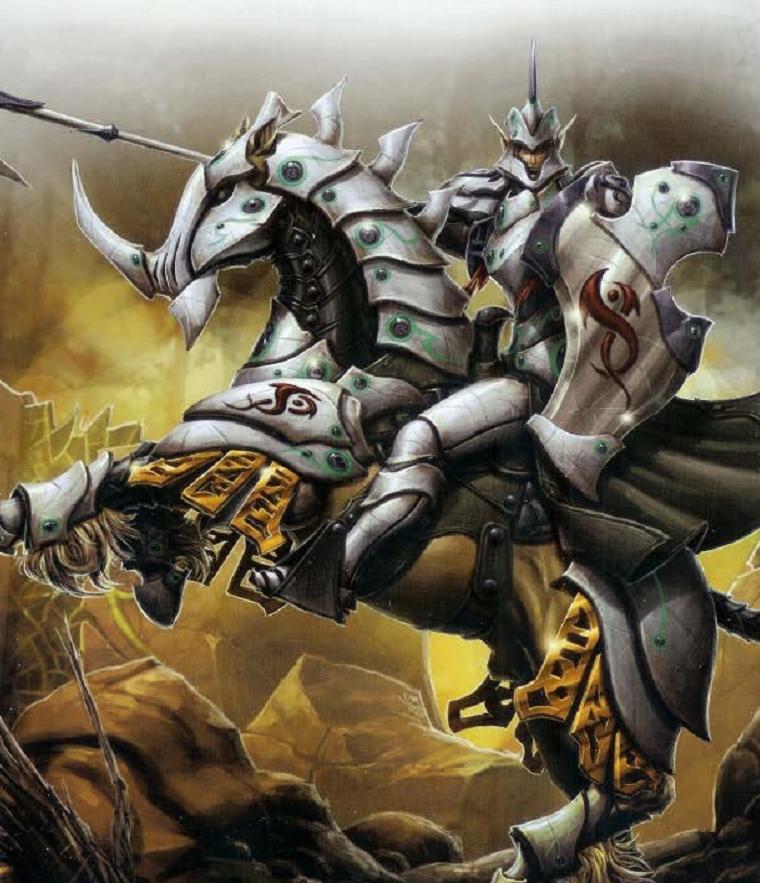
Fane Knight Skeryth Issyen is one of many Fane Knights, soldiers who have pledged their lives to defending Scyrah to the last heartbeat. He was her personal guard for a long time, and each day, he felt powerless to help her, eventually turning to the Retribution for answers. He is a blood noble of one of the Five Great Military Houses, but like all Fane Knights he forsook his family ties entirely. The reasons are not well known, but are rooted in secrets of the War of the Houses, when he was young. During that time, he learned that his house's lords were involved in terrible concessions to House Vyre, ensuring their own position even if Vyre won the civil war in return for resources and neutrality in the conflict. Skeryth left House Issyen as soon as he learned of the depravities committed by High Consul Ghyrrshyld Vyre, and while he has not spoken out against them, he immediately chosen to join the knighthood of Scyrah, proving himself despite his youth. He found a new home there, and has spent most of the last 25 years serving the fane, first in Iryss and then Shyrr. Three years ago he was made Scyrah's personal guard, the highest of honors. The longer he spent in the Presence, the deeper his frustration grew, and he began to realize the vigil was futile, that he needed a more active way to help. He was receptive when Ravyn, the Eternal Light, approached him to request he join the Retribution. He had served under her before, briefly, and she persuaded him with his own doubts. Unwilling to fully abandon his order, he's still a Fane Knight, and he's convinced his superiors to let him march with the Retribution as an observor. His ppers don't know why he'd give up such a good post, but they haven't sotpped him. He has no intention of just observing, however. He wants to fight, and hopes that the Retribution's claims are correct, that he finally has an enemy that he can direct his anger at. It has rekindled a hope he thought had been lost. He knows he may never see Scyrah again, but it's all worth it if he can heal her. His life has been prepration for battle, but he's never personally witnessed war. Whether he can be capable of ruthlessness or not is unproven, and the years ahead will be a trial for both his piety and his honor.
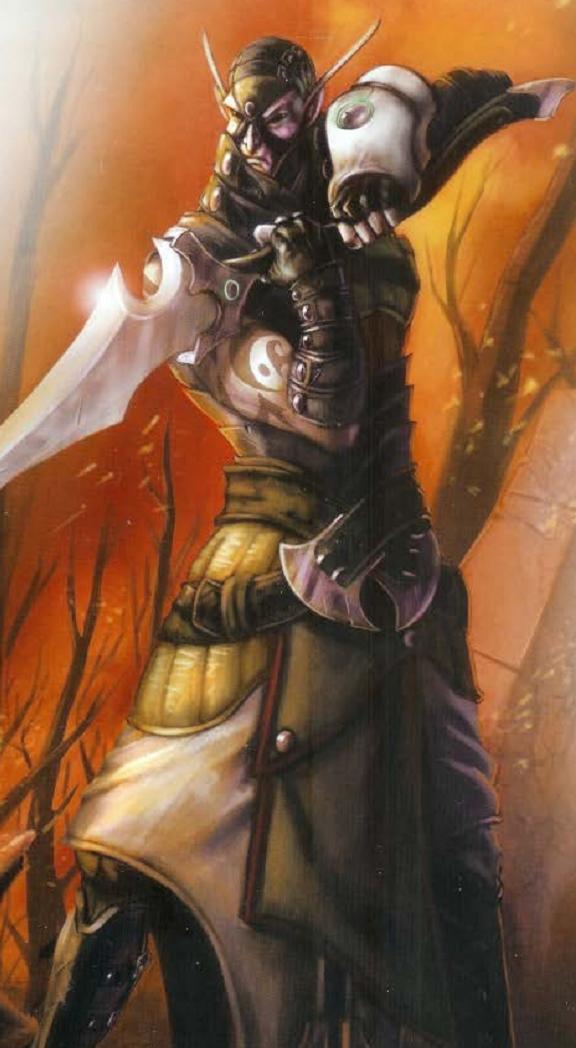
Nayl is soulless, living only because the Retribution saved him as an infant. He is an uncomfortable reminder of the doom awaiting the Iosans, and in due time, he will die, and no one will mourn. None of that bothers him. He has no emotions - no loneliness, no anger, ho happiness. He knows nothing about his parents, and his only family has been his Retribution handlers. He is eerily calm at all times, and he has solid black eyes, like all soulless. On the few occasions he tries to mimic normal facial expression, it's mostly unsettling, since it never reaches his eyes. His posture and gestures are all rehearsed, but he is an individual. He has cunning, a certain curiosity and a small need to please his superiors. It's a recognizable if weak personality. He is a particular success of his trainers - he is adaptable, unlike most other soulless, able to follow orders to the spirit rather than just the letter. He's almost enthusiastic about sowrdsmanship, communciating better with a blade than his words. He is a living weapon, without pride in his actions but some deeper drive that forces him to hone his skill. He spends hours practicing in silence, sparring against other mage hunters but never tiring. He is an arcane vortex, having undergone extensive mental conditioning that means his death in battle will produce an unstoppable vacuum of magical power. His death was expected years ago, and it's only his skills that have kept him from fulfilling this ultimate function, so he is now used as a killing machine. He is frequently utilized by Garryth, Blade of Retribution, though not out of friendship. Garryth is just more tolerant of Nayl than most people. He completes all tasks with reliably deadly efficiency, awaiting the day he is given the order that will kill him. He obeys complex codes of behavior that were instilled in him by the Retribution since his childhood, protecting Iosans and killing their enemies. He shows no preference for either of these tasks over the other.
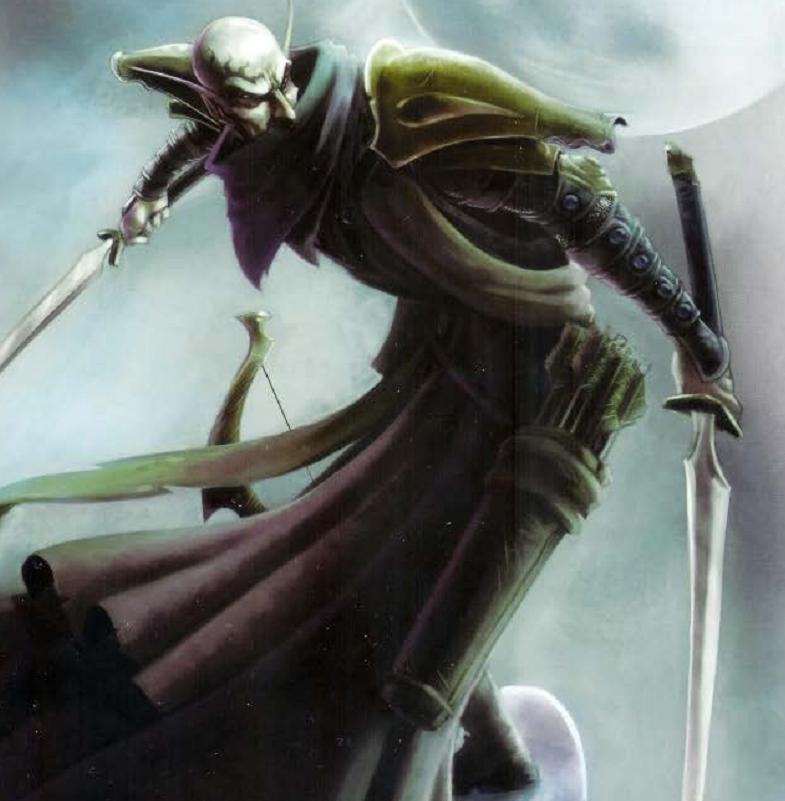
Narn, Mage Hunter of Ios , is unknown outside the Retribution and a legend within it. He is a blindingly fast blademaster and a graceful killer, one of the eldest active mage hunters who has killed more than anyone except, possibly, his disciple Eiryss. He has trained quite a lot of mage hunters, actually, but he's never taught at Syvash Stronghold. He doesn't think of himself as a trainer and he has little patience for the uninitiated. Rather, he steps in to help those who already have exceptional skill, breaking them of their bad habits and molding them, often harshly, into efficient killers. He has a lot of flexibility in his choice of jobs, and he prefers to work alone. He is a good commander but doesn't like having direct oversight. No one would refuse his aid, and his arrival is both welcome and ominous. When he helps in broader operations, it means what's going on is hugely important, and he always arrives just where he is most needed, often turning a botched kill into a success. He has traveled throughout the Iron Kingdoms, but prefers to operate in the parts of Cygnar and Llael nearest the Iosan border, where he currnetly hunts both Greylords and Llaelese Resistance mages. He has been assisting in the planned recovery of Nyssor. Even those trained by him describe him as quiet and elusive, speaking as little as possible and preferring to communicate by gesture and expression. If age has dulled him, no one has been able to tell. He can spring into attack without warning, and Eiryss is one of the few with whom he shares any of his thoughts, though she's never revealed them to others. Both are solitary by nature, but can occasionally be seen working together, silent and deadly.
The End.
So, what's next? Hordes core, Protectorate of Menoth, Cygnar, Khador, Cryx, Mercenaries or Convergence of Cyriss?
Hordes Mk. II Primal
Original SA post Hordes Mk. II Primal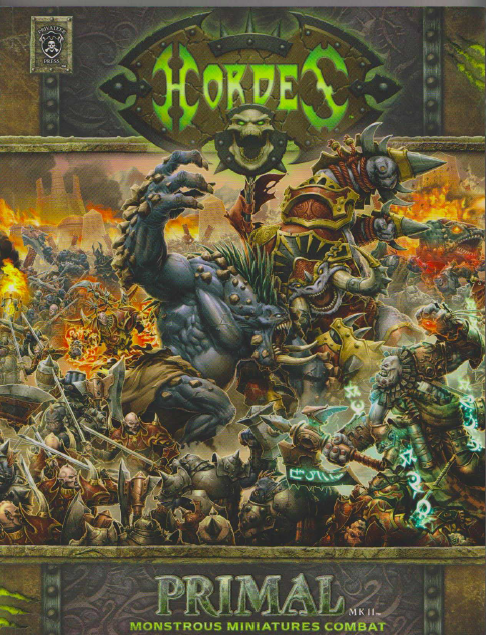
Hordes is the counterpart to Warmachine, but focusing on groups that aren't really organized, nations or even for the most part human. Instead of warcasters, it has warlocks - similar, but generally with fewer spells and abilities - and instead of warjacks it has warbeasts. Warbeasts are alive, and so they tend to be more responsive and faster than 'jacks, they don't s hut down when not taken care of (instead, they tend to go berserk) and they grant magical powers to their warlocks. However, they are often squisher, and they have fewer things that can break when they get hurt - which means the things that do break tend to break worse. Overall, warlocks aren't quite as good as warcasters, but warbeasts are generally a little better than warjacks. On average, that is. There are exceptions to everything.

Our general history is this time written by Asheth Magnus, better known as Magnus the Traitor, a Cygnaran general who remained loyal to Vinter Raelthorne IV during the coup. He writes about how fragile civilization truly is. He believes change is coming, a new era. It was only four centuries ago that the Orgoth were driven from the lands of men, and it would not be hard for them to be conquered again. Little is known of the land across the Meredius from which the Orgoth came in their longships. The ancestors of humanity were not prepared for them, that much is certain. It was two centuries before their conquest ended, but it was complete.
They changed everything, enslaving western Immoren with dark magic, but some of the tribal groups evaded them because they preferred cities. They still subjugated trollkin kriels and claimed sites of power from the blackclad, razing them and defiling them with dark temples meant to contain the souls of thousands. However, those that survived the Orgoth became strong for it. The Rebellion was sparked by four centuries of occupation, a 200-year campaign of reprisal. Many will take credit for it, but the truth is, it required the combined efforts of every nation, every cult, every dark god. By the end, mechanika had been invented, and new, potent weapons: guns and battle sorcery. The Council of Ten signed the Corvis Treaties and ushered in what they hoped would be an age of peace.
But men are men, and peace cannot last. They were just better armed now, those four nations we call the Iron Kingdoms, and the Protectorate that would join their number later. The proof of this can be seen in Khador, where battle is loved over all things. They descend from dozens of tribes, brought together as one nation with a thirst for empire. They are a proud and noble people, unashamed of what they are and not so primitive as people sometimes say. They are quite modern now, and quite potent.
Then there is Ord, a rugged land of sailors and soldiers, smugglers and pirates. A fine place if you aren't poor or a marsh hillbilly, and a haven for mercenaries. It has largely avoided involvement in modern war, and it lacks in resources but is rich in shrewd tactics, particularly defensively. No one really wants to risk the damage they'll take conquering it. Its king, Baird Cathor II, is known as the Bandit King for his taxes levied against the rich, but the poor love him. He is a cunning man.
Once, there was Llael, but it was devoured by Khador. It relied too strongly on its Cygnar alliance, and it was always the smallest and weakest kingdom. The trouble is, you see, they had no king - their last died, and no new one was chosen. Without a strong king, how can a nation stand? Once, Cygnar knew that, but it has always been complacent, too willing to sit back and return to peace. Worse, it has always been too willing to let the Church of Morrow meddle in politics. The worst of that was in 594 AR, when the ambitious usurper Leto stole the throne of his brother, the rightful King Vinter. Leto is shrewd, to be sure, and a decent king in peacetime, but he lacks the strength to lead in wartime.
Worse yet is the Protectorate of Menoth, literally run by the Church of Menoth after the Cygnaran Civil War. The Cygnarans let that end in peace, rather than crushing it utterly. Leto had tried to bring lasting peace, but what peace can be had with zealots? They took advantage of it, and where the Morrowans are too forgiving, the Menites are harsh and brutal, an uncompromising church of tyrants.
But it is easy to forget that men are not all there is out there. The Rhul live east of Khador, dwarves of the mountains. They are very like to humanity, and increasingly are becoming involved in human struggles. Once, they were aloof and distant, but are now a common sight, and it was they who helped invent the colossals that led to warjacks. South of them are the Iosan elves, of whom little is known. They are withdrawn from the world, and have been for decades, which is rather worrying, especially as violent elves have secretively trickled out. They plan something, be sure of that.
Then there's the Nightmare Empire of Cryx, ruled over by the dragon Toruk, who wields necromantic power like a sword. The lich lords and Toruk are all immortal and immensely potent. Only the dead can handle Toruk's presence, so dark a force is he. He is god to his people as well as tyrant, and his priests are twisted and warped by his nature. You can deal with Cryx, but you can never trust them. They could have been destroyed long ago, had people not ignored them, complacent in the idea that they were no problem.
Few understand the pragmatic truth - that peace is just a time to rearm and prepare - like the trollkin kriels. They have always been forced into the harshest lands, away from fertility and peace. Humans have forgotten the trollkin, as they have forgotten so many conquered peoples. They are not, however, the primitive savages that people claim. They are organized, courageous and able to endure hardships that would leave men crushed and broken. They are as smart and adaptable as any human, and they are angry . Many overlook the Trollkin Wars of three centuries back, when the kriels faced the colossals and won. The kriels remain, and they are stronger than ever. They are reluctant, perhaps, to challenge the kingdoms of men outright, but if men are distracted fighting each other...well, that is another thing entirely. In a time of war, a 'minor uprising' can alter the course of history, and the kriels of today will not be easily bribed into silence.
Never doubt, also, that cabals of manipulators are out there. They are. Religions on the fringes, neither Menite nor Morrowan. Many blame Thamrites for various disparate events. More frightening, though, are the worshippers of Cyriss, the Maiden of Gears, who have infiltrated the educated of many cities, who are capable of longterm plans. However, both of these cults still believe in the strength of humanity and prefer to stay out of human wars.
The ancient gods are different. A shaman of Dhunia protecting their tribe is like a bear defending her cubs, and it is the shamans who truly command the trollkin. More dangerous still are the cannibal warriors of the Devourer Wurm, a god of chaos and destruction whose cult was believed long destroyed. It is not. Fear also the blackclads, druids who draw on the powers of chaos and revere an untamable god, but who follow a strict hierarchy. They have always watched from the shadows, and now they step forth, and the Devourer cults obey them. Their agenda is strange and opaque, but they must not be underestimated. They can wield nature itself against you by magic no man could comprehend, with no resemblance to the ordered sorcery of humanity. It is something older, more primal.
Among both druids and trollkin are warrior-mages, called warlocks, who can draw on the fury and strength of beasts. This is so potent it could even stand against modern warjacks and mechanika. It's said that the druids have been cultivating this talent, the wilding, since the days of the ancient Menite priest-kings. What powers could they unleash? And Toruk is the only dragon out there to worry about, either. It is said he once divided his athanc, the heartstone of his essence, but that the dragons he made turned on him. One of them escaped to the far north, and it seems that dragon has followed his father's example, creating his own nation of servants. It is unclear what this dragon army wants, but reports of blighted soldiers and great reptilian beasts made of dragon blood have been reported across Immoren.
And last? Vinter Raelthorne IV has, praise his name, returned. He escaped the coup and made himself into an avatar of conquest, mastering the race called the skorne and forging them into an empire. The arrival of the skorne army is a testament to his will and to theirs, for they crossed the Stormlands themselves and the Abyss that splits Immoren, following the commands of Raelthorne. They have brought with them their bestial slave-warriors and many soldiers, eager to conquer the fertile lands of men. They bring change. Vinter the Exile has raised a nightmare army to enslave humanity, and this is good. Their cruelty will be the only hope for human survival, and it is only in their chains that men will find the strength to grasp their destiny. They will bring strength in war, as the Orgoth did, and whoever wins will shape the future. The storm is coming.
Next time: HOOOORDE
Hordes Mk. II Primal
Original SA post Hordes Mk. II PrimalThere are four main factions in Hordes. The Trollbloods are the culture of scattered trollkin kriels, related to the larger and dumber trolls and dire trolls, whom they call on for protection. For centuries, their sacred lands have been stolen, and now they go to war over it. They are exceptionally tough and hard to kill, plus very strong. The Circle Orboros are an ancient order of druids dedicated to claiming places of power and resisting dark forces such as the dragons, but that means taking places other people own to empower their fight. They are quick and elusive in battle, using terrain heavily. The Skorne are a civilization of eastern Immoren, dedicated to subjugating the west. They believe in strength through pain and trial, and they are ruthlessly cruel. The Legion of Everblight serves the dragon Everblight, who chose not to reform his body but instead to instill himself into his commanders, granting them unity of purpose, and to make monsters out of his own blood that they might be totally obedient. They are diverse and dangerous. And the Minions? They're the Hordes equivalent of mercenaries.

Our author is Elder Gosarn of Klamat Kriel. The trollkin have long been scattered and seperated, but now they must unite. Even now, armies tear apart troll homes like the Thornwood, destroying the kriels of the trollkin that live there. Now, Madrak Ironhide gathers the trollbloods to unite as one, to take back what is rightfully theirs. Thousands of years ago, Immoren was terrorized by the ancient Molgur - the word shared by the tribes of humans, ogrun, goblins and trollkin. Together, they were a vast empire. There had never been anything like the Molgur, and never will be again. All shared in cruelty and malice, feasting on the darkness and sacrificing foes to the Devourer Wurm, who sired all races in the dawn of time by ravaging the divine mother Dhunia. All life arose from violence, and it is in the nature of the living.
Some say the time of the Molgur was a golden age. It was not - it was savage. All fought as one blood, but they forsook Dhunia, and there was only ruin. However, there must be a balance - civilization must be mixed with chaos, for too much civilization makes you weak, an orphan among humans. Be united, instead, under Dhunia. But still, the Molgur left one gift: Molgur-Trul, the language of the kriels, whose only writing is runic, meant to immortalize heroes and not keep records. A kriel, then, is both the tribe and the place where they live. Kith is both your home and your blood-kin. Shen is your brotherhood, but also the lustful dangers of youth. Quitari is the pattern of woven cloth linked to a community. And the Tohmaak Mahkeiri is the Glimpse of the Mind, which lets trollbloods look into the minds of their kin. In this, Molgur-Trul is superior to human tongues.
The Molgur taught all that mindless chaos could not be good, though humans needed the god Menoth to explain this to them. Never forget how brutally the Menite king Golivant slaughtered trollkin. Humans he let convert, but he put Dhunia's children to the sword. The greatest Molgur chief of the time was the trollkin Horfar Grimmr, who led a doomed attack on the wall called the Shield of Thrace, fighting a battle that made rivers run red for weeks, but he lost and was captured. Even under torture, he said nothing to the Menites, and with him, the Molgur died. The Menites enslaved entire tribes of trollkin, working them to death before sacrificing any survivors to Menoth. This must never be forgotten. The surviving trollkin fled - to the Scharde islands, to the Wyrmwall, to the Gnarls and Thornwood and Scarsfell. These forests became the home of the kriels.
The trollkin began to return to Dhunia, carving their rites into the krielstones to record the deeds of heroes and the words of elders. This continues to this day. The shamans established and explored the trollkin ties to the full-blooded trolls. Some had tried to deny this bond, insisting that trollkin were superior for their sharper minds and language. And it is true that only trollkin have culture, but trolls have bonds of blood. The truth was found by the shamans of Dhunia, and the trolls came to live alongside the kriels, helping to build and to fight. They are simpler, yes, but they are strong, brave and loyal, helping to protect the kriels against the Menites and the Molgur remnant. Each kriel now looked to its own interests above all, and battles between them were common. This strengthened the people, for they have ever loved battle.
Humans measure time before and after the Orgoth. The Orgoth left their mark on the trollkin, too, but not so deeply. They were just another tribe of humans from across the ocean, and they felt little need to invade trollkin lands, save to make roads. And then, the trollkin fought, making them pay dearly for every inch, for every site they desecrated. The trolls were vital in this, and it was only with their aid and that of the blackclads that the Orgoth were driven back from the wild places. This was, of course, before the blackclads' betrayal. Of course, the escape from the Orgoth was not total. The Orgoth enslaved many trollkin for their stamina, using them to build forts and temples, foul places that still stand only because of the strength of the trollkin who made them. Even the colossals could not destroy them.
Some heroes are remembered even by humanity. Grindar of Tolok Kriel helped lead the Rebellion against the Orgoth, and he sat on the Council of Ten. You can see him in statues in Cygnar. However, his time among humans clouded his judgment, though he did work to help his people. He forced them to give the trollkin land, but few of those promises were kept. Humans always deny oaths when it is in their favor. Sending elders to them did not help - they were told they should thank the humans for not taxing them. And Grindar did nothing. Just forty years later, the elders had enough.
Cygnar thought the trollkin primitive and weak. They did not understand the bond of trolls. Some kriels had become too 'civilized,' but when the human soldiers came, their blood remembered the bond. The trolls were welcomed into the Gnarls and Thornwood, and they came together as an army, with no need to hunt prey and so all the time to train. These trollkin and trolls attacked the Cygnaran and Ordic forces, and any victory of Cygnar was won only by numbers. The trollkin never lost even at two to one odds - it took three to one or more. At last, they unleashed their colossals, and while today the trollkin fight warjacks, they had never before seen anything like those things then. They were slow and clumsy, but unstoppable. It was a bitter defeat, and the trollkin were forced to sue for peace. But at least the Colossal War drained Cygnaran resources. Not long after, the trollkin gathered again. The Cygnarans say it was the Second Trollkin War, but they are wrong. The first had never ended.
Chief Modr led his kin and the trolls, and he won because he did not allow the colossals to pick their battlefields. He led them to traps and ambushes, showing that ravines and pits would destroy them with their own weight. They were led onto bad ground and destroyed piece by piece, swarmed by troll and trollkin alike. Fear of the colossals was forgotten when the first fell. The colossals passed into the dust of history. The humans made the smaller warjacks to fight better, but still they are not enough. A troll is more cunning, ruthless and fearless. A 'jack is heavy, slow and relies on coal and water. A troll can swim by night, return from the brink of death by eating the slain. Borrow useful technology, sure - rifles, say. But do not doubt that others are but tricks, defeatable with strength and cunning. By the end of Modr's war, Cygnar acceded to all demands, and the promises of the Corvis Treaties were renewed. But still, men did not see the trollkin as equals, and the promises were not kept for long.
Many shen traveled to human cities, helping to rebuild and settle. They forgot their language and their ways. Now, they must be brought back to the fold. The lore they have learned can be useful, and the trollkin need every weapon. Every human war has brought hardship for trollkin. The Thornwood War saw Cygnar trick Khador into marching into the oldest and largest trollkin community, Tolok Kriel. They cared nothing for the innocents that died there, despite all of Cygnar's oaths. Tolok Kriel is fallen now, ravaged by Khador, for all they did to kill the humans in return. To them, trollkin are just animals. The kin of the Gnarls have long known this, but Thornwood had forgotten. They had become complacent, until the Cygnarans betrayed them.
Madrak Ironhide had been friend to King Leto, long before Leto took the Cygnaran crown. They had sworn an oath of brotherhood, and Leto was welcomed to Ironhide's kriel, not believing it meant nothing to the human. In times of peace, they shared gifts. But when the blood came to the Thornwood, Leto was silent. When war broke out between Khador and Cygnar, Leto used the trollkin. Khador blazed a trail through the Thornwood, and the Cryxians despoiled it. Even the Protectorate of Menoth got involved, seeking to burn the woods, and the trolls all caught in the middle. They care nothing for the trollkin! But Madrak went to his blood-brother for aid. He counted on friendship, and at first, it seemed to work. Cygnar's king eased the use of the Thornwood, instead using the Glimmerwood and Widower's Wood, regions unclaimed by kriels. He gave Ironhide supplies - blasting powder, guns, metal. But this was not kindness: it put Ironhide's people in harm's way. Leto asked Ironhide to protect Cygnar's border from the Menites, knowing that another threat was coming from the east: the skorne that had attacked Corvis but three years before. The king lied, promising lands within Cygnar to his blood-brother.
The skorne swept in to kill everyone they saw. They came for human lands, but it was the kriels that perished in their wake, first at Scarleforth Lake, once home of Grissel Bloodsong and her kriel. Then the Glimmerwood, where they faced Madrak Ironhide and his people. At last they were forced to seek another path, but only after they killed many trollkin. Having paid his blood debt, Madrak went to Leto to get a home for his kriels, but Leto refused him, out of the greed of his nobles. He asked Ironhide to wait, hoping to use him again. Ironhide, still believing his blood-brother loyal, agreed one final time. But on his return, one of his own betrayed him for power. The blackclads, once allies, had tempted this champion because Madrak was too strong-willed to be controlled. They wanted the trollkin to fight for them, much as Cygnar had. It might have worked, were it not for the work of the great Shaman of the Gnarls, Hoarluk Doomshaper. Ironhide and Doomshaper fought together, killing one of the blackclad assassins, the druid Ergonus. Now, the trollkin must reclaim the lands the blackclads have taken over the centuries, for they have proved to be traitors.
This was the first great moment of trollkin unity in this age, the first joining of the people. Doomshaper and his kin joined Ironhide and the Thornwood trollkin to face the druids, and Doomshaper brought with him the dire trolls, the greatest of the true trolls. Now, they too stand with the trollkin, giving the raw might needed to defeat their foes. Ironhide and Doomshaper are the war leaders, and the elders must support them. Already, Ironhide gathers allies like the great Borka Kegslayer of the Scarsfell, and all trollkin communities are of one blood. Ironhide led the people to Crael Valley, defeating any Cygnarans in his way. This farmland was suitable - rich, defensible. For a year, fortifications were built, and it was thought Cygnar might allow it, for it was only what was promised.
However, the humans came and captured Doomshaper. Ironhide freed him, but Crael Valley wsa besieged. The trolls fought hard, but they were forced to flee west, to the Gnarls, despite Grissel Bloodsong's heroic battles. They are still in 'Cygnaran' lands, and the battles are not over. There will only be peace if the trollkin can negotiate from strength. Crael Valley cost the humans greatly. They have seen the strength of the trollkin, and it must be shown that they will not go away. A home must be taken, by war and blood and stone. It is not impossible. There is strength in troll blood, and Dhunia stands with the trollkin, and so it must be done!
Next time: Trolls in the dungeons.
Hordes Mk. II Primal
Original SA post Hordes Mk. II Primal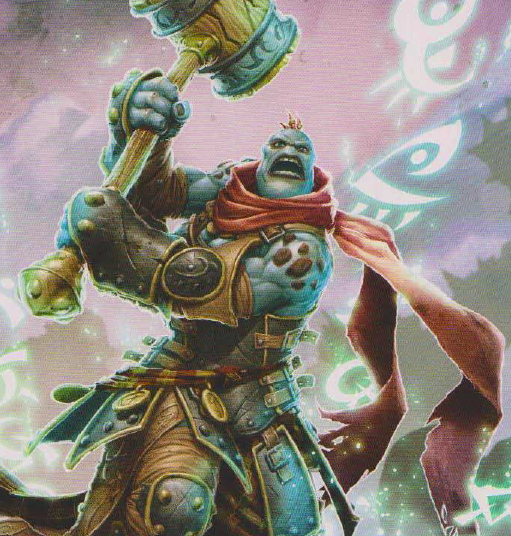
Grissel Bloodsong is one of the finest fell callers in the world. She was born far north, near Ohk, but she was born to wander. She sailed the western coast for years, fighting pirates and Cryxian raiders. She was a mercenary, but she hated the cities, loving only the sea. Eventually, she lost patience with humans and went to the Black River, where she fought river bandits. After visiting Ternon Crag, she met the trollkin Turgol Redeye, who fell in love with her. She rebuffed him, but he would not stop, and eventually they tore a tavern apart in a brawl...which still didn't stop his love. He slowly earned her affection, and the two headed for the kriels of Scarleforth Lake. One day, however, some skorne raiders attacked. Turgol went to fight three cyclopes who had gone for some kids, and while brave, he was not invulnerable. Before Grissel could help him, he died. She went into a blood rage and unleashed her voice, blasting them with her rage. Turgol's death changed Grissel, and she began a one-trollkin war against the skorne, becoming a hero to the Scarleforth trollkin. Her very presence emboldens those around her. Meeting with Madrak Ironhide has renewed her hopes for her people, and she has sent her people to join Madrak, knowing they must unite against the threats outside. Now, she fights not for coin, but to preserve her kin. This purpose has let her endure her broken heart from her mate's death, which she still feels keenly when not fighting. Her gimmick is buffs, both by spells and her Fell Calls, which can buff her allies or debuff enemies each turn. Her feat allows her to essentially use all her buffing calls at once.
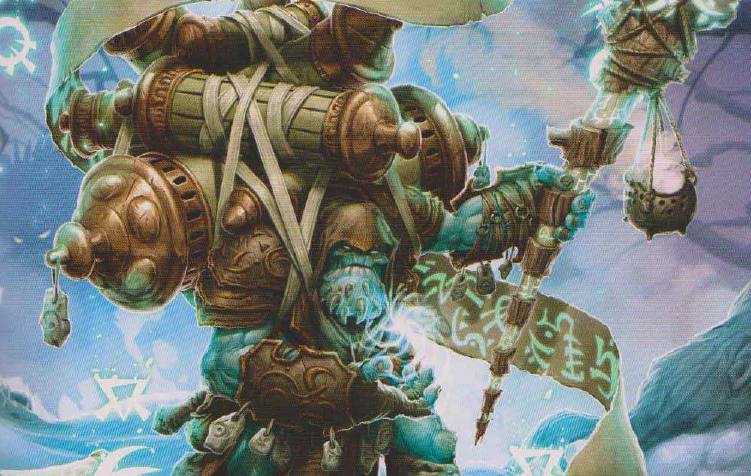
Hoarluk Doomshaper is a legend, having been around for over a century. He is one of the most vigorous elders out there, obsessively fascinated by the mystic power of the blood that connects all troll breeds. He believes it is superior to the blood of all other races, and it doesn't help that humans have been real jerks lately to the trollkin. He doesn't like humans at all, really. He intends to get his vengeance on them for their taking troll land. Few will speak out against the Doomshaper, who is prone to temperamental outbursts and scathing insults. He's dueled countless elders and has yet to lose, humiliating those who go up against him. Many think him insane, and even his detractors say that Dhunia chose him so she wouldn't have to deal with his wrath. His life has been spent urging trollkin to resist human encroachment in the Gnarls. He has an unequalled power over full-blood trolls, and all troll breeds listen to him as if he were kin. The ancient bloodstones he carries renews the ancient pacts between species, and he earned his legendary status when he went, unarmed, into a forest and returned with several dire trolls at his side. They had not obeyed trollkin commands since the time of the Molgur, and word spread to every kriel. The dire trolls have since become the greatest weapon of the trollkin. Even before the recent troubles, Hoarluk went from kriel to kriel urging battle against humans or anyone else foolish enough to plunder the Gnarls. He's destroyed at least two logging camps and no fewer than three bogrin tribes that settled near his home, which has sometimes put him at odds with more moderate leaders like Chief Ironhide. Hoarluk is not a chief, but has immense influence over the Gnarls tribes, the mightiest remaining bastion of troll tradition. He has spent decades recovering lost runes and krielstones, and he carries all his lore on his shoulders. His knowledge has unlocked many powers, and he has reasoned that trolls are Dhunia's wrath given form, and this is the age of their stand. Every battle is an apocalypse, with a result of trollkin salvation if he wins. His gimmick is buffing his allies, particularly his warbeasts, and cursing enemy warbeasts. His feat allows him to damage enemies by calling on Dhunia's power, hurting them for any magic they use.
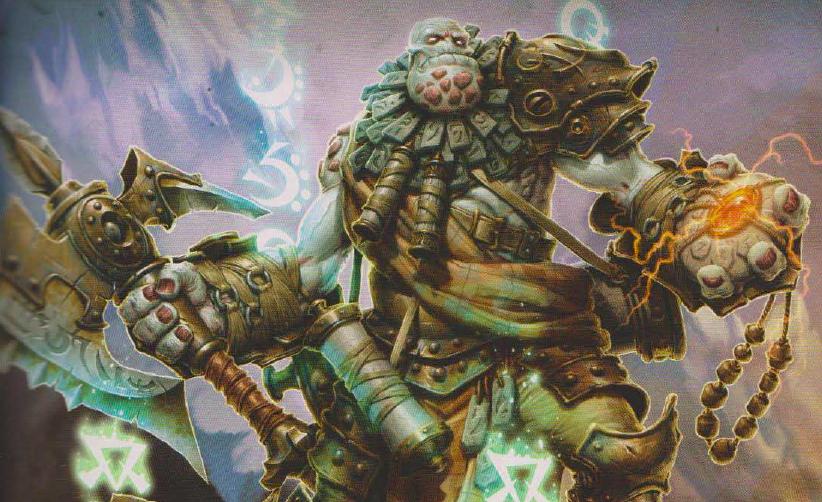
Madrak Ironhide, Thornwood Chieftain has proven to be a great leader. Leadership in peace is easy, but Madrak has been through many trials, ill omens and setbacks. He was born an albino sorcerer, but earned renown on the kuor dueling platform against his peers, as well as exploring the dangerous Thornwood until, one day, a band of Tharn ambushed him. Outnumbered, he drew his weapon and fought, but ended up saved by lightning from a young Cygnaran. He brought the boy back to his kriel and performed the kulgat, making them lifelong blood-brothers. That youth would become King Leto of Cygnar. More recently, Madrak's land was engulfed in war, and he began to invite in refugees, soon finding himself leading a staggering number of kriels. When a Cryxian army came, Madrak became desperate. He took a pilgrimage to a special kuor housing the axe Rathrok, the World Ender, once wielded by Horfar Grimmr of the Molgur. Legend said that wielding such a potent weapon would herald the end of days and unleash the Devourer Wurm, but the other choice was the annihilation of his people. Ironhide took the weapon, but even with it, the trollkin lost ground. Desperately, Madrak sought aid from Leto, negotiating what he thought would be salvation. The kriels got a temporary home...but it put them right in the path of the skorne. When Madrak demanded safer lands from Leto, Leto made excuses about being beholden to his nobles. Madrak went home emptyhanded, and then was almost assassinated by his longtime allies, the blackclad druids, aided by one of his kin turned traitor. Only the intervention of Hoarluk Doomshaper saved his life. Madrak swore to join Doomshaper in carving out a safe place for the kriels, even if it meant a river of blood or the curse of World Ender.
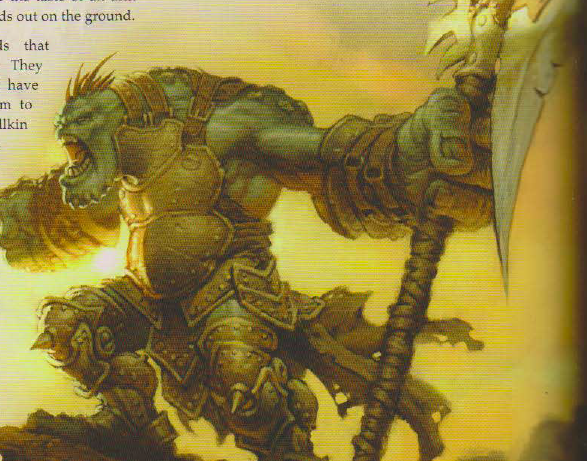
Troll Axers are immense monsters, able to cleave a wall in two with their giant axes, often while chewing on the limbs of the defenders. Trolls are immense humanoids that tower over even the largest trollkin. They are smarter than most realize, with a simple language of their own that allows them to work in groups. Trollkin have extensively used troll axers to bolster their lines, and just a few can change the tide of a battle. They terrify the enemy, cutting huge swathes through them. Trollkin train the trolls in discipline and give them the iron axes they use - trolls can make crude improvised weapons, but nothing like this. The agreement between trollkin and trolls dates back to just after the Molgur, when the trollkin made pacts with the trolls in order to harness their barely controlled destructive urges. Trolls are all immensely difficult to kill, axers included, due to their innate regeneration. The troll axer animus blesses allied warbeasts with movement boosts.
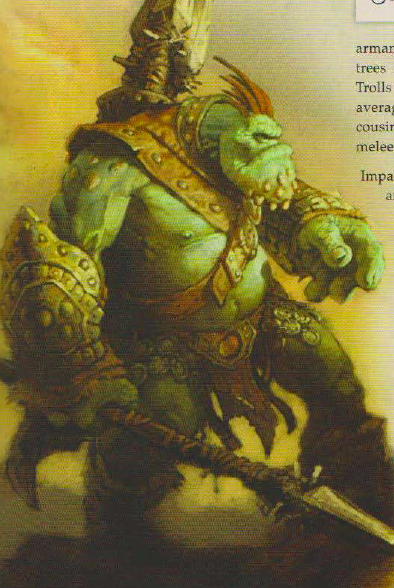
Troll Impalers wield enormous spears, hurling them with bone-crushing force. They're essentially living ballistae, and really they wield sharpened logs and iron bars. They are of the same species as the axers, distinguished mainly by training and armaments. In ancient times, they would hurl small trees. Troll impalers tend to have better hand-eye coordination, but they're just as deadly in close range with those 'spears.' Like all trolls, they have potent regenerative abilities and ravenous appetites. Trollkin try to keep them well fed, to discourage eating allies in the chaos of battle and to maintain the integrity of funereal rites for dead kin. It doesn't always work, though, especially when the troll's particularly hurt. Several kriels have decided that a few missing bodies are an unfortunate but acceptable price for the power of a troll. Their animus increases the range of ranged attacks.
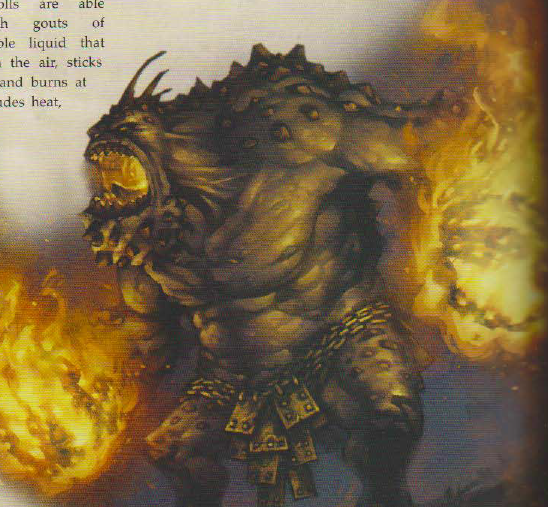
Pyre Trolls are able to belch forth huge bursts of combustible liquid that ignites in air, sticks to flesh and burns really hot. Yeah. They naturally burp napalm. Even their skin exudes heat, and after softening someone up with their spit, they like to tear them apart with their claws. Trolls are highly adaptable, able to find a niche in any environment, and pyre trolls are a strange evolution of the more common pitch trolls of the Marches, east of Ternon Crag and near Scarleforth Lake. Their skin is a deep burgundy or ochre to blend with the red desert sand, and they prefer hot climates. They can often be found sunning themselves on very hot rocks. They are much less intelligent than most trolls, perhaps due to their high temperature and odd eating habits. No one has any idea how they managed to get napalm spit, but some believe it's a byproduct of the toxic substances they consume, including rocks, metal, oil and deadly plants. They particularly enjoy drinking the viscous fluids that bubble up in the Marches, the same stuff the Menites refine into Menoth's Fury. Whatever they case, they're real good at setting stuff on fire. Also, their animus allows them to light allied weapons on fire for a while.
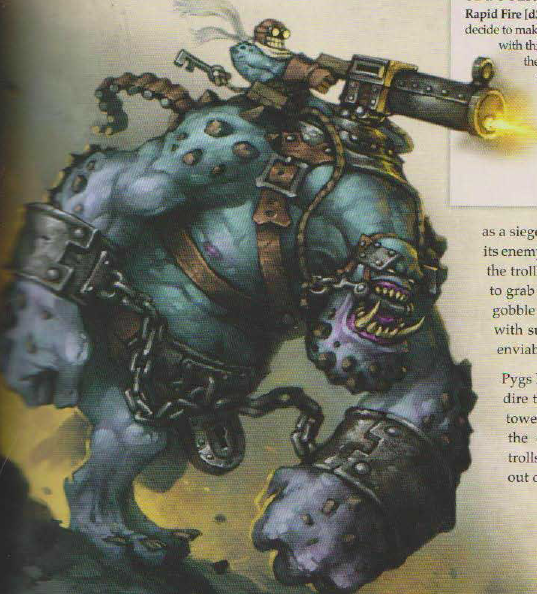
Dire Troll Blitzers could only have been imagined by trollkin. When King Leto gave them surplus Cygnaran weapons, he'd never have imagined they'd be mounted atop living siege engines. It probably started with drunken bravado and some idiot strapping a rapid-fire slugger cannon to a sleeping dire troll. Obviously, that'd be great as a siege weapon. The main problem was solved by chaining the thing's arms so it couldn't reach above its head and eat the pygmy troll ace manning the gun. The pygs have embraced this new configuration enthusiastically, and consider the blitzer aces heroes. Pygs have always had an odd affinity for dire trolls, as far as anyone can endure the attentions of a dire troll. They seem to genuinely enjoy the presence of pygmy trolls, and will generally not eat them unless out of all other food. Their animus shoves enemies away.
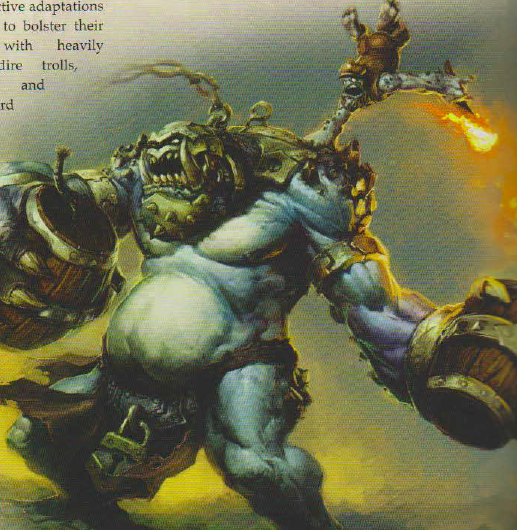
Dire Troll Bombers are a development intended to deal with the fact that enemies are everywhere. You take a dire troll and give it a bunch of kegs full of explosives. The powder in guns is a special formula of two different materials that must be mixed for detonation very carefully, but other explosives exist - more volatile ones favored by loggers and miners, which would blow up guns that used them. Perfect for bombs! The trollkin stuff them into barrels, and some kriels have taught dire trolls how to throw the kegs. Dire trolls can't really be trained to do things with regularity, but they seem to enjoy the explosions and will cheerfully and enthusiastically hurl them at enemies. Foolishly brave pygmy trolls accompany them into battle to light the fuses. Their animus grants allies resistance to explosions and blasts.
Next time: Troll is not going to look like a word.
Hordes Mk. II Primal
Original SA postIt's no big deal, really, I was just surprised.
Hordes Mk. II Primal
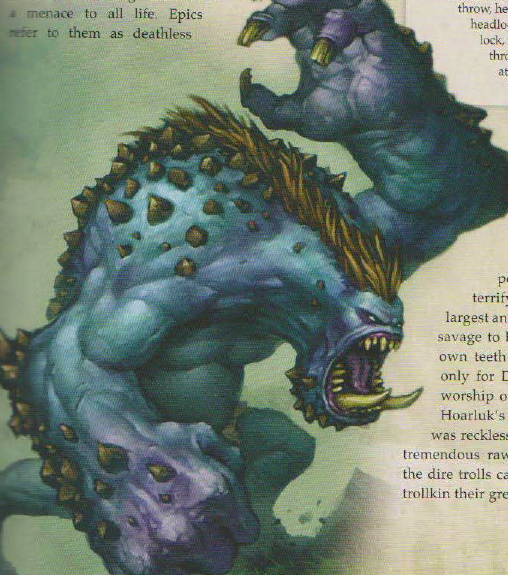
Dire Troll Maulers
are nearly 18 feet tall and made solely of muscle, with hands the size of a human being. In ancient times, they emerged from the forests to consume screaming victims, and even today, your only real defense is to run faster than the guys they're eating. Dire trolls are everything unpleasant about normal trolls magnified by a factor of ten. They are said to be deathless and tireless, able to rend metal and splinter bone with ease. If they have a language is debatable, but they make noises and can learn to obey Molgur-Trul commands. Only Hoarluk Doomshaper had the power, will and courage to unleash these beasts, and the maulers are the strongest of the species, and the most brutal. They are so fierce, in fact, that they just can't be trusted with actual weapons. They have a word for Doomshaper: krol, which might mean something like worship or dedication. Many believe the choice to summon these beasts to battle was reckless, but their power can't be denied. As long as they can be managed, they give the trollkin the best chance at victory. Their animus is a massive strength boost.
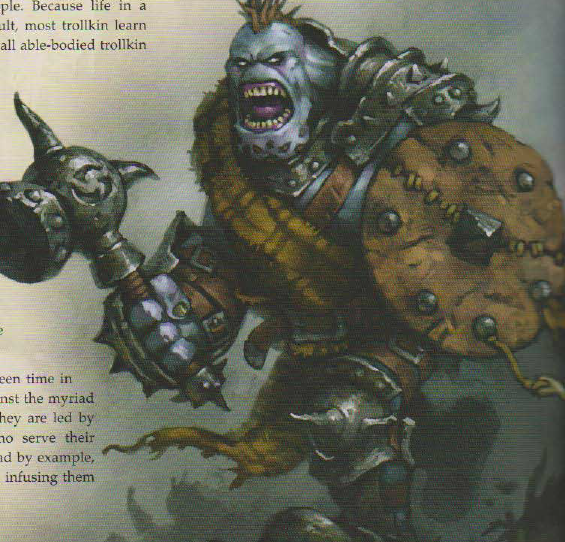
Kriel Warriors
are bands of irregulars from the trollkin kriels. Few are professional soldiers, but they are used to constant battles. Life in wilderness kriels isn't easy, and most trollkin learn to fight young. They only get minimal additional training before being sent to battle, where their real education in war starts. The main component of their training is in fighting alongside trolls and how to tell if a troll is wounded and hungry. Most have already seen battle, though, facing the many enemies of the kriels. They are led by Dhunian shamans from their communities, who lead by example, giving wisdom and the power of Dhunia's anger.
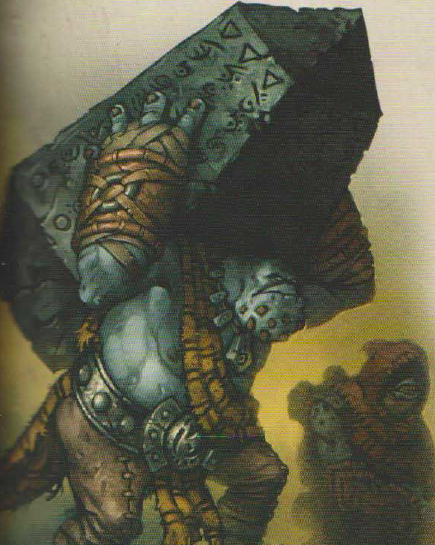
Krielstones are sacred monuments of the trollkin, carved with runes detailing heroic acts.
Krielstone Bearers and Stone Scribes
carry and maintain them, and are the most respected of all trollkin. The largest krielstones are placed at holy sites or ancient battleground shrines to Dhunia, the Ravaged Mother, but some smaller ones are carried into battle. They are reservoirs of spiritual energy that radiate a protective aura. Typically, strong trollkin will train to be bearers by lifting heavy stones throughout their youth. However, they insist it's as much will as muscle to carry a krielstone, and some gain reputations as they strive to lift heavier and more potent stones. The stone scribes accompany them to witness the brave deeds of battle, which they will record on the krielstones for later generations, and to help capture the sacred power of the stones onto ceremonial scrolls made from rubbings. Both scribes and bearer will sacrifice their lives to protect these holy stones.
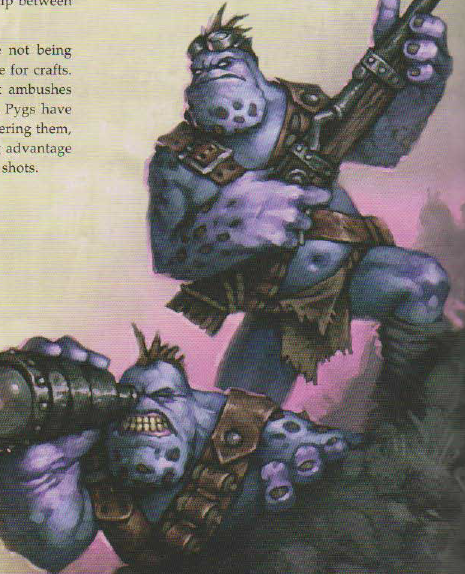
Pyg Bushwhackers
are an example of the pygmy trolls that live on the outskirts of trollkin society. They are traditionally seen as frivolous and cowardly, but are tolerated, which generally suits the pygs because it keeps them safe from the actual trolls that like to eat them. However, the relationship has started to change. Pygs are quite clever and nimble, though not noted for sophistication or craftwork, and use their cunning to lay skilled and complex ambushes, bringing down large prey. They have increasingly begun to imitate trollkin garb and culture, and they are surprisingly good with guns. After seeing that in action, trollkin leaders saw potential in organizing and arming the pygs with Cygnaran rifles, altering the stock and triggers to the proper size. What they lack in discipline, the pygs make up for with enthusiasm and ingenuity, even adopting improvised hand signals to coordinate better. Bushwhackers go ahead of trollkin armies, using stolen spyglasses to scout the best places for a fight.
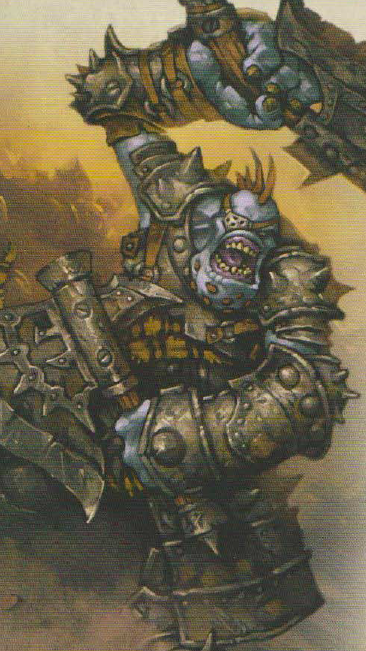
Trollkin Champions
are hardened veterans, great heroes of the kriels. They are bound by destiny and the formal kulgat blood oath of brotherhood. They draw strength from each other, fighting as one body for their people. Only the strongest and most skilled can become champions, who must master all weapons. The bond between champions is even more than a normal kulgat, as they must perfectly anticipate each other in battle to take advantage of even the smallest opportunity. Champion leaders are known as kithkar, the firstborn. They are generally the eldest and most skilled in the group, and many were once kriel chieftains. Most champions, especially of the Thornwood, have tales of woe - dead parents, mates, children - and find life between battles a solemn reminder that they are the last of their lines. They take hope from their blood-brothers and inspire it in all their kin, fearlessly striding into death. Each knows they will die in battle, but will send as many foes ahead of them as possible.
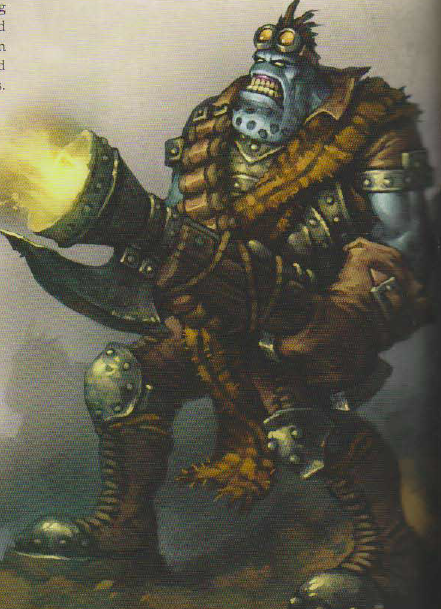
Scattergunners
are the equal of any human soldier, and twice as tough. Trollkin have taken to guns quite well, and the only real problem has been blasting powder. The Thornwood got a huge shipment of low-grade powder from Leto, as well as a number of deck guns. The trollkin strapped stocks to the cannons, then stuffed them with powder and scrap metal, making enormous scatterguns. They're short-ranged, but well-suited to trollish strength and stamina, and it's hardly as if the scattergunners fear a charge. Every shot uses insane amounts of powder, which has motivated a lot ofraids for gunpowder on human supply lines. They can be loaded with just about anything small and metallic, though, and enemies who foolishly stand too close are ripped to shreds. They also attached axe blades to their barrels for close combat, in case of survivors.
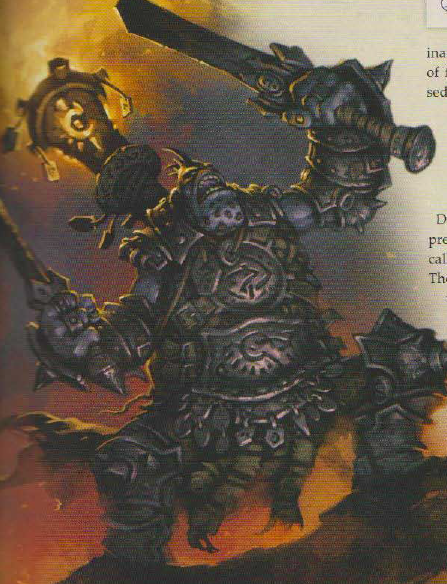
A
Fell Caller Hero
is a legendary son or daughter of Bragg, the father of the art of the fell call. They are paragons of trollkin culture, using their booming voices to rally allies or shatter bone. They take joy in life, even in these difficult times. They have their challenges, though - they tend to be arrogant and bad at following orders, and even by trollkin standards they drink excessively and incite revelries at the worst times. They can cause problems to the kriels they visit, particularly when they seduce the chief's mate, sons or daughters. Most feel the irresistable urge to pass on their bloodline, you see. Despite their habits, though, they're always welcome in battle. Each is a skilled warrior as well as a powerful caller, and few can resist the urge to follow when they charge.
Next time: The Circle Orboros.
Hordes Mk. II Primal
Original SA post Hordes Mk. II Primal
This history is presented by Omniotent Lortus of the Wyrmwall. Some say, he says, that the Circle Orboros exists to sow chaos and destruction, but it is not so. They do not unleash the fury of nature blindly, but are the enlightened hand of nature on Caen. They do not serve it, they control it. To understand the order, you must understand Orboros. Just as a man can have many titles, so can a god have many names, which each describe an aspect of their nature. Orboros is not a god, but something greater. Orboros and Dhunia share power as the primal fonts of creation, and their essence is tied to the world. The Devourer Wurm exists as one aspect of Orboros, the ravenous hunger and conscious will of it. There is, of course, an ancient and unending rivalry between the Devourer Wurm and Menoth, the Creator of Man. The Devourer is the wild and ravenous forces of nature, while Menoth is order. Men emerged, it is said, from Menoth's shadow as it fell on the forming waters of the early world, hiddling together for warmth instinctively by the fire, building monuments and fighting off wild beasts. Eventually, Menoth retreated to Urcaen to construct a city to protect the souls of his devotees. The Devourer chased him, and its consciousness in the living world faded. Priests of the Devourer can commune with the God of Feasts, offering sacrifices for power.
They do not understand that Orboros is still present on Caen. The will of Orboros is in Urcaen battling Menoth, but its essence pervades the world. Menoth cannot win so long as the Devourer can replenish itself from this wellspring on Caen. Orboros has no need for souls - it needs only the untamed wild, and the Circle alone can access that power. The Dhunians speak of the ravaging of their goddess by the Devourer Wurm as a single act of procreation at the dawn of time. It is not. It is ongoing - every season, storm and raindrop links Orboros to Dhunia. The seed of Orboros births every predator, its bones are the rocks and mountains, its shifting is earthquakes, its heart's blood is the ocean tide and flooding river. Its tongue is lightning and fire, its breath the hurricane. This is not an allegory. This is literal truth.
Humanity as a whole is obsessed with taming the wild, but since the earliest times, there have always been some born with an innate tie to the untamable chaos. The Circle are these people, born touched by Orboros, and they draw strength from its essence. When this power awakens in a child it is often mistaken for madness or possession. It is called the wilding, when a child hears voices on the wind or sees the ley lines beneath the soil. The Circle was founded after the fall of the Molgur and the rise of the priest-kings of Menoth. Golivant and Khardovic were a drastic change in human nature, one that would strange natural power. The efforts of the circle are a mirror of the battles on Urcaen between Menoth and the Devourer. The rise of cities stifles the blood of Orboros, and each city weakens it, making the Devourer's battles harder. The Circle swore pacts in those ancient days to limit the rise of cities. Sometimes, that means culling a population, breaking a dam, burning a field. It's a fine rope, though, for the power of the Circle relies on Orboros being both strong and distracted. Should the Devourer defeat Menoth, it would return from Urcaen to topple mountains and erase humanity from the world. Better for the Circle to guide nature's wrath instead. However, they have always been too few, and civilization has always advanced faster than they can set it back.
To keep the Devourer distracted, Menoth also must remain focused on the afterlife. He has a vast city in the wilds of Urcaen, protecting the souls of his dead, an entire continent shielded by walls. In long cycles, the Wurm roams the wilds and besieges the city, devouring any Menite souls it fcan reach. In these times, the two powers pay the least attention to Caen. When the Devourer is driven back, Menoth returns his gaze to the world and meddles with the affairs of his followers. By following the old pacts, both Menoth and the Wurm are kept destracted by battle, making it easier to control and tap the wild's energies. Ultimately, however, it's a delicate and unsustainable balance - there's too many humans and not enough of them are blackclad druids. Eventually, the works of humanity will weaken Orboros enough that the Wurm will be compelled to return to Caen and obliterate the greatest cities of man ina frenzy of destruction in order to regain its strenght. Few understand the struggle and fewer would embrace it if they knew. The children of Menoth falsely believe their gods can protect them, that the Wurm is not a primal force but a beast to be slain.
In the time of Molgur, the Circle Orboros were not needed. Humans were nomads, not yet taking up the Canon of the True Law. Worship of the Devourer was open and widespread, though you must remember that the Circle are not priests of the Wurm. Their relationship with Orboros is intimate but not worshipful. The Wurm's cultists have always been their pawns, not understanding their own insignificance. They are not equals - they are always tools. Perhaps useful and potent tools, but tools. The Circle learned to hide its nature after Molgur's end, learning subtlety. They used floods and earthquakes to slow civilization, and by their influence did ancient empires fall, but some, like Caspia, got their rotten roots in too deep. Even now, the City of Walls is impervious to the greatest efforts to destroy it. Still, despite the spread of Menoth's word, the Thousand Cities Era was favorable. Mankind was freactured by internal dissent and dominance games. When needed, cities were destroyed without anyone realizing how. For example, under the city of Ceryl are the ruins of a dozen towns destroyed by the Circle. Other ruins, blamed on floods, fire or plague, are also their work.
The first major sign that the balanace was failing was the founding of the Khardic Empire. The Khards were the result of a long calcification of tribes which could not be prevented, only slowed by murder and assassination. However, that rarely works - it makes martyrs, and one leader will not end a tide. Another will take their place. Disease is a far more effective tool. Still, other forces were steering the fate of the Khards, Kossites and Skirovs. An immortal creature named Zevanna Agha, called the Old Witch of Khador, was able to, by herself, thwart the entire order. She protected the northern tribes and still does, for her own reasons. At one time, she walked among the Circle, but ultimately betrayed them and used their lore against them. She has the same power to draw on the vitality of the land, yet can also call on the strength of the people of her lands. All attempts to stop or even understand her power have failed. There were many clashes with her in the attempts both to weaken the Khardic Empire and more recently the Khadorans who have inherited their legacy, but she has stopped them at every turn. Where her crows have been, they leave only the bones of those who try to defeat her, so most tactics against her involve misdirection. Recent events forced the Circle to act openly against the blight in Khador, and she confronted them there, but it seems they were not at odds on that matter, though her true motives remain hidden.
Speaking of the blight, at about this time Lord Toruk came to the Scharde Islands. Even before then, however, he was watched. The Circle observed Toruk destroy the dragon Gaulvang and consume his athanc in 1387 BR, and an omnipotent witnessed personally the struggle between Toruk and his child that tore the skies with fire and left a blizzard of ash. Dragons fascinate the order because their power exceeds the wrath of the Devourer, yet comes from a tainted and unnatural source. The ignorant often link the two together, and many religions paint the Wurm as the progenitor of dragons, but the Devourer Wurm has nothing to do with them. Dragons are a mockery of true life and are outside the natural order. They have nothing in common with any living creature of Caen or any part of the cycle of Dhunia and Orboros. They are a blight that leaves the land barren, that corrupts and kills everything it touches. Blight is anathema to the power of nature, and it destroys the ties to Orboros and interferes with elemental power. Blight is still poorly understood, but dragons are one of the greatest threats to the world. You would never know it today, but before Toruk came, the Scharde Islands were a bastion of the order. They were nto always swamplands, and were homet o many druids who used blood magic and the wilding. However, Toruk came to the islands and one of the circle's own betrayed them, enamored of his majesty. The name of that traitor is now forbidden, for he violated all the Circle holds sacred by offering himself to the Dragonfather and slaughtering or corrupting his former allies. The Scharde Islands were lost to the Circle, and the blood magic they taught the locals was twisted into corruption. Toruk's brood are all powerful, though not so much as their father. No means has ever been find to kill them permanently, despite millenia of study. It is known that one day either Toruk will consume them all or they will rise up against him and destroy the world by their war. Delaying that apocalypse is one of the Circle's jobs.
The arrival of the Orgoth was a dark time for the Circle, and many sacred places were sized and turned into sites of slaughter. The Orgoth knew the power of blood and tried to capture the loci of natural power for use in the ritual sacrifice. It is true that many druids use primal rituals of bloodshed, but the Orgoth's bore no ties to fertility, predation or natural cycles - they used it to imprison and consume souls. The Circle used their power to swallow up the tainted places, many of which were reclaimed from the Black Kingdom of Morrdh. It took generations to purify them once more, and some were permanently poisoned. Some still have not even been reclaimed. However, there were victories, particularly in the creation of the disease rip lung. Few would ever attirbute the destruction of the Orgoth to it, but it followed their supply routes back to their homeland and devastated their overseas population. Many Immorese also died to it, but there is little weight to individual lives. Even if every major city were to fall to plague and flood, there'd still be too many humans around. It has been a gradual recovery from the Orgoth atrocities, these past four centuries, hindered by the slow rate of the wilding manifesting.
The rise of the Iron Kingdoms only accelerated the expansion of cities and human populations. The Orgoth at least kept humanity in check due to poor conditions and culling. The Rebellion, however, saw unfettered population growth., and the relative peace of the last four centuries allowed for great advanced in industry and trade to support them. One day, this cancer may spread across all of Caen, practically ensuring the return of the Wurm. Though the latest wars are helpful, they are too late to mitigate much of the damage. In recent decades, however, there's been a surge in people born with the wilding. It is beleived this is a natural response to Menoth turning his attention back to Caen, due to the Protectorate of Menoth assimilating the Idrian tribes and launching a crusade of conquest. The presence ot the Gabinger is proof that Menoth's servants must be defeated for the good of Caen.
The greatest duty of the Circle is to retrieve those with the wilding before their potential is ruined. They have methods to predict the time and place of the manifestations, and send mentors to recover them. The Circle are called corruptors of the youth and some say they sacrifice the children, but in fact they are inducted into the Circle, learning to control the primal energies and forget their pasts. Yes, they never return home, but they are far greater than they would have been. Mastering the innate tie to Orboros is a job for a lifetime, and druids get great freedom to pursue it. Each finds their own way, mastering whatever power is closest to their nature. Wilers who prove competent become warders, entrusted with dangerous tasks. As their power grows, they get more and more responsibility. The organization is always secret, and most druids spend their entire lives as warders. The handful who approach mastery and pass their trials become overseers, gaining territories to oversee and sites to protect as well as being sent to coordinate plans abroad. A very few are given the rank of potent, watching over vast regions and executing longterm plans as well as overseeing dozens of minions and subordinates. The potents manage the relationships with the pawns of the Circle, from the bloodlines that owe allegiance to the Devourer cults, each of which must be nurtured carefully. They are not infinite, after all. At the head of the order are the three omnipotents, who lead the Circle and understand the deepest secrets of Orboros. Each has carved their own path to mastery - stone, beasts, storm, the connection of life and death, the flow of ley power. No aspect is superior, and omnipotents must learn the uses of all, so that they may command their subordinates properly.
The purpose of the Circle's power is real, and they cannot be so reluctant to act as they have been. It is too late now for that. They have been too proud, too self-assured in their control over the primitive races and the disenfranchised, such as the trollkin. For many centuries they were the Circle's closest allies, working for generations together, but by a grave miscalculation, that has all been undone. The Omnipotent Ergonus underestimated Madrak Ironhide, who was uniting the trollkin, and didn't notice the trollkin troubles when he tried to enlist them to fight Everblight. Ergonus decided to have Ironhide killed - and, as noted before, assassination is invariably a bad plan. Madrak Ironhide remains alive, and now the trollkin despise the Circle - and worse, Ergonus was slain. Still, the tribes of Tharn are loyal. Once, they were cursed with infertility, but the Circle cured this decades ago, with the aid of the Tharn leader Morvahna the Autumnblade. In fact, she not only broke the curse but reversed it, and earned the loyalty of all of the Tharn tribes. Now, the Tharn reproduce like rats, a great tide of warriors like the old Molgur, led by Kromac the Ravenous. Their ferocity is useful in complement to the Wolves of Orboros, the regular soldiers of the Circle - the best hunters and woodsman in all of Caen. Their families have served for years, and are most likely to produce the wilding. Those who do not make up the core of the Circle armies.
The last battle is coming. Even now, Orboros stirs. Invaders from the east have come to seek empire, but they are the least of the Circle's worries - indeed, the skorne are fortuitous. They sek to impose order, but the wars they bring are useful. Fortresses crumble and borders shift as they fight. However, they are masters of an unnatural magic, near to necromancy, and must be watched. But no difficulty can compare to the awakening of the dragon Everblight. It has shown the ability to influence and blight in a way no other dragon ever has, for its blight spreads like a disease and is not rooted in its body. It may be that by refusing to remake its body, Everblight has surpassed all its siblings. The dragon's minions have annihilated the lands of the Nyss, and the vast majority of the Nyss are corrupted and willingly serve it now, their bodies twisted and changed more deliberately than ever before. It is as if EVerblight had found a way to reshape them to its own purpose. Now, Everblight lacks patience.
The Circle attempted to defeat the legion of Everblight, but failed to stop it from destroying its sibling, the dragon Pyromalfic, at the Castle of Keys. Witnesses never saw Everblight take form, but it somehow consumed Pyromalfic's essence, empowering it greatly. There are a number of leading gnerals directing the dragonspawn, and the riddles of Everblight must be solved to stop them. The Circle must stand together, yet are divided now. All agree that Everblight must be stopped, so common ground on how must be found. Some call for direct battle. At the Castle of Keys, the Circle's forces did not gather fast enough, though, and their losses have weakened them greatly. More were lost chasing the dragon army north, though they learned more about Everblight in doing so. Others want to manipulate great forces. Krueger the Stormwrath, ignoring orders, went to the dragon Blighterghast, in hopes of encouraging the other dragons to fight Everblight. This may have imperiled everyone, but it may have helped. Time will tell. Contact with the dragons directly has always been forbidden, for many reasons, and none can say the consequences now. The Order must come together in this, the end of days, and show their foes the vengeance of nature.
Next time: Druid terrorism.
Hordes Mk. II Primal
Original SA post Hordes Mk. II Primal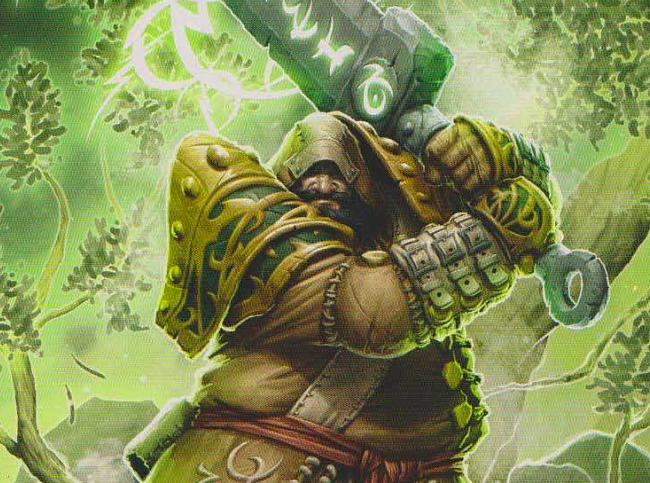
Baldur the Stonecleaver is also known as the Rock of Orboros, and some joke that he's spent too long communing with mountains. He is calm and serene, but when his anger is roused, he is unstoppable. He says nothing about his past, saying only that he was born in a bear cave near Boarsgate, but he has Khardic features and size. His strength flows from the earth, and he wields an immense stone sword that no one else has ever lifted, let alone wielded. He says it is not strength of his arms, but that the sword is part of him. Baldur is much older than he seems and has mentored other druids, like Kaya the Wildborne, as well as befriending many outsiders. He cares nothing for politics, focusing on stoneworking, and he has worked even with Rhulic and Iosan masons before. In better days, he was a great friend to the trollkin kriels, and he is disappointed by the rift raised with the trollkin, but will not shirk from battling them. His logic and insight make him powerful within the Circle, and he has been given the rank of potent. He is a master of stone magic, shaping wolds and their kind with primal power. He is a sculptor whose creations will fight for him, and who can raise forests even in the most blighted places. He worries greatly about Everblight and the scars the dragon causes. Since the rise of the Legion, Baldur has slept little and has either been making new wardens or mustering for battle ever day, primarily against the Legion. Despite all this, however, he remains optimistic. His gimmick is control of stone and battlefield and the use of golems. His feat allows him t shatter the earth under his enemies, making it hard for them to move.
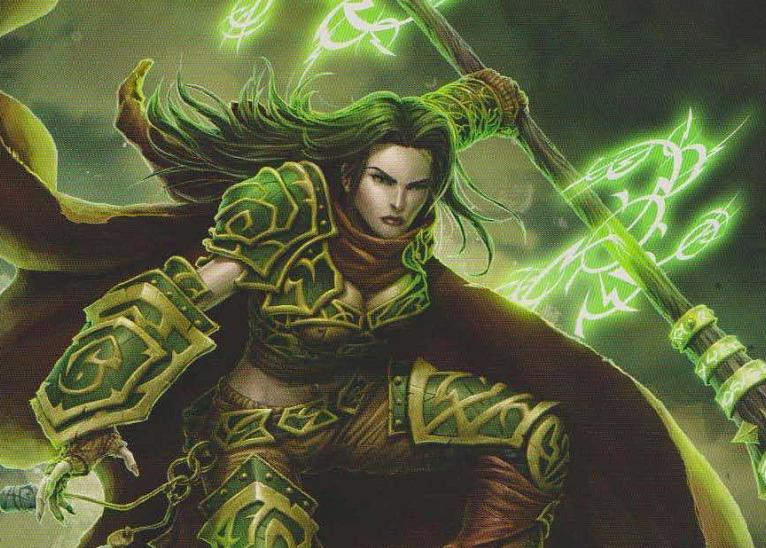
Kaya the Wildborne is a master of beasts, far beyond any of her peers. She rides their minds and, when she enters a battle trance, she is as violent as any of them. Her willingess to submerge herself so in the mind of a pack worries her mentor, Baldur, but it is her nature. She has tried to learn patience but it's never really taken, and she doesn't understand why others can't understand her own methods. She was born in Ord, near the Thornwood, and had her wilding as a toddler, howling at the moon to the cries of wolves. Her parents willingly gave her to Baldur when he came, and he has been her father since that day, the only ranking druid she truly trusts. She believes that the other Circle leaders are needlessly manipulative and rarely agrees with them. This and her inability to keep her tongue under control have alienated many of her peers, which may be because she spends so much time in the minds of creatures that understand neither lies nor tact. She rarely participates in the plots for which the Circle is so famous, preferring the simpler motivations of beasts. She lets her actions speak for her and prefers direct strikes against the Circle's enemies, which she is very good at. She can sacrifice her beasts if she must, but her bond with them is very great, and their loyalty to her is genuine. Kaya's gimmick is buffing her beasts, and her gimmick allows her to push them to great heights of fury to empower her magic.
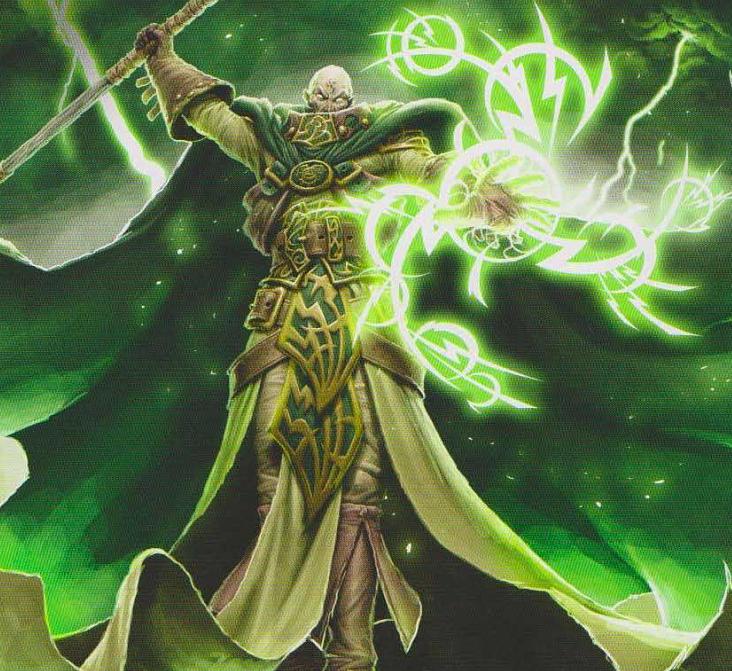
Krueger the Stormwrath is equal parts feared, respected and disliked within the Circle. He has no friends and thinks of none as his equal. His name came from things like climbing atop a mountain to call down a storm potent enough to nearly drown a city. He was the only witness to the death of Omnipotent Ergonus, and he is enraged that Lortus got the seat instead of him. He believes he is being punished for surviving, and he longs to lead the Circle, believing they have become too soft and need him to return them to the days of plague and flood. He was born in a small village near Sul, and is one of few to survive a wilding in the Protectorate. His father was a Menite priest, and he was quickly condamned as Devourer-spawn, almost burnt at the stake by his own father. Druids came and saved him with bloody swiftness, taking him to the ruins of Acrennia to be taught by Mohsar the Desertwalker, a harsh master famous for teaching by cruel example. He once stripped Krueger and abandoned him in the desert, forcing him to make his way back by strength and cunning. Krueger lives bringing suffering to human cities, and if he could, he would destroy Sul and Caspia and kill all within. He particularly hates Menoth and wants to wipe his church from Caen. His spear contains the Tongue of the Wurm, an endless lightning storm held captive in the heart of the shaft. He revels in the Devourer Wurm more than most, seeing no difference between it and Orboros, and he is beloved among the Tharn, having partaken in their human sacrifice and heart devouring. The Stormwrath is barely contained fury, and his rage will only be satisfied when all of civilization is crumbled, burned or drowned before him. His gimmick is weather and lightning, and his feat lets him call down giant thunderblasts.
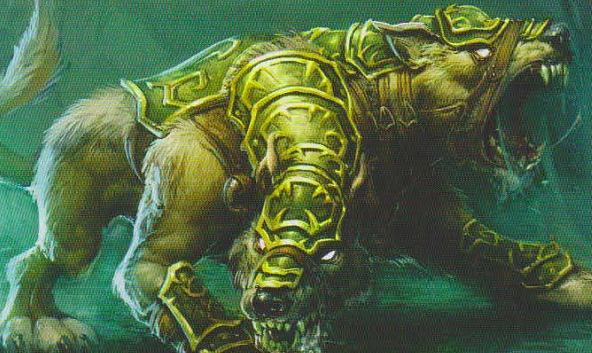
The Argus is a two-headed war dog, bred and tamed over the centuries by the druids for battle. They are far larger and more vicious than the breed tamed in northern Khador, and are very strong for their size, but their true value is in their bark. It is able to immobilize even the most powerful foes, allowing them to be struck down easily. The argus are practically impossible to surprise - their four eyes are constantly watching, and they are sensitive to any movement at all. They will attack anyone who harms their pack, and will happily sacrifice themselves for their masters. They are famous for endurance, able to run very quickly over long distances, and they make ideal hunters and trackers. They are quite clever and can understand even complex orders, with patience. On top of tearing apart prey with their jaws, they often use their bark to disorient and daze prey, and in the wild, they hunt in packs, with one paralyzing foes so the others can kill. Their animus grants skill in movement and scouting.
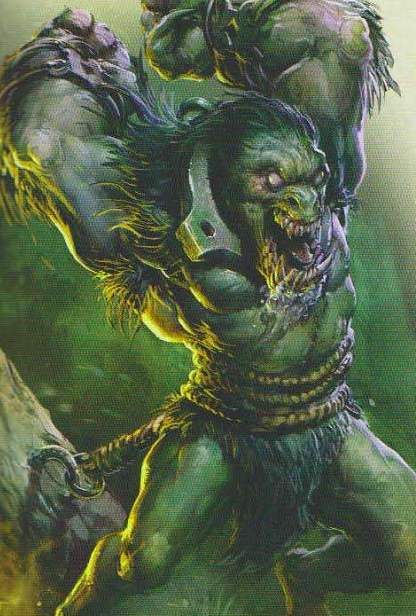
The Gorax is not quite beast or man, a hulking primitive with massive jaws of hardened fangs. They eat only meet and they are the embodiment of primal rage. When hurt, they become even faster and more aggressive, lashing out at anyone nearby. For venturies, they have been captured and enslaved for battle. Warlords of the Thousand Cities era used them as shock troops by the hundreds. Once their blood lust became too great to control, they were killed. Gorax tend to prefer the taste of human flesh, and their indiscriminate nature made them fall out of favor quickly, but the druids have learned how to use them properly. Despite their appearance, they are much smarter than animals. They can approximate rough speech and learn to follow instructions. They are bribed with food and mates, then conditioned to accept training. They don't need weapons. The Circle just has to tap into the chaos that seethes in their minds. Their animus allows their frenzied madness to be spread to their allies, strengthening them.
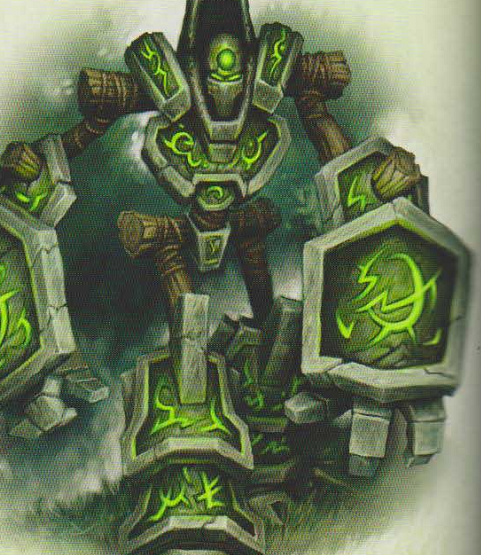
Woldwatchers are the guardians of the sacred groves of the Circle. They fire blasts of elemental energy, growing trees from the flesh of the dead. When not active, they appear to be piles of stone, but when triggered, they reveal their true forms and fight to defend nature. They can be made from any strong stone and natural materials lashed together by ropes that have tasted blood. The stone must be inscribed with ancient runes that imbue the woldwatcher with the power of Orboros. Many druids prefer these smaller constructs to their larger counterparts - they're easier to make. The ropes using them are not always wound from vines water by blood sacrifice, as they were in the past, but they still draw great power from life's blood. Their connection to the earth allows them to cause brief but dramatic explosions of plant growth, and they can become nearly impervious by standing still. Their animus grants some of that stone strength.
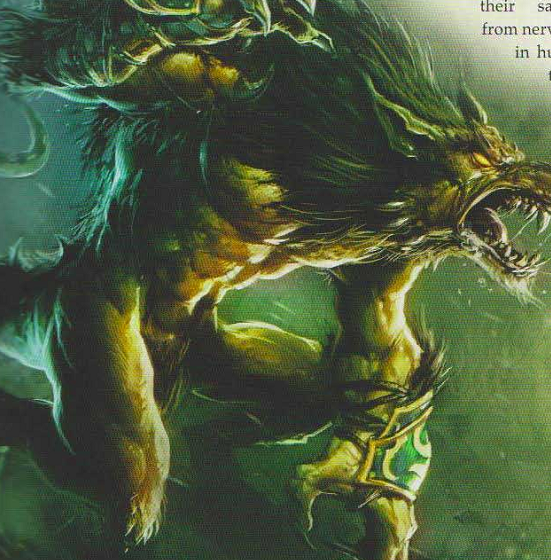
The Feral Warpwolf is the embodiment of the Devourer Wurm. The warpwolves were made when a cult of the Devoruer sought closer connection to the Beast of All Shapes, using a potent mystical formula combining man's bestial essence with the madness of the shifting moons. Any human who ingested it was transformed into a massive, bipedal wolf monster when distressed or hurt. A warpwolf, filled with the urge to kill and devour. Long ago, the Circle discovered the formula's secret and began to use the warpwolves for war. The initial transformation is instantaneous, but after a time they revert to human form. The transformation occurs again unders tress and during some lunar phases. The genetic change is irreversible, and the children of warpwolves are also warpwolves. Few retain their sanity, suffering from nervousness and violent episodes even while human, and indulging any excuse to express their predator nature, The Circle officially prefers not to make new warpwolves from the unafflicted because of this, but since the rise of Everblight and the feud with the trollkin, the omnipotents have turned a blind eye to it, In battle, warpwolf bodies constantly shift and warp, with muscles bulging for bursts of speed or power and bone spurs erupting to protect their flesh. Wounds close quickly, and the howls of the hunting warpwolves are one of the most terrifying sounds in Immoren. Their animus allows them to drain rage from enemy beasts.
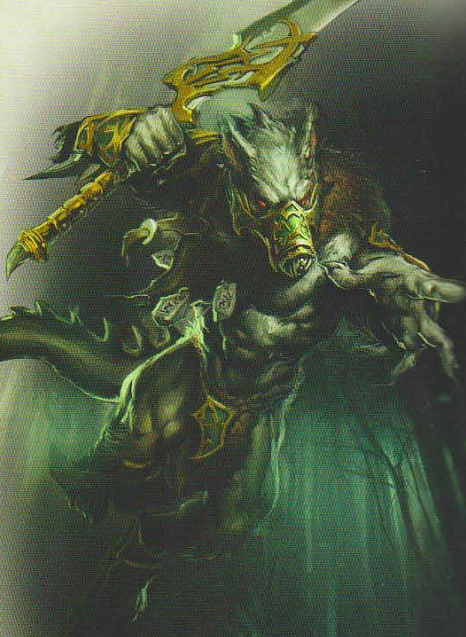
Warpwolf Stalkers are made the same way as feral warpwolves, but they reacted differently to the elixir for reasons none understand in full. They are warped by the Devourer, but retain a portion of their human mind and so can wield weapons in battle. With this mix of bestial instinct and human intellect, they are particularly potent weapons, if still very bloodthirsty. Some of the Circle believe that the stalkers were those touched by a shadow of the wilding before transformation. They lacked the spark to become full druids, but their new form gives them access to primal power. They prowl the forests of Immoren and serve as the vanguard of the Circle armies, hidden by the environment as they stalk their prey. At the last moment, they leap out and slaughter everyone around them in a berserk fury. Their animus allows for lightning-quick movement after a kill.
Next time: The Circle's killers.
Hordes Mk. II Primal
Original SA post Hordes Mk. II Primal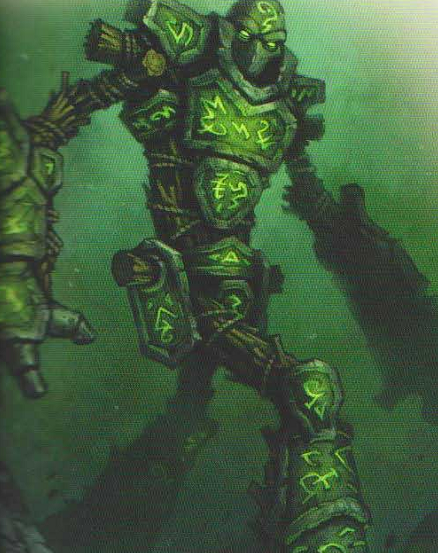
A Woldwarden is a construct of earth and wood that wields the chaos of living entropy, infused with Orboros power by carved runes. Their stone fists are powerful weapons, but their greatest asset is the elemental harmony they have with their warlock. This allows them to serve as a vessel for the druid's magic, fueled by the power of the earth rather than their own energy. A woldwarden can unlesh magical spells its druid knows, acting as an extension of the warlock's will and power. They are made from immense stone blocks carved with potent sigils, and it's a slow and delicate process to make one. In quieter times, the guard the most sacred sites of the Circle, but now, they are warriors of the advance. Some, particularly those druids who use stone magic, consider them superior to and more reliable than wild beasts, as they can move through any terrain and absorb immense punishment. Trees and foliage often erupt around them, hindering any foes nearby, thanks to their animus.
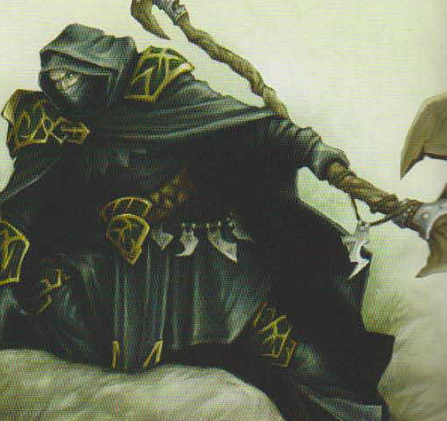
The Druids of Orboros , known to outsiders as the blackclads, are seen as heralds of doom, evil cultists who remind men why the wilderness is to be feared. They are known for their brutal vengeance on those who interfere with them, and soldiers fear them deeply. They have immense power over the earth, and thegreatest can make the ground itself swallow their foes. Druids wield mighty voulges, but their real power is in their magic. They can call on the wind and mist and the chaotic power of Orboros, allowing them to disrupt the spells of others. They rarely fight in the open, preferring forests and other areas with good cover, like swamps or cliffs. It is risky for druids to enter battle themselves, but the Circle believes the strong and worthy will rise as a result, and only the weak will be culled.
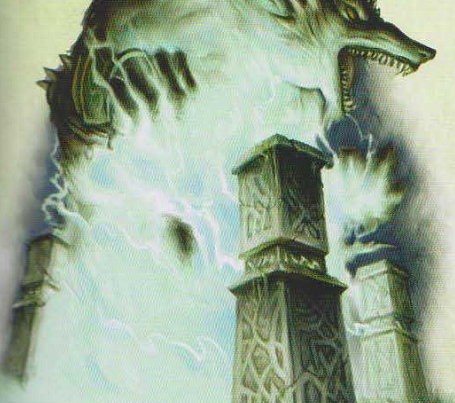
The trollkin are proud of krielstones, but even their understanding of stone pales before the Circle druids who make the Shifting Stones . For centuries, the druids have explored this power, using runic columns to mark their territories and boundaries, but they are more than markers. They tap in to the ley lines that are the arteries of Orboros. The druids use this vast unseen web of energy to channel and manipulate power via the carved sigils on their stone pillars. They are part of a mystical, semi-mathematical language that glow green when activated, a glow that has led more than one lost traveler to death at the hands of Circle guardians. Some of the greatest stones have a number of powers. Some can send messages across vast distances or heal grievous wounds, but their most useful ability is teleportation, moving Circle forces through the ley lines. It's part of why the druids are so hard to track or anticipate. (And yes, the stones can teleport themselves, too.)
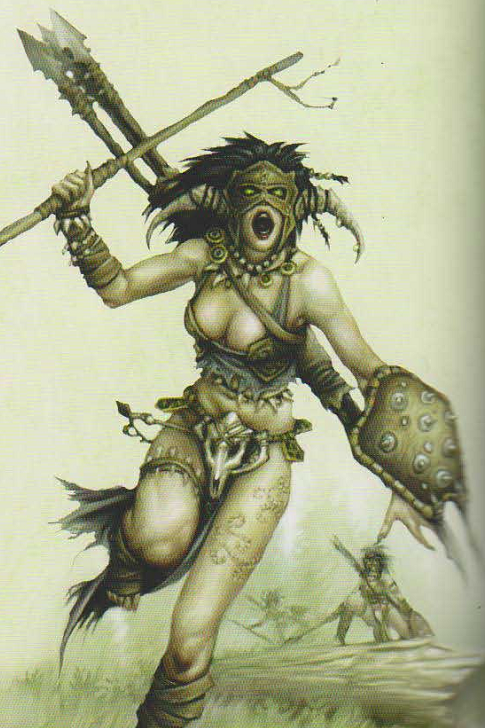
The Tharn Bloodtrackers are the women of the Tharn, as vicious an deadly as the men. They are a remnant of a darker time, wielding weighted javelins and primitive claws bucklers to fight those around them. They prefer to avoid melee, however, hiding in the shadows to hunt their prey with thrown javelins. They are frenetic, vicious women, and while they do not assume the hulking forms of the male ravagers, they call on the Devourer Wurm to get the swiftness of beasts and hypersensitive awareness, far beyond human limits. When they choose a hunting target, they will hunt them to the exclusion of all else before choosing new prey. Few ever see bloodtrackers clearly, and those who have say they wear shadows like cloaks. This is an exaggeration of their camouflage abilities, but they do have e nearly supernatural ability to blend with their environment and can move through any terrain very quickly.
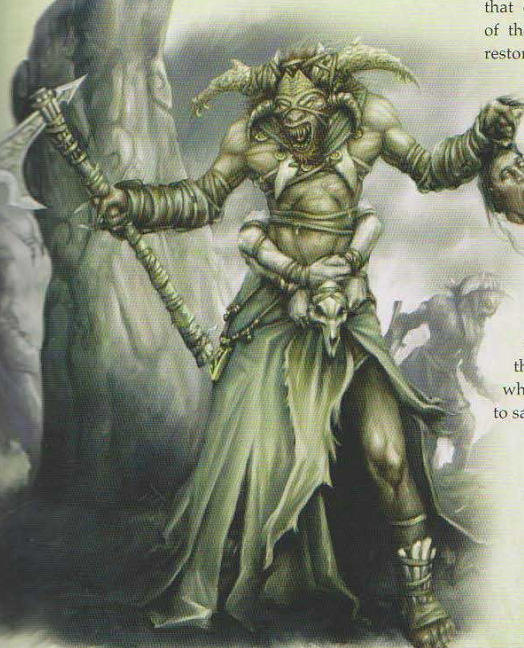
The Tharn Ravagers are the men of the Tharn. In peacetime, the Tharn are indistinguishable from normal human barbarians, but in war, they call on the Devourer Wurm to transform themselves. The ravagers expand their bodies, thicken their skin and grow vicious fangs, gaining bestial senses and an insatiable hunger. They will happily tear out and eat the hearts of their prey. Just three centuries ago, the Tharn were among the largest of the tribes, and tens of thousands lived in the Thornwood. Most were slaughtered in a political gambit of a Khadoran queen against Cygnar, while the rest were cursed with infertility. Decades ago, the Circle unraveled that curse and restored the Tharn numbers, led by Morvahna the Autumnblade. The Tharn are eager to repay their debt, and the ravagers fight for the Circle now, charging into battle to hack up and devour foes with their long axes, leaving mutilated bodies behind.
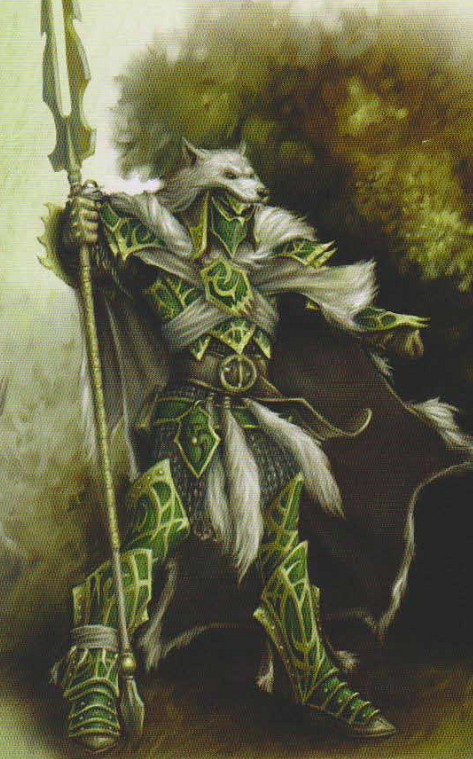
The Wolves of Orboros are those who take up arms to serve the Circle. Families in dark forests and isolated hills pass on the tradition, initiating their children into a secret cabal furthering the will of the druids. In exchange for their fealty, the druids watch their lands and families - a powerful thing, to the people who leave beyond civilization. Druids select the families carefully, as those who have a greater than average chance of the wilding, and they value them deeply. Each Wolf masters the two-bladed spear, a potent weapon meant to punch right through armor. They must prove their skill and ability to survive in the wilds to pass their initiation rites and earn the wolf pelt that marks them as a brother or sister. In recent battles, the number of Wolves has been raised with offers of coin and valuables. These mercenary recruits must still have the willingness to obey and the survival skills. Some can't explain why they serve even after their contracts end - only that it feels right. Coercing people into the Wolves is not unheard of, but that produces resentment, so the Circle prefers volunteers. The lifestyle of the Wolves certainly has an appeal to those on the fringes who wish to belong to a cause.
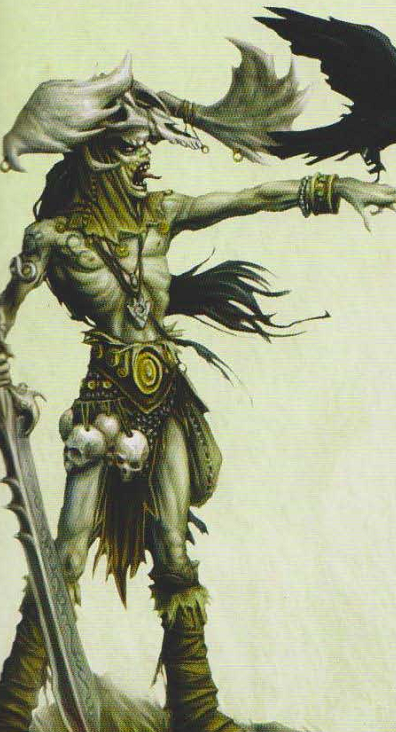
The Lord of the Feast is a prehistoric horror, an avatar of the Wurm's hunger that slaughters any it meets and feasts on their organs in a sacrificial offering to the Beast of All Shapes. Once it finishes, it becomes a cloud of ravens that devours the slain. The Circle rarely intentionally draws the Wurm's attention, but dark times call for dark measures, and they have used forgotten lore of the Molgur to summon the Unsleeping One's avatar into the world again. The Lord of the Feast has only one companion: a raven that ranges ahead of it, seeking new victims. The Feast Lord then kills them with its long blade, joyfully partaking in bloody sacrifice.
Next time: The mighty Skorne!
Hordes Mk. II Primal
Original SA post Hordes Mk. II Primal
The Skorne history is recorded by Hexeris, Tyrant of House Kurshon. He knows that the skorne did not record their history in stone until they settled, long after they learned to preserve their ancestors. Each house jealusly guards its secrets and records, and much of what he has learned was by going through the ruins of extinct or conquered houses and questioning their ancestral spirits. The ancestors of the skorne are crystallized and perserved in sacral stones, the greatest treasures of any house, and there's a lot of formalities you have to go through before the house's aptimus extoller will let you speak with the exalted dead, which they use to their own benefit. The extollers hide their lore away, but some secrets have proliferated in recent years, as the empire has consoldiated itself.
For most of the ancient past, the skorne were nomads in the southern reaches of what the west knows as eastern Immoren, which the skorne call Scindor Solum. In the north was the vast empire of Lyoss, a frail and arrogant race that would doom themselves. They were pampered by their gods and their rich lands, and though they tried to subjugate and civilize the skorne, they never succeeded, and all ambassadors and soldiers they sent were killed. They never understood the skorne, and the skorne despised the Lyossans, having chosen a pure path for themselves. They preyed on Lyoss, as a predator preys on the fat and torpid herd, strking where they were vulnerable and living in the badlands, with no need for cities. Lyoss hated them, calling them the faithless, the shunned and the godless. They did not realize that godless is a term of pride. Those the skorne exalt are their own blood, heroes who earn immortality by their deeds. The skorne do not need or want gods. However, this was a simple time, before the skorne had learned the potential of their own minds.
The first ancestor to discover spiritual awakening and exaltation was Voskune, an ascetic philosopher who predated the era of written history. He spent decades fasting and mortifying his flesh in the desert, to understand the tie between body and spirit. He dissected both the living and dead to understand that connection, plucking out his own eye that he might learn its complex structure of fluid and tissue. He replaced the eye with a sphere of smooth crystal that allowed him to perceive vital essence, most vividly in moments of anguish or near death. The moment of death, i nfact, was a particular fascination, and he was the first to perceive that on death, the spirit was flung into the yawning Void to experience endless agony. The spirits of the Void were all mad, and he was disturbed to learn this had happened to his own ancestors and would happen to himself. Extollers revere Voskune rightly, but he was a seeker truth, unlike those hoarders of mysteries. He would not recognize them as his inheritors.
He died, but his students carried on his work. It would be ten generations before two masters, Ishoul and Kaleed, worked together to achieve a breakthrough. Ishoul found that cutting and polishing certain stones would pull at a spirit, drawing it like water into a sponge. The pair worked those stones for the rest of their lives. They duplicated Voskune's sacrifice of his eye, as all extollers have done since. It is a small price to perceive life essence. It is not the only way to do so, but is the most reliable. In any case, perceiving spirit is vital to any true understanding of the world. The dominar of these masters' house, the warlod Vuxoris, became the First Exalted by their work. He invented the code of battle known as hoksune, still followed now, and asked Ishoul and Kaleed to preserve his spirit that his lore might not fade. Vuxoris' essence was captured in a polished piece of obsidian, preserving him immortally by transforming the stone with a lattice of energy. He could then be contacted, via a proper draining and ritual. Kaleed realized, shocked, that the stone now emanated great power and caused strange events. It would be generations before this power could be harnessed.
The stone became a treasured relic, with thousands dead in the wars over ownership of the First Exalted. From it, the skorne learned that smaller pieces of a sacral stone could be used in weapons and armor, gaining some shadow of ancestral power. Of course, it was done sparingly, to preserve the stone, but over time some ancient stones were slowly carved away entirely. The first sacral stone was lost, perhaps divided too many times, but that is the inevitable destruction of time's passage. Preserving the exalted is a complex and difficult ritual, and only the most accomplished of a house are deemed worthy of exaltation. That is the power and influence at the core of the extollers, and they hoard it as they do knowledge.
Another great ancestor arose twelve generations before the destruction of Lyoss - the warrior-philosopher Morkaash, who studied anatomy and the infliction of pain. He believed that enlightenment was the result of suffering, and sought to understand how bodies functioned. He tested himself against the beasts of the badlands, defeating them, taming them and breaking them to his will. This was carried on by his followers after his death. This gave rise to the paingivers and chirurgeons, who study nerves, blood vessels and living tissue, mastering anatomy to aid the wounded in battle and conduct ritual scarification. They also learned alchemy, to create useful compounds. It is not a glorious or respected pursuit, but it has saved many great dominars and tyrants from death. The paingivers, on the other hand, seek to master pain and mortitheurgy. They are skilled assassins, torturers and beast handlers, rooting out traitors and questioning foes. It is necessary in the complex intrigue of the houses, and they root out treachery with skill. Nearly as vital as that is their responsibility to keep and train the warbeasts, using pain to condition their behavior, along with various toxins, stimulants and other drugs. Beast handlers modify and augment their beasts, sometimes over generations of experimentation to turn these creatures into weapons, and in other cases by bringing out their native qualities. While any given paingiver works for a house, they belong to none, giving up loyalties in the name of their art and duty.
In the centuries that followed, some others sought the deeper mysteries. Often these were extollers who wanted more than to oversee funerary rites and ancestral stones. This gave rise ot the art of mortitheurgy, which underlies all arcane study. Thge basic tenet is that great power is realeased by the flesh as it transitions, and that blood and pain have innate power. It is extremely valuable in power, and with the right applications can force a warrior past the limits of the flesh, tapping into the power of death and suffering to go on without nourishment and despite any injury. It is a short reprieve, of course, and it has a price. The warrior will die, eventually, often in great agony. But those extra few minutes of battle can mean victory. Master paingivers and all house leaders must learn to control these energies to dominate the wills of their subjects. Thus, a warlord may force even a reluctant vassal to fight or tap the strength of a beast-slave, using both as extensions of themselves in battle. This gives warlords the strength of titans, able to withstand injuries that would fell a squad. Most tyrants understand the fundamentals of mortitheurgy but do not really comprehend their arts. Some study further, drawing on the infinite energy within the immortal spirits of the living. That must be done with care, howewver, as exceeding your limits this way can stretch you to a point of no return, permanently and utterly annihilating you even beyond the reach of the extollers. However, a master of sufficient will could not only avoid this, but avoid the agonies of the Void after death. Most will never reach that point.
Lyoss knew nothing of skorne philosophy or culture. They could not comprehend that the skorne had mastery over death. Their luxury made them complacent, and the dominars celebrated their obliteration. The sun exploded in the sky over their cities, sending flame and molten rock across all they had made. It was so potent the earth itself rippled like cloth. Many skorne died in the storms that followed, but because they were strong, they stood firm where the Lyoss panicked and fled. The skorne harassed the survivors as they headed west, taking those too slow to flee. What little survived fell into the hands of the skorne. That was almost 250 generations ago. Exalted ancestors of the period describe the fall, but it was only in time that the benefits of the destruction were realized. The Abyss swallowed the Lyoss capital in unquenchable flame, along with their outer cities. And that is what transformed the skorne away from nomadic travel. It was imperative to build permanent shelter to weather the storms and floods. The skorne learned masonry, architecture and more. Despite this, they kept their traditions and values, dividing into the freactured houses that even today vie with one another for power and resources. Life was short and cruel - a house might be ended in a few short days, leaving only their spoils.
Over time, the storms receded and the weather became more predictable. The cities of the skorne prospered, their eternal war with each other cointinuing as the philosophies and traditions were restored. However, much had been lost, including many sacral stones. Some of the exalted were released when the stones were shattered - an event that brings plague, mosfortune and wrath of the ancestral spirit, for without the stone their essence is twisted. The strongest spirits can endure this, though, and in very rare cases will be reborn. More commonly they bacome kovaas, rage ghosts of endless fury. These spirits go mad and become mindless, wrathful beings of immense energy. Most extollers think it is vital to banish kovaas, but rarely they will be re-interred in a new stune, strenghtened against their rage. Such stones are extremely dangerous, and one can only imagine the madness of spirit twice broken. These stones are always sealed away with great care. In any case, the unquenchable fire of Lyoss retreated, and their lands could be taken, their ruins plundered. Much of the area is still hostile to life, but after millenia, they offer up forgotten treasures, and are worthy of salvage if you can survive the beasts.
The wars of the houses have forged the strength of the skorne for 250 generations. Their culture changed little in this era - warlords fighting each other to test their strength and ensure the strongest led. Great houses rose and fell, heroic ancestors became exalted, and the skorne spread across the badlands and into the lands of the Lyoss. Growth began again. Many lesser species were enslaved, including the savage cyclops tribes of the desert. Through conflict, the skorne became strong. Traditionally, the master of a house is a tyrant, and one who can impose will on lesser houses is a dominar. A tyrant has a warband - a dominar has armies. Through great victory, a dominar may rise to authority over other dominars, becoming archdominars with vast dynasties, but they rarely last long. One of the most recent archdominars was Vaactash of House Balaash. He carved out a territory north of Halaak, ruling longer than any other archdominar ever has, surviving countless duels and assassins. He is now exalted, and the rule of his house went first to his son, who died quickly, then his grandson, who died quickly, and at last his granddaughter, ARchdomina Makeda, who is greater than any warrior save the Conquerer himself.
The Conquerer emerged from the stormlands of the west, and the skorne were ready for him. They had become a great culture over the millenia, taught to revere strength over all else. The Conqueror was the first human they ever met, and he swept through them like a storm. He slaughtered the first skorne he met, for the underestimated him. They could not have been ready for Vinter Raelthorne, though, and his legend grew as he traveled, slaughtering hundreds of warriors. Some said he was a messiah, others that he was a kovaas and not flesh at all, but his forces grew as skorne swore themsevles to his cause. He found his way to the largest city, Halaak, defeating all challengers. That he was not skorne mattered little. The hoksune code would not accept that one of his strength had come from a people who had not heard of Vuxoris, and so the believers decided that a skorne soul must have been reborn in human flesh, thus protecting their pride. It's preposterous, of course, but he became known as the Reborn. They said he had cast aside his inferior birth species to return and elevate his true people. The Conqueror encouraged such tales.
NMot all were fooled, and Hexeris never trusted the Conqueror. However, he made short work of his challengers. This was the First Unification, where he faced Archdomina Makeda and slew countless of her warriors. At last, she and the Conqueror fought each other directly. Their skill was matched, and by the end, Makeda was defeated, though Vinter commanded no warbeasts. This convinced Makeda that he was, in fact, the Reborn, and she became his most arden supporter. This was instrumental in completing the Unification. For the first time in history, all skorne were under one banner. Even those who hate the Reborn now admire that he made this possible. He spoke of great wealth in the west, of fertile land and weak species who ruled it. He offered conquest, proposing a great bridge across the Abyss. Seven years later, though, before the birdge was completed, the Conqueror grew impatient and personally led an army across the desert, claiming it was to pave the way for dominion. This spread the first seeds of doubt. The dominars dared not speak openly, of course, but they noted the Conqueror's temper, his paranoia and his impatience. A conspiracy to dethrone him was hatched.
The Conqueror's defeat in the first campaign to the west was neve raised until years later, when the extent of his failure was learned. He marched an army to the city of Corvis but was defeated shortly, not even establishing a stronghold. Even the greatest warrior can overreach. The western races may be soft, but they are not to be underestiamted. They are tenacious in defense and have surprising reserves of strength. As there was no news of victory despite Vinter's long absence, the conspirators believed him dead, and were surprised when he returned with a vengeance. This was the Second Unification. He fell on the betrayers, who were tormented personally by the Conqueror's favored paingiver, Morghoul. They were slaughtered and refused the extollers' rights. In the absence of the Conqueror, however, Makeda had remained loyal, despite many assassins. She was given dominion of the western empire and tasked to subjugate the Conqueror's foes.
In preparation for conquest, she was named Supreme ARchdominar, and the empire was reformed radically, consolidating many houses and improving on weapons manufacture as well as establishing central government. Soldiers were trained together, not as seperate houses, and the ranks of tyrant, lord tyrant and dominar were made to have military authority. The transformation is sitll going, but has ended the petty rivalries that would otherwise plague the command structure. The skorne resisted, but the foundations were laid. Hexeris himself joined the COnqueror's army for the coming war, and he felt the unity was worth preserving, though he disliked Vinter. Makeda was more deliberate and methodical than the Conqueror, securing a permanent supply chain first to protect the Abyssal Fortress and the bridge across the Abyss. The lands they settled were ignored by the spoiled humans, but were perfect for the skorne. Skorne raids on the area around Corvis also revealed a hardy if primitive species they named the duzusk, who call themselves trollkin - stalwart and worthy foes. Strikes were also led on the humans, coordinated with the Conqueror's allies, such as the scout Saxon Orrik or the mercenary Asheth Magnus. They gave useful intelligence on Cygnar's weaknesses, and their great forts like Fort Falk and Eastwall. Plans were made to assault Eastwall during Cygnar's battles in Caspia and Sul.
What none could expect was that the Conqueror himself would betray them. The skorne had worked too well, and he had begun to fear them. He wanted to use them as a tool to regain power among humans, but never planned to raise them up as conquerors, like he'd promised. His treachery was revealed when he ordered the attack on Eastwall stopped and the army to head hundreds of miles north to Fort Falk. Makeda tried to obey, despite it making no strategic sense, and many skorne died in the resulting battles. Master Tormentor Morghoul interrogated Asheth Magnus, and discovered Vinter's true deceptions. Even Makeda was forced to admit that the Conqueror must be overthrown, for he had chosen deliberately to weaken both Cygnar and Makeda. She did what had to be done, taking command of the army, which ahd been loyal to her, and taking over the empire by reclaiming the Abyssal Fortress. Vinter Raelthorne fled her anger, heading back into the wastes. Justice will be done to him eventually, and what he made will outlast him. Now, the Skorne Empire is united and ready for conquest. They will enslave all who stand against them, east and west under the same banner: the Skorne!
Next time: SKOOOOORNE
Hordes Mk. II Primal
Original SA post Hordes Mk. II Primal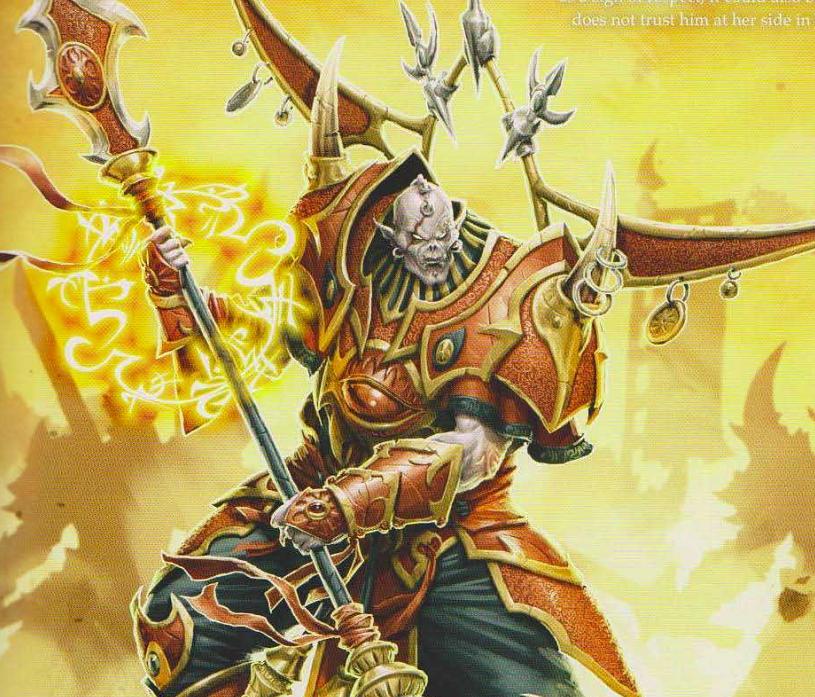
Lord Tyrant Hexeris is a master mortitheurge, wielding the power of life and death. The living, he believes, are just machines with thresholds for injury and pain. He tends to leave people who speak to him feeling tainted and violated, as he can see their immortal spirits. He was born to House Kurshon of Halaak, training with the Cataphract elites. However, he was also encouraged by his house's leader, Dominar Lokoda, to study mortitheurgy. When Vinter Raelthrone came to the capital, Lokoda joined him rather than risk weakening his house. Eight years later, though, he made the mistake of plotting against Raelthorne. As Morghoul rooted out treachery, Lokoda sealed his house. Hexeris offered Morghoul entrance to House Kurshon in exchange for rank under Raelthorne. House Kurshon was undone entirely, and Hexeris has never felt asny guilt over this pragmatic betrayal. He has risen to become one of the most dangerous tyrants in the Army of the Western Reaches. His soldiers are perfectly disciplined, knowing their master would kill them instantly if it helped him to do so. He enjoys facing the trollkin, whose resilience he finds very, very fascinating. He secretly dabbles in the art of the extollers to advance his ambitions, and he has implanted a sacral stone on his chest, bearing the soul of his great grandfather, the mortitheurge Javekk Kurshon. Hexeris can speak with this spirit, which teaches him powers never before combined in a single user. Archdomina Makeda is wary of Hexeris, but he doesn't mind - his works are beyond her comprehension. He was one of the first to doubt Vinter's claim to being Reborn, and he revels in having been vindicated. Makeda has entrusted him to supervise the western defenses of the skorne, but that might be taken as proof that she doesn't trust him at her side. His gimmick is enslaving and debuffing his enemies, and his feat lets him take control of anyone he kills briefly.
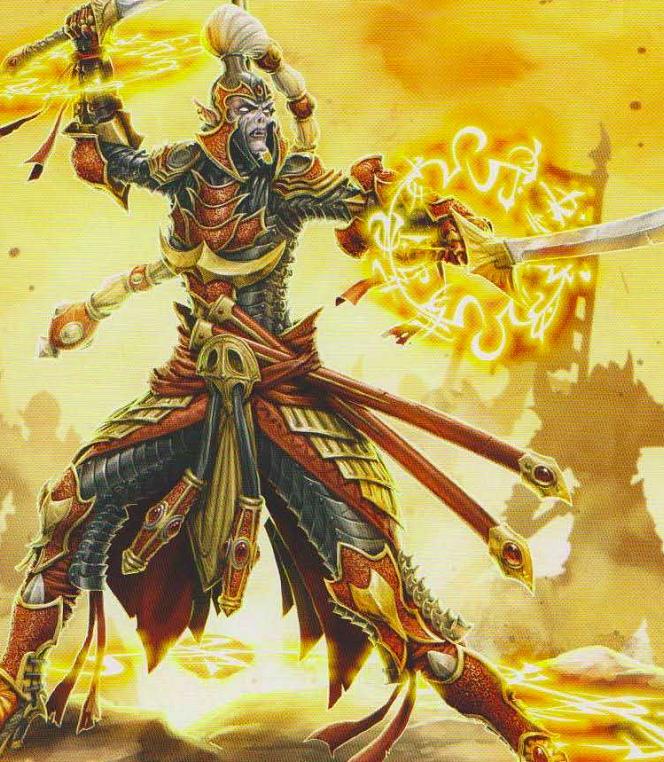
Archdomina Makeda commands the Army of the Western Reaches and is the finest general of the Skorne Empire. The success of the invasion rests only on her shoulders, and when the Conqueror made the choice to stay at his Stormlands fortress, he sent her west to lead his armies. During the First Unification, she defended the lands of House Balaash against Vinter Raelthorne. Three times, she led her army against him, tearing open is ranks, and at last she led one final charge. The two faced each other in abttle, fighting for hours. It was the strongest foe Vinter had ever faced, and she had never seen an enemy able to withstand her. At last, she was disarmed, her beasts slain. She awaited death, but Vinter turned away, saying that on another day, he would have lost. He offered her the chance to serve. She spent a few years rebuilding her house, and then stayed in Halaak to coordinate when he went to attack Corvis. When the betrayers sought to assassinate her and take over Halaak, she fought them off and sealed her gates, enduring impossible odds until Vinter returned. Makeda strictly obeys the hoksune code, and her ancestors' souls empower her army, which she plans to unleash on the humans. She is driven by boundless ambition, and her every step expands the Skorne Empire. Her gimmick is buffing her allies, and her feat keeps her forces going, allowing them to keep fighting despite fatal wounds.
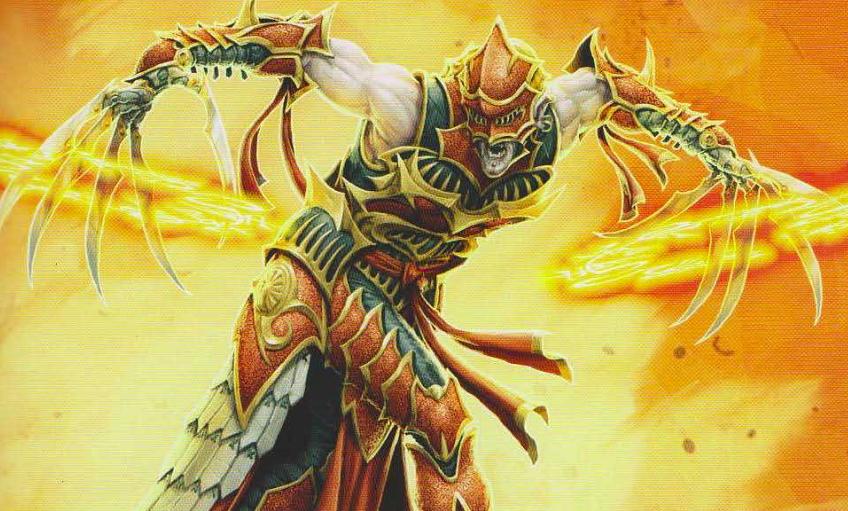
Master Tormentor Morghoul is a paingiver who knews well how to fight. He drives his beasts on, bringing out their great strengths and killing with his bladed gauntlets while evading enemy blows. He is exceptionally fast and knows all the ways to cause pain and death in the body. After building his reputation as a paingiver for hire, he was enlisted by House Vokuul in Halaak, hunting for plotters against the domina by torture. At the end, he forced his domina to choose a new heir but got her absolute obedience in her house. The Vokuul joined the defense against Vinter Raelthorne, but Morghoul did not, choosing to end his service when ordered to fight. Instead, he sold his services to the Reborn. He stayed at the capital when Raelthorne went west, uncovering the plot to overthrow him. He became the Walking Death of Halaak, moving about unseen and torturing people to gain information. NEarly a hundred died to his campaign. When the Conqueror returned, Morghoul went to him and revealed all he'd learned, including the locations of every secret passage and poorly guarded part of Halaak. This allowed for a very bloody and swift Second Unification, in which Morghoul assassinated the largest house leaders. A month long festival of pain followed for the traders, and silence was enforced on pain of death in the capital, so only Morghoul's symphony of screams could be heard. He has now been tasked with watching for treacery in Makeda's army, and he loves his work. His gimmick is pain, to allies and enemies, and his feat causes such agony that it severs the warlock/warbeast connection briefly.
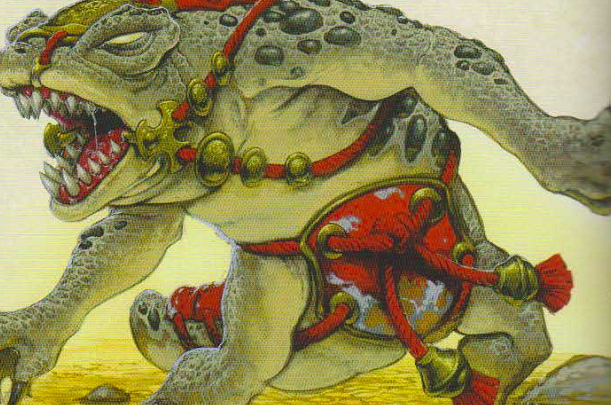
Few can with stand the gaze of the Basilisk Drake , one of the most dangerous creatures of the badlands. When the male of the species focuses its eyes on a foe, it unleashes a wave of shimmering power that makes the air act as if it were liquid. This wave of entropy causes terrible pain in the living, ripping skin and muscle from bone and roasting them. It can grind stone to dust and melt iron, and fundamentally what it does is sever the connections that keep matter together. Taming basilisk, however, is a costly and dangerous job that usually kills many beast handlers. Still, there was never doubt the skorne would find a way to weaponzie them. Captured young and trained properly, drakes are receptive to command reasonable predictable. They unleash their gaze only on command, though the paingivers have attached hooks tothe sides of the mouth to control them if necessary. Handlers have discovered that basilisk females fight even more fiercly in the presence, so they are often paired. The basilisk's gaze has made it notorious in eastern Immoren, but its jaws are no less dangerous. ITs claws are exclusively used for burrowing, as it prefers to live underground in the evening and emerge to sun itself by day. They are actually very cute when torpid, but deadly nonetheless. Their animus allows movement after attacking.
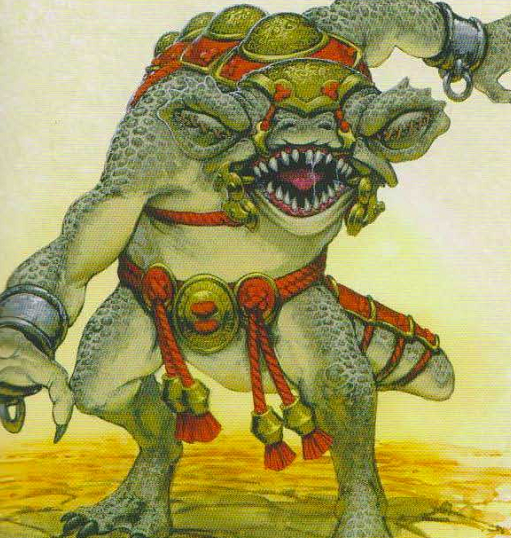
For centuries, the skorne only used the Basilisk Krea for breeding, not battle, but unleashing the female's true potential has been a triumph for the beast handlers. They found that they could sew the eyes shut to heighten the krea's other senses. A blinded krea pushed to rage builds up a critical threshold of energy around her body. This is not the same as the disruptive blast, however - rather, it slows those nearby, paralyzing them and halting projectiles. Kreas are violent-tempered and prone to lashing out, especially in the years after they give birth. Handlers suspect that their power is used in the wild to protect their young. However, they have become a favored skorne warbeast whatever the case, especially alongside the drakes. Their animus gives a measure of that paralytic power to others.
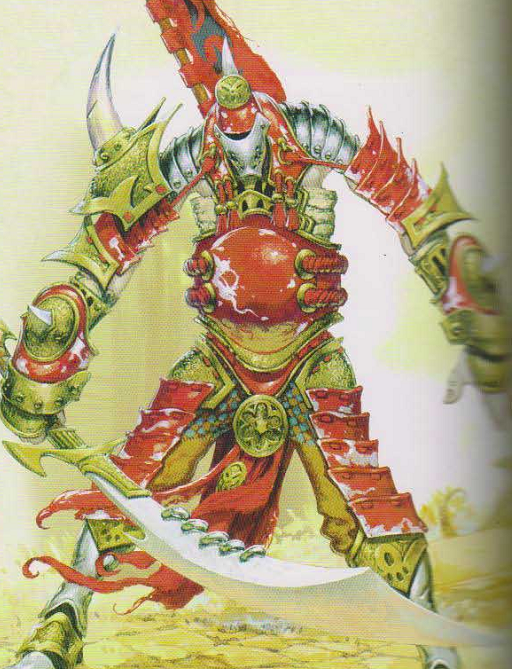
A Cyclops Savage is one of a brutish and primitive carnivore species of eastern Immoren that exists to hunt and kill. The skorne of centuries past were amazed that such dim creatures could be so sophisticated in battle, eventually tracing the skill to their ability to sense the future. Then they enslaved the cyclopes. They are captured as youths, then trained and conditioned to obey orders. They don't need much encouragment to fight or kill, as they are innately bloodthirsty - so much so, in fact, that they must be sedated with narcotics between battles. They are strong enough to kill with one blow, and in the wild usually use improvised clubs. Skorne handlers give them mastercrafted blades. Extensive experimentation over centuries has refined the strategic sections of the cyclopes' brains, amplifying their instincts and cruelty. Their limited sense of the future gives them amazing inuition, and their complex and sensitive eye is unusually perceptive, spotting ways to evade blows or defenses. Their animus grants that vision to their allies.
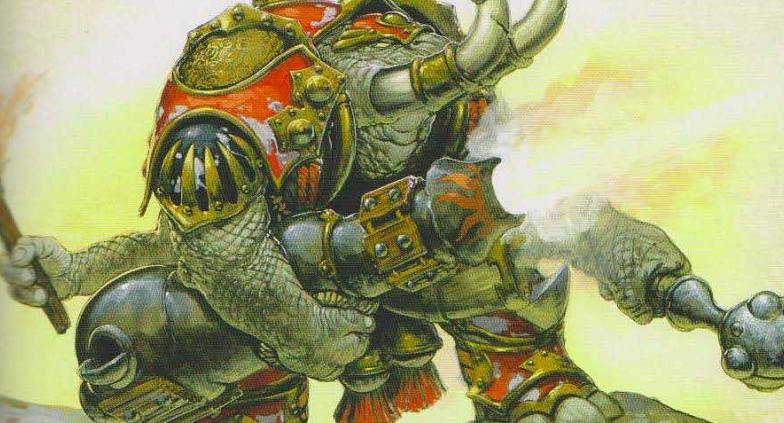
The skorne have used Titan Cannoneers for two centuries. Their four arms are particularly dexterous and good at operating the cannons. They are trained and conditioned ofr it, but their limited intellect is generally strained by the job and requires warlock supervision to do it consistently. In a fenzy, they'll revert to their instinct to just ram into things and tear them apart. Skorne warrior codes, the costs and the training time make titan cannoneers rather rare, used only by the wealthiest as siege weapons. Only in the last few decades have fortresses been built that can withstand these creatures, and under the Conqueror, all titan cannoneers were forced to join Makeda's army. Their animus weakens the enemies around them.
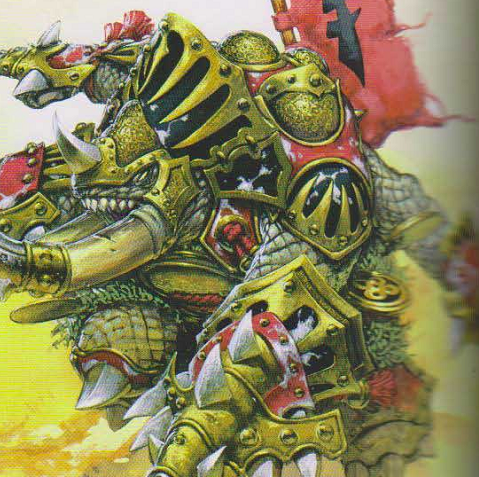
The Titan Gladiator is a wall of muscle, a four-armed bipedal elephant of a race that has been the favored warbeast of the skorne for millenia. They have the stamina to take any punishment and the strength to destroy most things. Their nervous systems are very well understood, and the handlers use barbed hooks at sensitive spots to goad them into rampages. Their armored body is their great weapon, using their huge weight to smash enemies around and pulverize them, at which point they can be pinned by the bladed war gauntlets. Titans prefer herds, where they occasionally get attacked by hungry predators. These hunters rarely come out well in the clashes, usually tonr to bits. Titans are normally docile unless threatened, but the skorne have encouraged their violent tendencies via cruel and painful torments. Their animus makes things really good at running around.
Next time: SKORNE SKORNE SKORNE SKORNE
Hordes Mk. II Primal
Original SA post Hordes Mk. II Primal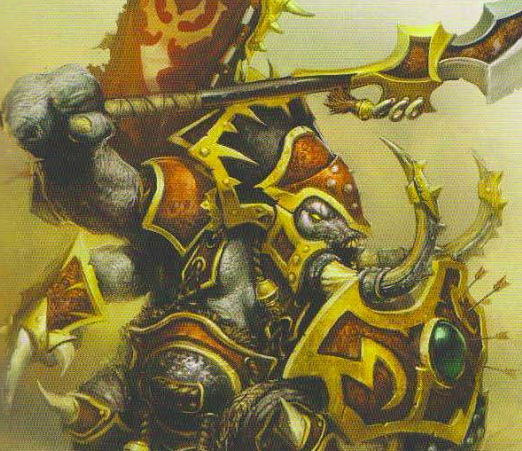
Where other titans rush in, the Titan Sentry is an unmoving wall on which enemies break. With their spears and halberds, they can take pretty much anything and retaliate nastily. Expert beast handlers select only the largest and most intelligent titans to be sentries. They are not innate warriors and do not use tools easily, but the skorne are persuasive. They are trained to use their weapons well, though few ever really near the skill of professional soldiers. Their strength, however, does not require that. Their intensive conditioning also encourages them to fixate on the largest perceived threat around them and eradicate it utterly before moving on. When a sentry picks a target, all distractions fade away.
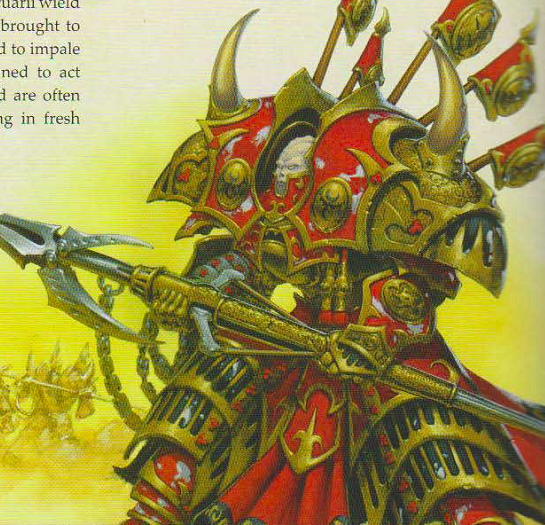
Cataphract Arcuarii are encased in thick lacquered armor, trained to handle the massive armor and picked for esceptional strength and endurance. They wield giant hooked harpoons that make good spears in close quarters and can be fired to impale and drag in foes. Tey act in concert to bring down even the mightiest prey and often work alongside beast handlers to capture wild titans. Not all skorne can aspire to be Cataphracts, as they take only the tallest, bulkiest, strongest and most enduring. Not every great house has many of them, as they are quite expensive to equip, but they are the greatest warriors of their generation. Their philosophy is about self-reliance and capability. The arcus was the great harpoon of Vuxoris, the creatore hoksune, and the madern variant of the weapon is essentially a very powerful but small crossbow firing a chained blade.
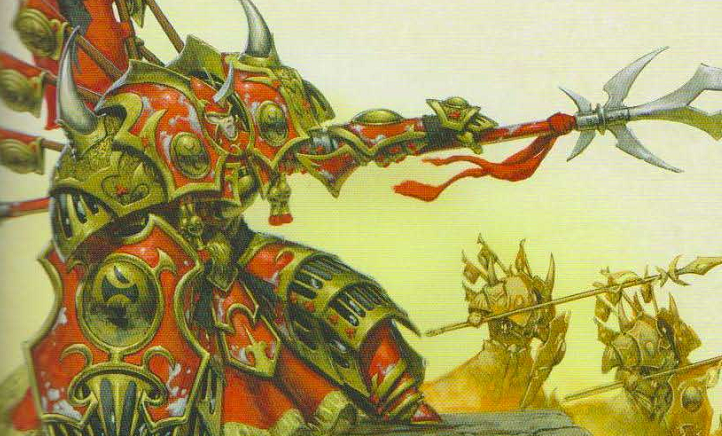
Catapract Cetrati use long polearms and interlocking shields in battle, embodying the skorne discipline and tenacity. They lock into formation and take down anyone that gets nearby with the war spears. For skorne, combat has intrinsic meaning, and the discipline required to join the Cetrati is welcomed as a worthy transformation. They spend years training to master formation fighting, to act as a seamless machine and more capable unit. They are descended from a millenia-old tradition, and many of the most exalted ancestors were Cetrati. The weight of their weapons and armor is immense, overlapping armor plate that would be too heavy for most to move in. Only the strongest skorne can join the caste, between that and their immense halberds and shields.
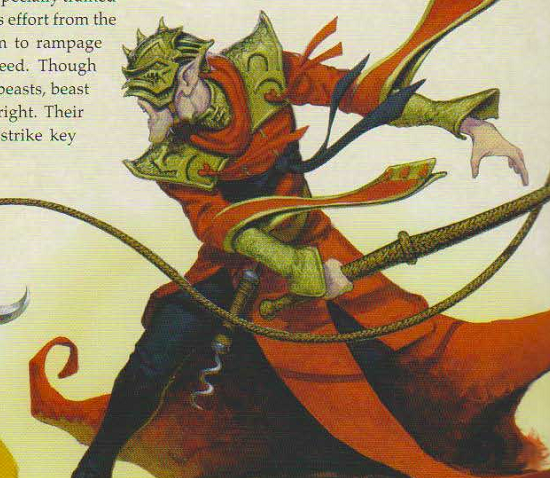
Paingiver Beast Handlers learn the anatomy of both skorne and warbeasts. They can bring forth immense effort fro mthe beasts in their charge, enraging them to rampage with increible strength. Their main job is to oversee the beasts, but they are dangerous in their own right, using their barbed whips to target arteries and tendons beneath even the thickest armor. The job of conditioning warbeasts is very dangerous, and requires lashes, pain-hooks, needles, blades and all kinds of drugs. The more experienced paingivers oversee other eager cadets, and must know both the temperament and physical limits of the beasts they work, to achieve best results for their effort. They can fool warbeasts into believing they're whole despite their injuries, and while some beasts do not survive being pushed that far, it's worth it if it means victory. They follow a good laid down by the first paingiver, Morkaash. Modern paingivers are obsessed with improving nad perfecting their art, forgoing house loyalties in favor of focusing purely on their skills, which are beyond petty politics. Even among the Western Army, the beast handlers do not fraternize with other castes. They wear distinctive masks to portray faceless resolve.
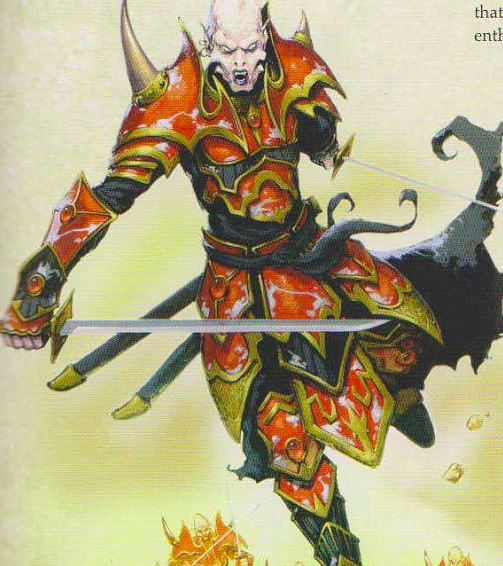
The Praetorian Swordsmen follow an ancient tradition of dual-sword combat. They are the backbone of all house armies as well as the Army of the Western REaches. They drill endlessly and observe the hoksune warrior code at all times. Only after victory in ceremonial combat can a warrior claim the rank of Praetorian, and failure means death or a lesser caste. EVen after becoming Praetorians, their only hope for glory is to fight well and survive. There is no early return for the wounded or rest for the weary. Tyrants keep them fighting as long as their flesh holds their bones together, and they are eager to capture slaves and territory to prove their worthiness for promotion. When Victor Raelthorne moved to the Abyssal Fortress, he ordered the dominars to send him their finest swordsmen. Those who passed muster were welcomed to the fortress and Makeda's army, while the rest were returned to their houses in shame. Even the least of Makeda's Praetorians are the greatest of their houses and proud of their skill. They are accustomed to linking honor with house, and have transferred that pride to their cohorts, with the various cohorts competing for spoils and glory.
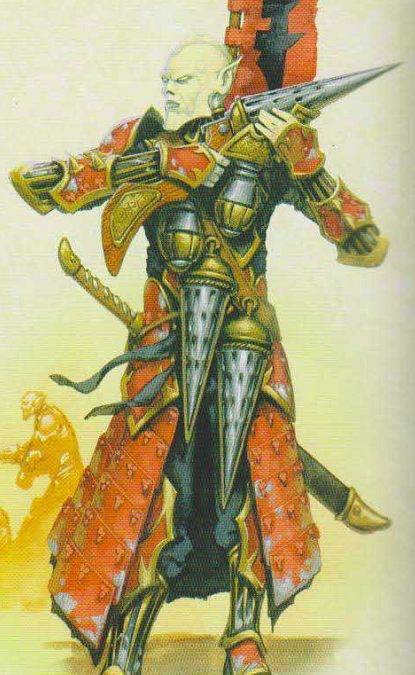
the Venator Reivers are relatively new. Skorne tactics once focused exclusively on closing with the foe for melee, and the earliest skorne ranged weapons were large, clumsy things meant more for walls or warbeasts. That's changed over the last century, as skorne wepaons were refined and the tyrants learned the value of a combined-arms approach. Vinter Raelthorne appreciated this and ecnouraged the recruitment and training of many Venators. The lowest ranks are the amigers, led by a dakar and organized in taberna, small groups that share a tent. They learn both how to use their reivers and also swordplay. These weapons are heavy and powered by gas, taking a great deal of finesse to use. Venators are below Praetorians in rank by hoksune rules, but have begun to earn more respect in battle with their needle-firing guns. They shoot bursts of flesh-rending, razor-sharp projectiles that can rip just about anything apart. The sound they make is unlike any western gun, a sort of metallic buzzing caused by its unique design. Reivers use cylinders of explosive gas to proepl the needles out of a spinning cone, and are slightly less complex to reload than most guns, so long as prepared cones are on hand. Reading the cones is intricate work that can't be done in battle, so venators carry several canisters of gas and several cones, each of which is loaded with hundreds of needles.
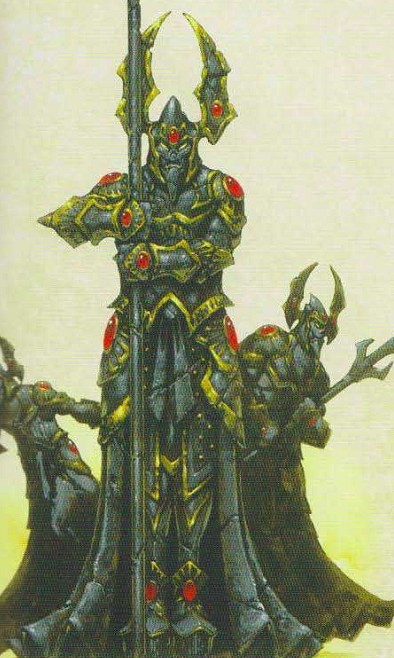
The essence of worthy skorne ancestors is placed in special stones, which are then sometimes fused into Ancestral Guardians . They watch over their houses most of the time, but some are used on the battlefield, where they offer immortality to any skorne alongside them. They can embrace fallen warriors and gather their essence, using it as fuel to move with great speed and strength. They are guided by the spirits of ancient heroes and fueled by the energy of the freshly dead, unleashing a flurry of skilled attacks. Each is a unique creation animated by a specific ancestor. They are expensive, but Vinter Raelthorne chose to deploy them with his invading army, which has increased the loyalty and resolve of the skorne. After all, their presence is a sign of ancestral favor. In addition to the central sacral stone in the head, numerous obsidian stones decorate the torso and limbs, attracting and crystallizing the essence of any skorne who dies nearby. These spirits gain honor in death and become revered companions to the exalted. They rank below full exalation, but it is a rare chance for a soldier to preserve their essence from the Void. Sacral stones are very tough to break, and when the guardians carrying them fall in battle, they are recovered and returned home to honor their houses.
Next time: Join the Blight!
Hordes Mk. II Primal
Original SA post Hordes Mk. II Primal
This history is presented both by Thagrosh, Prophet of Everblight, and the dragon Everblight itself, which can speak directly through him. When Thagrosh was transformed, agony consumed him, but he heard the voice of Everblight. Now, he is never alone, and his god lives within him. Once, his mind was slow and thick, crude clay for his master to shape. The touch of Everblight remade him, granting him genius, language skills, even knowledge of the secret tongue Tkra, spoken first by Toruk. His flesh still twists with the blight of his master. Searching Everblight's memories is like fishing in a bottless well. While the dragon is as a god to mortals, he is not the mightiest of dragons. However, his mind expanded beyond even that of Toruk, and what he lacked in size and raw power he made up for in cunning.
At the core of every dragon is an athanc, the pure essence of its being. The skin and bone is just a convenience, not a requirement. While the athanc endures, the dragon can't be destroyed. When dragons clash, the victim consumes the loser's athanc. It is not a thirst for power, but a desire to become whole. The unique nature of dragons is derived fro mthe athanc, a crystal so perfect that even its division only replicates its infinite complexity in smaller forms. It bears no similarity to any life on Caen, but is uniquely self-aware and alive. Each piece can unlock immense growth. The athanc was the first sentient entity on Caen, assuming the name Toruk in a language he divised long before clothing himself in flesh. The generative properties of the athanc may have seeded all life. Dragons do not need food, nor water, nor even air. But perhaps the athanc desired not to be alone, while knowing no lesser creature could comprehend it or stimulate its mind.
Perhaps that is why Toruk divided his essence to create other dragons. This decision is puzzling, even to Thagrosh and Everblight. The Dragonfather surely knew the mutable power of the athanc, that even the smallest fragment was supremely potent. Perhaps he sought to understand his own nature and test its limits. Perhaps, in his arrogance, he believed his spawn would instinctively obey him, as the creatures of Everblight's blood obey the Legion. Regardless, the fragments grew rapidly to become dragons, each more potent and willful than Toruk anticipated. They sprang from his essence, but owed him no loyalty. They rebelled. Everblight chose not to participate in this battle, lingering at the fringes that he might learn Toruk's strength and that of his siblings. Each of them was too inherently selfish to defeat Toruk. Unlike them, Everblight was made of the purest part of Toruk's athanc, the perfection of which allowed him to hide his presence in ways the others could not. Toruk destroyed many lesser dragons and the rest fled. In the centuries that followed, Toruk would chase them and annihilate them, reuniting their athancs with his own.
Everblight was not content to hide, though he was advantaged over his siblings in concealment and ability to restrain his blight. Other dragons inevitably despoiled the lands about them, but Everblight can consciously choose how his blight manifests. His siblings were lazy, content to use their bodies and never taking the time or effort to understand their power, but Everblight learned to extend his consciousness into the world, seeing without eyes and hearing without ears. He can enter the dreams of men and incubate his thoughts in them. Everblight settled in the lands of Morrdh, the first great human kingdom. The lords of that land had potent rune magic and necromancy, which Everblight found fascinating. He allied with Morrdh using his intermediary pawns, continuing to master his blight and study the knowledge of Morrdh. Eventually, his blight began to take hold in the schism between Morrdh and the gods of humanity, and after centuries of study, he achieved a subtle dominance over them, but it was not unnoticed.
Everblight admits to two mistakes in his life. The first was one of the few times he ever felt the emotion humans know as fear, for he had gotten too blatant in his manipulations. Toruk is a patient, persistent hunter, and he recognized the blight of Everblight among the Morrdh, threatening them through his vassals and convincing the uncorrupted lords to break their alliance. Everblight's agents revealed Toruk's arrival in time, and Everblight focused on escape. It was the first time he ever feared for his life, for Toruk could obliterate his athanc. He was terribly wounded, but fled to the lair of his sibling, Nektor, who foght Toruk and was consumed, causing the Dragonfather to give up his pursuit for a time. Everblight rested for centuries, recovering from his wounds. Toruk, meanwhile, reclaimed the athanc of Gaulvang. Everblight chose, due to his injuries, not to participate when Blighterghast gathered the surviving dragons to drive Toruk from the mainland. Instead, he watched. The other dragons interpreted Toruk's retreat to the Scharde Islands as defeat, but Everblight knew it was a scheme. So was Cryx created.
Blighterghast was the only dragon foolish enough to hold vigil on the islands, settling into the Wyrmwall Mountains to do so, while the others found lairs far from Toruk, withdrawing from the world to slumber and heal. By the time Everblight recovered, Toruk was busy training his lich lords and consolidating his island empire. Everblight moved north of Aeryth Dawnguard in the distraction, finding a lair in the Skybridge Mountains. He watched as the living gods of Ios departed, proving it a fertile land to corrupt and control. IT would be easy to hide his blight in the verdant forests, so far from Cryx. He began to extend his power into their secrets, trying to find a way to penetrate mortal shells with his blight. The elves remained ignorant that in their dreams, they were aiding him. The gateway to more direct interference was opened with the Rivening, asthe elves lost contact with their gods. The priests went mad, and their madness was music to Everblight, who borrowed beneath the city of Issyrah, linking into the abandoned fane of Ayisla, one of their goddesses. The Iosans of Issyrah suffered the worst of the Rivening thanks to his dream whispers, and none dared enter the 'cursed' fane.
Everblight lured the elves in to test the power of his blight on them. The soulless proved the best subjects, as their bodies were but shells without essence. The elves were compelled to take pilgrimages into the caverns, calling Everblight Ethrunbal, their god, and it is by that name the elves know him still. Only Scyrah's worshippers were protected, and Everblight discovered that was because she had in fact returned to Ios, hiding in Shyrr. It was unfortunate, but he could continue if he was cautious. The fact that she was weak and sick might prove useful - she might be devoured and replaced as the living god of Ios. It would have worked, had one of the blighted minions not wandered forth and attacked the people of Issyrah, causing them to spring into action. Soldiers descended into the caverns, ready for war. At first, Everblight let his Scythean creations fight them, but his anger at them grew, and he chose to fill his caverns with his breath, melting their flesh and obliterating them. However, they only became enraged, sending more and more soldiers. Everblight admits to madness, leaping from the fan to erupt upon the city. It was a mistake, but glorious carnage. It had been long since he could unleash the rage of Toruk, which burns in the blood of all dragons. It was beautiful, indulgent, and he could not stop himself. Unfortunately, the elves had numbers, and even insects can be problems in number. They gathered wizards and myrmidons, sacrificing themselves to maim Everblight's wings. He was too drunk on power to see their plan, and he was undone, collapsing on the ruins. His athanc was torn loose and he was defeated.
Thus was Everblight imprisoned. He could not be destroyed, but his athanc was locked in a warded vessel. His awareness remained, able to see beyond his prison, and he watched the elves closely, seeing the prophecy that he must be placed at the 'top of the world.' Such vague assertions are a weakness of mortals interpreting the divine, and Everblight saw a possibility for distortion, if he waited. The elves initially hide him on Mount Shyleth Breen, where he raged impotently for years. After the dragon-rage faded, he began to think clearly. His power was reduced, but his mind was not, though his range of awareness was. He projected a sense of doom on the ruling council of Shyrr. It took decades, but time is meaningless to a dragon. At last, the Iosans began to reexamine their closeness to the athanc and debate about the nature of the prophecy. Due to the parnoia Everblight caused, they sent heroes to take the athanc northwest, to the Shard Spires. Everblight tried tro corrupt the elven heroes, but it was not easy. He killed them, one by one, with hazards around them, but the last of them succeeded in his task. The dragon felt the urge to give up and slumber, but fought it. As a raw athanc, he was intelligent but in danger of entering a trance, allowing time to pass too quickly. That would have been surrender. Some dragons fall prey to this sleep even in flesh, and that is why they are so slow to act. Everblight's mind was a raging tempest compared to theirs, however, and he refused to give up his ambitions after one defeat.
He fought to retain his consciousness, and became aware of the Nyss tribes near his resting place. They shared blood and god with the Iosans, frozen and dormant. Everblight realized he could use his earlier research on them if he could just reach them, and for decades he turned his attention to studying them and planning. To break out of his prison, he needed a congruence of events, most notably the proximity of a weak mind that would let him make contact through the wards. Thagrosh does not mind that the ogrun he once was met that need, for his life was without meaning. Everblight sent whispers into Thagrosh's mind, compelling him to climb the peaks and retrieve the vessel, breaking the seals on it. Everbliht, however, chose not to reform as a dragon, regardless of how much he wanted his former glory. Instead, he forced Thagrosh to take the athanc and drive it into his chest, connecting them tangibly. He warped the clay of the ogrun's mind, rebuilding Thagrosh entirely to suit his needs, flooding his body and transforming it. However, he knew the inferior shell of an ogrun could not contain his entire being for long. It elevated Thagrosh, but was a refined poison he could not endure long. Everblight had to act quickly.
Thagrosh became the avatar of the dragon-god, obeying his will and recovering the ancient weapons made in the time of Morrdh, most notably the blade Rapture, made for Everblight's champion. It is a potent weapon agianst dragons, but had been forgotten for many, many years. Still, Everblight's blood was in it, and he could sense its location in the Nyschatha Mountains when his athanc passed near it. Thagrosh became its first wielder in two thousand years. With the blade, Everblight could divide his essence without spawning new dragons - a power unique to him, due to his centuries of mastery over his nature. Not even Toruk realizes Everblight can do this, or that his blood can generated blighted monsters to fight for him, mirroring his old draconic body. Each shard of athanc also imbues the power to command blight-magic as sorcery. As a mortal, Thagrosh was too weak despite these gifts, and the loss of Everblight's body had still reduced his strength. However, he knew the location of a dragon in the mountains, and if they were sensed before they had gained enough power, it would eat them easily. That is one reason Everblight chose not to fully reform, for it would leave him vulnerable. First, they needed the Nyss.
A great gift came when the sorceress Vayl Hallyr joined them of their own free will, for she desired power and immortality by magic. She had reached the limit of what she could do herself, but knew that EVerblight could raise her further. She also had knowledge of her people that Thagrosh did not. Once Vayl received her athanc and joined the mind of Everblight, events were simple. They new where the NYss tribes were, the weaknesses of their leaders, their politics were laid bare. Defenses opened to them, and Everblight laired his blood and essence into their wells, that Thagrosh might awaken them. As with the Morrdh, he used his ability to control his blight to his advantage, and with Vayl's assistance, many Nyss were corrupted without a single weapon. Once the blight took them, they were Everblight's utterly. By the time the NYss elders noticed, it was far too late. When open war came, the minions of Everblight were enhanced and ready, transforming those who surrendered and slaughtering those who did not. The only fortress that could stand against them was the Fane of Nyssor, guarded by the Aeryn tribe. Everblight's taint could not touch that sacred place, thanks to Nyssor, and they escaped underground as others sacrificed their lives to guard them. It is annoying that Nyssor escaped, but it is temporary. Few NYss without the blight survive now, and they are broken. Everblight will consume their god in time.
The elven blood of the Nyss reacted well to Everblight's blessing. It suits their nature and exalts them. Ogrun have also been brought into the fold, and nothing can stop the blight army's advance, not even the foolish blackclads that stand in the way. They have never defeated even one dragon! Dividing his essence has amplified the power of Everblight's blight by magnitudes, and he will soon create a domain rivalling that of Toruk's sixteen centuries of work. The Legion of Everblight wasted no time in finding dragons to add to Everblight's strength, particularly when word came of the resting palce of Pyromalfic, leaked by one of Toruk's subordinates as part of some scheme. Everblight is convinced that the pawn didn't think he could react so quickly, not understanding how he could function without a dragon body and trying to verify his identity. However, Everblight did not need flesh to feast.
The Legion went to the Castle of the Keyes, where Pyromalfic hid, annihilating all in their path. Pyromalfic, weakend by time, rose to battle but fell quickly. The largest part of Everblight's athanc, stored in Thagrosh, devoured the mind and essence of the dragon, who will be but the first of many. While the Legion bows to Thagrosh, his form is meaningless. Mortal flesh, even so refined, cannot contain and express his power. Some day, Everblight will reclaim his full and terrible form, bit not now. Until then, his mind will be dispersed among his generals, spreading like fire across the world. No matter what the distance, they can communicate with ease, and by the smallest effort, Everblight can see through their eyes and those of all he has chosen to blight. No other dragon knows what he does, many in one and one in many. There are benefits to having your own body, to be sure, but Everblight has always favored intellect over brawn, and in that regard he does not mind his current form. His foes cannot ever confront or defeat him, for he is in many places at once, and he is now a god surpassing Toruk in every way. His tide engulfs his enemies and takes their strength. What his blight touches, he controls. There are no limits to what he can do or how he can grow. By freeing his mind from flesh, the Nyss have shown him how to conquer the world, and they will be rewarded by being brought into Everblight's dominion and sweeping the land as a cleansing wind. Everblight will devour the gods, Toruk and, eventually, the world.
Next time: I speak for the Legion
Hordes Mk. II Primal
Original SA post Hordes Mk. II Primal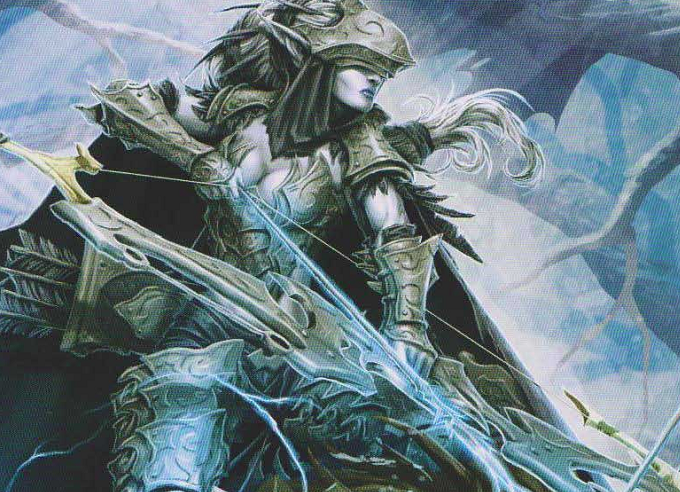
Lylyth, Herald of Everblight , was once a hunter and archer of the Voassyr tribe of Nyss. She was a champion, and her stern father had high expectations. She trained day and night, but things changed for her shard after the death of a human trapper made the local human town violent. Khadoran woodsmen ambushed a pair of Voassyr hunters and tore them to bits. One of them was Lylyth's father. It was her who discovered the carnage, and she snapped, stalking and killing the woodsmen over a week, then attacking the town, killing anyone she caught outside. She returned to her shard and roused them to vengeance, declaring a blood hunt on the humans of the mountain. The rest of the tribe distanced themselves fro mthe shard, offering them no aid as they attacked village after village. Thagrosh found them shortly after he was transformed, watching them fight a savage band of humans called the Vindol. Both sides were slaughtered, leaving Lylyth the last one, mortally woudned. Thagrosh offered to save her and give her power. She agreed, weak and tired, and received a shard of Everblight's athanc. It was an excruciating transformation, but it gave way to acceptance. The blight poured through her. She realized she did not need her eyes to see, that the athanc would see for her, and indeed she now goes masked so her eyes see no light, as that feels wrong . She has learned what it means to be the Herald of EVerblight, stalking her master's foes before the army, striking in enemy territory. Where she goes, blight and bodies fall. Her gimmick is debuffs and curses, and her feat allows her to control her army directly, boosting their attacks.
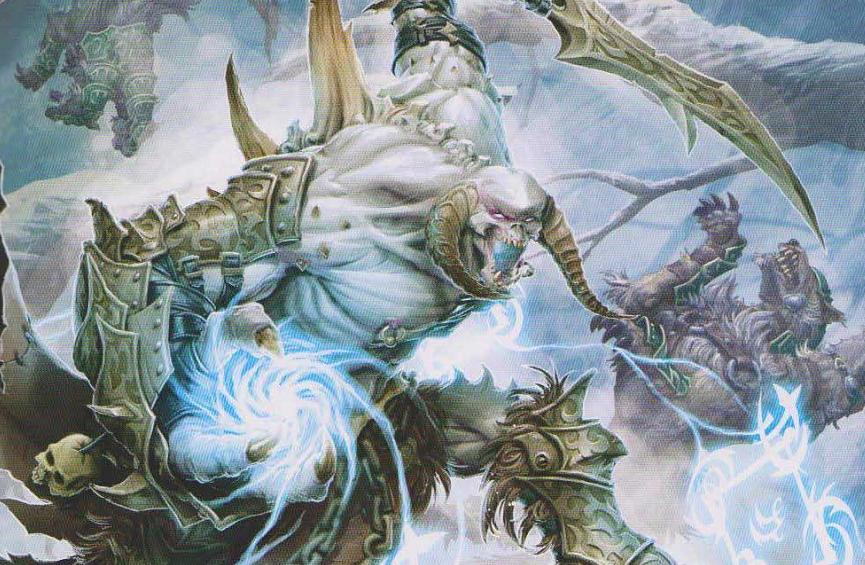
Thagrosh Hellborne will forever be remembered as the abomination that unleashed the Legion of Everblight, as Thagrosh, Prophet of Everblight . The blight nearly destroyed the Nyss and now marches for the lands of men, with him at its head. Even before his transformation, Thagrosh had a hard life. Khadoran brigands enslaved his village, and he spent his formative years in darkness and backbreaking labor, watching others die. His rage eventually led him to kill a slave keeper and escape. Fevered whispers and nightmare visions led him to the tallest mountain in the north. Barely conscious of his actions, he climbed the peak with bloody fingers and broken nails, finding the sealed athanc of Everblight. He mutilated himself with a skinning knife to accept the dragon's blessing, driving the athanc into his own heart. It transformed him into a vessel for the dragon's presence, turning him into an abomination that was no longer ogrun, twisting his body and blood. His mind expanded massively, and now he and the dragon-god seem to mix together. He has gained potent sorcery from Everblight, and speaks with the dragon's voice and will. He serves Everblight's schemes, corrupting the Nyss and awakening them to their destiny as Everblight's chosen people. He makes servants for his master by embedding athanc shards into warlocks who serve the dragon's will, terrorizing Caen like no other. His gimmick? He is big and fucking terrifying, he can channel Legion animus very easily, he can make other allies big and terrifying, and he can blow shit to hell. Plus, with his feat, he can revive destroyed warbeasts.
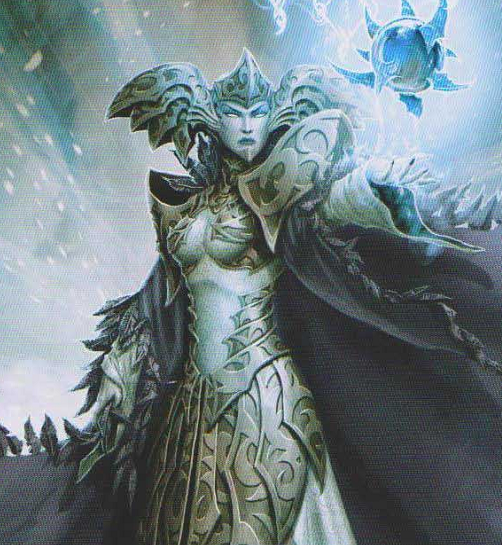
The destruction of the Nyss can be laid at the feet of Vayl Hallyr, now Vayl, Disciple of Everblight . She gave the Prophet the start of his army by corrupting thousands of her people. Unlike most, her body has changed little with the blight. Some say it's because she was already a monster. She manipulated the Fane of Nyssor before her corruption, learning the sacred Aeric language and feigning piety to gain access to their library, but mocking and blaspheming against them when she was offered membership in the clergy. She was banned from holy ground. She organized the Hallyr tribe into an army to claim territory, vanishing anyone who spoke against her. Her attacks on other shards and NYss shrines led her tribe to be edlacred outlaw, but no one was able to unseat her. EVen her followers thought her insane, but few would speak against her for fear of punishment. She enhanced her gift of divination with a sphere of crystal spiked with blades, able to leech heat out of the air itself. By peering into it, she foresaw the coming of Everblight. She could have warned the Nyss, but chose to join him for power instead, embracing her transformation in full. Her betrayal let Thagrosh assimilate the Nyss with amazing speed by poisoning the water supply. By the time Thagrosh arrived, Vayl had prepared patterns of blight energy keyed to his words. When the Nyss realized the threat, she fought htem with her magic. Despite her best efforts, though, Nyssor and his high priests escaped. She continues to be secretly haunted by that failure, as Nyssor sometimes appears in her dreams to condemn her. She is obsessed now with destroying the god, to escape the final piece of guilt that still lurks in some corner of her heart. Her gimmic is ice and beast control. Her feat lets her move her allies quickly across the field.
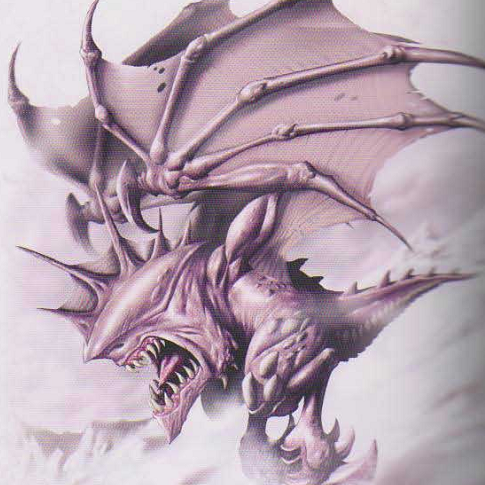
The Legion has lesser warbeasts - creatures weak by most standards, but easy to create and more numerous than normal warbeasts. The Harrier is one such, called forth from the dragon's blood. They resemble the ravenous shredders, but lack their overpowering hunger. Instead, they fly ahead of the army, terrorizing from above. Their value is in speed and maneuverability, testing the flanks of the foe. Like all dragonspawn, they have no soul despite their bestial intellect, and only mimic life. Their sole purpose is to serve Everblight's warlocks. They are patient and dedicated, sustaining themselves for long periods in the air without being tired. They have no eyes, but are immensely accurate regardless, thanks to their keen senses. They can find a living creature from any distance, as if guided by an unseen hand. In ancient times, Everblight used them as scouts to find lairs. Now, they are just another weapon. Their animus grants others the same accuracy they enjoy.
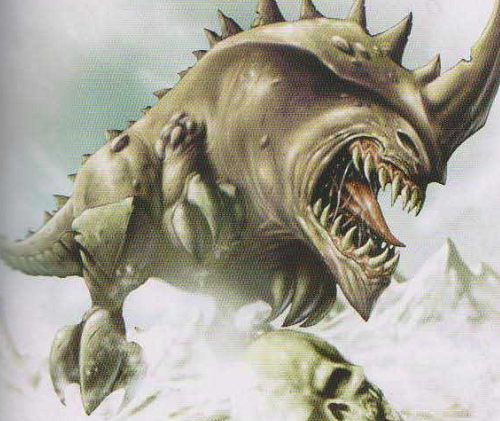
The Shredder is the smallest and simplest of EVerblight's spawn. They are driven by a ravenous hunger, latching onto and devourin any foe they see. They grow to full size very quickly, their appetites driving them to add to their mass by consuming whatever flesh they find. Their metabolism goes into overdrive on maturity; the more they eat, the more active they get. They are naturally prone to cannibalism in moments of frenzy, but that can usually be controlled, and they fight well in packs. They are, like all dragonspawn, blind. Their heads are almost all mouth. They make up for it with hyperaware senses, especially scent and an ability to register changes in air pressure by sound and air movement. They recognized blighted energies innately and are in awe of their master's athanc, so they will never harm any of EVerblight's warlocks, no matter how enraged they become. Their animus gives a minor boost to defenses.
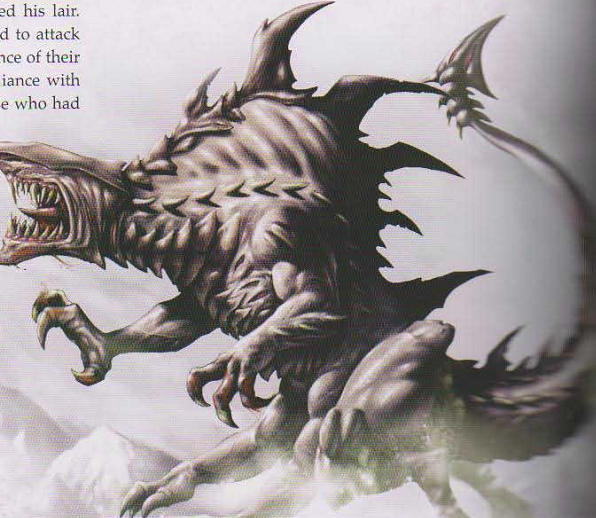
The Teraph dates back to Morrdh, when Everblight needed guardians for his lair. The teraphim burrowed through the earth, waiting to attack intruders and serving as assassins for Everblight Morrdh allies. They are serpentine, six-legged dragonspawn with poison-barbed tails. While underground, they accumulate a mass of sulfurous and acidic fluids in their gullets that erupt in a geyser of black flame and ash on exposure to air. They can also tear things apart with their teeth, using their claws only to burrow and move. Their sense of smell is good enough to locate any living thin in a hundred yards, and underground they can sense the vibrations of footsteps. The teraphim are essential to Legion defenses, strategically placed like living mines. Their animus allows things to attack those who come too close.
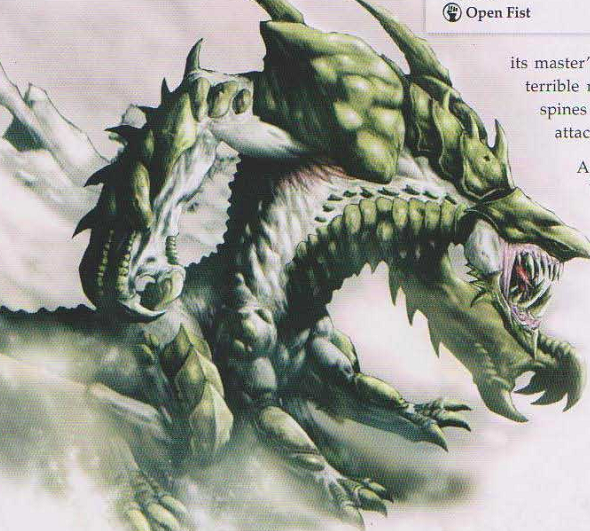
The Carnivean is designed to slaughter. They were rarely used in the ancient days, even in Morrdh. Their rearmost four limbs allow a steady stance and rapid movement despite their immense size. The much larger upper limbs end in huge claws and have flesh-tearing spine ridges, as does most of the carnivean's body, along with armored cales. If ordered, it can undergo a mutagenesis to erupt spines from its body, deflecting attacks and impaling foes. They can also vomit forth naphtha to melt flesh and ignite nerves, rather like dragonfire. Their animus grants their spiny growths to allies, as well.
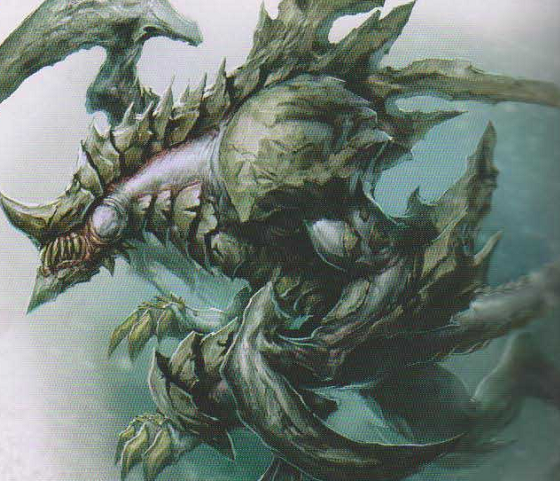
The Scythean is Everblight's most brutal and simplistic spawn, and his favorite guardian and executioner. It destroys all who oppose his will, tearing foes apart with an insane fury. In the past, scytheans were last used in the tunnels under Issyrah to fight the Iosans. They are deadly in tight spaces, needing no light to spot their victims, and they seem to enjoy slaughter, which often entertains the blighted Nyss. Their animus grants their preternatural viciousness to their allies, helping tear through defenses.
Next time: Blight angels.
Hordes Mk. II Primal
Original SA post Hordes Mk. II Primal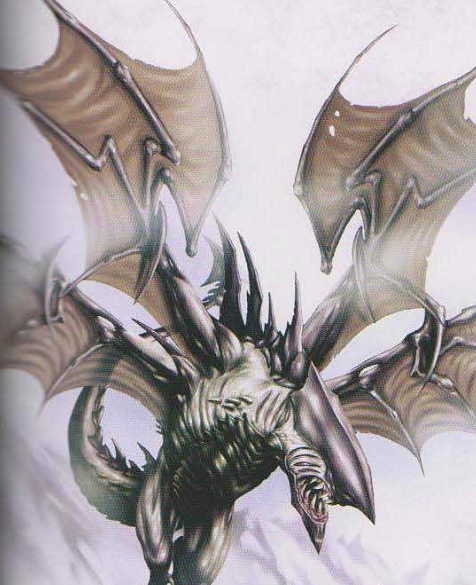
Everblight uses the Seraph as a messenger of death. The seraphim are an embodiment of his deadly elegance, and he is glad to be able to create them again. They are deceptively slender, flying with powerful wings that stream blighted energy in a distorted contrail. They use that energy to warp distance around themselves, manipulating those caught in their slipstream to move them around. Their tails are viciously barbed, able to pierce steel and dripping poison. Seraphim sense their environment by detecting motion. They avoid melee if possible, preferring to belch incinerating miasmas of blight ash from a distance. It sears and melts flesh before disintegrating it, and they are able to make long strafing runs with it to take out entire formations. Their animus allows others to give others the same warping slipstream.
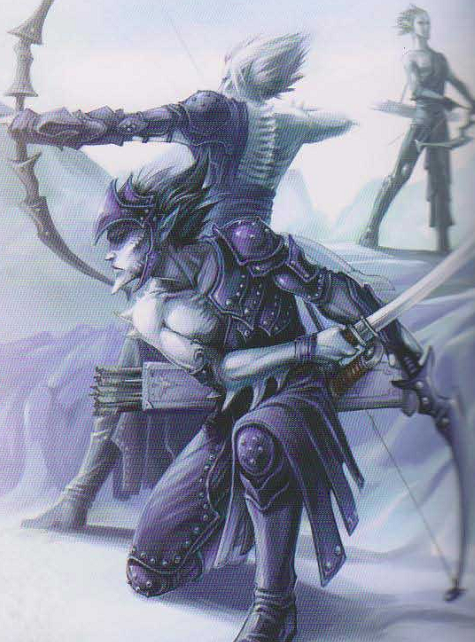
The Blighted Nyss Archers are an example of the easy corruption Everblight had among the Nyss, their anatomy refined to reflect his will. They are now eager accomplices to his schemes, and the Voassyr and Raefyll hunting tribes have been altered to be superior archers. They unleash hails of arrows on the enemy ranks before others sweep in, and they can launch more arrows than should be possible. Archery has always been vital to the Nyss elves, for both war and survival. Now, the hunters are assassins, murdering with cold precision. Most of their culture and psyche have beens tripped away utterly, leaving only the most brutal and merciless qualities of the old Nyss. They delight in slaughter, but they do still take pride in their skill and craftsmanship. Each archer customizes their composite recurve bow to their strength and height exactly, making them out of carved bone or polished wood laminated over bone using animal glues. Their bowstrings are tendons and are exceptionally strong.
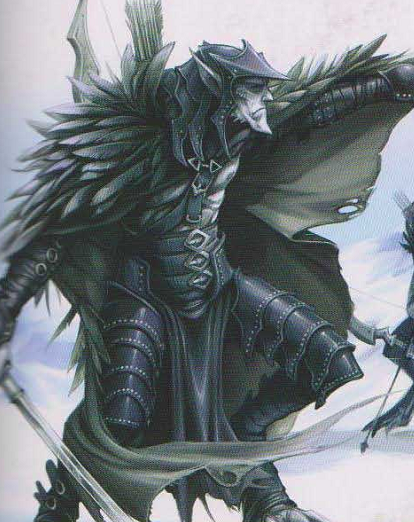
The Blighted Nyss Striders are scouts sent ahead of the Legion to spy and assassinate snetries. Their transformation has reduced them to bitterness, but enhanced their killer instinct and talent for murder. They sadistically kill animals and unarmed innocents they meet, enjoying the deaths because that is one of the few emotions they retain. They have slaughtered entire villages, just to satisfy their hunger for death. The blight has twisted their legs, deforming and lengthening them, reshaping the joints. The bones of their feet fused, their nails hardening into claws. This allows them to run at full speed across solid ice, deal with underburhs and logs and even vault streams. They silently and instinctively approach from stealth, striking from blind spots. Enemies fleeing the Legion are quickly overtaken by the striders, who toy with their prey before making the kill. They do retain one vestige of their old livs: after each slaughter, they ritually dip a single raven's feather in the blood of each kill, wearing a cloak made of these feathers to remind them of their role in the many deaths of the Legion's passing.
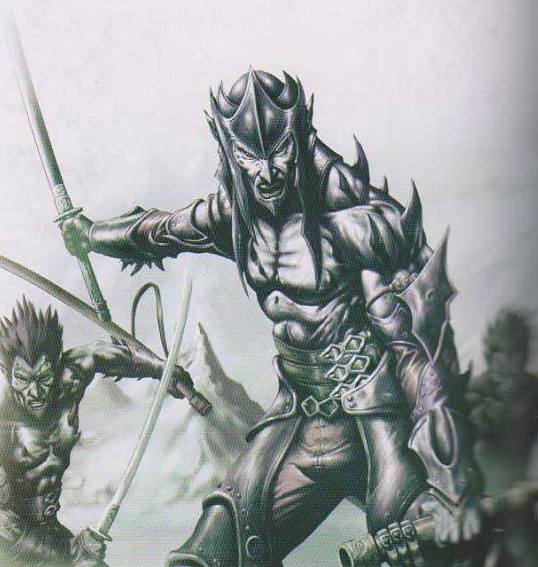
The Blighted Nyss Swordsmen were the first hint many Nyss had that their doom was coming, watching their own attack with long claymores. All the fat has been trimmed from these Nyss, their flash barbed, and their emotions have been utterly wiped away, that they might ignore begging for mercy. They are brutal and precise, butchering anyone they are turned against - Khadoran, Nyss or trollkin, it doesn't matter. The only thing they retain is a close tie to their swords, the traditionally sacred weapons of the Nyss. In battle, they are in perfect union with their claymores, without fear of death. They do not even wear armor. They feel no rage or cruelty - just an empty, serene calm. They revere their blades more than their lives, collecting the weapons of the fallen after battle. They consider their claymores to embody their essence, refusing to abandon any of them. Their only satisfaction in life, in fact, is knowing their swords will outlast them. Between battles, they can often be found staring at their blades, as if recapturing a faint memory of their old lives.
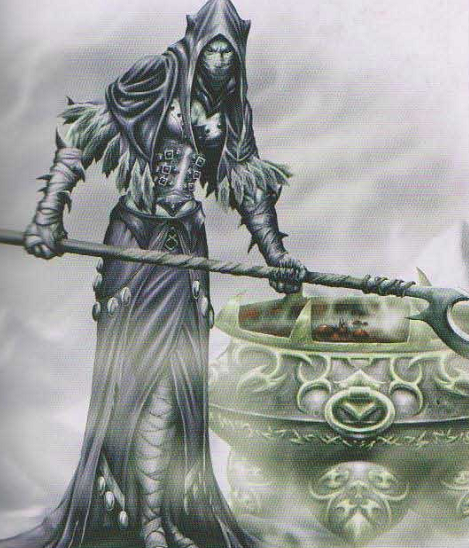
The Spawning Vessel is guarded by cowled acolyths, who prowl the battlefield collecting corpses to fling into their cauldron of charnel. They simmer, then the cauldron bubbles and births dragonspawn, creating lesser warbeasts to serve the army. The vessels are wrought iron, made by the ogrun slaves of the Legion and inscribed with profane runes in the tongue of dragons, to give them the essence of unchecked growth. Their power is awakened by dragon blood, allowing them to create dragonspawn, mixing pure draconic essence with the flesh and blood of the dead. The acolyths are all blighted Nyss females bound by oath to perform the ritual;s and sacrifices needed to ensure the spawn continue to be made, embodying the proliferation of hte Legion. The battlefields they serve at are eerie - covered in blood and trackmarks, but no bodies at all.
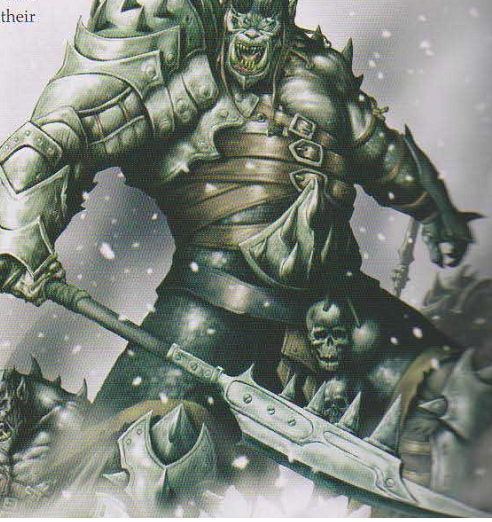
The Blighted Ogrun Warmongers have been deformed and augmented at the same time. They are twisted for slaughter, constantly envisoning mad hallucinations at all times. They cannot sleep, and often chant to themselves or stare obsessively at things no others can see, their faces twisted by anger. Only battle brings them release. They feel no sense of self-preservation and feel no pain. They stink of death constantly. Everblight has, now that he's conquered the Nyss, been focusing on the outlying ogrun tribes. Thagrosh knows where the enclaves are, having been born among them, and feels neither mercy nor malcie towards them. The warmongers both respect and fear him, and their leaders claim they are his apostles. The Nyss are cool towards the ogrun, barely tolerating them and avoiding them for their habit of murdering anything they see, friend or foe. Too many Nyss have stayed too close only to be chopped to bits by their war cleavers.
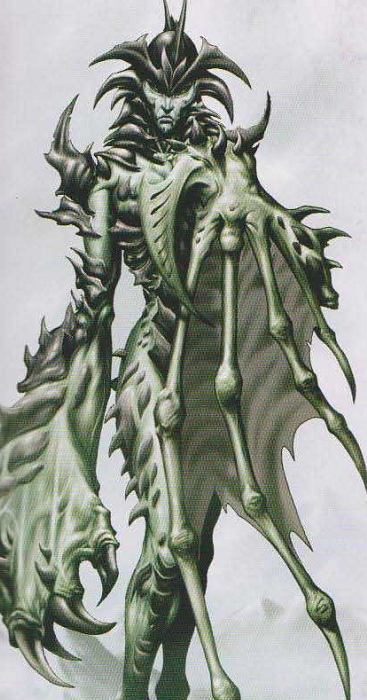
The Forsaken are warped beyond recognition by the dragon's touch, and their very presence is inimical to life. They feed on battle misery and can mimic their master's aura to generate a mantle of blight that overwhelms the living just by proximity. They are as sacred to the Legion as they are horrifying. They can feel moments of lucidity, but it's rare, and they are all insane, perhaps due to the awareness of the conflict between what they are and what they once were. After all, they lack the blind resolve gifted to the other Nyss, who were more subtly blighted. In their saner moments, they remember the destruction of their race and see themselves responsible. No method guides the creation of forsaken, but they seem to be created more frequently within the aura of blight surrounding warlocks and their athancs. Each is a unique aberration born of one overwhelming mment in battle, a fluke blight eruption. Even the most fanatical of Everblight's minions fears being twisted into a forsaken. Many display draconic features, such as vestigial wings, thick scales, claws and serpentine tails.
Next time: Minions!
Hordes Mk. II Primal
Original SA postI think the art director just likes hot blue chicks in black armor.
Hordes Mk. II Primal

The Minions entry is written by Professor Viktor Pendrake, a Cygnaran scout. He has been watching for hirelings in the species of the Bloodstone Marches. They're not really the same as human mercenaries, but they are similar. However, there are key differences. Mercenaries have codes of conduct since before the Orgoth came, and while they don't all honor them, the system of character is well established. No such safeguards exist to ensure the fair treatment of hirelings. Some groups, like the trollkin, will make reasonable bargains with the farrow or bog trogs, while the blackclads will sometimes bargain and sometimes coerce. Sometimes, the more marginal species will risk alliance for a better future. But then you have the skorne, who function on slave labor. They will not bargain - they just enslave anyone that seems useful. Their arrival has changed how several groups act, as has the rise of the draconic blight in the north. That army also uses slaves, even more disposably than the skorne do. The most affected species by this are the farrow, the gatormen and several gobber species, including the swamp gobbers. There will be others. They are not inferior, despite being unrefined, and there are humans among these creatures too, seeking coin in the battles of the non-human armies.
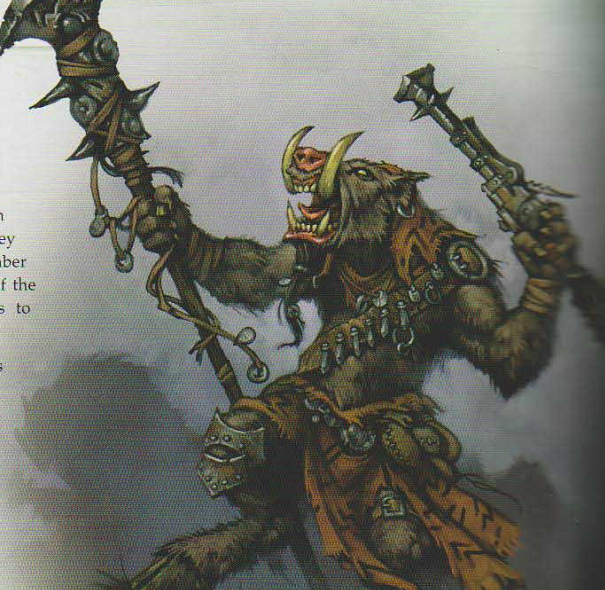
Farrow Brigands
are relatively common in eastern Cygnar, southern Llael and the Marches. The cany be found among the Circle Orboros, the Legion of Everblight, the Skorne and the Trollbloods. They are half-man, half-pig creatures despised by human communities, who often spread rumors of their piggish habits and origins. It doesn't help that many farrow prey on remote villages, lumber camps and merchants. However, they are tenacious, tough warriors that, when given rifles, are as good as many soldiers. Several large tribes have come down from the Dragonspines to profit from the chaos of the Second Thornwood War, seizing lost weapons caches in the chaos. The farrow have ties to the trollkin kriels and the Circle, as their religion strongly resembles the Dhunian faith, and shamans can find common ground, bartering for service with food, powder or protection. The Legion and the skorne have noticed their use, and have been known to enslave them as cannon fodder.
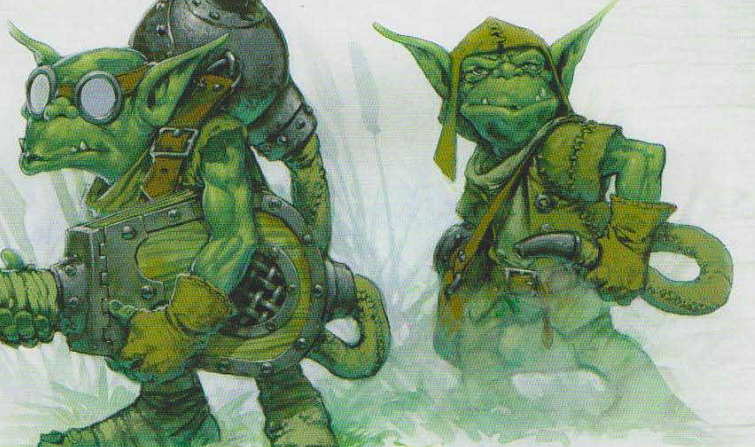
Swamp gobbers are a clever, hardy race in the bogs and marshes, and
Swamp Gobber Bellows Crews
can be found among the Circle, Legion, Skorne and Trollbloods. They are most numerous in the Thornwood and Widower's Wood, and are notable for producing brewed liquids that they can combine to produce dense fog, which they have used in an ingenious fog-spreading contraption that makes it hard to see anything more than a few feet away. Gobbers are about half the size of a human and have chameleon-like skin that changes color to blend with their surroundings. Most are quite intelligent and have a knack for invention and alchemy, but swamp gobbers lack the sophistication of their urban peers. Recent warfare has encouraged them to seek food or weapons for their services. Their prices are reasonable, and both the trollkin and druids have hired them. However, it's put them in harm's way, and some of their tribes are captured by the skorne and Legion. The bellows crews prefer not to fight if possible, instead using their fog to protect allies.
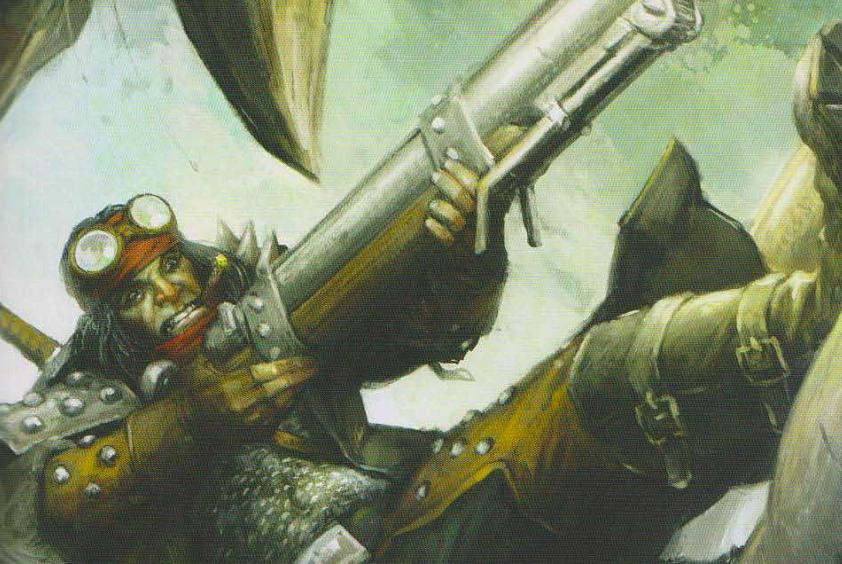
Alton Ashley
is both mercenary and minion, willing to work for Cygnar, Khador, the Protectorate of Menoth, the Circle Orboros or the Trollbloods. He is a rugged man, an exceptional hunter and braggart who is thrilled by the dangers and prizes of war. Wealth isn't his real motivator - he likes it, and he charges heavily, but the thrill of hunting the most dangerous creatures in Caen is what really drives him. He seeks out danger, and loves the excitement of the hunt more than anything. His accent marks him as Cygnaran, but he's been all over, tracking Blighterghast's spawn in the Wyrmwalls, evading dire trolls in the gnarls, hunting frost drakes in Khador. The only place he's seen with any regularity is the saloon Sanity's Bastion in the town of Ternom Crag, east of Cygnar. He has a reputation for obnoxious boisterousness, and he has few friends, but is respected by many for his skills, despite having little formal training. His immense rifle, Bucking Jenny, has a huge barrel designed to pierce even the thickest hides, and it's bipod-mounted for better aim from the underbrush. Ashley is also proficient with a sword, if needed. However, it his knowledge that makes him deadly - he's faced more dangerous creatures than most Nyss rangers see in a century, knowing their habits, strengths and weak spots. He knows where to shoot to deflate a dire troll's lung, and not many living things can take more than a few rounds from his rifle. Somehow, he always manages to get out of whatever scrape he's in, with more stories to tell.
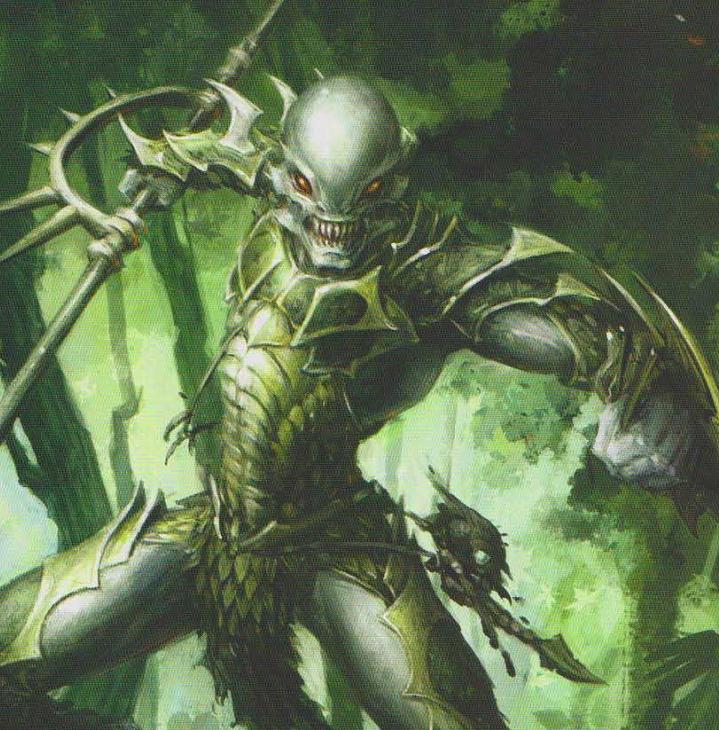
The
Totem Hunter
is not from Immoren, but a continent across the ocean called Zu. Most have never been there, and little is known about the hunter's culture, beliefs or native language. All that's known is that it loves to hunt, and will work for the Circle, Legion, Skorne or Trollbloods equally. It values the kill over all else, keeping trophy totems from its most formidable foes, performing sacred rituals to capture part of each kill's essence. It is strengthened by its totems, and is rarely seen by its victims until the moment it kills. Its cry can paralyze men with terror, and it impales victims on a wicked spear. It haunts the battles of Immoren like a carrion crow, cloaking itself in shadow and darkness. There are many prizes, now, and it has no other agendas, so it cares not for whom it helps or hunts. It approaches commanders before engagements, choosing those it finds worthy by some unknown criteria. It will make some gesture, then vanish. All that means is that the hunter will spare the soldiers of its chosen leader. In the fight, it will focus on the enemy's beasts or dangerous combatants, then it will slip away afterwards, seeking no payment beyond its totems. It has honed its skills obsessively and wields many items of power. It can leap immense distances and hide in any cover. Trying to track it after battles has always failed. Few creatures in Immoren are as graceful, deadly or terrifying.
The End.
So, now we have all the factions available to us. Trollbloods, Skorne, Legion of Everblight, Circle Orboros, Cygnar, Khador, Protectorate of Menoth, Cryx, Convergence of Cyriss, Mercenaries or Minions?
Forces of Warmachine: Convergence of Cyriss
Original SA post Forces of Warmachine: Convergence of Cyriss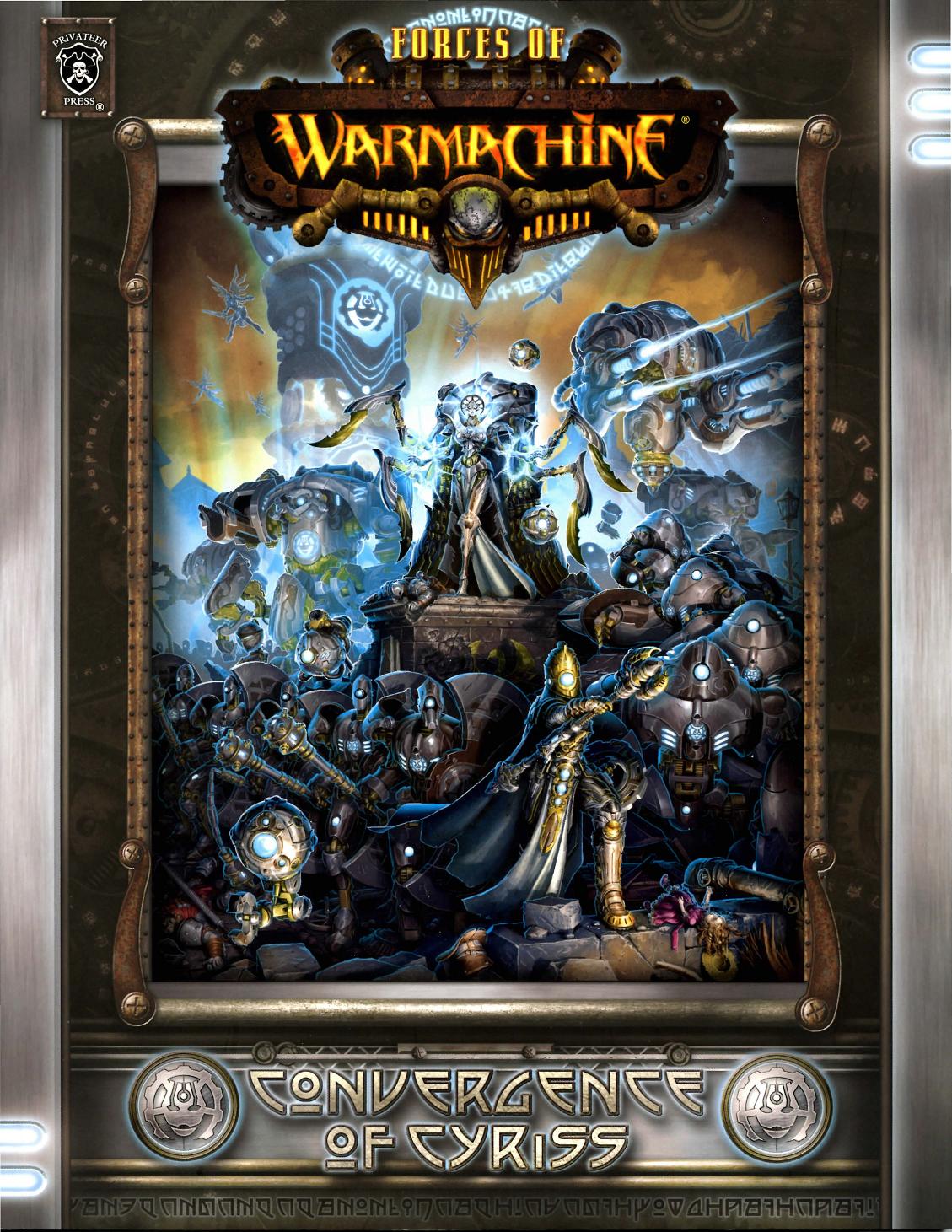
The Convergence of Cyriss, worshippers of the Maiden of Gears, have lived among the human peoples of Immoren for centuries, studying the universe. They've been tolerated as a strange cult of mathematicians and engineers, but in hidden facilities they were advancing an agenda. They built immense machines to complete the Great Work, transforming Caen so they could bring about the manifestation of Cyriss. As they enter the Phase of Alignment, they must now make war on the other powers to gain control of sites of geomantic power. They have abandoned bodies of flesh for clockwork vessels, immune to pain of doubt and with unflinching resolve. The clockwork form is their afterlife on Caen, and so they fear no death. The Nine Harmonies of Cyriss prohibit the 'false minds' of warjacks, so their warcasters wield complex vectors in battle, imposing machines that act solely as extensions of their will. Their forces are highly specialized and designed to synergize with each other, acting in concert. Their vectors are much more customized to their warcasters than warjacks are, because they actually draw on the warcaster's stats, acting very differently for different casters.

The history is presented by Enumerator Giovastus, the Prime Archivist of the Temple of the Incomplete Axiom. Cyriss was a goddess only recognized in 283 AR, but she was always existed as the embodiment of universal principles. She waited to reveal herself until people were ready, for her enigmas required a certain understanding of engineering, math and astronomy. However, when matter first came into being, Cyriss was there to weight it, to measure the energy released by motion and to enforce the laws governing that process. The acts of creation by the primal gods could only proceed according to the cosmological laws central to her. As civilization began to emerge, she played an invisible but vital role in granting insights to certain brilliant minds, whom the Convergence refer to as nescient savants. Through them, the plans of Cyriss become clear. They worshiped other deities, often, and at least two became divine themselves. Cyriss did not want their worship - she just wanted to guide them towards higher thought.
One of the first nescient savants was the priest-king Cinot, who revealed the Gifts of Menoth at Ichtier. Though they were attributed to Menoth, in truth they arose from Cinot's own mind, and Cyriss' hand is evident in the greatest revelations, such as the knowledge of cultivating grain. Even the impulse that led Belcor to join the sage-priest Geth in exodus to spread their civilization served Cyriss. Priest-King Golivant is credited with building Calacia, but its walls were designed by Kielamandes, whom the Menites have forgotten. He was a leader in developing math, formal logic, astronomy and architecture, unquestionably guided by Cyriss. His walls endured even to the modern era, and he was the first to chart the celestial bodies and their seasonal cycles. He died tragically as a result of using Menoth in his stories to illustrate logical paradoxes, and was burned alive by the priesthood. The Menites have long opposed discovery and invention, restraining new ideas because of their strict adherence only to the True Law rather than science.
The greatest ancient savants were the Twins, Morrow and Thamar. Their ascension was part of Cyriss' plan to shape human thought, and evidence of her influence can be found in the Enkheiridion, particularly in diagrams with hidden ciphers used by both Twins. Morrow was a natural philosopher and skilled mathematicians, while Thamar was an astronomer and student of linguistics in addition to her metaphysical pursuits. Both rejected established order, seeking answers by experience and reason. Their teachings did much to break the conceptual monopoly of the Menites, and many of their students and servants were also nescient savants, like Angellia, Corben, Nivara and Sambert. In their wake, many thinkers guided by Cyriss rose to prominence in the Thousand Cities Era. Among them were Glasneagh of Ceryl, known for the Sieve of Glasneagh, which is an algorithm for isolating prime numbers, and Tolonia of Gaspia, who advanced trigonometry as a field of study and invented modern numerical notation, as well as the Cloutsdown Enumerators, a group of Thurian mathematicians who defined the laws of velocity and acceleration by their study of kinematics.
The Clockwork Renaissance was an era of mechanistic progress, in which countless clockwork devices were made to solve technical challenges of all kinds. The sextant and telescopic lenses emerged, allowing improved navigation and the further study of astronomy. Most of the significant inventors of the period were subtly inspired by Cyriss, including the Umbrean apothecary Voldu Grova, who instituted a system to categorize alchemical compoounds, the Mercirean Janus Gilder, who invented the printing press, and Drago Salvoro, who invented the steam engine in 783 BR. Its true significance would not become known for a thousand years, but its design contained a seed of perfection. Sadly, the observatories raised before the coming of the Orgoth would be destroyed in the dark age that followed.
The era of tyranny during the Orgoth Occupation was more than a time of oppression - it threatened to stifle advancement and thought. Cyriss played an indirect but powerful role in the Rebellion, inspiring Sebastien Kerwin, the father of arcanists and modern alchemy. Kerwin's works have many hidden ciphers and sacred numbers of Cyriss, and her influence can be seen in analyzing his writings, particularly The Essence of Divine Magic , Principia Arcana Magus and Synthesis . These suggest that Kerwin was on the verge of recognizing Cyriss, and might have succeeded, had he not died. He applies scientific methodology to his study, understanding the relationship between runic formulae and mathematical equations. He and his peers brought human understanding closer to awakening in a few short decades than all the past combined. They demonstrated that though magic could bend certain natural laws of energy and matter, it obeyed its own laws, which could be codified. This was the birth of arcane science and mechanikal thought. Kerwin died against the Orgoth, but his legacy lives on in the Order of the Golden Crucible and the Fraternal Order of Wizardry.
After the Rebellion can the final nescient savants before the discovery of Cyriss. These included the inventor of clockwork automata, Maximillian Nevin, and his student, Elias Decklin, who solved Nivara's puzzles and made the first cerebral matrix. It emulated a living mind, providing a motive impulse to the colossals. Bastion Rathleath improved on the disease, creating the first modern cortex and the modern steamjack in 241 AR. Both generations of the device have inherent flaws related to trying to create intelligence, but they revolutionized industry and warefare. However, soon the Fraternal ORder of Wizardry became entirely focused on cortex production to the detriment of other research. Some few cabals, however, continued to advance the sciences, and one individual among them would soon make the greatest discovery of the era.
Astronomy saw a resurgence after the Corvis Treaties, and the finest astronomer in the Fraternal Order of Wizardry was Aldophous Aghamore of Orven, who revolutionzed optics, initially to make viewing apparatuses for steamjacks. Most paid little attention to his astronomical pursuits. He was the first to apply principles of alchemy and mechanika to astronomy, making augmented telescopes with which to view the celestial bodies beyond Caen. He applied alchemical glazes to the optics that filtered light, as well as devloping precise mechanisms to orient and focus large telescopes. Through this, he was able to make unprecedented observations. It was with one of these devices that, in 283 AR, he noticed a previously unknown celestial object, which he theorized to be a distant planet on a highly elliptical orbit around the sun, naming it the Dark Wanderer. His findings were initially dismissed, because the object was all but invisible without his techniques, but in time, others did confirm its existence. Meanwhile, he began to experience dreams and visions. Through these, he became convinced the planet was named Cyriss, a name shared by a divine being speaking in his dreams. Those he told feared him mad, and his reputation suffered. He was made a pariah. The discovery of a new divinity and new conception of the universe was not easily comprehended, but it would prove to be true, the first sign of awakening. Humanity had reached the vital point in scientific and arcane development, the point where they could become aware of the hidden goddess, whose plans and goals are too vast for mortal minds. OVer the years, the others who had witnessed the Dark Wanderer experienced similar dreams.
Aghamore and these others who heard the whispers began to meet, and from those meetings arose the Cult of Cyriss, initially drawn largely from esoteric cabals of the Fraternal Order of Wizardry, including those seeking to reconcile mathematic principles with arcane formulae. Many had reputations as outsiders to the order, and a widely held believe among them was that the steamjack cortex, and by extension the foundation of the Order's wealth and influence, was a fundamentally flawed mechanism, too reliant on chaotic arcane interactions. The traits that had alienated them from others were valued in the new faith, which revered reason and the scientific method. Interest in Cyriss quickly grew among abstract mathematicians, engineers and astronomers, and the papers of the astronomers drew in some aristocrats. The idea of a divinity governing fundamental laws became popular among the scholars of Cygnar, and then other nations. By 290 AR, the first major gathering of the cult was held. In this secret meeting, many of the tenets of the faith were established and the earliest priests were elected. Aghamore was key to the endeavor, and was among the priess named. After much discussion, three tiers of priesthood were established: optifex, enumerators and fluxions.
The optifex, the most numerous, were laborers and craftsmen as well as priests. You could remain at that level indefinitely, for promotion would mean not only mastery but a demonstrated ability to lead and instruct. The next level, the enumerators, would oversee daily tasks and works of the faith. The fluxions would lead the temples, few in number and trusted to safeguard the higher mysteries. Secrecy and discretion were paramount, as few would understand their worship. The first priority was to understand their goddess better. Unfortunately, Aghamore proved too fragile a mind, and in 298 AR he isolated himself, becoming increasingly erratic. He became obsessed with buiilding a machine of immense size and complexity. He died in 303 AR, having fallen into the gears of his unfinished apparatus. PEople were shocked to see he'd covered his walls with fragmentary notations, formulae and incomprehensible writings. It would later be found that they were not the nonsense they appeared at first.
From the beginning, the temples of Cyriss have been places of worship but also places of experimentation. The goddess wants devotion by scientific exploration. Challenging yourself through abstract science is an act of prayer, as is advancing math, astronomy or engineering. Very quickly, the cult exceeded former engineering limits, and the role of forge master was created, to be the most accomplished engineer and inventor of each temple. In 311 AR, the priests collaborated to write Principles of Geomantic Energy , which would be a foundational text unlocking a great power source for the temple-workshops. It had been found that arcane energies flow beneath Caen's surface, collecting in invisible channels tied to significant geographical features. It proved difficult to harness, but drew lots of study. Energy accumulators were built on sites of strong flows, though at first they had little practical application besides powering lighting. The use of them remained limited until the invention of the astronometric nexus in 326, immense tower-like machines that focused the energy via internal alignments based on celestial conjunctions. Close analysis of Aghamore's writings and work provided key information in developing them, suggesting that he himself had been trying to harness these energies. Once a tower is aligned, the influx of energies magnifies exponentially.
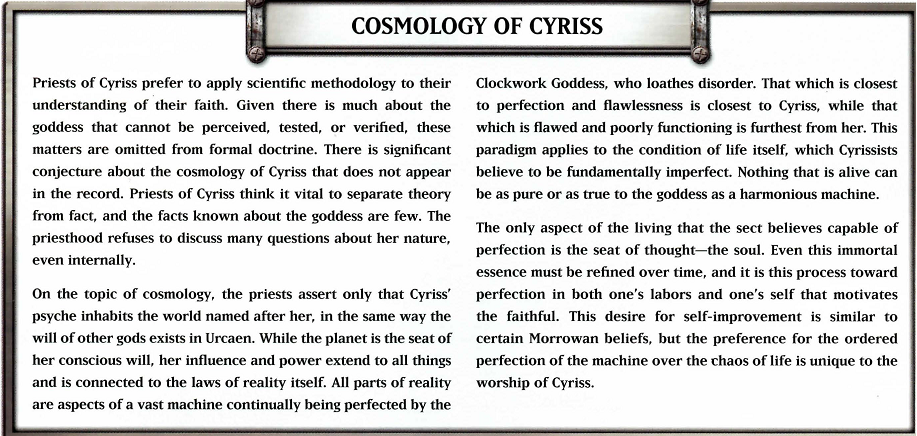
The mechaniks and engineers of Cyriss soon learned how to transform the energy into useful operation of various devices. It was essentially limitless, and spurred great invention, allowing the creation of new, immense and complex machinery. By 330 AR, experiments on transforming energy led to breakthroughs, including advances in voltaic and electrostatic charging, allowing the early cult to move away from coal to power engines. Locations where geomantic flows converged became the preferred sites for the most advanced temple workshops, and huge accumulators and generators built in the temples provided energy that could be broadcast to power machine guardians and workers, such as vectors and servitors. The engineers found ways to store the energy in reserves, useful for machines that had to be built away from facilities. During this era, there were debates about how advancements should be propagated and controlled. All agreed that all temples should benefit, but found it prudent to limit familiarity with the new techniques only to the faithful, implementing the Rubric of MYsteries in 320 AR to formalize a hierarchy of secrets. Lore of the goddess would be kept from outsiders, revealed incrementally only to those ready for it. Certain works could be compartmentalized so junior members could access portions as needed without having to understand the greater whole.
Next time: The Cipher Engine
Forces of Warmachine: Convergence of Cyriss
Original SA post Forces of Warmachine: Convergence of CyrissOne of the most important early temples was the Foundry of Enumeration in the Wyrmwall Mountains. It was the site of much pioneering research, and the home of a project to create devices able to automate mathematical operations. These calculating machines were originally made as a devotional act, exploring the sacred fusion of math and engineering. Soon, applications were found for them, for even the simplest were useful in controlling servitors, semi-autonomous machines made to be tools and weapons. Larger computational components weighing multiple tons could perform more complex tasks, working on abstract exercises as well as deriving exacting measurements. They were fed instructions on brass cards punched with holes expressing a new mathematical language. Technology similar to the printing press allowed the output of machines to be preserved, gernerally as lengthy numeric strings. Because these machines could function indefinitely, they were given complex formulae to solve, including those that would give extremely long number sequences. Analysis of the output became the sacred task of a specialized group of priests. The largest and most complex calculating machines were always at the Foundry of Enumeration, where they were regularly improved and redesigned. By 330 AR, the greatest of them occupied several chambers and took dozens of priests to maintain.
A problem arose when careful study of its output showed unprecedented errors amid very long series of numbers. Attempts to correct these failed. In 333 AR, a priest named Helicratus applied a new algorithm, discovering an underlying pattern. He determined that they were not mistakes, but an encrypted message. The best minds were set to breaking the code, partially succeeding in 334. The ciphers were messaged from Cyriss herself, and the machine that made them became known as the Cipher Engine, a vital relic of the faith for being the primry conduit of the goddess' communications. From this point, it was used exclusively to generate long strings from complex formulae, with its output sent to dozens of temples to assist in interpretation. The first major direct was translated by Helicratus in 335. The goddess told the priesthood to abandon flesh and become one with machines. The ranking clergy initiated the Anima Corpus Procedure, a prject to transfer a soul into the body of a machine. It would be exceptionally difficult to do, and many decades passed before progress came.
The heads of the project were Fluxion Helicratus and Forge Master Lucidia, one of the eldest and most respected engineers. They were aided by dozens of the brightest minds in Immoren, most notably the astronomer Ghil Lucant, who had earned fame in 356 for discovering the planet closest to the sun, subsequently named for him. Disagreements betwene Helicratus and Lucidia divided the foundry in 360 AR, and Lucidia was eventually cast from the cult. She returned three years later, just as Helicratus became the first to be trasnferred into a clockwork vessel. It should have been a triumph, but Lucidia, informed by spies, compromised the temple defenses and slaughtered most within. Mortally injured, Lucant successfully transferred his own soul to a vessel and escaped. The cult had to abandon the foundry, salvaging only the Cipher Engine and knowledge of soul transference.
Before the Foundry's destruction, Lucant had deciphered a series of connected encrypted messages. They described a machine spanning all of Caen, drawing on the geomantic energy of the entire world by a vast lattice of conduits between hundreds of temples. Once it was made, Caen would be suitable for the manifestation of the goddess, who would inhabit the world machine ash er vessel. This was the Great Work, the completion of which would require centuries of effort. Awed by the mandate, Lucant immediately reassembled the Cipher Engine to organize the cult towards it. The inner circles of each temple had previously had no oversight, but Lucant foresaw a strict hierarchy being required for the project. In 370 AR, he met with all ranking priests, using both his old standing and his existence as a clockwork priest as proof of the goddess' guidance. The scope of the Great Work was shown, and a leadership was defined. Lucant was the first ion father, the head of the faith now known as the Convergence of Cyriss. He passed down the tenets that would become the Nine Harmonics at the core of the faith, several of which were refinements of Aghamore's earlier precepts.
Not all joined the Convergence. Some rejected Lucant's vision and were denied access to higher mysteries. Most who remained outside, however, were members of small sects entirely ignorant of the higher mysteries. The Convergence was always the inner circle, those awakened to perform the will of Cyriss. Many were not ready for an active role, serving only as scholars. Worship of Cyriss brought them inspiration, but they would not forsake their old loyalties and devote themselves to Convergence. They would not transcend. Agents were set to observe any extraordinary minds among them, that no discovery would escape attention and to spot promising recruits.
Before the Work could truly begin, those who joined the convergence had to fulfill the first directive: become one with the machine. Lucant know it was not meant for him alone. The process of transformation into a clockwork vessel was shared only with the highest priests. In those early days it was not easy - an essence chmaber took a long time and a lot of resources to make, with absolute precision needed. By 382 AR, refinements were made to the process that simplified the manufacture of essence chambers. The priests began to include others as candidates, fabricating clockwork soldiers, allowing them to become superlative and theoritcally immortal warriors. Later imprvements allowed souls to be recovered more quickly and cheaply, allowing the faithful to be preserved even in the event of sudden death. They found there were benefits to leaving a soul to develop and mature in a living body, so standards were imposed to prevent premature transfer. Preists, especially, were encouraged to experience as much mortal lifespan as possible, with exceptions for the sufficiently spiritually advanced.
In 390 AR, Lucant stepped down as iron father, having determined that the faith would stagnate if guided by the same leader too long. Every nine years, a new leader would be chosen by the fluxions. An individual could serve repeatedly but not consecutively, and an iron mother or father that wanted to resign before nine years could. Lucant remained quite important due to his special insight into the Cipher Engine, and he was given the honorific of Divinity Architect for his role. In 410 AR, thje Constellation was created, a device able to house multiple essence chambers and allow rapid communciation between them. It was prompted by clockwork priests who wished to experience a pure mental state removed from physicality, and was built to resemble a vast orrery, with the ssence chambers in arcs of interlocking orbits. It soon held the Convergence's best minds, and the first permanent transfer was Fluxion Ambro Pascar, the most gifted mathematician of his era, who invented a true calculus of infinitesimals and revolutionzed mathematical physics. Most who joined the Constellation did it temporarily, returning after weeks, months or years. Others, however, were permanent. By 440, the Constellation was a vita advisory body, and when not being consulted it focused on analyzing matters of scientific or technical import and coordinated deciphering th output of the Cipher Engine. OVer the past two centuries, it has been redesigned sixteen times to expand and improve its architecture.
It would be almost a century after Lucant's revelation that the tools were made to create an infrastructure for the Great Work. The scope was beyond any mortal lifespan, requiring the tireless efforts of the machine-preserved. All would have to contribute to making a global machine able to house the consciousness of the Clockwork Goddess. The ranking leaders worked to relaize this vision, expanding the temple network across remote and hidden locations. The fluxions divided labor between many temples, with secrecy maintained at all levels and only necessary information passed down. Expanding the network from 440 to 500 AR had countless challenges, each overcome by superior techonology, patience and planning. The leadership avoided major confrontations with the various kingdoms and groups around the ground they wanted, though it was occasionally necessary to fight over particularly important sites. New hidden outposts were made and new astronometric nexues created along convergence points to the pattern plotted by the divinity architect. Many locations, they found, were held by competing groups. The mouths of major rivers were vital and often had heavily populated cities. Rather than fight, they opted to make workshops and temples hidden below these cities, and Caspia, Ohk, Berck and Five Fingers became key to the network, each using significant machinery to tap the vital energies, creating the Great Conjunction to magnify the delta energy. As early as 460 AR, though, they discovered they were not alone in seeking these cites. Subterranean locations were often infested with the hostile cephalyx, incomprehensible and formidable foes with their own twisted science and power. They could enslave weaker minds and used surgically altered soldiers to fight for them, and they became the Convergence's worst foes.
The Circle ORboros were also an adversary, as they used their sacred sites of towering stone to harness Caen's energy for their own purposes. More than any other rival, they know how to harness geomantic energy, and several times, the Convergence has had to revise their understanding of the Circle, whose methods are disturbingly similar, though reliant on formulaic ritual and natural constructs. Some priests have theorized that the early blackclads must have received inspiration from Cyriss but misinterpreted it due to primitive beliefs. Hundreds of secret wars have been waged against them over the years. The last major group aware of the energy is the arcanists of Ios, and from 500-520, attempts were made to penetrate Iosan borders to make secret complexes, but every time they were intercepted and destroyed. The push was postponed, but will likely be resumed soon, and already there have been battles with the Iosans. Western Immoren in general, however, is quite small compared to the entirety of Caen. Given the difficulties on but one continent, the dream of a world machine seemed distant, but soon, that perspective would change.
Just before the Thornwood War, the Llaelese mathematician Lorite Donaes joined the Convergence after breakthroughs in the study of complex numbers, which combine real and imaginary numbers. She adapted readly and soon gave great insight into fluid dynamics and electromagnetism. In 421, after work with the Constellation, she created a system of signal analysis to audit energy flows in the network. Its goal was to improve efficiency of energy gathering, but in the process, a great discovery was made. Tiny fluctuations at the peripheray suggested sympahtetic networks beyond the MEredius. It was realized that the Great Work must exist on other continents, working in parallel. It is hypothesized that since civilization has grown on many sores, Cyriss must guide remarkable minds in all places, and other populations must have received her revelations. There has been no direct communication with these groups, but energy fluctuations could be used to transmit coded messages. The Constellation decreed that no contact be made yet - it was enough to know that they were not alone.
The modern age has given many nescient savants in the Iron Kingdoms, advancing science even without awareness of Cyriss. Simonyev Blaustavya was one of the greatest, a Khadoran engineer and inventor who modernized the Khadoran Army. Perhaps the most prominent current savant is Sebastian Nemo of Cygnar, whose revolutionary ideas have transformed the Cygnaran military. Convergence agents cautiously approached both Nemo and Blaustavya, but they proved unreceptive. Instead, they strengthened the Convergencve's foes. It became clear that the priorities of the temple needed to change. Father Lucant and the Constellation had been watching the celestial signs and ciphers, while agents observed the Iron Kingdoms. Analysis of all that prompted Lucant to declare that they were on the cusp of the Phase of Alignment. Secrecy had done all it could, but now, the Great Work would need them to risk deploying their arsenal to seize contested sites and secure them long enough to force their energy flows into alignment. It was time for war.
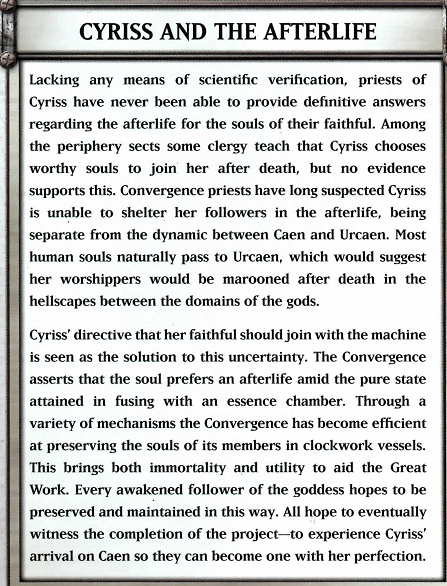
Additional temples were still made, but their job was shifted to military research. Forge masters built fighting vessels, vectors and weapons, and senior designers began to create many clockwork vessels designed for battle. As early as 604 AR it became a concern that the power nexus under Caspia might be detected by the Cygnarans. Ranking leadership discreetly contacted Cygnar's government as a calculated risk to ensure uninterrupted work, speaking through intermediaries with Sebastian Nemo to negotiate a mutually beneficial exchange with King Leto of Cygnar. The priesthood offered to help solve challenges in experimental technology in return for permission to worship Cyriss and build a temple, which was erected at a site chosen to obscure the facilities beneath. The known temple would be staffed only by the periphery of the faith, but the hidden facilities continued to operate beneath. Similar efforts were made in Korsk, with the Rigevnya Complex in Khador being subverted to install a dozen hidden foundries under the city. Similar facilities exist in other cities in Khador, Ord and Cygnar as well as in Merywyn and Laedry, along with compolexes in wilderness regions and many weapons stockpiles.
In 606 AR, the Constellation elevated the ambitious priestress Directrix to be iron mother, and Lucant declared that she would lead the beginning of the Phase of Alignment. The last two years have been preparing for a conjunction of celestial spheres beginning in 609, which has been found to be the ideal time to unleash military might. The next few years are crucial, with success relying on precise operations, accurate calculating and intelligent leaders. The alignment nodes will reshape the energies of Caen, transforming Immoren into the machine of the Clockwork Goddess.
Next time: The Machines of Heaven
Forces of Warmachine: Convergence of Cyriss
Original SA postUuuuh...well, I'm summarizing, so there's probably fine details lost. I mean, my posts tend to condense between five and twenty pages or more down to a few posts.
E: Also I skip large sections of non-expository fiction.
Forces of Warmachine: Convergence of Cyriss

The Convergence is one of the most unusual but terrifyingly effective armies in Immoren. Those face them may not notice the distinction, but they see themselves as much more than an army. They are the inner circle of the youngest faith, a self-contained and self-governing secret society with a distinct culture as well as goals the rquire them to be a large and technologicxally advanced military. They have no borders and only limited geographic holds scattered across western Immoren but mostly within the Iron Kongdoms. Most of their members spend their lives in one of over eighty hidden temples, some in major cities or twons and some in the wilderness. Nearly all of them are underground entirely or substantially, making them hard to find and easy to defend. They were built on sites of geomantic significance, giving access to mystical energies as a vital power source. They are more than that, though, as the goal of the Convergence is to allow Cyriss to manifest on Caen. To do that require control over the world's geomantic energy via a vast network, and the temples contain specialized machinery to be nodes in that network. Together, the network and energy are seen as a single, incomplete machine that will be finished only when it connects all of Caen. There is one perfectly harmonic pattern to which it must conform, and reaching that is referred to as the Great Work, a sequence of construction that's been going on for nearly 250 years. In addition to building the temples, the geomantic flow must also be realigned, which means taking new territories in exposed locations to build machinery there. Until the end of 608, the Convergence acted in secret, avoiding hostility and violence when possible except agains the Circle Orboros and cephalyx. The year 609 is the beginning of the Phase of Alignment, a time of more open conflict. The machinery must be made, activated and protected long enough to correct misaligned flow. Once realignment is complete, the machines can be abandoned for other sites. Since many key locations are occupied or settled, this means open war.
The Convergence may be widely scattered, but it has a simple hierarchy. Membership belongs to dozens of self-sufficient temples, but has two basic tiers of leadership: one in each temple and the other coordinating them for shared work. The Convergence is cell-based and most members do not have detailed awareness of their peers in other temples. Until now, most spent their lives in a single temple, maybe getting reallocated after becoming a clockwork vessel. Moving into a more active phase has needed greater coordination, but that hasn't affected those not involved in the military, so most junior members remain unaware of the big picture. The priesthood are the most significant leadership group at all levels, both in temples and between them. Most priests perform highly skilled technical work and research on top of that, requiring them to remain in the temples, so they rarely join military missions. The few that accompany strike forces are technicians and field commanders.
The three broad ranks of priest, in descending order, are the fluxions, enumerators and optifex. Fluxions are the only rank with regular contact with other temples, as part of their job is to coordinate action. Information is compartmentalized even among priests. Other the fluxions in charge, the highest ranking person at a temple is the forge master, who maintains the machines and armory. The highest-ranking leaders can communicate across long distances by making barely perceptible fluctuations in the geomantic flows between temples, allowing for transmission of even complex information given sufficient time, but messages are usually kept focused on allocation of resources, military coordination or delivery of other crucial information. The central headquarters of the Convergence is the Temple of the Prime Harmonic in the northern Wyrwmalls, a site of critical importance due to housing the Cipher Engine and Constellation.
The Cipher Engine is an immense machanikal calculating machine housed in multiple chambers of the Temple of the Prime Harmonic. It is attended by dozens of dedicated priests who continually ask it to solve extremely difficult math problems via brass plates punched with patterned holes. The Cipher Engine translates those as instructions and numbers, working to find solutions and outputting them with mechanisms similar to a large printing press. It is one of the most sacred artifacts and plays a central role in the Great Work, as its output is believed to be the primary means of Cyriss' communication. She is an enigmatic goddess who does not give simple answers, preferring her followers to challenge themselves to decipher her will. Her messages are buried in the output and never easily found or translated. Amid long numeric strings are inexplicable irregularities that, when compiled and sequences, create complex coded messages. The sheer volume of output means they get made faster than they can be analyzed, a job which is distributed among temples and is considered sacred. The volume of successful translations is small, but have led to the most important directives of the Convergence. The majority of the Nine Harmonics have their root in expressions of the Cipher Engine, and it was also responsble for starting research into the Anima Corpus Precodure, which resulted in clockwork vessels and the Great Work.
The Constellation is a machine housing the collective consciousness of hundreds of faithful souls. This intelligence serves as an advisory board and tool of analysis. IT was built to house various essence chamberso f those who decided to seek purer communion with the machine state. Removed from the physical world, they are purely cerberal, able to communicate internally using encoded mathematical language conveyed by conduits between essence chambers. They have an enunaciation apparatus by which they can communicate with others, as well. Their exact membership changes periodically, with new members added and others leaving to resume physical existence in clockwork vessels. Some enter temporarily, some permanently. Because the membership are removed from all stimuli, they have greater mental clarity for abstract problems. With the combined minds of so many thinkers available, it is the most powerful analytic body in the Convergence, and is even looked to select leadership when an iron mother or father's nine-year cycle ends. A list of fluxions compiled by Lucant is given to the Constellation, which then selects the new leader thought to have the best qualities to advance the Great Work.
The Iron Mother is the voice of leadership, responsible for coordinating the entire Convergence from the Temple of the Prime Harmonic, where she can be in regular contact with the Constellation. She communicates with the fluxions of the Convergence and often travels between temples to inspect their projects. When the Convergence launches major military actions she may lead them personally. The first to hold the position was Father Lucant, but he stepped down after 20 years and imposed a rule that the office could be held only for nine consecutive years at a time. This prevented stagnation. the current iron mother is Directrix, chosen in 606 AR. She has vast authority over the Convergence, both as leader of the priests and supreme military commander. She rarely intervenes with temples, focusing on coordinating between them and managing assets. She determines the faith's priorities and decides when the Convergence must send out strike forces.
Sidebar on the Nine Harmonics. They are the core of the Convergence's guiding principles, simple yet broad. Every action is meant to be in accordance with them.
The First Harmonic:
Precision is the opening theorem in the proof of perfection.
Perfection takes constant exertion towardds efficient and measured existence, and precision should be applied as much to daily habits as labor. Absolute precision is achievable only by continuous diminishing of margin of error.
The Second Harmonic:
Mathematics is the only true language.
It is the language of infinity, and all that exists and does not exist can be described mathematically. A process or thought cannot be without a formula to describe it.
The Third Harmonic:
The power of understanding transcends the inexplicable.
Nothing is actually inexplicable if confronted with proper analysis. Complete understanding is possible by continuously diminishing ignorance. Strive to increase knowledge and preserve learning.
The Fourth Harmonic:
Magic obeys scientific principles and does not require mysticism.
Magic is a complex interaction of matter and energy mediated by will. It can be understood, codified and controlled. There is always a way to integrate it with engineering.
The Fifth Harmonic:
The goddess of perfection will manifest to inhabit the vessel thereof.
Cyriss can achieve harmonic sympathy with any sufficiently potent and perfect machine. Harnessing geomantic energy in a globally balanced astronometric matrix will complete the prime harmonic and compel her manifestation.
The Sixth Harmonic:
Clockwork perfection requires an absence of entropy.
All acts of harmonic construction and engineering increase order and reduce entropy. Life multiplies entropy, so nothing living can be truly perfect.
The Seventh Harmonic:
Souls are elments in the divine equation.
Only the soul is autonomous, an aspect of a divine equation of consciousness. It bridges divinity and mortality, and is capable of either infinite refinement by pure thought or utter debasement by wallowing in corrupt flesh.
The Eighth Harmonic:
False shadows of consciousness mock the divine equation.
The creation of a soulless machine that mimics true intellect is a mockery. Machines do not make decisions, and an unpredictable machine is flawed.
The Ninth Harmonic:
To awaken a soul one must seek harmony with the goddess.
The teachings of Cyriss are not for all, and only a select few will be awakened. Do not reveal the secrets of Cyriss to the unprepared. Those on the cusp will be awakened where higher thought flourishes.
Back to the Divinity Architect, a unique office held by Father Lucant, who was the first to transfer a soul to a clockwork vessel and founder of the Convergence. He was made divinity architect by stepping down as the first iron father in 390 AR. In some ways, this is a wholly honorary office, as it has very limited authority. Most importantly, he reviews decoded messages and coordinates efforts of the Great Work. He has tremendous influence as the primary spiritual advisor and longterm strategic planner, however. The fluxions need not obey him, but generally listen to his advice, so long as it doesn't contradict the iron mother. Most respect Lucant as the spiritual head of the faith and a sort of oracle, for no other has his skill at deciphering the words of Cyriss.
The Convergence considers itself the true faith of Cyriss, referring to themselves as the awakened, living by the Nine Harmonics. There are many peripheral worshipers of Cyriss who are ignorant of the greater mysteries and live in ordinary society. There is line between them and the Convergence. They may revere the goddess, but they are blinded by their misplaced loyalties. The Convergence finds them valuable, still, as a bridge to the outside world. Their most important role is as a pool of potential recruits, and most awakened were once members of peripheral sects. They are most numerous and succesful in areas of intellectual study or machine work, especially among alchemists, arcanists, astronomers, engineers, mathematicians, mechaniks and metallurgists. The Convergence periodically surveys them for new recruits, sending hidden clues and messages in scholarly works to guide them to make contact. Most who seek the Convergence are mature adults with success in their fields, but younger petitioners do occasionally show up, and latent warcasters are often brought in young. Becoming a member of the Convergence is a permanent commitment and often means abandoning your old life, for they can't risk secrets getting out. New recruits are extensively indoctrinated in remote temples, and not permitted to leave. In some cases, there are accomodations for immediate family, particularly if a spouse is part of a peripheral cult. If a couple with children are indoctrinated, so are their kids. Every effort is made to integrate them into the Convergence. Those who lack devotion or are not trustworthy will be cast out or even humanely killed.
The process of becoming an awakened member reveals the candidate's skills and atalents, which determine their role. New members with the right qualities might become priests, the most desirable career, but they must be able to control arcane energies to help make, design or repair machines. Some priests are less focused on that than others, and arcane talent alone is not all that's needed. Most lay members are technicians, unless they have other specific titles. All are expected to help maintain, repair or operate temple machinery. The highly skilled go on to become respected engineers, and a number of senior engineers are more focused on pure math or research. Some few become temple guardians, usually those competent but not exceptional in technical fields or who are more temperamentally suited for it. Occasionally, guardians will be children of cult members who don't distinguish themselves otherwise. They are trained in weapons and protect the temples. When not patrolling, they do other work, like labor and upkeep. They are distinct from the temple soldiers who are all in clockwork vessels, and the guardians never fight outside the temples. Most become clockwork soldiers when they give up mortality.
All awakened aspire towards clockwork vessels, and nearly all can expect to achieve that sate...eventually. Only those deemed mentally unfit are exluded, and they are rare in the faith, though sometimes there are member swho are brilliant but mentally unstable or overly attached to physicality. For others, the priesthood insists it's better for the soul to live as long as possible before transformation, with exceptions only for the especially spiritual clear and mature. The Convergence knows how to preserve the souls of unexpected deaths, transferring them to essence chambers. This is a holy and profound transformation, the afterife of the cult, and a sort of immortality. For two centuries, the Convergence has been collecting its members' souls this way, and as a result, their numbers continuously grow rather than shrinking over time. In most temples, the clockworks outnumber the living. They work as soldiers on top of their normal duties. It takes time to become accustomed to their state, and military training accelerates familiarity while also being useful. The entire clockwork population is a battle-ready militia, and all vessels have formidable capabilities, using advance weapons as well as being immune to pain and resistant to total destruction.
The Convergence hjas a wide variety of clockwork vessels prepared. Most stay in the same chassis for years until accustomed to being machines, but after this they become more comfortable swapping vessels. IT's common for members to use one chassis for temple work and another for soldiering. Over the decades, a soldier might learn many chassis, but one is usually preferred. To identify themselves to one another, each clockwork will createa small abstract pattern etched onto the visible part of their frames. Clockwork priests and warcasters often create their own custom vessels, which is often spiritually satisfying to them. Soldiers generally have more regimented vessels to better integrate into units. A new battlefield chassis is a rare development, requiring proof that it augments the Convergence in a new way. The clockwork angels are the most recent new form.
The Convergence has no standing army, assemblign strike forces as needed. Some longstanding forces and garrisons exist, but they're a small percentage of the Convergence military. Strike forces usually include a core of veterans preferred by specific warcasters or senior priests, joined by other units as required. Very important jobs take larger forces, collected from multiple temples, and those require the iron mother's consent, with details left up to a fluxion directorate of the temples involved. The enumerators serving those fluxions handle logistics and serve as senior officers. Before the Phase of Alignment, such large forces were rare, but it's expected they'll be seen more often now. The priesthood ensures these missions get enough soldiers, vectors, servitors and other specialized assets. Soldiers are efficiently organized as units overseen by prefect,s who report to priests. In any given standing garrison or strike force, the most experienced veteran of each unit type, called the first prefect, will have special administrative duties.
So, what is a vector? It's what they use instead of warjacks. They are built using arcane science, physics and math. They are uch smoother and more carefully made than most warjacks but no less brutal. However, rather than a cortex, they use an interface node. Interface nodes do not suffer damage that is dealt to cortexes, such as by shock fields, and are immune to cortex domination, as they are directly tied to the warcaster's mind. Vectors draw skill from the warcasters directly, and also function as a sort of supply chain, extending the warcaster's reach to other vectors nearby. They become inert when their controller is killed, but can be reactivated by other warcasters as long as the interface node remains intact.
Next time: Warcasters of the Convergence
Forces of Warmachine: Convergence of Cyriss
Original SA post Forces of Warmachine: Convergence of CyrissWarcasters are exceptionally important to the Convergence, due to their rejection of the false intellect of conventional warjacks. Their vectors can operate only under the command of a warcaster, unlike wrjacks, which can function under lesser 'jack marshals. Often those who manifest this talent are drawn towards Cyriss, which means the Convergence has more warcaster proportionally than their numbers would suggest. Those who can control vectors remain rare, however, and highly values. The standing armies can openly recruit, but the Convergence has to hope to find them in the faithful. They screen extensively for warcaster talent, and optifex specializing in arcane detection are assigned to observe periphery cults for potentials. They focus on indoctrinating this gifted individuals before sending them to the inner circle. Most importantly, these recruits must prove their devotion. PEriodically, the optifex also look for converts among the larger population, avoiding those who have already joined a military but focusing on the ones who have not yet made a commitment or discovered their aiblities. They spare nothing in training, which lasts quite a while. Recruits study the Nine Harmonics and vector command, mastering the interface node. Those with devotion are encouraged to become clergy and may rise to leadership, while others become soldiers or engineeers. Regardless of their functions in a temple, though, they have operaiton control on military missions, answering only to senior priests. Warcasters always begin as flesh and blood, but evnetually get machine transcendence, usually after mortal injury in battle. Fortunately, warcaster talent survives these transfers, and even can lead to finer control afterwards. It's possible that freedom from a mortal body allows for increased clarity of thought and sympathy with the interface node. True or not, by the time a warcaster gets a clockwork vessel they've probably had years learning to control vectors and are well prepared for their new form. They adapt quickly and can easily function within heavily modified or less anthropomorphic vessels, often adding limbs or integrated weapons.
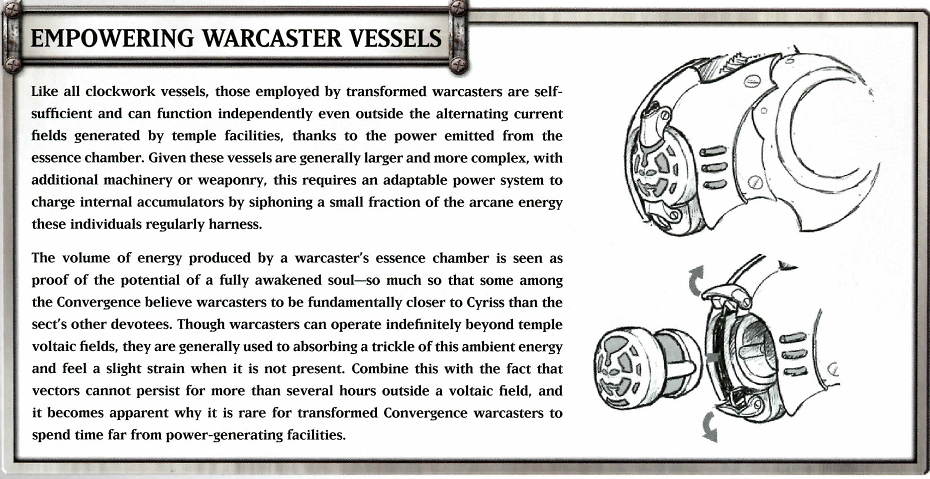
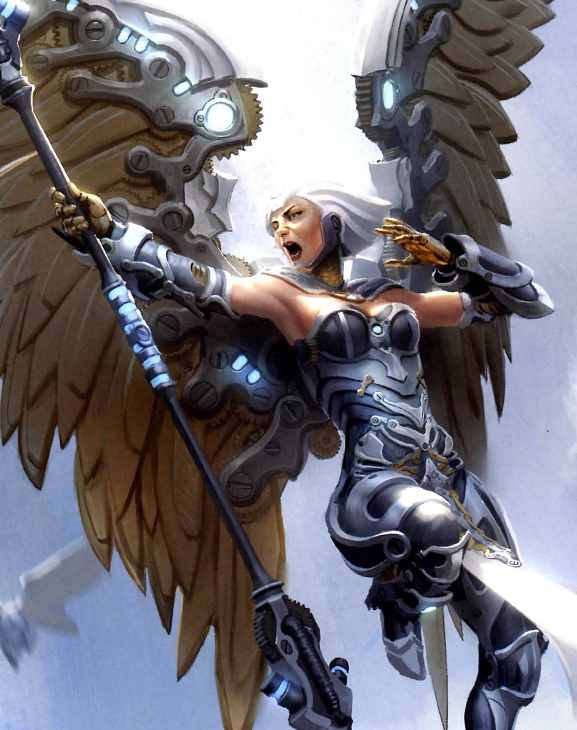
Aurora, Numen of Aerogenesis , is blazing a new path as a visionary inventor and warrior. She flies at the vanguard of hte Convergence, striking from above. She has no life outside her faith, daughter of the woman who would become Directrix and raised from birth within the Convergence. Her mother assumed a clockwork vessle when she was only three, but it changed little. She had no peers among the children, befriending the priests who taught her. She had an early and intuitive grasp of engineering and voltaic fields, and she masters vector control shortly after manifesting her talent at age nine. Directrix has shown no hesitation in risking her daughter on the battlefield, though Axis was sent along to ensure her safe return. By 16, Aurora was testing her power alongside Axis, whoe straightforward goals and unpredictable tactics contrasted well with her efficient precision. She analyzed all aspects of the battles, taking notes for days afterwards and planning potential improvements to weapons and armor. She was particularly fascinated by the arcane displacement field, and in examining the modifications Syntherion made to negate the mass of heavy vectors, she became obsessed with true flight. She was 20 when she made her groundbreaking field generator, miniaturized but able to emit strong pulses of controlled kinetic energy. Within a year, she designed the clockwork angel chassis as well as her own warcaster armor, developing more than a new prototype but changing the way the armies fought war. Accompanied by her personal guard, she flies into battle, continually seeking to prove she is ready to transcend her own flesh. Her gimmick is flight and movement as well as buffing her allies. Her feat allows her units to move even more easily.
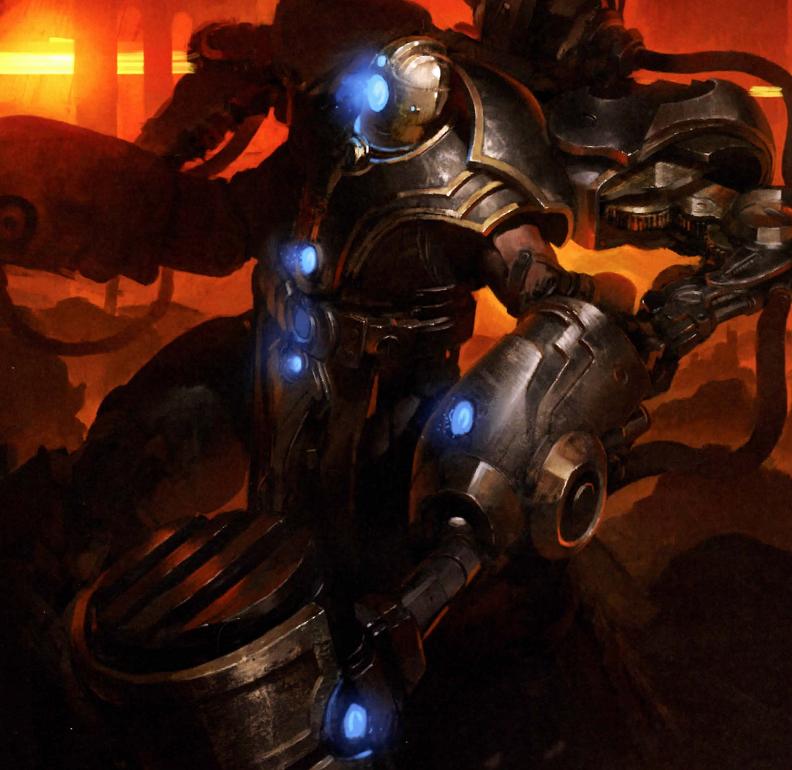
No one has embraced the coming war like Axis, the Harmonic Enforcer . He loves crushing the foes of Cyriss almost as much as he loves Cyriss. He was formerly from a radical Cyriss sect, but his violent actions endangered the Convergence with too much attention. Directrix, still alive at the time, was sent to exterminate the cult, but she spared Axis, seeing in him a useful weapon. He saw her as chosen of his goddess and gladly worked as her enforcer. His loyalty has only deepened, along with the troubles plaguing his fractured mind. He's not really sane, prone to incoherent thought and violent impulsed, driven by visions of formulas across everything he sees. His wild zeal is unnerving to others, and he sometimes lapses, mid-sentence, into recitation of the Nine Harmonics. He often requires reminders to eat, bathe or even get out of the potent battle armor he wears for days at a time. His peers think his mind has broken under his gifts. He has always been proud of his physique, and now fears death, as age is taking its tool and he knows his imperfect mind may keep him out of a clockwork vessel. To deny these thoughts, he focuses on destroying whatever he is sent against, finding satisfaction in the one service he does better than anyone. His gimmick is violent melee activity. Really, really violent. His feat allows him to drain the speed and strength of his foes to boost those of his allies. (Also, his giant war hammers are named Action and Reaction.)
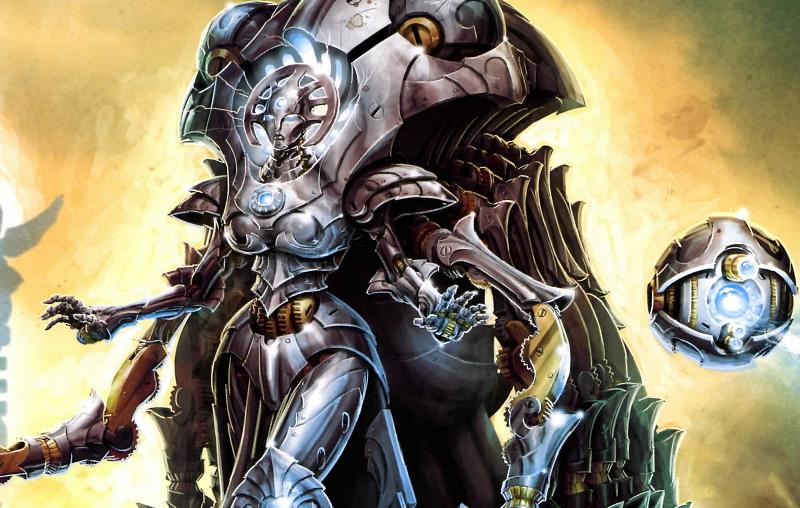 0
0
Iron Mother Directrix is never seen without her Exponent Servitors . She leads the Convergence with brilliance, certainty and unshakable conviction, but she's quite young for such a job. What set her apart was her passion and ability to appeal to her soldiers either by logic or emotion. She is well suited to leadership, and was chosen by the Constellation. Her rise is a result both of her ability and design. She was born under the name Viana and raised in Ceryl by parents in a peripheral Cyriss sect that had always been good for recruitment. They cultivated intellectual inquiry in her and encouraged her towards academia, but she was frustrated by the limits of that path. She studied clues in Cyrissist writings that led her to the inner circle, whom she demanded initiate her, refusing to squander her gifts as a simple cog. They were impressed, taking her in at the unprecedented age of 16. She left her family behind easilyand focused on studying the Convergence's teachings, impressed by the Nine Harmonics and joining the clergy. She discovered her warcaster ability and favored the role of battle-priestess, learning operational command by 20 and directing vectors against the blackclads and others quickly. Some believed her too eager for battle, that her desire for violence was a human failing. She wouldn't be the first to have difficulty distancing herself from emotion. However, assessments revaeled only an intense focus on advancing the Great Work by eliminating enemies. All of her actions were part of a careful plan to prepare herself for leadership. She had no desire for a specialist role or as a simple military leader, and she began to question if her human state was hindering her advancement. She considered the decades of life advised before transfer to a clockwork body, and decided that the benefits to her soul were overshadowed by the opportunity costs. Desperate to keep her momentum, shet about proving herself ready for transcendence. She had shown intelligence beyond her years, and now aspired to become integral to the religious hierarchy while showing her inner maturity. She worked to learn every role and all of the networks between temples, catching Lucant's personal attention. Over the next decade, she led many strike forces and took over several fringe groups for the Convergence as well as capturing key nexuses.
It was by her decision that Axis was brought in, making him a formidable weapon. Increasingly, the ranking clergy saw her deep understanding, and the moment she was made enumerator there was talk of making her fluxion once she transcended the flesh. She looked forward to that day, but wanted a child first, less out of maternal instinct and more to amplify her presence in the hierarchy. She saw that offspring might help her lead and serve as an extension of her influence, so she engineered a pregnancy, carefully planning everything to ensure her child would be as potent as possible, the perfect awakened soul. Her management of Aurora's childhood was just as controlled to cultivate those gifts. Once htat was done, she petitioned to surrender her flesh when Aurora was three, using all of her political skill and intellect to pass the tests required. She was transferred into a clockwork vessel at the age of 30. She took then ame Directrix and was made a fluxion quickly, where she was placed in charge of the Foundry of Repudiation, a vital vector assembly workshop. In the following decades, she continued to lead armies and exploit her relationship with the fluxions to understand the Convergence armories better, assembling data for a detailed critique of hte Great Work. Her battles had convinced her that they were ready for the Phase of Alignment much earlier than predicted. However, not all was as she'd expected. As Aurora became an adult, she and her mother were increasingly at odds, as Aurora refused to focus on priesthood politics and planned to become a clockwork vessel as soon as possible, over her mother's objections. She was aware of the hypocrisy, but had realized that she was dissatisfied with her own lack of physicality, not wanting her child to feel the same regrets and weaknesses that she hid. She focused on amking a new form for herself, carefully choosing to evoke the form of the goddess and terrify her foes while inspiring her allies. In 605 AR, she presented her criticism to the Constellaton and Lucant, and within a year was named iron mother, recognized as right in leading the way. Her strategy accounts for all nexuses on the continent, and she's anticipated how to deal with heavy enemy resistance. Now, she leads the entire military might of Cyriss, treating each battle as an equation to solve. Every parto f the army has a role, and while she doesn't want to, she will sacrifice her troops as needed to hasten the arrival of Cyriss. Her gimmick is debuffing foes and providing mass tactical benefits to allies, and her feat allows her to raise her otherwise unimpressive accuracy (and thus that of her vectors) for a turn. Her exponent servitors helpfully weaken foes for her.
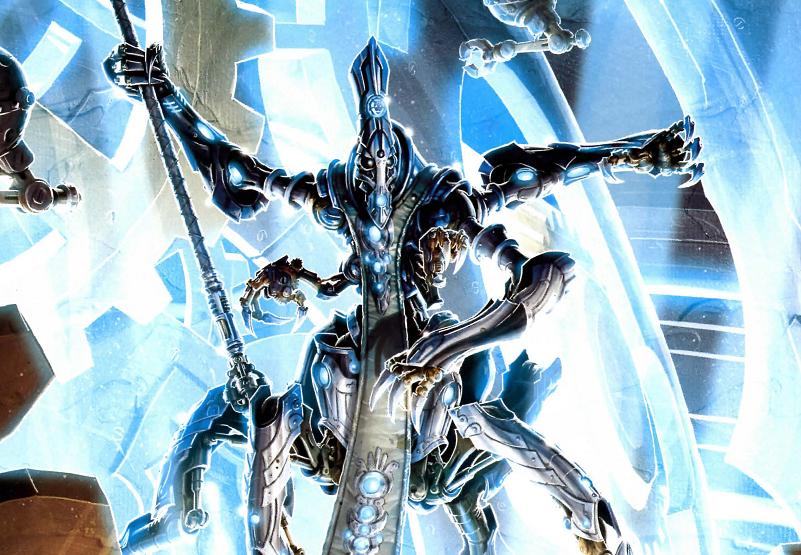
Father Lucant, Divinity Architect has served Cyriss for 250 years as a prophet and bastion. His presence is awe-inspiring for those in clockwork vessels, for he was the one who brought that theory to reality. He was the one to initiate the Great Work. In life, he was a mathematical prodigy and astronomer, drawing him easily in to the cult of Cyriss. He worked at the Cygnaran Royal Observatory and discovered the planet Cyriss there, seeing his faith vindicated in the orbits of the planets. It drew the attention of the inner circle, who initiated him into higher secrets, granting him answers he'd always wanted. His destiny was changed forever when he went to the Foundry of Enumeration, learning to contro lvectors as a warcaster as well as showing talent in analyzing the output of the Cipher Engine. He was at the center of the events that destroyed the Foundry, surviving only because he was able to transfer his soul into a vessel. This lifted a veil from his eyes, making the ouput of the Engine clear to him. He realiuzed that Caen must be turned into a machine to manifest the goddess, and he dedicated himself to that as the first iron father and later the divinity architect. Over the centuries, Lucant has continued to study the messages of Cyriss to advise the Convergence, and recently he has found it is time for the Phase of Alignment, when the Convergence must got o war. It was not a lightly made decision, of course, but Lucant knows the time for doubt is over, and he willingly leads armies into battle himself to show it. Those who follow him know they receive orders from greatness, and it is believed that he will be there when the Manifestation is, at last, complete. His gimmick is hurling around magnetism and antimagic, and his feat allows for a major defensive boost and improves repairs.
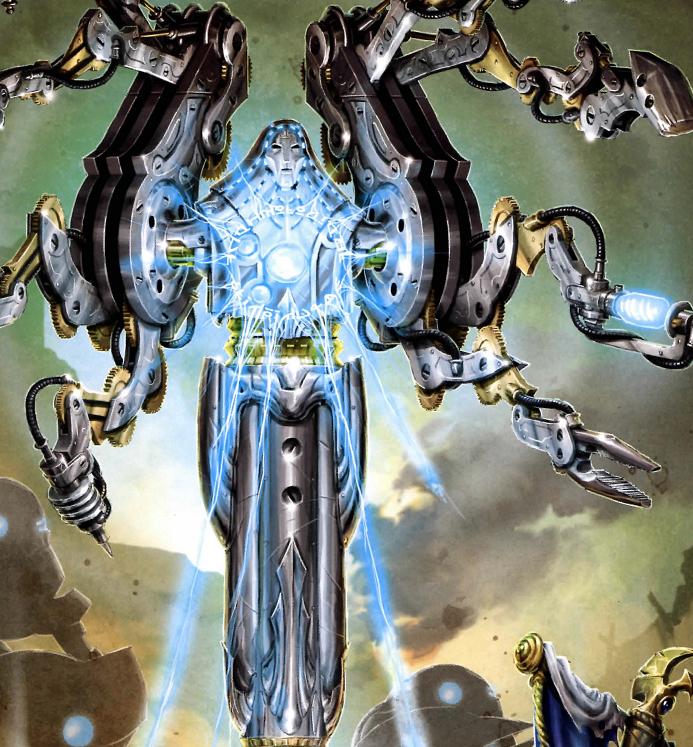
Forge Master Syntherion is the chief creator of the forges, seeing fractal perfection in the relationship of parts to whole. Each machine is a communion with Cyriss. He is perhaps closer to total synergy with the machine than any other. His life before his transformation was a very, very long time ago, and he has long surrendered most of his human emotions. He is always processing, as remote as the Constellation's members, focusing on pure math and engineering epplications. He is such that he can lose himself for days on end without noticing time passing. He goes where he is needed, tasked to improve temple machinery and lead Convergence forces. He claims key territories with his army, efficiently clearing out opposition and rapdily constructing transformative machinery to realign geomantic energy. Once done, he moves on. Even the most difficult battle is, to him, a mere distraction. Even among his fellows, his understanding of engineering is near sublime. He harmonizes with machines flawlessly, and his technical ability is so far advanced that few outside the sect can even understand his innovations, and he can reproduce and evne improve on new technology after only a glance. Even to his peers, his thoughts are alien. He brings the same efficient approach to war as his workshop, with no room for emotion, pity or mercy. He works to quickly eliminate all opposition, and as he has no patience for variables he relies heavily on vectors, whose actions he controls masterfully. The clockwork soldiers who help him know he has no patience for error and will destroy those who fail him. His gimmcik is buffing vectors, and his feat allows them utilize all of their weapons at once freely.
So, what are vectors? They are superficially similar to warjacks, but have no false sentience. In the Convergence, only a soul has the right to will. Soon after Cyriss was discovered, her followers began to work on a new type of warjack, free of the flaws they saw in cortexes. They isolated the mechanism allowing a warcaster to mentally control the cortex, seperating it from the decision-making regions that were always unpredictable. They redeveloped it into the interface node. When a warcaster attunes to a vector, it is infused with the warcaster's own skill and experience, so they tend to be even more exacting in the makeup of their vector battlegroups than warjack-using casters. The node also allows for better coordination between vectors, but because they lack any information processing ability, they can't operate without direct attention, limiting their use in smaller engagements, when the sect must rely on soldiers and servitors. Vectors are highly mobile platforms, using displacement field generators to partially negate their weight. Those with legs maneuver easily, using the field to stay erect and stable, but recent breakthroughs have allowed other vectors to hover instead of walk, taking slightly more power for even more freedom of movement. Most vector weapons utilize disposable machine ammunition, the construction of which is seen as a prayer to Cyriss. Most are made in the largest temples, though a few smaller ones can make a handful of chassis and weapons.
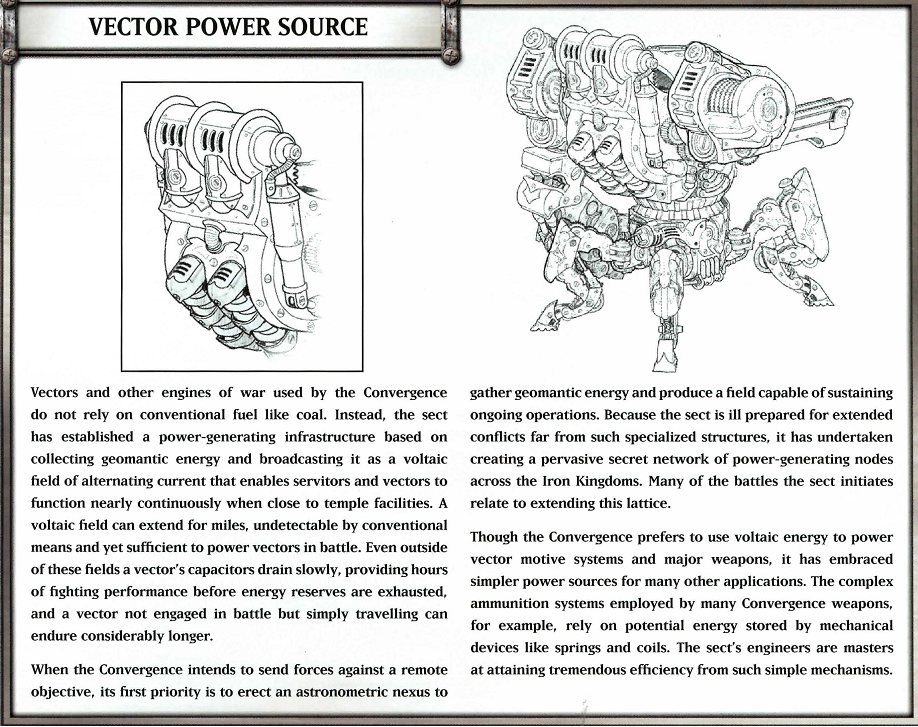
Next time: Vector
Forces of Warmachine: Convergence of Cyriss
Original SA post Forces of Warmachine: Convergence of Cyriss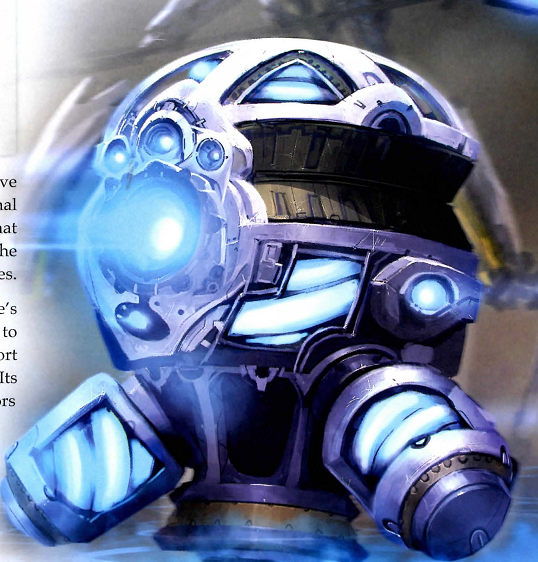
The Corollary is the first vector to benefit from innovations in arcane displacers allowing for greater hovering mass. They're nearly seven feet tall, but only wait one and a quarter tons when inactive. (They are weightless, when active.) They have a unique niche in the Convergence arsenal. Unlike other vectors, they aren't about destruction. They support warcasters by housing arcane accumulators that store the residual energies a warcaster generates in combat. These are captured by a set of recessed irises, then dispensed by mental command to empower other vectors. Additional relays extend a warcaster's area of control, and so a warcaster with a Corollary is exponentially more efficient. In battle, the Corollary automatically orbits the warcaster, reorienting itself to the most efficient position to collect arcane emanations. At warcaster direction, it acts as a conduit for other vectors' focus inductors, boosting them with charges of power and amplifying tactical options.
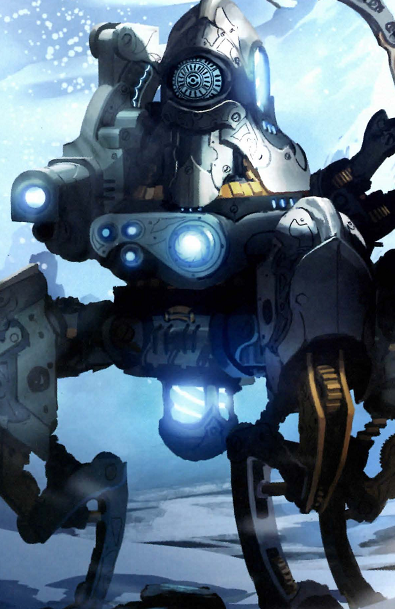
While outside the Convergence, they would be a marvel, the Diffuser is actually produced in great quantities. It is just under seven and a half feet tall and weighs in at almost 2 tons. Its ripspike launcher is a channel catapult powered by a high-tension spring, with each ripspike having tiny fins to adjust trajectory in flight. This allows the projectile to fire a flight pattern set by the warcaster when the weapon is fired. With a well-calculated course, it will maneuver through the air around battlefield variables before it strikes, a vast advantage over ammo limited to straight lines. Even after the ripspike embeds itself, its job is not done. As a secondary function, its arcane relay sends targeting data to other vectors, clockwork vessels and priests.
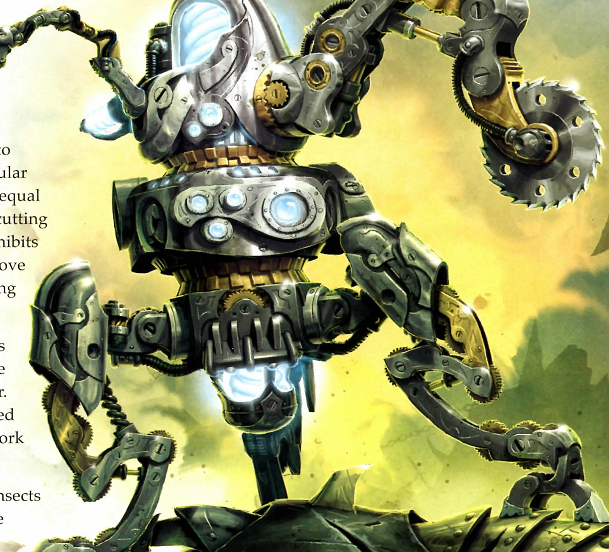
The Galvanizer is the oldest vector configuration in current use and the backbone of many forces, nearly seven and a half feet tall and almost 2 tons. Its metal saw isn't so fast as those used for lumber, but is better suited to tear through steel. It has power and precision, able to cut through heavy armor or remove dented plating from allies without harm. This, coupled with a field repair array, makes the vector an ideal vehicle for battlefield repair, even able to mend the plating protecting a clockwork vessel's soul node. In battle, they resemble robotic insects swarming across the landscape, shedding 'jacks like a horde of locusts. Perhaps more disconcerting, however, is their scramble to their own fallen, not to scavenge but to repair.
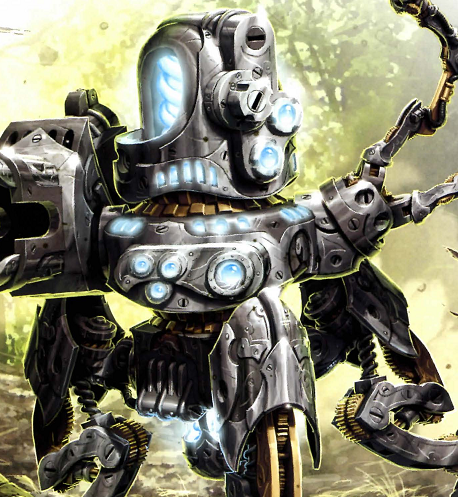
The Mitigator produces a distinctive hum from its rapid rotational accelerator. It is nearly seven and a half feet and nearly 2 tons, spinning its hurlon chamber to whirl its razor-shap, precision-tooled bolas at enemies with immense speed. The bola round spreads open to envelop targets in a steel web on impact. It may seem to be an unsophisticated and ancient weapon, but it uses tools that transform it into something very modern indeed. It's a precision tool, carefully deployed, to shred both troop formations and single threats flexibly. They are highly effective support weapons, able to thin out even the most heavily armored troops.
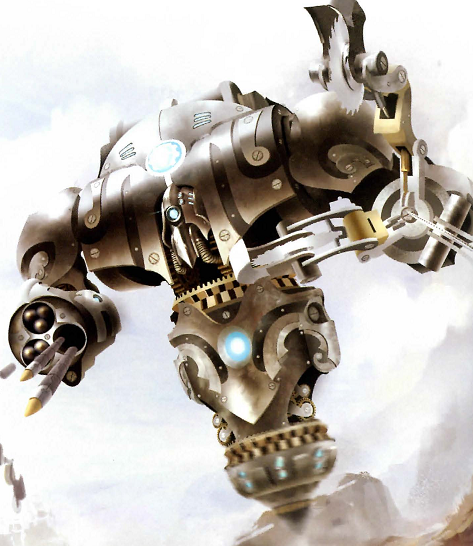
The Assimilator floats above the fray on an arcane displacer drive, nearly twelve feet tall and almost 6 tons when inactive. Its rending claw snaps open and closed quickly, while the assimilation auger grinds behind wearing gears, roating its microswarm launcher into place. While vector arms frequently rely on kinematics, few showcase force manipulation quite so well as the dissevering microswarm. It's a three-barreled cannon firing javelin clusters with two distinct modes of attack. If a javelin strikes its target (or the ground), a spring-loaded impact trigger causes it to detonate into bladed gears. However, the explosion can also be triggered in midair to shower an area with cutting projectiles. Those close to an Assimilator must deal with the rending claw, which can make short work of 'jacks and use their scrap to patch itself up.
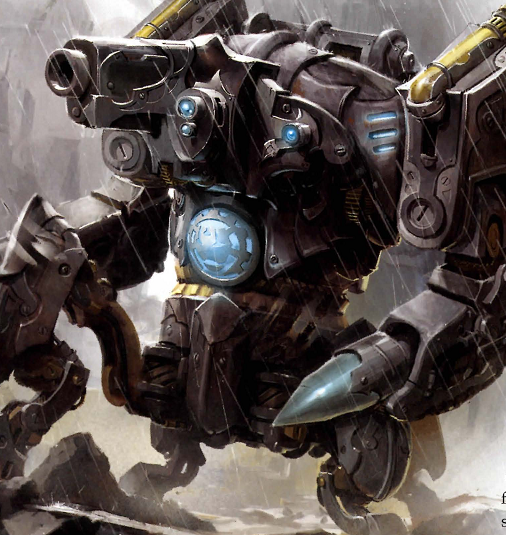
The Cipher uses the key servitor technology of the Convergence in its servipod motor, a shining example of groundbreaking innovation. The machine itself is just over 11 and a half feet tall and nearly 9 tons. Every shot of its mortar shoots seven miniature servitors that disperse in flight for maximum coverage, with loading chambers providing groups customized to the warcaster's needs. Once the correct ammo is chosen, the servipods are launched. Blasting servipods tear trhough light armor, while lumichem servipods tag enemies with targeting beacon chemicals, and tunneling servipods burrow into the ground before detonating a charge that ruptures the earth around them. The Cipher is favored not only for its versatility, but also its efficiency in melee, wielding two heavy piston spikes to sunder armor plating of anything that gets through the servipod barrage.
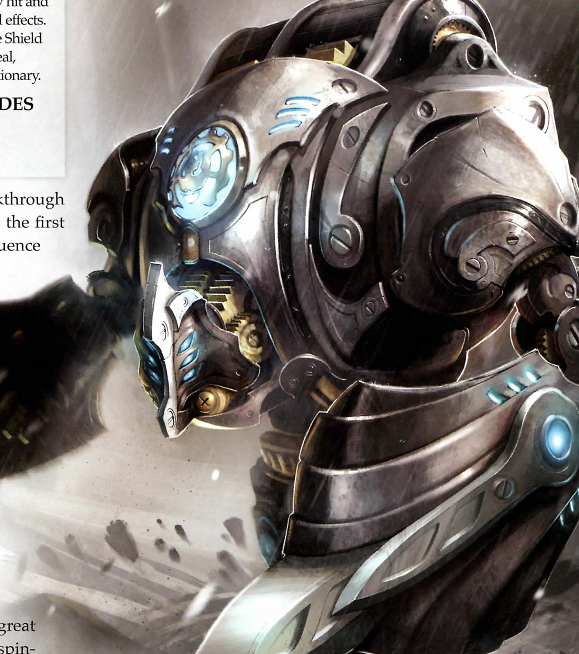
The Conservator was one of the first vector chassis to use the arcane displacer drive, nearly twelve feet tall and just over 5 and a half tons when inactive. Freed from gravity, it has immense freedom of movement, used both offensively and defensively. It is popular among priests expecting to contact the enemy, equipped with sturdy shields and low-traction gyros that allow it to easily intercept attacks. Offensively, it uses spin-control field drives in each of its large ablator blades, which supplement their kinetic energy and empower secondary collection fields, which capture the energy released by destroyed clockwork vessels, converting it into a surge of power that improves the strength of the ablator blades temporarily. It is both a bodyguard and a weapon of retaliation.
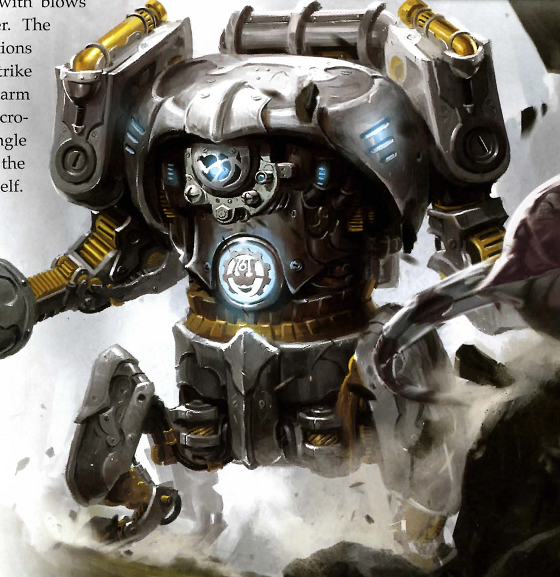
The Inverter , at just over 11 and a half feet tall and just over 9 tons, is a simple solution to the simple problem of smashing something to bits. They are used to charge directly at the most armroed enemies around, using their gigantic macropummeler to smash through armor or obliterate small targets. While that gets back into position, it continues the assault with its whirling meteor hammer, calculatinge each attack for maximal damage via countless microrotations to find the perfect angle, no matter what.
Next time: The (not really) first Colossal
Forces of Warmachine: Convergence of Cyriss
Original SA post Forces of Warmachine: Convergence of Cyriss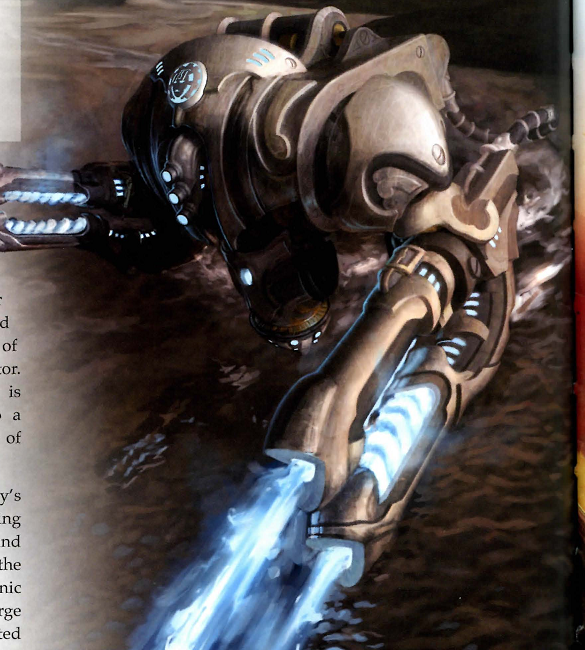
The Modulator is nearly twelve feet tall and five and a half tons inactive. At first glance, it resembles the Cygnaran storm-based mechanika, but in truth, rather than generating electricity via rune plates and storm chambers, the electro-arcane energies are handled by the voltaic nimbus generator invented by Fluxion Vincent Bailey, capable of storing geomantic energy and converting it into an electrostatic field via gears, pulleys and charging rune plates. The electrostic charge runs along the hull, protecting it from electrical attacks and generating powerful shocks for anyone that touches the vector without insulation. A pair of galvanic arc emmitters allow it to channel the charge into a bolt of energy that will electrocute everything between the Modulator and its target. After testing, they were modified to allow more precise control over the arc, largely to enable warcasters to strike the foe without collateral damage to clockwork vessels or priests.
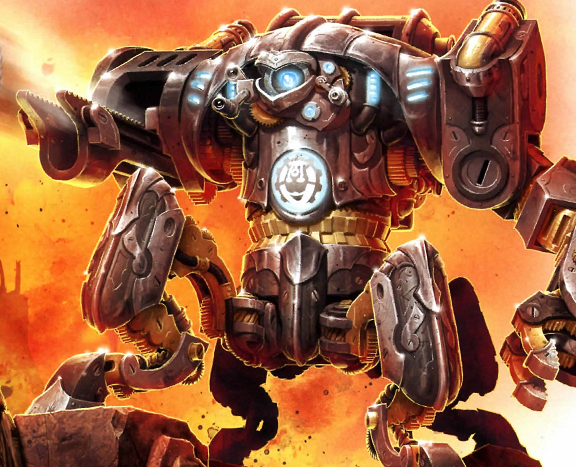
The Monitor is immensely potent, nearly twelve feet tall and eight and a half tons. It has peerless optical arrays, identify targets despite camouflage or even magical concealment. It can rapidly shuffle through an assembly of lenses, eahc calibrated to pierce sophisticated physical or arcane defense. Once targets are detected, it relays that data to its warcaster, who calculates the best trajectory for its deadly ellipsaw flinger, which hurls spinning saw blades. Each blade can be made to alter its axis of rotation mid-flight by custom internal accelerator wheels, allowing them to strike from angles of vulnerabiltiy for maximum damage. In addition, the Monitor has a powerful spring-spike fist backed by a counter-recoil mechanism that captures excess force to reset itself for repeated fire. Each activation of the spring coils sends the spike forward with immense speed and force to neutralize enemy threats, allowing it to seek new targets.
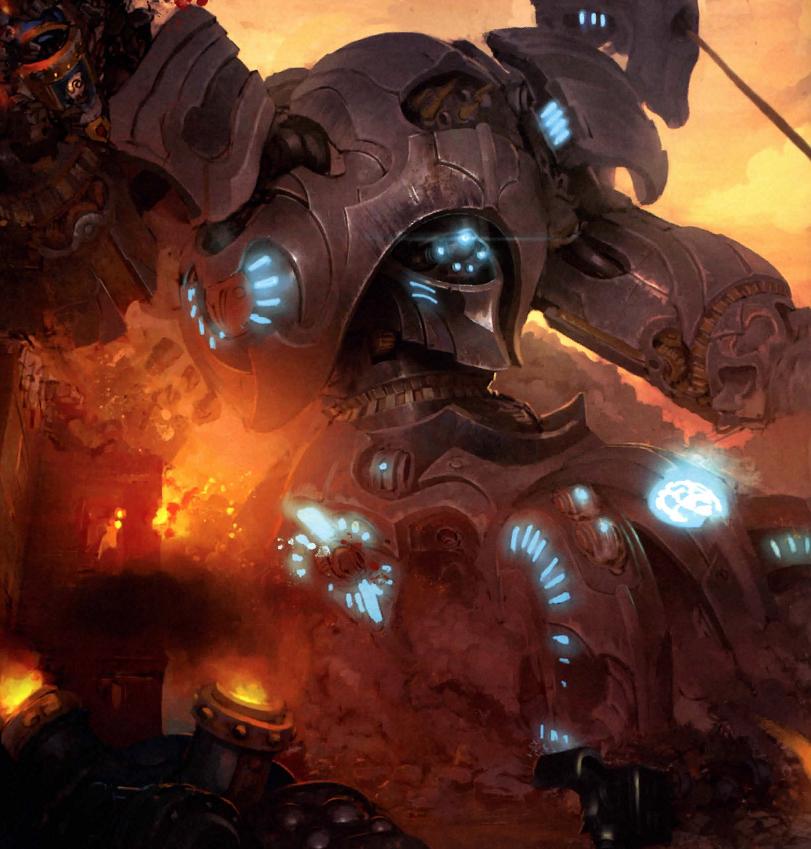
The Prime Axim is one of the mightiest vectors ever made, a colossal at 33 feet tall and 75 tons when inactive. For more than a century, they have laid under guard, and anyone who saw them died. Only now are they able to be deployed against enemies. Originally built as temple guardians, the Prime Axioms are one of the most important weapons for the Convergence, built not in just one temple workshop but in several installations each making key components for assembly at the Temple of the Prime Harmonic. The early version were ambulatory but slow, due to the immense demands on their power supplies. Improvements on the arcane displacer drive granted greater flexibility and range of action. Later iterations were armed with suitably potent ordnance, as well, using new steel alloys that are much harder but much lighter than those available to other armies. The foremost weapons it has are immense drill vices, huge grasping fists terminating in diamond-hard drills able to pierce any known alloy. A pair of telescoping tow cables on the chassis allow it to harpoon foes with perforating spikes of the same alloy as the drills, so they can be dragged into range. Against infantry, it deploys its accelespiker, which is recessed in the hull, storing a reserve of superdense metal spikes that it can fire at thousands of rotations per second with terrifying accuracy. It can pepper single targets or lay waste to small areas at its warcaster's whim. Further, the machine houses deployable servitors that multiple its potential force unimaginably. It can launch them to suit its needs, tasking them for minor repairs, firepower or target painting using lumichem. With so many weapons, heavy armor and servitors, it is the equal of any weapon on Caen. In action, it is awe-inspiring, the thrum of its energy cycles near defaning as it hovers over the battlefield, tearing apart troops and warjacks alike. (Colossals are the largest kind of warjack, and the other factions got them in a slightly earlier book, which I'll cover once factions are done.)
So, what about the soldiers? The Convergence has no standing army, spreading its manpower among its temples. However, every member has a duty to be ready for battle. Their greatest advantage is the clockwork vessel. On death or with fluxion approval, the souls of the awakened are put into essence chambers, which are then installed in clockwork vessels to be an immortal machine afterlife. Adjusting takes some time, and the extensive military training htey undergo helps master the use of the vessels. For most, combat training is routine, as they may be summoned for battle at any moment. A smaller number serve as permanent soldiers, often the most capable combatants of the sect. All of the Convergence can expect many clockwork forms as they seek perfection, but those dedicated just to combat move through them more quickly, as those who perfect one form or have capacity for another may be transferred to new vessels to continue their evolution. Most spend the majority of their time in utility vessels for labor. Clockwork vessels feel no pain, and their destruction is rarely the end of their existence, so they tend to be very brave indeed. Unlike vectors, most draw power from the souls within them, allowing them to function beyond the range of voltaic fields for versatility. There are drawbacks - they typically have reduced individuality and occasionally lose the human spark of ingenuity, making them predictable. There are ways to address this, such as assigning those experiencing loss of self to the Eradicators, whose combat style is aggressively individualistic.
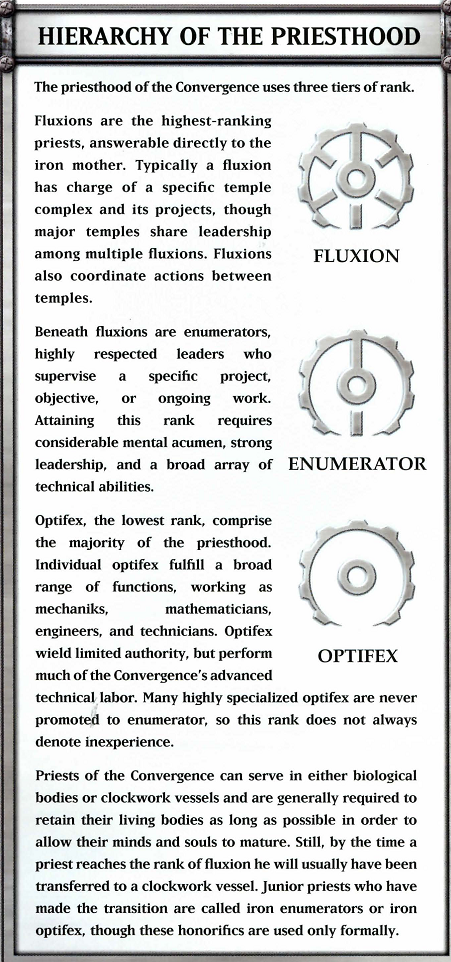
Clockwork soldiers are the most common troops, but they get accompanied by specialists of several kinds, including living priests. Though less hardy, they tend to be more individualistic and react more readily to the unexpected. Plus, they always have useful technical skills for field repairs. Every member of the Convergence understands their place, and their ability to see themselves as part of a greater whole means they don't need a complex chain of command. The priesthood has a hierarchy, but the army has no conventional officers. Instead, they just have soldiers, who obey, and unit prefects, who direct and answer to priest-commanders. Prefects oversee small units of the same discipline and rarely need to monitor the individual members of their unit, who can be expected to follow their trianing. Thus, their main job is ensuring synchronous action with the rest of the army. Prefects are chosen for combat experience and related expertise. Outside of permanent garrisons, it's not a permanent status, and some are made prefect only for specific missions requiring their unique skillset. In permanent garrisons or long missions, the senir-most veteran, or first prefect, of each discipline is responsble for coordinating larger groups and keeping the senior clergy informed.
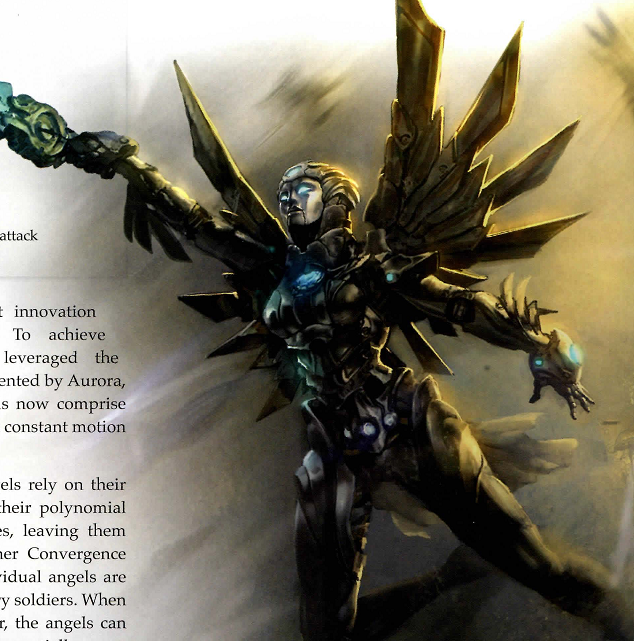
Clockwork Angels are the newest in Cyrissist technolgoy, having managed true flight via Aurora's compact displacer drive, and now they are fast and deadly striek forces of constant motion. There aren't a lot of them, and they rely on speed and precision to surgically cripple enemy forces for the rest of the Convergence armies. The polynomial beams of individual angels are more than enough to kill most soldiers, but against a more dangerous foe they tend to combine their beams for exponentially more powerful energy blasts. Aurora personally selected the first clockwork angels from her most capable followers, and they have always worked closely to adapt to the new tactics their bodies provided. The form has gotten more volunteers lately, each hoping to serve under Aurora. Only veterans fully attuned to the control of vessels can meet her standards, and few of those have the mental dexterity to master flight.
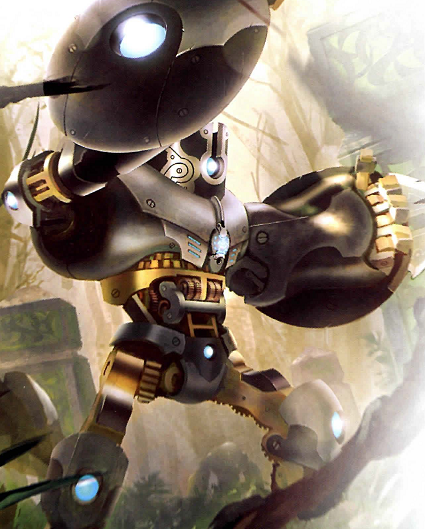
The Eradicators appear to be terrifying, synchronized machines...until you face them. Most Convergence doctrine emphasizes unity in motion and purpose, but they also want independent thought and ingenuity, which can be easily froggten after dacdes of service. Those who are suffering loss of self are extracted from their vessels and placed in eraadicators, to be reminded of the importance of free thinking. On the battlefield, each has one job: find the enemy, smash them. Unlike most Convergence units, which act as a synchronized whole, eradictors engage the enemy individually, encouraged to aggress wildly. After one enemy falls, they use the momentum of their attack to drive ever deeper behind enemy lines. Their primary weapon is the protean buckler, which uses a spring-loaded mechanism within the shield to release bladed fighting claws, which frees the arms for greater mobility and accuracy even against nimble foes.
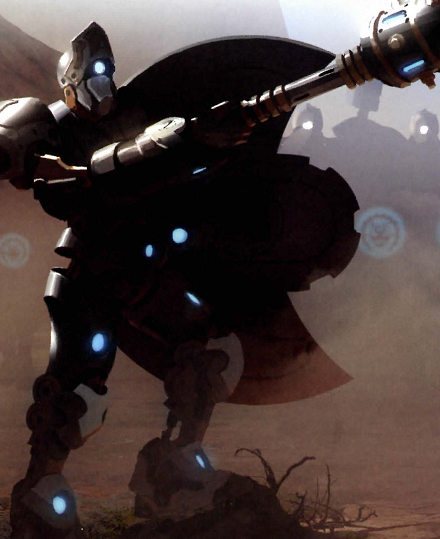
Obstructors are frontline troops, using their unity to achieve victory. When non-clergy perish or are otherwise deemed worthy of immortality, their souls go into essence chmabers. The obstructor is the first step in the evolution of forms, one of the most basic but perfected bodies. They are about the size and shape of a human, so they are well-suited to acclimating the soul its new nature. Once interred, they begin to train in the core tenets of the Convergence, becoming part of a larger machine. They must learn to anticipate and emulate the thoughts and actions of their fellow soldiers, using heavy shields that can lock together via ingenious clockwork to form an impenetrable barricade. While the so-called shield walls of human armies allow for missteps, and thus gaps, the barrier of the obstructors is perfect.
Next time: More soldiers of the machine.
Forces of Warmachine: Convergence of Cyriss
Original SA post Forces of Warmachine: Convergence of Cyriss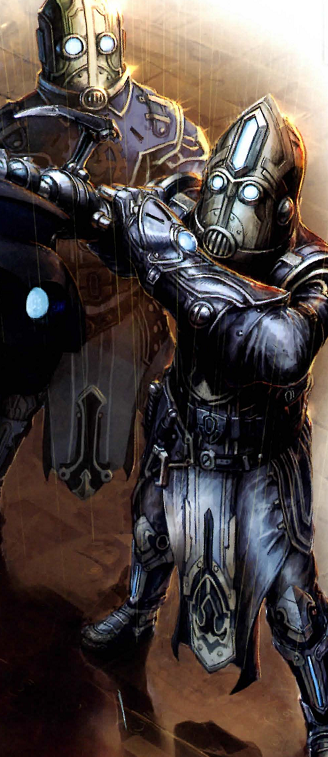
An Optifex Directive is a team of optifex priests who go to battle to repair and field-modify clockwork vessels and vectors. They are low-ranking but very brave and are often recognized for the dangers they face, especially given they're still living. They have superior technical skill and tons of tools to repair vessels and vectors, or to recalibrate them in response to shifting combat needs. On top of optimizing mobility, they can rapidly recalibrate vector weapons with arcane tuning, briefly allowing them to function against incorporeal or otherwise supernaturally shielded foes. In battle, they must keep in constant motion around the warcaster and vectors, so they can always be ready.
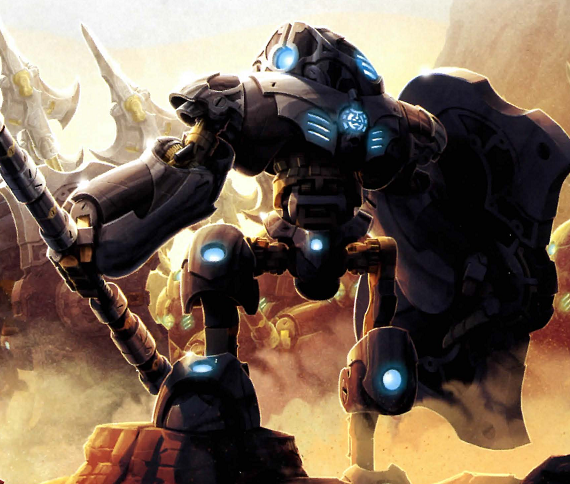
Reciprocators are the next step up from obstructors. They tend to have been in service for decades before receiving the reciprocator chassis, because they must be masters of manipulating and controlling clockwork forms. They are exceptionally robust and larger compared to obstructors, so the transfer can be jarring. They act like springs, absorbing the energy of enemy attacks and then counterattcking in perfect unison with a fluid grace despite their weight. They can interlock their shields and easily use their protean polearms in either spear or halberd configuration for attack or defense. Freed of mortal flesh, they can handle even the harshet conditions without weakness, feeling only oneness for the machine.
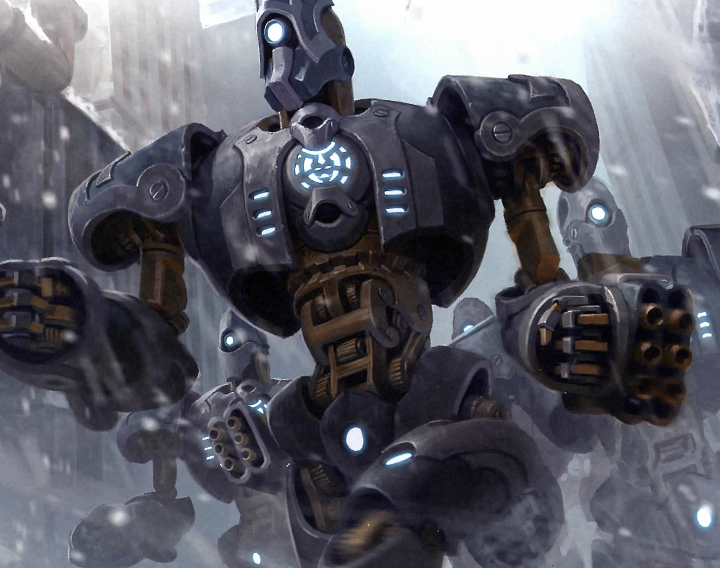
Reductors are an alternative path, reserved for those who have been in clockwork vessels for long enough to adapt quickly and effeciently to dividing their attention, even mid-battle. They must be quick thinkers able to adjust trajectory settings on their swarms in an instant, advancing behind frontline troops to support them with clockwork swarms that avoid Convergence soldiers and bore into their foes. Their swarm projectors buzz constantly, filling the air with a lethal cloud of clockwork devices, each no more than inch and housing dozens of razorblades on springs. The mechanisms in the swarm follow programmed trajectories around obstacles to attack their targets, disassembling them in minutes. Only when the internal winding is expended do they fall, silent, to the ground.
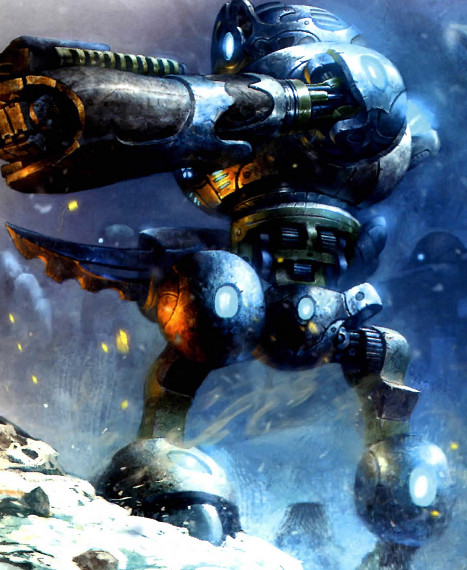
Perforators utilize ranged weapons more in tune with the Convergence than unpredictble firearms using chaotic explosive powder. Instead, they have designed precise mechanisms for launching protean javelins, relying on gear-wound springs to fire the javelins with intense force. Those chosen as perforators must have the ability to calculate ballist trajectories on the fly with gret efficiency of motion. On the battlefield, they use the protean javelin launchers to overcome armored or resilient foes or to support the front line with precision sniper fire, both roles they're well-suited to.
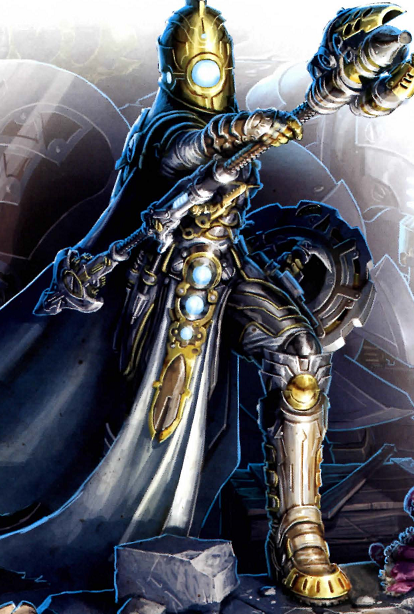
The Transverse Enumerator is a priest trying to gain experience through battle before joining a clockwork vessel. They are creators and students of engineering, masters of maintaining all the weapons the Convergence uses. They comprehensively understand all Convergence designs and have spent time working in directives to gain leadership and battle experience. (Also, blowtorches.) Their intimate grasp of design specs and limitations lets them quickly adjust a unit's tactics even mid-battle, orechestrating the attacks of clockwork units with amazing precision.
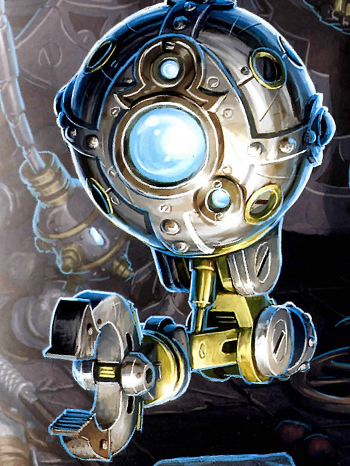
ACcretion Servitors were meant for foundries and workshop assistance, but have proven useful in abttle. They are able to make quick repairs to any clockwork device semi-autonomously. Each servitor is managed by a clockwork computational engine that gives it the ability to perform complex tasks independently. Each directive is extremely simple, but when combined, they form a sophisticated response algorithm that determines the actions of the servitor. Servitors lack true will and any intelligence at all, but do have an array of mechanikal tools for temporary repairs in battle. They hover above the ground by manipulating ambient geomantic forces, resembling honeybees as they flit around repairing things. In a pinch, they can strip down enemy warjacks, but they're not exactly tough machines.
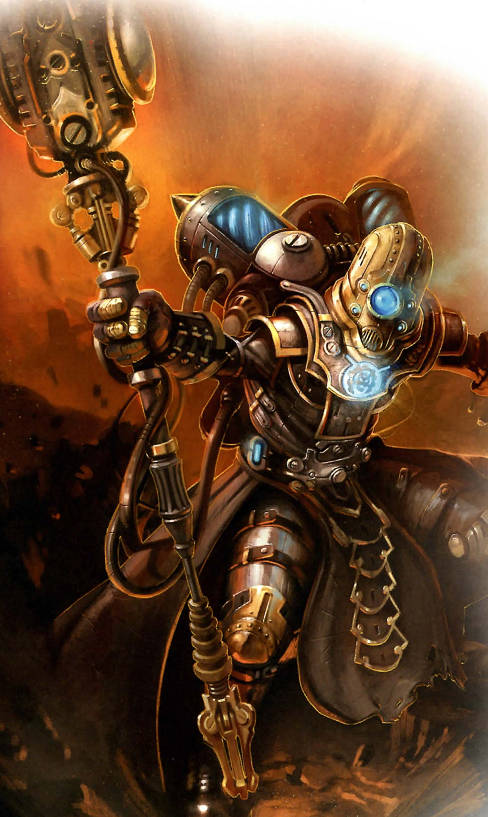
The Algorithmic Dispersion Optifex has a vital job that must be done by a living person: the deployment of algorithmic dispersion arrays, which increase the reach of warcasters in abttle. Their tuning staves and amplifier engines are too delicate to be left to servitors, so the optifex train diligently to keep the connection running. They must always be vigilant of their warcaster, positioning near the vectors to act as an arcane relay for the warcaster's will. By modulating the dispersion array's frequencies, they act as a transmitter to bolster the vectors or cast spells, and to ensure they remain effective they typically serve only under one warcaster for extended periods, working with them even off the field. It's not an easy job, and often confounding. You must maneuver through battle with heavy equipment, right in front of danger, but it is a necessary service. STill, it doesn't ensure advancement, so senior priests often take pity on them and rotate them out to other jobs after a while.
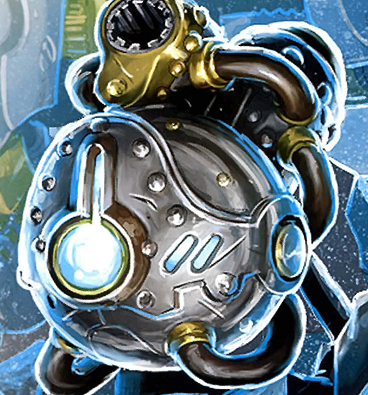
Attunement Servitors utilize one of the greatest alchemical creations of the Convergence: lumichem. It's an adhesive, chemiluminescent liquid that glows incandescently for a few hours after brief exposure to air, and it's easily made in bulk. Attunement servitors seek out high-value targets and use the lumichem to designate them for destruction. They are guided by complex encoded commands, flying between enemies to reach their targets. If they spot a foe that doesn't fit the preprogrammed priorities, they ignore them unless engaged. Once they find a target, they fire their ampule launchers, which hurl small glass globes of lumichem at the foe. Even if they miss, they expldoe with great force, spraying the stuff over a wide area. Enemies coated in lumichem are easy targets, highly visible and often impaired by the adhesive qualities of the stuff. Plus, all Convergence troops are trained to concentrate fire on anything marked with lumichem, so they often become dead very quickly.
Next time: More Servitors!
Forces of Warmachine: Convergence of Cyriss
Original SA postGranted so. They get really interesting tactics, though, given the specialized nature of all their units.
Forces of Warmachine: Convergence of Cyriss
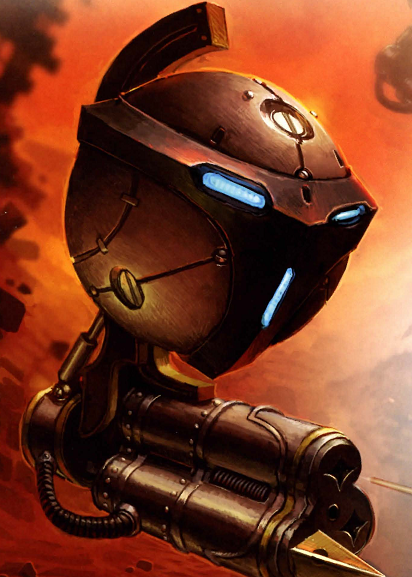
The
Elimination Servitor
operates on a single main directive: hunt down and kill everyone not on its allies list. They were initially designed as guards, but the recent change in priorities has led to them being used offensively. They're cheap and easy to make, but are a serious threat. They use sophisticated visual sensors and response algorithms to scan battlefields and pick targets out, using more conditional subroutines than any other servitor type. They must know when to engage in self-preservation and when not to, after all, and their programming evaluates targets based on exacting criteria, as they often have limited guidance. Once a target is acquired, the servitor advances in a series of precise, measured movements and brings its spike projector to bear. It, like all Convergence guns, doesn't use gunpowder, but a gear-wound spring that shoots a heavy iron spike. It deals modest but reiiable damage to machines, and is more effective on living beings. Several elimination servitors together can quickly kill quite a lot of people.
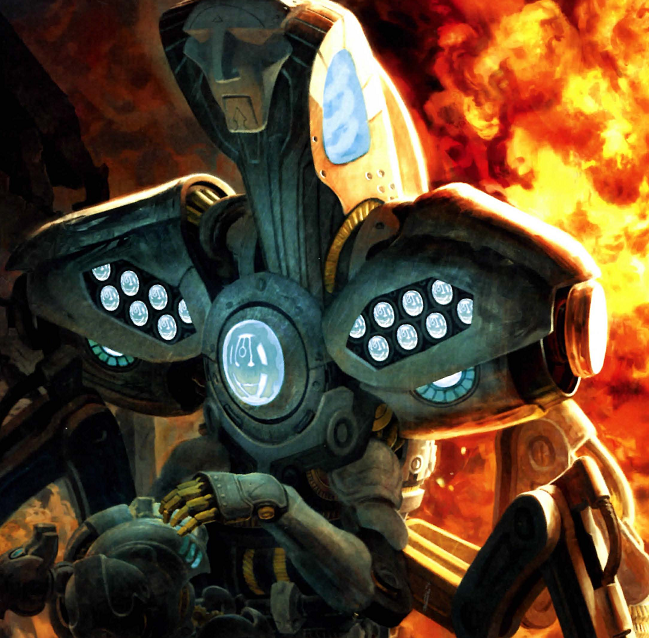
The
Enigma Foundry
is a vessel designed to protect the souls of the faithful. In more peaceful times, the danger to an essence chambter was rare, but now, the chance of true death has greatly increased. While the Convergence exists across Immoren, its numbers are low compared to a nation, and members carry decades or centuries of valuable knowledge which can't easily be replaced. Damaged clockwork can be rebuilt, but a suil cannot. The enigma foundry was developed to help ensure eternal life. It's a specialized clockwork body animated by a senior priest with proven skill in making clockwork vessels. They are entrusted with the job of reclaiming and safeguarding the souls of those fallin in battle. They are covered in tools that allow the foundry to reconstruct fallen vessels quickly using salvaged parts, installing essence chambers collected from the fallen. The ability to protect these warriors and return them to the fight is an immense advantage, as the Convergence is routinely outnumbered. The importance of enigma foundries makes them essential to most Convergence tactics. In rare instances where they must retreat, the foundries are first to evacuate, to safeguard the souls they collect.
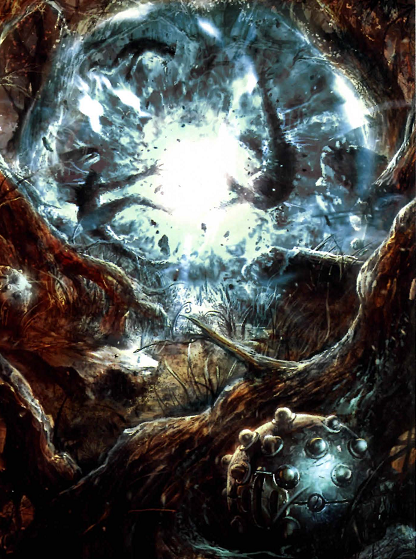
Reflex Servitors
are precise and deadly in their function, the perfect representation of efficiency. They were originally a defense of last resort, and use the same computational engine and geomantic drive of other servitors, but to a very different imperative. They are programmed to kill enemies by self-destruction. They do not sacrifice themselves randomly, and maintain self-preservation directives until other measures have failed or their success is virtually assured. They are more like a predator than a mine. The behavior took a lot of modifications to standard response algorithms, including adding in restraint to avoid striking until the enemy is most exposed. The drive was calibrated to store residual kinetic energy, allowing sudden bursts of speed that make the servitor very good at getting where it has to go for its job. The probability mine in its core does not function with any crude expplosive, instead relying on stored potential energy. At the right command from the computational engine, it will suddenly burst into countless pieces of shrapnel, designed to maximize transference of kinetic energy in a large, lethal blast zone.
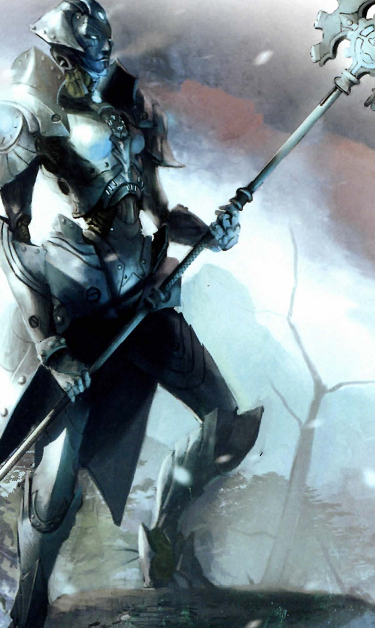
The
Steelsoul Protector
is a clockwork frame designed as a bodyguard, ready to place itself in danger to protect its charge. They endlessly refine their protective instincts and reflexes to most effectively intercept blows. Their reactions must be instant ,driven by training and superior perception. Their entire body is designed to shield the priests of Cyriss, light enough to move very quickly but shockingly durable. They are made of resilient steel alloys backed with flexible composites, and have enough strength use the giant iron glaive they are given to deflect blows and launch counterattacks. They are among the most respected and vigilant Convergence warriors, drawn only from the most perceptive of the living, seasoned veterans who understand the Convergence battle doctrines and tactics. Only the most worthy ever get to become steelsoul protectors.
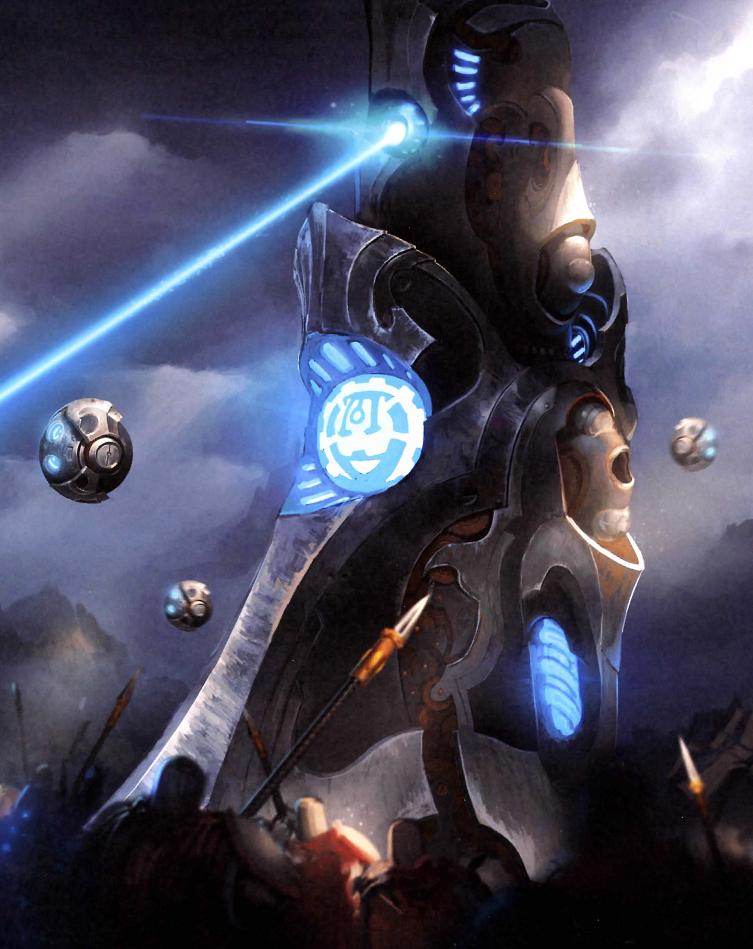
The
Transfinite Emergence Projector
is a weapon of immense sophistication, towering over even the vectors. It moves across the battlefield with the assistance of its
Permutation Servitors
, which flit about in patterns meant to optimize its firing sequence. They move into configuration and hover in place as focal lenses for the weapon's potent energy beam. While now used as a battle engine (a new type of unit introduced in another book for the other factions, basically a giant siege engine), it was originally made for another purpose: demolition of unneeded structures around an area where a nexus had to be built. The aperture pulse of the machine can quickly clear a site of buildings...and of soldiers. The machines do not operate using interface nodes or souls. Instead, they are semi-autonomous, rather like the servitors, relying on a very sophisticated calculation engine to coordinate smoothly with the permutation servitors and use its energies. The permutation servitors use computational algorithms to determine focal positioning, modulating the aperture pulse with pinpoint accuracy, terrifying intensity or wide-area saturation as required. They also serve as dispensable shields, propelling themselves around similar to reflex servitors in order to intercept threats. Each emergence projector has an assembly plant within its immense form to produce new servitors as needed, ejecting them from two lateral bays to fly into formation for the next salvo.
The End.
So, what's next? Cygnar, Khador, Cryx, Protectorate of Menoth, Trollbloods, Skorne, Circle Orboros, Legion of Everblight, Mercenaries or Minions?
Forces of Hordes: Minions
Original SA postMinions now, then Cygnar.
Forces of Hordes: Minions
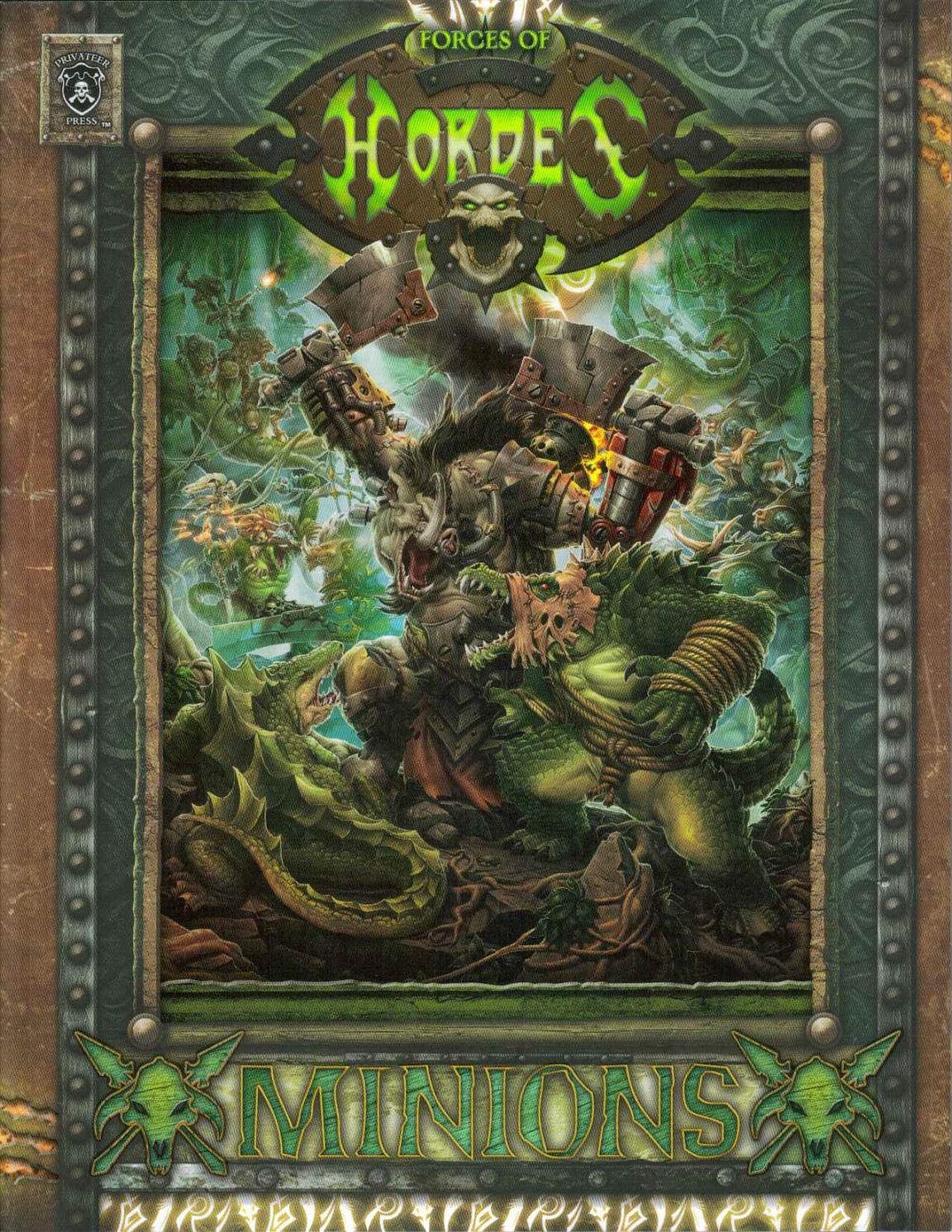
The Minions are those that seek profit from war, or which seek allies in trade for supplies or protection, or who just get enslaved. Whatever their motivation, they're an unknown to most armies, able to catch enemies offguard. They are very diverse, and they have started to gather their own banners. The farrow of the Thornfall Alliance have gotten ahold of gns and, under the leadership of Lord Carver, they are a terrifying army of brute force and patchwork monsters. The gatormen of the Blindwater Congregation mix strength and subtlety, taking advantage of the swamps and waterways to launch deadly ambushes at the direction of Bloody Barnabas.

This is presented as omniscient narration, so in theory it's not slanted. There are countless small, unaffiliated groups out in the forests and deserts. They lack the numbers or agendas of their neighbors, but have their own needs. Many are swept up in conflicts, either by choice or force, and a few can even bargain with the great powers on their own terms. Survival often requires alliance, often by shared interest. Some farrow tribes have cultural ties to trollkin kriels. More commonly, these alliances last only as long as a threat is in place, such as when the gobbers and farrow join the Wolves of Orboros to get railway workers from Khador out of the Blackwood Forest. More frequently, they may find their neighbors need their specialized knowledge or skills, bratering service for future promises. Few of these groups use coin, so these trades are most often for food, shelter or territory. Still, coercion is the most frequent way these 'alliances' are made. Outright enslavement just isn't rare - the farrow love to do it to each other. Dealing with these groups is risky at best, but sometimes, an exceptional individual can manage it, building up a solid reputation.
These adventurers may be motivated by sport or exploration. It's safer to cross the wilderness with an army, and allies may allow access to normally impossible areas, gathering vital intelligence on other foes. In some cases, they may just want to form relationships with the wild factions. There are no codes or standard contracts in the wilds, unlike the Iron Kingdoms' mercenaries. Free agents can offer their expertise to form relationships and contacts, if they're familiar with the faction's methods and expectations. It all comes down to being useful to each other and respect. Few free agents have that respect from the factions, and they must be cautions to ensure their allies have reason to leave them free and healthy.
The trollkin kriels are often willing to deal with their neighbors equitably. They are the most honorable and forthright of the fringe factions, but in many regions the kriels are isolated and have no higher authority, so deals with one kriel often fail to carry over to the others. This has started to change under leaders like Madrak Ironhide, Hoarluk Doomshaper and Grissel Bloodsong, but not even these arrangements are always recognized. Some longstanding friends and alleys, like Professor Pendrake or Alten Ashley, have earned reputations giving them ready access to kriels across an area. Due to their occasional contact with more 'civilized' nations, the trollkin are also one of the few groups able to pay with coin. It's not common, but some bounty hunters or other adventurers have found employment with the kriels using standard mercenary contracts. More commonly, though, they make alliance via mutual protection or access to food and supplies. Arrangements for grain or shelter over winter are common between the kriels and some farrow tribes, particularly in areas threatened by human armies or skorne slavers. Not all trollkin are above bullying others into their cause, however. Even the most peaceful value their kin over outsiders, and when threeatened, they may intimidate groups like the bog trogs into service, especially if they're near marshy terrain or other areas the trogs would have an advantage. This can cause longterm problems, though, as those pressed into service may hold resentments. Both bog trogs and farrow have been known to raid villages they think dealt unfairly with them, and even a large and well-defended village will have problems if raided constantly. Wise elders prefer negotiation.
The Circle Orboros count many tribes as vassals and temporary allies, and they've sought relationships with practically every group in the wilds. Over the centuries, they have befriended those they want service from, usually in a one-sided manner - the allies are required to fight as payment for services generations before. The druids have a longstanding tradition of taking advantage of tribal religious beliefs, particularly those involving the Devourer Wurm. Some of these groups believe the blackclads are emissaries of their god and willingly serve. Others are offered nebulous rewards, strung along for centuries by vague promises. The nature of these agreements varies a lot by regional overseer and potent, and some honor their promises while others are more manipulative. Some of the more abused groups do break free, but most don't, as the blackclads have a fearsome reputation. Tribal leaders just learn to be more careful in the future. Even their oldest allies are disposable weapons, to them. They are not shy about intimidating or forcing people to obey, and those that work with them short-term typically understand that they're seen as expendable. Still, they can offer a lot - they have deep knowledge of the world and its secrets, and may share some of the less guarded knowledge in return for service. They are sometimes reluctant to pay their debts, but are willing to lend strength to allies that serve well, protecting isolated villages or tribes from their neighbors. Druids occasionally even give supernatural assistance in growing crops or driving off predators, or even encouraging game to repopulate an area or divert streams to provide water in drought.
The skorne largely do not bargain or ally - they enslave and kill. Since their arrival, they have subjugated various tribes of farrow, gatormen and other species. Those they defeat join the Skorne Empire by force and are used as labor and fodder in their conquest. Almost every race, tribe and species on the continent have served under their whips. As their armies are stretched thin, they increasingly rely on slaves to fill gaps in their tactics. Some individuals of extraordinary qualities can make deals with the skorne. It's more likely among skorne cohorts at the edge of their influence, who need the aid of locals with specialized knowledge. The leading officers of the Army of the Western Reaches have learned to rely on some people, like ex-Cygnaran ranger Saxon Orrik, who has proved his skill and ability by guiding them across the Blodostone Desert and remains a local contact and scout. He's human, so he's never fully trusted, but his insight into human armies and th region have earned him contacts among many ranking skorne. Orrik survived the overthrow of Vinter Raelthrone with his contacts intact, and it's not uncommon for other individuals who want to work with the skorne to seek him out as an intermediary, which he rather enjoys.
The Legion of Everblight do not make alliances. What they need, they take. Even those that live long enough to be forced to fight for them will almost invariably be sacrificed, their blood used to fill the spawning vessels. Those who prove useful may be spared, but given the harsh pace of the Legion and the poor treatment they give to slaves, few of them survive long campaigns. Exceptions are rare, and could be abandoned or murdered the moment Everblight changes his mind. Most who do endure their slavery are at the bottom of the Legion hierarchy. Prolonged exposure to the blight may begin to warp them in body and mind. This secondhand blight does not give the benefits of Everblight's direct manipulation, but often twists their flesh, and it's not uncommon for slaves to grow the same scales, spikes and talons as the Nyss and ogrun. The Legion is more accepted of those with these blight marks, and those who bear them often realize that with them, there is no one else who would take them in if they escaped. Their bodies are marked by Everblight, and their souls will soon follow.
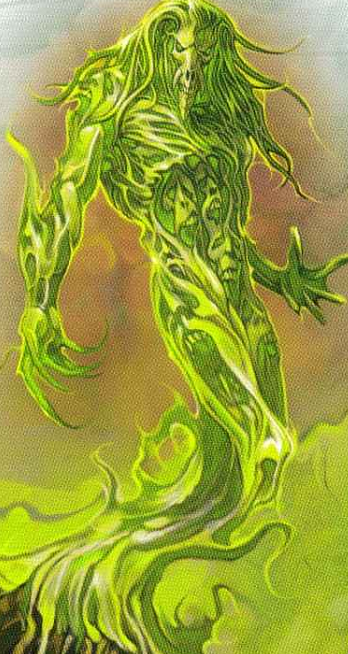
A
Feralgeist
is a creature that lurks in the shadows, their ghostly green forms drifting through trees and stones towards the scent of death. They can be found serving the Circle Orboros, the Legion of Everblight, the Skorne and the Trollbloods alike. They are insubstantial beings, hungry to inhabit flesh and walk as the living. They can't control living bodies, so they instea animate the carcasses of recently dead beasts in a mockery of life. In this guise, they are a threat to anyone nearby, lashing out with the claws and fangs of the creatures they inhabit, but it is no true life. These borrowed bodies are flimsy, crumbling from decay, and the feralgeists must soon seek new hosts. Most who have seen them believe they are ghosts, but the Circle druids claim they are naturally occurring spirits drawn to death, never alive in the first place. They are vengeful manifestations of nature that attack intruders in the wild places. They haunt the firnges of battle and follow warbeasts to war, as though they can sense the violence to come and the vessels they'll soon inhabit. The aspect that compels them towards dead beasts and gives them control of vorpses also makes the mvulnerable to warlocks, who can bind them into service by an act of will.
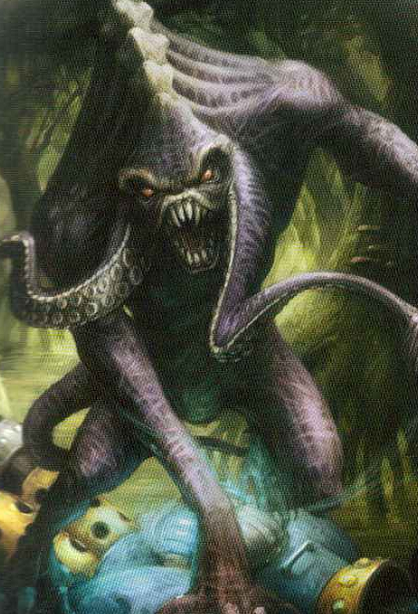
A
Thrullg
can sometimes be found among the Circle, Legion, Skorne or Trollbloods. The thrullg have long been known to scholars are rare creatures that feed on mechanika and sorcery. They prefer urban sewers, but have been seen in rising numbers on the battlefields, lured out and potentially useful as living weapons. They are vicious and unpredictable, unable to be tamed or even really controlled. They must be baited to the field with trinkets or the scent of sorcery, then pointed at the warlocks, arcanists and warjacks of the foe, who are irresistable prey. Even a single thrullg is valuable, if you're willing to risk it, as they invariably seek the foe's most powerful spellcasters with an unrelenting hunger. When they find prey, they wrap their tentacles around the victim and suck the essence of their occult power out of them while clawing at their flesh. Their very presence weakens the magic of those nearby and causes terrible agony.
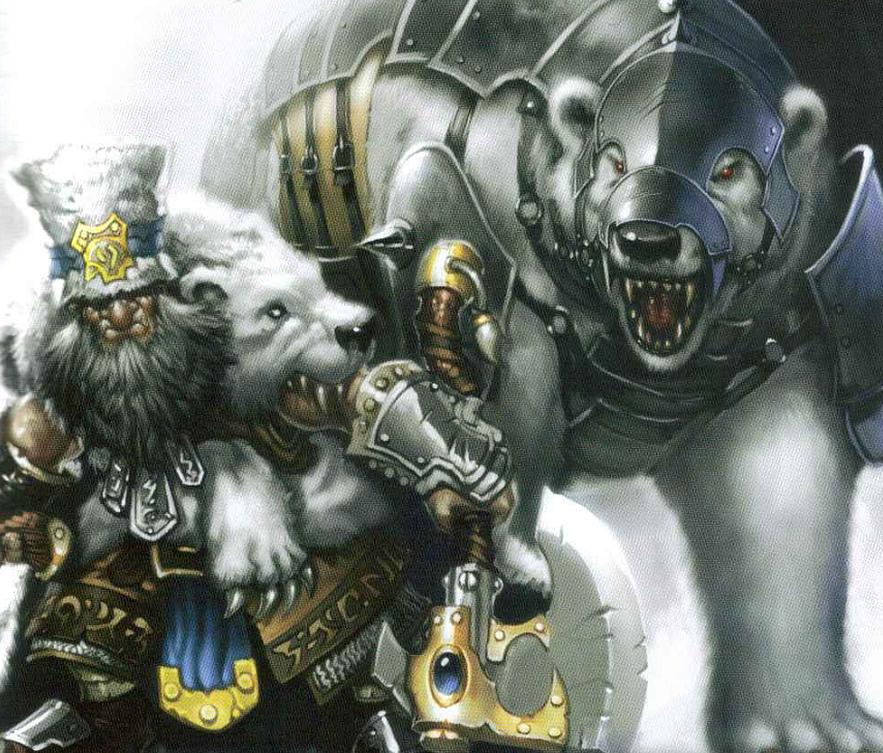
Brun Cragback
is a fearless Rhul loner, always accompanied by his ally,
Lug
. They will work for the Searforge Commission, the Circle Orboros or the Trollbloods. He'd rather kill than talk to most, and he always carries a gun and axe, fearing nothing as long as his bear is with him. Before he became a recluse, he served a small dwarf clan in the peaks near Khador, feuding with Skirov settlers who trespassed in their territory. It's hard to say where Khador ends and Rhul begins, which has led to border conflicts for decades, usually small and inconsequential - an almost respectable tradition, really. Brun decided to settle things once and for all, without consulting his kin. He set out for the human camp, noting that they hadn't even bothered with sentries. He killed them all, and was surprised when his kinfolk were horrified at how far he had gone. Fearful that they'd be blamed if the Moot became involved, they planned to exile Brun and strip him of his clan name. He decided not to wait, and he just left. The only thing he likes more than brawls is exploring. He has never felt the urge to settle, and as soon as he thinks he understands a place, he moves on. He has vowed never to own more than he and his pack mule can carry, and he remembers every location he's ever visited perfectly. His travels have taken him from Khador and Llael even to the Wyrmwalls of Cygnar, working as a guide or escort as needed. He prefers not to work as a mercenary but will periodically take jobs from the Searforge Commission when his supplies or funds run low. He prefers to avoid large communities, so sometimes they have to track him down, but they tend to appreciate his avoidance of towns given his inseperable bond with a giant bear and his disdain for bathing. Brun has spent a good deal of time among the trollkin kriels and has contacts among the blackclads, and is willing to fight alongside them. His sour disposition is a small price to pay for his ferocity.
Brun earned a name for himself by skill at arms, but his reputation is greatly enhanced by the giant armored bear that always tag along with him. Its earth-shattering roars and terrifying claws are as infamous as Brun himself. Still, Lug is not actually murderous, for the most part - he's a simple-minded beast who likes to play rough. Brun Cragback never coerced or trained Lug. Rather, the bear just likes to run around surrounded by humans, swatting at everything he can reach. He has no real sense of morality, oblivious to the damage he causes in battle as long as he can play. The only hint of sorrow he demonstrates is after battle, when Lug will paw at bodies, as though urging them to stand up and play more. Brun claims not to know how long he's been with Lug, but probably less than a decade. He doesn't often tell stories, but he loves the tale of how he and the bear came to travel together. Brun found a white bear while hunting in Nyss territory, and shot at it in the hopes of getting a nice thick pelt for the winter. He was in the middle of skinning the bear when he heard something roar and run up. In a moment of inspiration, Brun wrapped himself in the hide and stood to face the newcomer. It was a half-grown but already dangerous bear cub, which slid to a confused stop in front of Brun and his mother's hide. At last, it sat back, took some food from Brun and ate. Lug has followed Brun ever since. Burn is convinced that Lug thinks he's his mother, so he keeps wearing the improvised cloak. Whether Lug would actually stop recognizing him if he took it off seems unlikely, but Brun prefers to err on the side of caution.
While Brun regularly curses out Lug, the bond between them is obvious. Brun claims Lug is the stupidest bear ever, but he's definitely got cunning. Brun has spent a lot of his money on outfitting Lug for war, with special and expensive barding from a master smith from Skirov, and the bear seems to be proud of the armor. Brun usually only puts it on him when he thinks battle is coming, and Lug gets very excited about it. Those who've seen them after battle confirm that Brun always feeds Lug first, even if it means going hungry. The dwarf claims it's just self-preservation, denying any affection. Together, they walk right into danger with casual disregard. Brun ignores questions about Lug, claiming he has no idea why the 'confounded animal' follows him, but their power is undeniable. They've faced Khadorans, Nyss (both blighted and normal) and bandits, and recently headed south into the Cygnaran mountains after getting hired by the Searforge as an escort to supply shipments. This was an ordeal requiring them to fight through both Llael and the Thornwood to reach dwarven conclaves at Orven and Ironhead. In the process, they renewed contact with the trollkin in the Wyrmwalls and the druids of the Circle, who both now know they can hire Brun and Lug. Nothing fazes them, and they will fight anything. Brun knows a single spell, which enhances his defense, while Lug provides an offensive animus to shove enemies around with his bear hands.
Next time: Yeah, the minor caster/beast pairs get a LOT of text.
Forces of Hordes: Minions
Original SA post Forces of Hordes: Minions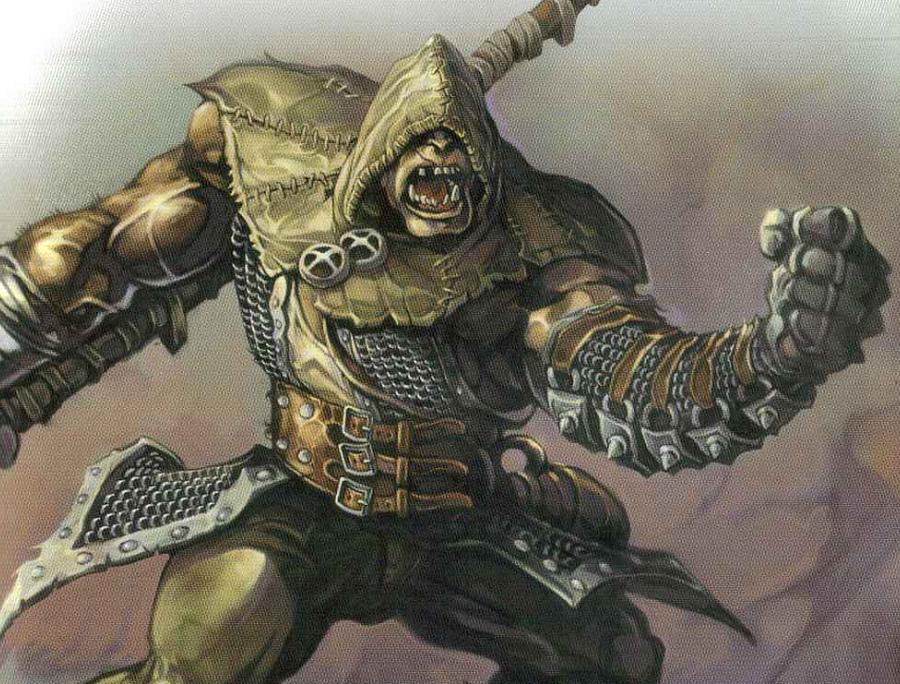
Gudrun the Wanderer knows that an oath taken too lightly is a curse. Now, he'll work for Cryx, Cygnar, Khador, the Circle Orboros, the Legion of Everblight, Skorne or the Trollbloods. He can trace all of his dark destiny to one oath given when he was too young to know better. The years have destroyed his pride and self-worth, leaving only blood. The screams echo even when he is awake now, and to escape them, he drinks, heading into battle blind stinking drunk. Some believe he's too drunk to fight as he once did, but those doubts vanish when he wields his immense battle glaive with the force to cut men in half. His face shows only emptiness in victory, not triumph, save for those few times when he is consumed by berserker fury. Those who have fought beside him say he fights as if inviting death. He learned to fight among the Ogrun of the Glass Peaks in Rhul. He chose not to spend years traveling and learning as a bokur before choosing a korune, a lord to serve. He was impatient, and sought out the dwarf Clan Lord Galos Hergord, whom the ogrun of his village spoke of in hused tones. Hugord ruled several clans and was very rich, and Gudrun swore himself to serve Hegord, his korune. Had he asked more questions, he might have learned of the dwarf's penchant for feuding. Hegord had long wanted to exterminate the Sigvar clan, and ignoring all laws of the Moot of the Hundred Houses and the sacred Edicts of the Codex, he led a night raid that became a slaughter. Gudrun could only obey, murdering innocent and child alike alongside the Sigvar warriors. Clan Hegord was outlawed, crushed by the Mootguard. Galos Hegord and most of his followers were slain, and Gudrun was only spared because the Moot Judges knew the ogrun was bound to obey his korune. They branded Gudrun's head and exiled him from Rhul forever. Some say the deaths on his hands have cursed him, keeping him for ever escaping his guilt save through death. Now, he wanders without a home, drinking and selling his services to anyone who will pay him to kill. He seeks his own death in battle, but he has endured blows that should kill him twice over without falling. He hates himself, but he is a skilled and valued killer.
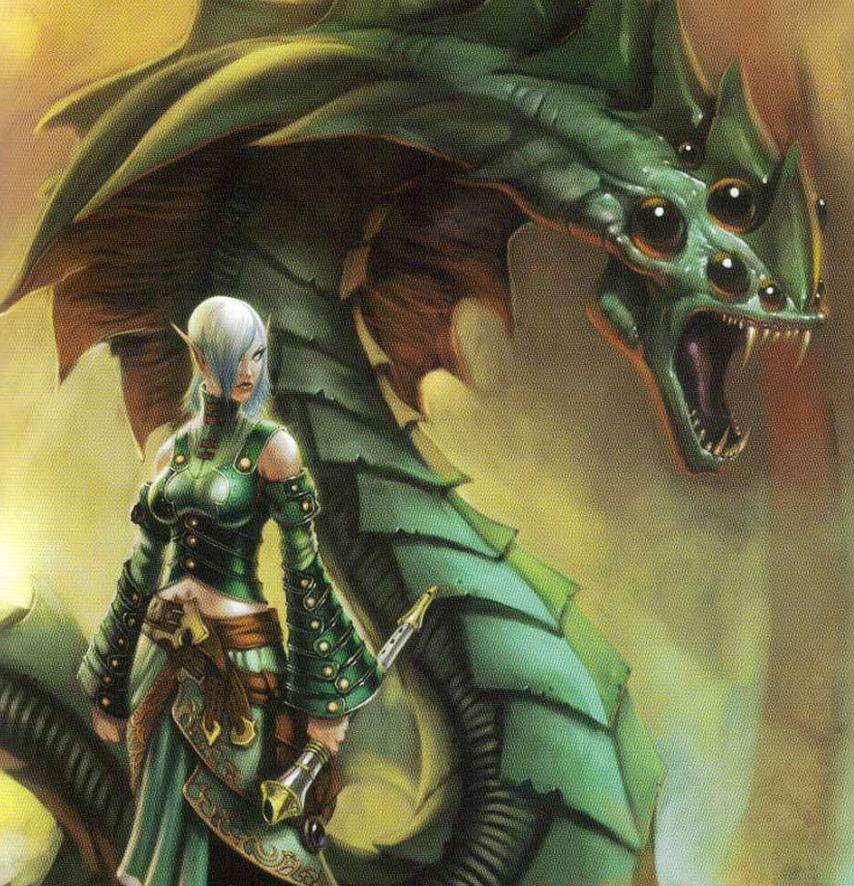
Dahlia Hallyr and her companion Skarath are an enigma, even for an elf. They will work for the Retribution of Scyrah, the Circle Orboros or the Trollbloods. Dahlia is Iosan, but has long been an outsider to her people, refusing to settle anywhere in Immoren. She wields sorcerous magic through her music, entrancing those who listen to her flute. Her family, the Hallyr line, traces back to Lyoss, before the split between Nyss and Iosan, and even today, both peoples have the Hallyr name. She was raised by aflluent parents in Iryss, and was exceptional from a young age both for talent and refusal to obey her elders. Her fascination with music was not strange in her family, but she confounded all of her tutors, ignoring them entirely and walking off mid-lesson to talk to invisible friends. Some thought she might have inherited the less helpful Hallyr insanity. Still, there was a market for talented artists in Iryss and Shyrr, decadent nobles seeking idle diversions. Dahlia could have become rich by her melodies, but chose instead to leave Ios entirely, and her current goals are unknown. She has no real friends, and her only constant has been a desire to travel and perfect her music. Little has suggested she should be able to endure the wilds of Immoren, but she has proven an able survivor, using her musical magic to stay safe. Some say her madness protects her. She has no aversion to violence or war, and even seems to seek it out to watch, using it to texture her music.
For years, Dahlia has used her music to gather guardians to help protect herself, and she is particularly fond of giant tatzylwurms. They are graceful and deadly serpentine beasts that respond to her music as if born to do so. She thinks of battle as a dance, and enjoys the interplay of blade and snake, as if it were a performance. Many have believed this proof of her insanity, but she just says they don't understand her vision. The tatzylwurm Skarath has served her for seven years, developing a refined and harmonious connection. She holds it in special esteem, speaking to it lovingly and playing songs just to see it dance. She can be indulgent, not always inclined to keep it from striking prey, even if that prey is an innocent traveler. She sometimes does restrain her serpent from consuming its meal so they can serve as a paralyzed, captive audience to her music, though. To its victims, Skarath is a horror, a giant pale tatyzlwurm that embodies its species' cunning and savagery. Tatzylwurms are some of the most monstrous predators in Immoren, and Skarath is no exception. The pale variety of wurm is most aggerssive and prone to pounce on anything threatening, even if not hungry. Even trolls avoid the pale tatyzlwurms. Their poison paralyzes prey and their acid can melt flesh. They prefer to digest foes alive over hours. Dahlia has sold her services to several groups over time, including the Circle Orboros and several trollkin kriels. She has visited Circle leaders and trollkin elders, claiming no love for human cities and a hatred for the sound of human magic, which jars her senses like breaking glass. She has shown no problems fighting for causes not her own, but prefers to let Skarath do the killing. Whether she has a plan or just whims is something only she knows. Some arcanists serving the Retribution believe her latent power is not yet fully awakened, and they hope to make use of her in the coming wars. Skarath's animus grants serpentine speed in striking to its allies.
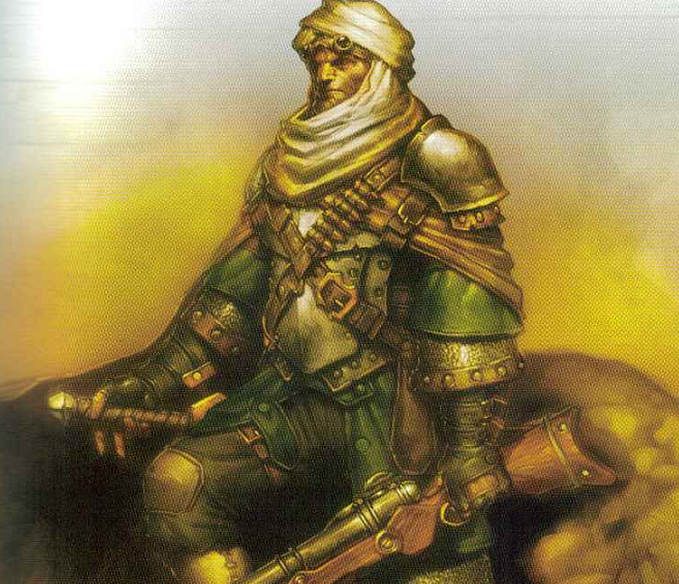
Saxon Orrik will hire out to Cryx, Khador, the Protectorate of Menoth, the Circle Orboros, Skorne or the Trollbloods. His cruelty is as legendary as his mastery of the wilderness, and he sees humans as no more than animals. Long years in the desert surrounded by skorne have only reinforced these beliefs. He began as a Cygnaran scout under Vinter Raelthorne III, befriending Prince Vinter IV with a shared pragmatic bloodthirst while serving as a ranger under the prince. His career ended abruptly after he and some mercenaries under his command slaughtered hundreds of Khadoran villagers settled too close to Cygnar. A ranger, Viktor Pendrake, felt morally obligated to report his mentor, and the incident soon became a political embarrassment. Vinter III was harsh but law-abidiing, and he was obligated to act, as the law forbade murder of civilians. Orrik was dishonorably discharged and sentenced to twenty years in prison. He endured several years before escaping, surviving on the run for months before being betrayed to the authorities. Then, he was sentenced to life, and there was even talk of sending him to Bloodshore Island. However, when Vinter IV was crowned, Orrik was shocked to find he was remembered and released, made into a scout of the Inquisition. His gratitude made him loyal even beyond the Lion's Coup, for without Vinter IV he'd have died in prison. He was among the inquisitors who tried to free Vinter IV after the coup, and he survived on the fringes after Vinter's escape, hiding his identity until he got a coded message from Vinter saying that he'd conquered an unknown species, and that Orrik should pass on instructions to Head Inquisitor Sirac and then rejoin Vinter in the east. Saxon survived the grueling trek across the badlands without even a balloon, learning to hunt whatever survived there for food and water. By the time he reached the skorne, he was a master of the Blodstone Desert, the perfect guide. He has long since forgotten any life but the desert, which is now his home. He trained the skorne to cross it, and has led the way many times. He's got contacts among many groups who will hire him for his mastery of the terrain, and his reputation is now rather separate from that of Vinter's. Most neither know nor care about any loyalties he might have.
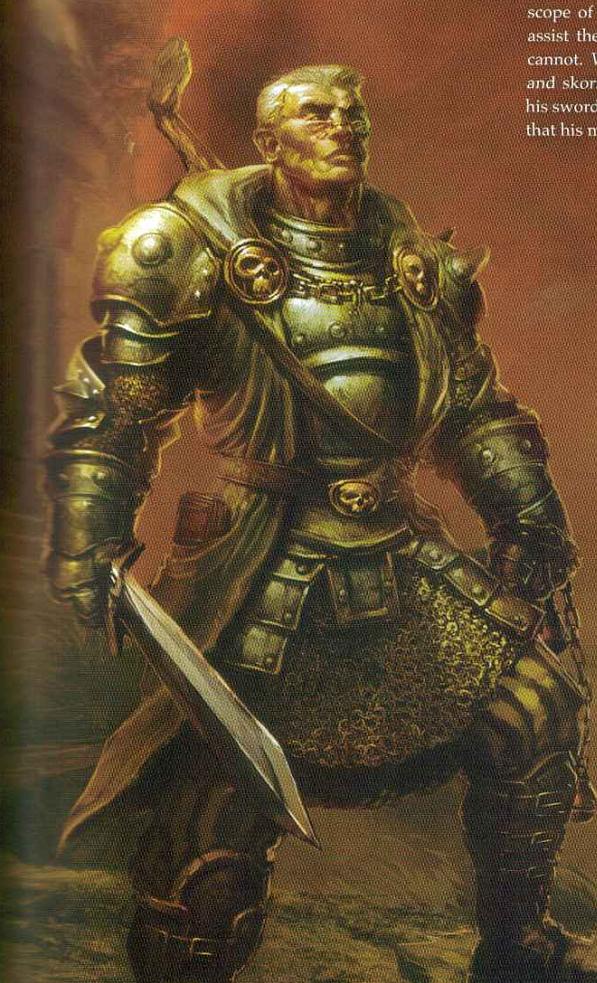
Viktor Pendrake , Professor of the Department of Extraordinary Zoology at Corvis University, works for Cygnar and can be fielded by them. However, he will also hire out to the Circle Orboros or Trollbloods...but will never work in the same force as Saxon Orrik. He is a legend, a chair of his department for his understanding of wild species. He was a Cygnaran army scout, trained by Saxon Orrik, but he was rewarded for reporting his mentor's atrocities, rising through the ranks. He found that he didn't like border patrol, but served quite well anyway, leading a company rangers by age 20. He ran recon past the Khadoran border, but his company was ambushed and slaughtered. Only Pendrake survived, seeking refuge among the pygmy trolls and going so far as to disguise himself as one of them - a ruse which worked and sparked his love of the wilderness creatures. He made it back to civilization with his vital intelligence, then retired to Corvis University, whereh e became an adventuring scholar, which is what he's truly famous for. He has been close to death many times, recording his encounters in his multivolume Monsternomicon . After 603 AR and his witnessing of the skorne invasion and attack on Corvis, he became one of the few scholars to study them, seeing the threat they represented and offering his services to Cygnar as an expert on them and the Bloodstone Marches. While investigating skorne attacks on local trollkin, he was ambushed, and his friend Quimut nearly died, while Pendrake was taken captive to the Abyssal Fortress. There, he found that Vinter Raelthorne and Saxon Orrik were leading an army west, and Vinter shipped him east to document the Skorne Empire as porpaganda. After a long ordeal, Pendrake escaped to the west with new insight on the skorne. He has put aside scholarly pursuits, using his lore and alliances to help Cygnar. He can go where the military cannot, and he is glad to help fight the skorne any way he can.
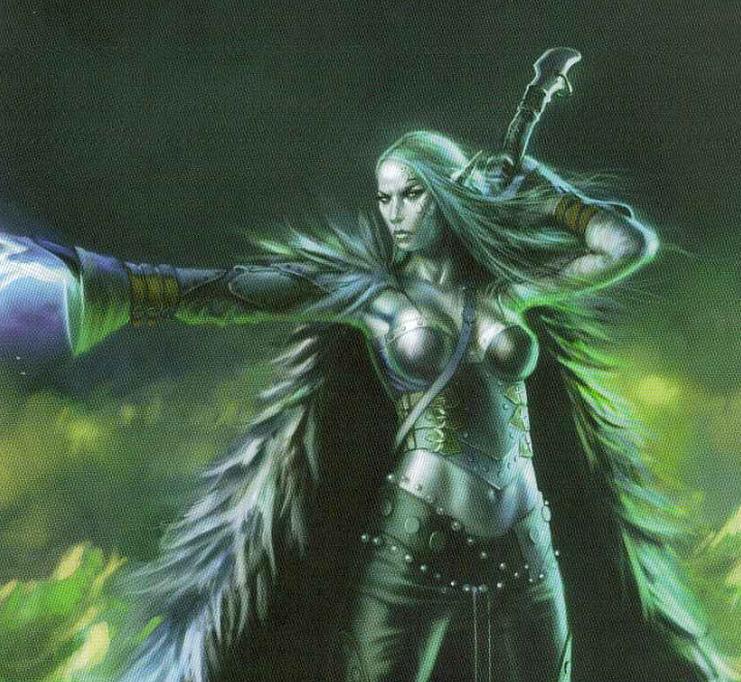
Lanyssa Ryssyl, Nyss Sorceress will work with Cygnar, the Retribution of Scyrah, the Circle Orboros or the Trollbloods, but will not work alongside any ally of the Legion of Everblight or any soldier bearing dragonblight. She has seen her perople destroyed, seen the despair of the survivors and the horror of the Legion of Everblight, and she has vowed to use all her power to fight them. She was not always like that. Her fame was earned as one of the few Nyss to head south in search of adventure, often the first Nyss many humans ever saw. Her beauty and intellect scared many, as did her massive claymore. She eventually found friends, and by her own species' standards she's just entering the prime of her life, but has experience few Nyss ever get. She is not fully formally trained, but is a sorceress of great skill. She might have been content traveling, had she not heard that her homeland was utterly destroyed by Everblight. Now, she feels guilty over her absence, though in calmer moments she recognizes that she'd not have the fighting skills she does if not for her travels. She came home too late to help the Nyss, finding only the dead and burned outposts. This has sparked her wrath, and she went to hunt down the nearest Legion forces. Her friends fought beside her in the Nyschatha Mountains, but they all died. She has headed south to find new allies, becoming acquainted with the refugee Nyss in Khador, like Cylena Raefyll, and the Iosan mage hunter Eiryss. She was among the first to learn the fate of Nyssor, and now she faces both the Legion of Everblight and the Khadoran Greylords in the name of rescuing her god.

The swamps and bayous of Immoren are full of dangers, and they are the domain of the reptilian species known as gatormen. They are tough, powerful and skilled hunters that have learned to thrive in these swamps. They appear to be savage beasts, but in truth they have a craftiness and intellect to match any civilized species, and they are very patient and cunning. Gatormen can be violent and bloodthirsty, but are often willing to trade if approached with respect and deference. In fact, some gatormen have peaceful relations with neighboring trollkin and humans. However, riled gatorment are implacable foes, especially in their native habitat, and those that anger a tribe must live in fear of every log and tree. Most gatormen live in small tribes, no more than a few dozen adults at most. All adults are capable foes, and there is very little difference between male and female in size or power. Each tribe is led by a bokor, part priest and part mystic, who calls on the power of Kossk, the alligator god of the gatormen, along with the dark spirits of the marshes. As often as not, the spirits they call on are those enslaved at the time of death or caught in the aftermath of battle before they could pass to Urcaen. The bokors rely on their own rites and skull totems to facilitate this, using bone tools. Other long-dead allies under their control are ancient natural spirits that have existed in the swamps for millenia. They revere these spirits as ancestors, and sometimes those ancestral spirits refuse to depart their lands, remaining violently territorial. The stagnant swamp preserves them, as well as certain reptilian beasts that grow massively over the centuries by eating the spiritual essence of the dead. Bokors can call on those spirits by blood sacrifice, using them to curse foes or empower allies.
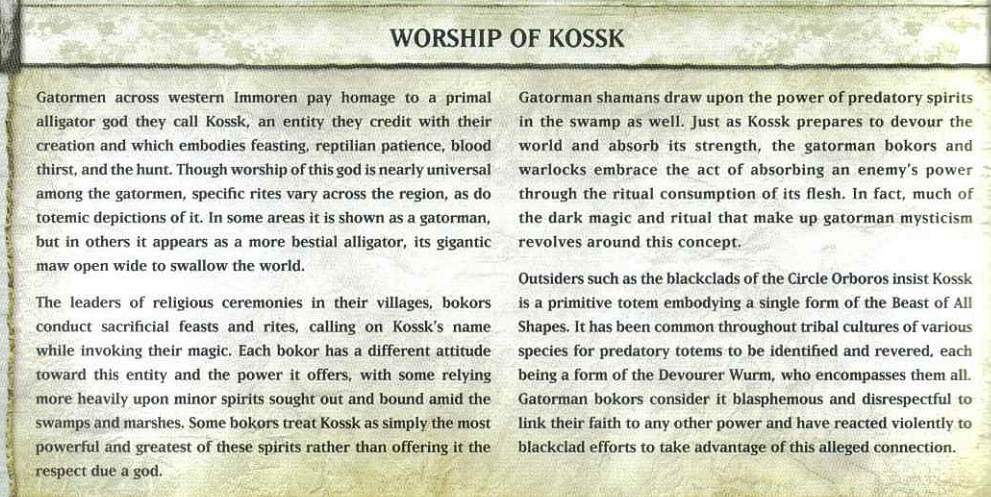
Despite their immense power as warriors, the gatormen are largely uninvolved in the wars of Immoren, focusing on fighting other swamp creatures, mostly the bog trogs. Bog trogs are fishlike humanoids skilled in ambush and assassination, and the two races have fought over swarmp resources for longer than either can recall. However, the gatormen have an advantage over the bog trogs most of the time, as the bog trogs are weaker individually and lack potent leaders. Plus, some gatormen are warlocks, able to command terrible warbeasts, which has further cemented their swamp dominance, and usually the bog trogs are subjugated or driven out. Gatormen tribes are traditionally highly independent and uncooperative with each other, instead fighting over food when supplies get scarce. Generally, each village is led by the most fearsome bokor, but certain powerful bokors can unite multiple tribes into small fiefs.
Gatorman warriors are some of the most terrifying combatants in Immoren. The average gatorman is over seven feet tall and covered in scaly armor. Besides their powerful jaws, claws and tails, they often wield immense cutting or smashing weapons, able to reduce warjacks to scrap in minutes or take out entire platoons. They are highly protective of their kills, and it is seen as immensely disrespectful to eat the kill of another, inating lethal retaliation or a blood feud. The gatormen are the heart of any bokor's warriors, but bog trogs are also often pressed into service, on pain of being eaten. Bog trogs and gatormen actually complement each other's skills ell, as the bog trogs bring numbers and subtlety that the gators often lack, while the gatormen have strength and toughness that the bog trogs do not. Swamp gobbers are also often found alongside the gatormen. They aren't seen as threats and are rarely foes to either gatorman or bog trog, willingly working for the bokors and warlocks for food and protection. Occasionally, the bokors will capture and enslave other creatures, such as thrullgs or feralgeists, and a number of the exotic, froglike croaks of the swamps and jungles to the distant east have recently sought protection, offering their services to bokors. They originate from southern islands owned by the skorne, who captured them and brought them west. The escapees are far from home and seem to revere the gatormen.
What truly makes gatormen potent, however, is their command of the beasts of the swamp. Gatorman warlocks can call on reptilian warbeasts as powerful as any found in the armies of Immoren. The gatormen have an affinity for these creatures, calling on them with bestial instincts. Thge bokors claim this is a gift of Kossk itself, offering its children command of the creatures that resemble it. The gatormen are reclusive, but will help outsiders if compensated. Many bokors are shrewd negotiators, and htey prefer payment in food or metal weapons, as they have few of their own, or the right to take the dead and their belongings. Gatormen value personal possessions, either as gifts or trophies, often believing that they impart their owners' vitality and cunning. Despite the contact with outsiders it brings, their mercenary work has caused little change to gatorman culture. Those who leave to fight often return home with reasures and curiosities, but they rarely try to adopt the engineering and advances of other cultures, remaining as they have been for millenia.
Next time: The Blindwater Congregation
Forces of Hordes: Minions
Original SA post Forces of Hordes: MinionsThe swamp does not change quickly, and for millenia the gatormen have resisted any changes in their way of life. Now, though, an ambitious few threaten to alter their history forever. The gatorman warlock and bokor Bloody Barnabas has united several tribes around Blindwater Lake and Bloodsmeath Marsh. He has been around for centuries, and over time, has conquered many tribes in Blindwater and beyond. He aspires to one simple thing: godhood, to become a mightier immortal horror than even Kossk. To do this, he wants an army of gatormen, bog trogs and other swamp creatures to demonstrate his greatness such that they will worship him. He intends to lead his army in conquest until, soaked in the blood of thousands, he can push his followers to one final battle. He hopes that when he finally dies in battle, the energy of the deaths caused in his name and the adoration of his servants will propel him to apotheosis. Barnabas is a feared and respected leader, but he has little patience for details. This has given opportunity to the warlock known as Calaban the Grave Walker to take care of those things which Barnabas has no interest in. CAlaban is a potent gatorman bokor, a calculating and pragmatic one rather than ambitious. He knows more of gatorman magic and ritual than anyone, able to call forth ancient and potent spirits, but he is no fool. He has no plan to die for Barnabas, and is using the war host for his own goals.
Those goals are pragmatic, not mystical. Calaban is an intelligent and progressive gatorman, and what he wants is to unite his people beyond a collection of tribes. He sees the work of Barnabas in Blindwater as the first step towards a real civilization, one that rules the swamps, making all who enter pay tribute or be eaten. Calaban plans to use Barnabas as long as he can to bring the gatormen together, and when he finally does die in a blaze of carnage, Calaban will find another leader to take his place. The Bloodsmeath has many bog trog tribes, but Barnabas utterly eradicated the dominant tribe. However, Calaban stopped it from becoming utter genocide, offering the bog trogs a deal: serve, and don't die. They had no real choice. Calaban makes heavy use of their stealth and ambush tactics in Bloodsmeath and beyond. Barnabas has been, at Calaban's direction, gatehring warriors fro mthe Marchfells and Fenn Marsh, which he plans to use to spread word of his deeds across Immoren. Having the two most potent warlocks of the gatormen working together has empowered the Blindwater Congregation massively, allowing them to call forth massive warbeasts from the swamps and bogs, many never before seen by humans outside of myth. The gatormen of Blindwater have finally awoken to conquest and ambition, and if Barnabas and Calaban have their way, the swamps of Immoren will soon send forth a tide of blood, and those that once employed the gatormen in battle will fall beneath their jaws.
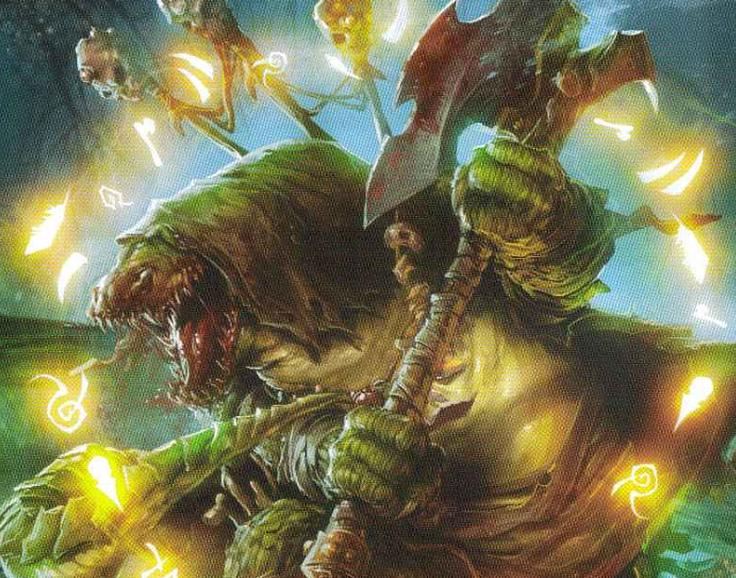
Bloody Barnabas will work for the Circle Orboros, the Legion of Everblight, Skorne or the Trollbloods. Or himself. Gatormen do not die of old age and rarely get sick. Their lives end in violence, when their rivals or nearby monsters eat them. Bloody Barnabas is the oldest of all gatormen in Immoren, and his name is not just death, but utter annihilation. The gatormen do not respect age, just power, and he controls his tribe by ruthlessness and apparent invincibility. They revere and fear him as much for as his mad resolve as his victories, and he speaks with a calm and serene confidence born of fearlessness and a knowledge that he is superior to literally all other life. Those who mistake his serenity for weakness or senility learn their mistake when he lashes out to destroy any he deems traitor. He may be alloof, but he notices everything. At the height of his power, Barnabas was never defeated, but his age has finally started to haunt him. He fears that his body will fail, and this has pushed him to larger ambitions. He intends to become a god, and nothing else matters to him now. He believes his ascension means more than being a legend - he must be worshipped. He will assemble all the gatormen under his banner, then lead them to a great battle, and at the peak of the slaughter, he will feast on the energy of death. This, combined with the reverence of his people, will fuel his apotheosis. It will take time, effort and lots of blood, as there are many gatormen to gather. Were his people less afraid of him, they might question the wisdom of provoking such terrible and deadly battles, but with each passing year more tribes and even outsiders learn of the Terror of the Blindwater. His cult grows steadily, and with each cultist, he gets closer to his goal. His gimmick is buffs and use of swamps and water. His feat lets him knock down any enemies who can't swim near him.
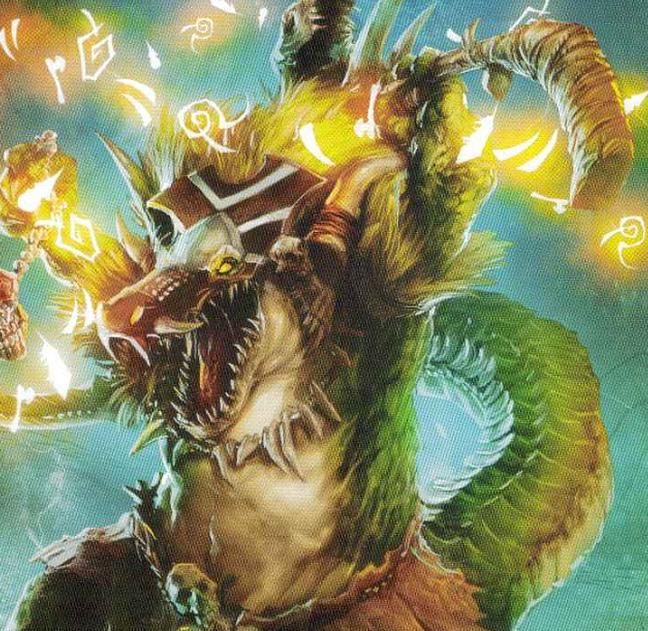
Calaban, the Grave Walker will, likewise, work for the Circle Orboros, the Legion, Skorne or the Trollbloods. The bokor of Fenn Marsh fear and respect Calaban like no other, for he has mastered the rites of the dead spirits above all others. He has eaten dozens of challengers and is an uncontested leader. He does not, however, see himself as chief or king. He prefers to advise chieftains, and he has tied his destiny to that of Bloody Barnabas of the Blindwater. He knows Barnabas' plans, but doesn't really care. The unification of the tribes is good, and either Barnabas will succeed or die. In either case, Calaban will choose the next leader, who will truly control the united gatormen. In the meantime, the violence offers many chances for someone who commands death and the spirits of the dead. Calaban revels in the chance to slaughter and steal vitality for his own use, becoming the incarnation of gatorman appetites as he kills and weaves terrible curses, harvesting death on the battlefield. His gimmick is curses, and his feat lets him gain power when enemies die around him, fueling his spells.
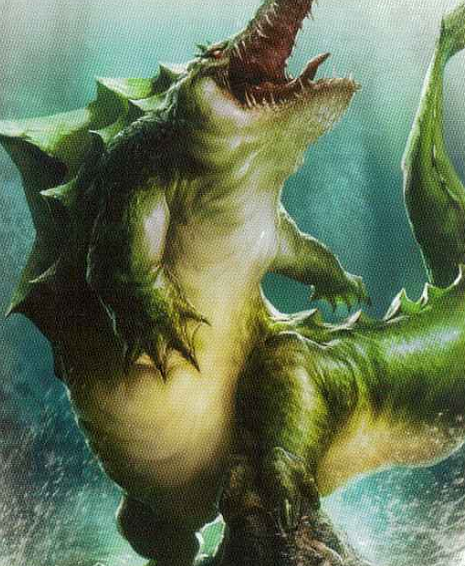
The Bull Snapper is not, perhaps, so large as the blackhide wrastlers of the marshes, but they have a fearsome reputation. Most see them only as they rest, lying in the shallows or along riverbanks. Left undisturbed, they are still as death, but watchful. Once roused by threats or hunger, they are swift and deadly, lunging without warning. The male snappers, called bulls, are aggressive and very hungry, and they don't care what they eat. Once their jaws close, they tear the prey apart in great gulps. Though they are easily fged, they get hungry soon enough, and anything disturbing them will feel the fury of that hunger. Their animus lets them grant spiny armor to their allies.
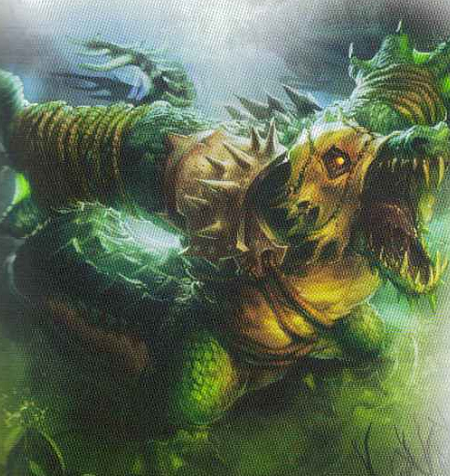
Blackhide Wrastlers are immense creatures of the Bloodsmeath Marsh, which hide below the surface until prey comes along, at which point they rise up, grab it and drag it below to its death. They are crucial to the gatorman ambition, immense alligators with a terrible hunger even by gatorman standards. Motivated by food and blood, they hurl themselves on their foes and bite even the largest in half. Those that they cannot eviscerate easily are dragged into the water for a feeding frenzy. Even as they eat their prey, their own wounds close and their hunger continues. Also they are wrestlers. They are very good at wrestling. Their animus allows them to make allies stand up faster from being knocked over. (This is useful because they do their best work by knocking themselves over.)
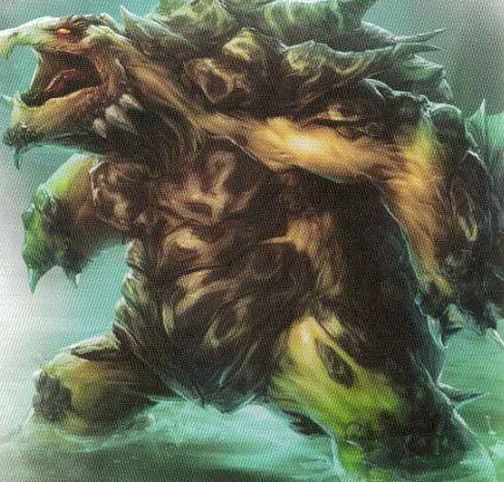
The Ironback Spitter is one of the deadliest creatures of the swamp. Despite its bulk, it can be hard to spot in its favored hiding places full of muck and vegetation, and it isn't uncommon for travelers to step on them by mistake. By then, it's too late - they are notoriously bad tempered and will rise to their full height to tear you apart. They are even more dangerous when hunting. They have a terrible appetite and will eat anything, but most prefer msall, bipedal creatures like bog trogs or humans. Once they spot a meal, they spit huge amounts of gastric acids that are gathered in special bladders attached to their stomach. Anything caught in the stuff is soon dissolved into nutritious sludge. They'll even eat gatormen, but the most potent bokors and warlocks can tame these turtles. A single spitter can be a decisive weapon on the battlefield, and its bad temper is useful there, too. Its animus allows others to partake of its violent bad temper to counterattack nearby foes.
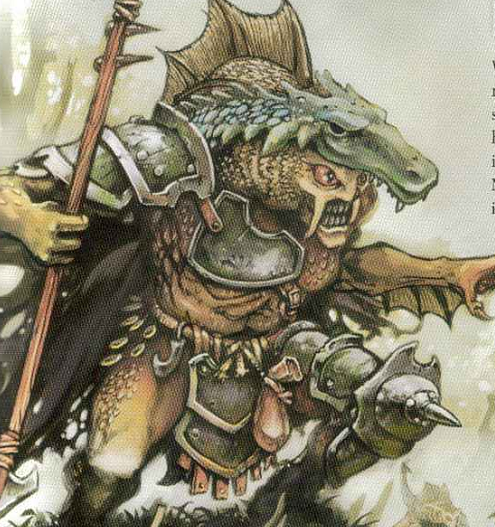
The Bog Trog Ambushers are the best warriors of the primitive and territorial bog trogs. They can be found among the Circle, Legion, Skorne or Trollbloods. They often fight the gatormen, and in recent years several tribes have been forced to help outsiders in battle. They are masters of ambush, hiding underwater until the time is right. In or out of water, they can change their skin color to blend in. Whather manipulated, goaded, lured or enslaved, many bog trogs have come forth recently to fight, launching attacks from many waterways. Because so few know their language, Quor-og, they really only communicate easily with the gatormen, who share a root tongue. They don't take much to be convinced to ambush folks, though - they seem to enjoy killing and stealing from the dead.
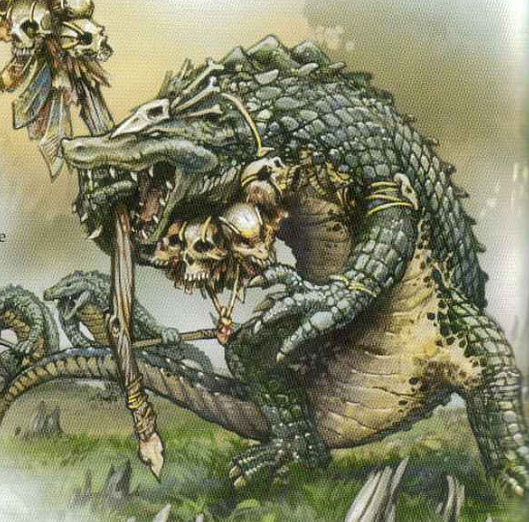
Gatorman Posses are bands of formidable and savage gatormen, willing to work for the Circle, Legion, Skorne or Trollbloods. Few other intelligent species can rival their raw power, and they're as skilled with heavy polearms as their natural weapons. A single gatorman can kill several men in just a few seconds, and the sight of blood drives them frenzy. Their crude villages often have shrines in the shape of immense alligators, icons to the god Kossk. Gatorman shamans, called bokors, use savage magic to push their posses to even more bloodthirst. Though they are fierce, they are usually content to guard their own lands. Few can speak their obscure Quor-gar dialect, but they respond to gestures and simple commands well. They are even-tempered out of battle and are approachable for barter, with trollkin and Circle druids having made alliances over the years, though the gatormen will fight for anyone that offer them food in quantity. Despite their reputation, however, several recent bokors have been stirring them to grater activity, drawing them together. This rise in violence is ominous for those who live on the fringes of the swamps and waterways.
Next time: Wrong Eye, Snapjaw and BIG PIGS
Forces of Hordes: Minions
Original SA post Forces of Hordes: Minions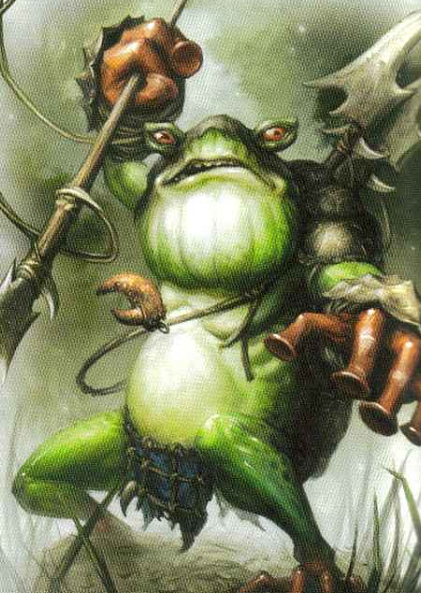
The Croak Hunter , more properly one of the Anura, is a relatively rare sight. They can be found among the Circle, Legion, Skorne and Trollbloods alike. The croaks, as must call them, are newcomers, from the Shattered Spine islands south of the Skorne Empire. Their hunters are primitive but skilled, and they have a tribal culture well suited to survive in jungles. Several tribes were enslaved by the skorne and brought west, and some managed to escape, adapting well to the new lands. They are anxious to survive and ignorant of the natural order in western Immoren, and tend to hold some of the locals in awe. The gatormen of the Blindwater Congregation have been quick to take advantage of their creduility, and many croak hunters have allied with them. Some trollkin have also gained their allegiance, as they seem to think the swamp trolls are a sort of long-lost kin. Their services are much valued as hunters and trackers. The croak coat their weapons in poisons made from their own skin, which lets them take down prey they normally wouldn't be able to hurt. They prefer ambush, using poisoned spears before vanishing into the brush. Once confident in victory, their warbling battle cries fill the air as they close in for melee.
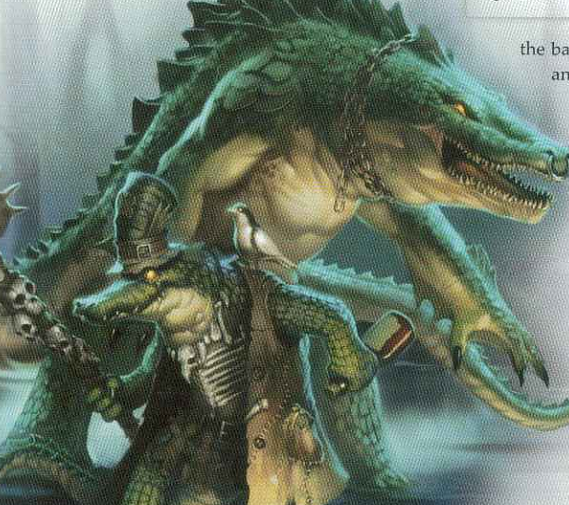
Wrong Eye and Snapjaw are some of the most dangerous swamp denizens, happily working for Cryx, the Circle, the Legion, Skorne or the Trollbloods. Wrong Eye is one of the bokors of the gatormen who understands the firm law of the swamp: for someone to feed, someone else has to die. He is an oracle of the marshes, and those who look into his eyes can tell that he thinks in a way no human does. Any negotiation with him brings the chance of bloodshed and fenzy, and even hardened blackclads and trollkin warriros sometimes lost their nerve and give him better deals than they intended. He is unpredictable and dangerous, and it's hard to tell when he's willing to strike. He presents himself as amiable, polite and sophisticated, but tales persist of him erupting into rage at small insults. Those who deal with him insist the easiest way to keep him friendly is to give him many small baubles. He adorsn himself with these trinkets, and while his appearance is comical, that impression fades quickly. He turns those he kills into his spiritual weapons, and it is said that he loves the taste of intelligent beings. He finds the creative impulses of humanity very fascinating, and dresses to imitate humans for some reason, cobbling together stolen and mimicked outfits. Those who can see ghosts know that many linger around Wrong Eye, hating him but unable to leave. Whether he notices them or not is unclear.
Wrong Eye makes dolls to influence others, using needles to strike at their limbs and make his victims suffer by proxy. He wears a vest of bones as a sort of spiritual armor against danger, and it'd be easy to dismiss if not for his actual power. His oversized eye can compel weaker-willed creatures to obey or spasm at his word. When potential employers talk to him respectfully, he returns the corutesy. He sees himself as superior to and manipulating those around him, which is certainly part of his insanity, but he is useful and amusing. Anyone who threatens him must deal with the immense alligator Snapjaw, who prefers to linger in the water near its master. It can stay in one place for hours without blinking, but leap forth with blinding speed if Wrong EYe desires it. Other bokors refer to the creature in terms usually meant for spirits, not living things, and they believe it is a physical embodiment of Wrong Eye's power and nature. Thought fierce when provoked, Snapjaw is usually lazy, content with easy meals such as wayward children or livestock. Sometimes, Wrong Eye allowsh is pet to wander into settled regions, watching frim a distance with amusement as humans try to drive it off. They've never done more than scratch its hide. Snapjaw never wavers, and it ignores injury and pain, following an ancient and primordial hunger that drives it to drown its belly in meat and blood. Wrong Eye likes to think he's the brains of the pair, but given his dubious sanity, that's not much comfort. Wrong Eye's magic is all about control, while Snapjaw's animus lets his allies submerge in spiritual water to avoid ranged attacks.

The farrow tribes have lived on the fringes of western Immoren for centuries. They are often overlooked by humans except when they raid towns or caravans. They're rugged, tribal people who will do whatever it takes to survive. Their technology is crude, but they are ingenious when it comes to adapting. In recent years, they've been offering themselves up for hire in wars, earning a lot of experience and scavenged treasure from the field. They have a reputation as bandits, opportunists and scavengers, which they embrace. They consider survival the greatest imperative and have no stigma against theft. The next highest priority is social standing, preferably by dominating other farrow. Farrow social interaction is usuall about bullying inferiors while currying favor with superiors. The mighty and clever prosper while the weak and foolish are abused in a never-ending cycle of retaliation as farrow rise and fall in the hierarchy. It's not uncommon for a farrow to go from beggar to chief and then be murdered by the next chief.
Farrow are most numerous in the badlands of Cygnar and the Bloodstone Marches. Several mountains and hills hold farrow villages, cinlcuding the Dragonspines, the Wyrmwall and Caerly's Crag. The Thornwood's been home to many villages but the present climate makes life difficult for them there, and they've beenb pushed north out into the wastes of Ord and Khador, settling even as far as southern Rhul, though the dwarves tend to drive them off. They've even enduring during the skorne invasion of the Marches. Despite all these threats, they're more at risk from each other than anything else, especially if they own things worth envying. Farrow are very possessive of stolen or won booty, and murder over items is common, especially in tribes with weak chiefs. For the farrow to survive, some must perform undesirable jobs, including menial labor. This is delegated to the weakest, who comply out of fear, while the most aggressive and skilled seize positions at the top, with a single warlike chief dominating others. Any farrow able to regularly gain food or resources is respected, while those that must be supported are scorned and shamed.
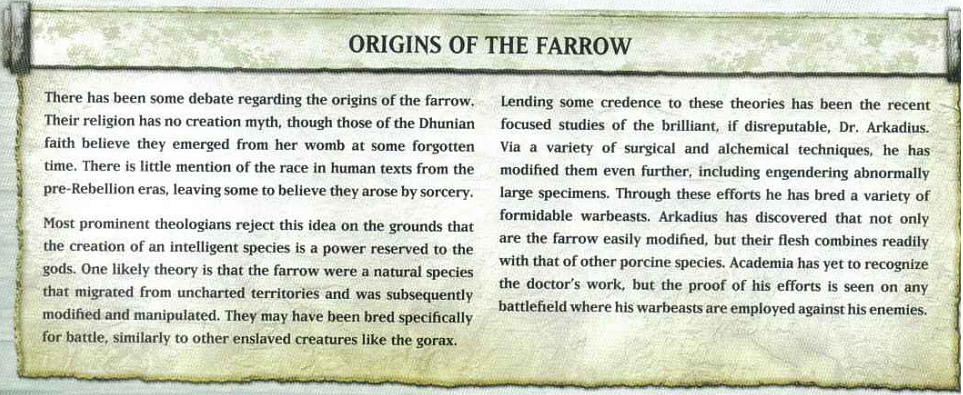
Builders and crafters are respected, though to a lesser degree, and may be able to sell their services for food or goods. Those who can make good weapons are most valued. Farrow prefer to gather rather than farm, as they have little patience for crops, though there are exceptions when a tribe learns to make alcohol. Many farrow tribes are semi-nomadic, following game and food reserves. Farrow warriors are not equally disciplined or trained, and in many cases are more thief than warrior. They do not have a linguistic distinction between the words for 'warrior' and 'brigand,' and both are respectable jobs. Warriors are equipped to defend what they have claimed and tend to rise to leadership. The farrow are pragmatic, using or eating just about everything they have. The warriors and crafters often make deals, with the warriors gathering materials to make weapons. Farrow have been able to make good approximations of the wepaons and tools of other races, making reliable pig iron rifles from scavenged metal and even learning how to reapir or rebuild cannons and steam engines.
Farrow villages are generally impermanent wooden, clay and mud-covered straw buildings guarded by scavenged sheet metal hammered together. When they are destroyed, they just get rebuilt. Despite this, the honor of a farrow chief is dependent on keeping the borders secure. Kepeing intruders away is their main duty, as few things get farrow mad like violated territory. When confronted by foes, the farrow chief must decided whether to flee or dig in and fight. The farrow who choose to fight are extremely tenacious, armed with improvised or raided weapons in entrenched positions they defend to the death. They fortify their lands with spikes, pits and traps, and both trollkin and human outposts have discovered that the farrow are very stubborn in defense of their land, with only the young and the pregnant females kept out of battle. Faced with overwhelming odds, they may choose to flee, but any chief that gives that order will be shamed and lose power among their tribe. That's often enough to force a change of leadership, even if fleeing was needed to survive. When a chief is threatened, it means a fight to the death, and those who falter die or flee the tribe. The strongest are the ones most likely to sell their fighting skills to outsiders, allowing their tribes to gain riches far beyond what they might get by localized plunder. They will take all kinds of payment, preferring weapons, food, materials or land.
Farrow don't generally live long, except for tribal shamans and bone grinders. The farrow tend to ignore religion until reminded of their mortality, and most practice a variant of the Dhunian faith, gathering for funerals, births and a few other occasions. Shamans provide battle blessings, and the most skilled battle shamans may become chiefs or leaders. Bone grinders are a mystical tradition that is more pragmatic, drawing on the power of dead beasts as part of their belief that no part of an animal should be wasted. They draw the power from the bones of the dead, bolstering the warriors with a strange alchemy and powerful totems. Off the battlefield, they make healing lotions and disease cures. Most chiefs value their mystics for advice and wisdom, and protect them from the other farrow so they can pass on their knowledge. Some chiefs think them cowardly and meddling, but they are valued by most farrow.
For most of their existence, the farrow tribes have been infighting. This has changed only with the rise of an immense and ambitious farrow, who has taken the name Lord Carver, Bringer of Most Massive Destruction. He emerged fro mthe Black River hills near the Marchfells, crushing every rival against him, chief after chief. He wields an immense cleaver and commands porcine beasts. His rise was not overnight, though. After subjugating nearby tribes, he spent time selling his strength to local humans, which left him rich but disdainful of the human race, for they treated him very disrespectfully, as though he were just any farrow warlord, despite his obvious supremacy. He decided he would unite and conquer his people to prove his superiority. Where he marched, farrow obeyed, but they returned to chaos once he left. None dared defy him openly, but he lacked the structure to maintain his momentum. In battle, he was hindered by his lazy, limited subordinates.
Much as Carver hates to admit it, the arrival of Dr. Akradius enabled his dreams of conquest. Ordinarily, Lord Carver might have dismissed the eccentric mage, but Arkadius had planned a demonstration for his meeting, revealing the war hogs - a hybrid of boarflesh and steam-powered weapons taken from various battlefields. Lord Carver saw the potential there, and soon the doctor was his chief advisor. Relations between the two are tense, but they have formed the core of a farrow alliance. Lord Carver summoned the scattered farrow chiefs to meet him at the battleground of Thornfall in the Thornwood. The Thornwood farrow had suffered much at human hands due to the Thornwood War, and Lord Carver took control of them by force and intimidation. A few had to be killed by their ambitious subordinates, who bent knee to Carver, and the Thornfall Alliance was formed, which Carver plans to use in order to stand as equal to human kingdoms, and then to conquer them.
Lord Carver has many feast halls, where he assembles the farrow after victories, and he thinks of every farrow village as his home. His greatest hall, however, is in the Bloodstone Marches, just outside skorne territory. He doesn't rest long there, but ravels often to ensure the loyalty of his alliance and to replenish his armies. Lord Carver leads the horde, but is supported by dozens of tribal chiefs, each of whom rules a petty fief. They defer to Dr. Arkadius, who has special statue despite his odd mannerisms and arcane science. Even the war chiefs are terrified of him, for they know he's much smarter than they are. He's shown the ability to shape farrow flesh to his whim, and many who enter his labs come out entirely different, if they ever do come out. The chiefs obey Carver to survive, but they obey Arkadius out of more insidious fears. There is an ever-shifting hierarchy among chiefs, with the most valued by Carver giving orders to the rest. By and large, the warriors fight effectively while looking out for their own interests. Carver is always looking for ways to bring new organization and tactical skill to his army, including the recent adopting of tribal banners. He's experimented with whistle and flag signals to coordinate actions, but that's been less successful.
Next time: SOOOOO-EEEEEE
Forces of Hordes: Minions
Original SA post Forces of Hordes: Minions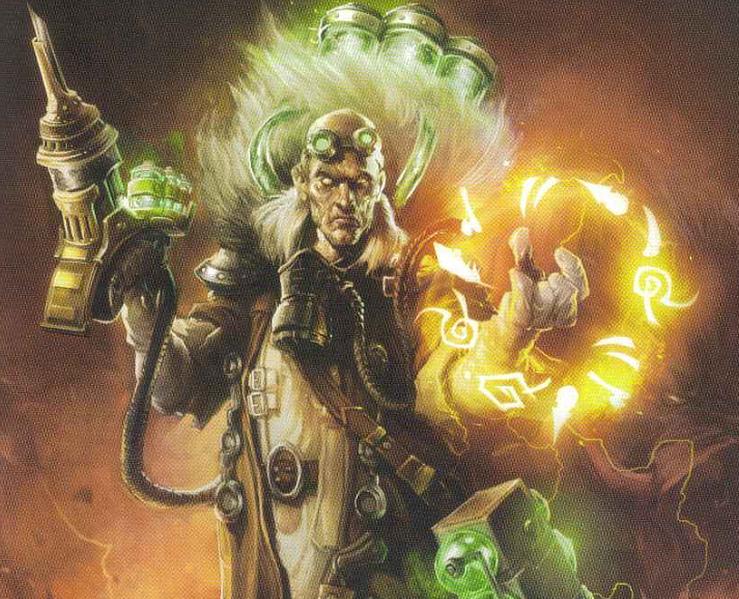
Dr. Arkadius (no first name) will happily work for the Circle Orboros, Legion of Everblight or the Skorne. He is at the forefront of those who seek the mysteries of life, the finest genius of the field. He is a master of both alchemy and magic, and he has a brilliance none can match. Others shunned him for it, in their ignorance, and he chose to abandon civilization for a remote laboratory, where he has been able to indulge in his theories. He has found the farrow to be an ideal species for his work. Unconfirmed rumors suggest they arose from earlier mystical manipulation of wild boar, which supports the ease with which farrow flesh responds ot surgery. Arkadius delights in how readily they express his artistry. With the proiper mix of alchemy and electricity, he has encouraged farrow muscle to bulk up and bone to lengthen and harden. Their bodies accept bone nad organ grafts easily from other pig species, and he's found their minds to be no less malleable. He can see great potential, given time to unlock it, and he dreams of shaping the farrow into a sublime legacy, not only in body but in mind and culture as well. He watches them with the eye of an artisan even in battle, taking every chance to spur on his beasts. He carries many alchemical serums to improve their performance, and is always mindful of new chances to gather specimens and materials, looking to the day when those who once mocked his science will be at the mercy of his perfect porcine creations. His gimmick is buffing and controlling beasts, and his feat lets him drive them to berserk frenzy.
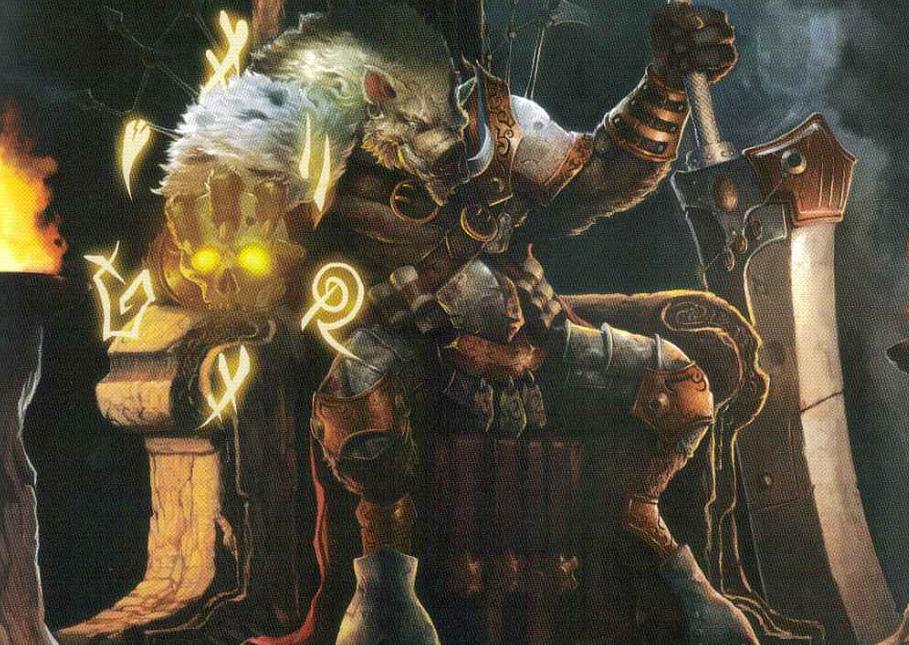
Lord Carver, BMMD, Esq. III (that's Bringer of Most Massive Destruction, Esquire) is the self-styled ruler of the farrow, who will work for the Circle Orboros, Legion, Skorne or Trollbloods. He is a grim figure with open disdain for other species, who is bitterly jealous of human nations and loves to kill humans. Some day, he has sworn, he will get the awe and adoration that is his due, and those too slow to kneel will be punished. His drive for conquest was born from his time watching humanity, envying and hating their achievements and cities. From his first days as a mercenary, he was viewed as a lesser creature, and he has set out to subjugate his people to demonstrate to humanity that he must be respected and feared as a leader. His conquest of the farrow has given him a taste for it, and he looks forward to bringing humans, too, under his hoof. His campaign has caused the lesser warlords to submit to being his generals, and he has chosen to demonstrateh is worth by borrowing human honorifics, which he adores hearing people use. This is only the first step in his plan, and he will not be happy until humans, too, bow to him. He sometimes wishes he'd killed the arrogant human who came to him and spoke of physically and culturally improving the farrow. Arkadius seized on Carver's desire to use his people as a weapon, and while Carver does not really understand Arkadius' goals, the scientist has proved useful in making stronger beasts for battle. His counsel is valuable, but Carver does not trust the man's motives or his obvious intellect. He feels help from a human tarnishes his accomplishments, but cannot turn away the weapons that serve him so well. The farrow have made great advances as a people thanks to Arkadius...but one day, Carver will enjoy torturing the man to death, once he stops being useful. Lord Carver leads by example, pushing his soldiers to rise above their origins and become something greater, yelling at any he deems lazy or lacking enthusiasm for the cause. He dreams of fortresses, roads and cities in which the farrow rule and humans are pushed out into the wastes. When he is done, all of Immoren will bow to him or die. His gimmick is being one of the single most dangerous warlocks in the game for personal combat short of maybe Thagrosh, and also general warlock-y stuff like buffs. His feat improves his farrow allies' speed and damage.
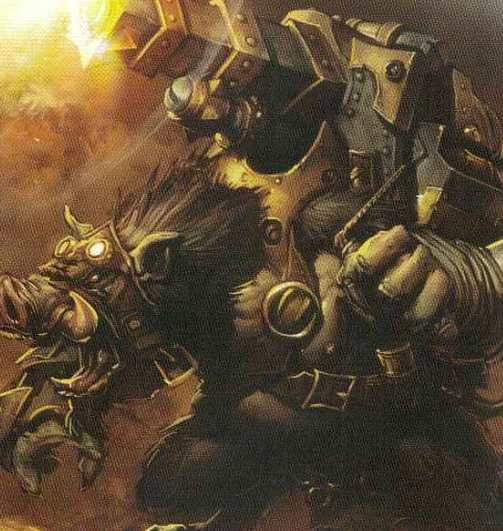
For generations, the farrow bloodlines have sometimes yielded massive specimens with no real higher mental faculties, such as the Gun Boar . Instead of intellect, they are angry, incredibly tough and utterly fearless. They have long been used by farrow warlords, and even the smallest throwback is useful on the battlefield. They are powerful and just smart enough to be taught to use weapons. Once their trainers are satisfied that they can tell friend from foe and know how to operate the gun strapped to them, they are fitted with a harness to carry an immense cannon. Despite the low-quality metals used to make them, these cannons are very durable and resistant to the combustion of the unpredictable low-grade explosives the farrow use, thanks to their ingenious design. On the field, the gun boars support the advance of the farrow and war hogs, much like mobile artillery. They fire immense shells stuff with crude explosives, which detonate on impact to shower the area with vicious shrapnel. In close range, the gun boars are far from helpless, given their innate strength and hunger. Their animus allows them to attack those who come near them.
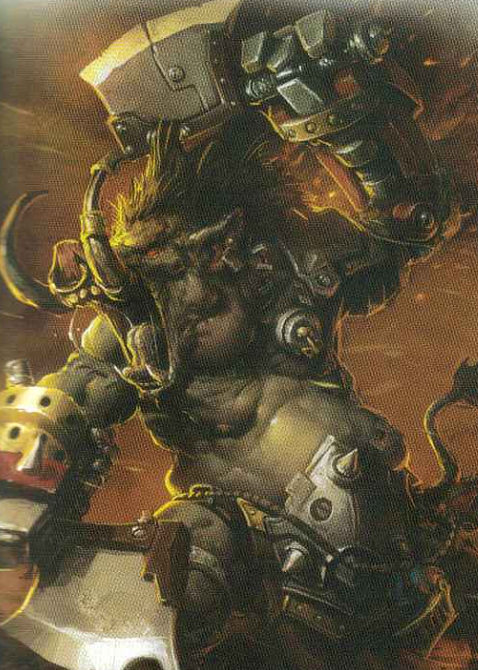
The War Hog is the greatest and most lethal of Dr. Arkadius' creations. Each is an expression of his genius, carefully primed with alchemy for surgical experimentation. They are immense and violent creatures, kept alive while steam engines and mechanika are integrated directly into their flesh. This sometimes requires substituting limbs and organs from other pigs. Each war hog is unique, but they all have a common purpose: destroying the foes of the Thornfall Alliance. War hogs can be pushed beyond the limits of their flesh, thanks to alchemically induced rage, but it's dangerous to their bodies. Even without overdrives, they are brutal, their muscles enhanced by clockwork and steam-driven pistons. They are armed with axes and warjack blades scavenged from battlefields, and their frenzy grows with each kill. Their animus spreads that frenzy to the beasts around them.
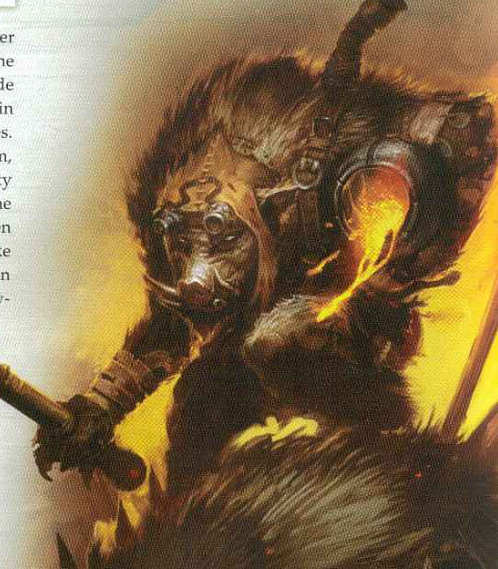
Farrow Bone Grinders tap into the power of dead flesh and bone, working alongside the Circle, Legion, Skorne or Trollbloods. They skin and debone many creatures, gathering their parts for a power that is part alchemy, part magic. Fresher corpses are better, and they use knives, cleavers and saws to gather what they need. Many mistake it for butchery, but they are craftsmen who carefully select organs, cuts and bones for power. They make talismans and powders that have immense potency. The lore of these shamans is part of farrow culture and tradition, and they've begun to show their worth using their magical powers, both to allies and those that enslave them. They are very adaptable and much more intelligent than most assume, thriving on the opportunities of battle.
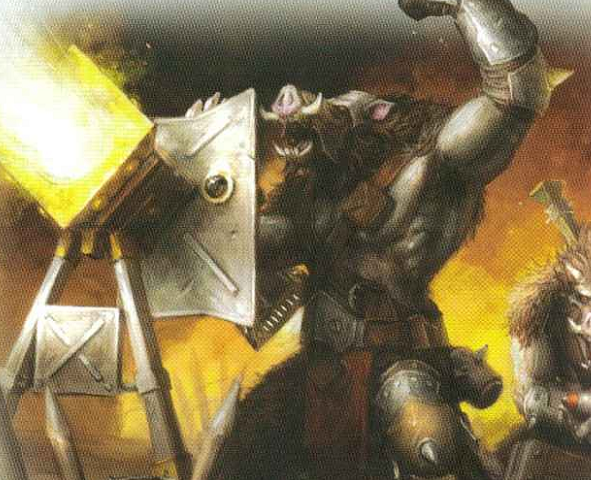
The Farrow Razorback Crews use powerful if crude weapons in the service, sometimes, of the Circle, Legion, Skorne or Trollbloods. The farrow are not inventive so much as masters at salvage and replicating stolen munitions. The razorback was derived from similar ordinance, particularly Khadoran rockets stolen from Llael. Trained teams of farrow assemble the launchers and their self-propelled rockets. They have no moving parts, so it's prefect for the farrow - an extended metal tube that aims the rather unpredictable rocket. Each one takes a lot of powder, and the farrow have bgun raiding military convoys to make as many as they can. They operate in pairs to work the razorback, and its rockets must be handled with care and guarded from fellow farrow. The recent use of the razorback has shocked the farrows' enemies, who assumed they employed only crude tools. Despite their short range, these rockets are more than able to take apart caravans and fort walls, and the crews are always important parts of these supply raids, though their leaders often dislike the amount of powder they use exceeding anything that might be gained by looting.
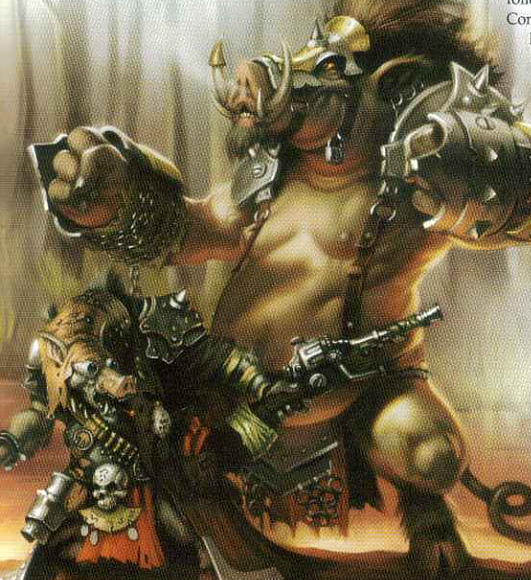
Rorsh and his immense companion Brine will work for Cygnar, Khador, the Protectorate of Menoth, Cryx, the Circle Orboros, the Legion of Everblight, Skorne or the Trollbloods. They wander Immoren in search of sport and profit, swaggering into war camps to offer their services for a price, no questions asked. Rorsh is a professional, unfazed by war, who prefers to fight by calmly lighting sticks of dynamite with his cigar. He claims to be a mercenary, but he's mostly an outlaw, and only the desperate will pay his bill. He's guilty of just about form of brigandage humans and farrow have managed to invent. He tends to shrug when asked about his crimes, as if to imply it was just for survival. He's robbed trains in Cygnar, plundered military stores and even held up banks. Where he inclined to speak about it, he'd admit that it doesn't always go well - he avoids capture, but never really gets rich, either. He prefers not to advertise how many victims he's left in his wake, adopting the image of a cheerful farrow with a knack for getting in trouble, but he's no innocent. It's no accident that the huge board Brine has developed a taste for human flesh. Rorsh figures, if the body's gone, he can't rightly be convicted of murder, and his preference for more lawless regions has supported that rationalization so far. Rorsh understands many languages, but rarely speaks human unless he has to. Even farrow words are rarely spoken, as he prefers to communicate by glare, posture and intimidation.
Rorsh and Brine are most often found at the edges of the Bloodstone Marshes, in Ternon Crag, or around the Dragon's Tongue and Hawksmire rivers. He's known there as a morally flexible freelance merc who will work for just about anyone if they don't try to impose law on him. Occasionally, younger farrow try to follow and learn from him, but he doesn't like hangers-on, and those that poke into his business too persistently tend to disappear. Despite that, he'd found it profitable to sell his services to Lord Carver and the Thornfall Alliance, though he refuses to stay long and won't give up other contracts out of any sense of farrow solidarity. Carver is still fond of Rorsh, seeing his silence as a ready ear for his plans, mistaking disinterest for polite attention. Brine, meanwhile, is either a freakishly immense farrow or some kind of large and less intelligent offshoot of the species. It is never far from Rorsh, amplifying his threat. Its presence has made many want to hire him, because while Rorsh may be good with a gun or dynamite or a cleaver, Brine can take on warjacks, and has been largely responsble for Rorsh's ability to evade the law, as no soldier can stand up to it. It has the temperament oif a wild boar, nearly impossible to kill and only deadlier once injured. Those who have fought it can attest to its ability to take damage that'd kill anything else, and that the more it's hurt, the angrier it gets. The two have been inseperable for as long as anyone can remember, and some insist they're utterly reliant on each other to live. Feeding Brine without battlefield corpses would be practically impossible, which may be why Rorsh so diligently seeks work and the occasional crime spree. Rorsh is good at terrain manipulation, while Brine's animus grants a bonus to fighting living and edible foes.
The End
Next up, Cygnar!
Forces of Warmachine: Cygnar
Original SA post Forces of Warmachine: Cygnar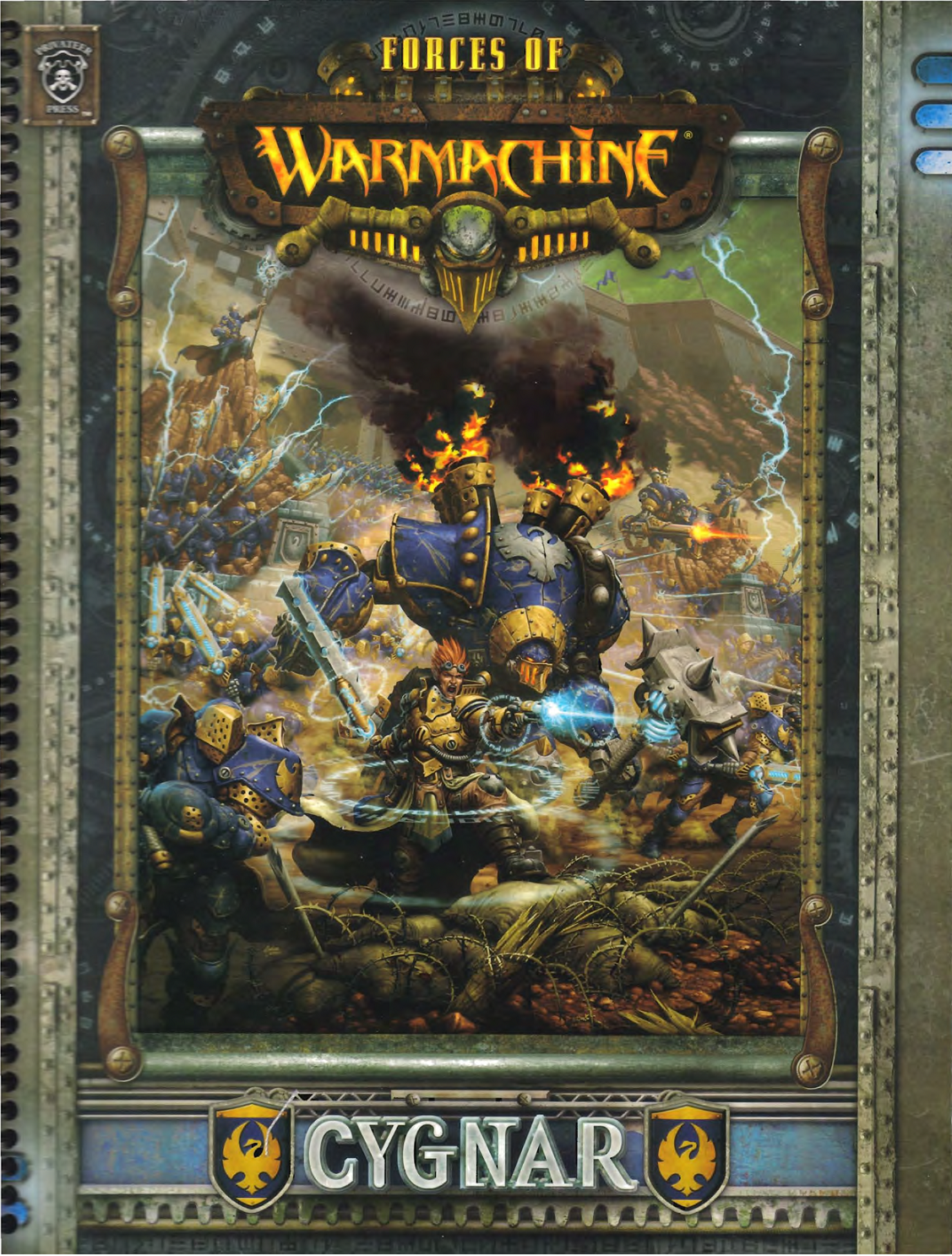
Cygnar is surrounded by enemies but always strives to protect its people. It is unequalled when it comes to combining magic and science, using advanced technology to arm its soldiers at all levels. They've taken massive recent losses, but are more than willing to keep fighting for their freedom. They focus on overwhelming long-distance firepower and lightning-based weaponry, which can even disable warjack cortexes. We already got their history in the core, so we don't get it in this book.

Cygnar's military has always been proud of being the most disciplined, best trained and best armed soldiers in Immoren, winning even when greatly outnumbered thanks to their focus on quality over quantity. They have changed a lot in recent years thanks to industrialization and mechanika, and they are on the cutting edge of military technology. They favor a combined arms approach focusing on ranged weapons, using warjacks with a broad spectrum of capability and sophisticated cortexes so they can function well whether controlled by warcasters or trained 'jack marshals. They use large numbers of riflemen, from long gunners to trenchers, as the backbone of their forces, but also use heavy infantry like the Storm Knights, who use mechanikally augmented wepaons to shoot lightning. Supporting them are specialized units like the field mechanks, gun mages and rangers. On top of that, Cygnar's wealth allows it to have longstanding relations with many reputable mercenary teams, and while they're not relied on for Cygnar's most vital interests, they give numbers and versatility to existing forces. However, Cygnar will only hire those who obey their strict contract laws.
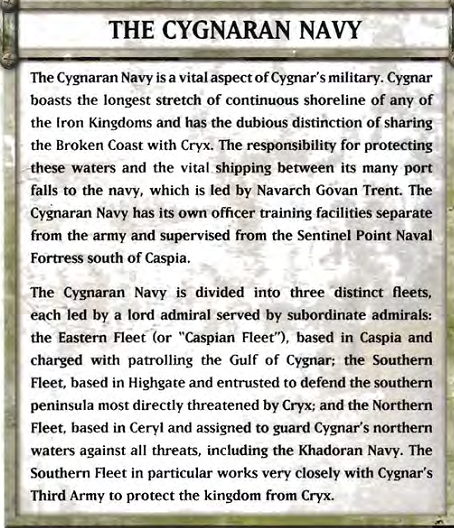
Recent years have proven difficult for the Cygnaran army, thanks to the loss of Llael and the Thornwood, as well as the fighting with the Protectorate of Menoth. Recently, the angry trollkin kriels driven from the Thornwood by the recent war have seized land from Cygnaran farmers and nobles, as well as attacking the railway. Cryx has disrupted supply lines both on the mainland and at sea, dividing resources further, and there are isolated reports of famine. Worse, not all of Cygnar's defenders have its best interests at heart, and some ranking nobles and officers have been conspiring to exploit recent events for gain.
The modern military owes a lot to the kings of Cygnar, dating all the way back to the colossals. After the Rebellion, the kings and generals thought they would be the mainstay of the military for the foreseeable future, reinforced when King Benewic II had to deal with the Khadoran invasion of Ord and Llael that would become the Colossal War of 250-257 AR. After the Corvis Treaties, Khador had spent a lot on making numerous colossals. Llael and Ord had none, and would have been crushed if not for Cygnaran intervention. However, colossals were very expensive and hard to maintain, requiring massive quantities of fuel. The seven year war strained both Cygnaran and Khadoran treasuries, and after Benewic II's death in battle, his successor, Woldred the Diligent, remarked that the war ended "more from mutual fatigue than any other factor." Khador surrendered, on the verge of bankruptcy, in 257 AR. The Cygnaran and Ordic Armies forced Khador to dismantle their colossals and the foundries that made them, appearing to give Cygnar military supremacy. However, the Second Trollkin War of 262-267 AR proved the limits of colossals. During a series of pitched battles in the Thornwood and Gnarls, they were often bogged down by the terrain, and were not very helpful without large targets or permanent forts to besiege.
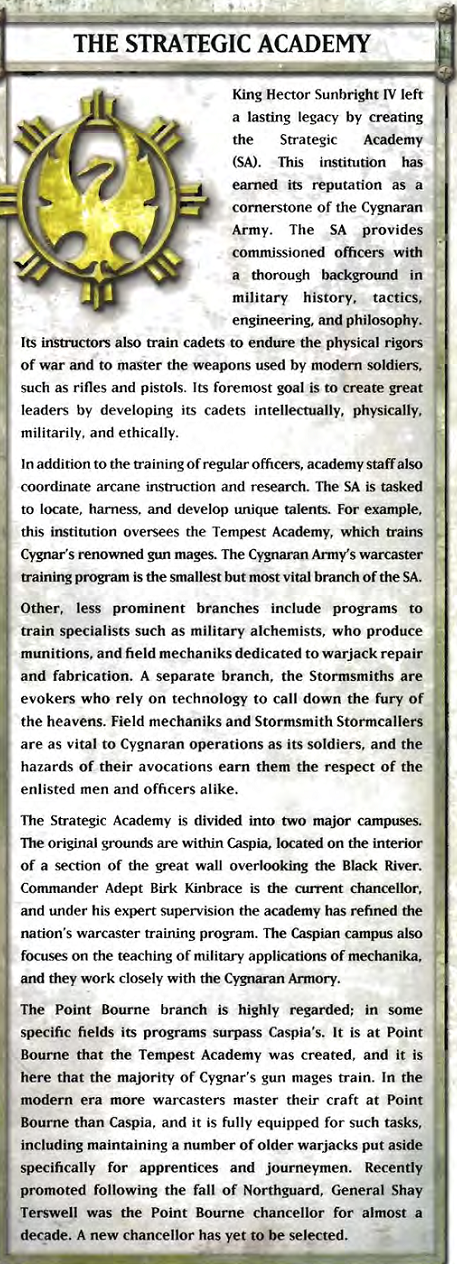
The Cygnaran mechaniks had been working on more efficient, smaller weapons, and it was no shown they were needed. The first true warjacks were made by the end of the Trollkin War and soon became a mainstay of Immoren militaries. Woldred finally had the colossals decomissioned in 286 AR, investing in infrastructure to make and innovate new warjacks. Despite this, though, for almost half its history Cygnar's military was stuck with feudal tradition. Large segments of its best soldiers were men-at-arms or serving various nobles. The mustering of a strong armor took the active cooperation of the nation's most powerful citizens, who could use it to their advantage. The tradition still has not entirely been erased - Cygnaran law allows each noble family to arm and command loyal soldiers. However, they have been heavily revised and rewritten to alter noble rights. King Hector Sunbright III, the Golden, who ruled from 406-425 AR, overhauled those laws and began the process of transforming the Cygnaran Army into a thoroughly modern military.
In addition to founding the Strategic Academy for officers, King Hector established a clear chain of command, creating the rank of warmaster general to oversee the often contentious Cygnaran generals. He was concerned about the overlap of political and military authority, and sought to separate the two as much as he could without alienating the nobles. He limited the size of private armies, with lesser nobles allowed only small honor guards, though earls and above got larger retinues still. This did, of course, mean the army would strain the royal treasury more. The next major evolution of the military came under Warmaster General Vinter Raelthorne II, serving under King Grigor Malfast during the First Thornwood War. He continues his reforms after becoming king in 515 AR, organizing the Cygnaran Army into the four distinct bodies and demanding extensive training for every soldier. He made riflemen a priority in the infantry. In the past, they were used in smaller numbers due to cost, but in time, they got improved weaponry and became the Long Gunners, now the largest branch of the army. The other cornerstone, the Trenchers, were foudned at the end of Vinter II's reign and greatly expanded by Vinter Raelthorne III, proving very effective in border skirmishes after the First Thornwood War.
Vinter III refined several of Cygnar's fundamental military doctrines, including the focus on accurate long-ranged firepower, which led to the development of the Defender and Charger warjacks. They quickly became mobile and versatile replacements for cannon artillery batteries, which were slow and cumbersome. Artillery itself was saved for defensive fixed positions. Vinter Raelthrone IV is not remembered much for his innovations, but he modernized the navy after the Scharde Invasions of 584-588, and these battles also defined the role of the Third Army, which integrates ground and naval forces. His Inquisition publicly targeted sorcerers while secretly going after perceived foes of the regime, resulting in the imprisonment and murder of many arcanists deemed dangerous. This bacame a concern to Warmaster General Carston Laddermore, who wanted to protect potential military assets from the Inquisition. He formally incorporated the Gun Mages of the Arcane Tempest in to the Army to protect them, and before this they had been a private brotherhood. Now, they are one of Cygnar's top special forces.
After Leto seized the throne, he ushered in a new era of innovation in arcane technology, beginning even before then when he helped to create the Stormblades. As king, he fostered inventors like Sebastian Nemo to expand the role of electrical weapons in the Army, and the power of the STorm Knights and Stormsmiths is now a huge part of the armed forces. One of the lesser-known consequences of his coup, however, was a loosening of the laws restricting the right to private armies. He had exploited his brother's disinterest in law to adjust those in order to arm his own supporters. He has not strengthened them as a king, seeing the private armies as something useful when needing to fight trollkin, skorne patrols or other unexpected foes. It is likely the army and navy will continue to evolve in the coming years, as new threats arise.
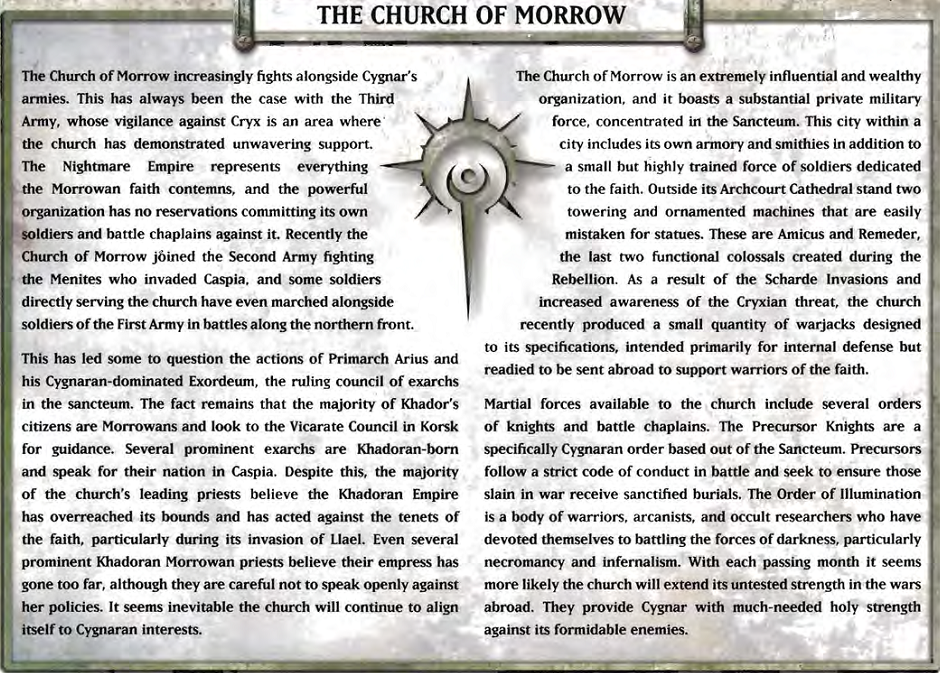
While the navy has occasionally impressed sailors, enlistment in the army has long been voluntary, with the exceptional of occasional penal battalions. Leto has refused to impose conscription no matter what, on the grounds that forced soldiers can never match the resolve of volunteers. The fact that Cygnar is in constant danger of invasion does help enlistment rates - there's actually more volunteers than the training system can handle, and all training facilities are now being expanded, calling even on former officers to be instructors. Not every uniformed soldier sees combat, and many work ot produce and supply munitions, gear and supplies to the front. These support teams are vital and well-respected. Some volunteers do not make the cut, and are encouraged to enter urban militias, which are often a secondary recruitment pool, as their training can help transition the best of them into the army later. Training varies in duration and intensity by army branch, with long gunners having the shortest cycle, due to the need to get them into the field quickly. Every soldier, however, is expected to endure exhaustive drilling, physical conditioning and instruction. Trenchers train almost three times as long as the long gunners, and have even more grueling drills to improve their endurance. Some of these techniques started as punishments for insubordination, but were expanded when they proved good at creating soldiers with high performance in adverse conditions. Above the rank of major, officers are no longer identified with a specific branch, regularly supervising mixed forces, and osme officers may forego promotion in order to remain at their current level of command. Carrer officers who prefer the battlefield tend to favor the ranks of captain and major.
Cygnar's location surrounds it with hostile powers, and so the Army is divided into four regionally distinct armies. However, the railway has forever changed how they share resources and help each other. It doesn't, though, reach every city, and reinforcements still take time to equip and deploy. Soldiers sent from Ceryl to Highgate must voyage along the Broken Coast, at risk of Cryxian piracy. Even safer rail lines can experience unexpected dangers, such as when the Marchbridge connecting northern and southern Cygnar was destroyed by Sul-Menite sabotage in 605 AR. Despite this, Cygnar has a lot of flexibility in deplyong soldiers, 'jacks and warcasters where they're needed. A recently implemented telepgraph system has nearly eliminated delay for messages sent to forts, enabling the king and warmaster general to stay current at all times. The current supreme commander of the army is Warmaster General Olson Turpin, though his standing has diminished some recently. Senior officers know that Lord Commander Coleman Stryker has largely replaced Olson as the primary advisor to Leto. However, for anyone other than the Storm Division, the warmaster general remains the top of the chain of command.
The First Army, also called the Northern Army, Thornwood Army or Northwatch has traditionally had the job of defending the Khadoran border, and it's seen more combat since creation than the other three armies combined. Currently, they are having a very bad time. Northguard and the Thornwood are fallen, and the army has suffered heavy casualties. Morale and pride are suffering, but the First ARmy is determined to regain what was lost and prove they are not broken. Until 605 AR, they rotated regularly through the Llaelese border forts as part of a cooperation effort with the Llaelese Army. Some of them resented the degree to which Llael relied on them, but it gave valuable experience and social ties between officers. Veterans of the war in Llael saw the deaths of many comrades, both their own and their allies. Some handpicked units of the First were sent behind enemy lines to help the Llaelese Resistance, and some of them are still stuck in Llael, operating cut off from the chain of command. Priorities have shifted, leaving them stranded. Some have joined the Llaelese Resistance or gone AWOL to find a new life. Others remain in sporadic contact with the Cygnaran Reconnaissance Service and perform missions as needed.
After the surrender of Llael's capital in 605, most Cygnaran forces withdrew to the border, in the Thornwood. Khador continued to assault them, and while they stood strong for a year under hash conditions, Northguard became a constant battlefield, seperated by a blasted wasteland from Khador's Ravenguard. It fought of an immense attack orchestrated by Kommandant Gurvaldt Irusk in late 606, the most deadly battle for both sides to this day. Cygnar won, but just barely, and its defenses could not be restored in time. The next assault was crushing, and Supreme Kommandant Irusk had learned from his mistakes. Northguard was breached, and as Nemo evacuated as many as he could, General Cathmore stayed behind to fight to his death. IT was brave, but futile, and other fortress soon fell after Northguard's loss. Most of the defeat came down to two things: first, the division of Cygnar's attention, thanks to the Caspia-Sul War, and the genius of Gurvaldt Irusk. Reacting quickly at Northguard had never been practical, so it wasn't surprising that the warjack reinforcements from Caspia didn't arrive in time, while Khador was able to focus entirely on Cygnar.
Next time: The Four Armies
Forces of Warmachine: Cygnar
Original SA post Forces of Warmachine: Cygnar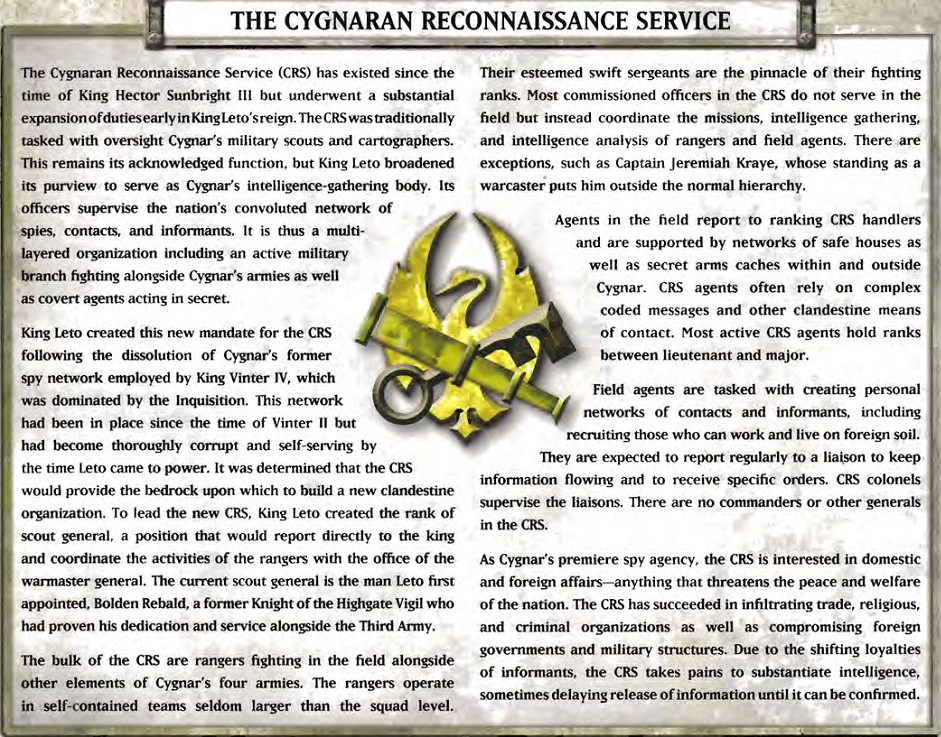
Some members of the First remained in the fort-city Fellig, now entirely isolated from Cygnar. They were attacked by bloodthirsty madmen and berserkers, led by the Butcher of Khadov himself. While he failed to get through the walls and was wounded in the attack, his forces gutted the Cygnaran garrison. If not for the Ordic Army, Fellig would likely have fallen. Now, its fate remains uncertain but its people are safe, if reliant on Ord's King Baird II. By any meaningful measure, Fellig is Ordic now, not Cygnaran, even if a few isolate First ARmy soldiers remain there, waiting for orders. Khador seems content that the city is cut off and has not tried to take it again. The First Army regrouped along the Dragon's Tongue River, anchoring themselves east of Corvis and west of Poiint Bourne, both vital elements of the Cygnaran supply chain before the fall of the Thornwood. Point Bourne is also one of Cygnar's most vital training centers. These two cities are highly fortified, but not happy to have the front line on their doorsteps, especially with Khador building new forts across the river. So far, there have been no major actions, but periodic border clashes and artillery attacks happen almost daily, and fullscale battle will surely resume soon.
The First Army command structure is intact but highly strained by casualties and personnel shifts. Lord General Olan Duggan remains in command and still bears the title of Duke of the Northwood, but all of his lands and those of his vassals are in Khadoran hands. He was based out of a fortress east of Fellig and was able to help in the Northguard retreat. His command staff is still recovering from the loss of key officers, including General Hagan Cathmore and Dargus Mathem. Mathem died of an infection after the Fellg assault, and Cathmore was killed by Karchev the Terrible, with his title of Earl of Bloodsbane passing to his eldest son, a lieutenant in the First, though the region is now firmly Khadoran. Duggan is stationed alongside the newly promoted General Shay Terswell at Point Bourne, overseeing the First Army's western forces. The eastern portion is being directed by Generals Sebastian Nemo and Galt Langworth from Corvis. The final concentration of First Army soldiers operate out of Stonebridge Castle under General Kierlan Krismoor, formerly of Deepwood Tower. Lord Commander Stryker's Storm Division has joined defenders in the region. Most of the First Army's much-needed reinforcements are drawn from the Fourth Army out of Fort Balton. Not all of the First likes that, as the Fourth is suspected of numerous indiscretions and not well trusted, though the reinforcements also include some of Cygnar's most respected warcasters, at least until fighting flares up elsewhere.
The Second ARmy, also known as the Caspian Army, the Eastern ARmy and the Army of the Black River, guards the eastern border and maintains the garrisons at the capital, Fort Falk and Eastwall. It has traditionally defended Corvis, but that now belongs to the First Army. The Second Army battalions defending the city are largely now transferred to the First. The Second Army has the highest proportion of heavy infantry and cavalry in the Cygnaran Army, including veteran Storm and Sword Knights. Many ranking officers are vassals of nobles on the Royal Assembly, and they have substantial warjack support thanks to the Cygnaran Armory in Caspia, serving as testing grounds for new chassis and weapons. Their repair and resupply times are much faster than most other armies, thanks to the power of the capital. Like their peers, they've had to deal with constant strife for a few years now, leading to widespread reorganization and constant recruitment to refill their ranks. There has been a short but welcome reprieve now, following the death of Hierarch Voyle. Intelligence suggests that the Protectorate of Menoth remains active but has shifted its focus to the Northern Crusade in Llael, and a number of personnel stationed in Caspia for the Caspia-Sul War have since been transferred to other posts.
The wild fluctations of the Second ARmy's needs are part of a history dating back to the end of the Cygnaran Civil War. In its early history, the Protectorate was distracted subjugating the Idrian tribes, but it wasn't long before they threatened Cygnaran security again. The Second Army has always been reduced or expanded based on their threat, but even in peacetime, they are a substantial force. They were at their largest during the Caspia-Sul War of 606-607, damaging both cities extensively. Prior to the war, the Protectorate had mounted a failed assault on Caspia, and the war didn't escalate until Cygnar breached Sul in 606, long believed impossible and achieved only by a month-long cannon barrage orchestrated by Markus "Siege" Brisbane. Lord Commander Coleman Stryker was assigned to the 6th Division, soon known as Storm Division, and took charge of the offensive, hoping to subdue Sul quickly. However, resistance was far greater than anticipated, and the Menites rellied, defending the Great Temple of the Creator. From there, it became a year of street-to-street battle with no clear advantage and requiring constant dedication, with more and more soldiers assigned to 6th Division. The fortresses depleted by this were later assaulted by skorne from the Bloodstone Marches, and while they didn't pierce the border, they caused heavy casualties, especially after an attack on Fort Falk in 607.
The circumstances of the war in Sul were unusual, with Lord Commander Stryker getting the lion's share of resources and personnel, and the generals of the Second relegated to bureaucratic functions. The war took a dark turn in 607, when Stryker was almost killed during the collapse of a burning temple. He was taken to the Sancteum of Caspia, where he was treated for weeks, and the Protectorate gained the upper hand. The gates were seized and the capital was assaulted for the first time since the Civil War. It got worse when Hierarch Garrick Voyle himself emerged from Imer with reinforcements, calling on his immense power and the miracles of Menoth. The still-recovering Stryker forced himself from his sickbed to face Voyle alongside King Leto, Morrowan forces and the Second Army's knights. It ended disastrously when Leto was terrible wounded. Stryker and the knights regrouped, facing off against Voyle, and Stryker managed to kill the man formerly believed invincible. It broke the Menite morale, and they withdrew to Sul. There have been flareups since then, but the gates have remained sealed.
Lord Stryker's Storm Division has now been granted autonomy, reduced in size to a mobile strike force outside the Second Army command structure. The chain of command that was disrupted during the war has been restored, and Lord General Wiggin Heltser leads the Second from Caspia, where he is regularly in contact with the warmaster general. The new 8th Division made to replace the 6th is led by General Artoris Halstead. The eastern border is largely guraded by General Alain Runewood's 7th Division out of Eastwall, while the northern end of the border is under charge of General Kielon Ebonhart IV and his 12th Division from Fort Falk, moved from Corvis.
The Third Army, also known as the Southern ARmy, Army of Highgate and Army of the Wyrmwall is based out of Highgate and has the job of protecting the southern shore from Cryx. They've only been around for a century, but are inheritors of a millenium-old tradition, and there are none better in Cygnar at facing Cryxian tactics. Operationally, they are very different than the other armies, working closely with the Cygnaran Navy on joint operations. the admirals of the Southern Fleet stationed at Highgate answer to Lord General Vincent Gollan on top of their lord admiral, and it seems to work. The first and preferred tactic for facing Cryx is sea engagement, intercepting Cryxian ships before they can land their raiders. It's impossible to stop all or even most raids, though, especially given Cryxian diversion tactics and willingness to sacrifice ships. Even the infamous blackships are sometimes used for that purpose, and Cygnar can't afford to ignore those supernaturally empowered vessels, as they take immense firepower to engage at all.
The Third is always prepared to strike at Cryxian fortifications near the Cygnaran coast, preferring light warjacks for ease of deployment. Land garrisons get heavier 'jacks, but recently have had to use less support from warcasters due to the other fronts, so they've made the training of 'jack marshals a high priority. Historically, the Third was at highest strength during the Scharde Invasions under Vinter IV, and both Vinter and Leto led soldiers in that war. The soldiers of the 121st REgiment are still known as Leto's Own after fighting under the prince from 587-588, while the 98th Infantry Battalion are Vinter's Bastards after serving underh im directly during the final battle, the Landing at Giant's Head, which was the final time the sword Kingslayer was drawn to defend Cygnar. They feel no shame in the name, invoking his ruthlessness in war rather than his tyranny.
Before the Scharde Invasions, the Third Army had drastically underestimated the Cryxian threat, and it was believed that their raids were just random attacks out of Blackwater, Dreggsport and Satyx rather than an organized effort. They have since become more proactive in hunting Cryxian bases. However, it was not until deeper analysis by the Hurstwallen Report of 605 that it became clear how thoroughly their efforts had failed. The entire Scharde Invasions were revealed as a series of deceptions allowing Cryx to gain inland footholds, not discovered until their use during the Llaelese War. Cygnar has had to face the fact that Cryx now has a permanent presence in the interior, and will not be easily removed. Few of their bases have even been located. It's believed that a sizable force is operating out of the Thornwood, but whether they have supply chains of some sort is unknown. While coastal defense remains the top priority of the Third Army, they are valued for their Cryxian experience, and are often sent to advise commanders having to face the undead.
Starting in 607, the Third and the Navy began a fresh offensive against the Cryxian fleet, with the aid of the Ordic Royal Navy. So far, it's had mixed results. Cooperation from Ord has become complicated since the Khadoran Navy started to notice, leading to mixed naval engagements against Khador, which has made Oridc admirals reluctant to fight for fear of their neutrality being undermined. Plus, assaults into Cryxian territory often have high casualty rates, perhaps doing more harm than good. Despite setbacks, though, the Third believe they must confront Cryx in order to protect Cygnar. Until a more effective strategy and more soldiers can be found, however, it's a desperate battle. For thirty years they have been led by Lord General Vincent Gollan, Earl of Shieldpoint, Senior Knight of the Prophet and Commander of the Knights of the Highgate Vigil. He is in poor health but remains a living legend, respected as a servant of Morrow and foe of Cryx. Despite the esteem he is held in, though, there are those eager for younger blood and newer ideas. For now, Lord General Gollan supervises the engagements from Highgate, with assistance from Westwatch and the port city Mercir. General Bors Gately works closely with Gollan to lead the 9th Division, the majority of the Third Army's active personnel. Senior Commander Evelyn Turpin, granddaughter of the warmaster gneeral, commands the 14th Division in defending the Wyrmwall Mountains, achieving much with little.
The Fourth Army is also known as the Western Army and the Army of the Dragon's Tongue. Iti s the smallest and least respected Cygnaran force, historically used as reserves. The mostly patrol the Ordic border, and Ord has long been friendly. Recent events have brought them out of Fort Balton to play a significant role, however. The closest Cygnar and Ord have ever come to violence was over whether the city Five Fingers was Ordic or Cygnaran after the Colossal War, and the dispute was settled peacefully, with Cygnar withdrawing claim in the interest of a united front against Khador. The Fourth Army didn't exist then, but they consider joint engagements with Ord against Khador part of their history, drawing nicknames and banners from the era. They also have a strong sentiment of Thuran pride, an ancient kingdom now divided between Ord and Cygnar.
The Fourth are mostly helping to maintain peace around Ceryl, facing small engagements with bandits, mercenaries and outlaws as well as the occasional Tharn and trollkin. It has made them skilled in unconventional tactics, some of which would never be done elsewhere. One incident still under investigation involves two companies of the Fourth slaughtering the Hagen Blades mercenary company to the last man. Some consider it an example of what happens to those who betray Cygnar for gold, others call it an atrocity. The Fourth has a sordid reputation as a dumping ground for undesirables, and is indeed often sent the insubordinate who are too competent to get rid of, and there's no question that they've had a higher incidence of crime, including extortion, graft, bribes, misallocation of resources, looting and violence against civilians. They have recently come under criticism for not responding promptyl to reinforcement requests, and were notably absent in Llael and the Thornwood. Most of their soldiers are patriots, but they serve under General Gralen Deckley, who it seems favors the Duke of Thuria over Warmaster General Turpin. The crown's been too busy to investigate these rumors, though, particularly in recent months with the Fourth more willing to comply.
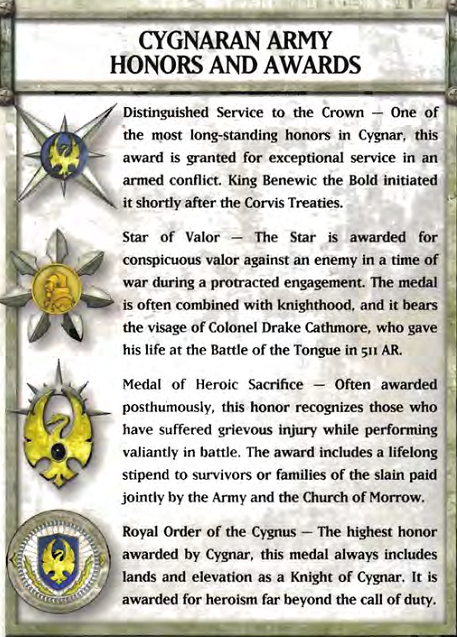
After the fall of Northguard and the Thornwood, most of the Fourth Army was ordered east to reinforce Point Bourne, Stonebridge Castle and Corvis, with a smaller force remaining at Fort Balton. Duke Mayhew Dergeral of Thuria, though, has long been one Leto's least cooperative nobles, a loyalist of Vinter IV. It is well known among northwestern political circles that General Deckley is close friends with the duke, and some call him the duke's pocket general. This has prompted suspicion of Deckley's willingness to reinforce other garrisons, and many believe that it's the duke's desire to protect his interests against Khadoran incursion. Scout General Rebald has sent agents to investigate but found no clear evidence of misdeeds. If they knew the full scope of the treason they faced, they might dissolve the Fourth Army entirely, and at least replace General Deckley, but so far they have only suspicions and the duke is too powerful to be thraetened prematurely.
In truth, both Dergeral and Deckley are deeply involved in a treacherous but secret plot. Others understimate Dergeral for his eccentric demeanor, but secretly, he and several ranking officers of the Fourth are plotting to return Vinter IV to the throne. While in the progress of moving east, the Fourth has faced the trollkin serving Chief Madrak Ironhide, who had seized Crael Valley on the grounds that Leto reneged on his promises. Leto hoped to find peace and advised them not to fight the trollkin, but the Fourth ignored those orders and committed their full strength to rooting out these trollkin 'bandits.' There were high casualties on both sides, but the Fourth have claimed it was a glorious victory. They did drive the kriels from the farmlands, and Deckley claims it was a reaction to assault in transit, including the seizure of a hospital train. Public sentiment in the area supports hte Fourth strongly, as they have little sympathy for the trollkin, and many northern nobles now like Duke Dergeral and resent Leto for ignoring requests for military aid against the kriels. Unknown but to a few, these battles also provided the mans to cull the Fourth of officers who might be an obstacle to the duke's goals, and many vocal supporters of Leto and those who questioned the Fourth's ruthless tactics were among the slain.
Most of the Fourth was not part of the conspiracy and still fight with the goal of restoring Cygnar to former greatness. Still, even among the enlisted it's a common belief that Leto is weak. A recurring sentiment has been the idea that only a renewal of the old Raelthorne strength can restore Cygnar in this dark time.
Next time: Warcasters
Forces of Warmachine: Cygnar
Original SA post Forces of Warmachine: Cygnar
Cygnaran warcasters, regardless of rank, are free to move between battlefields with liberty and allowed to requisition whatever they need. They are never permanently attached to any division or company, though they often spend months in the same units and will keep trusted officers, reallocating them as required to face threats. Managing these assets is a headache, but warcasters are a vital asset that can ensure victory even against impossible odds. They are accountable to the same code of behavior as everyone else, but they get a lot more flexibility. Some soldiers resent that, but most don't after seeing their power. The talent is unexpected, but tapping into it takes training and discipline. Those with the talent are sent to the Strategic Academy to train, and on graduation they become journeymen, with the rank of lieutenant if they don't already outrank that. A journeyman must complete a full tour under a sensior warcaster, which could be six months or over a year depending on their mentor's assessment. Once it's over, they become a captain and have the full authority and responsibility of a warcaster. Their authority, however, extends beyond rank in several ways. They are often given operational control in battle, even if it someone outranks them, and they have a lot of liberty when requisitioning 'jacks, troops or supplies, especially if they're a ranking warcaster. A captain might have a limit of few hundred men but plenty of choice as to who they are and what equipment they have compared to a non-warcaster captain. It isn't uncommon for warcasters of any rank to command customized strike forces for specific objectives.
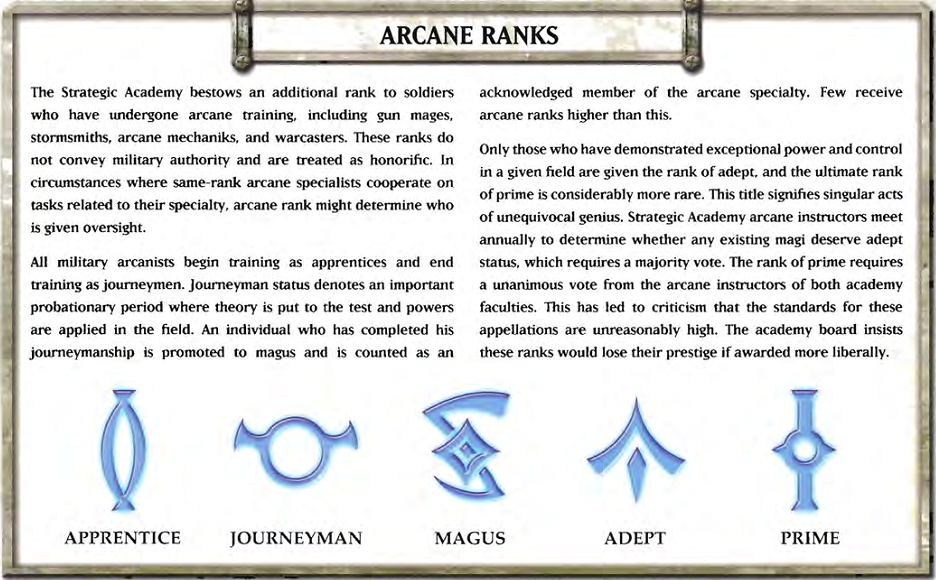
Once in active service, a warcaster is assigned a team of warjacks and a supply train and support staff, but is otherwise responsible for their upkeep themselves. The 'jacks belonging to a junior warcaster remain in service until needed elsewhere or destroyed. Senior warcasters get special consideration in specific requests to meet the needs of their missions and may swap out 'jacks frequently. In some cases, they will retain a specific 'jack long enough to establish permanent bonds affecting its cortex and behavior.
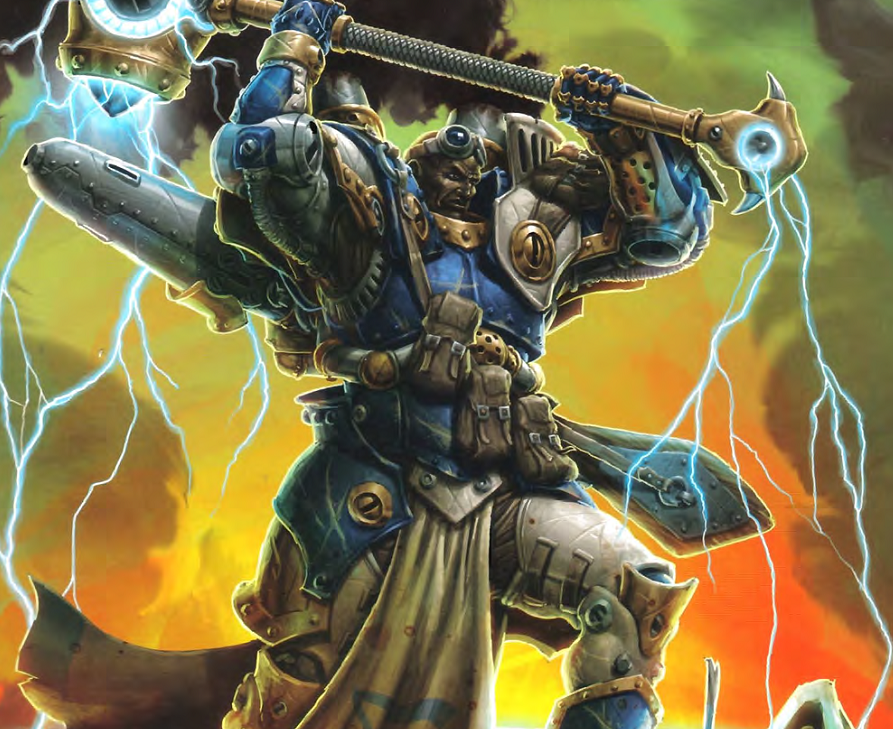
Major Markus "Siege" Brisbane lives for war. He has more field experience than pretty much any other warcaster in Cygnar, and is famous for his ability to lead from the front and win. It's been said that there's no obstacle he can't overcome and that no wall can stand against him. He began his career under Vinter the Elder, and has served for two decades so far. To him, warfare is artistry, a symphony he plays with skill and conviction, with his troops, 'jacks and skills as the instruments. He's called in to deal with prolonged sieges or enemy obstructions. He doesn't do politics - he's just a soldier, existing to win. Armed with an arsenal of mechanikal weapons, he has torn apart walls and barricades with his war maul, Havoc, and his rocket cannon. His skill is legendary, and his troops are often inspired by his very presence. His tactical mind breaks down combat as if it were a puzzle, finding and exploiting weaknesses in forts and enemy plans. Even the toughest walls have fallen before him, including the so-called impregnable walls of Sul itself. It is that accomplishment that will keep Siege a legend forever, having broken walls that were unconquered for millenia. In the months after the incursion at Sul, he was critical to many Cygnaran victories, using his intuitive grasp of demolitions and artillery to master urban combat. When Lord Commander Stryker fell, it was up to Markus Brisbane to pick up the slack, using all his tricks to slow the Menite advance long enough for Stryker to recover. After the end of that incursion, he's been sent north to help reinforce the border. His gimmick is artillery. He is really good at blowing shit to hell and back, and stopping shit from being blown up. His feat weakens enemy armor by taking advantage of its weaknesses.
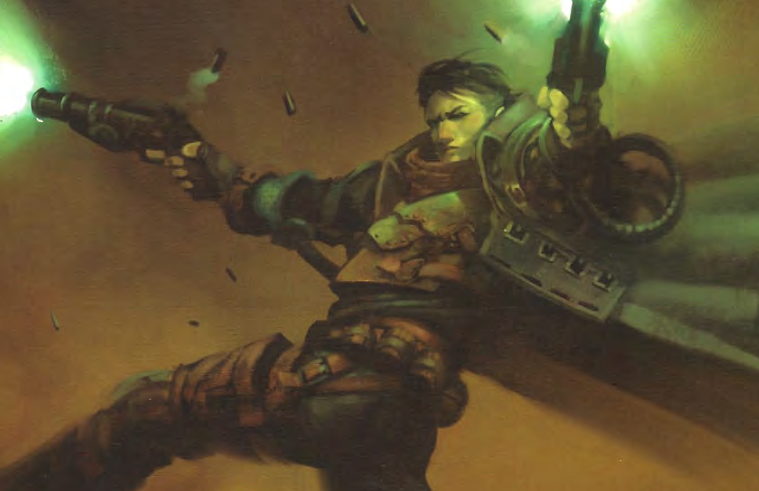
Captain Allister Caine is an Epic character. His youthful indiscretions were genuine, but time has changed him, exposing him to the reality of war and his mistakes. What once was reckless talent has been refined into perfection in gunplay. No one alive can challenge him if he has his Spellstorm pistols. He has given up all other weapons, using them at all ranges. The last few years have aged him more than he'd thought, forcing him to make tough decisions and testing his convictions. He's been caught up in a complex web of intrigue, lies and murder. If the full scope of his deeds were unconvered, he could as easily be put to death for treason as be heralded as a hero, depending on how it came out. At the outbreak of war with Khador, he barely maintained the appearance of an officer or warcaster, often at odds with his superiors. He had the distinction of being the only full warcaster below the rank of captain and was often seen meeting with wanted criminals such as Asheth Magnus. Many considered him to have no loyalty. What no one suspected was that he'd been serving as one of the top agents of Scout General Bolden Rebald, head of the Cygnaran Reconnaissance Service. The moment he began serving is a secret known only to those two, but likely it was some time after he was briefly held for crimes in his hometown, Bainsmarket, very early on in his career. Those with the political weight to do so buried the detailsof the crimes and the incident was largely forgotten. He worked with the CRS ever since. Under Rebald, he joined a plot to wipe out a threat to the kingdom. Sworn to secret, possibly treasonous oaths, he worked to find an unknown offspring of Vinter Raelthrone IV, as Rebald feared that the child might make Leto abdicate the throne. To prevent that and the resulting chaos, Caine was given the job of finding and eliminating the child. In pursuit of that, Caine stalked and killed dozens of former inquisitors, including those directly in service to his own superior officer. He fought with the traitor Ashet Magnus, who sought the inquisitors and heir for his own reason. Magnus outmaneuvered Caine during the Menite incursion of Caspia and escaped with the heir's location. New, Rebald and Caine are on the edge of having their plots discovered, and the must find the traitor's plans and defeat him to regain the upper hand. Caine may well change the course of history soon. His gimmick remains being the best gun dude ever, and his feat allows him to get a bonus to his damage rolls each time he hits an enemy in a round - and given that he has a literally infinite rate of fire, that means he can just keep getting worse the more folks are in range.
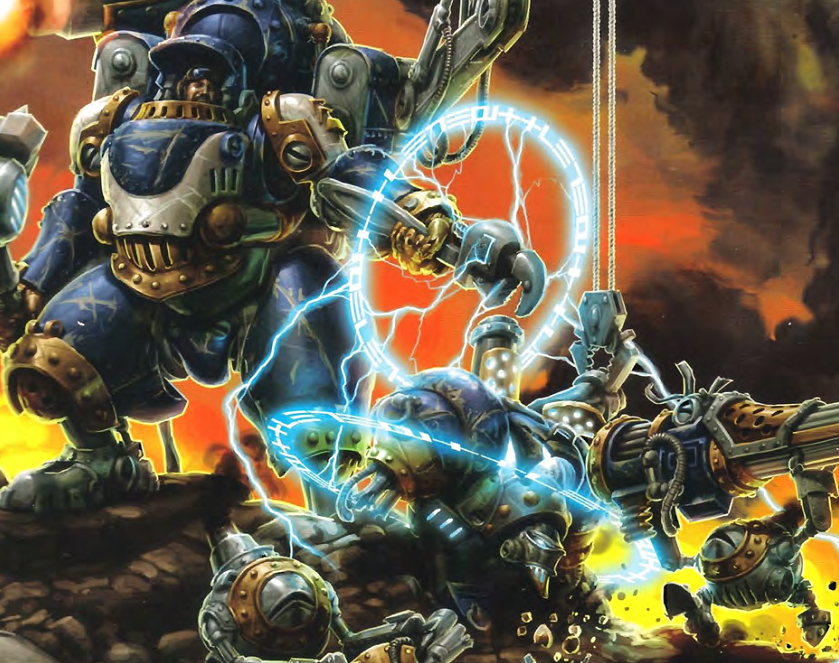
Captain E. Dominic Darius (the E. is for Edward) is never seen without his Halfjacks . He goes into battle in immense steam-powered armor of his own design, which augments his strength and protects him. In military circles, he is known largely as " the mechanik," not just for his mastery of mechanika but for the precision and efficiency of his combat skills. His warcaster talent was found early, and he was brought into the military immediately. He'd been known as a genius since childhood and had an intuitive grasp of engineering, needing no instruction to understand warjack construction and even the operation of cortexes. He completed his training under Commander Adept Sebastian Nemo in record time, and has been a lynchpin of Cygnaran war industry ever since. He's one of Cygnar's top experts on warjacks, and no one else has logged nearly as much time working on them. Even Nemo defers to his practical expertise. Though most warcasters rely on a stable of mechaniks to keep their 'jacks ready, Darius maintains his all by himself, returning wrecks to full operation in his spare time. He's a favorite of logistics thanks to the fact that he so rarely asks for new warjacks, and they know if he does, he really needs it. Plus, he occasionally volunteers to take 'junkers' that others believe are totaled. He finds it a point of pride that some of his best machines were once marked for scrap, and he's lovingly restored almost ever 'jack in his service. Darius' armor serves as a second skin in battle, containing an entire shop's worth of tools and a powerful cannon that uses steam pressure to fire high explosives. Its power allows him incredible strength, and he wields an Ironclad's quake hammer in one hand and a giant wrench in the other. Most of his gifts are focused on augmenting 'jacks, but he's also a potent battle mage, and can take heavy punishment thanks to his armor. He occasionally loses sight of the fact that it's not quite as tough as a warjack, however, and he's had some close calls, almost losing his life at the Temple of Garrodh when fighting Cryx after getting out of his armor to repair it mid-battle. He got ambushed by Skarre Ravenmane, and would have died if she hadn't been distracted by the temple collapsing. He's learned his lesson but still prefers to lead from the front - just, from inside his rig.
Darius' most ingenious weapon is the drone deployment system on the back of his armor. He can unleash self-powered drones he's named the halfjacks to serve as weapons and repair assistants. Each carries a potent explosive charge that turns them into walking landmines, as they can easily burrow into the earth. Each can also carry out basic repairs to warjacks as needed. These abilities alone would earn Darius respect, but he's also a good tactician. He's good with soldiers, feeling at home among them, and they appreciate his pragmatism and willingness to get his hands dirty. He's known for being able to quickly assess a situation and direct his subordinates in the middle of chaotic battle. His extensive experience is mostly against Khador, and he's been heavily involved in the Thornwood and at Northguard before it fell. Since then, he helps patrol the border alongside people like Captain Jeremiah Kraye. His arcane power improves the strength and fuel efficiency of his 'jacks, and so he can respond well to most threats with surprising speed. More than one Khadoran kommander has ordered an attack in the belief that warjacks were too far away to respond, only to be surprised by the arrival of Darius and his machine pack. Recent fighting has also given him experience against Menite forces and Cryx, and he never stands down from a challenge. His gimmick is buffing warjacks, and his feat allows him and his halfjacks to completely repair warjacks they're near.
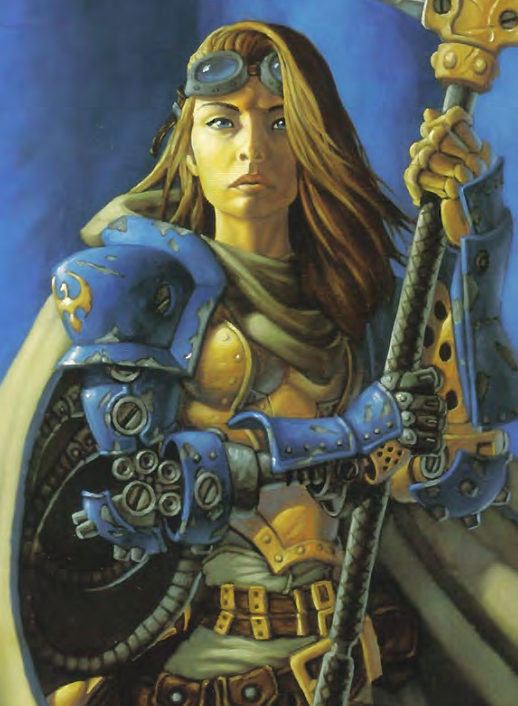
Major Victoria Haley is another Epic caster. She is a powerful woman with a deep sorrow. Her unmatched magical talent is tempered by ears of combat experience, and she's only getting stronger. Her manipulation of time itself has recently intensified, allowing her to boost the speed of her warjacks and slow her foes. She can wield time itself as a weapon to shred enemies. She is feared and respected, having survived all her foes can throw at her. Within the Thornwood, after years of duels, Deneghra finally attacked Haley with all of her pent-up hatred. Her malevolent twin sought to kill her and eat her soul, and Haley fell, pushed to the edge of defeat. Near death, she forced herself to rupture the flyphs containing the cortex of Deneghra's helljack, turning it against her Cryxian twin and holding her in place. Haley tore the warwitch in half, killing her. Never before or since has anyone so completely stolen the control of a warjack. Haley is still scarred from the battle, having lost an arm to her sister. Now, she uses a mechanikal prosthetic. The sisters fought again at the Battle of the Temple Garrodh, where Haley witnessed Deneghra's transformation into a wraith by the power of Asphyxious. Haley has at least been able to grieve for the sister she remembered, and for a time she considered her sorrow put to rest. Haley was distracted from her battles with Deneghra by the needs of the border, fighting alongside Sebastian Nemo against the Khadorans. It was in the Thornwood that she met her twin again, after the fall of Northguard, and it's opened old wounds, especially when Deneghra did not attack her. Instead, she came to Haley and saved her from Khadorans, then offered her freedom, claiming that her sisterly affections had returned and she no longer wanted to fight. Haley distrusts Deneghra, and while she'd never admit to it, the encounter has greatly unsettled her. She can't understand her sister connecting in death to emotions she lacked in life, and even as she tries to concentrate on defending against Khador, she knows there's unfinished business there. Her power grows with each battle, and she understands that to defeat Khador, she must unleash her full potential. Her gimmick is a mix of time magic, telekinesis and seizing control of enemy warjacks. Her feat allows her to freeze enemies in place for a bit.
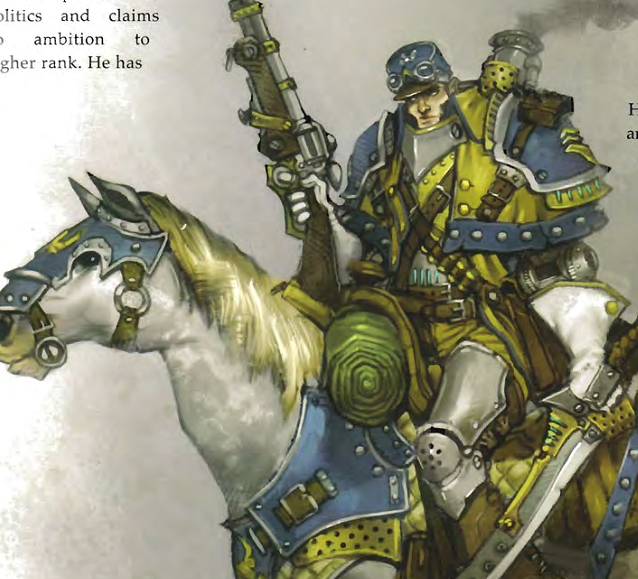
Captain Jeremiah Kraye of the Cygnaran Reconnaissance Service blends old and new combat styles into a doctrine of rapid assault, preferring to strike at the flank or attack reinfrocements. He is a master of mobility, and can push his 'jacks to amazing speed. He's from a long line of soldiers - his father Sheridan was a colonel, and his grandfather Nathan was one of Vinter III's finest generals. He graduated from the Stratgic Academy with highest honors and entered the cavalry just as the Scchared Invasions began, though he served with the border defenses rather than on the front line. His cavalry proved vital in maintaining defense while other forces were reassigned to fight Cryx, and he learned to make do with whatever he had on hand, finding ways to win against all odds. However, he damaged his career by resigning his commission in 589 after his uncle was arrested for treason and executed by VinteR IV, at the height of the Inquisition's power. He would not return to duty until after Leto took the throne, reinstated at the urging of Scout General Bolden Rebald in 595. He avenged his uncle by running many loyalists to ground, using his extensive experience on the border to help the CRS in its early days. He is an outspoken and intelligent man, with refined breeding that shows through his often grimy appearance. He enthusiastically debates history, tactics and strategy, but has no patience for politics and few ambitions. He has a unique bond with his warhorse, Malagant, who responds almost empathically to his will. Kraye needs no praise or accoldaes, just the chance to lead his 'jacks against Cygnar's foes. Officers who've fought with him claim he can find the best fighting ground anywhere on the border, which he roams tirelessly, needing only his horse, his warjacks and a crew of brave soldiers. His fimmick is mobility, and his feat allows him to keep his 'jacks upright and very mobile.
NExt time:
Forces of Warmachine: Cygnar
Original SA post Forces of Warmachine: Cygnar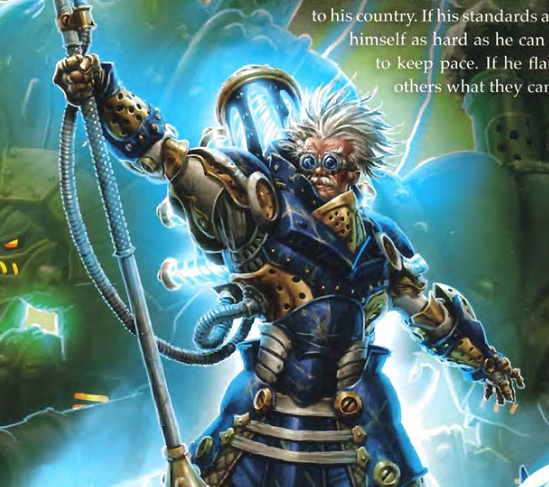
Commander Adept Nemo is one of the most famous warcasters of Cygnar, having served for a very long time. Despite his age, he's welcome on the battlefield, and even one he's gone his legacy will last forever. He was raised in a military household, listening to the stories of his grandfather, and two of his brothers died in the Thornwood War. Nemo showed a talent for magic and was enrolled in the Strategic Academy from a young age, excelling in science as well as magic and military history. He's endured a lot since then, losing a brother who served under him, which he blames himself for. He has focused, since then, entirely on his military work, and his wife and daughter left him, with his wife dying months later of rip lung. Nemo is still haunted by that. His daughter was sent back to his care, but he arranged for her to be raised by his family, and they have been estranged ever since. Nemo became bitter under Vinter the Elder, preferring to avoid atrocity and refusing promotion in order to focus on weapons research. It was during the Scharde Invasions that he got the reputation of being one of the most brilliant men in the Army, and a few years later, he helped Leto the Younger in the Lion's Coup. Since then, he's taken to the field again, training several young warcasters. In combat, he relies largely on his magical skill, and his ability to use battle magic and warjacks is legendary. His armor crackles with electrical power. He is often misunderstood by his fellows as harsh, arrogant and socially unrefined, though an accentric genius. In truth, he's spent all his life giving everything to his country, and his standards are so high because he demands so much from himself and expects others to keep pace. If he flaunts his power, it is only to show others what they can aspire to. His gimmick is lightning and disruption, with his feat allowing him to set off a huge electrical storm against enemy 'jacks and beasts.
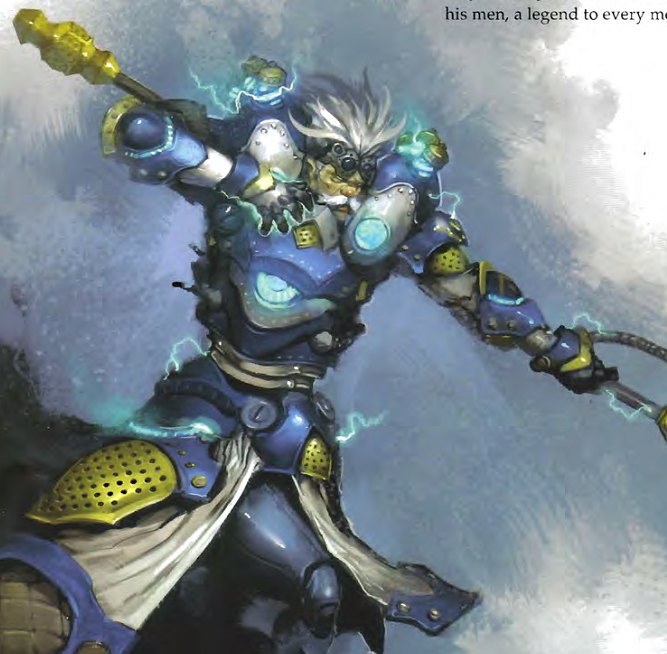
General Adept Nemo is the Epic version of Nemo. In peacetime, promotion to general is usually a prelude to retirement, a chance to quit the field iwth honor. Nemo choose to defy this tradition, fighting on the front for as long as he can life a weapon and command a warjack. Despite his age, he remains vigorous, and no one can match his deep understanding of warjacks and voltaic technology. His plans are decades ahead of those made by his peers, innovating both cortexes and weapons. The most brilliant minds of other nations struggle to understand his simplest designs. Even with more time spent at war, he finds time to develop new projects, like Cygnar's recent telegraph lines. Many of his tactics evolved in the period when he led part of the Third Army against Cryx under Vinter IV, learning to face an elusive foe that could be anywhere. These served well during the Lion's Coup, but recent action against Khador has had him rethinking his methods. Even after injury at the Battle of the Temple of Garrodh, he returned to help defend Northguard, and without him, it would have fallen months sooner. When Supreme Kommandant Irusk finally took it, he saved countless lives in one of the greatest rearguard actions in history. Now, Nemo sees civilians in the line of fire and is ready to use every trick he's ever had to make Khador pay dearly for every inch of Cygnaran soil. His gimmick remains lightning, but focused more on buffs than before. His feat allows him to energize his warjacks.
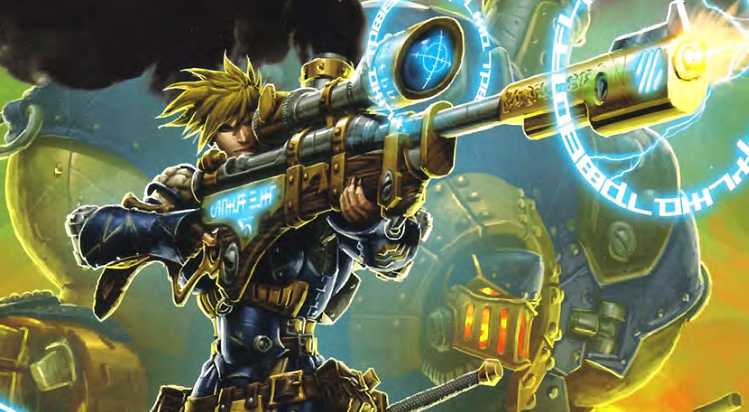
Captain Kara Sloane is a one-woman rifle brigade. She links her warjacks to her rifle trigger, performing simultaneous barrages of immense accuracy and power. She's focused all her skills on annihilation, armed with a custom magelock rifle. She advanced quickly in the Militant Order of the Arcane Tempest, with her potential realized early. She is not a duelist but a soldier, and warjacks are just another weapon for her. After graduation near the top of her class, she was placed in service under Markus "Siege" Brisbane, the first trainee he'd ever seen as a genuine comrade. He was impressed by her professional and methodical approach, and she learned very quickly. Most of her experience was against Cryx on the Broken Coast, learning to destroy utterly because the undead could not be routed or demoralized. On top of patrols with the Third Army, hse also faced Khador and the Protectorate. Soon after her promotion to captain, she was given Spitfire, her custom rifle, one of the best ever made. It uses immense rounds able to tear open warjack armor, reinforced to withstand the magical power of her shots. Despite her success, she's not very popular with her troops. She holds herself apart from them and has a reputation for being chilly even with officers. To some extent, this is overcompensation for her guilt at breaking Cygnar's military code - she's romantically involved with one of her junior officers, in secret. This is not uncommon but it is forbidden by the Army and Sloan believed in professional conduct. She is not proud of what she believes is a personal weakness, but can't abandon her relationship. As the ceasefire on the Dragon's Tongue grows more tense, she remains ready on the front. She crushes border skirmishes with overwhelming force. Her gimmick is sniping and enabling sniping, and her feat boosts her nearby allies' ranged attacks a lot.
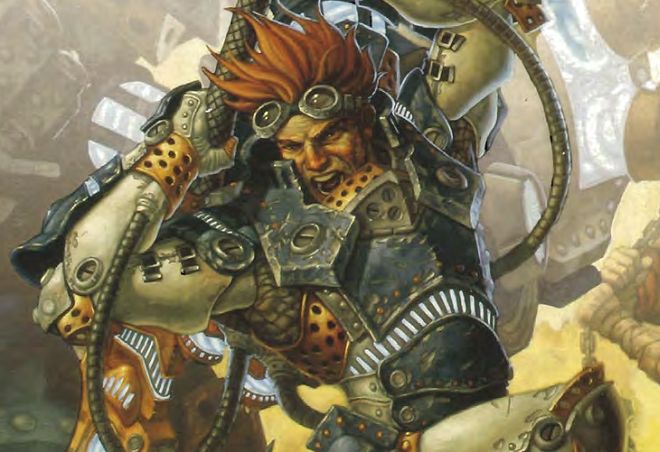
Lord Commander Stryker is the Epic Coleman Stryker. He is Leto's greatest ally, unfailingly brave and loyal. However, the carnage he saw during Llael's invasion scourged him of his youthful ideals, turning him into a pitiless warrior questioned even by other Cygnarans. He was given the right to war as he saw fit, assembling a handpicked force to create his Storm Division, the replacement for Second Army's 6th Divsion. He ordered the arrest of every Menite, man, woman or child, in eastern Cygnar, going so far as to pardon former Inquisitors and employ them to root out secret Menites. These civilians were held on Bloodstone Island, previously only used to imprison the worst criminals. He fought the Sul-Menites with a terrible hatred, breaching Sul and attacking the Great Temple of the Creator, then spending a year in street combat. During his fight against Deora, Protector of the Flame, she lit the temple on fire to save her own life. Stryker had to choose between chasing her and saving the innocent Menites around him. It was his last chance at redemption, and he saved the Menites, but nearly died in the collapse. He was unconscious for weeks, and by the time he could walk again, the tide had turned. The Menites were invading Caspia, led by Hierarch Garrick Voyle. Stryker took up arms to face him, initially seeking to end the battle peacefully, and even set the Menites he'd imprisoned free. Voyle was so bent on conquest he was willing to risk even his own unarmed civilians, and Stryker fought him to protect them. Voyle was killed, surprising even Stryker, and some have taken it as a sign of divine providence. Stryker is a changed man, now. He's still ruthless, but has learned to balance his violent impulses against the need to protect the innocent. His deeds have become legandary, and all foes fear the man who toppled the high priest of Menoth and emerged stronger for it. His gimmick is focused more on buffs and debuffs now, and his feat allows him to keep his units moving and attacking after his turn is over.

The Cygnaran Armory is the birthplace of all warjacks, and where the first colossals were made for the Rebellion. After the fall of the Orgoth, they continued to work on colossals, and after they were decommissioned, warjacks. They run day and night in the Smoke District of Caspia, but even the locals don't begrudge the industry that keeps them safe. Most of Cygnar's warjacks are made there, but others are made in Corvis, Mercir and Ceryl. They're more efficient than colossals were, but still take immense amounts of coal and water, so a smooth supply chain is crucial. To avoid forcing them to move long distances on their own power, they are hauled into location by trains, boats and wagons whenever possible. It takes time, but reserves their resources for combat. Whenever possible, older warjacks are repaired, as long as the cortex is intact. Despite their best efforts, however, many machines are destroyed and must be replaced each year. Each major garrison is kept supplied with warjacks of varying age, and it's the role of command and support staff to ensure the warcasters don't have to wrry about supplies, focusing purely on tactics. An entire network of support staff oversees warjack allocation, repair and resupply as invisibly as possible.
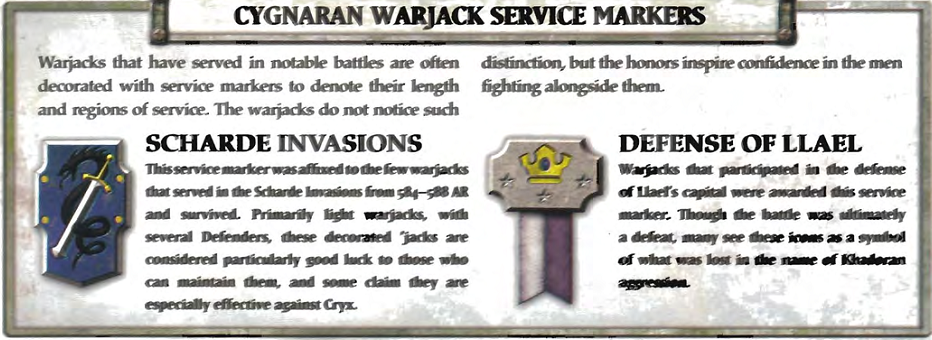
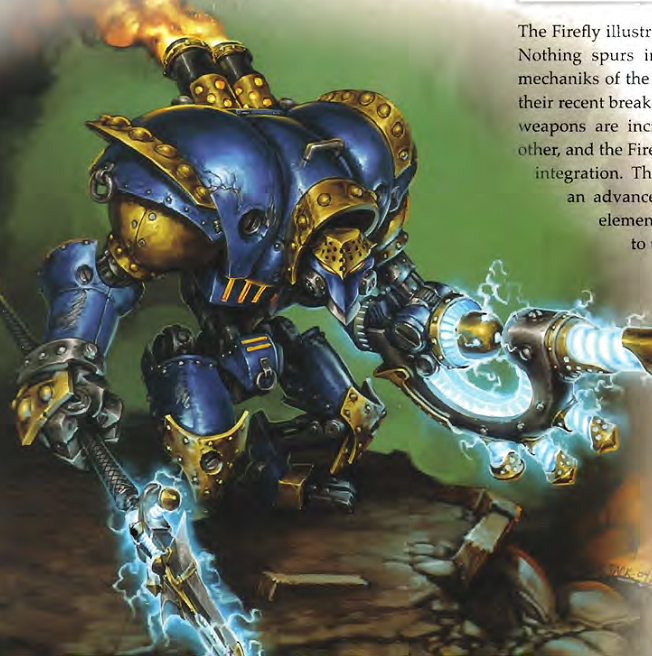
The Firefly is nearly nine feet tall and just over three tons. It uses electrical weaponry, designed to support the stormcallers and storm knights. It's one of the most advanced warjacks in the world, the result of years of research. It demonstrates the versatility of the Charger chassis it was based on, wielding weapons designed to assist the stormsmiths in their stormcalling. Its potent weapons are not reliant on warcasters, making it a favorite tool of 'jack marshals, particularly the Storm Blades.
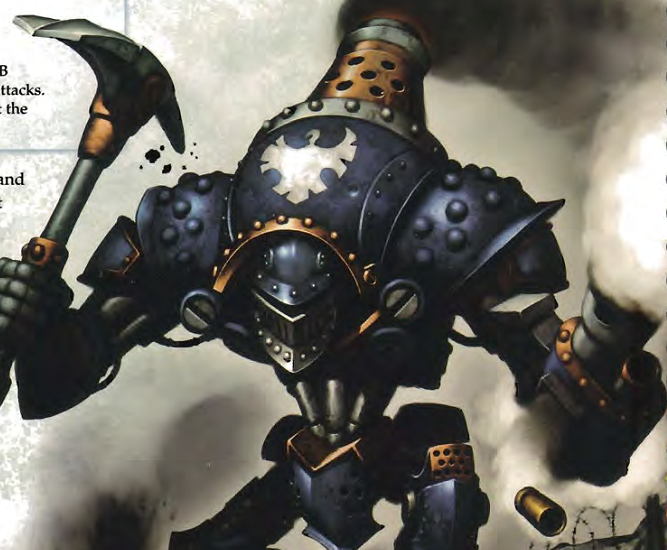
The Grenadier is almost eight and a half feet and just under 3 tons. It is designed to accompanby the trenchers, and works in devastating unison with them. It wields an immense mattock to dig makeshift emplacements, and its low profile makes for a hard target when it's in a pit surrounded by spikes. Its most potent weapon, however, is the grenade launcher it uses to fire shells across the field, able to fire bursts across multiple targets as long as the trenchers keep feeding grenades into the launcher.
NExt time: More 'jacks, warjacks!
Forces of Warmachine: Cygnar
Original SA post Forces of Warmachine: Cygnar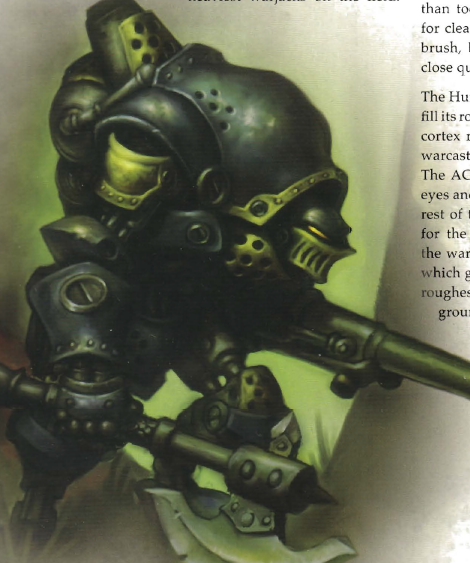
The Hunter is almost 8 and a half feet and nearly 3 tons. It has one job: kill warjacks. It is designed for maneuverability, crippling enemy jacks before they can react or engage. It is able to cross most terrain easily to find perfect sniping positions. It is armed with a high-velocity long arm cannon, which is extremely accurate and uses alchemically hardened armor-piercing ammunition, allowing it to disable even heavy 'jacks. Its axe is less of a weapon and more of a tool for clearing obstacles, but is a decent melee weapon if forced to it. The Hunter has an augmented cortex receiver, enabling it to operate and double the usual range from a warcaster in order to scout ahead and serve as eyes and ears. Its joints and gyroscopic components are also advanced, giving it plenty of mobility even in rough terrain, taking full advantage of both its cortex and cannon at range.
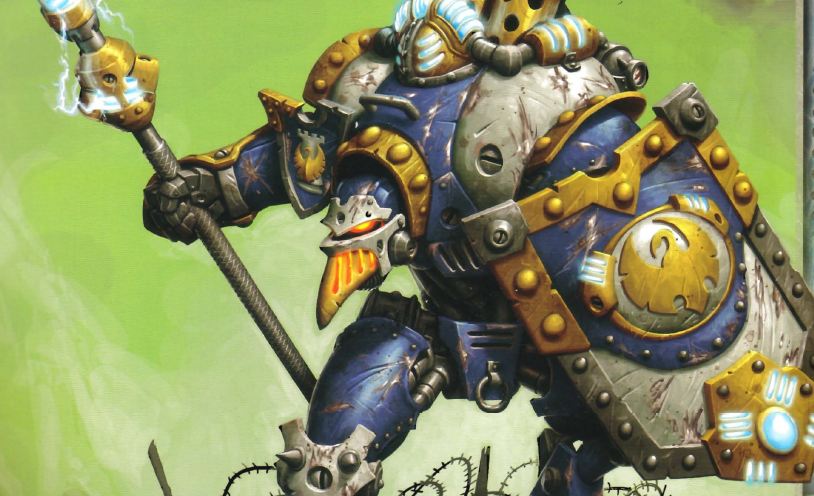
Thorn is a custom Lancer, just over 9 feet tall and just over 3 tons. Everyone admits there's something exceptional about its cortex, likely due to prolonged exposure to Major Haley's magical skills. The Strategic Academy's experts theorize that her influence has imprinted additional arcane connections in its machinery, burning unanticipated pathways in the cortex. It is the only 'jack Haley has used near continuously since her early years, and its transformation has been gradual. It's been nearly scrapped several times, but Haley feels a special connection to it and has made sure it was always salvaged and rebuilt, even from a cortex. She noticed, each time, a dramatic improvement in its capabilities, as it learned from its experiences. Thorn's most recent upgrades, at her request, include an experimental reaction drive using a high-end accumulator and reflexive trigger relay to transform magical power into movement, allowing short bursts of incredible speed. This lets the thing deliver Haley's spells wherever she needs them, then reposition against enemy fire. Haley also outfitted it with a disruptor spear, and since getting it the machine behaves with almost reckless aggression, as if taunting foes. Haley's troops believe that comes from her. However, its greatest capability is not technological, but due to Haley's close ties with the machine. Even the most intense close combat does not impede her ability to utilize its arc node, allowing it to channel spells when most machines can't. A number of mechaniks have tried to reproduce Thorn's abilities, but have been frustrated so far. Machines with less refined cortexes can't operate the reaction drive, and the overflowering arcane power often causes catastrophic failure of the arc node. Haley also refuses to allow people to take Thorn apart to study it, and the generals back her because of her importance. She won't let Thorn out of her force and into the hands of "curious gearheads" who would not appreciate it.
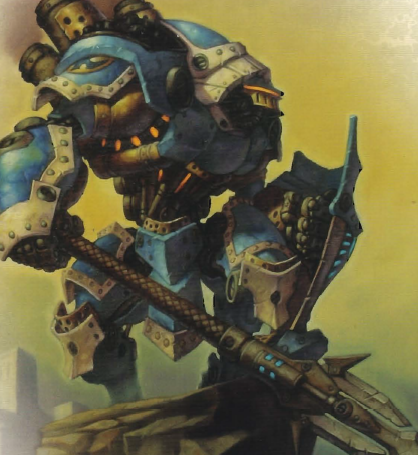
The Centurion , at over 12 and a half feet and 8 and a half tons, was designed to rival Khadoran 'jacks for size and power. The Caspian engineers took the heaviest frame they could find, stapled a ton of armor to it and then outfitted it with some really advanced mechanika. It is the largest and heaviest Cygnaran warjack, an immense iron behemoth that is slow but very durable, an excellent defensive tool. It is practically invulnerable to frontal assault, thanks to its augmented shield, which uses techno-arcane coils to generate a field of arcanomagnetic force that can stop a charging 'jack cold. Its piston spear can pierce almost any armor, designed with a wickedly sharp point backed with hydraulic power to tear through anything. Once activated, it hammers away relentlessly at anything nearby.
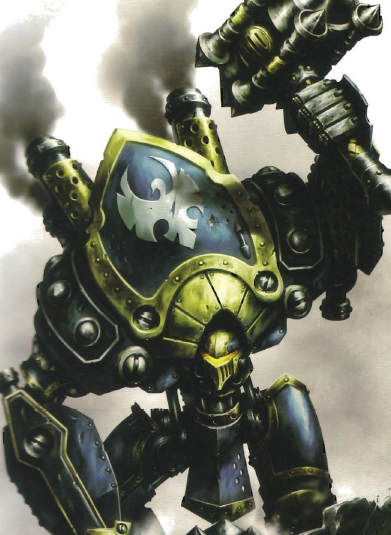
The Hammersmith is over 12 and a half feet tall and just under 9 tons, built using a Centurion frame repurposed for offense. It forgoes the advanced armaments in favor of two immense Forge Hammers, huge weapons meant to pound metal (and anything else) flat. These weapons can handle even the heaviest warjack, giving the Hammersmith more room to press the attack. Every blow hurls foes backwards as the Hammersmith presses on relentlessly, striking again and again.
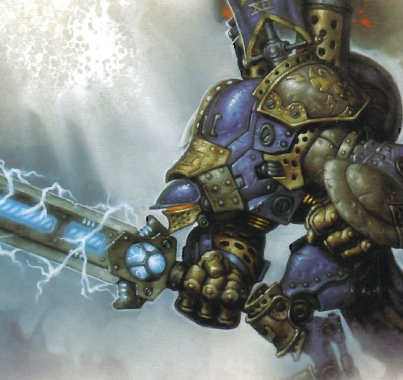
The Stormclad was developed after the Lion's Coup to accompany the Stormblades into battle. It's just over 12 feet (plus banner) and weighs 6 and a half tons. It is built on an Ironclad chassis, but armed with a galvanic generator blade of immense power. It is equipped with an accumulator that draws in the excess galvanic energies of the storm glaives, using them to power the generator blade so that it can cut through any armor at all like lightning through a tree.
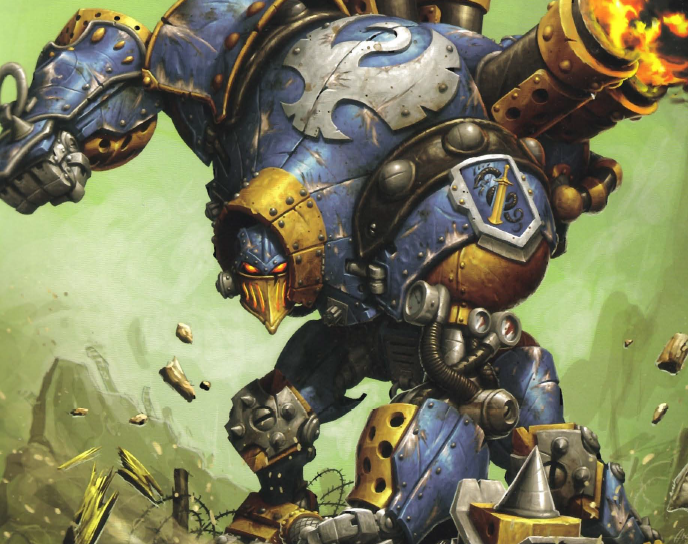
Ol' Rowdy is just over 12 feet, and almost 7 tons. It is Lord Commander Stryker's favorite warjack, wielding an immense quake hammer alongside his sword. It looks like any Ironclad, at first glance, but is no moreso than Coleman Stryker is just any soldier. It's served for fifty years now, one of the first generation Ironclads developed. Many 'jacks that year had a flaw in their cortexes that only emerged in the pressure of battle, and it wasn't until the Scharde Invasions that Ol' Rowdy's infamously bad temper came out, so eager to fight that it'd literally throw itself at the enemy. Most commanders think that the habit of charging headlong into battle is the worst a 'jack can develop, and they tend to get their cortexes wiped clean, but Rowdy's service record gave a reason to leave it be. Few 'jacks survived the Scharde Invasions, and each had valuable experience it'd be hard to replicate. Eventually, Rowdy was retired to training duty at the Strategic Academy. It served there for several years, until Coleman Stryker got it on his journeyman tour as a test of skill. His instructors figured he'd learn humility from the challenge, but he actually enjoyed it. As the years passed, Rowdy just got better and better, and Stryker has invested heavily in its upkeep and equipment, keeping it in top condition and squeezing as much performance as possible out of its systems. It has had custom armoring put on its arms and been given an improved steam engine to handle its weight without losing mobility. It has countless service markers from its battles over the last five decades, and it's saved Stryker's life many times, often by jumping into harm's way and refusing to fall over.
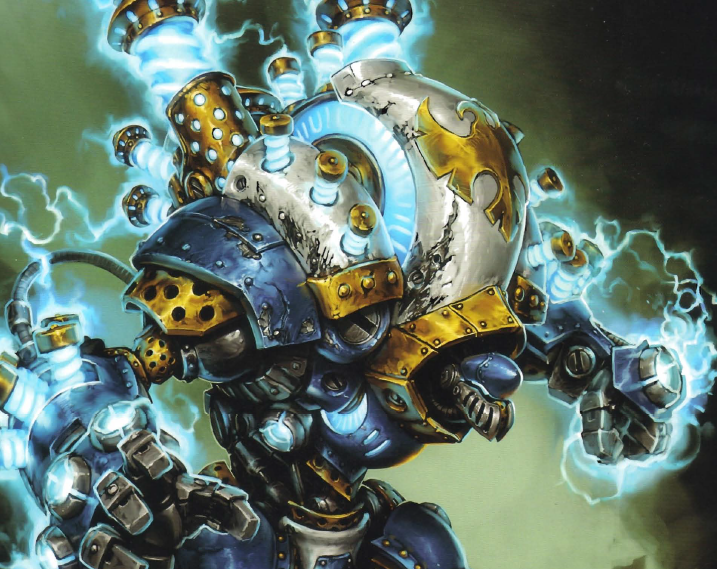
Thunderhead is arguably the most sophisticated warjack ever produced by humans, at fourteen feet tall and 12 and a half tons. It is both technologically advanced and a work of art, relying on technologies developed by Sebastian Nemo decades ahead of their time. It draws power entirely from the galvanic energy generated by its storm chamber, originally meant to hide the telltale signs of coal and water. The problem is, he never found a way to stop the corona of energy that surrounds it, with electricity earthing itself at every step. It is not subtle or quiet, but it really doesn't have to be. After several prototypes exploded, Nemo finally finished the plans in 604 AR, requiring each part to be machined to perfection. The design relies on several advances initially developed by the Cult of Cyriss, which Nemo reverse-engineered. Thousands of crowns worth of equipment were destroyed in its construction and two assistants badly burned, but Nemo kept at it until he knew he had a stable device that could generate enough power but remain cool enough to be a viable chassis. The result set a new standard in warjack design. Thunderhead is large even for a heavy 'jack, with huge lightning coils taking the place normally held by a smokestack. Its huge, graceful curves bulge with the energy within, and its joints and edges glow faintly blue. The two brass-capped coils tower five feet over the rest of the 'jack, continually firing off electrical arcs that are so potent it took Nemo six months to develop shielding to protect the thing's own cortex. All of its weapons are built to take advantage of the galvanic system at its heart, using enormous lightning coils to channel electricity from the storm chamber into devastating pulses that destroy anyone who comes near without proper insulation. They can alternatively be narrowed into directed blasts through a smaller array of coils in the fists. In melee, lightning flashes across the arms and hands, grounding in anything it punches and, occasionally, surging to fry enemy cortexes. Given the staggering cost and complexity, Cygnar's only got the one of it, kept solely for the most crucial battles.
Next time: Soldiers of Cygnar.
Forces of Warmachine: Cygnar
Original SA post Forces of Warmachine: CygnarCygnaran rank structures have remained largely unchanged for two centuries, barring minor adjustments to specific branches. It's a large and complex organization, including both enlisted soldiers and commissioned officers, and fraternization between the two is heavily discouraged. Most recruits become long gunners, and those with endurance and mental fortitude are selected for more difficult trencher training. Those with unusual aptitudes may be sent for specialist training. Officers, on the other hand, have to go through the Strategic Academy. Traditionally, they draw only from the wealthiest families, with preference given to children of former officers. The knightly orders prefer young people of noble birth, in some cases training them for the role from early childhood. Middle-class children seeking military careers tend to end up as lieutenants.
Over the last 20 years, the Army has tried to expand its officer pool by offering commissions to those proven in battle, and in wartime that's accelerated by officers dying in battle. It's not uncommon for a veteran sergeant to be promoted to lieutenant or captain. Enlisted personnel promoted to officer status are technically required to attend the Strategic Academy, but that's often postponed indefinitely, and very few trencher enlistees-turned-officer ever attend the Academy. During training, a soldier is called a recruit, and becomes a private at the end. After a year, they become a private first class, but the distinction is mostly in minor payscale increase. After proving competence, they can be promoted to corporal from there. Corporals are the first non-commissioned officer that can lead other soldiers, directing small units of privates and often supervising fire teams or coordinating other tasks.
Above the corporal is the sergeant, who leads squads of multiple fire teams and units. There are many grades of sergeant, and it's as high as most soldiers ever get, even career soldiers. Sergeants must serve at least two terms of five years - if you accept at the end of your first term, you are required to reenlist. Most are career soldiers. Above sergeant are additional grades - sergeant first class, staff sergeant (for supply teams), senior sergeant, training sergeant, swift sergeant (a CRS rank) and master sergeant, a rare rank requiring 20 years of service. Master sergeants tend to be legends in the field and have often refused officer commission several times.
Officers in training are cadets, graduating as lieutenants. Promotion above that is based on performance and available positions. Some branches have grades like lieutenant first class or senior lieutenant to allow for field promotions while captain ranks are filled. Their role varies considerably by branch, and in larger infantry companies, lieutenants can lead entire platoons, while this is not the case among, say, the gun mages. Among general infantry, captains lead companies, majors lead battalions, colonels lead regiments, commanders lead brigades and generals lead army divisions. Lords general command three of the four armies, and the warmaster general provides a single voice of authority over everyone...barring unique ranks, like Coleman Stryker as lord commander, who answers solely to the king.
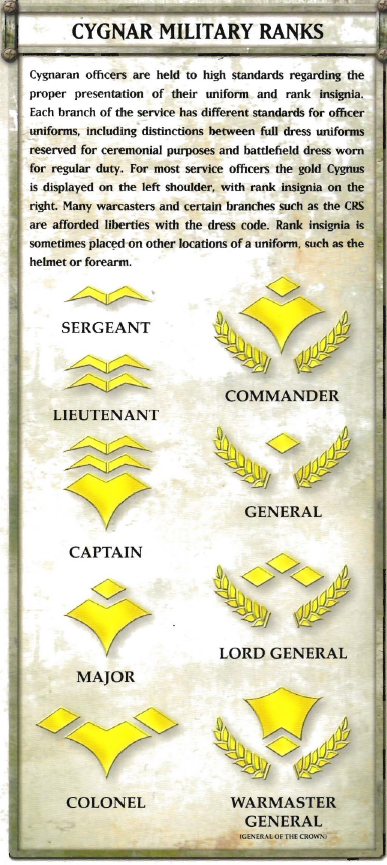
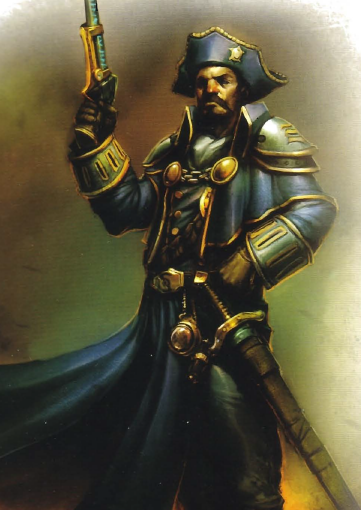
An Arcane Tempest Gun Mage Officer commands groups in the Militant Order of the Arcane Tempest. They rarely rise far in the ranks, and are expected to fight as long as they're able to. Typically, only old age or crippling wounds end their careers, after which they become colonels and serve as instructors for the most part. The most talented young lieutenants and captains are chosen to lead gun mage teams, often under direct command of a warcaster, and these veteran teams often get excellent warjack support. Research has shown that experienced gun mages can prepare warjack ammo to transmit arcane energy with the same techniques as their rune bullets, and the Arcane Tempest has trained several of their officers for that. Since it's not made from the same alloy as magelocks, firing rune-carved ammo does damage warjack weapons, but a single battle usually won't render them ineffective, and it can be the difference between victory and defeat.
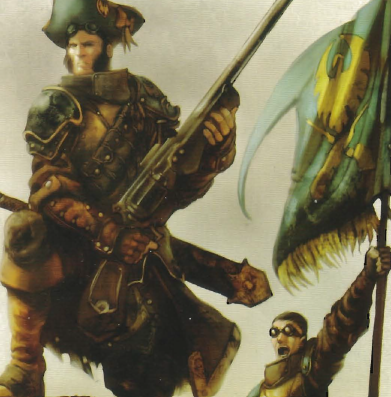
The Long Gunner Infantry Officer and Standard bring confidence to their squads. They are respected and, largely, veteran soldiers promoted to command in the field, typically lieutenants. They lead the long gun salvos by shouting at the top of their lungs to be heard over the gunfire. The standard bearers are courageous enlisted men armed with a sword and banner rather than a gun, keeping morale up with battle cries. If they fall, someone else will surely take up the banner.
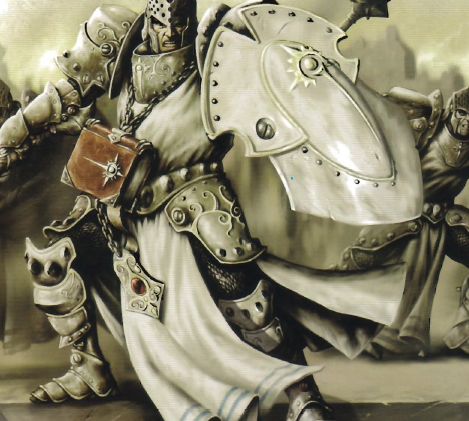
Precursor Knights fight at the forefront of the worst battles, standing between humanity and unholy terror. They value peace, but protect it with bloodshed. They follow a strict code of conduct, laid down by the warrior-philosopher Morrow and his martial ascendants. They believe that war does not excuse depravity, and victory does not excuse immorality. They ensure proper burial of the dead, caring for enemy and ally alike in that, and will lay down their lives gladly to protect the innocent or bring peace closer. While Morrow is worshipped across Immoren, the Precursors are a distinctly Cygnaran knightly order, originally sanctified in Caspia's Archcourt Cathedral. Now, they occupy a number of remote fortress-monasteries, watching the coastline to help defend against Cryx. They are protected against magic by the blessings of Ascendants Katrena, Solovin and Markus, serving as a rare beacon of hope. They will never work alongside Thamarite or undead units in any circumstances.
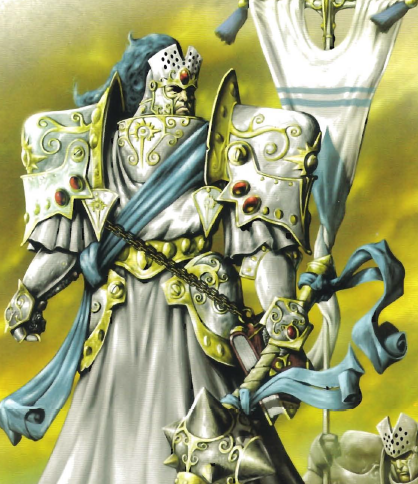
The Precursor Knight Officer and Standard are part priest, part knight, leaders of their order who fight terrible foes in the name of their patron, the Ascendant Katrena. They are the famous Morrown battle chaplains, warrior-priests who serve the primarch and preach the word of Morrow. They have sworn their lives to preserve the bodies and souls of everyone against Cryx, to protect the weak and to drive the wicked from Caen. Any who think Morrowns meek have never met them as they fight an honorable war. They are not afraid even of facing other Morrowans, and their blows are charged with holy might.
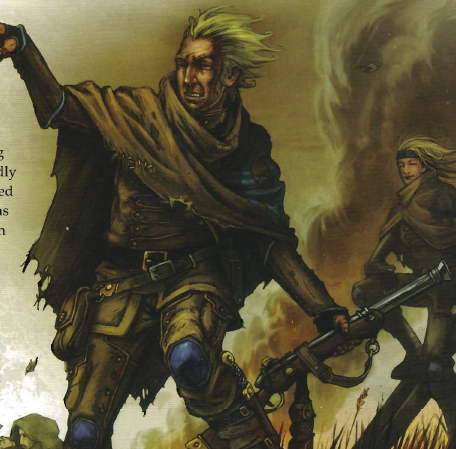
The Rangers are border sentinels, armed only with rifles, cloaks and survival kits. Many have died in the Thornwood, Marches and the Broken Coast to keep Cygnar safe as scouts for the Army. They are the toughest and brightest the army's got, trained by the Cygnaran Reconnaissance Service in survival, stealth and secret communications. They can disappear on deployment for months if required, moving through underbrush faster than most people can run on clear ground. They are ideal guides in any terrain, escorting entire offensives if needed. They are trained to blend with their surroundings to hide even from snipers, carrying a wide array of signaling devices and maps at all times, updating and revising as needed. They can identify distances with precision and signal enemy positions to their allies. Whether working as covert strike teams, guides or observors, they are useful and versatile, and the Scout General recruits more at a ready pace.
NExt time: Storm Knights
Forces of Warmachine: Cygnar
Original SA post Forces of Warmachine: Cygnar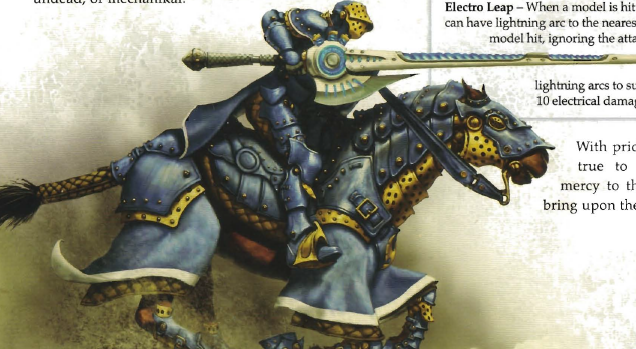
The Storm Lances are mounted knights armed with powerful electro lances, which constantly arc and fire galvanic bolts. They fearlessly charge any foe, crushing them beneath the horse's hooves and impaling them on the voltaic weapon. The lance can fire lightning at range, as well. The Storm Lances are proud of both their effectiveness and their mission: the protection of Cygnar against any foe, with the might of a storm.
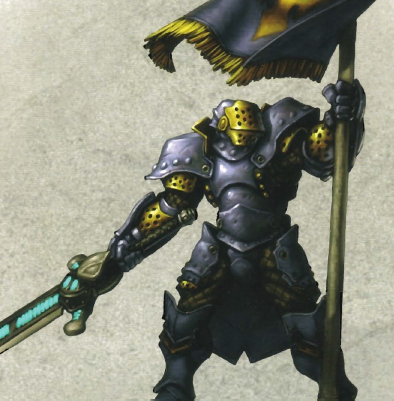
A Stormblade Officer and Standard is a sure sign of facing the mightiest storm knights. The knight lieutenants wield some of the most potent mechanika in Immoren, and the company banner is capped with a tempest generator, causing the atmosphere around to turn into a localized thunderstorm. It also interacts with the storm glaives, empowering their blasts a lot. The knight lieutenants are brilliant battlefield commanders with years of training in Stormblade tactics. They are held to a higher code of conduct, embodying all the traditions of the Stormblades.
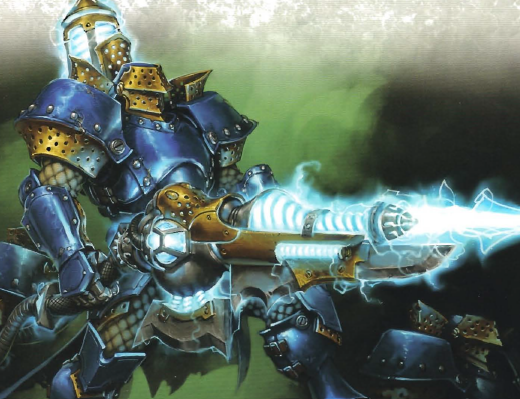
The Stormblade Infantry Storm Gunner is a specialized member of the Stormblades, meant to overcome their weaknesses. Stormblades are short range at best, and rather inaccurate, leaving them vulnerable to long-range threats. Cygnar devised the storm thrower to deal with that, and a unit of Stormblades becomes much deadlier when accompanied by a Storm Gunner armed with one. The storm thrower is a complex weapon meant to interact with the knights' standard equipment, channeling the attacks of the storm glaives towards their targets. A foe hit by a storm thrower is much easier to hit with storm glaives, you see.
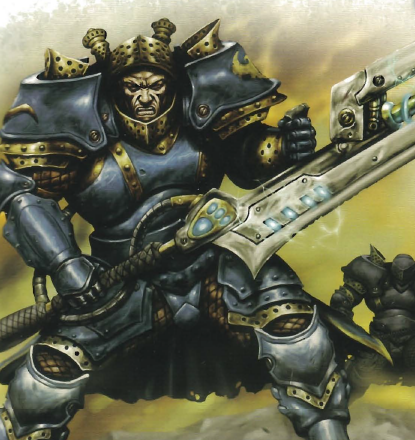
The Stormguard are elite knights, masters of the voltaic halberd, a mechanikal polearm meant to tear through armor while firing electrical torrents. Every halberd strike charges the sergeant's nexus generator, a weapon of great electrical power. At the right moment, the sergeant then unleashes a lightning strike that tears apart enemy formations. The Stormguard are sent to shore up flanks or hold strategic positions, training endlessly at Fort Falk when not in the field. They fight as a perfect unit, trusting each other with their lives. Like all storm knights, they are living symbols of Cygnaran technological superiority, and Leto trusts them to guard him with their lives. Their very presence inspires other soldiers and reminds them that Leto supports them.
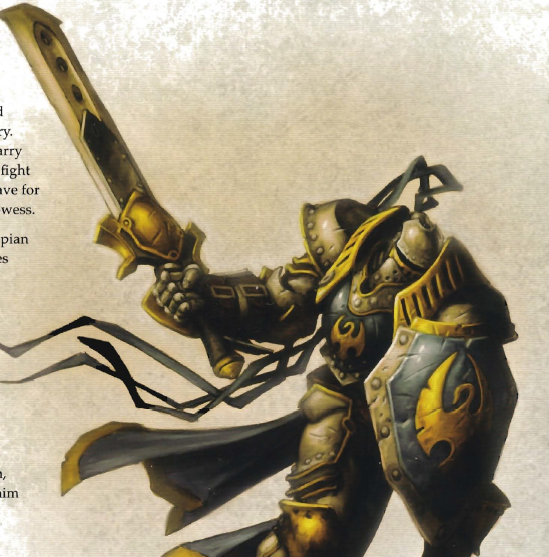
The Sword Knights are one of the oldest knightly orders in Immoren and the cornerstone of Cygnar's armies. Each knight inherits a legacy of service, faith and courage. Modern knightly orders prefer mechanika, but the Sword Knights use the same weapons they have for centuries, and are still effective. They are masters of the Caspian battle blade, practicing until the sword becomes an extension of the mind and body. On acceptance into the order, they receive two swords. The first is the blade they will use in battle, and the second is a ceremonial blade to be kept on their person at all times, maintained throughout their entire life. It must never be drawn in battle, and on a knight's death, it is buried with them, to keep them safe in Urcaen. The Sword Knights have served Cygnar for centuries against bandits and monsters, and since the invention of the warjack, they have adapted their tactics to fight alongside those weapons. They are expected to learn the inner workings of 'jacks, and as a result, they are able to inflict terrible damage to enemy warjacks by targeting their vulnerable points. They reach their greatest potential when accompanying warjacks into battle, as they are trained in supporting maneuvers with them, flanking the 'jacks across the field and taking out any foe that gets close.
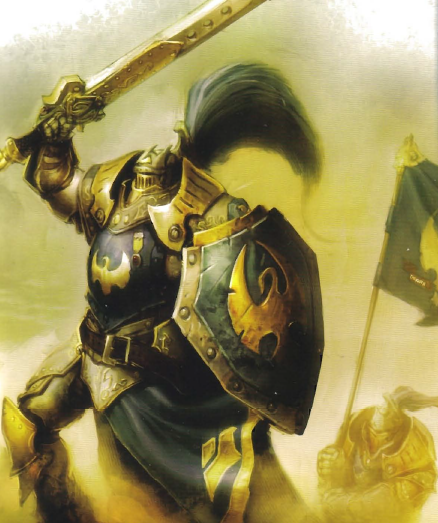
A Sword Knight Officer and Standard are a proud tradition that has yet to become obsolete. They fight without relying on mechanika, needing only a blade, a shield and amazing skill. No other Cygnaran knights are able to match their precision and power with a blade. Most Sword Knight companies serve with the heavy infantry, but there are several full Sword Knight battalions, led by majors with decades of service. These men are all nobles descended from the ruling families of the Royal Assembly, and years of experience have given them the knowledge to command both men and warjacks in complex and precise maneuvers.
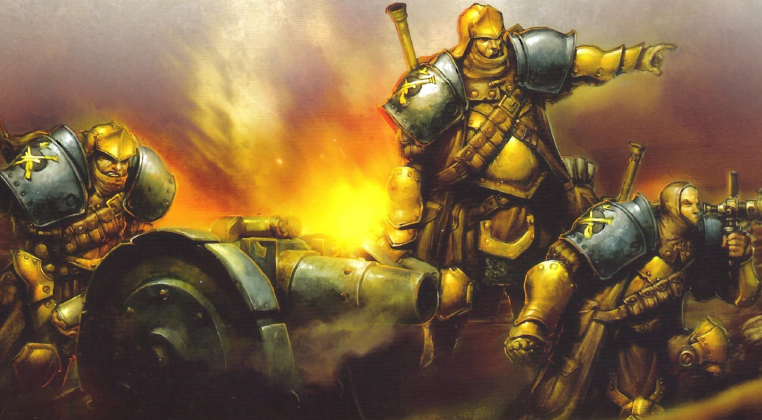
A Trencher Cannon Crew is capable of digging in hastily, putting up sandbags and getting ready to fire very quickly. They are professionals, chosen for steady nerves as much as good eyes, and are able to calmly check maps and orders before firing, even around explosions. They check windage, elevation and range before firing, always with perfect ease. They have a reputation among the Trenchers for precision and devastation, clearing the way for Trencher charges. Their short-barreled cannons may resemble naval ordnance, but they are very modern artillery with a conical shell and rifled barrel rather than smoothbore and balls. Their range is not equal to a Khadoran mortar's, but it's still impressive, and much more precise. The Khadorans have learned, grudgingly, to respect these cannons, particularly after finding them dug in and set up right at the front lines.
Next time: Trenchers.
Forces of Warmachine: Cygnar
Original SA post Forces of Warmachine: Cygnar
A Trencher Chain Gun Crew is armed with one of the most crucial Cygnaran weapons. They take up a position and open fire, forcing the enemy to take cover or die, as the fire of a chain gun can take down an entire unit in seconds. They fire so quickly that it's near impossible to tell one gunshot from another, though it is said that the Trenchers find the sound soothing - a constant reminder of their support. Gunners are grim even by Trencher "Gravedigger" standards. They know that even with the protection of the trenches and their weapons, the odds are not on their side. They carry immense amounts of ammo into battle and hope they live to fire it all.
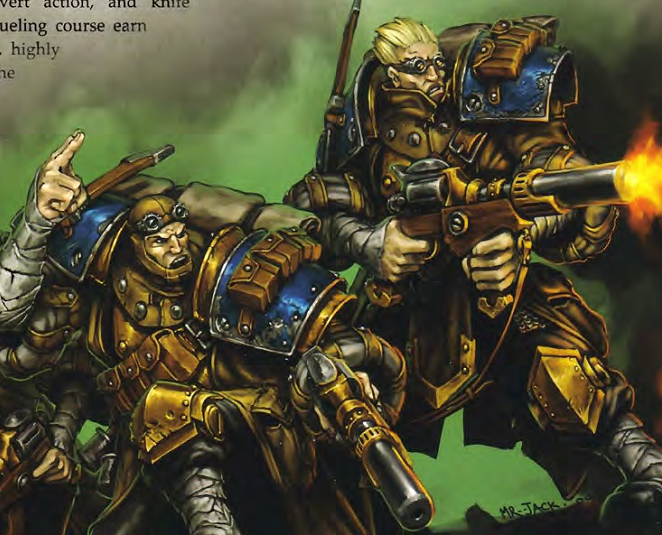
Trencher Commandos are the toughest soldiers in the toughest branch of the Cygnaran Army, the elites among the Trenchers. They get intense special training in infiltration, covert ops and knife fighting. Those who pass earn the right to call themselves commandos, and they are the first special forces to be sent into danger. They often operate behind enemy lines, appearing from nowhere to eliminate sentries or entire units. They can clear even fortifications with coordinated use of grenades, and more than one foxhole of Winter Guard has been devastated by lurking commandos. Once they cross the enemy lines, they wreak havoc among artillery batteries, advance posts and other critical positions, often ensuring the success of critical objectives or spending weeks in enemy territory disrupting logistics and morale. When they're done, they head back to the Trenchers for the next assault.
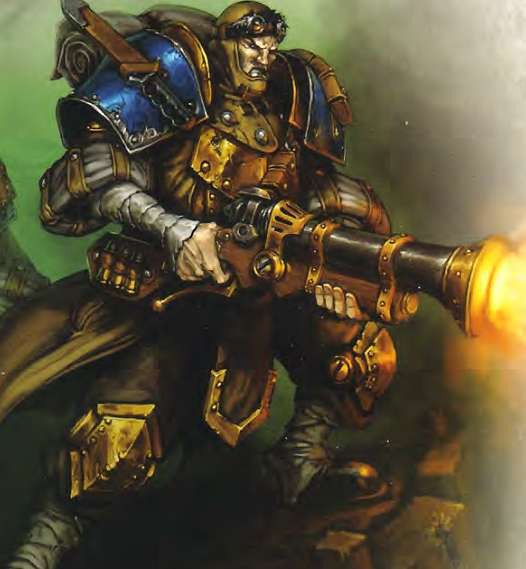
The Trencher Commando Scattergunners have the job of clearing advance positions with fortified enemy troops. Every commando learns to use a scattergun, but each platoon is only given a few of the things. They're big, cumbersome and very powerful. While the rest of the commandos overrun a position, they fire on concentrations of enemies, using lethal grapeshot in close quarters. A commando assault supported by grenades and scatterguns can mulch most enemy soldiers with ease.
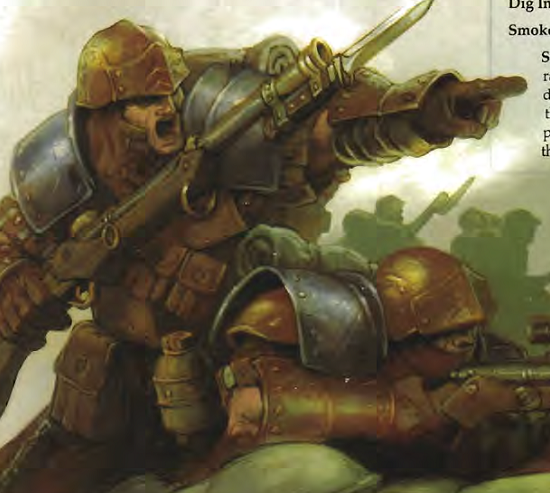
Trenchers don't have battle standards. They have the Trencher Infantry Officer and Sniper . The officers are generally trenchers that survive for a long time, rising to sergeant or even lieutenant, if they're a lifer with good leadership ability. In times of peace, they attend the STrategic Academy, but more often they end up training in no man's land. The snipers, on the other hand, are chosen for natural talent and coolness under fire, and they have amazing marksmanship, whittling away at the enemy before the squad closes to charge or use concentrated fire.
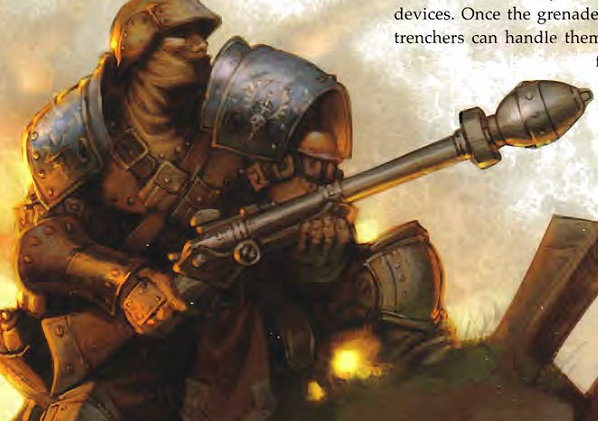
The Trencher Infantry Rifle Grenadiers have developed a new way to use explosive grenades. Traditionally, they are heavy, unwieldy and rely on an easily damaged gear-based timing system. Half the tiem, they blew early and tore their uses apart. Trenchers preferred smoke grenades and their rifles. Recent improvements at Point Bourne have found a solution, creating an extension attachment for the rifle to which greandes can be affixed. They use rapidly expanded gases from combustion to fire the grenade a long range. These grenades are smaller and sleeker, using fine-grade blasting powder and an impact trigger to provide an explosion of shrapnel. They are very efficient and quite powerful. Grenadiers are picked from Trenchers who enjoy demolition, and they get trained in the safe assembly and preparation of grenades. Once they're primed, regular trenchers can handle them easily enough, and the weapons have proven very useful on the northern front, where they're used to decimate packed formations of Winter Guard or armored targets.
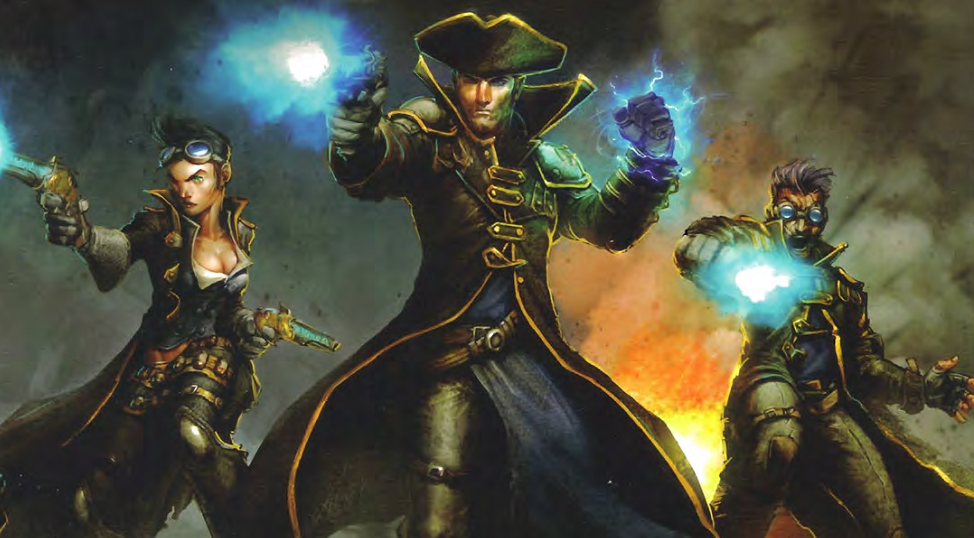
The Black 13th Gun Mage Strike Team is the elite strike force of the Militant Order of the Arcane Tempest. Their numbers have always varied and they are very tight-knit, always those with the highest skill using magelock pistols. Until recently, they were based out of Northguard, performing secret missions deep within Khador and Llael, including raids, rescues and assassinations. They've done missions that'd destroy lesser warriors, knowing they'll never get more recognition than a handshake and a quiet thank you from their bosses. After Merywyn fell in 605, they covered the Cygnaran withdrawl from Llael by harrying Khadoran forces and buying time. Since then, intense fighting near Northguard has dropped their number down to three members. Captain Dixon Lynch is the only survivor of the original Black 13th. He prefers not to speak about the unit's history, either due to secrecy or painful memories, and will not identify the ultimate source of their sometimes mysterious orders. Many at the Tempest Academy see Lynch asa legend, and he is perhaps the oldest gun mage still in the field. He was once a member of the Brothers of the Tempest, the fraternity that preceded the founding of the Militant Order. He is a good if cold leader, and his team is unshakably loyal. Sergeant Samuel Watts is even less friendly, infamous for being a loudmouth with biting wit, and he has few friends. Rumor is he's been a sergeant for over seven years for pissing off Lord General Olan Duggan, who refuses to see him promoted to officer status. Those who know his reputation avoid his taunts and baiting, which he uses as an excuse to get into fights. You might think the polite and professional Lieutenant Darsey Ryan is the friendliest of the team, then. She joined the Black 13th just before Llael was invaded and is still a tough foe. She seems to attract challengers, and she's left dozens of pistoleers dead in her wake. Even Watts admits she once beat him in a duel. In battle, she dual wields pistols with no apparent weakening of her magical power. When the three fight together, they effortlessly watch each other's blind spots and combine their fire to take down any foe. For the Black 13th, even today, there can never be capture or surrender - jsut victory or death.
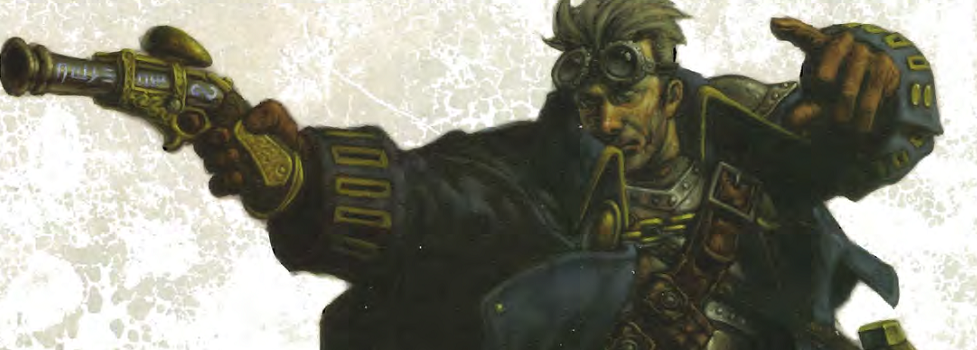
Becoming a Gun Mage Captain Adept is a long road. First, you must become a gun mage, which is a rare talent in the first place, and few have the skill for it. Then, you need to earn the rank of captain, which few gun mages do. Then you need the title adept, which is rarely granted. Gun mages of that power are rare, saved for the most crucial missions. They would be among the deadliest gunmen in Immoren even without magic, and each has the eyes of a hawk and great ability to spot movement. Their vision is so uncanny, in fact, that some say the bullets they fire must travel through Urcaen itself, reappearing in this world at the perfect spot to kill those who think they can hide. Their magic grants them even more power, and they command soldiers with unfaltering skill, firing on enemies as they wander the field. They use words of power to enhance the range and accuracy of their weapons, blasting apart any foe with bullets as powerful as cannon balls.
Next time: Stormsmiths
Forces of Warmachine: Cygnar
Original SA post Forces of Warmachine: Cygnar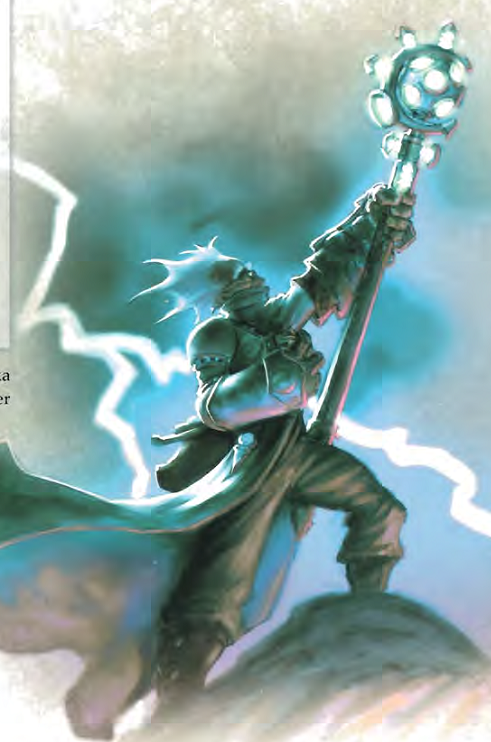
A Stormsmith Stormcaller is recruited for mechanikal aptitude and trained in the Strategic Academy as an arcanist specializing in electrical forces. Cygnar's enemiesh ave learned to fear the storms that accompany their armies into battle. Stormsiths are the reason for that, and the top of the Army's electrical forces. They wield mechanikal devices known as stormcallers, summoning lightning from empty air to assault their foes. Their precision strikes can take out warjacks, officers and the land itself. Though a single stormsmith is dangerous, they become even more deadly in groups, working in concert to light up an entire battlefield. They are specialists, ready to be called on at any time, and when sommoned to march they carry their stormcallers with pride.
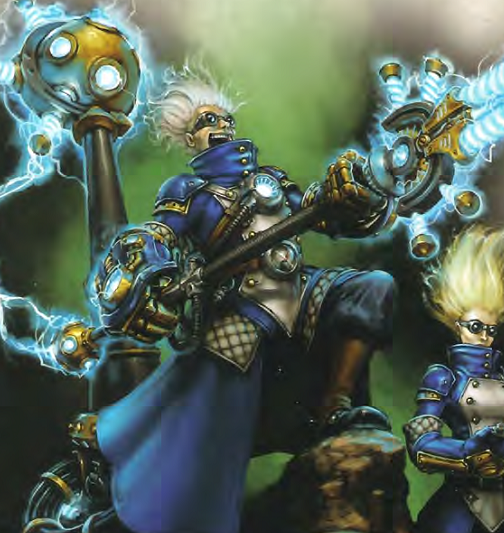
Stormsmith Storm Towers are one of the most potent weapons ever made using storm technology, developed as an outgrowth of Sebastian Nemo's telegraph systems. They were refined from the powerful generator towers made to send signals at long distance, made more portable and designed to manifest and control electrical energy. When activated, the tower emits a field that aggravates the local atmosphere, generating a thunderstorm instantly and calling down lightning in a circuit between tower and sky. The stormsmiths that operate the weapon aim via a mechanikal rod to direct the electricity, and precise timing is vital, as the atmosphere agitation has a very narrow window to be stopped before the wielder is electrocuted.
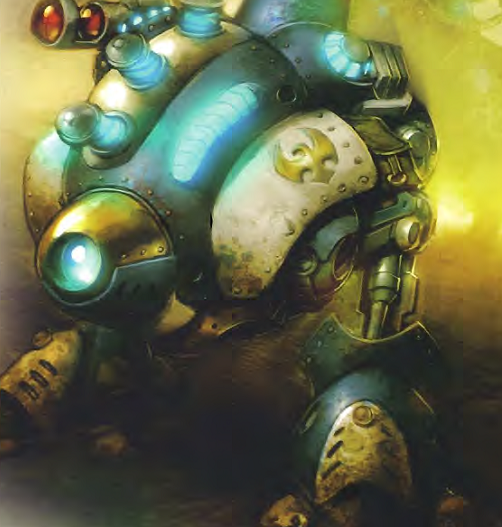
The Squire is the recent culmination of decades of work by the Strategic Academy, the Royal Cygnaran University and the Cygnaran Armory. It's a compact, steam-powered drone with an advanced arcane turbine similar to those found in warcaster armor. What it lacks is tools or weapons, as it was not made to labor or fight. Instead, it enhances the powers of the warcaster controlling it. The designers only reluctantly admit that the Cult of Cyriss was key to certain technologies used to produce the Squire in a secret agreement with King Leto. The main difficult was figuring out how to miniaturize immense amounts of sensitive and fragile equipment in an armored shell that'd hold up to battle. To augment the mental field warcasters use to control 'jacks, the Squire integrates sensitive relays that expand the field significantly, allowing for a much greater control range. Its other main features are an enhanced spell targeter and a refined accumulator that can store arcane energy for later. With a compact cortex and many expensive components, the Squire's costs are tremendous, and they remain very rare.
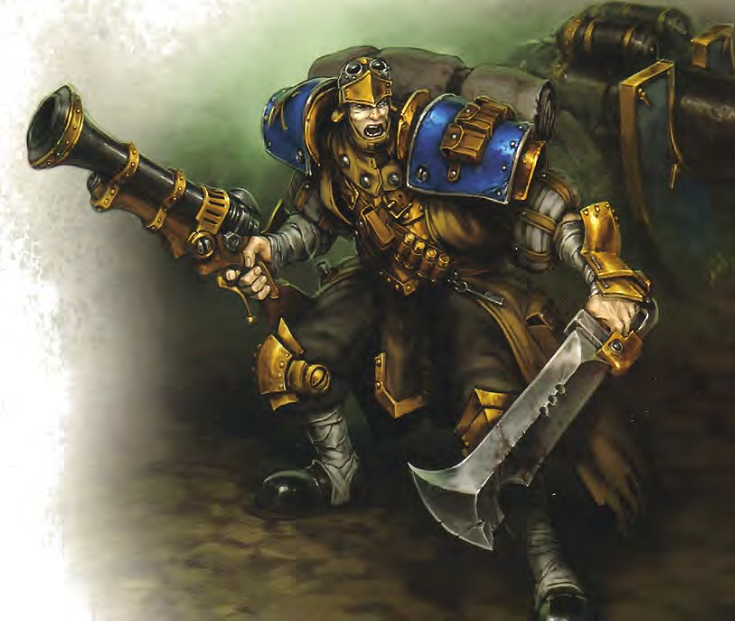
The Trencher Master Gunner has spent years gaining an expertise that can't be taught, making them the top artillerists in Cygnar. They are versed in every artillery skill, from use of defilades to barrage firing patterns. They are experts in the coordination of field gun batteries, turning them into precision weapons rather than support. They accompany trencher ordnance and warjacks to the front, digging in and coordinating emplacement of gun crews and artillery. Once in position, they gauge range with unnatural precision, allowing the artillery fire to be incredibly accurate. They can even execute their bombardments without risking nearby friendly forces.
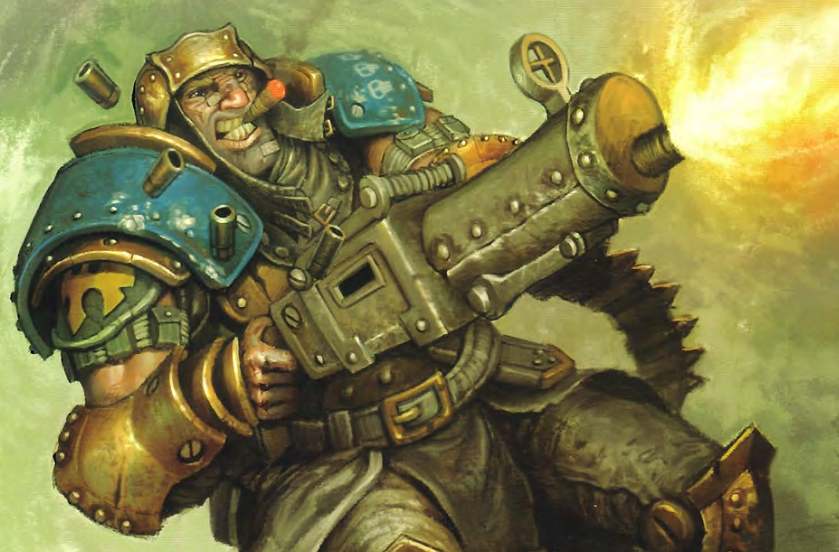
Captain Maxwell Finn is a legend, a veteran of countless battles. None of his Trenchers would ever believe it, but he was himself once young, growing up in the town of Point Bourne and joining the Trenchers as soon as he could. He quickly showed his strength and skill as a natural soldier, taking on anything thrown at him by his instructors and asking for more. He was a born lifer, reaching sergeant in record time, and he was assigned to Northguard and the 95th Trencher Company, known as the Northguard Gravediggers. He served there for almost a decade and reached the rank of master sergeant, distinguishing himself in key battles after the invasion of Llael. He remembers every man lost in those fights and can tell stories about each of them. In one incident during the withdrawal, several young soldiers got seperated from the main column, and Master Sergeant Finn personally went to find them, where he saw they were taking sniper fire from a pair of Khadoran Widowmaker. Finn stalked the snipers, taking them out with his trench knife, then led them back home five miles to their column, bleeding the entire way, but he wouldn't allow anyone to patch him up until they were safe. It's the event that made him more than a man to the Trenchers. The fighting in Northguard only built his reputation for being hte toughest sonuvabitch around. Many were killed, and he was knocked out and listed among the missing. When he came to, the front had moved south and he was behind enemy lines. He gathered up a ragged band of survivors, and the story of how they rejoined the Army at Point Bourne became another legend. His brash and cocksure attitude has never left Captain Finn, and in one battle he actually tore out an old fixed-emplacement mini-slugger, a heavy and cumbersome precursor to the chain gun, and charged forward with it, spraying bullets. No one's had the guts to tell him to put it back, and now it and his trusty knife are his favored weapons. Under his command, the 95th is the go-to company for defense, shoring up any position until reinforcements can arrive. Where Finn goes, the Trenchers will follow without question.
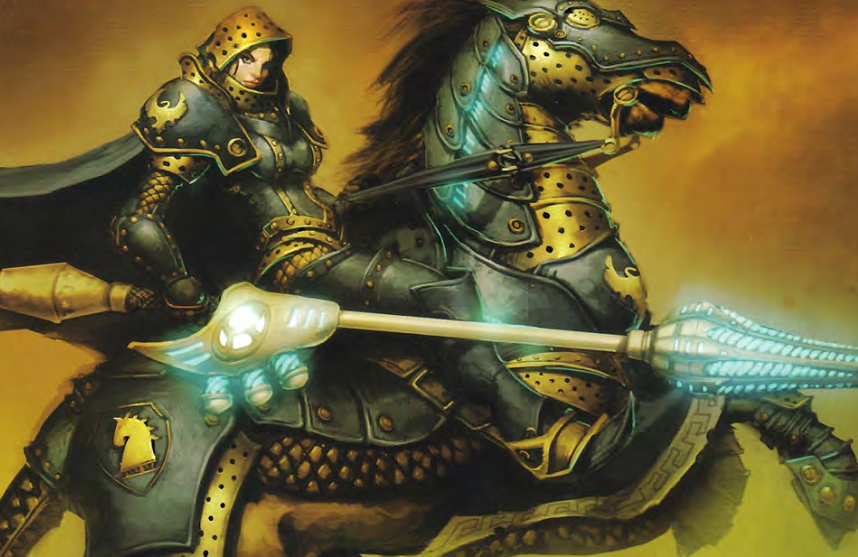
Major Katherine Laddermore is unfailingly loyal, a superlative cavalry officer who often volunteers for high risk assignments and extra patrols. She does it in open defiance of her father, Archduke Fergus Laddermore, the most powerful noble in Cygnar. She insists that others should not treat her differently for her family name, but it's too potent. Her father, the Lord of Durnkeep and ruler of the Southern Midlunds, controlled all of the Midlunds under Vinter IV, governing most of Cygnar's richest lands. Even under Leto, he controls the breadbasket of Cygnar and has plagued Leto since he took the throne. Fergus would lose his life if Leto ever learned that the archduke had secretly aided Asheth MAgnus and the skorne. It's all down to Katherine's strength of will that she opposed him, enlisted in the Army and qualified for the STorm Lances. She knows nothing of her father's treason but has discovered her family's reprehensible actions under Vinter IV despite their efforts to shield her from the truth. History remembers her grandfather for endorsing the Tempest Academy as Vinter's first Warmaster General, but Fergus helped to foster the Inquisition. Katherine is appalled at her father's actions and amazed that her family hasn't been banished yet, vowing to redeem their name by service. This only adds to her uncompromising zeal in battle, patrolling the eastern border with the 33rd Heavy Cavalry Battalion. She served in the invasion of Caspia, at one point fighting directly alongside King Leto, and she witnessed the death of Hierarch Voyle. Her battalion currently serves as part of Lord Commander Stryker's Storm Division. Laddermore's interest in storm technology has brought her in contact with Sebastian Nemo, and she's ovlunteered to help field test for him. Most recently, he gave her an experimental voltaic lance, armed with a powerful internal electro charger and voltaic accelerator, which translates the kinetic energy of her steed into raw electrical force. This power charges as the mount mvoes, arcing with power between her and her knights. Bolts of lightning fired from their lances strike deep into enemy ranks, opening paths through them. The weapon gets painfully hot after a few uses, even through her gauntlets, but Laddermore never allows her discomfort to keep her from fighting.
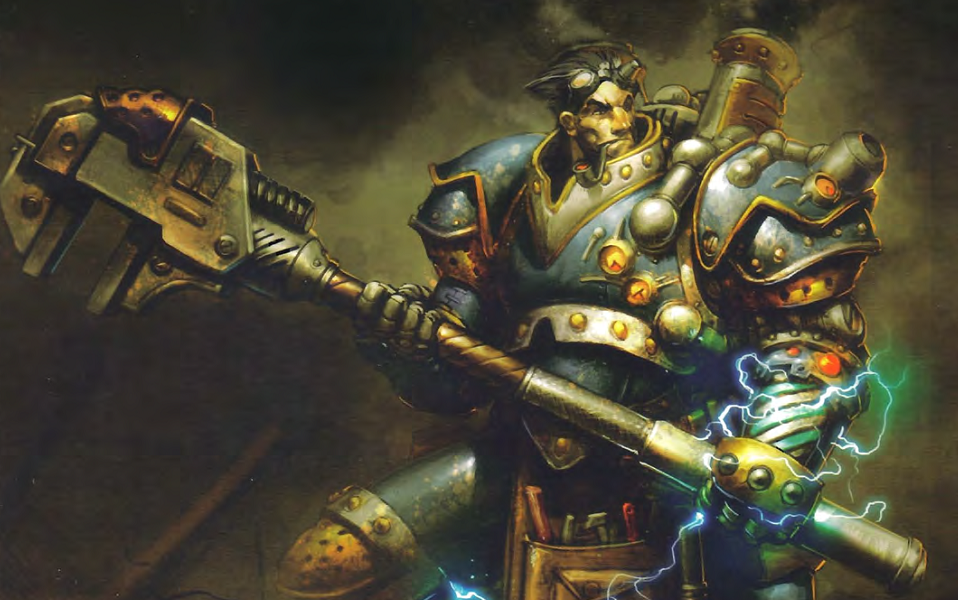
Captain Arlan Strangewayes is an arcane mechanik who treats every challenge as a puzzle that can be solved - arrogant superors, mangled turbines, attacking Khadoran warjacks, they're all puzzles with an ideal course of action that he often finds. He thinks battle and warjacks are easier than military politics, and boasts about 'solving' many of his hardest puzzles by hitting them with his giant wrench. He is a battlefield mechanik first and foremost, relishing danger. Some believe he has a death wish, but his recklessness actually comes from total faith in Cygnaran warjacks. When he's behind one, he is certain he won't be harmed, concentrating only on the 'jacks in his care and enhancing them with his potent magic to send them into a blur of motion or destructive power. When not on the battlefield, he is repairing his machines, restoring every bit to full functionality. Unlike many mechaniks, he prefers simple solutions and never rushes a job, as it risks breakdown in battle. His work rarely needs revisiting. He can ignore many dangers of battle due to his massive, customized steam armor. It's not so elaborate as Dominic Darius', but it grants a lot of protection, particularly against explosions or normal blows. He is very comfortable in it despite the hassels of keeping it fueled and maintained, and sometimes forget he's wearing it. He also relies on its boosted strength to manipulate warjack parts during field repairs. He's adapted voltaic technology to make an electromechanikal gauntlet that can fire electrical surges able to fry men or machines. He's a paragon of field expertise, and most mechaniks heed his advice. Those who've bene taught by him find he's an unforgiving taskmaster prone to demonstrating flaws in the most painful way possible. Few enjoy his lessons, but no one forgets them. EVen casually, he's gruff and hard to please, and he tends to stare at people talking to him as if he has more important things to do. One might think that he's close with Sebastian Nemo, but the two are uncomfortably aware of their differences. Nemo is a theoretician and innovator, while Strangewayes is a pragmatist focused on the here and now, and has even called the Thunderhead an "overly ocmplicated and impractical bit of business," which has not helped their relationship. Despite his gauntlet, Strangewayes favors old-fashioned steam power and older chassis, particularly the Ironclad and Defender. This has only added to his reputation as a curmudgeon, but he's the man everyone wants when a 'jacks needs to be patched up.
The End.
What's next? Khador, Cryx, the Protectorate of Menoth, Mercenaries, the Circle Orboros, Skorne, the Legion of Everblight or the Trollbloods?
Forces of Warmachine: Khador
Original SA post Forces of Warmachine: Khador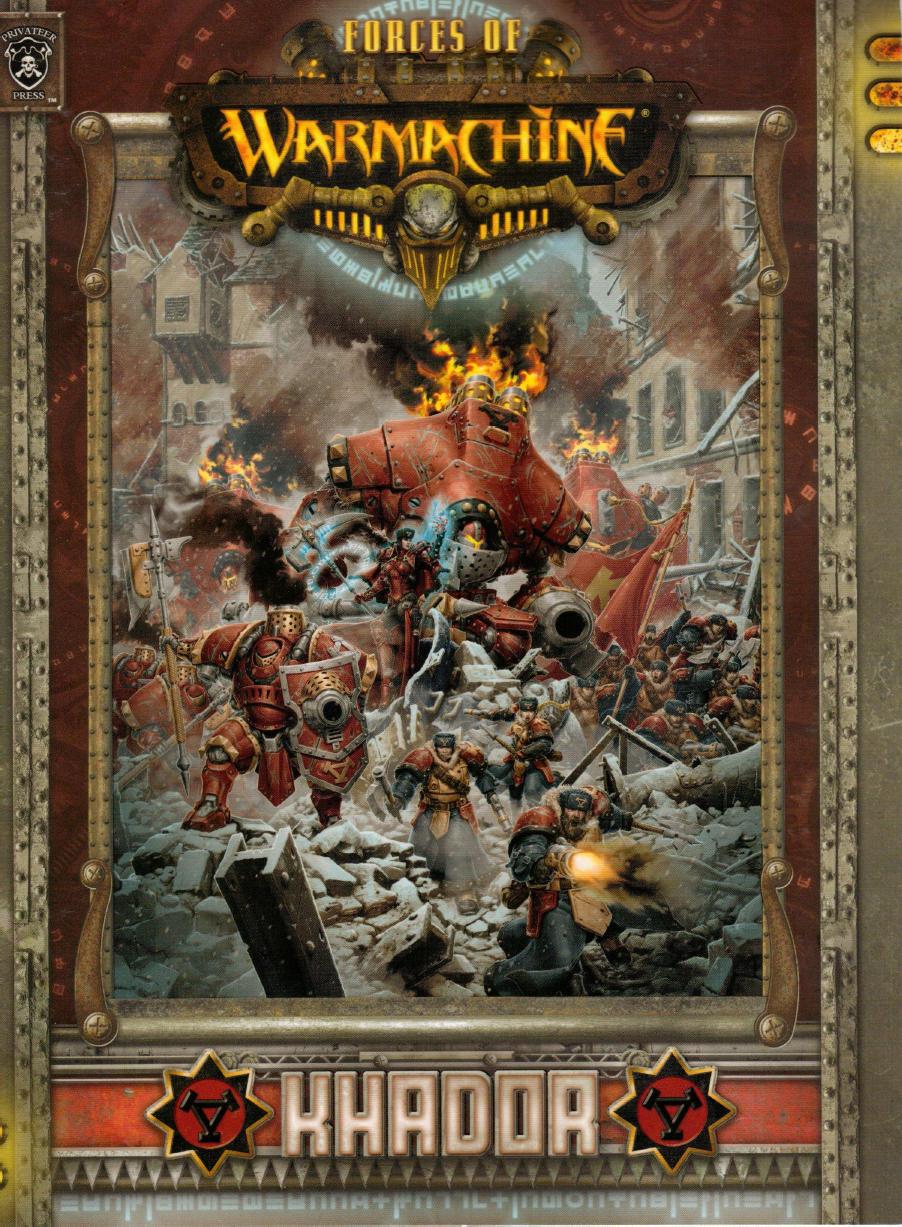
Khador is an unrelentingly harsh nation of snow and ice, and Khadorans are famous for their resolve in the face of hardship. Empress Ayn Vanar is trying to reclaim the glory of the old Khardic Empire, from which Khador descends. Their armies are as strong as their people, willing to outlast any foe in order to reclaim their ancient lands. Their forces are extremely tough, more resilient than any other. They do not have many warjack cortexes, so they outfit all of them in immense, heavily armored 'jacks of extreme power, supporting them with a resilient and potent infantry base.

The Khadoran Empire is the inheritor of an ancient legacy of war. They hold soldiers in high esteem, and every male citizen is required to put in at least some mandatory service. Many women also join up, and so Khador has a substantial percentage of its population ready to fight. They have had several victories in the last few years, occupying Llael and the Thornwood. Their military forces have been recently and heavily modernized by the development of long-range artillery and new warjacks, as well as armed with the military genius of leaders like Supreme Kommandant Gurvaldt Irusk. Llael has provided crucial supplies and technological developments, arming Khador with alchemical stockpiles of blasting powder and other weapons, along with Llael's entire industry base. This has also deprived Khador's ancient rival, Cygnar, of their greatest ally and inspired many Khadorans to believe that nothing can stop them. However, since then, advances have been slow and painfully won, but their fighting spirit remains undiminished.
The modernization of Khador's military took a number of ideological paradigm shifts, and arguably they surmounted the most barriers of any Immoren nation, given how deep their respect for the past and the Khards are. Ayn Vanar has brought a unity to Khador that has rarely been the case. Her almost universal support is a notable departure from most of Khador's rulers; until the Vanars, the military was stagnant, and the rulers lacked the vision and will to adapt to changes in warfare.
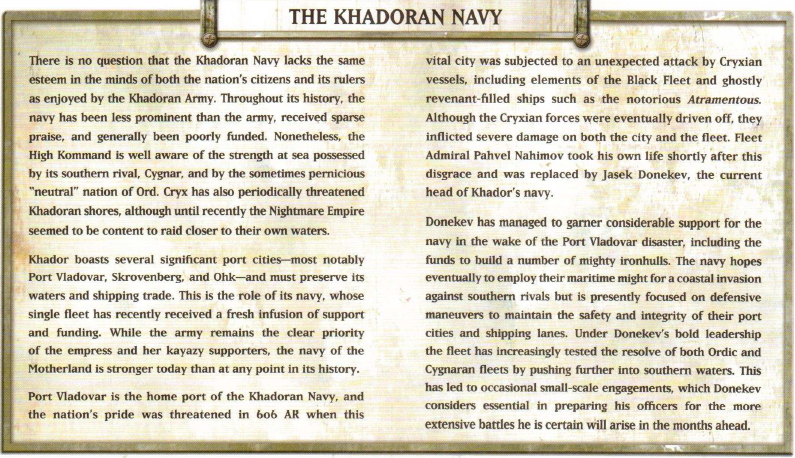
Under the Khardic Empire, the land was divided into volozkya, sovereign kingdoms bound to the Khardic conquerors as new territories. Their rulers became referred to as great princes, to demonstrate vassalage to the Khardic emperor. This tradition was renewed in Khador after the Corvis Treaties, with the princes as the highest nobles but subordinate to the king. After the Orgoth, everyone was eager to embrace Khardic symbols as a way to symbolically take their strength, but the details on Khardic governance were incomplete and chaotic. One area that was unclear was how the sovereigns verified and approved their bloodlines. The old laws said that the sovereign must descend from the ruling families of the volozkya, but were otherwise vague.
It was uncertain whether all of the 'royal' bloodlines were equally valid or if there were more strignent requirements to limit the lineage to fewer, perhaps even just one family. Some insisted only the original volozkya counted, not the later conquests of the Umbreans, Skirov and Kossites. It was also unclear if the great princes had any legal authority to endorse a coronation, which led to many feuds and a lot of chaos. The Umbrean Great Prince Vladin Tzepesci took power and became ruler of Khador in 209 AR, just seven years after the Corvis Treaties. His scholars claimed the Tzepesci line had the strongest ties to the Khardic emperors, who were "horselords born of the soil of the eastern plains" and preferred to rule from Old Korska rather than western Korsk. Others disputed this interpretation, emphasizing an era when the Tzepescis had rebelled and divided the empire in the Horselord Wars.
However, the opposition was unable to organize themselves against Vladin, and the most vocal of them were quietly assassinated. The Tzepesci line ruled for sixty years, passing the crown three times, but their rule remained full of strife, even under the later kings Geza and Levash Tzepesci. Levash was the greatest of them, ruling Khador with an iron fist from 236 to 272 AR. He was known as Levash the Tormentor, as he hoped to unite Khador by warring with the southern nations. His plan was to crush them quickly by using the Khadoran colossals. It worked in Ord and Llael, but faltered when Cygnar's colossals were brought to bear, and ultimately the war was lost rather expensively, leaving Khador near bankrupt. The harsh terms of the defeat not only forced Levash to dismantle the colossals, but also the foundries that built them, leaving Khador weak for decades after and ending the Tzepesci rule.
Levash had a reputation for tyrannical cruelty towards his vassals and the common people, as his wars required heavy taxation and mass conscription. Whatever his actual failings, they were heavily exaggerated by the great princes hoping to end the Tzepesci dynasty, and by the end of his reign, the Tzepescis were despised by all. Levash avoided many assassinations, dying of old age, which his enemies said was evidence of dark pacts. From then on, the Tzepesci bloodline has been linked to rumors of sorcery, dark cults and conspiracy, though its actual members were always romantic figures to the Umbreans of the east.
Dmitry Dopatevik was the one to oust the Tzepescis and the first man to claim the title of King of Khador. He took measures to institute more formal laws of monarchy to make it distinct from, if also connected to, the ancient Khards. Despite this, after his reign the great princes continued to squabble over the succession. Their family names changed over time, but they insisted they could trace their roots back to the Khardic emperors. It was not until centuries later, after the terrors of the necromancer-king Ivan Vladykin the Frenzied, that there was a stable dynasty. After defeating the necromancer in the coup of 459 AR, Mikhail Vanar accepted the crown, albeit relucantly, and the Vanars began to advance Khador, ruling ever since.
The actual effectiveness of the Vanars after Mikhail is a matter of some debate, but the popular perception is that they ushered in an era of prosperity and success, and the Vanar mystique is so pervasive that the difficulties of the early dynasty are now mostly forgotten, and the one interruption of their line's rule is seen as proof of their divine right. After all, it was under the Menite King Ruslan Vygor that Cygnar beat Khador in the First Thornwood War, reinforcing to many Khadorans that bad idea of a non-Vanar king. The most famous Vanar ruler was King Ivad, the People's King, who abolished serfdom in 546 AR. It was he who would popularize the idea that Khador would rise again as an empire, and his granddaughter, Ayn Vanar, is the one who has made that a reality, building on Ivad and later her regent Simonyev Blaustavya's efforts. Her conquest of Llael in 606 has only cemented her popularity after she crowned herself Empress of the Khadoran Empire.
Regardless of the Vanar popularity, however, the great princes retain quite a lot of power and influence. Their role in government has changed over time, but they still have many liberties and are treated as lesser royalty. Among their rights are the rights to gather warriors and equip them for battle. Many have voluntarily given up this privilege to concede their vassals to Ayn Vanar, and High Kommand encourages them to enlist as officers. Others have preserved their martial traditions as a matter of pride. Traditionally, the sovereign gives these nobles military honors and ranks befitting their status, and a number of great princes and their highest vassals serve as kommanders and kommandants in the Army, even if they rarely participate in military actions. Several hold their ranks in name only and allow handpicked subordinates to lead for them.
Despite the general peace brought by these measures, the empress is well aware that a sufficiently ambitious great prince could threaten Khadoran unity. Only they could make a claim for her throne, and the Tzepesci line in particular has long been a rival of the Vanars and distrusted. The Umbreans have repeatedly proven their loyalty to the Tzepesci princes before the ruler of Khador, and many believe the Tzepescis have never given up wanting the throne. Over the years, many have pushed both Regent Simonyev and Empress Ayn to strip the Tzepescis of authority and divide up their lands, but it's never been approved, as it could stir up popular support for the Tzepescis in the east, where they have a lot of influence and are seen as legends. It's been complicated in recent decades by the fact that Great Prince Vladimir Tzepesci has shown warcaster talent and devoted his life to fighting alongside the Army as well as training other warcasters. Despite all that, the question of the Tzepesci loyalty returned after the conquest of Llael, which united the lands once known as Umbrey. Several eastern great princes have allied under the Tzepesci banner, and renewed Umbrean sentiment is making Korsk uneasy.
Next time: Military History, Continued
Forces of Warmachine: Khador
Original SA post Forces of Warmachine: KhadorVladimir Tzepesci, for his part, has earned a different reputation among the military - they call him the Dark Champion and know that he has performed great acts of heroism, constantly risking his life for Khador. They have seen him suffer to save lives, and even his foes will not dare question Vladimir's courage, even if they question his longterm goals. Besides great princes like Vladimir, however, and the empress, there is another recent force in Khador: the kayazy, or wealthy commoner class, also called the merchant princes. They have a long history, but have seldom had such power until King Ivad abolished serfdom. The kayazy are any of sufficient wealth, both legitimate and criminal, and particularly in Korsk. Their funding has been essential to a number of royal endeavors and military projects, and that gives them power.
The kayazy resent noble influence in Khador and work to elevate themselves while reducing the power of those they see as relics of the past. This class tension has only increased with the strain of war, which has put a lot of burden on the kayazy, who intend to be repaid. Empress Ayn has proven adept at playing the nobles and kayazy off each other for her benefit, generally siding with the nobles over the katazy, as they might threaten her rule.
Khadoran pride has often stood in the way of progress, and after the Corvis Treaties, Khador's army was hardly unified. It was a bunch of autonomous forces from the Rebellion who, while each well trained, had little chain of command. Most were headed by nobles. Theoretically, they all had the same goals, but in many cases noblemen's needs dictated deployments and morale. The army was controlled by politics. Soldiers of this period were roughly divided into three groups. First, the conscripted masses, who were poorly trained and badly equipped but in huge number. Second were dedicated, professional soldiers. Third were the elites, largely heavy cavalry whose presence was long considered completely required for military success.
Even before the recent reforms, Khador never dismissed the power of their conscripts, which they insisted were superior to the standard soldiers of other nations. The Khards once boasted that even their most untrained farmer was equal to two southern soldiers, and the attitude remained after the Rebellion. However, the army acknowledged that the treasury could not afford to outfit most of these troops with high quality equipment, so they had to make do. They were meant to overwhelm by raw manpower, often with little direction or hope of survival.
The professional soldiers were infantry, often liegemen to nobles or conscripts who stayed on after their obligatory service ended. They were far less numerous, but a vital backbone to the army, able to be relied on in any circumstance. The oldest surviving example of these soldiers is the Iron Fangs, a group of pikemen organized from various pike traditions by King Iann Graznata in 398. He authorized them to see if men on foot could stand against warjacks using techniques meant to fight prey such as bears. Their success earned them recognition and numbers, until they became the army's most numerous and respected heavy infantry. It was from the professional soldiers that Khador's first legions were formed, and the term still has prestige attached. Legions were the first cohesive groups of similarly equipped soldiers with a royally appointed officer. Besides the Iron Fangs, the training and outfitting of these soldiers was highly varied, with many traditions from many regions. The quality of their gear depended on what patrons or nobles could afford, and it was not uncommon for these soldiers to retire from the army and become mercenaries instead, especially in border regions.
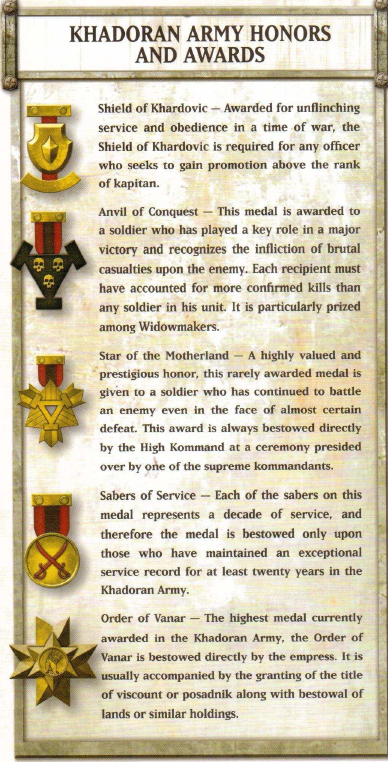
The most respected group was the cavalry, even after the widespread use of warjacks. Typically, they were aristocrats or sons of kayazy who could afford to outfit themselves and their horses. Their prestige was generally linked to the weight of their armor and quality of their weapons, with the ancient uhlan drakhuns as the pinnacle, lancers riding Karpathan horses bred for strength and stamina. Drakhuns were able to run roughshod over lesser soldiers with ease, and the tradition has been passed down to groups like the Iron Fang Uhlans and the Man-O-War Drakhuns. Khador has also found uses for light cavalry messengers and scouts, but they have never been as respected as the heavy cavalry.
The sovereign traditionally had great power to levy conscripts, but getting professional soldiers or cavalry took the cooperation of the great princes, lesser nobles or even the kayazy. This constrained the throne in war, requiring political pressure to ensure compliance. The treasury of the 200s and 300s could rarely support large armies save of conscripts, and so Khador could use few mercenaries, as well. Funds focused on the construction of colossals and, later, warjacks. This kept Khador's army behind the times and the throne relatively unstable until the Vanars. It was Mikhail Vanar who instituted the first major reforms, having been a soldier all his life. He saw the military as a top priority. While he was plagued by illness (and eventually died of it), he began the work that would lead to the modern Khadoran Army and established High Kommand to ensure it would not end with his death.
Under Mikhail, in 460 AR, the Winter Guard was established to give greater structure to the system of conscription and to provide a true standing army. Mikhail invested in guns for the Winter Guard, choosing short-range blunderbusses that were cheap but brutally efficient. It wasn't a popular decision due to the taxes he had to levy, but it let the army move away from its feudal roots. A clear rank hierarchy was established, eliminating regional or redundant ranks in favor of universal consistency. The first Juggernauts were developed, as were the first Destroyers, now the examples of Khadoran approaches to war. Mikhail would die before the first Destroyer rolled off the line, and the First Thornwood War would see these 'jacks refined and improved, but their basic function and appearance are Mikhail's legacy.
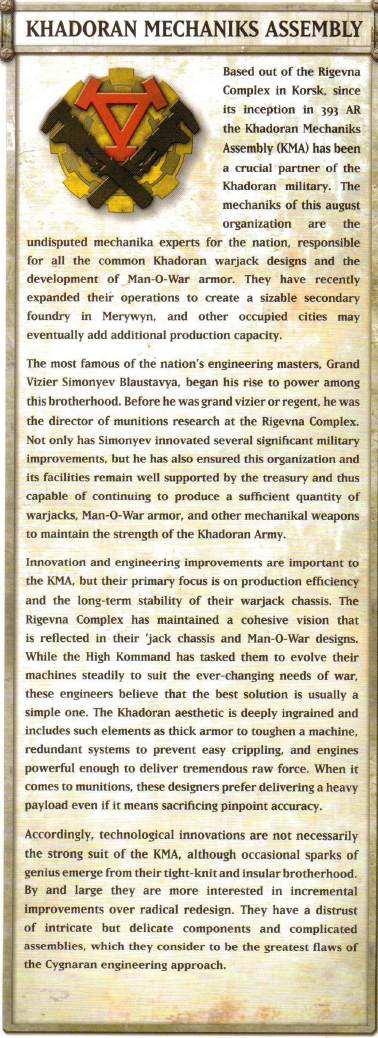
Some responsibility for the modernization of the army must also be given to Ruslan Vygor and the Thornwood War of 510-511, which led to a great reexamination of Khadoran tactics. The cost and deaths of the war led to improvements to the Juggernaut and Destroyer chassis, but also to a reevaluation of what was required to fight on an equal or superior footing to other armies. Analyses of this war were the focus of many military thinkers, including Rurik Zerkova, Gurvaldt Irusk and others that would develop the current tactics of High Kommand. While Vygor is blamed for the loss of the war, he is credited with the daring and brilliant strategy of using most of the heavy cavalry against Llael to lure in the Cygnaran army, nearly allowing the Khadoran forces to march through Thornwood undetected. However, the ruse was discovered in time to allow a forced march to intercede, and the battle that ensued challenged the Khadoran belief that no army could succeed without heavy cavalry. The nobles rejected the challenge, but it was a significant divider between old and new strategies.
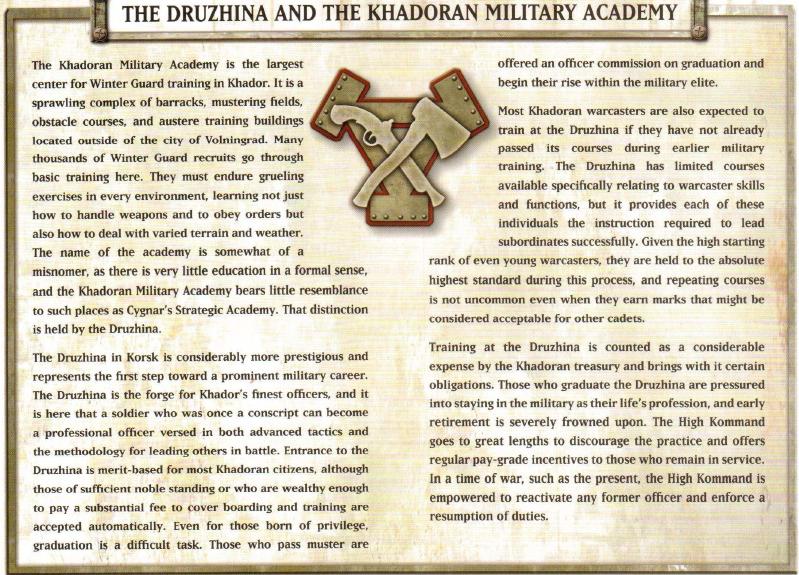
King Ivad Vanar of 545-572 AR carried forward the work of his predecessors, laying the foundation for Regent Simonyev Blaustavya and Empress Ayn Vanar. These three all placed great importance on engineering and mechanika, investing significantly in improving Khadoran 'jacks and the power and portability of field ordnance. While the first Man-O-War steam armor dates back to 474, Simonyev personally implemented substantial improvements in engineering and helped bring these mechanikally enhanced soldiers to their current position at the fore of Khador's forces. The diversification of the Man-O-Wars allowed Khador to overcome its numerical disadvantage in warjacks (caused by a scarcity of the materials required to make warjack cortexes). The Man-O-Wars are the perfect example of modern Khadoran military philosophy, reinforcing the importance of mechanikal innovation in the military.
The existence of High Kommand and its body of senior officers has provided some continuity and efficiency to the Army, but many believe the greatest innovations would never have arisen if not for one man: Supreme Kommandant Gurvaldt Irusk, once a student of the present premiere, Mhikol Horscze. He almost singlehandedly redefined Khadoran military thought. Most of his greatest work was tactical rather than strategic, but he has also shaped the composition of the army and how it is used. It is because of him that the Winter Guard have begun to modernize their weapons, and he has revolutionized gunnery science and personally helped develop new Khadoran artillery. The conquest of Llael also brought the Order of the Golden Crucible and its holdings into the empire, allowing the development of relatively accurate rockets in the Winter Guard, and both the falls of Llael and Northguard are proof of Irusk's brilliant leadership.
Next time: Anvil, Hammer and Forge.
Forces of Warmachine: Khador
Original SA post Forces of Warmachine: KhadorMilitary enlistment is compulsory in Khador, and all men are required to have a single tour of duty, with exceptions for extreme disfigurement, generally starting at age 15. Standard length of this tour is 5 years, but it can be adjusted by various factors. Wealthy kayazy or those deemed necessary for "essential duties" in Khador can pressure the Army to reduce the term to the minimum of two years. After that, citizens can return to their lives and whatever they did for a living. For the first several months of enlistment, men and women undergo constant drills and training focused on discipline, stamina and the fighting skills needed for the Winter Guard. Some classes of citizen are exempt from the Winter Guard but still need to undergo training and must be ready to serve if asked.
Most notably, this includes the vassals and heirs of the great princes, who have their own martial traditions and often join the more prestigious branches of the army, like the Iron Fang Uhlans. Each great prince is expected to equip and train their vassals and household, far more extensively and rigorously than the training of the Winter Guard. However, some use archaic techniques and have little understanding of modern combat doctrine, focusing instead on cavalry and dueling. Members of these families are guaranteed officer commissions, and officer is a popular career for noble children. Everyone in the Army is still expected to do their part, and even the far-flung and rustic Kossites, long aloof to politics, have been called on for their expertise. They remain patriotic, and are often willing to travel hundreds of miles from their northern homes in the Scarsfell Forest to bring their skills to the front. Their familiarity with rough terrain has proven invaluable in the Thornwood. However, Kossites and Umbreans do face prejudice and find it hard to advance in rank, with only a few having any real authority.
The Khadoran Army divides itself into three armies, each overseen by one of the three supreme kommandants that serve in High Kommand under the premier. They focus on longterm strategy, personnel and logistics, remaining at the capital most of the time. Traditionally, this functions well and prevents top-level miscommunications. In 607 AR, just before the successful taking of Northguard, Empress Ayn named Gurvaldt Irusk a fourth supreme kommandant, deemed necessary as Khador pushed further into enemy territory and the armies were forced to divide their resources. While the supreme kommandants in the capital oversee their individual armies, Irusk's proximity to the front puts him in a unique position for commanding combined actions and mixing the three armies as needed. Having one voice of authority has proven essential to operating at a great distance from the capital. Many senior officers are still uneasy about having a supreme kommandant away from High Kommand, arguing it compromises their authority, but Empress Vanar maintains that High Kommand exists to advise and strategize at the top level, not lead men and women hundreds of miles away, which Irusk is better suited for. Premier Horscze has given Irusk his full support, so the arrangement is unlikely to change.
Current doctrine is untraditional, coming largely from Irusk on Conquest , and defines the concepts of the Hammer, Anvil and Forge. The First Army is the Anvil, the Second Army the Hammer and the Third Army the Forge. The Anvil creates a fixed position, impossible to siege, and the Hammer strikes whereever it is needed. The Forge protects the homeland and trains soldiers. The Winter Guard is backbone to all three, with specialized forces making up for their shortcomings. Warcasters are not permanently attached to any kompany, division or army, moving as they are needed. There are exceptions, and they'll often stick with battalion for a while and form close ties. They may be given permission to reassign favored personnel with them, and those of unusually high rank may have greater duties requiring oversight of larger forces than they have on hand.
Irusk has adapted to new challenges against Cygnar, having the three armies work very closely and often outside their operational regions. He sees this as consistent with core doctrine - each army was never intended to work without the others. He has also changed the methodology of occupation, reducing the number of soldiers involved in rear areas and police forces, so there are now far fewer Khadoran soldiers in Llael, moved to help protect supply lines or pressure the front. Some officers believe it's too early to do this, as several Llaelese cities are not yet quelled and suffer from dissent. Others point to the fact that the Protectorate of Menoth recently seized control of the Llaelese city Leryn, previously held by Khador. However, Irusk has no plans to pacify Llael - as long as they control Merywyn and the mines, High Kommand has deemed it unnecessary to commit more forces there. Frontline kommanders often disagree, missing the alchemical production Leryn provided. However, their secrets have already been plundered and relocated to the Khadoran interior as required.
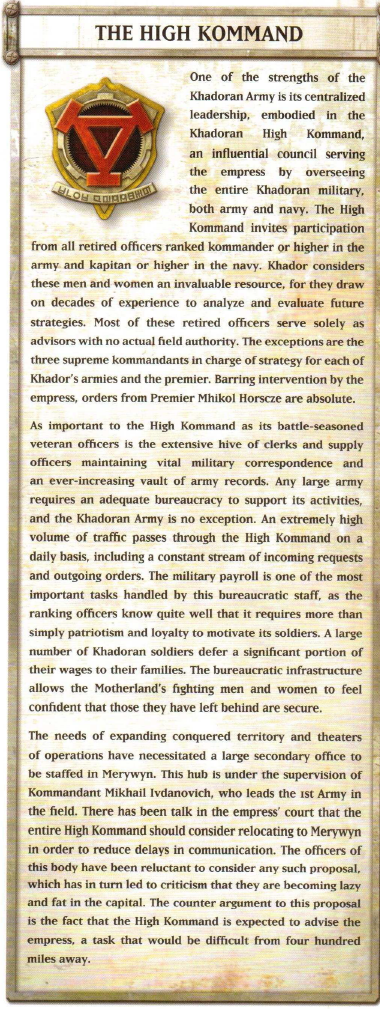
Thornwood has had its own problems, far more than anticipated. It is sparsely populated, has few roads and Cryx has been attacking supply lines, along with Cygnaran raids and interference from the forest savages. Khador has begun building forts to defend the new acquisitions, particularly a chain along the Dragon's Tongue, plus supply forts and roads through the forest. Despite aggressive allocation of manpower, it's cost more than expected and has been going slowly, with the original schedule entirely infeasible. Despite all these setbacks, the Khadoran Army remains resolute in restoring Khador's glory and the lands of the Khardic Empire. Conscription keeps the army large, and Khador has built an industrial base that can supply men and 'jacks with the weapons they need. Supreme Kommandant Irusk plans to make each part of the Army so strong and self-sufficient that they can win even while isolated from the rest, insisting that even if his supply lines are attacked, he can hold his own with or without support.
The First Army, or Anvil, is called on for protracted battles and is trained for stamina. They are, in theory, sent forward to engage and tie up the enemy across large areas, with the Hammer striking at the flanks. Anvil tactics maximize resilience by cycling active and inactive forces constantly and taking time to recover from casualties. Its officers consider themselves experts on sieges, and they also serve as an active reserve for veterans to recuperate in while staying close to the field. The Anvil is relied on to hold territory and assimilate it, and it has been battling resistance elements in Llael. None of the soldiers take occupation for granted, and they've endured many ambushes and even organized attacks. It's a job they weren't well-suited for, and they've had to learn hard lessons. Increasingly, they've made Llaelese cities productive for Khadoran industry, a matter of pride with them. Most Llaelese still think of themselves that way, but have begun to accept that life now is not so different from before. Despite this, the recent reduction in Llael garrisons is a concern for the 2nd Division under Kommandant Voroshilov Klimovich. Klimovich has reason to expect that this will encourage rebels, and with the Protectorate getting involved and attacks by the Iosans, confrontations seem inevitable. The 2nd Division has been training tirelessly for it.
After the fall of Northguard, many battalions were sent south to Thornwood, and that's largely fallen to the First Division, led by Kommandant Yegoruv Ilyevich. It's required a shift in tactics from patrolling Llael, complicated by lack of maps, little cleared land and constant ambushes. Morale has plummeted, but the establishment of a large supply base has helped provide more sense of security. The First Army is nominally under command of Supreme Kommandant Ivon Krasnovich of High Kommand, but its direction is left to Kommandant Mikhail Ivdanovich, who commands from Merywyn. He is a humble, quiet officer with an engineering background, supported faithfully by his men. He has been credited by Irusk as vital to the takeover of Llael, due to his oversight of supply lines to the front. Despite the Thornwood problems, he is seen as the one man who can probably get supplies through the Thornwood, and is even relatively popular among the Merywyn locals for restoring industry and commerce as well as repairing most of the damage from the siege, including sites of historic significance.
The Second Army, or Hammer, focuses on crushing offensives and has the most assault legions, warjacks and heavy armor infantry, though they still rely on the Winter Guard infantry battalions. During the Llael invasion, they started lightning attacks on Redwall Fortress, Elsinberg and Laedry, and they've been at the forefront of all Cygnaran operations, including the fall of Northguard and the push to the Dragon's Tongue. As such, they are currently very well respected. Supreme Kommandant Irusk is most associated with them, and particularly the 4th Assault Legion of 3rd Division, who have fought under him longest. They specialize in swift attacks, destroying forts rather than sieging them. It's not always appropriate, but Irusk has many tools. The 2nd Army has the most casualties and highest turnover rate, and victory generally comes at a high cost for them. Fresh recruits are always needed, and Irusk has ensured they always get placed with veterans to learn the trade quickly. The Hammer's gotten much bigger in recent months, both from fresh conscripts and force reallocation. They are presently in the Thornwood, rather precariously due to lack of support infrastructure. They are trying to counter Cygnaran forces across the Dragon's Tongue, but it's been hard to implement - the fortresses are going slowly, none yet complete, and supply lines are uneven at best. The enemy has fortified cities already, leaving the Hammer at a disadvantage.
Fewer soldiers than considered acceptable are manning the new forts, and the army has trouble patrolling Thornwood thanks to the Cygnaran ranger raids, leaving them unable to react quickly or attack enemy positions well. They've been focusedo n overcoming this, and are being pressured to do it soon. They rely heavily now on exceptional warcasters such as Forward Kommander Kratikoff, Kommander Karchev and Kommander Strakhov. They are the purview of Supreme Kommandant Alex Gorchakoff at High Kommand, but his influence is near nil thanks to the proximity of Irusk, and rumor has it they've been having tension, as Irusk accuses Gorchakoff of insufficient effort in sending materials for construction. Irusk has a far better working relationship with Kommandant Boris Makarov, field commander of the army, who is a huge and gluttonous man and seasoned Iron Fang who remained away from the army for years until his son's birth. Now that he has an heir, he has returned to the Hammer with enthusiasm.
Perhaps because of their fighting reputation, both divisions of the army are led nominally by great princes, Kommandant Jhrom Holcheski of the 3rd out of southwestern Thornwood and Kommandant Servei Marvor of the 4th, out of southeastern Thornwood. This provides prestige, but their station has kept them at the capital or their homes more often than not. The COs think that's for the best, as their rank has caused confusion in the chain of command before. In their absence, details fall to kommandants with a solid rapport with Makarov and Irusk.
The Third Army, or Forge, handles training new conscripts and maintaining the home garrisons. The five border legions also fall under their purview. They have many training facilities, but only one training city: Volningrad. The Border Legions make them structured rather differently than the other armies, with their forces covering the largest geographical area. Garrison duty is seen as the easiest and least prestigious post, highly desirable for its safety for those with families. Recent years, however, have shown threats to the interior, such as the rampant dragonspawn in the north, which the Greylords Covenant and High Kommand lack good intel on. The trollkin kriels and blackclad druids have also been problems in remote regions, and the 3rd Army also takes care of vital industries like logging and mining. High Kommand and the Prikaz Chancellory have gone to great lengths to quash rumors of attacks by Ios on the interior, which are based on an alleged attack by Iosan forces against a Greylords Covenant base near Fort Brunzig. Exactly how the Iosans would get so far into the country has not been explained, and most officers dismiss the rumors.
Kommandant Konstan Zhukovny commands 5th Division and the border legions, responsible for the safety of the interior and the border. This has historically been a safe job, as no foreign power has ever succeeded in invading Khadoran soil. However, recent turmoil has challenged them as never before. The 3rd Army is directly led by Supreme Kommandant Menshik Sergevich of High Kommand, with Kommandant and Great Prince Karl Szvette as his field commander. 6th Division, the training division, is headed by Kommandant Grezko Antonovich, and Szvette has little involvement, leaving matters to his kommandants. The 3rd's officers are traditionally focused on supply and allocation of reserves, with more autonomy than any other part of the Army. Their most active soldiers are the 1st and 5th Border Legions. The 1st was originally based in Ravensguard until Northguard fell, and they have stayed with the 2nd Army in the Thornwood. The 5th are, likewise, south at the front, famous for fighting Cygnar for years and not giving it up yet. The 2nd, 3rd and 4th are all much smaller and less distinguished, assigned to watch Rhul and Ord. They are sometimes used to bolster interior garrisons, and the 3rd have a sinister reputation of being affiliated with the Old Witch, Zevanna Agha. They have come into prominence lately due to fighting internal threats in the remote regions, and when they show up in unexpected places, it means disaster is near and their support will be much-needed.
Next time: Warcasters.
Forces of Warmachine: Khador
Original SA post Forces of Warmachine: KhadorWarcasters in the Khadoran Army get a ton of liberty. If they're loyal, they advance rapidly and get authority over large contingents of soldiers and warjacks. Both Empress Vanar and her predecessors have always been willing to indulge and adapt to the needs of warcasters, and they're essentially immune to criminal prosecution as well as given immense leeway in their missions. They are technically obligated to obey High Kommand but tend to operate outside the chain of command, using the military infrastructure to get reinforcements and supplies. High Kommand is eager to get more warcasters but hve yet to find a reliable way to identify the talent. As a result, Khador has often lagged behind Cygnar. The last century has brought them closer to parity in capabilities, but High Kommand still has fewer warcasters, so they are even more focused on finding them and honing them into weapons. With the expansion of the Greylords Covenant, the primary fellowship of magic in Khador, it was expected more warcasters would be found, but it hasn't really worked. Most seem to emerge at random within the military, revealed by combat stress. Scholars insist that some family lines have higher potential, however, most notably the Tzepescis. The Greylords oversee the initial training of those who know nothing of magic, then have them mentored by a senior warcaster. Of those who are Greylords, most warcasters never advance beyond the rank of magziev, as their military focus prevents them from pursuing the research and politics needed to advance in the Covenant. There are exceptions, like Koldun Kommander Aleksandra Zerkova, however. Those warcasters that complete Druzhina training are generally promoted to kommander and given authority ot operate independently with a large team of soldiers and machines. Some remain outside the military structure, like Great Prince Tzepesci or Zevanna Agha. They are obeyed as if they were kommanders and get the same liberties, which can bother some military officers.
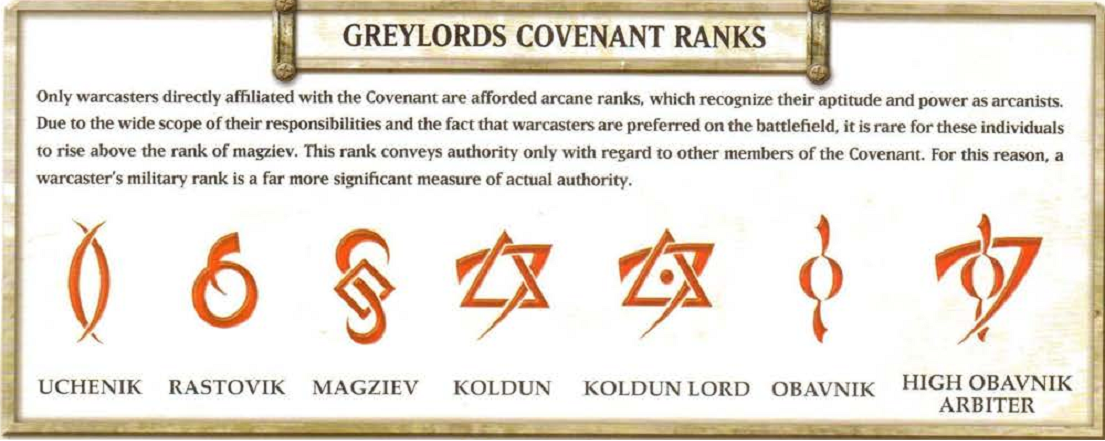
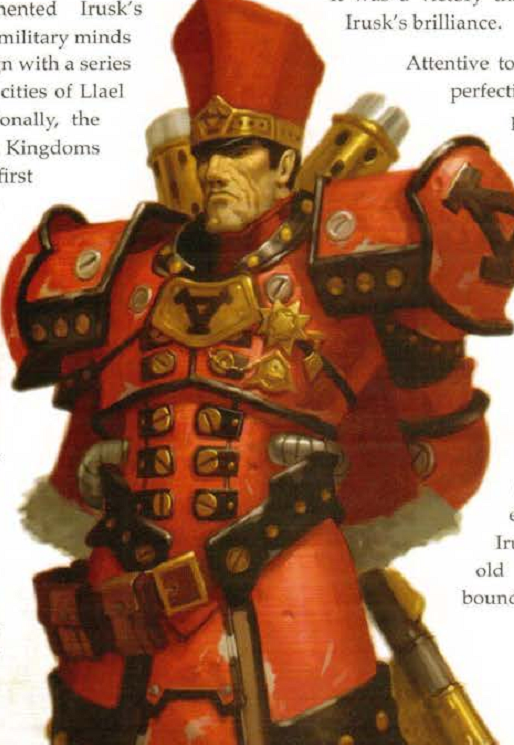
Kommandant Irusk was born for war. He is the chief military advisor of Empress Ayn Vanar XI, well loved by his men and famous as a god among soldiers. His rise has been out of determination, loyalty and sheer genius. He was born to a military family, trained from birth in warfare. His mother died when he was young, and his father gave his son knowledge of battle and combat, with Gurvaldt studying the fundamentals of Khadoran military doctrine from childhood. He joined the Winter Guard at age 12, and was already accomplished when his magical talent was spotted a few years later. Once he was sent to the Druzhina academy in Korsk for warcaster training, his career was inevitable. His instinctive grasp of tactics revealed weaknesses no one else saw, and his presence rallied the troops while his magic let him exploit any weaknesses he spotted. By 19, he was an officer and by 21 a full warcaster, with a staff position in High Kommand by 25. He won time after time, mastering all aspects of modern war. His book on tactical warfare, Irusk on Conquest: How to Fully Subjugate Your Enemy , is required reading in military academies across Immoren. As he rose to prominence, he became the empress' chief advisor on the military, and began to realize his dream of modernizing and rebuilding the Army to his vision. The invasion of Llael cemented his reputation as one of the greatest military minds of history, as he began with a series of winter attacks, catching the Llaelese by surprise and testing his experimental strategy of annihilation, using his artillery, heavy infantry and cavalry to asmash the enemy again and again. The siege of Laedry was over so quickly that some parts of Llael surrendered without a shot fired, and it is now one of the most important millitary actions in history. Irusk is a perfectionist with a natural air of authority, and utterly incorruptible. He despises politics and is like a raging bull in court, but prgmatic enough to make friends with the most powerful kayazy, who control the empire's purse. With their patronage, he's ready to take on the world. His gimmick is a mix of buffs and damage blasts, and his feat makes his allies fearless and very powerful.
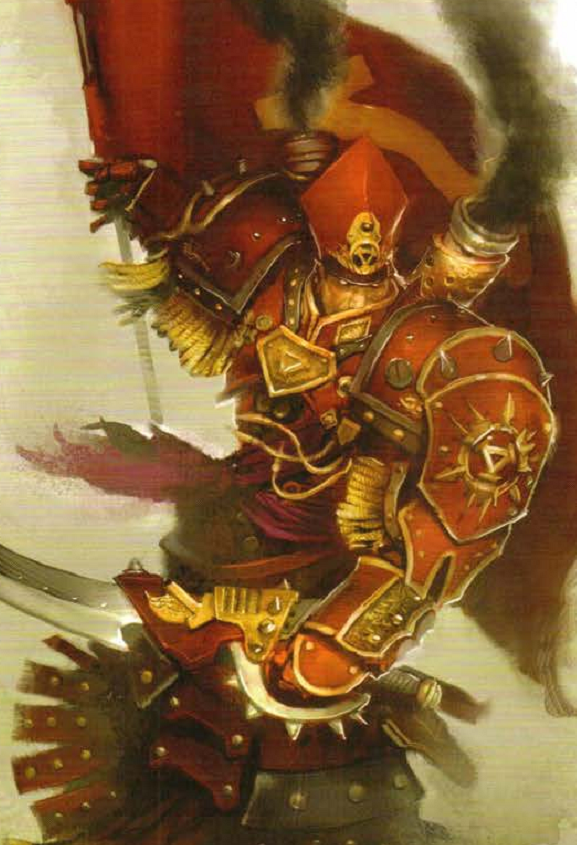
Supreme Kommandant Irusk is the Epic version of Gervaldt Irusk. He has been named the empire's perfect officer, and his absolute control in battle is legendary. His promotion to supreme kommandant, however, was after a defeat, and only cemented his resolve to redeem himself before his empress. His successes have never satisfied him, and he remains critical of all plans, constantly seeking to perfect himself...but even this did not prepare him for the insults Ayn Vanar hurled at him after his first failure to capture Northguard. This shamed him more than he'd ever felt, and during a short leave at his neglected family home, he realized it was her accusation of wasting the lives of his men that troubled him most. He'd learned to measure lives as a resource, reducing his countryment to quantities and valuing them too little. Gurvaldt considered suicide, but after finding one of his father's old cavalry sabers, he remembered lessons of youth. He returned at the empress' summons...and was unexpectedly promoted, which he understood for what it was: a challenge to achieve total victory. Before returning to Ravensgard, Irusk took his father's sword and had it set in a mechanikal housing, wielding the weapon now as a reminder of his promise and his family honor. He gathered his men and spoke to them of the battle to come, revitalizing them for the attack on Northguard. He led the army with the skill of an artist, and in one day, the greatest Cygnaran fortress of the north fell, along with the Thornwood. Irusk personally raised the Khadoran flag at Northguard, once more earning a reputation as the greatest military commander alive. In battle, Irusk imagines his army as an interlocking machine, and he knows even Northguard is not enough. Until all enemies of the empire lay at his feet, he must push on still, come what may. His new gimmick is more focused on buffs than before, and his feat allows his units to ignore bad terrain, while the enemy is debuffed.
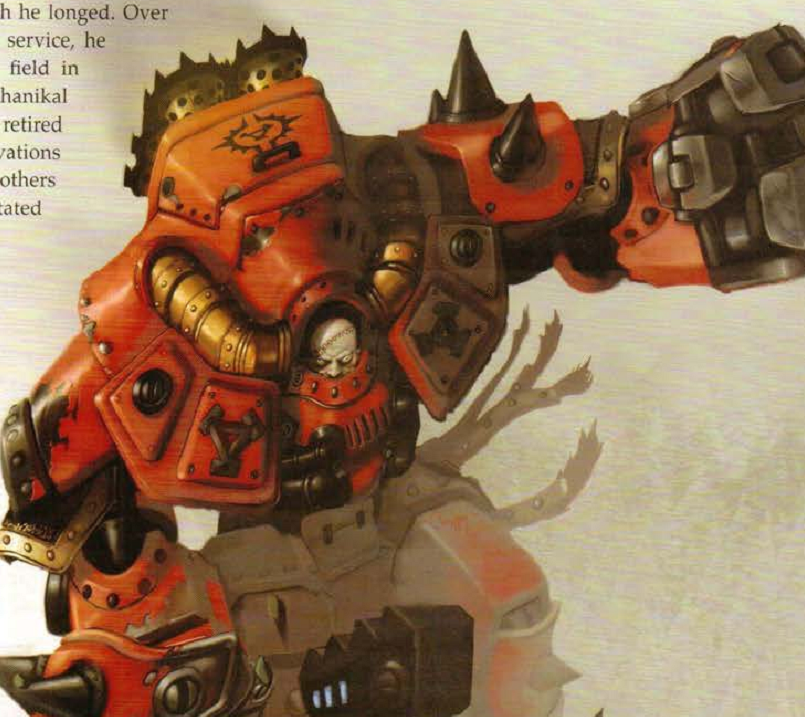
Kommander Alexander Karchev, better known as Karchev the Terrible , has been serving Khador for over a century. After enduring terrible horrors, he chose to exist in a tortured body encased in a warjack shell rather than accept death. His brutality and control over warjacks makes him a terrifying foe. He was already a respected Greylord magziev over 40 when the Thornwood War broke out in 511 and he led a battlegroup during the Battle of the Tongue. He pushed into an ambush, and while he was gravely wounded, he continued the assault on the neemy warcaster, Colonel Drake Cathmore, killing Cathmore but suffering terrible wounds. He refused to die, clinging to life until he was returned to Khador, where he was mechanikally sustained. His limbs could not be saved, however. He confronted High Kommand, demanding a machine body so he could fight on. A decade later, he was given a monstrosity built on a modified Berserker chassis, combining the machines he needed to live with a warjack shell. Over his long years in service, he's used multiple mechanikal forms, some retiring as new innovcations replaced the old and others being destroyed in the field. High Kommand sees Karchev as a treasure of Khador, a brilliant arcanist and officer with more than a century of battlefield experience. He has access to a depth of history outside anyone but the immortal lords of Cryx, and when he speaks, High Kommand listens. Supreme Kommandant Irusk personally chose Karchev to accompany him to Northguard, where he killed General Hagan Cathmore, a descendant of Drake Cathmore. Despite the constant agony his machines put him in, he has never sotpped fighting. Most of his life now has been spent entombed in a warjack hull, and it gives him a special affinity for 'jacks, which serve him more like living things than machines. His gimmick is warjacks, and he himself has a warjack health setup rather than a normal set of wounds. His feat buffs his warjacks even further. This is the warjack guy. So warjack that he is a warjack .
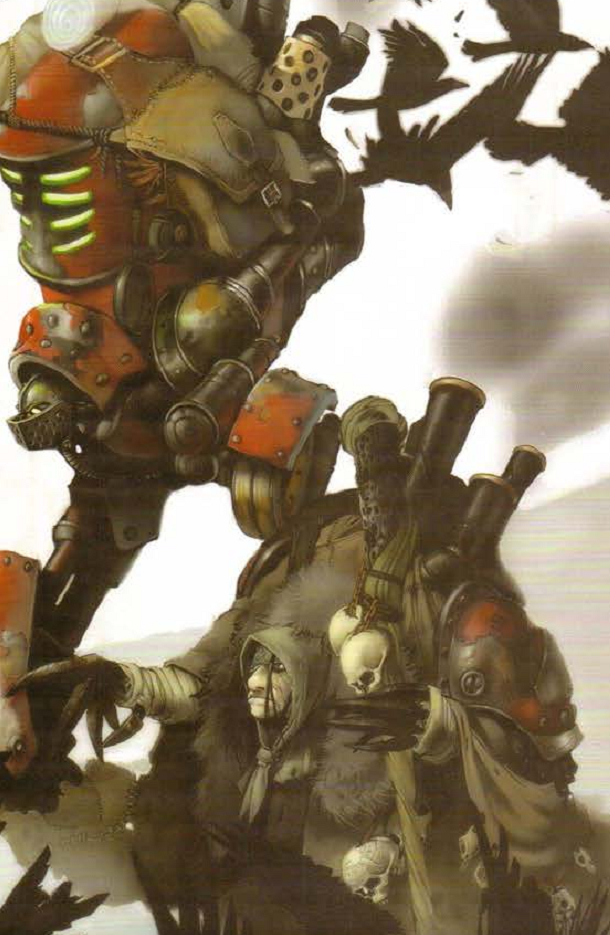
The Old Witch of Khador is never seen without the 13-foot Scrapjack at her side. Legends of the Old Witch have been passed down in Khador for generations. Her origins are forgotten now, but the oldest stories are retellings of Molgur legend of a shadowy creature of slaughter that feasted on the fallen. Legends from the time of Khardovic speak of an ugly old woman of immense power counseling the priest-king. Some say her advice took the lives of those who heeded it, but it always advanced Khardovic's cause. The Old Witch appears in hundreds of stories, guiding the Khadorans for nearly three thousand years. She appears in folktales from across Khador, always capricious. She saves entire villages from starvation in exchange for the clan leader's first male child. She vanishes the men who cross her, leaving their skins at the crossroads to warn others. She was around when Menoth walked the world, waiting for him in her cave. She has many names, but most commonly she is Zevanna Agha, the Old Witch of Khador. Few tales describe her in detail, but she is always an ancient, hunchbacked woman with a walking staff and a constantly moving sack. Her fingers end in metal talons, and it was not until the formation of the Iron Kingdoms that her companion was first mentioned - a primitive steamjack she put together from battlefield wrecks. It is a beat of burden that serves her faithfully, bearing an old arcane relay scavenged from the First Thornwood War. While Zevanna Agha's powers are primal and ancient, she has had no trouble learning mechanika or modern war. She commands warjacks with the same skill that draws the crows and the bones of the earth to serve her. Her deeds have often served to protect Khador, but no one doubts she has her own purposes, and legend says she counseled the Khardic lords to seek conquest, promising them aid 'from the ancient source of their blood,' that their enemies owuld 'with breath still on their lips.' To this day, most sages attribute the great plague that swept the Kossites and Skirov to Khardovic's spirit, but some claim it was the work of the Old Witch, who appears frequently in tales of the Khardic wars, using sorcery 1500 years before the Gift. She appears in Umbrean, Skirov and Kossite legend as well, supporting their wars, too. The extent to which she has manipulated the Khadorans is a mystery.
One legend sayst that Sveynod Skelvoro declared himself the first Emperor of Khard at her urging, and that she's appeared to every Khadoran monarch since. They say she made the crown of khador from the gold and iron of the slain chiefs, enchanting it and adorning it with red jewels and human blood. Proof exists that she fought the Orgoth to deny their gods' power, and cruel she might be, but she guided Khador towards some vision of greatness. The recently published journals of Exarch Voltor Drydestiev, confidante of King Ivad Vanar, say that she came to speak to him, but Ivad would only say he'd been in the presence of something ancient and that the safety of Khador would be ensured for generations. No one knows the extent of Ivad's bargain, but orders were secretly passed to his generals to ensure they cooperated with the Old Witch, giving her soldiers and warjacks if she asked. By command of the Empress, Zevanna Agha may requisition anything she needs, without explanation or accountability. It is uncomfortable, but it must be so. The Old Witch has potent allies in the aristocracy and military, and the Greylords Covenant does anything she tells them to. She often leads Khadoran troops in battle now, particularly the Third Border Legion. The Winter Guard speak of her in hushed tones, for she can appear any time and command them whenever she likes, to face sometimes unfamiliary horrors. She has opposed anyone who stands in the way of Khador, but seems ot have a special hatred for the Circle Orboros, striking down even their strongest leaders and taking their lands. She has long meddledi n the bloodlines of Khador, and the Tzepesci lineage in particular. For centuries, she has guided their lives and wars, culminating in Prince Vladimir Tzepesci, last of his line. She waited until he nearly died in battle against Cryx to reveal to him his destiny, and has since watched as fate tightens its grip. It seems unlikely that she could care for any mortal, so it's more likely she sees him as a potent weapon. She is far more active now than any time since the Orgoth occupation, moving to directly intervene in Khadoran affairs. Her gimmick is terrifying buffs for herself and Scrapjack as well as a few chosen allies. Her feat makes the enemy unable to do much at all near her and also makes crows attack them.
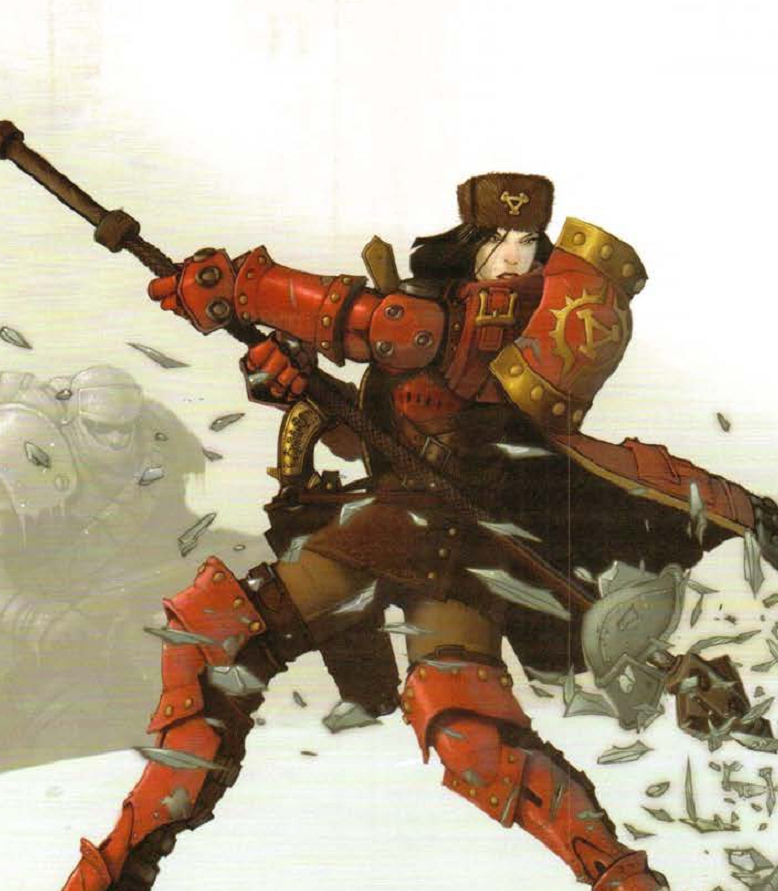
Forward Kommander Sorscha Kratikoff is Epic Sorscha. She has learned to live with loss, growing numb to the suffering around her. She has moved among nobles since enlistment, chafing against their arrogance. Only Vladimir Tzepesci gave her honesty and no pretenses, the only man to reach her heart since her father's death. His enemies among the kayazy were quick to take advantage, spreading rumors of treason between the two lovers. The Llaelese occupation brought terrible suffering, and at the height of the war, Vladimir vanished, apparently dying in battle against Cryx. Only duty kept Sorscha from riding out to find him, and the kayazy soon began questioning his competence, habits and even his loyalty, as if his past deeds meant nothing. Sorscha yearned to hunt them down and kill them. She was promoted to forward kommander, assigned a cadre of Winter Guard and sent against Cygnar. Her fury became legendary. When Vladimir returned, he came to her before any other, and her hope briefly returned, but he could not stay long. Kommandant Irusk called Sorscha back to Llael, and Vladimir was summoned to war. She believed High Kommand intended to separate them, and her thoughts darkened. Now, she fights like a woman posssessed. She was there when the Butcher of Khardov was wounded in his failed attack on Fellig, but did nothing to stop it - she left him to die as penance for killing her father. She feels no remorse, but now worries she may one day pay for that, especially since Zoktavir survived . Her patriotism still drives her, but increasingly she is also driven by the darkness within her, fighting so that she can find peace in the clarity of battle. Her new gimmick is using cold to buff and debuff rather than throw cold damage around so much. Her feat causes attacks to do more damage if the enemy is not immune to cold.
Next time: More and more warcasters of
Forces of Warmachine: Khador
Original SA post Forces of Warmachine: Khador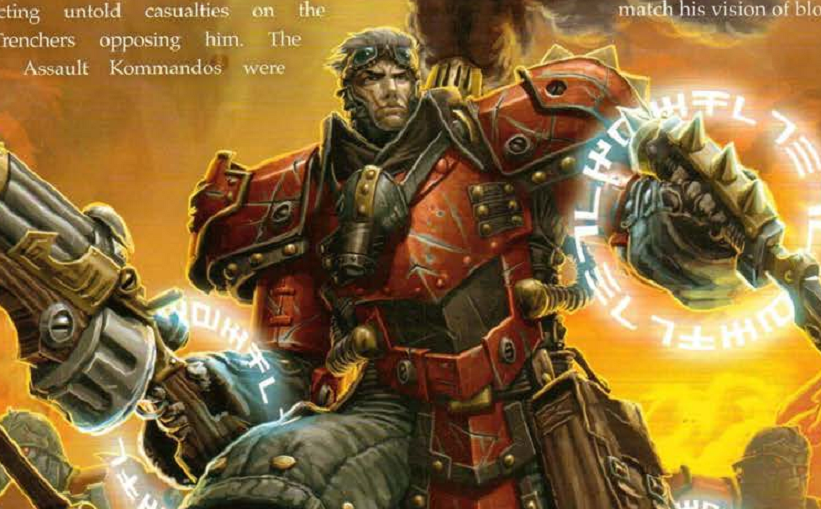
Kommander Strakhov (first name: Oleg) is hated and feared more than practically anyone else, at least by Khador's foes. He is the man turned to by High Kommand for the most dangerous missions, because if he can't do it, no one can. He lives to test himself, combining ruthlessness and tactical genius. Strakhov has served for nearly 20 years now, but the details are largely unknown except to a select few in High Kommand, at least until the Llael invasion. He spent the first weeks of the invasion systematically destroying Llael's top commanders and warcasters, most notably Archduke Alreg Vladirov and his entire command with a well-planned ambush. Vladirov was a lord general of Llael and a master tactician, and his earl death was a major blow. His fate was unnown for years until the Resistance found his signet ring in a mass grave outside Leryn. Strakhov's final operation in Llael resulted in the destruction of several major munitions depots in Merywyn just hours before the capital fell. He infiltratred the city and detonated ammunition depots as Irusk began the final assault, throwing the defense into chaos and ensuring a heavy civilian death toll. Irusk saw Strkahov's work and called him in for advice on the foundation of what would be the new Assault Kommandos, then appointed Strakhov to train the Kommando officers. Trhough 605, Strakhov personally led the Assault Kommandos against Cygnar near Northguard, testing them in battle and killing massive numbers of Trenchers. Despite the respect Irusk has for Strakhovm however, Strakhov occasionally angers him by performing high-profile operations without waiting for approval from High Kommand. The only thing that keeps him from reprimand is that these missions have overwhelmingly succeeded. Strakhov prefers to rely on physical combat, but his magical skills are refined for his favored shock assault tactics, launching his 'jacks in brutal strikes in the middle of enemy positions before they can react. His gimmick is movement and tactical control, and his feat lets him make his allies even faster.
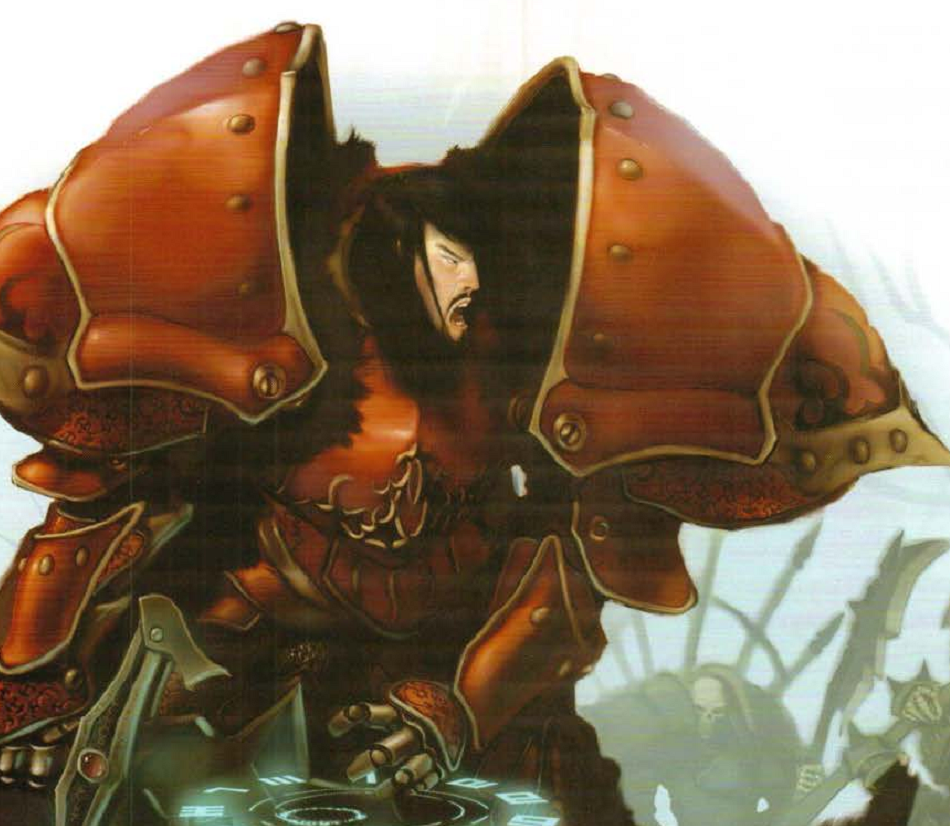
Vladimir Tzepesci, the Dark Champion is Epic Vlad. All his life, a doom he did not understand has haunted him, constantly reminding him of his past and future. In the final days of the Llael invasion, he nearly gave his life against Cryx. The Old Witch of Khador found him dying in the Thornwood for his courage, taking him to her lair. There, as the kayazy bickered over his lands and title, he slept for months. He was presumed dead, but he grew stronger and he dreamed. He is as dear the Old Witch as a child to its grandmother, being the last living Tzepesci. She guided him with prophetic whispers as he slept, showing him terrible visions of his future. He tore himself from his sleep, finding himself whole and strong, and he worked in the Old Witch's averns to merge his broken weapons into the great blade Dominion. He has returned to the world with his destiny revealed to him and the Old Witch's doom upon him. He raised his army and headed to the Thornwood to take part in prophecy. There, in the ruins of the Temple of Garrodh, he slew the Harbinger of Menoth, denying Lich Lord Asphyxious a chance at godhood. In a fighting retreat, he met with Sorscha Kratikoff and rekindled her hope, but destiny soon called again. As the heir to the throne of Umbrey, a nation long ruled by Khador, Vladimir feels increasing conflict. He struggles with both his loyalty to his Empress and his Umbrean blood. He is ready to seize his destiny now, and both the Empress and the Old Witch watch him carefully. His gimmick is a mix of wind blasts and powerful buffs, with his feat giving a handful of his soldiers massive buffs to everything.
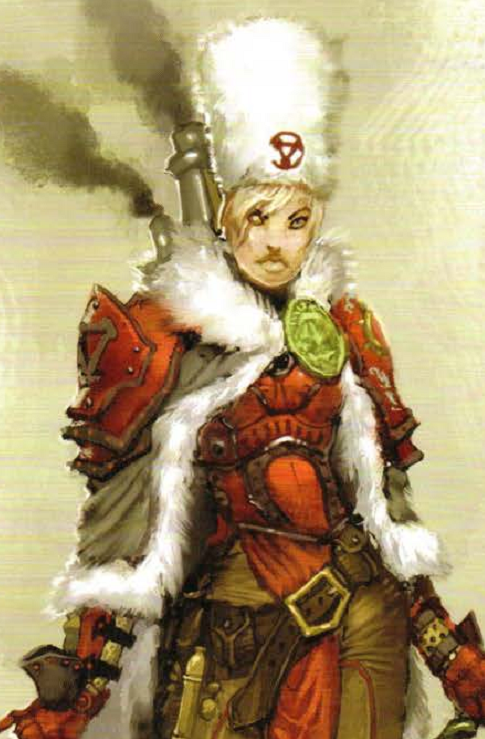
Koldun Kommander Alexsandra Zerkova is among the most ambitious and ruthless of the Greylords Covenant. She will destroy anyone who stands in the way of her knowledge, and she is a master of unholy lore. The Zerkova name strikes fear in all who know of her, and it was that family that led the attacks on Ord in the Second Expansion War. Some Khadorans associate the Zerkovas with dark magic and dangerous roads to power, however, and for the last four generations, interest in the occult has come with their patriotism. Aleksandra's father set her to studying dead languages and esoteric lore in their ancestral library, and magic came easily ot her. After joining the Greylords Covenant, she demonstrated the start of her interest in ancient civilizations, particularly the Orgoth and Morrdh. She broadened her studies to include Calacia and cursed Acrennia along with ruins predating the Khards. High Obavnik Arbiter Dmitrilosk gave her permission for unsupervised travel in search of weapons, and she has spent over a decade wandering ruins like Uld Vroggen, heading deep into the Orgoth chambers of the mines to amass a collection of items of power, mostly Orgoth. Her activities have also led her to help with the siege in Merywyn against the local Fraternal Order of Wizardry, obliterating them so entirely that no one even knows how she did it. She is extremely reclusive recently, even more than normal, and while the Prikaz Chancellory has hidden the specifics, it's known that her stronghold was one of the first targets of the Retribution of Scyrah when they came out of Ios. Only the most highly ranked know that she is, in fact, in possession of the god Nyssor, though her efforts to learn his secrets have yielded little so far. Zerkova uses warjacks and soldiers like pawns, and most deem her cruel and heartless, willing to do anything to enforce loyalty. Her voice commands respect and fear no matter where she goes. Her gimmick is magic blasts and magical control, and her feat blocks a lot of enemy actions by calling on shrieking winds.
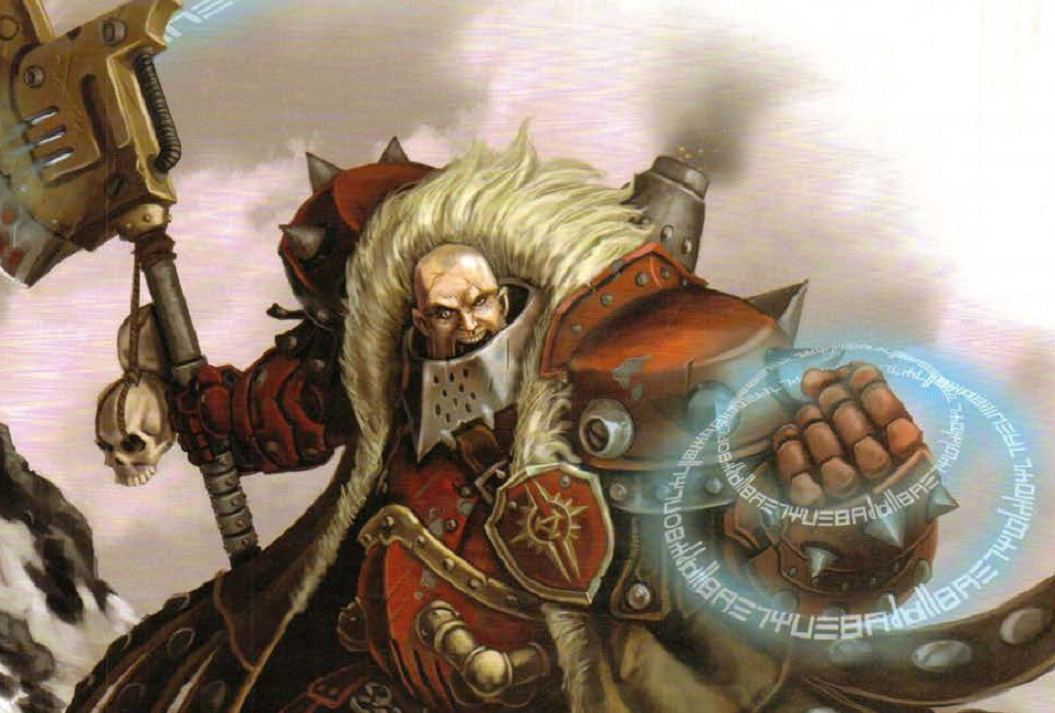
Kommander Orsus Zoktavir is Epic Orsus. Constant battle has only deepened his madness and brought forth the darkness within. Only the Doom Reavers feel any recognition for him, seeing in him the same force that urges them to kill. Even those who once endorsed using him as a weapon have begun to doubt the wisdom of it. Llael seemed like his finest hour, as he took on Redwall Fortress and its defenders like a rabid dog, his warjacks and Doom Reavers in tow. Some speculate that Irusk hoped the Butcher would die in the attack and take his worst followers with him. He didn't, and this provided a problem: they were there to conquer, not slaughter. Orsus was midnful of those orders when calm, but when the battle madness came down, there was no stopping him. When Khador focused on Cygnar, Orsus was ordered to stand down. This left him with time to remember things he'd tried to forget, torturing him and eating away at his self-control. In response, he was hurledi nto battle, allowed to fight in the southwest, where he could do little harm. When he was given more specific orders, they were generally very dangerous and he was often wounded. In the final stages of the battle in Thornwood, his bloodlust reached new heights, and he led an unauthorized suicide attack on the city of Fellig. Not even he could handle the task, and when he failed to return, some of High Kommand was relieved. However, months later, he walked out of the wilds and returned to his barracks as if he'd never left. He has not spoken of what happened even when ordered by Irusk, but it's clear his rage remains. Even his magical power is affected by it, surging up and then simmering. He is incapable of restraint, and only at home when fighting. His gimmick is berserking and killing things and buffing from killing things. His feat allows him to gain power from murder and then hand out that power to do more killing.

Warjacks are immense and not easily moved without railways, so Khador has been very quick to lay new track, both at home and in the conquered lands. Wagons and draft horses take the 'jacks where trains can't, and if necessary, they can travel under their own power, at a great waste of coal and water. War has forced the making of new firebases, where supplies of coal, water and weapons are ready for resupply. As the front lines move, more of these have been built to allow warcasters and their 'jacks to strike wherever needed. Some become permanent forts and command posts, and a number are under construction along the Dragon's Tongue to counter Cygnaran bases. Roads and resupply points stretch across the front, connecting with centers of production in the interior. Khador's new infrastructure and military reforms have not, however, significantly altered 'jack design. Even with Llael and the Thornwood, they lack the precious metals for mass fabrication of warjack cortexes, and so they continue to allocate resources towards medium-grade cortexes meant for heavily armored and highly survivable 'jacks. Other nations have used more maneuverable and reactive light warjacks for many roles, but Khador does not. Their heavy 'jacks instead can perform multiple battle functions and wield immensely powerful weapons. To compensate for the large number of light 'jacks their foes use, they have the steam-powered Man-O-War troops, which serve a similar purpose but are easier to deploy in volume. Their use has allowed Khador an equal tactical footing, making up for machines with manpower.
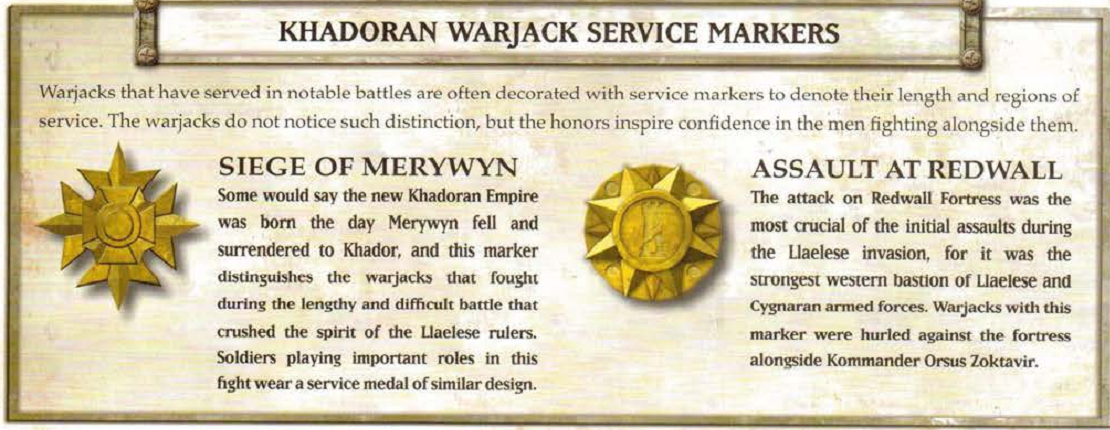
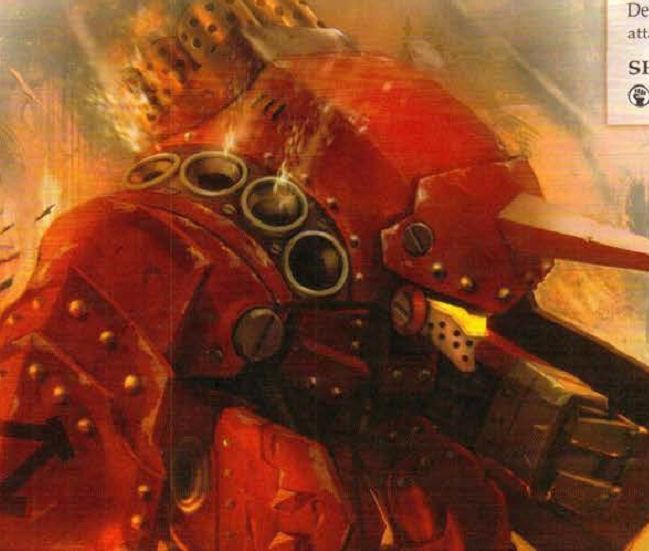
The Devastator , at almost 11 and a half feet tall and 16 tons, is terrifying. It's a walking fortress, able to take even concentrated artillery fire. Two decades ago, when High Kommand asked for a new and more heavily armored chassis, the Mechaniks Assembly quickly presented a monstrous design using advanced mechanikal weaponry and almost a third more armor than the Juggernaut. When in closed configuration, the Devastator's plates interlock to give full and nearly impenetrable armored protection. As a result, it weights almost half again as much as any other Khadoran 'jack and can shove aside basically anything. It has an array of short-range grenade launchers, but they can only be fired when the carapace opens and exposes vital machinery. To compensate, the grenades are timed to explode in quick succession, filling the air around the 'jack with deadly shrapnel for several seconds in what the designers dubbed the "Rain of Death."
Next time: Heavy Warjacks For All Purposes
Forces of Warmachine: Khador
Original SA post Forces of Warmachine: Khador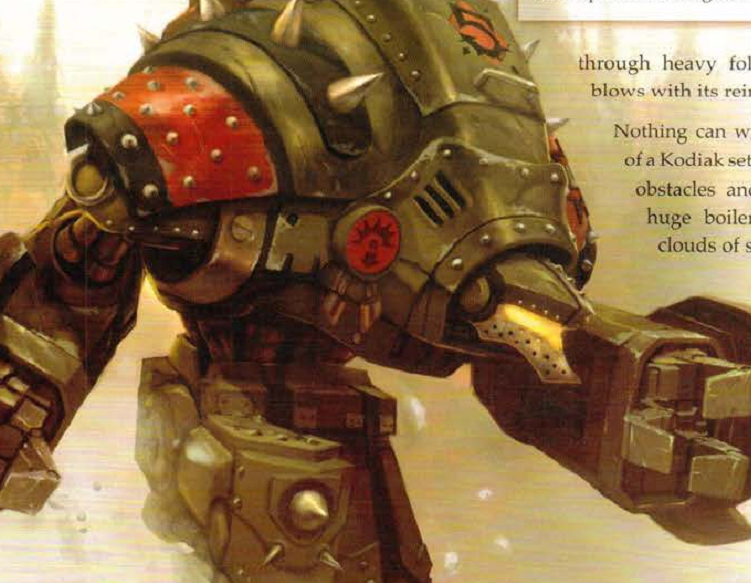
The Kodiak stands just under 12 feet tall and weighs in just over 11 tons. It was inspired by the 5th Border Legion, who refused to admit defeat after the First Thornwood War. High Kommand realized Khador needed an all-terrain weapon, and the Kodiak was developed to smash through foliage before it smashed through foes. Nothing can withstand its assault, and it barely notices terrain and obstacles. The huge boiler allows it to blast superheated steam at the enemy and envelope itself in a cloak of fog, while its fists can shatter steel.
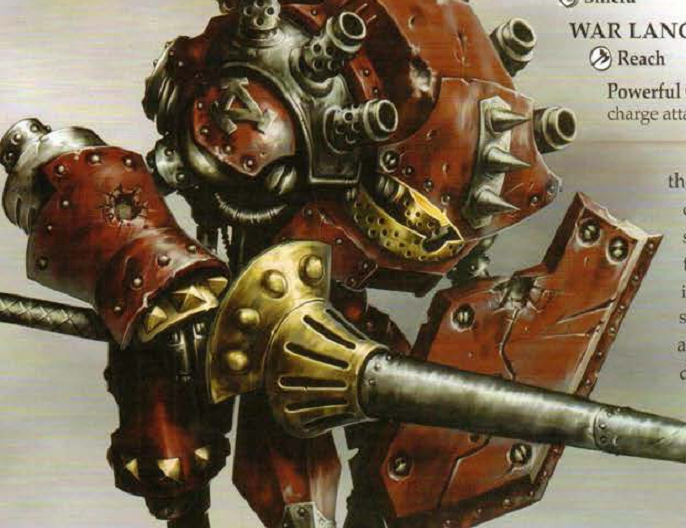
The Spriggan is almost eleven and a half feet tall and sixteen and a half tons. It was developed after Queen Ayn Vanar ordered the Mechaniks Assembly to give her a weapon to turn the tide of the border wars. It is based on the old drakhuns, wielding a lance and impenetrable shield as well as a lot of armor. Dual grenade launchers set into it are essentially impervious to damage that'd take out most external weapons, allowing it to fight even if slowed or crippled and preventing the enemy from overwhelming it by use of explosive shrapnel grenades and alchemical flares. The Spriggan's best weapon, though, is the lance, which can pierce a 'jack from cortex to boiler in a charge. If the opponent somehow survives, the assault shield helps defend the Spriggan, able to turn aside most weapons and good enough to use as a bludgeon.
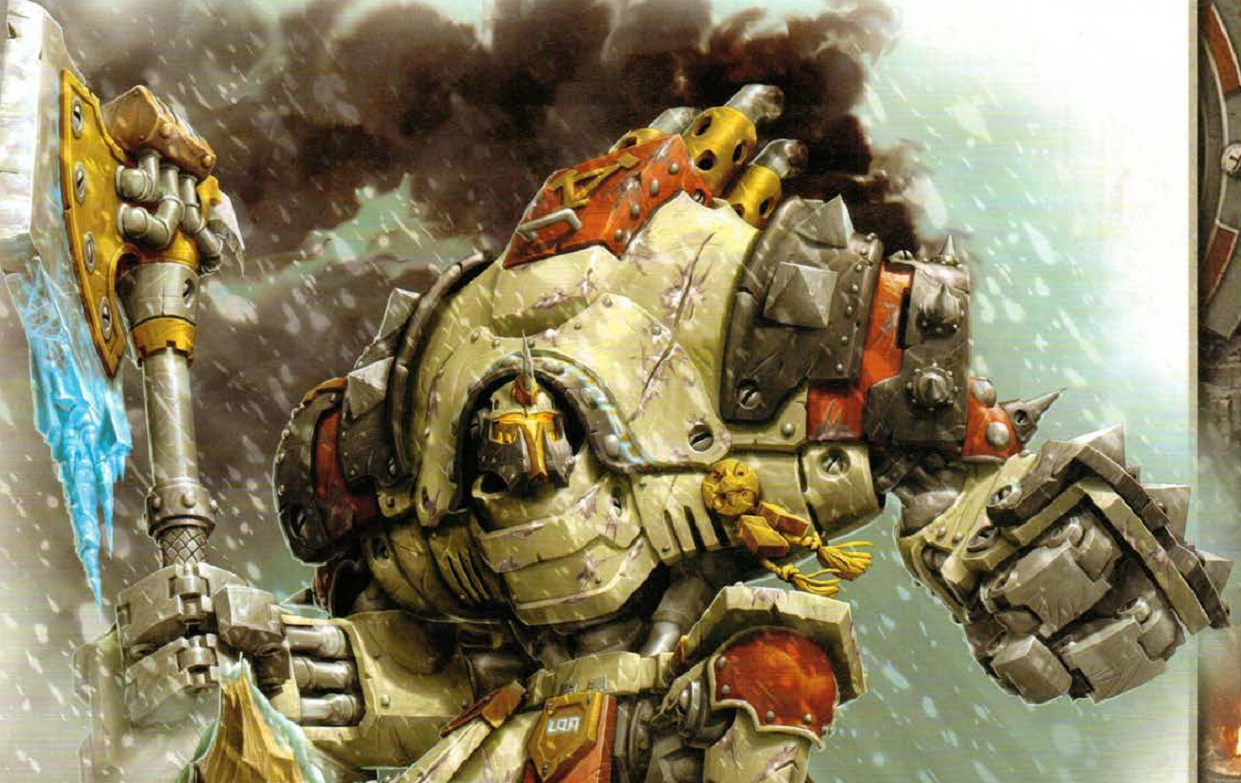
They call this Juggernaut Beast 09 , fully twelve feet and almost 10 tons. You hear it growling before you see it, and everything about it is menacing. It is docile only at the side of Sorscha Kratikoff, and it seeks her approval in battle. Beast 09 was assembled in 600 AR, at Rivegnya Complex, then shipped south and assigned to Kommander Kratikoff, who just gave it the number, 09, as order of allocation to her kommand. It has outlasted everything. The Beast is a tenacious fighter, developing fighting instincts from its constant war. It is not just survivable - it has a cunning that makes it seem alive, relying on its own initiative as much as its master's orders. During the War in Llael, while Merywyn was besieged, Sorscha was cut off by a Cygnaran counterattack. She sent Beast to refuel and resupply, but it had lingered against her orders, possibly spotting the enemy. Despite its low fuel, it rejoined Sorscha, turning the tide of battle. With its last power, it charged the foe and took them out, just running dry as the enemy fled. The bond between the two deepened after that, and the warjack has picked up on its mistress' ruthlessness, enjoying its kills. Attacks on it just encourage its frenzy, and Beast evens the odds where ever Kommander Kratikoff goes. To maximize its potential, she has had it overhauled extensively, outfitted with a gigantic engine and boilers similar to those used on Kodiaks, as well as an improved axe, Ice Breaker. Sorscha, normally unsentimental, is quite fond of Beast 09.
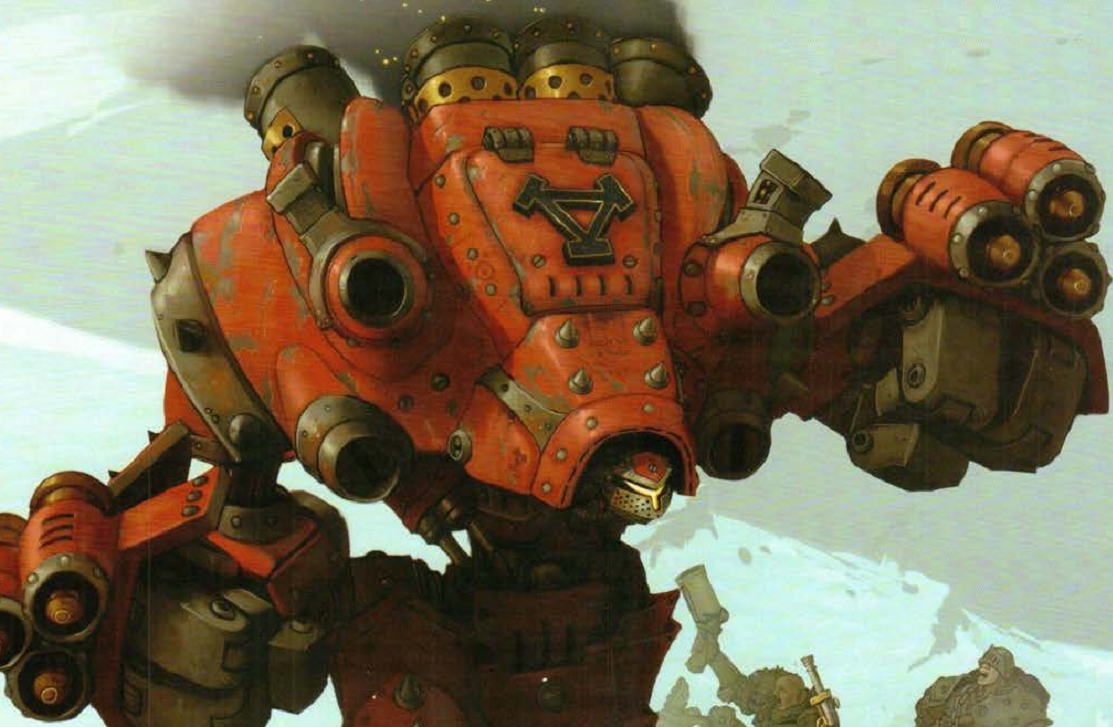
Behemoth stands seventeen feet tall, weighs 20 tons, and carries some of the most destructive ordnance in Khador. It was first introduced to the people during the crowning of Empress Ayn Vanar XI, marching into Korsk at the head of the Army. Former regent Simonyev Blaustavya presented it as a gift from the kayazy to the Empress. It was conceived over a decade ago as the ultimate warjack, and it exists solely due to the patriotism and efforts of Blaustavya and Dahlrif Salvoro. Soon after its inception, it became entangled in politics. Master Mechanika Dahlrif was a member of the Mekaniburo of the Khadoran Mechaniks Assembly and had designed it as an experiment. The costs associated with it made it a target of those against 'wasteful' government spending, particularly for a unique one-off. The Behemoth was designated unfeasible and suspended only weeks after the project began. Salvoro was frustrated, but busy with other work. The plan gathered dust for a decade until discovered by Great Vizier Blaustavya, who recognized the Behemoth's potential and insisted the project be resumed. His reputation and influence kept the cost from being made an issue again, and Salvoro resumed construction. The Behemoth is the best of Khador design: heavy army, devastating weapons and immense strength. Each of its fists is armed with integral blasting charges housed in reinforced cylinders, which augment the power of its punches with armor-penetrating blasts. A blow from the Behemoth can tear through armor and disintegrate soft targets. Each of the shoulders also houses a bombard slaved to the Behemoth's sub-cortex, the most innovative aspect of its design, which allows for the bombards to target independently. Since commission, the Behemoth has been at Khador's crucial battles, including the siege of Northguard. It has been pushed to its limits as a mobile artillery platform while facing enemy warjacks, and its presence rallied the siege and allowed its victory. It is as much a symbol of Khador as a weapon.
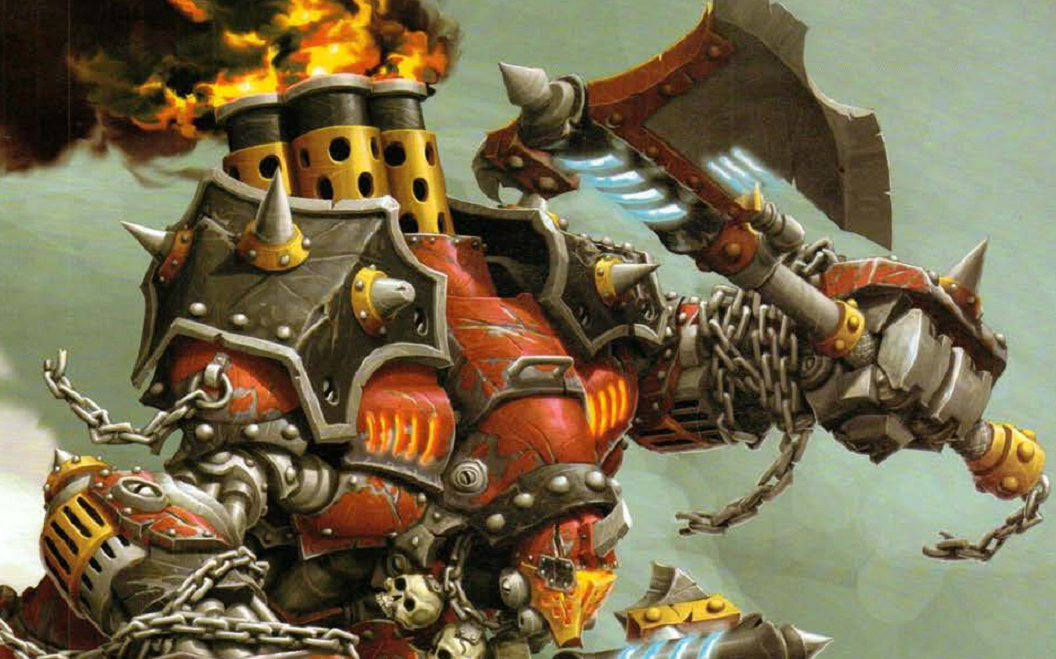
Drago is a Berserker, and unstable even by Berserker standards. It is almost 11 feet and just over 8 and a half tons. Its long years of service have removed most of its restraints against incidental violence, unleashing full brutality at any provocation. Drago is the oldest warjack still in service, and it belongs to the Tzepescis. Long ago, they financed the Berserker chassis, and even then, they had an unusual proclivity for warcasting. Drago was named in homage to Drago Tzepesci, who fought in the battles to overthrow the necromancer Ivan Vladykin, who seized the thron from 457 to 459. It is likely that the Berserker even fought under the living Drago there. He had a reputation for skill, bloodlust and recklessness that eventually killed him, and the 'jack has been passed down ever since. It has a particular affinity for Vladimir Tzepesci, perhaps due to the connection he feels for his ancestor. Some of his vassals find it strange that their well-disciplined and noble lord enjoys such a savage and untameable machine, but it represents the Tzepesci warrior spirit. EVen when severely damaged, it is tenacious and does not give up the fight, crawling on shattered legs if it must. When let loose, it seems to revel in death like a folkloric demon. The Dark Prince understands that sometimes, you need ultraviolence, but the restraints needed to keep it in check in times of peace also serve to remind him of the dark emotions he must control. Given its tendency to hurl itself into battle, Drago needs frequent repairs, but they are rarely neat ot ridy. Its many armored plates and spikes show the evidence of countless batles, and each one is an honor. Drago itself salvaged its current arms from Llael, using executioner axes from wrecked Destroyers on the battlefield.

While citizens of other nations consider compulsory service a burden, Khadorans accept it as part of life. A single tour is required of all men without extreme physical disfigurement, and while women are not required to enlist, those without children are encouraged to serve in the military or a support unit. Enlistment can start as early as 15, and every citizen must enlist by 18 or risk imprisonment. Those few that evade conscription serve their tours without pay and have the most grueling and dangerous duties. After receiving initial training, most conscripts enter the Winter Guard, but those with exceptional qualities or special skills can apply for more prestigious and specialized branches. It is possible, if rare, for veterans of the Winter Guard to transfer to other services later, too. Each force has its own requirements, and some are very stringent. The Man-O-War and Iron Fang require particular height and strength to wear their armor, for example, and require a lot tougher training than the Winter Guard. Khador's rank hierarchy was not clearly laid out until the reforms of Mikhail Vanar, which eliminated extraneous ranks. A new conscript is a privat, and after a tor might rise to korporal. The toughest of these may in time lead Winter Guard units as sergeants. As with other ranks, there are several grades of sergeant related to pay and seniority, and it's the highest rank most Winter Guard ever get. They may be given broad authority to lead multiple units, or forces, in battle. More typically, though, operational command is given to a lieutenant.
Entry into commissioned ranks by attending the Druzhina Academy of Korsk is easier for nobles, and commoners must be exceptional to earn a commission. Kommandants are opposed to this practice, but limited oversight means they can't prevent nepotism and bribery from greasing the wheels, and it's not unknown for a wealthy family to be given a commission before a poorer candidate of equal skill. In general, though, skill rises, and competent officers can achieve kapitan rank quickly, while those who dedicate themselves and have good leadership can rise further. Above kapitan is kovnik, roughly equivalent to majors and colonels. They oversee battalions or even legions. Few NCOs rise above that except for the excpetional. Despite the modern reforms, a few conventions of old Khador do persist. Most notably, the vassals and heirs of the great princes, who control the Volozkya regions, have their own martial traditions, and High Kommand has limited authority over them. The Greylords Covenant, the Khadoran arcane group, is also given special status. They are involved in dangerous occult research and spying, and operate on their own internal hierarchy. They may be part of the army, but the high obavnik does not answer to the premier, but to Great Vizier Simonyev Blaustavya, current head of Khadoran Security. They also run the Prikaz, the secretive chancellory charged with rooting out spies and traitors.
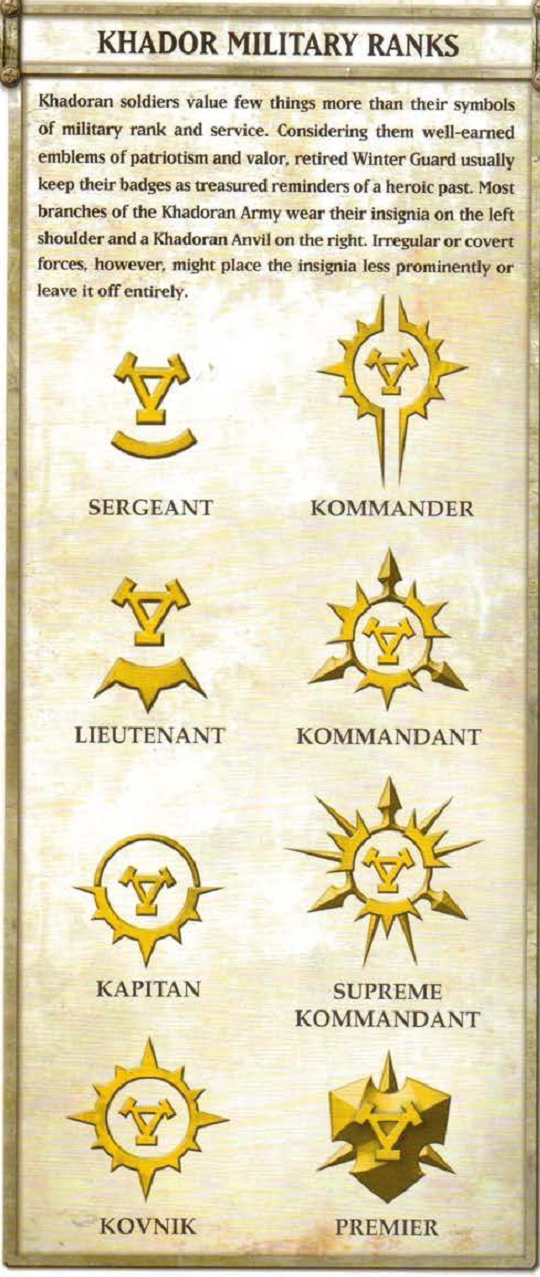
Next time: The Army
Forces of Warmachine: Khador
Original SA post Forces of Warmachine: Khador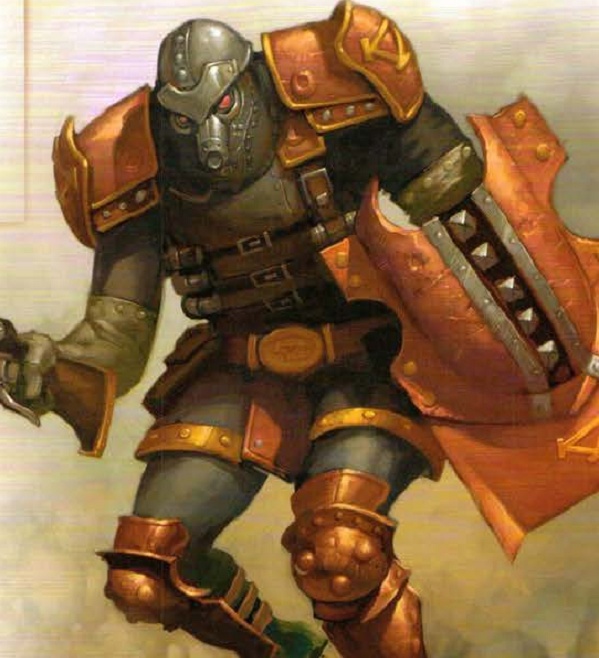
Assault Kommandos are a new kind of soldier. They serve on the front, driving the enemy from their trenches. They are heavily armed and amrored, using alchemical weapons to augment their skills. They advance behind a shield wall, opening fire with carbines that shoot choking gas grenades. Led by Kommander Viktor Strakhov, they were pivotal at Northguard, using gas to foul up Trencher aim and slaughter them. They are armed with the latest Vislovski carbines complete with gun blades ready to tear trhough armor and undersling canister launchers to fire their strangel gas. Golden Crucible alchemy has refined their equipment so their armor is resistant to fire, acid and magic. Their masks protect them from their own gas and allow their vision to pierce smoke and fog clouds.
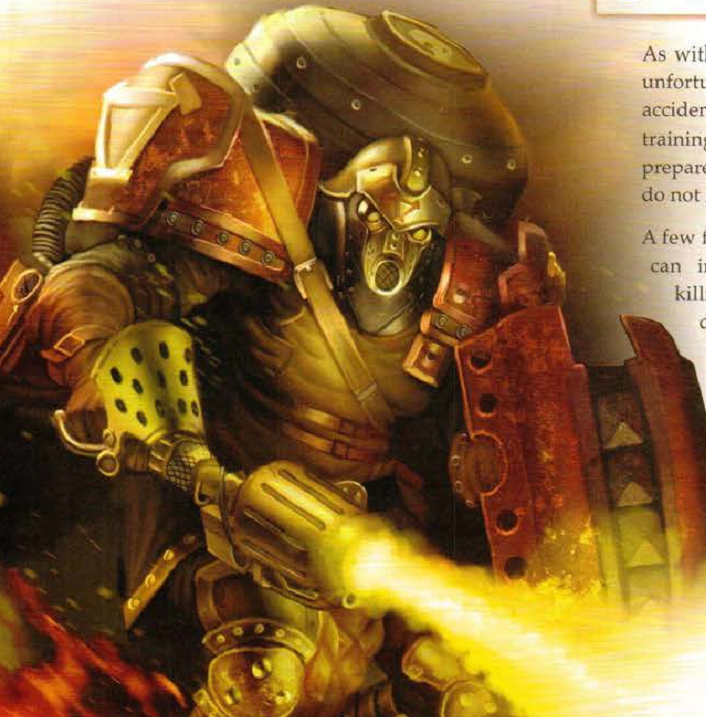
Assault Kommando Flamethrowers are part of Khador's arms race with Cygnar. It was inspired after conflict with the Menites, and it's the current production model of a weapon with many less effective prototypes. A huge canister on the back feeds the propellant gun that replaces the standard carbine, and the weapon produces flame via an explosive alchemical agent, devastating in the trenches where kommandos often fight. There have been friendly fire accidents, but the training of the Assault Kommandos prepares them for that, and there are still many volunteers. A few flamethrowers brought in with coordination can take out entire squads, killing and crippling. The jelly-like fuel clings to flesh, causing slow-healing and painful lesions. Trenchers fear the flame guns greatly, concentrating fire on them, and the life of a flamethrower Kommando might be short, but they take as many as they can with them.
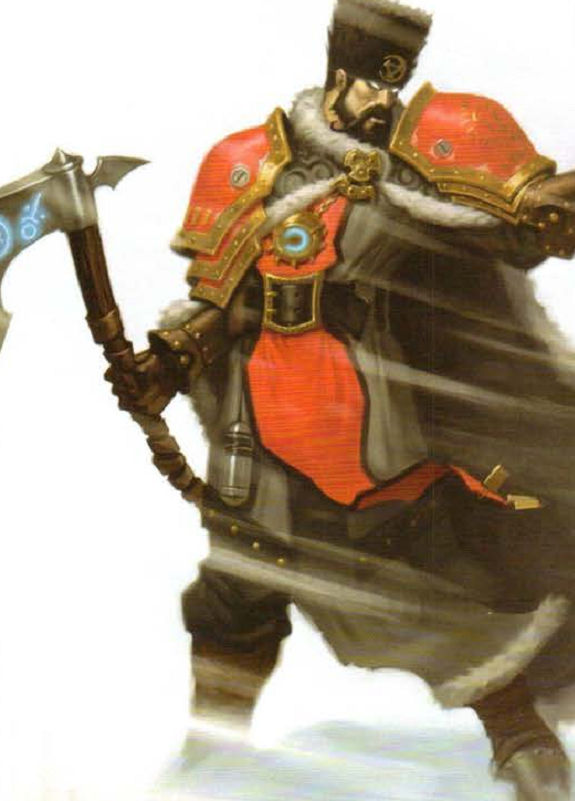
A Greylord Ternion is a team of arcanists. The Greylords Covenant was a splinter of the primarily Cygnaran Fraternal Order of Wizardry that split off at the call of King Levash Tzepesci in 243 AR, choosing patriotism over other loyalties. They are the greatest rival of the Fraternal Order to this day, and they have never been forgiven for stealing the secrets of cortex production. The Covenant produces warjacks, supervises intelligence gathering and works on new magical weapons. On the battlefield, however, they also operate in groups of three, or ternions. Individually, a Greylord can summon a gale to hide allies or hurl ice blasts, but together, a ternion can halt even a warjack in an icy prison.
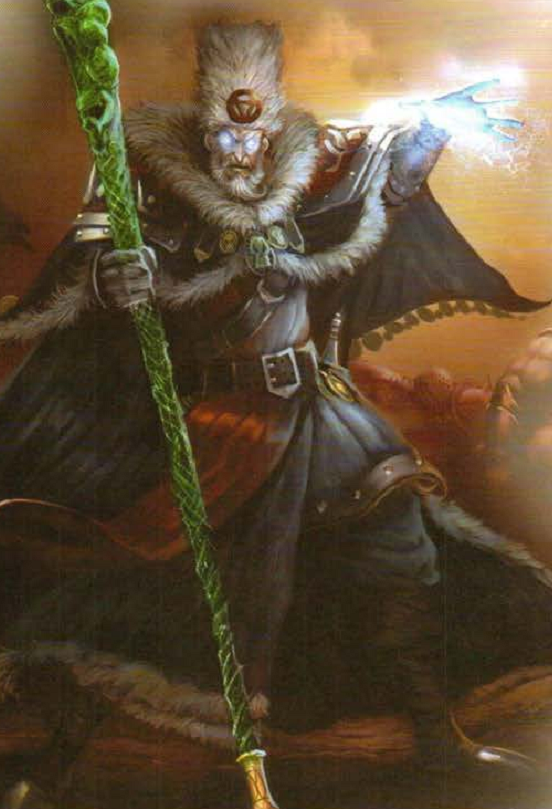
Doom reavers don't really have officers, but sometimes they will get a Greylord Escort whose job is to direct them at appropriate targets. They have used many resources to study the fellblades and Orgoth magic to control the Doom Reavers, and have had some success at diverting their urges through use of Orgoth relics. Only the most courageous actually accompany the reavers into battle, when they become overcome by frenzy. The escorts are generally at least rastovik rank and always experts on the Orgoth. They move among the reavers as a handler among beasts, carrying an Orgoth staff. They use the artifact to restrain the reavers while spurring them on, compelling them to obey. Their rage is channeled into necromantic energy that gives near imperviousness to injury, closing wounds via Orgoth magic.
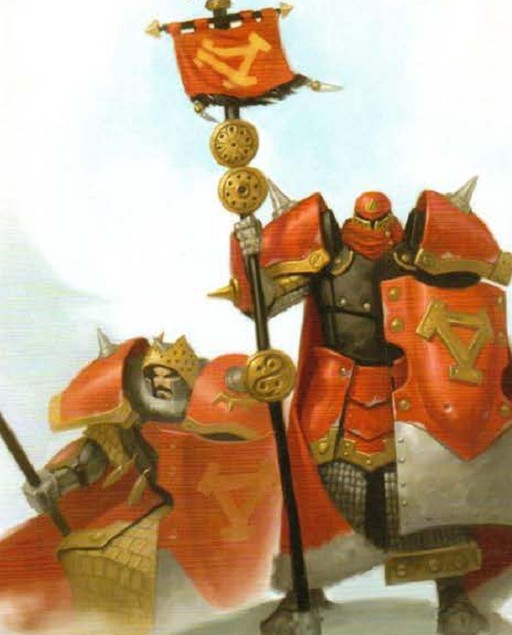
An Iron Fang Officer and Standard sometimes accompany the pikemen to battle. Their training is almost superhuman, and they are consummate leaders. The lieutenants and kapitans of the Iron Fang lead precision attacks iwth their blasting pikes, rending apart even warjacks. Some veterans are given standards to bear, filling the others with pride and giving a point to rally from. The colors of Khador drive the Iron Fangs even harder, former shield walls easily even mid-battle, and no enemy exists that they cannot defeat.
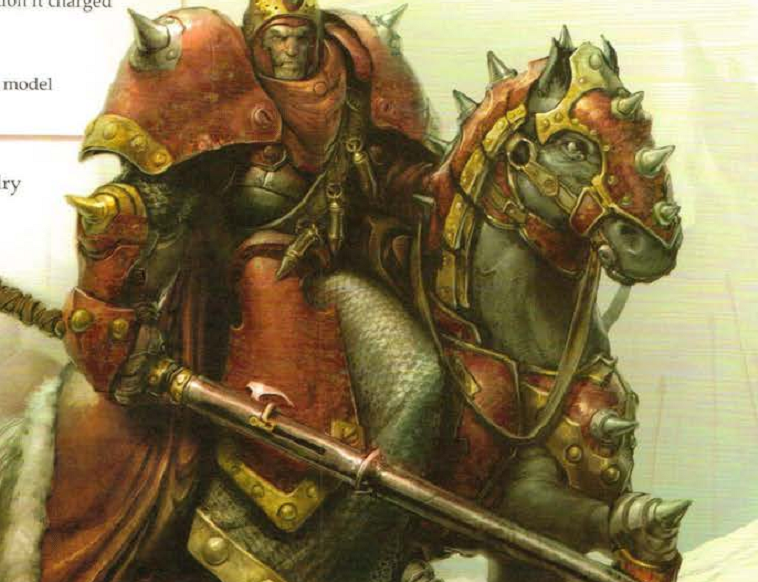
Iron Fang Uhlans follow the old Khadoran cavalry traditions. They use tactics that few outside Khador can mimic, and their bravery is legend. They are the vanguard of the Iron Fang, first to hit the enemy. They ride fluidly together, using classical tactics mixed with the modern formations of the pikemen. The Uhlans clear the way with their blasting lances and the hooves of their Pozdyov warhorses, allowing them to storm even the most contested field. In close combat, they use the short blades on their lance hafts to cut down the foe. The uhlan tradition demands the horse fight as much as the rider, and their warhorses can crush skulls easily. They are so powerful they can even knock aside warjacks when they charge, and they are strong enough to carry the weight of the Iron Fangs with ease, avoidng obstacles that'd stall lesser riders with strength and agility.
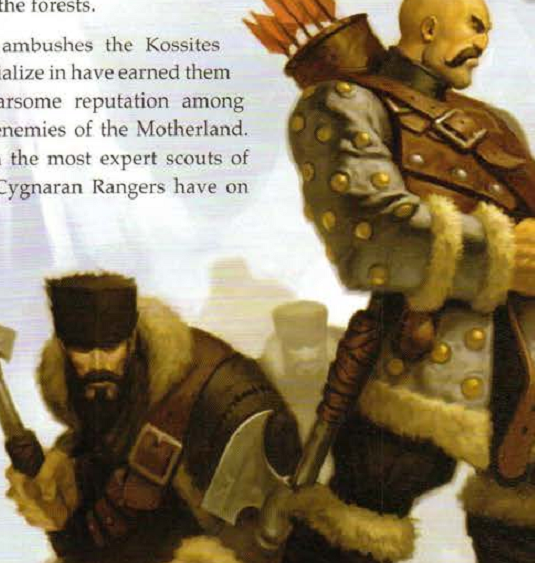
Kossite Woodsmen draw from the northern Kossite clans, descended from ancient warriors. Their muskets and bows resemble antiques but are no less deadly than modern weapons. The Kossites are deadly hunters and trackers who are entirely self-reliant. Their wilderness skills allow them great latitude in the military structure, working seperately from the Winter Guard and following orders only grudgingly. The only method that has been found to maintain their discipline is to keep Kossite units single-clan, as they are already used to working together and need little guidance to lay ambushes. Their ambush skills have earned them a fierce reputation, and even the Cygnaran Rangers have been jumped by them occasionally. The Khadoran Winter Guard respect the Kossites grudgingly, having been saved more than once by their timely arrival.
Next time: Men-O-War
Forces of Warmachine: Khador
Original SA post Forces of Warmachine: Khador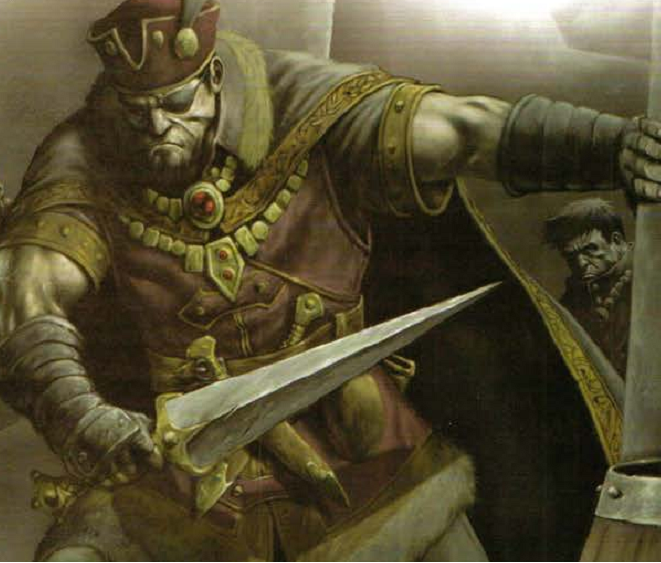
Kayazy Asssassins draw from the ranks of Khador's merchant princes and industrialists, scheming manipulators who use them against their rivals in their bloody games of money. They surround enemies, stabbing them with brutal blades, and on orders from the kayazy, they have gone south to fight in battle, ensuring that profit continues. Drawn originally from the most ruthless street gangs of Khador, they are killers that survived alleys by taking out anyone who got too dangerous to themm. Serving the kayazy gets an assassin respect and status, and they are at the top of the underworld. Many soldiers feel uncomfortable around them, but their skill is undeniable. They learned to duel in a place where failure got you killed, and they fight in the Korsk style, blade in one hand and entangling clooak in the other. They are finer swordsmen than many noble duelists, and few can stand up to them when they gang up on someone.
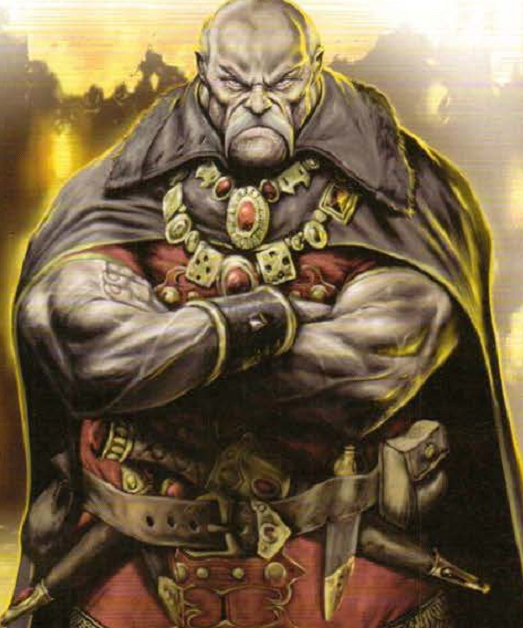
A Kayazy Assassin Underboss will sometimes lead the assassins in battle. They achieve their status as leaders by cutthroat competition in the Korsk gangs, needing both skill and intellect. They must be patient and able to gain and keep wealth. Surviving to do that is not easy, and they can't become soft, as their underlings will replace them at any sign of weakness. The wealth of the kayazy and their offers to pay for those who fight have not gone unnoticed, and many underbosses want in on that action. They make the arrangements for kills and pick only the best of their crews to join them, leading important strikes personally. Hiring an underboss and their crew isn't cheap, but pretty much assures a job will get done. They know they have no peaceful retirement waiting if they fail, after all, and those who displease them are maimed at best .
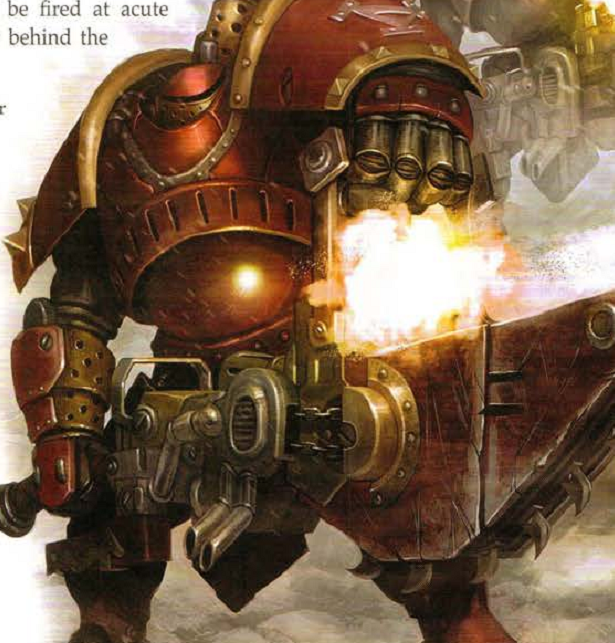
Man-O-War Bombardiers blast the enemy apart as they advance, armed with grenade cannons and enormous chain blades. The blades do terrible damage to the living, and the grenade launchers mounted above them fire hand-loaded rounds at the foe, sometimes at acute angles to target those behind enemy lines. Alongside other Man-O-War troops, they are the core of Khador's heavy shock forces. They move slowly due to their immense steam-armor, but their impressive range makes up for that. A line of bombardiers advances slow, but is mobile artillery. By the time they hit the neemy, they've already scattered most of them, chewing up the rest with the chain blades - even heavily armored warjacks.
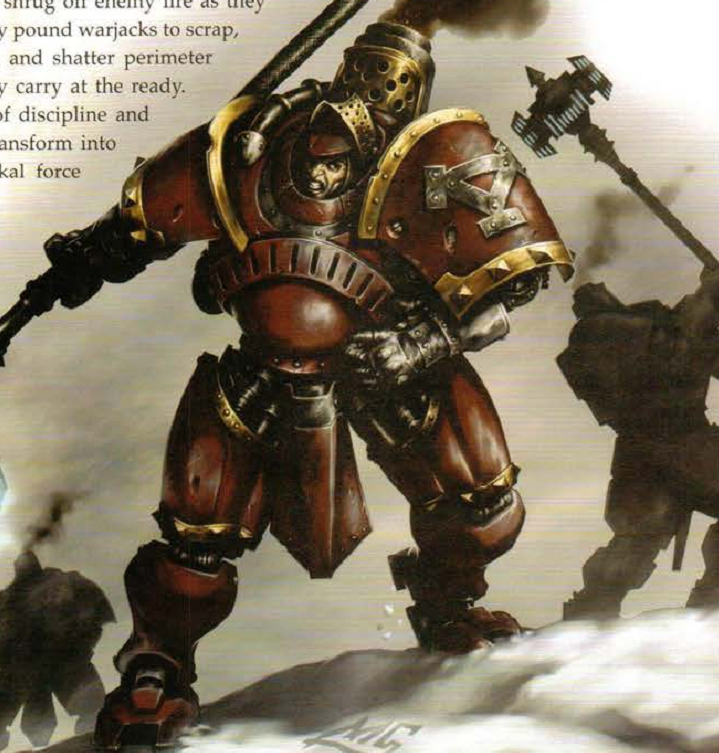
The Man-O-War Demolition Corps is the premier siege assault force of Khador. Each member wields an immense mechanikal ice maul made at Rigevnya Complex, which use super-cooled air to flash-freeze metal and flesh. Armor breaks into shrapnel under these hammers, and with the strength of the Man-O-War suits, they can cripple even warjacks and shatter stone with a few precise blows. When the armor was first developed, High Kommand wanted to prove that siege warfare could be solved by brute force, and every volunteer to join the corp must pass an obstacle course nicknamed the Crusher, a three-day test of endurance and strength. Those who succeed emerge transformed. When they are unleashed, they rely on their armor to shrug off fire as they close with foes, pounding them to scrap easily. They are disciplined and fearless, an unstoppable force of mechanikal might.
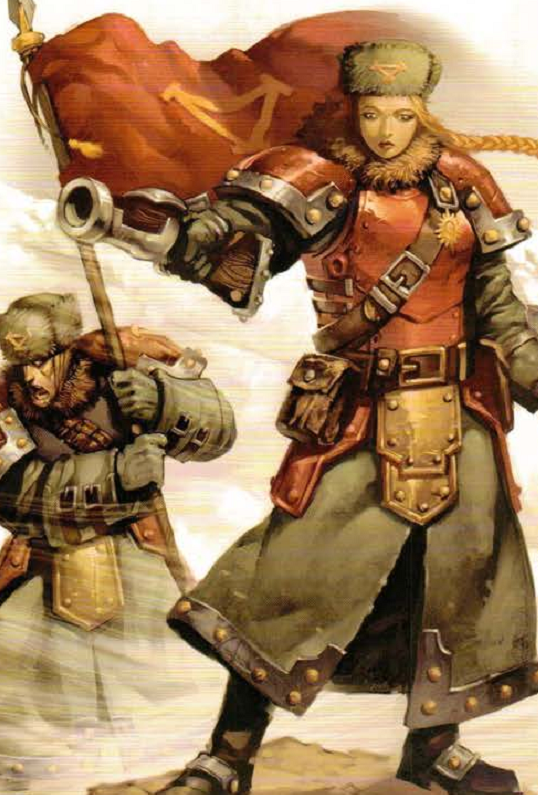
Winter Guard units are sometimes led by a Winter Guard Officer and STandard . Even the lowest ranking officers of the Guard are heroes to the people, leading at the front. More and more young officers are sent directly to the front now after graduation from Druzhina. They are drilled mercilessly to ensure battle readiness, preparing them to push their units beyond their limits. Their harshness, tempered by a fair hand and centuries of tradition, gets them respect, admiration and even love from their men. The honor of serving as standard bearer, however, is earned only on the field. It is a great inspiration for the common soldiers to see one of their own picked ti become a symbol of Khador, and any soldier brave enough to place the colors of the Motherland before their own life is a true patriot. They can marge into battle, knowing that if they fall, one of their fellows will catch the standard before it can hit the ground, taking up the duty.
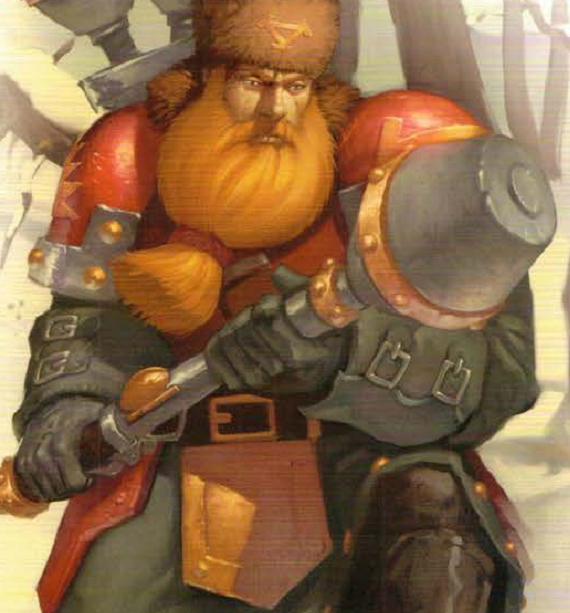
Winter Guard Infantry Rocketeers are armed with weapons looted from the alchemists of Llael, man-portable rockets of immense power. They are specialists, usually bold and loyal Khadorans who are trained to care and handle these volatile weapons, though using them is very easy. Their first appearance was a shock to Khador's foes, accustomed to the Winter Guard's short-range guns. Thhe rockets are much longer range, blasting holes in enemy formations and suppressing fire long enough for the Witner Guard to close and mop up the survivors. Khadorans have determined that rocketeers boost Winter Guard morale, and kommanders use them whenever possible.
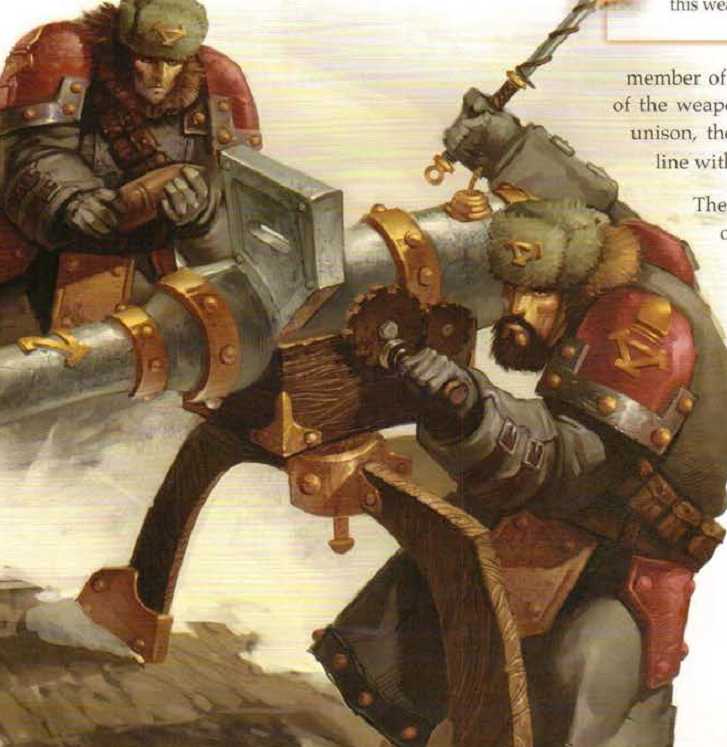
Winter Guard Field Gun Crews use amazing modern weapons, designed in response to Supreme Kommand Irusk's mandate for powerful artillery. It would have been impossible less than a decade before, but advances in manufacturing have been spurred on by the war effort. Prevision machining allows the creation of each part of the gun, from the tempered barrel to the accurate shells. Sometimes, it is mistaken for an antique deck gun, but it's a devastating weapon that, in firing position, can destroy anything. Three men crew the gun to aim, fire and reload it after countless hours of drilling. For efficiency and practicality, each member is trained in all aspects of operation and maintenance, using the guns to blow holes in the enemy line. A field gun can take out even the hardest targets when used properly.
Next time: The Great Bears
Forces of Warmachine: Khador
Original SA post Forces of Warmachine: Khador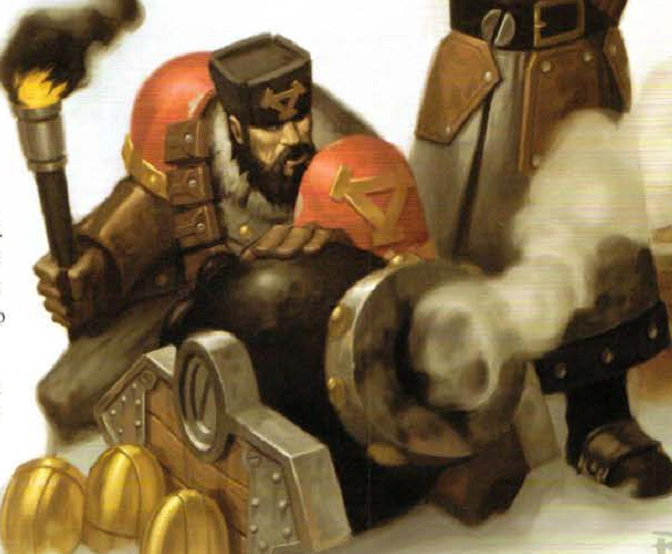
The Winter Guard Mortar Crew uses a light mortar developed under Kommandant Irusk's orders. They were first deployed against Llael, and were pibotal, as the defenders were unready for light artillery that could rapidly reposition and adapt during battle. While sitll quite heavy, each mortar is much lighter than traditional artillery and much easier to operate, maintain, build and deploy. They are cheap but very effective, making Winter Guard companies that use them even more self-reliant. Even one mortar crew is a lot of firepower, and many of them can unleash protracted barrages. The Winter Guard charge under the rolling curtain of mortar fire until just before they hit the enemy lines, forcing the enemy to take cover and leaving them stunned and demoralized. The mortar's relative inaccuracy at short range has led to some deaths by friendly fire, but most officers just shrug them off as the price of war.
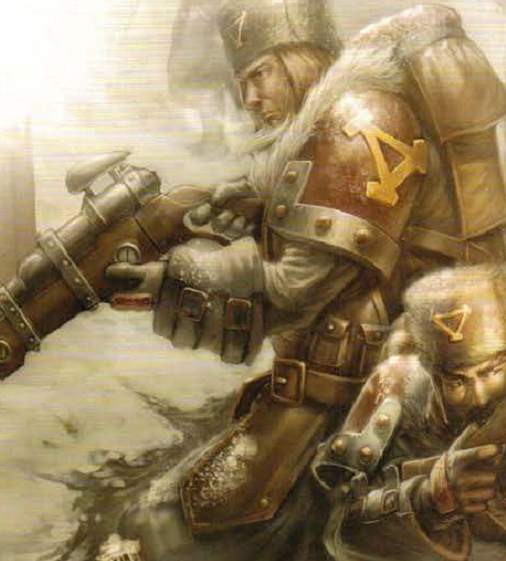
The Winter Guard Rifle Corps are trained with longer-range rifles than the traditional Winter Guard blunderbuss. They are an experiment, and a very successful one, funded by the kayazy and stolen weapons. EAch company is from a specific region and is attached to an existing Winter Guard platoon. They get advanced training with their Blaustavya rifles before returning to the front. They have weeks of intense drills, able to fieldstrip and reassemble their rifles in seconds and aim, load and fire in concert. Even as they load one round into thge breech they are taking aim, and when ordered by their sergeant, they produce immense volumes of fire to suppress entire regions. They train continuously in formation firing, kneeling and moving aside so they never block fire lanes for their neighbors. All their training combines into some of the most reliable troops in Khador, with a growing reputation for deadliness.
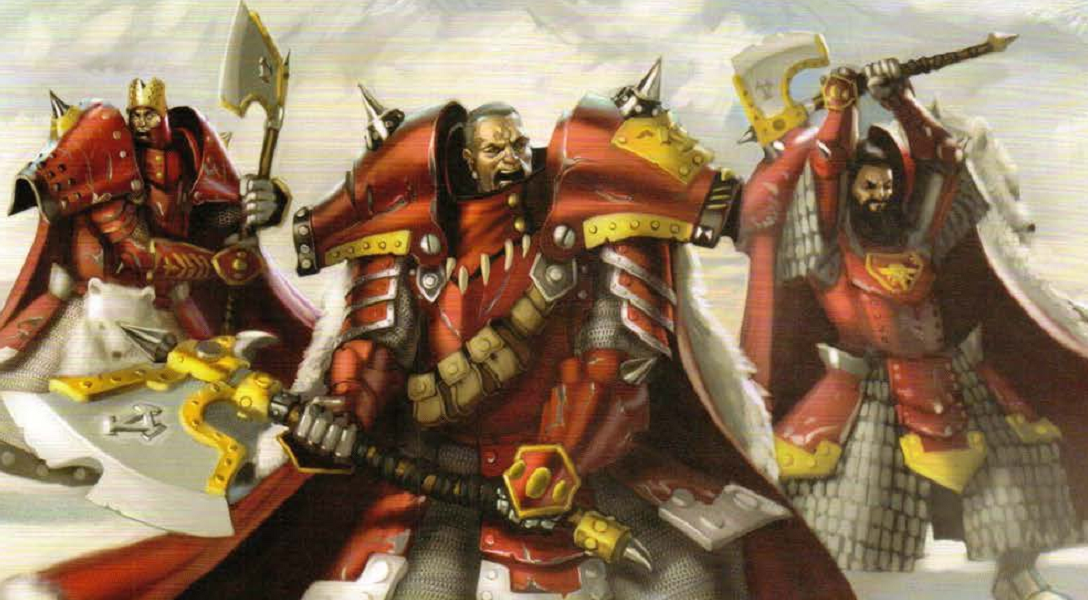
The Great Bears of Gallowswood are the survivors of an Iron Fang kompany once based from Kragvold Fort, a border fortress between Ord and the Thornwood. They have earned a reputation for honor and self-sacrifice, and even their names can silence a room in respect. Joreslev Vokov, sixth generation Iron Fang, earned fame while still a lieutenant, getting the Shield of Khardovic and Sash of Valor in a series of engagements near Fellig, destablizing border garrisons and fighting Cygnaran marcenaries. He earned the honorific 'Fang of the First bear' at the young age of 22, the youngest ever to do it, by leading his squad and defeating five times their number at Karlwine Creek. In 503, the Cygnarans grew tired of their losses and decided to destroy Kragbold. Volkov led the defense besides Moskor Kolsk and a young scrapper named Kartov Yarovich. These three gave up the fight only when they could no longer bear the weight of the Cygnaran dead pressing down on them. Every foot of ground they surrendered was paid for in blood, and when Volkov eventually realized the fortress had fallen, their retreat was met by Cygnaran cheers. The Great Bears were furious at the destruction of their home and the death of their comrades, and High Kommand wared each of them great accolades, but they didn't car.e Volkov refused to reform the kompany even after promotion to kapitan, pointing to his two companions and claiming they carried the weight of the fallen. Seeing the three in battle thrills other Khadorans. They have fought pretty much every battle in the last fifteen years, often turning the tide. Volkov is admired by every officer, and he has an uncanny knack for showing up where he's needed. Kolsk's Savers of Service testify to his 20 years in uniform, and he is the lieutenant every kapitan and kommandant dreams of. He never questions orders and can execute even impossible plans. Yarovich is called the Brute, but affectionately. Once, a kovnik baited him into a drunken brawl, and Yarovich killed him with a single punch. No one picks fights with him now, and in battle, he roars with laughter as he kills.
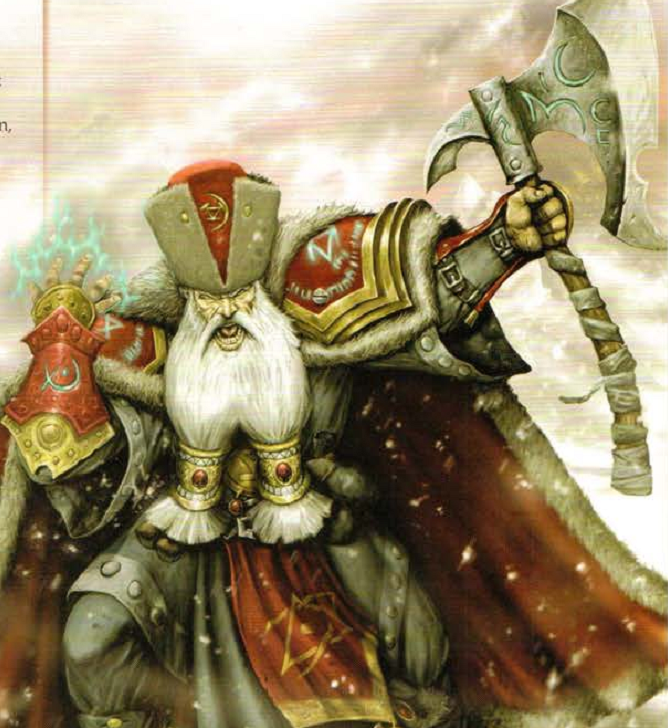
A Koldun Lord is a master of elemental cold and a master axeman both. They are the ideal of the Greylords Covenant and deeply respected. When they enter battle, they sometimes lead ternions, and are themselves veterans of service and combat sorcery. With each kill, they grow bolder, hurling freezing death. Koldun lords often control warjacks in battle, both as weapons and bodyugards. They use spells of protection to turn the jacks into iron walls, intercepting blows and spells better than any shield could. Many Koldun lords have mastered the arts of cortex construction and know better than most how to bring out superior performance.
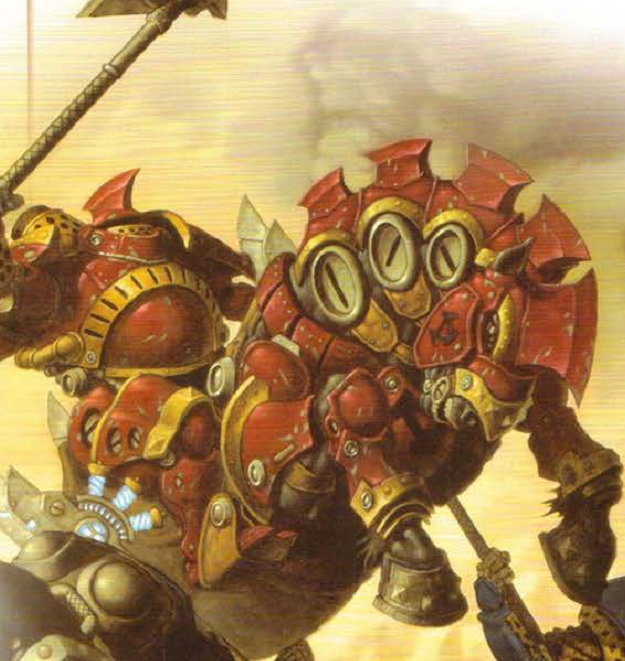
A Man-O-War Drakhun is a traditional champion of the modern age, wearing steam armor atop an immense Karpathan destrier. They are a mechanikal force of destruction even dismounted, and they can charge into battle faster than even the lightest warjack. They are not trained or chosen - they are destined from birth. Only the most potent, with uhlan blood, raised in the saddle, can petition to become drakhuns. Even then, they must train extensively as a Man-O-War, mastering their armor and training their horse themselves before they can ride it into battle. The power of a Karpathan destrier is legendary among the uhlans, dwarfing any other horse in Immoren. These beasts are as much weapons as the annihilator axes and the shield cannon that they bear into battle. The charge of a drakhun can pound bone flat and mash flesh to paste.
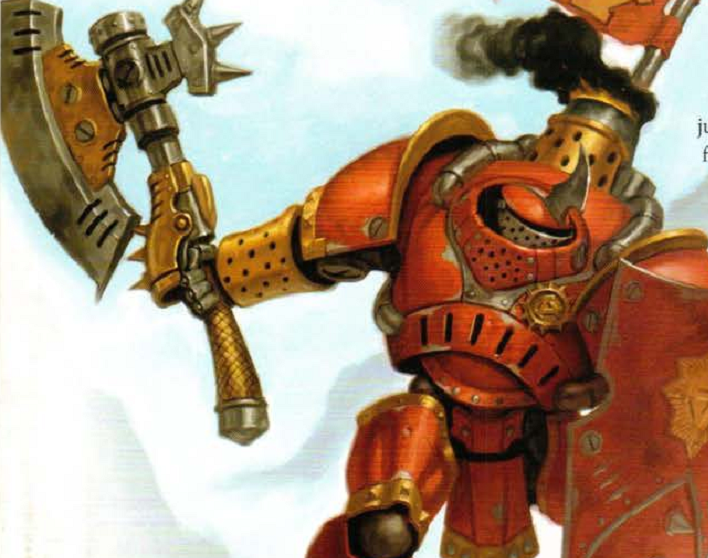
A Man-O-War Kovnik is the standard by which High Kommand judges officers. They are fearless leaders who lead from the front, with a full understanding of the power and limits of their mechanikal armor. Their expertise allows them to follow the warjacks they command into the most dangerous parts of battle, directing attacks with precision. Their close work with 'jacks has taught them to take advantageo f their armor as well, using its resilience and strength to slam into enemies with the force of a small warjack. Years of service among the shock troops and demolitions corps turns the kovniks into weapons, trusted to lead battalions or legions. They execute plans mercilessly and efficiently, and even veteran warcasters trust their judgment and leadership to inspire soldiers. High Kommand knows that if victory is possible, they will achieve it, and that they will not sacrifice lives carelessly.
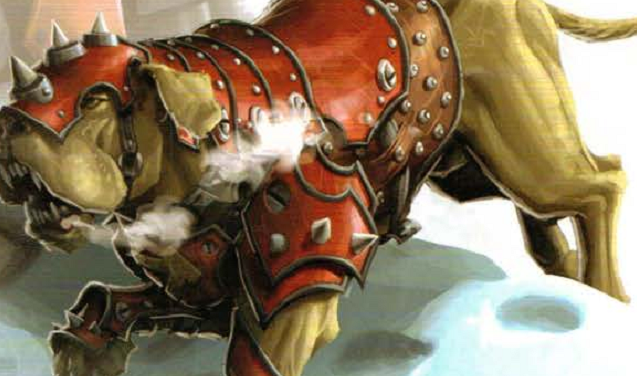
The breeding of War Dogs is an artform in Khador's lowlands. They are two hundred pounds of raw muscle, and many philosophies compete to best excute the tradition of breeding them, with entire family lines resting their honor on the skill of their dogs. Khadoran officers commonly bring them into battle as companions and protectors. While the ignorante prefer the most savage and bloodthirsty dogs, experts see those as the worst of the breed. Their loyalty is their best asset, especially for warcasters who have to divide their attention and can't afford to focus on an unruly dog, however deadly it is. Thus, the favored breed is the Kovosk bullmastiff, a stout animal that takes training well and instinctive desires to protect a human master it bonds with. With a trained war dog, a warcaster can focus on other matters while hound serves as a second set of eyes, latching onto foes and refusing to let go. They hunder more dangerous threats until they can be dealt with, and their loyalty means they'd be glad to die to save their bonded master.
Next time: The Greatest Warriors
Forces of Warmachine: Khador
Original SA post Forces of Warmachine: Khador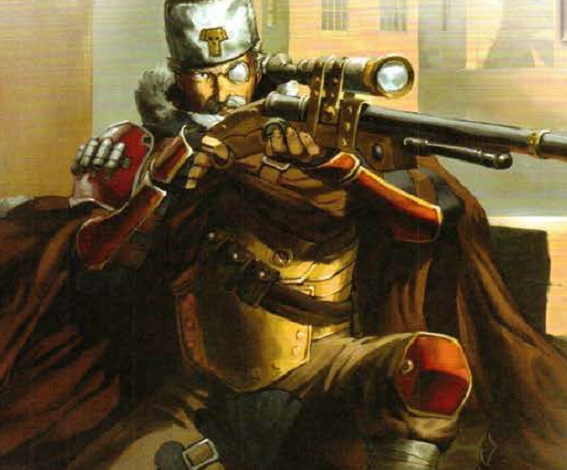
A Widowmaker Marskman is the best of the best, the top tier of Widowmakers. Few make the cut, but they are more than worth their rarity. They operate independently as highly specialized snipers and stealth agents, selecting their targets by those who will hurst the foe most, regardless of rank. They neutralize their prey with one shot, then reposition quickly. They miss nothing, and are excellent at silent communication of targets to other Widowmakers. They are equipped with a special variant of the Vanar Liberator rifle, a more powerful weapon than the custom Vislovski hunting rifles issued to most Widowmakers. Their rounds can ter through plate armor and are extremely accurate in marskman hands. Some say the added heft of the rifle itself is an advantage, increasing stability.
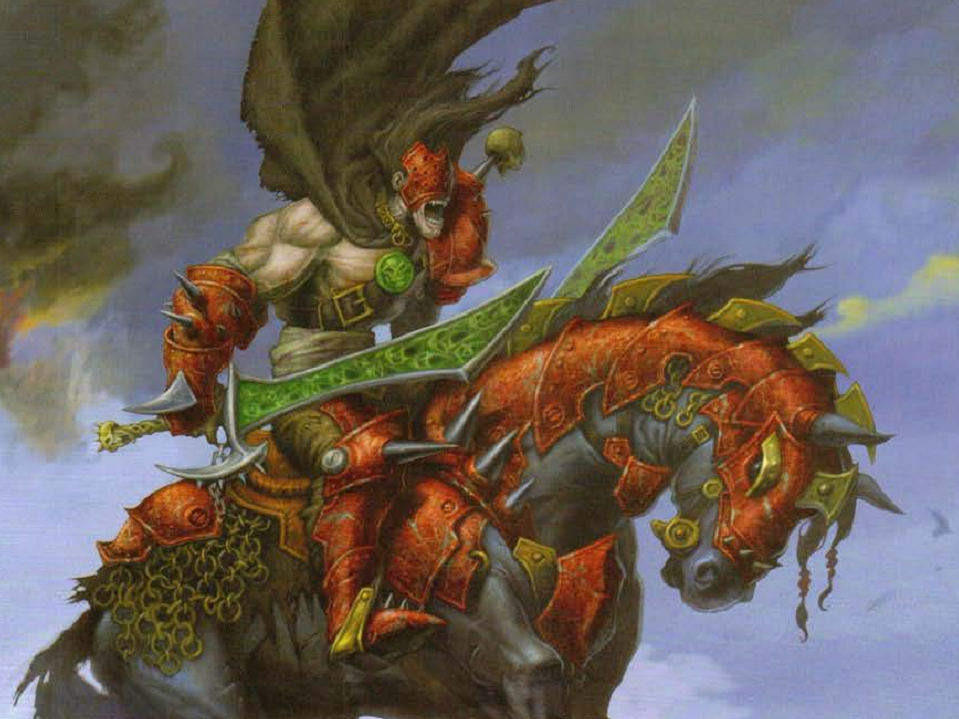
The most fearsome doom reaver is Fenris , called the Unbound because not even the Greylords Covenant can control him. He rides into battle on a nightmare steed, wielding two fellblades at once. The doom reavers follow him without hesitation. No one knows who he once was, and the records of his crimes vanished decades ago. Most assume he was a mass murderer, but none know how many or who. Some say he was a cannibal raised in the mountains, others that he was an assassin overwhelmed by love of murder. Whatever the truth, he took the fellblade as if it were a missing part of his soul. His ability to ignore the conditioning and restriants placed on the doom reavers by the Greylords was always troubling. He'd disappear for days, returning covered in blood. The army would have destroyed him if not for the start of war. His skill at battle and the ease with which he shrugs off wounds might have made killing him difficult, though, and some believe he is immortal. Khadoran officers speak of Fenris only reluctantly, but he has a place. Only Orsus Zoktavir can control him, for he seems content to serve the Butcher of Khardov, and they share a joy in annihilation. Fenris' mount is barely recognizable as a horse, and more closely resembles a monster. The Winter Guard found it wandering near Ravensgard and it was ordered put down after two men died restraining it. Fenris arrived just before it was killed, taking it for his own. After battle, it lingers to feed on the dead - and nothing else.
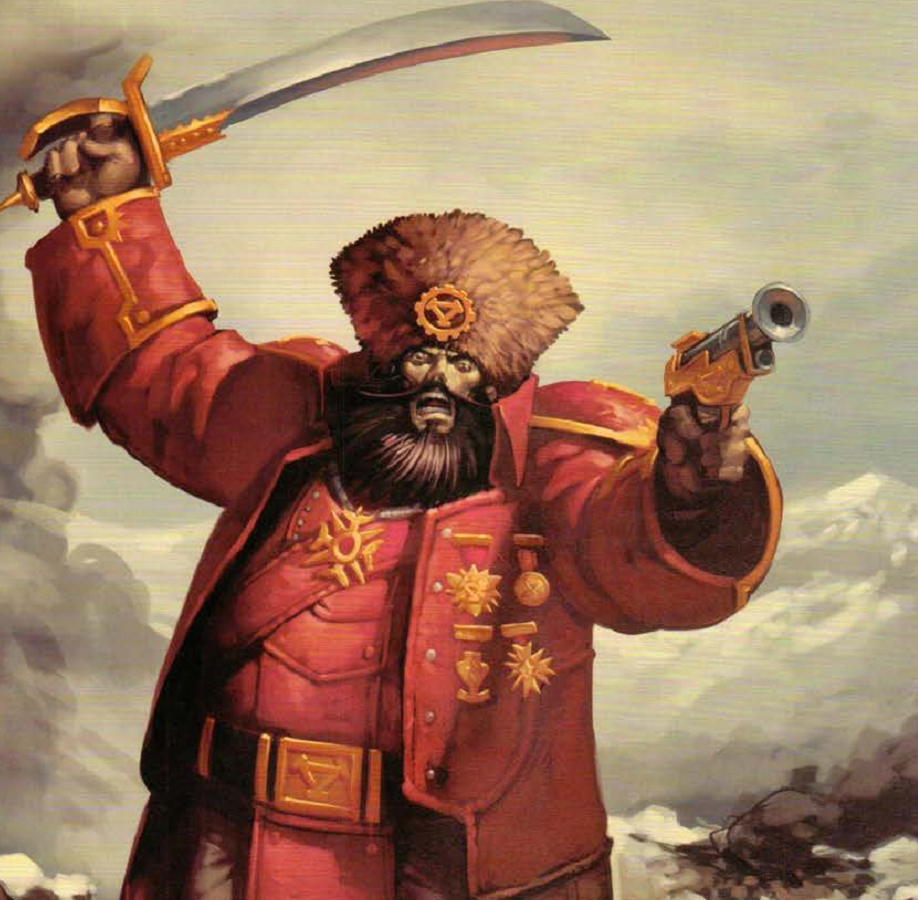
Kovnik Jozef Grigorovich is one of the Winter Guard, and he knows that they are more than the backbone - they are the Army. Jozef is the embodiment of military diiscipline and fearlessness, the fighting spirit of Khador. He does not question orders. He does not dwell on losses. He moves forward and claims victory. He knows no war is won without blood, but he is not reckless. He asks nothing of his men he would not accept himself, and he would die for them. He is a shrewd tactician, praised even by Irusk. The secret to his success is his ability to spend the lives of his soldiers only when he must. Even by Khadoran standards he's a big, big man, and he's older than he looks, a Skirov who enlisted under Ivad Vanar. Many men younger than him have retired to High Kommand or taken higher command posts. He thinks they are jealous of him, for he gets the joy of battle and the chance to kill the enemies of the Motherland. He has served many posts, reenlisting whenever he can. He was at Midfast, Port Vladovar and even the peaks near Rhul. It took 20 years for him to find his true home: the Unbreakable 111th Infantry Battalion in the First Border Legion. Since his transfer in 593 AR, he's refused to leave, enjoying the fight against Cygnar. In 598, he accepted a promotion to full kovnik only because it came with command over the battalion. He commanded the 111th for years during war between Ravensgard and Northguard, becoming one of the most recognizable and trusted officers on the front. After Northguard's fall, he and the 11th were among those pursuing the Cygnaran First Army, pushing them past the Dragon's Tongue. Grigorovich now looks acrtoss the river to Corvis, anticipating the orders that must soon come. He is famous as an orator, his voice rising in eloquent speeches to push his men to heroism and sacrifice. They will die to protect him and Khador.
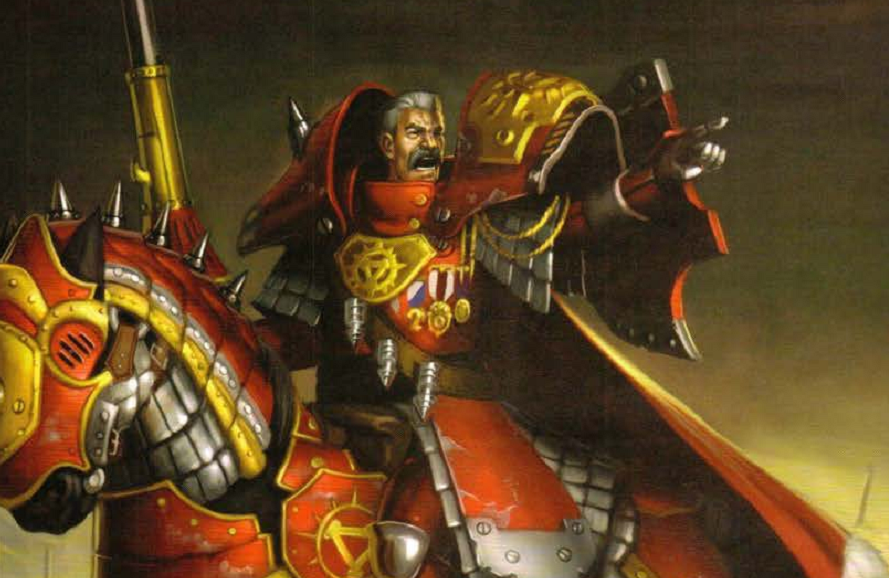
Uhlan Kovnik Markov , first name Dorek, is descended from the ancient horselords and represents all the Iron Fangs revere. Under him, the 29th Assault Battalion advances as one body with one mind, unwavering no matter what the casualties. Markov sees every Khadoran soldier as kin and the Iron Fangs as his dearest brothers. He grew up as the son of an uhlan, training from birth to care for his steed and learn the uhlan traditions. Years after earning his commission, he had the rare honor to serve alongside his father, and they fought together against Cygnar. He will always remember the day he saw his father die to the Cygnaran Storm Lances, how he rallied his forces and drove them from the field but could not save the older man. The quiet dignity with which his father accepted death left a lsting impression, and he vowed to do the man justice. Markov serves alongside the 2nd Army's Iron Fangs, and has earned nearly every award Khador offers. His battalion was critical in the early battles of Llael and at Merywyn, and his sterling record was why Irusk chose him to lead the 4th Assault Legion, spearhead of the 2nd Army. Markov's Pozdyov horse, Gorvech, carres him into battle alongside the pikemen under his command, conditioned to endure the chaos. Markov uses a custom concussion lance, which detonates its tip against foes while he and his mount emerge unharmed from the explosion. Markov is as skilled with tactics as any kommandant, and is one of Irusk's most trusted officers, and they frequently talk together, dissecting recent battles. When preparing for the second assault on Northguard, Markov was entrusted by Irsuk to lead the diversionary force, drawing away two warcasters and leaving the fortress vulnerable to attack. Markov not only succeeded but survived with the core of his forces intact. He expects and receives the best from his men, pushing them as hard as he can. He has their respect for sharing the dangers, and they desire his approval. A single scornful look or a shoulder slap of congratulation from Markov is more than a diatribe or speech from a lesser officer. His quest strength is an inspriation and a reminder of Khador's ancient nobility.
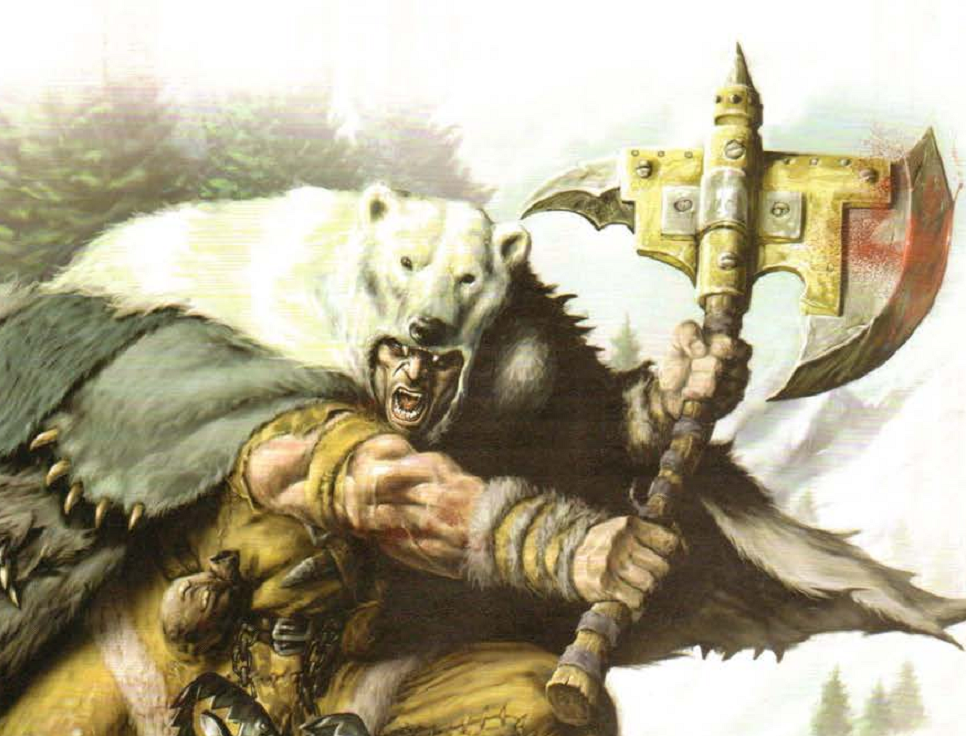
They call him Yuri the Axe , a brutal killer from the Nyschatha Mountains. He is a patriot, for all he scorns the law. Many see it as criminal that he walks free and would kill him if they could, though he claims he never killed a man who didn't earn it. Yuri kills not out of malice, but because he is a hunter by nature. Killing is an easy, expedient solution for him, men as well as animals. He moved easily from animals to men, hunting for bounties on outlaws, and the thrill appealed to him, soon tracking a rogue kompany that had turned to extortion near Uldenfrost. Yuri methodically eliminated them over weeks, and those he did not kill died of cold and starvation, too afraid to leave their barracks. Words of his deads spread, and even the Nyss learned to avoid him, naming him slyeshar, the maddened bear. The dstruction of the Winter Guard kompany dry the attention of the 3rd Border Legion, who tried to capture Yuri. He made a game of leading them into ambushes, traps and deadfalls, and eventually several local manhunters and agents in service to Great Prince Bolovric were set on him. Yuri delighted in testing them, calling them out and killing them. It took a concerted effort of the 3rd Border Legion and a team of Kossites and Widowmakers to finally corner them, and he killed half before they wore him down and dragged him in chains to trial at Tverkutsk. Yuri still managed to murder his captors and escape into the Scarsfell. At last, the four great princes of the north decided that pressing him into service would be cheaper, offering him amnesty for service. He accepted enthusiastically, and he's been true to his word, killing the foes of Khador whenever asked. He has a following among the Khadoran wilderness fighters, many of whom seek him out to learn the ways of the hunt and kill. Yuri has no friends, but has a camaraderie with Fenris and the Butcher of Khardov. When Orsus Zoktavir went missing after Fellig, some thought Yuri was responsible, but their camaraderie has dispelled those rumors. The Winter Guard shudder to see them keep company together.
The End!
What's next? Cryx, the Protectorate of Menoth, Mercenaries, the Circle Orboros, Skorne, the Legion of Everblight or the Trollbloods?
Forces of Warmachine: Cryx
Original SA postCryx first, then the Circle, then Menoth.
Forces of Warmachine: Cryx
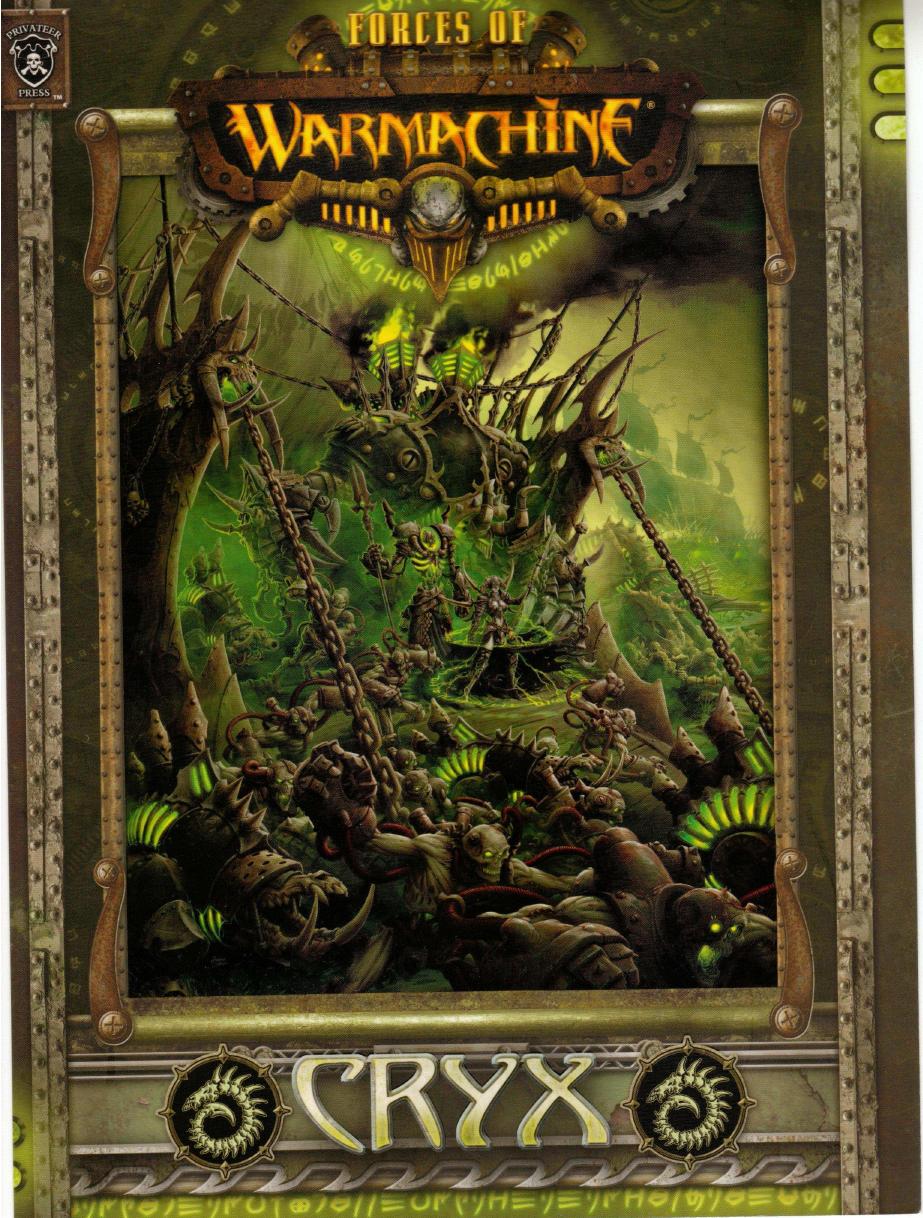
Cryx is the Nightmare Empire, undead and necromancers in service to the Dragonfather, Lord Toruk. They need no crops, they are infinitely patient, they are utterly unlike anything normally associatedi with a nation. They use dark magic to tear away the enemy's defense, allowing their swarms of undead to tear them apart. Their armies are very hard to truly destroy - they just keep standing up.

For centuries, most outsiders have had no idea how strong Cryx really was. Their attacks, while terrifying, were rare and apparently random. They could not see the underlying great plan, for Toruk's patience and that of his Lich Lords is legendary. They have no interest in conquest even now, seeking only one thing: the destruction of all other dragons. Once the nations of men are fallen, Toruk will drag his progeny from their holes and devour them. While this goal has never changed, Toruk's armies have evolved with time. When he first took control of the Scharde, he first commanded his lich lords to subjugate the islands and their cities. The few resistors were annihilated in days, and Cryx was born.
Toruk gave his lich lords the secret of thrall runes, which turned corpses into servants, with more intricate runes giving more power. Even they could not, however, comprehend Toruk's power or lore. They were left to derive new methods, better suited for mortal minds. Before long, they were able to create a great horde of thralls and a few more cunning leaders. These simple undead were used to build the city Skell and the palace of Toruk, where he is worshipped and rests. It was not long before the liches gained spies on the mainland, noting all of human warfare and invention. Cryxian agents stole the corpses of the greatest minds, stripping them of their secrets by necromancy, and the Cryxians pursued any weapon for Toruk's war.
Toruk's great army remained unknown to the mainland, who saw only occasional raids, and the undead fleet led by the Atramentous preferred to strike isolated towns and ships. The coming of the Orgoth was one of the few things to catch Toruk's interest, forestalling Cryx's own invasion of the mainland. The Orgoth had a unique necromantic tradition and much in the way of useful relics and lore. They conquered the mainland, and while Toruk destroyed their fleets when they came too close, he let them land on Garlghast to observe them better. The Orgoth ruled the mainland for centuries, but the oppressed rose up, aided by the gift of sorcery from the goddess Thamar, using it and technology to create the first mechanika. The Cryxians found this fascinating and quickly produced necromantic equivalents, plundering the bones of arcanists for lore on sorcery and mechanika to create a new necrotechnological tradition. Soon, they were even able to augment their thralls with steam engines.
The discovery of necrotite as a fuel source was a massive breakthrough. The lich lords hadl ong experimented with using souls to replace or supplement coal, but it was an impractical and limited resource. Necrotite, however, was a combination of coal and the residue that accumulates beneath battlefields and other places of suffering and death, and it could be used to fuel machines, sustaining heat much longer than normal coal. The substance is toxic to the living in prolonged exposure, but Cryxians are fine. They learned to refine and concentrate necrotite, learning to extract it even from new battlefields, and it gave them a potent and unending source of fuel. They watched the Immorese fight the Orgoth, and when the first colossal was made, they wasted no time in stealing the secrets of the cerebral matrix, which served as the cortex for colossals.
Eventually, the Orgoth were overthrown and retreated to Drer Drakkerung, their city on Garlghast. Toruk sent his armies to steal their final secrets, but after terrible losses, the Orgoth chose to self-annihilate rather than surrender. Most of the Cryxian army was destroyed, along with three of the five lich lords leading them. Toruk didn't care - it was a good outcome, and the secrets of the Orgoth were taken from them in death. The tradition of warwitches, most notably, was stolen from the Orgoth and now survives only in Cryx.
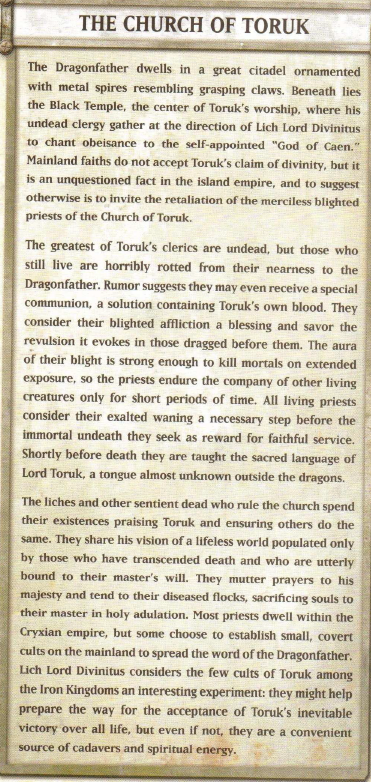
The mainland improved on mechanika over the centuries after the Orgoth, and Cryx studied the new warjacks, working to bend the purely technolpgical cortex to their will in order to make the first helljacks. Their designs were influenced by sightings of the Deathjack, a strange machine apparently made by some insane mainland necromancer. All attempts to find the machine itself's origins and design failed, but its shape inspired the designs of the things that would become the Slayers, Reapers and other helljacks.
More recently, Toruk has sent his forces into the mainland, while the lich lords that remain in Cryx support the armies with research. If the mortals of Immoren had any idea the level of the machinations against them, they would set aside their differences to destroy Cryx. Thanks to much long manipulation and very longterm planning, Toruk has ensured this does not happen.
The armies of Cryx are led by twelve immortal lich lords, created to serve Toruk's will, though at times their own goals distract them. Each was personally selected by the Dragonfather to govern his empire, and each has ruled for centuries, some a full millenium or more. The first lich lords were the pirate kings of the old Scharde Islands who bowed to Toruk at Dragon's Roost. Two of the fourteen kings defied him - King Threnodax, whom Captain Rengrave of the Atramentous served in life, and King Moorcraig, who fled to his castle in the hopes of defending himself. Both were annihilated, their souls bound to endless torment, while the twelve that bowed were given immortality. Their domains have changed over time with the needs of the empire, and the last 16 centuries have seen more than half their original number die. Some fell to outsiders, some to peers. Betrayal is routine in Cryx, where only the strong and brilliant thrive. Toruk forbids open war between lich lords, however, as it would distract from his work.
Within the last 30 years, Toruk's plans have reached a critical point, and Cryxian forces are active far beyond any precedent. These armies, known as incursions, were once overseen by Lich Lords Daeamortus and Terminus, who led from afar. The Scharde Invasions, as the mainland knows them, were planned to disguise the movement of the incursions into the interior, relying heavily on vassals like the Iron Lich Asphyxious to direct the mainland work. Even before he destroyed Daeamortus, Asphyxious was essentially a thirteenth lich lord, and now he is considered one of their number, having torn down his old master. Both he and Terminus are permanently stationed alongside their incursions now. Lich Lord Venethrax, expert on the dragonblight, is tasked to find Toruk's children, and is the most recent lich dispatched to the mainland, to initiate dragon-seeking operations in response to a perceived change in the draconic stalemate.
Technically, Lich Lord Scopulous is a fourth military leader, commanding the reserve forces. He supports the incursions with a stockpile of thralls, weapons and necrotite as well as commanding the home garrisons against counterattack. He coordinates with Terminus to ensure a steady supply chain, but Asphyxious has made the work less urgent by creating an autonomous war industry in the Thornwood. When the armies of Cryx last marched at full strength, it was against the Orgoth at Drer Drakkerung, but the warwitches of the Orgoth destroyed the city, wiping out most of the army and all but two of the five lich lords leading it. Those two, Tenebrus and Fulmenus, were reduced to spectres, and they are now the Dragonfather's experts on occult lore.
Next time: More history.
Forces of Warmachine: Cryx
Original SA post Forces of Warmachine: CryxAs the Orgoth secrets were claimed, Toruk raised up new lich lords to replace the lost ones: Terminus, Thalassina and Angorus. Thalassina was given the task of steering the affairs of human kingdoms, with the aid of Malathrax's spies. Few mortals could understand her nearly prescient and subtle schemes, and she quietly became one of the most influential beings in Immoren. Toruk himself had trouble distinguishing between rulers, given their frequent death and replacement, and he relies heavily on Thalassina to control humans. Angorus and Divinitus, meanwhile, remain in Skell to oversee the treasury and Toruk's cult, respectively. They rarely leave the city, and Angorus' agents collect tithes from the Cryx pirates and mortals, overseeing spending on major resources such as necrotite. Divinitus spends more time with Toruk than any other, directing his priesthood.
Lich Lord Corripio controls the Archive of Skell, an immense library of stolen lore, with many books the mainland believes lost forever. In particulary, it is incomparable in matters of Orgoth lore. Until recently, military production was controlled by Morbus, one of the original lich lords, who went to the mainland in 608 AR to take control of Asphyxious' necrofactoriums and ensure Venethrax got the tools he needed. However, Morbus was destroyed in a suspicious ambush, and his position remains vacant until Toruk chooses a replacement, which could take some time. In the meantime, Asphyxious has de facto control of Morbus' domain, mainly focused on his own local industry, while his work in Cryx is being done by Master Necrotech Mortenebra and Lich Lord Scopulous.
The hierarchy of Cryx is a simple pyramid, with Toruk at its peak. Below him are the lich lords, with near absolute power in their domains. Serving them are individuals of great power - field commanders and overseers with varyied and useful abilities, such as the iron liches, necromancers, some sentient undead and other, stranger things. They have a lot of freedom in how they serve, and many scheme for their own advancement. The most effective and ruthless have sometimes risen to become lich lords themselves, and it's a common goal.
Cryxian warcasters, living or dead, invariably rise to prominence on their power as leaders in battle. They transcend their stations to command forces as large as they can manage, and they are willful and hard to predict. The most potent other vassals are warlords risen through the ranks on wits, skill and power. Some, like Gerlak Slaughterborn or Darragh Wrathe, are living champions of great skill, while others, like Bane Lord Tartarus and Captain Rengrave, are particularly potent undead.
Most Cryxian forces are thralls or necromechanical monsters, but they do have living soldiers. Only two groups of mortals really get any respect - the Satyxis and the warwitches. The women of the isle of Satyx were blighted a thousand years ago by the blood of the dying dragon Shazkz after Lord Toruk consumed his athanc. The men withered and the women became something more, embracing even further their culture of cruelty and blood sacrifice. When Toruk came to them, their queen immediately knelt to the new god, and the Satyxis have since served as reaver witches and raiders. The Orgoth, meanwhile, did not annihilate themselves as wholly as they'd hoped, and some warwitches were captured alive, given the chance to serve or die. They shared their magical traditions with Cryx, and they were subsumed into it, producing some of the most potent mortals in the entirety of the Nightmare Empire.
Over the last 20 years, Cryxian incursions have successfully infiltrated the mainland, establishing bases in the Wyrmwall and Thornwood, favoring underground tunnels. They have begun to establish the infrastructure to produce necromechanical tools there. These facilities are located near places of slaughter, where necrotite can be mined to fuel them via hidden mining rigs. Most of the materials used to make thralls are stolen from battlefields and graves, with the ancient dead used for banes and skarlocks while more recent ones become bile thralls or mechanithralls. Cryx notices most battles in Immoren, coming afterwards to loot the corpses and salvage mechanika. Their spy network is small but has contacts among the government of every mainland nation, though these informants rarely know the end results of their work, focused only on the wealth they are given for it. This data, in aggregate, allows Cryx to track troop movements and subtly influence battles. Other Cryxian minions hunt for artifacts and lore or for dragons, sometimes unsupervised for centuries until they can be collected after finding something useful. Often, they have no awareness of the bigger picture.
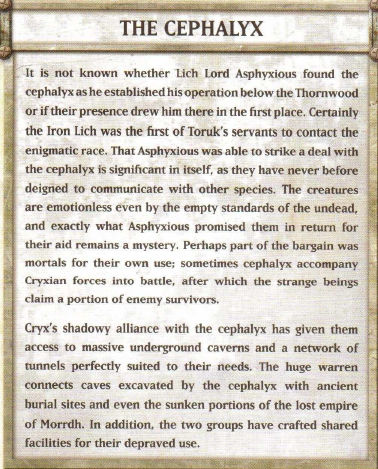
Several necrofactoriums under Thornwood are the focus of the mainland war effort. Combined, the Thornwood hub is second only to Skell in size of industry, but the only sign of them above ground is a few smoke trickles. The Khadorans falsely believe they control Thornwood, but fear its heart, where entire patrols have vanished. Asphyxious created the network, but Master Necrotech Mortenebra oversees its operation. Her machine logic has exponentially increased production in the facilities, which are equal parts factory and surgical theatre. Huge numbers of specially made thralls and helljacks pour from them, and mortals are dragged in for vivisection under the light of necrotite-powered forges. In but a few years, Cryx has made its way to the heart of Immoren, spreading like a cancer.
The fleets, on the other hand, have been the face of Cryx for centuries. Their armada is drawn from many Scharde pirate forces, and they are one of the premier naval powers. Lich Lord Terminus oversaw the fleets for centuries, but since taking charge of an incursion, he's left it to Skarre Ravenmane, who unleashed the fleet's full power on the western coasts. Her attacks have gone as far north as Khador and as far south and east as the ports of the Protectorate. The heart of the navy is the Black Fleet, and the mere sight of a blackship is a portent of doom. They carry their own weather, with unearthly wind and fog moving them and concealing them. They were made with Orgoth secrets, more than equal to any mortal vessel, and only the most modern ironhulls can stand against them. They are made in Dreggsmouth by Master Shipwright Kress Soratt, who answers to Lord Captain Derevnia Vrace, onetime vassal of Lich Lord Morbus, who inherited the job from Terminus, who built the original fleet.
Skarre leads the Black Fleet directly, with Satyxis making up the majority of blackship crews. Blackships have the capacity to carry vast numbers of troops, helljacks and other supplies, and their numbers have rarely been seen in full, so mainlanders often underestimate the size of the fleet. In fact, the smallest fleet is the Ghost Fleet, with its numbers varying wildly as the war goes on. The spectral ships have their own advantages - they have their own winds, regenerate from damage and are crewed by apparently endless and indestructible spirits rather than living men. All but the most powerful ships flee at the sight of a ghost ship. These ships serve Captain Rengrave, the first vassal of Toruk and first citizen of Cryx. His flagship, Atramentous, is an enormous dirgenmast, the most ancient ship on the sea. Many sailors will kill themselves rather than face it.
There's also a diverse group of pirate vessels from other nations, the largest but least ordered of Cryx's fleets. They have the largest number of living crew, primarily humans but also sometimes trollkin, ogrun or satyxis. The most satyxis serve on the elite vessels of Axiara's Raiders, led by Axiara Wraithblade, commander of the pirate fleet and servant of Skarre Ravenmane. These ships not only attack other nations and steal from them, they also smuggle - the only real commerce Cryx takes part in. Their ability to find any welcome at all in smugglers' ports makes them valuable to Cryxian intelligence, and the fleet is mostly used as support or diversion. They are historically hard to control and coordinate, but Axiara has helped bring the more volatile captains to heel. They can come together for major raids, using amphibious warjacks like the Leviathan and the Harrower to launch coastal assaults, routing foes in panic.

Warcasters are even more important to Cryx than other nations, as their unthinking thralls need powerful leaders to direct them. Cryx has studied the warcaster talent far more than any others, developing ways to emulate it with technology, at least in some ways. The necrotechs work endlessly and untiringly to experiment in this field, and the Orgoth soul magic lore has helped, especially the soul cages that amplify arcane might. Many Cryxian warcasters are born with sorcerous talent, like their mainland counterparts. Once found, they are watched and trained towards their natural aptitudes, with women often being initiated into the warwitches. This inevitably breaks their minds in useful ways. Others learn from different traditions, such as Skarre Ravenmane studying Satyxis blood magic. Warcaster talent is useful not just for warjack control, after all, but for magical power. The living learn in ways undead do not, and warcasters are kept alive as long as possible before being made undead - the living, for example, are better at divination and prophecy. Still, lich warcasters are more common in Cryx, and most warcasters are reanimated on death. The upper ranks are mostly undead necromancers skilled in necromechanika. Helljack and bonejack cortexes are made to obey the undead as they would the living, and for this reason Cryx has more warcasters than several nations combined.
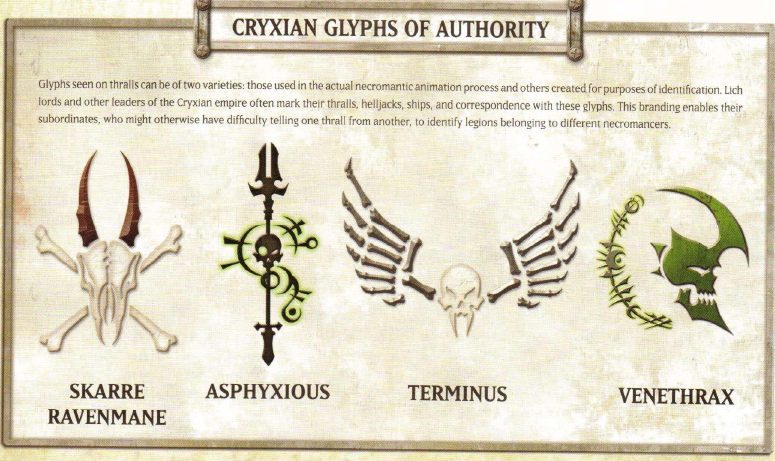
Next time: The masters of disaster
Forces of Warmachine: Cryx
Original SA post Forces of Warmachine: Cryx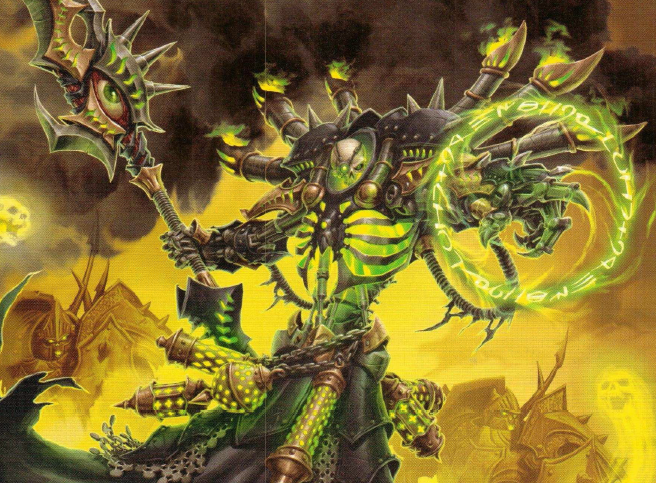
Lich Lord Asphyxious is Epic Asphyxious. For millenia, he schemed and planned, carving out a private undead empire in Cryx. Many have died for his schemes, and not even the other masters of Cryx have escaped his touch. The latest wast the ancient lich lord Daeamortus, whose soul and remains are bound in Asphyxious' new weapon. That Toruk didn't interfere or punish him is proof of Asphyxious' acumen - in fact, he is now in Daeamortus' old station. Now a lich lord, he initiated he next stage of his plan. Under the pretense of making a necrofactorium under Thornwood, he activated the energies of the Temple of Garrodh, an Orgoth artifact which he planned to use to become a god. Thousands died for him to provide the souls needed to power the device. However, his plans were thwarted, in part by Lich Lord Terminus. Still, the entire attempt showed his genius, and Toruk ultimately interceded to stop the two liches from fighting before it could undermine the invasion. Asphyxious immediately began a new plan, negotiating a secret pact with the cephalyx, who live in the caverns under Thornwood. Without their aid, it'd have taken generations to build the necrofactoriums. Even now, Asphyxious works in the Thornwood to expand Cryx's hold. He has not given up on godhood, but is biding his time and cementing his power again. He is aided by his faithful student, Deneghra, whom he reshaped in death to better fit his plan. The Wraith Witch is his right hand now, and he takes to the field even more frequently of late. His gimmick is focused around benefitting from death and causing debuffs, with his feat returning a bunch of lost units to play as wraiths.
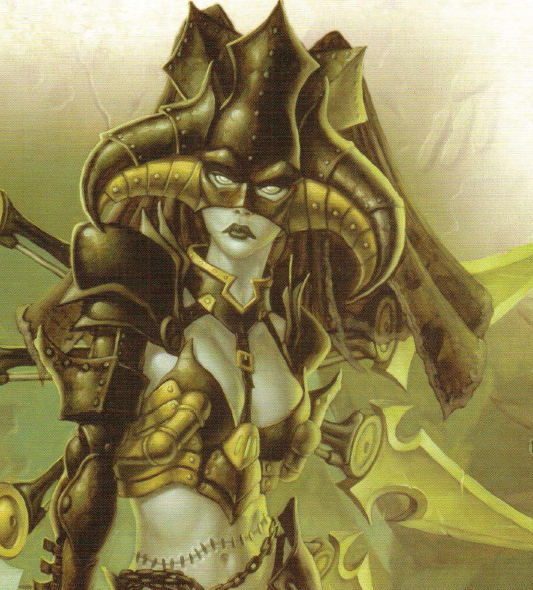
Wraith Witch Deneghra is is Epic Deneghra. She advanced Asphyxious' plans by dying to her sister. He would have waited before killing her, but he'd long planned to make her undead. After her body was returned to him, he took her into the necrofactorium, returning her as a refined and immortal version of herself. She rose restored, but not really whole. The connection between her flesh and spirit was weakeneed at Garrodh, warping and twisting her flesh. She was torn between physical and spectral worlds, her connection to shadow increasing immensely. She drew strength from her ordeals, opening her eyes to the mysteries of entropy. Darkness obeys her now, entangling her foes even in bright daylight. She can channel death energy to turn friend and foe into phantoms, and she has gone well beyond her warwitch training. She wields the weapon Eclipse, an iron glaive once owned by Daeamortus. In life, Deneghra was happy to serve Asphyxious without her own goals, but death has clarified her mind, increasing her ambition. She wants to become a commander in her own right. Still, she is loyal to Asphyxious without question. Her gimmick is shadows and magical attacks, and her feat greatly debuffs and locks in place the enemies around her by binding them with shadows.
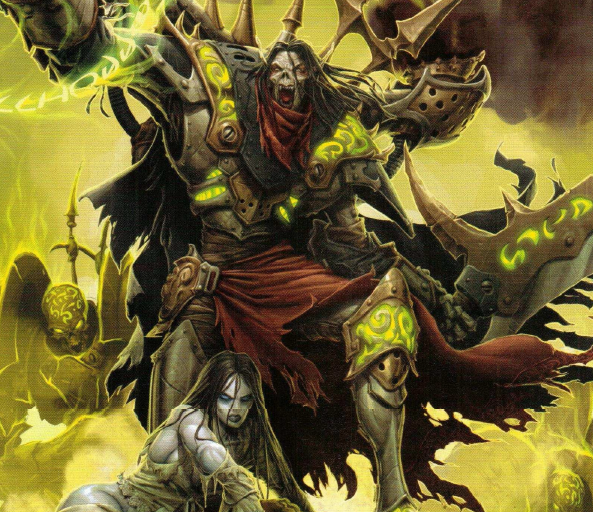
Goreshade the Bastard is often seen with the Gravewalkers , undead he creates from those he kills. He once, decades ago, was named Ghyrrshyld, ruler of House Vyre, obsessed with the decline of Ios. Once blessed with great longevity, the Iosan elves died sooner every generation. After human magic was created, they were severed from their gods. Only Scyrah, goddess of spring, remained known to live. Further, they were often infertile, and many children were born soulless. The Iosans couldn't fix it, and seemed to accept their decline, which offended Ghyrrshyld. He decided to fix it himself, using his charisma to gain power and allies for House Vyre. They had long been masters of the occult, and Ghyrrshyld immersed himself in lore, seeking out the blasphemous secrets of the cult of Nyrro and the work of the lost nation Morrdh. He even stole from Cryx, spending days without sleep or food to find the answer. A solution came to him, but it would take terrible bloodshed. Humanity, he was certain, was to blame. They must be eliminated, to restore balance.
Ghyrrshyld subjugated his house, declaring himself narcissar and high consul. He hid his full plans, making allies with other houses and building his forces. Dark rumors began to surface as he fought the trollkin near Ios, savagely murdering them. He delved into Iosan cosmology, learning of a dark and terrible void between Caen and the Veld. He began to suspect that was where Iosan souls were being trapped, and perhaps why some Iosan children were born soulless. While he researched, his cousin gave birth to a soulless child, whom he took and brought to the High Consulate, killing it before their eyes. He raved about the need for war with humanity, before all was lost. His peers were outraged, and warrants for his arrest were issued. Civil war soon began. Less than two years later, House Shyeel found his research - he'd been conducting monstrous experiments on both soulless and souled children in massive numbers. They performed a final assault, mortally wounding Ghyrrshyld. He fled to the forbidden city Eversael, transforming himself into an eldrith, that he might not die. Eventually, he made his way to Cryx, calling himself Goreshade. He pledged himself to Asphyxious, but it meant nothing to him. He just wanted to study that dark abyss he'd found, using Cryxian lore to do it. He was given an army to lead, and he's grown accustomed to fighting for Cryx. With ever kill he makes, he drags spirits from the void as Gravewalkers to fight for him, and he can raise armies of them almost at will. During the rare times he is not studying or fighting, he stares into the night, remembering the time he once almost led an entire nation, rather than being just one more general of Toruk. Goreshade's gimmick is general troop magic, blasts and making undead. His feat summons an entire unit of Bane Thralls.
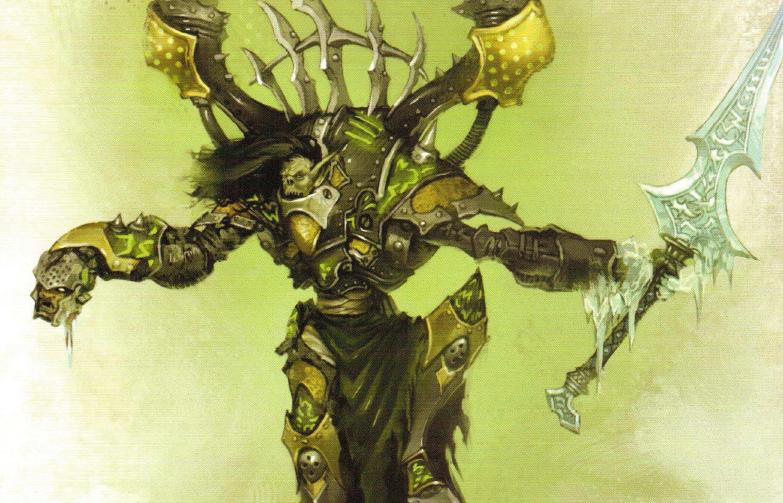
Goreshade the Cursed is Epic Goreshade. Mastery of eldritch and void lore has irrevocably altered his perceptions of reality, and he has come to believe that the Iosan gods must be removed from Caen, even it means destroying them. None of his people can understand that their gods must die, but Goreshade will see it done, using Cryx to play his own game of saving Ios. Some of his actions have come close to defiance, but he has convinced his superiors he remains loyal. Were all his actions known, his unlife would be in jeopardy - particularly a temporary alliance with the dragon Ethrunbal, or Everblight, whom he gave the location of the dragon Pyromalfic, rather than telling Lord Venethrax. Goreshade doesn't care - he believes it was necessary to get information on Nyssor. Below the catacombs of Korsk, Goreshade found the god Nyssor, preparing to kill him. However, it was harder than he expected, and humans drove him from that place. He fled with the god-blade Voass, and he was cursed by the slumbering Nyssor. He has accepted the curse as his burden, believing the stolen weapon will help him when he next faces a god. Once Scyrah and Nyssor are dead, he can begin saving the elves - or their souls, should they die in the meantime. His convictions are unshakeable, and even if his people refuse him, he will force his salvation on them. He will unmake Caen itself if he must, seeing no contradiction in destroying the world to save countless thousands of immortal souls. His new gimmick is built around buffs and blasts, with his feat allowing him to sacrifice troops to exchange for troops he's already lost.
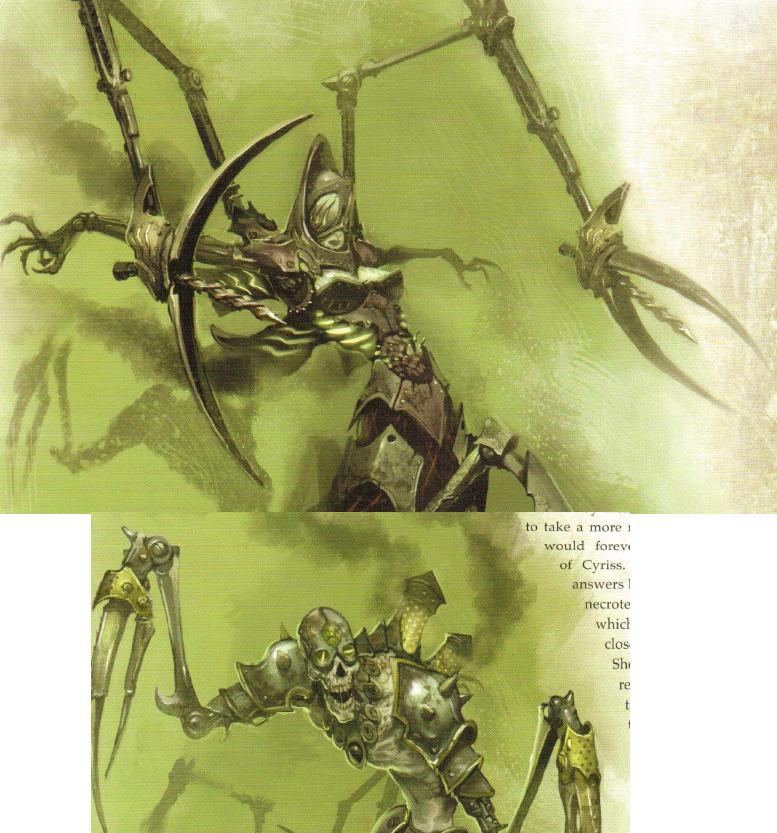
Master Necrotech Mortenebra is never without her personal skarlock, Deryliss . She is the most cold and inhuman of Cryx's warcasters, alien even to the undead. She is a paragon of necrotechnology, known as the Fleshless Maiden, the Mistress of Precision and the Cruel Shaper. She once served Cyriss, Maiden of Gears, and she finds the titles an amusing mockery. She works like an insect on metal, clicking legs, and she insists on perfection. In life, she was drawn to the cult of Cyriss and their mathematics, joining them near their founding three centuries ago. She contributed to the creation of the soul transfer, putting consciousness in a clockwork shell, but grew dissatisfied with their progress in perfecting it. She became convinced of innate problems in the cult leadership, seeing flaws where no others did, and proclaimed the process unready. She identified the flaw: the creations had no free will. Some external force exercised some subtle but undeniable control over the translated consciousness. Her peers called her paranoid, dismissing it as the guiding hand of Cyriss. Undeterred, Mortenebra decided to take a more radical approach, seeking answers by experimenting on the necrotech-enhanced lords of Cryx, which she saw as closest parallels to her own work. She chose her prey carefully, using rumors of an ancient Orgoth library and a handchosen cult to bait in an iron lich named Lorvetus. He proved a difficult subject, murdering a dozen cultists before she could secure him.
Mortenebra was fascinated by what she saw, dissecting Lorvetus and extracting its animating spirit. She took her findings to the Cyrissans, but they were horrified when she suggested incorporating necromancy into their machines. They denounced her and cast her out, but she still had loyal servants in the cult, who conspired with her. When the cult finally had a successful transfer, Mortenebra returned, seized the clockwork priest and fled to Cryx, slaying all who opposed her. Exploiting information learned from her work on Lorvetus, she offered all she knew to the lords of Blackwater in exchange for safety. The clockwork priest cursed at her as it was vivisected, and she ignored it, in time using what she learned to become an iron lich herself. She now serves all lich lords but calls none master. Lich Lord Morbus managed most of her efforts, but she's fueled the work of Terminus, Asphyxious and, before, Daeamortus. Her decision to go to the mainland is a turning point for Cryx production. Her skarlock, Deryliss, is a lurking presence, one she made soon after her arrival. She has given it some measure of her authority, to speak for her. Mortenebra maintains a network of spies to stay informed, and for decades she's been collecting Orgoth relics from below Nine Stones, Henge Hold and even Khardov. Her past is nearly forgotten now, and she is wholly Cryxian, embracing her new form as superior to any vessel the Cyrissans could make. She worships Toruk now, adapting her old precepts to necrotechnology. Her knowledge and machine empathy have given her unique insight into necromechanical horrors, and she can synchronize easily with helljacks. Her gimmick is 'jack buffing, and her feat allows her to give her allies rerolls to attack and damage.
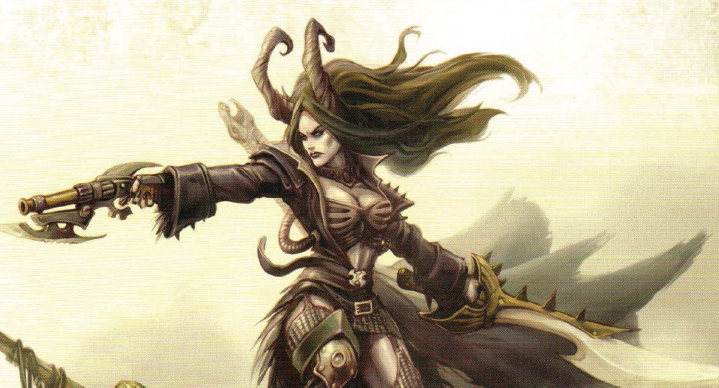
Skarre, Queen of the Broken Coast is Epic Skarre. She has been caught up in fate, gaining insight into the magic that connects souls. Now, she stands at the fore of the naval war. She was at the center of the battles between lich lords begun with the death of Daeamortus and ending with the fight between Asphyxious and Terminus. When Asphyxious worked to elevate himself over Cryx, she was the one to realize his true objective and intercede, warning Daeamortus, but he proved too weak to stop his subordinate. She joined Terminus at the Temple of Garrodh to stop Asphyxious, but it was not without cost. Asphyxious banished Terminus from Caen as the temple began to collapse. Skarre found herself enraptured by the soul repository in the temple library, her vision awakening in a rush of power, allowing her to trace the strands of destiny connecting the living and dead souls, seeing how to restore Terminus and repair Toruk's plans. This allowed her, also, to preserve herself from near-certain death in the collapse. She combined her sorcery with the Witch Coven of Garlghast to open a portal between worlds, restoring Terminus from his exile. Terminus gave Skarre command of the Cryxian fleet as his vassal, with all of his resources open to her. Her orders are to open a front over two thousand miles long, across four nations. No coastal town or city is safe from her, now, and while Asphyxious hates her, her influence has placed her outside retaliation for now. Skarre Ravenmane now commands her own fate, using Satyxis blood magic to control fate's web and be aware of the outcomes of all decisions. Her auguries guide her with ruthless vision in commanding the Black Fleet to a future that bests serve her and Toruk. she may be alive, but she is now equal to her immortal masters. Her gimmick is built around buffs and debuffs, with her feat allowing her to trade her own life force to make her allies temporarily invulnerable.
Next time: People without Epic forms.
Forces of Warmachine: Cryx
Original SA post Forces of Warmachine: Cryx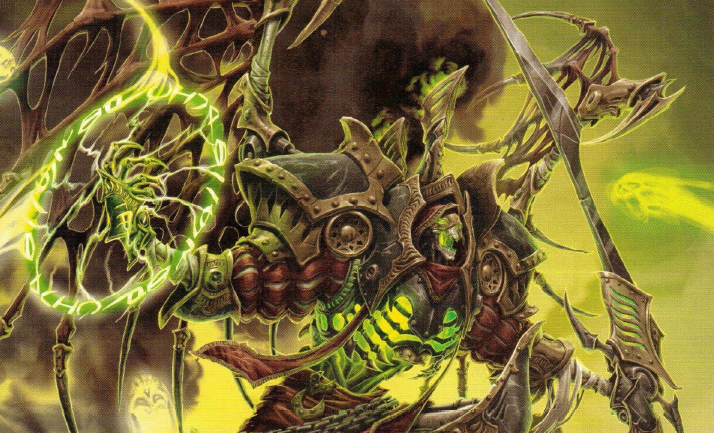
Lich Lord Terminus is an ancient monster who has risen to tower over the other servants of Toruk. He was, at one time, the living commander of the forces of Dragon's Roost, Cryx's northernmost fortress. He internalized the dragonblight, his body swelling immensely and huge wings tearing themselves through his back. The necrosurgeons replaced parts of his body with necrotech and iron as his flesh began to fail, and by the time of the Cryx attack on the Orgoth at Garlghast, no part of his original form remained, and he was an iron lich of impressive reputation even then. In the aftermath, he rose to prominence by seizing Orgoth secrets and rebuilding the army, overseeing construction on the blackships personally. Toruk made Terminus a lich lord for his efforts, and Terminus devoted himself utterly to the Dragonfather. He hunted for information on other dragons, working with Daeamortus in the Scharde Invasions, testing the Iron Kingdoms for weakness. Terminus is so strong he can even inspire the dead, leaving his thralls eager to kill or die for him. While he is a meticulous planner, in the field he is a whirlwind of devastation, full of terrible bloodlust. His gimmick is being a personal powerhouse, and his feat lets him steal the souls of the people that die near him to boost his own armor.
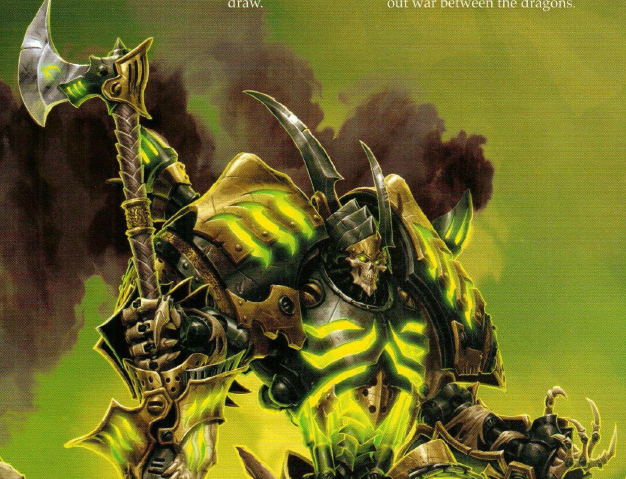
Lich Lord Venethrax has the official job of seeking out the dragon brood of Toruk, the only purpose that truly matters. He has been a dragonhunter for fourteen centuries now, in the name of Toruk, and he will happily murder all of them. He is well suited to the job - obsessive, focused and devoted to the dragon war. His agents cover the mainland, listening for rumors of dragons, gathering the lore of Morrdh, studying stories of Ethrunbal's defeat in Ios and tracking the rumors of the blighted elves of the north commanding dragonspawn. While Verethrax is theoretically based in Skell, he often personally leads operations, overseeing the necropsy of the blighted and murdering dragonspawn. Shortly before the Orgoth came, he even led a horde to root out a wounded dragon, Halfaug, who had been damaged by men and elves. While Venethrax was unable to kill Halfaug, he came damn close, and it has remained in hiding for centuries. No other mortal creature in the world can claim to have fought a dragon to a draw personally. The increased rumors of dragon presence in the north and that Blighterghast has sent out a telepathic summons through the athancs have drawn Toruk's attention, and Venethrax has been sent to the mainland as a result, foretelling all-out war. His gimmick is fucking up Hordes armies in general (and Everblight in particular) and also blasting shit. His feat causes enemies that die nearby to explode in clouds of dragon poison that even blocks the sight of Legion dragonspawn. Also, it sets things on fire.
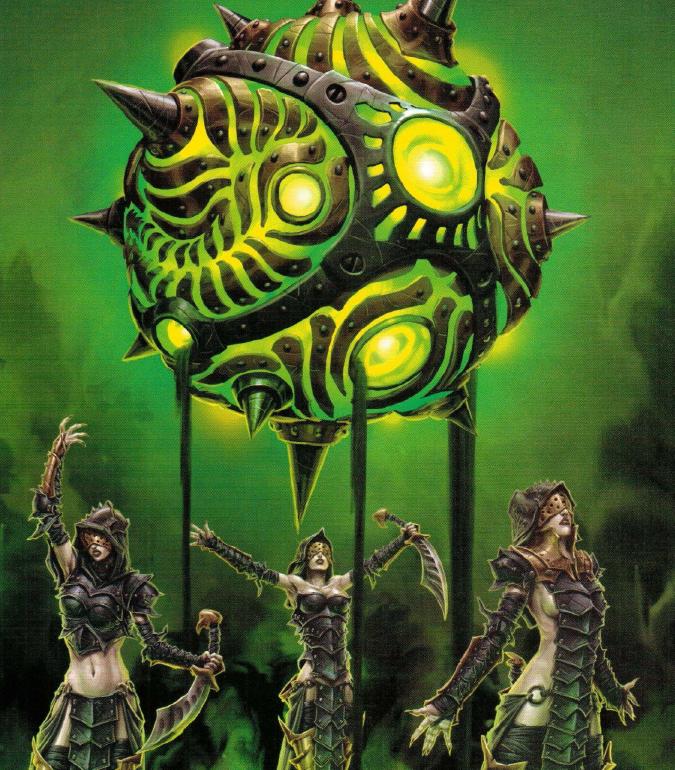
The Witch Coven of Garlghast is a team of three witches, along with the bizarre device called Egregore . They showed up to the Cryx vessel Aldibraxis in 593 AR, no older than thirteen and followed by a mysterious black sphere of iron. Their names were Helleana, Morgaen and Selene, and they spoke an obscure Orgoth dialect. They used magic to get the sailors to take them to Blackwater, and the crew left them alone for fear of the sphere Egregore, which greatly disturbed them with the way shadow played over it and the sisters whispered to it as if it were alive. When they arrived, the sisters left without a word, making their way to Skell, despite the dangers of unaccompanied travel in Cryx. They were never harmed. On arrival, they went to Toruk's Black Temple and demanded to see Lich Lord Terminus, who was intrigued by them and allowed it. They fell to their knees, naming him Conqueror, Ravager of Man and Lord of the Blighted Seas. They claimed they had come at the appointed hour to enter Toruk's service to see the true destiny of Cryx come to be. Impressed, Terminus tested their prophecies and found they had a true talent, accepting their oaths of service. He was a battle leader first and foremost, so he set them to battle, where their dark magic proved very effective. The Egregore expands their power, letting them pool their strength as one and command helljacks from immense distance.
The Witches of Garlghast have gone to the mainland several times for Terminus, ravaging isolated settlements by all kinds of means - not just destroying them, but removing all trace that they ever existed, save for corpses strung up in trees alongside tortured victims begging for death. Often, with these tactics, they win before they ever have to fight. The Egregore, while clearly a sentient vessel, is a mystery even to Cryx's scholars. It is covered in runes, leaks darkness that caresses the witches like a lover and may derive from Morrdh or Orgoth. None have ever seen anything like it. It and the sisters share a bond unlike any other, sharing one life essence and whispering constantly to each other. Even the Cryxians have decided not to ask any more. They are seldom separated, for their powers are greatest together. Individually, each sister lacks the power of a full warwitch, but together they can sense fate with unparalleled skill, twisting the future into new shapes. Their power makes them unquestioned, despite the mysteries surrounding them. They are loyal, and that is enough. Over the years, they have helped Terminus with advice often, and he owes many successes to their prophecies. He has called for them to join him on the mainland now, thinking they will be very useful. The Witches are terrifying manipulators, both on and off the field, controlling their power at range and unleashing magical blasts at foes. Only they fully understand the destiny they have foreseen, but it is a dark plague on Immoren, from which no light will escape. Their gimmick is buffs and debuffs, and their feat is a huge debuff to nearby foes.

Cryx's necrotechs produce machines at an insane rate, thanks to their untraditional techniques and materials. Undead mechaniks can work 24/7 for decades, and almost everything they build is unique, albeit based on certain principles that unite a line of 'jacks. The necrotechs are highly jealous of their design details, so a bonejack built under Dreggsmouth may use entirely different materials and construction techniques than a theoretically identical counterpart from Blackwater. Helljacks serve the same kind of role as heavy warjacks, but the small and nimble bonejacks are produced in much greater number than light warjacks are. They are customized to carry specific arms and serve as mobile platforms for all kinds of devices, primarily arc nodes. The arc node, originally stolen from Cygnar, is very valuable to Cryx and is a hallmark of bonejack design, allowing Cryxian warcasters immense range for their spells. Other specialized bonejacks serve as warcaster assassins or burrowing ambushers. They're expendable in a way no warjack really is. Necromancy gives the cortexes of Cryx a spark of reason, but it also makes them hungry for blood. Their necromechanikal minds are savage and cunning, amplified by dark energies lingering in their necrotite fuel. Bonejacks and helljacks love to kill, and their often deranged creators imprinting on the runes animating them doesn't help with that.

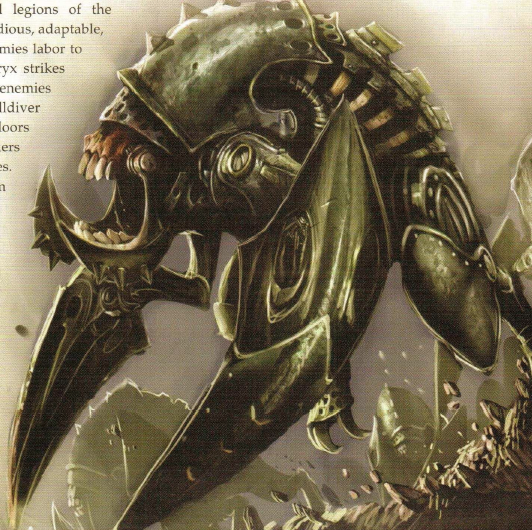
The Helldiver is eight feet tall and just over two tons. They are part of the Cryxian doctrine of adaptability and unpredictable war. They move underground, erupting from the earth to attack soldiers that believe themselves safe. The immense front claws are used only to dig, not attack. The primary weapon, instead, is the machine's jaw, which it uses to tear apart victims. Helldivers can move through earth at a shockingly fast pace before rising in ambush, and they are quite patient, able to remain motionless endlessly. Many battlefields are seeded with Helldivers to prepare for the coming slaughter.
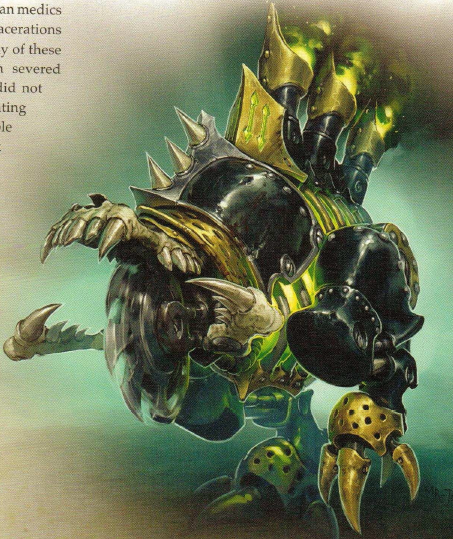
The Ripjaw is just under six and a half feet and weighs over 2 and a half tons. Its existence was unconfirmed until the Scharde Invasions, but for decades, Cygnar had noticed terrible lacerations on some of the dead or destroyed 'jacks, brutal dismemberment by some weapon they'd never seen. Retreating forces at Highgate in 586 AR produced the first reliable reports of these bonejacks, which shred an Ironclad within seconds via their mandibles and buzzsaws. They seem to have a bestial cunning when working together, finding the weak prey and hamstringing them before killing and mangling them. They seem to particularly enjoy targeting joints, even long after their victims are dead, until pulled to other tasks. This habit is occasionally useful if you want smaller pieces of bodies.
Next time: MURDERJACKS
Forces of Warmachine: Cryx
Original SA postPretty much that, yeah.
Forces of Warmachine: Cryx
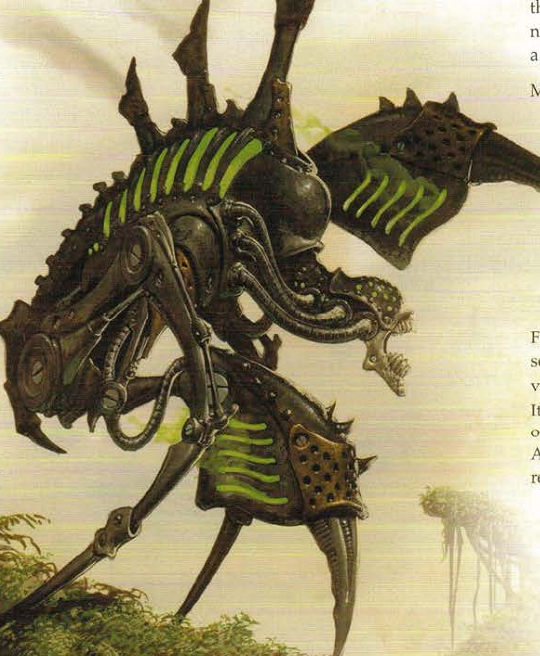
The
Stalker
is almost nine feet tall and just over two tons. It seems to wrap darkness around itself in order to kill for Toruk. Its hull seems to writhe and ripple in the light, and at a distance it's practically invisible. It uses its insectile legs to move quickly across the field, jumping over any obstacle to get to where it has to go. Once in reach of prey, it uses its threshing blades to make a quick kill, tearing through any magical defenses with ease thanks to the necrotic agent coating the blades, which saturates wounds and weakens even the toughest victims. For most of a century, Stalkers have been in use by Cryx to murder victims with armed escorts, as they relentlessly pursue their targets and cannot be studied or predicted easily.
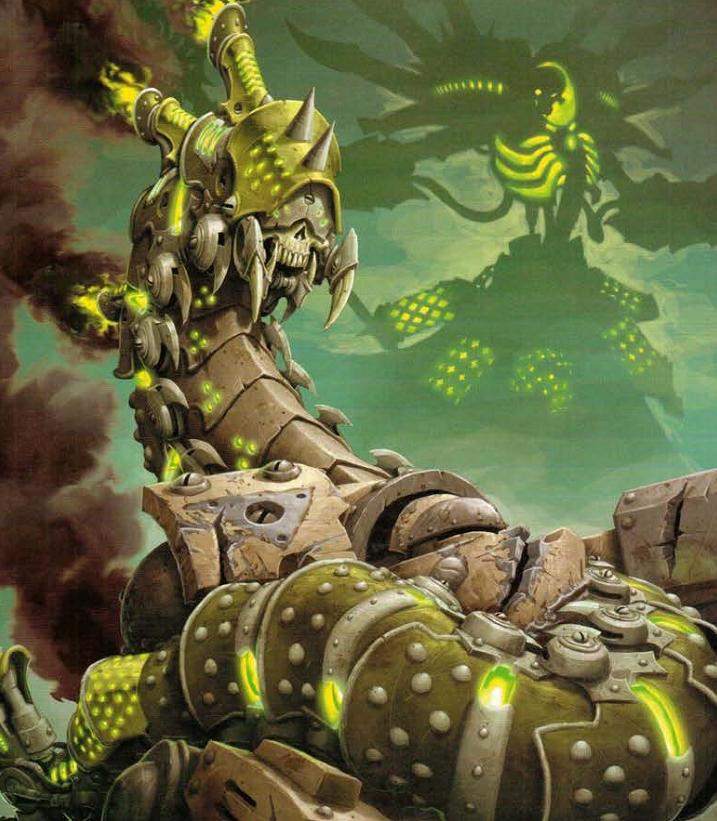
Cankerworm
is a strange machine, fifteen feet long and almost three and a half tons. It is a scavenger by nature, picking warjack carcasses clean of parts in order to integrate them into itself, allowing it to regenerate even in battle. It will kill anyone that tries to stop it but is not very interested in flesh. In the rear of its body is a strange, pincer-like device that grafts on salvaged weapons. Only Asphyxious knows the machine's origins, which may well be the result of his own tinkering. It's followed him for centuries, but seems more self-created than engineeered, consuming its enemies whole to take their parts. It has a cunning and self-preservation instinct that make it seem alive, waiting for warjacks to be crippled before attacking them and harvesting their wepaons and parts with its vicious mandibles. Once it finds a potent weapon, it will integrate the weapon into itself flawlessly, manipulating even the most sophisticated mechanikal devices with ease. Its existence only adds to Asphyxious' legacy, and even his servants don't like the machine much. No Cryxian ever interferes with its in explicable behavior, however. After battle, it tends to pile up corpses and machines and bury itself in them, sometimes bringing back a skull or piece of mechanika for its master. No one has ever tried to figure out how it picks its trophies.
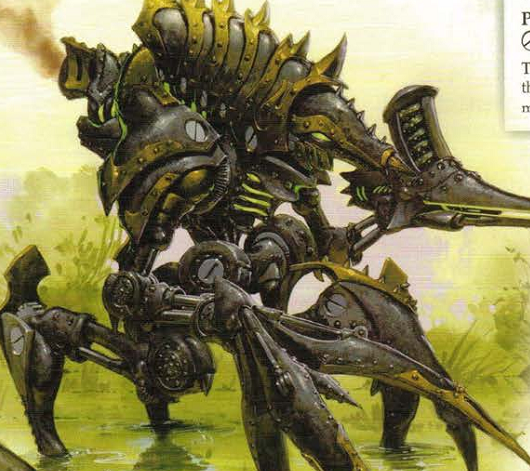
A
Harrower
is almost 10 and a half feet tall and over 7 and a half tons. It wields a shrieking Mortifier cannon and scything Punisher claw, tearing the souls of its victims out to use for war. It is an amphibious helljack which uses a simple necromantic principle: the power of a captive soul is proportional to the torment of its death. Harrowers burst from the sea to fill their soul cages in coastal towns. The cages are etched with runes and lined with necrotite, and they serve as ammunition for the Mortifier. A Mortifier's shell is partially in the spirit realm, appearing to mortal eyes only as a sickly blur as it passes through obstacles, becoming tangible on impact with the intended target, where it shreds armor and flesh. In the rare cases that it doesn't kill its victim, the wounds it causes heal slowly if they heal at all and often become infected.
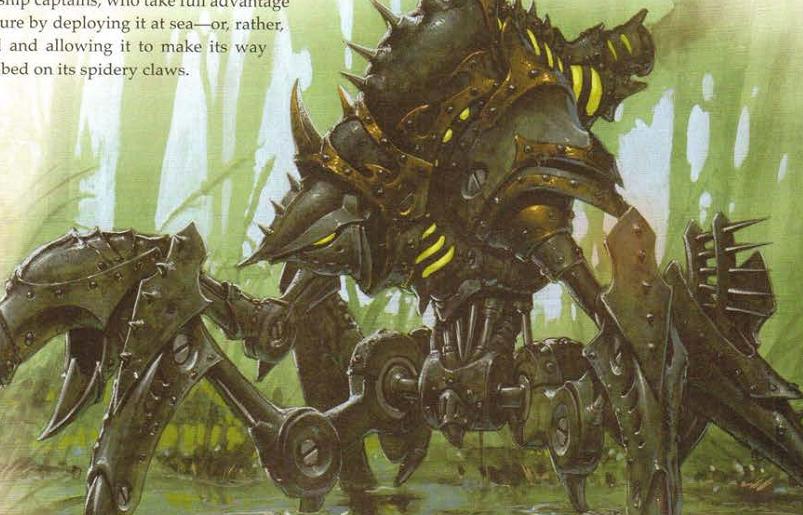
The
Leviathan
is almost ten and a half feet tall and 7 tons. Its watertight furnaces make it a favorite on blackships, where it can be deployed at sea by shoving it overboard, to make its way in by stealth on spider claws. When it senses prey, it rises up to bring its terrible crushing claw and rapid-fire cannon to bear. The cannon is fueled by built up steam, firing crude but effective spikes in endless bursts of death. Smaller quarry are cut down by the spikes, but warjacks and larger targets find their armor mangled by them instead, ready for the claw.
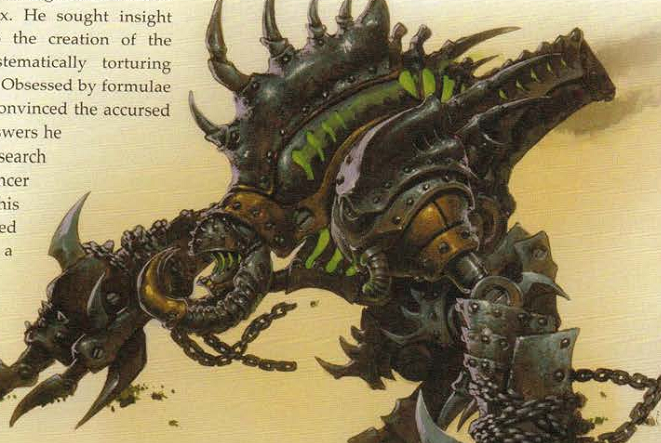
The
Seether
stands twelve feet tall and six and a half tons. It was designed by Master Necrotech Verrik Kurr, a lunatic even by Cryxian standards, who sought insight into the creation of necrotite by torturing victims and distilling their life force. He became convinced that the cursed Librum Meknecrus had the answers he wanted, and began to search for it. When he disappeared, an eventual search of his lab showed only the dead bodies of his assistants and a number of inert Seethers. They follow basic Slayer design with extreme modifications, in the form of soul drives grafted to their cortexes. These contain angry spirits that provide the helljack with bottomless rage, and the efficiency by which they use this energy has yet to be replicated. The Seethers are a valuable weapon, but the Skell necrotechs have as yet been unable to reverse engineer them. The remaining ones have been sent to the mainland, to wreak bloody slaughter.
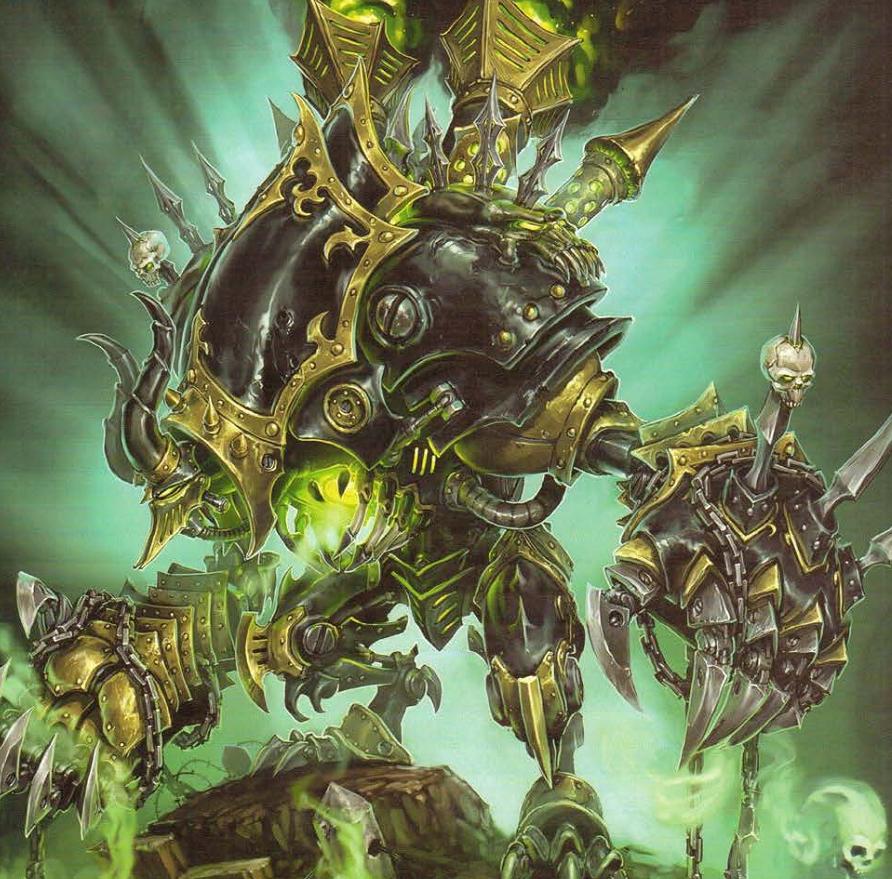
Deathjack
has haunted Immoren for two centuries. It is fifteen feet tall, but has never stayed still long enough to weigh. It attacks without warning, devouring souls and leaving nothing in its wake but death. Its furnace stinks of burnt hair and flesh from its victims. It was not made by Cryx, but they vowed to capture it ever since its first sighting in 350 AR. It is humiliating to them that they didn't make it, and its actual origins are unknown, as is the identity of its creator, but it's said that the secrets of its construction may be buried in the lost Librum Mekanecrus, coveted by Thamarites and Cryxians alike for its information on melding mechanika with Orgoth rites. The Deathjack's array of necromantic and mechanikal powers make it a potent addition to the Cryxian armies. Its Skulls of Hate, a pair of infernal lanterns on its shoulders, are quite clever, and constantly cast necromantic spells on it. Legend has it that the machine has been demolished before, always at great cost, but the Skulls of Hate reassemble it fro mthe wreckage of other machines. It is apparently immortal and exists but to kill. Its outer frame resembles Cryxian helljacks, as they were made to mimic it, but its furnace is unique. It runs not on necrotite, but on the souls of those it kills. It took many resources and attempts to capture the Deathjack, and even then, the Skulls of Hate are impervious to wards and rituals. They could not be broken, just bound. Some say the final cost of subjugating the thing has not yet been paid, and it will at some point break free and turn against Cryx. Even the lich lords watch it with vigilance against that day.
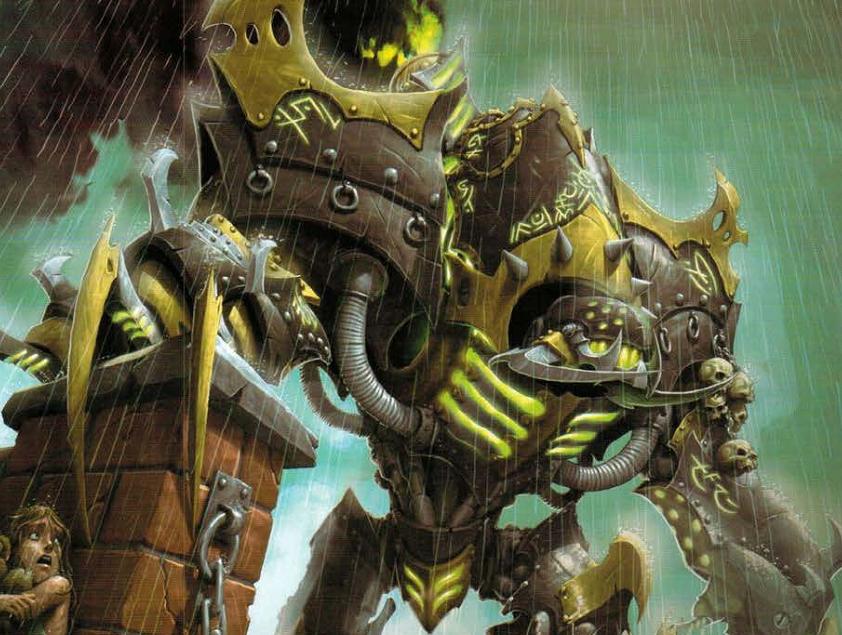
Nightmare
is a unique Slayer, almost 12 feet tall and 7 tons. It has a predatory instinct and the power to become a ghostly specter, moving through any barrier to reach the foe. It fights alongside Deneghra, melting into her darkness until it needs to rend its victims to bits. Deneghra chose it as her favored weapon when it held her in place for her sister to kill her. IT was the same slayer that took her body back, obedient to her even beyond death. After Asphyxious granted her unlife, she became obsessed with her blood on its claws, understanding the power of that blood in imprinting on the machine. She bound the machine to her will permanently, modifying it extensively to be the perfect weapon of vengeance. It has been incscribed with runs and empowered by sacral bllod, and her mind burned through its cortex, bonding it to her. Through that link, it became the ultimate, tireless hunter, a demon for her to unleash. Her mastery over death has echoed in Nightmare, and it has become her instrument, killing in her stead. Once loosed, it stalks its prey, unfettered by obstacles, relentlessly seeking out its quarry. It materializes from the shadows to slaughter them, but its fury is the cold fury of the dark, not a berserk rage.
Next time: Zombie Armies
Forces of Warmachine: Cryx
Original SA post Forces of Warmachine: Cryx
Cryx has the largest army in Immoren, what with the whole undeath thing. Even the enemy dead are more forces for them. Most of them are thralls - reanimated and augmented corpses. Necromancy was the first thing Toruk taught his lich lords, and they developed it further over a millenium. The earliest thralls were just corpses - dangerous, sure, but predictable. Since then, necromechanikal research has advanced by centuries, creating new and terrifying thralls. Most Cryxian soldiers are mechanithralls - simple, enhanced by a crude necrotite engine and given powerful mechanofists. They're the most expendable troops available, made in vast hordes. Over the years, larger and more potent thralls have been made, and the bile thrall is almost as numerous and simple to make as a mechanithrall. They're basically a mobile housing for a weapon than a warrior, and they spew acid. Bane spirits, on the other hand, are the elite thralls, created by imprisoning unholy warrior spirits inside corpses. Cryxian agents scour ancient battlefields and tombs to find vessels, for only the flesh of those strong in life can permanently anchor a bane spirit. The result is more intelligent than other thralls, devoted to destruction. The biggest drawback to thralls is their limited intelligence and lack of initiative. Autonomous and intelligent thralls are possible, but it takes care and time, so it's usually only used for skarlocks and things like that. Cryx relies very heavily on necromancers and warcaster to lead thralls in battle, and it's one of the few things a living person can do to get authority in Cryx, though most do aspire to undeath. The most esteemed of these is Darragh Wrathe, who is in the middle of turning his living body into a necrotechnological construct similar to the iron liches.
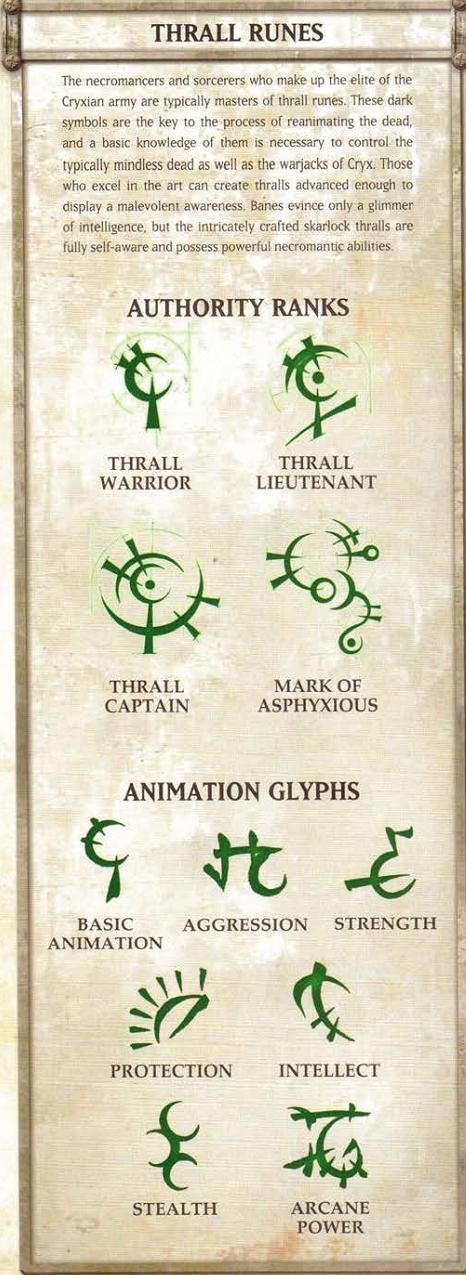
The revenants of the Ghost Fleet are not thralls - they aren't reanimated corpses, but the continuance of a supernatural contract between Toruk and Captain REngrave of the Atramentous. With Toruk's curse, it sails eternally to bring death to Cryx's foes. Living troops are also used for their unique benefits. The satyxis have unrivaled savagery and unique blood magic, with the most potent able to read fate in entrails. They are the elites of the Black Fleet, treating their human subordinates with the same disregard as thralls. They often employ black ogrun or blighted ogrun and trollkin, as they fight with little regard for their own lives. Leadership of the largest group of these soldiers has been left to General Gerlak Slaughterborn, chieftain of the Bloodgorger trollkin, but even these living troops are commodities to be used. This disregard for the living is why so few mercenaries will work for Cryx - that and Cryx doesn't have any money but what it steals, so they pay in barter or stolen coin. Some large and morally flexible groups like the Steelheads will agree to work for Cryx, paid in plunder, but even so only the most grizzled and disreputable Steelheads will take the contracts. Other mercs in Cryxian employ are often desperate or insane.
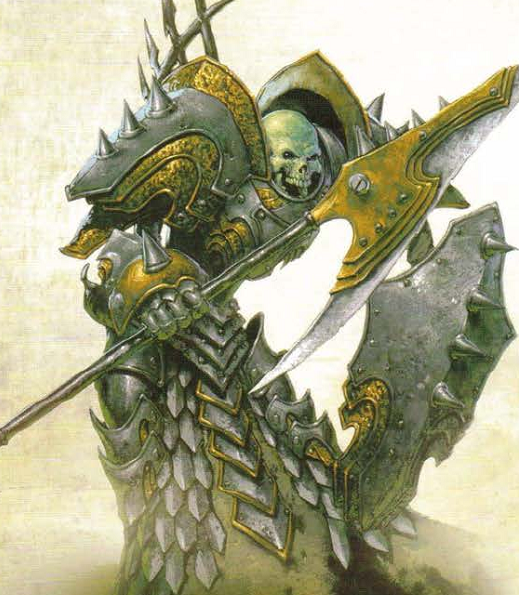
Bane Knights are born of the dark, vessels of void spirits. They are bound to a cold hatred against all living creatures, fueled by dark magic. Their strength is drawn from those who slay them, punishing their foes and relentlessly advancing. Many soldiers have destroyed a bane knight only to be killed when a new one coalesced from the shadows. They are accompanied by cold winds and charnel stench, gliding across the field with murder on their minds. They wield shadow-forged lances with inhuman skill, cutting down any foe. They can become fully spectral for short periods, passing through barriers to reach their victims. Tales are told of exhausted soldiers fleeing to the safety of the trenches, only to find bane knights walking out of the walls.
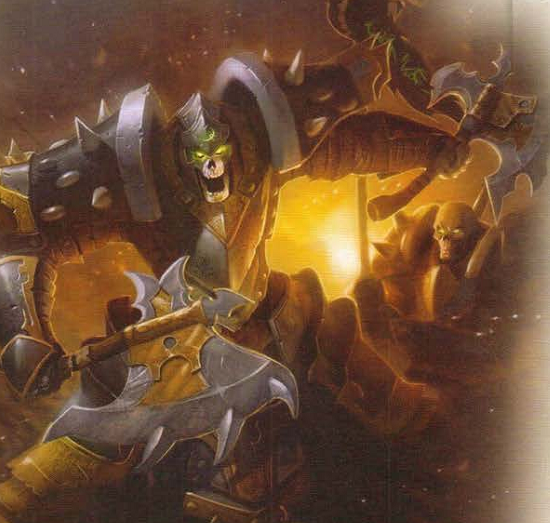
Bane thralls are sometimes led by a Bane Thrall Officer and Standard . Runebound captains lead them on the field, animated by only the most hateful spirits, pulled from eternal torment in the abyss between Caen and Urcaen. They remember little of their former lives, but what remains fills them with hatred for the living. The bane thralls follow them in silence, obscured by their clinging darkness. They use ancient standards, mockeries of the kingdoms they fought for in life. Death favors them, surrounding those who follow them with a miasma of strength. Their standards empower the bane thralls to shrug off wounds that would otherwise destroy them.
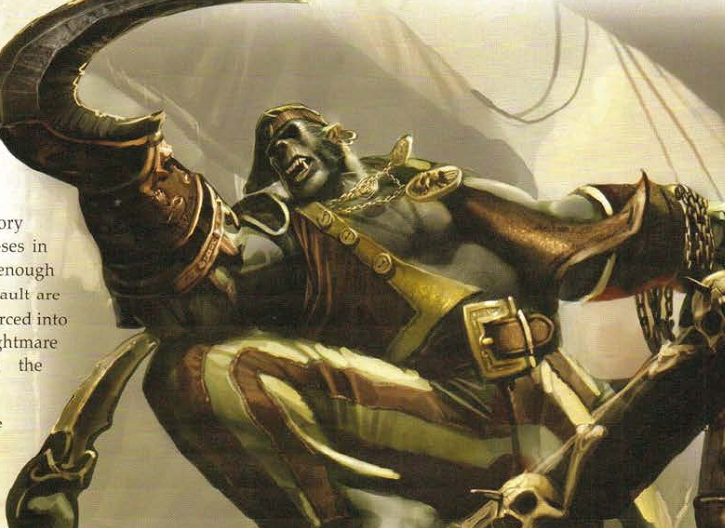
Black Ogrun Boarding Parties are the most savage pirates of Cryx. Once a prize nears them, they leap from their ships with mighty howls, slaughtering all before them. Those unlucky enough to survive are rounded up and brought back to be slaves of the Cryxians. The ogrun are experts in boarding actions, armed with cannons able to launch steel harpoons nearly on fifty feet of chain. This secures vessels for boarding and also helps to pick off victims before the ogrun close to melee. They are barbaric even by Scharde Isle standards, chosen for their bloodlust as much as seamnship. Each is commanded by a bosun whose job is both to lead them and manage their notoriously bad tempers. Often, they are left to do as they will until a target comes by to attack.
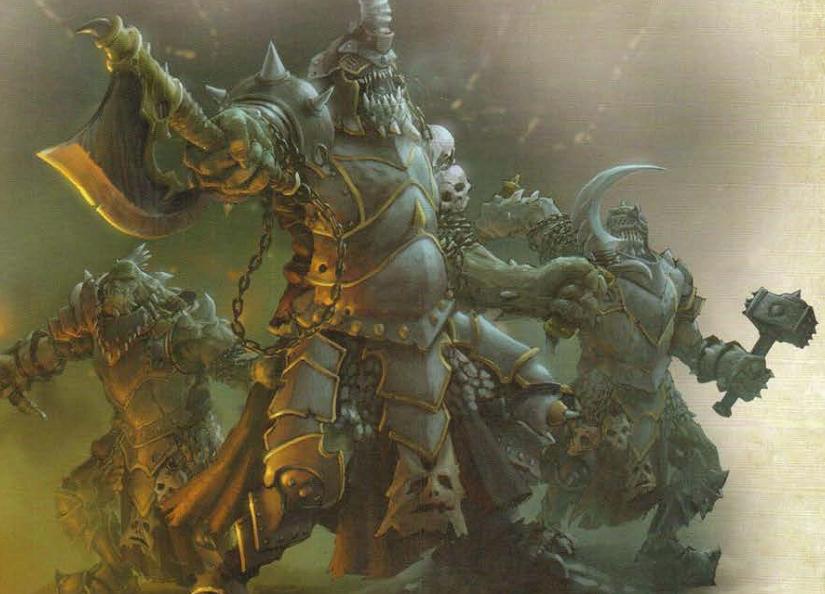
Bloodgorgers are the murderous trollkin of the blighted kriels of the Scharde. They are corrupted, evil beasts that love nothing more than maiming and devouring their foes. Toruk's blight has given them spurs and horns, enhancing their already formidable destructive power. They lead charges to cause terror and chaos, embracing their short and violent lives. Feeding on the dead does more than terrify - they use it to fuel blood sacrifice learned from the satyxis and the Tharn. They love to eat people while they're sitll alive, moving from one victim to the next and becoming even more invincible with each rite. The only mercy is that they rarely leave survivors to suffer the memory of their cruelty and hunger.
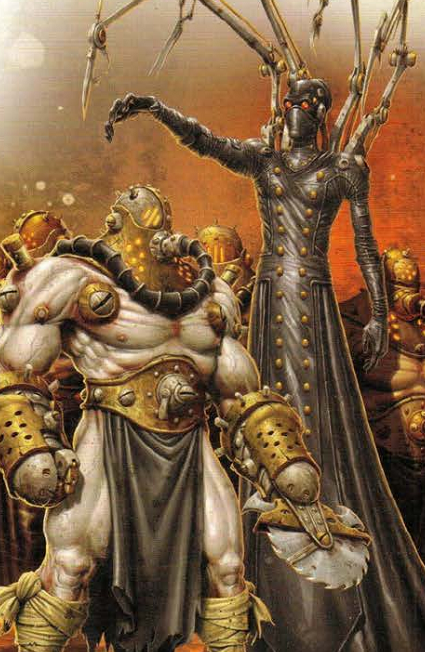
Cephalyx Mind Slavers and their Drudges are sometimes found as mercenaries, but more often they work for Cryx as allies. The cephalyx are dread creatures from the caverns under Immoren, performing experiments on others using a science known as cephalomek, mixing artifice, surgery and slavery. They are detached from the surface world and compassion, floating above the ground by some unknown means and commanding hosts of muscled and enhanced warrior-slaves, the drudges. They use surgery to open the skull and insert devices that sever of parts of the mind, rendering drudges obedient but mindless. They use telepathic impulses to command the drudges. The alliance between them and Cryx is recent, negotiated by Asphyxious to expand the scope and building speed of the Thornwood necrofactoriums. Cryx has used their extensive underground tunnel network to reach far further into the mainland.
Next time: More thralls
Forces of Warmachine: Cryx
Original SA post Forces of Warmachine: Cryx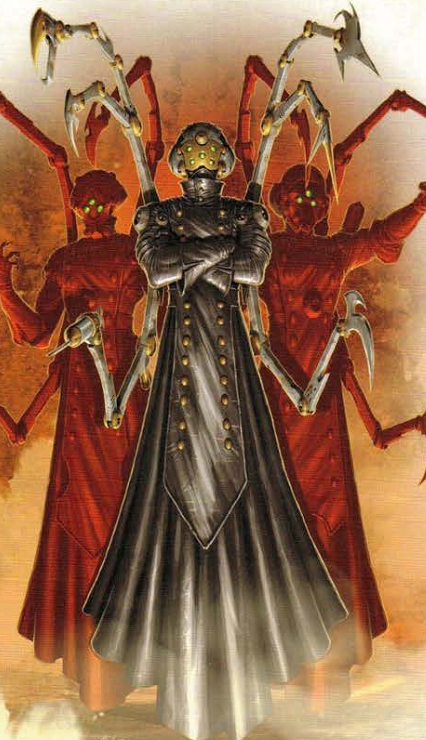
Cephalyx Overlords , like the mind slavers, will work rarely as mercenaries but most often are found among Cryxians. They are even less understood than most cephalyx, alien creatures that hover in the shadows and telepathically direct lesser cephalyx. They control cephalyx society, but the details of the hierarchy are just as mysterious as their telepathy. They hide their bulbous, distended heads behind leather and brass with multiple glowing eyes, even more inhuman than the slavers. They are able to project horrific pain into human minds, silently and without apparent cause. Any time these people try to concentrate, the horrific shriek in the victim's ears increases, triggering agony. At last, their consciousness is displaced from control of their body, which becomes dominated by the overseer. Those that have survived it say it feels as though spiders crawl under the skin while a wire is shoved into the brain.
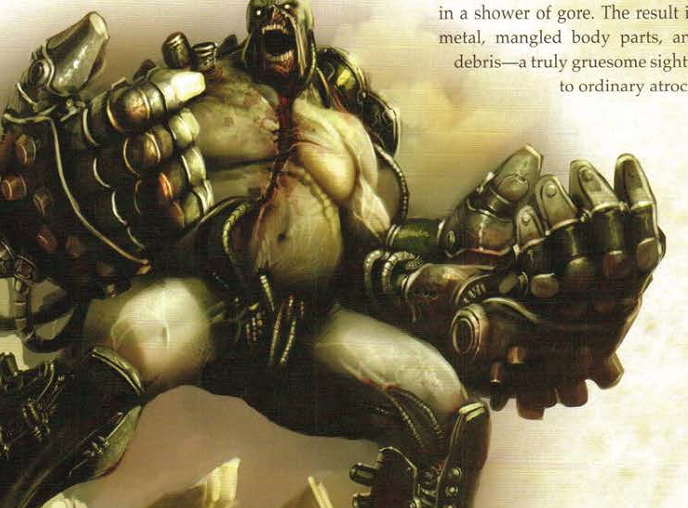
The Brute Thralls are the latest in Mechanithrall research, a natural evolution, really. They are made of dead Scharde trollkin and black ogrun, held together by conduits, steel plating and mechanika powered by a necrotite furnace. They aren't subtle or intelligent, but they are very good at breaking things. They are fearless and practically mindless, marching ahead of the mechanithralls to pummel soft targets to bloody ooze. There is no easy solution to them, when they are with mechanithralls - the brutes can't be allowed to live, but killing them takes time and bullets not being used to deal with the horde. When a brute thrall brings the full force of its piston-driven steamfists to bear, it can smash even the thickest plate, battering warjacks apart and bursting flesh.
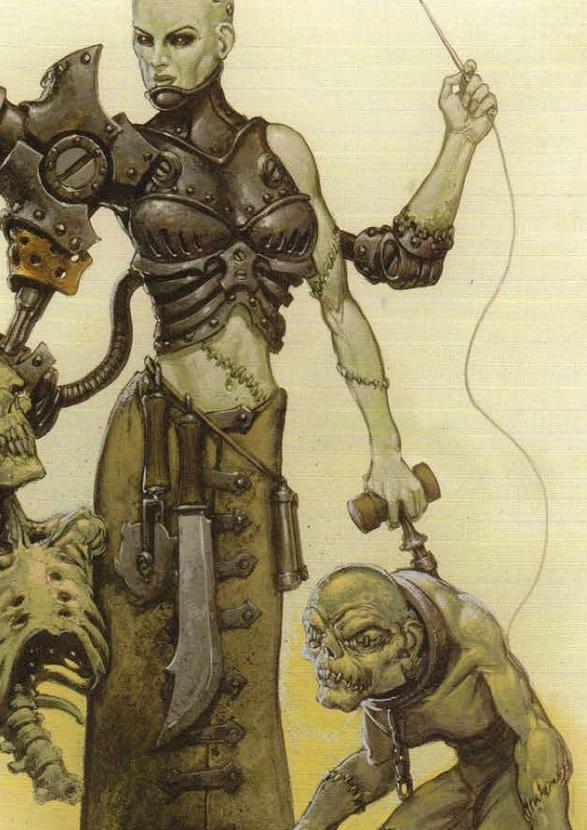
Necrosurgeons are always accompanied by Stitch Thralls , scavengers of carrion that find the best bits of the dead to bring back to their masters. The necrosurgeons often prefer parts from those still living, especially. The necrosurgeons accompany soldiers to the battlefield, maintaining thralls and making replacements as they are destroyed. Between engagements, they evaluate the troops and perform any required surgery by reattaching fresh parts and machines or creating new mechanithralls. Like other necrotechs, they are geniuses, augmenting their own bodies with the choicest body parts, often adding extra arms. They are much more casual about improving their favorite stitch thralls, treating them like pets or children...until they need the thralls' parts or want to improve on them, destroying them callously to remake them or others. Their workshops are more abbatoir than lab, gathering resources fro mthe slave markets of Cryx. More often, though, they are now found on the front, working directly on the field or below it in tunnel warrens of the new facotriums. They harvest great amounts of bodies, either fresh or scavenged, to grow the Cryxian army.
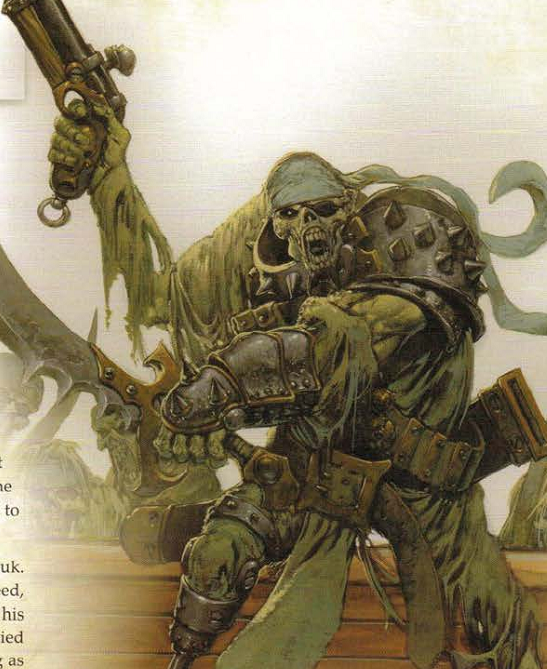
The Revenant Crew of the Atramentous are more terrifying than anything else on the sea. They were Toruk's first servants, cursed with living death by his flames. They and their ship demonstrate his power over even death, metamorphosing into undying forms. Even now, green flames dance along the dirgenmast, filling its sails with unnatural wind and repairing any damage it takes. Where it sails, there are no survivors and the waters boil in its wake. The crew are deathless servants, the hands of Toruk on the seas. Each one is tied to Captain Rengrave, and so long as he walks Caen, none of them can truly die. The fire the empowers the ship resurrects them over and over, and it's said that Rengrave can't die unless the Atramentous is sunk. He has spread his curse to many ships by now, creating the Ghost Fleet. They are full of hate for the living, killing most but selecting a few to join them in eternal service.
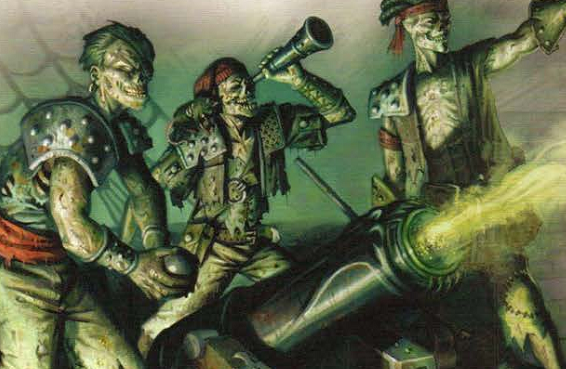
The Revenant Cannon Crew use guns transformed by the unearthly weapons of the Ghost Fleet. They melt and reforge cannons with dark power, marking them and bonding them to the Atramentous and its crew. Balefire dances in the metal, and the cannons are hot to the touch, burning the flesh of the revenants that load them. They fire spectral shot that screams like a banshee and explodes on impact, passing through hulls to hurt the living within. Rengrave claims the souls and flesh of those killed by the cannons, cursing them to join his gun crews.
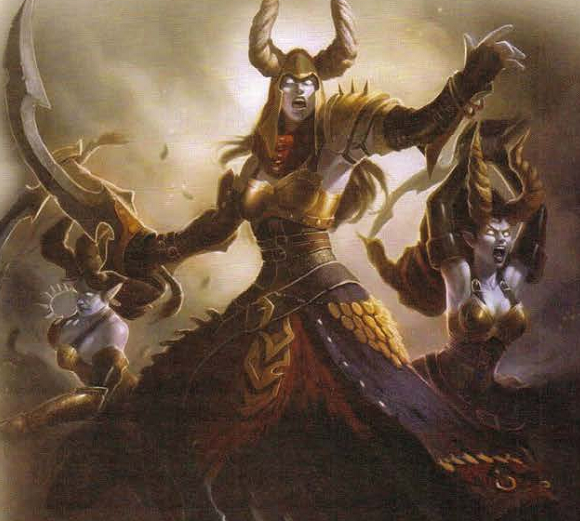
Satyxis Blood Witches are legendary in their cruelty and atrocvity. They use a corrupted form of primal magic, fueled by death and blood. They attack isolated villages, slaughtering all within to fuel their magic with ritual blades known as blood razors. They are the peak of Satyxis weaponcraft, easily opening veins and serving as a focus for their witchcraft, which can turn blood itself against its owner. Those who fall under the knife might burst into crimson mist or have their vitaly turned against their foes in a lash of psychic energy.
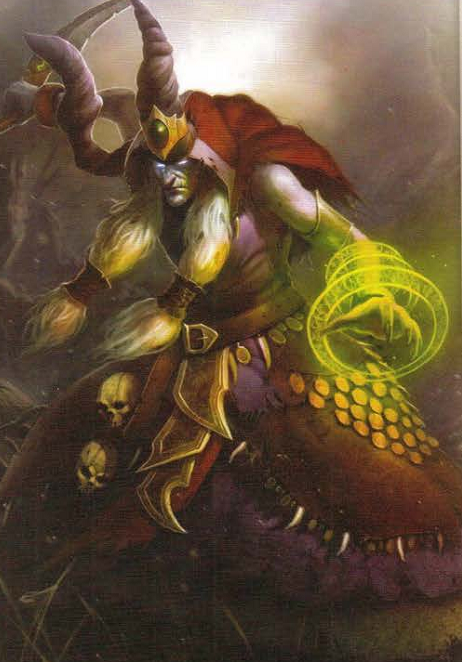
Blood witches are sometimes led by a Satyxis Blood Hag . The Satyxis do not age as others do, though few survive as long as their race is capable of, preferring to die in battle or to fuel their sorcery. The crones who live more than a century are vicious, central figures to the Satyxis covens. They lead the most hallowed rites - the sacrifice of newborn males, the initiation of girls into the ways of Satyx, and conducted the auguries that guide their people. Decades of practice has given them unparalleled skill in their dark arts, and they can bestor their favor on the blood witches. Their very presence saps life from their foes, and they can transform themselves and their sisters into blood wraiths, able to laugh off enemy attacks.
Next time: More dead shit
Forces of Warmachine: Cryx
Original SA post Forces of Warmachine: Cryx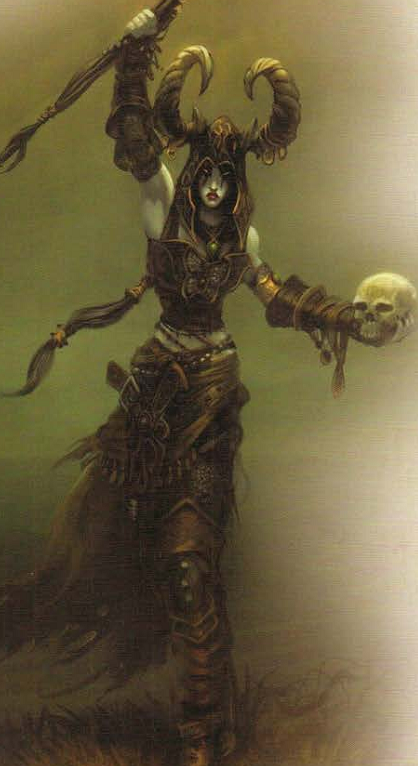
Satyxis raiders are sometimes led by Satyxis Raider Sea Witches . They are bold, relentless and seductive warriors, using their call to control men by lust and fear, then kill them. They use witchcraft in their piracy, exalted among the Satyxis as fierce captains and taskmastkers. They can call up mists and winds to escort the blackships, and their power grants much status. The raiders serve as their enforces and regulators among the pirate crews, and in battle, the witches use their magic to send their sisters into blood frenzies, calling on the tides to shield them or to bolster them with strength.
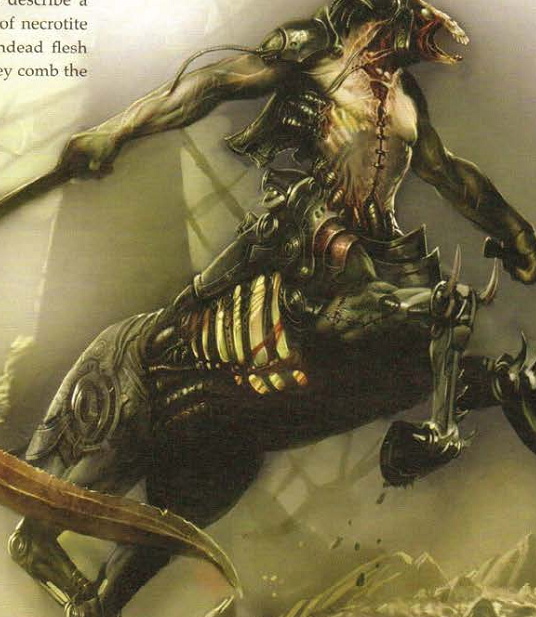
Soulhunters are among the most potent thralls ever made, with necrotite burning brightly in their forms. They are a vision of terror, their mix of plating, gears and flesh designed for speed and ferocity. Their slick skin is cured by alchemy and incsribed with runes, then riveted to a handmade carapace. Their steam-enhanced muscles are fused to the body of a Scharde-bred charger, with a necrotite furnace in its ribcage and a reinforced spine. The mechanikal scythe sends up sprays of blood and entrails, siphoning in the vitality of the dead to distribute their essence through the soulhunter, empowering it with vicious strength. They hunger for souls, scouring the field for victims and breathing in their essence as they die.
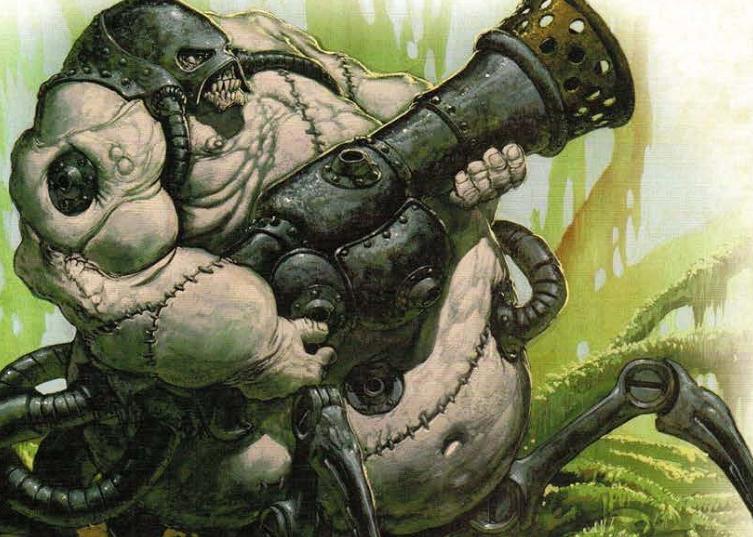
Bloat Thralls are immense reservoirs of alchemical sludge, shambling into battle on mechanikal claws. They are full to bursting, resembling immense ticks. When an enemy is in range, they quiver and expel their contents via brass, alchemically treated cannons. On impact, the fluid devours both flesh and metal, and those struck endure terrible deaths as their flesh sloughs from their bones. If a bloat thrall is ruptured, it explodes in a mass of corrosive acid, making them as dangerous to destroy as leave whole. They are cruedly made from half a dozen corpses, with no regard for anatomy. They sometimes take up more than a dozen human and animal skins to cover their acid reservoirs, but the flesh is left uncured and stretched over the mechanikal armature. A thick valve is mounted in the bowels, and storage tanks are latched to it, pumped full of sludge.
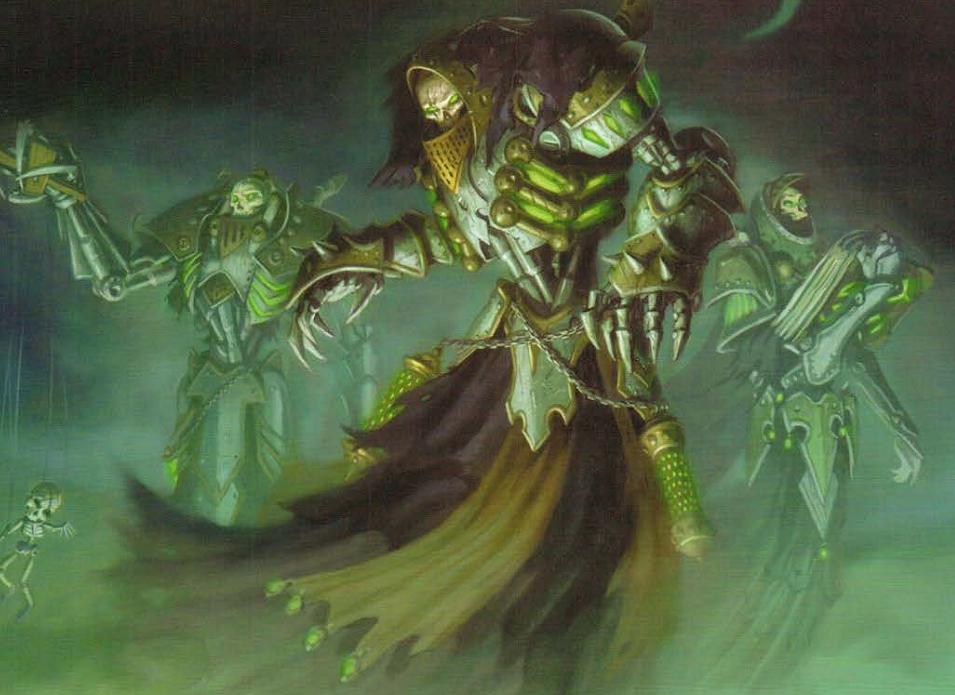
The Withershadow Combine have been one of Cryx's subtler tools for five centuries. They are a trio of liches who penetrate mainland cabals with their arcane lore, which includes many Orgoth secrets and other forgotten powers. Their origins and true agenda are unknown, but they are obedient and quiet in service. Earliest sightings of the eldest, Admonia, date back to the rebellion against the Orgoth, which she spent much time watching. She is fascinated by the origins of magic on the mainland and has stolen from ruins of both the rebels and the Orgoth. Passages in apocryphal journals suggest these include the Arcanist's Academy, the tower of Scion Nivara and the grave of Scion Stacia. There is some truth to it - the Thamarite cabal known as the Shroud seeks her destruction in hopes of recovering relics. Maelovus, on the other hand, knows much and was first seen on the Sand Narrows during an outbreak of Brackriver plague. Locals witnessed him taking souls on the shore so often that they began to make offerings to him as an incarnation of death, sacrificing an entire generation of children to his name. Tremulus joined them 70 years later after service in Cryx's charnel pits. He is fascinated by controlling mortal minds, infilitrating many arcane organizations iwth his power. The Combine has gained a vast understanding of warjacks which they exploit to great effect, thanks to him. Tremulus is insane by mortal reckoning, and the twitching of his marionette makes enemies respond in kind. Together, they transcend their strengths, using their combined power to defeat warjacks with but a touch as they corrupt the cortex within. They harness these corrupted cortexes to contort reality, summoning helljacks and bonejacks from the Cryxian islands.
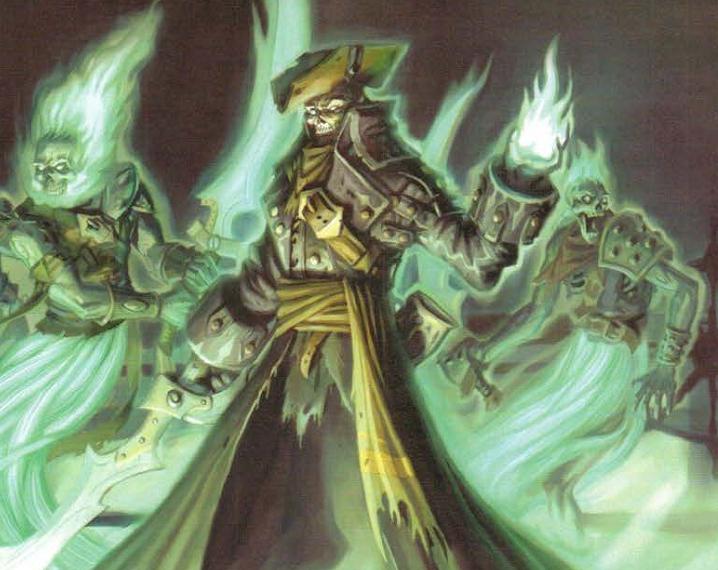
Blackbane's Ghost Raiders are the most elite of the Ghost Fleet, adding to their ranks by harvesting those they kill. They were the original crew of the Atramentous, though, led by first mate Carsor Blackbane, most ruthless of the Darkmoor pirates. Blackbane stood defiantly against Toruk as his captain knelt, and he was burned hottest. He and his raiders were not revenants like the rest, but unholy blazes of Toruk's flame. They roam far from the Atramentous when Blackbane wills it, scouting ahead of the fleet as ephmeral flickers and distant howling. Green fire dances over the waves as they make their way to shore. They can fight on or under water as they need, and they're often the first wave of revenant attack. They delight in ambush through floors and ground, and the howling that accompanies htem is often joined with hissing laughter as they kill. Rengrave sometimes uses Blackbane as an emissary to the fleet, and the Cryxian pirates have learned to respect him. He will often just materialize on a deck and point towards the atramentous, killing anyone who refuses to quickly go meet Rengrave. It is for this reason that he remains Rengrave's first mate after so long. The dead do not know fear, but they respect him, and even they know his reputation for sadism.
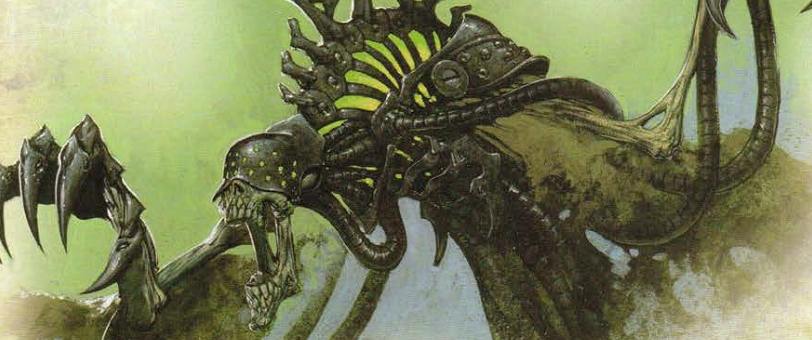
Machine Wraiths are ill understood. Some believe they are ghosts of arcane mechaniks or fallen priests of Cyriss, or perhaps dead warcasters. Whatever their origin, they are terrifying. They are both ghostly and mechanikal, and they follow Cryxian armies, drawn to mechanika and especialyl to warjack cortexes. When they find a warjack, they enter the cortex with a terrible shriek, taking control of it. When briefly dislodged, they become corporeal and vulnerable, but they are still dangerous, able to attack with viciously solid claws in that sate.
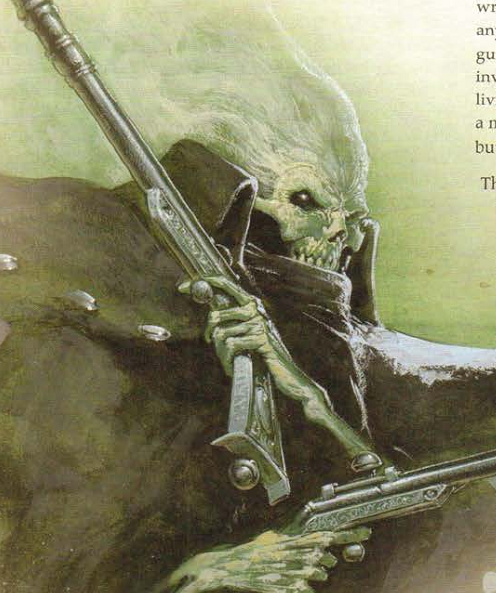
Pistol Wraiths are born from those duelists that become obsessed with their art but feel cheated of immortality after death. They are unable to find rest in Urcaen, stalking the earth in search of victims. Even those who die as part of the natural order sometimes linger on, clinging to memories or hatred. Some fear the afterlife, preferring to hide in death. The necromancers of Cryx have become quite good at finding these gunmen's souls, stealing their corpses and enlisting the dead. Even bound by Cryx, they exist to test their skills in challenge. Those who refuse are gunned down, but those who accept rarely survive, either, for the spectres have a speed no men can match. Each killing gives them a bit of pleasure and surge of unholy energy, but their thirst can never be sated. Llael is home to many ghostly gunmen, who haunt the crossroads waiting to kill other pistoleers. Their connection to the abyss is deep, and those who somehow survive their first shots find themselves slowed by gravechill. Their reactions are slowed, and they can only watch as a second shot is readied.
Next time: Actual names
Forces of Warmachine: Cryx
Original SA post Forces of Warmachine: Cryx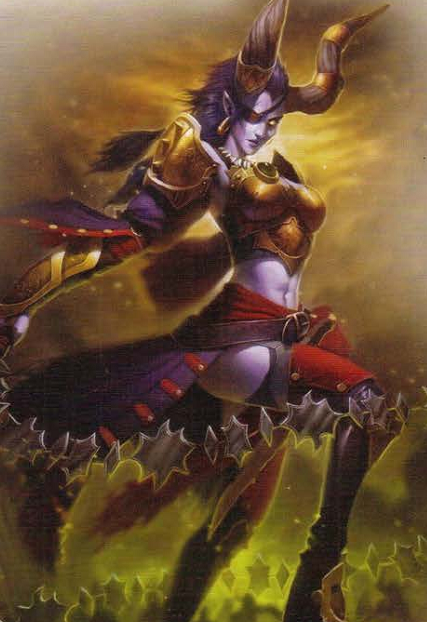
Satyxis Raider Captains are the most fierce pirates of the Meredius, commanding crews of monsters and Satyxis with vicious punishments and bloody lures. The names of their ships are whispered with dread, and all of them have a high price on their heads that they are usually proud of. Their life a struggle, and onyl the most ruthless succeed. They rise above their fellows to command blackships, the most esteemed of posts. Only blackship captains may be counted as peers of the Satyxis queen, Skarre Ravenmane. They are guided by murderous whim, and they are often caught up in slaughter when the battle begins, until their decks run red with blood.
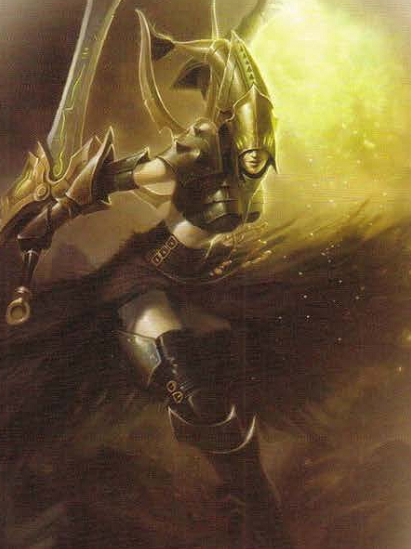
Warwitch Sirens are one the darkest traditions in Immoren, drawn from the Orgoth legacy. They are among the most dangerous of Toruk's servants, receiving no formal training - just indoctrination. Those that survive their rites become killers, cold in spirit and clad in shadow. They serve as field commanders, subservient only to the lich lords, as their predecessors were to the Orgoth tyrants. They have refined their arts, and the sirens enjoy seducing foes before killing them. They can confuse victims by occulding their minds in darkness, making them forget their loyalties for a time. Their blades can turn shadow against their foes, holding them in place for other warriors.
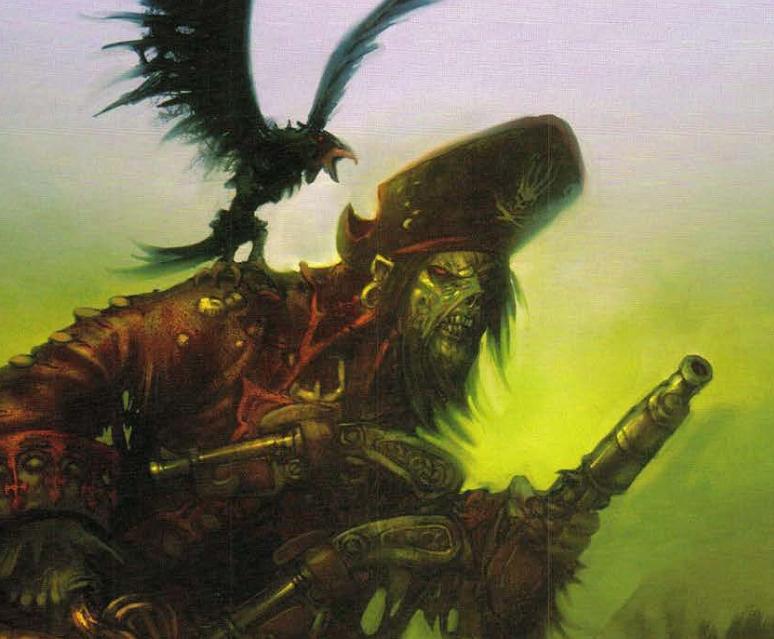
Captain Rengrave commands the ghost ship Atramentous as he has for 16 centuries yet. He was the first to be cursed and blessed by Toruk's fire, and all revenants of the Ghost Fleet have sworn him fealty, and through him, Cryx. Even in life, he had a bloody reputation, nominally serving Threnodax but plundering at will, massacring entire villages for the joy of it. He was notoriously irreverant and loved to murder priests, not even thinking twice before stealing one of the dirgenmast funeral ships of Tordor, loaded with the body of beloved Moorgrave and his treasure. It was meant to sail west, never to return, and crewed only by one devoted vassal. It was the grandest tomb-ship ever built, and its capture an act of blasphemy. This desecration may have invoked Rengrave's doom, for it was the Atramentous Toruk first approached, offering service or death. When Rengrave accepted, the flames washed over him and his crew, turning them into undying revenants. He was sent against the pirate kings to show what happened to those that defied the Dragonfather. In the centuries since, he has become the most feared man on the Meredius, with death in his wake. Even the navies of the Iron Kingdoms fear his ship, most commonly seen on the Broken Coast but able to go anywhere at all. Rengrave is proud and defiant, but faithfully serves Skarre Ravenmane for now. Nothing delights him more than death, plunder and fear. In past centuries, he had to restrain himself, striking only as allowed by the lich lords. However, he has the power to add names to his register, capturing new ships for the Ghost Fleet, and now he captures the living and offers them a choice: serve in death, or just die.
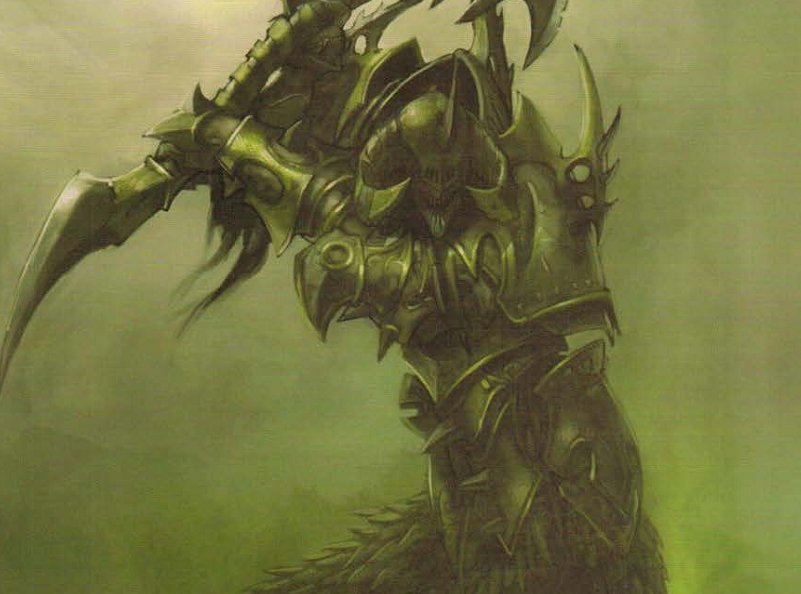
Bane Lord Tartarus is both weapon and general. His essence is linked to the void of darkness from which bane thralls and bane knights are drawn. He cannot deny the unholy impulses of the void, and the runes binding him to unliving flesh, and he calls his host to join him in slaughter. Only a few beings fulyl understand the nature of Tartarus and his kind. Sometimes, the souls of the dead neither linger as ghosts nor enter Urcaen. There is a crack in those realms, a fissure of void, and a few souls fall into it, experiencing unending torment. They can see the crack that kept them from Urcaen, and they are full of hate and jealousy. Lich Lord Tenebrous was the first Cryxian to pierce that realm and contact these spirits, using ancient texts from Morrdh and bringing them back into rune-carved bone. Some souls are particularly resonant with bane energy, retaining their own identity and power. Tartarus is one such, turned into something terrifying. Nearly three millenia ago, the Molgur chief Horfar Grimmr lead an attack against the wall known as the Shield of Thrace, one of the last battles against Priest-King Golivant, in which the Molgur were shattered. Grimmr was captured by the Menites, tormented for a month before being burned to purifyh is Devourer-taint. As his flesh burned, his soul lashed out, too powerful be contained by the rite. It fell through the rift, and due to Menite curses it could not reach Urcaen, languishing in the void. There, it became something else, losing its memories. Over two thousand years it lived in this state, until called forth by Tenebrous. The lich lord bound it into the stitched remains of several warrior-kings as a unique masterpiece. Bane Lord Tartarus, as it was now called, was given rune armor and the axe Rivener, to dominate the bane thralls of Toruk. Tartarus has wandered Immoren for centuries, seeking the forgotten dead. He has brought forth other potent souls from the void, arming them and giving them purpose. Because his essence is a continuous conduit to the void, he spurns the rites and ritual normally needed to make bane thralls. Lesser necromancers need runes - Tartarus just needs to kill and cast souls into the abyss for but a moment. Almost efortlessly, he consigns his foes to an eternal service of torment to himself and Cryx.
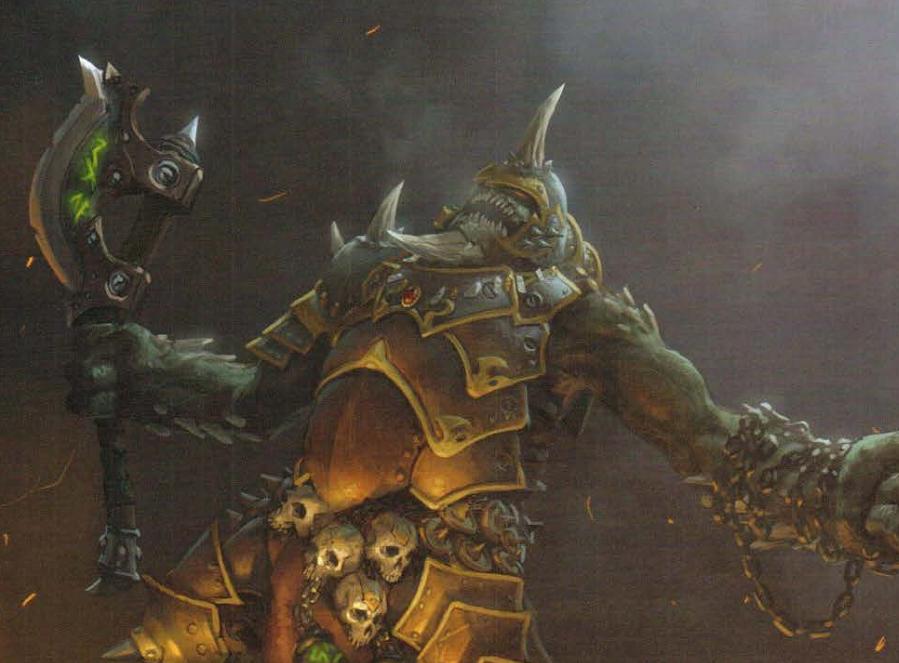
General Gerlak Slaughterborn is a monster, leader of the blighted trollkin. The Bloodgorgers claim that if they were piled up, the bodies of those he's killed owuld make a bridge from Garlghast to the mainland. Cryx has found better use for the bodies, though, and the necrotechs follow in Slaughterborn's wake, collecting them for the use of thrall-making. He is a nightmare even to the Bloodgorgers, his height and bulk equal to any ogrun's. He has shown no signs of aging and has immense stamina even by trollkin standards. Only when he unleashes himself in battle doe shis true strength come out, however. He gorges on his foes, and each kill empowers him, with his axe ignoring armor and bone to fell his foes like wheat. He earned his place by uniting the warring kriels of the Scharde, which had long been fodder for Toruk. Some of them rejected Gerlak, so he killed and ate them, seizing control of the Bloodgorgers. He then sailed for Garlghast, swearing fealty to Lich Lord Terminus and offering him countless severed heads. For this, he was made general, though Terminus didn't expecth im to live long. He was soon sent on many suicide missions, and each time he either won or came back as the sole survivor of his unit. He is one of the most respected battle leaders of Cryx now, famous for his war-hunger. He controls all the blighted ogrun and trollkin of the Scharde, recruiting them with the offer of flesh and blood. His most recent brush with death was more narrow than most, assaulting Highgate to distract them against Terminus' landing north of them. While Gerlak's army did far more damaage than anticipated, they fell almost to the last, and he was buried under their corpses, mutilated beyond recognition. He rested there two weeks, eating the rotting flesh of his own dead as his arms and legs regrew. Afterward, he returned to the Scharde only long enough to get a new army.
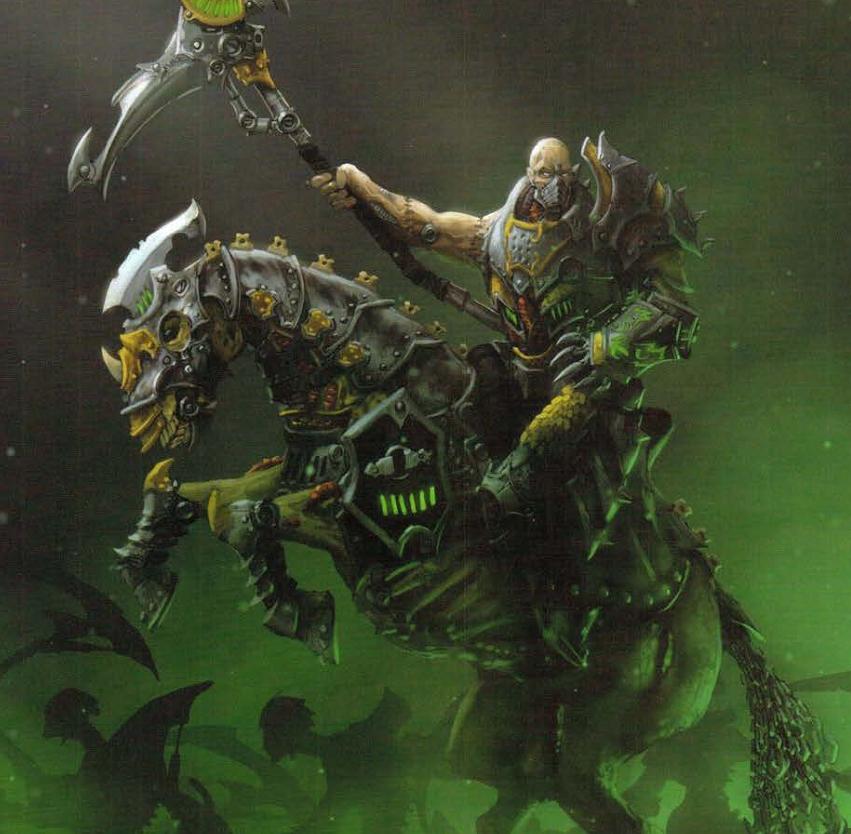
Darragh Wrathe is one of Cryx's most feared leaders. He was once a cruel pirate, but his body began to fail him due to dragonblight. That he still survives is a testament to its influence. He considers the disease ab lessing, proof that Toruk's energies flow through him, and it is these energies that power his magic. Eventually, he retired from the sea to Skell, sekeing necrotechs to replace his heart and lungs. He entered the service of Terminus, studying necromantic lore. Terminus made him a personal agent and vassal, and Wrathe hopes to eventually become a lich like his master. He loves to replace parts of himself with mechanika, perhaps the last human emotion he still has. His mind and soul have mutated, viewing the decay of his body as a necessity and his prosthetics as marks of progress towards attaining a form worthy of Toruk's favor. With each augmentation, he strips away the flesh of mortality and gains connection to death. He serves Terminus directly as field commander and necromancer, traveling across Immoren with a soulhunter escort. He seems to have some connection to the flayed horsemen, using his power to turn them incporporeal long enough to avoid attack and harvest their foes. Over the years, he's become more machine than man, but he is still alive. His chest contains a mass of pumps and iron organs that keep his blood and bile flowing to what flesh remains. Armored plates grafted to his broken flesh protect him, and his lower jaw is replaced with bands of steel, so he speaks with quavering buzz through his throat grill. He has replaced his left arm with a mechanikal claw, and his right arm is reinforced by pistons. When riding his steed and commanding the soulhunters, he executes his orders with a deep conviction, eager to push his strength to the limit. His devotion is not for power, but from total faith in Toruk.
The End.
Next up, Circle Orboros.
Forces of Hordes: Circle Orboros
Original SA postBut all of Haley's bizarre misadventures lie in
~THE FUTURE!~
Now is Circle time.
Forces of Hordes: Circle Orboros
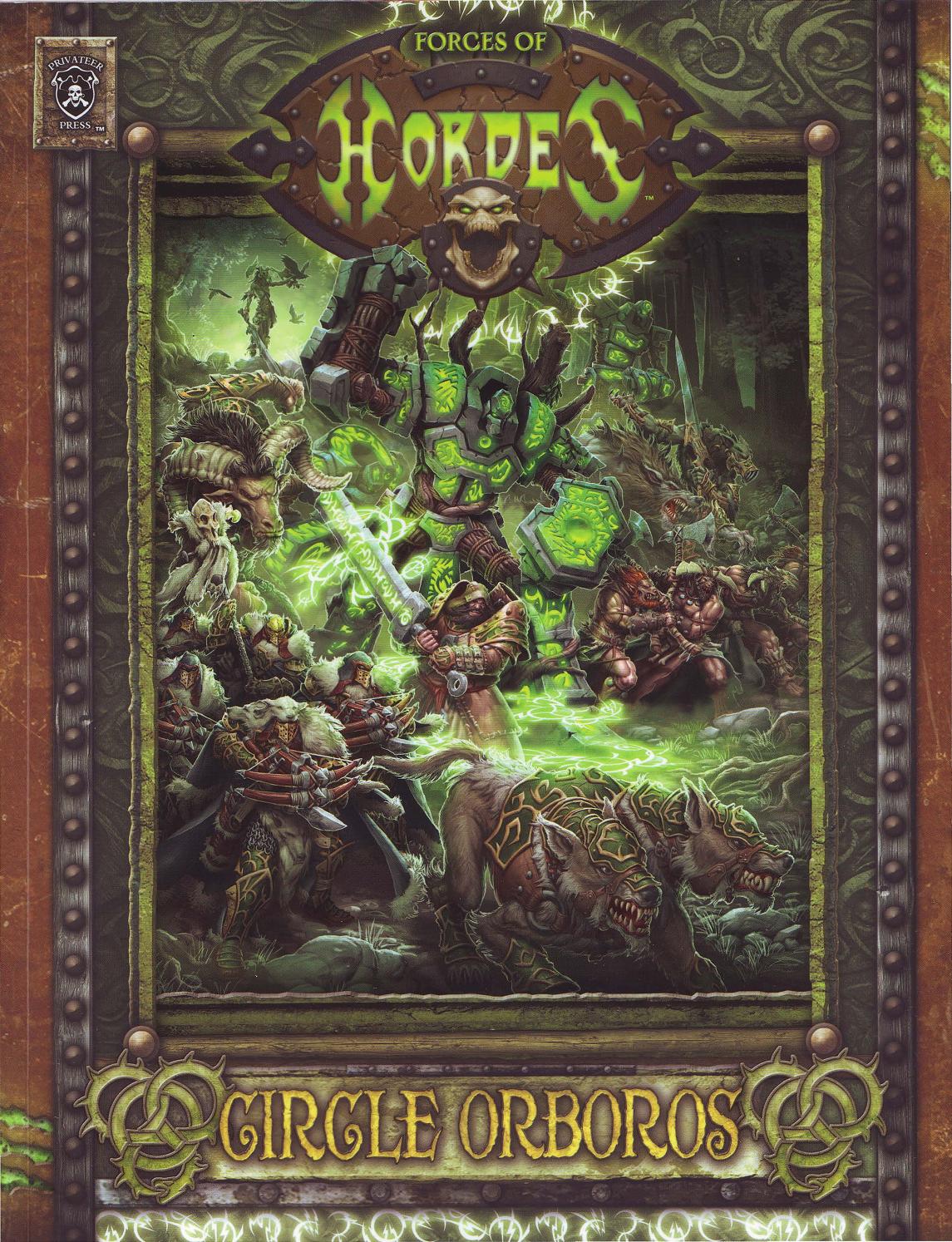
The Circle Orboros are the oldest organization in Immoren, bending nature itself to their will. They have joiend together to destroy those who want their sacred places or whose existence is a defiling of the world. They use immense monsters and great stone constructs to fight, excelling at guerilla warfare. They are very maneuverable, especially in forests, and have very powerful magic options.

The Circle is the oldest human organization in western Immoren, made over thousands of years of coordinated efforts. Few outside their inner circle suspect they're anything but weird druids and their personal armies. They operate in scattered cells, using a network of natural sacred sites to communicate and travel immense distances. When roused to war, they are unparalleled in use of terrain against their foes as well as immense elemental power. Those loyal to them live in the wilds of every nation, in the forests, swamps, mountains and deserts. Families in these remote areas are bound by ancient oaths and stand ready to fight. The barbaric peoples have allied with the blackclads, and they manipulate other species to fight for them. They fight as they ever have, at the head of a horde that would smash the cities of men and cast all the world into an eternal dark age.
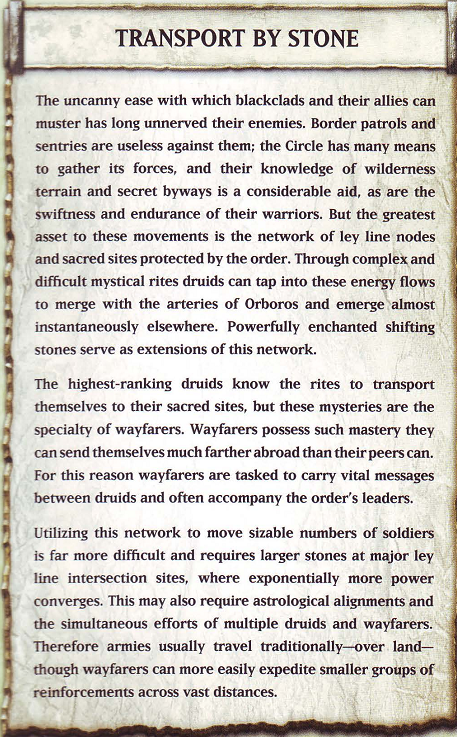
Outsiders believe the blackclads worship the Devourer Wurm. In truth, they just placate it, recognizing it as the conscious aspect of the primal Orboros and working to ensure it remains distracted by its eternal war in Urcaen. What is on Caen and gives them power is the unthinking body of Orboros, and their labors maintain the ley lines that are its circulatory system, keeping it strong. Civilization chokes it, disrupting rivers, hills and mountains. When the body becomes too riddled by damage, the Wurm will realize its weakening nature and return to exterminate humanity. The Circle believes that this is inevitable. Civilization pushes back against nature, and even the war between nations has not reduced human populations. Violence on any scale, therefore, is justified. Even were all great kingdoms ended, it would not fix the imbalance, after all. Thus, they willingly ally with cults and barbarians. They are callous about slaughter, plague and famine, but their goal is to prevent greater destruction. They seek to preserve a place for humans on Caen. They claim all wilderness in western Immoren, choosing the sites of their mystic stones carefully based on their understanding of the flow of Orboros' power. They work constantly to identify, free and tap into the wild energies, believing that the stars and planets themselves are tied to the flow of Orboros' blood. By combining ley lines and celestial conjunctions, they can use extremely powerful rites.
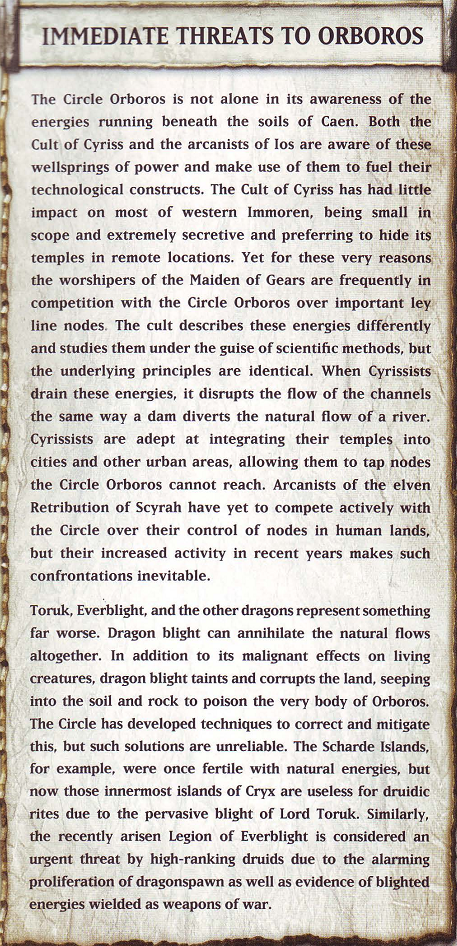
The Circle's armies exist in part to protect these territories, and their power is concentrated in the sacred places. Some of the richest fonts of power are near regions of interest to civilized nations, like major rivers or mountain passes, including the mouth of the Black River, where Caspia and Sul are built. They are one of the oldest and most lasting injuries to the body of Orboros. To master the natural energies, the druids are obsessed with personal power. There are very few of them, and so each must become as potent as possible, putting their own survival above all others. The order is at once hierarchical and fiercely independent, with each individual interpreting the order's goals on their own. As a druid masters the elements, they gain allies, guardians and monsters of war, which can be combined to create huge armies. While the apocalypse looms, the Circle has more immediate threats to the sacred spaces, like the dragonblight, and the balance is a distant abstraction - what matters right now is the day to day problems.
While the Circle has many allies and minions, the druids are the ones in charge. There are ranks within their number, and you must earn advancement to lead or gain large territories. The Circle guards many secrets, and only the topmost understand its inner workings. This has worked for thousands of years to reward the skilled and ambitious but limit those who can't meet the standards. Each blackclad is born with the potential for near endless power - the wilding, an innate connection to Orboros by the random and arbitrary selection of the Devourer Wurm. It cannot be taught, so the Circle must find these people as soon as possible and train them to control the wilding. Should their parents be unwilling, they are entirely unafraid to steal children. Some believe they sacrifice this children, which only adds to their dark reputation. Over the centuries, they have refined their methods of finding the wilding anywhere, often tracing bloodlines known to manifest it and binding them to the Wolves of Orboros. Unlike outsiders, these families will happily surrender wilding children to the druids. These young druids are known as wilders, and it is vital that htey learn self-mastery by guide rather than being taught, as each manifestation is different. Most learn to control beasts and branch out into other areas from there, however. They have no authority and must obey superiors at all times. Sometimes, the wilders are gathered and taken into battle to train their potential, and sometimes they end up dying. Everything that can be done to prevent this is, but losses are inevitable.
Wilders that survive their training are promoted to warden, entrusted with supervision of parts of larger territories. They maintain these small regions, attending to the stone pillars in each that channel the energies of the wild and protect it. They are small, but larger than anyone person can patrol. Often, the locals - animal or human - act as the warden's eyes and ears, and as cannon fodder. Wardens inherit relations from their predecessors and carefully maintain and preserve them for the next. They begin to specialize in some forms of druidic magic. Some become wayfarers or stone keepers, focusing on the ley line networks and the stones that enable long distance travel and communication. Some focus on controlling beasts like the argus, gorax and satyrs. A few become stoneshapers, making wold constructs, and others specialize in summoning destructive elemental power.
Wardens that mature in power may eventually become overseers, who supervise multiple territories and the wardens attached to them. Often, there are many differences and distances between these territories, and it's the overseer's job to ensure the wardens do what must be done as well as gathering forces for larger conflicts. Not all druids are meant to be on this level, and some specializations are not expected to manage subordinates. Giving overseers disconnected territories means htey become familiar with many geographic regions, and more importantly, it means that each of their territories is under a different potent, so they must prioritize tasks from many masters. An accomplished overseer must not just be powerful, but skilled in prioritizing and assessing the skills of subordinates to get jobs done. Successful overseers can be initiated by the potents into many mysteries, and it is at this point that many learn the rites to become warlocks. Subordinates may understand the fundamentals of beast control, but they lack the deeper communion needed to push them to their limits. Veteran overseers learn to bind wold constructs and living beasts utterly, as well as how to shunt injuries to their beasts. Few blackclads ever advance beyond this rank, even if they become very powerful.
Potents are the true masters and generals of the Circle, an elite tier just below the top ranks. They know more than most the secrets and plans of the order. Every one of them has unique power and abilities, governing their diverse territories by many means. No two run things the same way. The system the Circle uses to divide up their territories is meant to prevent the order from fracturing into local cabals. When a potent is raised, they are given different territories by each omnipotent, so they don't answer to any one leader. This balances the three omnipotents, but hasn't always been enough to prevent hidden loyalties and secret agendas. A potent will meet with all three omnipotents, answering to whichever has sway over the place things are going on in. In reality, when not given specific jobs, potents have a lot of latitude to do as they like, but they are expected to govern without aid from their peers or subordinates, using a web of alliances and servants directly. Their territories are vast, but not equal. Some expand their domains by reclaiming lost nodes or usurped strongholds. The most pervasive and influential are Movahna the Autumnblade and Krueger the Stormlord, each ruthless, cunning and very powerful, but even the least influential potent is formidable indeed.
The three omnipotents head the Circle. They inspire dread and awe even among the blackclads, and they alone know the most terrible secrets and rites. They hold the legacy of the order's pacts, with powers linked to the Devourer Wurm, like the Lord of the Feast or the Tree of Fate. It is possible more omnipotents would be named if the Circle extended itself beyond western Immoren. Their unique sensitivity ot the ley line network allows them to extend their awarenss over vast areas. Little happens in the wilderness that they don't know about, and the full scope of their authority is undefined, reliant on their ability to enforce obedience. They expect their shared commands to be obeyed, but territorial hierarchy lets some potents have leeway in interpreting commands. The Circle has long given priority to success over precise obedience, and some potents, like Krueger, are notorious challengers of authority. The fall of an omnipotent is an immense event, requiring the surviving of the triumvirate to select a successor and initiate them via special rites to unlock their deepest power. The most senior omnipotent is Mohsar the Desertwalker of the east, then Dahlekov the Black Cudgel of the north, and at last Lortus the Watcher, recently elevated to control the south after the death of his predecessor, Ergonus, against the trollkin kriels. Despite being promoted in the midst of chaos, Lortus has risen to his challenges with admirable skill and is widely considered the most approachable omnipotent.
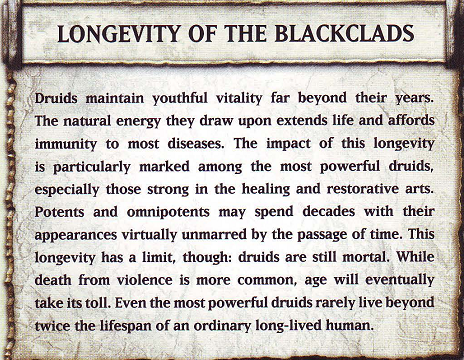
Next time: Druidic forces
Forces of Hordes: Circle Orboros
Original SA post Forces of Hordes: Circle OrborosDespite their immense power, the blackclads alone are far too few to be an army. They rely heavily on their allies, whether bribed, oathbound or manipulated. The most important of these are the Wolves of Orboros and the Tharn tribes. The Wolves are most closely integrated, most numerous and best organized of all the Circle's allies. For many centuries after the birth of the Circle, they were served by warriors of the Devourer-worshipper tribes. These communities prayed to the totems of the Beast of All Shapes, viewing the blackclads as embodiments of their god. In time, the druids consolidated these tribes, and the wolf totem rose above the others. Wolf pack symbology was useful to the druids for the values they wanted to give their forces. Wolves of Orobros are trained to hunt in loyal, tight-knit groups against prey named by the blackclads. Their weapons and methods have changed little in centuries. They rely on hunting tools easily made even in small villages, and cleft-blade wepaons have always been favored by the Wolves, just as with any other group descended from Devourer cults. The spear and crossbow are their traditional weapons, and they are skilled in ambush, wilderness terrain and tracking. They kill wolves and use their hides as clothing, but it is out of respect, and many of them capture and train wolves to fight alongside them in battle.
All Wolves see themselves as brothers and sisters, but the organization is ac ollection of similarly trained and equipped by geographically isolated groups. Through the wilderness, men and women swear allegiance to the ancient society, inheriting older pacts and promises made by their forbears, often their own ancestors. There is limited communication betwene groups except as coordinated by the druids, and the Wolves are sworn to serve individual druids, with only limited awareness of their internal ranks or goals. Every generation brings new recruits, including some less dedicated to the Circle, who just want to be mercenaries. They rarely rise far, but sometimes develop lasting ties to their brethren or become converts to the ceremonial traditions. There's only a few ranks in the Wolves, as most are uncomfortable with rules. Despite their training, they lack the discipline of soldiers. Most warriors are Wolves or Reeves, depending on their discipline. Groups of Wolves are led by veterans known as huntsmen, with the most senior being Masters of the Hunt. These leaders answer to regional chieftains, usually the oldest and most experience Wolf in an area. The chiefs directly interact with the druids to determine the best use of their forces. There are no formal ranks above chief, but some individuals rise to prominence, like Wolf Lord Morraig, a living legend. Some druids rely more heavily on the Wolves than others, especially those born among them. The Wolves are those that die most often when the Circle goes to war, but they are repaid in many ways, sheltered from the authorities and cared for well, even after the Wolves' deaths. It's said that an orphan of a Wolf can find mothers and fathers in every fringe village.
The Tharn, on the other hand, are a Devourer tribe known for fierce savagery. There are no more vicious foes of civilization, and increasingly they have been a vital Circle weapon. Through generations of sacrifice and devotion, they have transformed themselves into inhuman creatures, claiming as their birthright the ability to channel the Wurm into theirb odies, transforming them for power or speed. They are everything civilization fears about the wild men and women. They have endured many trials, and if not for the druids they'd probably have died out like the other barbarian tribes. They nearly did after a border war between Khador and Cygnar in 295 AR. The exact events are uncertain, but they gave rise to the Curse of Ten Ills, which rendered the Tharn largely infertile and reduced their numbers immensely. About thirty years ago, Morvahna the Autumnblade broke the curse and amplified their fertility hugely, giving rise to many twin and triplet births. The Tharn have quickly regained their old numbers and stature, committing themselves utterly to the Circle.
The Tharn warbands are varied and loosely organized. Men and women contribute equally. The men become ravagers, channeling hte Dovurer to become larger, more muscular and tougher, able to slaughter ozens with their huge axes. Bloodtrackers are the most fierce women, an agile counterpart who are experts of stealth and javelin usage from ambush, channeling the Devourer for speed and to augment their senses. Similar to them are the wolf riders, who ride their miunts for extra speed, mobility and power. Tharn ravager shamans and female bloodweavers draw on blood magic to support these forces, killing their foes in gruesome but effective rituals. Tharn society is primal and chaotic, with the strong controlling the weak. Life is unforgiving, cycling betwene battle and revelry. They are fierce and passionate, but highly loyal. The warbands are led by beast lords, but the tribes, known as tuaths, are led by chieftains. Longevity among them requires immense skill, given their societal violence, and the young watch their elders for any sign of weakness. Most tuaths are isolated, but periodically notable chieftains will rise to king or uqeen. Theoretically, any can claim the title, but without recognition it's a hollow boast that will invite challenge. Recognized kings and queens, like Kromac the Ravenous or Nuala the Huntress, command the loyalty of dozens of tribes over wide regions. Coordination with the druids is fluid, but the Tharn will generally listen to any blackclad. In cases where druids compete, the Tharn fall back on personal relations and oaths. The druids have never needed the subtle manipulation and deception so frequently used on the trollkin, gatormen, farrow, bog trogs or other wild species. The Tharn just like to fight.
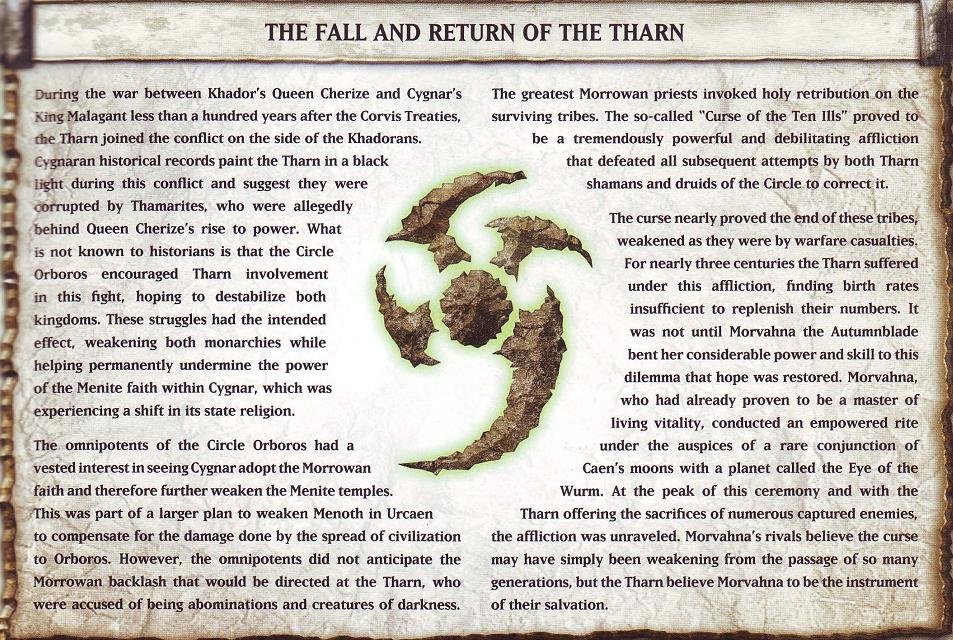
Not all of the Circle's servants can easily be called men or beasts. The warpwolves owe their origins to rituals originally drawn from the Tharn, and they are one of the Circle's greatest weapons. For more than a millenium, the Circle beast masters have evolved the process of making them. Once, they used alchemical mixtures to catalyze the transformations, but eventually eliminated them in favor of rituals performed on ley line nodes during conjuncitons of Caen's three moons. Once a battle is over, a warpwolf returns to human form, but their minds are forever altered. They are not human, and even in human form, the first generation warpwolves are insane, suffering from predatory and violent impulses and an inability to control their tempers. Warpwolves can breed and produce young that carry their power but suffer from a somewhat reduced mental instability. After several generations, some of their descendants will be "pureblood," with no human form whatsoever. These warpwolves are calmer and more accepting of their nature than their feral kin, and are strikingly intelligent, if with utterly inhuman minds. Even to the Circle, they are enigmatic and unpredictable. Druids continue to refine the process, trying to balance intelligence and rage. One of their greatest successes is the warpborn skinwalkers, warriors taken from the Wolves of Orboros to become greater. They are not as strong or deadly as feral warpwolves, but they retain their intellect, and the Circle is seeking other ways to unleash the primal power buried in the human soul.

The term 'warlock' is rarely used in the Circle - it's just the normal extension of a druid's power. Virtually all of the Circle warlocks are druids, and it's a minor distinction related to the specific ability to bind and command warbeasts and wolds. This refined ability takes experience and skill, and the warlocks are potent battle leaders, but all top-ranking Circle leaders can do it, and none who have done it have ever been below overseer rank. Often, the mere mention of their names will cause fear in those who live in the wild places. Like all druids, the warlocks do not choose to join, but undergo the wilding and are found. This connection is poorly understood outside the Circle, but it taps into natural power and elemental chaos, as well as the the concept of predation. The wilding is potent and unpredictable, and it must be tamed and harnessed over years of study. Because it manifests at an early age, most druids remember no other upbringing, so they view the world differently than most. During their mentoring, they learn the nature of the power, how to control it and the philosophy of Orboros. Most important is teaching them how to define their own path and grow their own power, as each druid follows a different course. Whatever their ultimate expertise, however, they all learn some control over the beasts and wolds the Circle uses, and subordinate druids help handle these creatures in battle, but are still pale shadows of a warlock's mastery. Few blackclads reach the rank and power needed to learn the binding rites to become warlocks, and the beasts of the Circle are not bound to specific warlocks, but temporarily joined before battle. Once bound, they can be directed by thought, pushed beyond their limits. Druids who become warlocks learn to tap into the inner essence of the beasts to manifest their animi, and perhaps most importantly, how to shunt injuries to their beasts. Given their sacrcity, warlocks must do anything to stay alive, after all. They are deeply political and ambitious, often scheming against each other for decades, but it rarely develops into fights. Most warlocks prefer to undermine each others' minions. Only the strongest, smartest and most determined druids get rewarded with power and rank.
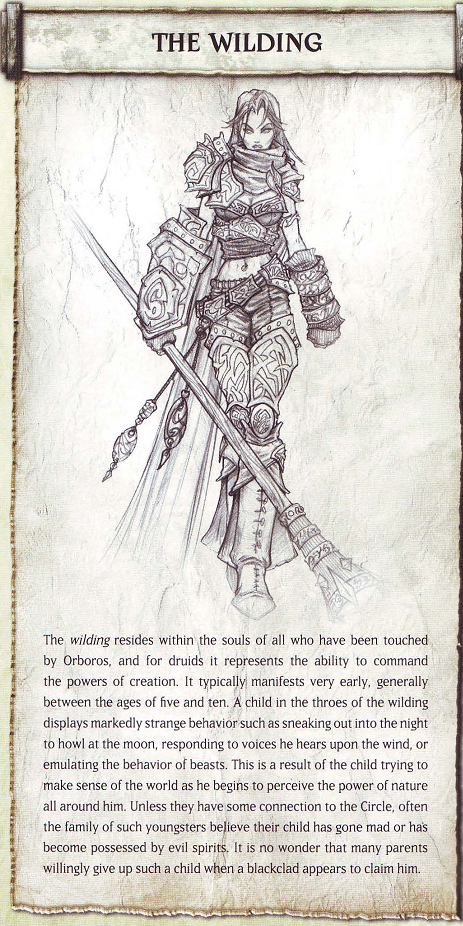
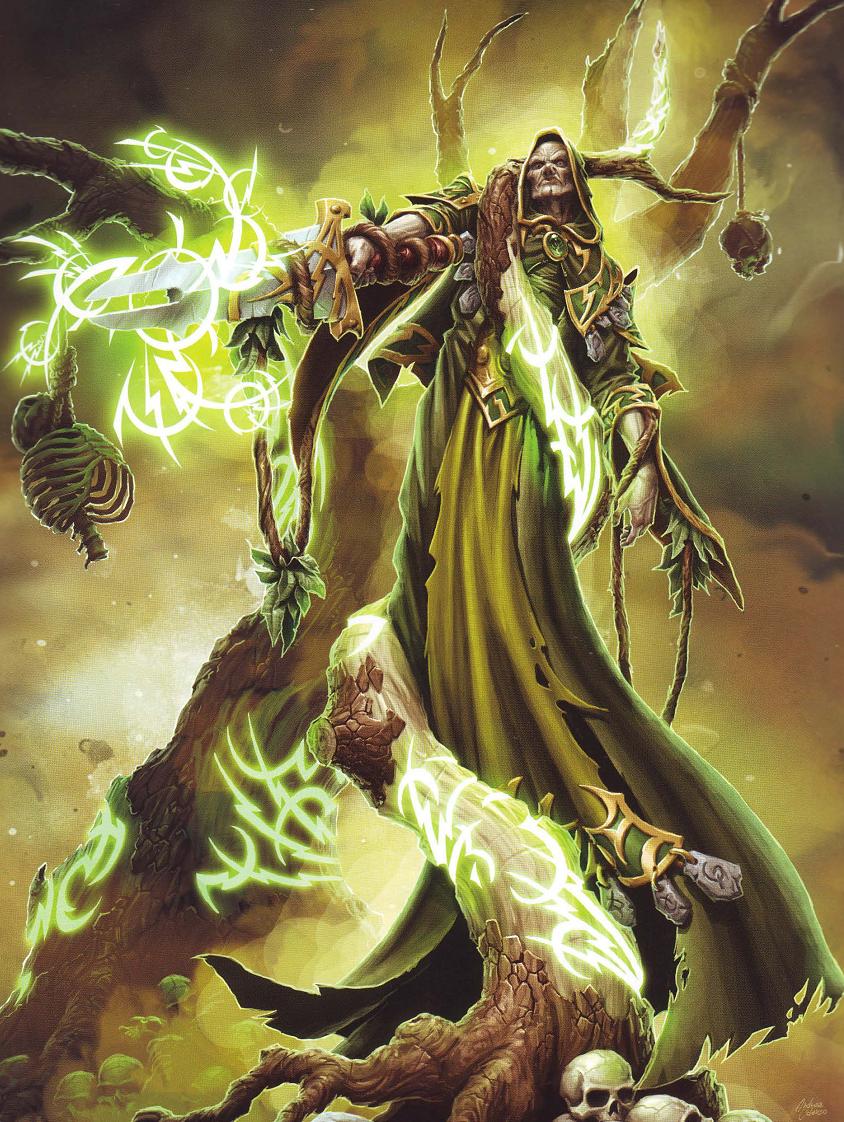
Cassius the Oathkeeper is never without Wurmwood, the Tree of Fate . The first omnipotents sealed great bargains with the manifestations of Orboros, of which the Tree of Fate is one. Before Menoth gave man the first laws and taught them to build walls, the carnivorous tree Wurmwood was there. Unlike most trees, it thristed for blood and was deeply intelligent. The first druids of the Circle persuaded Devourer cultists to sacrifice under its branches, traveling great distances to feed it blood and hang bones from it. These rites endedi n a great ritual in which thousands of men and beasts were killed to give the tree a feast worthy of the Wurm. Great powers of creation pulsed through the air as a single root came forth to entwine a druid, through which the tree spoke its name. This rite let Wurmwood communicate with a human voice and was the first pact of the Circle. Only the omnipotents know its exact terms, but since that time, one druid must always uphold the covenant with the tree, giving their life and soul to become a conduit to Wurmwood. Its mind does not perceive time or Caen as mortals do, and so it needs an intermediary. The tree comes and goes through the natural energies at its whim, able to disappear into fog and manifest elsewhere. For generations, it has lived in many forests and mountains, with the cultists always seeking it out to feed it blood. The druids periodically make their own sacrifices for its wisdom, and it is invited to most Circle deliberations, where it is given great privileges. When the omnipotents cannot agree on a course, Wurmwood is often called on to choose the best path.
However, mortals age, and when Wurmwood requires a new conduit, the potents gather the wilders. They are chosen for youth, stamina and magical power. Being selected is an unwelcome honor, because it is a great and terrible burden, and leading druids often ensure their favorite subordinates are absent. On the night of Geremor's Feast, Wurmwood kills its previous druid, and its roots choose the selected candidate, encoiling them. If they do not speak the ancient words of the oath, they will be crushed. When the vow is complete, the tree consumes their memories and becomes one with their flesh. Their personality lingers, though, and tree's perspective is colored by it. Cassius, the current chosen, was a cunning and intuitive druid who made his master jealous somehow. The master through the slight avenged when Wurmwood chose his apprentice, but that satisfaction didn't last. The mentor was soon forgotten, and Cassius is now part of an immortal being that manifests the will of Orboros. Perhaps through his influence, Wurmwood has become increasingly active in recent decades, manifesting at times and places of its choosing to olbiterate the foes of the Circle. The tree accepts any sacrifice, but prefers the blood and souls of its foes, and its war hosts are particularly vicious when it urges them on. The Tree of Fate appears where it likes, judging the worth of the dead as their blood feeds its roots. It violence is a suggesting of what awaits all things should the Devourer awaken. Cassius and Wurmwood's gimmick is controlling movement and raising up forests. Their feat creates a giant forest around Wurmwood temporarily that knocks enemies over and hurts them.
Next time: More druids.
Forces of Hordes: Circle Orboros
Original SA post Forces of Hordes: Circle Orboros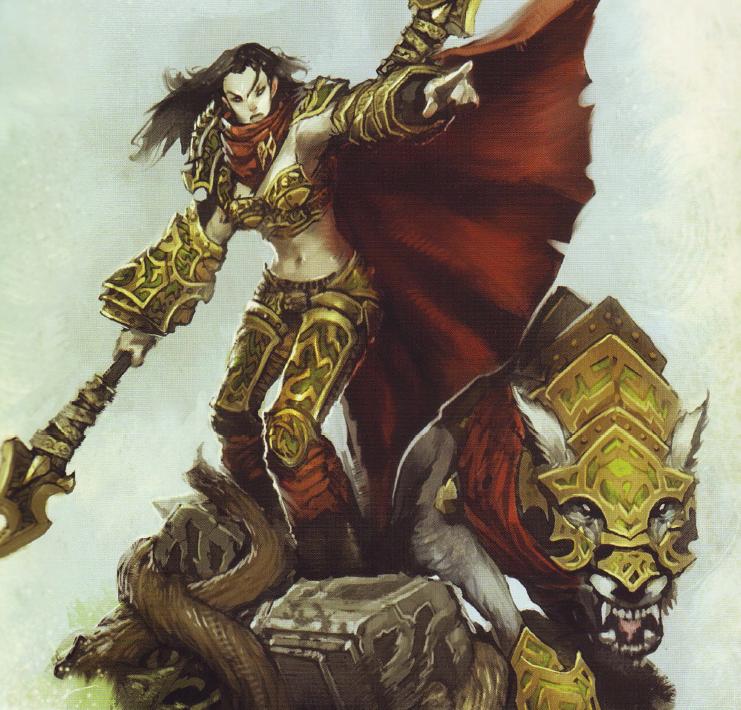
Kaya the Moonhunter is Epic Kaya, always seen with her wolf, Laris . She stands now on the precipice of greatness, driven both by joy of battle and a firm belief in the Circle cause. Laris is a reflection of her predatory spirit, the other half of her soul, and they have a deep bond. Kaya's power flows through Laris, and he feels her pain more than his own. Outside battle, he calms her, and his desire to protect her is a good contrast to her recklessness. Finding Laris was not easy for Kaya, and one key was learning the role of celestial conjunctions to Circle magic. She studied under Morvahna the Autumnblade, learning to tap into the tie of the moon to predators, and Morvahna sent her on a rite to climb the Wyrmwalls to unlock her inner power. There, she found an ancient sacrificial site, giving of her own blood under a thunderstorm. The clouds parted, revealing the three moons of Caen, and a great white wolf emerged from the woods at the peak of the ritual. She look at it, and she knew its mind, sensing its invitation to hunt. She joined it, and the two of them bonded forever as they hunted the mountains.
Kaya named the wolf Laris, for the second moon, which the ignorant call wicked and evil, for it is associated with storms and bad luck. Laris has proven to be a calming influence on Kaya and her warbeasts, and she can sense warnings from him and see what he sees. He does not speak, but is very clever and perceptive, and extremely brave. While she is calmer now, it is a predator's calm, lacking sorrow and compassion for the kills she must make, much as a wolf feels none. Even Morvahna was a bit unsettled at how Kaya transcended her expectations on that rite, moving beyond the need for mentors. Kaya has learned from experience that some of her peers will try to exploit her, and once, she only thought about the present, not caring. Now, she has learned to move past it, learning deeper rites, and is very appreciative of Baldur the Stonecleaver's teachings, intending to heed his example by focusing solely on the enemy and ignoring all distractions or manipulations. She and her beasts move like lightning alongside Laris, watering the earth with enemy blood. Kaya's gimmick is still warbeasts and buffing them, and her feat essentially lets her ignore range limits briefly and call her beasts to her. Laris' animus lets him teleport to Kaya or vice versa.
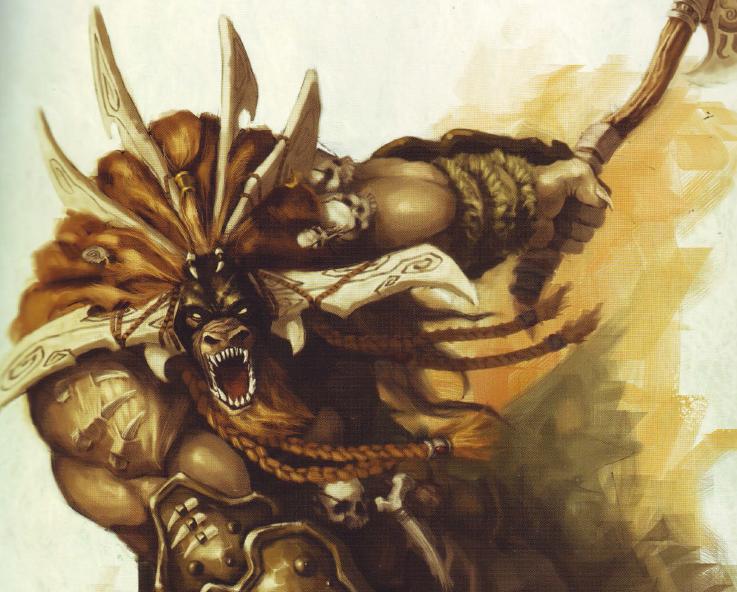
Kromac the Ravenous is a barbarian king of the Tharn, who hang on his every word when he walks among them as a man. When he calls on the Wurm to turn into a beast, monsters and beasts leap to obey his howls. He is not a conqueror - he is a destroyer. He is not a druid, but a sword to be wielded only reluctantly, because once he tastes blood he does not stop. However, something has always set him apart from the Tharn - he could hear the wind whisper and feel the howls of wolves in his heart. He became a shaman, learning the blood rites, but something told him there was more. In fact, he had the wilding - entirely unheard of among the Tharn. Krueger the Stormlord, once known to the Tharn as Storm Father, came to him and taught him how to use his power. The wilding mixed with the Tharn gifts to bring forth wild strength beyond all reason, allowing him to enter the beast-mind and transform into an avatar of slaughter...but it drives Kromac to madness. The Stormlord is one of the few humans he still respects. He was once a servant of Morvahna the Autumnblade, who broke the Curse of Ten Ills, and he viewed her with awe and longing. For years, he served her, but her disregard for Tharn lives and her willingness to use them as a tool forced him to look on her with fresh eyes. He has now turned on Morvahna, serving Krueger once more. He knows he was born to kill, and he has a lot of work to do. His gimmick is crazy aggression and turning into a death beast. His feat lets him wound himself to amp up his fury massively, and also to shift forms to beast if he's in human form. (He chooses forms each turn or so.)
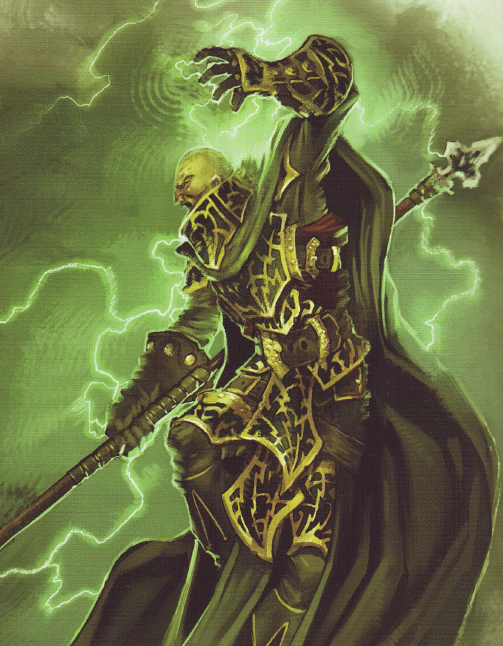
Krueger the Stormlord is Epic Krueger. Even the omnipotents admit that he is among the most potent druids ever, and he is ambitious and ruthless. He intends to change the Circle, and if he makes enemies while doing it, so be it. After the death of Ergonus, he lost patience with the omnipotents. He expected to become one, but did not. It was not until he went to aid Kromac the Ravenous in Thornwood that he realized how limited his perspective had become. How could he grasp the greater picture if he was tied down by petty scheming? He knows now that the omnipotents just sit back, spinning their webs and keeping others in the dark as to the dangers they are in. He believes he is the only man who can leave a lasting change on the world, willing to do what his peers are too afraid to. For example, he felt the Order too complacent about dragons. Rather than obey orders and face Everblight, he went to the dragon Blighterghast, telling him of the threat to the dragon alliance against Toruk that Everblight represented. Krueger thinks the inevitable disaster that will follow well worth it as the price of the first blow against civilization that has ever really happened. The only question is if the Circle can survive the coming storm. Krueger has gathered his own army, full of those discontent with the current order or drawn to his boldness. He promises a return to the primordial roots of the Circle, and he certainly has the raw power to do it. His gimmick remains storm and lightning control, and his feat lets him shove enemies around and debuff them with wind.
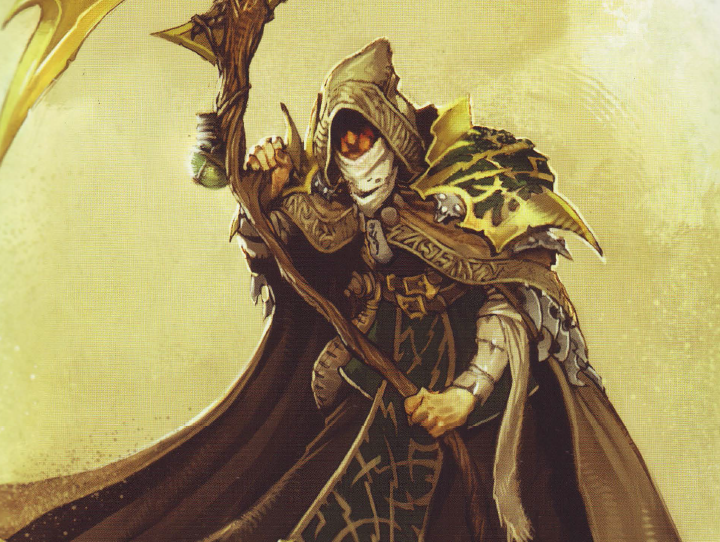
Mohsar the Desertwalker is the eldest and most enigmatic of the omnipotents. Even other druids fear to speak his name. He believes the Bloodstone Wastes perfectly embody the nature of Orboros, as the unforgiving power of nature fills them, and the desert shrugs off all attempts to civilize it. No city can outlast the dunes, and nothing is so beautiful as a cleansing sandstorm. Mohsar is easy to underestimate, for he is blind, but his awareness of Orboros and the flow of life means that doesn't actually stop him. He has learned to call on great power over the environment, cracking the land at his word or calling up great pillars of salt. Even the greatest works of magic do not seem to tax him, either. His hatred of humans is legendary, and he tolerates even other blackclads only when he must. Still, most fear him too much to avoid his summons. He was the tutor to Krueger, and even those that know that have only a small grasp on the savagery of the training. Mohsar is relentless, emanating scorn and willing to use any method to turn his students into polished diamond. He has only recently involved himself in Circle affairs again, which troubles those who dislike him and his allies. He takes no advice and gives none, so even his servants can only guess at why. His gimmick is heat and earth control, and his feat basically shuts off warbeast/warlock bonds temporarily.
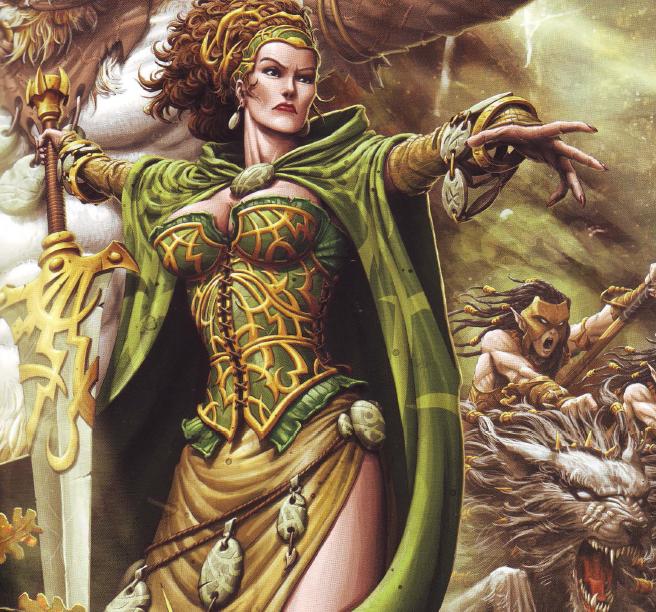
Morvahna the Autumnblade is both killer and healer, tearing foes apart to feed her beloved forests. No druid will willingly seek her wrath, and many want her favor. she is ambitious, clever and charming, reveling in the politics of the Circle and seeing her rise to omnipotent eventually as a foregone conclusion. She achieves far more with seduction than most do with full war, and she has been raised among the Circle since an infant, learning the magic of spring and autumn. She grew on an island off the coast of Mercir, near to both Cryx and the dragon Blighterghast. She has fought dragonblight for years, working to cleanse the outer Scharde, and her territory has expanded over the decades as she reclaims lost land. Only Krueger dares challenge her directly, even stealing the loyalty of Kromac the Ravenous. Bad timing, given Morvahna's position at the fore of the war with Everblight, so she convinced Kaya to assist her. She has endured several setbacks, blaming Krueger for the order's failure to keep Everblight from gaining power by diverting critical assets. Her greatest flaw is arrogance, and she often underestimates others, preferring to manipulate rather than earn loyalty. She has no inclination towards deep attachments, and she feels qualified to judge who must live and who must die. Her gimmick is healing and growth, and her feat lets her drop forests whenever enemies die near her.

The warbeasts of the Circle Orboros are embodiments of the destructive power of nature, both elemental constructs and giant monsters. They are some of the most varied of all beasts in Immoren, and they must undergo special rituals in order to be properly dominated by a warlock. While the Circle is not cruel, they tend to view their beasts as just tools, existing only to serve, and their deaths, while costly, are inevitable and acceptable if goals are achieved. Some are beasts dominated by a warlock, some men turned into beasts by magic, and some are walking constructs of nature. The beasts include the argus, gorax and satyr breeds, and the druids exploit their nature to earn their service or breed them. The warpwolves begin life as humans but are imbued with primal power via fell rites, causing them to transform under stress, when called on or under certain lunar phases, at the price of their sanity. The constructs, known as wolds, are seen as most reliable, as they have no independent mind or instinct, and they are very durable, but they are very difficult to heal or repair, and they take a lot of time to make, especially the big ones.
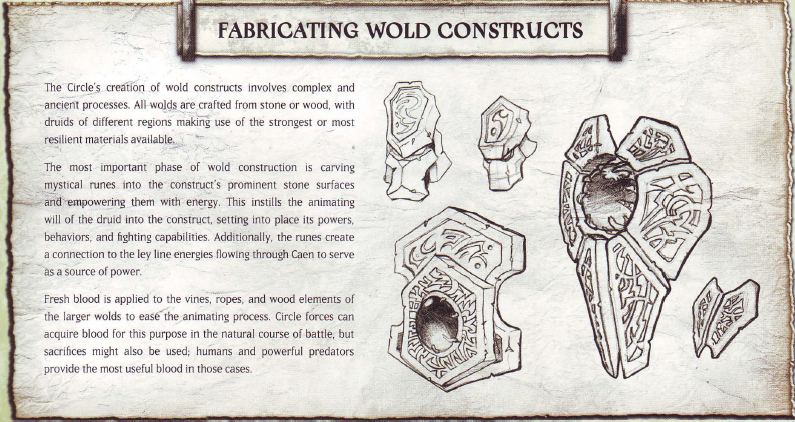
Next time: Big hungry monsters
Forces of Hordes: Circle Orboros
Original SA post Forces of Hordes: Circle Orboros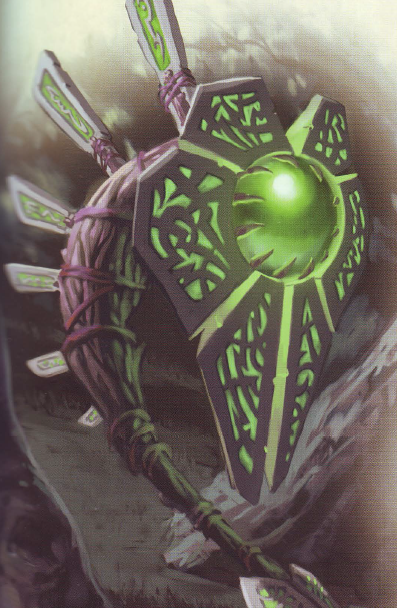
The Woldwyrd is the most overtly arcane of the wold constructs, designed as a small but powerful guardian. Every inch is covered in runes that tap into the ley line network, allowing the woldwyrd to float over the ground, its beryl 'eye' pulsing. It can fire blinding flashes from its eye or unleash an iron-melting beam of power. Few survive encounters with the woldwyrds, particularly mages, whom they were designed to kill. In ancient times, they hunted Menite priests, who burned those that had the wilding. Now, more than ever are being made as versatile weapons. Their animus suppresses spellcasting.
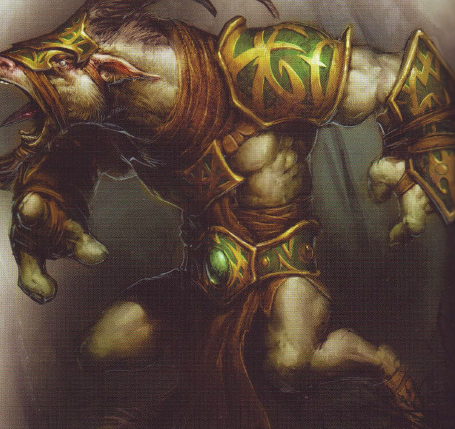
The Shadowhorn Satyr is a rare, elusive beast, only recently called forth by the druids to fight. They are the most agile breed of satyr, enthusiastic for battle and slender, for a satyr, but very aggressive. Mature males often compete in battle for the right to mate, and they are highly athletic, able to use their attackers' momentum against them. They engage in leaping dances, jumping off trees and bounding about, quickly sending foes flying. Their animus improves throws and slams.
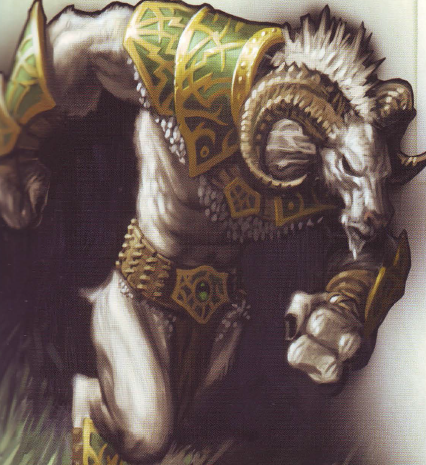
Gnarlhorn Satyrs are pure force, ramming foes with their immense horns from a dead run. Their heads can break bones, and the males often fight each other for territory via headbutt battles. The blackclads have tried to hide them from humanity for centuries, as humans once believed the satyrs to be embodiments of the Wurm and hunted them. The Circle finds them loyal and useful, so they preserved them. Satyrs will not abide mistreatment of that which they protect, and make good bodyguards, charging at any attacker. Their animus improves movement, slams, charges and trampling.
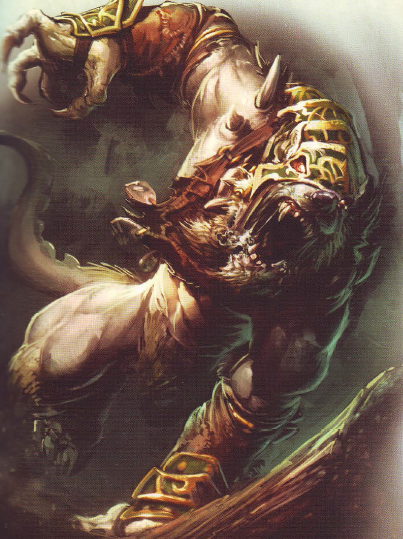
Pureblood Warpwolves have fur as white as the moon Calder, and they may use their blood to turn insubstantial to reach their foes, or to let loose with howls that rend flesh and stone alike. Generations of breeding among those born warpwolves have produced the purebloods, who are free of human taint. The only indication of their ancestry is their intellect, for while they lack conscience, they are far smarter than beasts. They can speak in their wolf forms, but their voices are rough and often hard to understand. Senior druids enjoy speaking with them, as they often have surprising insight and are capable of great courage and tactical brilliance. Their animus blesses the weapons of allies.
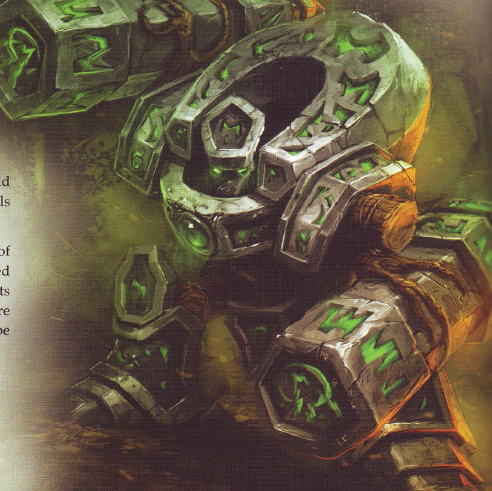
Wold Guardians have only two jobs. First, they defend warlocks, and second, they kill shit. Few have the courage to stand up to these massive stone creatures, which are like living walls. It takes a lot of perfectly carved stone to make one, etched with precise runes and enchanted by gallons of living blood. They are slow, but monstrously strong, with huge, pillar-like arms that can smash through any obstacle. Most of their foes just end up as bloody smears. Their animus reduces damage from ranged attacks.
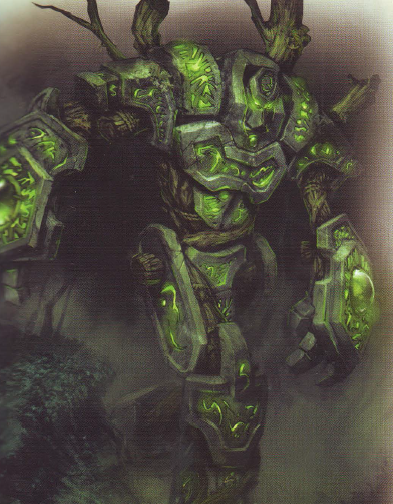
Megalith is a unique wold, Baldur's great masterpiece. It uses living plants as part of its makeup, with long roots coming out of its feet, both steadying it and drinking power from the earth. Its eyes glow with something akin to self-awareness, and it wanders wherever it feels most needed, often finding Baldur just as he needs help. Its stones can seal cracks and damage from battle as if it were made of living skin, and it can cause forests to erupt around it. It took a long time for Baldur to make Megalith, and fully a month to complete the final fusion of plant and stone. When Baldur fell against the arrows of the Legion, Megalith kept him alive and began the slow process of regrowing him, but by bit, with the same power used to create it. Its animus sprouts catching undergrowth around foes.
Next time: Soldiers of Orboros
Forces of Hordes: Circle Orboros
Original SA post Forces of Hordes: Circle Orboros
The druids of the Circle use the Wolves of Orboros as the core of their armies, wilderness warriors drawn from isolated villages across Immoren. The Wolves have an ancient tradition of service, and the druids protect their families and clans in return, partly as payment and partly to manipulate them and watch for the wilding. Traditionally, the Wolves serve out of family loyalty, and they must prove their skill with the group's traditional wepaons and wilderness skills. However, the rise of war lately has required recruiting more mercenary types. Besides them, the Tharn are also heavily used. The Tharn are clinging to a way of life that exists nowhere else any more, and they fight for the druids because they see them as emissaries of the Devourer Wurm. When Morvahna the Autumnblade released them from the Ten Ills, it only reinforced their loyalty. (Plus, they like fighting.) The Tharn channel the Wurm through their bodies, gaining strength or speed in battle. Neither they nor the Wolves understand the purpose of the Circle, but are instead given specific tasks and are then loosed on their foes. The armies of the Circle tend to be a lot more organic than other armies - they don't do ranks and formations, but flow across the field like a living creature.
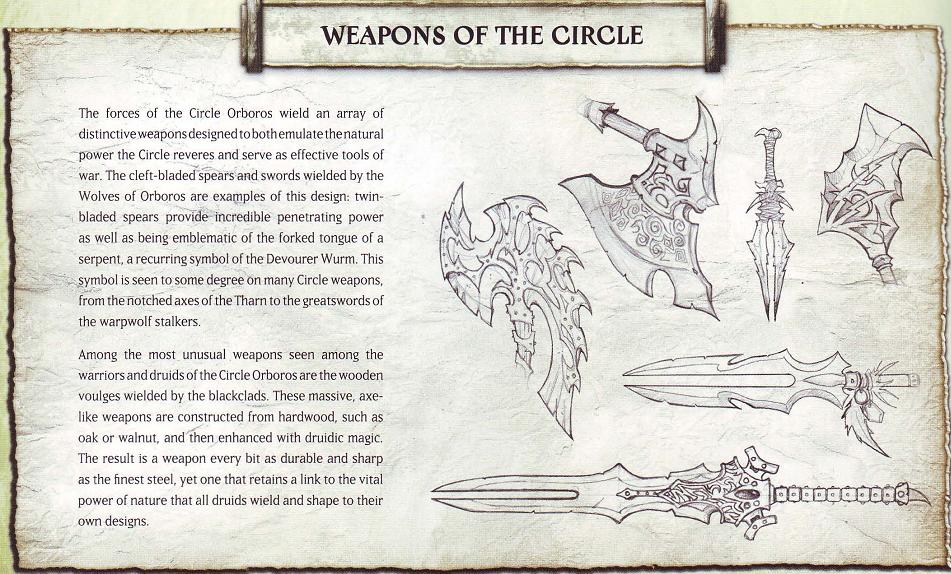
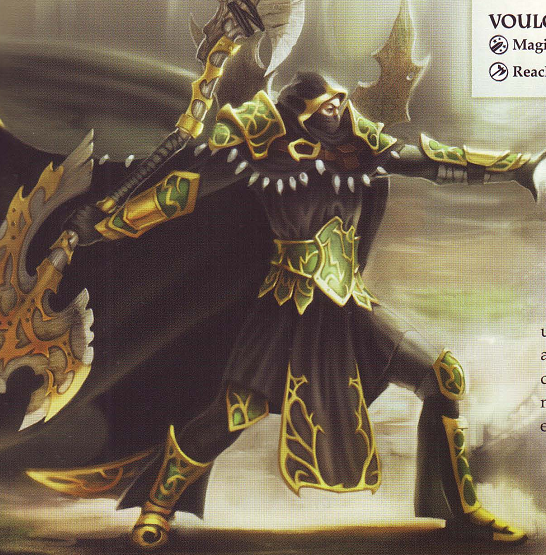
Druid of Orboros Overseers lead the druids in battle. They are more skilled than the warders, and while they may not always understand their missions, they know failure is dire. Potents set the overseers to watch over specific territories and regulate the druids under them. They travle ebtween sacred sites, protecting them and calling on subordinates to serve. Overseers have experienced all the basic paths of Orboros, and they can tap into all of those powers. The earth opens to them, the wind itself is a weapon, and they can call on wild beasts or heal wounds. Even the elements can't hurt them at all.
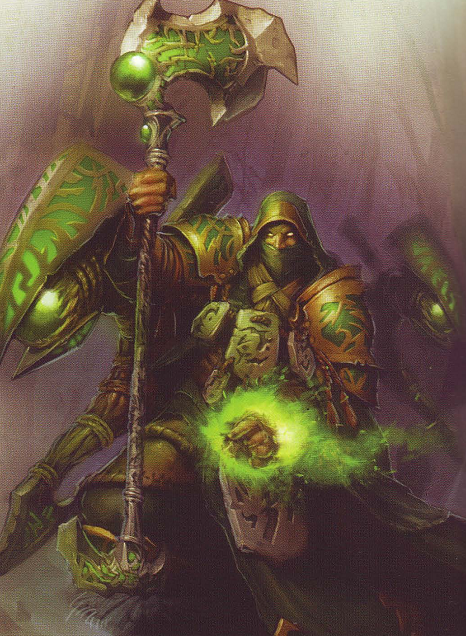
Druid Stonewards command the Woldstalkers , stone and wooden constructs of their own creation. Each woldstalker is an implement of the stoneward's will, guided by mental commands and druidic enchantments. A particularly discipline is required to direct multiple stalkers at once, and the stonewards are well practiced at it. Even after death, their guidance lingers, sending the woldstalkers to follow the druid's last impulses, hunting prey with inhuman perseverence. The woldstalkers are simple in form and function - they're basically floating conduits of energy - but their firepower is formidable in concert. They channel energy up the wooden frame, focused into a small crystal orb that fires elemental blasts.
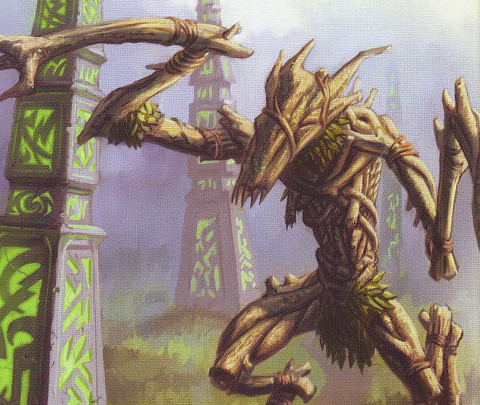
Sentry Stones and their Mannikins supplement the wolds as territorial guardians. Each stone surrounds itself with mannikins, animated constructs of wood and vine. They collapse if they go too far from the stones, but they are deadly killers that enjoy tearing humans apart. The runes inscribed on the stones cause them to mimic reaction and thought, with an innate territorial aggression and the power to devour magic.
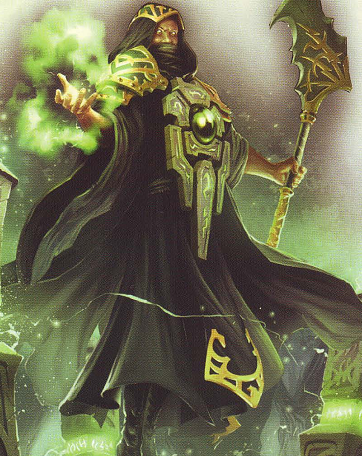
Stone Keepers oversee the shifting stones that connect Circle sites. They are stoic druids who understand their importance to the order, guiding the rest of the Circle where they need to go. They use magic to hide their stones and strike down those unlucky enough to come near them, and while their life is a lonely one, they are deeply respected. They wield the power of the stones, smashing at foes with the earth itself and able to turn their flesh into stone. They deeply understand the ley line network, channeling the reality warping powers of the shifting stones into perfect configurations, moving in harmony with the stones as needed.
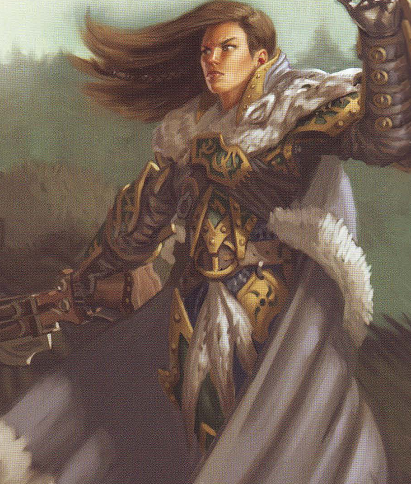
The Reeves of Orboros are the elite among the Wolves, master marksmen with a deep cunning. While most armies consider crossbows antiquated compared to guns, the reeves disdain powder weapons for their noise and the stench they produce. The crossbow, they feel, is superior - you can make bolts anywhere, and it's nicely silent. They use a double crossbow that originated with the Vorgoi and Kos people of Khador, regularly used in their wars of centuries past. The double bows are powerful enough to punch through armor and fire multiple times before needing to reload. Reeves prefer to attack by ambush, then fall back to observe the quarry. They have spent lives hunting and tracking, and they're able to find angles of attack through even the densest brush, so it's practically impossible to hide from them.
Next time: The Tharn
Forces of Hordes: Circle Orboros
Original SA post Forces of Hordes: Circle Orboros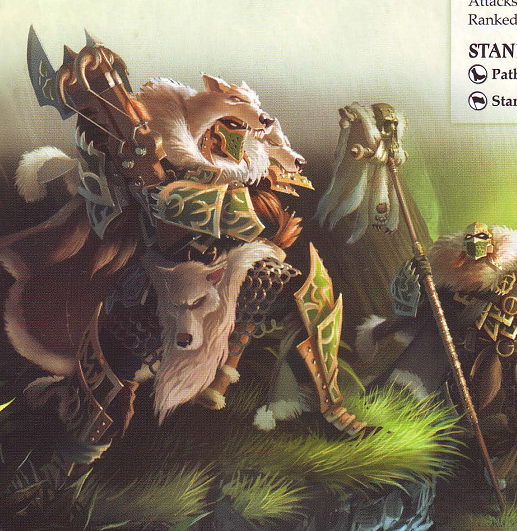
A Reeve of Orboros Chieftain and Standard sometimes lead the reeves. They are the deadliest marksmen in Immoren, embodying the ideals of the Devourer and the wolf. Their standards often ebar a wolf pelt, the greatest their band has ever hunted, which binds the tribe together with vows of blood. These companies are more warrior cult than regiment. The reeve chieftains lead them to hunt and kill like a pack of beasts, moving effortlessly through any brush with perfect harmony and coordination. They reposition easily after kills, moving to clear lanes of fire without needing to think about it.
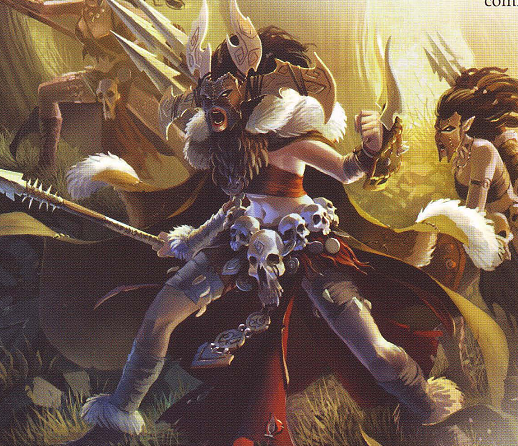
Nuala the Huntress sometimes leads Tharn bloodtrackers in battle. She is a myth come to life, a queen of many tuaths. She enjoys killing, but she has noble goals, seeking to restore the Tharn to the grand age of the Molgur, when the cities of man trembled at the might of the Wurm's chosen. With careful alliances, her tribes have prospered where others have withered or been harmed by the Circle's wars. Nuala is as happy to prey on remote villages as to fight for the Circle, choosing only the best bloodtrackers to aid her in battle. She and her followers descend on their victims with lethal javelins, getting bolder with each kill. Each death is a prayer to the Beast of All Shapes, who grants its protection to Nuala.
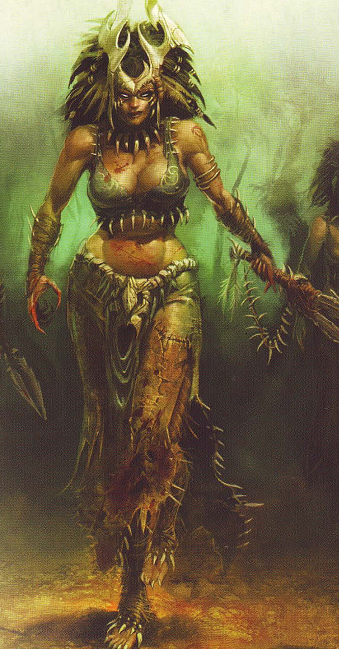
Tharn Bloodweavers are the women who have mastered the arts of blood magic. Their devotion to the Devourer Wurm is absolute. They conduct ritual hunts in accordance to the movements of the Eye of the Wurm in the heavens, drenching themselves in the blood of the dead. Rarer celestial events get greater blood offerings, sometimes bringing together very large gatherings. Each cabal has learned to fight side by side with practiced skill, relying only on nonverbal communication. Their silence in battle is quickly followed by ecstatic chanting. Civilized humans might dismiss their existence were it not for the gruesome remains they leave behind. Witnessing them in battle can drive pious Menites mad, and they cloak themselves in shadow to hide their movements. Primal power causes those they fight to erupt with gore, exploding over nearby foes.
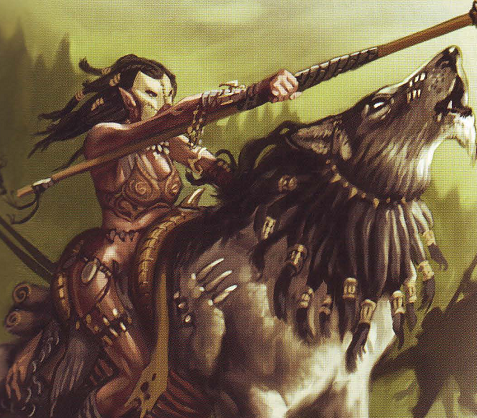
Tharn Wolf Riders are bloodtrackers atop immense duskwolves. They move with amazing speed, darting around defenders as their riders hurl javelins. The wolvesp ull down the prey with their jaws, leaving enemies bleeding as they spring away to shelter. The bloodtrackers perform fearsome rites of the Wurm, bonding with their duskwolves to become a singularly deadly pack. Death follows them closely, by javelin or wolfbite.
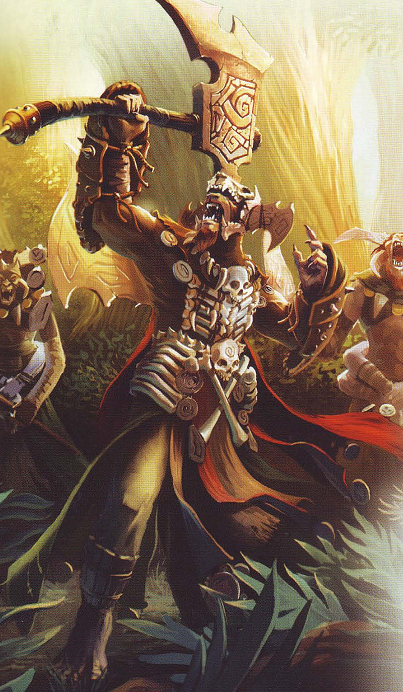
A Tharn Ravager Chieftain will sometimes lead the ravagers in battle. They are great, bloody warriors with the absolute respect of their tribes. In addition to battle skill, they lead the Tharn to prosperity, reveling in the gifts of the Wurm. They must not only be strong, but wise, leading the Tharn to gather in great numbers and with excellent tactics. By the time a Tharn can be called chieftain, they have led war parties and killed countless rivals. They wear grisly trophies, like a creature from nightmares, with the hafts of their axes turned black by the blood of their victims. They are always attended by the greatest killers of their tuath, and to be a chieftain's personal guard is a great honor. Each chief knows he only leads as long as he maintains the tribe's respect, so they always seek out the heart of battle, to earn their victory directly. The guard are inspired to try and match their chieftain, pushed to even greater heights of violence and striving to be the ones to draw first blood.
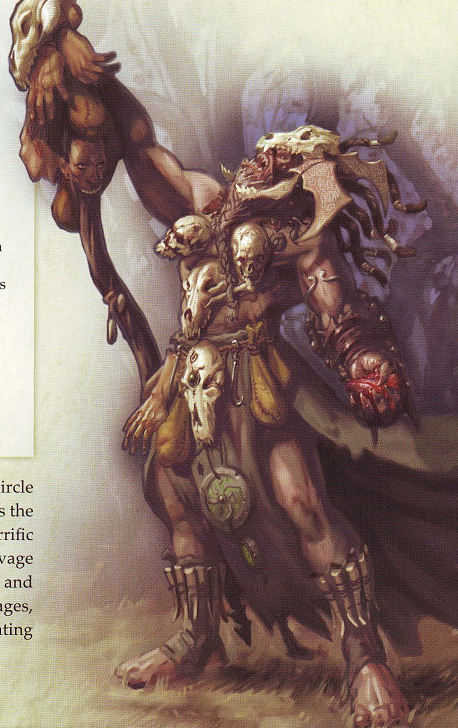
The druids of the Circle are often accused of being priests of the Devourer Wurm, but those are, in fact, the Tharn Ravager Shamans . They accompany the ravagers into battle, razing towns and slaughtering the innocent in the name of the Wurm. The shamans direct their revels, urging their kin on to ever greater carnage. Each shaman is a priest of the Beast of All Shapes who can call down the power of lightning and the storm. They leave only charred corpses behind as the Tharn fight under their command.
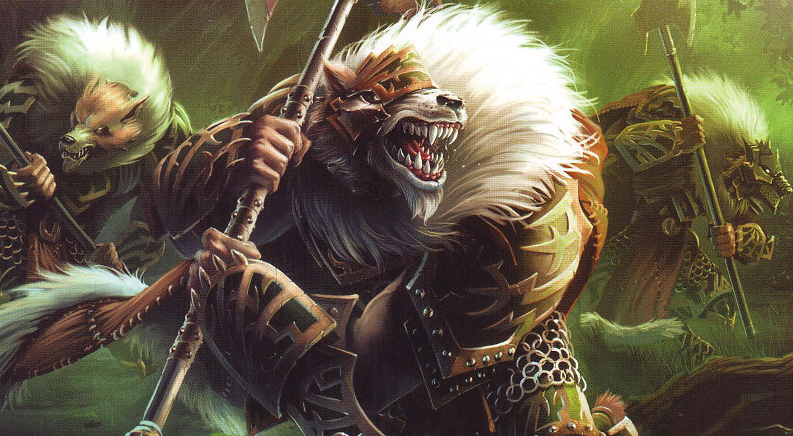
Warpborn Skinwalkers are chosen from among the Wolves of Orboros of the deepest wilds. By nightfall, their skin warps and they hunt down interlopers as monsters. The druids select only the best hunters and trackers of each generation to join the skinwalkers, using rituals derived from those that create the warpwolves. Their flesh distends, with wolf snouts bursting forth, hair growing and muscles gaining strength. Their senses are heightened, and the skinwalkers become almost perfect hunters. They are stronger than any human, wielding immense pole axes with vicious brutality and returning to human form when battle is over.
Next time: More druids
Forces of Hordes: Circle Orboros
Original SA post Forces of Hordes: Circle Orboros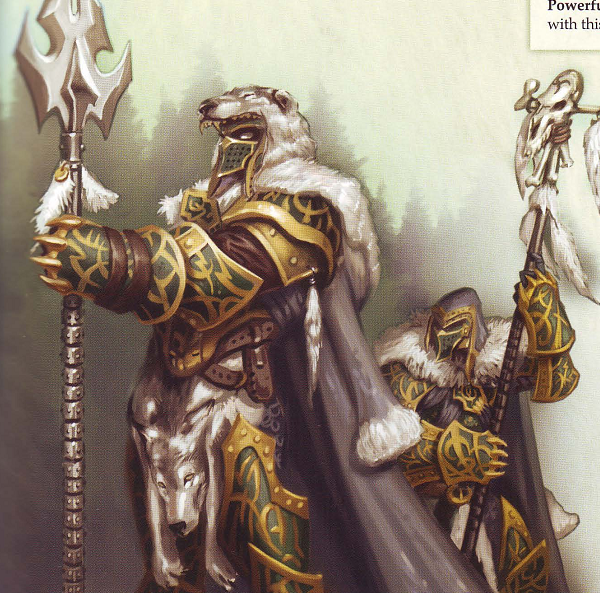
A Wolves of Orboros Chieftain and Standard will sometimes lead the Wolves in battle. They are heirs to the oldest rituals, enduring training and customs tied to the Devourer Wurm, patron of all predation, whom they represent with wolf totems. Only the most grizzled masters of the hunt are entrusted to lead the true believers into the Wild Hunt, the most sacred blood rite. Their totems represent their vow to never rest, tracking foes to the ends of the earth. A Wild Hunt ends only when the sworn foe is dead or pack hunting them is. A master of the hunt never speaks their name, subsuming their identity into the pack. They have touched the essence of the wild, and are filled with a feral madness. They work the wolves up into a fever of bloodlust, leading them not as men, but as beasts in men's skin, wielding spears as fangs and moving in unspoken coordination.
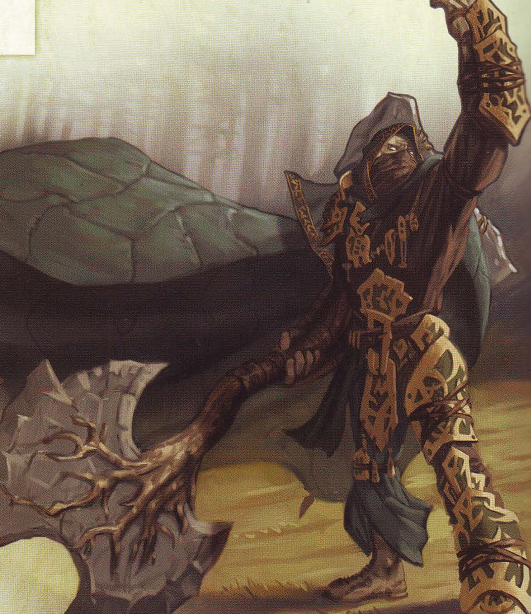
Blackclad Wayfarers are masters of the druidic art of teleportation, summoning dark clouds and storms to allow them move with cracks of thunder. They have a deep connection to the shifting stones and their power, and they are the messengers of the Circle, carrying news of key battles and omens. They pass on orders from the omnipotents as well as helping to lead the druids to war. They are entirely confident in battle, throwing enemies into chaos with their ability to appear anywhere, only to jump back to their allies.
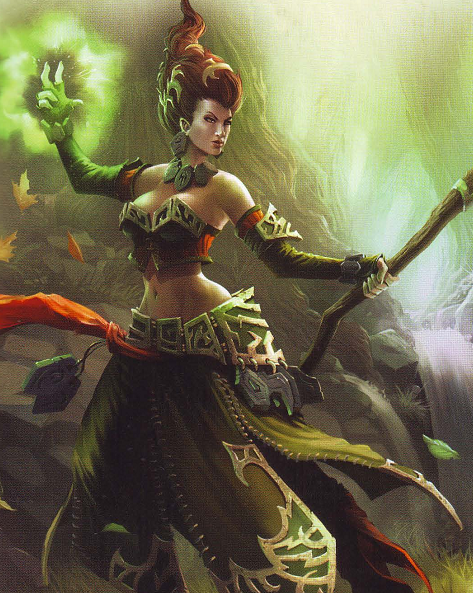
A Druid Wilder may be the least of the blackclads, but they already wield powers of nature and chaos. They accompany their masters into battle, learning to command warbeasts and channel their powers in combat. It's a very dangerous stage of initiation, and wilders are expected to obey their masters without question. Few warlocks will throw their lives away casually, but they are often in harm's way. Those that survive emerge stronger, ready to join the Circle as masters in their own right.
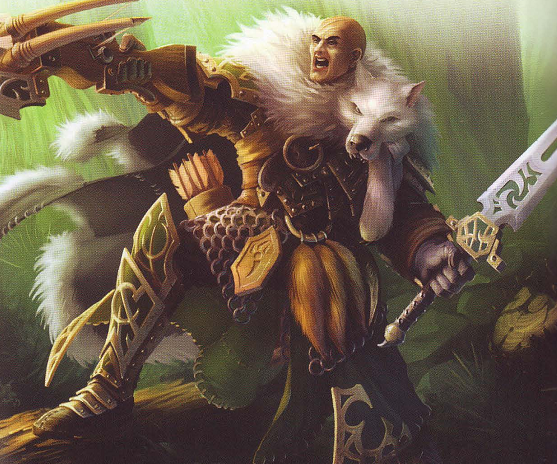
Many reeves die young, but not Reeve Hunters . They are legends, able to track beasts for miles undetected, patient beyond measure and stealthier than anyone. They are as skilled hunting men as animals, honing their skills to a razor's edge. When the reeves are called to war, the hunters are used as advance scouts and assassins, moving undetected through any terrain and disappearing into shadow even under midday sun. They are experts of evasion and positioning, and in attack they never sotp moving, pausing only to mark their targets before letting loose a flurry of bolts and moving on.
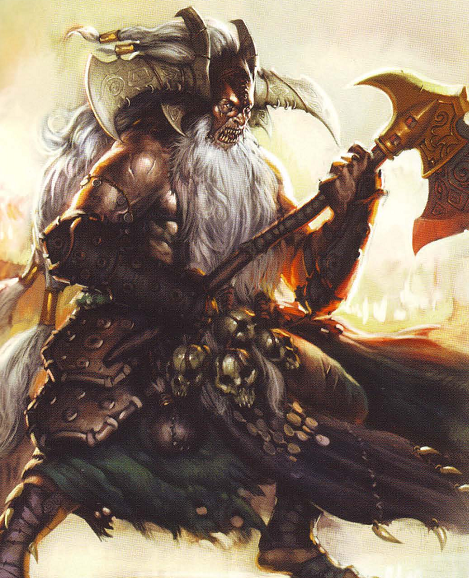
The Tharn Ravager White Manes are the eldest of the Tharn, seasoned killers both respected and feared by their younger kin. They love to kill, growing strong on the blood and hearts of their victims. Even without the reflexes of youth, they remain deadly, masters of their weapons and with nearly supernatural battle instincts. White manes do not fear death, but look forward to it on the battlefield, taking as many as they can with them. They prefer a blaze of glory to a quiet fading, and seeing them charge into battle inspires other ravagers to frenzy as they rush to follow. They carry trophies of countless kills and years of combat.
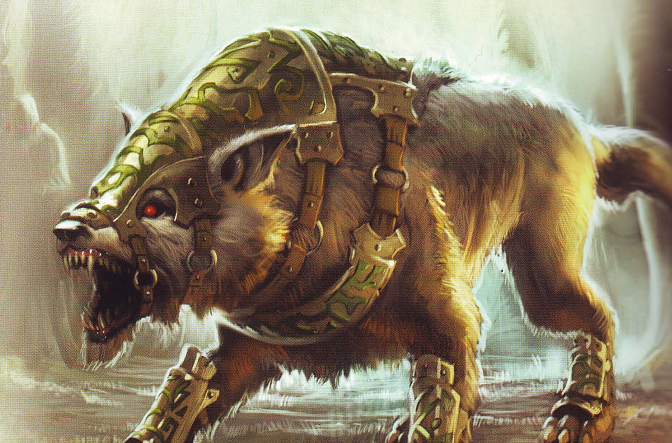
War Wolves are used by the Wolves of Orboros as kin and fellow warriors. They are stocky mountain wolves of Khador and the Wyrmwalls, with exceptional speed, senses and power. They are not bred for war, but are raised by the old families of the Wolves, who have hunted alongside them since the days of the Molgur. For some reason, the wolves seem to recognize the scent of their human allies, seeking them out and offering up their services without even begrudging the Wolves the pelts they wear. War wolves do not respond to commands, but fight on their own initiative. They are cunning, however, and are more than able to coordinate with the Wolves against their prey, circling and moving in while the enemy is kept busy. At the sound of crossbows, they leap forth in a blur of muscle, tearing at tendons.
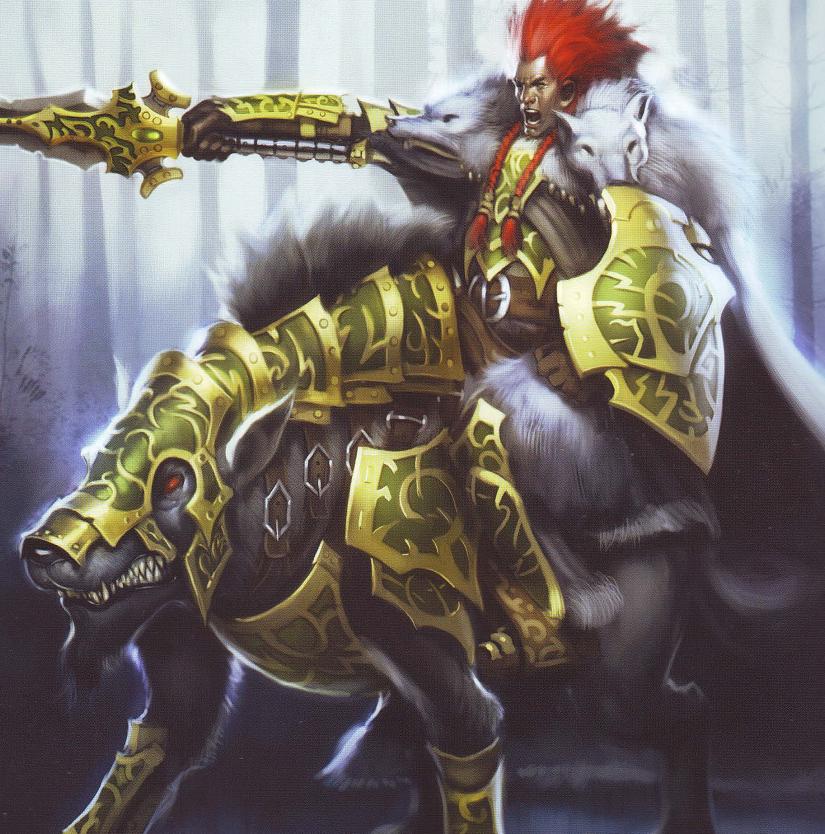
Wolf Lord Morraig is a throwback, and embodiment of his ancient ancestors, whos bloodline seems to guide him towards a greater destiny. Even among the most respected Wolves, Morraig is larger than life. The war wolves, who can barely stand human touch, will bear him into battle on their backs. He is a pragmatic leader, with little tolerance for mysticism. He has become used to magic among the druids, however, as the warlord of nearly a third of all Wolves of Orboros, but he prefers practical matters. He was born in the Vescheneg Headlands of Khador, but is derived from Wyrmwall stock, tracing back to the Molgur. His family has uprooted itself many times, to go where the Circle needs them, and sometimes he jokes that he's likely related to any wilderness man with red hair. Few among the Wolves do not recognize him, treating him as family. He has done more to expand their number than any twelve other men. When he enters a hunter's lodge to share drinks and stories, invariably half of them en present will decide to join up. He claims the talk of destiny is nonsense, but he's working hard to prepare the Wolves for something . His friendly demeanor is a great contrast to the ferocity and ruthlessness he has in battle. He trains his men until they collapse, in the worst conditions. He does not compromise, but those wh follow him know he turns them into great weapons, and he leads every charge. Few can match him in battle, and the unusual motions of his wolf steed have proven an advantage against foes used to horsemen. He has always obeyed the druids, but recently, he has come to view no man as his master, respecting only a few blackclads. His ultimate loyalty is to his men, but on some instinctive level he knows he has a greater purpose. When he met Krueger the Stormlord, a thrill of recognition shot through him, and something beyond words connected the two. Morraig took his men into the service of Krueger even as other druids' emissaries became increasingly agitated. Whether he and Krueger journey to glory or ruin, Morraig has made his choice, and the wolves will follow him.
The End!
Next up, the Protectorate of Menoth, because after ecoterrorists we need religious terrorists.
Forces of Warmachine: Protectorate of Menoth
Original SA post Forces of Warmachine: Protectorate of Menoth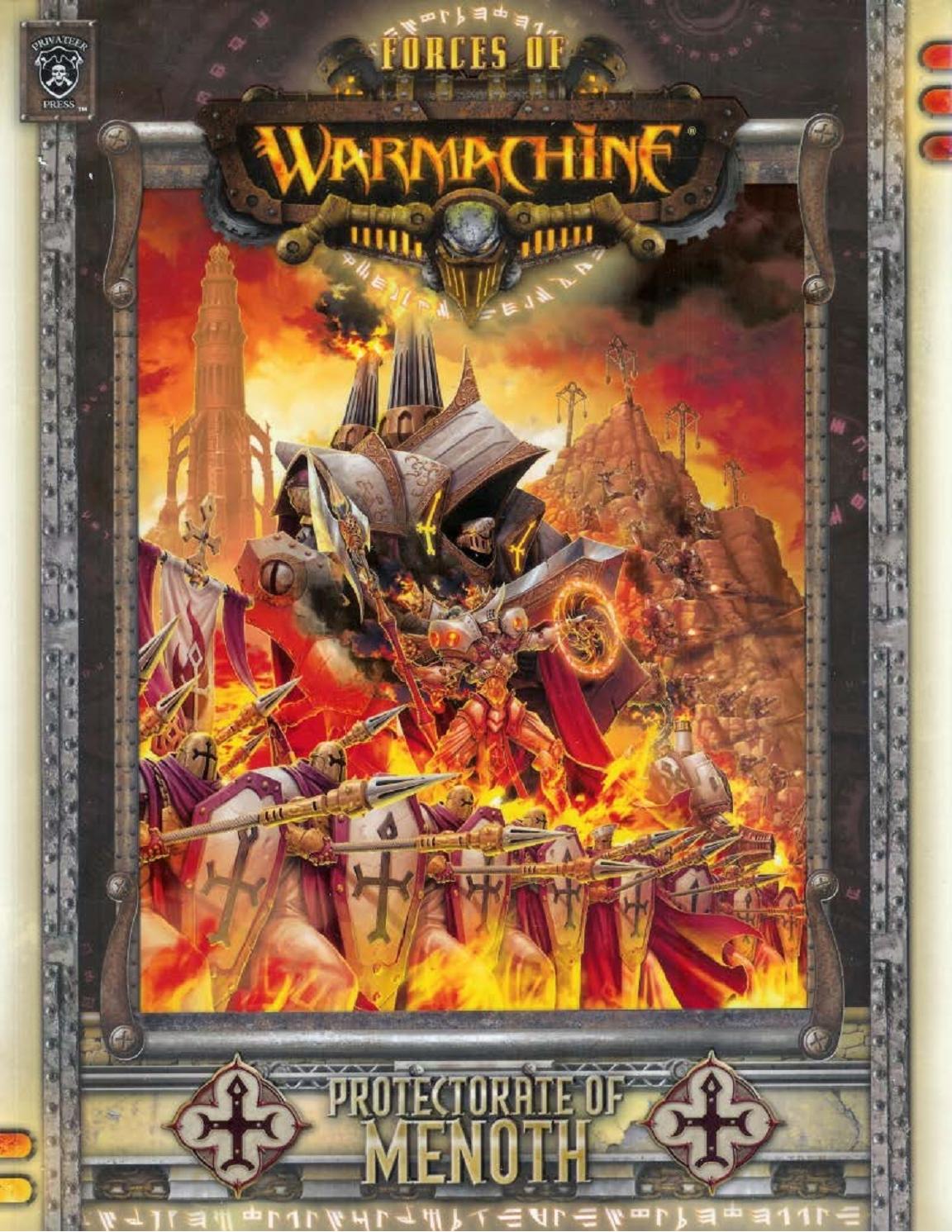
The Protectorate of Menoth is ruled over by the scrutator priests, and they have initiated a grand crusade to spread Menoth's worship across Caen. The Sul-Menite faith is ancient, but their nation is exceptionally young, born of the Cygnaran Civil War. Their army was made in secret for this day, and now they are a great power, armed with great weapons and greater faith. They have a vast array of protective abilities at their disposal, and even their sacrifices bolster their resolve and strength. Their warjacks are sturdy and tough, especially with the magical support the Menites are so good at providing.

The Protectorate has made greater strides from humbler beginnings than any other nation. They have gone from an oppressed minority to a great power. Their rleigion is ancient, dating back to the first written word, but their rise as a military power is only the past few decades. They have expanded and revolutionized themselves while staying true to their convictions, thanks great leaders of past and present. They are the smallest of any of the Iron Kingdoms, but their successes have been great - the defense of Sul, the invasion of Caspia and the seizure of Leryn from the Khadorans in Llael. They have taken control of their own destiny, and they've been preparing for this hour for decades now. Their military has been built strongly, and are now led by Hierarch Severius, the first warcaster ever to rule the Protectorate. He has spent his entire life ensuring the crusade is realized, and his people are united behind him. The military continues to be radically reorganized and expanded, blending old and new ideas and miximing pragmatism with ceremony. The Protectorate is always like that - it is not for temporal power that they exist, but to protect Menoth's interests on Caen. They are a theocracy, with priests ruling in daily life as well as the military. Most of the army are compulsory soldiers, but the elite are ancient martial orders integrated tightly with the church.
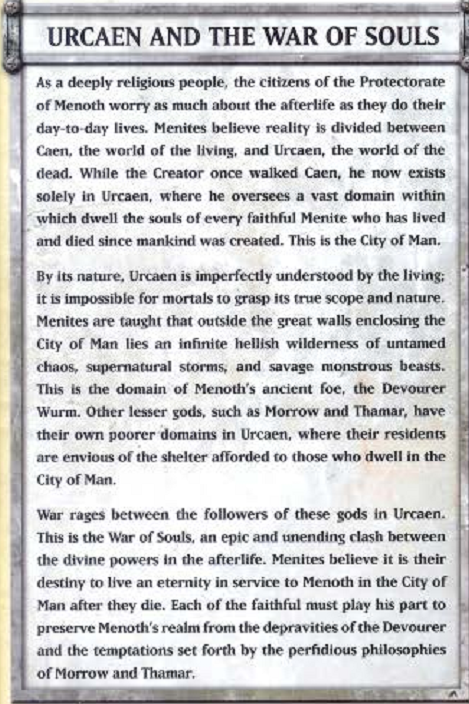
The diversity and complexity of the military make it hard to predict, which the Protectorate is excellent at using. Many of their decisions prioritize logistics and strategy, but they're just as likely to use force towards religious goals, sometimes comprehensible only to their prophets. The faithful, they believe, are part of the endless War of Souls fought by the gods, even if they do not understand it. The Harbinger of Menoth and the Reclaimants give the Protectorate a unique perspective on the divine will. Thus, the soldiers have learned to trust the priests implicitly, fighting in ignorance of their true purposes. They do not question orders, they take them on faith. Not ever Menite is equally pious, but in aggregate their beliefs give them a zeal and conviction that few can match. Enemies fear their zealotry, having to rely on things like duty, loyalty or coin. The Protectorate needs only faith, and no other army is so united.
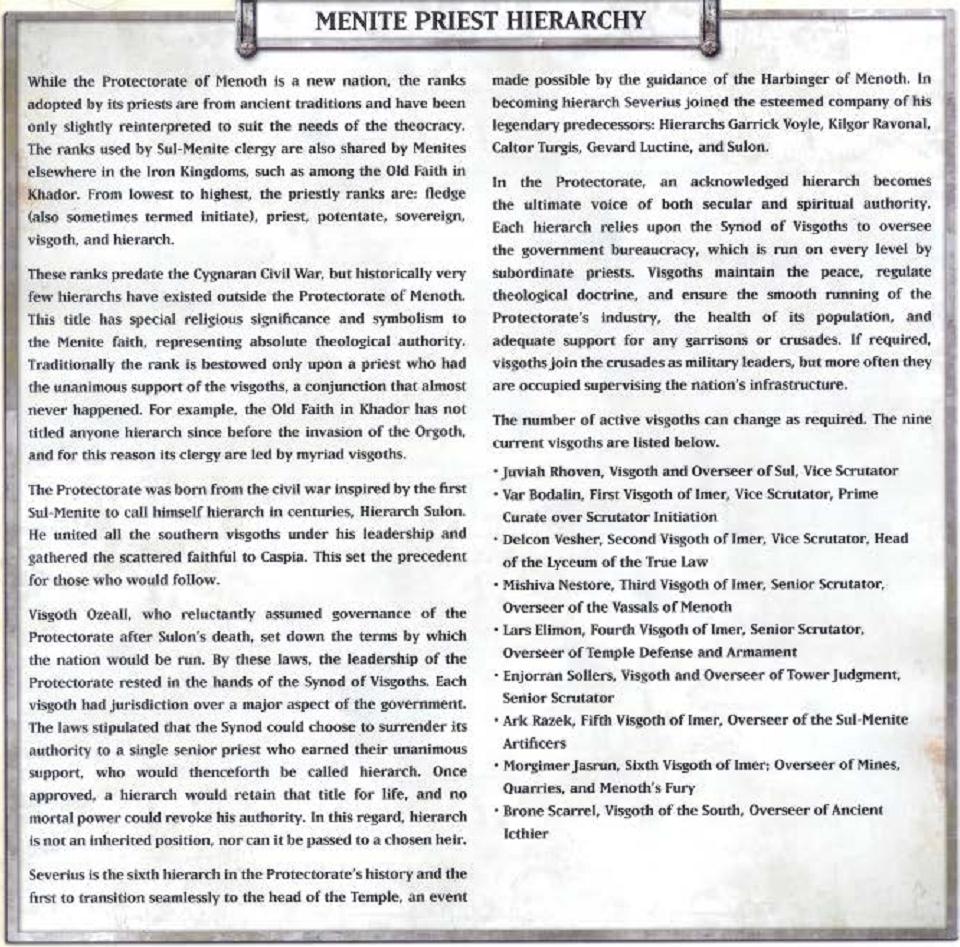
A huge percentage of the Protectorate population is at least part-time military, much higher than any other nation. They have been devleoping and stockpiling weapons since the nation was founded, and can equip a full third of the country. Training takes time, and not every citizen is equally capable, zealous or qualified, so leaders are constantly evaluating how much time a soldier must be trained before they're fielded. Everyone else has more people, resources and manufacturing capability, after all. Despite their large number of armed civilians, the core of their military is most reliant on their trained martial orders, like the Knights Exemplar and the Temple Flameguard. The Temple Flameguard have ended up taking on the role of the regular army, though at one point they were just defenders of temples and holy sites. The Knights Exemplar have changed more. They were predated by the Order of the Wall, an independent Menite knightly order, but the paladins of the Wall will not serve blindly, believing that faith must be tempered by conscience. This regularly puts them at odds with the priests, so the Exemplars were made with a code of absolute obedience, eventually eclipsing the Order of the Wall in the Protectorate. Scrutators rely on them to maintain doctrinal purity and root out heretics and traitors. While the Order of the Wall still exists in small number, its impact on politics and the military is negligible, preserved out of tradition and popularity with the people. The Knights Exemplar are by far the more important group.
While they serve as the martial arm of the faith, over time they've been less concerned with protecting the faithful and more with battling foes. The role of internal police was shifted first to the Temple Flameguard, then to the Order of the Fist, created specifically for the task. The Order of the Fist monks are trained to blend with civilians and root out treachery. The Flameguard Cleansers and Daughters of the Flame work with them to watch the people and address threats. The Knights Exemplar are now a purely martial force against outsiders. However, their code and training limits their numbers. Not every pious man or woman serving the Temple is suited to their oath. The Flameguard, likewise, requires fulltime dedication while serving. Many citizens aid the war effort without being so completely devoted by serving as militia or joining up when the battle priests call for war. Arms are kept throughout the Protectorate to equip these forces at a moment's notice. They are referred to as voluntary, but service in a crusade is compulsory for a quota of all able-boded men and and women. The Order of the Fist have proven quite good at rounding up and enlisting those without the devotion to volunteer. Still, the continual immersion of the people in religious doctrine makes it easy to get lots of volunteers of all ages. These lay soldiers make up the lesser orders, such as the Deliverers.
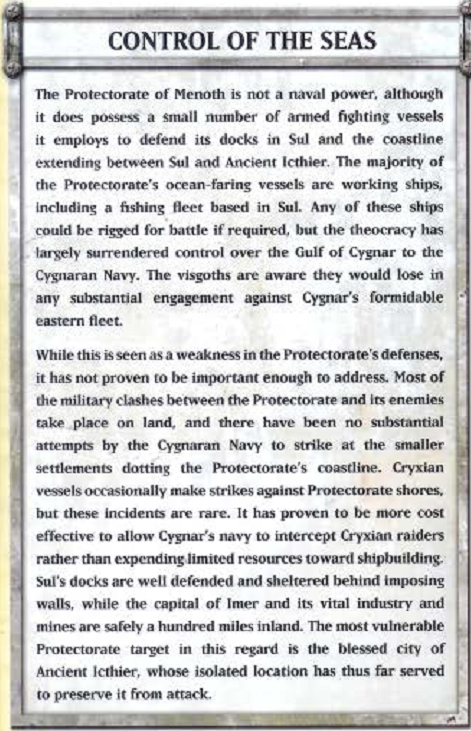
There's been an ongoing struggle between respect for ancient tradition and establishing a clear chain of command. traditionally, as long as the leaders of each order are loyal to the Synord or hierarch, they have gotten total autonomy. Some of this remains, but Hierarch Voyle realized that to do war on a larger scale would take integration of these disparate elements, and so he promoted Severius to grand scrutator, charging him to unify the orders. Severius understood that this would take care, logistics and planning, so he made the office of war counselor, appointing Bron SCisson, his foremost secular officer, to oversee the militias and martial orders in order to keep the crusade running smoothly. War Counselor Scisson has no field authority, but all of the military is expected to cooperate with him and his staff regarding logistics and personnel. His office has no battle glory, but without it, the army would be impossible. The central staff has moved to Leryn alongside Severius, but couriers regularly convey messages back to the visgoths of Imer in the capital.
The Protectorate's founding terms in 484 AR prevented them from keeping a standing army. This was never strictly enforced, and for decades the Protectorate seemed to obey even while making and expanding martial orders to protect themselves, justifying it with the need to fight the tribal Idrians, which continued even after the majority were pacified and converted. For many decades, Cygnar was all right with this, perhaps in the belief that the resource-poor region was very hostile, and laws were enacted to allow the Protectorate to arm and train defenders of the temples. The adoption of laborjacks and later warjacks happened early in the reign of Hierarch Gevard Luctine, but not without argument. Hardline traditionalists insisted mechanika were not part of the True Law due to the arcane science needed to make them. Luctine and his visgoths saw the machines would be vital to prosperity, arguing that it was their holy duty to find a way to purify them. They granted that mechanika and magic were unquestionably tainted, but believed they could be sanctified with prayer and holy engravings, along with constant ministrations by cleansing clergy. Laborjacks were incorporated into many industries, but even more were given improvised wepaons to assist the martial orders, and the first choirs were made, using holy hymns to sanctify the machines in abttle.

It's doubtful that Cygnar was entirely fooled by the Protectorate pretenses to pure laborjacks. However, they turned a blind eye so long as they were just used against the savages in the wastes, and probably did not realize how many 'jacks had been converted to battle readiness. Cygnar's focus on the city of Sul, once the eastern half of Caspia, also helped. The Protectorate lacked any meaningful other cities for decades, so the oversight was understandable, but it blinded Cygnar to significant developments miles away. In 504 AR, an earthquake struck a battle between the Sul-Menites and Idrians, leaving the Menites standing but forcing the Idrians to kneel, and at that point most of the Idrians present immediately converted. This only increased and diversified the Protectorate population, bringin the Idrian city of Imer into the nation. It remained primitive for decades, but soon untapped mineral resources were found nearby, including iron,c opper and tin. It took years to build the mines and infrastructure, but they would become vital to the Protectorate's industry, particularly in the creation of weapons and warjack components. Most of the ore and resources were initially processed in Sul, so Cygnar never really understood the full extent of the mining operations, underestimating the Prtoectorate war industries. Even more resources waited to be found in the east by Hierarch Calgor Turgis of 535-549 AR. He oversaw the consctruction of Tower Judgment in the north and the rediscovery of ancient Icthier in the south, gaining both sacred texts and precious gems, which were used to bribe Cygnaran inspectors and open trade. This was important, but not so much as the discovery of Menoth's Fury, distilled from less volatile oil found in the sands. With the proper refining, this oil became more than just fuel for lanterns, able to spark immense conflagrations. AT its most refined, it ignites on contact with air, adheres to surfaces and burns hot enough to melt steel. In time, it would become one of the signature weapons of the Protectorate.
Next time: The Great Crusades
Forces of Warmachine: Protectorate of Menoth
Original SA post Forces of Warmachine: Protectorate of MenothThe Protectorate stopped focusing on infrastructure around 568 AR, under Hierarch Kilgor Ravonal, who preached true independence. He directed the clergy to push the word of Menoth in other nations, cowing them into submission. He said that Morrowan nations were perfidious, lawless and faithless, so forcible conversion would be a mercy compared to what they faced in Urcaen. He stockpiled weapons and resources by selling diamonds, expanding the Knights Exemplar and Temple Flameguard. He also created the Order of the First, an internal police force founded and led by Garrick Voyle, his later successor, so that the Knights Exemplar coudl focus solely on the battles to come. After his death, years of infighting made the Synod ineffective until Voyle's rise in 588 AR, consolidating his power with the aid of his monks, his scrutator allies and his formidable skill. He continued the work Ravonal began, taking office just after the Scharde Invasions. He used them to expand the Protectorate's strength in the chaos and confusion, as well as the unrest after Leto's coup. Voyle understood that before the crusades could begin, the army needed a foundation, and he moved the capital to Imer, reconstructing it into a modern city, so that the central industries of the Protectorate were farther from Cygnar.
This also allowed Voyle to institute other military reforms, including the creation of the House of Truth as the headquarters for the new Vassals of Menoth, an organization based on earlier efforts to capture foreign arcanists to force production of cortexes. This practice had proven worthwhile, but Voyle greatly expanded it, recruiting and training arcanists and mechaniks from the faithful, that they might have loyal workers to supply the needs of the warjacks. They still had to be watched, however, to ensure they would not be corrupted and violate the True Law. Still, with the war industry procdeeding, Voyle began to test Leto's willingness to enforce the old treaties, encouraging surgical strikes on Cygnaran targets, to test the response while he lied to Cygnar about a desire for peace. The Cygnarans relied on diplomacy and did not escalate, convincing Voyle that they were weak and would not stomach the casualties of disarming the Protectorate by force, so he increased weapons production. When Khador invaded, the perfect time came, as proven by the appearance of the Harbinger. The Protectorate attacked, disrupting rail travel and assaulting the gates of Caspia.
In 606 AR, the Harbinger told Voyle of a vision she had, a mandate to confront a great darkness. The Northern Crusade was authorized and left to Grand Scrutator Severius to ensure the Harbinger arrived where she had to go and to convert as many outsiders as possible. The Harbinger's charisma and ability to sway the faithful proved quite useful, and thousands answered her call to pilgrimage towards the north. The battle the Harbinger had foreseen took place in the Thornwood, at the Orgoth temple Garrodh, as part of the maneuvering of the lich lord Asphyxious of Cryx. He sought to become a god by siphoning off the souls of Menoth's realm in Urcaen, using the Harbinger as a gateway. Khadoran and Cygnaran forces werel ured in to thwart Cryx, but were largely unaware of the cosmological considerations. As a result, they only ended up interfering. The Harbinger managed to sacrifice herself to end Asphyxious' ambition, freeing thousands of Menite souls that had been imprisoned by the Orgoth machines. It was a miracle, but her death was a great and unanticipated setback. The Testament and High Paladin Dartan Vilmon returned her body to Imer, where she was resurrected by the will of Menoth, as channeled through Hierarch Voyle. Grand Scrutator Severius continued to lead the Crusade, battling to fulfill its secondary purpose even without the Harbinger. He annihilated the city of Fisherbrook and headed north.
The first city selected for conquest was Fellig, but Khador and Cygnar got in the way. The Menites could not seize the city, but did destroy the monastery of Ascendant Angellia, one of Morrow's minions. Severius led his diminished armies to a more suitable site, crossing the Black River towards the Bloodstone Marches, where they found reinforcements from the Knights Exemplar and Flameguard. They moved on towards Llael, finding allies in the Resistance that led them to the city of Leryn. Severius led the battle with the power of the Covenant of Menoth, calling on it to unlock miracles. The relic heightened has already potent powers, and Severius was able to take Leryn without a siege, converting two members of a ranking Greylord Ternion governing the city.
As the Northern Crusade made its way to Llael, the rest of the military was preparing in Sul. Tensions were high, as Cygnar was rounding up Menites and locking them away. The Menites launched an attempt to conquer Caspia, but their attack was turned on them, and became a fullscale ivnasion of Sul, prompting the launch of two crusades: the Reclamation of Sul Crusade and the Crusade in Defense of the Great Temple. Both crusader forces worked as hard as they could, and in time succeeded in defending the holy city, rallying after a long period of street combat. They Cygnarans lacked their resolve, especially after Coleman Stryker was injured in combat with Feora, Protector of the Flame. Eventually, the Menites stormed Caspia, across the river. Hierarch Voyle led the attack. However, the Harbinger had foreseen failure, though Voyle ignored her, too blinded by the dream of uniting the two cities once more. It came to head when he faced Stryker in battle, and Stryker offered a temporary truce and to return the captive Menites.
The Harbinger again pushed Voyle to stop, but again he ignored her, ordering the army to fire on the captives. The Harbinger martyred herself to protect them, helping to defend the helpless alongside High Paladin Dartan Vilmon of the Order of the Wall. The hierarch continued, his rational mind overcome by hubris, striking at Vilmon in anger. However, the Harbinger took the wound onto herself, suffering what should have been a fatal blow. Voyle blamed Stryker, and the two fought. Stryker won, as Menoth withdrew his favor from Voyle, and some say the Harbinger's sword was what ended Voyle's life. His body was returned to Imer, where he was buried with full honors, to be remembered as a visionary. Severius swore to continue his work, and by the Harbinger's revelations, he was made the new Hierarch, devoting greater attention to the Northern Crusade. That brings us to now.
The Protectorate armies are organized into garrisons and crusades. Garrisons include reinforcements and defensive reserves, with the largest made purely of the Temple Flameguard or supported by smaller numbers of other orders, existing primarily to secure territories. Crusades, on the other hand, are large mixed groups of forces designed for a longterm objective. They are the most proactive armies, usually seizing territory or destroying a target. It is unusual but not impossible for them to be defensive. Crusades and garrisons are both broken down into interdictions, which are made of phalanxes of different orders. The hierarch appoints crusade leaders, who select interdiction leaders. Crusade leaders are always warcasters, and regardless of order, all members of a crusade answer to them, and all members of an interdiction answer to the interdiction leader.
At all levels, priests serve as army officers, commanding and directing soldiers as well as organizing logistics. Lay soldiers can get ranks of authority, like preceptor or arms master, but even they must treat priests with respect. In any situation of uncertain chain of command, priests are assumed to outrank secular commanders. A seperate priesthood division leads the zealot forces, which are rather less organized and cohesive than the martial orders. These warpriests are most numerous but least influential, rarely having any larger responsibility than the rituals they perform for success or last rites. Above them are the potentates and higher, and some of them are chosen to direct warjacks in battle. While ranking priests are generally busy governing, they do sometimes help the armed forces directly with their potent prayers and inspirational power. Visgoth Juviah Rhoven, for example, used his prayers in the battles in Sul and Caspia, and Hierarch Voyle led the attack on Caspia personally. Hierarch Severius loves to fight in active battle.
In fact, Severius' decision to remain in Leryn has meant a drastic reorganization in forces. The crusade in the north is the only currently active one now, with the Sul reclamation being left to garrison forces, though still on high alert. Most of the Protectorate's warcasters are now in the north, including the Harbinger, Testament and Grand Exemplar Kreoss, who oversees the day to day battles and reports directly to Severius. The Leryn garrison is run by Vice Scrutator Vindictus, another warcaster priest. High Executioner Rezzik has been granted command of an ancillary strike force, answering only to Severius. Some believe this shows a rift with Kreoss, but others believe it just means different tools need different jobs.
Feora, Protector of the Flame, has not been called north, however. Most see this as a sign of disfavor, but in truth her authority is greater than it's ever been, as she has been given general oversight over all the southern garrisons, including Sul, Imer, Icthier and Tower Judgment. Oversight is left to the visgoths, but the officers are all loyal to Feora. She has also established protocols that make the Flameguard Incendium serve as intermediaries between priests garrison officers, ensuring she controls information and resource allocation to most of the southern military. These garrisons could be easily reassigned to a new crusade if needed, but the Protectorate must defend its lands, especially Sul and Imer. The visgoths are especially unhappy that Severius isn't at home, and have advised him to return posthaste, but he's ignored them. Feora now attends the Synod in his place, serving as his unofficial proxy on military matters. She is easily the most influential person in the southern Protectorate now, even above the visgoth individually. The southern scrutators, including five of nine visgoths, also serve as Severius' eyes and ears at home, watching Feora. So far, she seems to be acting in good faith and is not ambitious beyond her station, but her influence over the visgoths is a matter of some concern.

The Protectorate military is strong despite being small, in part because they're very good at finding warcasters and training them. Many priests credit Menoth with this, but it's more likely that priestly meditations and training among Sul-Menites opens them to contact with warjack cortexes, and the force of will required to channel holy power reinforces their potential. Many priests, even without warcaster talent, have also proven adept at spotting potential. Even among the clergy, warcasters are rare, of course, but the Menites have found some that no one else would have recognized. It probably also helps that the priests keep themselves so deeply informed about their public's activities. No other nation so closely polices its people. Since magic is heretical, children with powers are often taken, and those that are not killed are trained in prayer to foster their talents.
For the Protectorate, training a warcaster is as much martial as doctrinal. All warcasters are taught to channel Menoth's might, but each has a unique set of abilities. Some theologians believe that each warcaster represents a specific passage or interpretation of the Canon of the True Law. Those that manifest their power later in life usually remain in their martial order, with instructors sent to them if needed. Each order has its own initiation and promotion ceremonies, and warcasters must ascend the ranks like anyone else, but given their power, they tend to do so quickly, as long as they remain true to the order's code and the True Law. Several orders are led by warcasters, subordinate only to the Synod and hierarch, and for the first time ever, the hierarch himself is a warcaster. Some take this as proof that the final crusades are here.
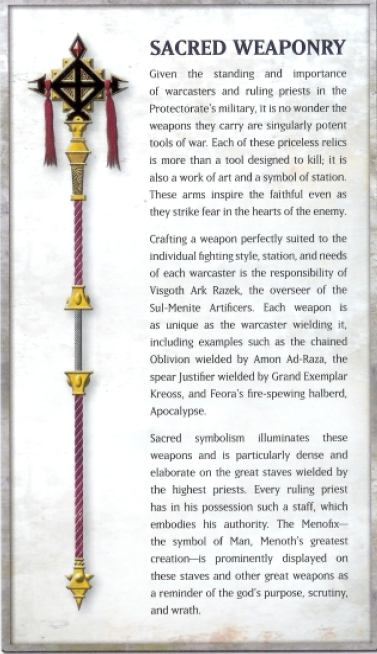
Next time: Warcasters
Forces of Warmachine: Protectorate of Menoth
Original SA post Forces of Warmachine: Protectorate of Menoth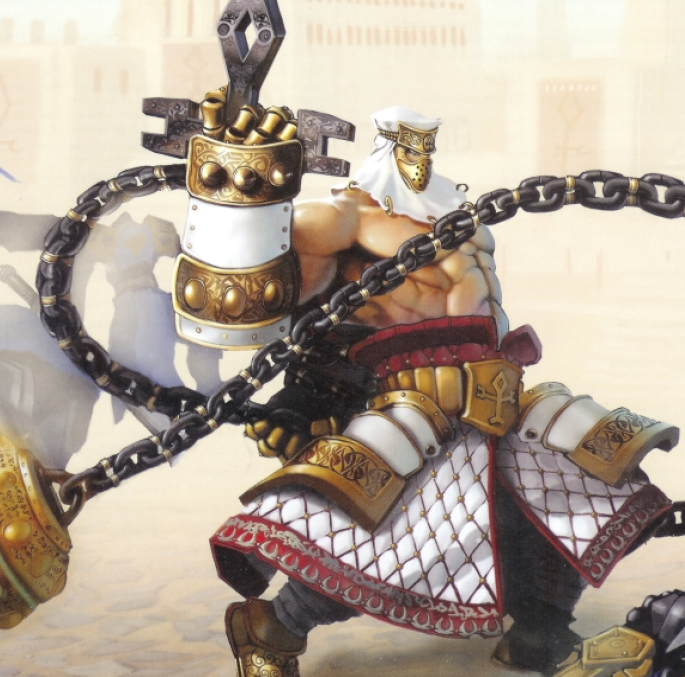
High Allegiant Amon Ad-Raza is an Idrian, born into a family that had to move constantly to escape Menite rule. If it weren't for his early hardships, he would never have found his true path. His first experience with the True Law was when he snuck into a Protectorate town for food and overheard the sermons of the local monks. Moved by their words, he entrusted himself to Menoth and joined the Order of the Fist. His faith and determination made him a prodigy, and his body was miraculous - his flesh broke swords as if made of stone, his movements were unstoppable. His ascension to high allegiant resonated with the divine hand, and he taught alongside his masters in mere years. Hierarch Voyle noted his potential and began to test him to his limits. Amon surpassed all expectations, triumphing each time, even when asked to mentally conquer a warjack. He was, it turned out, a born warcaster. Voyle sent him into the field, and as his legend grew, more and more Idrians converted. Amon goes into battle unarmored, relying on his monastic conditioning to endure great blows, and his attacks are charged with unstoppable faith. His gimmick is melee combat and melee boosts, and his feat keeps his warjacks from being ganged up on and shores up positioning weaknesses by temporarily removing the ability to exploit them. He basically temporarily unites them with his own soul.
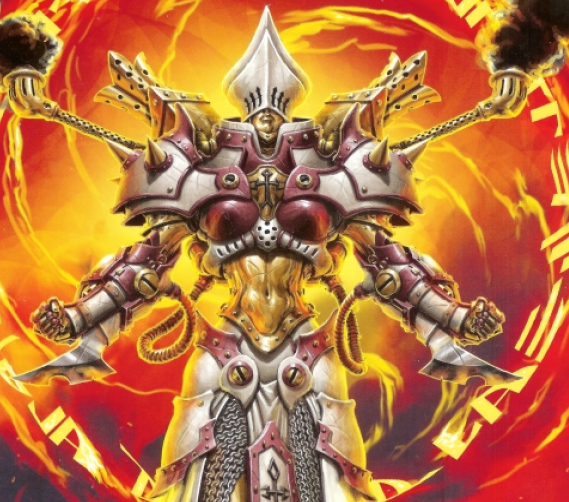
Feora, Priestess of the Flame is known for a hot temper and an iron will. She is an exemplar to the Temple Flameguard, who are utterly devoted to her. She was a child when her affinity and control over fire manifested, and her family recognized it as a divine gift, due to their long association with the Flameguard. She was given to the clergy for tutoring, and she ended up joining the ranks of the Incendium, the elite of the Flameguard. Her talents brought her to the attention of several scrutators, and when the Priest of the Flame passed on, she was chosen to be the new leader of the Flameguard. She has been preparing them for war since that day. She considers Cygnar irreparably flawed due to its Morrowan leanings, and it galls her that they nominally rule the Protectorate. Feora holds her people to an extremely high standard, with herself as the example of it, so her troops respect her. She leads from the front with a zealot's fanaticism and terrifying flames. Despite her power, she has one fault: ambition. This and her intolerance of disobedience have made her paranoid, trusting no one else and resenting those above her. Her promotions have made her increasingly distant, and now the Temple Flameguard answer to her alone, and no other. It may be only time before she believes herself the Protectorate's true leader. Her gimmick is fire. Lots of it. Her feat sets all nearby enemies on fire.
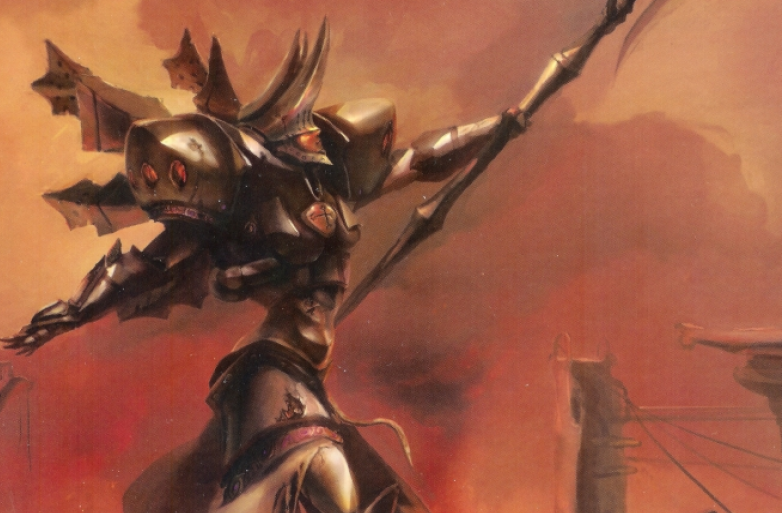
Feora, Protector of the Flame is Epic Feora. She was both humbled and exalted by the battles in Sul. In the last days of the siege, she faced certain death after a battle with Allister Caine left her trapped under one of her ruined warjacks. She experienced full self-awareness there, and she didn't like what she saw of herself. She realized her ambition, though necessary to transform the Menites into a true army, had distracted her from the true path of forging the Flameguard into the greatest force of the Protectorate and rising to lead. She remembered her duty was to protect the Church and its holy places. With new clarity of purpose, she escaped from under the 'jack as the Daughters of the Flame came to her side, gathering the survivors of the Flameguard and heading for the Great Temple of the Creator. There, she unleashed her fire with renewed faith, empowering her warjacks and annihilating the foe. The temple was preserved. Months later, she marched into Caspia alongside Hierarch Voyle, and she saw him die. She was shocked by it, for Voyle had been instrumental to her rise to power. That he could be killed in his moment of triumph was troubling, to say the least. Worse, her ambitions were crushed when Severius was named hierarch instead of her...and she'd personally insulted him. Nevertheless, her ambition remains undimmed, and she knows that there will be opportunities for her in overseeing the southern garrisons while the hierarch focuses on his crusade. This may be her best chance to establish a foundation for her future rule. Her gimmick is still fire, but with more mobility tricks. Her feat lets her gain power from the nearby enemies that are already on fire, then rearrange which ones are on fire, enemy or ally.
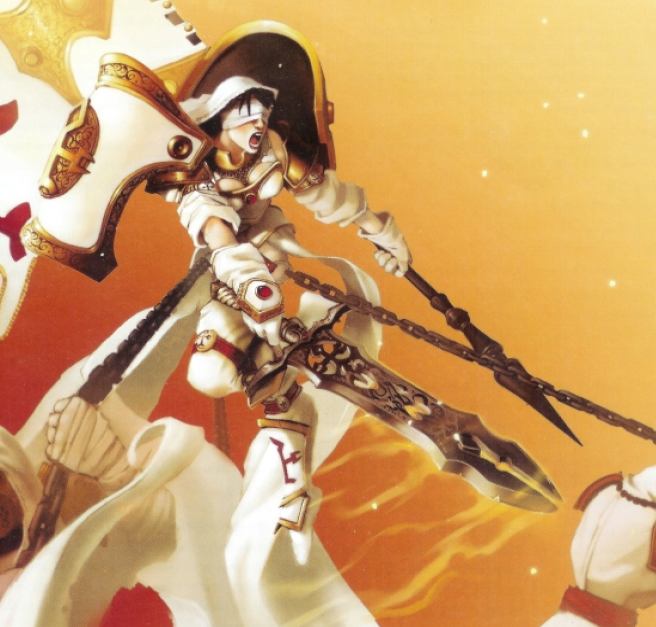
The Harbinger of Menoth was discovered in late 603, when three scrutators and a squad of Knights Exemplar arrived in a village near Icthier to find a teenage girl. She claimed the Creator had come to her in a vision and declared her too holy to touch the earth. She has floated above it ever since. As she travelled to Imer, entire towns emptied to follow her. At sunset in the Sovereign Temple of the One True Faith, the visgoths met with her. She described her visions, claiming to wear a blindfold because she saw via Menoth's eyes and it was overwhelming. She spoke of the visgoths by name, revealing things they'd hidden, and Hierarch Voyle noted that, in fact, the sun had not moved since she began to speak ten hours before. He bent knee to her and asked her to serve as his spiritual advisor. The years since have only reinforced that the Harbinger is the voice of a god, as miracles have followed her. She endorsed Voyle when he called for a pilgrimage to witness her divinity, meant to heal the rift between the Sul-Menites and the Old Faith of Khador. Certainly, her coming is the single greatest religious event in Immoren since the discover of the Canon of the True Law. She went to the Thornwood to face the darkness that threatened all Menites, releasing the souls of thousands of captured dead and giving her life to save them before Asphyxious could use them to apotheosize. The Protectorate mourned her, and hundreds of thousands witnessed her resurrection by Menoth's will. When Voyle chose to lead the crusade into Caspia, she warned him not to, for Sulon had prophesied doom to any hierarch that entered Caspia before it was made whole. Voyle ignored her, and hours later he was dead. The Harbinger ensured his burial with full honors and named Severius as his replacement. she has journeyed forth to join Severius in the north, personally entering battle. She is immensely potent, commanding warjacks and extremely powerful divine magic, plus the holy sword Providence. She is a beacon to all Menites and a terror to Menoth's foes. Her gimmick is massive magic - buffs, debuffs, explosions. Her feat causes all enemies near her to explode as Menoth gets angry at them.
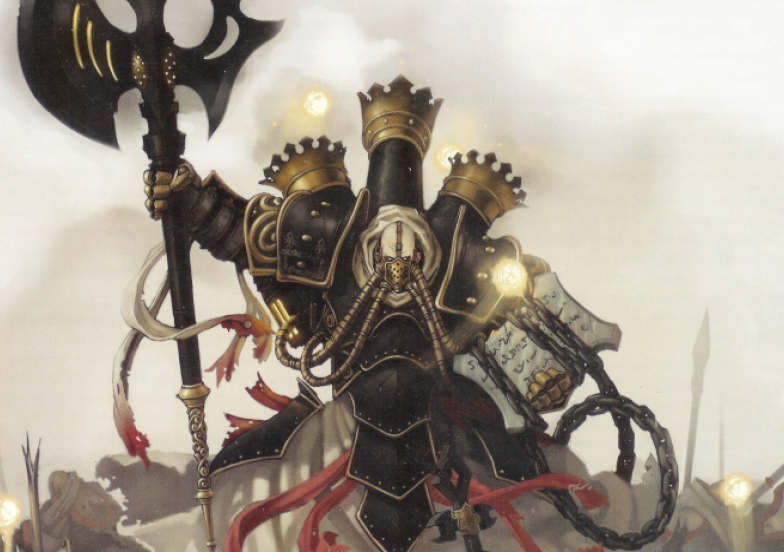
The Testament of Menoth is the Epic High Reclaimer. When he left Imer for the Stormlands, many believed he left to die, choosing to reclaim himself. This is not entirely wrong. He pushed himself to his limit to open the Gates of Urcaen, through which he was reborn. He entered the land of the dead, wading through hordes of unclaimed souls and suffering terrible wounds. He fought back with his weapon, Cremator, and the metal of it was transformed by the touch of the spirits. In the land of the dead, he found an ancient city, a shadow of Icthier, with a temple in which he found respite. The shrine opened, revealing the altar Omegus and its ancient tablet, written in an unknown tongue with the Creator's laws of the dead. The High Reclaimer was given the power to use its knowledge and set out to return to Caen. He was prepared for a long battle, but he found Menite souls holding back the dead and clearing a path for him. As they fell, more came to replace them, until the High Reclaimer again passed through the gates. He was given his new title by the Harbinger on his return, his name excised entirely that he might become an embodiment of the True Law. The Testament now wields the otherworldly weapon Requiem, and is an impossible champion, having gone to the land of the dead and returned. He can step between these worlds now for a time, so long as a soul lights his way. His power was forged in sacred oaths and the words of the Omegus, and with but a gesture he can restore dead Menites to life and banish infidel souls to the wastes of Urcaen. His gimmick is all about killing stuff, fucking over anyone who needs soul tokens and reviving the dead. His feat turns his allies incorporeal briefly via the gates of Urcaen.
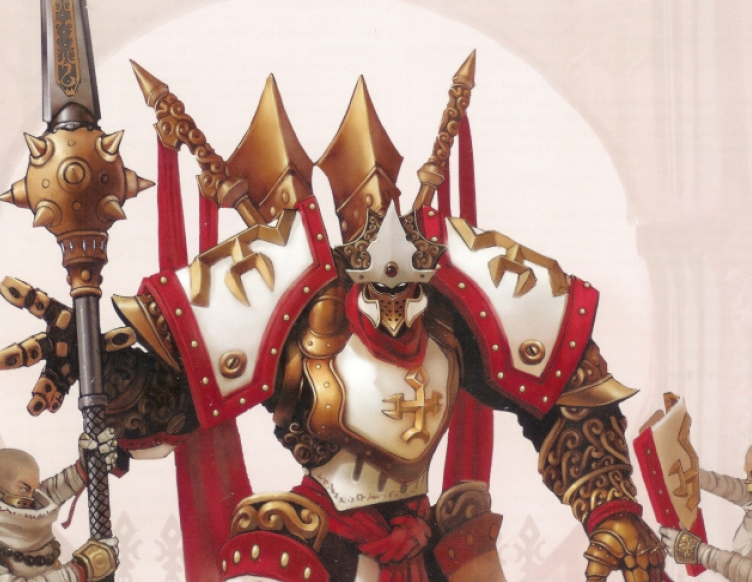
Grand Exemplar Kreoss is Epic Kreoss. Mikhail Kreoss has always been a devout and strict Knight Exemplar, and when the last Grand Exemplar, Bane Hurst, died to protect the Harbinger, Voyle didn't hesitate in appointing Kreoss as his replacement. For ten days and nights, Kreoss was in isolation, praying and purifying himself. His every deed was measured and weighed, and his commitment was absolute. He emerged with new, golden armor and the spear Justifier. Since then, he has lead the Exemplars at the fore of the crusade, a guiding light of righteousness. The other Protectorate leaders find him confusing - he is unhesitating in his duty, but does not hesitate either to question the church's actions. He is courageous, but he lacks the ruthlessness common to the Menite leaders. This has made him a hero to the common people, and while he mourned Hierarch Voyle, he did not like the man at all or his attitude towards other Menites. He takes the weight of the crusade onto his own shoulders, pushing himself to ensure its success, even if it means he goes without sleep. He has seen too many friends die, and he wants to avenge each one as the spear of Menoth's vengeance. His gimmick is troop buffing and his feat greatly boosts his allies' melee skills.
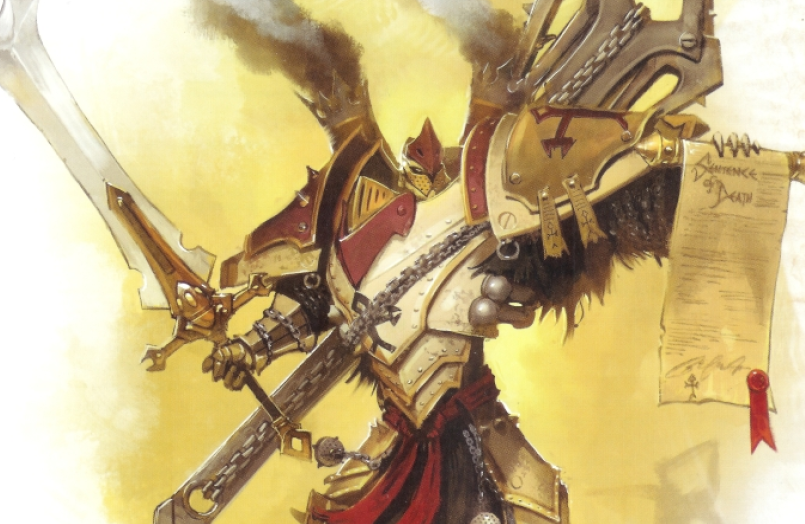
High Executioner Servath Reznik is the assassin of the scrutators, striking at those who think themselves safe outside the Protectorate. He hunts down those guilty of sacrilege, sorcery and treason, in or out of the borders. He is a throwback to the ancient Menite faith, before the coming of the Twins, and he was raised in the Khadoran mountains under the strictest interpretation of the Old Faith. He learned how to torture and kill with the right prayers to scourge a soul of sin, giving them redemption in death. However, being a priest did not suit him, so he headed south, to the Protectorate. The scrutator (not yet hierarch) Garrick Voyle saw the truth of his soul, a killer without mercy but with great faith, and Servath Reznik was made high executioner in that same hour of meeting. To this day, stories circulate of entire Menite villages burned to death by Reznik for punishment of some unknown crimes. The leaders of the Protectorate don't like him, and only Hierarch Severius can tolerate his presence, understanding what Voyle saw in him. Reznik's singleminded and inhuman appetite for punishing the faithless has made Grand Exemplar Kreoss despise him, and all Menites fear him, though those that relish the punishment of heretics also adore him. Reznik works in Llael now, helping the Northern Crusade carve out a stronghold. His gimmick is blasting enemies and buffing himself, and his feat fucks over warcasters, warjacks, warlocks and warbeasts, preventing them from using many powers and setting them on fire if they cast spells.
Next time: The Hierarch
Forces of Warmachine: Protectorate of Menoth
Original SA post Forces of Warmachine: Protectorate of Menoth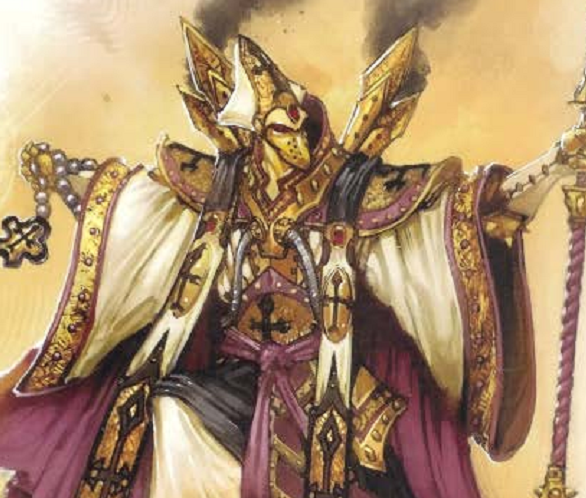
Hierarch Severius is Epic Severius. All who attend him can feel the divinity of his words and actions, and when he raises his staff, righteous fire blazes forth. He is both awe and terror, protector and destroyer. The death of Hierarch Voyle could have been a catastrophic blow, and the priesthood despaired for the first few hours, remembering all too well the chaos before Voyle took power. The Harbinger, however, reassured them. She told them that the next hierarch walked among them, in the north. Severius' rise is the fastest any hierarch has ever been chosen and the first time with such irrefutable approval from Menoth. Severius no longer refuses authority as he did as grand scrutator, where he'd removed hgimself from politics to fight. He takes leadership in stride, knowing the Protectorate must have one voice in war. He knows, however, that his place is at the forefront of battle still. This is very different from Ravonal or Voyle, who prepared for war. Severius is the user of their weapons, leaving the bureaucracy of the Temple to the Synod. Before his elevation, he spoke the words of the Covenant of Menoth with blazing fire, and his voice remains imbued by terrible power and authority. He can pierce the hearts of his foes, and he walks beside the Testament and the Harbinger. He has taken it as his work to unite the True Faith and spread it to all humanity. Those who answer his call will usher in a new age, destroying the Morrowan temples in favor of Menoth. His gimmick is buffs, debuffs and controlling soldiers. His feat allows him to either temporarily take control of enemy soldiers or set undead ones on fire.
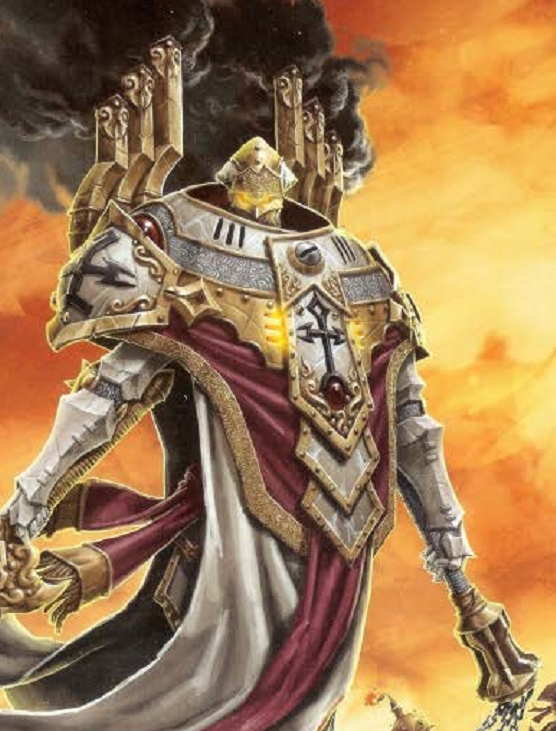
No one cares so much about heathen souls as Vice Scrutator Vindictus . Others see heretics, but he sees potential Menites, preacing with word and deed. When an unbeliever cannot hear the truth, he is not afraid to teach them via pain. He is compelled to convert the wicked wherever they may be, seeing it as his duty to tend to the flocks of mankind born without a chance to witness the glory of the Protectorate. Thousands of priests tend to Menoth's flocks, but few act as missionaries, and so Vindictus periodically travels far and wide, bringing loyal armies with him to capture those he believes that pain can grant conversion to. Vindictus has traveled deep into the heartland of the enemy to preach, delivering many new zealots to the True Faith. His sermons are full of the language of penitence and the wrath of Menoth. More than one Cygnaran or Khadoran village has been torn apart by the newly converted desperate to prove their devotion with blood. The zealots that follow Vindictus fight with the strength of martyrs, eager to emulate him. He himself can be more forgiving, and eveni n battle he will spare his foes if they accept Menoth. He is a potent warcaster with great power and knowledge. He understands heretics and their magic, taking on that burden to understand those who seek a corrupting path. This is dangerous, but he has the conviction and will not to use this lore save to root out blasphemy. He is a master of finding weaknesses in his foes and using their failing convictions against them. He intends to show all of Caen Menoth's glory - or, failing that, send them to it in Urcaen. His gimmick is martyring his own dudes for buffs or tactical reasons. His feat allows him to harm those who have harmed his allies.

The Protectorate has a rather unique and contentious relationship with mechanika. Strictly speaking, doctrine says that all arcane works are heresy, but mechanika are required for military dominance. As Menoth intended victory, therefore it must be his will that a way exists to sanctify warjacks. The Protectorate's earliest use of mechanika was laborjacks for industry and agriculture, inscribing prayers on their hulls. Hierarch Luctine weighed in early, agreeing that this was the correct path. In the early decades, it was important to appear in accord with treaty, so the laborjacs were secretly armed for battle with smuggled warjack cortexes and other refined machines brought in from Khador. Quickly, the Protectorate gained a handful of functional black market warjacks and a few simpler home-made components. In time, they become bolder and less focused on disguising their work. Within decades, they were making their own warjacks, with cortexes made by kidnapped experts. These enslaved arcanists, eventually organized as the Vassals of Menoth, would become critical to the war effort. They still rely on captives, but also have some of their own citizen arcanists, who at one time would be killed as children. A stigma associated with working on mechanika remains even today, though, and many who join the Vassals do it to avoid reclamation. Despite the formidable number of warjacks they make, they still lag behind other nations. Many think of their warjacks as precious, blessed weapons, with the warjacks and their inscribed prayers and following choirs inspiring awe.

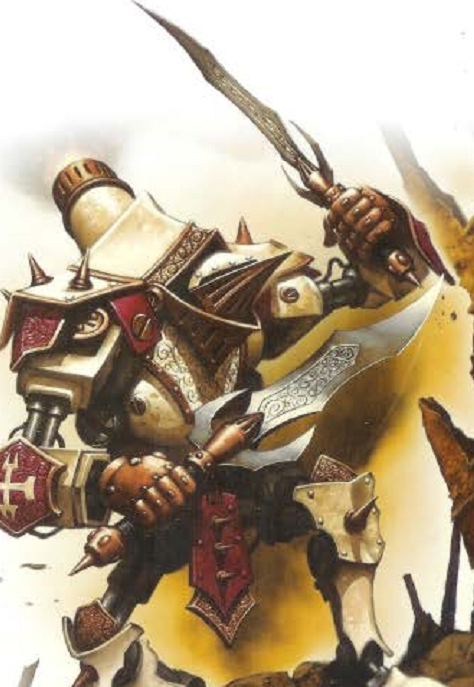
The Dervish is over 8 and a half feet tall and 3 and a half tons, built on a Devout chassis reworked for offense. It wields twin blades like a metal butcher, tearing off limbs and killing soldiers. It is light and a gile, excellent for a force on the move and with better reflexes and flexibility than any other Menite warjack. Its blades move at blinding speeds and it can avoid attacks in the some motion as it moves in to attack itself. It is clearly designed for war, made in secret in small numbers. Now, the line has been called to the front to carve a swath through the enemies of Menoth.
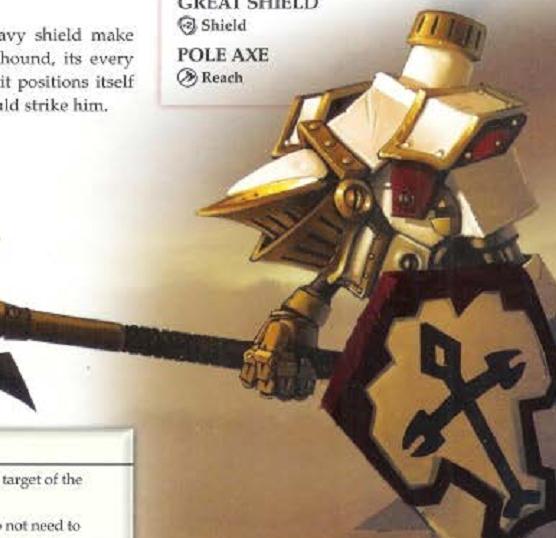
The Devout is over 8 and a half feet tall and nearly 4 tons. It was designed to protect Protectorate leaders, and every part of it is meant to enable that. It's light enough to keep pace with warcasters, uses enhanced reflexes to intercept attacks and has a massive shield sanctified with holy inscriptions to protect against magic. When the Vassels of Menoth were ordered to make a bodyguard 'jack, they wasted no time. The Repenter chassis was rejected as too cumbersome, and a new one was made from the ground up to ensure its suitability. The Devout still made heavy use of smuggled parts, but the cortex was homegrown. Its reflexes and heavy shield make it a perfect guard, its every reaction tuned to battle.
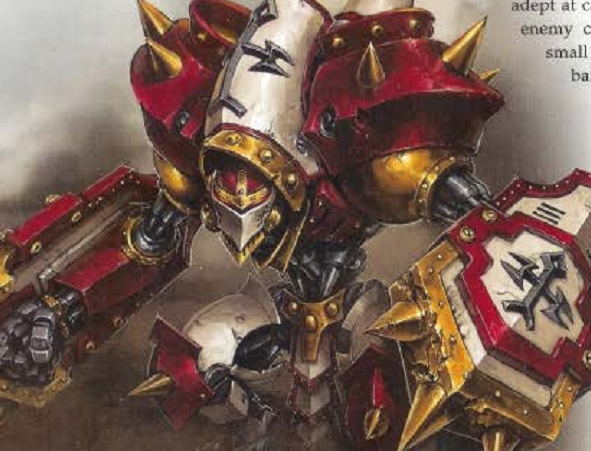
The Vigilant stands almost 10 feet tall and weighs 5 tons. It is one of the oldest chassis designs still in service, among the first ever made for the Protectorate. It has defensive armaments, obeying Cygnaran prohibitions to the letter while still being a weapon. Its two fist-mounted shields make it very durable, withstanding attacks that'd cripple heavier machines. It is practically immune to artillery fire, making it a favorite among warcasters, and it is very low maintenance, serving well as a supply train as well as a weapon. It's ability to maneuver barricades and weather fire in street fights made it crucial in the siege of Sul. After decades of service, it's just as dependable now as the day it was created. Some Vigilants have been in continuous use for over 50 years. Their simple weapons and cortex make them easy and cheap to make, too.
Next time: God's Giant Robot
Forces of Warmachine: Protectorate of Menoth
Original SA post Forces of Warmachine: Protectorate of Menoth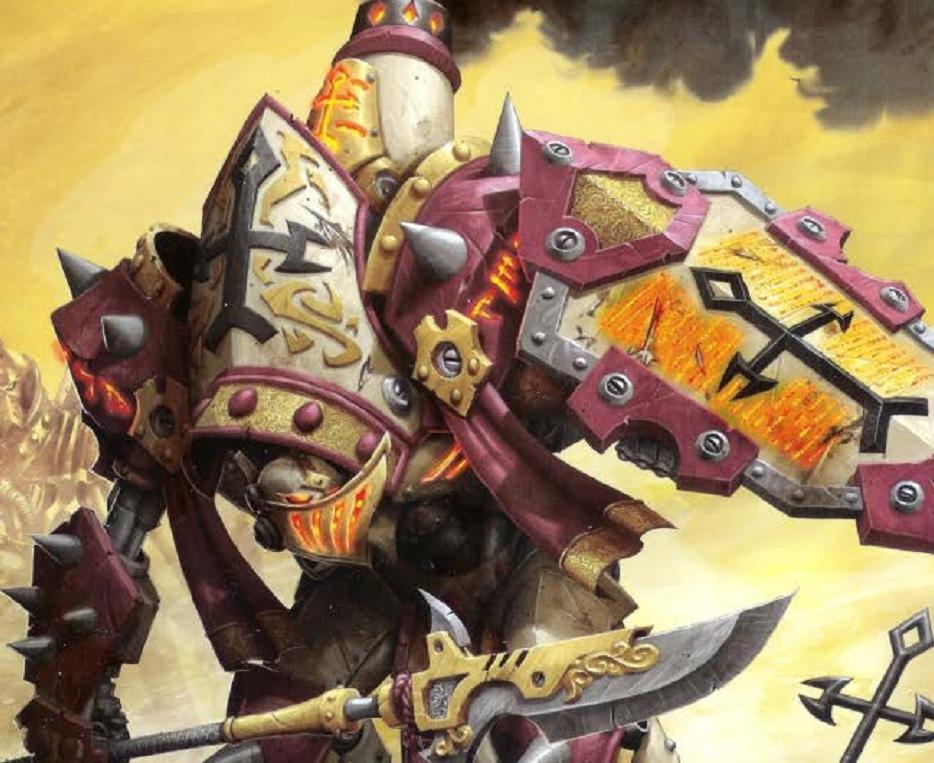
The Blessing of Vengeance is a custom Revenger, nearly ten feet tall and over 4 and a half tons. It has served Severius for nearly 30 years straight, channeling prayers through tis arc node onto the heads of the enemy and to bless the faithful. The zealots whisper that it can see into the souls of men and smites the impious on its own. Certainly, it is well tuned to Severius' prayers and is ready to defend him without orders. It seems aware of its function and that it requires it to survive, so it happily tears apart the enemy, going to any lengths to avoid distraction from its master. Since Severius became hierarch, keeping Blessing of Vengeance battle-ready has become even higher priority, and an entire choir and dedicated Vassal of Menoth attend it at all times, sometimes forgoing food and rest. The Blessing is the final line of defense for the hierarch, both weapon and bodyguard.
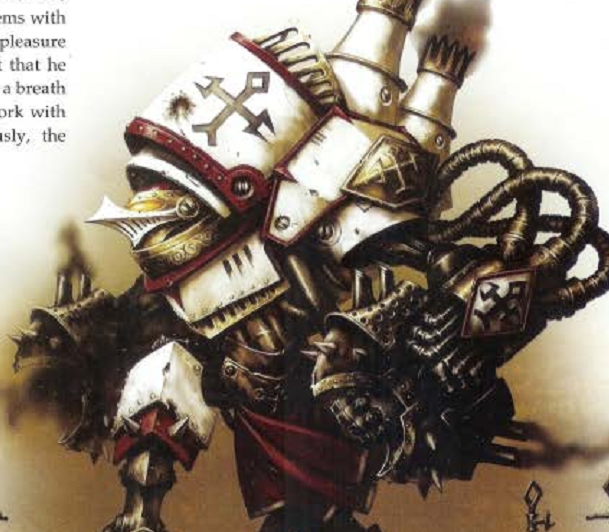
The Castigator is twelve feet tall and almost 8 and a half tons. It is a product of the expanding war industry of Imer, built on a Reckoner chassis. Few outside the Vassals of Menoth know the Castigator was designed before the Reckoner, but was prevented from creation due to problesm with its weapons system. Visgoth Ark Razek was so angry that he had every mechanik on the project wracked to within a breath of death before restoring them and putting them back to work. Miraculously, the problems were almost immediately resolved. The Castigator's fists burn continuously in battle, with the heat rippling the air as it charges. Each fist has a sophisticated delivery system for Menoth's Fury, compress and piped into direct contact with the warjack's furnace. If surrounded, it will ignite the air itself in an explosion that can melt iron and cremate flesh. One big advantage is the ease with which it's refueled. Unlike the Reckoner's Condemner cannon, which requires specially made shells, the Castigator's fists only need a fresh supply of Menoth's Fury, so they need far less support from Imer, and have been sent north to the front lines.
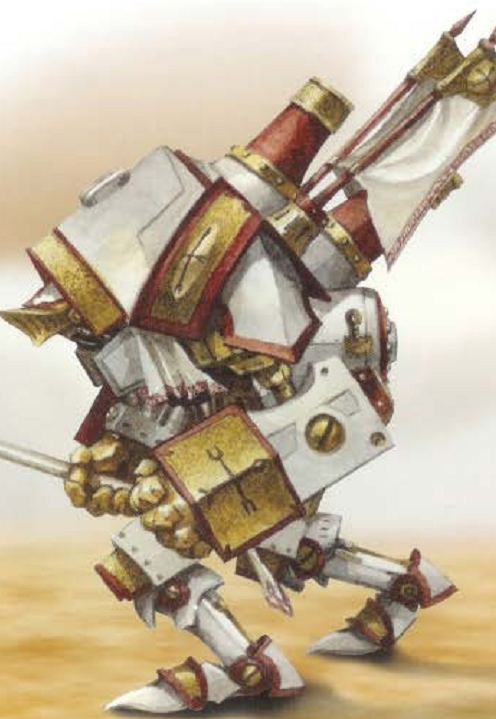
The Guardian is 12 feet tall and almost 8 and a half tons. It is coated in holy script and able to channel divine power via na arc node. Originally made to help defend sacred sites, they have since become a very versatile weapon. While only a few were initially made, the utility of the Divinity arc node and the resilience of a heavy 'jack couldn't be ignored, and soon they were made in greater numbers, though the cost keeps them relatively rare even now. Their primary weapon is a superheated pike, based on the traditional weapons of the Flameguard. Each one is a finely crafted instrument, and the warjacks are painstakingly engraved with liturgical verses, so infused with holiness that some priests use them as battle altars.
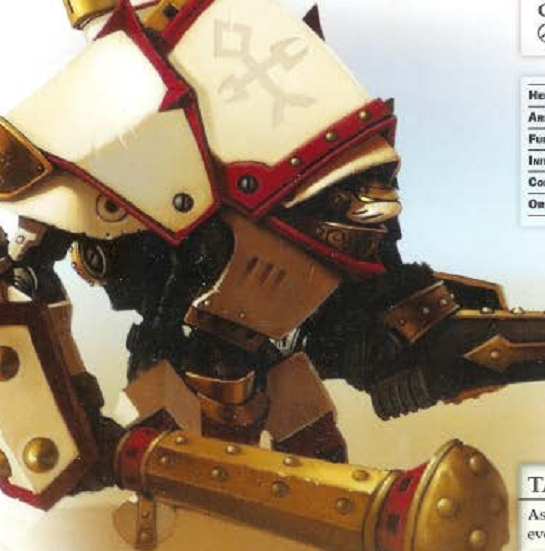
The Reckoner is 12 feet tall and over 8 and a half tons. It's name comes from scripture: "He who is the Grand Reclaimant is, too, the reckoner of Man, burning away the sins of the faithful with but the merest glance." The Reckoner is a titan, its mace constantly issuing forth incense and its Condemner cannon firing huge, burning rounds. It was made in secret, and now is at the forefront of the crusading armies, spreading Menoth's word by fire. It was the first purely Menite warjack chassis, designed and built in the Protectorate.
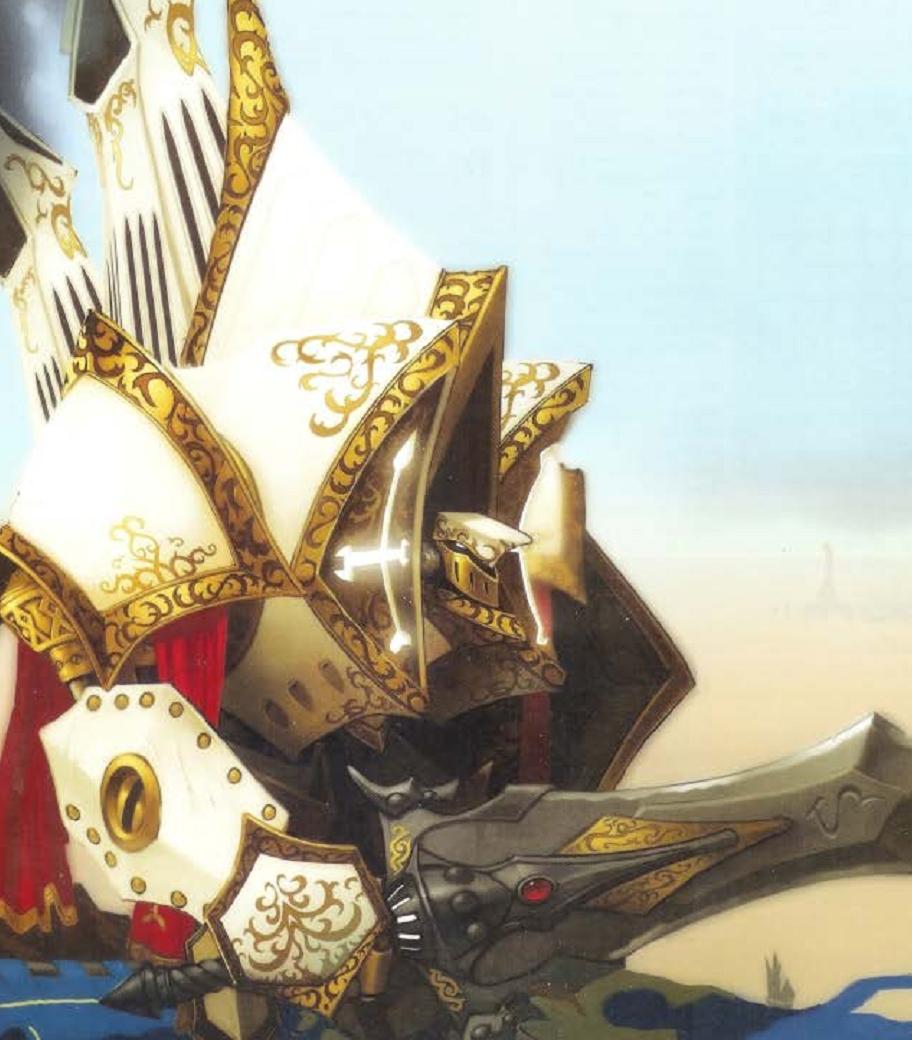
The Avatar of Menoth is 13 feet tall and almost 10 tons. It is the hand of the Creator directly, unfettered by mortal will. The Harbinger oversaw its construction, and the Vassals who built it were driven by an unseen force, laboring endlessly. They could not understand what they built, for Menboth guided their hands to divine specifications. The schematics were stricken from their minds as they completed it, leaving only awe. At the end of it, the Harbinger placed her hands on its helm and whisper the Creator's final imperative to it. The construct filled with soulfire, roaring to life like a beast awakened. It walked out into the desert as the Harbinger and mechaniks looked on. In its right hand, it wields an immense blade, named Burning Wrath in the ancient tongue of Icthier and inscribed with prayers unspoken for millenia. With each strike, it destroys the foes of Menoth. In its left hand, it has the Divine Shield, which bears the words Menoth spoke to the first Menites as he built the first wall. It is protection incarnate. A lesser warjack is animated by a cortex, guided by a warcaster or marshal. Not so the Avatar. So far as anyone can tell, its name is not hyperbole: it is directed by Menoth's wrath, and even the Harbinger cannot command it. It does as Menoth wills it, and nothing else.
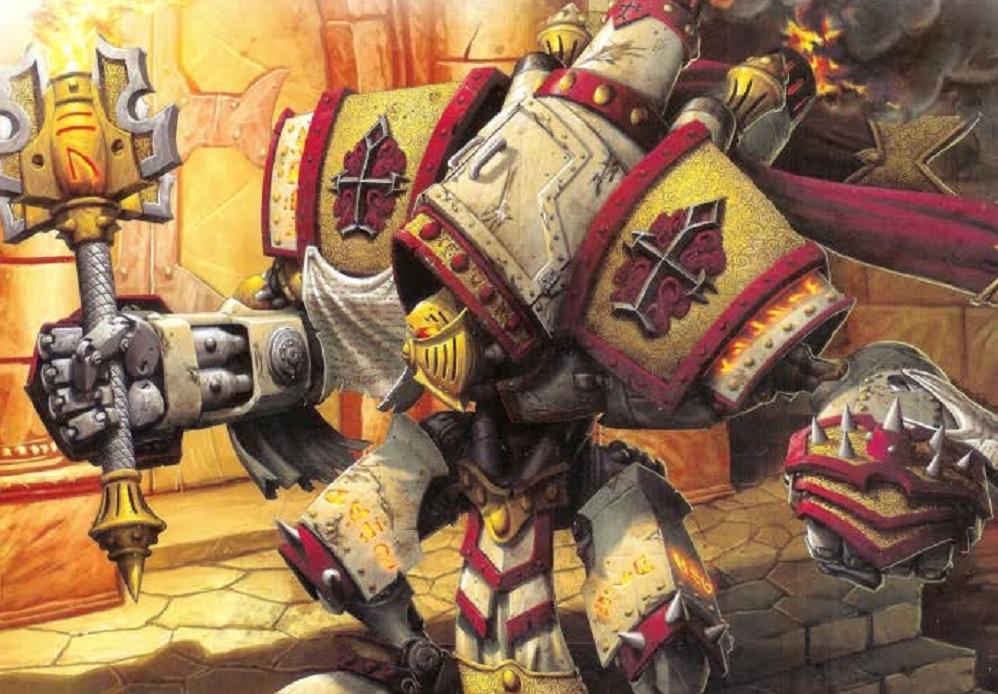
Fire of Salvation is Mikael Kreoss' personal Crusader. It acts more like a person than a machine, fervent in its wrath and inspiring in its bravery. It fights to avenge those that die around it, wielding an immense, flame-wreathed weapon named Absolver. Menites of other nations who have seen it have been known to fall to their knees and forsake their old loyalties, begging Kreoss to restrain it from killing them. The choir priests that attend it know its every detail, which is densely inscribed with the history of its battles. After each battle, the armorers write new liens in the plated steel of its armor. Kreoss and Fire of Salvation have fought together since Sul, often with just a handful of exemplars. Few knights survived these rearguard actions,a nd without Fire, Kreoss would have died as well. Its hull was further ornamented in the days after Voyle's death, when it battled to push back the Cygnarans and lay siege to Caspia. Though its cortex and wepaons are more recent, its armor is drawn from machines of the original Protectorate crusades, many of which were left in the deserts north of Icthier after they were destroyed in battle. These became holy artifacts, and the priests deemed it only right that these relics should be placed on a 'jack that has served Kreoss since his earliest days of service. During the ceremony where he was made grand exemplar in 605, it was affixed with blessed parchments bearing illuminated passages of the Canon of the True Law, formalizing the sanctity it had earned in battle. Fire of Salvation has leanred a lot from Kreoss, inspiring the Knights Exemplar just as he does and fighting with the ferocity and anger of a brother knight.

The Protectorate's ability to establish itself as a military power is the reuslt of nearly a century of work. It lacks the population of other nations, so it compensates with fanaticism. Nowhere else are so many willing to fight and die for their beliefs. The crusades create a constant need for soldiers, with the various orders providing dedicated forces that must be coordinated across amyn leaders with different biases. This makes the Protectorate very unpredictable in the field. The backbone, though, is the Knights Exemplar, supported by the Temple Flameguard and militias. The Knights are the pinnacle of Protectorate soldiers, tasked to do Menoth's will at any cost. They use punishing training and grueling tests as well as immersion in radical Menite philosophy, and those who complete their training are forever changed. The Flameguard, meanwhile, have gone from just guardians to the largest part of the army, citizen soldiers trained to march in unprecedented numbers under Feora, Protector of the Flame. Anyone can apply to the Flameguard, but not all pass the rigorous training. Life for them is similar to other professional soldiers, save that they serve until the Incendium priests give them leave to retire. While this term could be as short as five years, in war it may be a decade or longer. Particularly valuable soldiers may not be let go until they are killed or very old indeed.
Next time: Soldiers of Menoth
Forces of Warmachine: Protectorate of Menoth
Original SA postWhat bothers me, personally, is her armored belly button.
Forces of Warmachine: Protectorate of Menoth
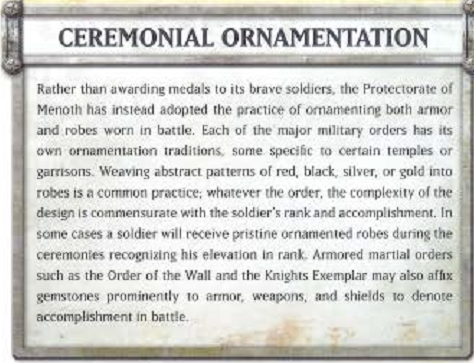
Every soldier in the Protectorate earns a modest wage, usually enough to support a family. In the event of a death, the family gets a stipend. Orphans become wards of the state. However, many familis have become tied to the Temple over hte years, with service being expected. Often, they are groomed from childhood as preceptors or Incendium priests. The Flameguard also supports two specialist groups: the Flameguard Cleansers and the Daughters of the Flame. Both are famously ruthless and devoted, open only to the best. Cleansers will not hesitate if ordered to burn an entire village down and don't care who the enemy is - just that the priests say they must die. The Daughters, on the other hand, began as a small group of volunteers, all of whom were daughters or widows of dead soldiers. They hoped to honor the sacrifices and avenge their loved ones, willing to do even the most dangerous missions without regard for their own safety. Feora expanded them due to their successes, and they are now a significant tool - assassinations and surgical strikes are their specialty, and recruitment has opened to anyone who is zealous and has the right capabilities. Every priest, monk and acolyte also serves the True Law, and several small orders, like the Fist, REclaimers and the Wall, fight in the war. More than anyone else, the Protectorate can depend on all of ther citizens in battle - any able-bodied man and woman could become a citizen soldier if needed. They are organzied into lesser orders, like the Deliverer rocketeers, and are led into battle by their local priests. They have limited training and discipline but have plenty of fanaticism and numbers.
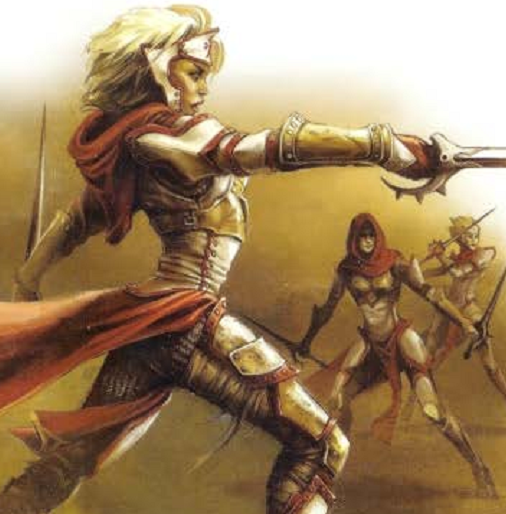
Daughters of the Flame
are feared even within the Protectorate as silent killers. They were founded in secret by Feora with Voyle's consent, guarding the sacred places. Over time, they have become a precision tool for removing both internal and external threats. They work as small strike forces, or hands, stalking foes with singleminded devotion. They are chosen from fresh recruits based on potential and dedication. Most are widows of soldiers, others grieve dead parents, siblings or betrothed. They are technically Flameguard, but are trained seperately, both physically and mentally. They have peerless grace and skill in sneaking, and they move very quickly, bending and contorting to take advantage of any cover at all. They are rumored to have trained in the same martial techniques as the Order of the Fist, but they use blades, cutting through narrow spaces between armor plates. Some say Feora overreached her authority in expanding their role, but no one would doubt it's been good for the war. Since the start of the crusade, they have served alongside the Flameguard and Cleansers on battlefield, conducting precision strikes and battlefield recon.
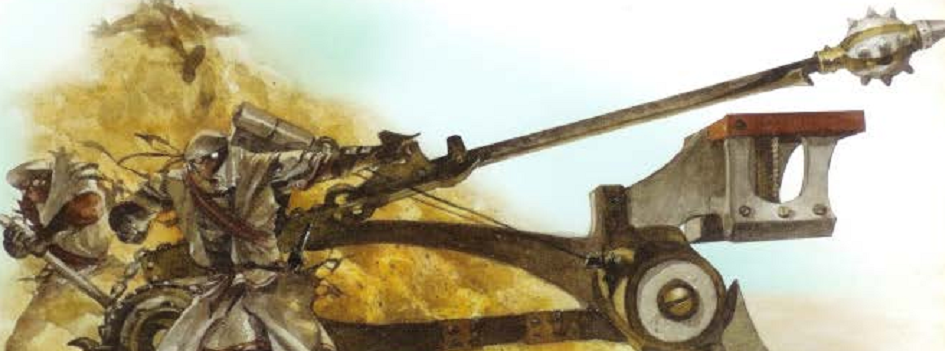
A
Deliverer Sunburst Crew
supports the army from afar, hurling flaming death. Their bolts detonate on impact, creating holes in the enemy line. The Sunburst was made as part of the disarmament agreement centuries before the Menites rebelled against Cygnar. They were prohibited from having dedicated weapons, so they couldn't use cannons. Instead, they used ancient ballistas, dating to before the Thousand Cities era. The platform throws its payload, allowing for a heavier and more destructive charge than a shell sent by blasting powder. The charge is a spherical orb containing refined Menoth's Fury in a lattice of metal designed to splinter into shrapnel on detonation. The gunner and crew can range and attack targets easily as long as they remain in communication, and the crews are very proud of their job.
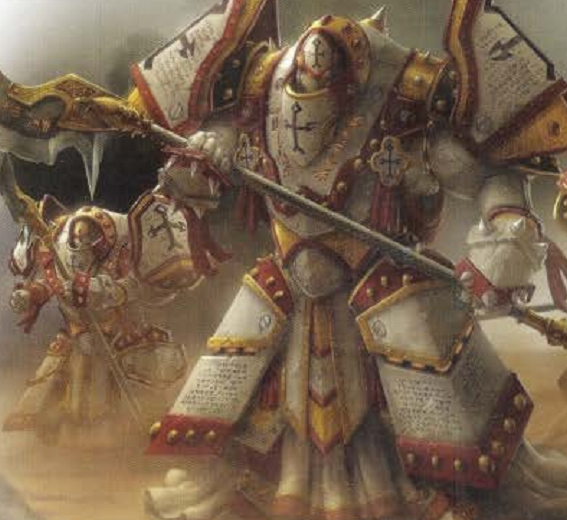
Exemplar Bastions
are a select few among the Exemplars. During their initial fasts, they experience a dream of being buried, but remain calm and unafraid. They wear heavier armor and stand in the temple courtyard for two days and nights without food or water, loaded down by weights. At the end, they must march across the temple, despite the fact that several suffer crippling injuries from the ordeal. If they succeed, they can endure the rest of the training for bastion armor, made of ancient steel plates engraved with holy script. The bond each bastion has with their brothers in arms grant them collective strength. They can ignore their injuries and needs for days or even weeks without removing their armor. Enemies despair on seeing them, as their attacks only grow stronger as they are wounded, as if their near reunion with Menoth empowers them.
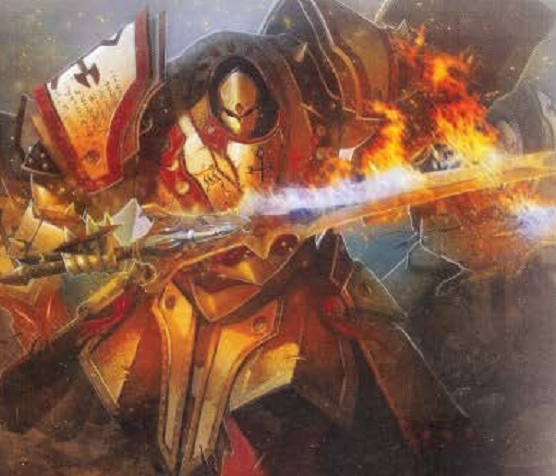
Exemplar Cinerators
wear blessed armor of fallen exemplars into battle. They are the fire of Menoth's will, moving ahead of the Exemplars to breach enemy ranks. Their training strengthens them even more than most bastions, preparing them for their massive armor. Some initiates are crippled or even killed by the training, but those that survive are perfect crusaders. Years of prayer allow them to internalize wounds that would kill lesser men. They are conduits of Menoth's rage, channeling their pain into anger and rushing ahead to attack. Like the first Menite warriors, they have a savage hunger for battle. They are cruel, armed with ancient swords that are imbued with blessings that render them aflame in battle. When they strike down a foe, Menoth shows approval by causing a burst of fire to explode from the heretic's body to consume their allies but leave the Menites unharmed.
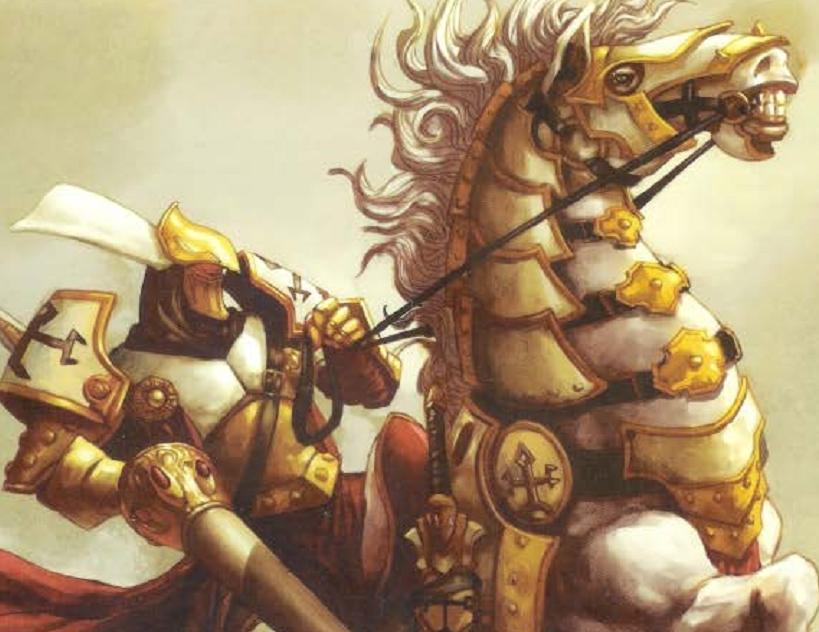
Exemplar Vengers
derive from the Khadoran horselord tradition, after some converted to the True Law. They are paragons of tradition and Menoth's will. In the days of antiquity, they were warriors of faith, bodyguards and defenders, but as time passed, the knights were named vengers for carrying Menite justice to all the Thousand Cities, ruthlessly and passionately. Today, they are the spearhead of the holy war. Many are descended from the Khadoran horse lords and are tied to the Khadoran Old Faith. Hierarch Severius continues his advance through Llael with the greatest gathering of Exemplars in history, and the vengers may be more civilized than their forebears but no less resolved. They serve the will of the Creator, and they are relentless. They are deadly, as well, with blessed lances and war-bred stallions of great strength and beauty. Their warhorse are chosen from Idrian lines in the south and Pozdyov warhorses in the north, especially among Llaelese knights, some of whom are former Khadoran uhlans. They do not use or need mechanika of any kind. They feel the pain of the brother knights, fighting harder for each drop of blood they lose. Venger charges are sepcially terrifying, thanks to the power of their horses and lances, and after each battle, the vengers take time to cleanse themselves in sacred ritual, sacrificing the tainted blood of the foe to Menoth in flaming braziers as gratitude for victory. These rites are central to venger tradition and are never given up, even in war.
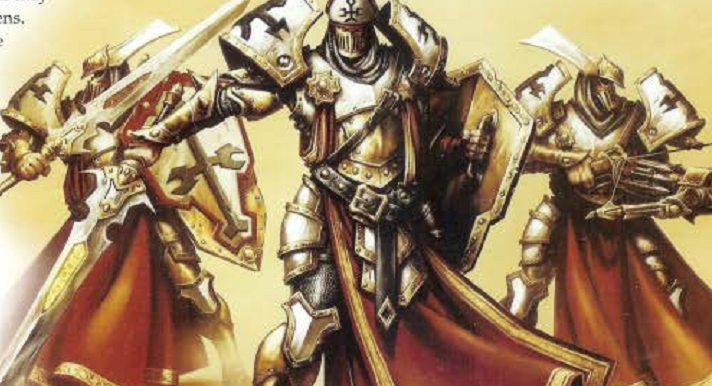
Exemplars Errant
are knight outriders, heading out of the Protectorate on missions of vital import as an advance strike force. They do not use the relic blades of the Knights Exemplar, for fear that they should fall into heathen hands. Rather, they use lighter and more versatile weapons, which they train with extensively. The errants use blessed crossbows to pierce magical shields and bear shields inscribed with sacred passages to protect themselves. Each knows that if they die, their acts will go unrecorded in Caen, but that is acceptable. Their job is to carry the Synod's will across Immoren, hunting traitors for years. They are advance scouts as well, seeking out the enemy as they wait in ambush. While all Exemplar knights must be faithful and dedicated, the errants are chosen from those with the spirit of martyrdom, willing to die if it will complete their tasks. They will sacrifice their own lives to save a threatened brother, willing their life on to another and passing into Urcaen to heal the otherwise fallen.
Next time: Onward, Menite soldiers!
Forces of Warmachine: Protectorate of Menoth
Original SA post Forces of Warmachine: Protectorate of Menoth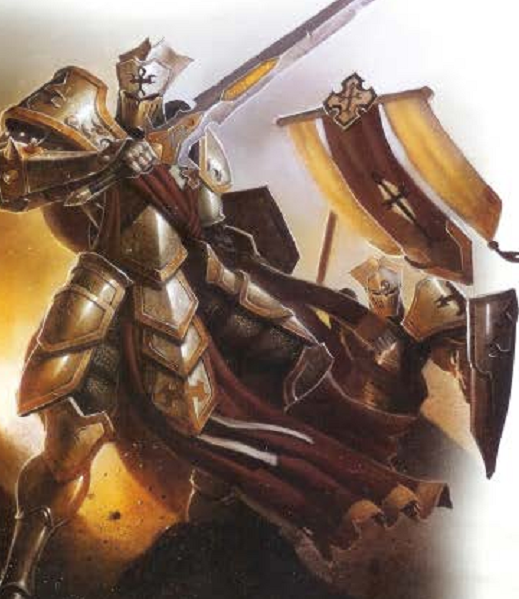
An Exemplar Errant Officer and Standard sometimes lead the Exemplars Errant in battle. They are veterans, chosen to lead for their purity of thought and heart, trusted to carry out their missions no matter what. Their dedication is so great that the knights they lead will do anything to ensure success. They always bear an Exemplar standard, to show their faith and conviction. These standards bear the history of the order and are prayed over by the visgoths themselves, and any deed under them is a sacrament. They will go to any length to keep the stnadards safe.
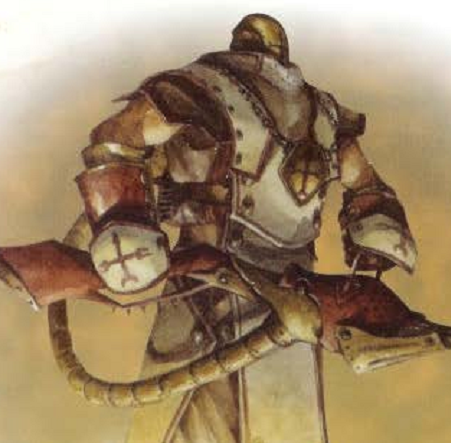
Flameguard Cleansers were originally the disciplinary arm of the Flameguard. Their job is to sanctify the land against heresy, purifying blasphemers with holy fire. Once called to duty, they burn out heretics with their flamethrowers, reducing buildings and people to mere ash. They watch over the fires to kill those that try to escape, but most prefer to wound or cripple escapees and toss them back into the fire, to carry out the letter of the law. The Purifier, the standard Cleanser weapon, is one of the few mechanikal advances originating in the Protectorate. They are a portable delivery system for Menoth's Fury and are horrifyingly deadly. Other nations are shocked that they'd use it on their own, and it only reinforces the cruel reputation the Menites have. Though made to purify at home, they have now been deployed outside the border, too, with the same zealotry. Each one is capable of clearing a swath of foes, and together, they can make an unstoppable inferno.
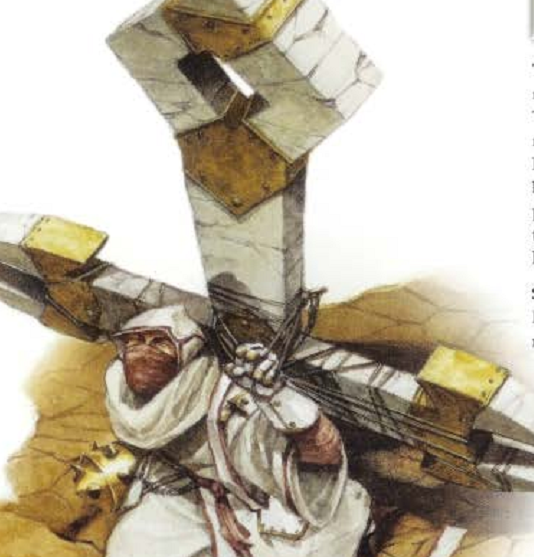
A Monolith Bearer will sometimes lead the holy zealots. The Menofix is a powerful symbol, embodying the certainity of the inevitable and the generations of pas suffering. Its presence can push the faithful to greatness, and the bearers carry Menofixes made of basalt or granite. Despite their weight, the bearers pray loudly and sing hymns in battle, pushing other Menites to ecstatic frenzy. Each monolith is a potent icon inspired by ruined, ancient Menofixes of Icthier. Often, they were held in a church until a zealot was divinely compelled to lift them onto their back as a sign of the power of the faith. The bearer reminds the zealots of Menoth's power, assuring them of their righteousness to the point that their faith can turn aside blades. Bearers rarely survive more than one battle, as snipers and spellcasters go out of their way to eliminate them. However, those who carry a Menofix die with prayers of vengeance on their lips, and their brethren often fulfill those prayers.
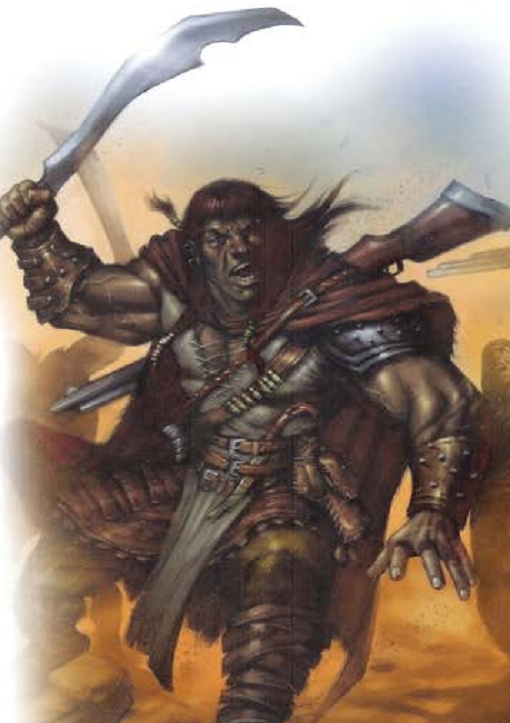
Idrian Skirmishers are dangerous tribesmen of western Immoren. Their legends speak of a 'changing of the earth' that wiped out most of their tribes and scoured the land, creating the Bloodstone Marches. The few that survived became the Idrians, and they know how to live in terrible conditions. The skirmishers, skilled in rifle and blade, have long guarded them. They are masters of ambush, cunning and well coordinated. They rise from the sands to intercept enemies, closing swiftly and killing many before they can react. Their kopis blades are passed down generationally, but their rifles are rather more recent. The majority of the Idrians converted to Menoth's worship in 504, but not all joined the Protectorate. Some stuck to their dunes and oases. Every year, more Idrians join the faith, and in recent years, the settled Idrians have gone back to meet their kin in hopes of convincing them to join the cause. Some skirmishers fight for coin, but others have true faith, eager to end the lives of the unbelievers.
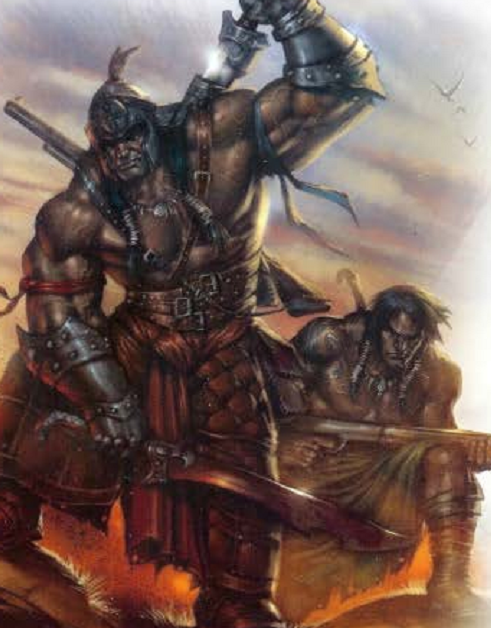
The skirmishers are sometimes led by an Idrian Skirmisher Chieftain and Guide . Only those of great will can unite the Idrian tribes in the sands, leading them in coordinated strikes. Chieftains are proven in combat, not by birth. A knowledgeable guide is often key to their success, as the guides are peerless desert trackers with flawless knowledge of the landscape. The best guides can predict the weather a week in advance and can tell someone's approach by the faint trembling of the sand. Pious Menites are often uncomfortable around them, for their wild skills seem supernatural. They are, however, excellent at finding the enemy.
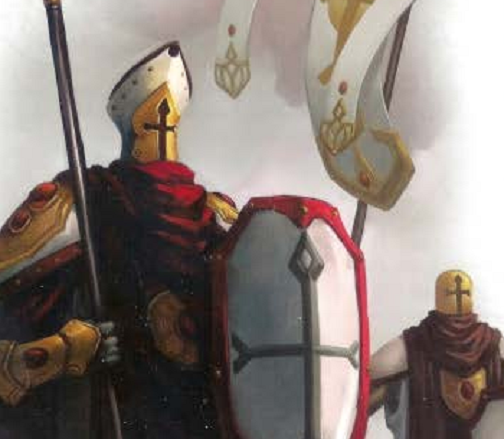
A Temple Flameguard Officer and Standard will sometimes lead the Flameguard. They are preceptors, empowered by Feora to lead in battle. They spend their lives mastering the flame spear, and their personal soldiers are capable of amazing acts. They can whirl their weapons in unison to drive fuel into the speartips and make the keening known as Menoth's Howl, an intimidating attack that has become their signature maneuver. The preceptors' standard bearers are chosen from only the most faithful, carrying standards the bear this passage from the Canon: "Stand strong as the walls of My Cities, and I will protect you always. Push against the tides of chaos, and I will move you. You are My will made flesh."
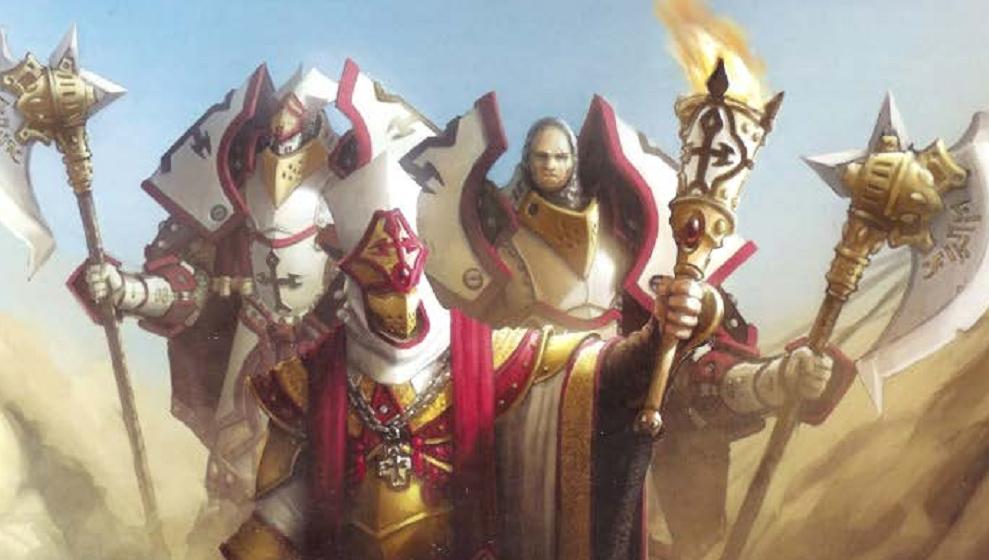
Visgoth Juviah Rhoven and the Honor Guard are ranking in the Protectorate, serving directly under the hierarch. The visgoths have power over the lives of every citizen. Traditionally, they rarely take to the field, but the stakes now are just too high. Visgoth Juviah Rhoven has spent a lifetime upholding the True Law in Sul and preparing its garrisons for crusade. Sul is his personal domain, and he took its invasion as an affront, so now he walks to war as an example to the faithful, as proof that all clergy should bear arms against the heathens. On top of being a visgoth, Juviah is one of four vice scrutators and has access to the faith's inner circle. He came to this position as the first visgoth to support Garrick Voyle, and he killed many key threats after Voyle consolidated, adding many names to High Executioner Reznik's warrants. Though Voyle appreciated his ruthless support, it was his leadership in the aftermath that earned him the rule of Sul, which prospered under his direction. Juviah Rhoven is far more feared than loved, and in Sul he is a figure of terror, as all fear they may be taken for even the most benign violation of law. After Cygnar attacked Sul, Rhoven's mercilessness became lauded, and he became adored, as well. His honor guard accompanies him at all times, bearing consecrated halberds anointed in holy oil fro mthe same reservoir as the sacred flame in the Great Temple of Sul. The guard are led by two senior knights, Darvik Gius and Marrius Cassian, who are never far from Rhoven's side. Both are stern and widely admired, and most know the story of how CAssian nearly lost an eye to a Cygnaran sword. He has refused to repair the damage to his helmet in memory of it, that he might remain vigilant. Rhoven has fought Cygnar tirelessly since the siege, wielding the Staff of Sulon ti inspire the faithful. During the siege of Sul, he led the defense of several holy sites, particularly Sulon's Remembrance and the Great Temple of the Creator. To the faithful, he is the fire of Sul.
Next time: I kick ass for the Lord!
Forces of Warmachine: Protectorate of Menoth
Original SA post Forces of Warmachine: Protectorate of Menoth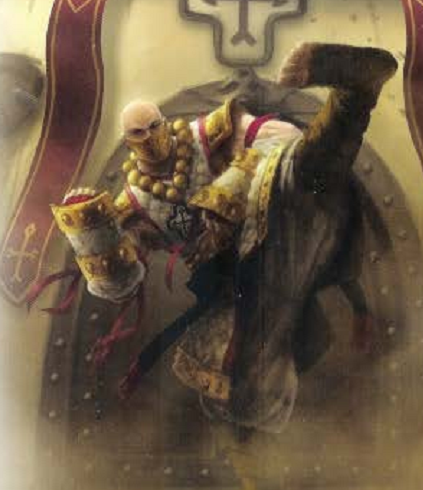
The Allegiants of the Order of the Fist are monks who forgo weappons and armor, favoring speed and the power of their bodies. They have turned their faith into absolute discipline and self-control, turning themselves into potent weapons. The order was foudned by Garrick Voyle ten years before he became hierarch, deciphering lost secrets of the ancient priest-kings and melding them with martial techniques of the Idrians. Allegiants study stone and sand, learning methods of applying deadly force naturally. They proved their strength as Voyle's inner guard in the early months of his power, hunting the streets for treason and insurrection, vanishing several citizens. Though lesser members of the order still police the populace, the allegiants have joined the active war. They fought in Sul and Caspia, and they have refused to return to their monasteries now, assisting the crusades.
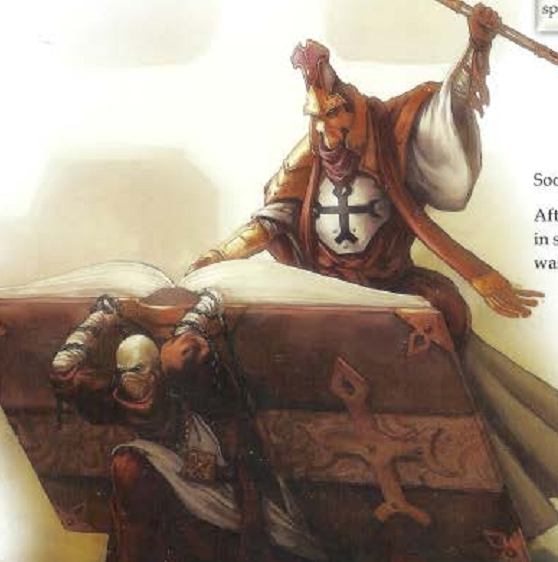
The Covenant of Menoth dates back to ancient Icthier, site of battles between Menites and Idrian tribes. One of the biggest conflicts was in 2200 BR, when the Idrians broke into the city and slaughtered the people. Their blood washed away the sands, revealing an ancient scipture. Like the Canon of the True Law, Menoth's Covenant was inscribed on the walls of Icthier, revealed by the blood of martyrs. As the last Menites were surrounded, an acolyte named Pontithius began to read the Covenant aloud, without fear. His words were like fire, promising victory, and the Menites took up arms from the fallen. Ten pilgrims defeated a hundred Idrians. After the battle, Pontithius transcribed the Covenant into an immense tome he chained to his back, carrying it for weeks to the feet of Priest King Golivant in Calacia before he callpsed. It is said that with the Covenant in hand, Golivant was unstoppable, and the last of the Molgur were driven from the Wyrmwalls. After his death, the Covenant was returned to Icthier in secret. Hidden for two thousand years, it was read only by sleect priests. Now that crusade is spreading, however, it is being spoke aloud across Immoren. While the Canon of the True Law is a guide to live by, the Covenant is a call to war, summoning potent miracles when read aloud in battle. It was discovered by blood, and only by blood is its promise fulfilled.
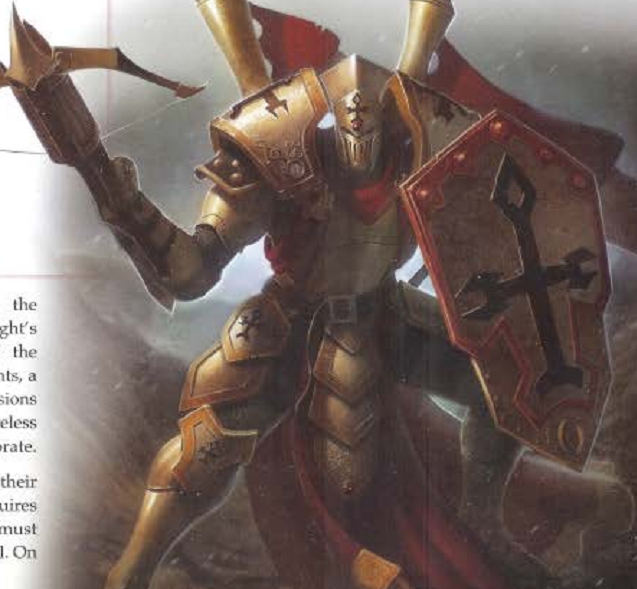
Becoming an Exemplar Errant Seneschal requires superlative skill, being a long veteran on foreign soil and a tireless devotion. They have the zeal to carry their faith across the world, but they need more than faith. They must also be wilderness survival experts, learning the lands they enter and gathering information for those that will come after. They are trailblazers, each skilled combatants able to root out foes in any terrain. Despite their peerless skill, however, their greatest asset is their understanding of Menoth's purpose for them. Where lesser exemplars follow orders, they do not need - they can interpret the needs of superiors while still being absolutely obedient. Any brother errant would volunteer to die for them, so clear is their special duty and their belief.
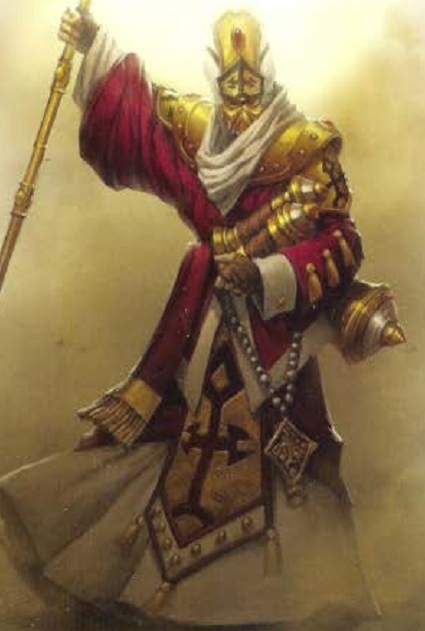
Hierophants are senior warpriests from among the choirs of Menoth. They are of advanced age and have a potent affinity for the warcasters they have served under. They learn to harmonize their prayers with the warcasters, using their faith to protect their leaders. They are a small, revered company that remain near the warcaster to pray and give counsel. Each carries scrolls containing excerpts of the True Law with bearing on war. As they fight, the hierophants find the right hymns, elevating their warcaster's mindset and power by inspiration. They also serve as clerks and attendants, noting great deeds and writing new hymns to glorify valor in Menoth's name. They also note valor and cowardice in lesser soldiers for later commendation or punishment. The verses they choose speak well to the needs of battle, and they can use their power to heal wounds and carry their warcaster's divine magic further.
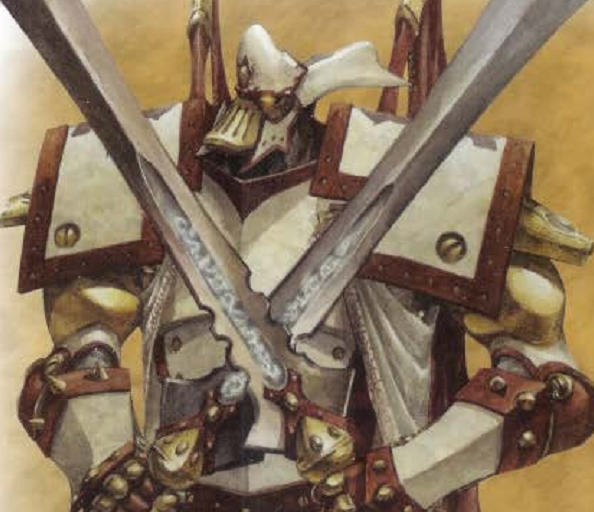
Knight Exemplar Seneschals are pillars of the faith. They are field commanders of the Exemplars, serving wherever the scrutators command. They are forces of nature on the field, wielding two swords relentlessly like angels of death. Those unfortunate enough to be near them are torn apart by Menoth's righteousness. Most notable, however, is their bond with other Menites. A seneschal feels the death of the faithful like his own wounds, and such is their conviction that they will never relent from their duty until their body is literally incapable opf movement.
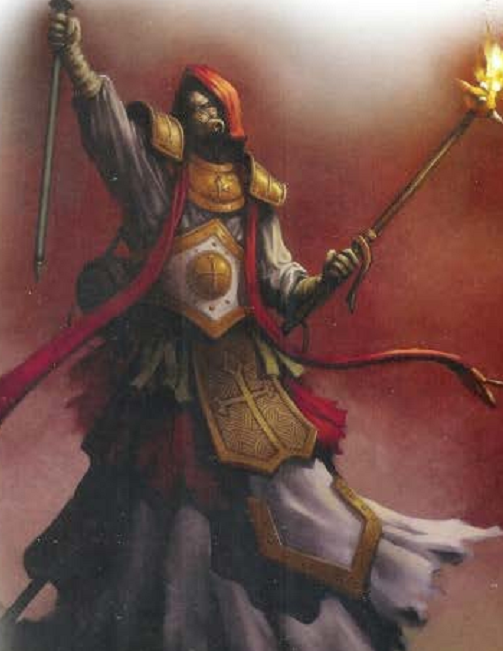
A Reclaimer never takes off the iron mask that forbids them speech. They know Menoth's Voice, and the last words they speak are a promise to send souls to Urcaen on wings of fire. They know not pain nor emotion, only service. Nothing can stand in their way when they hear a name whispered by the Voice. Since the birth of the PRotectorate, they have followed the armies to ease the transition of death, sending the souls of the fallen into the afterlife. The soul energy that courses through them looks like fire, searing the flesh of any who dare approach. They have some mystical connection to warjacks, able to fuel their cortexes with the souls of the faithful. Each reclaimer carriers dozens of iron Menofixes, placing them into the ground where they release souls. In the wake of battles, recently, they will cover entire plains with Menofixes of reclamation. Many welcome the sight, but some fear the increased appearance of these silent heralds in war signals dark changes, that the souls of the dead are becoming acommodity to be used in some forgotten prophecy.
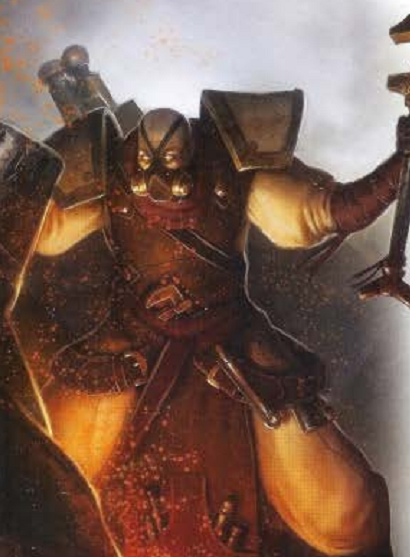
Sadly, prayer alone cannot maintain a warjack. For that, there are the Vassal Mechaniks . The Sul-Menites have never really been comfortable with mechanika, but they need it. They've increased production of warjacks, but still lag behind other nations, so maintenance is all the more crucial. The mechaniks who learn their trade from the Vassals of Menoth view their duties as a holy necessity. The Vassals, being kidnapped heretics, are too few and too valuable in cortex production to be tasked with repair. During the reign of Voyle, they were instructed to train Menites to repair and maintain wrjacks and mechanika instead. These volunteers are courageous, both for battlefield repair and for putting their souls at risk by tampering with arcane mechanika. To keep their faith strong, they devote a lot of their time to studying scripture, as well. By the time their training is over, they are as expert in the Canon of the True Law as with a wrench. They are skilled at keeping 'jacks running despite immense damage, wading into battle with only their tools and their faith to keep them moving on the field. More than one battle has been turned in Menoth's favor by their work.
Next time: No, guys, really, let's deploy some goddamn crucifixes.
Forces of Warmachine: Protectorate of Menoth
Original SA post Forces of Warmachine: Protectorate of Menoth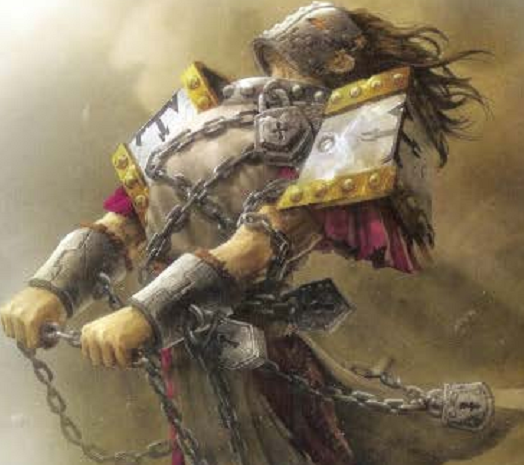
The Vassals of Menoth are vital to the Protectorate, but they are not trusted. The most talented of them are foreign wizards kidnapped to build cortexes by the Knights Errant and Order of the Fist. Most are Cygnaran, and a few were even members of Fraternal Order of Wizardry. They are pampered prisoners, but they are under heavy guard, and even the native-born vassals are restrained. Menites have always been hostile to arcane magic because its use violates Menoth's will, but during the Cygnaran Civil War, many leaders recognized the need for warjacksm and the Vassals have proved a wise decision. They demonstrate their worth eveni n battle with spells that can blast the foe or bolster a warjack's power. The demands of the crusade have forced the Protectorate find more native-born talent, and it seems strange to outsiders that anyone would volunteer for slavery, but Sul-Menites born with arcane talents are often so ashamed of their power that they welcome their chains. They enter the House of Truth to master their powers and pray for forgiveness of corruption.
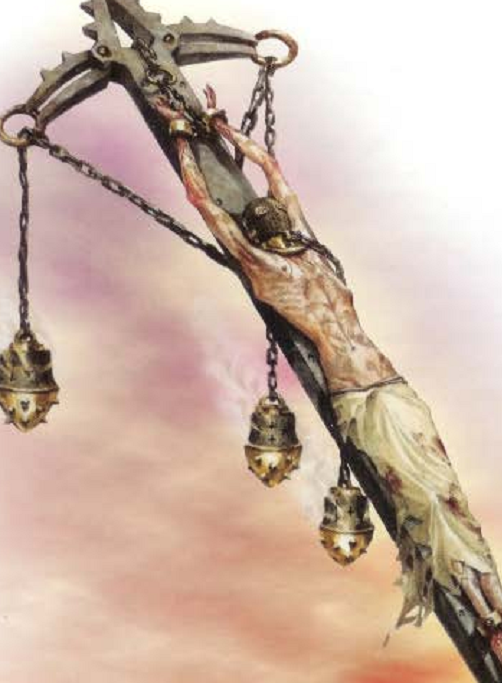
The Wrack is the favored tool of torture for heretics. It was once common in Immoren, under the priest-kings. Today, it is again common, valued by the scrutators for the awe it inspires in faithful and heathen alike. The recent crusades have reintroduced the wrack to Menoth's foes. Those sentenced to the wrack spend days or weeks hanging from chains in a fog of incense, forced to reflect on their sins in unbearable pain. Even the strongest will quickly erodes. While most are wracked as punishment, some seek it out willingly in the hopes of absolution. The sight of wracked martyrs, glowing with the divine radiance of suffering, has sometimes been enough to end battles before they begin. Before the release of death, the wracked people's souls are redeemed by contrition, forced or voluntary, and their body glows white-hot under Menoth's gaze. The redemption cleanses them, and their soul becomes a radiant source of power for the warcasters of Menoth. When they finally die, the release of energy is consumed in an eruption of flame, another tangible reminder of the righteousness of the cause. so yeah: crosses that explode .
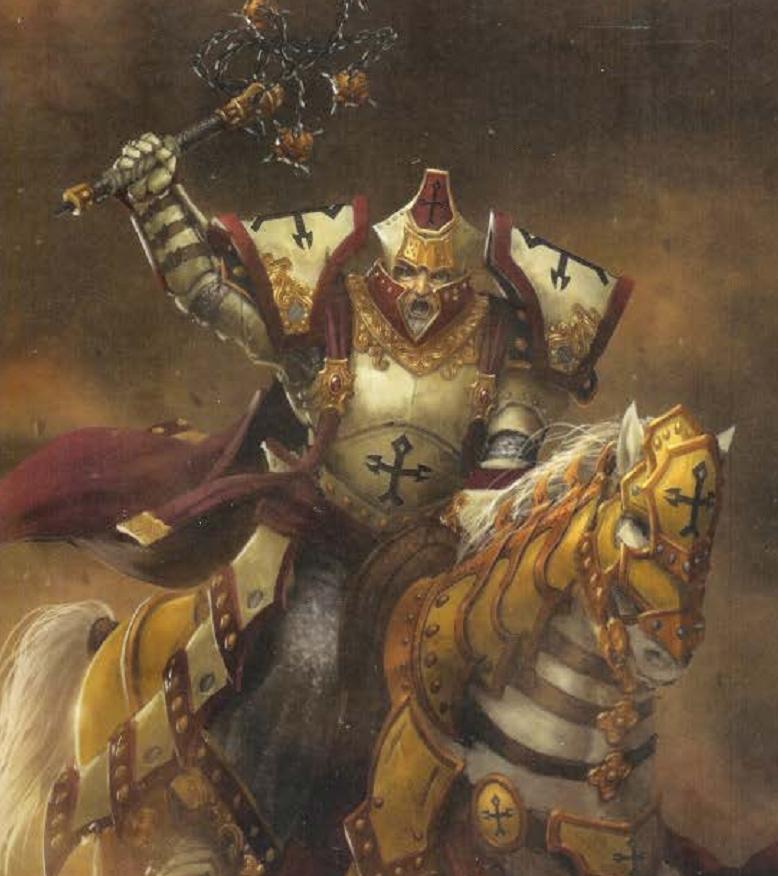
[n]High Exemplar Gravus[/b], first name Sarvan, is the weapon of the faith. He fears nothing, tearing apart Devourer cults and Cygnaran soldiers with equal vigor. He leads the Exemplar Vengers in battle with resounding prayers that rise even above the hooves of the horses. When Grand Exemplar Hurst died fighting Cryx, many supported Gravus as his successor. Though Mikael Kreoss was eventually named, Gravus was the only other possible choice. The people admire Kreoss for his dignity and loyalty, but respect Gravus for his pragmatism and ahderence to the Exemplar code. Gravus hopes to die in battle, fearing only that he may outlive his usefulness as a warrior. Any who has seen him ride into the enemy while his blessed flail cracks skulls knows that time is nowhere near. Age has taken its toll on him, but his will to fight is unchanged. He is a knight first and foremost, and he claims to take strength from his mount, Fidelitus, which descends from a long line of Venger horses. It was under Hierarch Ravonal that he rose to prominence, teaching the Cygnarans his name as the top cavalry commander of Menoth. On several occasions, he defeated forces of far greater number. He has a similar reputation with Khador, but for different reasons. When Severius gave the order to raze the town of Fisherbrook, bringing out the defenders, Gravus took his men to the outskirts and killed every man, woman and child he could find. In his lifetime of service, he has never questioned his orders. The priests interpret Menoth's will - he just obeys. His only evidence of any displeasure was when he was ordered to withdraw from Caspia after Voyle's death, and even then, he just looked angry and vengeful. He said nothing. He has come north with the new hierarch to fight in the new battles to come, knowing he will likely not survive to return home. He feels his death aproaching, and he is ready for it.
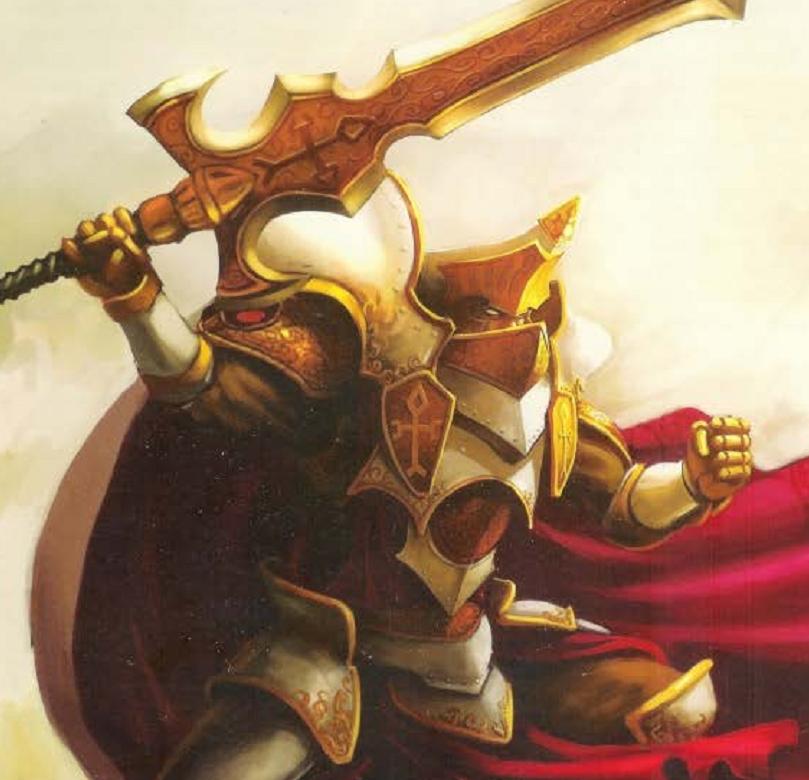
High Paladin Dartan Vilmon is a devotee of the Order of the Wall. He ofund his calling as a child in Sul, fasting on the doorstep of the order for days before falling unconscious from heat exhaustion. The paladins took mercy on him, taking him for training. He studied under them for years, remaking himself utterly. He proved gifted in battle even at a young age, wielding a blade with a speed and skill most would never reach in a lifetime. His ability was refined over the years, and to him, the stances and meditations of the order are prayers, and their execution brings him closer to Menoth. Even former Grand Exemplar Baine Hurst spoke praise of his skill. As with others of his order, he's had to walk between duty and obedience to the clergy and mercy and compassion. He has attempted to soften the dictates of the scrutators and shows compassion to the poor, giving relief to those sentenced to hard labor or granting merciful death to those enduring unavoidable agonies. The Harbinger chose him as her bodyguard, and he was there alongside Baine Hurst when Goreshade ambushed her. The grand exemplar sacrificed himself to give Dartan thechance to get the Harbinger to safety. He was again chosen to guard her when she went north to the Thornwood, and he witnessed her sacrifice to liberate the souls of Menites trapped in the Temple of Garrodh. He and the Testament fought side by side with the Avatar of Menoth, preserving the Harbinger's body and soul to go home to the hierarch. In recognition of his deeds, he was made high apladin,. returning to Sul to reclaim it after its siege. He put his shield aside in favor of the blade Censure, counting on his brother knights to be his shield. When Sul was reclaimed, he led the battle in Caspia alongside the Harbinger and Voyle. He alone defied Voyle's order to kill unarmed civilians, and he was ready to die for them, and surely would have if not for the Harbinger's intervention. It was in the aftermath of that battle that his courage inspired the Protectorate. The Order of the Wall, once in decline, has undergone a resurgence in respect and initiates now. It is the dawning of a new day for the order under its greatest champion.
The End!
What's next? Mercenaries, Skorne, Legion of Everblight or the Trollbloods?
Forces of Warmachine: Mercenaries
Original SA postI am having trouble finding my Skorne and Legion hardcopies, which I need for the fluff stuff, so that's gonna be a bit. Until I find them, mercs!
Forces of Warmachine: Mercenaries
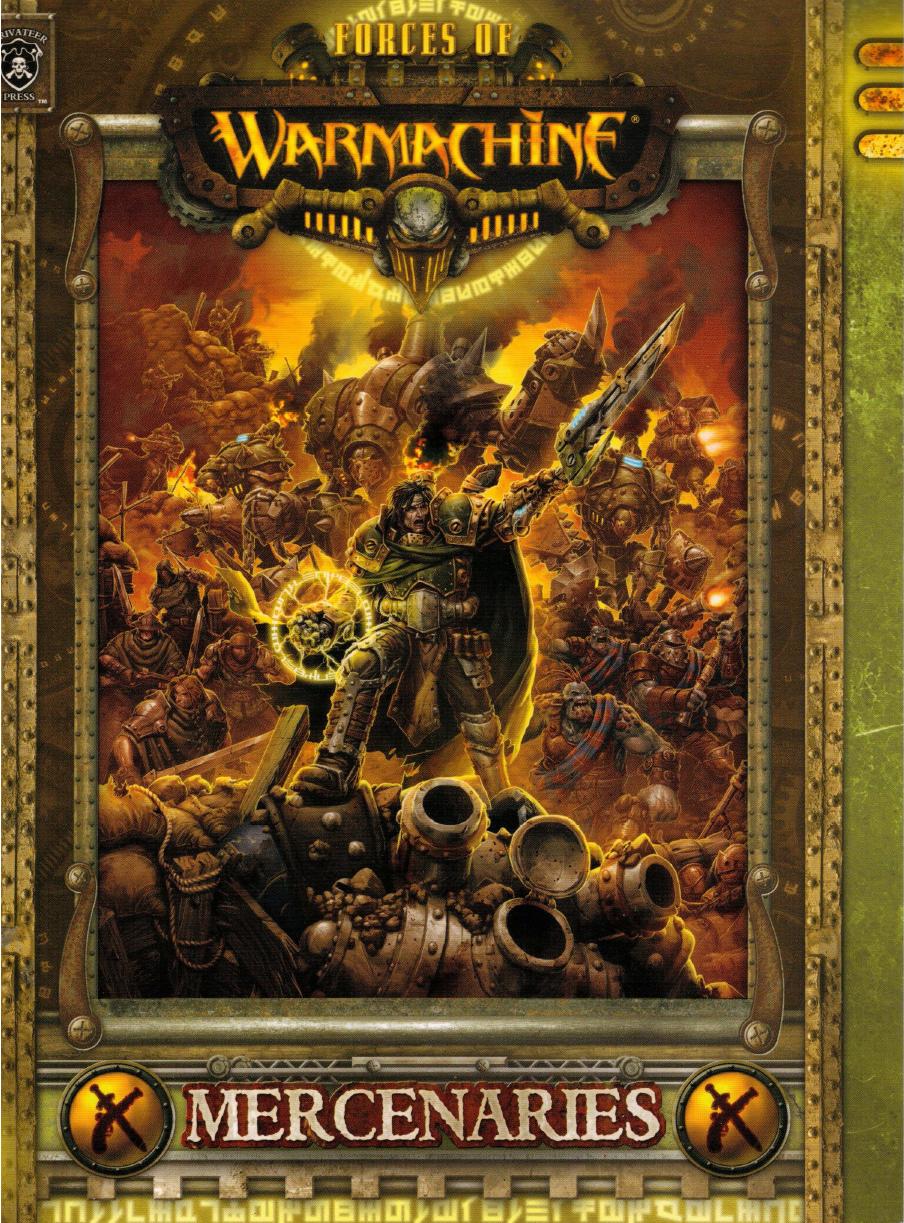
Mercenary is one of the most lucrative jobs in Immoren if you can handle it. They let generals have plausible deniability, bolster armies and bring in tactics that an army might lack. Most fight for coin, but they have many motives. Asheth Magnus has a complex agenda, an ogrun bokor fights for honor, Jarok Croe for greed. Those that have enough resources to combine with each other into small armies are often a match for any force. Of these, the most well known are the Four Star Syndicate, the Llaelese rebels of the Highborn Covenant, the pirates of the Talion Charter and the Rhulic Searforge Commission. Mercenaries are flexible forces, with very different styles.
The
Four Star Syndicate
is a criminal enterprise, notorious even among pirates. They act brazenly and openly in their warjack-supported attacks, stealing from railyards, small fleets or even supply trains, then selling the goods on the black market. Few know much about their inner workings, but it's believed that the high captains that rule Five Fingers influence what contracts the Syndicate accepts and make use of its battles. Syndicate loyalty is bought with gold and iron, and anyone who hires out of Five Fingers will likely work for them eventually. The Syndicate pay well, but the jobs can be dirty. Four Star Syndicate armies can be made of any merc that works for Cryx or Khador, and may also include Captain Sam MacHorne and the Devil Dogs or Rhuper Carvolo.
The
Highborn Covenant
is the most coherent effort of the Llaelese nobles in rebelling against Khador. They have a formidable army, though one more interested in coin than ideals. Their goal is lofty, if unlikely, and it gives the nobles in exile some legitimacy - without the army, their claims to rank would be tenuous at best. Most mercenaries working for them hire out for six to eight month tours, with extensions offered to reliable and trustworthy mercs. As time has passed with no signs of retaking Llael, they've been getting less selective. They will hire on any merc that works for Cygnar, and can also include a single Arcane Tempest Gun Mage or Long Gunner unit, which counts as mercenary rather than Cygnaran.
The
Searforge Commission
is an alliance operated by Clan Searforge of Rhul to keep track of the southern struggles and ensure trade remains open. They lead the trade alliance for weapons, alloys, and 'jack parts, and while the Commission benefits them the most, they've also taken work that helps other mercantile clans. They coordinate mercenaries to escort trade shipments in hostile territory, and they are more than willing to fight to protect Rhulic interests. Searforge armies can include any mercenary Rhulic or Ogrun units.
The
Talion
Charter
was originally just the terms of employment aboard the ship Talion, a pirate crew. It's been expanded to serve as a rallying point for all kinds of pirates, privateers and freebooters, including some notable warcasters for hire, such as Phinneus Shae of the Talion, Broadsides Bart Montador of the Calamitas or the sorceress Fiona the Black. They've proven able to match any mercenary group, land or sea, and have quite reasonable rates. A Talion Charter army can include Phinnaeus Shae, any Privateer units and any mercenary warjacks, but can't include the Commodore Cannon and Crew unless Shae's in your army.

War is so common to the Iron Kingdoms that it's only natural some people have turned it into a trade. Mercenaries are useful to everyone, dating back to the earliest days of the Warlord Era, when the warlords and priest-kings hired them to defend settlements. At the time, most were little more than tribal bands loyal to mercenary chieftain. As things went on, armies replaced levies and both they and the mercenaries became more disciplined and extensive. It is unknown if civilization would have triumphed over the Molgur without mercenaries, and some estimates claim there were more mercenaries than regular soldiers during the period. Certainly it was when many of the rules and charters were established. Mercenary outfits had grown into true companies, with generations of tradition, by the Thousand Cities era.
The Charter, as it would be called, was a set of guidelines that was established governing the use of mercenaries. While it's been modified over the centuries, it has always defined the rules and strictures by which mercenaries can operate. It clarifies how employers are to be treated, how to deal with militaries and prisoners, and also how to treat other mercs. It gives rules on territory, loot, ransom and what counts as rebellion and what orders can be disobeyed. Every company must state allegiance to the Charter to be hired, and those in breach of its rules can suffer legal or even military retaliation, becoming a band of outlaws, often with a lucrative bounty on their heads - and, worse, no employment. Most nations never consider hiring anyone who breaks the Charter, though it does happen occasionally due to corruption or desperation. The Charter is further supplemented by codes or oaths taken by individual mercenaries or companies. Most commonly, they define what jobs the group will take and what they will or won't do.
The Orgoth disrupted life for everyone, and while the mercs didn't die out, war profiteering mostly did. The Orgoth had no interest in hiring them and most never asked for pay when working for the resistance. The few bands that survived this era mostly served as paid watchmen for remote settlements. When the Orgoth were finally driven out, though, it all started again. The Corvis Treaties were barely signed before battles began anew, and the chaos and well-armed populace was fertile ground for mercenaries, so the Charter was renewed. Hundreds of companies were founded in those days, and the modern mercenary was born. Some of those original companies even still survive.
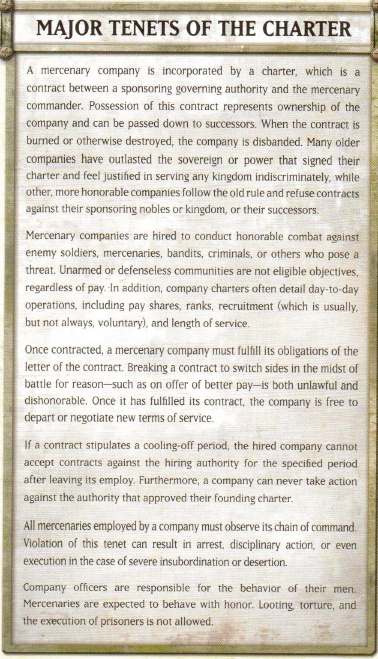
Some nations have long relationships with specific companies, such that they're practically part of the standing armies. They're on payroll and are considered strategic assets. Sometimes, their contracts extend into perpetuity, renewed decade after decade. Typically, they get paid better and better lodgings than regular soldiers, which can cause tension. Most companies, however, have become adept at interpreting the letter of their charters to suit their needs, learning contract negotiation and trade law. Less legitimate groups often have vague or incomplete charters, or even no charter at all. This is risky, of course, ensuring your clients are desperate, tyrants or secretive. Despite sanctions, there are still mercenaries who do not follow the Charter's codes. They are often already wanted criminals, and are little more than organized bandits most of the time. Respected companies often view them with disdain, but you need some tolerance for them if hired by the same employer.
A company that violates its own charter or acts without one can be fined, disbanded or even declared an uprising and hunted down. When a charter is revoked, it is ceremonially burned by an agent of the sponsoring state, and the company can be arrested and brough up on charges. In past ages, some rulers used these tactics to get out of paying, particularly in pre-Vanar Khador. Some companies still won't work for Khadorans for any promise, as they remain skeptical it'll get paid. Most companies are small, usually led by a single veteran commander, potent fighter or rich backer. They usually have less than 30 members, and qualit of life can vary considerably based on their leadership, reputation and clientele as well as the stability of the area.
It takes a special kind of person to become a mercenary. It can be easy to sign on in some cases, or require a series of rigorous tests, especially for the more successful companies. Arcane talents are a free pass into just about anywhere, of course. Most companies also spend a lot of time in the field and will hire on anyone who can cook or has wilderness skills. Many companies are just people looking for money, using whatever weapons they brought with them or could scavenge. Better funded companies can actually equip their soldiers uniformly, but most small companies require you handle your own arms and armor. Unsuccessful companies can go into a financial death spiral if they can't get paid, making them unable to afford to even repair their own weapons.
Next time: Merc merc merc merc
Forces of Warmachine: Mercenaries
Original SA post Forces of Warmachine: MercenariesThe more respectable companies tend to be extremely professional, either large enough to field a small army or specialized in a specific type of combat. They are in high demand, especially in early spring, the traditional season for new campaigns. Specialists exist for pretty much any type of modern combat, but they usually charge higher rates for their equipment and expertise. The best-equipped companies even have their own warjacks as force multipliers, and any merc that can afford to buy and maintain one is always in demand. Warcasters are rare, but 'jack marshals aren't, and most veteran mercenaries learn the basics of commanding 'jacks.
Not all mercenaries join companies. Many start as lone guns, though only the best rise to prominence this way. Staying independent takes skill, and those without it die or get recruited into larger groups. In general, solo life is short and dangerous, and joining a company means better pay and longer life...with a few notable exceptions. Warcasters, alchemists and arcanists of all types are in high demand no matter what. Independents are often viewed with disdain by larger companies and national paymasters, though. The companies resent the wages some independents can command, and the clerks prefer the simplicity of large contracts to many small ones, which take longer to draft.
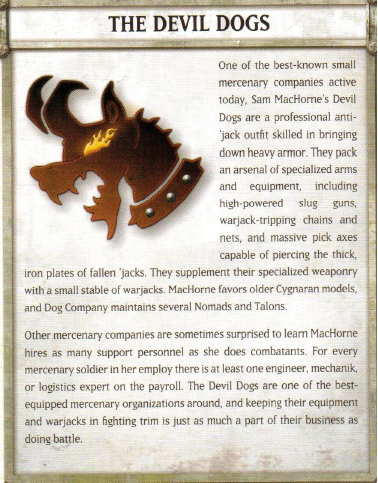
The nations of Immoren look at mercenaries in varying ways. Generally, as an army's strength increases, the role of mercenaries decreases. There's exceptions, usually companies with a long history of cooperation with a specific nation, but most mercenaries are usually hired for specific jobs or to shore up some neglected part of the military's skills. Khador and Cygnar are the largest employers, and Cygnar has come to increasingly rely on mercenaries as their many fronts stretch them thin. Indeed, large companies sometimes fortify entire garrisons on the borders. This is not sitting well with the general staff or King Leto, but they have few alternatives. Cygnar will mostly hire respected companies and specialists. High Kommand loathes mercenaries and doesn't hide it, but Khador is pragmatic and still uses them widely. The Khadoran reputation for reliable pay is rising even as Cygnar's is falling. They prefer Khador-born mercs, since they're certainly veterans of the Winter Guard, or large organizations with their own trainers. The merchant princes of Khador also keep contact with some less reputable assassins-for-hire that'll work for the army. Their loyalty is questionable, but their effectiveness isn't. Khador also hires outlaws if they're cheap or have a grudge.
Many mercenaries base themselves out of Ord. King Baird Cathor II, the Bandit King, is notoriously laissez-faire about them, and they're well-positioned to go to Cygnar or Khador. The Ordic port of Five Fingers is another draw - it's corrupt as hell, and there's always work there. You can even find ships bound for Cryx, if you're desperate or insane. While Ord tries to stay out of war, Baird is no fool. He favors Cygnar over expansionist Khador but also relies on Khadoran trade, and he's more than willing to use mercenaries to interfere with his neighbors' battles. Ord lacks the wealth to do this on a large scale, but it will sometimes aid Cygnar via mercenary hiring. Plus, because of the extensive Ordic spy networks, they can often blackmail or find a bargain.
Cryx regularly hires assassins and mercenaries, sometimes openly and sometimes not. Often, mercenaries are used to keep people from realizing Cryx is doing something - everyone knows who necromechanikal thralls work for, but a mercenary force could be serving anyone. Many mercs, of course, will not hire out to Cryx for any price. Few are interested in working for undead genocidal tyrants. Only the most desperate will sign on with Cryxian forces, but when hiring entire mercenary armies, Cryx is quite good at concealing who's doing the hiring.
The Protectorate absolutely despises mercenaries, and unbelievers entering their borders are likely to be arrested or killed. Plus, their country isn't exactly known for its pleasant hospitalities or even good alcohol. Still, they know they're outnumbered and will sometimes hire outsiders, particularly for the Northern Crusade, so far from home. They are annoying, but will follow any signed deal to the letter and always pay. On the other hand, they will also blatantly allow you to take the brunt of the enemy in fights, so factor that into your negotiations.
Mercenaries also often work for private employers. Private armies are forbidden pretty much everywhere, but it's not as rare as governments would like. Some nobles and wealthy organizations use legal loopholes on the grounds of protecting their assets, and in practice, anyone with the coin and a grudge can hire an army. This makes governments uneasy, so you want to keep that hidden unless you have a legitimate, recognized purpose, which makes logistics a bit tricky. Large private armies are rare, but when they do show up, they are a big problem for their targets.
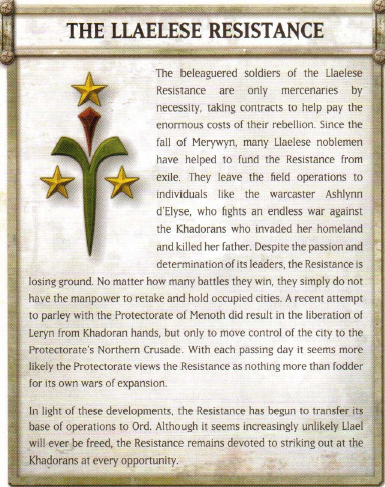
There is no mercenary company in Immoren that's larger or more profitable than the Steelheads, which have chapters across the continent. They were founded in Berck 200 years ago by Ordic veterans, with the idea that an organized and professional military force would be in higher demand than an unreliable free company. Within a few years they became a small, cattered army focused on combined arms. They were, indeed, in demand, with the flexibility and discipline to face anything. They founded chapter houses in Caspia, Korsk, Merywyn and Corvis. Their chapter house in Blackwater is controversial, but Cryx honors its contracts and pays well. Their success has been immense, and where other mercenaries might have cooling off periods, the Steelheads just assign new chapters to a job. They now have chapter houses in almost every major city plus some more obscure areas. They sometimes end up fighting each other, but they're okay with that. In fact, many chapters have rivalries that, while good-natured in peacetime, can turn bloody. The Founding House in Berck oversees all chapters, but as long as a chapter pays its dues and upholds the company reputation, they can do as they like. This lets the Steelheads evade certain laws that would otherwise hinder their size.
All you need to be a chapter master is coin and the permission of the Berck trustees. convince them your location's profitable and you're golden. Then you get made a captain and given a line of credit to outfit your company with arms and armor, which the Steelheads will happily sell you in bulk at a discount. You must keep your books in order and pay the Founding House 20% of annual profits. If you grow big enough to have more than one captain, the trustees promote the most senior captain to commander. Steelhead training and doctrine is all in their slim handbook, which defines all aspects of Steelhead life and tactics. All officers must read it, and while Cygnar and Khador find it antiquated, it's been influential on mercenary captains for generations. Some chapter masters, like Stannis Brocker of Ternon Crag, prefer to take to the field, but often captains spend more time dealing with logistics than combat, leaving the fighting to their lieutenants, who are always veterans. They command the sergeants that lead the Steelhead platoons. The rank and file are more comfortable than most soldiers and certainly most mercs, but pay is a bit variable. While a chapter's active, they can expect around 1.5 times the average pay of a Khadoran or Cygnaran soldier, with less time in battle. In lean times, they may be let go or put to off-duty stipend - a mere third of their normal pay. Still, work's usually plentiful these days, and the Steelheads can afford to be choosy. Prospective Steelheads must pass a rigorous series of combat trials and prove they're able to take orders respectfully. Many mercenaries aren't good at that. Those that pass get stable, respected careers.
The Four Star Syndicate operates out of Five Fingers, controlled by the city's four crime lords, the High Captains. It's an open secret, but they don't acknowledge their control of the Syndicate publicly, thus letting them hire mercenaries that'd avoid working for the High Captains. They profit from basically any conflict in western Immoren. On top of their own operations, they'll stake and lend to smaller mercenaries, and many companies pay them a percentage. Further, they hire on a lot of mercenaries short term. Almost all of the best have worked for them at one point or other, even Asheth Magnus. However, the Syndicate's not always a well-oiled machine. The High Captains see the wars of Immoren as a place to profit, and their schemes often clash. It's not uncommon for them to hire mercenaries to compete with each other, as the upper officers aren't always fully aware of the actions of the others. This can lead to them acting in self-defeating ways. All four High Captains value the Syndicate, though, so they can usually find a way forward. Most of their work is purely for profit in the short term, but occasionally they work for long-term rewards in politics. They've occasionally supported one nation or another, but always for mercantile or economic reasons.
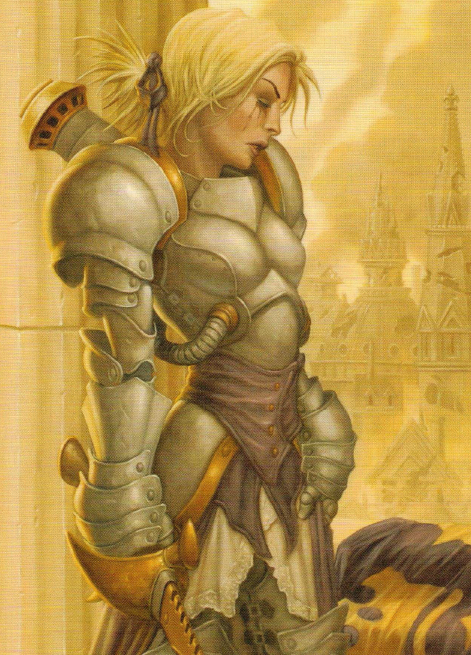
Ashlynn d'Elyse is the only daughter of master duelist Benoir d'Elyse, formerly of the Royal High Guard of Llael. Shje will work for Cygnar or the Protectorate of Menoth. she grew up in training academies, and by 15 had beaten some of Llael's top swordsmen. Her skill and arcane talent earned her a place at the Royal Arcane Academy, where she was top of her class, and she became one of Llael's few warcasters. she found her early work tedious at best, seeking out danger wherever she could, and soon became a renowned duelist. When Khador invaded, she fought at the front, unleashing her full power at last. Her father's execution after the fall of Merywyn has only hardened her already ruthless heart, giving her a new perspective on war. Ashlynn uses her formidable magical power to bolster her sword skills, unleashing a storm of attacks against anyone unlucky enough to get close, and she's no slouch when it comes to movement. Since the Llaelese occupation, she has been freelancing to fund her war on Khador. She doesn't like the Protectorate and she blames Cygnar's withdrawal for the fall of Llael, but she'll take their gold, which she uses to fund her rebels. She is vengeful and independent in her battles, seeking to not only repel the invading Khadorans but also to one day kill the men she blames for her father's death - most notably, Gurvaldt Irusk and the traitor Prime Minister Glabryn. Her gimmick is movement, her feat lets her allies roll three dice and pick the best one.
Next time: Kill bitches, get paid
Forces of Warmachine: Mercenaries
Original SA post Forces of Warmachine: Mercenaries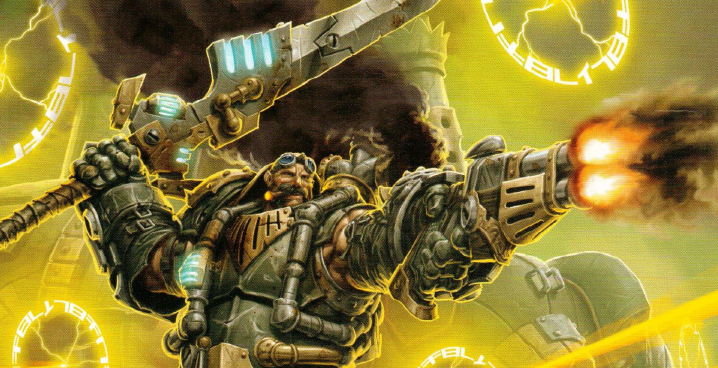
Drake MacBain is a simple man, with a simple desire: money. He'll work for Cryx, Cygnar, Khador or the Protectorate of Menoth. He's fought more battles than he can count, working for anyone who can pay. He's straightforward, and his strict adherence to the mercenary code has made him one of the top mercenary warcasters. His parents died when he was young, and it wasn't long before he fell in with mercs. One day, he watched the company's Mule and was surprised to see it respond. His band's mechaniks recognized his talents and began to teach him what they knew of managing warjacks. His magic is mostly self-taught, learned by doing. His warjacks have seen many battles, most decades old even before he bought them. He refuses to scrap any but the most unrecoverable 'jack, and while his employers may shake their heads at his patchwork weapons, he directs them well. He is a shrewd and pragmatic man, willing to do whatever it takes to win, making do with whatever he has on hand. He's strict about contracts and never betrays one, delivering on whatever he promises to do, to the letter. He can pick his jobs, given his popularity, and he loves his work. His resilience and determination are legendary, and he's survived scrapes he has no business even being near. Survival against all odds is part of why he commands such a huge fee. He always gets the job done. His gimmick is buffs and his feat prevents the deaths of a handful of nearby allies when they would otherwise normally die.
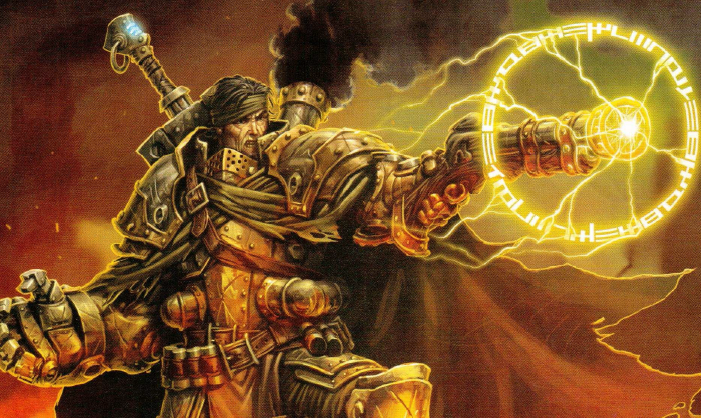
Asheth Magnus, better known as Magnus the Traitor , will work for Cryx, Khador or the Protectorate of Menoth. He hates Cygnar, waging a personal war on them and financing his vengeance with mercenary coin. Years ago, he served as commander under Vinter Raelthorne IV, revered for his skill and ferocity. Magnus sacrificed troops to win, but Vinter never cared. Life was cheap, after all, and warjacks weren't. His unquestioning loyalty earned him great luxuries, but he was always resolute. What he calls patriotism, however, others name lust for power. He was lowborn, after all, with no hope of official position, save by military means. After Leto's usurpation, Magnus refused amnesty, leading loyal remnants of the Royal Knights in a guerilla war on Cygnar, using the battles as a cover for his true agenda. Leto's mercy, to Magnus, is his greatest weakness, and he spared Vinter's life. Magnus seeks one thing only: to restore the true king. Over the years, he worked to build a path for his liege's return, using criminal ties to get weapons and military technology to the enemies of Cygnar, destabilizing Leto's kingdom. He would raze the nation to the ground and let Vinter rebuild it from the ashes. However, he may have underestimated Leto's courage, or perhaps that of Coleman Stryker, who crippled Magnus. Despite his best efforts, Leto remains on the throne. Magnus' resolve remains undiminished, however. Vinter will rise again. His gimmick is buffs and his feat lets his 'jacks move a second time in a turn.
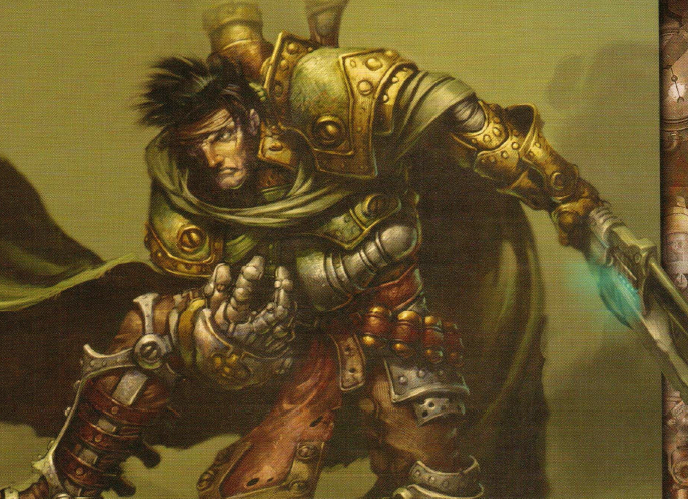
Magnus the Warlord is Epic Magnus. He will work for Cryx, Khador or the Protectorate, and can be fielded as a full member of the Skorne if the army is large enough to have two warlocks. For years, Magnus worked to restore Vinter to the Cygnaran throne. He led countless plots, embraced exile, endured being hunted, murdered anyone in his way. Despite all that, Vinter questioned his loyalties, sending a master torturer of the skorne to cut the truth from him. Magnus is proud that even Master Tormentor Morghoul could not break him. This revealed the true agenda of Vinter Raelthorne, sending ripples through the Skorne Empire and turning Makeda against Vinter. Magnus knows, though, that Vinter is not defeated. He works with a terrible energy, devoted to his purpose entirely. That purpose is simple: survival and revenge. He knows all of Cygnar's secrets, and he is preparing for Vinter's return. Soon, all of his enemies will die. Few would understand it, but part of Magnus is loyal to Cygnar, to what he sees as its strength. He believes Leto is a usurper who broke the destiny of Cygnar when he overthrew his brother, and only blood can restore it. He is determined to be on the winning side, eager to see a restored Cygnar utterly destroy the Protectorate of Menoth and set fire to Khador and Cryx. He hates those he serves, but their money gives him power, and he spreads that power well.
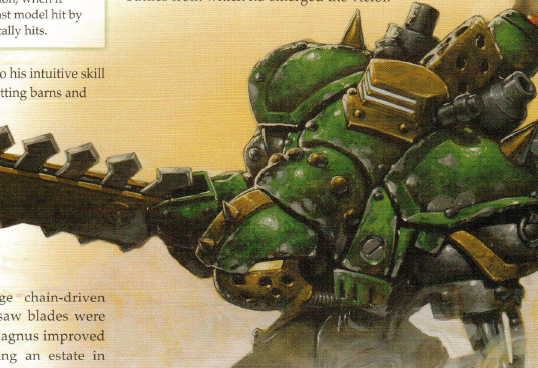
The Renegade is over 8 and a half feet tall and nearly 4 tons. It is designed by Asheth Magnus based on an old Cygnaran chassis, now decommissioned. It exemplifies his approach to war: relentless aggression and total commitment. It's armed with a shredder scrapsaw, and the first Renegade's weapon was made from scrap iron, but Magnus has improved them with each iteration after seizing an estate in Ternon Crag, which he uses as a private warjack fabrication facility. The shredder can tear open anything, and it's aided by the obliterator rocket, which tosses troops around easily. The rockets are expensive, but useful. The real triumph, however, is the Renegade's arc node. Arc nodes are notoriously fragile, complex and expensive, but Magnus is excellent at salvaging and repairing the things. With access to proper tools, he can even make replacement nodes from scratch, but at present all his Renegades use parts salvaged from wrecks after his victories. Naturally, only armied with Magnus in them can field them.
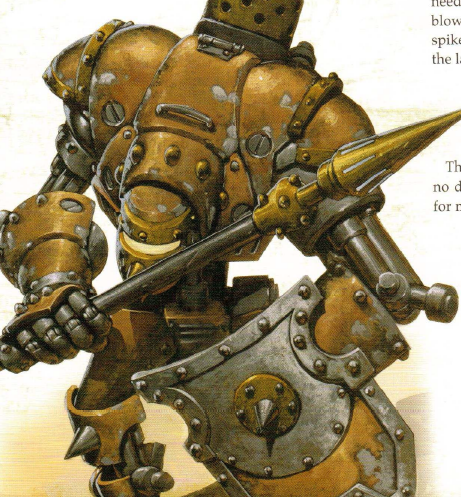
The Talon is 9 feet tall and almost 3 and a half tons. It was originally a Cygnaran design, but is commonly seen now in salvage yards and black markets, following its decommissioning in favor of the Charger. It's still a mercenary favorite, relying on a technique known as 'stalling' to stun warjacks. It uses its stun lance to send conflicting signals to the cortex, causing the enemy 'jack to falter, making quick movements impossible. It'll be corrected shortly, but sometimes a few moments is all you need for a critical blow from the lance or the spike shield it carries. Newer, more advanced 'jacks are in production across Immoren, but those without government money must use what's available. While expensive, the Talon will remain a part of mercenary forces for years to come.
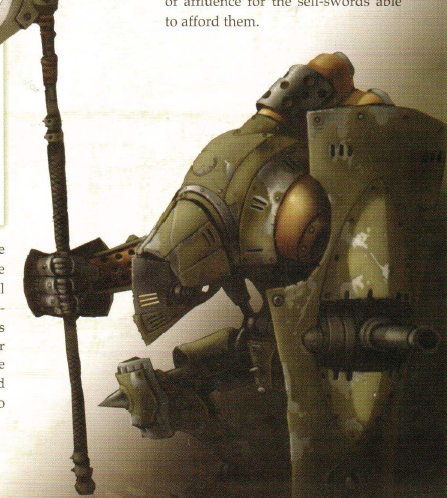
The Vanguard , at almost 9 feet tall and almost 4 tons, is one of the few Llaelese-designed warjacks. It was made as both weapon and bodyguard by the Order of the Golden Crucible, wielding a giant guisarme and a large-caliber cannon built into its tower shield. It can keep up with even fast warcasters, too. Only a few of them escaped the invasion intact, and mercenaries who get one consider them well worth the high cost. Repairing them isn't easy, and they are a sign of wealth amogn the sellswords that use them.
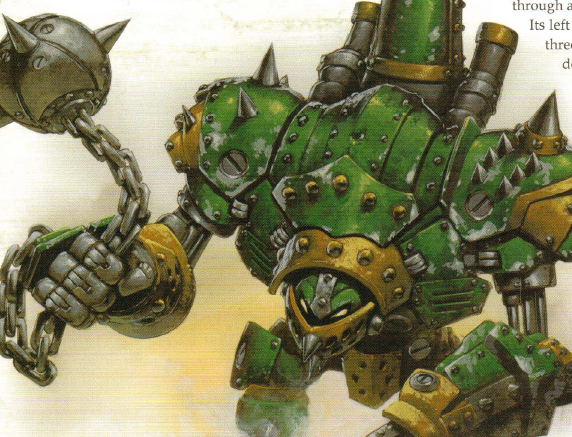
The Mangler is 12 feet tall and 8 tons. It was originally designed by Asheth Magnus, but it's quickly become a popular heavy chassis among mercenaries. Even the originals, built of flawed materials, show an adaptive genius in their design, built from Magnus' experience in Cygnar. It uses parts stolen from laborjacks or outdated warjacks, but it's not weak or old. It wields a massive iron ball on a wrecker chain, often stolen from a ship anchor or drawbridge. the left knuckles are spiked as well. Magnus designed the Manglers for labor and supply travel, so the spike does not impair the ability to use its hand, either. Many mercenary mechaniks have stolen the design, and a lot of companies now include a heavy warjack with a wrecking ball, spike and the title 'Mangler.'
Next time: Steelheads
Forces of Warmachine: Mercenaries
Original SA post Forces of Warmachine: Mercenaries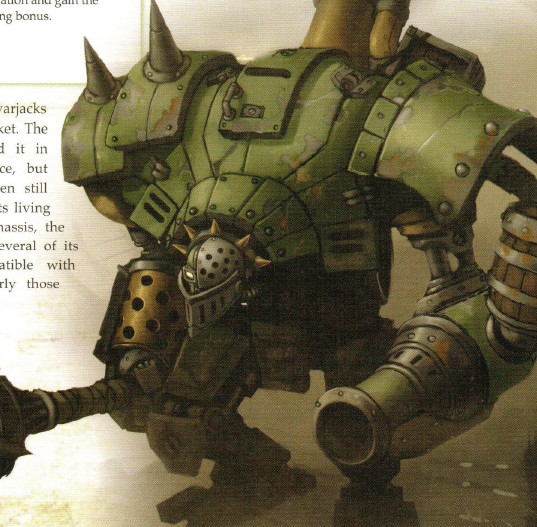
The Mule is just over 12 feet and almost 8 and a half tons. It's one of the most prized warjacks on the market, decommissioned from active Cygnar service in 582 AR after 123 years of use. Mercenaries across Immoren still find it useful. It's built on the Nomad chassis and very cheap to maintain, as most of its components work with many warjacks, particularly those made by Engines East, and can be readily salvaged. It does take constant maintenance, though, especially around the piping and steam engine. The real genius of it is the steam-driven cannon, or steam lobber, which uses boiler pressure to hurl explosives at the enemy. A cutoff valve between the motive system and lobber allows the Mule to route the full boiler yield into the cannon to maximize range, too.
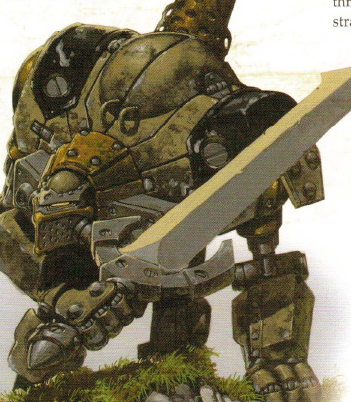
The Nomad is over 12 feet and 7 and a half tons. It's one of the earliest warjacks made in the arms race between Cygnar and Khador, and its one job is ripping armor open. The battle blade is based on that used by the Cygnaran Sword Knights, and it served well for around a century under Cygnaran banners, particularly against Cryx. It was one of the first chassis designs made in bulk, but over time, the Cygnaran army began to favor multi-role 'jacks. When the Nomad was decommissioned in 503, many mechaniks mourned the loss of such a practical and repairable warjack. It's simple but effective - iron on a reinforced frame, with a small buckler attached to one hand and a big sword. The free use of the buckler hand is especially important to mercenaries, who often rely on their 'jacks for labor as well as battle. The Nomad is now a mainstay of warrior bands throughout Immoren due to its reliability and easy mainteance. It's older than anyone still alive now, but shows no sign of true retirement.
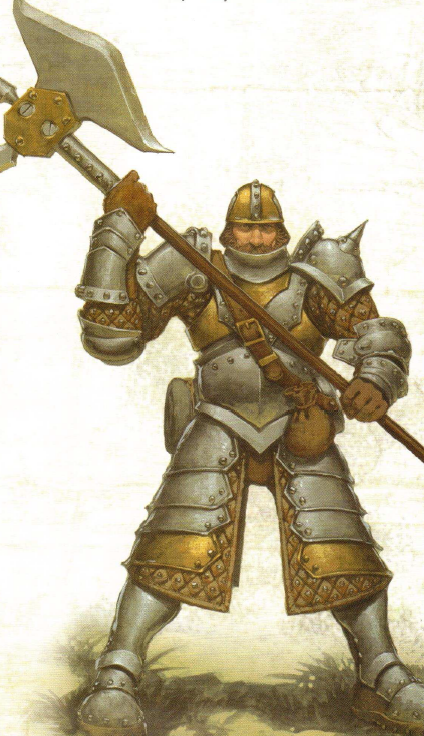
Steelhead Halberdiers will work for Cryx, Cygnar, Khador or the Protectorate of Menoth. They are serious soldiers, recognizable with their Steelhead helmets and badges. The Steelheads are two centuries old and have long understood the value of training and professionalism. The halberdiers are the core of the company, drilled in formations and able to bring down far more sophisticated foes with efficiency. They are disciplined and coordinated, intercepting foes for riflemen or holding an enemy in place for a flanking charge. They use their coordinated strikes to take out small targets, following their founding philosophy: "Ye never need defend against the offender ye have already killed." Against larger foes like 'jacks, they set their halberds to catch the enemy. They are usually deployed in large numbers, and they're happy to risk their lives for coin.
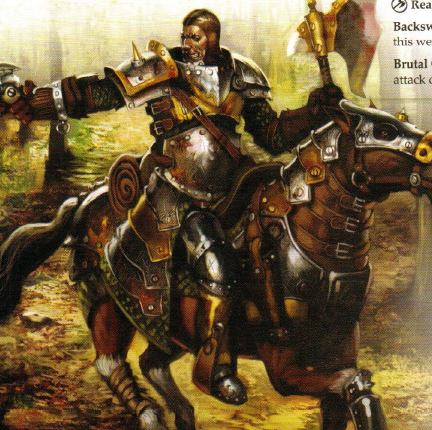
Steelhead Light Cavalry will work for Cryx, Cygnar, Khador or the Protectorate. They are hardened horsemen, fast and reliable. They cost more than the infantry, of course, but their power makes it a bargain. They have a reputation for toughness and risk, killing for coin with no interest in politics. Some accuse them of banditry and looting, but Steelhead officers insist their men are professionals who take no more liberties than any red-blooded soldier in wartime. They have no favored breed of horse, using any steed available and able to be trained. Some use swift, lean horses from Carre Dova in Ord, while others prefer Idrian desert horses or sturdy Midlund breeds. Regardless of mount, they all use cavalry axes and cheap but potent blunderbusses.
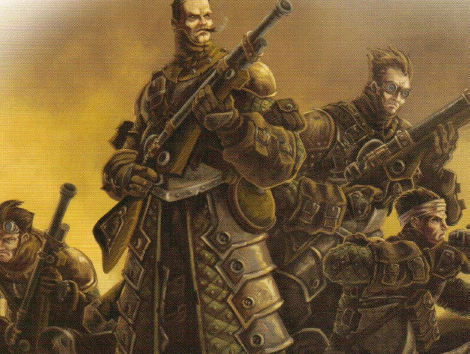
Steelhead Riflemen will work for Cryx, Cygnar, Khador or the Protectorate. They are soldiers able to decimate enemy lines or provide covering fire to keep people in one piece until they hit the foe. Every one of them is a good shot, and in concentrated fire they become truly deadly. Anyone can apply to be a Steelhead, but only those who meet very high standards of professionalism can become riflemen. Many are former soldiers of national armies seeking better pay, travel or variety. They have more than a few ex-long gunners or Winter Guard as well as Ordic militia and Llaelese refugees. Mixed backgrounds occasionally cause rivalries or grudges, but lieutenants and captains are good at ending squabbles and ensuring any brawls take place after the battle, when the cash is already in hand. While their overall quality is high, the units do fill themselves out with a few lowlifes and criminals drawn to mercenary work, often desperate to escape punishment and heading far from their homes. Coin is always the driving factor for them, and the Steelhead quartermasters are financial wizards. Riflemen earn bonuses on ammo conserved, to encourage careful shooting. This rarely leads to problems, but more than one client has remarked on the riflemen making a show of aiming at routed foes but not firing. Their stinginess with ammo also leads to them ruthlessly scavenging from their own dead or unconscious comrades.
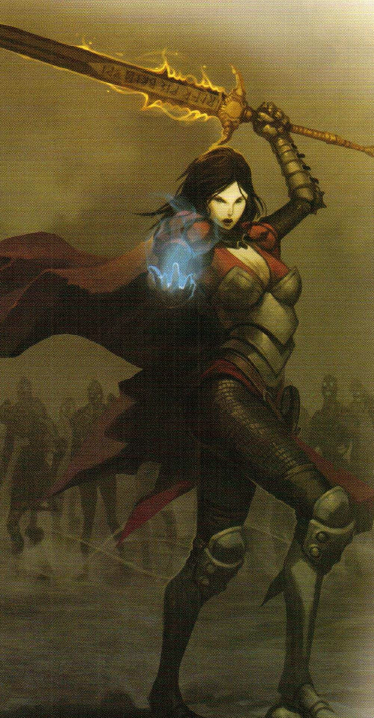
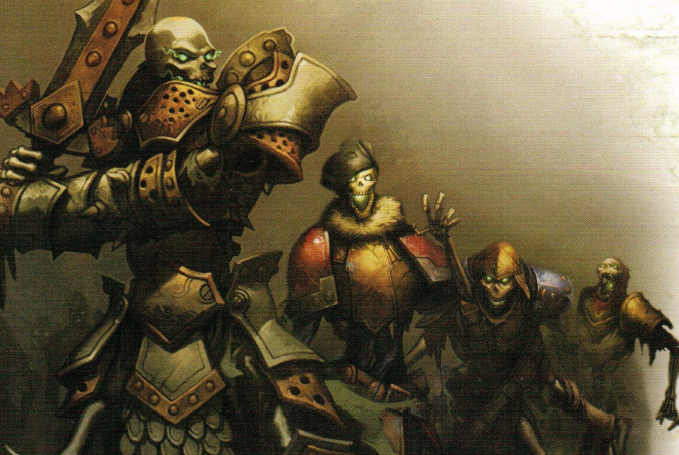
Alexia Ciannor is never without her Thrall Warriors or Risen . She will work for Cygnar or Khador. Few have lived a life so terrifying as she has. Her mother, Lexaria, was beheaded as a witch in the Corvis Witch Trials when she was seven. She was raised by her uncle, a Morrowan priest, but he could not have predicted her power or her need to reconnect with her mother. Her obsession with her mother led her to Witchfire, the sword that destroyed Lexaria's coven and captured their souls. It was once wielded by the head of Vinter IV's Inquisition, and it has been used to both terrify and save the City of Ghosts, first raising the dead against it, then saving it from the skorne. It has been forced sometimes to serve the greater good, but it is a dark and corrupting relic that hungers to slay priests and arcanists. While she was able to play it for years, Alexia is no longer sane. Her first attempts to resurrect her mother resulted in the animation of the coven as corpses, eager to kill. She put them down and returned their souls to the blade, later using a machine of the Cult of Cyriss to extract the souls, becoming their unwilling receptacle in the process. Now, she is haunted by voices only she can hear, and it is perhaps only her mother's spirit that has kept her from being entirely commanded by Witchfire.
Alexia managed to escape the blade's control after Corvis was liberated, when it was seized by the Church of Morrow. High Prelate Dumas sent the blade to the Sancteum, but Alexia raided the caravan, reclaiming the sword and becoming hunted by the Order of Illumination. She turned to mercenary work to survive, avoiding battle-chaplains as much as she can - she doesn't want to hurt people that remind her of her beloved uncle. Many captains or kovniks will hire her despite laws against necromancy so long as her Risen Thralls slay only foes. Alexia seeks to master and transcend death that she might resurrect her mother, and she studies thralls, skarlocks and bonejacks entirely for that understanding. She finds Menite rites fascinating and believes the Testament of Menoth knows the secrets she wants. She plans to force him to break his vow of silence with Witchfire, but has the problem that the Menites hate her as an affront to Menoth's will. The Cryxians also want her dead so they can reclaim Witchfire, which once was buried under Moorcraig. Alexia does not know this and does not care. All but one of the Cryxians that brought it to the mainland are dead, and Kell Bailoch does not speak of his past. Some say Witchfire is an Orgoth weapon, others that it was made by Thamarites to kill Menites and Morrowans and steal their power. Alexia can call on the Risen via Witchfire, animating the dead and binding them to her will. The Risen are weak, but plentiful. Her thralls are rather hardier, born of her unique talent for necromancy. They can follow complex orders and even act on their own initiative, much to the envy of other necromancers. What they do not realize is the price: the voices of the dead coven fill her mind, and she has begun to confuse their will for her own.
Next time: More named people
Forces of Warmachine: Mercenaries
Original SA post Forces of Warmachine: Mercenaries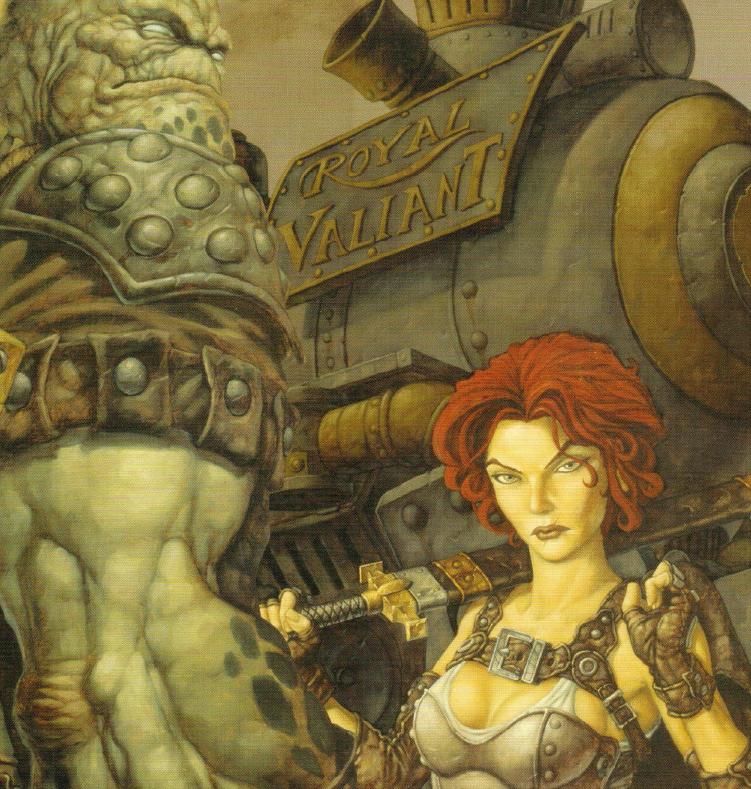
Dannon Blythe and Bull are a perfect team. They'll work for Cygnar, Khador, the Protectorate of Menoth or the Trollbloods. They are professional bounty hunters, tracking down criminals both large and small. War criminals, deserters, fugitives, that's the prey. They've worked together for years, both in cities and on the road. Dead or alive, they get their fugitives. They have a fierce reputation among criminals, relentless in their hunts, willing to cross any border. They'll join armies to take down targets hiding behind uniforms, and their reputation among most commanders means they usually get paid to do it. Blythe and Bull met years ago in Merin, where they worked together to dismantle an outlaw network in the city, with Bull providing the brutality and Blythe the tactical ingenuity. They've worked together ever since, preferring overwhelming force, thanks to Bull's Demolisher cannon. Those too stupid to surrender die in a hail of lead, while the smarter ones get hogtied and dragged home for justice.
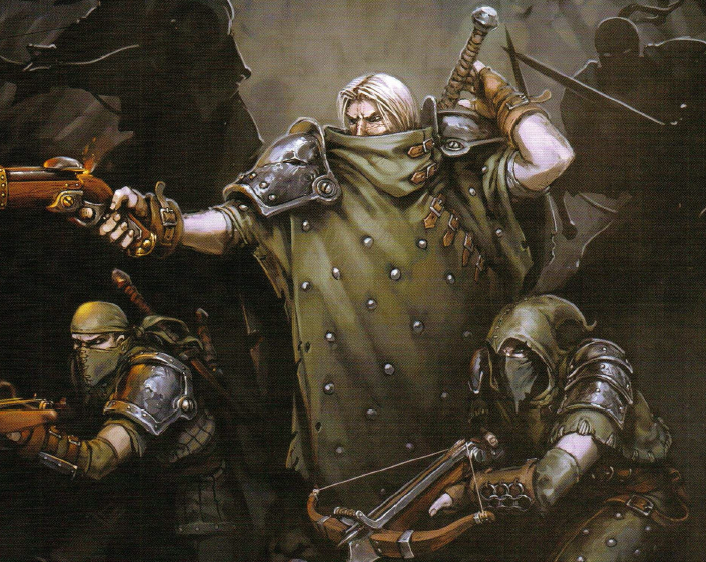
Croe's Cutthroats work under Jarok Croe, who will hire out to Cryx, Khador or the Protectorate of Menoth. They're assassins, but not the lone type - Jarok likes to teach others and have friends. He was born in the Fharin slums, where he learned to fight, then apprenticed under a former Cygnaran pistoleer. Once he mastered the gun, he provoked his teacher into a duel and killed the man, claiming his magic pistol Hiss as a prize. He became an enforcer in the Cygnaran underworld, then went into business for himself, assembling a team of stealthy killers. They use crossbows from cover, then close to slit throats and slip away again. Croe has no respect for law and enjoys tormenting Cygnaran authorities. His death or capture are a high priority for Scout General Rebald, but Croe's headed abroad for a while, making money off the outbreak of war. His team are mercenaries in name only, with no code or charter save obedience to Jarok Croe. Other mercs scorn them, but Croe pays his men well and always fulfills his contracts. He is an unparalleled survivor, blending in and always having an escape route when things get dire. His men always seem to die in his place, and some say he's sold his soul for luck, though never where he can hear them.
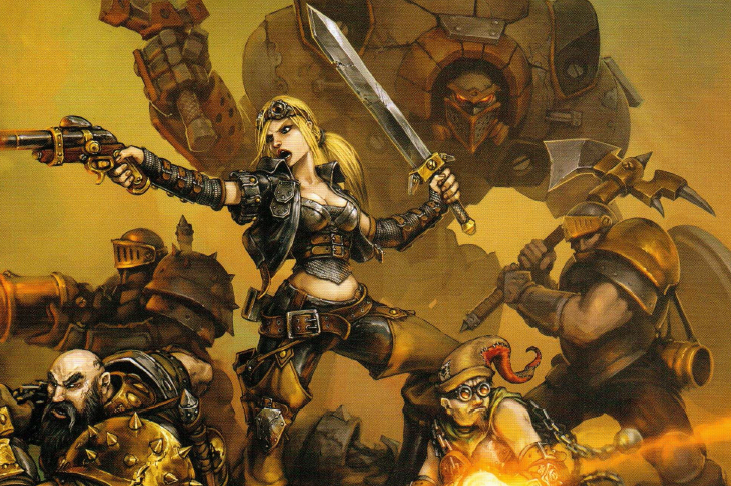
Captain Sam MacHorne and the Devil Dogs are an old-established mercenary company, willing to work for Cygnar or the Protectorate of Menoth. Dog Company, AKA the Devil Dogs, were founded 180 years ago by Grigor Dorenski, former Winter Guard kapitan, and they worked for Khador for a while. However, during the Second Expansion War, they expanded their charter to include a clause forbidding work for Khador, ever. This is because in 464 AR, Kommander Telyev Zerkova hired the Devil Dogs, hoping they'd die absorbing fire. The Dogs succeeded in their mission, however, and she refused to pay them. Dorenski rewrote the company charter in his own blood, swearing they'd never again fight for Khador, even should they be the last nation on Caen. Nearly 150 years later, Dorenski's great-great-nephew lost the company to a Thurian named Samantha MacHorne in a game of dice. She was a former pistoleer and mechanik as well as a gambler, and she saw that with a little discipline and new equipment, the Devil Dogs could be a real prize. they rallied around her, and two years later, she and the newly reforged Dog Company began to hire themselves out as the best professional anti-warjack unit around, using custom anti-armor slug guns, chains and nets to entangle limbs and heavy pick axes to dismantle them.
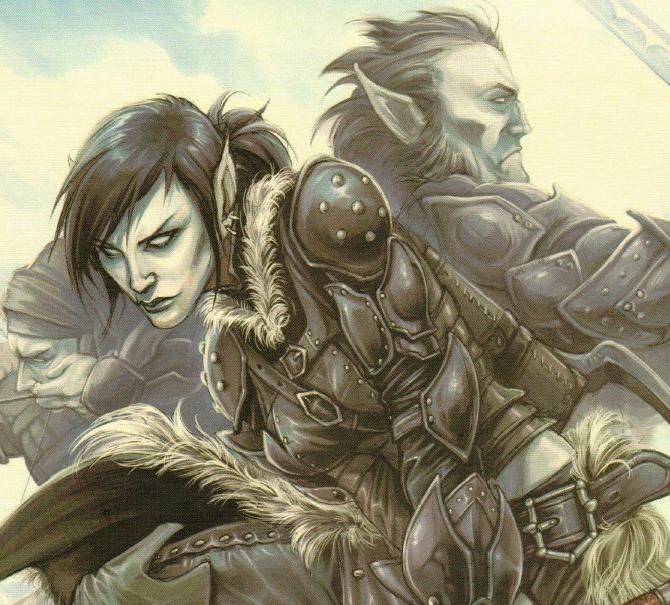
Cylena Raefyll and her Nyss Hunters will work for Cryx, cygnar, Khador, the Retribution of Scyrah, the Circle Orboros or the Trollbloods, but will not work with any army that has even one Blighted unit in it. The Nyss long believed themselves safe from war, until the rise of Everblight. They were broken, but one Nyss group will not give in. Cylena Raefyll leads them in a quest for vengeance, however long it takes. She and her team have become peerless killers and survivors. Their bows can pin down or slay even the fastest foe, and they are equally skilled with the curved Nyss claymore. Their hatred of the blighted is so intense that they will work for even the worst of the worst, allying temporarily with Cryx after being approached by Goreshade. She put aside her hatred to help them as she knew Toruk desired to eat Everblight's athanc, but Goreshade betrayed her. She evaded capture, fleeing to Khador and still willing to hurt Everblight by any means possible. She helped prevent the destruction of Nyssor by warning Eiryss about Goreshade, unwittingly setting into motion the rise of the Retribution of Scyrah. None of this matters to Cylena when compared to her vendetta against Everblight, though, and she'll do anything to destroy the dragon, no matter what the cost.
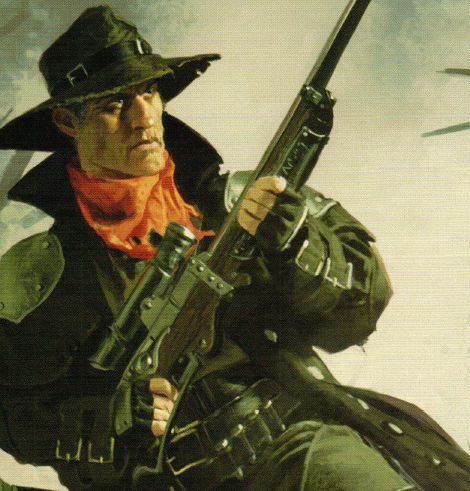
Kell Bailoch will work for Khador or the Protectorate of Menoth. He is a rifleman and former soldier turned assassin. His prices are high, but worth it. He has a forgettable face, which is good in his line of work, and he's done well lately. He's been a wanted criminal since the days of VinteR IV, and King Leto has not changed that. Cryx, as well, has a bounty on his head. As far as he knows, he is the sole survivor of the Ocean's Mistress expedition led by Head Inquisitor Dexter Sirac in 591, which recovered the Witchfire from under Castle Moorcraig in Cryx. It was there that he got his rifle, Silence, which is magically enchanted to make no sound. Even before that, though, he had a colorful past. He began as a Cygnaran rifleman, but he hated military life, as he lacked the stomach for the sycophancy needed to advance. He left the army, joining the now infamous Black Talon mercenaries, one of the few companies in recent memory to be disbanded for their crimes, under Vinter IV - a testament to their bloody atrocities. Some former Black Talons were able to avoid capture by bribes and low profiles, and Bailoch remains in touch with them, getting info and job leads. He's spent a lot of time in Five Fingers and has an ongoing arrangement with the Four Star Syndicate, but rumor is at least one high captain has it in for him after a sniping 'incident.' Bailoch is a master of disguise and stealth, impersonating priests, privateers or officers in the course of his missions. His victims never see him coming, and they only briefly feel surprise before their deaths.
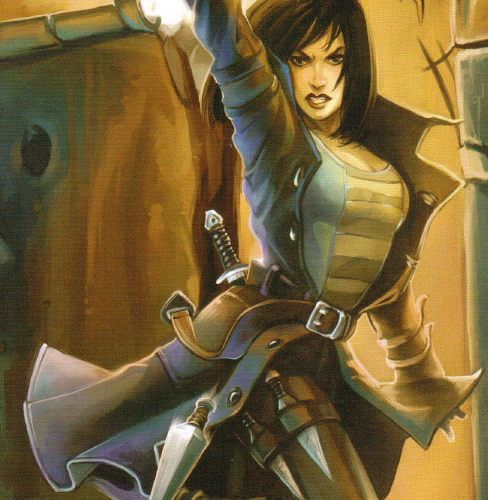
Anastasia di Bray will work for Cygnar or the Protectorate of Menoth. She is a face in the crowd, so good at hiding that she sometimes loses her identity for a time. She was trained as a spy and assassin by one of Llael's many political cabals, and by the time Khador invaded, she was already a veteran. She reunited with her old cabal after the invasion, joining the Resistance in Rhydden and fighting in the siege of Merywyn. She has become a creature of the shadows, able to infiltrate anywhere to steal secrets. Only her Resistance peers understand her, but she feels a burning urge to wipe out the Khadoran invaders and the traitors that help them. She plans to kill Deyar Glabryn and any other who sold out her people, but for now, she runs guns and supplies for the Resistance and organizes urban rebel cells. Her field work has gained the trust of leaders like Ashlynn d'Elyse, who sends Anastasia the most crucial missions. In fact, it was Anastasia who was sent to learn the religious leanings of the Greylords of Leryn, information crucial to the Menite liberation of the city. She silenced sentries that might have raised the alarm in the Menite attack, but since then, the Resistance has grown wary of the Protectorate, and she has been gathering intelligence on them. What she's learned is disconcerting, but she remains determined to throw off the Khadoran yoke, no matter how long it takes or how many she has to kill.
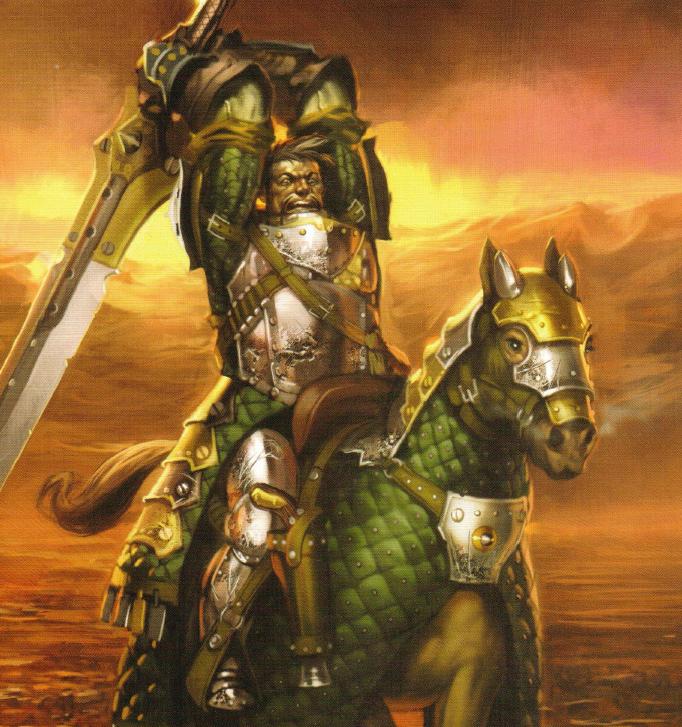
Stannis Brocker, Steelhead Commander of Ternon Crag will work for Cryx, Cygnar, Khador or the Protectorate of Menoth. He loves battle and war, and he's spent decades mastering them. He views chaos as the herald of good business and feels naked out of armor. He has no idea and doesn't care to learn how to live without bruises or battle. He doesn't care why he fights - just who he has to kill. He is the ideal mercenary, apolitical and amoral. He's outlasted most of his friends, and only recently has he begun to show his age. He founds his old battle aches are easily fixed with ale, gambling and cheap women, though. He's spent 20 years fighting with the Steelheads, and he's become immortal in their stories. He doesn't plan to retire, preferring to die in battle. He makes no excuses - he's opportunist, expects to be paid well and was brought to Ternon Crag by a contract with Asheth Magnus. Most consider Ternon Crag barely civilized, but it suits Brocker. He's turned the once insignificant chapterhouse into a notable and rising star, keeping his men busy in Llael and the Thornwood, though things got dicey when the Crag was briefly occupied by the skorne. Since they left, though, Brocker and his men have regained their influence and he likes being outside national borders. He is the undisputed tyrant of the local Steelheads, feared but not always loved. He is unyielding if realistic, and his employers appreciate his ability to turn unruly mercs into an army. His sizable halberdier and cavalry forces make the Cygnaran border guard uneasy, and the sight of Brocker atop his horse, Gorbrute, and wielding the greatsword Thrasher is an image few forget.
Next time: The pipe, the pipes are calling
Forces of Warmachine: Mercenaries
Original SA post Forces of Warmachine: Mercenaries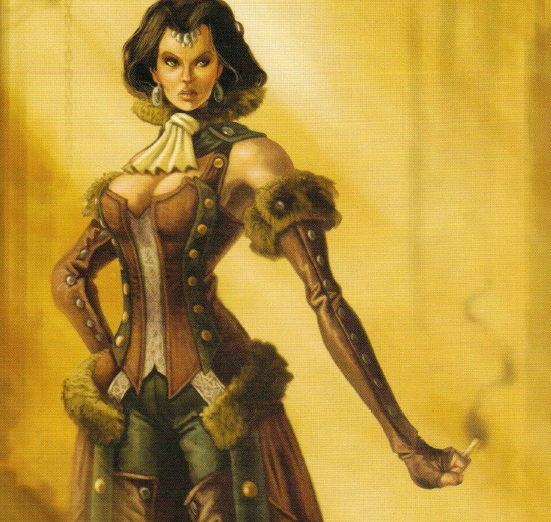
Madelyn Corbeau, Ordic Courtesan will work for Cygnar, Cryx, Khador, the Protectorate of Menoth or the Retribution of Scyrah. The Ordic court is famous for its intrigues and its courtesans, and of all of them, Madelyn Corbeau is the most beautiful, intelligent and dangerous. She was born to an Ordic noble and Llaelese courtesan, spending her childhood between those two nations and receiving the best education a spy could ask for. By the time she was of age she was already an accomplished Ordic intelligence agent, working for the Bandit King Baird. She rose to prominence on her intellect, grace and ruthlessness. She is welcome at all civilized courts, and her rivals hate, fear and envy her. Anyone that moves against her is destroyed socially...or just disappears. She has made a small fortune by selling secrets, and she has turned now to controlling her own destiny. With contacts in every nation, it was easy enough to uproot herself in the guise of a sabbatical to Caspia, and she now sells her services to the highest bidder. Her knowledge of tactics, commanders and armies is growing encyclopedic, and while rumors link her to Ord, the Llaelese Resistance and even the Unseen Hand, both Cygnaran and Khadoran intelligence services believe her to be a true free agent with unknown motives. There is no city in which she has no friends or lovers, and she has infiltrated society everywhere, even in Cryx. She has even hinted at being a guest of the Iosan court, which is no mean feat.
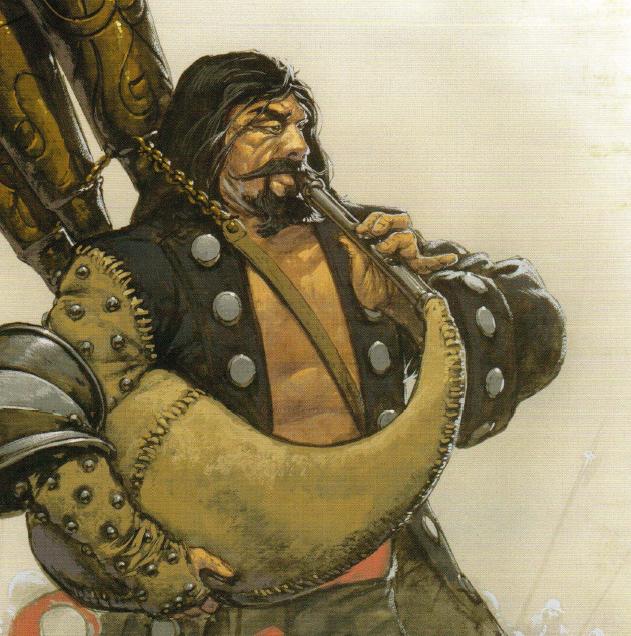
Rhupert Carvolo, Piper of Ord will work for Cygnar or the Protectorate of Menoth. He travels the world in a haze of regret and song, known as the Piper of Sorrows for the loss he's seen. His songs can cause terror, raise spirits or summon mists of dread. To those first meeting him, he seems a road-weary mercenary, solemn and quiet save for when playing his pipes or talking of history, though he's pleasant enough and has a quick wit. In truth, he is caught between worlds, his heart and soul trapped in Urcaen with those he's loved and lost. He is made whole only by music that speaks of his sorrow. Many believe his talent is truly a unique magic, a knack for sorcery fueled by grief and loss. The Menites believe his music is a prayer to the Creator. The men that follow him into battle often lose themselves in his songs, gaining courage not from passion or patriotism but a surrender to mortality. When not fighting, Carvolo can be found in mercenary camps across Immoren, mostly in Cygnar, Ord and the Protectorate. He asks for little but the coin he needs to eat, save for when fighting Khador. Then, he dispenses even of that fee, working only for food and shelter. His hatred for Khador is famous, and his sorrow is probably tied to them. Few men have been present at so many historic events as he, and he has become a respected historian, though he is weary of war. His songs all touch on the theme of men living but briefly before they are killed. He is popular with soldiers, who often ask for nostalgic or sad tunes, and the camps he visits are always somber. He prefers low dirges and laments, and the dead themselves seem to want to comfort him. Nightmares haunt those who hear his songs, as they suffer trying to reconcile the existence of such unimaginable loss and pain.
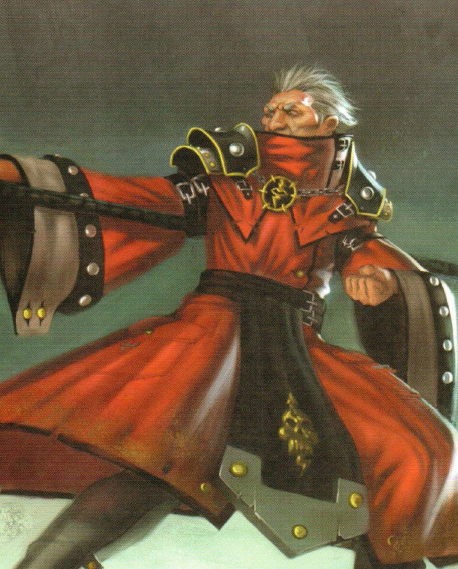
Orin Midwinter, Rogue Inquisitor will work for Cryx, Khador, the Protectorate of Menoth and the Skorne. He is the last of a dying breed, one of the inquisitorial wizards that killed in the name of Vinter IV. He was below only Head Inquisitor Dexter Sirac, and he remembers his time in power well, recalling in detail the interrogations and tortures he carried out. He's rather fond of those days, in fact - the past 13 years of hiding his background and living in squalor have been hard, but he's been biding his time. The Inquisition was originally formed to stop witchcraft and was expanded to all treason. Midwanter made his name hunting sorcerers rather than nobles or traitors, but that worked against him after Leto's coup. His more political comrades found shelter, or died, or begged for mercy from the Morrowans. Midwinter refused to recant, staying hidden and consumed by anger at his lost glory. His squalid life began to take its toll, though, and he picked a disease similar to rip lung which chokes his breath. He expects to die soon, but will no more surrender to disease than to Leto. While he still sees himself as an arcane master, he has been degenerating. No written record of his victims exists, and he guards his anonymity fiercely. Anyone who probes too deep, he kills with magic lightning. His temper has led to him moving around a lot, avoiding the Reconaissance Service, so he's hidden in Ordic ports and the Bloodstone Marches. His paranoia verges on insanity, but his loyalty to Vinter has recently led him to reach out and contact people he believes also support the true king. In their company, he wears his old robes and dreams of a new Inquisition before his death.
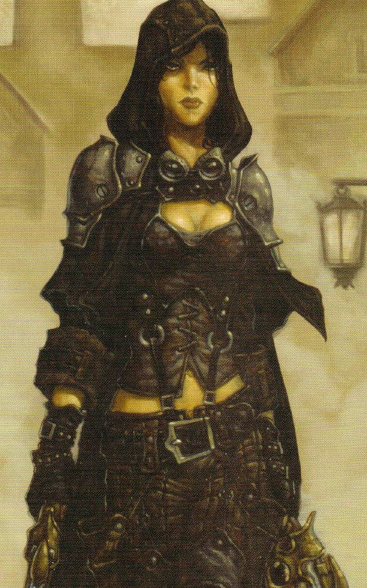
Taryn di la Rovissi, Llaelese Gun Mage will work for Cygnar or the Protectorate of Menoth. Unlike most Llaelese, she believes Llael got what it deserved. She became aware of her magic at a young age, and her fellow orphans never understood her obsession with duelists. She watched the pistoleers regularly, and it wasn't long before one of them waved her over to join them, her magic revealed when she fired her first gun. Henri taught her what he knew, and she became a bodyguard and proxy duelist, as well as going through a string of noble lovers. Henri was a Llaelese army veteran and used to nobles being jerks, but when a duke suggested his intentions towards Taryn were not honorable, he demanded a duel. Taryn watched him get gunned down, and the duke refused her challenge of vengeance. She spent half a year plotting her revenge, but the Khadoran invasion made it all unnecessary. She was cornered with the duke and shot him without a care. She made her way to the army more for survival than patriotism, and she soon realized Llael's military was a hopeless wreck. She decided she didn't want to die for a country that'd crippled itself with ineffective noble officers. She spent time wandering Llael, contracting out with mercenaries, and it was in Leryn that she met Rutger Shaw. She was impressed by his calm when she pointed a gun at him and even more at his readiness in dealing with a Winter Guard patrol that found them seconds later. Taryn has been surprised to find she's falling in love with Rutger as bad luck has been drawing them into one situation after another, between his demeanor and his disdain for the wars around him. She respects him and cares for him more than she ever did for her Llaelese nobles.
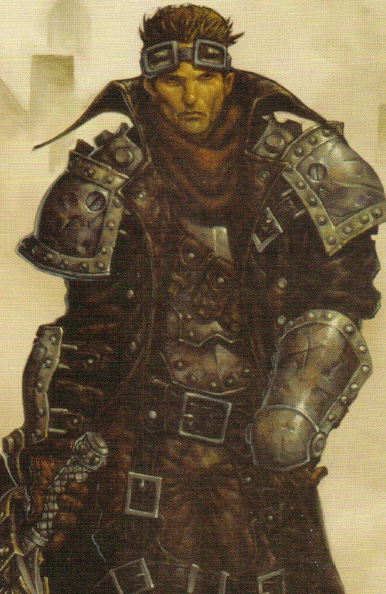
Rutger Shaw, Professional Adventurer will work for Cygnar, Khador or the Protectorate of Menoth. He has been all over Immoren, guided by a love of money and adventure. He might be just another merc, were it not for his conscience, but his best intentions are still tempered by a deep fatalism. An idealistic young Shaw enlisted with the Cygnaran Trenchers, and he adapted well to it, heading to Fellig. By the end of his tour, though, he was a changed man. His experience in war and the deaths around him soured his once bright perspective, coming to see Cygnar as just another employer rather than a home. Offered the chance to re-up as a sergeant, he declined, as his conscience would not let him lead men for a cause he did not believe in. He knew he couldn't go home, either, so he invested in weapons and set off for the middle of nowhere, traveling with bandits, mercenaries and adventurers. He might have been rich long ago, were he not so generous to beggars and veterans. Shortly after the fall of Llael, a refugee alchemist hired him to retrieve documents from Leryn, where he met a woman who calmly pointed a gun at him, then helped him fight the Winter Guard. Shaw was impressed by her grace and purpose, and the two grew more comfortable together, but his respect kept from making advances on Taryn di la Rovissi as he usually might. By the time they got back to the alchemist, they were friends. She shares his lack of interest in national politics, and bad luck and poor timing has forced them to stick together often of late. He feels he's lost the chance to tell Taryn his true feelings of love, instead seeking to impress her with ever more dangerous stunts.
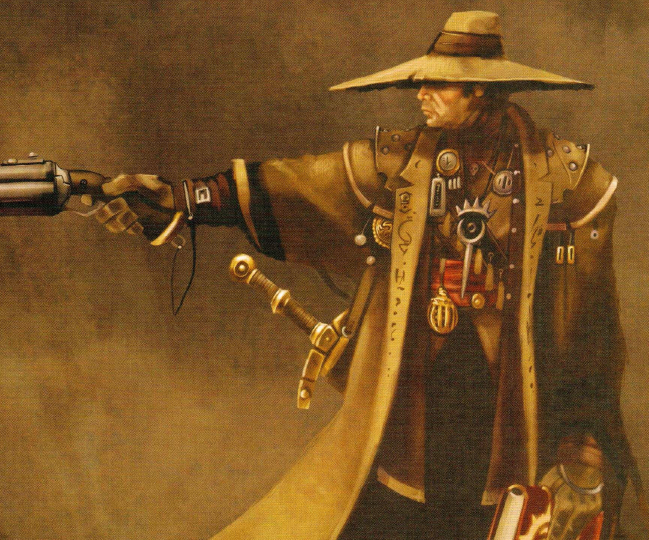
Harlan Versh, Illuminated One will work for Cygnar or Khador, but not for any army containing any Thamarite or Undead units. He is one of the most formidable soldiers of the Order of Illumination, empowered by the Sancteum to hunt down spiritual threats to the Morrowan faith. The order works secretly in Cygnar, Khador and Ord, and Versh has been part of their hidden war for 20 years, cleansing the world of inhuman monsters. He's made a name for himself hunting down Thamarites, Cryxians and necromancers, but lately, his ruthlessness has been drawing fire from his own order. Even as a child, he was a joyless soldier of the faith, working hard for his family and finding peace only in church. He kept to himself, due to his self-righteousness and intolerance of the flaws of others. He wanted to join the church but would not become a priest, seeing them as too passive and accepting of corruption. He came to the attention of the Order when he tracked down and destroyed a Thamarite cabal near his village - he'd killed several nobles, and was sentenced to hang. The local vicarate stepped in to save him, encouraging him to enlist in the Order. He was trained with gun, sword and holy verse against the infernal, becoming an unrelenting hunter. His fervor drove him to act without asking his superiors, though, often acting far in excess of orders. This led to a number of executions without authority, killing alleged witches without the order's blessing. While almost all of them did in fact turn out to be infernalists, the order could not tolerate his rogue behavior and cast him out. Versh continues to serve Morrow on his own terms, using his blessed quad-iron against foes of the faith or those that offend his sensibilities. The order knows he's still working, and they've instructed their people not to interfere. So long as he erases those guilty of black magic, they will not act against him and will protect him from the law.
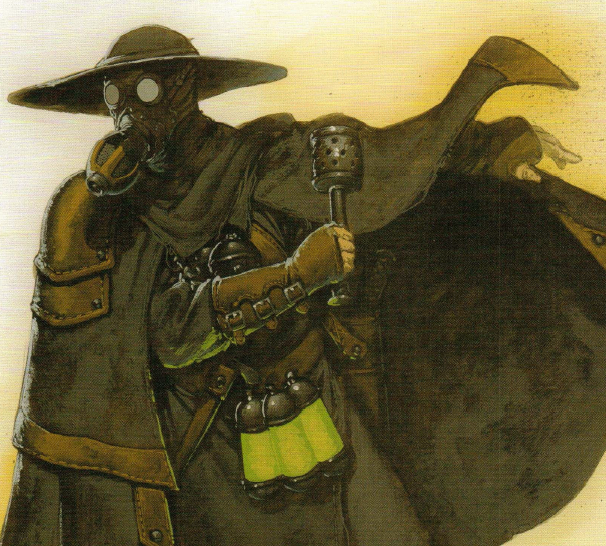
Gorman di Wulfe, Rogue Alchemist will work for Cryx, Cygnar, Khador or the Protectorate of Menoth. He was born to wealth in Leryn, and he was always a scholar, studying alchemy at Merywyn Academy. After graduation, he returned to Leryn and joined the Order of the Golden Crucible. He became obsessed with alchemical mastery, surpassing all expectations and becoming a Master Aurumn Ominus Alchemist within five years. Nothing seemed beyond him, and his colleagues found him brilliant if detached. However, some of the reagents he asked for began to raise eyebrows. It became clear he was working on proscribed poisons and explosives as well as other concoctions of his own invention. He was ordered to stop or be expelled, and while at first he denied it, after an accidental detonation that rocked Leryn and incinerated his lab, he quietly fled the city. He sought any funding at all to continue serving his passion, working out of Five Fingers for a time at a back-alley pharmacy selling potions to criminals. In Khardov, he was implicated in a factory fire that cost a local kayazy much of his fortune, and his name was associated with the Umbrean separatist movement, but by the time its leaders were executed in Llael, he was long gone. He eventually began selling to mercenary companies, and his dark reputation ensured that only the most desperate sought him out, which suited him fine - fewer questions were asked and they paid better. It wasn't long before he got a taste for killing. He'd gone to make a delivery only to find his employers being routed. He turned his alchemical firepower on their pursuers, and while he could not turn the tide, it stirred something in him, and he found his real calling: applying his theories dynamically. He turned his obsession towards a new end, selling his services to leaders and tyrants, using his magic to hide himself on the battlefield as he laid waste to foes. He loves combat, laughing even amidst cannon fire. Gorman di Wulfe has a reputation for mayhem even by mercenary standards, caring nothing for ethics or patriotism. He'll work for anyone that'll pay him, and while he's effective, many still hesitate, as strange and terrible accidents seem to follow him around, especially if you anger him.
Next time: Yo, ho, ho, a pirate's life for me!
Forces of Warmachine: Mercenaries
Original SA post Forces of Warmachine: Mercenaries
It is currently a very, very good time to be a privateer. Some people don't understand the subtle distinction between pirate and privateer, but it is important. Pirates are criminals - thieves and killers out for profit. This is against most nations' laws. Convicted pirates are usually hanged, branded, maimed or blinded. Most navies spend a lot of time hunting pirates and protecting merchants. However, piracy is very profitable, so even governments get tempted - and so privateers exist, sponsored ships that engage in legal piracy against enemies. Most nations legitimize their privateers with letters of marque, entitling a captain to "make prizes" - that is, plunder. The letters detail how a captain can attack and which nations can be attacked, what percentage must be paid to the kingdom, what kinds of weapons can be used and so on. The letter is transferrable between ships, but only under careful legal record. This ensures privateers don't accidentally attack the wrong nation - or their own.
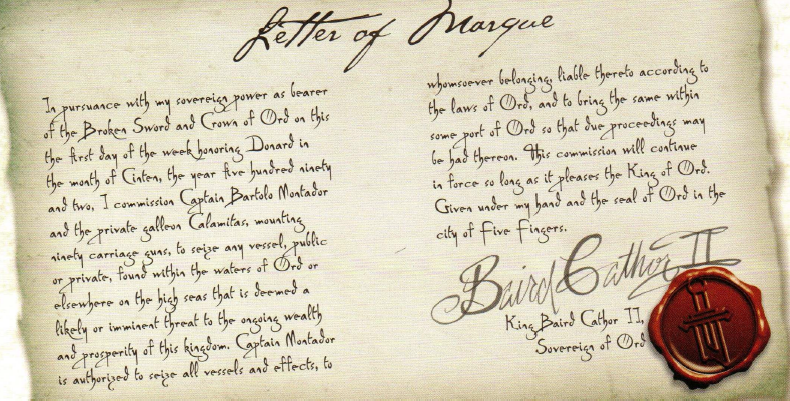
Privateers are encouraged to attack both enemy ships and pirates. This frees up naval ships for war and lets the government profit off the enemy, as well as occupying crews that might otherwise turn to piracy. Ord, Cygnar and Khador routinely employ privateers, and they're hardly the only ones. Ord makes heavy use of them to supplement its small navy, much as it uses mercenaries to supplement its armies. King Baird II is famous for permitting Ordic sailors to rob Cryxian and Mercarian League ships in his waters, in return for a quarter of all spoils. Some say Baird himself sometimes leads privateer attacks, but the Ordic court denies this.
Most privateer crews don't care much about their legal status, so long as they can engage in their favored plunder. Privateer cpatains can pick and choose their crews, thanks to the profits they enjoy, so they often have some of the deadliest ships on the Meredius, and merchants tend to surrender to them without a fight. Each crew is technically beholden to one nation, but most captains are profiteers before patriots, and they often take on mercenary contracts. Navies frown on this but do not interfere, provided the targets aren't part of their nation and the job doesn't blatantly violate the letter of marque. Because all shipping concerns like the Mercarian League or Blaustavya Shipping and Rail are targets for pirates, they often hire privateers discreetly to serve as escorts for valuable shipments. Some of the most disreputable privateers will turn on their own convoys, killing the crews and selling the cargo for profit.
Some privateer ships are crewed by motley collections of mercs, focusing more on coastal raiding than piracy, and in fact many crews just see their ships as convenient platforms to attack the mainland. They're more similar to mercenaries than pirates in most respects, with the advantage of a floating safe haven and transport. Certainly almost all succesful privateers supplement their arsenals with a warjack or two, and Ordic laborjacks refitted with weapons are highly prized. Even more sought after are 'jacks like the Mariner and Freebooter, which can handle work underwater for short periods. Captains that can't afford these will take decommissioned landbound 'jacks, particularly Mules. Many privateers also augment their ships with steam engines, using paddlewheels or sidewheels to move their ships. Captain Bartolo Montador, more famous as Broadsides Bart, commands one of the most potent steamships around, the Calamitas, which runs on three paddlewheels and has immense cannons. It's a nightmare for naval commanders, given its size and power.
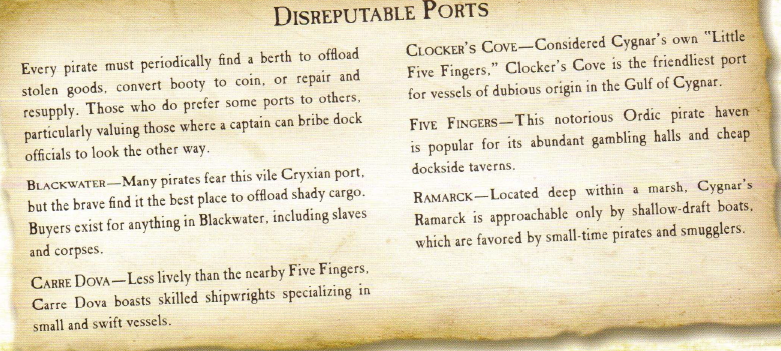
Life for a pirate is brutal and short. They risk capture and execution whenever they head out, and so many do seek to become privateers - it's safer. This has fueled a market in Five Fingers that sells forged letters of marque. Most pirate captains, however, quickly become famous and then get captured and killed before fading back into obscurity. Captain Phinneus Shae and the Talion walk that line better than most. Since the mutiny on the Mercarian League ship Exeter in 600 AR, Shae and his crew of mutineers have survived and prospered despite all the dangers. They attempted to become legitimate mercenaries, but the League ensured they'd never be forgiven or forgotten for their crimes, ruining all of their families. Shae, determined to get his revenge, began to look for a ship worthy of his crew. He found the Talion, a three-mast frigate with forty guns and a large cargo bay despite its great speed.
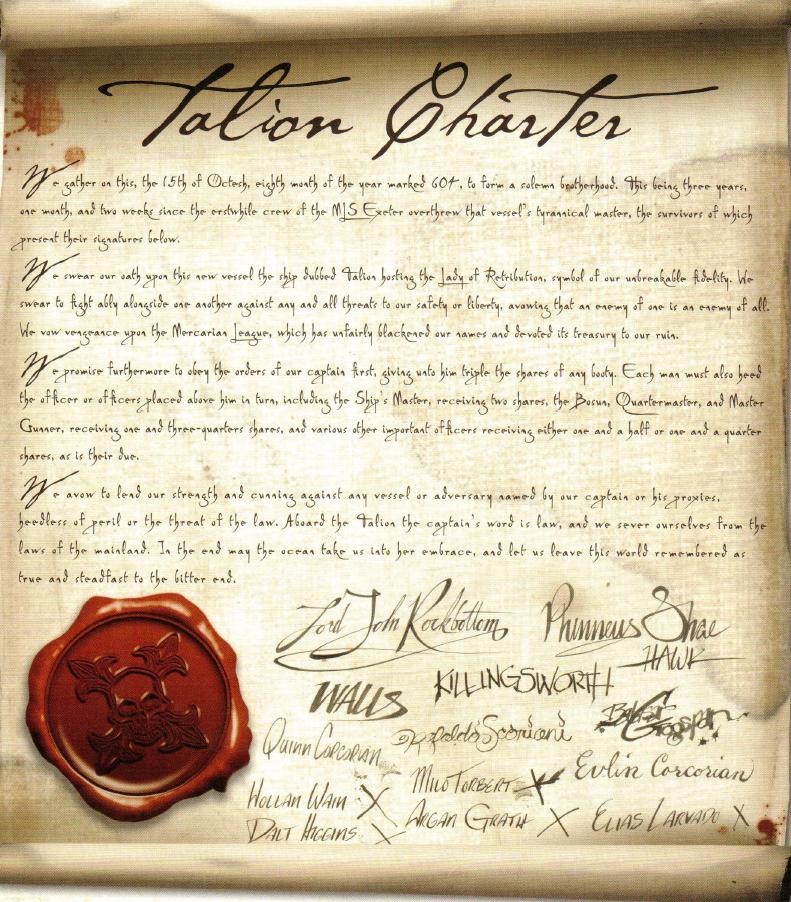
In the last few years, Shae and his crew have made relentless war on the Mercarian League, earning a reputation as fierce pirates. They are disciplined and deadly, fighting Khador, Cygnar and Cryx on occasion as well as rival pirates. They've sold their services to many criminals, and the contacts of the Rhulic exile "Lord" John Rockbottom have gotten them into several ports despite their status, as well as earning them lucrative mercenary contracts. Shae makes an effort to shield his crew by taking the legal burden of piracy onto himself, and he's wanted in both Cygnar and Khador. The Talion is often seen in Five Fingers, Blackwater and Clocker's Cove, but its home is an unmarked island between Carre Dova and Berck. The crew mostly controls the town there, which they name Bottomton after John Rockbottom, the unofficial mayor. The ship comes in there for repairs, supplies and to lay low. Shae has captured a number of prize ships, so he has a small fleet there, and it's rumored that he may be in secret employ to King Baird, with a secret but legitimate letter of marque allowing strikes against Mateu Merchant House. If he does, though, he rarely uses its protection, preferring to survive on his wits, guile and gigantic death cannon.
The Talion charter, which all crewmembers must obey, effectively declares war on the Mercarian League and their shipping, but they'll happily attack other organizations or even naval vessels. The charter has terms for splitting plunder, with senior crew usually getting larger shares. New recruits are brought in constantly to replace the dead, but the rewards are usually worth the risk. Lord Rockbottom recently expanded the charter to allow other ships to join them and negotiate shares. This was needed due to combined efforts with the Calamitas and Montador's other ships, and now these pirates and privateers are starting to coordinate their efforts against the Mercarian League, both on land and sea. When gathered under one banner, they've often proven superior to any normal army or navy force of comparable size.
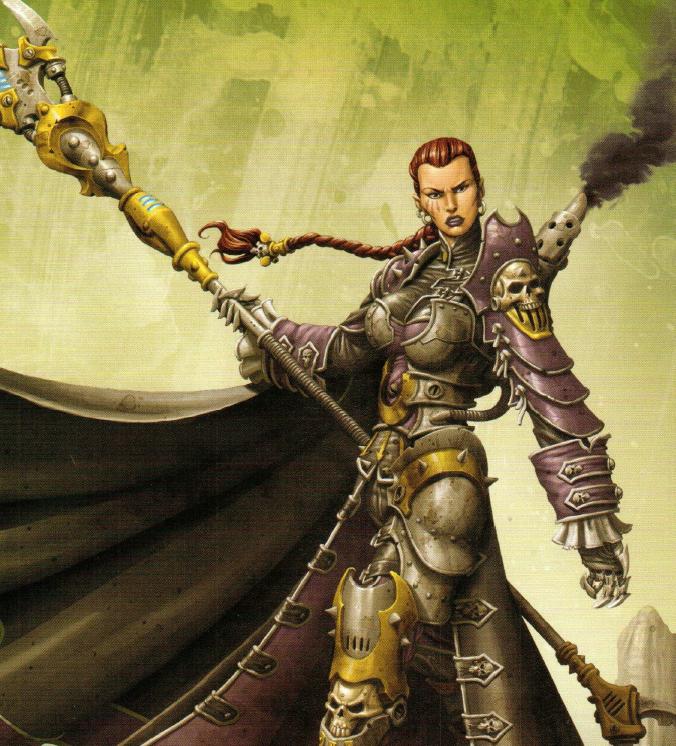
Fiona the Black will work for Cryx, Cygnar or khador, but will not join any army containing even one Morrowan unit. This is because she is an unashamed Thamarite, openly displaying her loyalty to her much-hated goddess and taking pride in having liberated herself from conventional morality. She is the owner of the Ill Fortune in Broadsides Bart's fleet, and she's known to be a moody schemer. Her love of battle and her courage have inspired an obedient and adoring cabal, many of whom crew her ship. Her cult is disciplined and coordinated in ways other pirates find unsettling, and while Fiona leaves nautical matters to her captain, Calvar Santoni, the ship is unquestionably hers. Even Montador asks permission before he boards. Fiona's sorcery manifested in her youth in Ceryl, as did her hatred of authority and her love of disobedience. This made her an easy target for Thamarite recruiters, who helped refine her power. She soon came to hate her cult, however, for hiding away in the shadows and disguising their faith. She learned what she could from them and fled to the sea, taking on the name Fiona the Black. She soon became more potent than the pirate captains she joined, until she meet Bartolo Montador, whose will allowed him to resist her manipulation and earn her respect. The true nature of their partnership remains a mystery. She loves to fight, and with the Calamitas supporting her she's unafraid to attack ships twice the size of Ill Fortune. Her daring has earned her a growing reputation for being untouchable. Her gimmick is buffs and debuffs, particularly in the form of brands, and using her cultists. Her feat massively debuffs enemy attacks.
Next time: It's how you look at buccaneers that makes them bad or good, and I see us as members of a noble brotherhood
Forces of Warmachine: Mercenaries
Original SA post Forces of Warmachine: Mercenaries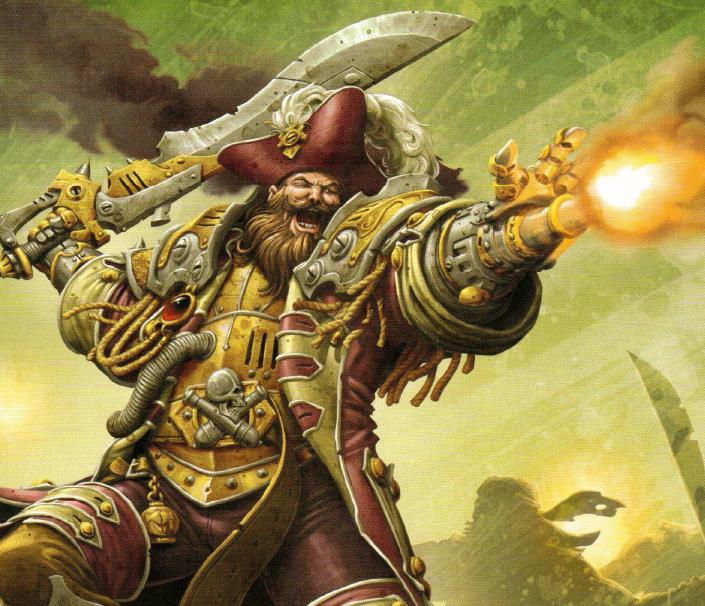
Captain Bartolo Montador , AKA Broadsides Bart, will work for Cryx, Cygnar, Khador or the Protectorate of Menoth. Under another king, he would be hanged, but he's won admiration as well as infamy. His booming, gregarious voice and his love of life rouse the fighting spirit of his crew, all ports welcome him and even his enemies envy his life. Few captains walk the line between privateer and pirate quite so well or with as much style. He has no qualms about cheating or stacking the deck to win, which lost him an arm in his youth in Five Fingers' card halls. Years later, he had it replaced with a mechanikal prosthetic containing a concealed cannon he named Ace. He prefers superior firepower, and he sails the Calamitas, the largest and most heavily armed ship in Ord. Berck Harbro rebuilt it from the frame of a Tordoran galleon, retrofitting it with a steam engine and triple paddlewheels. Even without a cargo, it's heavy in the water, so Bart keeps a fleet of smaller and faster ships, too. He takes pride in being a "legitimate" privateer, signed by King Baird Cathor II of Ord, and it's said that he meets with the king personally on the Laden Galleon in Five Fingers. He occasionally uses his status to take out rival pirates and bolster is reputation, giving the local authorities leeway to ignore his criminal work. He's flexible enough morally to work for any paymaster, including the Cryxians he's sworn to destroy. He sees this as simple pragmatism and a way to pay for his expensive tastes. Many mistake him for a jovial, merciful captain, but he's ruthless, willing to kill without remorse. His gimmick is shooting and exploding stuff, and his feat knocks enemies over with a typhoon and debuffs their attacks.
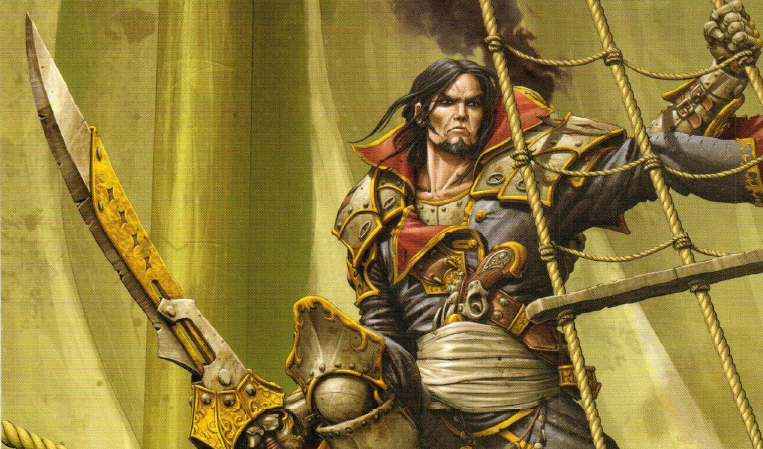
Captain Phinneus Shae will only work for armies that explicitly include him as a possible member - so the Talion Charter, basically. He was born to wealthy parents in Mercir, using his magic to earn a warcaster's commission at the Strategic Academy of Cygnar. He came to resent military life and was branded a troublemaker, leaving before his training was completed. He easily found work escorting merchant ships due to his magical skill, using the pay to maintain his expensive lifestyle. His unique nautical battle magic got him a berth on the MLS Exeter, flagship of the Mercarian fleet, where he proved deadly against Cryxians, rival merchants and pirates. He earned the respect of the crew, most notably the Rhulic financier John Rockbottom, which made the captain paranoid. Laross Fargen, the captain, threw Shae overboard, believing he was conspiring to take over the ship. Shae survived thanks to his warcaster armor and the ship's bosun, and he later organized a mutiny in truth. Fargen caused an explosion that crippled the ship, forcing the survivors ashore, and so Shae's life as a fugitive began. A huge bounty was put on his head, and the families of his crew were harassed. They took whatever merc jobs they could find to scrape together enough for a ship, purchasing the Talion. Now, Captain Shae is free to pursue his agenda of revenge ruthlessly. He'll take any prize, but his true wrath is saved for the Mercarian League, and his crew's shared hatred of them has made them a loyal family. He feels responsible for the crew, having no family outside them, and they would follow him into the depths if he asked it. His gimmick is buffs and mists, and his feat buffs his allies' movements.
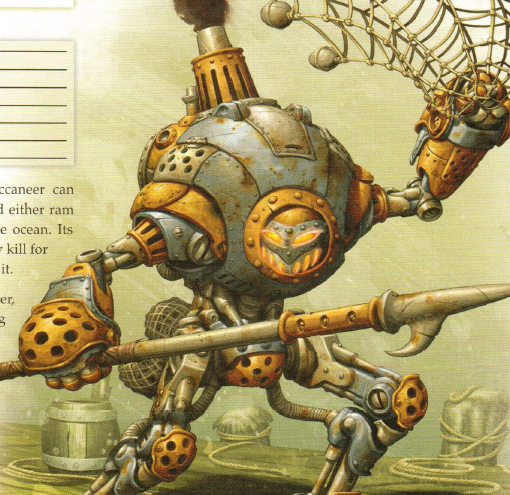
The Buccaneer is almost 10 feet tall and just over 3 tons. It is a nimble warjack, able to charge across heaving decks in a storm, using a gaff to ram and sweep foes. The weighted net it wields sets enemies up for the kill for either itself or its allies. The Buccaneer is built on the Seafarer chassis, an old but popular laborjack out of Ord. Its inferior movement systems resulted in poor performance in difficult waters, so pneumatic pistons were added to the legs and feet and the cortex was modified to react better to heaving decks. The first Buccaneer with weapons was outfitted by a fishing concern using the gaff and net to fish - they found that it turned out equally able to repel boarders. It has become widely popular now, especially on pirate vessels looking for a 'jack that can keep its feet on deck.
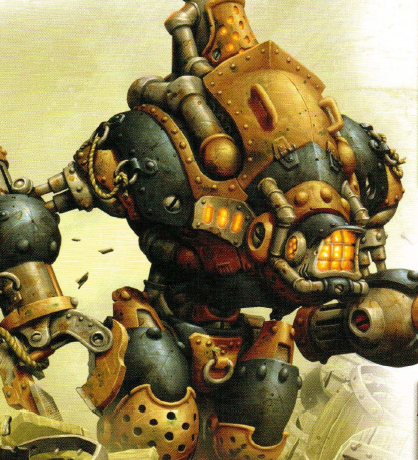
The Freebooter is over 13 feet tall and almost 5 tons. It looks at first like a laborjack...until it attacks, using its massive clamps to crush foes and hurl them around. Mercenaries and pirates often graft an arcane turbine onto its engine, allowing warcasters to give it a surge of speed, at the cost of some shredded gears. Despite its fighting ability, it can also handle delicate cargo in rough seas, and when working peacefully, it seems hardly capable of violence.
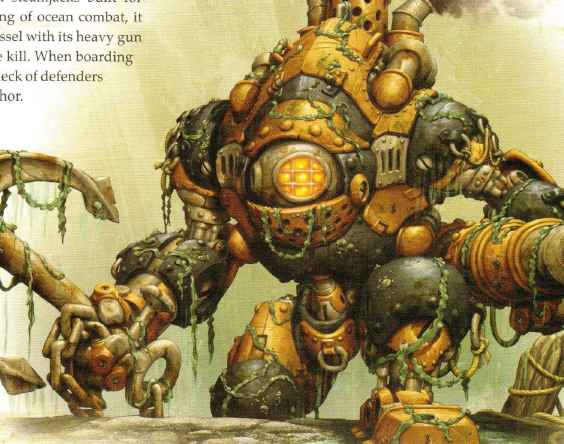
The Mariner is over 13 feet tall and almost 6 tons. It is one of the heaviest naval warjacks ever, able to fire continuously on enemy ships with its heavy gun while its own ship maneuvers for a kill. It excels at boarding actions with its immense anchor. It's adapted for sea warfare, able to work completely underwater for a limited team, and its chassis has watertight seals, exhaust valves and a special boiler and piping system that cycles air inside it while immersed. Its stabilization compensator lets it endure even rough seas without falling, and it is so reliable in a storm that crew will often strap themselves to it.
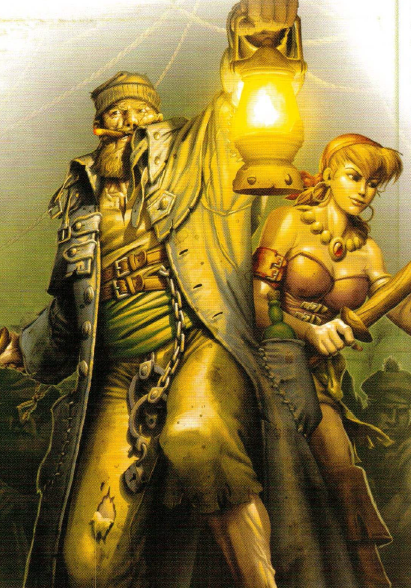
Press Gangers will work for Cryx, Cygnar, Khador or the Protectorate of Menoth. Pressing sailors into service is a practical, time-honored tradition, and the press gangs ensure ships have enough crew, usually by clubbing folks on the head. They typically frequent seedy bars to pick up drunks, but they'll happily take advantage of battle chaos to impress waylaid foes after a fight. Only truly callous and mean-spirited sailors excel at this job, and they're often the least popular but most respected sea dogs.
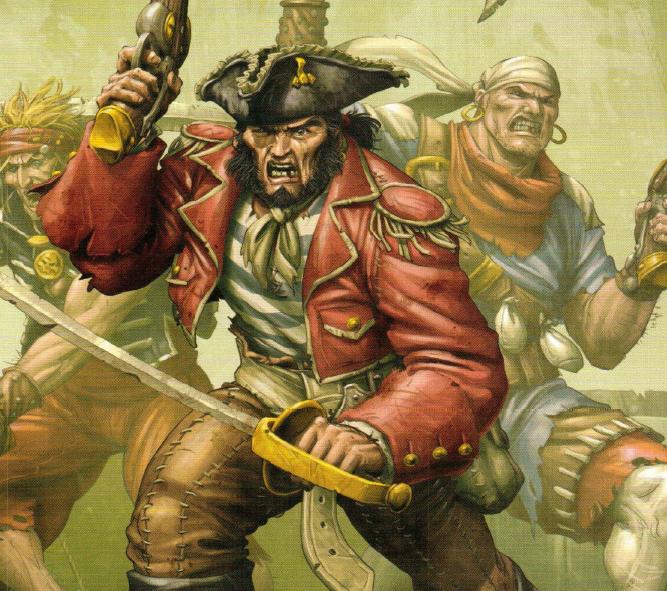
Sea Dog Crews will work for Cryx, Cygnar, Khador or the Protectorate of Menoth. They are motley pirate crews, barely kept in check by the ships' mates and happy to work for any paying master. What they lack in training, they make up for in bluster and greed. They often have little in common but a love of fighting for plunder, and they can be found in almost any coastal port, especially ports like Dreggsmouth, Five Fingers or Blackwater. They often begin as brigands, cutthroats or those seeking to escape their debts. Some were even just press ganged sailors or fishermen. Getting them to act together takes strength, and loyalty is rare. Each looks out for themselves alone, but self-preservation can bring them together, as can greed. Some of them have Thamar's luck, as it's called, surviving any misfortune with only some bruises. They prefer to overwhelm foes with numbers, running forward screaming. Unsubtle, yes, but suprisingly effective. Freedom at sea appeals to them, despite the often harsh shipboard discipline, and even the initially impressed often come to enjoy their lives. They all start as lowly swabs, but some rise to become respected mates, one of the few ranks in the tenuous piratical chain of command. Those with ambition and courage will earn rewards, and a well-run crew can plunder a lot in a short time, earning far more than honest labor. Of course, that money often vanishes just as quickly in port due to gambling and drink. Sea dogs work hard, but they play even harder when on land. Sure, a few flee, but the press gangs will replace them soon enough.
Next time: When the money's in the ground, there's murder in the air
Forces of Warmachine: Mercenaries
Original SA post Forces of Warmachine: Mercenaries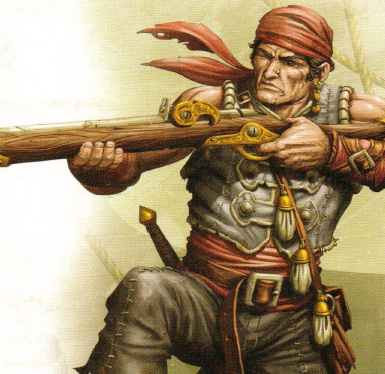
A Sea Dog Rifleman is a rare accompaniment to a Sea Dog crew, prized for their ability to lay down accurate fire at range, often from atop a crow's nest or prow. They have little training, relying more on concentrated fire from as many guns as possible, despite their claims to be crack shots. Rifles are scarce on ships, and typically each rifleman buys and maintains their own, or inherits one from a dead friend. Only the most cutthroat sea dogs live long, after all. Quartermasters are notoriously frugal about supplying the riflemen with powder, most of which is saved for cannons, and crewmen caught firing haphazardly can expect to be keelhauled. As long as a rifleman stays in the captain's favor, however, they may get bonus loot or extra rum per kill.
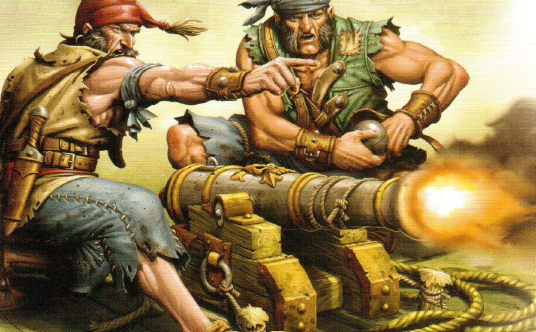
Sea Dog Deck Guns are the smaller kind - the larger cannons are too big to bring ashore. They can be found serving Cryx, Cygnar, Khador or the Protectorate of Menoth. Aboard ship, they're easily repositioned, unlike the main guns. They aren't as strong as true cannon, sure, but deck guns can decimate enemy troops at close range. Deck gunners start their career as powder monkeys, running powder from the lower decks to the guns mid-battle. Swabs generally prefer running the deck guns - it means staying back from the front line. Still, it's not a safe job, either - the gun crew must work in perfect synch with each other to clear the breach, load the ball, stuff the powder and light the fuse. Many sailors have lost hands or feet to recoil, too. On land, firing a deck gun is less dangerous, as the ground doesn't pitch like the deck does.
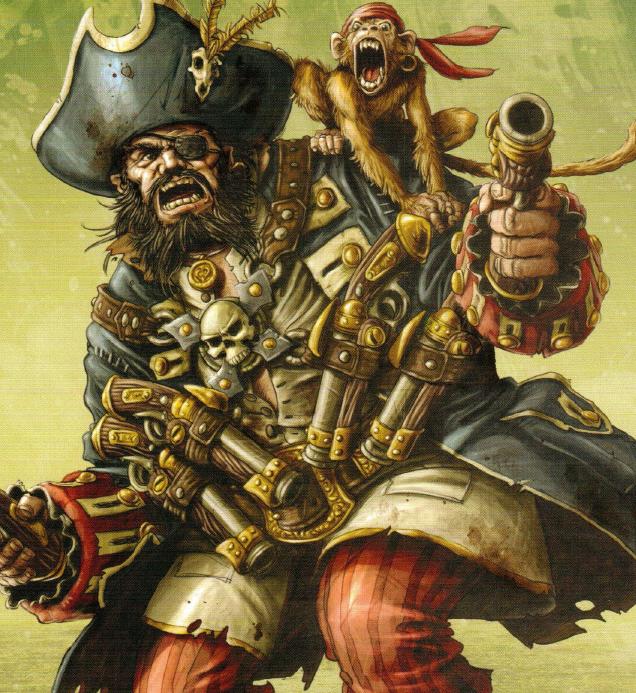
Mr. Walls, the Quartermaster serves on the Talion, leading some of their Sea Dog crews. He's the senior quartermaster, with more combat experience than anyone else aboard, even Captain Shae. He's ten years older than Shae and has a reputation for leaping into battle, guns blazing. In fact, he rarely carries fewer than three brace of pistols at once. Stubs, his pet monkey, is from the continent of Zu and is never off his shoulder. Walls will not see Stubs mistreated, and he feeds the monkey from his own table and rum. Out of battle, Walls is stern and no-nonsense, but in a fight, he'll intercede for the crew and has their backs. His soft spot has gotten him into trouble over the years, though, as he sometimes bends the rules for his crew. His innate concern for the men led him to join Shae in mutiny, due to the mistreatment of Rockbottom. Walls still feels guilty, as telling Shae about that got him thrown overboard, and he feels a special obligation to the original mutineers, often buying them drinks with most of his share of loot. Despite his generosity, he's a hard and vengeful man. He knows Shae's bounty attracts pirate hunters and that the crew's lives are always at risk. He accepts that they have do whatever they can to survive, trying not to dwell on those they leave to drown. He focuses his loyalty on Shae and his duty on keeping the men alive. Walls does not talk about how he lost his eye, but Doc tells a story about how Walls took a bullet against Blackwater raiders, falling to the ground as Stubs attacked the raider that shot him. The monkey kept the raider distracted long enough for Walls to stand back up and kill him, then fight another half hour before passing out from blood loss. He's not shot straight since and suffers from splitting headaches. He hasn't let that dampen his enthusiasm with his guns, though - he just has better luck when he's at point blank range, he says.
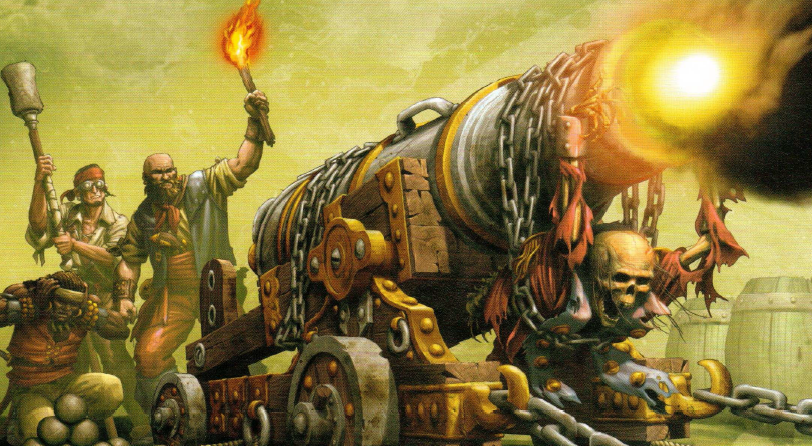
The Commodore Cannon and Crew will only show up in armies that include Phinneus Shae. It's not alive, but you'd never know it to hear the Talion crew talk. It's a legacy of the MLS Exeter, a royal-weight cannon like those typically found on ships of the line. It's very versatile, thanks to a healthy store of ammo of all kinds. The name is a sardonic tribute to Captain Laross Fargen of the Exeter, and it's his skeleton on the barrel. In the fight after the mutiny, Fargen accidentally set off an explosion in the powder room, crippling the Exeter and forcing it ashore. After taking Fargen captive, Bosun Grogspar strapped him to the cannon and fire it until he died. The crew still whisper about this, reinforcing Grogspar's cruel reputation and leading to the legend that Fargen's ghost haunts the cannon. Some even claim they've seen it between battles. The gun's been carefully maintained, used as field artillery in countless battles at sea and ashore. Shae insists on bringing it along for all major land engagements, seeing it as a good luck charm. He's convinced he can't lose as long as it's loaded and ready. Cannons of this sort cost a small fortune, and they're the apex of Cygnaran naval gunnery. The barrels use modern metallurgical and casting techniques to allow heavy powder loads and repeated firing without damage. With a skilled crew, it has immense range and accuracy. The navy saves them for top vessels, and Duke Waldron Gately of Southpoint got special permission for the Exeter to have one. Owning it is technically an act of war against Cygnar, though no one's managed to enforce that bit of law on Phinneus Shae. The Talion crew see serving as its gunner or gunner's mate as a huge privilege, despite the hazards, and every crewman is expected to know how to handle the Commodore.
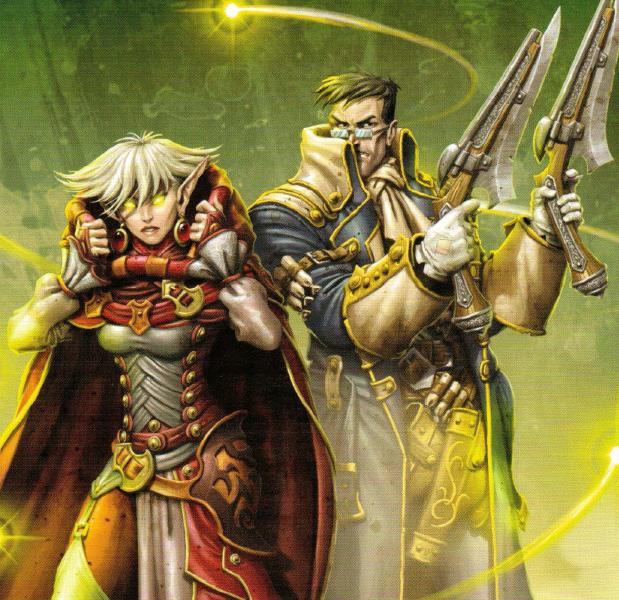
Lady Aiyana and Master Holt are a strange and mysterious pair, willing to work for Cygnar, Khador, the Protectorate of Menoth or the Retribution of Scyrah. Lady Aiyana is Iosan, but her bodyguard, the pistoleer Master Holt, is human. Aiyana is warm and affable - not for an Iosan, just, period. However, she's a mistress of misdirection and small talk, deflecting questions about herself with flirtatious banter and charm. She shows no hatred of humanity, but it's unclear if that's a facade or not. She is reluctant to fight, but is an adept spellcaster and user of Iosan magic, calling on her faith in the vanished gods of Ios as she casts. Holt takes advantage of her magic to spray gunfire at her foes, or uses his pistols' blades in melee. He is chillingly dispassionate in his efficiency of murder. Holt is evasive and doesn't speak much, but he sees everything, and he's motivated by more than gold. He and Aiyana are new to the Talion, and Aiyana has insisted on staying, over Holt's objections. None on board suspect, but Aiyana is a member of the Seekers, an Iosan religious sept, investigating Cryx for traces of the gods. Holt is believed by Cygnaran intelligence to be a member of the Unseen Hand, an organization of spies with unclear motives.
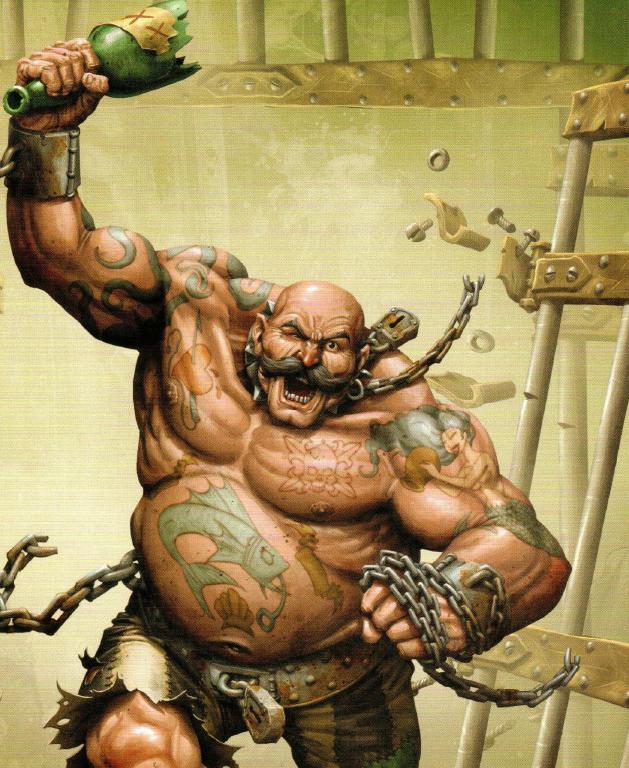
Bloody Bradigan will work for Cryx, Cygnar, Khador or the Protectorate of Menoth. Torc Bradigan is a berserker, seeking violence the way others seek drink. He's so murderous that the quartermasters keep him constantly drunk or locked up, like a caged gorax, to be let loose only for boarding actions and battle. Even with Captain Montador's indulgence, Bradigan's tendency to 'accidentally' break necks or ribs of fellow crewmen means he's in the brig more than he isn't. All of his restraints are released in battle, though, and more than once he's literally torn the brig open when not released fast enough. He started in Five Fingers as an enforcer, until he choked to death one of the low captains serving High Captain Velter Waernuk and was forced into the pits to repay his debt. There, Captain Montador saw him fight and saw potential, buying Bradigan in a gambling match. He's proved an awful sailor, but an excellent fighter. Bradigan's not always angry - his mood swings rapidly, in fact, shifting between extremes very quickly, and he punches holes in the walls even in his sleep. The crew of the Calamitas are happy when he's in the brig. Bradigan's grateful to leave, but he's not angry about his time in Five Fingers - he can recall fondly every match he was in, reenacting them for anyone that wants to see.
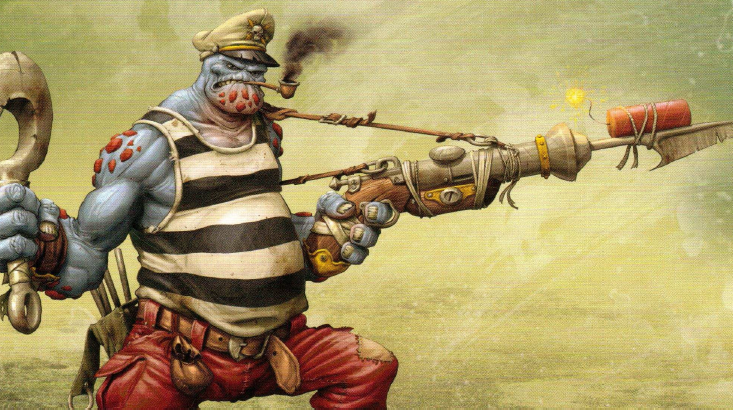
Bosun Grogspar will work for Cryx, Cygnar, Khador or the Protectorate of Menoth. He serves aboard the Talion, and his first name is Balasar, but no one ever uses it. He was born on Kithgrav Island, part of Five Fingers. He was disgusted by the place, longing for the sea. He spent his youth on the docks, having no patience for slacking dockworkers or bribery. His violent but goodnatured reprisals impressed the sailors, and within a few years he was an expert seaman. He spends little time thinking about discipline - he just hurls wastrels and lubbers overboard. He eventually reels them in if he thinks they're worth saving, especially if they can fight, but he lets them flounder a while, then puts them at the head of the next boarding party. If they die, that's not his problem. Some have taken this for an act and tried to call his bluff, but they rarely get a second chance to do so. He's highly attached to the ships he serves on, taking any attack on them as a personal affront. He's very creative in his weapon use defending them, and he prefers to deliver explosives attached to harpoons. He's rather cruel by nature, and few things make him smile like seeing an enemy explode. He also likes to watch the wounded beg for their lives as the fuse burns down. His sense of duty made him reluctant to mutiny on the Exeter, and it was Mr. Walls that persuaded him. To this day, Grogspar resents "the incident," and he'd probably have been on the other side had he known it'd end in the Exeter's destruction. He often waxes melancholy over the Exeter more emotionally than over the deaths of his crewmen. He forgave Shae only because it was Fargen who caused the explosion, and that's why Grogspar personally oversaw Fargen's execution. His responsibilities far outweigh his title, and he'll speak out freely against anything he damn well pleases. Shae tolerates his impertinence and even insubordination with good humor, remembering that it was Grogspar that pulled him out of the water when he was hurled overboard to drown. Most days, Grogspar is the undisputed master of whatever ship he's on, doing whatever job needs to be done. He only defers to First Mate Hawk, and even then, he's willing to mouth off to her. By and large, no one complains, because Grogspar's got decades of experience running the ropes, and no one's better.
Next time: Dead men tell no tales
Forces of Warmachine: Mercenaries
Original SA post Forces of Warmachine: Mercenaries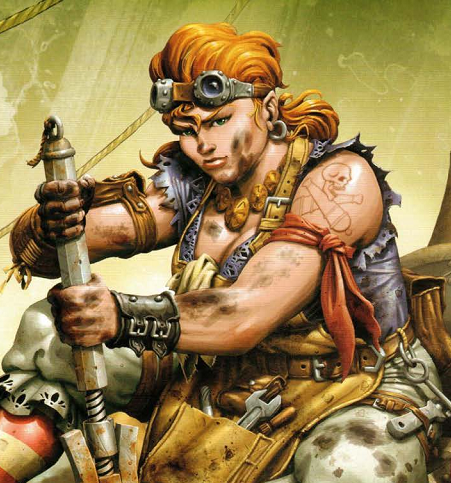
Dirty Meg will work for Cygnar, Khador or the Protectorate of Menoth. She's got more natural engineering talent than others with a lifetime of training. She works aboard the Calamitas, and she's more than aware of the value of her skills and how to throw her weight around. Anyone in her way is likely to get teeth knocked out by her wrench or hurled overboard by the nearest laborjack. Her full name is Megan Melroane, and those who've befriended her learn that she was once a member of the Ceryl Dock Workers' Affiliation, who oversee cargo in the Cygnaran city of Ceryl. She was a top-notch 'jack handler, but she wasn't paid well and began stealing from her bosses to make up for it. A job seeling stolen laborjacks to Bartolo Montador drew the attention of the Mercarian League, and she was forced to turn her Freebooters on the mercenaries that came after her, becoming a fugitive wanted for murder. She bought a berth on the first vessel leaving th city, a smuggler bound for Five Fingers, and moved from ship to ship selling her talents for repair. She eventually caught up to the Calamitas, elbowing her way into Montador's dice game and demanding a job from him. He turned her down and awoke the next morning to find one of his 'jacks disassembled on his doorstep with Meg standing over it. She offered to put it back together as soon as she had the job. She joined the Calamitas crew that day, acclimating quickly to the pirates and arsenal. She's become a frequent sight in pirate havens like Bottomton. She loves to fight alongside 'jacks, using her custom mechanikal cannon to seize up gears or short out conduts. She's as pragmatic in battle as any pirvateer, too.
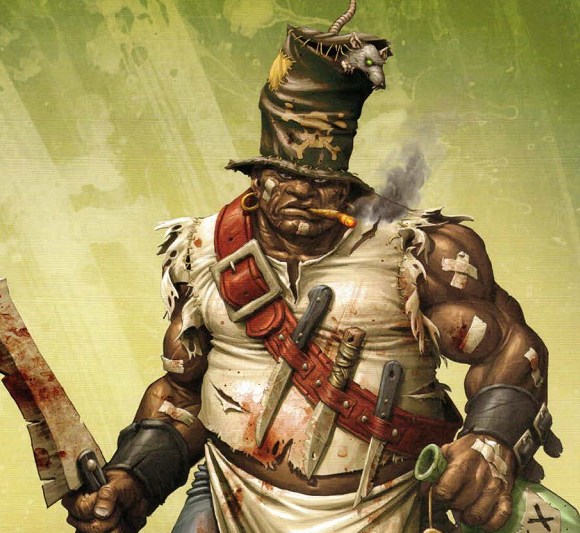
Doc Killingsworth (first name: Creb) is the Talion's cook and surgeon, willing to work for Cryx, Cygnar, Khador or the Protectorate of Menoth. His patients lack his enthusiasm for medicine and often the threat of his treatment convinces them to fight on. He's claimed to be an Arjun from Mercir, a Morridane from Corvis, a Sinari from Five Fingers and even a 'black Tordoran' from Berck, though no one from Ord has ever heard of a black Tordoran. He's got an impressive kill tally despite his rarity on the front line. He wields an immense meat cleaver and a lot of knives, unnerving friend and foe alike. He's a master knife thrower thanks to the ship rats, and his knives are viciously sharp. Most sailors are pragmatic about what they eat, and he's happy to prepare rat if he has to. It tastes surprisingly good, and even the officers of the Talion prefer not to ask what goes in his stews. Doc's an enthusiastic but untrained surgeon, coming by his skills through years of practice cutting things apart. His brand of surgery makes the men uneasy, but Shae trusts Doc to know his job. He's saved every officer on the Talion at least once, though he's not so hot on cleanliness. Indeed, he was the one to remove Joln Rockbottom's gangrenous left leg just before the Exeter mutiny. Many crewmen have survived losing limbs or eyes thanks to him, and he's been known to carve up enemies in battle and stuff pieces into his pockets. No one can confirm if he's ever used human remains for cooking, but few would put it past him. However, just to be sure, many veteran crewmen stick to stale bread just after large battles to avoid the meat dishes he makes.
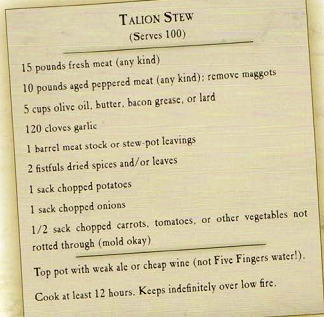
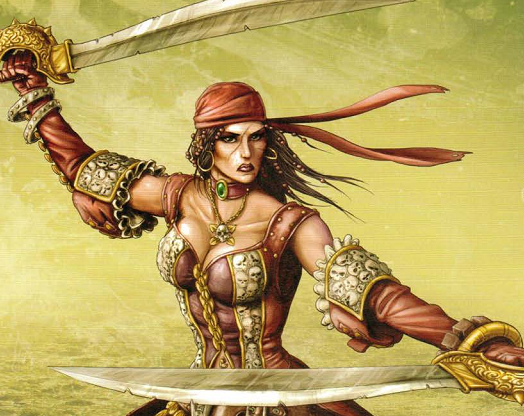
First Mate Hawk will work for Cryx, Cygnar, Khador or the Protectorate of Menoth. She is responsible for keeping Captain Shae's crew ready for battle, and she suffers no foolishness. She's one of the deadliest swordswomen on the sea, and some sea she's killed more men than rip lung. Her acrobatics and speed make her nearly impossible to beat. She's much less comfortable socially, where her taciturn, abrasive nature leads to argument. She has a strange but strong bond with Shae, who tolerates her moodiness and is the only person who'll argue back with her. They are more harmonious in battle, perfectly coordinating their movements silently. The crew would do anything for her approval, and while they admire Shae, they look to Hawk for leadership. Shae commands them only because she is at his side. Many have died taking bullets for her, and she willingly spends lives to buy her own survival. Only a chosen few are her friends, and even they do not really understand her. Her past and even her given name are mysteries. She claims she has never felt any qualms about killing, and even as a Mercarian League sailor she had a reputation for danger. She has a tense relationship with Shae, and even normally rumormongering sailors won't speak of that matter. All that they know is that Shae trusts Hawk above all others, and she is empowered to make decisions in his absence. In fact, she is often acting captain at sea so that he can focus on other matters. Whenever he is threatened, Hawk is there to fight beside him.
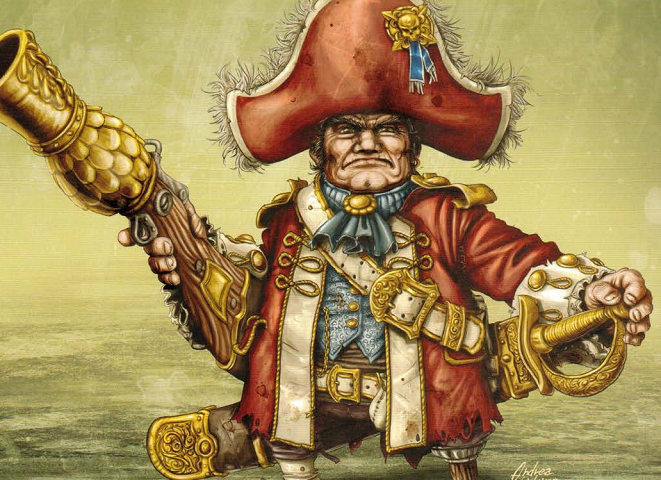
Lord Rockbottom, Expedition Financier will work for Cryx, Cygnar, Khador or the Protectorate of Menoth. He is a Rhulic dwarf, Joln Rockbottom, and never seen without his bright red jacket and immense bicorn. He may seem comical, but no one on the Talion would dare laugh. He is far deadlier than he looks, and very important. His skill is not what keeps them in line, though - he's ship's treasurer and paymaster. His contacts are what keep the Talion working, and though they have a dark reputation, his bribes and silver tongue obscure their crimes in port. Without him, the Talion could not find any welcome. He is offended by characterization of the Rhulfolk are greedy, insisting that most Rhulfolk are good-hearted people who focus on family and craft. Joln has just chosen to master the 'craft' of speculative finance, a sacred calling to Great Father Ghrd, patron of wealth. Rockbottom will not explain the conditions under which he left Rhul or the status of his 'lordship,' but rumor has it that he had a dispute with the Moot of the Hundred Houses over a breach in the Edict of Ownership, and while they lacked evidence to execute or brand him, he chose a life at sea in oprder to stay as far from Rhul as physically possible. He still has friends in the Glass Peaks and Cygnaran dwarven conclaves, though, plus some allies in the Searforge Commission. He began to associate with the Mercarian League, and it went well at first, until his greed and manipulation soured him on them. No one knows the full extent of his dealings, but he's worked with Cryxian smugglers, Khadoran kayazy and Caspian inventors, sometimes all at once. He believes coin can solve most problems, but this philosophy backfired on him as the paymaster and financier of the Exeter, putting him at cross purposes with the captain. He was guilty of many allegations, but not insurrection - he prefers to let others lead, influencing them indirectly with money. The crew's efforts to save him from the brig genuinely moved him, and he is grateful to Doc for removing his gangrenous leg. Most of the Talion crew view Rockbottom as equal to Shae, and he might well be what keeps the crew together. His financial and political skills complement Shae's courage and tactics, and in fact, Joln still owns a small fleet of merchant ships, inversting some of his profits from them into the Talion and other ventures. Recently, he's become more interested in his private fleet after finding a rudder showing the way to the distant continent of Zu, taking measures to journey to its main trading port and back to make several lucrative deals. He dreams big, hoping one day to influence trade across the entire region or beyond. Meanwhile, he uses his pillaged luxuries to increase his comfort on the Talion. No one ever resents the fact that he never helps with menial tasks - that is beneath a lord, after all.
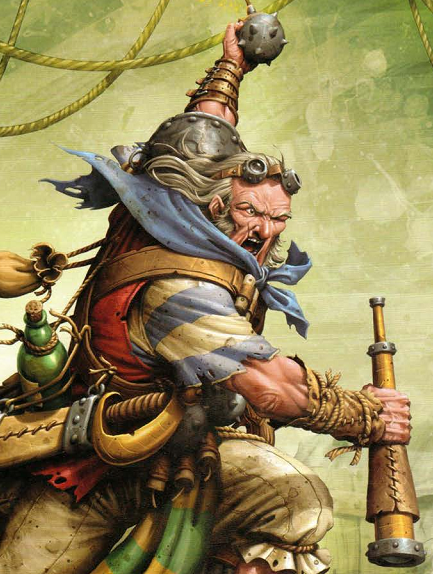
Master Gunner Dougal MacNaile will work for Cryx, Cygnar, Khador or the Protectorate of Menoth. The Calamitas see him as more than human, born from a cannon and breathing blasting powder. He has crewed the big guns longer than anyone else on the Calamitas, perhaps anyone alive on the sea. Many cover his commission without understanding the dangerous nature of his work. All sailors know to take care with blasting powder, but daily contact with it means more and more chance of mishap. A mistake made wrapping powder or packing guns rarely gives a second chance. If you're lucky, you just lose a finger or three, but too often, it's fatal. Even those that don't blast themselves to bits usually lose their hearing. Though he does often have to ask people to repeat themselves. MacNaile's hearing seems mostly intact and he has all his fingers and toes. In fact, he often walks about barefoot. Dougal has defied the odds, becoming a legend, a sorto f patron saint of gunners for his survival. Each time the dust clears from an explosion, he jumps to his feet and has them load the next round. He'd have trouble finding a better post than the best-armed privateer vessel on the seas, with as many cannons as any ship of the line.

The Rhulic records date back over six millenia, making the dwarves the oldest and most stable continuous civilization in western Immoren. They have no thirst for conquest outside their mountains, primarily the Borokuhn, Silvertip Peaks and Glass Peaks - the highest and most treacherous in Immoren. Crossing the outer mountains means using dangerous, icy roads and trails made over the centuries, many of which lead to chokepoints, go under giant forts or twist around on themselves to allow watchers to observe them. While officialy natural for millenia, the Rhulfolk do keep a close eye on outsiders and periodically involve themselves. After the coming of the Orgoth, their determination to stay aloof was eroded, and near the end of the Reberllion, they shared their industry with the rebels, enabling the construction of the Colossals. This partnership gained Rhul the knowledge of cortex construction and blasting powder, and the dwarves became enthusiastic about mechanika and guns, incorporating them into many aspects of their culture, which has always enjoyed honorable battle. Interest in the south ahs increased in the last few centuries, as the dwarves are impressed by human innovation and trade prospects. Some clans are mercenary by nature, while others watch things abroad to keep track of threats to the homeland.
After the signing of the Corvis Treaties, many younger clans set forth to find their fortune in the south. King Benewic the Bold, first king of Cygnar, and King Makaros Taranovi, first king of Khador, both agreed to allow settlement of dwarven enclaves in their borders. The agreements were made iwth the Stone Lords of Rhul in exchange for trading rights and access to Rhulic workers and craftsmen for rebuilding. Thousands of Rhulfolk emigrated to the southern lands' remote and difficult regions, which humans had little use for, to make self-sufficient Rhulic enclaves. They have become a common sight among humans, on and off the battlefield. While the Rhul are not interested in conquest, their clans seek profit and happily adopt human technology as it develops. It wasn't long before some of them started to sell their fighting skills, joining the mercenary tradition. In some parts of eastern Khador and the Upper Wyrmwall, mixed communities of humans and Rhulfolk exist, but recent tensions betwene Khador and Cygnar sometimes threaten them. Both kingdoms have many dwarves, and their neutrality can strain things, especially in Khador, where Rhul's trade with Cygnar is notorious and often prompts suspicion. Cygnaran dwarves sometimes suffer similarly, and human soldiers often resent giving safe haven to the Rhul while they refuse to help in the war. In Cygnar, these sentiments are largely reduced by dwarven help with infrastrucutre projects like railways or bridges, and the fact that the Rhulfolk produce the magelock pistols needed by the Militant ORder of the Arcane Tempest in the enclave near Ironhead Station.
Next time: Hi ho, hi ho...
Forces of Warmachine: Mercenaries
Original SA post Forces of Warmachine: Mercenaries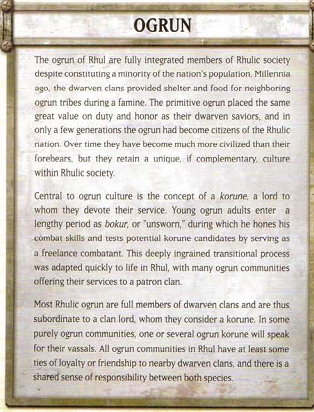
Rhulic life is centered on the clan, a tightly knit extended family of shared bloodlines and marriages. Clans can have up to multiple thousands of members, and new clans form by young dwarves seeking to branch out and start fresh. Clan lords are the most respected Rhulfolk, the leaders of their families. Each is given respect and deference proportional to their clan size, prosperity and honor. The most potent of them are the stone lords, 13 clan lords who are the ultimate Rhulic authority. They are responsible for guiding and defending the Rhulfolk as a whole and handling all interaction with foreign powers. Not all stone lords are equally talented, intelligent or skilled, but each directly descends from one of the Great Fathers, the dwarven gods, and has been declared worthy by the Church of the Fathers. They have both spiritual and secular authority. Though they represent the most potent clans, Rhul is oligarchical and many other clans also have a lot of influence. Rhulic history has shown strong clan lords banding together to share leadership over lesser clans, with councils of the most powerful local lords ruling counties, towns and cities in Rhul.
The Moot of the Hundred Houses is the Rhulic central legislative and judicial body, meeting frequently in the capital, Ghord, to discuss Rhulic concerns. Only the representatives of the hundred most powerful clans can attend, and membership does change as clans rise and fall, but most of the top clans have held their status for centuries. Moot judges enforce the legal rulings of the Moot and are appointed by the stone lords. They are well-educated arcanists, priests and scholars who study the Codex, the lore that contains all Rhulic legal precedent, all the way back to the words of the Great Fathers. Moot judges have jurisdiction over entire clans and can judge the clan lords. Violence and clan feuding is part of Rhulic life, but usually smallscale and not considered war under Rhulic law. Even the largest feuds are regulated by tradition and law passed down by the Great Fathers and overseen by the judges. Most clans get involved in vendettas over various things, even property ownership or building rights. These are regulated and monitored conflicts, but often very violent. Most often, feuding clans will dispatch evenly matched forces to fight at a mutually accepted location. These battles are regulated and almost never ended by rout, but instead by negotiated and predetermined victory conditions, such as loss of a standard or casualties in a certain percentage. These ensure only the strongest and most creative clans earn the right to make themselves immortal by the sacred art of building. Clans will set aside internal conflicts whenever threatened from outside, and the stone lords and judges enforce peace when feuds threaten to disrupt commerce and industry. The idea of being unable to help your clan fight is unthinkable to the Rhulfolk, and few fear death in battle or duels. Virtually all Rhulic citizens are skilled fighters, so while Rhul has no army, all of its citizens might as well be professional soldiers if needed.
Mercenary work is extremely respected among the Rhulfolk, and most clans have strong martial traditions, especially near Horgenhold, Hammerfall and Lakeforge. These clans send a certain amount of their forces out as mercenaries, for profit and training. The stone lords like it, though the Moot has the right to veto any contract outside Rhul. It is understood by all that if Rul is threatened, the mercenaries will immediately be recalled to defend it, and even those legally exiled by Rhul would probably answer that kind of call. Rhul has taken more of an interest in the activities of its mercenaries since the Khadoran invasion of Llael, since it proved that war had come to their doorstep. This led to the founding of the Searforge Commission, charged with overseeing mercenaries outside Rhul in order to ensure the security of weapons and military shipments. The Searforge Escorts wear bright colors to warn attackers that they aren't to be interfered with, and they carry the Searforge Commission sigil when accompanying trade caravans or shipments of gold and other valuables.
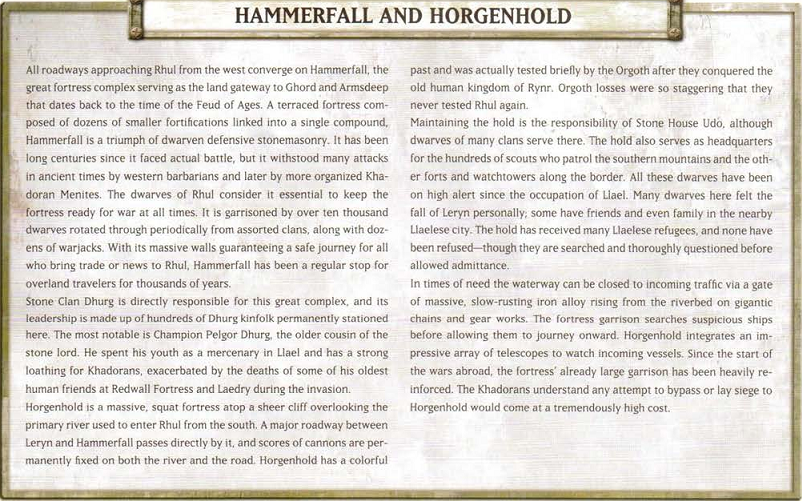
The Commission answers only to the Moot as a whole, and elements of many martial clans are rotated through it as needed. Most clans are happy to lend them soldiers, since it pays well, gives field experience and helps keep track of human developments. Getting supplies and hardware has always been easier for Rhulic mercs than human ones. The Commission is backed by influential houses and enclaves, ensuring they have a study supply of 'jacks and parts. Even clans with a vested interest don't just give warjacks away, however, so Rhulic mercs often request pay in raw materials or items they know will be of use to suppliers. Rhulic mercenaries increasingly group together to consolidate their skills, forming bands similar to the charatered human companies. Those facing dwarven companies can attest to their discipline and organization. Rhulic respect for law extends to the charter law of their clients, and Rhulic mercs use some of the toughest contract negotiators in the world to ensure they and their clients know exactly what they're getting. Larger outfits allow their troops to be ired on both sides of a conflict, but will take care during negotiations to ensure they don't face each other in battle. A Hammerfall High Shield gun Corps platoon might defend Point Bourne against Khadorans in the Thornwood while another will work for Khador to protect a supply depot near Corvis on the other end of the same front. Their roles are clearly defined, so they won't fight each other despite serving on opposite sides of the same war.
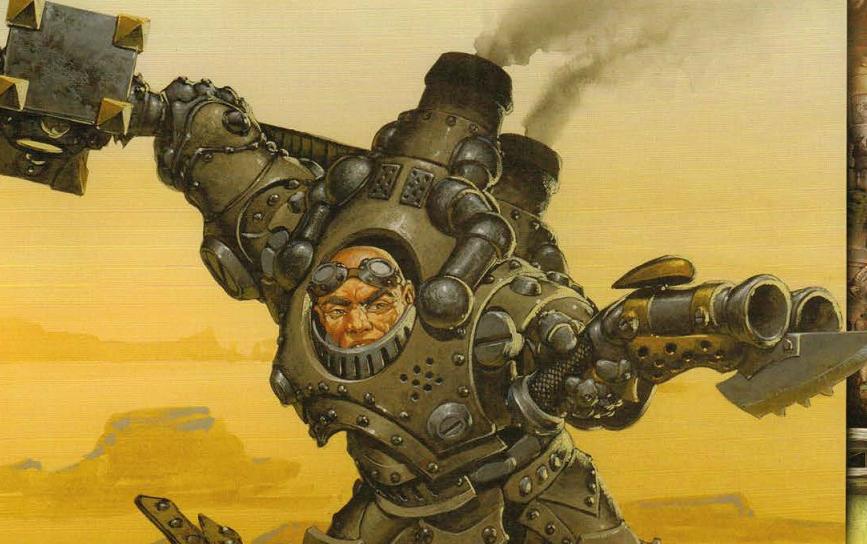
Gorten Grundback will work for Cygnar or Khador. He is a member of Clan Dohlan, and he grew up fast, discovering his inherent talent for earth magic in their mines. His clan, longtime miners, saw great potential in him, and he got many tools and manpower as he ascended the ranks of the Grundback mining conglomerate his clan belonged to. When he began commissioning steamjacks to further his work, he found he had a talent for the magic of mechanika, which he honed on trade expeditions to Llael and Khador. He was able to command the 'jacks as easily as the stones. One day, he realized he was meant to be a warcaster. He'd heard tales of the honor and glory of these mighty warriors, and he decided to leave mining behind, turning his foremansip over to his nephew. He gathered his personal 'jacks and ventured forth to become one of the few Rhulic warcasters out there. For a while, he lived like any mercenary, but after proving his worth a few times, his services became highly regarded. His reputation and expert 'jack skills earned him enough respect from the Grundback clan that he was elevated to a full clan member, letting him take their name. He wields earth and stone on the field, calling walls of rock or waves of molten ore. He can even conjure up immense landslides on his foes. His combat skill is no less impressive - he's a block of msucle and armor, wielding the mechanikal maul Forgefather with immense force. If his foes are too cowardly to fight up close, he has a double-barreled Stoneground pistol customized to his specifications. He's a skilled technician, a master of stone magic and a proud warrior, all for the price of a few thousand coins. His gimmick is, in fact, rocks, and his feat causes a landslide to hurl enemies around and debuff them.
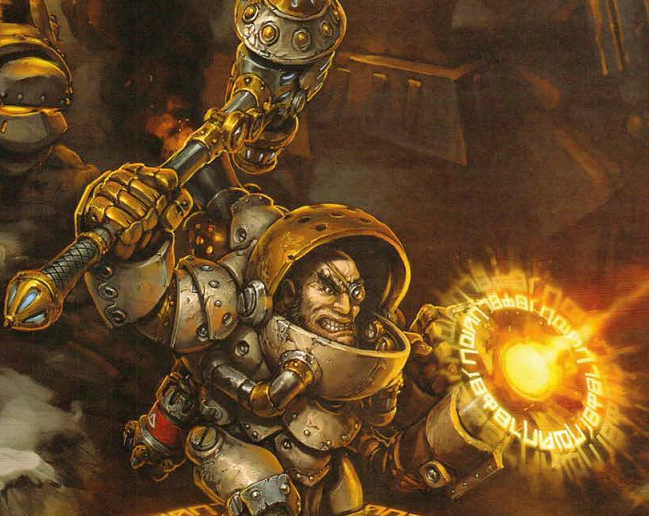
Durgen Madhammer will work for Cygnar, Khador or the Protectorate of Menoth. He is compelled to destroy, oblivious of all collateral damage. He loves to fight, and his history is full of disasters, thanks to his preference for unstable magic and powerful mechanika. He started out in his family mines, blasting tunnels and ordering 'jacks, but he left after several deadly accidents. His kinfolk actually had him legally removed from their clan. He decided, instead, to become a warcaster, spending 20 years as a mercenary mechanik and battle mage. Demolitions, elemental magic and mechanikal skill have turned him into a legend. He routinely pushes his 'jacks beyond their limits and they always need repair. He's as deadly to friend as foe, so few will intentionally work with him - or near him. Those desperate few that stay close try to avoid his aim until his payload blows. He is a cackling madman, captivated by the beauty of destruction. He rides the rush of battle in a wave of devastation, with a spectacular end. His gimmick is explosions, and his feat buffs blasts and AOE attacks.
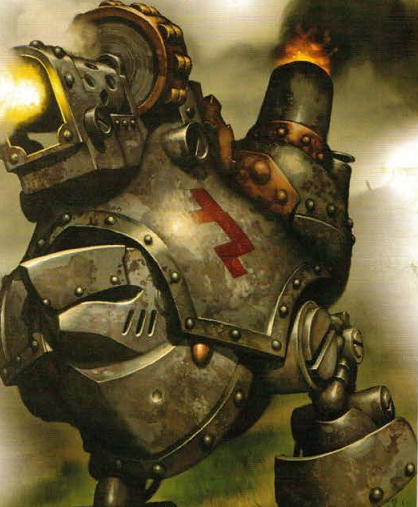
The Grundback Blaster stands just under 5 feet and is just over 3 tons. Rhulic steamjack designs are brutal but economical, based off utilitarian chassis. The Blaster is a prime example. Like its cousin, the Gunner, it's based on the chassis of the durable Grundback Runner. It's armed with a canister-fed hailshot cannon, one blast of which will release a volley of tiny projectiles to cut through massed troops. By shaping the barrel with a metal choke, Rhulic engineers were able to concentrate the blast significantly, and with a minor flex of will, warcasters can increase its potential. To protect the declitate internals, the engineers made a heavily reinforced armor shell, making the Blaster a very tough little machine.
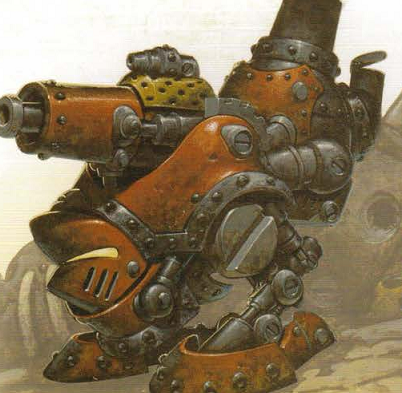
The Grundback Gunner is just under 5 feet and weighs 3 tons. It's compact, and that often makes people underestimate it. It is, however, quite lethal. The cannon can deliver powerful explosive shells, and the small size makes it excellent at handling narrow caves and mountain roads. Together, the guns and manueverability make it a force to be reckoned with. IT was originally made to carry messages quickly in mines, but after the cannon was added to the chassis, the Grundback Runner became known as the Grundback Gunner. When compared to the millenia-old reputation of the Ghordsons, Clan Grundback is a newcomer to the Rhulic mechanikal conglomerates, and their prestige is very much owed to the Gunner, a marvel of efficiency that is easy to service in the field.
Next time: When his hands are above your head, his groin is level with your teeth.
Forces of Warmachine: Mercenaries
Original SA post Forces of Warmachine: Mercenaries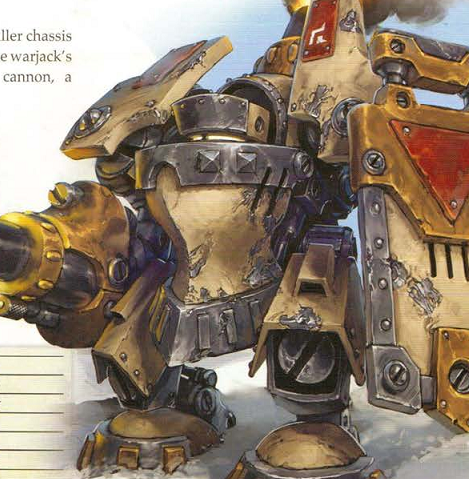
The Ghordson Avalancher is nearly 12 feet tall and over 10 tons. As the Rhulic clans become more concerned with their neighbors' wars, they've needed more powerful weapons. Most warjacks used by Rhulic mercenaries were meant for industrial as well as military use, but the Avalancher is a dedicated combat machine. The Ghordsons turned to their workhouse Driller chassis as its basis, arming it with the potent avalanche cannon, which can punch through just about any armor at a great range, and a giant assault shield to hit people with. The Avalancher is a mobile artillery platform for battlefield control and strategic advantage in mountain passes. Its shells detonate on impact, and for enemies forced to cluster together, it is devastating, especially on the mountain roads of Rhul. The cannon is even used between battles to create controlled rock and ice slides to clear roads. Its uncomplicated weapons make it a favorite among mercs, wh ovalue the ability to carry out field repairs.
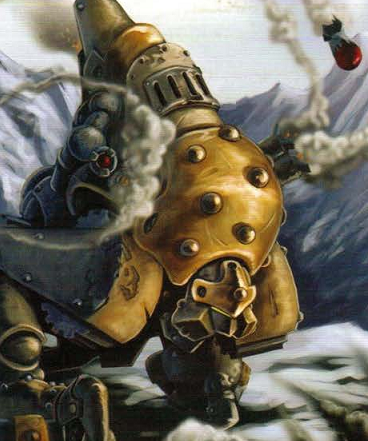
The Ghordson Basher is just over 11 and a half feet tall and 8 and a half tons. It was meant for utility and durability, hauling loads for construction and mining. It uses a very powerful engine on a sturdy chassis to haul huge loads of cargo. When unloaded, it's very fast for a heavy laborjack, and uses that to deliver incredible concussive force. It is further augmented with powerful short-range grenades to soften targets up before it rams into them. It is heavily armored for survival in tunnel cave-ins or battle, with plating several inches thick that makes for both armor and weapon.
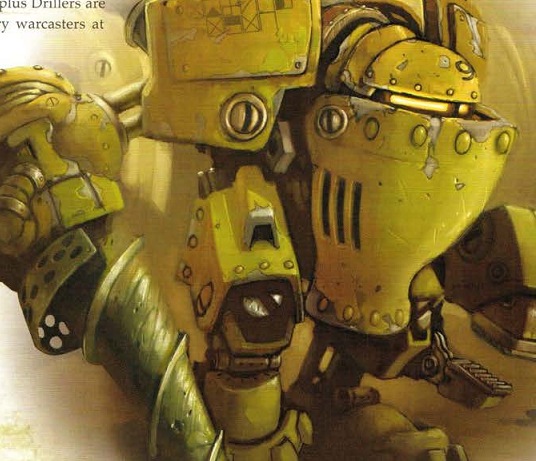
The Ghordson Driller is 11 and a half feet tall and 9 and a half tons. It's been in production for over 160 years, and is widely seen as the best industrial laborjack ever made. It benefits heavily from the multipurpose approach the Rhulfolk take to engineering, both a tool and a weapon. Surplus Drillers are often sold to mercenaries at substantial discount. Its main industrial purpose is mining, using its drill to break heavy walls and embankments and its armor to witnstand falling stone and collapses. This also makes it devastating in combat, able to shrug off attacks before delivering its own. Its immense rock drill can bore through any armor, and its grappler claw, normally meant for clearing rubble, can hold targets still long enough to bring the drill to bear. The Driller is a monster, efficient and tireless.
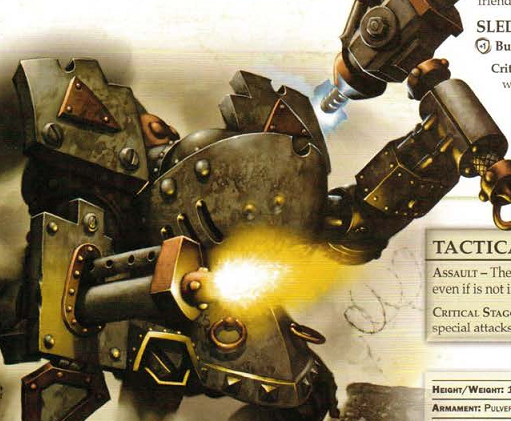
The Wroughthammer Rockram is 11 and a half feet tall and nearly 10 tons. It is immensely practical, designed by the Wroughthammer clan, allies of the Ghordsons, off an unarmed Ghordson chassis. As with all Rhulic 'jacks, it is utilitarian, using its sledge cannon to crack rock walls in mines and its mechanikal pulverizer hammer to crush stone. In battle, these become weapons, tearing armor apart and sending foes reeling. They're short range, but crippling, even for warjacks. The Rockram is slow, but steady and devastating.
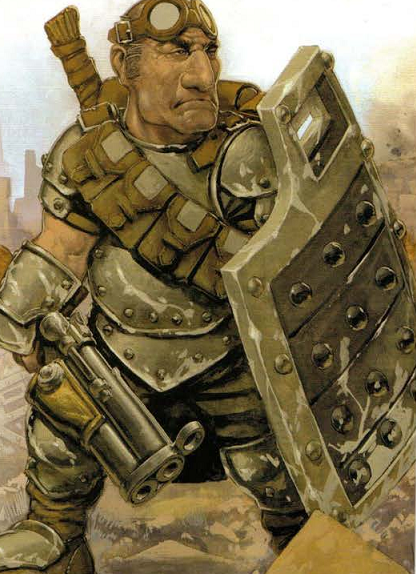
Hammerfall High Shield Gun Corps will work for Cygnar or Khador. They are trained rifleman from the fortress of Hammerfall in Rhul. They hire out in times of war to fuel Rhulic coffers, using their training and discipline to bolster army forces. They are heavily armored and well-equipped, fielding in crack units of riflemen meant to maneuver in formation. Their shields hold up their heavy dual-barrel war-rifles, with slots used like arrow slits on battlements. Their real strength is their discipline, positioning themselves to fire over and between their comrades with ease. They are trained as 'jack marshals as well, and their sergeants sometimes use warjacks to supplement their firepower...for a price.
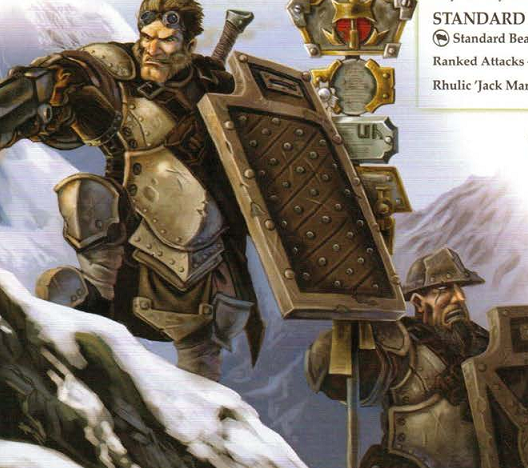
The Gun Corps are sometimes led by a Hammerfall High Shield Officer and Standard . The captains of Hammerfall are superb leaders, each a master of formation and drills. Any client lucky enough to hire a Gun Corps company led by a captain is assured of flawless performance, no matter what. The officers are responsible for the defense of the Rhulic border and the mountains of Rhul, using wide patrols and warjacks to deal with foreign incursions or hostile wildlife. They can be found afield when hired or defending Searforge escorts. Ranking High Shield members responsible for recording contracts and history assist these officers, and these soldiers are also charged with carrying company standards - poles supporting disks inscribed with the company's legal status and history. This inspires the unit as well as advertising its successes.
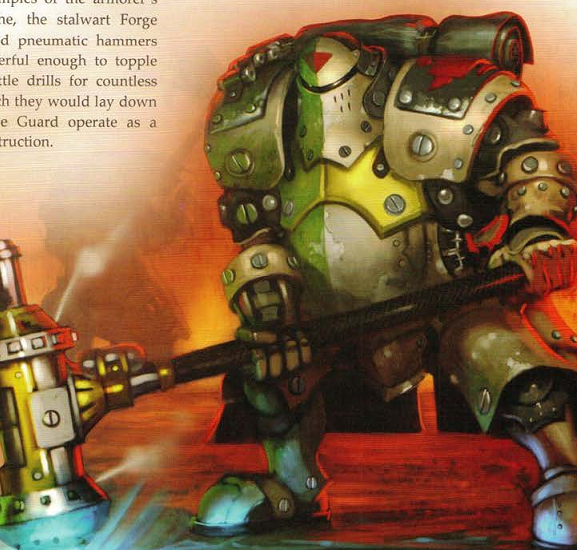
The Horgenhold Forge Guard will work for Cygnar and the Protectorate of Menoth. They march to war in armor so well made that it seems to be a different material than lesser armor. The Forge Guard use immense pneumatic hammers to topple even warjacks, and coordinated battle drills to get them loyal to each other. They are a synchronized machine of death. Several of the clans of Horgenhold had kin and friends in Llael that died in the invasion, and they'd prefer the occupiers left and if Rhulic trade didn't pass through Khador. As a result, Horhenhold warriors refuse to work for Khador and take Protectorate coin. They bear the name of their ancestral kinssmen who stopped the Orgoth from entering Rhul when few others could defeat them. That theyh ave joined the wars of humans has not gone unnoticed, and they have more job offers than they can handle already.
Next time: I mine in my mine and what's mine is mine.
Forces of Warmachine: Mercenaries
Original SA post Forces of Warmachine: Mercenaries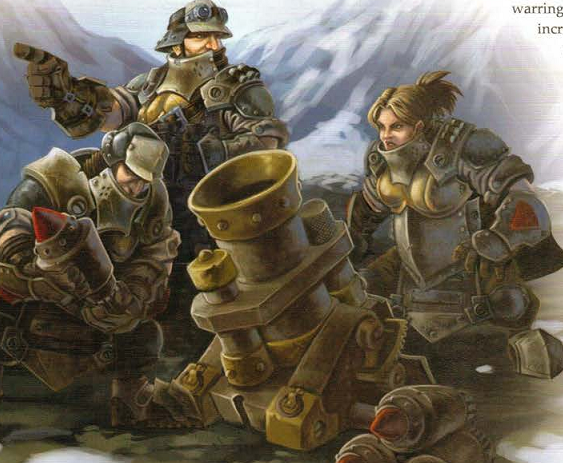
The Horgenhold Artillery Corps will work for Cygnar and the Protectorate of Menoth. For centuries, the dwarves of Horgenhold have used cannons to defend the mountain passes into Rhul, obliterating foes from a surprising distance. Their mortar shells can also be fired indirectly, giving them immense battlefield control. Escalated war and mysterious attacks on western Rhulic villages have prompted some patrols to carry increasingly heavy wepaons, and the artillery corps of Horgenhold use portable mortars which can be fired with great speed. Even under fire, they can accurately gauge targets to within feet. Rhul's artillery has existed for a long time, but it's only recently that outsiders started using artillery for siege. The Rhulic Moot has traditionally not liked mercenary work, but in recent years their profits are hard to ignore, and provisions now allow mercenaries to equip themselves with siege cannons and other such weapons. They claim neutrality, but many clan lords worry that entanglement in human battles will bring war to Rhul.
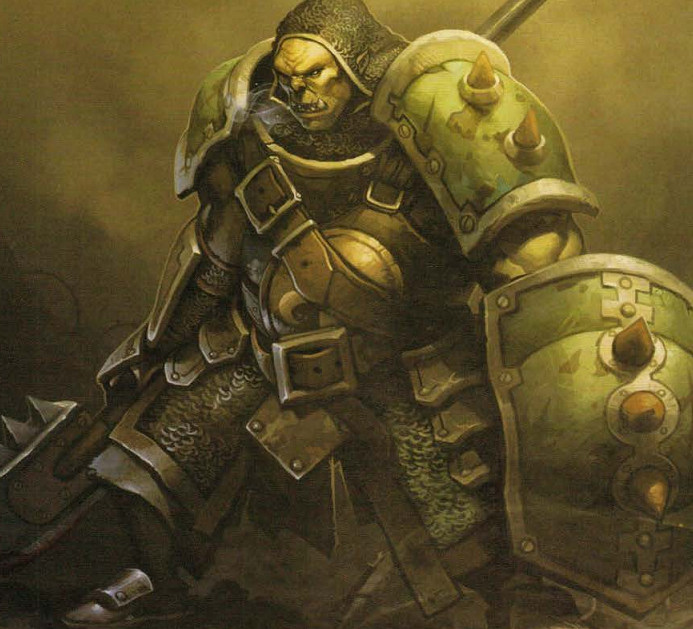
An Ogrun Bokur will work for Cryx, Cygnar or Khador. Young ogrun who have yet to bond with a korune often go to great lengths to impress potential masters. They spend years outside their homelands, forging a reputation. Bokur means 'unsworn,' and they attach themselves to important people across the continent to prove their skill. It's a time-honored tradition for the period before they swear their lives to a korune, and they take on temporary clients, protecting them as long as agreed on or until they die. From the black ogrun of the Scharde who protect necromancers to the Rhulic ogrun who protect dwarves, the bokur stand between their clients and harm. While they are bokur, they exist to prove their readiness to be fanatically loyal bodyguards. On returning to their people, they share tales of the risks they took, and the glory they get is directly related to the danger they suffered. Those with scars are noble, those that lost limbs are heroes. The bokur code is unassailable, and few would ever exaggerate their deeds, let alone lie. Those rare ogrun caught lying are exiled. This also hpapens to bokur that shame themselves and their families by serving dishonorable masters. An ogrun whose noble korune is slain usually has little trouble finding a new one, but those under a weak or despised korune have few options - just look at Gudrun the Wanderer. Whether using their shields or immense pole arms, they will fight in any situation, enjoying battle. Few can survive their blows, and they'll take any risk to show their commitment. Bokur that survive often become more conservative but more dangerous fighters. Many recently have begun collecting trophies or tattoos to show their successes. It's not popular among elders, who expect you to remember every detail of your glories, but young bokur are increasingly enjoying these visual records of their lives.
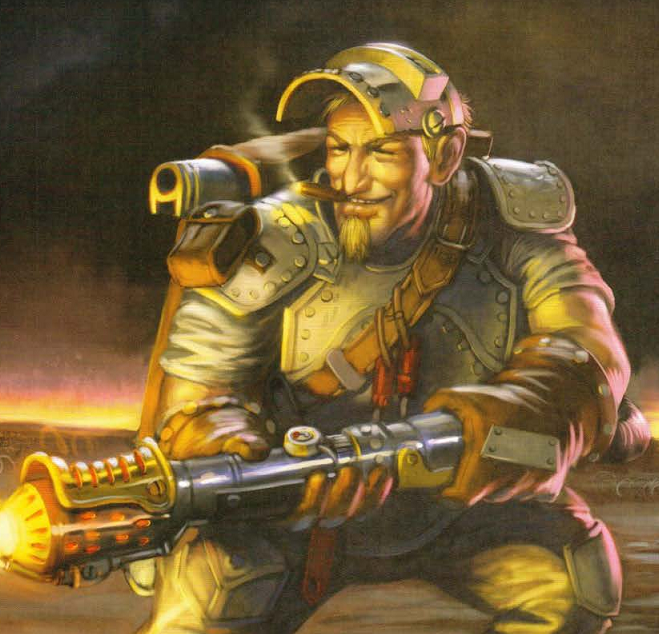
Thor Steinhammer will work for Cygnar or Khador. He's first to admit he's a disappointment to his family, but he laughs at it. After all, he's one of the best paid mercenaries in Immoren, his talents commanding more coin than any duelist, rifleman or soldier. After all, he can maintain warjacks. The Steinhammer clan is sworn to defend Groddenguard against the horrors of the north, especially the dragon Scylfangen. Thor's family expected him, second of eight sons, to become a warrior and help defend. Instead, he was fascinated by mechanika and the workings of Rhulic 'jacks. He didn't care that it'd estrange him from his clan - he worked in the mines, learning to repair and work with the many 'jacks of Rhul. Gorten Grundback introduced him to mercenary work on a trip home to resupply, when Steinhammer saved him a lot of money by repairing two scrapped warjacks he was going to sell for salvage. Gorten saw the potential there, using his coin and stories to impress Thor. Thor gladly left the Glass Peaks to seek his fortune, never looking back. He enjoys working with other Rhulfolk, but will also happily work with humans. He's followed Gorten's advice and avoided work with the Protectorate or Cryx, but he'll otherwise work for anyone. His reputation with the Searforge Commission has made it easy for him to get the components needed to keep 'jacks running, too. On top of his skill with a wrench, he's great at squeezing performance out of the machines he commands, and many mistake him for an actual warcaster. He isn't, and he's proud of the fact that his skill is just simple knowhow and some finesse.
The End
Next up: Skorne, as my book's finally been found.
Forces of Hordes: Skorne
Original SA post Forces of Hordes: Skorne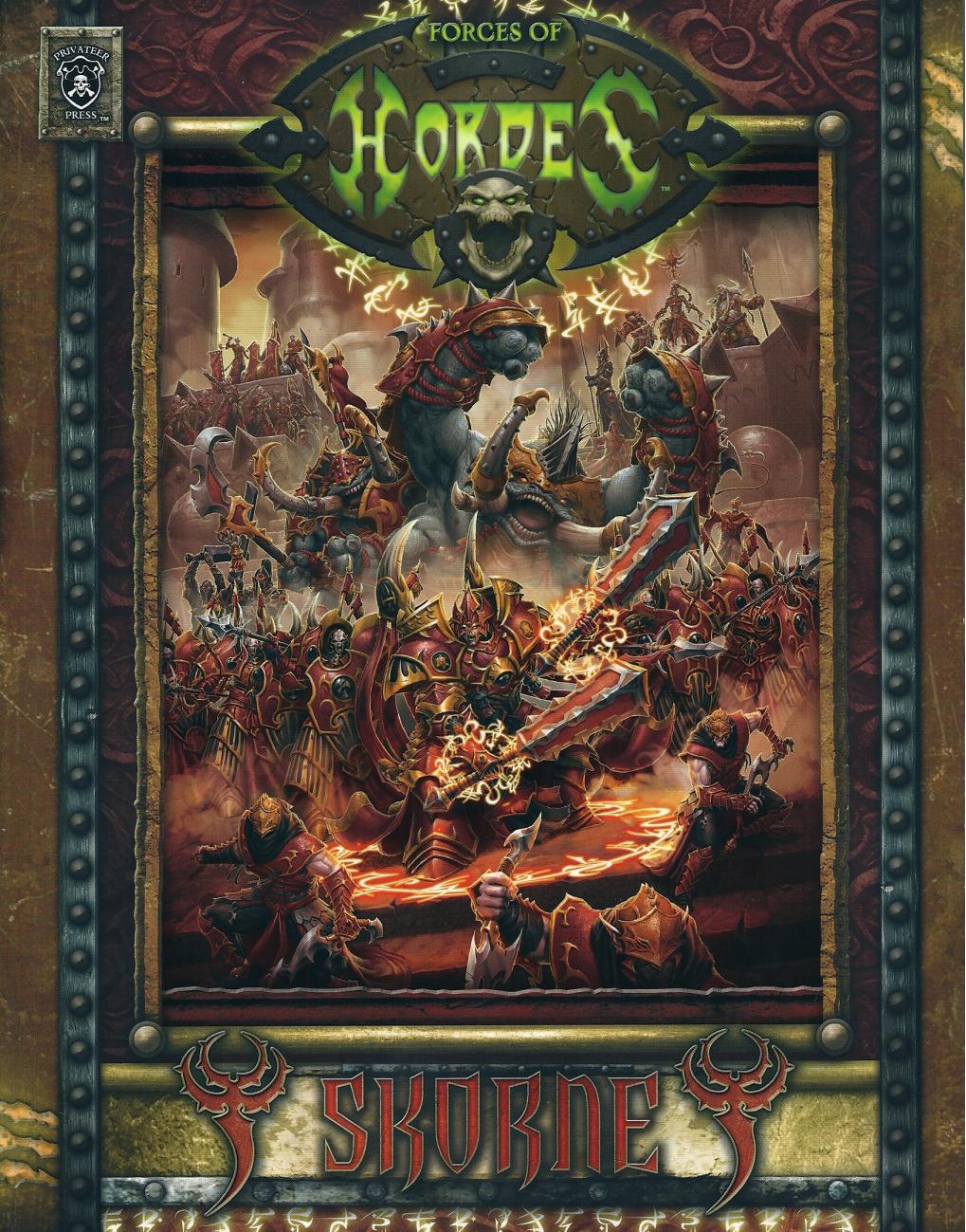
While the Skorne are new to western Immoren, they are one of the most ancient civilizations on the continent. Their culture developed away from the human nations, following millenia-old philosophies with distinct ideas of honor, sacrifice and morality. For them, the conquest of the west is the natural and inevitable outcome of thousands of years of destiny. Though once divided, recent events have united them as an empire with an immense army. They are fundamentally shaped by their endurance of terrible destruction and suffering, beginning with the destruction of the Empire of Lyoss and the catastrophe that consumed the east. Once nomads, they established a more permanent civilization with a backdrop of chaos and misfortune, which they learned to thrive on, rising to become the dominant civilization of eastern Immoren. Their ascetic warlords have long dominated them, as the warrior caste subjugated the scholars and workers. Their tribal culture relied on enslaving foes and beasts as labor, and it was from the early beast-conditioning techniques that the warrior-philosopher Voskune first discovered the art of mortitheurgy, the magical power that manipulates the energies released by cutting flesh, spilling blood and the transition of death. These arts allowed both skorne and beasts to be controlled, conditioned and turned into weapons.
Philosophy was vital to the evolution of the skorne warriors, particularly ancestor worship. The skorne do not have gods, looking instead to their ancestors to be emulated and respected.This legacy is as close as most skorne can get to immortality - they do not, they know, endure past death except in memory. The skorne have no knowledge of Urcaen, believing that after death, their souls simply enter a vast and hellish Void. To avoid this, the skorne use exaltation, a holy reward for the strongest and best who die in battle. These great warriors are preserved in sacral stones so that their families can access their wisdom in the centuries to follow. In this state, they communicate from beyond death to the extoller caste. All skorne seek to become exalted, pushing them to great courage in battle that they may earn a place among their ancestors. The core of skorne warrior tradition was laid down by Dominar Vuxoris, who would become the First Exalted. His work became the hoksune code, which states that a warrior lives only by risking their life in combat. Outside war, they are a shadow, their spirit dying. They regain their vitality only in battle. Those who follow the hoksune welcome death as a chance for glory and perfection in combat. Greater glory comes from close combat and striking the killing blow, so those trained to kill at a distance are less respected. However, all hoksune adherents seek perfection with their chosen weapons via constant training, sparring and combat.
The largest skorne tribes coalesced into the houses, and some houses can trace their lineage back to the founding of Malphas, the first skorne city. Most retained their old tribal rivalries, and every house sought to arm and train a large force to protect themselves and war on their foes. These house armies became the basis for the modern cohorts. The warrior caste divided itself basedo n weapon and fighting style, eventually narrowing into the three modern military disciplines - the Cataphracts, Praetorians and Venators. Those who fail to become Praetorians are instead made Hestatians, the lowest of the warriors, relegated to guard and militia duty. All skorne are born either as members or servants of a specific house, learning their place within it from birth. A house tyrant or dominar has total control over what their house members do, so long as they obey their dominar or archdominar and follow the codes of skorne honor.
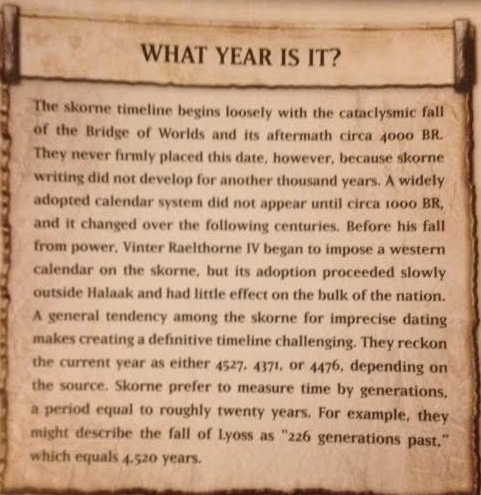
Many houses are hundreds or thousands of years old and have large, fortified palaces in the skorne heartlands. These compounds can become truly immense, with ancestral shrines, huge armies and places of training and meditation. The imperial house, Balaash, holds an immense store of seized sacral stones from defeated houses, overseen by Supreme Aptimus Zaal. Lesser houses have their own sacral stone stores. Before the founding of the empire, wars between houses were common, but the destruction was limited due to the goal of each side being to seize land and property as well as to enslave the other side. It was common for there to be little loss of life except in the warrior caste, as the slaves changed hands. However, skorne history is full of major wars between huge house alliances that reshaped society and destroyed cities. Since the wars of unification, fighting between houses is much reduced. Traditionally, it has been hard for the skorne to work together across house divides, but the reforms of the Conqueror have made it much easier.
Tasks that fall below the warriors are for the worker caste, including trade, long distance communication, construction, food production and distribution of goods. While they are essential, there is no glory for the workers, and warriors look on them with contempt. Almost all houses have a large population of enslaved workers and servants, who are sometimes used for mortitheurgical experimentation. Skorne consider slavery just a fact of life, either applied to themselves or outsiders. Slaves stand below the worker caste, but the slave caste remains vital to skorne infrastructure. The slaves can earn their freedom via prolonged service, but the conquered generation generally remains enslaved until death. Their offspring have a chance at freedom if adopted into their new house, and the decrease of house warfare has made slaves harder to get recently. This could well impact the imperial economy, and some of the eastern houses resent House Balaash's apparent monopoly on slaves from the western conquest.
As the skorne became agricultural, they rapidly advanced the arts of beast handling and mortitheurgy. Over the centuries, the paingivers experimented on many creatures, mastering anatomy, pain and mortitheurgy. Permanent settlements allowed mortitheurges to study more and more precisely how to use their spiritual arts, and the arcane castes were created. The importance of ancestor worship allowed the extollers to rise to prominence as the guardians of the ancestors and choosers of the exalted, granting them power normally limited to the warrior caste. Different philosophical schools among the extollers revere different exalted ancestors, making up many faiths and cults within the skorne. The ancestors can interact with the living only via the extollers, who spend their lives learning to contact the dead. It is disrespectful to bother the exalted without good reason. Extoller power is tied to mortitheurgy, which all dominars and tyrants must study. They master magic by a mix of philosophy and anatomical knowledge, using the innate power of blood and tissue. While it is superficially similar to necromancy, mortitheurges do not animate the dead - rather, they preserve life beyond the natural bounds of the body. They can fuel their magic with their own pain as well as the life force of others.
Paingivers have traditionally been removed from house politics, rising mostly from the lower castes due to their need to forsake house ties - a sacrifice the privileged generally will not make. In rural areas, they often come from trackers and beast tamers, while urban paingivers are recruited from clever, talanted and dexterous youths. The senior paingivers are highly selective, never inducting anyone they don't believe can rise above the caste of their birth, so numbers are limited. Paingivers must embrace the philosophy of the ancestor Morkaash before they are initiated, including a test of endurance and fasting. Once brought into the ranks, they disavow their house loyalties in favor of the paingiver order, wearing distinctive masks to show their facelessness and isolation. Without loyalties, they can barter a better price for their services. They are uniquely unaffiliated in skorne society and very much in demand. They operate as spies and information gatherers, assassins, beast tamers and trainers and interrogators. Most specialize in just one or two of these roles. Their independence has shifted with the establishment of the empire, and now all serve Lord Assassin Morghoul first, and others only as long as it does not conflict with their duties.
It was not until the coming of the human Vinter Raelthorne IV that the Skorne Empire was established. The Conqueror used his strength to convince the skorne leaders he was one of their ancestors reborn, and while his reign was brief, he introduced sweeping societal reforms, particularly around organization and war. Following his recent deposition by Supreme Archdomina Makeda of House Balaash, she has taken the reins. She is highly traditional, but willing to continue what Vinter started with his military reforms so that she can conquer the west. The skorne have been transformed from a nation of feuding houses to a unified empire, and the houses have been required to support the Army of the Western Reaches, forging them into true weapons of conquest. Though Vinter's true intent was not to plunder the west as he'd said, his legacy remains. The empire has been divided into distinct regions, called tors, with leaders appointed to govern them and ensure the houses in them contribute properly. His greatest achievement might be the creation of a military that both respects skorne traditions and preserves their philosophies while supporting the logistics of thousands of soldiers. However, some of his changes were not embraced enthusiastically. He expanded the concept of a house absorbing another to suggest that all houses had been conquered by the emperor, and so he had the right to reallocate and reform houses as needed for the military hierarchy. This also made it hard to organize insurrection, as the houses were mixed in the army and each tyrant was required to send a tithe of warriors. He also allowed skorne to rise through the ranks, even to tyrant rank, with far greater speed than was traditionally possible, with new tyrants allowed to use their subordinates as the core of a new house.
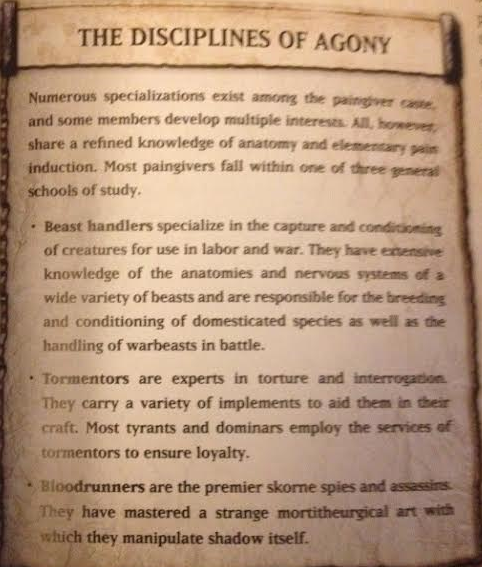
Every skorne is very aware of their caste and relation with those around them. All warriors are members of the same caste, but there are subtle yet important distinctions. Because there are so many warriors, many perform tasks that would normally be the job of lower castes, day to day. Many, for example, learn to make armor or weapons. How much of this they can do without losing status is one of the many subtleties of caste interactions. Among the house armies of the east, where workers and slaves are more numerous, there is less need for warriros to do these things, but this changes considerably when lwoer caste support is minimal, such as in the Army of the Western Reaches. Praetorians are the backbone of the skorne military, by which all other warriors are measured. They focus on close combat with many traditional weapons with distinct roles. These include the pikes and shields of the karax, the cavalry spears of the mounted ferox and the dual blades of the swordsmen. There is a long rivalry between Praetorians and Cataphracts about which is most true to the hoksune code. Praetorians hold that their emphasis on first strikes, speed and precision most closely represents the ideals of Vuxoris, while the Cataphracts are most universally respected for their resilience and stamina.
Only the largest and most powerful skorne can become Cataphracts, and only the wealthiest houses can afford to equip and maintain their armor and weapons. Many of the most devoted hoksune adherents are Cataphracts, who have a reputation for stoicism. They are trained to endure extreme privation in any environment, and they embody the skorne ideals of life and death. They are epxected to be in the most dangerous parts of battle and revel in the chance at glorious death. Many exalted were once Cataphracts in life, possibly including Vuxoris. Venators, on the other hand, train to fight at range with reivers and siege weapons, so they are a lower part of the caste. Their betters view them with disdain, as ranged combat furhters them from the enemy when they die. In past centuries, they used javelins and slings, mostly, but their modern armament takes a lot of skill and training. They are now integral to skorne strategy, and this has gained them a grudging respect, particularly in the Army of the Westenr Reaches. They are never candidates for full exaltation, but can become honored companions thanks to ancestral guardians.
Not all skorne combatants are of the warrior caste, however. Specialists from worker, extoller and paingiver castes are also required. All skorne value the extollers in battle, as they can preserve the spirits of the dead. Their simple appearance can raise morale, and few tyrants fail to take advantage of that. Because extollers rarely judge philosophers or scholars worthy of preservation, they are of great standing in the worker caste and even house lords respect them for their ability to talk to the ancestors. They also persuade ancestors to accompany them into battle in carefully made vessels, allowing the exalted to become potent ancestral guardians. All exalted yearn to fight once more, and these guardians can also serve as receptacles for the skorne that die near them, giving the extollers time to decide if they are worthy for full exaltation or the lesser honor of becoming companions to the exalted. Paingivers are also vital specialists, the most common in the army. While warlocks can command beasts directly, they rely a lot on the beast handlers to maximize their destruction, as the best beast handlers can push beasts to their limits without breaking them utterly, and when it's all right for a beast to go berserk.
Next time: Torture samurai!
Forces of Hordes: Skorne
Original SA post Forces of Hordes: SkorneBefore the military reformations, 'cohort' and 'army' were synonyms, and tyrants still refer to their soldiers as a house army sometimes. Dominars with multiple cohorts referred to their forces as a sabaoth, a great host. Since the reforms, an army is specifically a large regional force of multiple sabaoths commanded by an archdominar. An army protects each tor, and sabaoths are army divisions, commanded by dominars or, more rarely, lord tyrants. Beneath them are cohorts commanded by tyrants and lord tyrants. There are six tors in the eastern empire and so six armies to protect the borders, garrisons and settlements. The three interior tors have the highest populations and political power. First among them in wealth and power is Tor-Halaak, which includes the capital, also Halaak, which is overseen by Archdominar Korinvaas. Southeastern Tor-Kademe os the most fertile land in the empire, producing most of its food, and is held by Archdominar Jolxal of House Murkaat. This area includes the Ocean of Grass, where most of the imperial titans are from, and where skorne like Dominar Rasheth of House Telarr made their fortunes hunting. The third major interior tor is Tor-Malphas, named for the first skorne city, deep in the Shroudfall Mountains. It is ruled by Archdominar Lorketh of House Jakaar.
The three peripheral tors are more barren and sparse. The Northern Marches, ruled by Dominar Leskaar of House Kursorik, have the smallest population and army. Tor-Sarikaan in the east is ruled by Archdominar Hekrask of House Zhuron, and Tor-Sortaan in the west is ruled by Archdominar Jalkier of House Muskaar. Each of these leaders has an army, but their cohorts have been reduced in both size and number due to the laws requiring contribution to the Army of the Western Reaches. This helps prevent rebellion while the supreme archdomina is away. The primary agency keeping the eastern tors obedient is the unified paingiver caste under Lord Tormentor Morghoul. Many paingivers have joined the western army, but many more still remain in the east to protect the empire. They are assisted by the Bonded Porters, established by Vinter to ensure supplies flowed across the empire. While they are individually powerless workers, they are vital to logistics and protected from interference with harsh legal punishments. They have adapted well to the supreme archdomina even though they are much more prone to internal corruption than the paingivers. As long as supplies flow, internal corruption is largely overlooked.
The skorne traditionally do not consider themselves a united people, looking only to their own tyrants for direction. The many houses are prone to feuding, and it takes a really extraordinary person to maintain power over these rivalries. The supreme archdomina, however, is very powerful thanks to the loyalty of Lord Assassin Morghoul. House Balaash also maintains its estates near the capital, so it has a lot of influence there. Dominar Lunzaal of Balaash, a respected warrior and relative of Makeda, has been promoted ot maintain these estates and wield the Balaash political power in the capital while she is absent.
The Army of the Western Reaches is the invasion force of the skorne, and all houses must contribute to it. It is led directly by Makeda, and is the largest and most effective force the skorne have ever had, especially thanks t Vinter's organizational expertise. They are established in garrisons and forts in the Bloodstone Marches, with a supply chain crossing the desert back to the empire. This grows more secure by the day, though any passage across the wastes is still challenging. Within the hierarchy of empire, the Western Reaches are equivalent to a seventh tor. Until Makeda took power, she was the archdomina in control of the army and the region. This is larger than any other tor - in fact, it's technically larger than the empire itself. Most of it, however, is unsettled territory that is a geographical barrier between the Abyssal Fortress and the western territories. It remains to be seen if Makeda will appoint an archdominar to rule it - the need isn't pressing, as she leads from the front rather than from the Abyssal Fortress as Vinter did. After defeating his forces, she immediatrely headed back west to keep conquering, sending Morghoul home to Halaak to seize power over the painivers and turn them into a tool of the state.
Vinter integrated most of the forces he was given into mixed cohorts wearing Balaash colors in an effort to break house loyalties. Makeda retains this more discriminately, allowing favored tyrants and dominars to retain their house colors and standards, as long as they put a token in Balaash vermillion on. Some of her dominars have reverted to house colors without permission as a display of passive resistance to her rise. She does, however, retain the power to reform and reshape cohorts as she likes. The Abyssal Fortress has been a vital base and training center for the Army of the Western REaches, particularly before it came further west. Its elite black-armored garrison was responsible for protecting Vinter personally. Makeda put some of her most loyal subordinates in that honor guard, intending for them to aid her overthrow, but Vinter noticed it. He killed them all personally, removing many of Makeda's top dominars, lord tyrants and tyrants. She's promoted worthy successors, but it'll be some time before her command structure fully recovers.
The Army is divided into four sabaoths, and the majority of Makeda's best are in the Southern Bloodstone sabaoth under Dominar Kaartos, who is her blood relative. The ten cohorts under him are the largest and best fortified, as well as the most actively engaged near the Cygnaran border and the Protectorate of Menoth. The second-largest, the Northern Bloodstone sabaoth, serves under Dominar Xarkorn, newly promoted after Vinter killed his predecessor. It focuses on Scarleforth Lake, the Castle of the Keys and several hill forts. While the dominar is nominally in charge, he is heavily influenced by Lord Tyrant Hexeris of House Kershon, who was left in charge of the western settlements while Makeda marched on the Abyssal Fortress. He is quite powerful and controls all the sabaoth's occultists alongside Supreme Aptimus Zaal and his extollers. The Bloodstone Desert sabaoth is less involved in the conquest, focusing on garrisoning the fortress between the Marches and the eastern empire, with two entire cohorts at the Abyssal Fortress led by trusted senior officers and Dominar Jelkaxis, who was promoted to secure communications after valor against Cygnar. The House Telarr cohorts recently joined hte Army under Dominar Rasheth to make up the newest and final sabaoth. Makeda has, for now, allowed them to remain a single-house sabaoth. Many lesser tyrants resent this, but they fail to understand the importance of House Telarr and its many warbeasts.

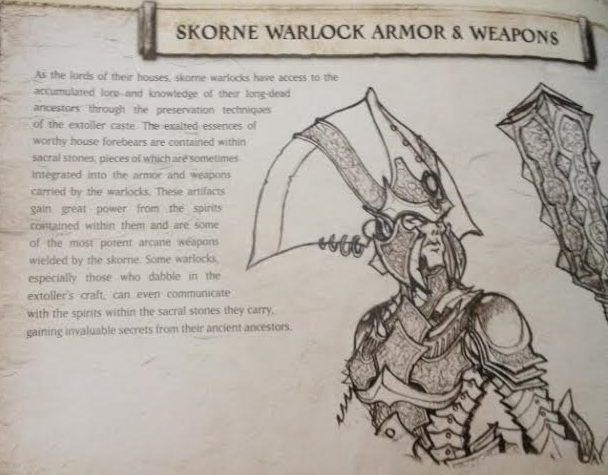
Unlike other forces, skorne warlocks gain their power via mortitheurgy rather than any inborn talent. This art combines anatomical knowledge with a deep understanding of the magical might of flesh and blood. All skorne warlocks are mortitheurges, as are most ranking skorne warriors, but there is a deep divide betwen those who use it just for power and those who delve deeper. The former are some of the more militaristic warlocks of the empire, using their magic to enhance their already impressive skills, while the latter are more mystical, studying the power of the living spirit. Some join the extollers, specializing in a similar role as priests in human society. To do this, they must pluck out an eye and replace it with a sensitive crystal, allowing them to see soul energies. To become a master of a house, a skorne must have sufficient mortitheurgical might to become a warlock, as that power is essential to dominating others. Most skorne warlocks are dominars or tyrants for this reason, commanding their own house levies on top of any army position. They are vital to the western expansion, often making the difference between victory and defeat, and they are nearly fearless on the battlefield. Often, they prove worthy of exaltation when they die, as well.
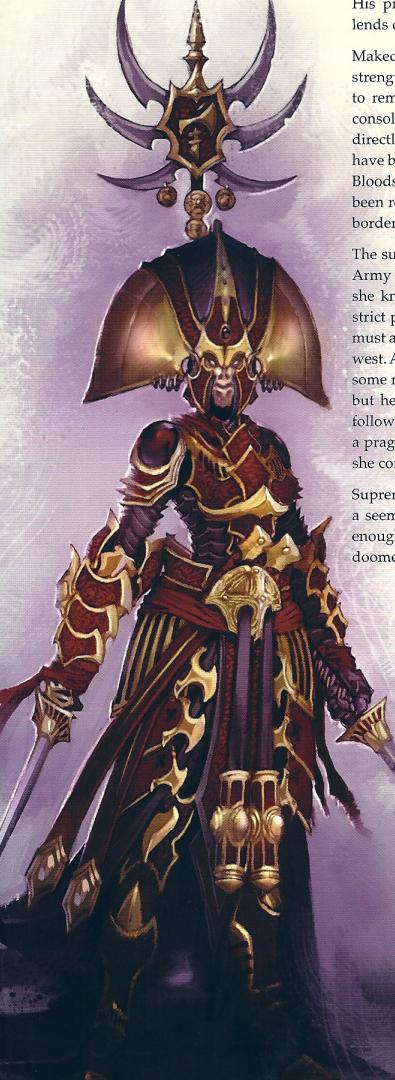
Supreme Archdomina Makeda is Epic Makeda. She has overthrown Vinter Raelthorne and seized control of the Skorne Empire, unifying them as never before. Her will is strong enough to defeat anyone. Not long ago, her devotion to Vinter was absolute, and she believed him to be the Reborn. Lord Assaassin Morghoul revealed to her his deception, and at first she would not believe it, until she was ordered to attack Fort Falk and watch her soldiers die meaninglessly. She didn't mind their deaths for victory, but there was no reason for this. The defeat was all the worse for the knowledge that she'd been ready to attack Eastwall, but was ordered not to without explanation. The only reason could be that Vinter wanted to deliberately weaken the army. Makeda was enraged. With Morghoul's help, she rooted out Vinter's loyalists, replacing them with her own loyal vassals. She confronted Vinter personally, ending his reign. He escaped by killing a host of her loyal tyrants, but she took the Abyssal Fortress and the Skorne Empire. Since then, she has laid the foundation for a new nation. Once the bridges connecting east and west were scure, she sent Morhoul back to Halaak to deliver her will and prevent feuding. While many house lords were uncomfortable with the coup, thery remembered the lessons of Morghoul during the Second Unification, and did not resist. Makeda has learned a lot from Vinter, and she intends to remake the skorne around the core of their society. She has remained in the west to oversee the invasion and solidify her hold on the Bloodstone Desert. Under her orders, supply lines have been reinforced and new forts built. She has already begun to reshape the Army of the Western Reaches into something stronger. She adheres to the strictest philosophies of the skorne, but understands the need to adapt and expand. Her focus on combined arms has met resistance from the hoksune adherents, but her victories cannot be denied. Even so, she is followed more out of fear than loyalty. She is a pragmatist who understands that the skorne only respect strength, so she is strong. She has accepted an apparently impossible goal, but she bears it well. Her gimmick is mobility, leadership and buffing, and her feat buffs attacks from her army.
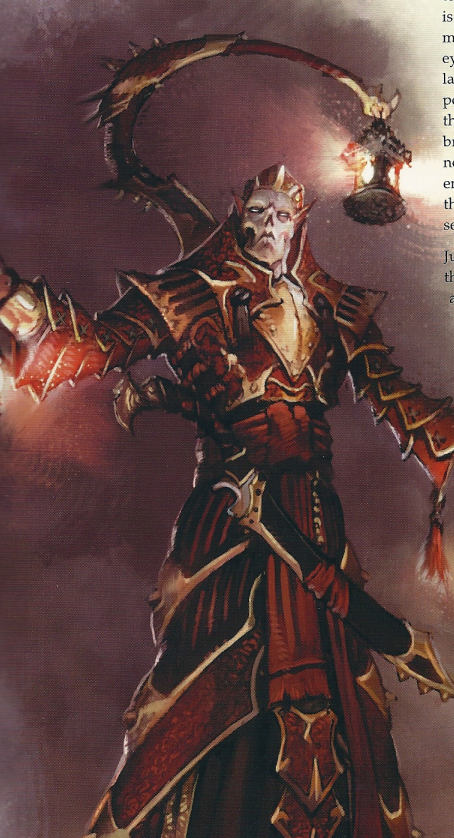
Void Seer Mordikaar is a walking contradiction whose existence casts doubt on deeply held skorne beliefs. He reminds Makeda's followers that nothing is impossible for her army, having defied even death. He should not exist - he died, and his soul went into the Void. By sheer will and knowledge, he pulled himself back to life. His heart still beats, his lunges still breathe. He is alive, not some undead creature like the genzouls and kovaas. Only he knows how it was done. He is tainted by the power of death, and he is surrounded by a wound in reality, as deranged Void spirits slip through to haunt him. He deals with them easily, banishing or binding them. Before his death, he was a respected but inscrutable mortitheurge known mostly to other mortitheurge masters. He studied in the ruins of Malphas, investgating even an obscure heresy that claimed Voskune, Ishoul and Kaleed, the Self-Exalted Trinity, never fell into the Void but existed beyond death by will alone. The heresy was often expunged by Extollers, but proved tenacious among certain loremasters in Malphas, who preserved scrolls that contradicted traditional history. Mordikaar never found the Trinity, but his research took him in a new direction - exaltation without sacral stones, which he believes are a crutch. He is determined to find a better solution to mortality than crystal eyes. He uses an arcane latern to focus his power and reveal the spirits around him, isolating the nature of the light manifested by spiritual energy. His philosophy is antithetical to that of extollers, but it works. Just as Mordikaar will not speak of the events that led to his death, he also will not speak about why he joined the Army. He works with Tyrant Hexeris, who shares his interests, but he is very hostile towards Supreme Aptimus Zaal. Makeda allows his eccentricities so long as their power helps the skorne. His gimmick is playing around with revival and ghost/undead shenanigans. His feat buffs his allies defensively.
Next time: The spikiest god damn armor.
Forces of Hordes: Skorne
Original SA post Forces of Hordes: Skorne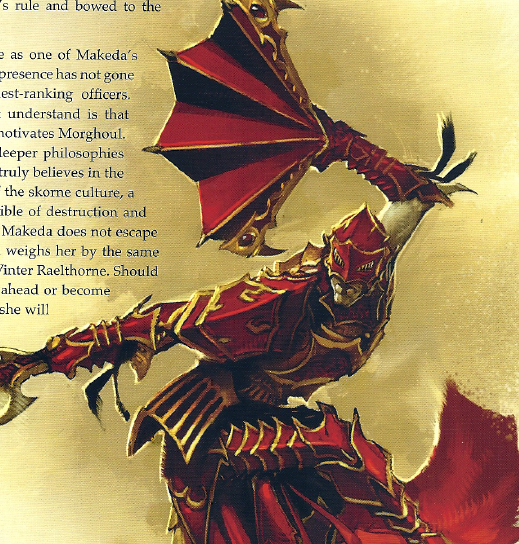
Lord Assassin Morghoul is Epic Morghoul. He has become vital to the new skorne culture. He has, over his life, served many masters, and he feels no regret for abandoning Vinter Raelthorne. Instead, he has embraced service to Makeda, though few would suspect how vital he is in realizing her vision. His every ability is used to transform the Skorne Empire. He approaches his job systematically, seizing control of the paingivers by taking Makeda's offer to turn them into a true united force. Some of the paingivers resisted, but he knew consolidation might need some death. He forged them into a weapon for him to use, and Makeda gave him another weapon in gratitude: the Balaash relic blade Mercy. He volunteered to return east, to solidify his control over all paingivers - especially the notorious Master Tormentor Jyvaash Komorn, leader of the Bloodrunners. Komorn named him a heretic...so Morghoul killed him and all of his allies, seizing Komorn's Fan of Shadows. He took control of the surviving Bloodrunners and began to subjugate the capital from the shadows. He is one of Makeda's most vital and trusted advisors, but what even she does not know is that neither loyalty nor ambition drive him. Rather, he is focused on the deepest philosophies and the destiny of the skorne. He is a true believer, feeling that a civilization forged in hardship must triumph, and even Makeda does not escape his scrutiny. He weighs her by the same standards he applied to Vinter, and if she is found wanting, he will kill her. His gimmick is assassination and his magic enables that with buffs. His feat improves his allies' defenses.
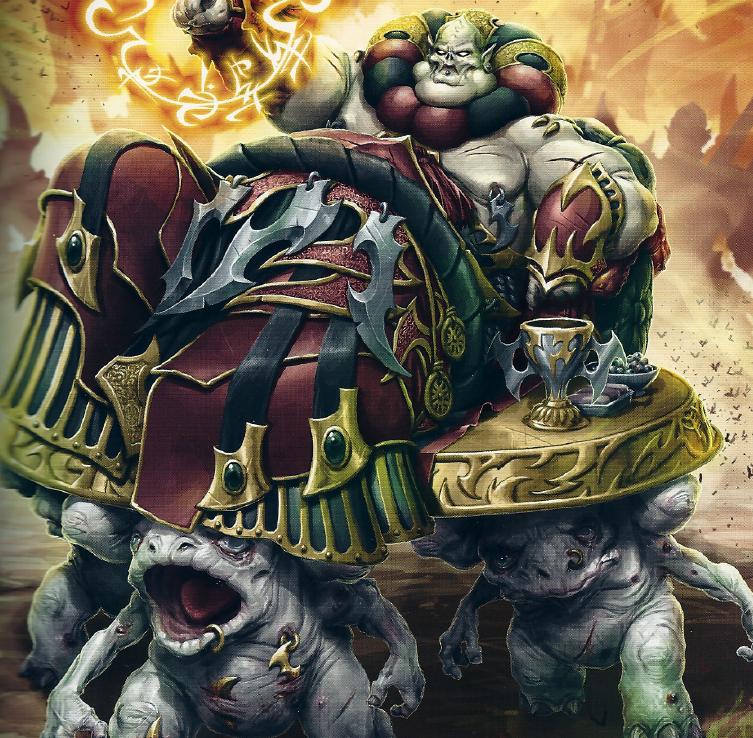
Dominar Rasheth has caused an unexpected shift in politics by coming west. He is both feared and loathed, and no one really trusts him or his claims of loyalty, but he is a master mortitheurge. He is a merchant lord, using the power of corruption to scourge the western races and foul the land with his malevolent spirits. He has no respect for hoksune at all, and is far too lazy to exert himself physically, lying on a lectica to do his magic. While most skorne are lean and willingly starve themselves to test their physical limits, Rasheth is a glutton, appalling to both foes and allies. He enjoys making them uncomfortable, and his power is undeniable. He fuels his magic with the lives of his own troops, and his easy mastery of magic offends his jealous peers. He was born into the upper parts of House Telarr, disdaining traditional asceticism from an early age, though he had the sense to hide his feelings. He rose not by battle skill but mastery of mortitheurgy, deception and manipulation. All of his rivals died of assassination, suicide or political disgrace...or 'accidents' like food poisoning. Once none were left to oppose him, he became the dominar of House Telarr. Under his rule, it focused on a merchant empire specializing in beasts like the titans, and he worked to seize control of the domestic titans of the Tor-Kademe as well as rounding up the wild titans of the Ocean of Grass. By the time Vinter came, Rasheth was wealthy and fat. He immediately joined the Conqueror, supplying him with titans, if a bit grudgingly. He took to the field personally a few times to seize on opportunities, taking pleasure in destroying his foes without a care for martial honor or the lives of his troops. In the aftermath of Makeda's triumph, he has once more shifted his loyalties, bringing his house army west in order to seize on the opportunities of service. He wants to become invaluable to Makeda via his titan herds, and his ambition is as boundless as his gluttony. But so long as he is useful, lesser skorne must live with his whims. His gimmick is hurling magic all over the place, and his feat debuffs enemies and heals him when things die.
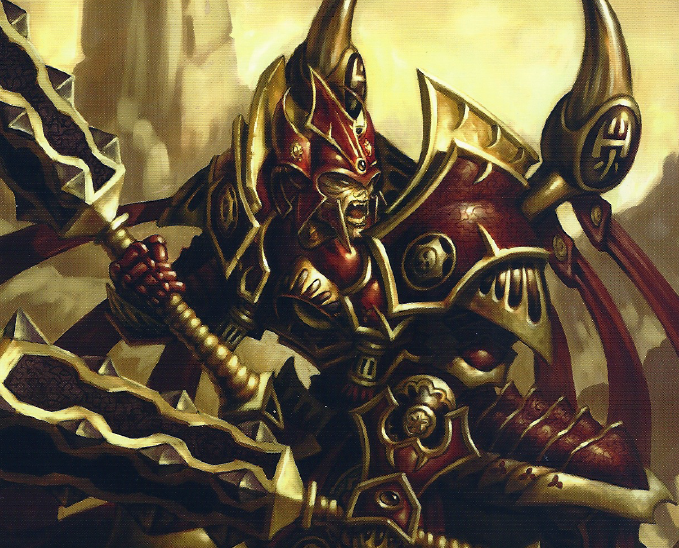
Tyrant Xerxis is the greatest warrior of the skorne. He is a Cataphract, unrivaled in war. He is a cruel leader, driving his soldiers beyond exhaustion to master their formations until they can move as one. He is a student of all warfare, especially the most recent ones, and he has a nearly supernatural sense of timing and application of force. When he leads, he is unstoppable. His clubs, the Pillars of Halaak, inspire his soldiers and embody the strength of the city of their name. Most Cataphracts could barely lift one, let alone both, but Xerxis wields them effortlessly. His fighting style is all about straightforward expedience and overwhelming force. He rules House Kophar, one of the strongest houses serving the Balaash, and they fought for a long time against Archdominar Vaactash, Makeda's grandfather, during the wars to subdue the area around Halaak. Kophar has more Cataphracts than any other house in the city, and their extollers expect Xerxis to surpass his ancestors and restore the house to glory by his service. He proved his loyalty to Makeda in 603, when he fought to protect her and defend an extended siege until Vinter could return for the Second Unification. He had every chance to join the Betrayers, but he refused them all. He sees no shame in service to his archdomina, whom he respects utterly. He is the greatest of soldiers and generals of the skorne, and he knows that he will die in battle and become exalted. His gimmick is personal badassery and troop buffs, and his feat buffs allied melee damage and armor.
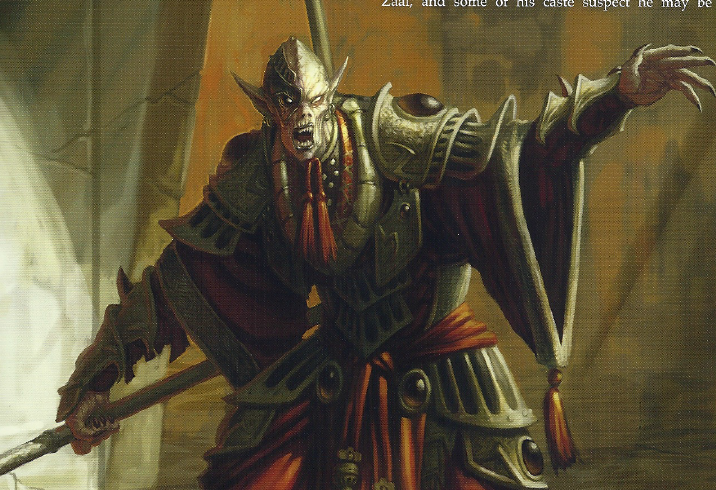
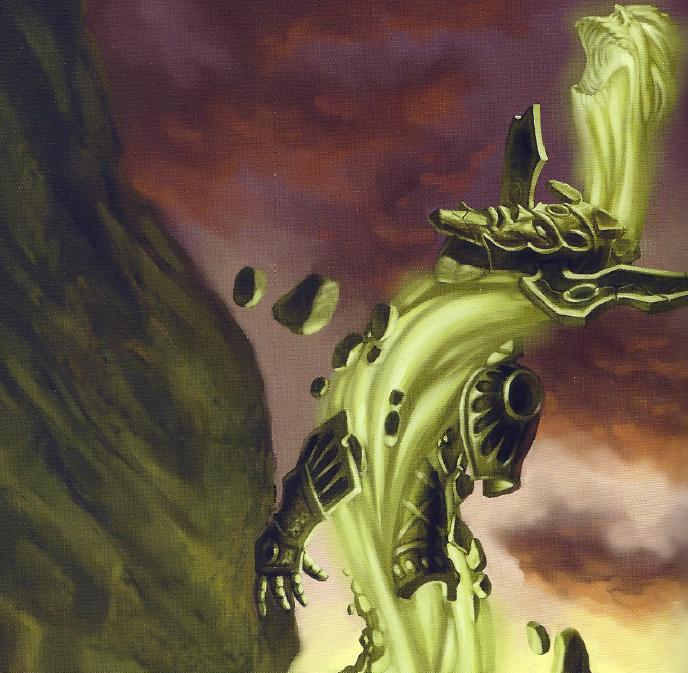
Supreme Aptimus Zaal is accompanied by the Kovaas . He is chief of all extollers, a mighty mystic with a deep insight into the ancestral spirits, almost a high priest for the Army of the Western Reaches. Even among extollers, he stands above the rest, standing apart from rule but commanding respect equal to any house lord. However, he is not content to just appreciate this - he has a calling. He has communed with many ancients, and his position as supreme aptimus has given him access to sacral stones from dozens of lineages. His lore is unequaled, but there is a price - touching the minds of the exalted risks madness. Zaal is ambitious, filling normally brave skorne with dread, which he rather enjoys. Their fear is a form of fealty and obedience. Only Lord Tyrant Hexeris stands near him, almost equal in his eyes, and rumor has it that Zaal and his extollers are guilty of heresy. His soldiers have sworn oaths never to betray him, but some among them are hollow and empty, passionless but strong.
The fact that skorne have a concept of blasphemy would amaze some humans who have seen their cruelty, but that is because they do not understand the deep reverence the skorne hold for their ancestors. Zaal is tampering with forces that could undermine all that is sacred, by using ancestors released from shattered sacral stones. These kovaas are filled with a dark madness, and trying to control them is a dark path. Kovaas are a rare consequence of ancestral guardians fighting in war - most of the time, their sacral stones are durable enough to remain whole, to be rebuilt, but when they break, a kovaas rises to slaughter the living and consume their souls. No coincidence could explain the frequency with which they happen around Zaal, though none have proof of his intentionally breaking sacral stones. Via his unique mastery, Zaal alone can command kovaas, able to banish them to some fate only he knows. Zaal's power over them would stain the extollers if discovered, and skorne history tells of the destruction the kovaas can wreak. Most famously, Lord Tyrant Norvaak, supreme aptimus of House Bashek, unleashed three of them in Halaak over 2000 years ago, killing thousands. Zaal considers him to have been a fool. In the west, he can experiment to his heart's content, and Vinter allowed it, seeing the kovaas as a tool. Makeda is either similarly pragmatic or prefers not to consider the ethics of his work closely. Now that he commands his own cohort, Zaal hopes to expand his lore and perform new experiments with the aid of Hexeris. Makeda is only peripherally aware of his plans and will likely remain so as long as the mystics obey her, as Zaal intends to. He enjoys fighting, and his crystal oculus allows him to see through all illusions and deceptions, viewing souls directly. He can capture and shred them as he likes, and any who question him or try to betray him die, their intentions revealed under his soul sight. His gimmick is buffs, blasts and using ancestral guardians (and kovaas). His feat lets him take power from his allies' deaths and use them to fuel those still around with buffs.

The skorne rely heavily on warbeasts drawn from the wastelands of the east. They are conditioned by the paingivers, which is the fundamental difference between them and western warbeasts - they are wild animals enslaved by magic. To prepare a beast for obedience, the handlers must break its spirit via torture, stress, physical modification and drugs. Mortitheurgy is essential - without it, the beasts could not be mastered. Mortitheurgy controls the beasts, draws power from their flesh and drives them violence beyond their natural capabilities. Further, it can reduce their need for food, saving on costs. Though most are taken from the wild, some are part of breeding programs overseen by beast handlers. These farms are vital in areas where the military has no access to traditional resources, like the Bloodstone Marches. Titans and rhinodons, especially, are bred for stamina and aggression, which their training enhances. On top of the beasts enslaved by the empire, they also have many rare and unique creatures. The beast handlers study their anatomy to better tailor their conditioning to it. Cyclopes, for example, need no pain to fight, and instead are altered to augment their supernatural vision and trained to wear heavy armor and wield immense weapons. Basilisk kreas, on theo ther hand, must be modified to control their powers. The most impressive, however, are the titans - reasonably clever herd animals that are usually docile in the wild, but very strong. They wear thick metal plates and wield immense weapons, equal to anything on the battlefield. The proper application of pain goads them to ferocity and has made them the greatest beasts of the skorne.
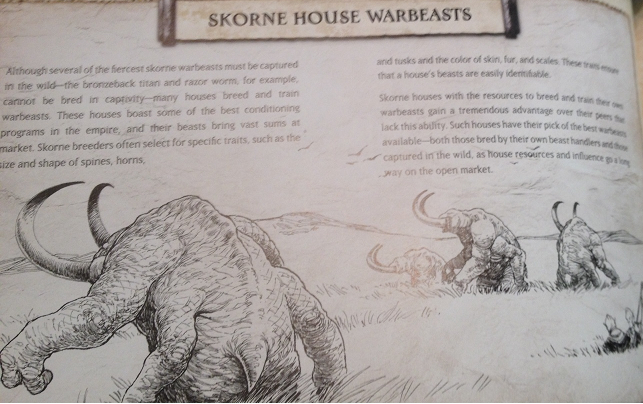
Next time: Slaves
Forces of Hordes: Skorne
Original SA post Forces of Hordes: Skorne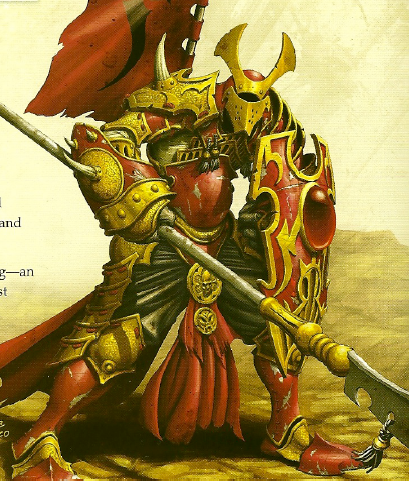
A Cyclops Brute is one of the many cyclopes the skorne use for war, meant to hold flanks or guard people. They are cunning, if crudely so, and respond well to training, becoming very tenacious once given armor and shields. All cyclopes get similar conditioning, but they are raised for distinct roles. The aggressive ones become shock troops, but brutes are more reactive, taught to mimic the disciplined march of the soldiers they follow. They wield immense pole arms and fight with their shields ready to defend others. Their vision allows them to focus more on evasion than attack, seeing attacks before they hit and shifting to deflect them. Their precognition means they often live for very long times, much longer than the savages used for shock troops. Their animus prevents them from being knocked down or shoved around.
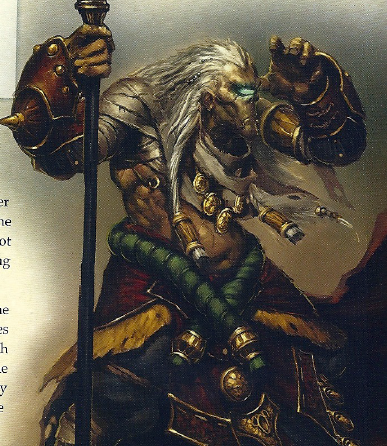
The Cyclops Shaman is smarter than most cyclopes, using crude but effective primal magic. When captured and tamed, they curse the enemies of the skorne, help other beasts and unravel magic. Their gaze can boil blood and rot organs, as well. Half-tamed shamans are very expensive, two or three times as much as brutes or savages. They have been unable to be bred in captivity, so they must be taken wild after learning their magic. Their intellect and resistance to pain has made them hard to control, and they are the beasts most prone to treachery and vindictiveness. They must be kept on a tight leash. Their animus ends enemy magic.
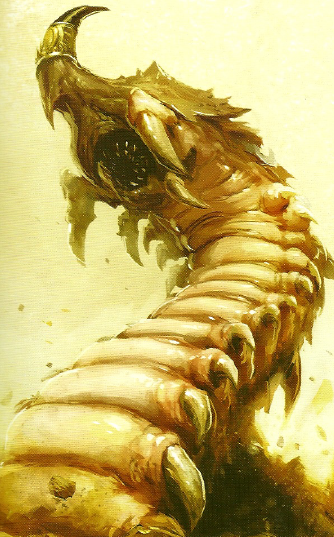
The Razor Worm was a unique challenge for the paingivers. They may not be awe-inspiring like titans or rhinodons, but they are valuable. They must be captured wild, which usually means slaves die as bait. Then, months are spent toughening the worm's flesh and conditioning them to fear and obey the skorne - very hard, given their tiny brains and tendency to hide underground. They must be broken against all of their instincts, and they tend to eat handlers that can't do it. They burrow with surprising speed just beneath the surface, causing a crest above t hem. Their skin is resilient, and they prefer to ambush prey from underground, erupting forth to bite at them and drag them below to be eaten. Their animus protects against explosions.
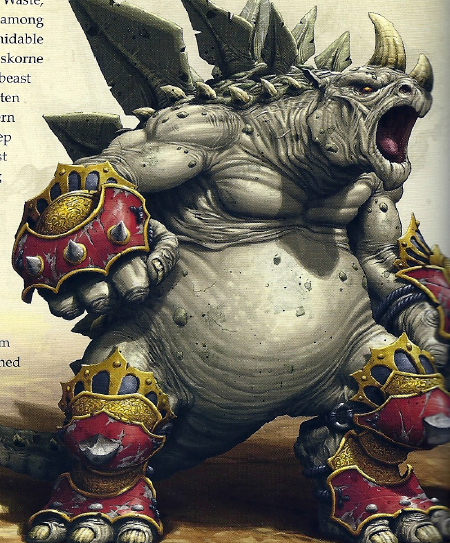
The Rhinodon hails from the eastern Trembling Wastes, and they are formidable. They date back to ancient times, and one sweep of their crushing tail will crush attackers, often breaking bones. Skorne armies have traditionally favored the more intelligent titans, particularly in crowded areas, because rhinodons respond poorly to harnesses and barbs. They must be managed by whips and verbal command only, which makes taming them slow and expensive. Even well-trained rhinodons tend to cause collateral damage, especially on buildings and walls. This makes them actually quite useful in the west, especially against enemy fortifications. Their animus improves special attacks.
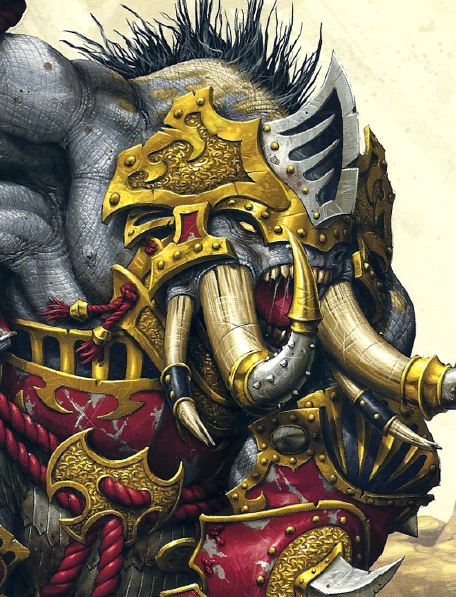
The Bronzeback Titan is one of the most dangerous beasts the skorne have tamed. They can't be raised in captivity - they must be captured, and that's not easy. Even one is exceptionally valuable, and for each one, at least ten handlers die. A single bronzeback can bring victory, as they push other titans to greater ferocity by their very presence. While rare, the wild titan herds still dominate the savannahs of the east. Most titans are passive unless threatened, but the strongest and eldest males sometimes transform into bronzebacks, bringing out their fiercest instincts. Muscles bulge under their hides, their forearms expand and lengthen and they grow an extra pair of tusks. Their skin thickens, drying into a pale bronze strip, and thick fur grows along the spine. Bronzebacks are exceptionally territorial, driving off all other mature males to create a herd of females to follow them and bear offspring. They can be found only in the wild herds, and captive bronzebacks are never fully tamed. They must always be watched closely. Their animus grants the power to overrun enemies.
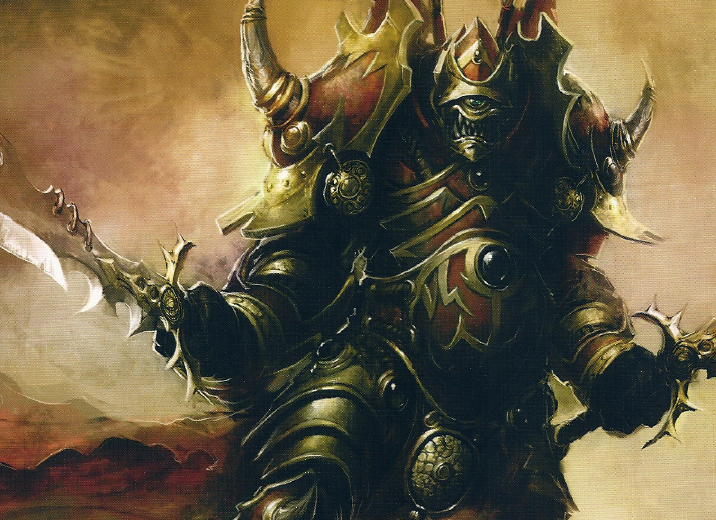
Molik Karn is a triumph. While he was trained to obey, his will was never broken. Rather, he is loyal to Makeda for reasons of his own. He is a cyclops lord, giant even for his species and cunning despite his primitive brutishness. His one eye sees the future, letting him evade most threats, and he wields dual falchions while wearing heavy armor, proving nearly invincible in battle. Once, the cyclopes could be counted on to be dim and disorganized, steering clear of skorne settlements. They were allowed to roam wild and breed, until the coming of Molik Karn. He brought war to the skorne, leading maddened cyclopes to attack their villages and capture them for bloodsport and food. They knew, however, he must be captured, not killed. Tyrant Xerxis saw it as a point of pride, and despite heavy casualties, he eventually dragged Karn back to camp, where he was subjected to every paingiver technique known. All failed to break him, and only exhaustion would overcome him - and then but briefly. At last, they admitted their failure, and Makeda herself demanded to see the beast. He was taken to the Abyssal Fortress, where Makeda faced him alone in the arena. He attacked, but she seized into his mind, stopping him in his tracks and forcing him to kneel. Since then, he has served her loyally, fearful and respectful of her. While enslaved, he has dominated all of the other cyclopes of the army, and he enjoys the western war. His cruelty has only been amplified by the humiliation of the lash, and the beast handlers are always wary of him. He rarely needs to be whipped - he enjoys fighting.

While soldiers of other races fight to survive, skorne soldiers fight to seek honorable and exalted deaths. Every skorne knows that the afterlife holds only torment, and their only hope to escape is to become worthy of exaltation. This fatalism is a potent weapon - the skorne need no comfort or recreation and will do anything for glorious victory. They subject their troops to mortitheurgy to extend their vitality in battle and bolster their endurance, reducing the need for food and water by magic and simple surgery. This isn't particularly good for the soul, but rarely does that matter to morale, as skorne are raised from birth to embrace pain and deprivation. In fact, the most potent mortitheurges can turn troops into hollow shells of themselves that require nearly nothing and fear no death - near-perfect soldiers. This has been used to help survive the Bloodstone Desert and the Abyss, establishing fortresses for resupply and reinforcement as they passed through them. Even with these refuges, many died en route. Skorne know that this only culled the unfit, and now only the most worthy serve.
Next time: The might of the skorne.
Forces of Hordes: Skorne
Original SA post Forces of Hordes: Skorne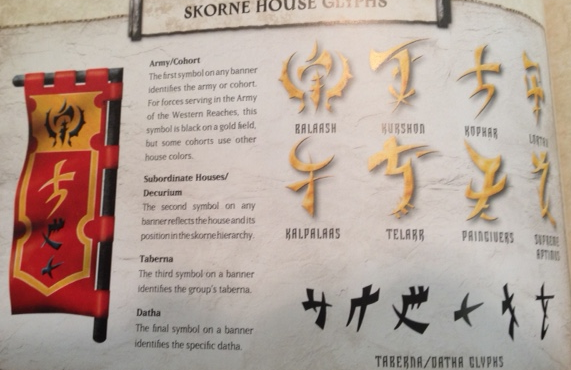
The word sabaoth refers to a large collection of cohorts under one leader. After Vinter's reforms, the term was adapted for divisions in the armies, and each dominar controls a sabaoth of varying size. Warriors of tyrant or lord tyrant rank are subordinate to a dominar and lead cohorts. Traditionally, the cohort is the largest armed force a single house could field, and the difference between tyrant and lord tyrant is subtle, indicative of a cohort and house's size and influence. It is not uncommon for a lord tyrant or prestigious tyrant to command other tyrants, though rarely permanently. In the Army of the Western Reaches, cohorts range from 2 to 5 thousand warriors. Any skorne promoted to tyrant who does not already command a house is given permission to found one, gaining all the privileges of rank including the right to build a fort to support their dominar. Tyrants and dominars of older houses tend not to like them much. Cohorts consist of ten decurium, which vary in size. Most cohorts include a variety of skorne disciplines, including Cataphracts, Praetorians and Venators. Because a cohort is all of a house, the exact mix varies. Specialists outside the warrior caste, like paingivers and extollers, also accompany them based on the tyrants' support. They may sometimes be classed as equipment, similar to ammo and warbeasts. Each dacarium is led by a primus, usually a Praetorian or Cataphcract. Every modern decurium can act as an independent force and is accompanied by at least a few ranged soldiers, and a primus has wide latitude to carry out objectives. Subordinate to them are the veteran dakar, who led taberna of between 20 and 50 skorne, usually made of one discipline. The taberna is the core of a battle line and the standard used to evaluate relative strength. It derives from the skorne word for a tent, as in ancient times they shared a tent while campaigning. They are tightly knit and work together for years, often with unique rites, traditions and superstitions. The warriors are then divided up into datha, six to ten soldiers trained in a single discipline, led by a single dakar equivalent to a sergeant.
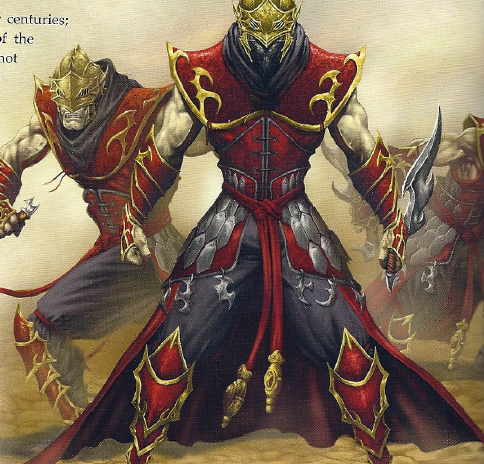
Paingiver Bloodrunners are part assassin, part warrior. Murder is their art, and they are distinct within the paingiver order. Death empowers them to flicker through shadow, exploiting any gap. The tradition has existed for centuries, and they are the closest paingivers to the warrior caste, though they do not follow the hoksune code and see no shame in striking from stealth. They study anatomy to learn how to make precise attacks and exploit the power of death and shadow. Traditionally, they work in small groups on surgical strikes, especially to seize assets without destruction. Since Morghoul took over the caste, he's been using them as his messengers, vassals and executioners, deploying them to cut out threats to the empire like cancerous tissue.
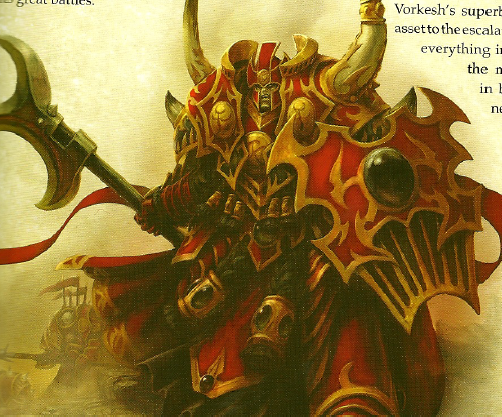
Tyrant Vorkesh sometimes leads the Cataphract Cetrati as a living paragon. Even as a child, he knew he was born to be a Cataphract, undertaking the kar praxas or 'day of full height' as young as possible in his generation. He headed into the Northern Marches with only armor and a spear, returning with the five heads of a desert hydra. For his valor and adherence to hoksune, he was granted the ancient halberd named Arm of Rahaal by Primus Mokraas, loremaster of the Cataphracts. It bears the sacral stones of many champions. Vorkesh's skill in battle makes him very useful, despite his lack of any mortitheurgical skill. He tolerates these arts, but he prefers not to rely on them, and the ancestors that protect him allow no sorcerous interference. Makeda does not entirely trust the mystics, and Vorkesh makes for a good protection from them.
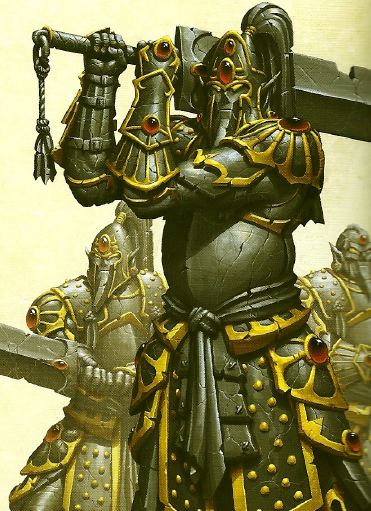
Immortals are spirits rescued from the Void, serving as companions to the ancestral guardians. Their bodies are carved from stone and clay, and they wield very heavy blades, heavier than any mortal can lift. Immortals may die a hundred times, but as long as their sacral stone survives, they can fight again. Many skorne have died in the west, but they fearlessly give their lives to gain land, and the many ancestral guardians accompanying them have collected many souls. The cost and time of constructing new bodies for them is nothing compared to their power, especially when the immortals fight alongside an ancestral guardian that chose them. The living, reminded of their chance to live after death, find courage in their silent presence, hoping to join their ranks.
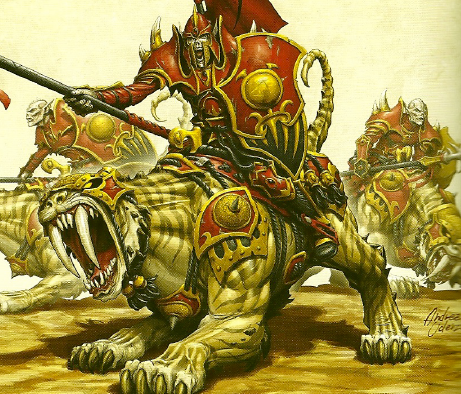
The Praetorian Ferox use the speed and agility of their mounts to kill. They are a forward strike force, and the ferox they ride are very graceful, with enough raw strength to tear through infantry. They are desert predators that mow through enemy lines, then turn back to cut them down from behind. Mount and rider move as one, using a spear and vicious fangs. Ferox have long preyed on the herds of belek, korbesh and kopaar kept by the skorne, who learned to respect their cunning and power. Though they were tamed long ago, the paingivers see it as vital to preserve their savagery, and the Preatorians that ride them are often scarred by their violent outbursts. They do not have a bond of affection, nor is it similar to the bond between horse and man. Rather, it is a wary respect between killers.
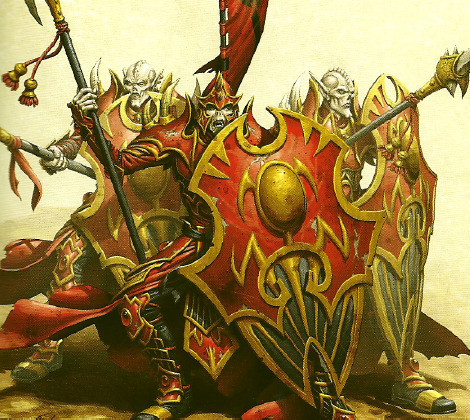
The Praetorian Karax are the backbone of the Army of the Western Reaches. They carry immense shields, drilling extensively in defensive formations. At a command from their dakar, a karax unit go into the xenka formation, protecting themselves from explosive blasts, shrapnel and flame. With another command, they drop to their knees, shields forward and heads down to allow the Venators to attack, then stand again. Swordsmen behind a karax line can advance without fear. House Kalvat fielded the first karax cohort during the War of the Exalted, when they faced Dominar Helzar, who relied on incendiaries. The karax shields endured his blasts, winning the day. Some skorne believe promotion is harder for the karax than others, as their training diminished individual initiative, but even so, none can dispute their ability to advance unharmed no matter what's going on.
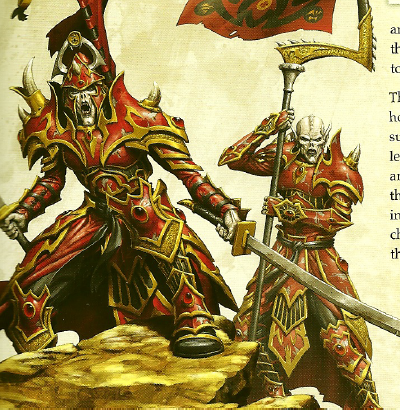
A Praetorian Swordsman Officer and Standard sometimes leads the swordsmen. More Preatorians than any other force in history serve in the Army, gathering at the Abyssal Fortress daily to march to the front. They live by hoksune, and their trials will never end. They constantly push themselves higher. Those that stand out become dakar, and rising further takes even more than that - they must have loyalty, respect, intellect and skill at command. Only the elite are raised to primus. These officers are rightfully arrogant, commanding many skorne. They lead by example, and no losses are too great if they secure victory, so they direct their men in order to take full advantage of their skills. Tyrants rely on them heavily to execute orders and keep order, and their discipline is flawless.
Next time: WITNESS ME
Forces of Hordes: Skorne
Original SA postThere is literally no reason to grimdark up Blue Rose, that's the dumbest thing you can do with it.
Forces of Hordes: Skorne
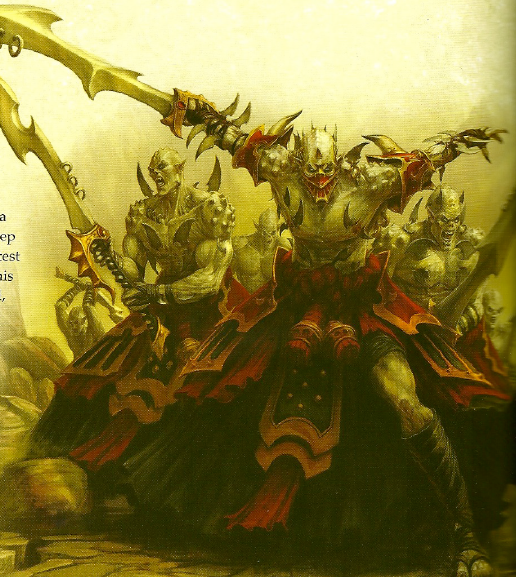
The
Nihilators
are a cult obsessed with earning exaltation in battle, seeking out the most violent deaths possible against the most impossible odds to gain extoller attention. The roots of the cult date back to the earliest parts of skorne society, when Xarvaax the Flayed was the greatest disciple of Morkaash, who created the paingivers. After Morkaash's death, Xaavax and a few other devotees headed into the Shroudfall Mountains to test the limits of self-inflicted pain. Several died, but those that returned found new zeal, and the cult steadily grew on the fringes. Their rituals are a radical reinterpretation of Morkaash's teachings about enlightenment through suffering, incorporating Voskune's codes of honor. Paingivers learn anatomy to hurt foes or tame beasts, but nihilators learn it to transcend their bodies via pain. They perform ritual sacrification, using the pain to achieve a meditative state allowing them to ignore even crippling injuries. They are like berserkers, able to enter a blood frenzy. They become blinded by their desire for glorious death, becoming unable to tell friend from foe, and as many die on the blades of other skorne as on the enemy.
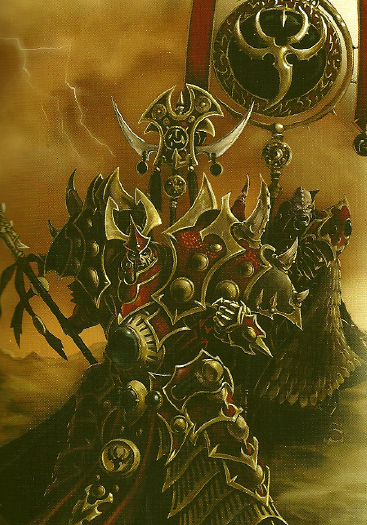
A
Tyrant Commander and Standard
dictate the flow of battle when present. They adapt to shifting circumstances, giving orders to keep the entire force going. A tyrant is both tactician and warrior, standing at the front to lead the skorne. Their mere presence gives the army precision and the ability to move as one whole. The standard bearer presents the symbols of both the tyrant's house and their cohort, accompanying them at all times. The banner shows all the tyrant's battle honors, reminding the skorne of their duty and the expectations of their ancestors. A tyrant must always be ready to hold any position to the death, should their dominar require it.
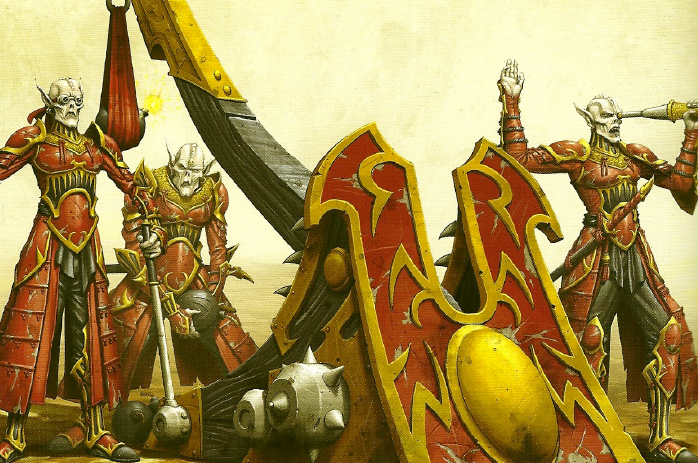
A
Venator Catapult Crew
is part of a centuries-old tradition. While cannons and guns have become widespread, most house armies still believe catapults vital to any campaign, as they can be built far afield, away from centers of industry, even mid-battle. The crew cranks the firing arm using twisted ropes with immense torque, then launch their projectiles huge distances. The preferred projectile is a heavy ball filled with steel shards and explosives, which explodes massively on impact. Catapults do have an advantage over direct fire cannons, such as their ability to launch projectiles into the air, over obstacles. While the Venators are usually tasked to construct and deploy the catapults, their operation falls to lower castes, leaving the frontline soldiers free to fight.
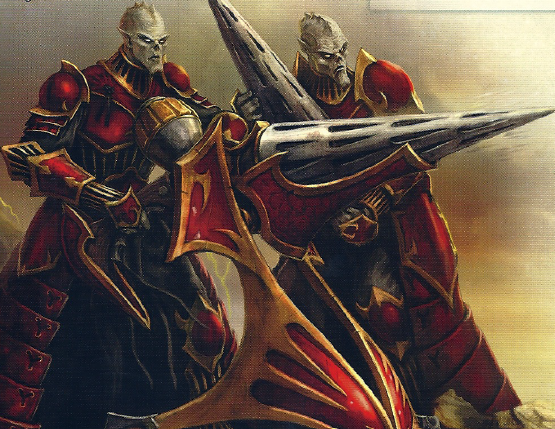
The
Venator Flayer Cannon Crew
use their flayer cannon to fire hundreds of vicious needles at immense speeds, making the corpses they create very hard to identify and causing grievous injury. The flayer cannon is a new weapon, based on the century-old reiver guns. After Vinter expanded on their usage, the skorne began to fully appreciate the versatility of these gas-powered weapons. The cannon is a simple but effective extrapolation of the handheld reiver, and while the firing cone is heavy, the cannon is tripod-mounted for stability and accuracy. The frame is light and easy to assemble, and a cannon can be manned by a small team of trained Venators.
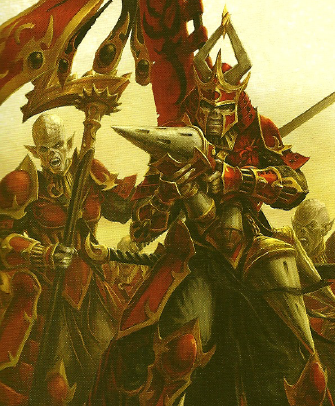
A
Venator Reiver Officer and Standard
lead the Reivers sometimes. They were the lowest of the warrior caste until very recently, but dealing with humans has forced new tactics. The ranged weapons preferred by the Iron Kingdoms have led to increased reliance on the Venators and their reivers. Their most prominent masters have risen through the ranks, and while none are yet tyrants, they are becoming respected. The rank and file of the Praetorians and Cataphracts still disdain them, but the tyrants and dominars are seeing their use, recognizing that the Venators are devoted to their own interpretation of hoksune and are as honorable as anyone. The best become primus, showing fanatical devotion and courage the same as any skorne commander, and some have begun to hope that they may, one day, have a Venator become exalted.
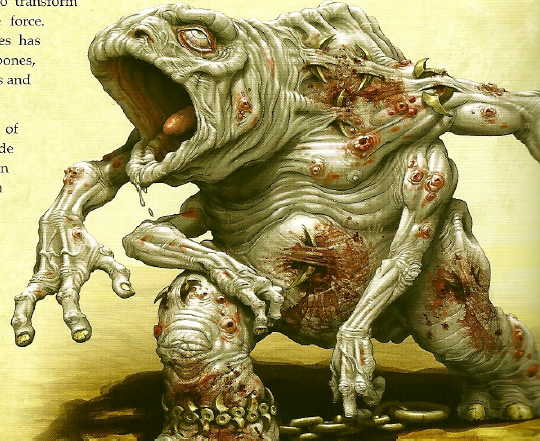
Agonizers
are embodiments of pain, manifesting their misery in an aura of suffering. Few realize that they are actually infant titans when they see them, selected at birth to be subjected to horrific procedures meant to turn their suffering into tangible force. They are starving creatures, skin taut on their bones, riddled with scars and impaling hooks and barbs. Even the most hardened criminals of the west would be hard-pressed to perform such cruelty, but the skorne see it as just another weapon from the titan breeding projects. Their existence is the result of experimentation on titans to maximize fertility, which produced small and weak children, too sickly for combat. They were failures until exploratory surgery and torment exposed the potential of tapping into and projecting their pain on others. Now, some titan cows are set aside from each herd to breed agonizers. Fortunately for them, few survive more than a single battle, and death is a sweet release from their pain.
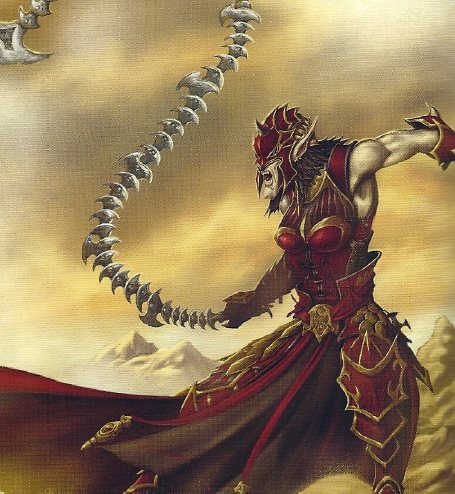
A
Paingiver Bloodrunner Master Tormentor
is an unrivalled killer. The shadows cloak them, and they cannot be tracked in the dark. They cut through foes with great skill. They are few, but among the most feared paingivers, the most skilled assassins of the skorne. Their signature razor lash takes immense skill to use, able to kill quickly or slowly as the wielder desires. With their specialized mortitheurgy, they can ride the pain they cause to gain immense mobility, savoring the energy like fine wine.
Next time: I got a rock.
Forces of Hordes: Skorne
Original SA post Forces of Hordes: Skorne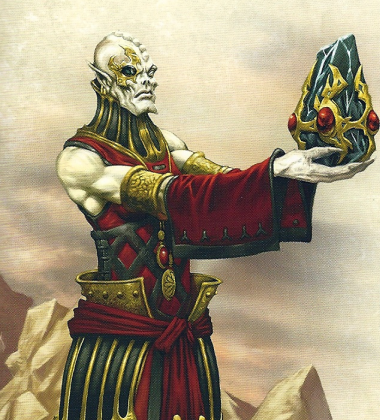
The Extoller Soulward has the solemn duty of preserving heroes on the battlefield, and evne the warriors treat them with deference, for they choose the exalted. The rites which cleanse them for their office have a deadly risk, for to learn the secrets of the extollers, they must pluck out an eye and replace it with a crystal oculus that reacts to spiritual energy. Many die of the shock and pain of the process, but those that survive gain insight and the power to speak with the exalted. This is no easy task, for their advice is cryptic and they can lead to madness. Exact procedure must be followed when awakening the eldest and most potent ancestors. Senior extollers sometimes hear voices in their minds, like echoes of another's thoughts. A soulward must have the iron will to push past these and invoke the true guidance of the exalted. Their unique vision allows them not only to see souls, but to seize and rend them, so they may kill with no more than a look.
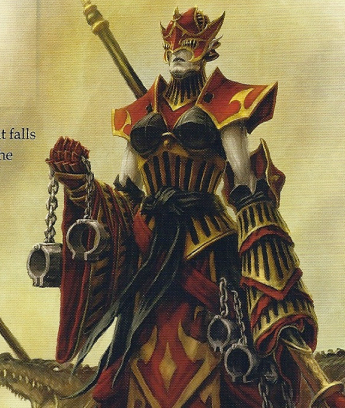
A Paingiver Task Master has the job of managing the slaves of the skorne. Those slaves whose strength and skill with violence is good enough are given reprieve from their heavy labor to fight instead. Task masters drive them into battle with wicked man catchers, both to goad the unwilling and to catch new meat. In the hands of a paingiver, a man catcher can hold someone in place as their slaves descend for the kill. These slaves are their greatest weapon, learning to fear and obey them in the hope of a quick death in combat rather than the endurance of more tortures. At the command of a task master, the slaves surge forward even into the worst of battle, ignoring their injuries. They know that they will be allowed to die of their wounds only when their masters allow it.
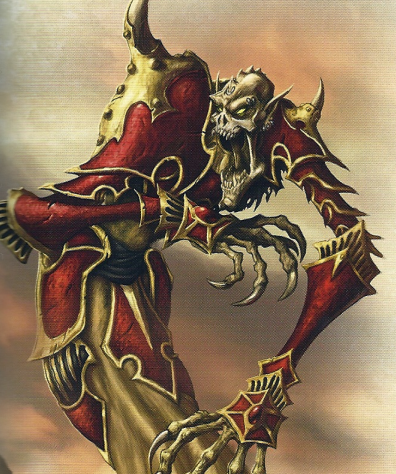
Void Spirits are skorne ghosts that, through some unnatural urge, have returned to the living world. Even short exposure to the Void damages them, ripping away their memories and leaving only a hunger to kill. They hate all life, siphoning its vitality with their touch and leaving only shriveled husks behind. They clutch at the souls of those they kill, to give them the same pain they suffer. Skorne may fear the Void, but they know it is wrong for the dead to return. Tampering with Void forces is almost blasphemous, and ordinarily the skorne would destroy these spirits immediately, but now, the skorne must use any weapon. Makeda's decree authorizing their use in battle has caused strain, particularly among the extollers, who are disturbed to see dead spirits bent to such unnatural purpose. These nightmares were once rare, but recently, their numbers have reason. Many mystics claim that Mordikaar the Void Seer is responsible for the growing presence of these hateful dead, and he has taught mortitheurges and extollers how to transform them into weapons.
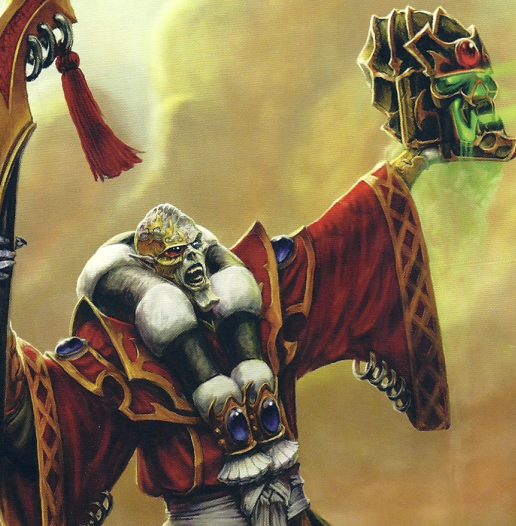
Aptimus Marketh is not like most extollers - he cares more about manipulating the spirits of the dead than exalting them. He holds exaltation in the highest regard, and he believes most skorne are undeserving even of becoming companions to the ancestral guardians. He believes the modern skorne are decadent, unlike the past. By his standards, most skorne who die do not deserve anything but to have their souls used to serve his goals. Those that die near him and are not undeniably heroes have their souls torn to bits to fuel his sorcery. He has a grand collection of relics containing sacral stones of some of the most exalted skorne in history, most notably the sacral stone of Lord Tyrant Nikuvox, the conqueror that won the First War of the Hezaat River, who inhabits the obsidian skull Marketh always carries. In return for acknowledging their glory, these spirits willingly serve him. The spirit that inhabits his weapon, Gravitas, is one of his ancestors and can unravel magic easily. Gravitas was crafted in the time of Lord Tyrant Novaak, and it is said it was this weapon that struck him down as his dying curse released the kovaas upon Halaak.
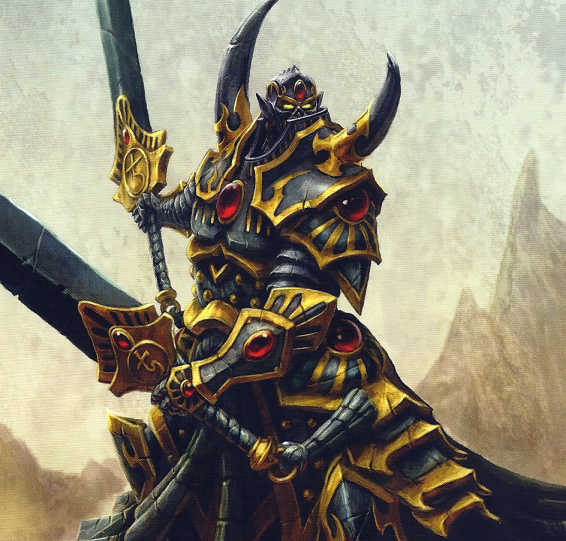
Hakaar the Destroyer has existed for almost a thousand years, once as Lord Tyrant Hakaar during the War of the Exalted. Politics were of little improtance to him, and he began the war as a Praetorian primus of House Tyreth. He was distinguished for his skill in the skorne battles, devoted to hoksune, and he was unhappy with the treachery of his dominar, who changed allegiances throughout the war to whatever was best for him. On the third time, when the dominar led his army to fight a bold but ill-planned battle in Tor-Halaak, Hakaar was angered. His men lost their chance at glorious death, and they did not interfere when he killed his own dominar, then led a counterattack in the face of certain defeat. In a great display of skill and leadership, he and his men seized control of House Tyreth, expunging his dominar's name from history entirely. Hakaar was known for his sword skills, and he spent his life fighting overwhelming odds in the field that would become known as the Graves of the Exalted. By the time he died, skewered by a dozen Cataphracts, he had cut down scores of enemies, wearbeasts and Dominar Helzar, who had started the war. There was no question that he was exalted. The finest stoneworkers of the skorne built the ancestral guardian for his soul, and he was placed in an alcove of honor in Halaak, where he sat motionless for a thousand years, ignoring all extollers. He first stirred when Makeda seized power from Vinter, heading west and ignoring all who approached. He did not stop until he reached the Abyssal Fortress, where he approached Makeda and knelt before her. His arrival is a great omen, for he does not act save in the most desperate struggles. Those skorne that see him know a terrible battle is coming, but take heart that is there, for if the greatest warrior of a thousand years chooses to join them, only the greatest deaths await.
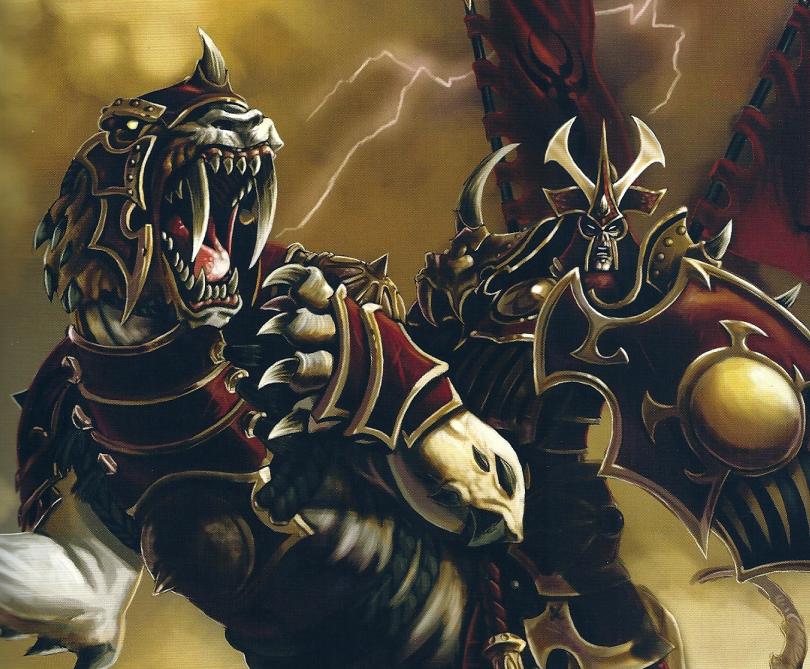
Tyrant Rhadeim is the head of all of the Praetorian Ferox in the Skorne Empire. He is fast enough that by the time the enemy regroups to deal with him, he is already elsewhere, attacking their flank. He rose to prominence by ambition, courage and ingenuity. He will adapt to any situation without care for his orders or his safety, bringing unpredictability to an otherwise regimented army. Makeda values his unconventional approach, though some say her willingness to send him on risky missions is as much punishment as honor. Still, he doesn't lose often. He was raised as the heir to House Bashek, an ancient lineage long associated with the ferox. According to legend, they were the first skorne on the Plains of Sortaan to tame the ferox into half-wild steeds. They rely little on paingivers to tame their ferox, considering it vital that they retain their natural ferocity, so long as they obey. House Bashek eventually came under the rule of Archdominar Vaactesh of House Balaash, Makeda's grandfather. Balaash has since become one of the more influential vassals owing directly to Makeda. Rhadeim took to the forex young, walking fearlessly among them even as a child. The cat handlers said he had the gaze of a basilisk, able to stop a ferox with but a look. He began to train as soon as he was old enough to sit in the saddle. In time, he earned the Lance of Bashek, a relic containing a shard of the sacral stone of the founder of the house, and by tradition the extollers must confirm that ancestral spirit approves of its bearer. Reportedly, it can mortally wound any foe when wielded by a skorne with its blessing. Rhadeim serves both as recon and rapid-strike, leading his men on scouting and raiding attacks far afield when not directly serving the army. More than once, he's plundered vital food and equipment for Makeda. He fights with almost a prescience of where the enemy is weak. As soon as he spots weakness, he heads for a kill, and his subordinates claim he's half-ferox, with predatory instinct as good as his mount's. Few can hold his stare long.
The End!
So, what's next - Legion of Everblight or Trollbloods?
Forces of Hordes: Trollbloods
Original SA post Forces of Hordes: Trollbloods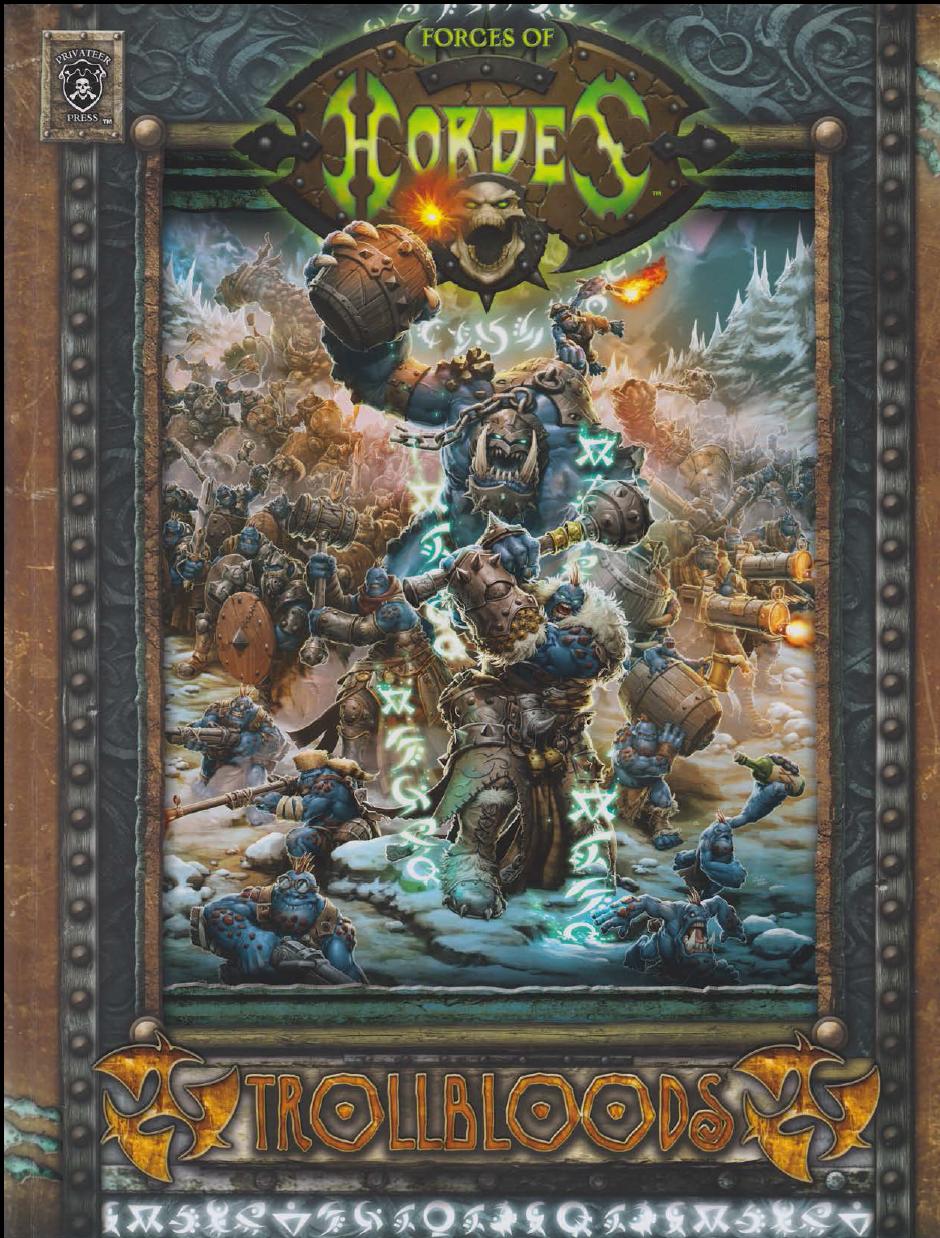
The trollbloods are a loose alliance of scattered trollkin tribes, or kriels, in the lands humans had little hunger for. Recent war has encroached even on this land, and they are beset by foes from all sides. They are now coming together for war, with all breeds of troll joining them in battle. Their hardiness is their great strength - trollkin alone are hard to kill, let alone actual trolls.

The trollbloods are a powerful but disorderly alliance. Most of the leaders and warriors are the more civilized trollkin, but they are joined by the adaptable pygmy trolls, or pygs, and larger full-blood trolls. At the pinnacle are the dire trolls, with unmatched ferocity, regeneration and hunger. The trollkin are the core of the alliance, defending their ancient customs and sophisticated culture from terrible persecution. They fight not only for their lands and lives, but for the survival of their race itself. Betrayed by their allies and surrounded by hostile forces, they have no choice but to war. Rather than one nation, the trollbloods are hundreds of kriels, each separate, slowly coming together now to defend each other. They are tied together by blood and friendship, but they have no overarching hierarchy. Each kriel is led by a group of elders who have recently been put in contact with each other, but they are contentious and generally self-centered. Despite this, a few great chiefs have emerged to bring the kriels together and unite their people. Without unity, the trollbloods will die. Still, they are a stubborn and traditional race, and many of them don't like change.
In all myths, the trollkin are one of the oldest races of Caen. In more recent history, they were part of the barbaric hordes known as the Molgur, and many of their traditions date to that time. They fought alongside trolls, humans, goblins and ogrun, but even then they held the bonds of kith and kriel above others. These extended families rose from tribes and warbands to protect villages or fight foes. When the Menite priest-kings broke the Molgur, the trollkin dispersed widely, gathering in the wild places. These separate kriels retained only the traditions they had inscribed on the great krielstones, and many ancient ways were lost. The trolls fared even worse, being hunted down by humans when they didn't follow the trollkin away. For generations, the ties between troll and trollkin were tenuous, with only a few shamans exploring them. The Menites were extremely ruthless towards the dire trolls, and only the most feral of them in the high mountains survived. That the trollkin survived at all is testament to their resilience.
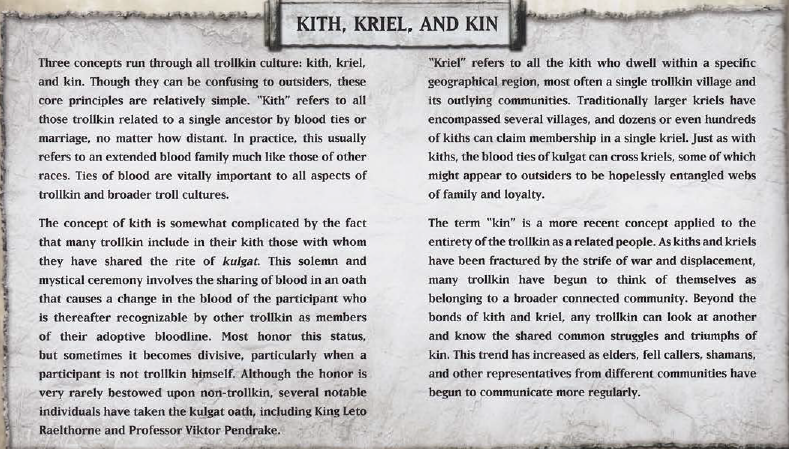
Most kriels settled in the best land they could get, often in the deep forests. The Thornwood, Gnarls and Scarsfell Forest became home to the largest trollkin populations, which retained their ties to the trolls for defense. Other kriels were forced to more remote regions, on the edge of the Bloodstone Marches or the Scharde Islands. Life has changed little in most of them since that time. A few small but notable kriels left the wilds, settling in human cities and casting aside many traditions. Only a few human cities in the modern era support trollkin communities large enough to identify as kriels.
Kriels are generally led by a few key individuals vital to the community, primarily a chieftain and council of elders that decide on matters of importance. They pool resources, build houses and keep the village secure as well as managing trade. The most potent shamans of the trollkin are usually significant on these councils, as are senior chroniclers, sorcerers, fell callers and expert craftsmen. The chief and elders are the arbiters of most decisions, and most kriels allow contentious disputes to be settled by trial by combat atop an elevated platform at the village center. These fights are brutal but rarely fatal, overseen by the chief, who can decide to champion either side if there's a disparity in martial skill. In kriels with particularly strong chiefs, it's rare for disputes to reach the arena for that reason, which leads to the general belief that strong chiefs encourage peace.
Chiefs are generally powerful warriors entrusted to oversee a kriel's defense and make wartime decisions. In some rare cases, they are shamans, sorcerers or fell callers. Chiefs are traditionally male, but not exclusively so. Transition between chiefs depends on the kriel, but it's not uncommon to be handed to the eldest son of the chief, if they're strong. These heirs spend their lives preparing themselves. If the kriel has a better candidate, like a war hero, the chief may choose them instead. When a chief dies without leaving instructions, the elders choose the new chief from the kriel champions. Chiefs do not lead a kriel except in times of danger, deferring to the elders on other matters. In times of war, however, they have complete authority. Isolated kiths often lack enough members to host a full council, so they might be ruled by a shaman or chief - who may well be the same person. Even then, however, several elders serve as advisors.
On top of an often tight-knit band of champions, chiefs are also supported by larger groups of warriors, known as warbands, who are utterly loyal to the chief, and are generally close kith or at least of the same kriel. The greatest chiefs might lead warbands from several kriels, and it isn't unheard of for trollkin to travel great distances to join a legendary chief's warband. A chief with many followers will often have multiple warbands, each led by a champion. While rare in the past, it's more common these days.
Since the defeat of the Molgur, many trollkin communities have reestablished their ties to the trolls. It causes strife with human villages, given troll hungers, but it's worth it for their strength and power. Those rare warlocks that can bond with trolls inevitably rise to lead, often becoming chiefs by virtue of their immense battle power. Their trolls are often considered part of their warbands. Most trollkin communities are insular, at least until recently, and while visitors from other kriels were welcome, alliances were rare. As kriels have been displaced, though, trollkin have been forced together more than ever before, and elders from many kriels are meeting with each other. These regional councils are mostly found in the Thornwood, Gnarls and Scarsfell, where trollkin populations are very dense. Because the current troubles are bringing them together, the trollkin more often work to help each other despite distance. Not all of them are comfortable with this, preferring to rely only on locals, and strife between kriels is not uncommon, especially if old grudges exist.
Nothing has worked to unite the trollkin more than the rise of Madrak Ironhide, whom all recognize as a hero on par with Horfar Grimmr, and who leads Tolok Kriel. He has worked to promote cooperation and peace between kriels, and he leads what has come to be called the united kriels by many. His legend is fundamentally tied to the trouble of his people, who remain battle-ready despite being driven from the Thornwood. They are iconic of the spirit of the united kriels, gaining at least nominal support from the Thornwood and Gnarls elders and many scattered kriels. Madrak hopes that one day, all trollkin will be united for mutual preservation. The Scarsfell has thus far avoided formally joining, but many warriors have come out of the Scarsfell to serve Madrak. Many potent shamans and chiefs also support him, but the fractious nature of the kriels makes consensus hard. Most warbands and kriels following Ironhide owe him no formal allegiance or vassalage, seeing themselves as allies and peers. Borka Kegslayer has led a small army out of the Scarsfell to join, but they're more interested in fighting humans than nation-building.
One of the biggest steps is the oath of fellowship between Madrak and Hoarluk Doomshaper, the military leader of the Gnarls kriels. This bond was forged when the Circle Orboros betrayed Madrak and tried to kill him. Doomshaper helped thwart that, and the Thornwood and Gnarls kriels have become increasingly close. While Doomshaper agrees with Ironhide on some ideas, he's still a staunch traditionalist uncomfortable with the modern changes. Still, he'll do anything to save his people. That's why he released the dire trolls on the world. He likes trolls and admires their simplicity and savagery, and he's committed to helping Ironhide in the war that he believes will envelop the trollkin in whole, but he's also committed to vengeance. Ironhide hopes for peace with humans, but Doomshaper feels violence is the only communication that can be had with them.
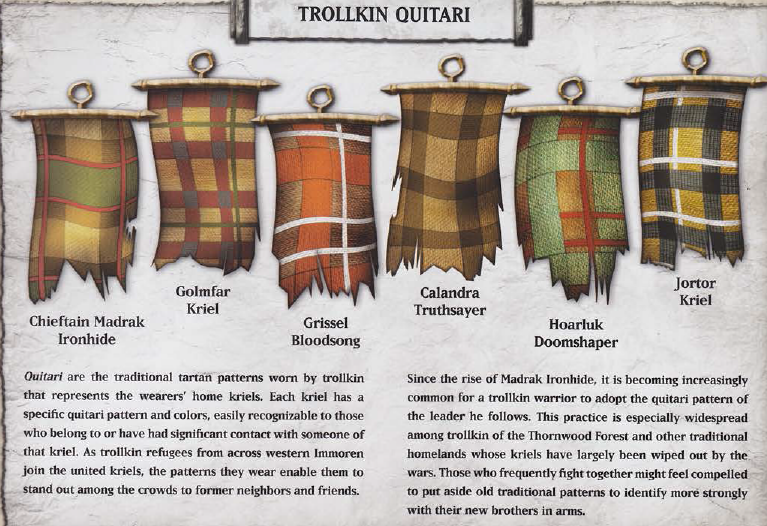
Next time: Just wanna kill all humans
Forces of Hordes: Trollbloods
Original SA post Forces of Hordes: TrollbloodsDespite the lack of total harmony, the unity of the kriels is growing by the day. Few elders have time to debate the implications of a trollblood nation now, as more and more trollkin leave their homes for the protection of the unified kriels. The intertribal councils are becoming responsible for an evergrowing number of refugees. While the trollkin do not fight as one and have no clear chain of command, they are still formidable foes. Their resilience and healing abilities mean they often outlast foes of greater organization, and they're no strangers to battle. Every adult trollkin is a warrior, with only those too young or old to fight being defenseless. The kriels have had to adapt by necessity, but this isn't the first time they've organized. Four hundred years ago, Cygnar attacked the kriels, and in response, they destroyed the colossals that were the pride of humanity. Their skill at guerilla warfare was enough then, even with great technological inferiority, and now they're being forced to take up new weapons and tactics.
Most kriels have at least a few warriors to defend their lands, even if they're normally peaceful. Even the friendliest farmers can be counted on to defend the kriel, and more warlike trollkin tend to view war as a sport and fighting to be a part of life. Feuds between kriels tend to be resolved after a few skirmishes with few serious casualties, thanks to their natural resilience. Combat as competition is more common in the Scarsfell than the Gnarls or Thornwood, and the Scarsfell trollkin joining Borka Kegslayer often find their combative nature met with hostility by the southern kriels.
The traditional emphasis on close combat has served the trollkin well, as it plays into their strength and endurance. Many martial traditions are born from the kriels, like the Fennblades of Fenn Marsh and the long riders of the Khadoran plains. However, some, like Madrak Ironhide, have seen a need for modern weapons. In the past, Cygnar and Ord would sell surplus weapons to the trollkin, and Cygnar considered them nominal citizens. However, their motive in arms dealing was to have the trollkin serve as a buffer against their foes. These arms sales have been suspended now due to hostilities, but that hasn't stopped the trollkin from using the black market. Several trollkin have served in human armies, especially those raised in cities, and some of them have brought military experience to the kriels. Their methods are not traditional, but their tactics have been very useful. Even the most hardened trollkin veteran can benefit from professional training, as they often lack the discipline to maintain order in large engagements.
Despite the ongoing frustrations of ex-military trollkin, their efforts are paying off. Many younger trollkin embrace modern weapons, and with training and drilling, they're as good as any soldiers. The inherent strength and courage of the trollkin serves them well, and these modern tactics alongside the trolls and dire trolls may well save the race. One major source of professional soldiers has come from the unmated but mature trollkin known as shen, whose tendency to violence and lack of societal role could otherwise cause trouble. Traditionally, they are encouraged to leave their kiths and band together as trollshen, groups of 5 to 20 males of various ages. They also arise among refugees who band together for protection, as they often turn to banditry or mercenary work to survive. With the right guidance, their recklessness can be useful.
Pygs have existed on the fringes of society forever, often seen as useless in battle due to their capriciousness and lack of interest in craftwork. However, this has changed. Pygs are just as resolute as trollkin, given weapons suited to their natures. They have a lower tolerance for drills and discipline, but that can be worked with. Dire trolls also tolerate them for some reason, which is exploited well in combat. Pygs are naturally skilled with firearms and tend towards thrill-seeking, so they're often seen in modern warbands.
Not all trollblood forces are warriors, either. Shamans are increasingly seen aiding the warbands with Dhunia's power as well as advising their communities. Their presence inspires trollkin as a sign that Dhunia supports them, and many shamans are powerful warriors, too, like Borka Kegslayer. Sorcerers are also respected by the trollkin for their strength in battle, and many recent warlocks have been born sorcerers, calling on their natural connection to Caen's magic. Many sorcerers become runebearers, able to turn stone against their foes and call on history as a weapon. After all, trollkin history is written in stone, and with proper reverance, these stones can be used to harm foes and bless allies. Krielstones are now brought to war, along with the scribes that record the events of battle on them.
The thing that scares other forces most, though, is the presence of trolls. Many kriels think of trolls as part of their communities, making special weapons, armor and clothes for them. Trolls get easier access to food from all this, offering their strength in return. Dire trolls are more recent allies, and even the kriels think they're dangerous and untamed at best. Dire trolls are capable of immense ferocity and are never more than a tiny step away from violent frenzy. Pygs calm them, but even then they're unpredictable. Feeding trolls and dire trolls is a big problem - they eat massive amounts of food, and when hungry, they grow aggressive and violent, often eating anything nearby. Trolls that live closely with trollkin do so less often, but any troll can snap.
Thus, any warband needs skinners and hunters to keep the trolls sated. Even the best-supplied kriels can't perfectly feed trolls, and some shamans claim their hunger is the cost of Dhunia's gift of regeneration. Any troll on the battlefield is likely to be fighting as much to eat as to help the trollkin. Maintaining supply lines is hard, with so many disparate kriels, and that is why so much is invested in defending the Gnarls, where many kriels live close to each other. Those far afield must hope for generosity from the local trollkin or to start raiding and hunting. Despite all these challenges, trollkin warbands are increasingly becoming a cohesive and potent army. The trollbloods excel at endurance above all else, and they know that they must fight if they will survive.

All trollkin warlocks have magical skill, but their power comes from their ability to command the trolls. They have a deep connection to their kin, which many believe draws on Dhunia's own power, making them more than leaders - they are hands of the goddess. Most trollkin warlocks are either born sorcerers or Dhunian shamans. Sorcerers are easy to spot - they're usually small and albino. They are highly valued, though, for their skills. Most sorcerers do not become warlocks, as the ability to command trolls is rarer and needs the right inclination. Shamans can be found everywhere, as the trollkin are deeply spiritual, and those that become warlocks are particularly honored. They tend to tap into Dhunia's destructive aspects rather than her fertility and seasonal power. A few try to balance both sides of her nature, but most shamans focus on one or another. Warlocks tend to be leaders and chiefs, and they often struggle for control in the united kriels due to their varying ideas and traditions. How to deal with humans is one of the big points of contention. Some say the trollkin should fight only to gain their promised homeland and protect it, while others are sick of human lies and want to use any means necessary to carve out their own nation.
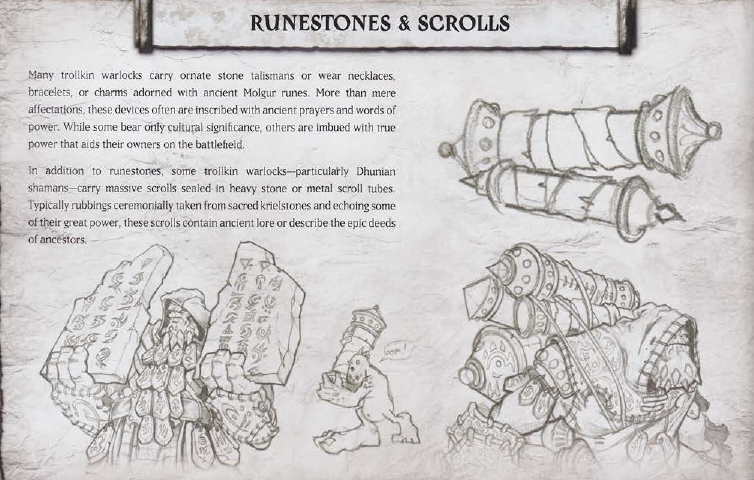
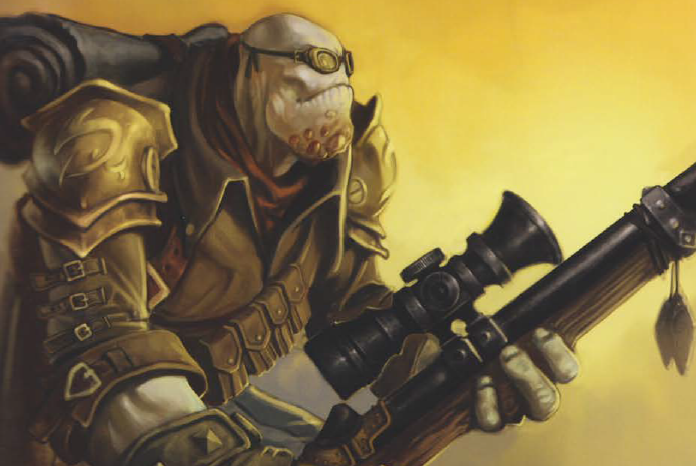
Grim Angus is a grizzled trollkin, a widely traveled bounty hunter and tracker. The mere rumor that he's on an outlaw's trail is often enough to get them to surrender or seek protection. He has turned his skills and immense rifle to the defense of his people now. He learned to hunt in the Wythmoor swamps of Ord. While an albino, he has forgone sorcery in favor of tracking and hunting, traveling the world. After exploring Ord and Khador, he began bounty hunting for a living, getting a thrill from hunting humans more than he ever had protecting them as a mercenary. He loves terrorizing his quarries. He's more drawn by the chance to test himself than the money, however, and eventually he grew tired of just taking out humanity's trash. They were cowards, and he found himself seeking out risk. He headed back home, only to discover the nearby Thornwood overrun by war, sending refugees to his homeland. The Tharn besieged his kriel, and many trollkin died. The stories he heard gave him new purpose, and he began to fight for the united kriels. He prefers to snipe with his custom rifle, Headhunter, then attack with overwhelming force. When the enemy is surrounded, he captures those that might be useful and kills the rest. His methodic nature is cold and calculating, but he's a master of the hunt, and he has no time for doubt. He will kill the enemies of the trollbloods, one bullet at a time. His gimmick is sniping, his feat debuffs foes with net traps.
Next time: Angry blue people
Forces of Hordes: Trollbloods
Original SA post Forces of Hordes: Trollbloods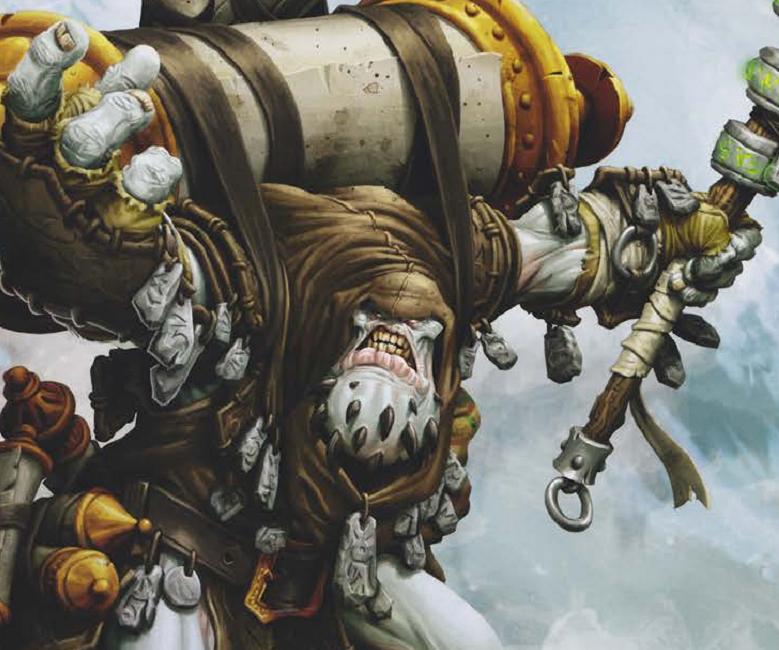
Hoarluk Doomshaper, Rage of Dhunia is Epic Doomshaper. He is immensely potent. He's spent a century gaining power, and he is feared and respected by many. He is a force of nature, incomprehensible but unstoppable, to be appeased rather than persuaded. Even as many trollkin flock to his side to hear his violent rhetoric, he is focused on a deeper goal. Being a war shaman is not enough - he wants to seek the depths of Dhunia's power, studying the Molgur before deciding to delve into dire troll consciousness. He unshackled his mind of restraint, merging with the dire trolls and living among them as a god. He has found power no other shaman knows, proving himself in a ritual witnessed by the most ancient dire trolls. He cut off his own hand and regenerated it in seconds, where it would take any other trollkin months. He has unlockedi mmense power and understanding of warbeasts, giving him unprecedented influence over his foes, even beyond the blood of trolls, to steal the essence of other beasts. His mastery of natural lore rivals even the Circle Orboros. In fact, he was so focused on gaining this power that he did not anticipate betrayal. A conspiracy in the Gnarls left him for Cygnar to cement a truce, and his capture and imprisonment have unleashed his full rage. No prison could hold him when the dire trolls could hear his call. Since regaining his freedom, nothing stops his wrath. His gimmick is messing with warbeasts, friendly and enemy. His feat buffs his warbeasts' speed.
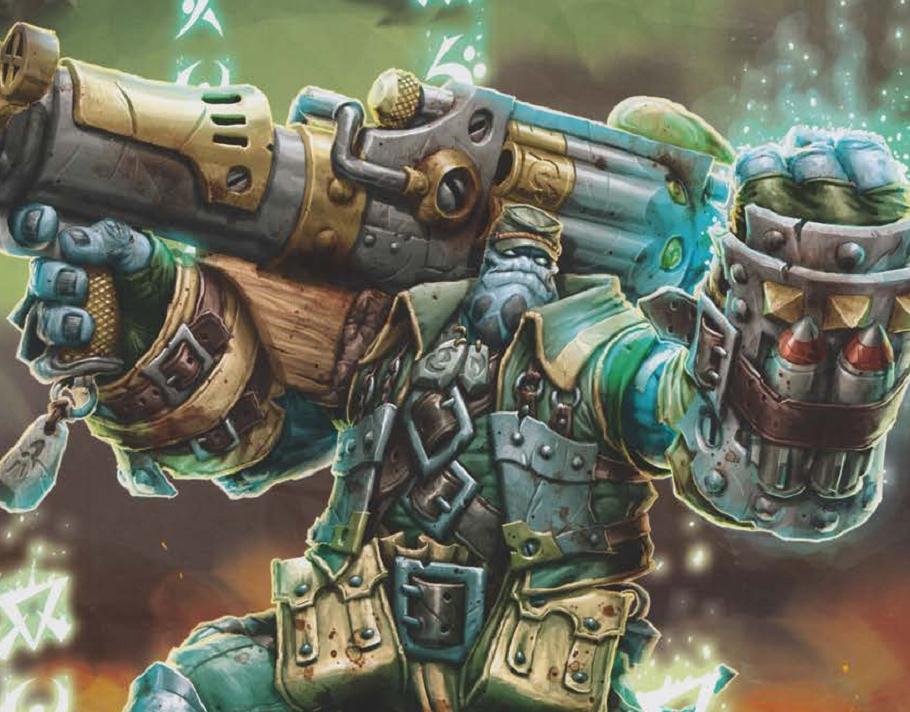
Captain Gunnbjorn was born in Ceryl, growing up in the Cygnaran city. His father, once a warlock, had allowed his power to fade from drunkenness and isolation. As a youth, Gunnbjorn never met full-blood trolls, and he was convinced tales of the wild warlocks were but myths. He was disgusted by his tribe's poverty and rejected the trollkin. He embraced humanity, enlisting as a trencher. Trollkin are not common in the Cygnarna Army, but they are never turned away. He rose to officer rank, earning respect for his tactics and planning, helping to rally the trenchers after the fall of Northguard. Throughout his career, however, he noticed the trollkin refugees fleeing the Thornwood and other regions. When he was ordered to oversee the displacement of a kriel near Point Bourne, he resolved to do his duty. An elder refused to leave his hut, and Gunnbjorn got into an argument and struck him to the ground, but the elder's stare shook him to the core. The soldiers set fire to the village before he could respond, and he could only watch as the trollkin were dragged out and pushed to the road. Reeling, he left his company to head home to Ceryl and seek guidance. He wanted to beg his father's forgiveness, but the man had died months before. The elders sent him to Madrak Ironhide, and the chance to put his training to a noble purpose appealed to Gunnbjorn. As he reached Crael Valley, wherE Ironhood and the Thornwood refugees gathered, Gunnbjorn felt his blood rising. Not only was he welcomed, but he felt an imemdiate connection to the trolls there. He knelt before Ironhide, who welcomed him back as a young warlock. Since then, Gunnbjorn has used every moment to help the trollkin, learing to control the trolls and train the trollkin and pygs as soldiers. He was away recruiting when Cygnar attacked Crael Valley, forcing the defenders to flee to the Gnarls, and he regrets that he was not there to fight, but he believes he has a longterm solution. His time in Cygnar has convinced him that the trollbloods must become a true nation with a true army, and he will see that happen. His gimmick is artillery fire and sniping, and his feat protects his allies from explosions and knockdown.
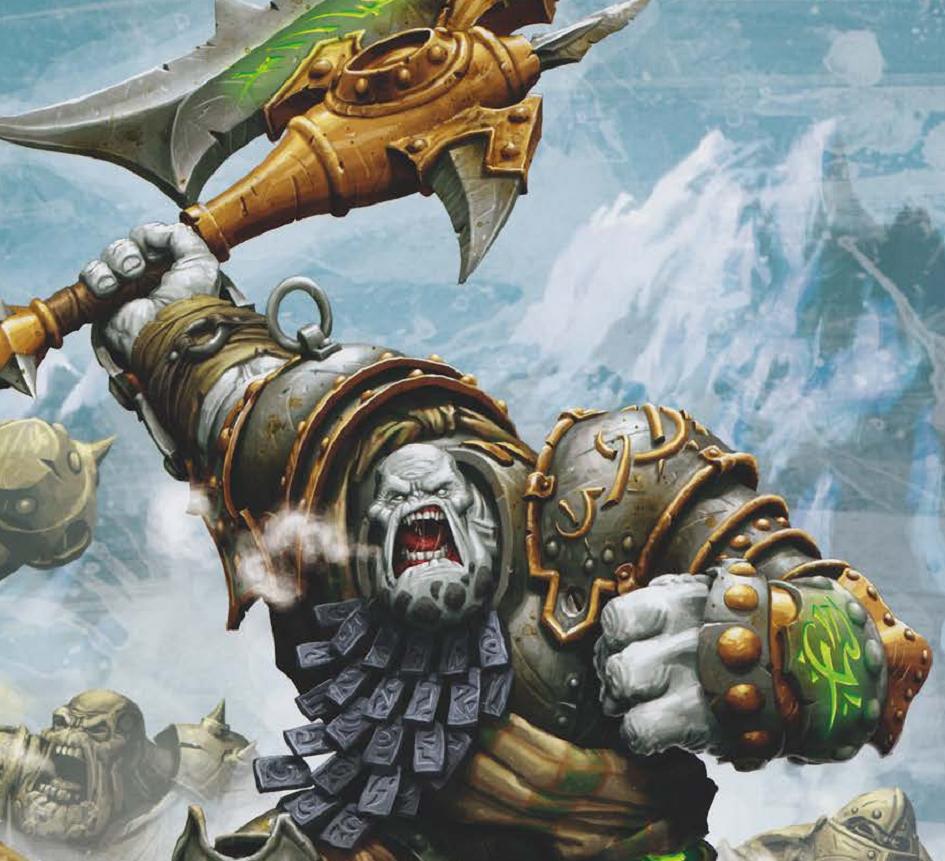
Madrak Ironhide, World Ender is Epic Madrak. When he first took up the axe Rathrok, he knew he'd taken a grim path, for it was cursed. Now, he fears the worst superstitions about it may be true. He hasn't given up hope, but he is haunted by tragedy. For a time, he was concerned only with his people's fate. In recent months, however, he's had more personal problems to worry about as well. As he used Rathrok, something awakened within it. Foul weather follows him now, and he suffers visions he knows are false. He sees corpses aorund him and the banners of forgotten tribes. Marks of war appear to him, and his blood longs for battle. His power brings him victory but not peace. He does not enjoy the caress of his mate or the sight of young trollkin. He sees signs of conflict everywhere and feels an ancient blood thirst. The warriors gathering around him now are darker, fiercer, more eager to kill and die. Friends that once trusted him are uncertain and fearful. He has tried to rid himself of Rathrok, but he cannot put it aside. It appears in his hand when battle comes, and even the best smiths cannot even harm the leather bindings on it. It has a job to do, and even death may not free him from it. He has begun to believe that his visions and impulses are a son of Horfar Grimmr reaching through the axe from beyond to influence him. If that is so, how much has he been influenced? His followers still shout his praises, but others speak warnings of him. Many are afraid of the storms that follow him, and it is he, not his axe, that is now known as the World Ender. His gimmick is combat buffs and having people die for him, and his feat lets his allies attack an extra time.
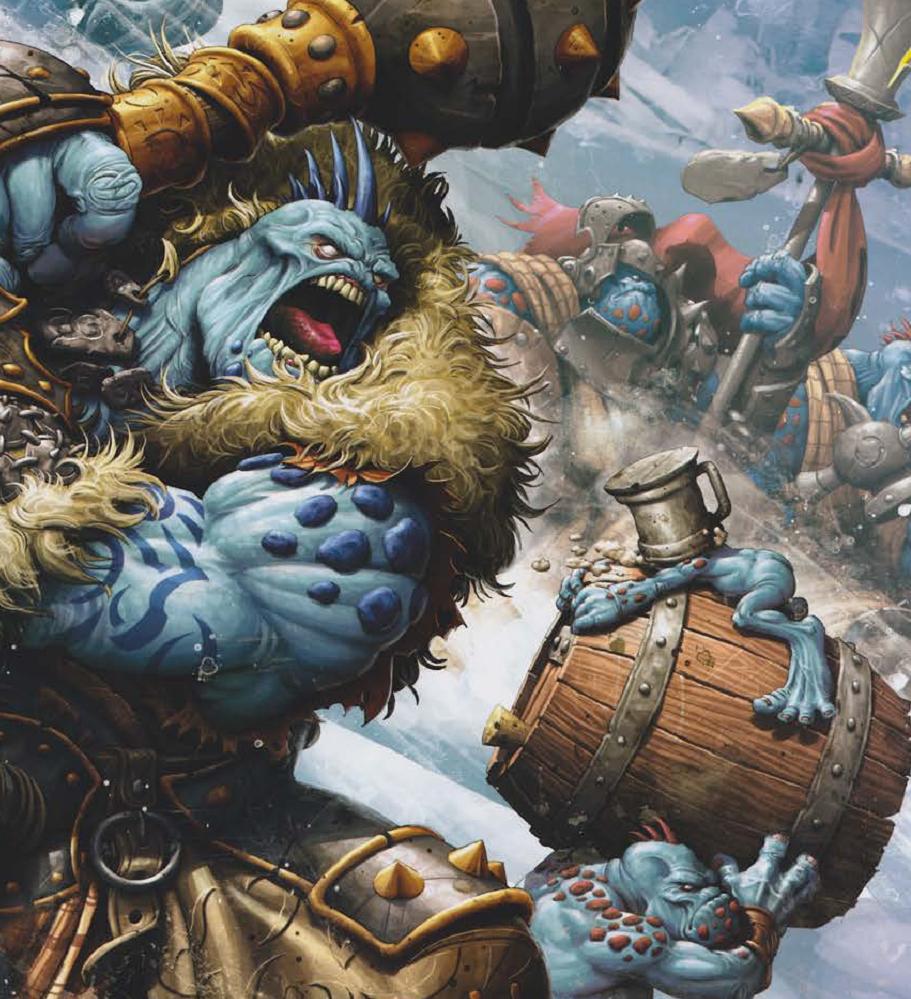
Borka Kegslayer is never without his Keg Carrier . He is a legend of the north, his wanderlust driving him from kriel to kriel with a loyal warband of rowdy trolls and trollkin. He is uncouth, even savage, like an ancient chief. At every battle, he leads his warband in drinking before the fight, then charges into the fray, surviving no matter what the odds and often winning by beating people to death. While he is a Dhunian shaman, he is nothing like the elders normally associated with shamanism. When Dhunia called him, he embraced strife and the great crushing the weak to carve immortality on the krielstones. He has no patience for diplomacy or compromise, and the only change he's had over the years is embracing the kith of many kriels, not just his own. He believes it is the responsibility of every shaman to ensure the survival and prosperity of the trollkin, and he has sex as much as possible to do so, having many offpsring. Rearing the young is not his job, nor that of any shaman, male or female, so he leaves it to their kith. Many of them have joined him in battle now. He is an absent0minded but enthusiastic mentor, though he tries not to form attachments to his fellow warriors. They die too often. He mourns them but briefly before moving on. He gained infamy after the humans known as the Ruscar slaughted many kriels. Borka and some warriors went to the Rimeshaws for revenge, calling forth the secluded winter trolls to help. The Ruscar gathered in ambush, but Borka and his warband swore vengeance and drank themselves into a mad frenzy, where they marched into the ambush and fought with massive fury. Several died, but the rest fought like berserkers.
When the battle was over, only two dozen trollkin had died to slay three hundred Ruscar. Borka then led his followers on the Ruscar villagers, routing them and driving them out. Never again did they threaten the kriels. Borka's reputation grew as he faced terrible odds over and over, always winning. He fought the Vorgol, the Vindol and even the Nyss. He freed an entire tribe of pygs from Galtor kriel, and they now serve him loyally, carrying his kegs in battle. He was initially displeased about the united kriels, considering unity to potentially weaken the trollkin, instead of strengthening them. He dislikes the Scarsfell elders and their attempts to manipulate, and so he chooses not to leave the trollkin in their hands - they won't fight for themselves. The elders dislike his influence over the young. And so it was unexpected when he joined Madrak Ironhide, as the two have usually been at odds, almost fighting several times. They have settled their differences, mostly - Ironhide fights at the front, and Borka respects that. The plight of the Thornwood also appeals to his better nature and his drive to fight on the losing side and still win. He can smell the doom on Ironhide, but he itches to be part of the war, to leave his mark. He believes the south can benefit from his virility, and he wants to help repopulate the Thornwood. His warband always follows, bringing chaos, revelry and destruction. His gimmick is buffs and drunkenness, and his feat boosts allied movement and power attacks.
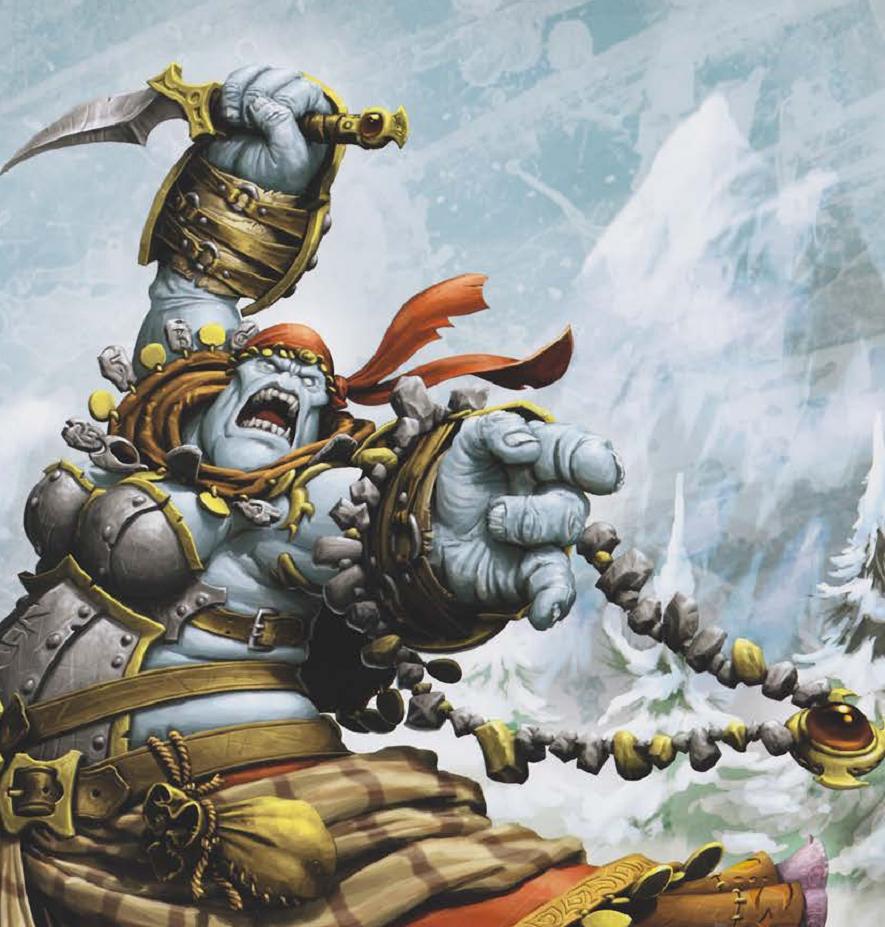
Calandra Truthsayer, Oracle of the Glimmerwood is a revered protector shaman. She is a beacon of hope and optimism, despite her ferocity in battle, which often shocks the refugees she helps and guides. Her maternal drive compels her to strike without mercy at those who would harm the trollkin she protects. She is more than just a shaman, as she possessed the true sight, able to sense the future by divination. She knows many ancient forms of augury, feeling each has merit. She might cast bones or runes, shuffle cards, check celestial alignments, watch the flight of birds, gaze into fire or read the entrails of her foes. All contain glimpses of the truth. She is determined to guide the trollkin through this time of chaos, helping find the best future. She rejects the grim omens of Madrak Ironhide and Hoarluk Doomshaper, joining the united kriels to lend her vision and leadership. She has pulled allies from the brink of defeat often enough that her followers don't think she's naive any more. They have faith in her. Though she made her name in the Glimmerwood, she is a wanderer who rarely stays in one place, which she considers a failing. She is welcomed wherever she goes, and she's never alone - she has an odd but dedicated band of followers, drawn to her for many reasons, who will fight to defend her. They are quite skilled, especially backed by her fate manipulation and luck magic. Her reliance on luck rubs some trollkin the wrong way, particularly Grissel Bloodsong, but others see it as proof that hope has its own power. Her gimmick is luck magic and her feat allows rerolls of low dice.

The warbeasts of the trollkin are not just beasts to be broken - hell, calling trolls beasts is hardly appropriate. They are blood relatives of the trollkin, willing fighters whom warlocks only sacrifice when they have no choice. They are very resilient, regenrating from wounds that would kill anything else, so they last a long time in combat. They also have very long lifespans, assuming no violent death, easily able to outlive their trollkin masters. While all trolls are related by blood, their adaptability allows for many subspecies. All are brutish and temperamental, but most fullblood trolls are smart enough to use weapons and speak Molgur-Trul, if not with large vocabularies. The larger trolls are almost always the most fierce, and dire trolls are massive - up to 18 feet tall, with tusks almost two feet long. They are strong, tenacious and exceptionally hungry at all times. They aren't so smart and until recently were believed too savage to even approach. Troll adaptability is also seen in their ties to natural elements, like cold, earth and fire. Trolls of these types dwell in secluded regions and their nature often has much to do with their environment and unusual diet. Winter trolls of the north can breathe ice, and pyre trolls can spew flame due to their consumption of oil in the Bloodstone Marches, while slag trolls eat stone and metal, evolving potent stomach acid that they can spew forth.
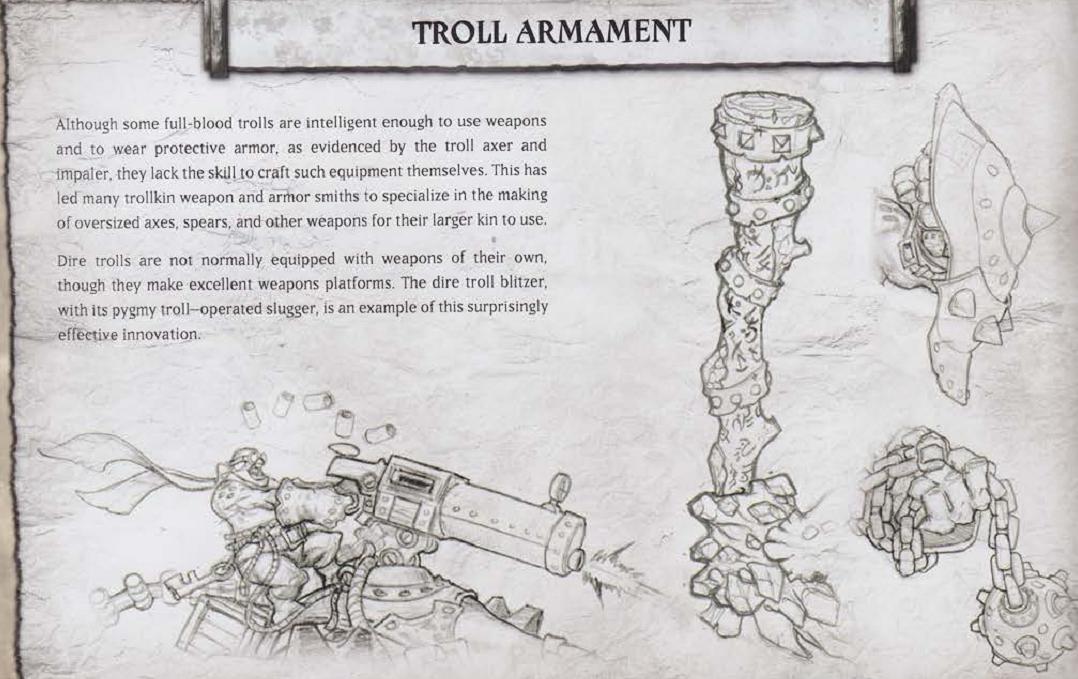
Next time: TROLL IN THE DUNGEONS
Forces of Hordes: Trollbloods
Original SA post Forces of Hordes: Trollbloods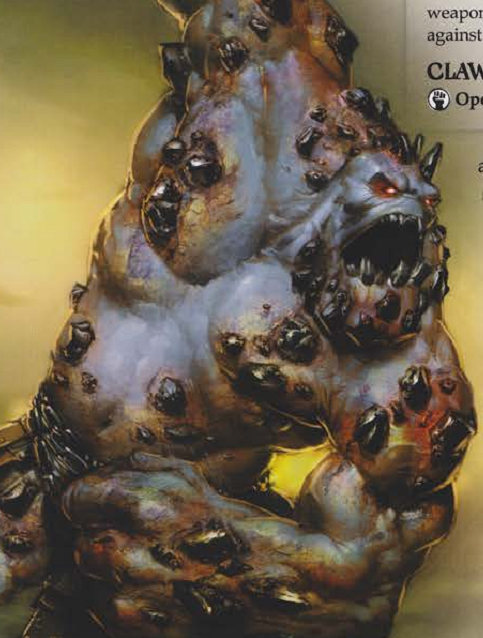
Slag Trolls are proof that trolls, in need, will eat anything. Specifically, they prefer metal, and they also metabolize powerful acids in order to dissolve even tempered steel. They are notoriously ornery, due to the pain of the metal shards that grow in their flesh, and their habit of spitting corrosive acid makes them very annoying to the foes of the trollbloods. They appeared in hostile mountainous and volcanic places and seem to prefer living near semi-active fumaroles and lava flows. Their diet has given them a reputation for stupidity, but other trolls admire their intestinal strength. The acids in their guts make them especially dangerous to warjacks, wolds and the undead. Their animus grants the touch of acid.
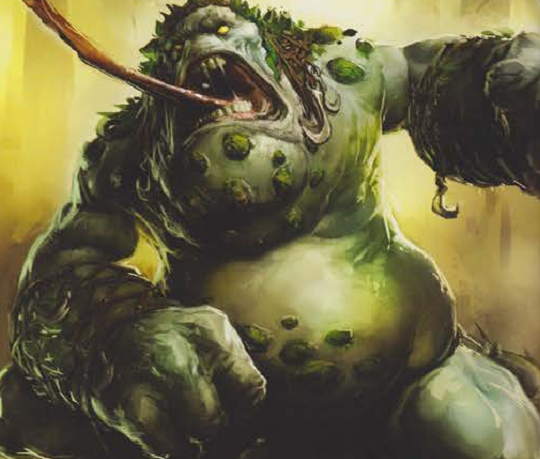
A Swamp Troll is a type of troll found in marshes and swamps, able to swallow a man whole. Their long, sticky tongues can strike at a long distance with accuracy, dragging their prey to them. They are happy to eat just about anything alive, of any size. They often accompany the Bloodsmeath and Fenn Marsh kriels, and until recently they were rarely seen outside their marshland homes. Now, however, they are frequently found serving trollblood warlocks, who value their surprising range. Their animus summons a protective swarm of flies.
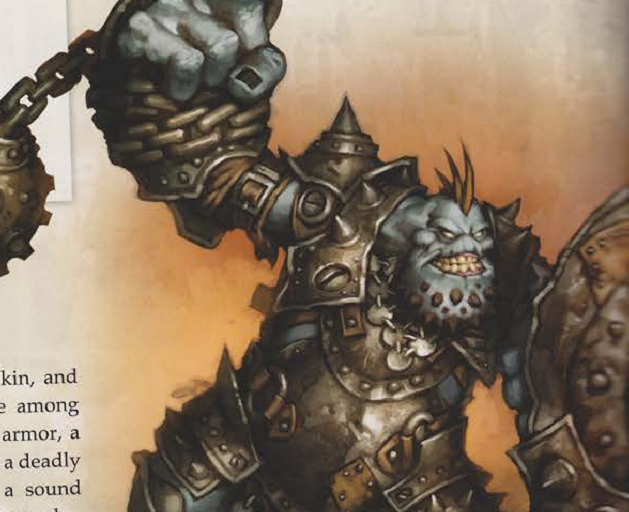
The Troll Bouncer wields an oversized ball and chain and is generally heedless of its own safety. They are favored for their instinct to protect their kin, and many have become prominent in the united kriels. They wear heavy armor and a big shield along with their ball, wading into walls of enemies to send them toppling down. They are part of a long troll tradition of forming attachments with the trollkin that feed them. Some show a loyalty and protectiveness otherwise unusual in trolls, giving many kriels reason to pick them for training in the use of shields. They will gladly charge into danger, even pushing allies aside to take hits for them, and are often seen guarding important trollkin. Their animus knocks enemies around when they hurt allies.
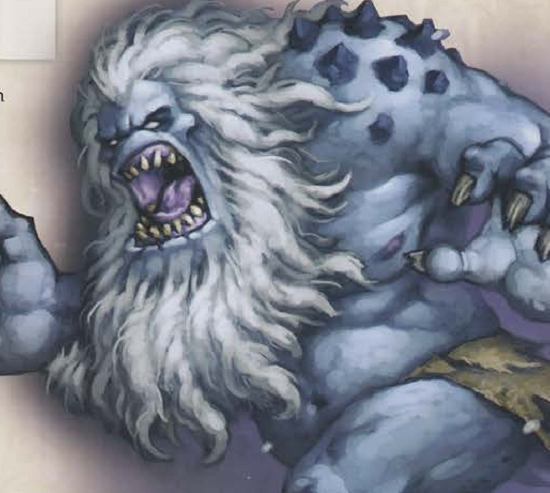
The Winter Troll is a terror to Khadorans, Nyss and even Rhulfolk. They emerge from blizzards, hungry and violent, spewing frozen breath to cripple their victims and feast on them. The trollkin of the Scarsfell sometimes befriend these creatures, using them as potent allies. Now, they have been goaded from their remote lairs to head south. Instead of the quills common to trolls of warmer climates, they have thick fur to protect against the wind and cold that would normally kill anything. They harness the power of ice and snow in huge bursts that choke the enemy. Even touching them causes a backlash of cold so extreme it can paralyze the muscles. Their animus grants this radiating cold to their allies.
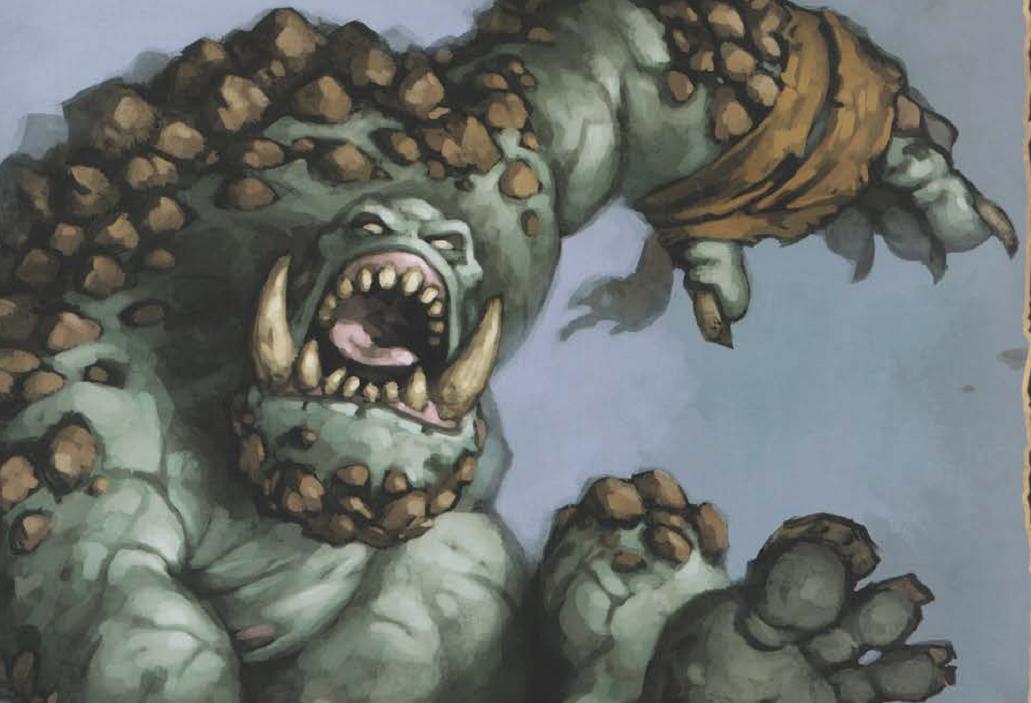
The Earthborn Dire Troll is a sign that Dhunia did, in fact, bless the dire trolls. They are believed by some to have been the first dire trolls, shaped from the stone by Dhunia herself. They certainly have a strong tie to her, with their skin rippling and changing as they move. Their skin hardens as they cross stone ground, but should they touch water, they gain strength and speed. Even more terrifying, they can dapat to imitate the power of their foes. When one charges a warjack, its fists grow as steely as the enemy's. They are the truest show of troll adapatibility, mimicing what they cannot destroy outright. Any dire troll is rare, but the earthborn were believed mythical until Hoarluk Doomshaper brought them out of the mountains. Their strength has proven invaluable to the united kriels, and few have the courage or strength to fight them. Some think their power is drawn from the vitality of their flesh, much like their regeneration - they just expanded on it so that their bodies react instantly to their needs in combat. Whatever the case, they have a power that surpasses any petty technology. Their animus gives some of their elemental trasnformative power to their allies.
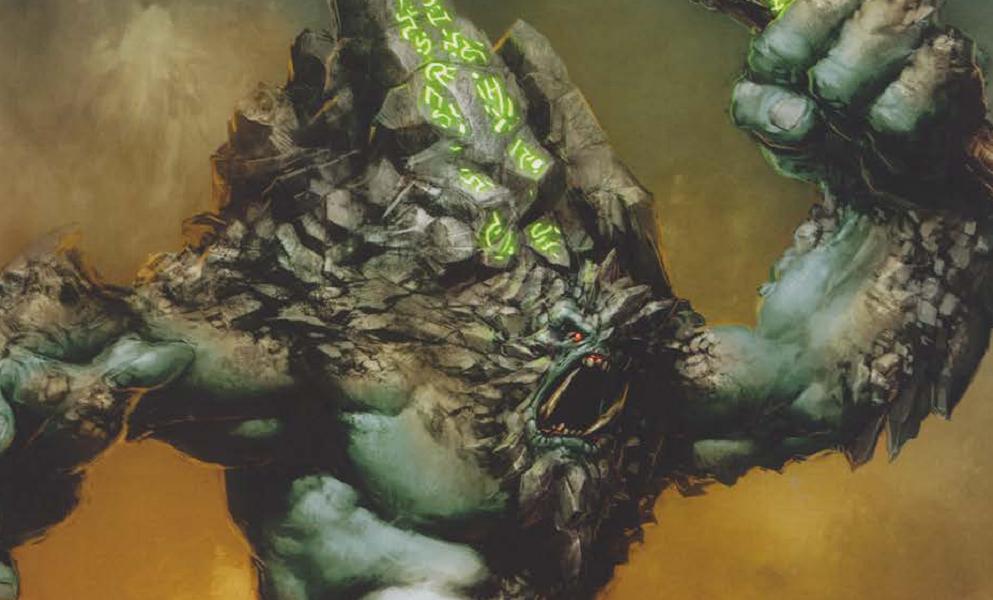
Mulg the Ancient is reputedly the oldest and most fierce dire troll on aen. He is old enough to have seen the Orgoth, and he demansd homage from all trolls he meets. Even young dire trolls are meek before him, abandoning kills for his hunger. He had only limited interaction with the trollkin before he came down from the mountains. Envious of their runes of power, he demanded runes be carved into his flesh to show his many great deeds. He can focus his rage into these runes to stifle the power of enemy beasts. Hoarluk Doomshaper first recognized the common thread of Mulg in old folktales of the Cygnaran kriels, speaking of a walking piece of the mountain. Doomshaper became obsessed with finding Mulg for years, and in 603, he made his way into the Wyrmwall, stirring other trolls who followed him to observe how Mulg would treat him. They gathered when Doomshaper presented himself, and he startled them by invoking the traditional dire troll greeting ceremony, putting on a show of aggression and inviting Mulg to punch him. Mulg did, shattering his upper body and sending him flying. He laid still until he could mend his flesh, and though he coughed blood, he did speak to Mulg. No creature had ever survived such a hit, and Mulg was so impressed that he named Doomshaper 'Krol.' They shared their blood, and since then, Mulg has considered Krol to be his tiny brother. The precise meaning of the name is disputed, but it probably means 'not food,' a profound abstract concept for dire trolls, who will eat anything. Mulg also gave Hoarluk such respect through this that the dire trolls obeyed him. Mulg has stayed out of the wars, prowling for the food he hungers for constantly. However, in recent months he's felt the call of his blood bond to Krol, hearing the shaman's voice in his mind. When humans captured and locked Krol away, Mulg was enraged, leading the dire trolls to free him. Anything living that did not flee from them was grabbed and eaten alive. Mulg's animus blocks enemy spells.
Next time: Armies of the kin
Forces of Hordes: Trollbloods
Original SA post Forces of Hordes: Trollbloods
The trollkin who fight are from many kriels and cultures, and they are often very different in appearance. However, all of them are determined warriors who embrace stoic defense. The trollkin who can claim the title champion are the ones everyone aspires to be, the living heroes that will be remembered in the krielstones. Unlike other warriors, who hope to return to their peaceful lives, the champions fight until they are physically incapable of doing so, and only then become advisors to the chiefs. In the past, wargbands were warriors under a chief for a specific cause, staying together generally only a few years. Modern warriors, however, will follow a charismatic and succesful chief for glory rather than a cause. Most commonly, though, warriors fight to protect their kin. Almost every adult trollkin has had to fight at least once or twice. Their supply lines are tenuous, and they often go hungry. Most food is given to the trolls, and even the leaders eat no better than the main force. Individuals of skill like elemental sorcerers and shamans sometimes join the warriors in battle, helping a great deal with morale. The only real divide between warriors is between the more traditional types and those that have embraced modern weapons and tactics. For generations, most trollkin warriors have been trained by their elders and wield ancestral weapons, but that's harder and harder to do these days. The leaders of the united kriels have embraced modern methods, even techniques from the Iron Kingdoms armies. They produce warriors faster, and to a high standard. These warriors take orders better, too, and are more disciplined. Traditional warriors, however, like the champions have their own codes of honor and behavior that can conflict with this. Still, even the most modernized warriors are deeply tied to trollkin tradition, and ritual tattoos are common using toxic pigments that resist the skin's ability to restore itself. Every trollkin values individual freedom, even the most disciplined ones, and this is one of their greatest motivators as a race: the chance for all of their kith and kin to live as they choose.
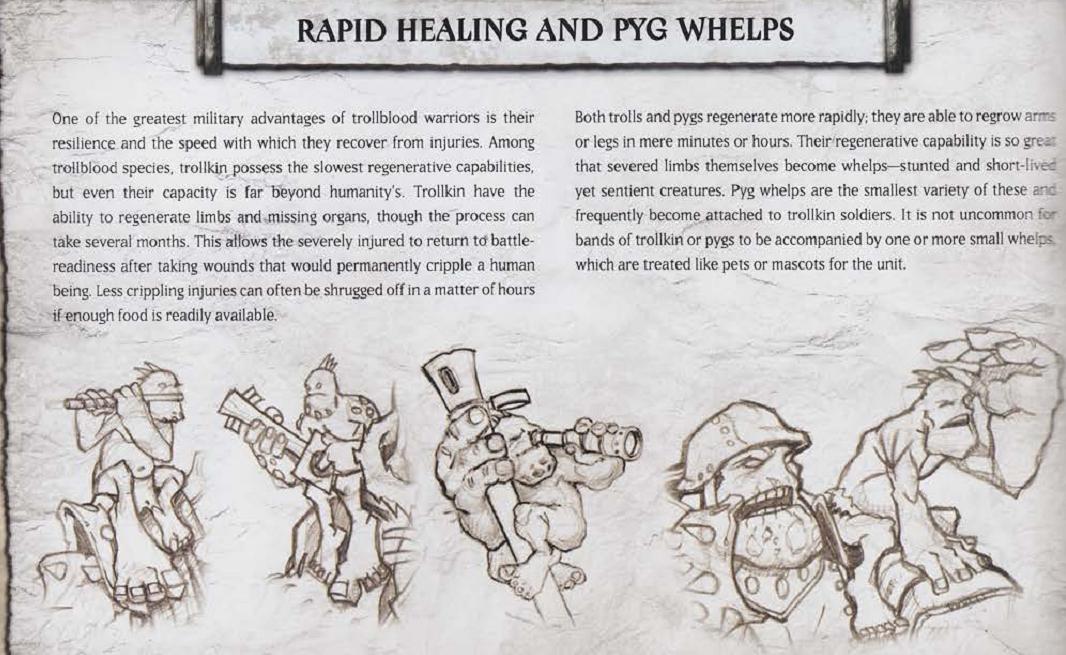
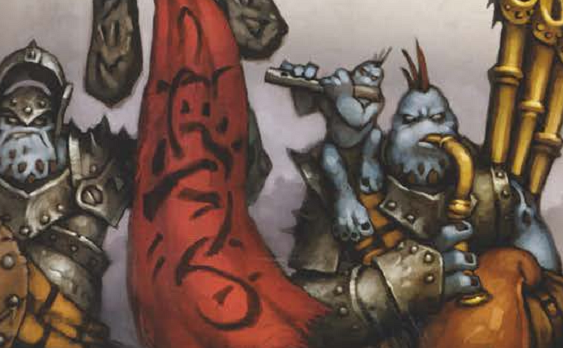
Kriel Warriors are sometimes led by a Kriel Warrior Standard and Piper . The kriel is the heart of trollkin life, and each has their own customs, often expressed in their unique quitari patterns and their music. When the warriors had to battle, they march to their kriel music beneath a great banner of their families. Each kriel records in stone, but also cloth, because stone is not easily transported. Banners are potent symbols of their histry and what they fight for, and a standard is topped by a burning brazier, visible from a great distance. The sight of the banner inspires the trollkin to fight despite great wounds. Pipers are the preferred musicians of the trollkin, as they have naturally large lungs. Their songs coordinate long journeys and keep the warriors cheerful even on forced marches, while their more mournful tunes and dirges remind all of the sacrifices of the dead.
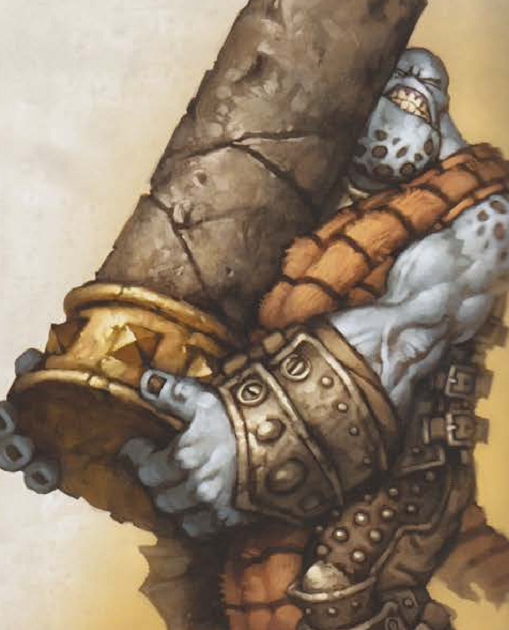
Kriel Warrior Caber Throwers come out of trollkin entertainment. Trollkin games were often evolved from ritualized combat training, and hurling cabers has proven as surprisingly powerful tool in combat, if crude. Cabers were originally wood, but the Gnarls kriels took it to the extreme, using stone columns of immense size. They're backbreaking but well worth it on the battlefield - they crush just about anything. Only particularly strong trollkin of immense endurance can even carry these weapons to battle.
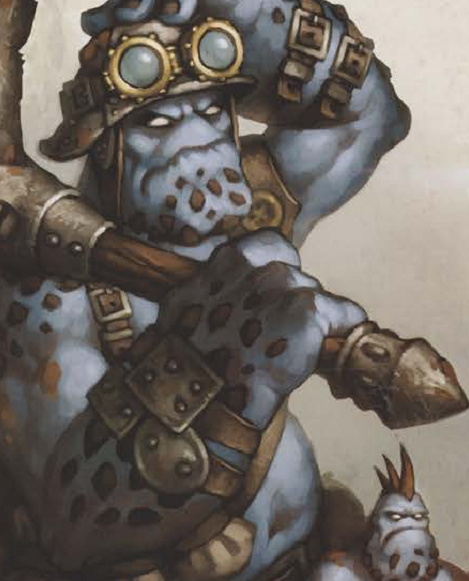
Pyg Burrowers have been trained after the success of giving the pygs rifles. They are loyal and skilled earthmovers and sappers, mixing their endurance as trollbloods with their small size to be excellent diggers. No sane creature would follow them in their quickly collapsing tunnels, of course. But few sights are so chocking to the foe as a group of pygs exploding out of the ground. They might look funny, but they are a real threat, wielding huge-bore slug guns as well as mining tools. They love attacking, knowing that if they can't kill the foe immediately, they're probably dead. Burrowing pygs must be equipped, though, which has led to trollkin raiding for powder and guns as well as buying from black markets and mercenaries. It was on these raids that they found the slug guns, which have been perfect for the pygs, designed to penetrate armor at short range.
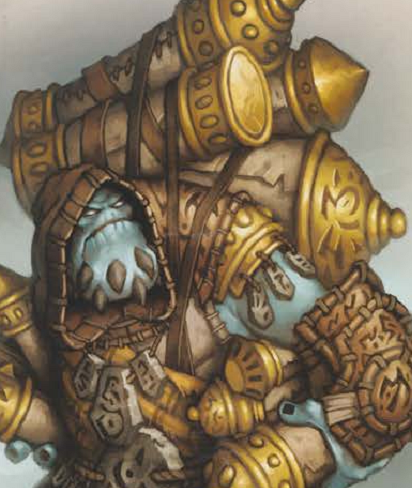
A Stone Scribe Elder will sometimes lead the stone scribes. They have spent decades on pilgrimages to the important krielstones, studying the tales and learning from the shamans. They understand the heroism that powers a krielstone. Their respect for runecarving and history is vital, as they are not just historians, but sacred priests. The shape of their runesm ust convey the spirit of those they are writing about if their power is to be captured. Their scrolls and rubbings are endless, and they are adept at tuning krielstones to their purposes, drawing on the echoes of ancient heroes.
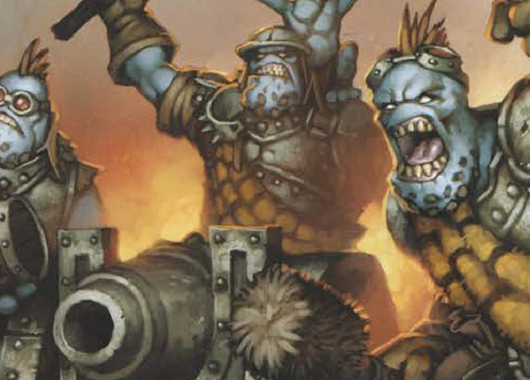
Thumper Crews use carronade guns given to Madrak Ironhide by King Leto. They require less powder than normal cannons, making them ideal for trollkin, who don't have much powder. They weren't originally intended for land use, but they've been vital to the trollkin against the skorne...and against Cygnar, who faced them when fighting the Thornwood kriels. The trollkin have named the guns thumpers for the noise they make when fired. Their small size makes them relatively easy to transport, so they're well suited for rapid reployments and the ambushes favored by the united kriels. Fighting smoothly as a crew is not natural to the trollkin, though, and they need volunteers willing to endure the training and drills of being on a thumper crew. Still, the undeniable results have led to a steady stream of volunteers and requests for thumper backup.
Next time: the Blue Man Group goes to war
Forces of Hordes: Trollbloods
Original SA post Forces of Hordes: Trollbloods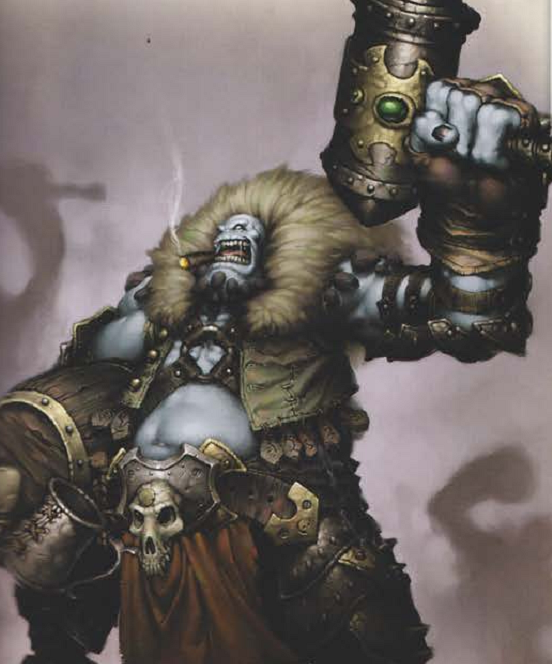
Skaldi Bonehammer can be found leading the champions. He is an ally, rival and drinking buddy of Borka Kegslayer, and he hungs for both glory and vengeance on humans. He's smashed many skulls with his giant hammer and his presence is inspiring to other trollkin. In his youth, he traveled the Scrasfell, fighting the human tribes there, the Khadorans and other kriels. He took any excuse to fight. When Kegslayer joined Madrak Ironhide, Skaldi did not. However, in time, he heard about the battles in the south, and eventually, he realized that it was his chance for true glory. In order to prove himself Borka's equal, he took his warband south to seek out the greatest battles.
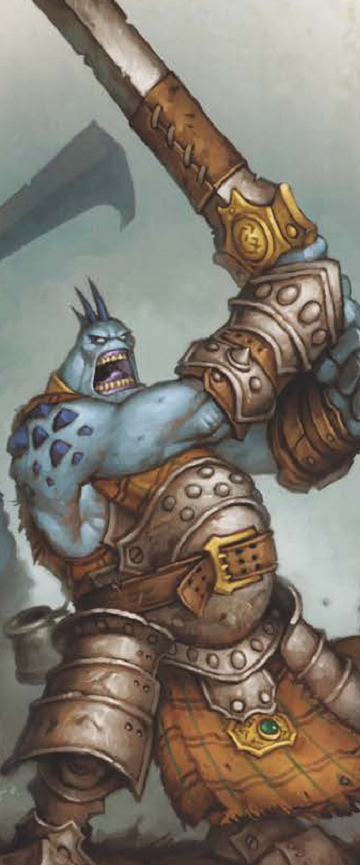
The Trollkin Fennblades meet their enemies as they charge, waiting for the fools to get close. They duck lances or sidestep attacks and cut down the enemy without a blink. During the first Trollkin Wars, the kriels of Fenn Marsh, near Mercir, banded together for safety. They never got the fame of the Thornwood battles, but they were potent. As stories of their victory spread, other kriels took similar methods, using the name Fennblades to honor the Marsh kriels. The hooked sword they use is the preferred weapon in the Fenn Marsh, and it is difficult to master, even for the strongest trollkin. The techniques take long drilling and more discipline and coordination than most trollkin usually have, making them ideal for the more cohesive forces the modern leaders want.
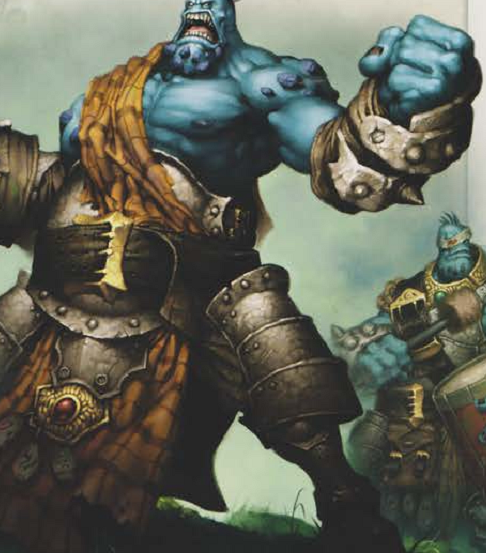
A Trollkin Fennblade Officer and Drummer sometimes lead the Fennblades. A kithkar, as these officers are known, must first prove their courage in the face of certain death. Those they lead know they will fight in the bloodiest parts of the battle without worry for their own safety. Under such a kithkar, they are a force of nature, unstoppable and immovable. The drummer keeps them in step, and they can steel themselves against any assault without worry. Their countercharges are enough to terrify anyone.
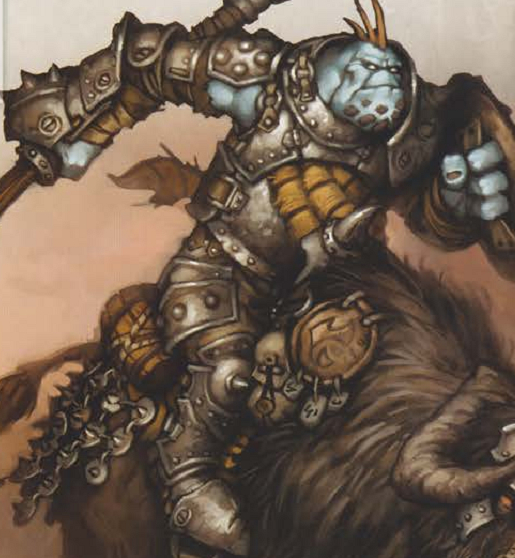
Trollkin Long Riders ride into battle atop massive bison. Few things can match their power and momentum in a charge, shattering enemy lines with ease. The southern kriels have no long cavalry traditions, given their wooded homes, but in the open areas of Khador, the trollkin have long rode the bisons, as horses are uneasy in the presence of trolls. The most famous of the battle riders, the long riders are notable for their endurance, sleeping and eating in the saddle. They dismount only when they must, and it is said that their moods and those of their mount are linked - if one is angry, so is the other.
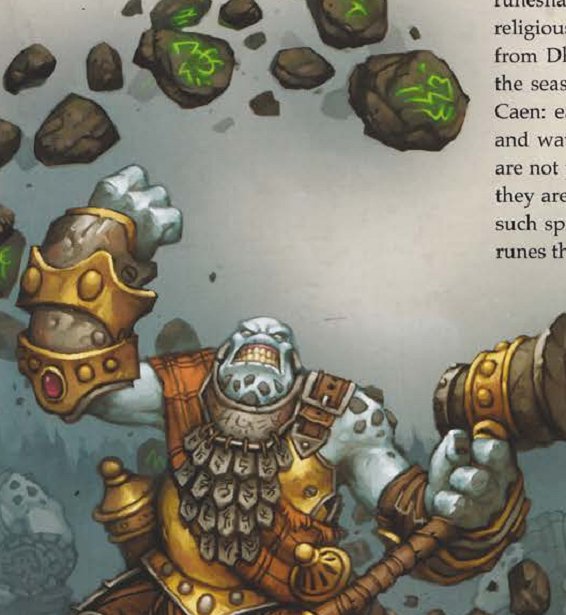
Trollkin Runeshapers are terrifying sorcerers, able to manipulate stone. They command rocks to rise and fly at their foes, and unlike sorcerous humans, they're easily recognized at birth because all are born albino. They soon master their inborn power, and in larger kriels, the elders teach them directly. More aggressive sorcerers become great warriors, using their magic to destroy their foes. While their power resembles druidism, they have no affinity for the blackclads, and the religious among them claim their sorcery comes from Dhunia, not the Devourer Wurm, and is tied to the seasons. Earth power is of spring, fire is summer, ice and water are winter and storms are autumn. Runeshapers aren't priests, but many believe their power is a sign that they are hands of Dhunia's wrath. Others ignore spiritualism in favor of the raw power of their runes.
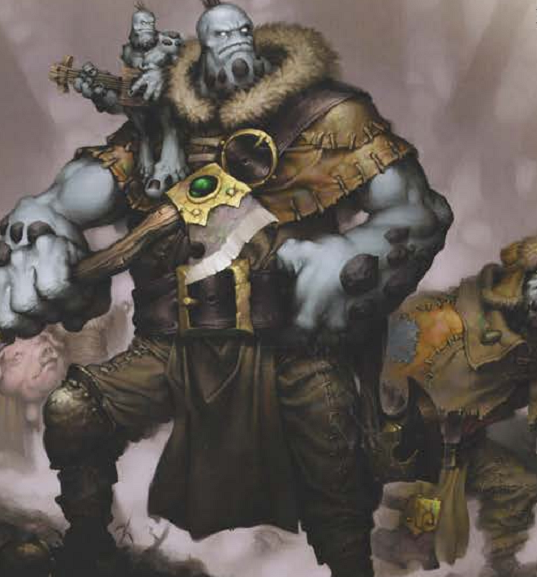
Trollkin Scouts are wilderness experts, forced to adapt to life in remote kriels. They hail from the Wyrmwalls, Marchfells and other backwoods kriels, hunting, trapping and tracking. They learn to avoid the monsters that plague their homes, and every trollkin from these regions becomes an expert woodsman just to survive. For centuries, they rarely interacted with their kith and kin in other places, but isolation cannot be afforded now. They have answered Ironhide's call for solidarity, serving as scouts in the warbands of the united kriels. They are expert hunters and trackers, able to move unseen in any terrain, and they are natural guerilla fighters. They ambush foes quickly even in impassable terrain, hurling axes with deadly accuracy before they engage in close combat. They may seem primitive, but their skills must be respected.
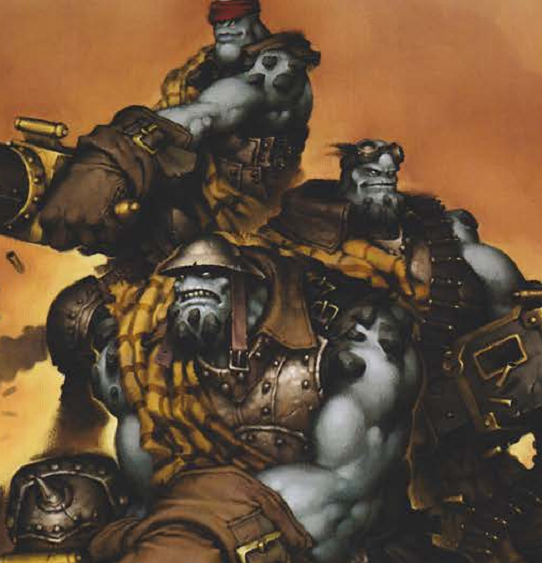
Trollkin Sluggers are the best disciplined of all the trolkin. Many are veterans of the Cygnaran Army or trained by them. They fight in small bands, unleashing hails of bullets from their sluggers to clear firing lines for other trollkin. They cut down infantry and warbeasts alike with these massive, chain-fed cannons, which were originally meant to protect entrenched positions. They were acquired several years ago as surplus Cygnaran arms, and they were originally used to defend villages, but as battle came more often, they found new uses. Humans can barely lift the guns unassisted, but trollkin wield them with alarming ease, and while they mount some on top of dire trolls, they carry others. The first sluggers were gained by trade, but Cygnar began to restrict their sale, and so the trollbloods stockpile them at every opportunity, as they are vital to new trollkin tactics.
Next time: EAT THE BABIES
Forces of Hordes: Trollbloods
Original SA post Forces of Hordes: Trollbloods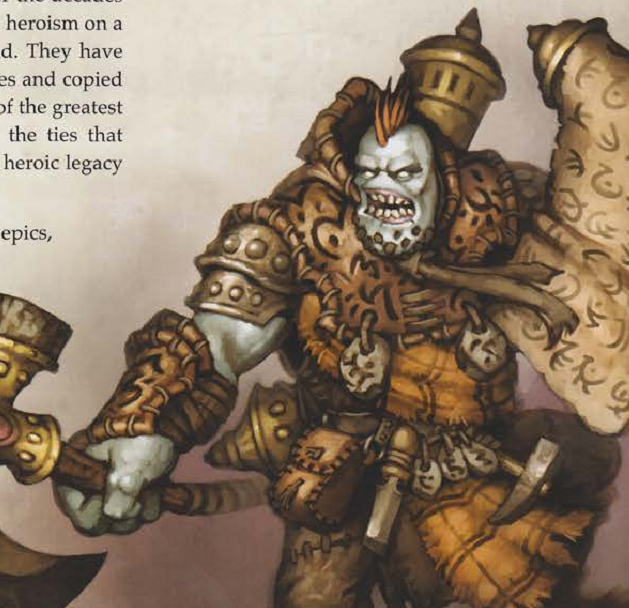
A Stone Scribe Chronicler is an elder scribe who has spent a long time witnessing the champions in battle, carving their deeds on the krielstones and scrolls. Stories have power in the minds of listeners, and the chroniclers know the heroic tales by heart, telling them to the warriors to restore morale in times of low food, many deaths or impossible odds. One favorite tale is the story of Grindar and Gelfas, who helped in the Orgoth Rebellion. In the Valley of Mist, a small group of trollkin used a fog to ambus hthe Orgoth, and as things began to look grim for Chief Grindar, his son Gelfas arrived with mighty trolls, battling to save his father. Indeed, over the next few days, he gave his life to buy time for reinforcements. By this sacrifice, Grindar was able to achieve a mighty victory against the Orgoth, though his heart was heavy.
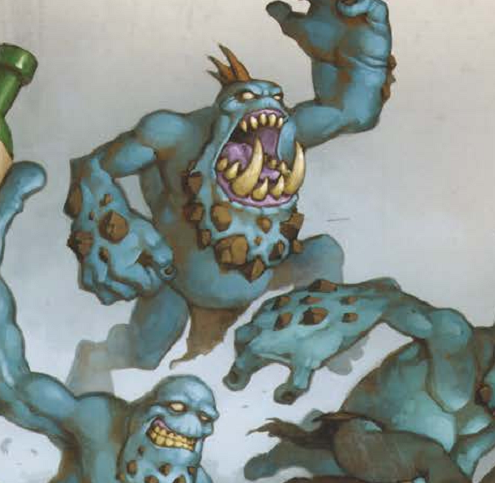
Troll Whelps are kind of a consequence of troll regeneration. They are degenerate beasts born from severed limbs or large lumps of flesh. After all, when a troll loses that much meat, it stays alive, regenerating a head, torso and limbs. These tiny 'trolls' follow their 'parents' by instinct. Their rapid growth, while amazing, does not produce a full troll. Instead, they are small creatures with disproportionate limbs matching whatever they were spawned from and not even the brains of a troll. They aren't very dangerous and don't live for more than a few years. Particularly stupid dire trolls may mistake the mfor true offspring, but that is rare and never lasts very long since they don't grow bigger. Most trolls consider their whelps to be just extensions of their own bodies. They tend to let whelps do as they please, but if no other food source is handy, trolls will eat their whelps without care. In fact, they're an excellent source of emergency food to fuel regeneration, and it's not uncommon for a troll to laugh at the antics of a whelp and then snack on it seconds later.
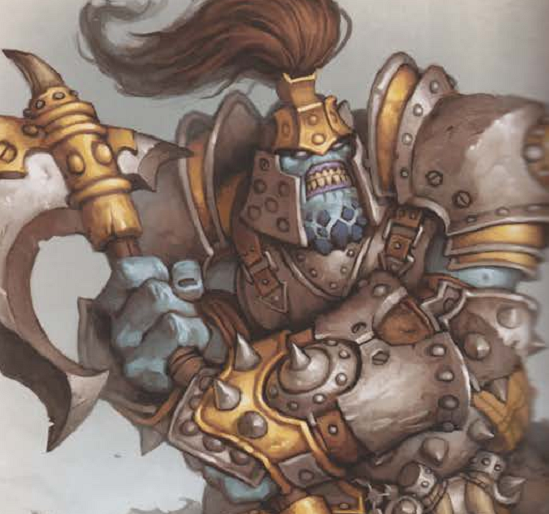
A Trollkin Champion Hero is a famous troll, a great champion whose deeds are told across the kriels, a living legend. They are hardened by countless battles, saving entire kriels. They tempt death in every battle, knowing that if they fall, they will live on in memory. They take comfort in knowing that songs and stone will immortalize them long after their own deaths. Not all are the same, of course - some are berserkers of poor temper who, in peacetime, strain their kin's patience. Others are brooding and introspective, or vain and arrogant. But each is alike in battle, for they all put aside thoughts of safety in order to protect their kith. They cannot turn away from battle.
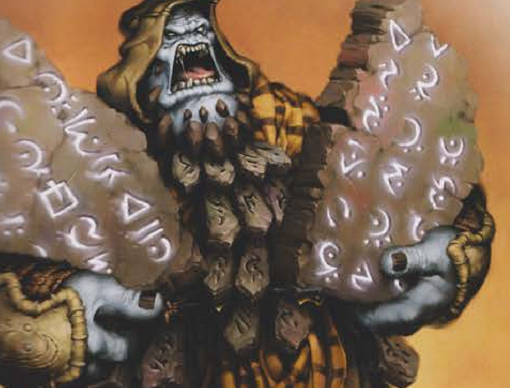
The Trollkin Runebearer is an elder scribe, studying the stone secrets of Dhunia. Sometimes, they travel across the kriels to study history and learn the connections between events. When they begin to comprehend all this, they unlock the raw power of the trollkin. Warlocks and chiefs seek the mout to understand their destinies, and runebearers may sometimes choose to accompany a leader to help divine their fates. They follow warlocks into battle, using the power of their stones by speaking passages aloud. These tablets glow with magic, becoming weightless and aligning with the warlock's will, allowing the runebearer to help them weave potent magic. Few greater honors are available than to be accompanied by a runebearer, and it is a sign of great respect.
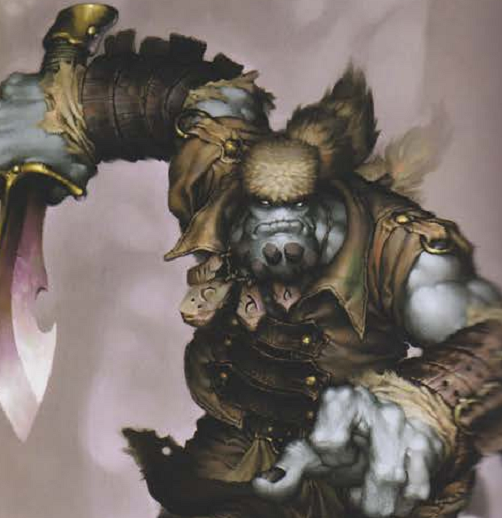
The Trollkin Skinners are not comfortable invillages, living as hunters in the wild. They wear the pelts of their kills and are rarely seen by other trollkin save when they come to trade pelts for supplies. In the wild, they must be ready to survive very hostile environments, facing terrifying monsters that can see through any concealment. They fight satyrs and gorax, and there's only a few chances to take them down before you die. They must use their knives on tendons and internal organs, disabling these beasts as fast as possible. They are often rather eccentric, capable of going years without speaking. Most identify as part of their communities, but some of them see to their survival before any other overall good, especially if not paid. It's not uncommon for some to return home, however, and help their kin, if a bit grudgingly. They heed the call of battle sometimes, serving as advance scouts. Theior skill at killing beasts is also very useful, and they're no less good at taking out smaller prey.
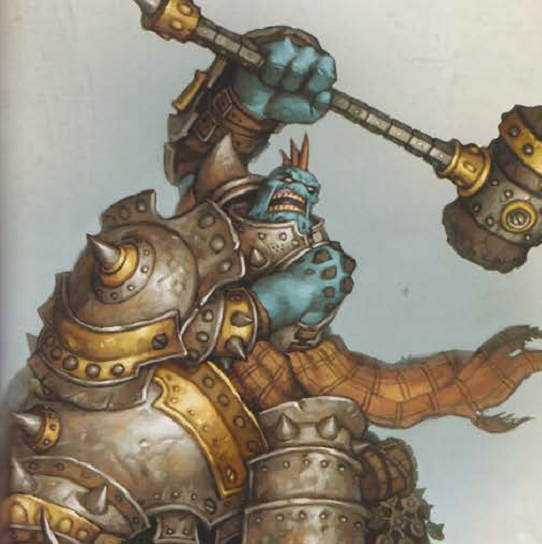
Horthol, Long Rider Hero is a might chieftain, but he has given up leadership of his kriel to serve Ironhide, whom he believes is destined to reshape the world. He is loyal over all else, even as others betray Ironhide or name him World Ender. His bond was forged in the Thornwood, where he was raised to hunt. His kriel fell quickly to the Cryxians, and few of his kin survived - and then, only because of Ironhide. He knew then that Madrak was his true chief. Those who ride with Horthol find it hard to believe that he wasn't born in the saddle. He proved his skill quickly, and the long riders soon welcomed him as brother and leader. Now, he commands Ironhide's cavalry, drawing other riders to the cause. He intends to stand by Madrak even when Rathrok invokes its final doom, even if it means dying to save Madrak Ironhide. Until then, he leads the long riders to victory.
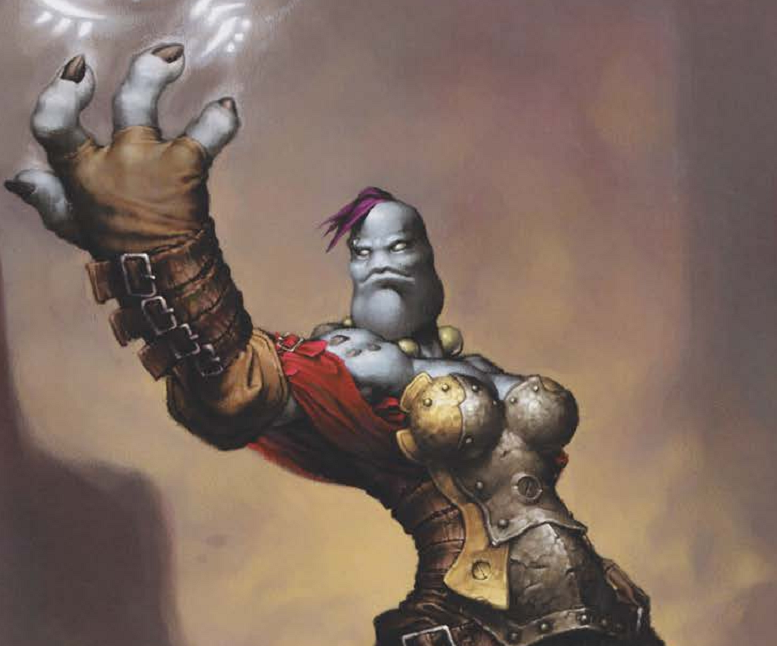
Janissa Stonetide heard the all of stone before her first word. Her earliest memory is the lullaby of the living rock, and by the time she came of age, she knew the deepest secrets of the Gnarls runeshapers. By 20, she was theo ne called on to help the elders with runes. Some traditionalists believe her experience is dangerously close to the wilding of the blackclads, perhaps a legacy of the link between the Devourer and Dhunia. In some respects, she does resemble the Circle's earth-shapers, but she ignores all that, convinced her power is a gift from Dhunia. When she knew she'd learned all she could, she set off for the wilds, seeking the greatest stone formations around. She ignored the borders of the Iron Kingdoms, following the whispers of stone that only she could hear. The highest peaks of the Wyrmwall spoke to her of a time before trollkin, teaching her to strike down her foes with the power of an avalanche. The Bloodstone Marches told of the great rock masses moving beneath the world on a scale impossible to imagine. She learned to compress these rhythms and cause the earth to shake and thrust upwards. When she returned to the Gnarls, however, she found it in shambles, overcrowded by refugees from Crael Valley. She began to understand why she was given her gift, and for the first time, she felt a motivatio beyond the spiritual. She took up the pickaxe Earthsplitter to defend her kin, having made it to explore but, giving it the proper runes, she turned it into a weapon able to sunder any armor. She knows now that the stones speak to her that she might deliver hope to her kith and kriel and bring their vengeance on the foes of the trollkin.
The End!
Next up, Legion of Everblight, and then we get into the all-faction expansion books.
Forces of Hordes: Legion of Everblight
Original SA post Forces of Hordes: Legion of EverblightThe Legion of Everblight has become a dire threat in mere years. They are the ultimate weapon of the dragon Everblight, whose body was destroyed centuries ago but whose athanc survived. He lured the ogrun Thagrosh to free him from his tomb, and then he corrupted and dominated the Nyss elves and some of the ogrun of the mountains. His athanc is implanted in his chosen generals, turning them into warlocks of the Legion, who share thoughts with him. The greatest strength of the Legion is in its dragonspawn, the beasts that are born of dragon's blood, which are exceptionally agile, brutal and tough. If they were not enough, however, the Legion is excellent at supporting and managing them.

The armies of Everblight are unprecedented, blessed by his perfecting blight and accompanied by dragonspawn born of his alien mind. His legion is as devoted as the followers of any god, seeking to die in his name. Toruk's other progency have made blighted slaves, but only Everblight has made it an art, corrupting and reshaping life in his own image. He has forgone physical form to perfct his armies, making in but a few years a force to challenge Toruk's millenia-old undead legions. They have been honed into instruments of his will, their physical bodies reshaped for his purposes. They measure victory only by the destruction and consumption of athancs. Everblight has initiated a plan of conquest at a desperate pace, and while he's capitalized on his bodiless nature, it leaves his legion vulnerable. Without a dragon supporting them, they must rely on speed and numbers to survive, and the plan must move very, very quickly, with blod and rash actions by the timescale of dragons.
This is not Everblight's first legion. Long ago, when he still had a body, he dwelled beneath the kingdom Morrdh, binding them to his will and breeding the first of his carefully made dragonspawn. The Lords of Morrdh served his will but did not entirely submit, insisting on retaining free will while he used the dragonspawn to hold up his end of his bargains with them. It was a fertile age of experimentatiion and genesis of dragonspawn, and the wars of Mrrdh proved an excellent testing ground for their forms. In time, Everblight made a host of them, each with a distant acho of his glory. Other dragons' spawn were random creatures, not able to be made in numbers. Despite the supremacy of his methods, though, he was not satisfied. They wer deadly, but had to be close to him to obey any but the simplest command. That was the price of absolute loyalty, and he needed minions of greater will and autonomy. Before he could move on to that stage, however, Toruk found his location and descended upon him, and while he escaped by leading his father to one of his siblings, he realized he had to be careful to avoid discovery again - the dragonspawn gave him away. He spent centuries recovering from his wounds in the Skybridge Mountains, watching the Iosans. In their decline, he saw opportunity, sensing the spiritual void they suffered without their gods. After the Rivening shattered the minds of their priests, he took advantage of the chaos to hide beneath Issyrah.
He uses his mental influence to subtly summon elves from the Iosans, beckoning the hopeless and yearning. Those compelled to make pilgrimages to the crused fane of Ayisla found Everblight waiting for them, experimenting in corruption and shaping of their bodies and minds. In time, heh oped to control them entirely, turning them into tools. For centuries, he chose Iosans to study, their families never knowing what hapepned to them. By exposing them to controlled degrees of blight, he was able to maintain a terrible influence over them, gaining near-total mastery over their flesh and remaking them into weapons. Before he could capitalize on this, however, the Iosans discovered his existence. He had to unleash his full strength on them, reducing the city to ruin, but he misjudged the power of his foes in his rage and was taken out, his flesh destroyed and his mind sealed within his athanc, which was imprisoned on a mountain. This defeat was in part caused by his rage overtaking his reason, and it altered forever how he viewed his power and its limits as well as the need for an army.
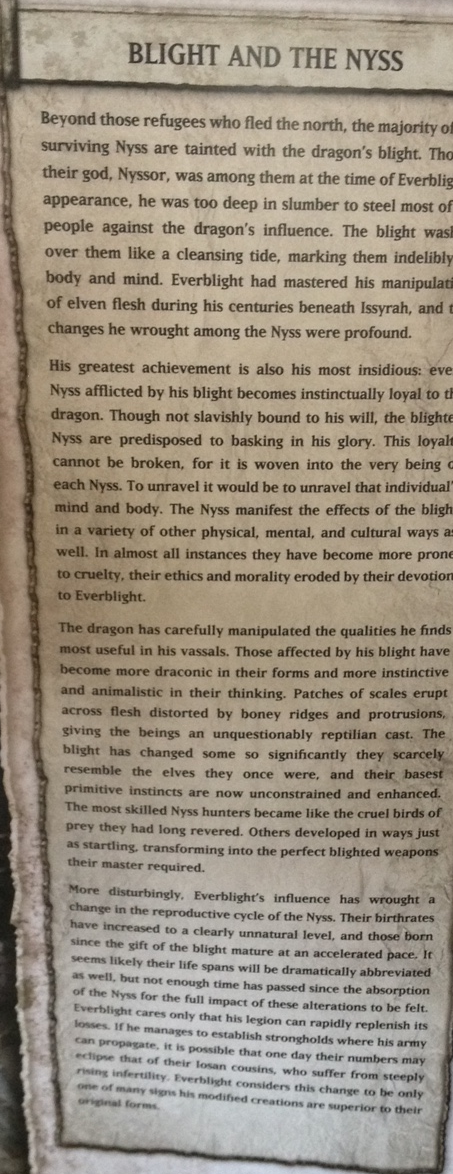
For years, Everblight know only rage and despair, but eventually, his reason returned to him. He grew aware of the proximity of the Nyss, who lived simpler lives than the Iosans. Their bodies and souls were similar, and he saw a chancer to salvage his plans. When the weakwilled ogrun Thagrosh came close to him, he was compelled to retrieve the athanc and plunge it into his own chest, with the dragon's essence guiding him. He headed down to the valleys to subjugate the NYss. Their society was torn apart, in no small part thanks to the betrayal of the sorceress Vayl Hallyr, who helped the Nyss shards fall to the blight. Everbliught coopeted the strongest, setting them to destroy those too troublesome to convert. When it became clear that resistance brought death, the survivors, including most of the Fane of Nyssor, fled south. Within weeks, Everblight possessed the core of his new legion, already transforming them into something new. Whatever aspects of the Nyss culture were rteains were reshaped to new purpose, while those deemed unimportant were discarded. Soon, the Legion gathered other forces from the nearby regions to the Shard Spires of the Nyss. The ogrun had useful power and fortitude, for example, and they are used to give brawn to the Legion, which is built around a core of Nyss.
During the centuries of his imprisonment, Everblight delved into the study of his athanc's limitations and structure, learning more than all his siblings combined. Even Toruk had never been forced into such focused self-examination. Everblight realized he could ivide his own essence into worthy vessels but retain his own consciousness. He had the perfect tool for this in the form of a weapon of Morrdh, originally meant to kill other dragons. Once Thagrosh recovered it, Everblight could begin. His decision to remain forlmless and use proxy hosts was not born solely of fear, though Everblight was aware of the dangers he'd face in his old body. Because his essence is in each of his warlocks, no distance can separate them from their master, and each is instantly aware of his will. Further, they can also communicate with each other over long distances - an unanticipated but welcome effect. Through this network, Everblight can coordinate the legion across vast distance while remaining safe. Even if another dragon killed some of his warlocks and absorbed their shards, it would take all of them being consumed to destroy Everblight utterly.
On top of this, each of his generals can command armies of dragonsapwn, manipulating them as instruments of their will just as Everblight once did. This amplifies the force of the armies, and the ability of the spawn to share their senses with their warlocks grants considerable situational awareness. However, EVerblight's minions are not mindless pawns. Each fills a unique role for their skill, and while Everblight can see through their eyes as he likes, he interferes only when he must. e is shaping each one differently, though all must sometimes overcome failures to become greater than their base flesh. In return, they can never fully fathom Everblight's mind and must earn his favor. It is equally important that the warlocks be able to create their own dragonspawn, for Everblight cannot directly create these creatures any more. Fortunately, his mastery of his blight allows him to grant them this secret, imbuing them with the power to create his blood in their own veins. With enough time and blood, any of his spawn can be made. The least of them take little time and blood, but the greatest exhaust and nearly exsanguinates a warlock. Efforts are underway to overcome this by making spawning vessels to transmute base material into dragonflesh. Warlocks can make dragonspawn anywhere, but bases of operation are sometimes needed for their recovery or to produce weapons and vessels. Remote locations are best for these outposts to avoid draconic attention (or human attention, for that matter).
Though only a few exceptional Nyss have been granted fragments of Everblight's athanc, this race is certianly favored over all others in his glory. They have cast off servitude to Nyssor to serve as his vanguard, and they are still determining what their new society will be - functioning and surviving as an army has taken priority over other considerations. It's only been a few years since Thagrosh brought them the message of Everblight, but they had to be made into an army immediately, primarily by the ice witch Vayl, first of the willing disciples of Everblight. She rose to unify and lead the blighted Nyss in his name, with Thagrosh's permission. The blight made the Nyss cruler and more predatory, casting aside generations of tradition. The atrocities of the early days were a problem only in that Everblight wanted the largest possible army. Vayl quelled the violence brutally, ensuring that most NYss survived their transformations, then applied her authority to reorganizing them. Many elements of Nyss culture were abandoned, but some were adapted, and several groups remained mostly intact.
For example, the raptors, elk-riding hunters, were already strong, as were the rangers that got reshaped into the striders. A group of sacred warriors once known as ryssovass became the Legionnaires, sworn to serve as Thagrosh's inner guard via their traditional fighting style. Most Nyss continued to identify with the tribes they were born into as well as ther extended hunting groups, or shards. Vayl set these to a new purpose by using shards as the core of the legions, each made of 50 to 80 warriors. Each shard is led by a prior, a captain of the Legion with the formal toitle aransor, once reserved for Nyssor's Fane and its elders. Deaconds in charge of large packs in a shard serve as the priors' lieutenants, while smaller groups are overseen by sergeants known as vassals. Some traditions also use titles and ranks specific to their training. Above all others are the warlocks, who speak with the authority of Everblight and can command any of the legion as needed. Some, like Vayl or Lylyth, oversee larger aspects of the Legion, but most act as strike force commanders. The blighted Nyss sorcerers advise them and are just below them in authority. Sorcery has always been part of Nyss life, but Everblight transformed and augmented their power. In addition to the traditional magic of wind and cold, many can control blight energies. They also retain their mastery of written Aeric and so are deeply involved in making important tools and weapons. They are generally smarter and have more initiative than the warriors.
Even before their blighting, the Nyss were useful - they were hardy, nomadic hunters and killers able to move quickly across great distances with discipline and self-sufficiency. They endured constant battles against the wilderness and the elements, as well as fights with trollkin, humans and Rhulfolk. Everblight modified his plans to use them, as their nature even better suited his needs in the early days of his armies than civilied Iosans had. They could live off the land for what they needed, constantly on the move save when making new spawn. Suprise and mobility would be their greatest weapons. The blighted Nyss quickly moved outside their territory, falling on remote human and trollkin villages for meat and blood as well as staging grounds for the birth of new warbeasts. The most terrifying of these were the nephilim, dragonspawn birthed from Nyss mothers.
While Nyss are the majority of the Legion, there are others, especially the blighted ogrun. They do not coexist comfortably in day to day life, remaining segregated as much as possible, as the Nyss see the ogrun as brutish and violent, especially when they go berserk and Nyss end up dead. The ogrun are brutal creatures, more like the ravening hordes of the past than the noble people the unblighted ogrun are elsewhere. While they retain their loyalty and some traditions, the blight infected them with a savage bloodthirst, and they venerate Thagrosh and Everblight as korune via blood sacrifice. Their command structure is basic and feudal, with ogrun serving those stronger than themselves, who take the title vassal as much as the NYss do. These ogrun can become strong enough to earn the respect of several vassals, becoming deacons, who serve as lieutenants to the war chiefs. Each war chief controls a warband of varying size, but some have gathered hundreds of blighted ogrun. They have nearly absolute authority over their tribes but are united in reverging Thagrosh as korune. He rarely directly gives them orders, but that doesn't change their loyalty. Regardless of their rank, however, they have no authority over the Nyss and must sometimes obey them, though they don't seme to resent it due to their special connection to Thagrosh.
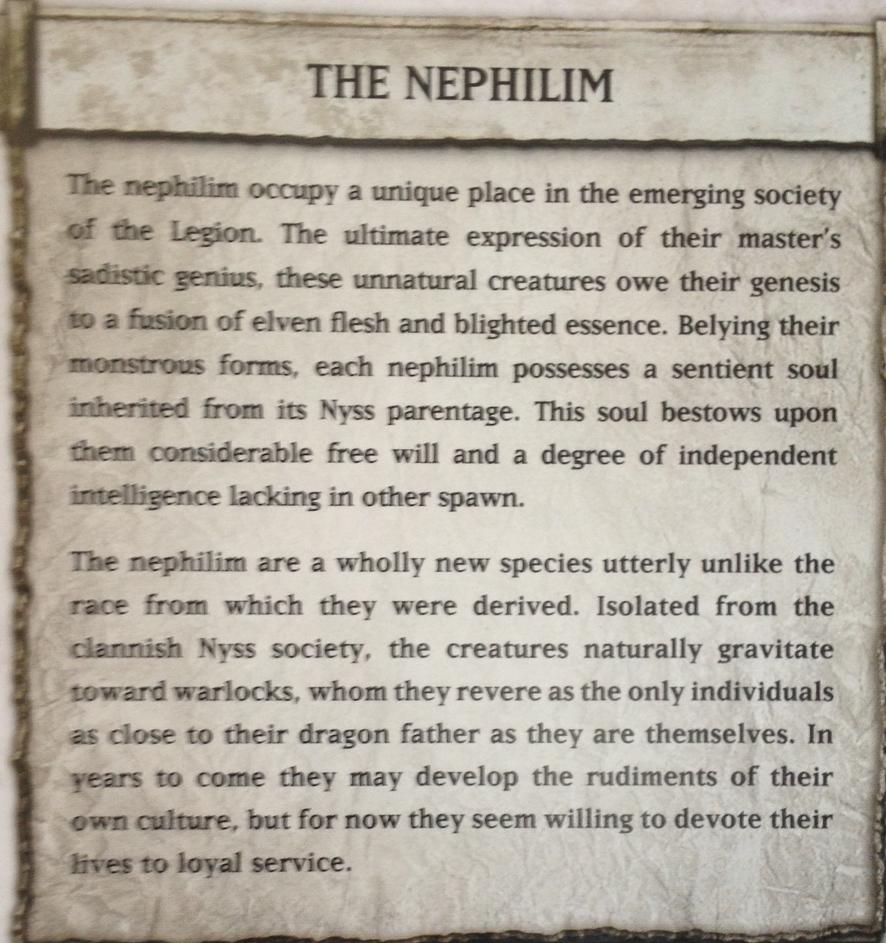
Next time: DRAAAAAGONS
Forces of Hordes: Legion of Everblight
Original SA post Forces of Hordes: Legion of EverblightAlmost immediately after the Legion was formed, they fought a lot against the other northern inhabitants. Some of these were very bloody conflicts, but they were all part of Everblight's plan to strengthen himself against other dragons. The remote Khadoran communities were out of touch with the larger garrisons, so retaliation was slow and disorganized, though it gained strength as the Legion became more widely known. Plans changed after Goreshade the eldritch revealed the location of the weakened dragon Pyromalfic as part of a bargain for access to the god Nyssor, should Everblight ever obtain him. Nyssor had already escaped, but Everblight saw no reason not to agree to the bargain. He sent Lylyth to verify the information, and when she did, he wasted no time sending most of his armies to Pyromalfic's lair in the Castle of the Keys. It was a remarkable achievement, as they crossed hundreds of miles through enemy territory, and earned the ire of many, including the Circle Orboros. Despite the hounding of the Circle and having to fight the skorne holding the Castle, the Legion did ultimately defeat Pyromalfic's body and seized its athacn, though at the cost of massive casualties to Thagrosh's forces. Few dragonspawn survived the assault, but that was nothing compared to the recovery of the athanc.
Thagrosh consumed it even before the army pulled back, allowing it to fuse with Everblight's athanc and increase his power. The full absorption of Pyromalfic has proved slower and harder than Everblight expected, for his own nature was divided byween his warlocks, and Pyromalfic fought him for mental dominance during the weeks after battle. Evading the Circle forced the Legion to divide themselves, with most of the soldiers heading overland to distract the foe while Thagrosh, Vayl and Saeryn headed underground through secret and dangerous tunnels knopwn only to Everblight, traveling under Ios to reach Rhul. Thagrosh was barely conscious for most of the journey, and only the other warlocks kept the Legion in existence. The blight wracked Thagrosh's body, requriing the magic of Vayl and Saeryn to regulate and contain it so he could complete his transformation into the Messiah. All of Everblight's warlocks were strengthened, and Thagrosh was later able to generate Typhon, the greatest of the dragonspawn, but these were ultimately mere side effects compared to Everblight's own strengthening.
Thagrosh summoned the warlocks to him, and they worked to restore the Legion's strength. Key to this was a reunion with Abyslonia, who had been left in the north to create new dragonspawn. These much-needed reinforcements were soon joined by others in a base made in an isolated Rhulic village the Legion seized. Thanks to their tactics, most of the Nyss had survived the battle and retreat, and their accelerated births and growth cycles replaced the dead at a rate impossible for unmodified species. For Everblight, though, it wasn't enough, and he began to modify some of the Nyss further, creating new hybrids out of his desperate efforts, with the grotesques being the most immediately successful, able to be birthed and mature enough to fight within months, not years, though their undeveloped minds comprehend only how to fight and survive. While they could never rise to lead, everblight knew they'd be useful fodder, as in war their short lifespans wouldn't be a problem.
Throughout his recovery, Everblight knew the dangers of keeping his warlocks in one place. Though strongest when gathered, they were endangered in the case of a massive attack by many foes, particularly other dragons, and this threat increased when EVerblight sensed a summons sent to his brethren by Blighterghast, as the attack on Pyromalfic had not been unnoticed, especially since Everblight had never joined the draconic alliance against Toruk. With these enemies scheming, Everblight prepared to scatter his power for the next phase of his plan. By keeping on the move and spreading widely, he can ensure that the Legion survives in the long term as they plan the next strike. After that, his plans are uncertain. Some of the warlocks expect orders to retaliate against the Circle Orboros, but they may well be sent against other targets as some plan to fight the dragon alliance. The warlocks have faith in Everblight's infinite powers of adaptation, creativity and survival. There is no question in their minds that Everblight will defeat all other dragons, then Toruk himself, taking his rightful place as the greatest and last of all dragons.
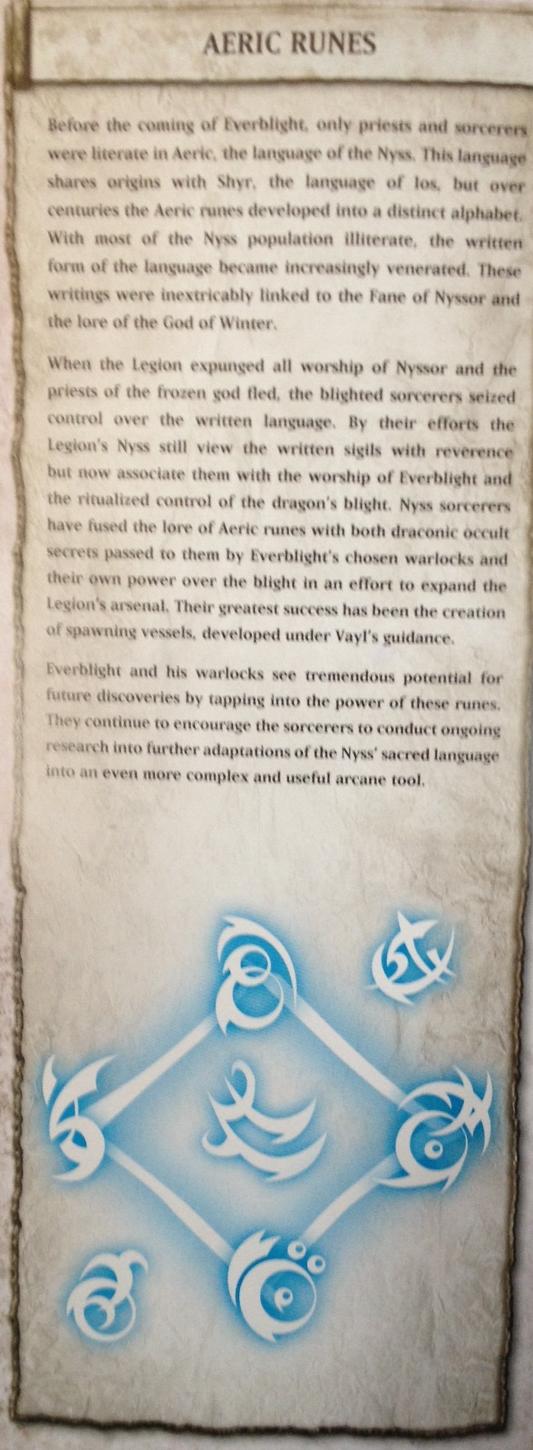

The warlocks serving Everblight are specifically chosen to be instruments of the blight. Within the heart of each is a fragment of his athanc, creating a deep tie between them and their master as well as the dragonspawn that serve them. Though they are all great leaders and warriors with their own ambitions and motives, the dragon's voice is always with them and they can act as manifestations of his will. This allows the egion to act in perfect and instant coordination in a way none of their enemies can. On top of this, they get access to Everblight's knowledge, memories and experiences, as well as providing theirs to the dragon. Through him, other warlocks gain filtered access to the information they need, able to learn things far beyond their own perspectives. They can thus fight on equal or better terms than far more numerous forces. With the exception of Thagrosh, all Legion warlocks are Nyss elves, as Everblight has long studied the elves and learned how to manipulate their essence and bodies. His plans for Ios were indefinitely stopped when his body was destroyed, but his knowledge has borne fruit among the Nyss, most of whom now serve him.
While several Legion warlocks were sorcerers before he chose them to be his vessels, the power of the athanc magnified their magical skills massively. Thagrosh, first of his avatars, was able to gain terrifying arcane power despite being of a species with no native ability to use magic at all, and unlocking the potential of the Nyss is even easier. Bearing part of the athanc lets a warlock manifest and shape the blight energy. It's not easy, though, and no mortal can contain even a fraction of it without physiological change. All Legion warlocks those have draconic atrributes to varying degrees related to their resistance to the blight and the size of their athanc shard. Despite the variance, the changes are not random, but part of an ongoing evolution to perfect each warlock according to their nature and role. However, it is the power to create ragonspawn from their blood that is the most potent ability of the warlocks. They need only spill enough blood and they can spawn practically any warbeast the Legion has. Creating larger spawn is exhausting and leaves them temporarily vulnerable, however, so they will generally not do this in the field.
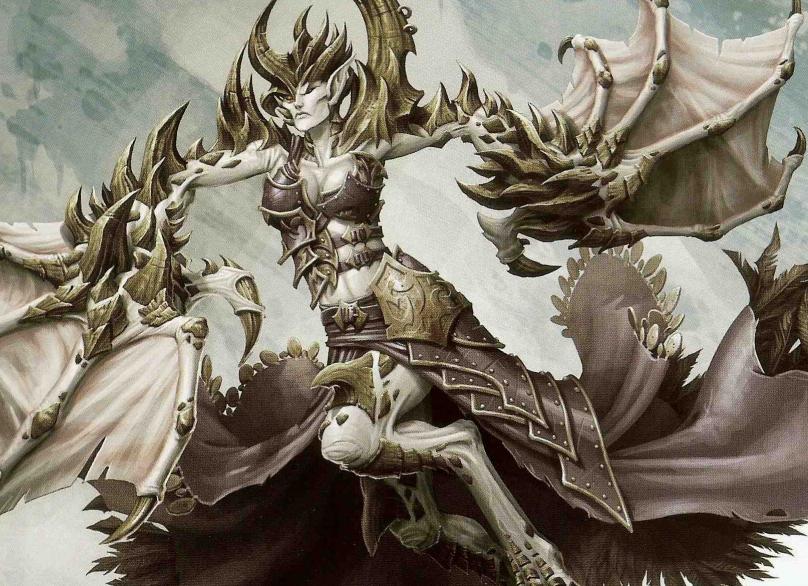
Abyslonia, Terror of Everblight is not a Nyss that's been subtly changed. Rather, her flesh continues to be reshaped by her power, without any sign of stability. She is a unique embodiment of the adaptable Everblight, and her mind and body bear little resemblance to her old self. For the Legion, she is a creature of singular perfection. For most of the chosen, the change is within, opening their minds to the blight and adapting to the presence of the dragon's voice. Abyslonia, however, may have achieved her form by initial resistance. She has little memory of that time save as pain and confusion, and even less of her life before it. This almost blank mental state pleases Everblight, who finds her easy to influence and control. In many ways, she is treated as a favored child, and he spends a lot of time retraining her instincts. Within days of her transformation, she proved entirely devoted to Everblight, and while she initially lacked either memories or language, she demonstrated inhuman cunning and power, with intuitive control over the dragonspawn around her. Her ability to spawn them is greater than any warlock save perhaps Thagrosh, and she can restore her own body or even the most damaged spawn to wholeness with her blight. When Everblight took most of his army to fight Pyromalfic, Abyslonia was left behind to safeguard part of his essence. She continued to create spawn, bringing the reserves to the Legion after most of the others were lost in the battle. Even at her most human, she is more abomination than Nyss, gliding across the battlefield on fresh membranes between her fingers and arms. Her appendages shift and lengthen sickeningly in moments, and chiten and spikes extrude unpredictably from her flesh in battle, leaving gruesome wounds on her foes. Her gimmick is buffing warbeasts ahd her feat allows her to heal herself, than damage herself in order to heal her warbeasts.
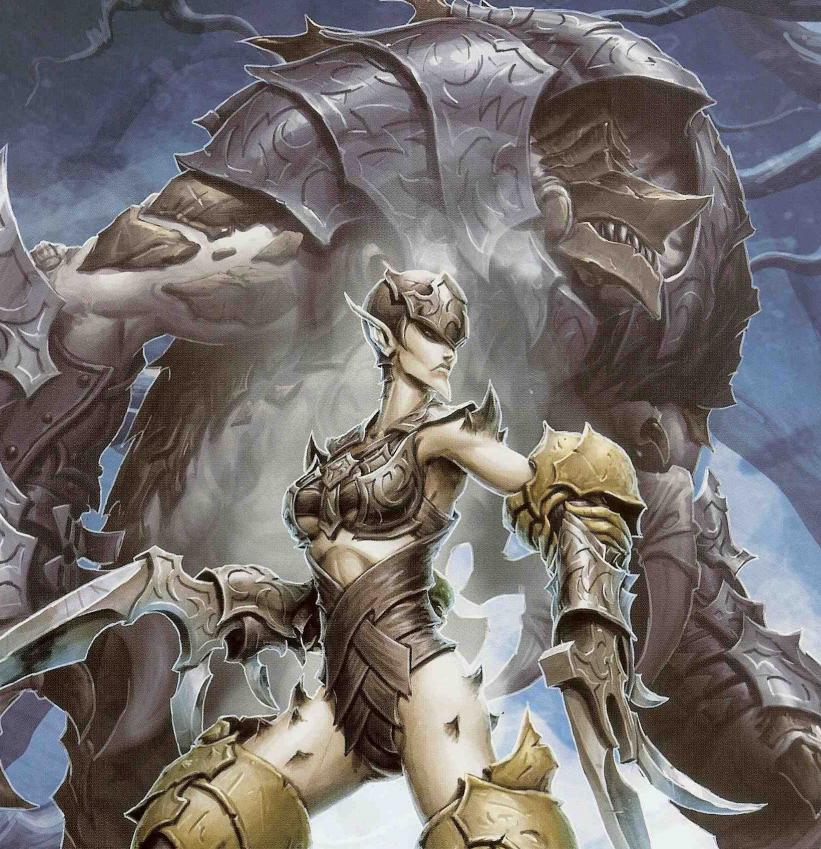
Bethayne, Voice of Everblight is never without the monstrous Belphagor . Bethayne serves to fill the spiritual void left by Nyssor's clergy, teaching devotion to Everblight as a god. In battle, she fused with her dragonspawn, Belphagor, to become a perfect yet intelligent killing machine, symbolic of the bond between Nyss and dragon. Before becoming a warlock, she was a young priestess of Nyssor with an unusual spiritual sensitivity and artistic talent. She excelled as she matured, mastering the arts of a priestess, particularly oration, and she dwelt in the Fane of Nyssor. She might have lived out her life peacefully if not for Vayl Hallyr, who met with her by trickery and earned her confidence by discussion. Bethayne became friends with the secret blasphemer, who planted subversive seeds in her mind by discussing her doubts about Nyssor. Bethayn e did not see her again until three years later, as she aided Thagrosh against the Nyss. Bethayne tried to defend the fane as Nyssor's priests fled with the god, and she was shocked to see Vayl among the attackers, speaking of potent draconic god. AS proof, she showed the destruction, which Nyssor had not stopped, and she offered Bethayne a place of power.
Bethayne's doubts awakened, and her mind splintered. She tried to commit suicide, but Vayl froze her in place with magic. Bethayne's mind raved until Thagrosh arrived to offer her respite, giving her once choice: forsake her vows and become a warlock, or die. Part of Bethayne welcomed death, but in a moment of weakness, she took EVerblight as her master. When she received her shard, all doubts vanished. She could not know that this bliss only concealed a deeper emptiness as her faith was shattered. Everblight's essence flowed into her, but even he could not fill the void within. In the days ahead, she followed Vayl in conversion and murder of the Nyss, convincing several shards to join the Legion willingly. Each death was a prayer to EVerblight, yet part of her mind had been shattered, yearning to shape lesser materials into the sublime. She began to experiment with dragonspawn, and in a moment of perfection, she was able to sculpt a new creature that embodied her love and fear of Everblight, yet also gave expression to the hole within her soul. Belphagor is a creature unique to her, a masterpiece that Everblight never envisoned. Bethayne is now a confident and audacious priestess-general with a silver tongue and razor-sharp mind. She has no patience for doubt, and when she merges with Belphagor, she can lose herself in the joy of slaughter. Because the beast is born of her essence, she can easily spawn it anew when it is destroyed. With it, she is made whole, experienced true communion with her draconic god. Vethayne's gimmick is magical blasting and buffs, and her feat boosts magical attack and damage rolls as well as warbeast animi. Belphagor's animus creates a choking cloud.
Next time: This book brought to you by the letter Y.
Forces of Hordes: Legion of Everblight
Original SA postEverblight does, in fact, hate hugs.
Forces of Hordes: Legion of Everblight
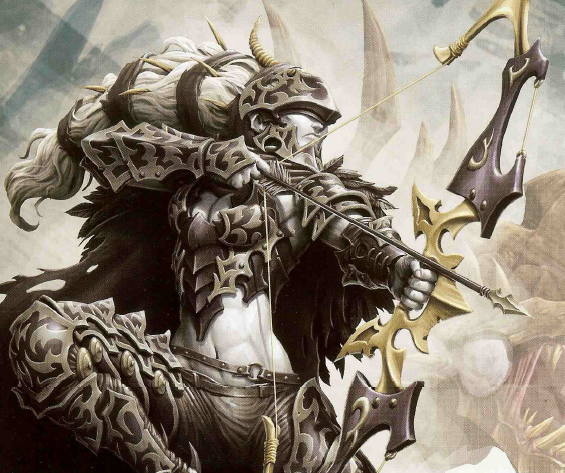
Lylyth, Shadow of Everblight
is Epic Lylyth. She has been reborn after Pyromalfic, and each kill she and her archers make eases her memories. When she went to confirm Pyromalfic's location, she attracted the attention of his guardians, suffering terrible injuries before she escaped. As he believed her death certain, Everblight just sent his Legion to collect her athanc, and grief overwhelmed Lylyth at the abandonment. She pried out her own athanc to escape the pain, and in that moment of clarity, she saw her recent life through a mortal perspective. She was consumed by horror and shame, and as she lay dying, Saeryn and Rhyas arrived. She offered them her athanc, but they had come to claim her once more. Her reunion with Everblight steeled her dark resolve. She has tried to put her experience aside, and she has mostly been able to forget the faces of the dead and the guilt she felt, but her awareness of her own insignificance lingers. She fights tirelessly to prove her worth, and she's realized, deep inside her, that she is important to Everblight only as a receptacle of his athanc shard and no more. Only as long as she is a peerless killer will she have worth. Since Pyromalfic's death, Lylyth's senses and reflexes have sharpened to superhuman levels. She is inhumanly accurate, and her senses can infect those around her to raise their awareness. There is a price for her new gifts, however - she shuns crowds and even her own kind, finding the sensations hard to endure. She prefers to move constantly, avoiding all but the smallest camps except when she must. She is close only to her striders and archers, and she despises humans even more now. She fights relentlessly against the Legion's foes, without ever asking for supplies or support. It's impressing Everblight. She also makes sure to choose demoralizing but vulnerable targets, performing meticulous recon before any attack. Her gimmick is stealth and ranged ambush, and her feat grants a big range boost to her allies along with an extra attack.
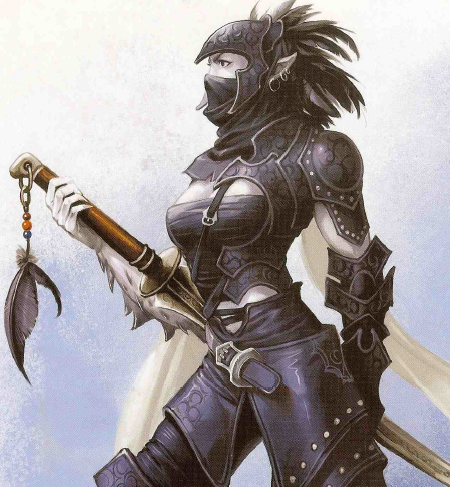
Rhyas, Sigil of Everblight
is one of two twins. She is the more physical of the pair, a blademaster without peer, found in the lands of the Shyvess shard. Her sister was a peerless sorceress. Thagrosh went to find them, and he found that they had slaughtered their own people to keep them out of slavery. Rhyas froze her own heart against their pleas, convinced it was necessary, and the pair ambushed Thagrosh. He was taken by surprise by their speed and coordination, but Rhyas found she could not kill him. Rather, after letting Thagrosh see how close he had come to death, both Saeryn and Rhyas offered themselves up to the Prophet as servants. Saeryn had foreseen his coming and knew she had a crucial role to play. Rhyas did not understand, but she trusted her sister, and so she accepted an athanc fragment. Her world was shattered and restored, and she has no doubts or guilt now, though she does wonder how her sister was able to hide her plans away. She doesn't dwell on it, but she knows now that Saeryn can do it. Fighting helps her live with that, and she delights in bloodshed. She stands at the upper tier of the chosen, sworn to obey Thagrosh in all things. It was Rhyas who landed the killing blow on Pyromalfic, and she is the embodiment of Everblight's deadly will, writing bloody runes upon his foes with her blade. Her gimmick is being a goddamn ninja, and her feat lets her allies make additional melee attacks and also stab-teleport.
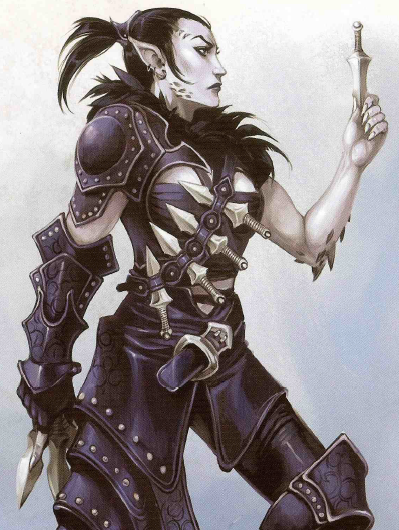
Saeryn, Omen of Everblight
is the more detached twin to Rhyas. Though both had magical talent from birth, Rhyas focused on the blade while Saeryn plunged into the depths of her power. She learned that she and her sister shared a single soul, something deeper than any other twins, which amplifies their power and awareness. She had little formal guidance, learning the Aeric runes from a priest but little else, keeping to her sister alone such that even the Nyss thought them introverted. They avoided Vayl Hallyr when she tried to take them as pupils, sensing something amiss even before she became the Betrayer. Saeryn was never a prophet, so she cannot explain the vision she had a year later, save that she thinks it is due to her brief meeting with Vayl. It let her foresee Thagrosh's coming to her shard and also, in a moment of freedom from her sister, that her destiny was to corrupt Rhyas in order to bring about their greatest glory. She had Rhyas destroy Shyvess shard to turn her into a wild and unbridled weapon, rather than out of mercy. When Thagrosh arrived, she and Rhyas defeated him, but Saeryn fought only to test his limits. She used her power to stay Rhyas' hand, making Thagrosh aware of his mortality before submitting to the athanc. This greatly impressed Everblight, and Saeryn was made his herald. She knows that she and Rhyas will be his vanguard, beyond all other Nyss, and she views other warlocks with a mix of respect and reserve. She resents that both Thagrosh and Everblight hold Vayl in high regard. Neither likes the other, but they do have respect for each other's skills, or perhaps wariness. Rhyas and Saeryn are most powerful together, and Saeryn believes they've only begun to test their limits, and that they have not yet fully awakened to their power. She has hidden parts of her mind even from Everblight, believing utterly that while she is with Rhyas, she is invincible.
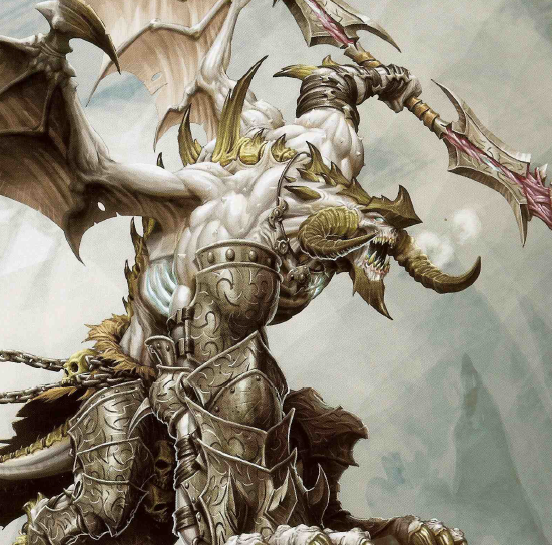
Thagrosh, the Messiah
is Epic Thagrosh. Everblight did not warn him about the painful transformation he'd undergo after consuming Pyromalfic's athanc, a mix of agony and ecstasy as energy suffused him. It brought confusing memories, sensations and physiological change. Thagrosh is no longer an ogrun but something new, closer to and yet distinct from dragons, the true avatar of Everblight. He still doesn't feel comfortable in his new flesh, which shifts to contain his power. The discomfort vanishes in battle, however, where he revels in his new strength. Some part of him understands that his mortal flesh cannot contain draconic might, but when combat comes, he relishes his godlike sensations. Doubts creep only into the corners of his mind, and only in the still moments when he is not fighting. His metamorphosis had come just as he was separating his own mind from Everblight's, reaching an unspoken accord with his master. However, now Everblight's presence is stronger than ever before, as though the dragon lives just beneath his thoughts as a vast, alien presence that sometimes takes over his eyes and mouth. Thagrosh loses himself for hours at a time, subsumed by the dragon, and each time, he feels the draconic mind's pull more strongly. His mood is increasingly controlled by draconic tempers, and he finds it hard to restrain his impulses and fury. It is not enough to win - he must annihilate his foes. His gimmick is still a mix of warbeasts and being an insane personal combatant, and his feat lets his warbeasts advance and attack a second time.

The monstrosities of Everblight's blood come in many forms, each a product of his biological engineeering and will. Many are ancient forms, dating back to Morrdh or Issyrah, while others are more recent. Most are born of a warlock's blood, the form chosen at the time of creation. Even from birth, they have potent weapons and hunger, and they are usually taken hunting immediately to slake that a bit. If given enough meat and blood to eat, even the largest can reach full size in hours. Thus, a lone warlock with a spawning vessel can greatly augment their forces in the field. Some warlocks, like Thagrosh or Abyslonia, can even spawn hardier beasts that mature even faster. Each warbeast is made for a specific role, perfectly designed for that purpose. While they are technically alive, they are unnatural creations, organic machines that need food but not sleep or other normal activities. They just wait, inert yet aware, until they are needed or notice enemies to kill. They are not mindless, and they have sophisticated instincts to aid them in battle, but their potential is only unleashed when directed by a warlock.
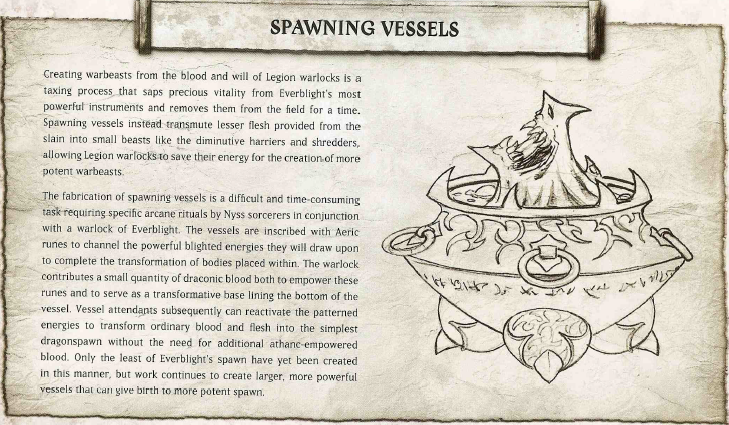
A warlock can turn a warbeast into an extension of their own body and senses, directing it effortlessly. Often, they join Legion soldiers as guardians, but they have little ability to make decisions without orders. Shepherds can extend their operating range from the warlock, but even this is limited. The nephilim stand apart in this, born of blighted Nyss women and possessed of both a soul and mind. They have more autonomy and intelligence than any other Legion beasts and are naturally skilled with weapons and tools, able to undertake even complex tasks without direct supervision.
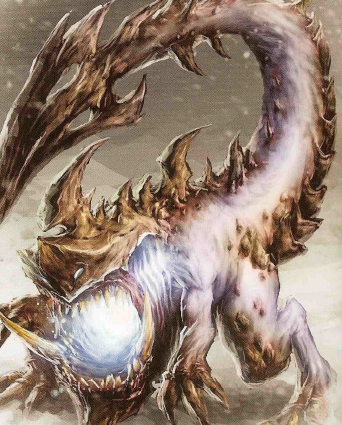
The
Stinger
is the simplest and smallest dragonspawn, but vitally important for their ease of creation. Once formally known as the Acrar, it is an unnatural weapon bred to fight and die for Everblight. It seldom stirs unless ordered to, then skitters forward for battle, tail flicking with venom. They use their claws to dig into the ground, where they lurk in ambush, then erupt forth to spew noxious venom. Then they fall back to do it again if the prey somehow survives. In just a few seconds, a pack of stingers can reduce even an armored phalanx to a mound of organic goo. Their barbed tails can also be used as vicious melee weapons...but only once, as the stinger breaks off in the foe, taking several vital organs of the dragonspawn with it. This leaves them vulnerable until they have time to recover, and they have no sense of self-preservation, so they don't really care. Their animus lets them move after attacking rather than the other way around.
Next time: Disgusting elf-dragon babies.
Forces of Hordes: Legion of Everblight
Original SA post Forces of Hordes: Legion of Everblight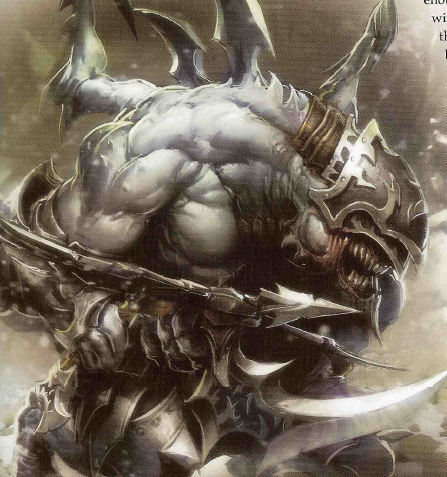
The Nephilim Bolt Thrower combines the strength of dragonspawn with independent thought. Their bolt throwers are powerful ballistae, making these nephilim into living siege weapons that use their unnatural senses to detect foes and fire deadly barrages. They normally can't fly, but their draconic blood can cause them to briefly sprout wings from their atrophied stunts, allowing brief flight at a warlock's demand. Anyone unfortunate enough to fight them is likely to be hurled away by the immense bolts of their ballistae, and those that take the full brunt are usually knocked to the ground if they somehow survive. They can also fight in close range with the wicked blade mounted on the ballista. Their animus grants temporary flight.
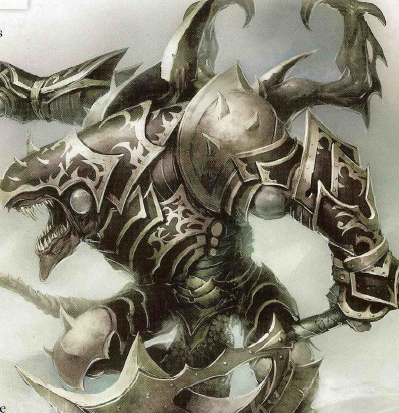
The Nephilim Protector is the result of refinement of the nephilim birthing process, and Nyss incubators can now birth more than one before their deaths. They are shaped from birth to protect warlocks, and since the Castle of the Keys, the need for them has only increased. Everblight was troubled by allowing so many warlocks to face danger at once, after all. They have an instinctive imperative to guard the warlocks and will unhesitatingly dive into harm's way for them without concern for their own lives. They also make ideal transfer targets for wounded warlocks, as they are bred to endure greater pain than other spawn. They need no rest and do not mentally tire, so they are alert at all times for danger. Their animus keeps allies from being knocked down.
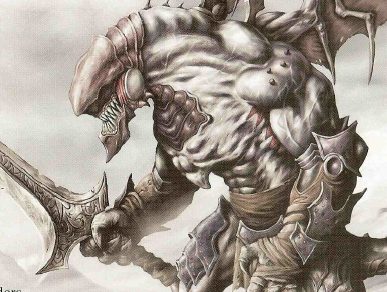
The Nephilim Soldier is born over the course of weeks, bred when a pregnant Nyss drinks a special draught of warlock's blood that transforms the fetus into dragonspawn. They grow to maturity in mere days. Everblight sees them as a vast improvement on frail elves, as they can wield weapons but never tire. They are more independent than other spawn, too, and have some self-will, perhaps due to the unforeseen fact that they have souls. They are uniquely able to interpret orders and adapt to situations, but they also do not fear the athancs of the warlocks and can turn on their masters in the heat of a frenzy. Outsiders see them as warped horrors, but the Legion views them as sublime and holy. Their animus lets warbeasts charge more easily.
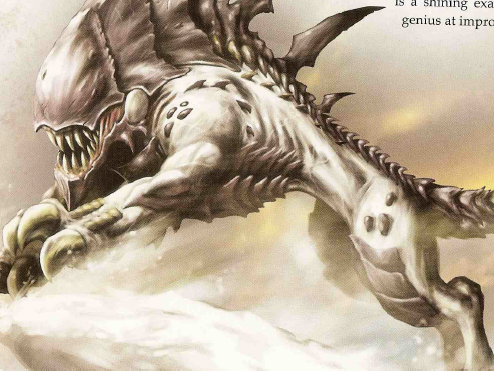
The Raek dates back to Morrdh, a hunting predator once used by Morrdh's masters to teriffy and kill foes. They hunted down traitors anywhere they hid, beating them to death with fangs and tail. Everblight has revived them for the Legion, and they are peerless trackers. They cannot be stopped and can get around any barrier to find their prey, ignoring all distractions and having no self-preservation. Their animus lets them parry attacks.
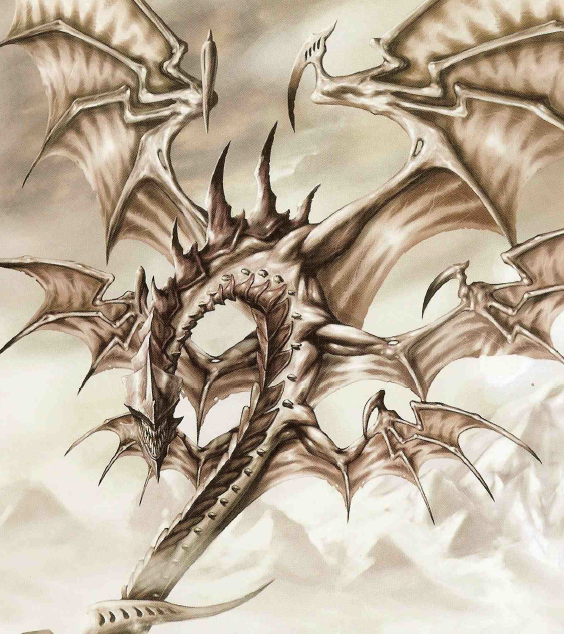
The Angelius is a testament to Everblight's arrogance and confidence. It is a six-winged monster meant to stand over the seraphim and lead the hosts of the Legion to victory. They are the swords of the sky, obliterating foes utterly with their razor tails. They move constantly, hunting for targets. They were first made 2000 years ago, near the end of Morrdh. Everblight had grown too comfortable in his influence, creating the angelius as a guardian and a reminder of his constant gaze, and it served well, but it was noticed by agents of Toruk. Toruk recognized the mark of its creator, finding Everblight's hiding place and nearly slaying him. After sheltering in Blindwater Lake, Everblight realized he could not use the angelus again until the benefits outweighed the risks, and that came when his legion fought Pyromalfic, as he knew the angelii would be needed to defeat his rival. After two weeks of preparation, Thagrosh summoned a seraph and spilled its blood, mixing it with most of his own. The first angelius of the new age was born, and it glutted itself well in the battles that came. Thagrosh has brought even more into the world now, as the time for hiding is over. Their animus shoves enemies away.
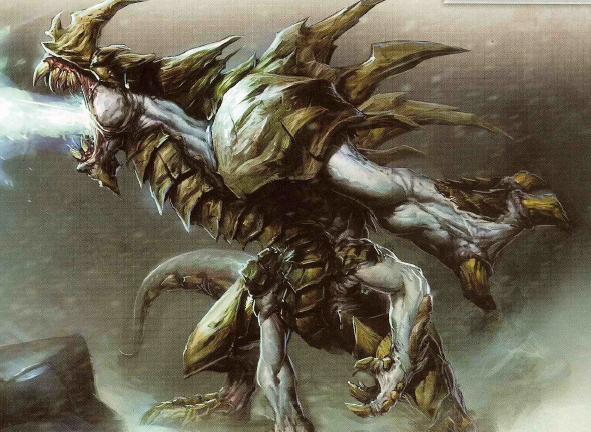
The Ravagore is a vehicle for Everblight's breath, and one of his most favored creations. It costs a lot of blood to make, but it's worth it, as even one is devastating. Their bellies glow blue with heat, and they emit this fire from their maws. When they breathe in, a hiss warns those nearby to flee their blighted flame. Those killed by it are most fortunate, for the survivors are caught in a blaze that does not go out easily, crying out for oblivion. So powerful is their inner flame that warlocks can call on their nature to light other fires, as well. Their animus lights weapons aflame to burn Everblight's foes.
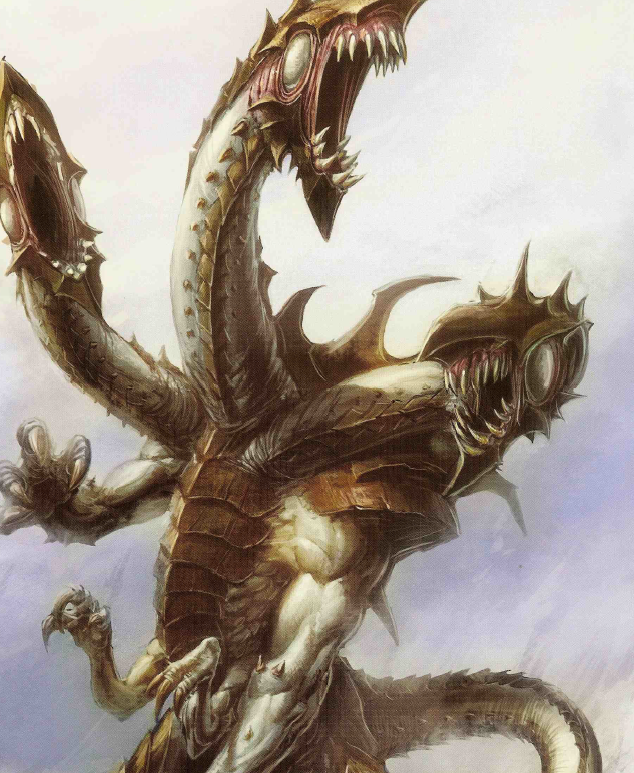
Typhon is terrifying even to those used to monsters. It has no resemblance to any natural beast, and it is the ultimate consequence of Everblight's works at making new dragonspawn. Its three heads rip foes apart and spew superheated ash to melt metal and flesh alike. Further, its wounds close almost as quickly as they appear. Typhon is a new triumph, born after the Castle of the Keys. Its origins date back to esoteric theories Everblight derived in his bodiless exile, and he thinks of it as a work of art. He is proud of its form and deadly function as an application of the blight, the culmination of centuries of tinkering and planning. Everblight has long sought to consume another dragon, gaining its power, and it was in his struggle with Pyromalfic that he saw a unique chance to create something new. He compelled Thagrosh to use Rapture to carve a tiny piece of athanc away during the act of fusion, mixing it with his own blood. It was tricky - he couldn't risk weakening Thagrosh further through heavy exsanguination. It worked, however, and Typhon was born. It is part of Everblight and compelled to obey, but it is not part of the divided consciousness. It is a purely draconic nature with a fragmentary soul of its own, tied to Thagrosh by its athanc. However, it can generate its own blighted blood and act independently, with a crude and bestial sense of self. It is as immortal as any dragon, regenerating so long as its athanc is whole - the ultimate success of Everblight.
Next time: Twisted elves.
Forces of Hordes: Legion of Everblight
Original SA post Forces of Hordes: Legion of Everblight
The Legion's ranks are unlike those of other forces. The Legion serves loyally and with a singularity of purpose which other commanders can only dream of. They also bear a cold emptiness due to the spiritual nature of the blight. To outsiders, it seems a fate worse than death - power, but at the cost of an eternity of thankless loyalty and devotion. While ogrun do serve Everblight, the Nyss are his most numerous servants and the most important. The blight enhances their strength and agility, but also some dark traits inherent to their culture - cruelty and rapacity, for example. They have retained much of their cultural identity even as other parts of their society are subsumed or reinterpreted. Many Nyss warrior traditions have survived, sometimes even more rigorously than before. Once peerless hunters, they now turn their capabilities against Everblight's foes. Whether Nyss or ogrun, all Legion troops bear the blight, too. The manner depends on their natural skills, as the blight enhances what is alreadyp resent. It raises physical prowess, instills a sense of loyalty to Everblight and often produces small horns, scales or spikes as well as stripping away compassion and fear in favor of cruelty and cunning. The blight sometimes utterly alters a body to better suit a soldier's role. Sometimes this is animalistic, as with the striders, and sometimes less obvious, such as the turning of the swordsmen into singleminded killers. Everblight's power causes even more unpredictable changes among the ogrun, who have become mroe savage and brutal, even insane and hallucinatory. Other creatures are twisted even more drsatically, such as the grotesuqes or the Forsaken, who lose themselves utterly to the blight. Unlike the perfecting blight, these transformations are sometimes random and spontaneous rather than augmentations. The blight can also amplify magical power or unlock the potential for magic in those who did not have it. Magical skill is rising in the blighted Nyss thanks to the dragon.
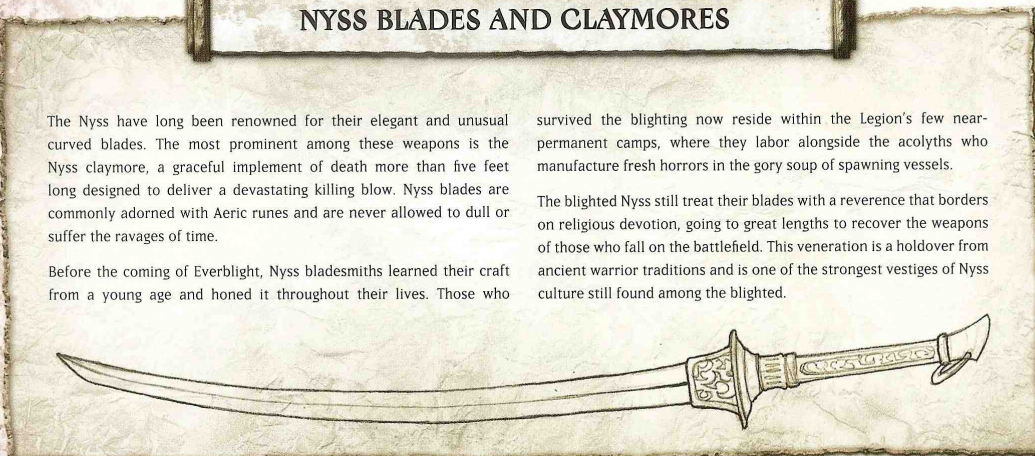
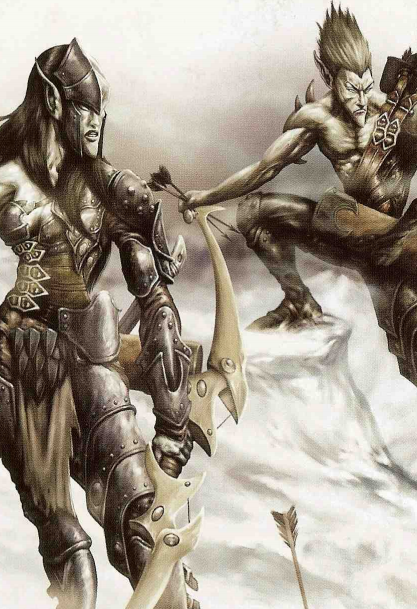
The Blighted Nyss Archer Officer and Ammo Porter sometimes lead the archers in battle. These deacons once led entire shards, and now they lead their troops to cripple the foes they cannot kill outright. When brought to battle in number, the archers prefer long lines, firing in unison at the call of their deacon. They find gaps in armor and hide to kill men and beasts. The arrow porters race along the line, carrying as many quivers as possible to hand arrows to the archers before they need them. They move in perfect concert, allowing the archers to fire faster and faster. The deacons use severe discipline, and under their care, the archers have astounding accuracy no matter what the terrain.
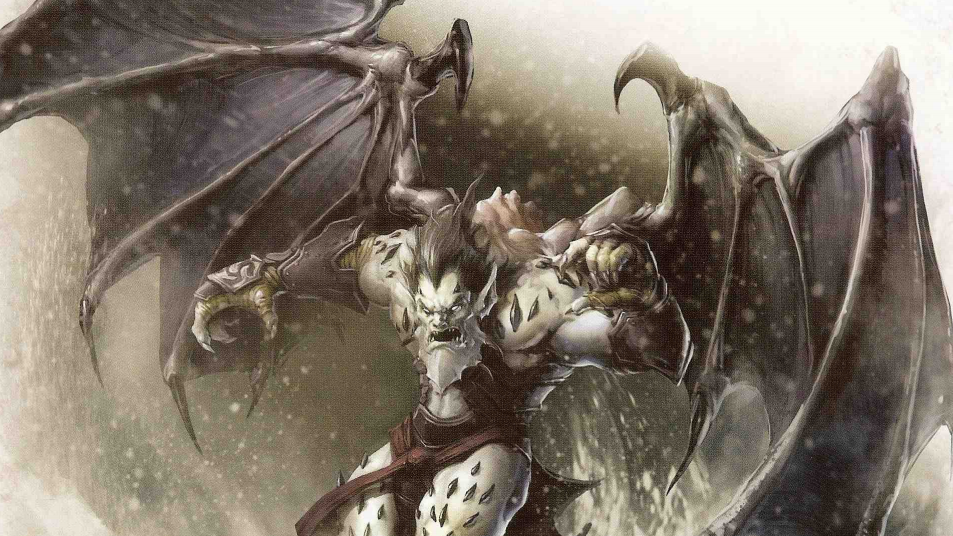
Blighted Nyss Grotesques are winged horrors that barely resemble the elves they were created from. They are driven only by hunger and bloodlust in the name of Everblight, striking from the sky in a cloud of talons and wings. Everblight was unsatisfied with his more subtle workings of the flesh, creating out of the Nyss a new species, utterly unlike the elves and not dependent on them for creation. Though initially born of Nyss parents, they now dwell and breed apart from the elves, generating spawn that mature at a terrifying pace. The grotesques live rather like giant ravens, descending en masse to tear apart their foes when called on by the dragon.
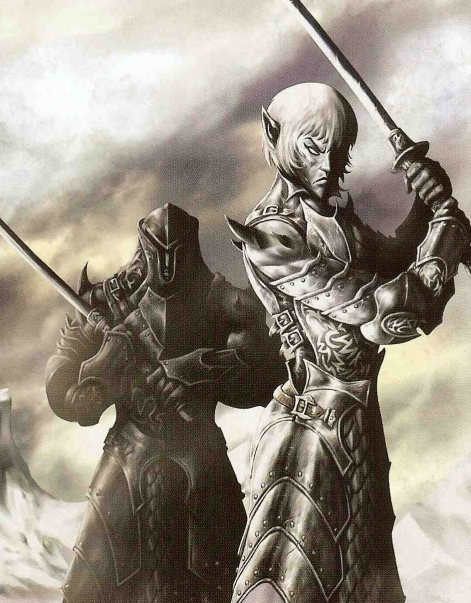
Blighted Nyss Legionnaires are an elite tradition once known as the ryssovass, who defended the lands of the Nyss. They wore ornate armor of overlapping plates, fighting easily against superior numbers. It took years to train them in the complex ryssovass fighting style, teaching them to act as extensions of each other, and the metal they used for their armor was highly limited in supply. Under Everblight, it is now much easier to get legionnaires, as his mental corruption makes embracing the needed discipline easier, and metal is more common thanks to Legion raiding. They wield immense blades and serve as Thagrosh's personal guard now, fighting as one and avenging any that fall. They carve through enemies like a threshing blade.
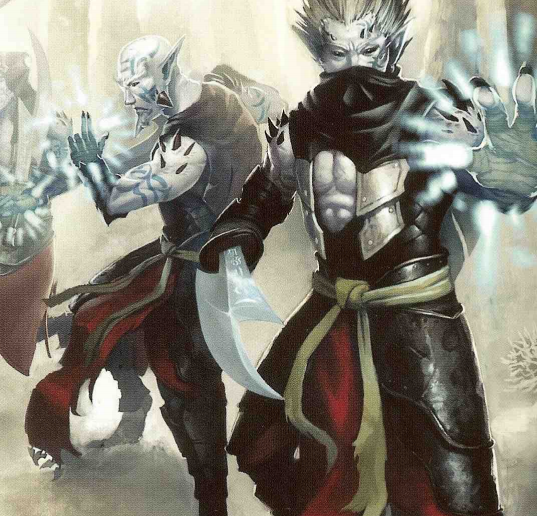
Blighted Nyss Hex Hunters are sorcerers, once proud of their knowledge of Aeric and service to Nyssor, but now turned to the dark magic of ancient Morrdh, which they mix with their once-sacred traditions. Instead of protecting the shards, these new sorcerers devote themselves to murder in the name of Everblight. The hex hunters are assassins, living weapons of magic who have forsaken study to better kill. They use hex razors, weapons recovered from Morrdh ruins, to channel the deaths of their victims into magic. They move with terrifying speed across the field, leaping over any obstacles to reach their prey. When they close ,they lash out with their razors and blight blasts to fuel their magic with deaths.
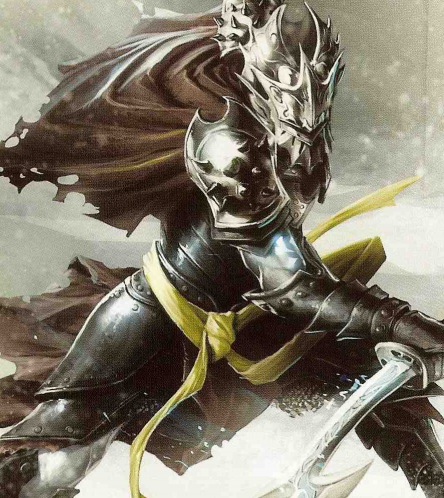
Bayal, Hound of Everblight is the first of the hex hunters and was instrumental in shaping their magic. Before Thagrosh came, he was already a skilled, ruthless sorcerer who admired the witch Vayl and wielded wind and ice magic. He willingly followed Vayl into the legion, taking command of the sorcerous order that would become the hex hunters. When the Legion headed to face Pyromalfic, Bayal and his followers remained behind in the Thornwood to loot the Morrdhic ruins, finding the secret of making hex razors. Bayal returned to the Legion wearing a Morrdhic mask, and now, he is a near-perfect weapon. The hex hunters follow him slavishly, combining their Nyss lore with the secrets of Morrdh.
Next time: WAR ELK
Forces of Hordes: Legion of Everblight
Original SA post Forces of Hordes: Legion of Everblight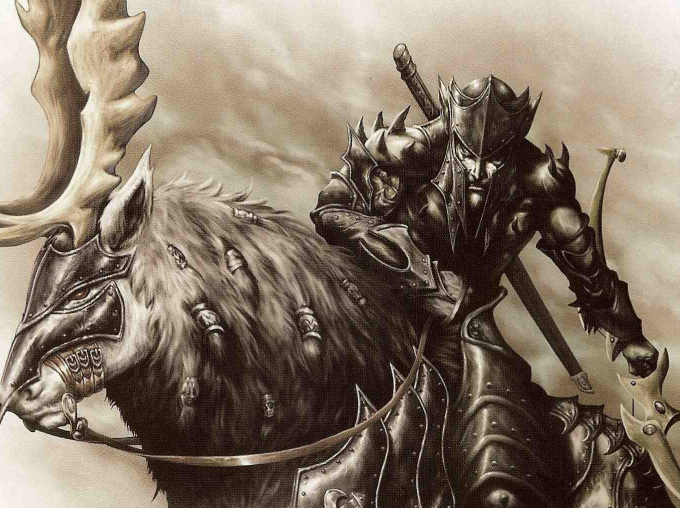
Blighted Nyss Raptors have actually changed rather little. The Nyss raptors have been around since the days of Khardovic, raiding the northern tribes on their swift and powerful ulk. Each raptor earned the right to join the group in an ancient tradition, heading naked in tho the wilderness to find and tame the ulk stag that would be their mount...or they died. The raptor tradition ahs continued in the Legion, and they ride ahead of the other forces to harass the enemy flanks with arrows before the bulk of the Legion joins theb attle. Only masters of both blade and bow can become raptors. The traditional ulk, a sort of very large and hardy deer, instinctively shun the blighted Nyss, but the striders tracked several herds to exhaustion and captured them. Blighted ulk become as aggressive as their riders, using their massive antlers as weapons rather than just self-defense and dominance tools.
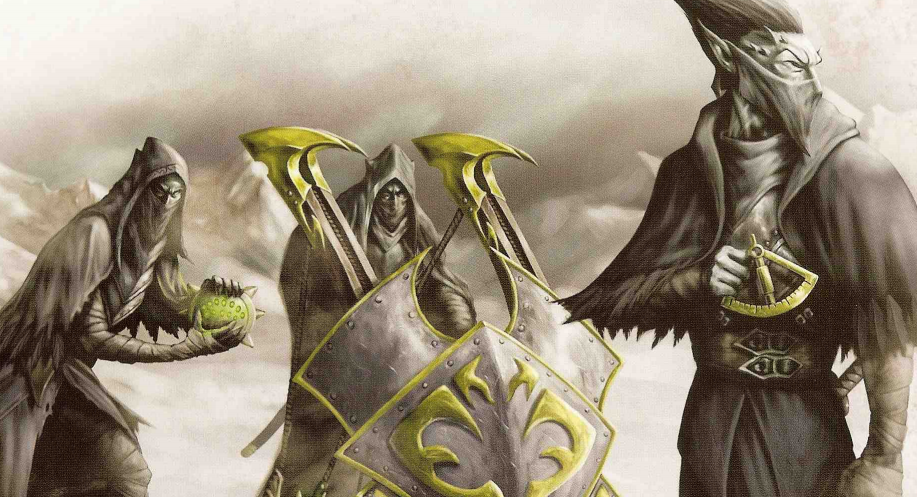
The Blighted Nyss Scather Crews utilize light catapults that fire liquid blight itself. It can dissolve metal, wood or stone as easily as flesh and bone, and even a few drops cause searing agony before killing victims. The blight liquid inside the ammo speads over a wide area, sending up clouds of killing vapors. They disperse quickly, but where they land, no plants will ever grow again, and only dragonspawn can draw sustenance from the flesh of those it kills. The Nyss were once happy to relyo nly on their bows, but in clashes with regimented armies, they realized they needed more firepower. Everblight taught them to make machines devised by the warlords of Morrdh. These lightweight but formidable catapults transport easily, using hinged wooden arms drawn back by rope to fire their projectiles. The projectiles themselves are light, almost delicate, and would puzzle any human siege negineer, until they realized the spiked, perforated globe contained a fragile bladder full of blight essence.
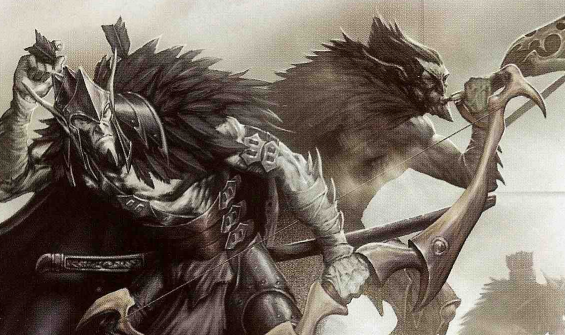
A Blighted Nyss Strider Officer and Musician will sometimes lead the striders. They are trusted to operate autonomously in scouting, and their prominence in blighted Nyss society is a reflection of their anticipation of the Legion's needs. They are masters of ambush, relying on the call of the horn to communicate across any landscape. They use it to call to gather and fight, and the horn dates back to ancient times as a way to convey information long distances. Nyss musicians can convey a lot of information in subtle shifts of tone and note length, and in battle they can unleash a terrible wail that drowns out all other sound and instinctively frightens foes.
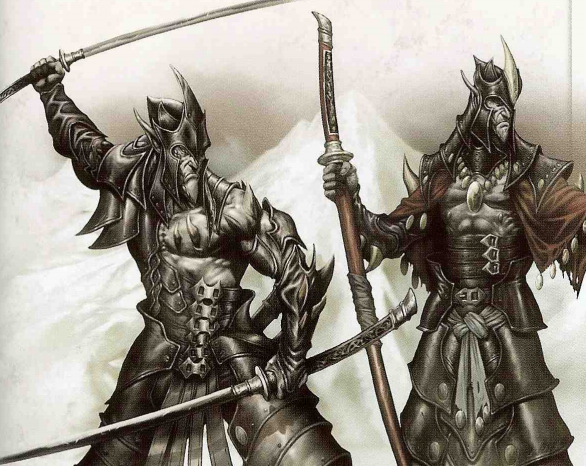
A Blighted Nyss Swordsman Abbot and Champion sometimes lead the swordsmen. Many sowrdsmen lost their sense of self under Everlight, with their new hollowness naturally aligning with their meditative sowrd mastery, focusing on their skill to avoid the horror of what they did. Those who fully embraced this murder meditation have become the greatest bldaemasters of the Nyss, the abbots, who are both feared and respected for their absolute calm in atrocity. They are almost enlightened, able to fight with total dispassion. They have earned devotees among the most skilled swordsmen, devoted not a god but to the abstraction of blight and its refinement of the flesh. The best students are known as champions, some of whom have learned to immerse themselves so utterly in swordsmanship that they can wield two claymores at once.
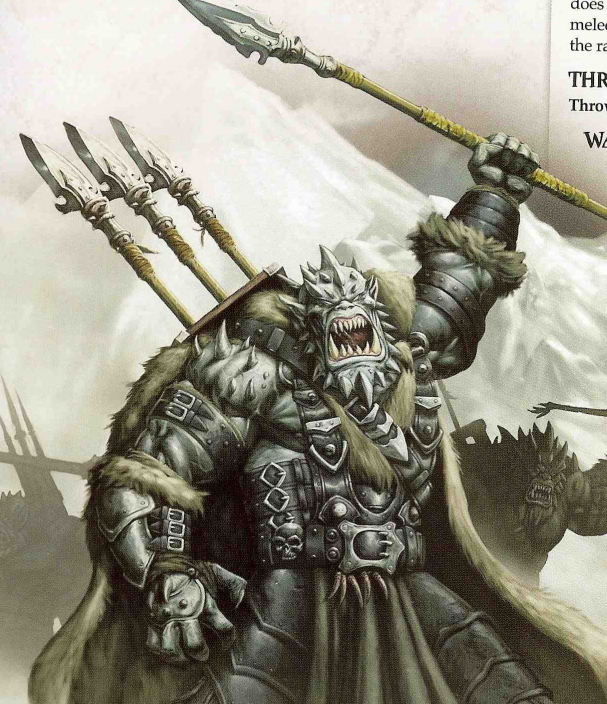
Blighted Ogrun Warspears are only slightly less violent than the warmongers of their race. They are twisted in mind and body, addicted to bloodlust. The force of their spears is enough to pierce iron and impale men at thirty paces. They enjoy the chance to face formidable foes out of some twisted sense of sport. While killing humans is fun, it's not challenging, and the warpsears prefer to face the like of trolls, warpwolves and warjacks. They phrl their spears before rushing forward in a murder frenzy. Those not killed outright are often stunned long enough for them to close and finish the job.
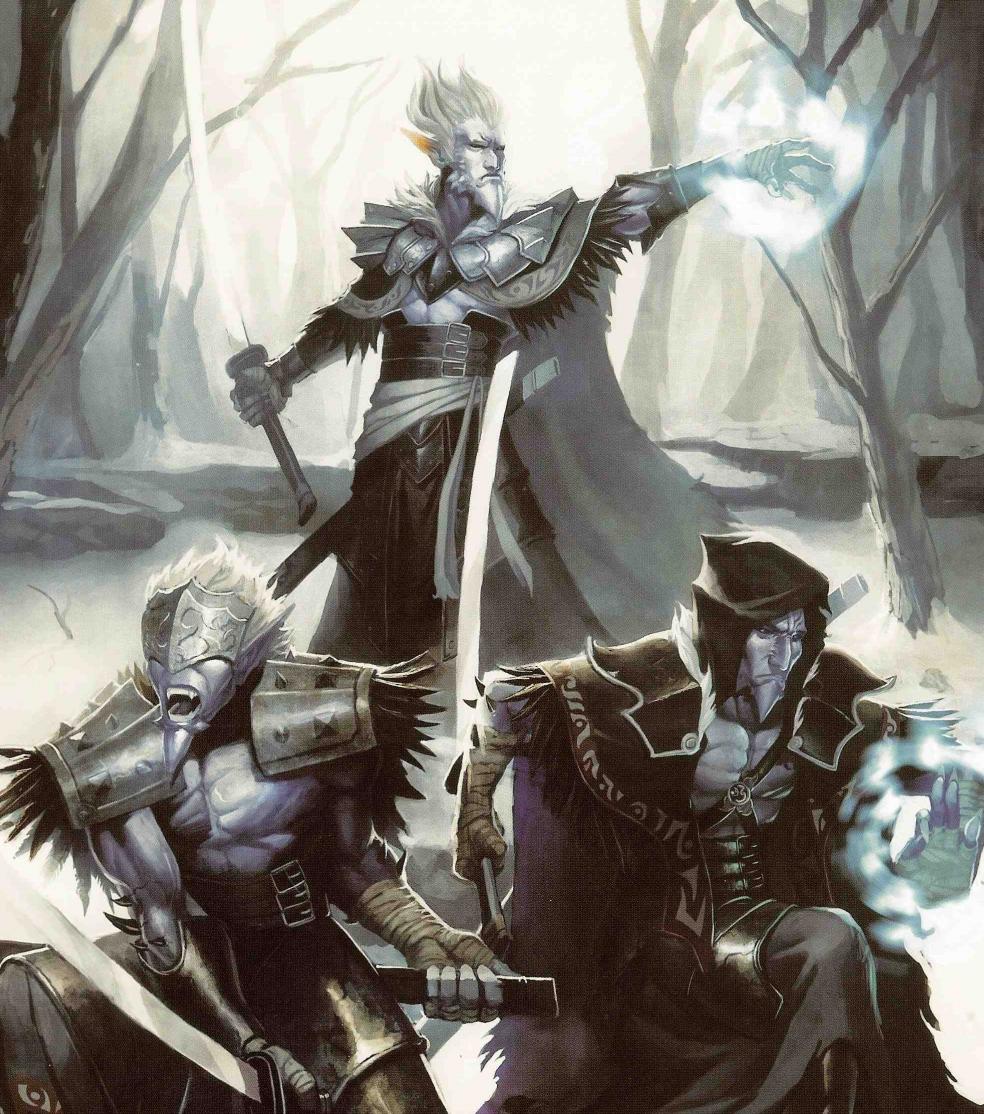
When the blighted Nyss talk about Blackfrost Shard , they mean its three most ruthless scions, the warrior-sorcerers Sevryn, Rhylyss and Vysarr. While the clan has always had a reputation for magic, the shard rose to prominence after the coming of Everblight. These three brothers who lead the shard have great reputations for lethality and viciousness, even for blighted Nyss. Once, they were seen as rebellious malcontents, but now they lead. Sevryn heads the trio, and his severe, practical mind has great insight into the interaciton of blight and magic. He can unravel enchantments while also summoning powerful blasts to strike down his foes, and it is he who maintains order in the shard. His brothers Rhylyss and Vysarr accompany him at all times, obeying him unquestioningly. Even before the blight, they had an intuitive bond that let them complement each other in battle. Rhylyss has learned how to hurl curses, while Vysarr can shield the trio from sight. Working together, they can trap anything in an icy cage. With the blight deepening the darkest parts of their personalities, Rhylyss' cruelty is always present and Vysarr is as focused on killing as a hawk on prey. Sevryn has changed least, but now, he is an ambitious and intelligent leader, who secretly hopes to permanently lead the blighted Nyss and to earn an athanc shard. He will do anything, even sacrifice his brothers, to achieve that.
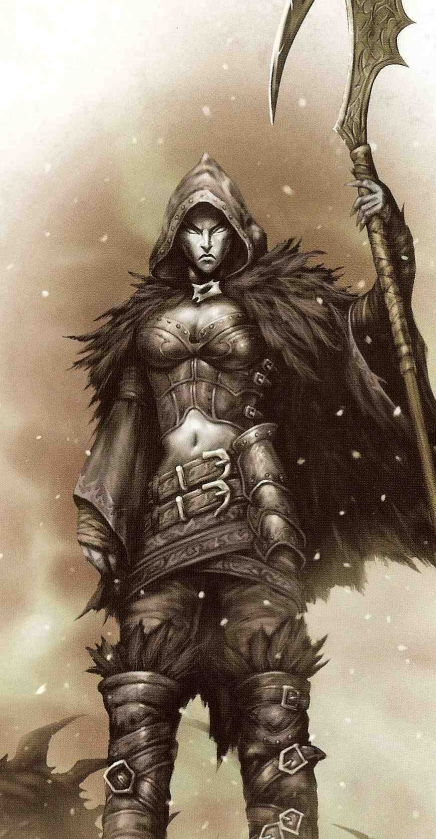
Blighted Nyss Shepherds are granted perfect purity of purpose by the blight, sensing the echoes of Everblight in the thoughts of the spawn around them. While most of the Legion fears and respects the dragonspawn, the shepherds are close to them. They spend all their time with the spawn, preferring even to sleep among them, and can become angry if forced to deal with other Nyss more than briefly. Others look on them with awe and envy, as only the warlocks have a closer connection to Everblight. They stand apart from others, blessed by their unique relationship with the dragon.
Next time: The least sexy incubus in the world
Forces of Hordes: Legion of Everblight
Original SA post Forces of Hordes: Legion of Everblight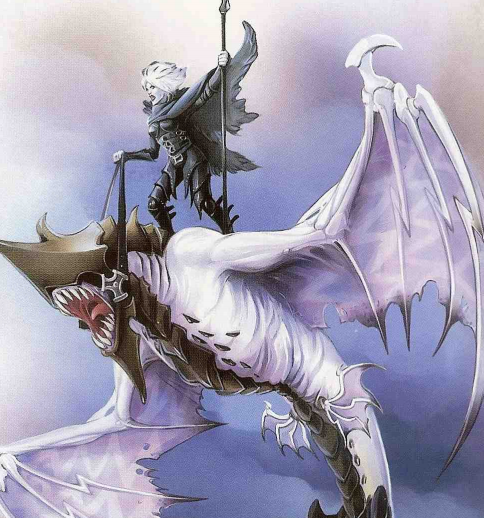
The Blighted Nyss Sorceress and Hellion are new. Traditionally, they would ride into battle on ulks, but Everblight gave them hellions, which once carried the warlords of Morrdh. They fall out of the sky onto their foes, delivering the sorceresses into the heart of battle. These women are half-mad, and they must be strong and agile enough to stand atop the hellions without saddles or harnesses. They cross the field at amazing speed to unleash their magic, summoning up deadly winds. Everblight has assimilated their rich magical tradition, which has a long history among the Nyss, particularly as part of religion. The sorcerous bloodlines have risen to new prominence now, as Everblight awakens the power even in those who had not manifested it before. The sorceresses are vassals and messengers of the generals, as while the warlocks are in instant communication with each other, the rest of the Nyss must still rely on mundane means. Sorceresses are key, with their swift mounts, and they also use their power and knowledge of blighted runes to create spawning vessels.
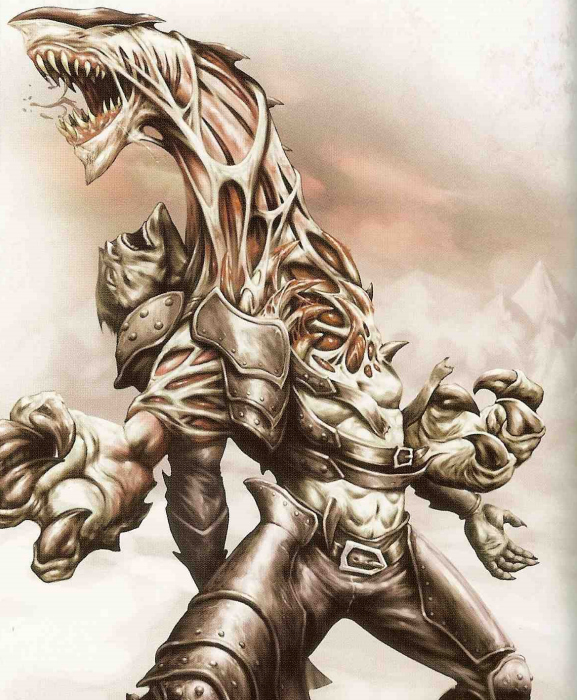
The Incubus is an insidious creature, which infects its host like a sentient disease to spread the energy of death and blight. The infected Nyss transform into hideous abominations when slain. It's impossible to tell who is host to a Nyss, until they transform. Incubi are a byproduct of the research that gave Everblight the nephilim. Chosen hosts consider it an honor to bear the infection of dragon blood, knowing that when they die, the incubus will carry on. These things survive no more than a hour before dissolving, but they can kill a lot of people in that time as well as destroy enemy morale. Often, those who witness them will hesitate to kill in later battles for fear of incubi.
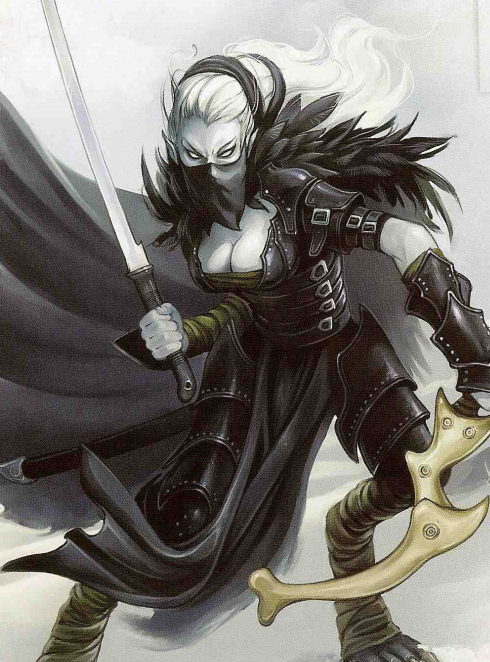
Strider Deathstalkers are the cream of the crop, mutated so far that they resemble birds of prey more than most Nyss. They revel in slaughter, planning their attacks meticulously and with as much information as possible before striking. One deathstalker is enough to convince many foes that an entire force of bowmen is attacking. They toy with their prey intricately and cruelly, provoking them into rash action and waiting in ambush. They can blend into their surroundings and remain still for hours, patient to a level unnerving even to other striders. They have an honored place in the legion, demanding the obedience of their fellow Nyss thanks to their intellect and the favor of the dragon. They are arrogant, but their skill and ruthlessness earns that right. They are trusted to execute long and complex missions with considerable leeway in coordinating and commanding other striders.
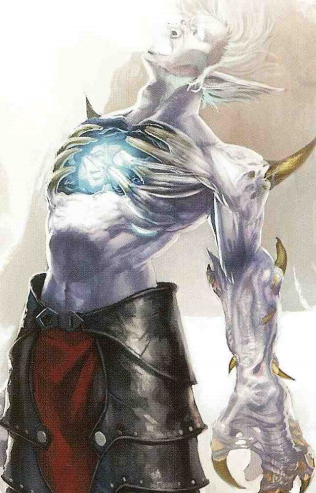
Spell Martrys float above the earth, reminding the Legion that every life within is bound to Everblight. They are barely alive, vessels for the magic of the warlocks. Channeling magic through a martyr greatly extends a warlock's reach, though it also consumes the martyr in ashen flame. While the Nyss are Everblight's favorite servants, they are relatively rare and valuable. Thus, Everblight seeks to make even the damaged followers useful throughout their lives. Martyrs offer up their bodies for use as the warlocks see fit and are one product of his experimentation in using, as it were, all of the buffalo. The most permanent camps in the north have cabals of sorcerers dedicated to arcane research. They are the ones that design many Legion weapons, and when they sought to find ways to extend the lives of injured Nyss, they experimented with the use of Aeric runes and dragon secrets. Eventually, they used their knowledge of the athanc to make a crude simulation of an athanc, a talisman to bind a dying Nyss to the will of Everblight, capable of briefly serving as a conduit of the blight energy. The false athanc holds the Nyss in perpetual stasis at the moment of death, awaiting the will of Everblight. The warlocks send their power through the martyrs, releasing them fro mtheir torpor in a moment of radiant sacrifice.
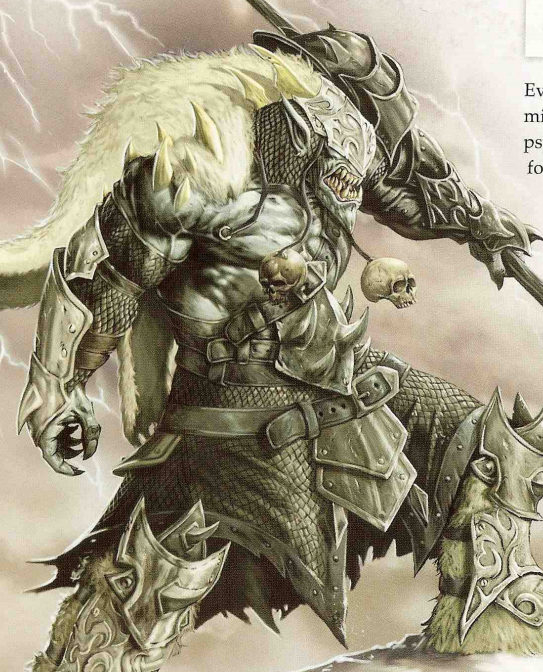
Few blighted ogrun have the will and intellect of the Warmonger War Chiefs . They lead the tribes, looking to Thagrosh as the embodiment of the dragon. When he stands before the ogrun, they are united in purpose, stronger than any other Legion forces. War chiefs delight in their kills, devouring them mid-battle and challenging anyone to question their dominance over the ogrun. The scent of blood itself gives them strength, and drinking it fresh heals them. Though the blight has transformed both mind and flesh, parts of their original psyche remain. Ogrun feel it is their purpose in life to follow a great leader, a worthy korune. This is so potent an instinct that it can even override their berserker frenzies, inciting them to follow the war chiefs in battle.
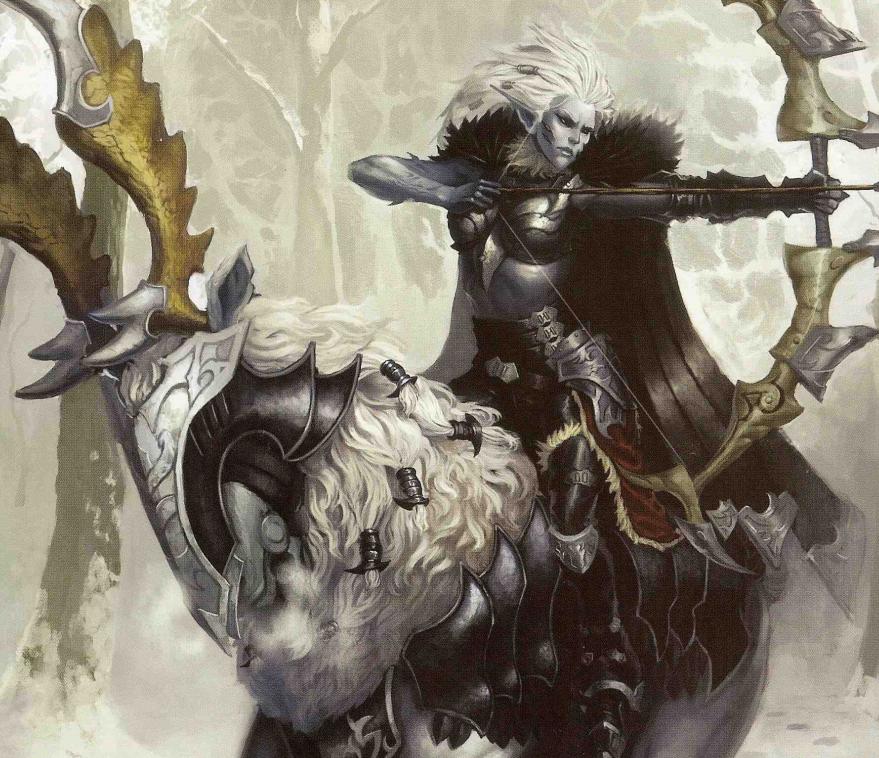
Anyssa Ryvaal, Talon of Everblight is a stealthy killer, moving in the night with poisoned arrows. She is first among the raptors, one of the best trackers and hunters in Immoren, second only to Lylyth. By the time Everblight dominated the Nyss, she was already an outcast, leading a band of marauders who would do anything to survive. They stole from the Nyss and murdered humans, and when they heard about the Legion, Ryvaal turned on them. She was no match for the dragon's forces in direct battle, so she spent months on a campaign of harassment and assassination, hunting blighted Nyss and then vanishing. She did not escape Everblight's notice, and it became harder and harder to evade pursuit. She sensed the coming of death and decided that if she would die, she'd take as many with her as she could, growing reckless. Eventually, she drew the attention of Lylyth herself. Lylyth chased her down in a narrow canyon, and Ryvaal turned her ulk to charge in one final act of defiance. She was a master of the raptor fighting arts, firing her arrows while using her bow to parry attacks as her ulk impaled the blighted Nyss. They began to fall back, and she might have routed them, were it not for Lylyth, who fired a blight-empowered arrow, ending her defiance in a single perfect shot. She lost consciousness, sure she would die. When she awoke to the pain of her wound and the sensation of the blight, she saw only Lylyth. She was spared because Lylyth saw in her a mirror of her own determination and ruthlessness. Ryvaal took Lylyth's hand and never looked back. As Lylyth took control fo the scouts, she made Anyssa her lieutenant, and under her command, the raptors range out miles ahead of the Legion to scout and make attacks on targets of opportunity. More than one Rhulic or Winter Guard patrol has met its death under her poison arrows.
The End!
Next up - Hordes: Domination or Warmachine: Wrath?
Warmachine: Wrath
Original SA post Warmachine: Wrath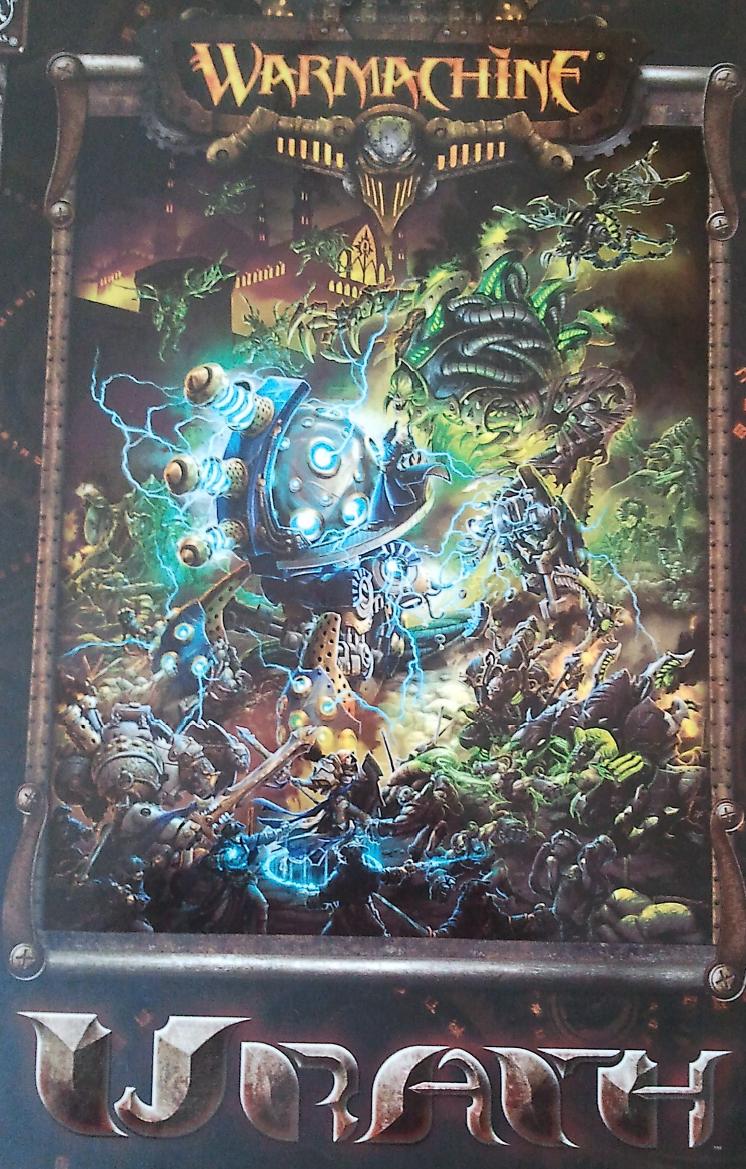
Warmachine: Wrath is the first general expansion for Warmachine, and it introduces a new unit type: Battle Engines. They are immense machines that do not require warcasters to control them, but instead are guided by their own crews or, occasionally, themselves. They are all huge creations, so large that they can't actually fire weapons on their left side at things on their right or vice versa. They tower over simple trees or clouds of smoke, too. We also get introduced to Ranking Officers, unit attachments that can be taken with Mercenary units which cause the Mercenary to be considered fully part of the faction of the Ranking Officer.
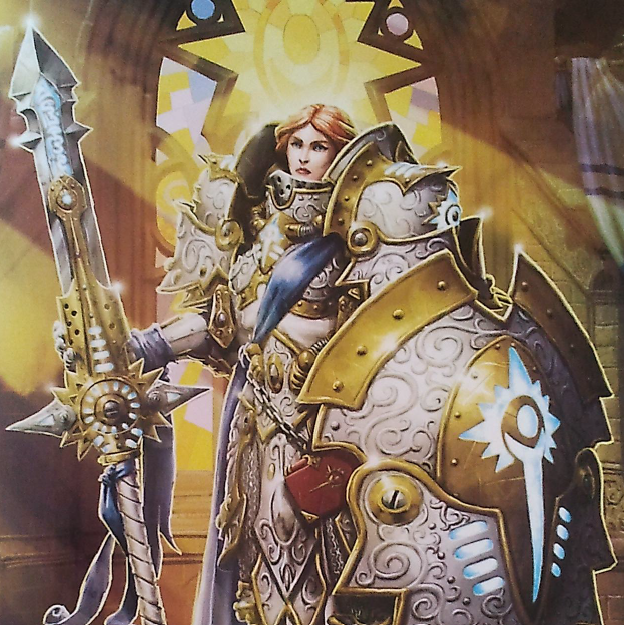
Constance Blaize, Knight of the Prophet is a Cygnaran Morrowan warcaster, and as such she won't join any army that contains any amount of Thamarites or Undead. For her, the Radiance of Morrow is a way of life. She is empowered by her deep faith in Morrow, fighting for her god and for Cygnar with an inspirational fervor. She was born to a wealthy family in Orven and felt the call of Morrow early. She was the youngest of three siblings, and when her eldest brother, Corrin, enlisted in the army, she felt isolated. In her loneliness, she had a vision of a luminous figure comforting her, and she realized her god was calling her. She volunteered to become an initiate of the clergy. The vicar of Orven saw something special in her, sending her to the Sancteum Seminary of Caspia, and it was there her second vision came. She beheld an archon of Morrow appearing before the Archcourt Cathedral, pointing to a statue of Ascendant Katrena, and then she saw herself in shimmering armor and holding a mighty spear. She knew what she was born to do: not a priest, but a Morrowan soldier. She learned the Prayers for Battle and the lessons of the Martial Trinity of Katrena, Solovin and Markus. Each of these ascendants had been a virtuous soldier-philosopher. Soon, she was initiated into the Primarch Knights, guardians of the Sancteum. When it was found that she had the warcaster talent, she was taken for special training by Primarch Arius, entrusted to control blessed warjacks. Through her training, she remained in correspondence with her brother, who had become a sergeant. She loved his stories of soldiers' life, but her invitation to him to attend her investment never arrived.
Instead, she received a letter saying he'd been killed in action against Khador in the first battle of the War in Llael. She was devastated, and soon was sent to join the Third Army to fight the Cryxians. Thanks to treaties between the Army and the Exordeum, she was soon leading mixed forces of church and kingdom, providing spiritual and martial support to the soldiers. She learned much under Lord General Vincent Gollan of Highgate, also a Knight of the Prophet, and she began to identify more with the soldiers under her command, working through her grief and feeling a deeper connection to her brother. She began to see herself as a knight of both the Church and Cygnar. After the chaos of Llael and the siege of Caspia, she began to feel her powers were better used dealing with things besides raiders. However, Primarch Arius refused her request to join the northern front, hoping to remain neutral in the matter of Khador and Cygnar. After the fall of Northguard, though, opinions in the church started to shift. While Primarch Arius still remains unwilling to send a church warcaster directly against Khador, he has consented for Blaise to join the northern war effort to ensure the Radiance of Morrow is shown to the war-torn regions. Blaize is a Sword of the Church, and she doesn't enjoy fighting, but she doesn't shy from it. She is willing to face any foe of Cygnar or Morrow, as well as anyone who would endanger innocents. Few have her skill with Church warjacks or her strong faith, let alone the clear favor of Morrow she enjoys. Her gimmick is holy light and buffs, and her feat lets her gain focus from her allies' deaths as well as boosting their defense.
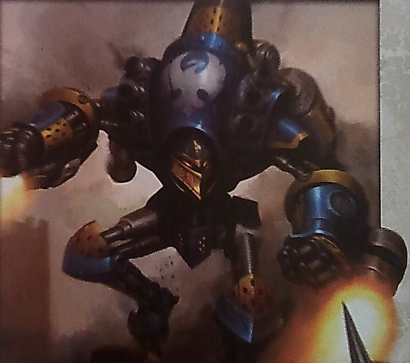
The Minuteman is eight and a half feet tall and nearly 2 and a half tons. It can reach any part of the field quickly, designed for mobility in all circumstances. It is a favorite for rapid assault tactics thanks to its exacting compression chambers, which allow it to vent its heartfire through an arcane turbine in order to launch itself into the air. It is skilled at destroying infantry with its grenade launchers when it lands, clearing the line to its real target. Then, it unloads its dual slug guns, each of which is able to rend even heavy 'jack armor. When not clearing infantry, the Minuteman is often used to support heavy 'jacks in pairs, using mobility and powerful weapons to preempt enemy attacks. It relies more on speed than armor, but is well able to keep foes occupied.
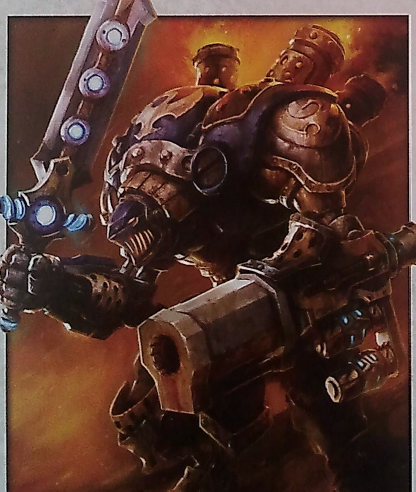
The Avenger is over 12 and a half feet tall and over 8 and a half tons. It is armed with a groundbreaking seismic cannon, one of the newest and most lethal weapons Cygnar's ever made. The cannon fires sophisticated projectiles that cause localized earthquakes on impact. Each is the size of a man's head and contains an arcanodynamic generator, a set of precisely arranged rune plates and a small detonator. On impact, the detonation causes an eruption of arcane force, making the ground shake violently. Even if the enemy survives it, they are hurled to the ground, making them easy prey. Built on a Centurion chassis, the Avenger is modified to help support the seismic cannon, while its armor allows it to survive enemy fire well. To further complement its abilities, it is also armed with a stun blade that can stop enemy 'jacks in their tracks. While everyone is eager to use the Avenger, it's almost exclusively given to seasoned warcasters who won't squander its expensive ammo, and every effort is made to recover any components lost in battle, to prevent reverse-engineering.
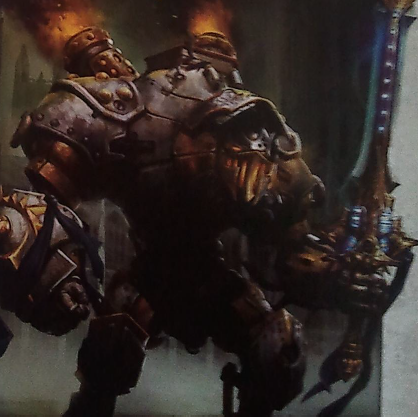
Gallant is the favorite warjack of Constance Blaize. It is over 12 feet tall and 6 tons. It's a weapon of faith, built on an Ironclad chassis heavily modified by the Sancteum armorers. It is imprinted with the warrior-philosophies of Morrow and the martial ascendants, and a copy of the catechism called the Prayers for Battle is mounted on its hull, along with passages of the Enkheiridion and other teachings of war. The book is open to pages talking about Morrow's orders to protect each other from evil. Where Gallant walks, the light of Morrow follows, unraveling dark magic easily. It is also an exceptional protector of its mistress, knocking enemy blows aside easily.
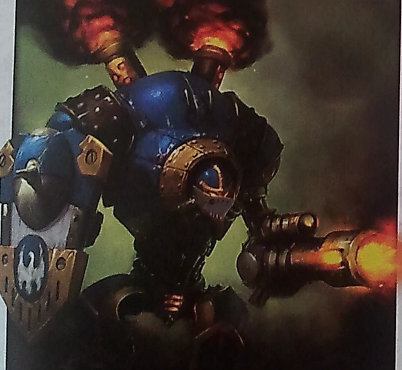
Triumph is one of Markus "Siege" Brisbane's warjacks, a Defender that stands over 12 feet tall and almost 7 tons. It has shown a particular skill at targeting weak points in the enemy defense after the battles in Sul, and Siege has come to trust its instinct, allowing it to pick its own targets. His appreciation for Triumph only grew through the Sul-Caspia campaign, and he's had it improved heavily. It is now armed with a heavy assault shield to handle incoming fire as it moves into position, and its sighting system is upgraded, linking its cortex to a scope integrated in its cannon. Siege rarely fights without Triumph now, and he's armed it with mechanikal ammo that can be made explosive. The mix of firepower and shielding allows it to head right into the heart of battle, assailing even the most heavily defended position.
Next time: Giant lightning robot
Warmachine: Wrath
Original SA post Warmachine: Wrath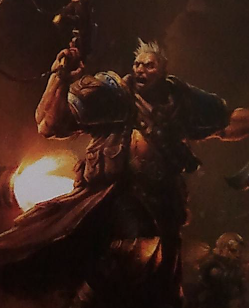
Captain Jonas Murdoch is a Ranking Officer, a leader of Cygnaran mercenaries. He served 20 years as a trencher, gaining a reputation for unflappability even in the middle of a firestorm, and he became legendary for his inability to die. He even got shot in the head and captured by Khadorans, but escaped from the prison camp he was in, apparently unharmed by the bullet in his skull. After a long career in the trenchers, he was chosen by Lord General Olan Duggan to find veteran mercenaries and turn them into elite irregulars. These teams of former mercs have a variety of skills, trained by Murdoch take on the most dangerous missions, and he makes sure to only employ the best mercs to see them through.
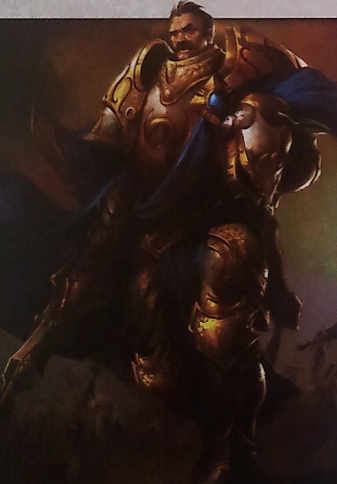
Archduke Alain Runewood, Lord of Fharin is one of the few people Leto Raelthorne considers a true friend. He has given up his own comfort and safety to serve his nation, and his friendship with Leto is decades old, begun when he was a young Cygnaran officer. Under Vinter IV, he saw lives spent too carelessly, and he realized that all lives were precious, no matter whose. When Leto led his coup, Alain was proud to join him. Afterwards, he was given lands of less loyal nobles, particularly Archduke Fergus Laddermore. Another man might've retired, but Runewood would not. He leads from the front, and his men are inspired by his presence and the sight of him using his heirloom sword, Vindicator. He'd do anything to prevent the return of Vinter IV's tyranny, and he can smell the man's schemes amidst the nobles conspiring against Leto. He leads almost 20,000 men, and the sword knights in particular will do anything he asks.
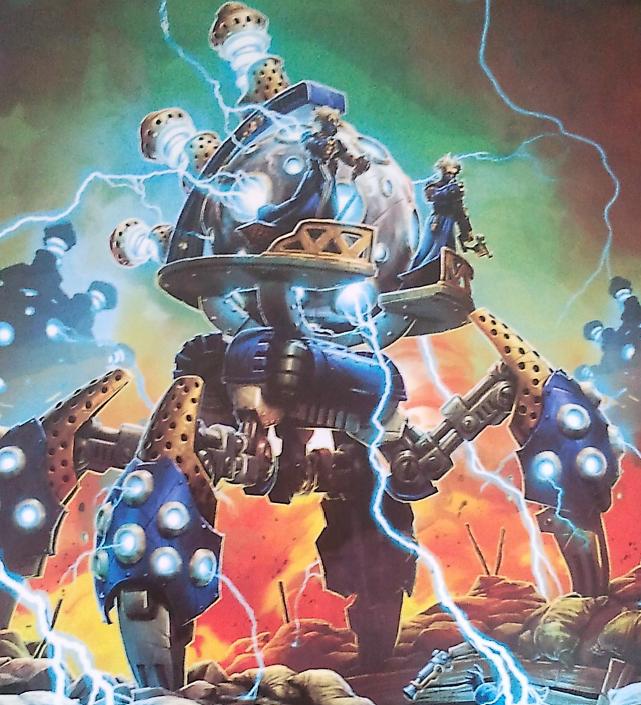
The Storm Strider is an immense battle engine, one of the greatest and strangest works of the stormsmiths. At rest, it is easily mistaken for a fixed weapon platform, but in motion it can never be forgotten. An immense storm envelops it, blinding those who stare too long at its voltaic charge, and the stormsmiths that operate it from its open deck are always surrounded by a corona of lightning. Until it unleashes its thunder cannon, electrical blasts crackle across it constantly. The stormsmiths worked for years to build the electrical generators, stormchambers and other devices used in voltaic weapons, building ever more potent weaponry and stretching the limits of the art. At last, they shattered those limits utterly, creating the lightning cannon - a weapon so potent and needing such a massive storm chamber that it was initially believed impossible to field. The engineers were determined, however, devising a design for a self-propelled platform to transport the weapon: the Storm Strider. All of the energy it generates can be used without any waste. Most of it does get channeled to the cannons, but excess power flickers across its body, charging the air in a way that drastically increases the accuracy of other storm weapons. Its destructive potential is matched only by its defensive power, as a strong magnetic field and powerful kinetic accumulators absorb the force of hostile fire, converting it into even more voltaic energy. It smells constantly of ozone and hurls weapons away from it with ease. And no, the thing isn't unique - they have at least two of 'em.
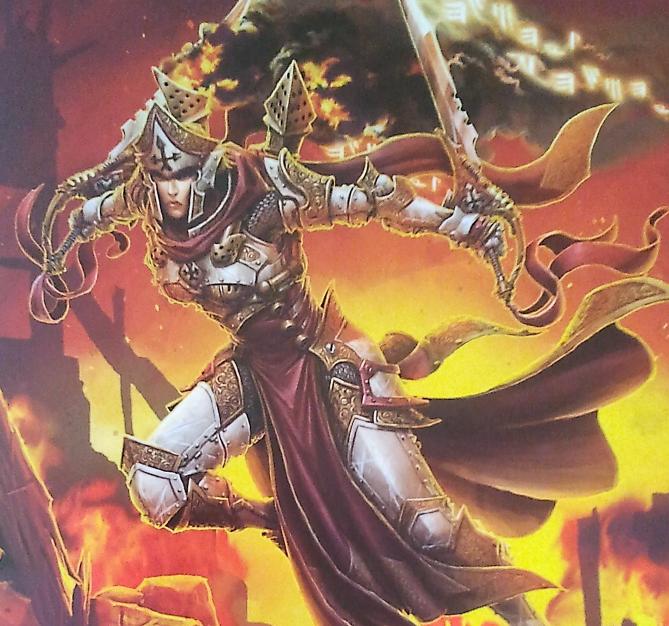
Thyra, Flame of Sorrow is the greatest of the Daughters of the Flame, a living weapon of Menoth. She cannot stop revisiting the battle that made her what she is, that killed her family and her village. It was senseless, deaths just for living near a Protectorate garrison near the Black River. Cygnar had hired some mercenaries to assist in an attack on the garrison, and the village priest had all able-bodied adults go to fight. The militia enraged the mercenaries, and their counterattack was brutal, driving the militia back to the village, killing anyone in their way. Thyra was among the defenders, and she saw her house destroyed and her children bleed to death in the ruins. Her mind was broken by it. Her powers awoke, which she attributes to the blessing of Menoth for vengeance. She set on the mercenaries, fighting perfectly, leaping from the shadows to take them out again and again. She called on her warcaster power without realizing it, leading the defense of the village and hunting the mercenaries down like rabid dogs. She devoted herself to an unending vengeance, killing heathens for Menoth. Many were drawn to her, fighting without temple sanction under her direction. It might've gone on some time had a priest not approached her and asked her to stop provoking retaliation. Enraged, she attacked him, drawing the attention of the Knights Exemplar, who captured her. She was brought trial and sentenced to death, and she'd have died, if not for Feora. Feora confronted her to test her resolve, and Thyra argued that she was chosen for vengeance and could not stop now. Feora sensed her power, using her authority to get Thyra free so that her vengeance could be channeled.
To Thyra, it was a blessing she hadn't realized she'd wanted. Feora taught her to control her rage rather than succumb to or release it. She was given warjacks and support, learning to obey orders even when they kept her from fighting. She bonded with the Daughters of the Flame over shared grief, taking comfort in them. Her devotion to Feora is fanatical, and she trusts Feora utterly, even to the point of doing missions others might balk at. Some fear crossing Feora because they know Thyra will kill anyone for her. She draws on her raging flame of hate to perform terrible violence in battle, but she knows how stop and hold back from the cliff that tempts her to join her family in Urcaen. She used her power to destroy Cygnarans in Sul and Caspia, and she has earned the right to stand at Feora's right hand, above all others. Her obsession with vengeance is barely constrained, and she must constantly remind herself that loss of control would disappoint Feora. She has a deep, instinctive tie to Urcaen, serving as an avenging avatar of Menoth. Her gimmick is offensive buffing and her feat lets her teleport herself and her allies via the shadow of Urcaen.
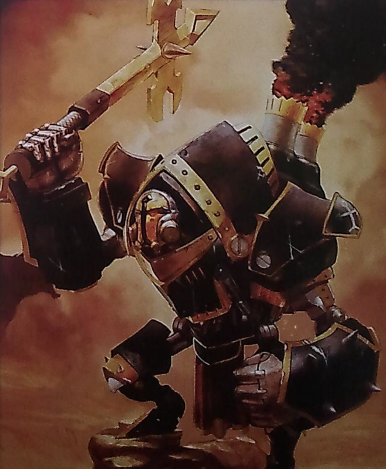
The Sanctifier is 12 feet tall and 8 and a half tons. Its presence means the Reclaimants expect a conflict to be bloody, win or lose. They are armed with an immense cudgel in the shape of a Menofix, which they use to crush foes. As the battle goes on, they collect the souls of dead Menites within their blessed cenotaph, manifesting the power of Menoth on the world by forcing the spectral undead and other creatures that hide between worlds into physicality, that they might be crushed beneath Menoth's power.
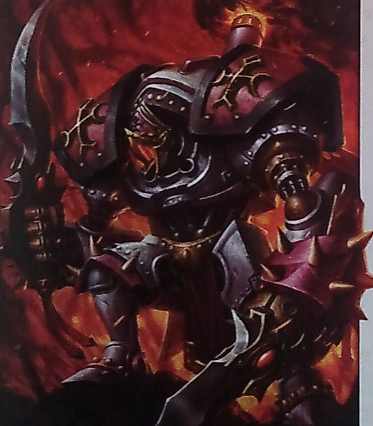
Blood of Martyrs is 12 feet and over 8 tons. It is Thyra's favorite warjack, and so it is no surprise that it fights with her bitter resolve. It fights harder as more allies die, wading into the middle of battle for vengeance. It originally entered Thyra's service during the Sul battles as a Crusader, unleashing its fury in an orgy of death to save its mistress and her soldiers. She recognized that Menoth had sent it to guard her and mirror her rage, rearming it with the twin blades needed to carry out its destiny. She gave it its name, knowing it would slaughter an infidel for every drop of blood the righteous lost.
Next time: Holy vengeance
Warmachine: Wrath
Original SA post Warmachine: Wrath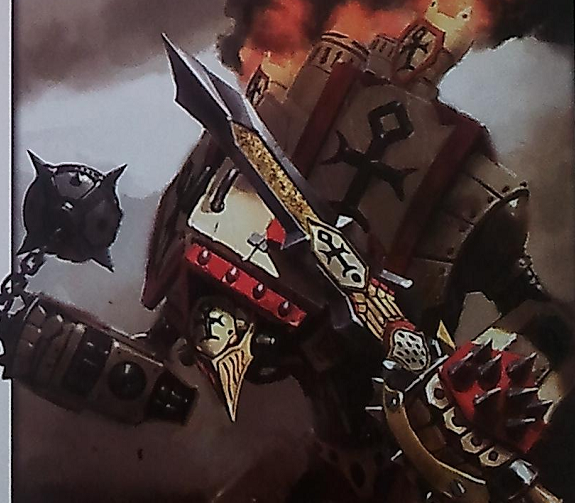
Scourge of Heresy is a custom warjack built for High Executioner Servath Reznik. It is over 12 feet tall and nearly 10 and a half tons. Its purpose is to purge the world of the corruption of magic, and it hunts the occult with a fury that rivals Rzenik's. Its heartfire blazes fervently as it purges the unclean with the flames of the holy blade Punisher. Its cortex, chassis and weapons were all chosen personally by Reznik, blessed even beyond the normal rites. Sacred passages found on the walls of Icthier were chanted over it as it was activated for the first time, and to stand before it is to be judged.
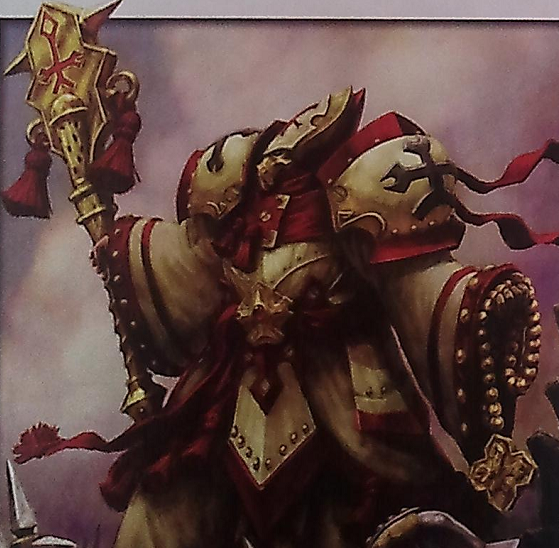
An Attendant Priest is a Ranking Officer, trusted by the Protectorate to oversee mercenaries. They don't enjoy hiring mercs, but they need to at times. They are often taken from the choirs of Menoth, and are skilled combatants as well as potent spiritual forces. To control their mercenary charges, they must be convincing proselytizers. Many mercenaries balk at the idea of being led by a priest, but their mriacles are hard to dismiss. Under their care, magic cannot touch their subordinates and the land flattens itself for them to cross. They bless the weapons of their charges, and its not unheard of for a group of foul-mouthed mercenaries to convert after a battle serving under them.
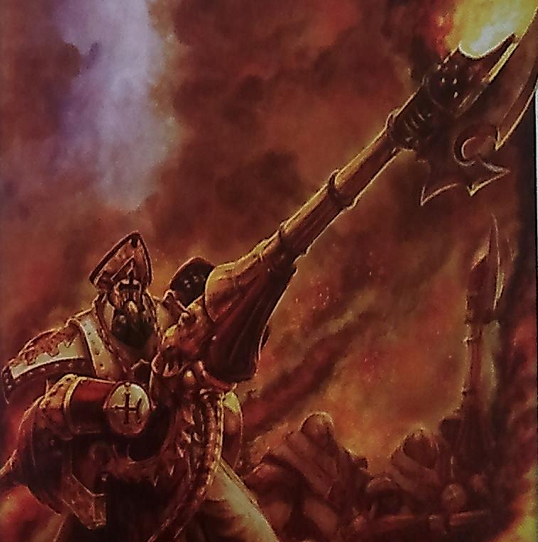
Flameguard Cleanser Officers lead the Cleansers in purging blasphemy. They are taken from the ranks of Cleansers that survive, in the belief that they were preserved to guide their subordinates and direct them where they are needed. The purifier is a challenging weapon, but the officers are masters of it, wielding it with finesse and skill. They can release fuel in precision amounts, causing fiery sheets over the ground, and they know when to call on the full fury of their weapons to create a purging wildfire.
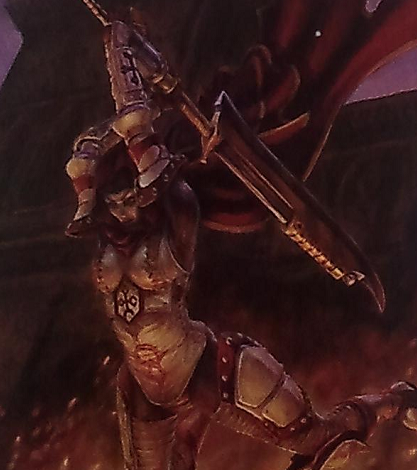
Nicia, Tear of Vengeance has killed more enemies than she can count, but she remembers them all. Each is a devotional act she can recite to Menoth, in the hope that by the time she inevitably dies, she will have earned a place in the City of Man. Only a few years ago, she lived in Sul with her husband, a Flameguard named Heltus. Her love for him even outshone her love for Menoth, and she prayed for him to survive when the Cygnarans breached the walls, but he was chosen to join Menoth in Urcaen. She almost killed herself in grief, but stopped, realizing she was unworthy to join him in the afterlife until she proved herself as faithful and righteous as he had been. She joined te Daughters of the Flame, dedicating herself to her training. Her skill surprised, even alarmed her superiors. She quickly became a leader of the Daughters in the fights of the Caspia-Sul War. She heads into combat with deadly grace, perfectly gauging her striking distance at blinding speed. She wields a blade with a mighty sword cannon, and ffew have ever survived witnessing her deadly devotions.
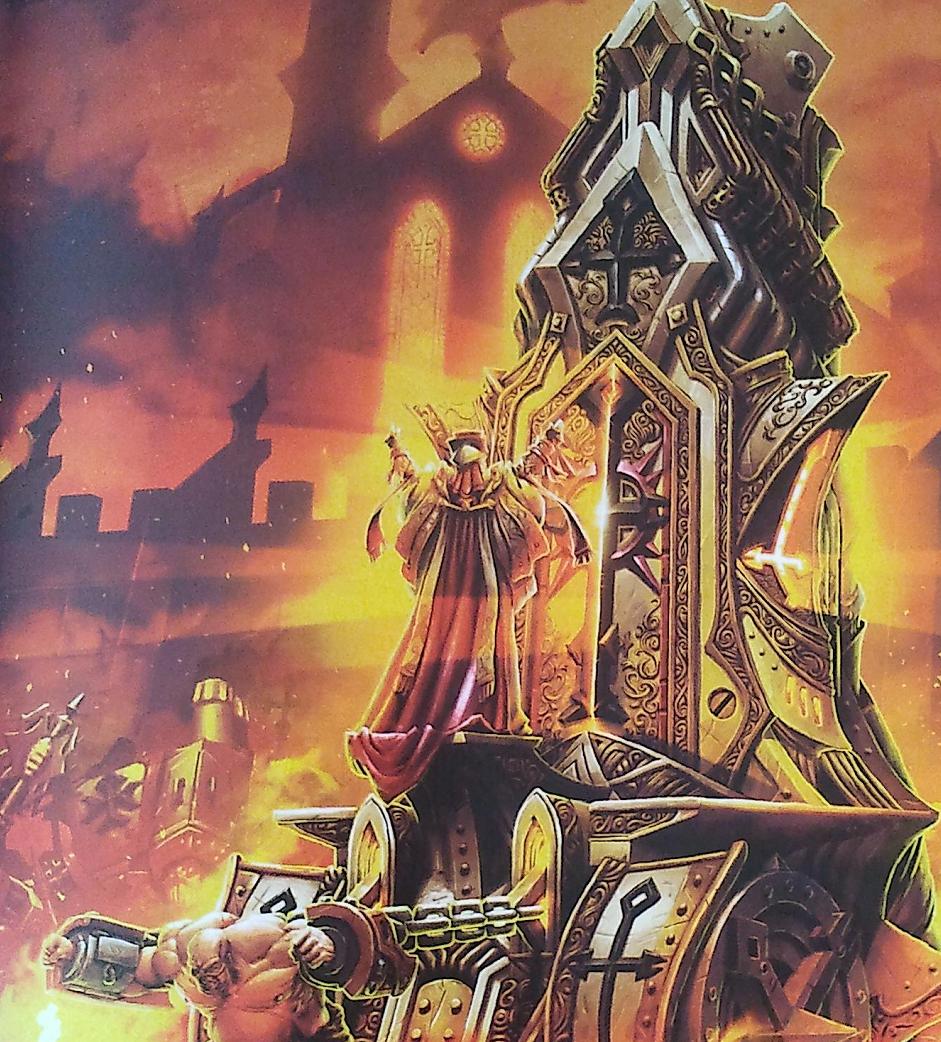
The Vessels of Judgment are mighty battle engines, inscribed with holy words as avatars of Menoth's vengeance. They are reliquaries containing the sacred remains of the MEnite priest-kings of old, who performed countless miracles. Menoth's favor renders these bodies incorruptible and holy, enduring through the ages in the holiest temples. The pilgrims seek them out, and the enemies of the faith have sought to despoil them - and always failed, destroyed in the act. Their use in battle has sparked furious debate in the Sul-Menite priesthood, and while some of the Synod protested, Feora persuaded them to allow the machines to be prepared. Their immense usefulness suggests that Menoth approves of them. The power contained in these reliquaries, after all, is a sign of his blessing. Dragging them to battle requires almost miraculous strength, and they are pulled only by the most faithful zealots, attended by ranking priests. When the priest invokes the relics' power, the pipes of the Vessel emit a deep tone, and the fury of Menoth envelops those who get too close, their magic dissolving utterly. Even death can be prevented for a time, allowing the dying one last strike before they fall. Harnessing this power has a price, though. Each invocating withers the corpse within, and with each miracle, they crumble a little more.
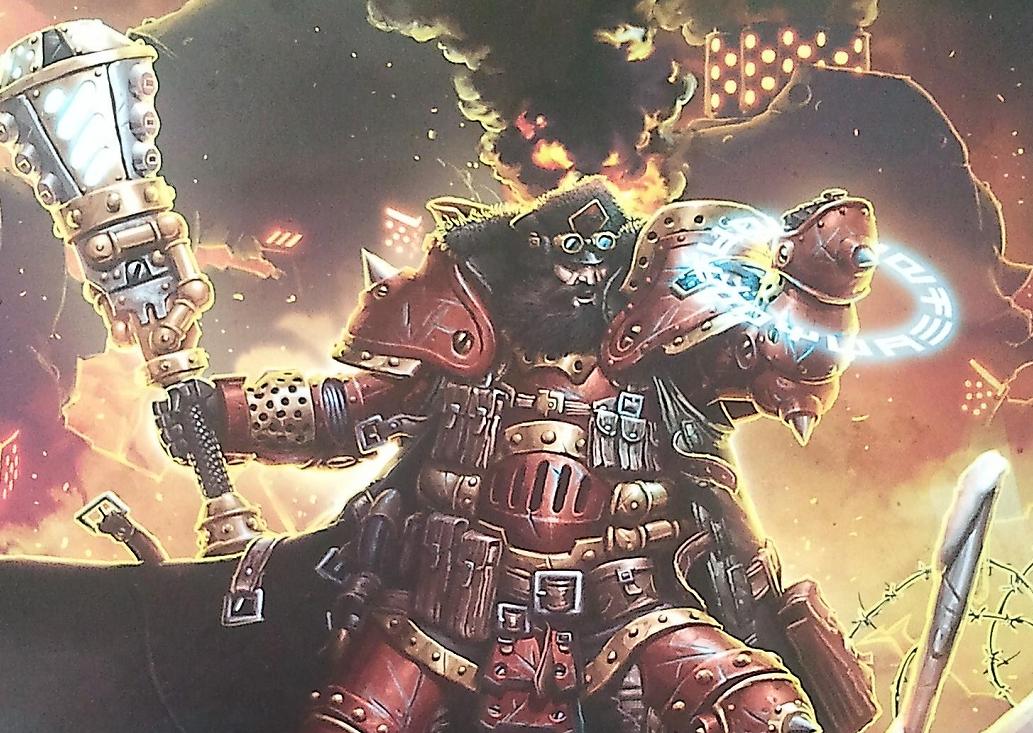
Kommander Harkevich, the Iron Wolf was born Izak Harkevich. He is immensely successful and highly respected despite his uncompromising nature. His drills are bloodless battles and bis battles are bloody drills. He has only the highest expectations of his man and 'jacks, and he hates nothing so much as a Khadoran who doesn't love Khador enough to work as hard as possible. His warcaster talent was recognized early in his time in the Winter Guard under Lord Regent Blaustavya. He was a natural soldier and considering it as a permanent career rather than returning to his form at Khardov. Because of his simple upbringing, he has a close affinity for the citizens and enlisted men he protects and leads than their officers. He believes that his power does not elevate him - it's just more responsibility to them. He feels a primal tie to Khador, and he pities those of other lands. As a Winter Guardsman, he was skilled at organization, able to keep many tasks in mind as he worked. As an officer, he used this abivlity to divide his attention between a half dozen or more warjacks at once, a skill normally taking years to get. Ranking kommandants were eager to use him, and he hones his skills on the border against Ord and Cygnar. His years of service had earned him a reputation even before Llael, where he helped seize Elsinburg alongsider Kommanders Tarovic and Kratikoff. He thinks he is lucky to have served with officers who understand their responsibilities and respect for civilian life, and Elsinburg was barely harmed in the battle. Nothing would please him more than to see Llael become a productive part of Khador, willingly serving, rather than being a battlefield.
While Harkevich has seen the horrors of war, he will not allow them to compromise his honor. He disagreed with senior officers over the brutality in Llael on both the enemy and civilians, and he was stationed at Redwall shortly after the Butcher's assault and massacre. He knew that the Llaelese could be good citizens, but that brutality would not win them over. Even measures he thought necessary, like the burning of Riversmet, troubled him. He eventually came to acknowledge that Riversmet likely saved tens of thousands of lives in Leryn, but he does not like this cold calculus of lives. He despises the doom reavers. He is always mindful of the value of his men's lives and prefers to let his warjacks endure the brunt of risk. They are not present to support the army - the army is there to support them. He is a skilled kommander, using his soldiers to steer the enemy into his 'jack guns and control the battlefield, then mop up the routed foe. He always stays up to date on mechanika and warjack usage, and he's famous for using large numbers of 'jacks at a high pace to arrive in unexpected areas. He's a master of logistics and supply lines, taking full advantage of advance recon and personally surveying the battlefield before a fight. His professionalism has earned him the commandation of Gurvaldt Irusk, and he has been sent to eastern Llael to secure it while the rest of the army heads south to Cygnar. He has the honor of being the bastion of Khador's contested territory against the Menites, and he intends to make them pay dearly for every inch they try for. His gimmick is 'jack buffs and his feat improves his warjacks' armor and ability to power attack.
Next time: Lots of red.
Warmachine: Wrath
Original SA postWell, Tzepesci's a decent guy.
Warmachine: Wrath
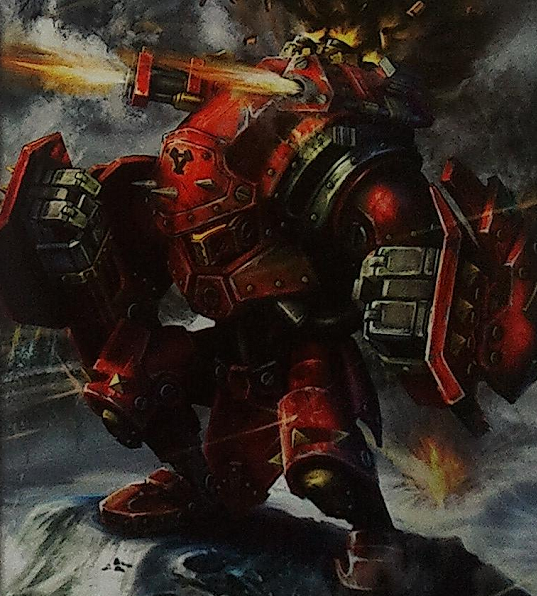
The
Demolisher
stands almost 11 and a half feet tall and nearly 17 tons. It is proof that Khador does not believe in the idea of excessive force. It is an immense, intimidating machine with armor nearly half a foot thick. It's slow as hell, but when it raches position, the armored arms drop, revealing integral cannons. It makes the 'jack briefly vulnerable, but its sheer power means few survive to return fire. The problem it was made to solve is delivering short range but powerful ordnance. These weapons draw a lot of enemy attention, so they're easy targets. The armor of the Devastator chassis proved useful, though, and via brilliant engineering, the mechaniks found a way to integrate the cannons, leading to breakthroughs in cortex design to maximize their usage. The Greylords even found a way to refine the firing routines so it could stabilize itself and fire during close combat. Its shoulder cannons also carry some of the heaviest ammo of any warjack weapon, and its massive body is like a mobile artillery emplacement to hide behind.
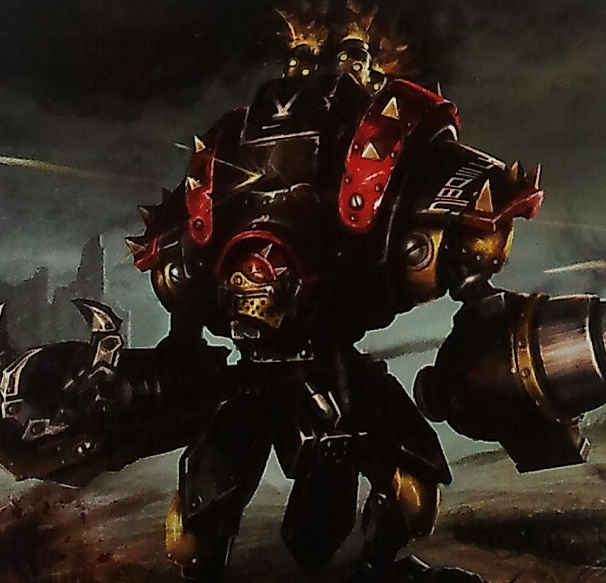
Black Ivan
is the personal warjack of Kommander Harkevich, a peerless engine of destruction that moves like a living thing. It is over 11 and a half feet tall and over 9 and a half tons. Ivan has learned to anticipate his will, allowing him to concentrate on his other forces, and his presence calms its belligerance, greatly improving its accuracy. It once wielded an axe, getting it stuck in a Cygnaran Centurion, but Harkevich ordered it rpelaced with an immense grappling claw. The most dramatic changes its undergone, however, are in its cortex, which allows the thing to surpass the expected limits of its form. While other Khadoran 'jacks are slow, it moves with haste, reaching the enemy quickly so it can tear them apart.
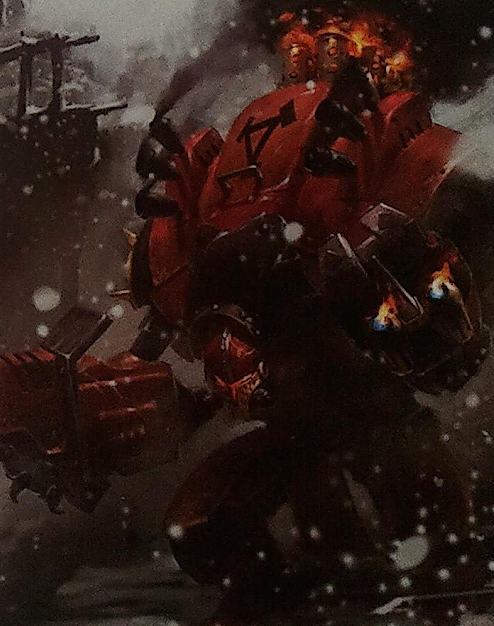
Torch
stands over 11 and a half feet tall and nearly 10 tons. It is an immense fire-spewing weapon, the producf of a design by Kommander Oleg Strakhov. It is perfectly equipped for trench warfare, tearing apart obstacles with its immense saw and hurdling impassable terrain. As it gets closer, its grenade launchers fire smoke bombs into the air, obscuring it before it delivers fiery death on the enemy's ranks. It is the expression of Strakhov's war doctrine: pitiless destruction.
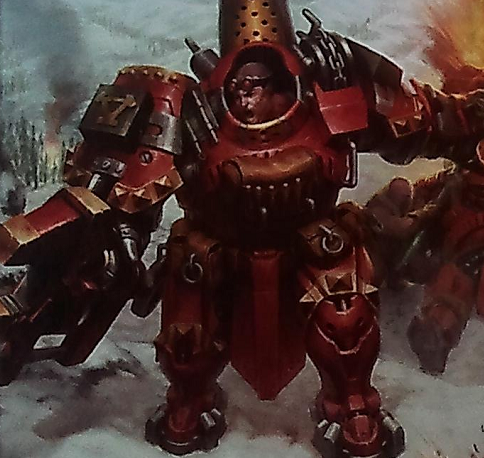
A
Battle Mechanik Officer
sometimes leads the battle mechaniks. They aren't just support specialists - they're veterans, performing the dangerous task of field repair. Combat experience is highly valued, and those that specialize in repair of the Man-O-War korps are trained to use the armor, as well. They accompany their men into the heart of battle, carrying out necessary repairs in a very short time. Every one of them knows their tools are as important for victory as the weapons of their men. On top of extensive combat time, each officer must also be a master of the trade. By the time they get a command, they understand well all the tools and mechanika used by the Khadoran Mechaniks Assembly, including warjack command. Their skill at repair and construction must be superlative, and they must be able to maintain the notoriously dangerous Man-O-War armor. Every soldier takes on a great risk each time they wear the armor, and the mechaniks mean none of them are disabled, trapping them within. They pull scalding armor out quickly to do their repairs, turning even hihgly damaged suits back to near total functionality in the chaos of battle. With the help of a mechanik officer and his crew, a unit of Man-O-Wars get all the resilience of the warjacks they support.
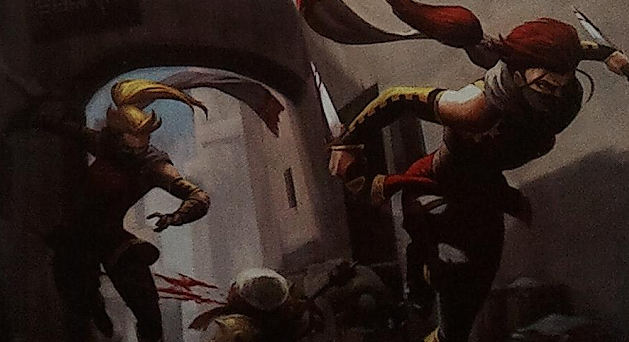
Kayazy Eliminators
are assassins, chosen by the kayazy when discretion is required. They hold their criminal peers in disdain, working only in pairs rather than gangs and choosing their partners with exceptional care. They are professional killers, spending countless hours training both body and mind for murder. Every step is calculated, with no wasted motions or sound at all. They move with their partners, anticipating each other easily, with a graceful ease. Since the expansion of the border, the kayazy have often found themselves entangled in military affairs, and they often hire eliminators to aid the kommanders they have interest in. Though they spend most of their time in darkened halls and alleys, they're equally skilled on the battlefield, slipping among their foes to reach their targets.
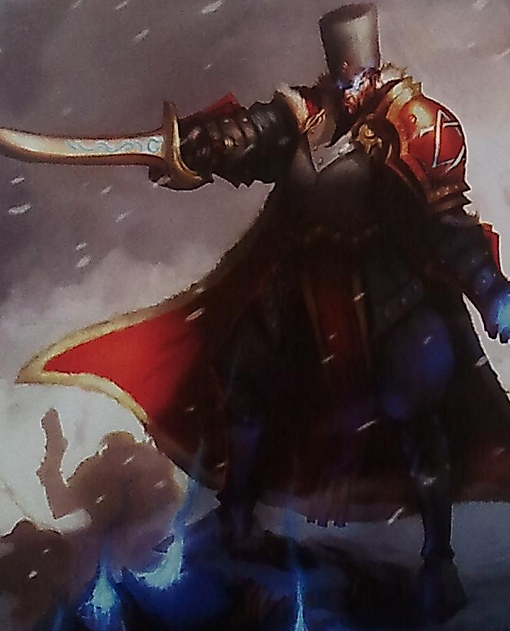
Koldun Kapitan Valachev
is a Ranking Officer, known for his grim pragmatism even among the Greylords of the Prikaz Chancellory. He takes only the most secretive missions, and specializes in commanding irregulars like mercs or criminals. His men have no illusions about their chances of survival, but it's better than angering Valachev. While he is an accomplished mage, his true brilliance is in political intrigue and determination to follow any order. This brought him to the attention of the Chancellory early. They have use for ambitious and motivated men, and they inducted him as an operative. Before Llael, he led handpicked mercs in Cygnar and Ord, many of whom were only barely willing and received only nominal pay, cooperating due to extortion from Valachev. Some were taken fro mthe gulags of the Winter Guard for their skills, and survivors were well paid and in most cases had their records wiped. His objectives are so secret that only he and the masters of the Prikaz Chancellory know them. He arrives without explaining his plans, helping achieve victory so that he can one day take his place among the secret powers of Khador.
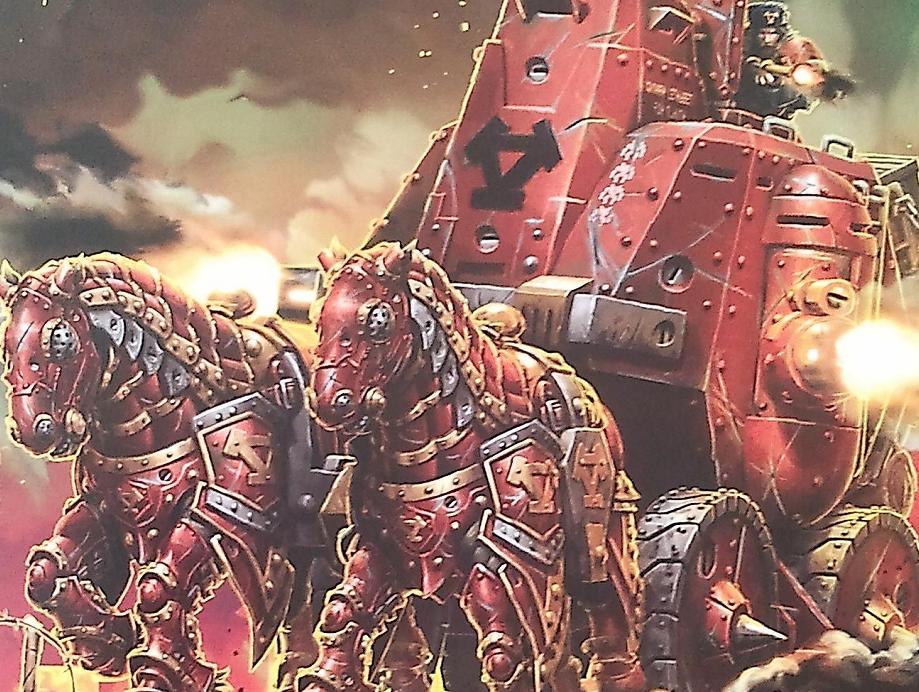
A
Gun Carriage
is a battle engine designed to support shock troops. The charging horses' hooves are silenced by the thunder of the guns, which crush the earth and shatter formations at point blank range. Everything is designed to intimidate, with the appearance of an iron fortress being pulled by steel horses. The heavy cannons are loud enough to strike fear even into veteran knights, and the ordnance is immensely destructive, annihilating wide areas and even deforming the ground itself. Khador has used armed carriages for a long time, even during the Orgoth Rebellion - at the time, basically siege guns dragged on sleds. As warjacks rose to prominence, the war wagons fell from favor, but the simplicity still appeals. Because a carriage can carry guns too large even for warjacks, the utility is unquestioned. These huge carriages are drawwn by powerful Khardic and Umbrean draft horses, bred for size and power. The horses are as heavily armored as possible, to ensure that even this most vulnerable part of the carriage can weather enemy fire. The resilience of the carriage is equaled only by its power, with a crew of Winter Guard within working to load and fire the main guns. They have months of training in this, albe to fire the guns with great accuracy even when racing along at speed. One of them serves as a spotter and sharpshooter from atop the carriage, a job saved only for the best marksmen, as they must be able to compensate for their constant jarring.
Next time: Chain scythes.
Warmachine: Wrath
Original SA post Warmachine: Wrath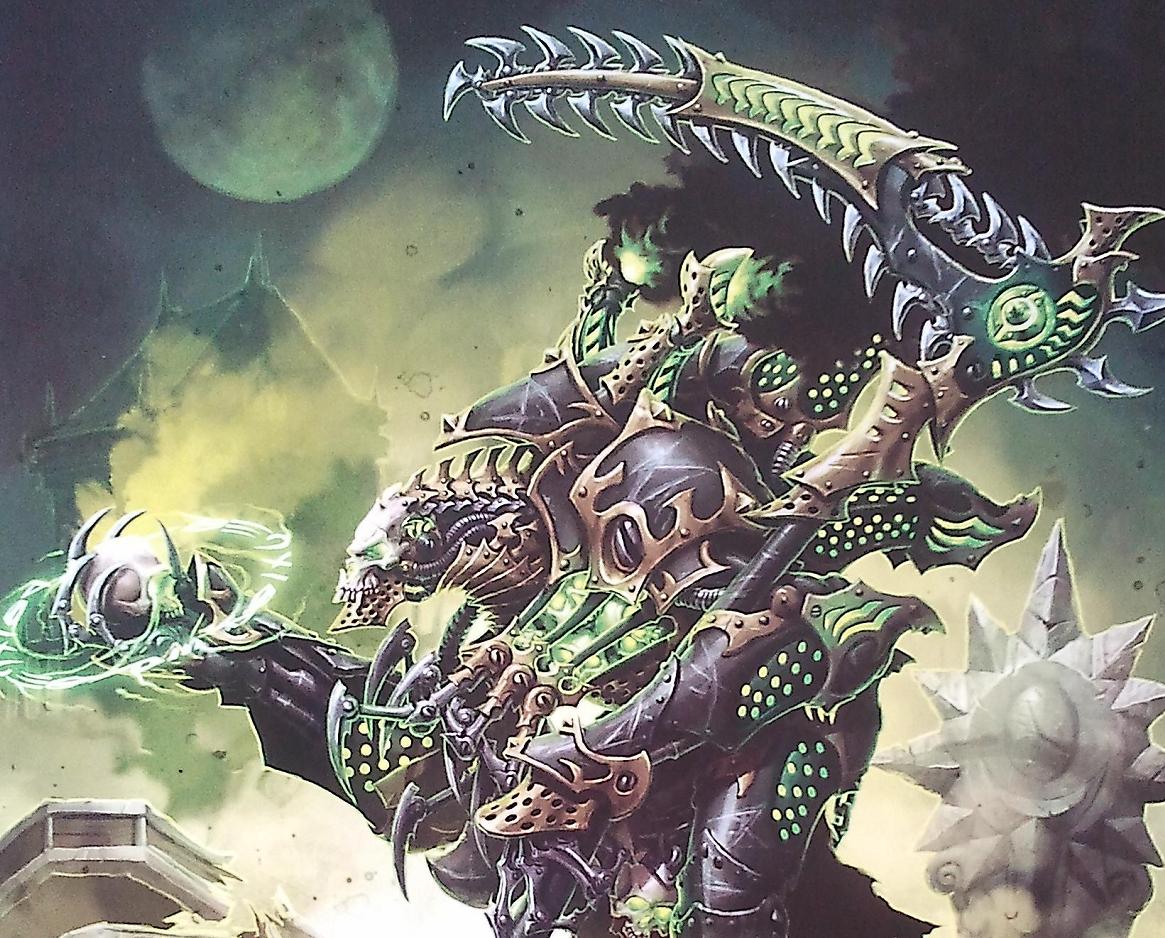
Lord Exhumator Scaverous denies those he kills the release of a quick death. While his battle skill is great, it is his mastery of necromancy that is truly terrifying, for he uses the souls of the dead as mboth ammunition and fuel. He has served Cryx for centuries. In life, he was a historian and dark wizard, but it was nothing compared to what he became in undeath, serving in the Archive of Skell and as an intelligence agent. He mastered the arts needed to interrogate the dead and force their shades to manifest. He has the chance now to learn every secret, every lost piece of lore, and he will do anything for that knowledge. His master, Lich Lord Malathrax, approves of his work, especially as these secrets can gain advantage for Cryx, and it is because of all these gains that he was made an iron lich. Scaverous' experiments have consumed uncountable souls and coprses, and no spirit can deny him information now. With a few careful runes and a bit of energy, he can compel any to give up their memories. He was at the forefront of developing forensic necromancy, which has since been taught to the most promising necromancers of Malathrax to learn secrets. None can approach his mastery. When the Orgoth immolated themselves, Scaverous was sent to assist in the ransacking of Drer Drakkerung, interrogating the Orgoth for the secrets of their soul cages. Likewise, he was the one to find the secret of the Cygnaran arc node. As the greatest forensic necromancer, Scaverous spends a lot of time on the mainland, retrieving corpses and relics. He enjoys these trips, as he hungers for lore constantly. He's been accused of having a tendency to be distracted by information, but many times this habit has let him find useful mysteries.
Scaverous has many secrets he has shared not even with Malathrax, savoring the chance to be the only one to know things. He longs not only to learn as much as he can, but to hoard it for himself, as nothing gives him more satisfaction than knowing what others do not. The moment he is exposed to something unknown to him, he is driven to explore it. His thirst is insaitable, and he keeps skulls with him at all times, held within his ribcage, to store information. He often talks to them, hearing voices no one else can. Few can truly understand him, even in Cryx, as his preference for speaking to the ancient dead is seen ass somewhat uncouth. In his estimation, however, all other choices of conversation partner pale in comparison. He longs for access to the skulls of the lich lords, each of whom knows much occult lore, but he is careful to hide these desires, lest they be mistaken for ambition. He has no qualms about destruction in the pursuit of his goal - the living are boring, impossible to process while alive. It is better to kill them and extract their secrets from their souls. He also cheerfully leads battlegroups to seize ancient corpses held by the living nations, gathering new skulls and tombs for Cryx. He has access to extremely potent death magic, able to weaken the bounds between Caen and Urcaen, causing a suge of necromantic power that saps other magic. He is also skilled at harvested fresh souls to reanimate corpses as warriors quickly. His gimmick is undeath-based buffs and attacks, and his feat boosts magical attacks and makes spells cheaper to cast for him and more expensive for his foes.
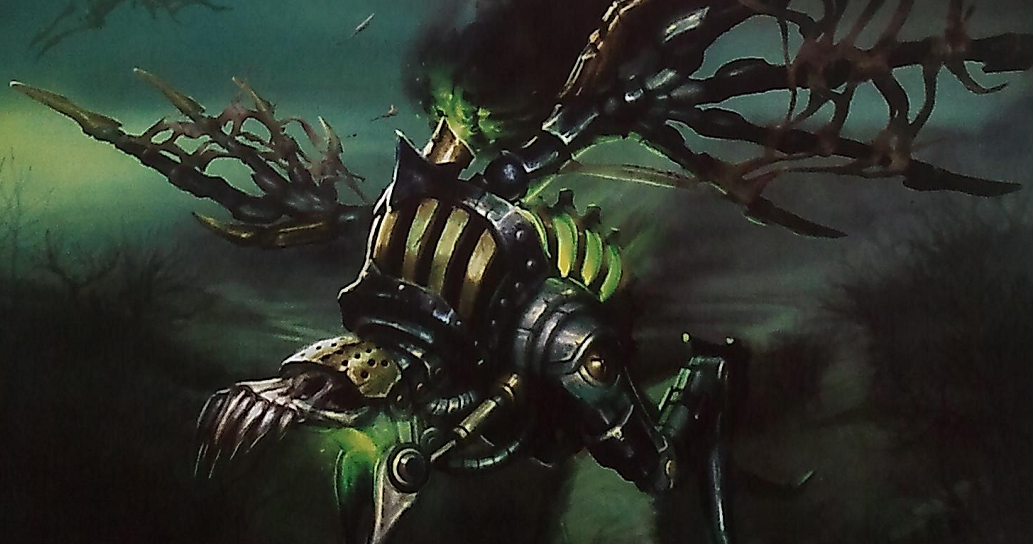
The Scavenger is just under 6 and a half feet tall and one and a half tons. It is a flying bonejack, imbued with a hunger for flesh and steel. They hunt for living victims, shredding their flesh and then taking to the air once more. They especially love attacking the wounded and dying. They aren't particularly heavily armed, but when they can just fly over the field to pick their targets, they don't really need to be.
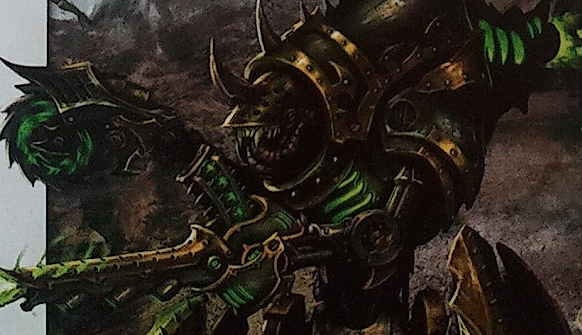
The Desecrator is almost 10 and a half feet tall and almost 7 and a half tons. It is an unnatural, terrible machine that draws on the darkness of the Void. It fires the Plague Bringer cannons, an alchemical weapon of terrible power, and wields a whirling vivisector. It rises from the waters, using its alien form to terrify soldiers while it fires flesh-eating chemicals. Its victims have been known to kill themselves rather than suffer its wasting acids, and those that survive tend to be chopped to bits by the vivisector.
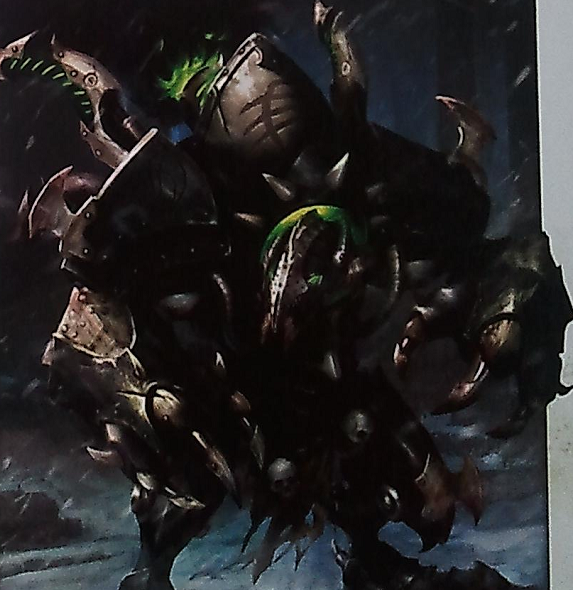
Erebus is nearly 12 feet tall and 6 and a half tons. It has a terrible bloodlust, even by Cryxian standards, and it knows only the desire to serve Scaverous. It moves across the field like a predator, killing all in its path and gathering their souls for its master's magic. Its cortex hums with savagery, and its black claws twitch even when it is idle. Scaverous built it himself, using all of his necromantic skill to shape the chassis and the soul extractors buried within. It bears the spiritual detritus of thousands, a spectral aura that envlops it and lashes out at those that strike it. No weapon can stop it from advancing.
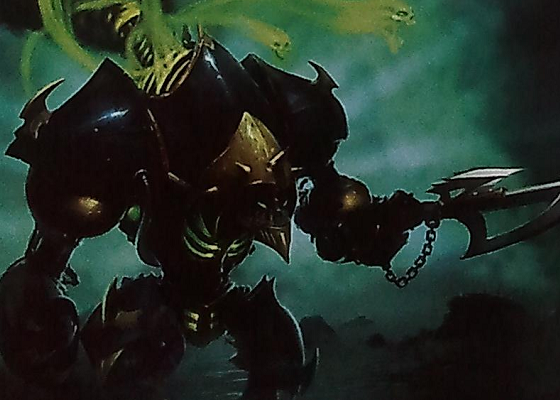
Malice is nearly 12 feet tall and almost 6 and a half tons. It is the product of centuries of experimentation, hosting a legion of vengeful ghosts of those it has slain. These trapped souls swarma across it, through its plates and mechanisms, shrieking constantly. Its cortex is full of their dark whispers, driving it to ever greater killing. It exists only to devour souls. Direct contact offers these spirits their only escape - they can pour out in a spiritual contagion, overwhelming and possessing the cortexes of the warjacks Malice touches. They temporarily seize control of these 'jacks, turning them on their allies before they finally escape into Urcaen.
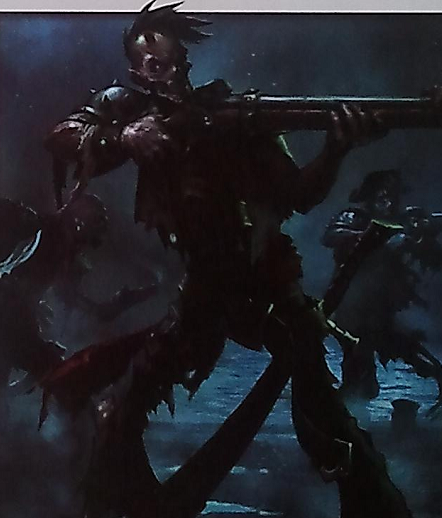
The Revenant Crew Riflemen are more modern sailors of the Atramentous, bearing the guns they died with or seized from their victims. Their curse keeps these wepaons from destruction. These riflemen are often found high in the rigging, shooting down foes from above, but they are no less skilled in boarding actions or shore raids. They join other groups of revenants, picking off enemy officers and scouts to keep them from reporting in. The support of just a few riflemen turns the undead pirates into nightmare foes, extending the range of the revenants well beyond that of their normal victims. When the time comes for a final assault, the riflemen join the revenant crews, cackling as they fire their ghostly shots into melee. Their luckier victims die instantly, while the wounded may be dragged back to their ships, to join or perish.
Next time: The roundest lich
Warmachine: Wrath
Original SA post Warmachine: Wrath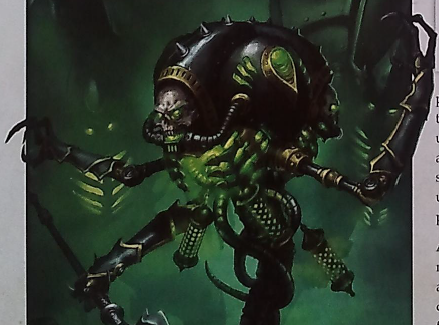
An Iron Lich Overseer exists to extend the will of the warcasters of Cryx. They slowly turn in battle to allow their three faces to survey the field, unleashing storms of magical fire and commanding helljacks. The first overseers were made after Drer Drakkerung was destroyed by the Orgoth war witches, when powerful but dying or dead necromancers had to be preserved. These are composite beings made with one body and a unified consciousness, ensuring cooperation, and eventually the various personalities merge into one mind. They are all insane, of course, but they have heightened awareness, cognitive power and magical ability. Following these experiments, the lich lords began using the process as a way of punishing effective but willful servants. At the core, an overseer is powered by a necromechanikal device known as a soul matrix, which allows a great affinity for warjacks. Due to the divided nature of an overseer's mind, this power requires a continuous influx of souls to function properly.
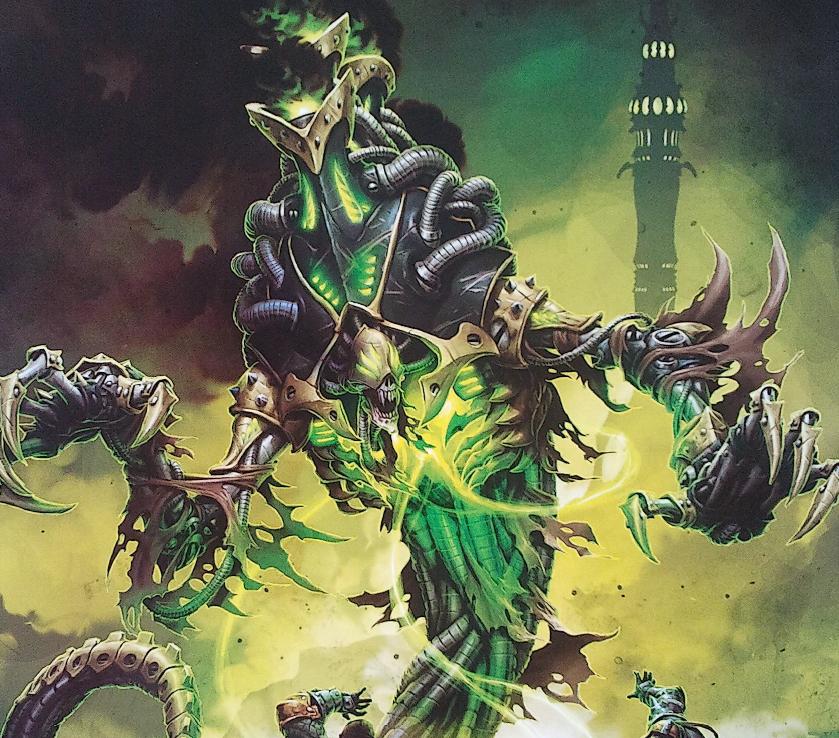
A Wraith Engine is an immense battle engine, guided by a devilish intelligence. They lurch across the field to grinding steel and the wailing of the dead caged in their frames. They are not tethered to material form, able to slip between corporeal and incorproeal states easily, even teleporting across great distances. Those who do not flee it die quickly, feeding its engines. Each part of it is inhabited by tortured souls, eternally trapped. The Void echoes through it, strengthening the undead that follow it, and its very presence saps strength from all material things. It is the result of centuries of necromantic research, led by Lich Lord Tenebrous. Hundreds of victims are ritually sacrificed to create each one, their spirits bound into the machine's components. These are etched with binding runes, forcing the spirits in a collective machine intellect loyal to Cryx, which seeks only to murder the living and feast on souls. It oscillates between the material world and the Void once turned on, manifesting shadowy tendrils and drinking in light. Its mere presence wounds the world, manifesting Void energies and weakening those nearby. It must be kept chained until battle, for its hunger cannot be sated.
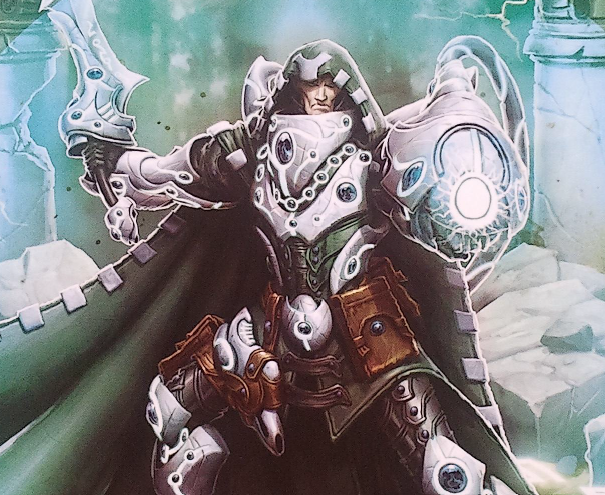
Lord Arcanist Ossyan of House Vyre twists reality itself. His arcane skill is unnerving and intimidating, bending time itself to his whim, and he can sense the convergences of fate. He is a deadly mage and general, and his soldiers and myrmidons move as though guided by destiny. Ossyan is one of the big reasons House Vyre supports the Retribution, and while he answers to Consul Alyssa Vyre, he is a ranking member of the Vyre bloodline. He leads Vyre's magical arm and is directly responsible for many arcanikal innovations. His reputation and power let him convince the consul to support the Retribution in order to compete with House Shyeel. Vyre is one of the few Houses able to produce myrmidons, but its association with Ghyrrshyld tainted its reputation. Ossyan used political arguments to convince the consul that this would help, but his reasons are far more personal. He feels responsible for Ghyrrshyld, having been a young arcanist during the War of the Houses, while he did not commit the worst excesses, he worked in the facilities where they happened. Ossyan had grave doubts about his leader's activities, but stood silent and did nothing to stop him. It was in the post-Ghyrrshyld purge that he rose to prominence, but he was wracked with guilt over doing nothing. He has grown his powers considerably over the years, developing unique theories on the flow of time and the way history is shaped by decisions. To him, time is just another kind of energy, and he believed that sufficiently strong personalities could manipulate its flow, even unknowingly, and that this was so-called destiny. He learned to see the world in terms of probabilities shaped by great individuals, for good or evil. He knew his house could rise above its reputation if it was able to rectify history, and it was this that led him to the Retribution. He agrees with Ghyrrshyld's views on one point: war with humantiy is inevitable. To survive, Ios must arm itself and reclaim its destiny by force.
Ossyan has sought to learn all he can about humans, his most likely foe. He has realized he can't view them all as identical and must learn their individual strengths and weaknesses by culture and nation. He studies them so he can predict them, which requires a deep understanding - not just troop strengths and numbers, but understanding the root events of human history. A predictable foe is more easily defeated, as the flaws of their patterns can be exploited. Ossyan was not surprised that the discovery of Nyssor caused a surge of interest in the Retribution, and it became clear to him that House Vyre must commit to them as well, or they would fade to obscurity. He has personally delivered great weapons to the Retribution, including new myrmidons and the arcantrik force generator. In return, all he asks is a chance for House Vyre to prove its worth. Others see it as a purely political move, but Ossyan is truly committed to the cause, intending to ensure that no single leader can put their own interests above those of Ios ever again. He is skeptical of Dawnlord Vyros and Adeptis Rahn, distrusting their motives and standing ready to counter them if they put their houses above the cause. He has volunteered to lead the Vyre strike forces himself, risking his own life to earn his redemption and expunge himself of the guilt that plagues him. He wants nothing more than to prove himself worthy before the Iosan people. His gimmick is time shenanigans, primarily in the form of being able to buff things after rolling or just normal buffs. His feat reduces enemy ranged damage and improves allied ranged damage.
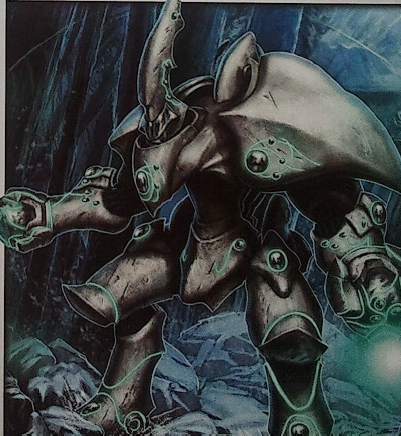
The Aspis is just over 9 feet tall and weighs almost 2 and a half tons. It has complex arcanikal devices in each hand, allowing it to manipulate its force field, strengthening it against incoming fire with Shyeel combat techniques. It has a great reaction time due to a specially conditioned cortex, intercepting enemy fire against allies and catching bullets with its shield. It can also focus its field into a projection of force to attack foes, smashing even large foes away from those it guards. It is very versatile and useful to the Retribution, and it is the first light warjack efficient enough to replicate the Phoenix Field, giving it great resilience.
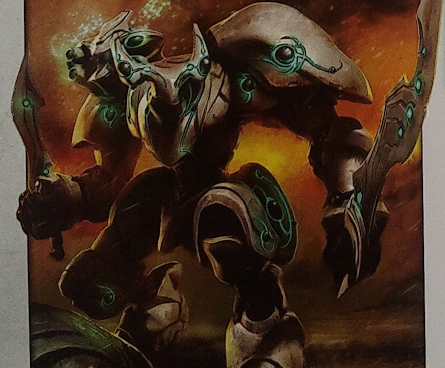
The Banshee is almost 13 feet tall and 6 and a half tons. It continuously emits a high wail in battle, a sonic field so strong it disrupts magic nearby. Its force cannon can turn this hum into an ear-splitting blast, firing an immense wave of sound at foes. It then wades into battle with dual void blades, fighting like an expert fencer. The weapons use distorted energy, slicing not just the skin and steel of the foe but their souls as well, creating wounds so terrible that magic can't heal them.
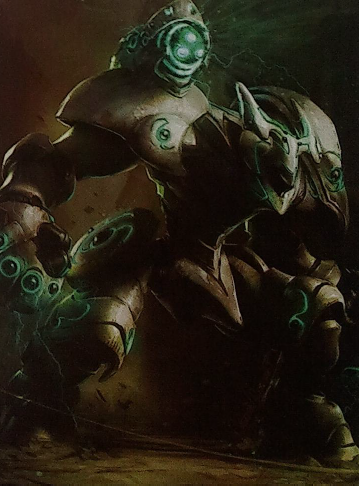
The Daemon stands almost 13 feet tall and weighs nearly 10 tons. It is the epitome of Vyre design, focused on using its energy stores to power weapons over defensive fields. Its vortex cannon bends and swallows light as well as destroying foes, creating a field of distorted energy to hurl into the enemy. The released energy mimics gravity, creating an inconsistency in what Vyre artificiers name the 'anchor of Caen.' Those few survivors describe it as a terrible feeling of space itself being pulled out of place, distorting their very being. Its fists are no less deadly, but it is a more merciful death. Each fist has a device that channels energy to disrupt magic, as well as being potent weapons.
Next time: People whined enough that they published a bunch of no-field Myrmidons.
Warmachine: Wrath
Original SA post Warmachine: Wrath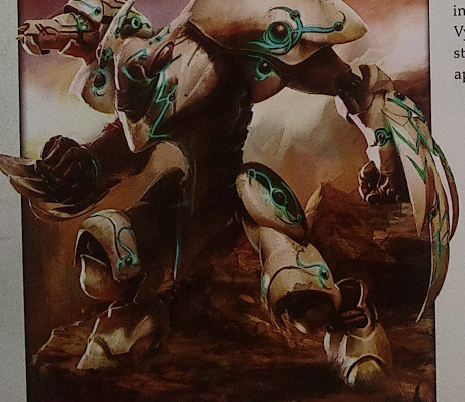
The Sphinx is nearly 13 feet tall and almost 7 tons. It is designed to augment arcanists in battle, using the mechanisms in its asymmetrical shoulder casings to power its runespear cannon and force claws. It is not entirely comfortable, as it is a reminder of the Iosan civil war, but it is a very useful machine. The runespear cannon makes enemies vulnerable to magic-based attacks, and so it is often deployed alongside battle mages. The force claws have no special property besides intense lethality, though one is larger than the other.
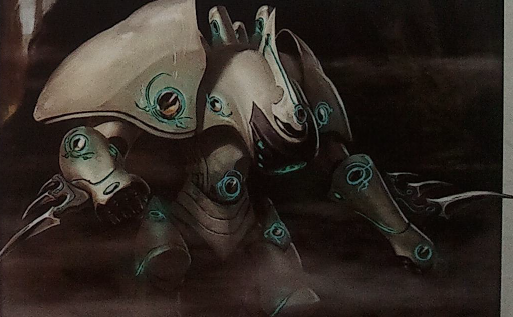
Discordia stands nearly 13 feet tall and almost 7 tons. It is Adeptis Rahn's custom myrmidon, designed to be a protector even in the worst of battle. It stays near its warcaster, using its immense, overloaded force field to immunize itself to most projectiles until it becomes time to respond with force. It then retaliates, vibrating its field in a syncopated pattern that causes the air itself to distort in a blast of sonic pressure, focused via arcanikal amplifiers. It is so powerful that it literally shakes matter apart in a rending shriek, disintegrating it. Rahn has ensured that Discordia benefits from even the most recent improvements in arcanik field technology, and Discordia must be adjusted and realigned after every fight - a task Rahn always takes care of personally. The technologies it uses are not ready for wider deployment, as Rahn uses it as a testbed for developments.
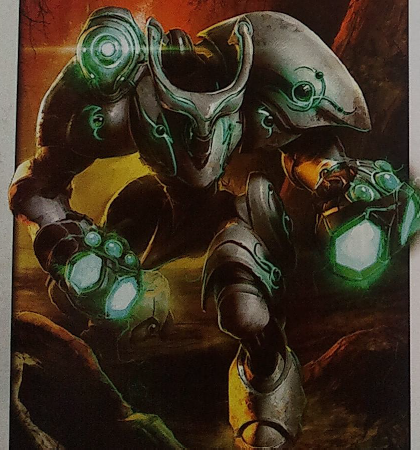
Hypnos is almost 13 feet tall and 6 and a half tons. It was personally designed by Ossyan after years of studying myrmidon cortexes. He modified Hypnos for more individual behavior, and it is more inclined to act on its own than other myrmidons, sometimes patrolling of its own will to find threats to Ossyan. Between battles, it seems to stare at and observe other myrmidons, analyzing them. Ossyan has forged an unbreakable connection to Hypnos, allowing it to draw on his energy and serve as an extension of his will. This goes even beyond its arc node, as Ossyan can use hidden relays to trigger its synergistic nature. In his presence, its phase gun renders its targets unable to channel mystic energies, breaking arc nodes and the warbeast link. Supplemented by the phase gun, Hypnos also uses its disruptive fields to deliver rending force via projectiles. Each of its fists has a force projector built to interfere with 'jack cortexes, staggering them even with glancing blows by overloading their signals.
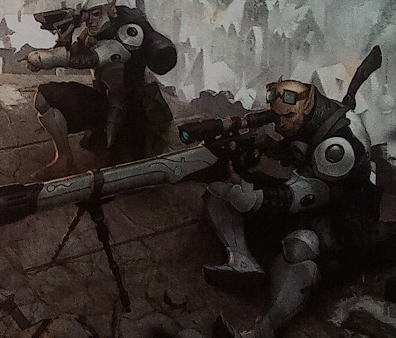
A Heavy Rifle Team is a two-elf team, one a spotter and the other firing the immense rifle. Its rounds can tear through warjack armor easily, and the spotter reloads, keeping attacks quick. They are drawn from the ranks of the houseguard riflemen, generally veterans with excellent aim. Their main job is to be heavy but mobile support for the houseguard, but recently they've also been sent to help the mage hunters, too. They cripple heavy armor as the hunters home in on warcasters, together neutralizing the threat quickly. Their concentrated fire is even more dangerous against targets already hit by previous rounds. The gun is a marvel of Iosan ballistics and arcanika, using a nonexplosive shot made of tempered steel, piercing armor rather than blowing it up. The rounds are fired at immense speed thanks to an integral force generator, going much faster than normal rifles.
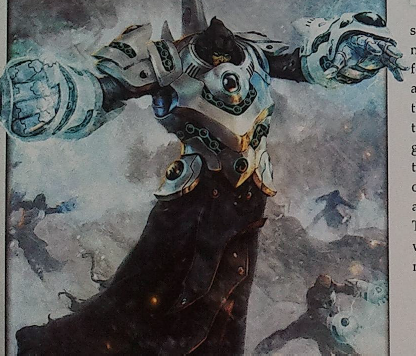
A House Shyeel Artificer is one of the Shyeel myrmidon-makers, but their best go beyond just craftwork to even greater mysteries. They unlock the power of attraction and repulsion, wielding these delicate forces on the battlefield. They have gone to the front as the war gets hotter, building new construction sites for myrmidons and testing their mastery in battle. They surround themselves with forcefields, hovering over the field to shield allies and tear foes apart with their magic. those that fight them are slowed, their weapons and armor stuck fast to their bodies. The artificers tend to find the destruction they cause amusing and interesting to study.
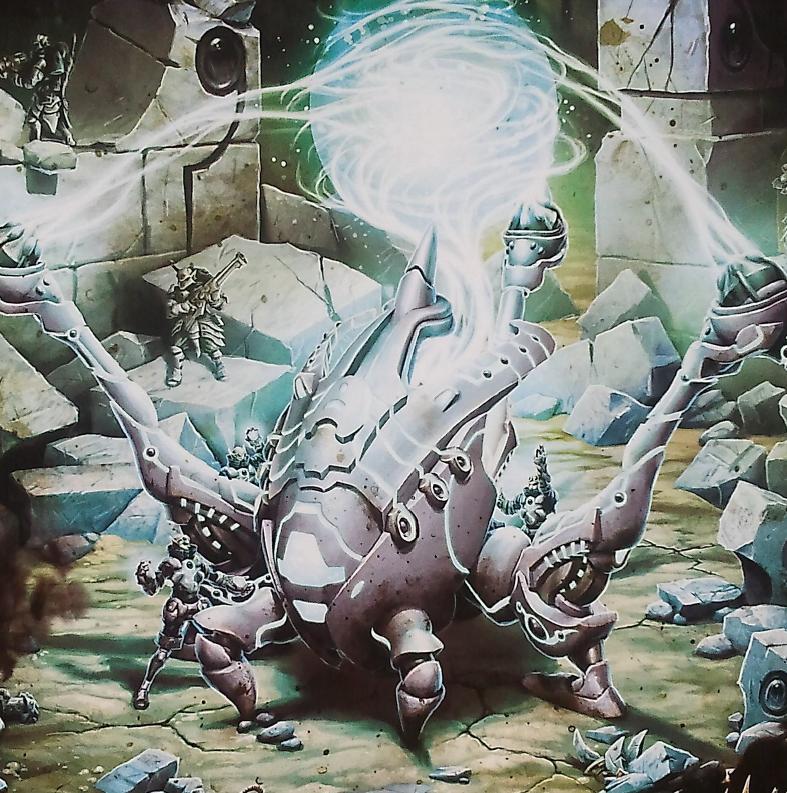
The Arcantrik Force Generator is an immense battle engine, squatting among the Iosan forces like a giant insect. Its fields encompass its operators, who work endlessly to calibrate and tune it. When the field reaches the required frequencies, the metal disk at the core spins up, crackling with power. Rubble and small objects lift into the air as the firing sequence begins, and the air grows thick. The machine causes a gut-churning sensation nearby, then discharges its energy in either quick pulses or one blast to tear through warjacks or fortifications easily. For the most dangerous foes, it can be brought to the point of near overload to fire an earth-sundering attack. When House Vyre joined the Retribution, it was this arcanikal mastery that was their greatest contribution, and the generator was key to proving their value. It demonstrates their cunning use of field generation technology, originally a Shyeel innovation meant for lifting myrmidon parts. The Vyre arcanists used their lore to create discordances, turning the field towards destructive ends. Ossyan unveiled the machine to the Retribution leaders, explaining its uses and how it could be modulated for various roles. He also showed that it could travel under its own power, albeit slowly, by using its fields to defy gravity and hover inches above the ground. He also showed how the devices could be quickly disassembled for deployment and rebuilt in the field. The weapon has had a profound impact on Retribution tactics and the humans that face them. Humans are often terrified by the alien machine as it tears the earth itself to bits.
Next time: Mercenaries.
Warmachine: Wrath
Original SA post Warmachine: Wrath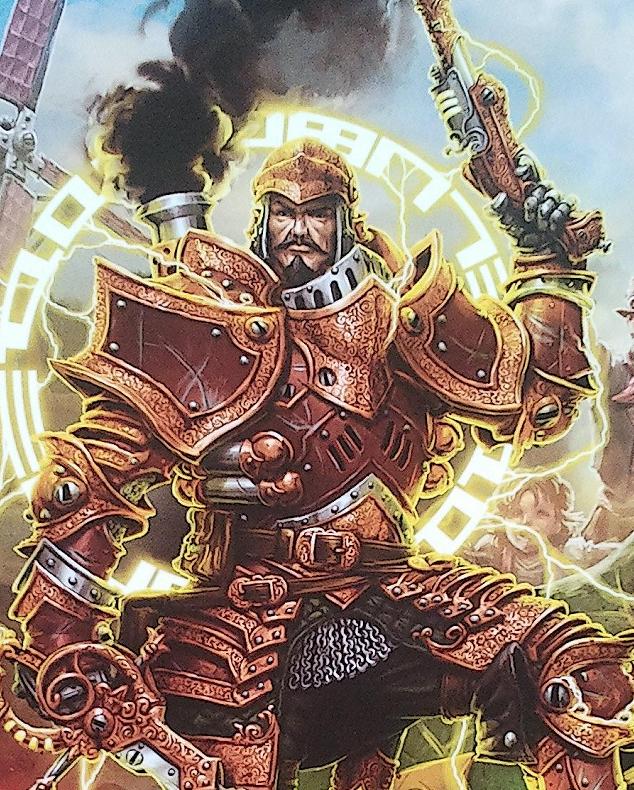
Captain Damiano , first name Amador, is a Steelhead mercenary who lives not for coin but for glory, fame, honor and legend. He'll work for Cryx, Cygnar, Khador or the Protectorate of Menoth. He will take modest wages but a daring contact over a fortune for easy guard duty. He loves the satisfaction of battle and overcoming danger, living for the moment when he can turn defeat into bold victory. Some see him as overconfident or extravagant, but his men adore him. He constantly weighs their needs against his thirst for glory, and he tries to find the balance needed to inspire and pay them as well as impressing them with his boldness. He enjoys risk, but he does not spend lives idly, believing that it his duty to see his men rise to greatness, too. His reputation attracts the more daring Steelheads, and many of his officers are just as eager tor fame as he. They expect to be paid well, of course, but will embrace daring plans and hard jobs. They also take satisfaction from being some of the most accomplished Steelheads. Each of his liteunants has their own style, but their loyalty to their Ordic leader unites them. His men understand the value of his leadership, thriving on competition to impress Damiano with their cleverness and courage. He is choosy about his contracts, tempering his drive for greatness by occasionally taking prudent jobs to maintain morale. Those who pay his rates get a conqueror for hire with a retinue of warjacks and a small army. He leads his men with humor and skill, exhorting them to live in the moment.
Damiano's unusual attitude may come from being born to mercenary life, rather than taking it up for necessity. For generations, the Damiano family have been aristocrats of war, a mercenary dynasty tracing their rise to the years after the Corvis Treaties, where they served as hired intermediaries for disputes. Their wealth has waxed and waned, but they've always kept their ancestral Ordic estate. More recently, wars have filled their coffers, but the Damianos do not live in luxury - they earn wealth on the field. Damiano was raised on mercenary legends and always wanted to meet or exceed them. The sorcerous spark is strong in the family, but especially so in the last few generations. Amador Damiano is the third heir in a row to be a warcaster, trained extensively in 'jack handling, dueling, magic and tactics. He believes nothing can stand in his way. The family once ran their own mercenary company, but Damiano's grandfather sold it to the Steelheads, who have since maintained an agreement with the family to provide chapter-of-choice consideration and accelerated advancement. Amador began as a lieutenant in Berck but was soon made Captain in Merin, proving his worth as well as earning a reputation for boasting. While his fame began in Merin, he can get into just about any Steelhead bran ch he wants. His work has crossed all of western Immoren for nearly every major power, working all sides in the War in Llael. He is no tyrant to his men, allowing them to do as they please so long as they don't draw legal ire or shame the Steelheads, encouraging them to use their unique freedom to do as they like. He enjoys luxury and can be indolent, wearing extremely ornate armor and savoring quality food, wine nad women. He has been known to provoke nobles into games of wits and be randomly generous to those hurt by war. He is a mercurial, larger than life personality, but once he agrees to a contract, he fulfills it to the letter. His men are disciplined as any army, and he leads from the front, inspiring them with his skill and his ancestral weapons, Judgment and Glory. His gimmick is troop buffs and his feat buffs strength and armor.
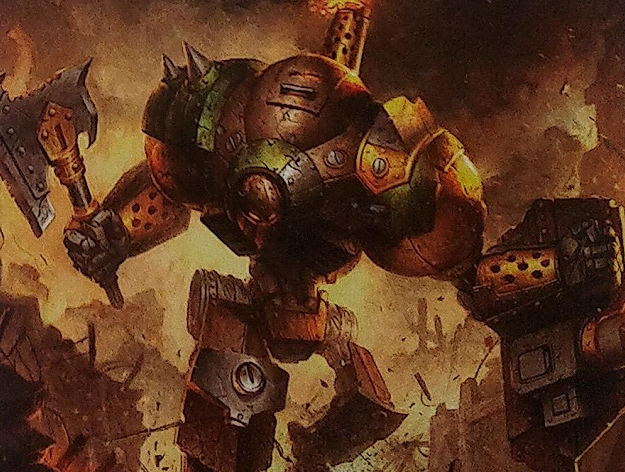
The Rover is over 12 feet tall and over 8 tons. It is built on a chassis design a century and a half old, combining brute strength and durability to make it a favorite of mercenaries. Its immense shield gives it great protection, and its powerful short-range cannon makes it ideal to hold flanks or lead assaults. When they engage the foe, their shield blocks most blows and the cannon tears foes apart. Those that survive are shredded by the heavy axe. They are one of the first warjack designs specifically meant for mercenary use. 30 years after the Nomad was adopted by Cygnar, Engines East used a contract loophole to develop the Rover by modifying the Nomad design just enough to be considered new. They sold the result directly to mercenaries, earning a lot of money, if also the annoyance of Cygnar. The Rover is a common sight in battle, as its parts are readily available.
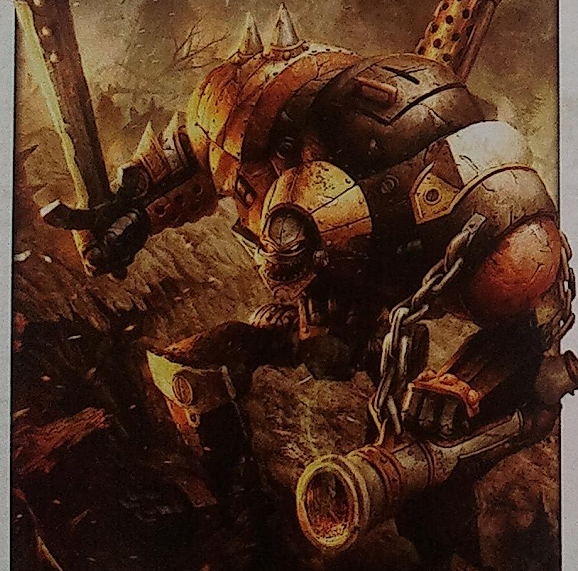
Rocinante is just over 12 feet tall and almost 8 and a half tons. It was originally a Nomad, and it's served the Damianos for over a century, first bought by Captain Lucian Damiano, who started the family tradition. It eventually passed to Cervantes, first warcaster of the line, who modified it to its present form. His career brought fame to the family before Rocinante eventually passed on to Amador Damiano. On completing his training, he refueled Rocinante and started it up, bringing it to life for the first time in a decade, but it acted as if it had served him for years. Its cortex blurs generations together, and each master is seen as a continuation of the last. Rocinante has been painstakingly maintained, its armor gleaming with scrollwork bearing family mottos - "Blood shines gold," "Sworn word, sworn deed' and "No strike left unpaid." The cannon comes from the days of Cervantes, wh ocommissioned its creation. In battle, the 'jack can chop down one foe to clear a firing line for its immense cannon to shoot the next. Those that get too close are killed by its immense battle blade, as it places itself between friend and foe.
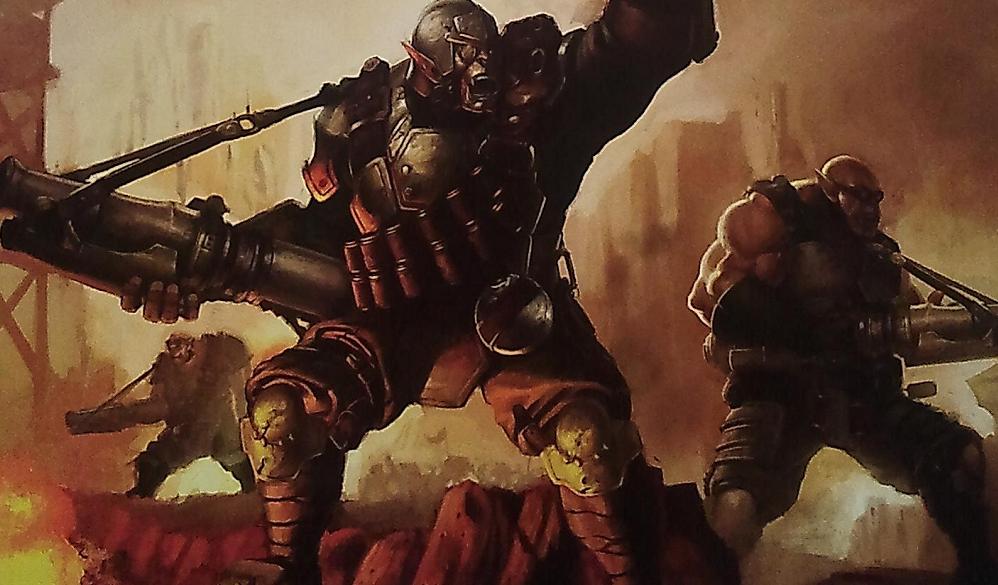
An Ogrun Assault Corps will work for Cygnar or the Protectorate of Menoth. They come from the soutner Rhulic fortresses, and they're one of the most demanded mercenary units in Immoren, armed with immense battle cannons able to lay waste to enemy positions like mobile artillery. They are skilled in using the guns in concert to unleash terrifying explosions on the foe, then hurling themselves into the enemy with brutal enthusiasm. Rhulic ogrun live tied to the clans, often viewing the clan lords as korune. Because of this, many ogrun move into the border forts, training with the Rhulfolk. Ogrun cross all of Rhul to enlist in the Assault Corps, which has made a name for itself at Horgenhold as the best all-ogrun fighting force, and it's since expanded, learning to fight smoothly alongside the Forge Guard and Hammerfall Gun corps. They saw the value in selling their services, to hone their skills and earn coin for their families, earning a name as the best soldiers money can buy.
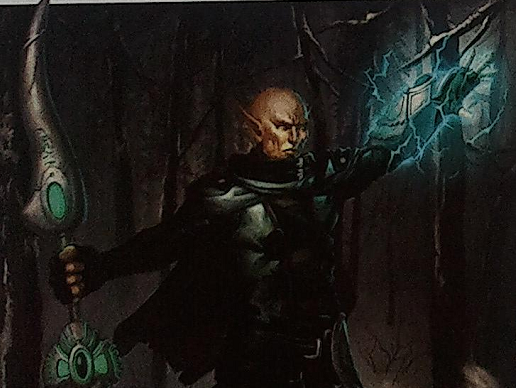
Sylys Wysnalyrr, the Seeker will work for Cygnar or Khador, and can be taken as a full member of the Retribution of Scyrah. Not all Iosans follow the Retribution, and Sylys is a Seeker, trying to find the secret of reviving the gods. He is a scholar and mage, selling his talents to human armies in exchange for library access and safe passage. He is extremely skilled at supporting warcasters, so he often does receive this. For years, he avoided politics in Ios, shunning the Fane of Scyrah, the Halltyr and the Retribution equally. Over time, however, he grew to know the cruelty of war, causing him to question his belief in peaceful solutions. Recent events have stirred new allies to the Retribution, and he has begun to reconsider his sharp divide between sects, consenting to aid certain Retribution agents with information. He retains his original goal, now, but also listens for intelligence to pass on to his contacts.
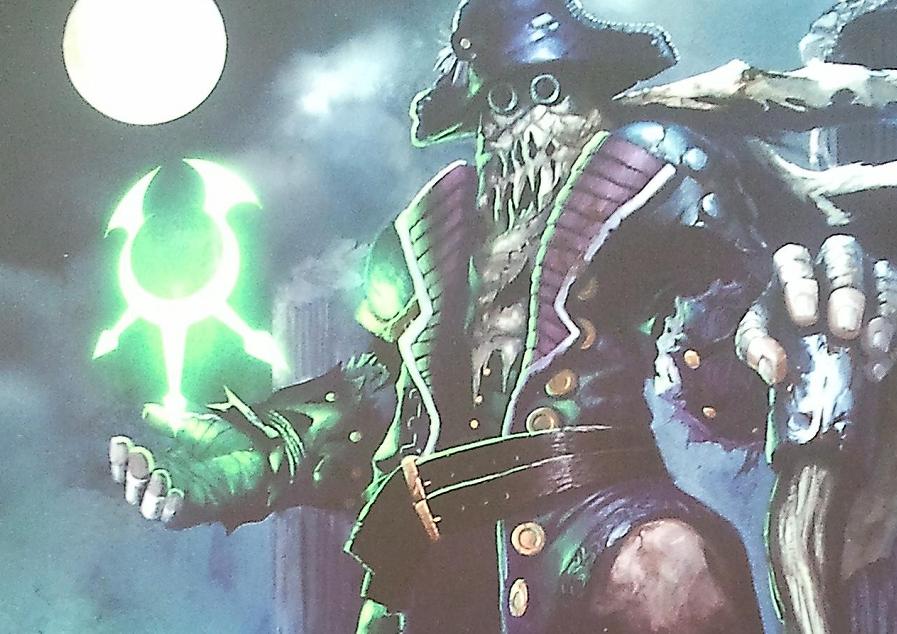
Ragman will work for Cryx, Cygnar or Khador, but due to being a Thamarite, he won't work with any army containing a Morrowan. The Ragman is a creature of legend, seen on recent battlefields studying death. He can spend weeks haunting ruins after armies leave, selling his services to generals only for the chance to walk among the dead. He hides the truth of his noble birth behind his tattered mask. He was Lord Mylo di Northryne, a Thamarite sorcerer and follower of Scion Delesle, patron of death and necromancy. Once, he haded a Llaelese cult, limiting his activities to his family lands and working in secret. Since the Khadoran occupation, however, he has taken the chance to expand his research. He viewed the dissolution of his nation as a new possibility, taking on the guise of a wandering refugee to head to the ruins of Riversmet. There, the corpses spoke to him, telling him their unique stories by the contortion of their faces and limbs. He spent months in the ruins, moving betwen collapsed houses and mass graves. When the Khadorans began their reconstruction of Llael, his morbid curiosity was not sated. He followed the war, becoming a common sight at mercenary camps. He is always polite, offering his dark powers to desperate commanders, asking only that in return, he be allowed to survey the field afterwards. Few turned him down. The Ragman has chosen a solitary parth of darkness, knowing that each bit of knowledge he gains from studying the dead brings him closer to his true path than any teaching from necromancers could. The dead move at his whim, rising from where they fall to serve.
The End!
Next up, Hordes: Domination.
Hordes: Domination
Original SA post Hordes: Domination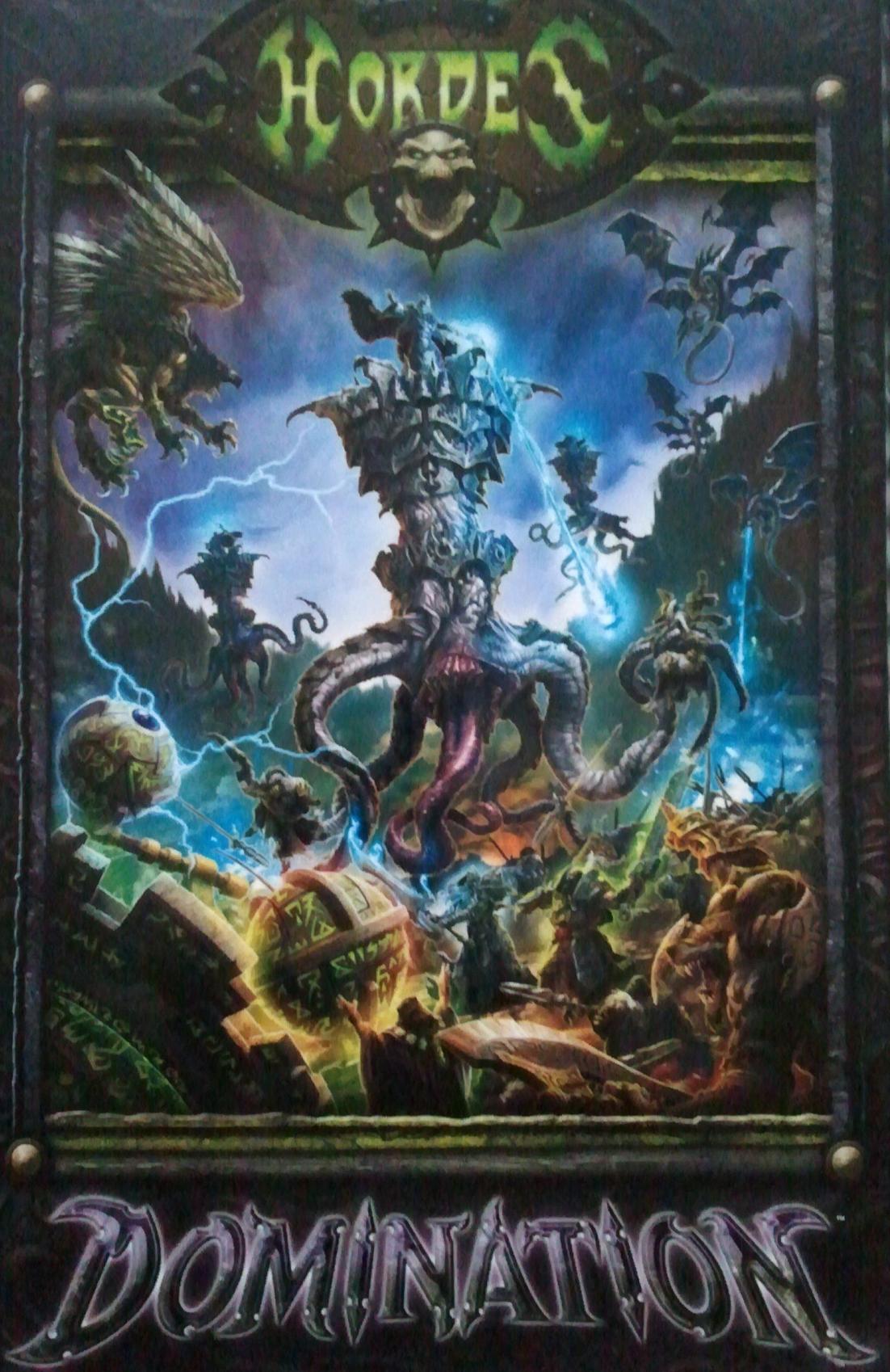
Like Wrath, Domination introduces Battle Engines for Hordes. However, unlike Wrath, there are no Ranking Officers in Hordes. Instead, they get more warlocks.
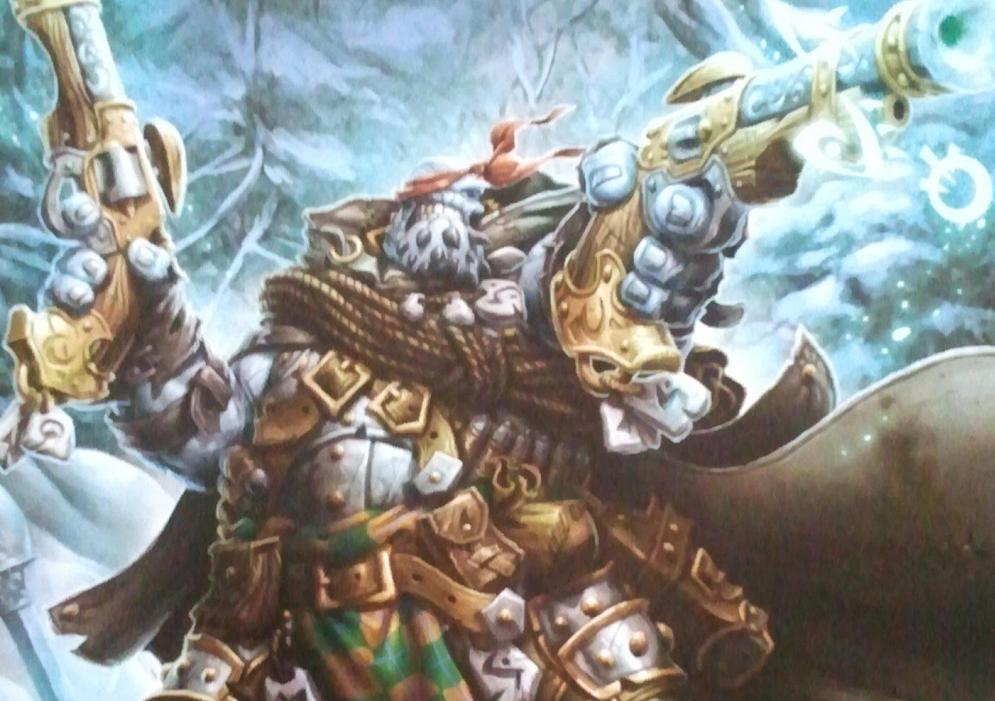
Jarl Skuld, Devil of the Thornwood was never part of the kriels, born and raised among outcasts. He has always been as willing to raid trollkin villages as human caravans, though he considered violence a last resort and preferred lightning raids to shock people into inaction. His trollkin and trolls would strike from concealment, grab the shit they wanted and only fight those that refused to surrender before vanishing into the fog that followed them. After a raid went wrong and resulted in deaths on both sides, however, the Thornwood kriels declared Jarl a full outlaw, forcing him to learn beter skills at planning, shooting and controlling trolls. The elders cursed his name, but he became a folk hero for the younger trollkin, who would even leave their kriels to join his band. The Thornwood was thrown into chaos when Cryx invaded and the Khadorans fought the Cygnarans. After Ironhide led the kriels out, those that remained suffered. Jarl would not abandon his home, and he felt a connection to these holdouts. And so, reluctantly, he has been risking his neck against his instincts to help these trollkin. He still weighs every decision, all too aware of the fact that he lost an eye against Cryx near Thornfall. He has begun to realize that he is not truly so separate from the united kriels, and he's begun to trade with them for favors and protection. His gimmick is speed and movement, and his feat lets him drop fog clouds all over the battlefield which his own units can basically ignore.
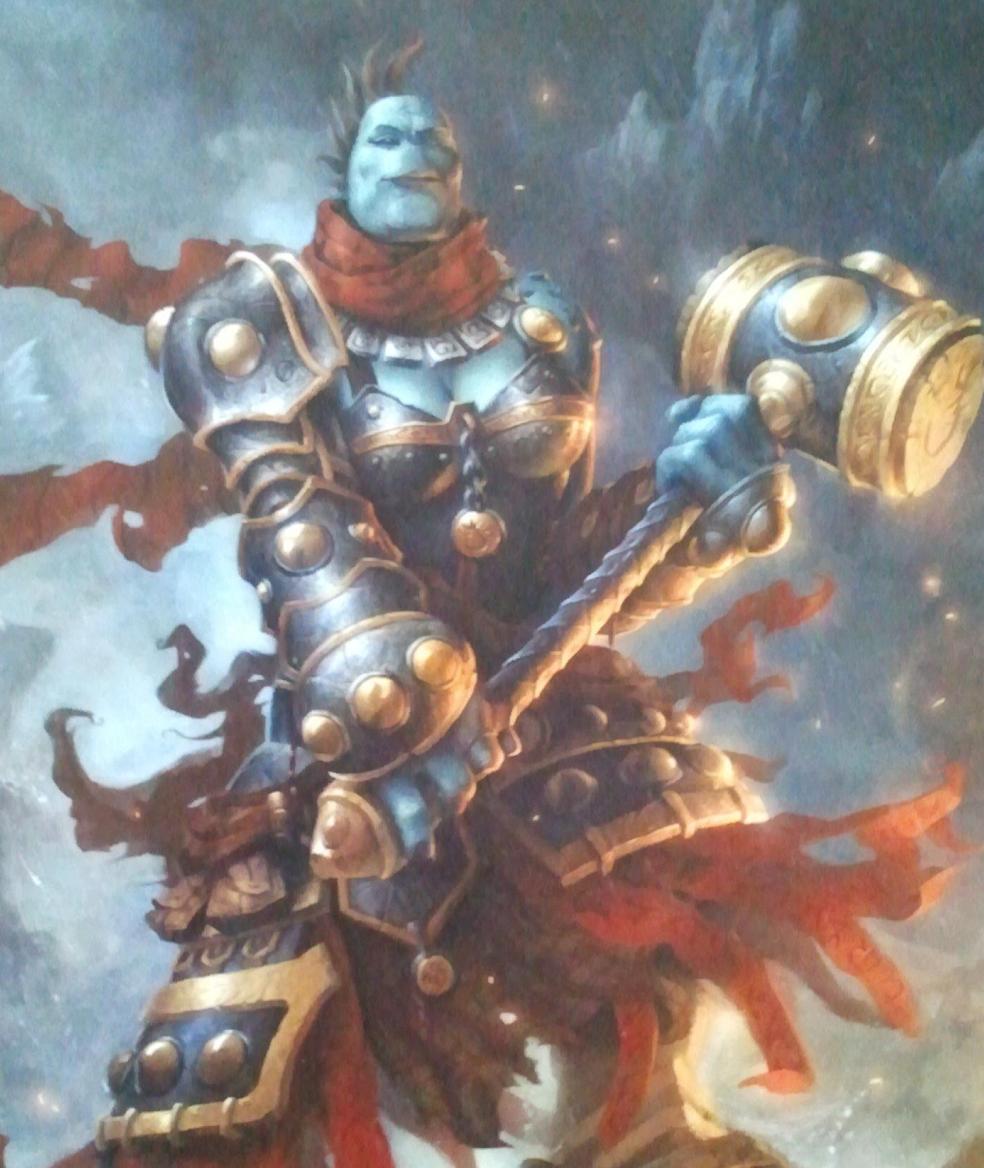
Grissel Bloodsong, Marshal of the Kriels is Epic Grissel. She is a bastion in the chaos of the trollkin, and both the warriors and elders look to her as a voice of reason, trsuting her to save their people with words and power. She still respects Madrak Ironhide, but feels abandoned. She saw how Rathrok's curse was weighing on him when he left the kriels with Hoarluk Doomshaper and Borka Kegslayer, but she feels their absence keenly. She never wanted to be a leader, but she's proven worthy of the job. She knows survival is hard and that no land is as important as trollkin lives. This was was not their choice, and she will gladly fight for them, asking nothing she won't risk herself. With her willingness to embrace any weapon, the trollkin see her as a bridge between the old ways and the new. She is pragmatic, making short-term alliances with outsiders and mercenaries as needed, using all of her wits to keep the trollking united. With every day she proves Madrak's faith in her was right, and she will not rest while her people are endangered. Her gimmick is blasting and troop inspiration, and her feat buffs her troops, both aggressively and defensively.
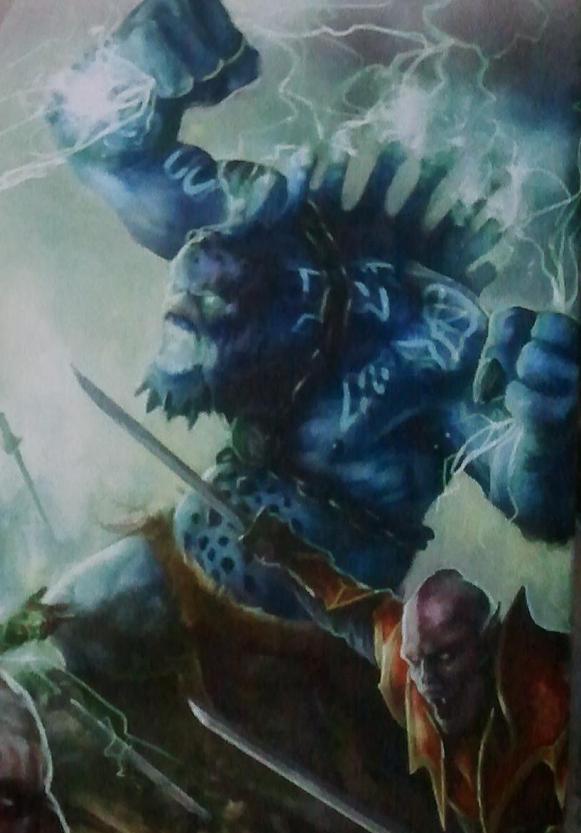
Storm Trolls do not blend with their environments like most trolls. They blaze with galvanic power, intimidating creatures even larger than they are. Lightning erupts from their natural conductors along the spine, playing over their sides before bolting from the trolls' mouths at anything that angers them. Warjacks stall under their fists, their cortexes disrupted. The storm trolls have been welcomed by the kriels since the skorne forced them out of the Stormlands. Their animus allows them to give others some of their lightning immunity and lightning fists.
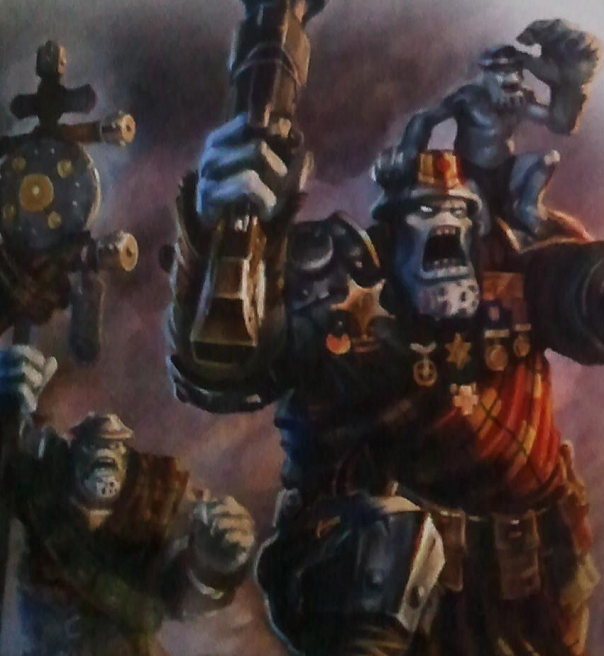
A Scattergunner Officer and Standard sometimes lead the scattergunners. They are as brave and stalwart as any kithkar, but they use miltiary discipline unheard of among trollkin even a few years ago. Their veteran forces follow them into battle, storming trenches and fortifications with carefully orchestrated brutality. These sergeants use a mix of bellowed orders and hand gestures to communicate, unleashing massive hails of fire before closing to fight with their gun blades. They customarily recover medals and accolades from their foes as trophies, and few sights are quite so unnerving to Khadoran officers as trollkin scattergunners wearing sabers of service and anvils of conquest. They are highly trained and extremely succesful for the trollkin forces in modernizing their troops, shrugging off friendly fire in order to better spray the foe with bullets.
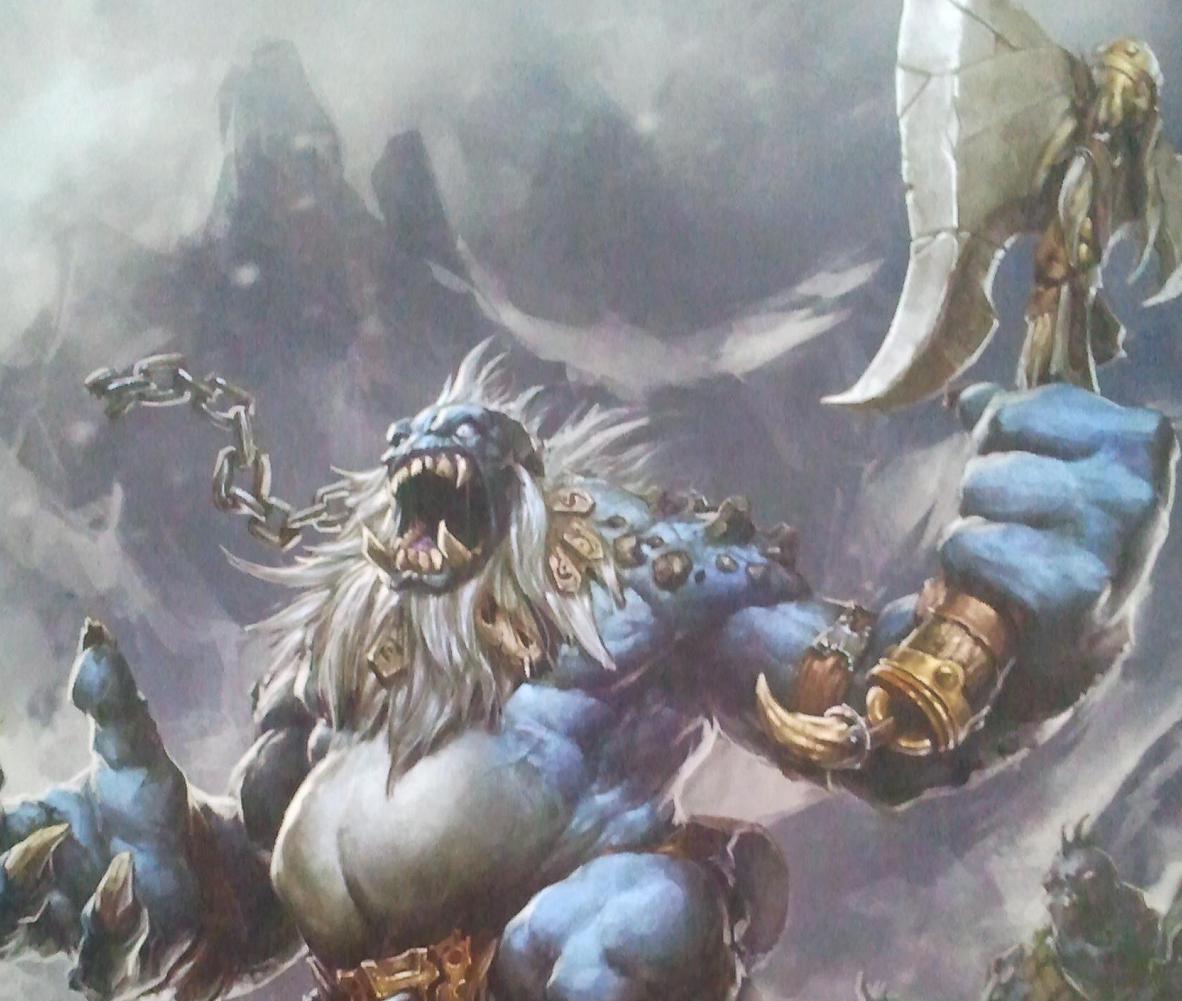
Rok is over a century old, a legend of the northern mountains. Like all dire trolls, he was motivated by his endless hunger, and with each creature he ate, his rage and his size both grew. He hunted more and more dangerous prey, moving from ulk to satyrs and even to other dire trolls. Typically, he ignored humans as a poor meal, but he'd eat them to take the edge of a particularly ravenous hunger. He was in such a state the day he found a caravan transporting beer through northern Khador. In his hunger, he didn't stop at eating the guards, merchants and horses - he went on to drink all the beer, too. He felt sated in a way he never had before, stronger and ready to fight. He rampaged across the mountain, seeking villages where he could find more kegs of alcohol. He terrorized the mfor days before finally falling into a slumber. Over the years, his thirst grew as great as his hunger, and his raids for liquor became legendary among both the Khadorans and the trollkin kriels of the north. When Borka Kegslayer learned to control the dire trolls from Doomshaper, Rok was the first he sought out. The two fought for hours, and at last, both slumped to the ground. Borka drank deeply, and then he gave Rok his own keg, and a second. The huge troll eventually followed him down the mountain, knowing that greater fights and greater beer waited with Kegslayer's forces.
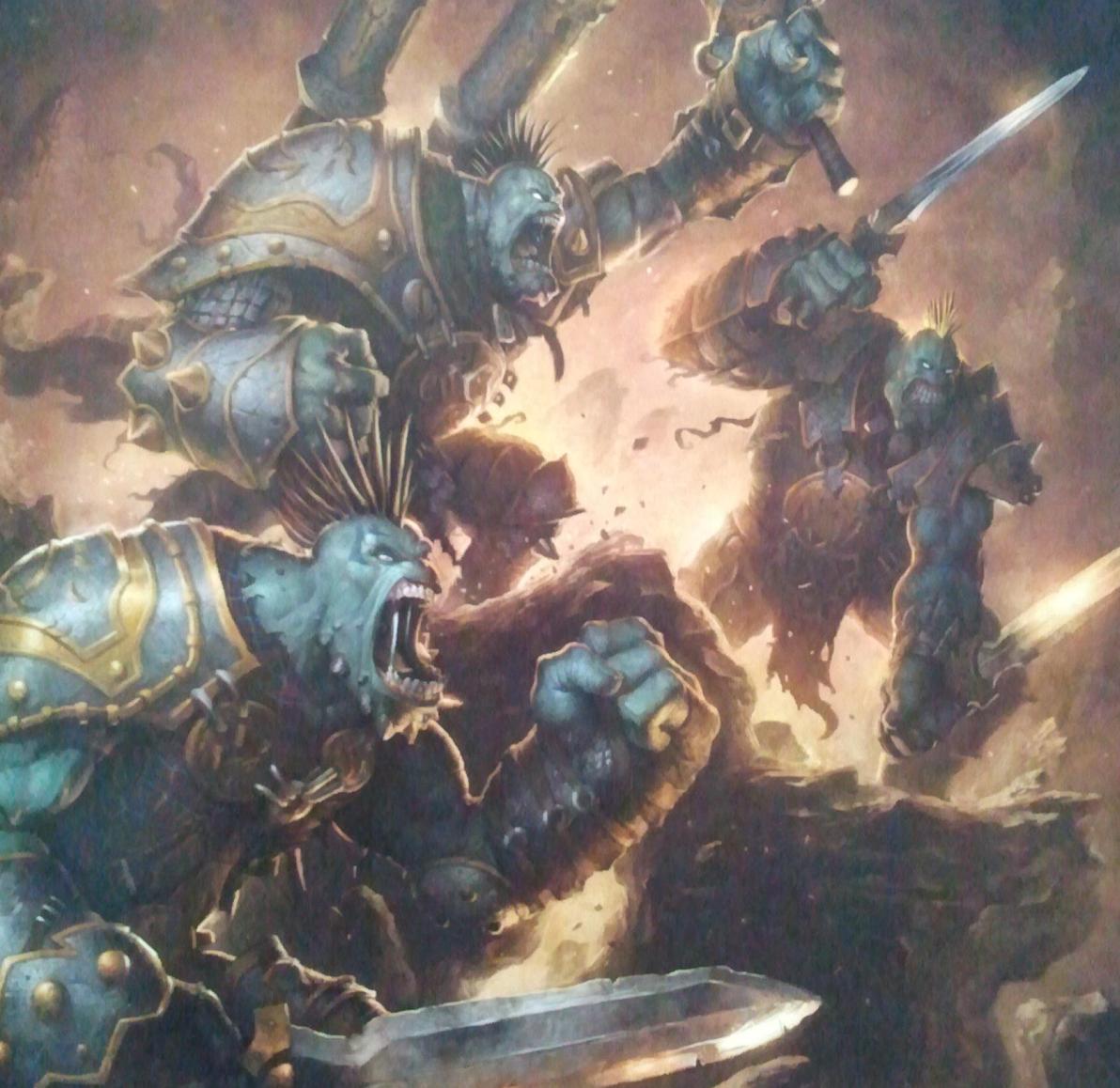
The Sons of Bragg are a trio of legendary fell callers, each as skilled with a blade as their voice. Though all fell callers claim kinship by the blood of Bragg, these three are true kith, born in different kriels to different mothers but all of the same father, a fell claler whose deeds grow with each telling of his legend. Destiny brought them together to face Cryx in the Thornwood, joining Jarl Skuld after Madrak and his followers left. Wrathor is the eldest, a brash warrior with an immense greatsword that he wields like a toy. As he fights, he rallies his brothers, Tor and Rhudd, whose voices harmonize with his to belt out chants that sustain them through any wound. Tor has the sharpest and most explosive voice, able to shatter stone and wood with a shout. After battle, he is also the best storyteller, with the ifnest memory. Rhudd is the youngest but the best fencer of the lot, even while drunk and blindfolded. His baritone voice taunts foes into recklessness so that he can chop them down with his dual blades. Each is formidable, but together, they are unstoppable.
Next time: Monsters of the woods
Hordes: Domination
Original SA post Hordes: Domination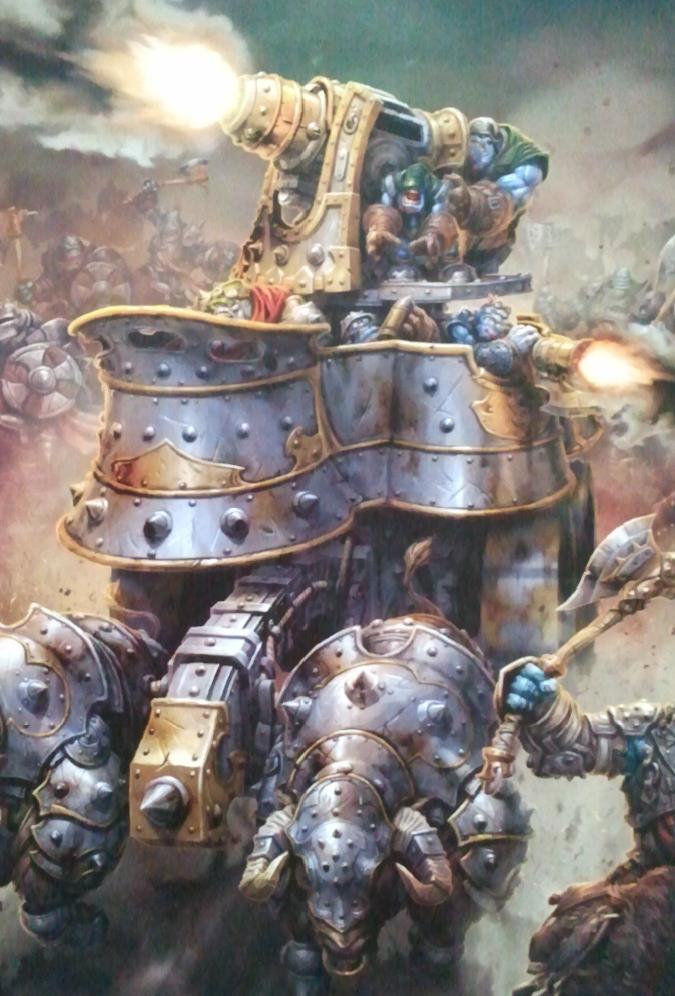
A Trollkin War Wagon is a loud and immense battle engine, drawn by powerful bison. Any foe foolish to stand in the way is crushed under its immense bulk and momentum. However, the noise of its passage is exceeded by the noise of its main gun, which can blast anything apart. The northern trollkin have used bison to draw battle wagons for centuries, and they have been revived with the renewed relations between them and the southern kriels. These wagons are then augmented with whatever weapons the trollkin can find. The war wagons are used to escort warbands across long d istances. The potent turret cannons are based on stolen Khadoran designs, and they take up most of the wagon, leaving little room for anyone but a driver and a gunner. This has led to a reliance on pygs to manage the guns, reloading them and keeping from being burnt by the heating barrel. They also repel boarders, so the gunner and driver can focus on just one job each. The strength of the bison teams allows the war wagons to be built without concern for weight, and so they have hundreds of pounds of armor, turning the wagons into immense battering rams when needed. The pounder cannon is the biggest part of the weight, however, with the driver serving to call targets and a scattergun-armed pyg clearing the path ahead of enemy troops. Once sights are locked, the gunner fires, confident in accuracy even with the wagon's movements. The weight of the shells means that even a miss results in destruction - well, that and the fact that they explode.
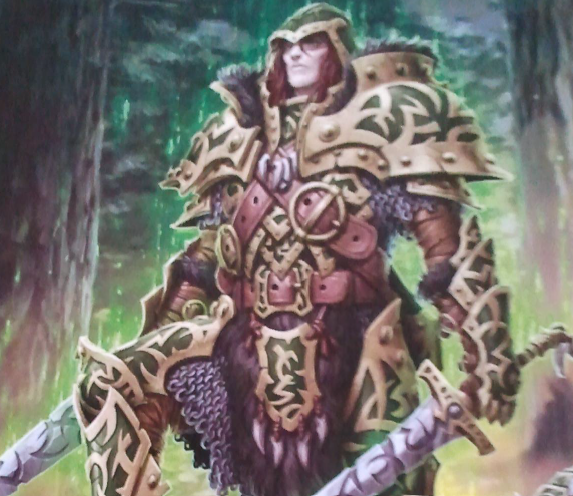
Grayle the Farstrider is a leader among the Wolves of Orboros, devoted to the Devourer Wurm. He is of the most ancient Wolf bloodlines, trained to obey the druids from birth. At 15, he already led a pack of Wolves, and it was clear he'd one day lead even more. It was a shock to him, then, when he was hunting a stag and realized he could feel its heartbeat and sense the thoughts of a hawk above him, experiencing his wilding. Most come into their gift younger than he did, and he struggled to accept his new role when the druids took him for initiation. He soon became aware that they were not what he'd thought they were, not all-knowing and prescient, that they did not perform the rituals the Wolves held sacred. Worse, they were endlessly engaged in political games against each other. None of that matters to Grayle when he is hunting. His skill as a warrior and his newly awakened powers have made him one of the deadliest fighters the Circle's ever had. He is excellent at removing threats, and while his ingrained loyalty and obedience may be obstacles to his advancement, he is a very reliably weapon in great demand. Since becoming an overseer, he's realized he must learn to adapt to intrigue while staying true to his beliefs and instincts. He is always most comfortable when hunting Circle foes, leading the Wolves of Orboros. His gimmick is, well, troop leadership, and his feat makes his allies stealthy and mobile.
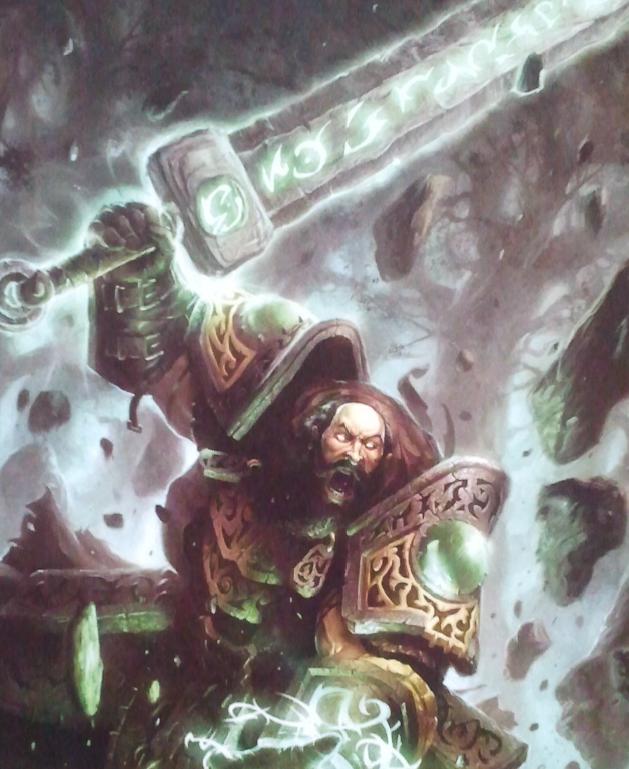
Baldur the Stonesoul is Epic Baldur. Death tried to claim him, but thanks to Megalith, he held fast, his soul entering the endless wilds of the Devourer Wurm. It was subsumed within Orboros itself, and the fundamental nature of the world was made clear to him. He experienced near total awareness, feeling the crust of the world like his own skin before he returned to his human form. He is a changed man now, given the obligation to serve as a conduit for the power of the Beast of All Shapes. He knows catastrophe is coming, and that the Circle has but a slim chance to set things right, all too aware fo his limited time. As a conduit of Orboros, his body channels immense power, both creative and destructive. No mortal flesh can long endure this, and while his connection to stone has strengthened, his life is consuming itself. In battle, he can tap into this flow to empower himself beyond his mortal limits, but the longer he fights, the more his body tears itself apart, and only by concerted effort can he keep the energies at a manageable level and heal his ruined form. With his limited time, he has no patience for intrigue. His famous calm has vanished, replaced by a terrible urgency and ferocity. His gimmick is still earth control, but he burns himself hard - he gets stronger, but it hurts him to do so. His feat buffs his allies' defenses.
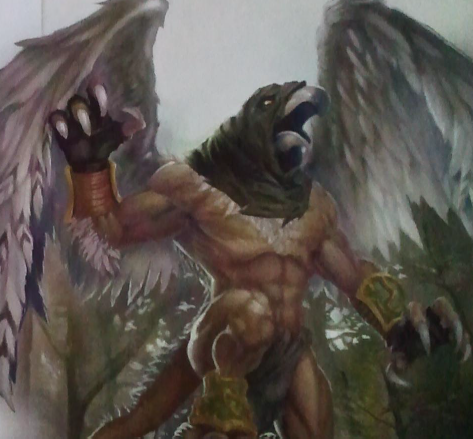
A Scarsfell Griffon is one of a race that mixes the grace of immense hunting cats with the ferocity of birds of prey. They were hunted near to extinction in ancient times, becoming so rare that most believe them to be myths. In truth, they survive on the edges of the world, away from civilization but within reach of the Circle. They have long raised griffon fledglings, using the best for their needs. They are vicious creatures, particularly those of the Scarsfell Forest of Khador. These griffons are solitary, known for their stealthy tactics and ambush predation, their prey generally becoming aware only when they strike. They lift ulk and other large prey aloft to be eaten, living little sign of their passing. Their animus protects their allies from opportunistic attacks.
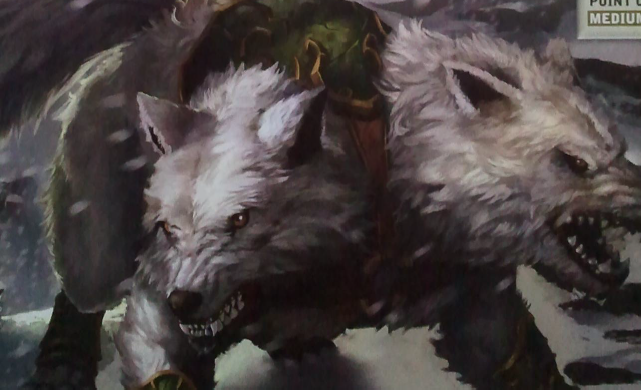
A Winter Argus is a monster of Khador, known for taking out small caravans and hunting parties. They prowl in the winter storms, leaping from behind a veil of snow and wind to attack their prey. The use gouts of icy breath to freeze foes in place until their packs can close for the feast. They stalk the Scarsfell and Blackroot woods, using hunting techniques similar to those of wolf packs. Some of the Circle do not like them, as they have difficulty forming new pack bonds and are not nearly so loyal as southern argus, but they are savage and their cold can cripple foes. Their animus grants some of their immunity to cold to their allies.
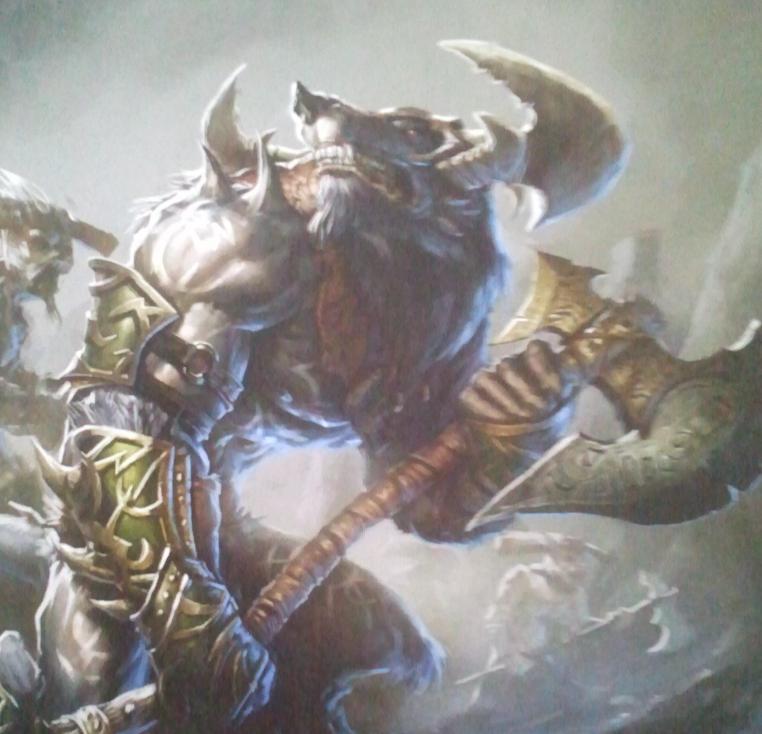
Ghetorix is legendary among the Tharn for his bloodthirst and his loyalty to Kromac the Ravenous. His howled battle cries set his foes on edge, breaking their spirits even before his axe and teeth break their flesh. He was once a tuath king of the Tharn who defied Morvahna the Autumnblade during the time Kromac served her. Morvahna had Kromac subjugate the tribe, and in the end Kromac defeated Ghetorix, dragging him before the druid. She saw in him a primal connection she could use, forcing him to drink warpwolf elixir. The Tharn had long been avoided for these rites, as their natural connection to the Wurm caused the draught to react unpredictably at best. Morvahna had Kromac watch as Ghetorix's mind was broken and he became one of the fiercest warpwolves ever. He broke loose to massacre his own tribe, even his wife and children, beginning a slaughter that only escalated with the full moon. Kromach hunted him for weeks, subduing him and creating a bond of honor and respect with the beast. Ghetorix's mind remains broken, however, and the mournful howls he lets out in battle suggest that each time, he relives the tragedy he visited on his own people. His animus lets people attack the foes that strike them.
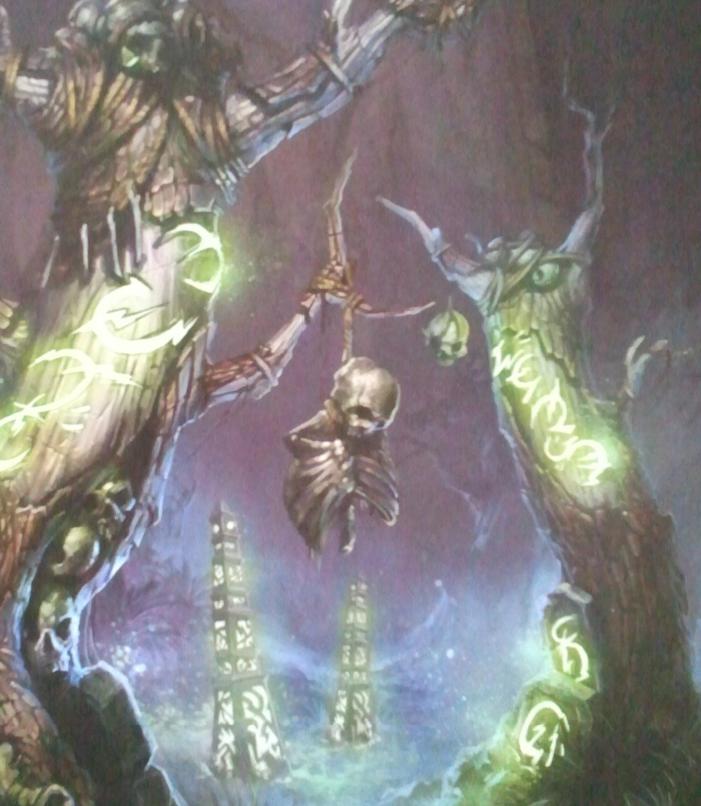
A Gallows Grove uses one of the oldest manifestations of the Wurm: trees that grow on the blood of death and sacrifice. These ancient trees have some approximation of sentience from their millenia of life, prowling forests like beasts. When sacrifices become scarce, they vanish, appearing elsewhere in the wood, drinking deeply of dead animals and humans. They cannot actively strike their prey, but they are drawn to bloody soil, which often unnerves young wilders. They follow the druids in search of blood, and Devourer cults see them as auspicious signs, often giving them frenzied sacrifices. They appear in Circle warbands as if they'd always been rooted there, but they seem to move in battle, reappearing where the blood flows freely. The druids feed their will into the trees, using them as conduits for Orboros' power. Their very presence saps vitality from the living as they call out for blood. They are rare, and the druids take pains to care for these trees, encouraging cults to sacrifice to them. The more fanatical Wolves hang captured prey from the tree branches, leaving them to bleed out from careful cuts, then rot to skeletons which may dangle for months or even years. Some druids commune with the gallows afterwards, listening for prophecy. Druids will make use of the same grove for years, forging bonds with the trees as they do with the warbeasts. The runes that manifest on the trees are not carved - they just show up as the trees feed on the dead and their souls. Some druids insist that these runes hold auguries that change over the years, and their glow can draw travelers astray, into the path of hungry predators, so their blood might feed the trees.
Next time: A guy who has literally stapled blades through his own back.
Hordes: Domination
Original SA post Hordes: Domination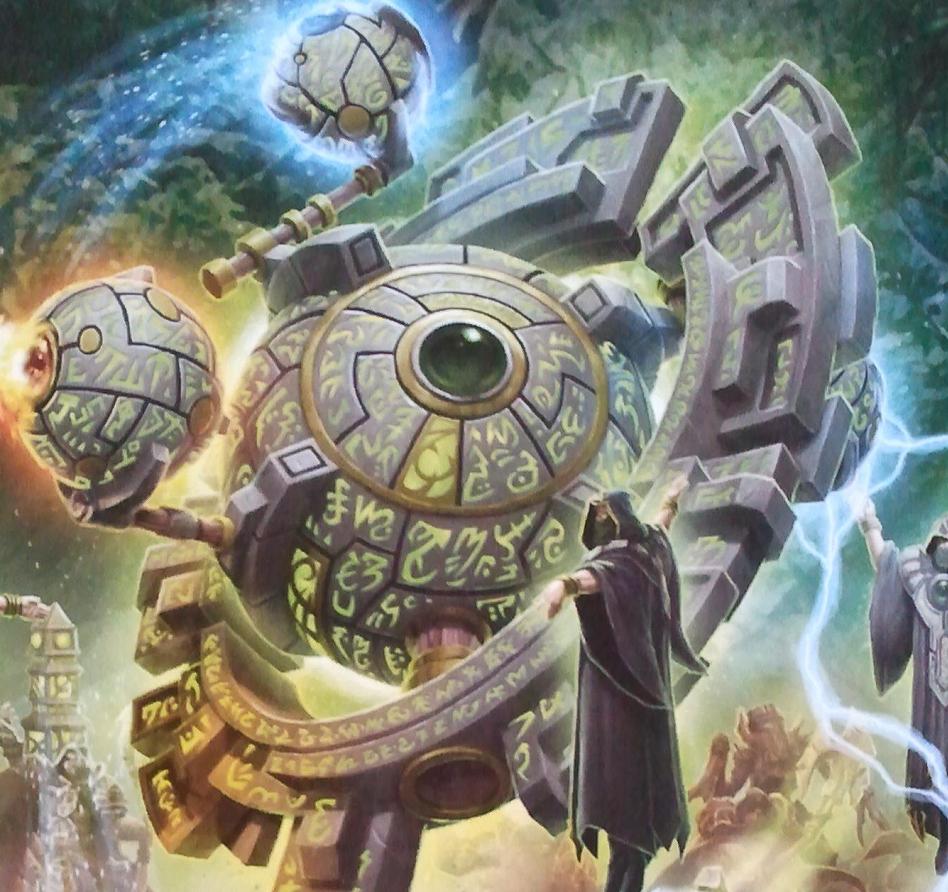
A Celestial Fulcrum is a battle engine of great power, developed by the Circle to illustrate the workings of the firmanent and mimic the celestial movements sympathetically, evoking natural power in an amazing way. The blackclads have charted Caen's three moons for millenia. The largest, Calder, is easily seen with its blue-white glow, but the middle moon, Laris, is black and brown, vanishing for long periods. The smallest, Artis, glow white and green, turning lily white as it waxes. The druids know each moon has great power over Caen, in the tides and storms and ley lines. The fulcrums contain empowered orbs that model the orbits of the moons. Spring orbits summon lightning storms that attack their foes, while a summer orbit sends blasts of flame and a winter one calls a killing, icy wind. The blackclads first learned these secrets via the orreries and armillary spheres they made of stone, but as they learned more, they made even more potent devices, harnessing seasonal energies until the creation of the first celestial fulcrum. These track the seasons so precisely that they generate manifestations of the elements. Senior druids study the orbits these machines represent to gain insight into the longterm motion of Orboros, and more and more, they areu sed as weapons of great power, proof of the Circle's will dominating the strength of Orboros.
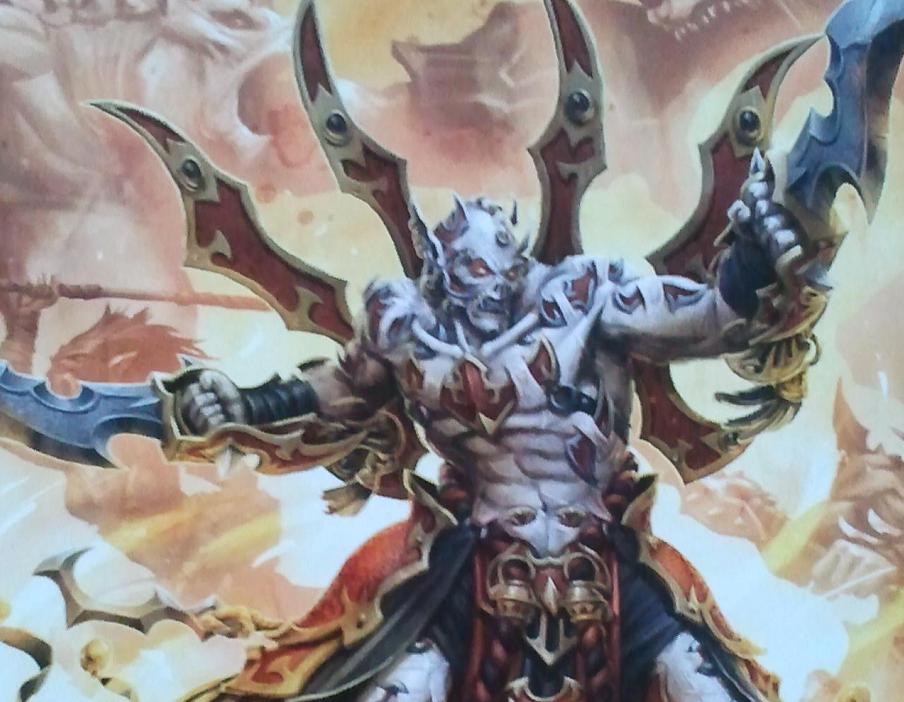
Master Ascetic Naaresh scorns other philosophers. He has transcended anatomical study and finds even the hoksune code too shallow. His suffering is not for masochism, either - it is the vehicle of enlightenment. His unique grasp of mortitheurgy is informed by pain itself, which gives him power. With every drop of blood, he grows stronger, until he reaches perfection, shorn of mortal weakness. He has lived nearly 200 years, old even for a skorne, but he continually tests his body's limits both against enemy blades and self-induced privations. Age has shown no sign of weakning him. Once a followerr of the School of Morkaash, the first paingiver, he has gone on to forge his own path. Many have sought to study under him, but none have passed even the first hour of his trials, dying beneath his blades. He has spent decades meditating in the Blasted Desert east of the Abyss before determining he'd learned all he could in isolation. He headed west, hearing of war, and took neither food nor water across the Bloodstone Desert. His flesh is torn and roughened by the wind and sand, and when he appeared to the Army of the Western Reaches to join them, he explained nothing. He just started to fight alongside them, knowing that his destiny needed him to find new enemies and thoughts in order to cleanse his art of what flaws remained. Naaresh is outside skorne society, a peerless warrior and founder of his own school of philosophy. He is respected, but none are comfortable with him. He moves freely, taking what troops and supplies he likes with no respect for protocol. He is on the verge of enlightenment, dreaming of perfect tranquility in pain, a state which will render him invincible, immune to death itself. To this end, he will do anything and embrace any agony. His gimmick is pain and healing, and his feat lets him damage his warbeasts to heal himself and buff them.
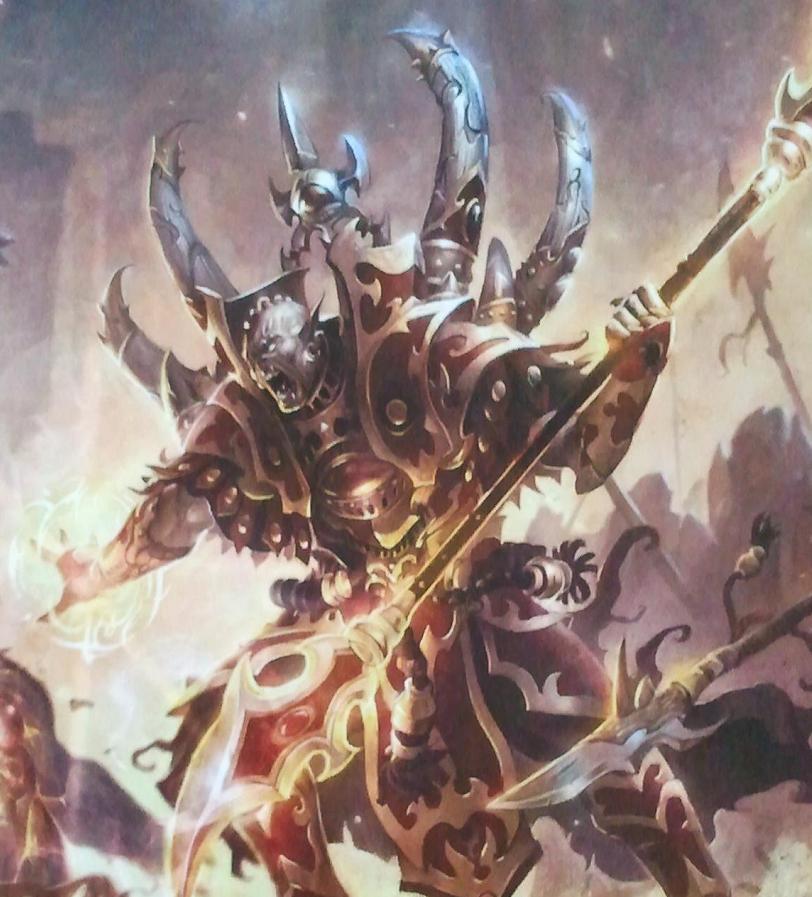
Lord Arbiter Hexeris is Epic Hexeris. He is the pinnacle of skorne magic, past or present. Under his gaze, the minds of others are laid bare. By cunning, power and genius, he has furthered his schemes and the Skorne Empire at once, making himself utterly indispensable to the supreme archdomina, who values him not only for his skills, but his knowledge of the secrets and weaknesses of all other occultists in the army. He manipulates them into effective, if uneasy alliances by threats and promises. His knowledge goes well beyond skorne lore, and he will seek any arcane secret. To oppose him is to be sapped of power, as he steals and transforms the energies of his foes. He has the most intriguing of them vivisected after battle to study their souls. He has left no avenue unexplored in his research, and his exposure to foreign necromancy, sorcery and druidic magic has given him insights that no other mortal in Immoren has understood. He has carved a place for himself, earning the unprecedented title of Lord Arbiter from Makeda after she secured the Abyssal Fortress. He suspects she promoted him to feign honoring him while also keeping him occupied overseeing the occultists. He has not complained - he now has the chance to exploit the mortitheurges and extollers better. His gimmick is blasting and healinbg by hurting others. His feat lets him steal souls, fury and focus from those around him.
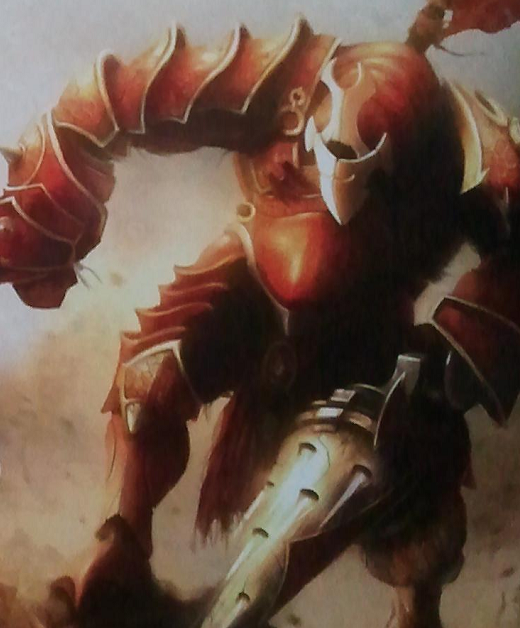
The Cyclops Raider is an eight-foot brute, covered in armor and trained to wield heavy reivers. Those that survive their needle onslaught are crushed by the spiked gauntlets of the raiders. While they are trained in ranged combat and discipline, they are still cyclopes, taking a terrible delight in cruelty with their bare hands. Most are raised as captives, conditioned from infancy to be less casually violent. Their training in projectiles is augmented by surgery to enhance their natural prescience, giving them an uncanny ability to judge movement and distance in order to compensate for their lack of binocular vision. Their awareness of the future is so great, in fact, that they can spot even the best-hidden targets and annihilate them. Their animus grants attacks longer range.
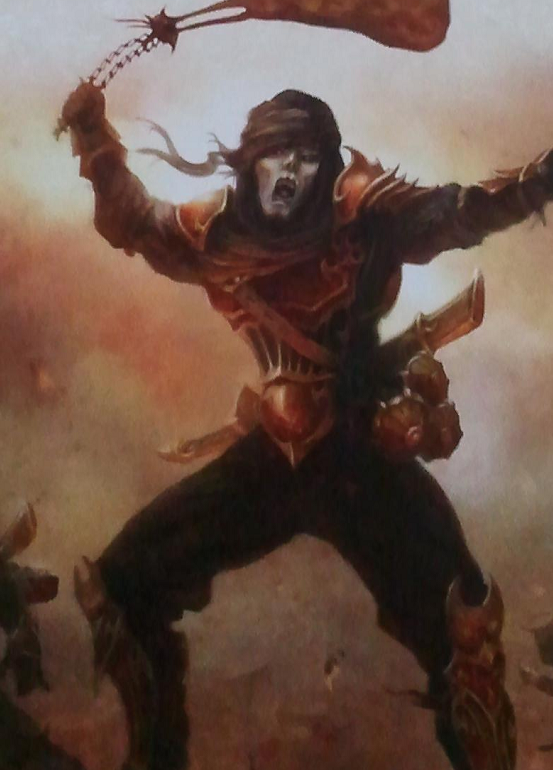
Venator Slingers are dreaded even by the Praetorians. Their whirring slings hurl globes of lethal acid, able to kill even the most heavily armored target. These weapons allow the lowest warriors to reduce the greatest to corpses with just a few shots. The simple sling is a weapon of the oldest traditions, serving as the main hunting tool of the skorne nomads. Though the origin is ancient, they are still deadly today, providing supporting firepower to the front line. They've been made even more deadly by the skorne chymists, who create plenty of caustic ammo.
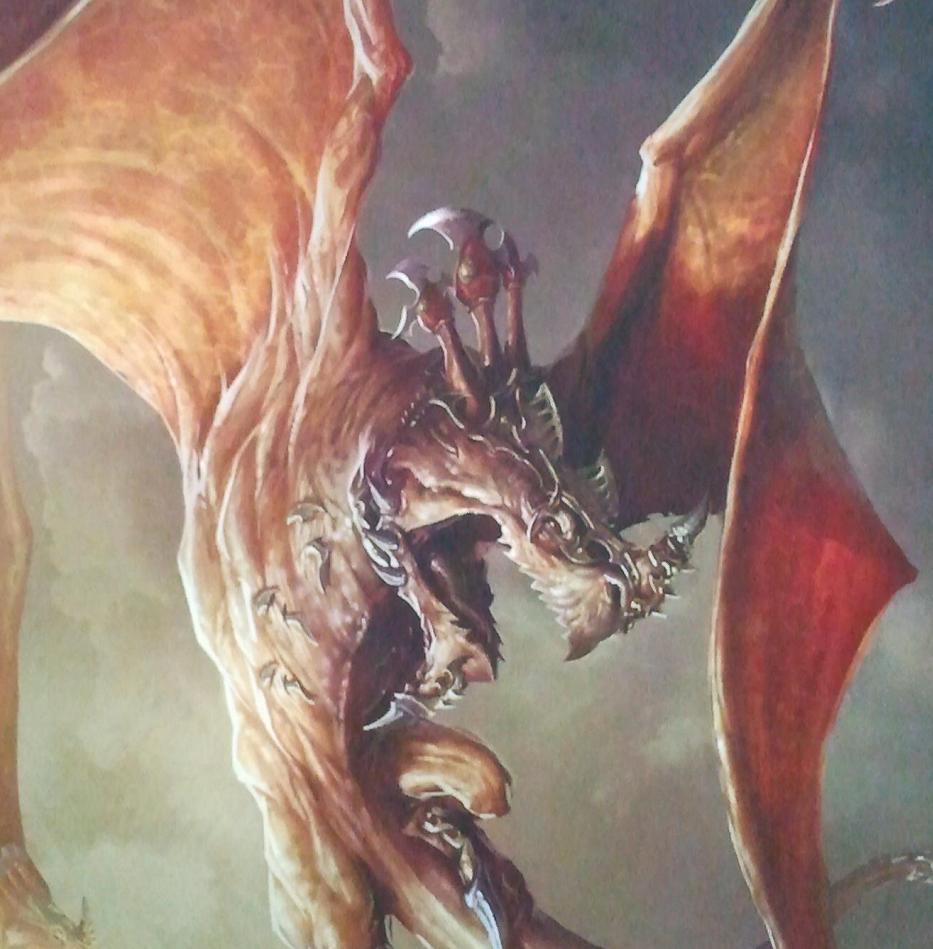
The Archidon is native to the Stormlands, an immense reptile that flies through the cover of raging storms to ambush its prey. At the command of the skorne, they swoop down on victims with immense speed, screaming and tearing into flesh with razor teeth. Before their prey can recover, they wheel around for a second strike. They roost in the mountains of the Bloodstone Desert, a threat to any who would cross it. Their flight makes them peerless ambush predators in the Stormlands, preferring smaller prey but able to work together to take down large targets. A group is known as a siege, using their deafening shrieks to attack prey in unison, even taking down titans. They descend on their quarry quickly, ripping them to bits with their teeth before fleeing out of range of retaliation. They can maim even the largest titans in minutes, then wait for them to bleed out. They do not discriminate in their prey, though, and will happily eat skorne or others in the wastes. Once they have their quarry, they hurl them into the air, crashing them onto jagged stones. The skorne resupply units cross the desert regularly, so they have plenty of prey, but it also means the paingivers have more chances to capture them. Since first discovering the archidons, the skorne have come to appreciate their speed and power, capturing them in numbers to train for the western battles. Their relative availability in western Immoren adds to the appeal, and while the mnethods of breaking and training them are still being refined, capturing them requires less investment than getting fresh titan stock. Their animus grants immense speed.
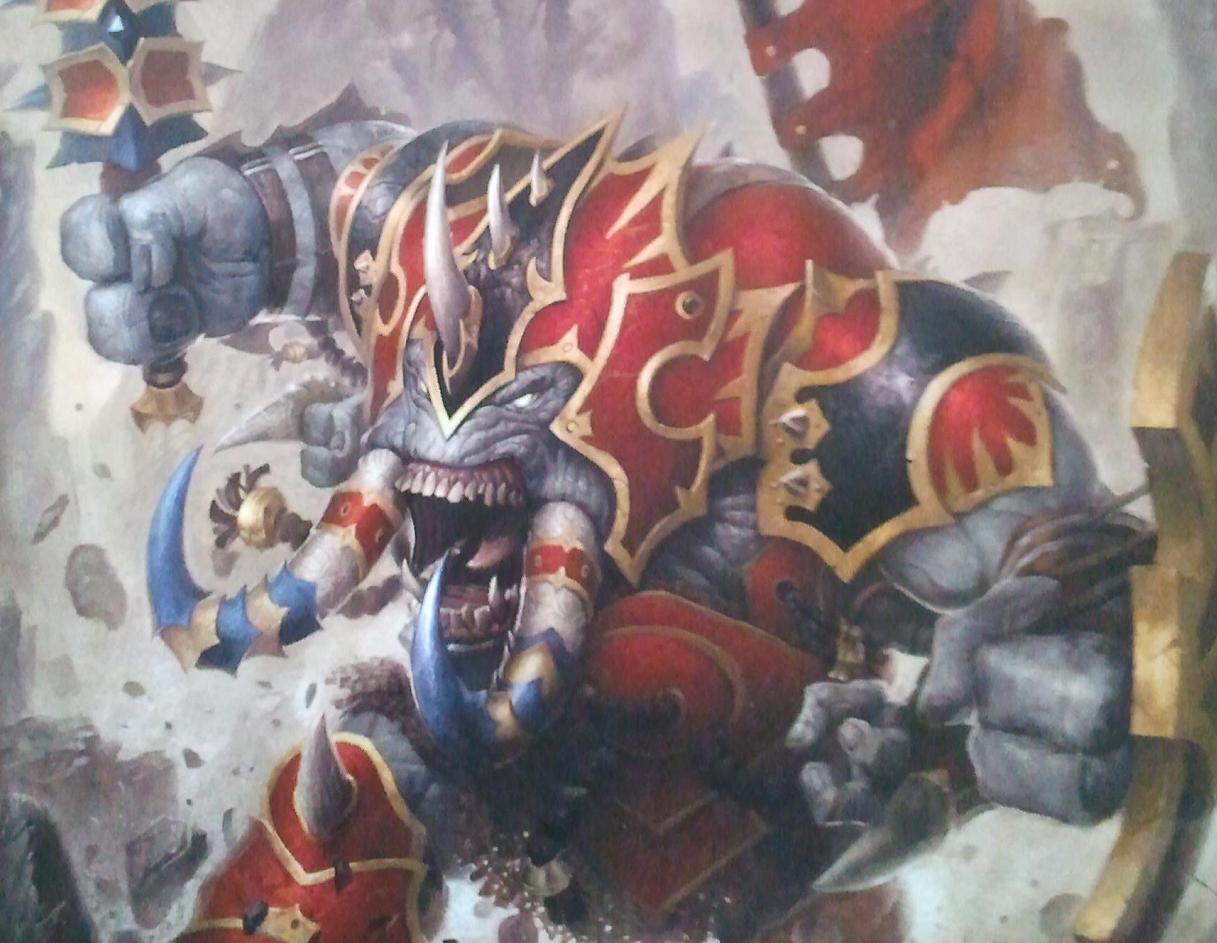
The titan Tiberion has been serving Tyrant Xerxis for over a decade, earning a regard nearly unheard of from the Cataphracts and Praetorians, some of whom carve his face into their shields. From his early training, he had a reputation for being ornery and resistant to commands, too intractable to serve. He would have bene killed, but Xerxis saw something in the beast's mind and chose to break him personally. He sensed a rare fighting spirit, and in time, Tiberion displayed discipline and intellect rare for a titan. He needed no goading or drugs to be battle-ready, and soon fought beside Xerxis like a devoted soldier. Xerxis came to rely on the titan to hold flanks or charge into dangerous fights. After dozens of battles, Xerxis gave him his name, after a great stone that had long endured the ocean surf near the city of Verskone. When a position must be held at any cost, Tiberion is ready. Entire formations crash against him, only to be broken and hurled aside. Tiberion obeys Xerxis without hesitation, almost emulating his stances and techniques. His roar terrifies the foes that must fight him and inspires the skorne that march with him. His animus allows him to shove enemies around.
Next time: A Legion warlock that isn't Thagrosh or a woman
Hordes: Domination
Original SA post Hordes: Domination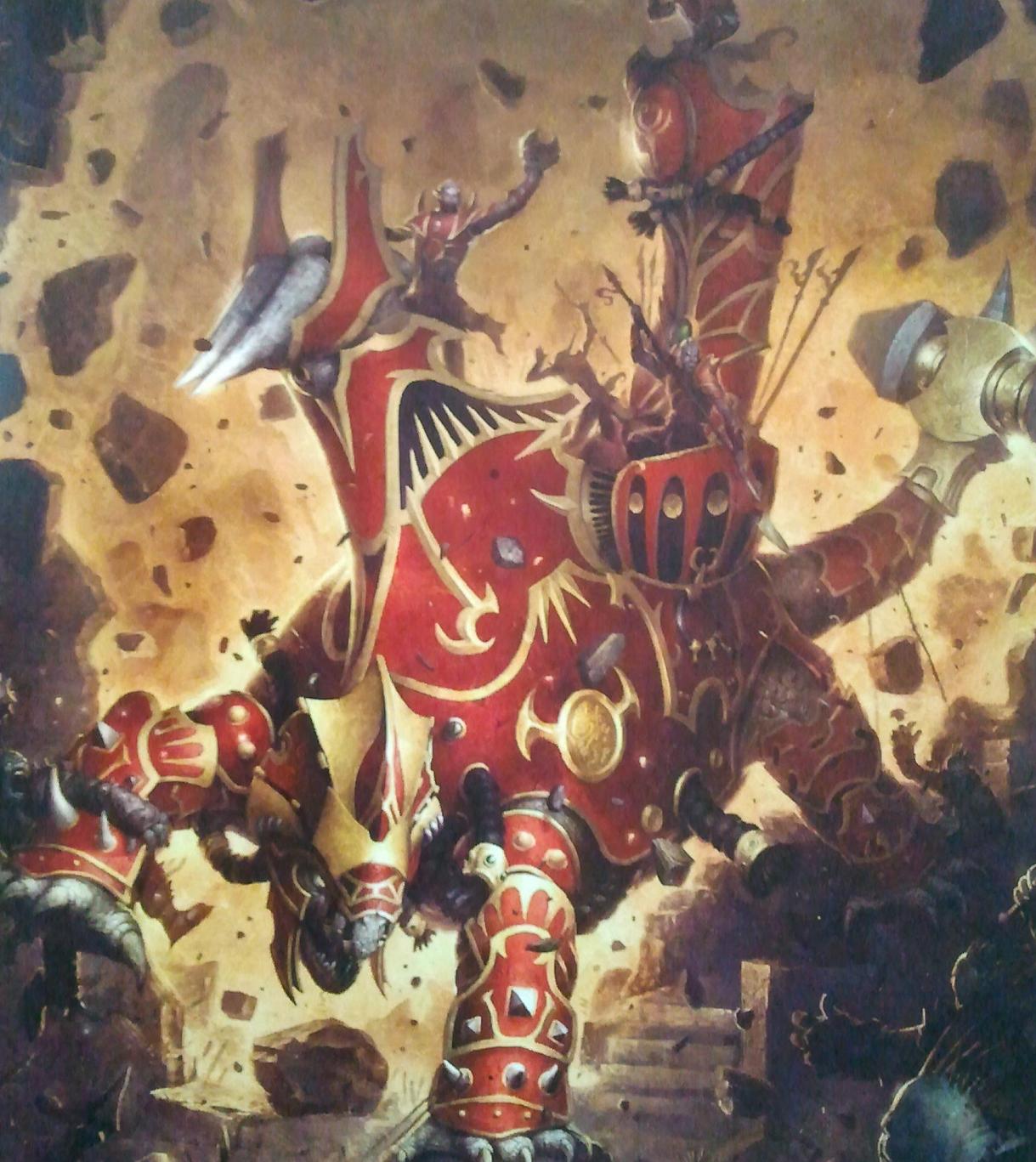
The Siege Animantarax is a living battle engine, bearing an ornate houdaa covered in weapons crewed by veteran Praetorians and Venators. The dakars commanding from the rear platform shout orders and blow horns to signal attacks. They move ever forward, slowly but steadily, delivering a hail of reiver fire on the foe. Incoming attacks just make them angry, and they smash through attackers with ease. The spears and double-combed reiver guns keep time with the swing of their tails, killing everything nearby. The animantaraxes have been known to the skorne for centuries, highly prized by the houses that could afford the costs of capturing them. Their strength and durability makes them ideal weapons platforms, and House Balaash was feared and envied for the dozen they owned in the Wars of Unification. Recently, expansion north of the Shroudwall Mountains has made animantaraxes more common. They cannot be bred in captivity, but are captured by teams of paingivers sent to the dangerous northern plains. While the Conqueror was reluctant to fund such expeditions, Makeda is not, and has had the wealthy houses renew their efforts. Veteran dakars are trained in the fundamentals of beast handling and lead mixed units of Praetorians and Ventators in weeks of drills before they are allowed to command from a houdaa. Tyrants strive to requisition animantaraxes for any conflict in which they fear heavy resistance. Just one can ensure victory.
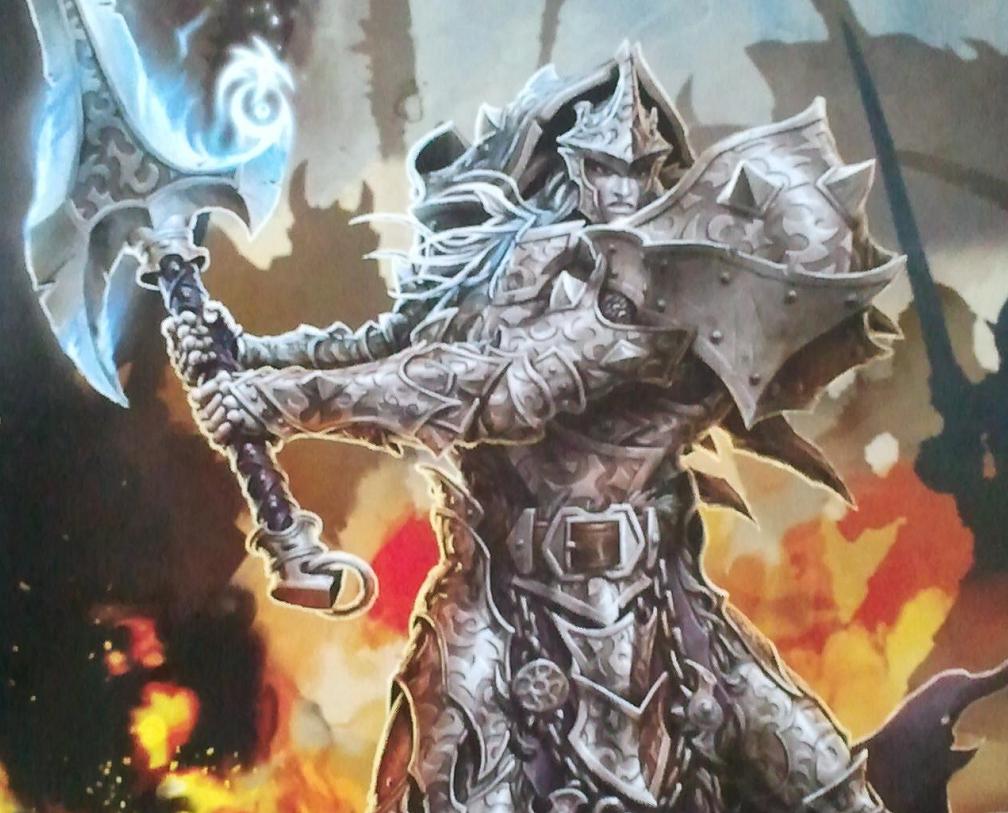
Kallus, Wrath of Everblight is the most deliberately crafted of the Legion warlocks. All prior had been born of chaotic transformation, but not Kallus. Every part of him was shaped by Everblight's will, including his mind, to serve as an undying general, able to awaken the dragon's fury in his followers. He is the creation which Thagrosh is most proud of, as his genesis was Thagrosh's idea, testing all of Everblight's ability to control the blight. The athanc shard used for Kallus was subtly altered, making it able to transform any flesh into Kallus' body and mind. The crystal has a pattern for him, based on a version of Thagrosh honed to emphasize strengths and eliminate weaknesses - an evolving mind embedded in an athanc that remains Everblight's own essence. The athanc was put in the body of a captive, whose flesh melted into a new shape - not Nyss, not ogrun, not human. Kallus was a blank slate created by Everblight's lore, lacking any memories that might restrict him. His mind can be preserved as long as the athanc endures, giving him the immortality of a dragon. He does not fear death in battle, for his death is only temporary, a mere inconvenience until a new victim can be transfigured into him. His personality is in flux as he learns about the world and his peers. The Nyss warlocks are mysteries to Kallus, as they have desires outside of Everblight. His own mind is filled with the will of Thagrosh and Everblight, and he learns very quickly. He has begun to suspect that his creation is the destiny of the Legion, that he is specially empowered to lead them in conquest. Thagrosh may be the Messiah, but Kallus is heir to the throne. His gimmick is personally murdering things and not dying. His feat lets him spawn Incubi whenever his troops die near him, and buffs soulless allies.
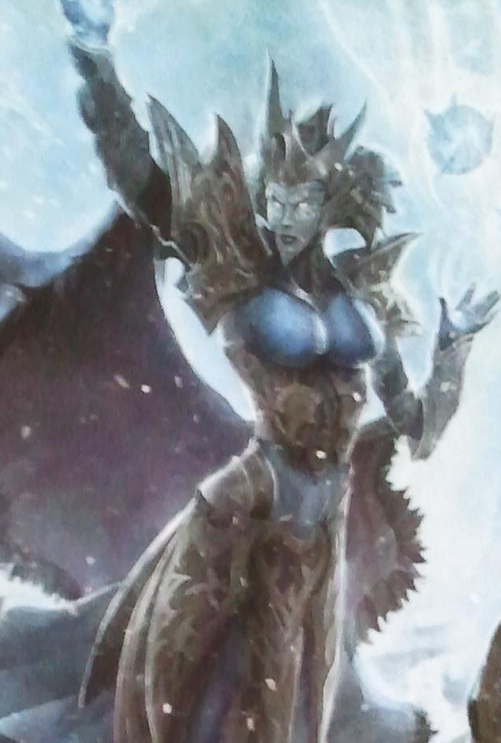
Vayl, Consul of Everblight is Epic Vayl. She has been guiding the Legion as a dark queen, commanding them with the same skill as her magic. She chooses which conflicts to become personally involved in. The trust Everblight has in her is deserved - no other general has been so instrumental in forging the Nyss into a weapon. There are those who think she cannot be truly loyal, given she betrayed her people freely, but they do not understand her. Everblight's goals and those of Vayl's are the same, for she has given herself to the dragon utterly, in exchange for all she needs for her own dreams of domination. She has great authority, answering only to Thagrosh and Everblight, and in exchange, she pits all of her intellect and cunning towards Everblight's plans. Her mastery over the Legion comes both from her political skill and her understanding of the blight. Her magic uses the dragon's power, and it is the template for all blighted sorceresses who have followed. All of them look to her for leadership in creating new arcane weapons. Drawing on draconic lore, she has begun to study the athanc, and it was from this she learned to modify her oraculus to resemble it, then split it into three. She strives to make similar use of the corpse of Pyromalfic to make tools to find other dragons. She may even succeed, doing in a few years what the lich lords of Cryx have worked on for centuries. Her gimmick is a mix of blasts and buffs, and her feat lets her cast her spells freely.
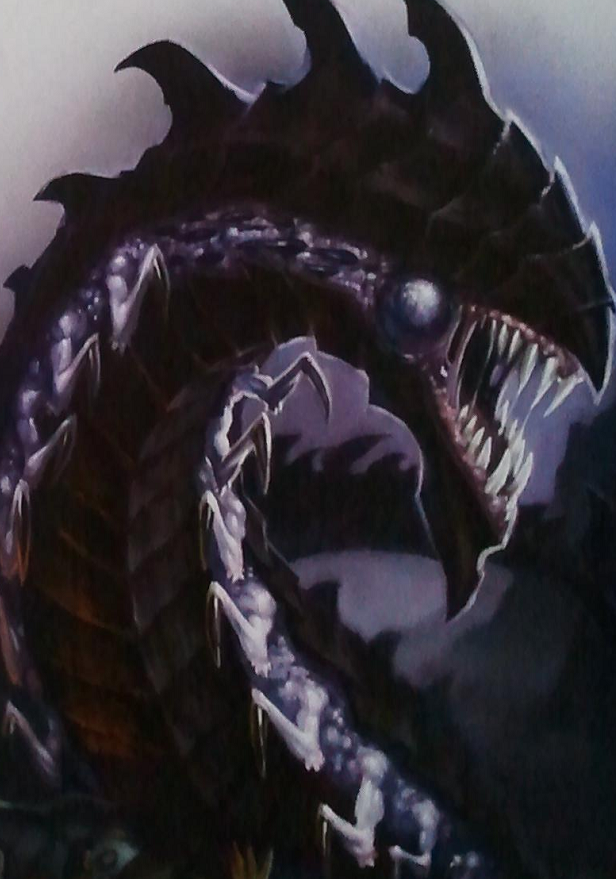
The Naga Nightlurker is a forerunner of the Legion, slithering through the shadows towards prey, using countless tiny claws to clamber over anything. They tear foes apart and spew caustic venom that melts flesh. The naga were some of the first creations of Everblight in the time of Morrdh, referred to in ancient texts as the worms of the earth, the crawling shadows. Some became known as the nightlurkers in the Morrdh language, and while apparently simple, they are in truth quite complex in their manifestation of the blight. Their animus grants immense power at tearing through magical protection.
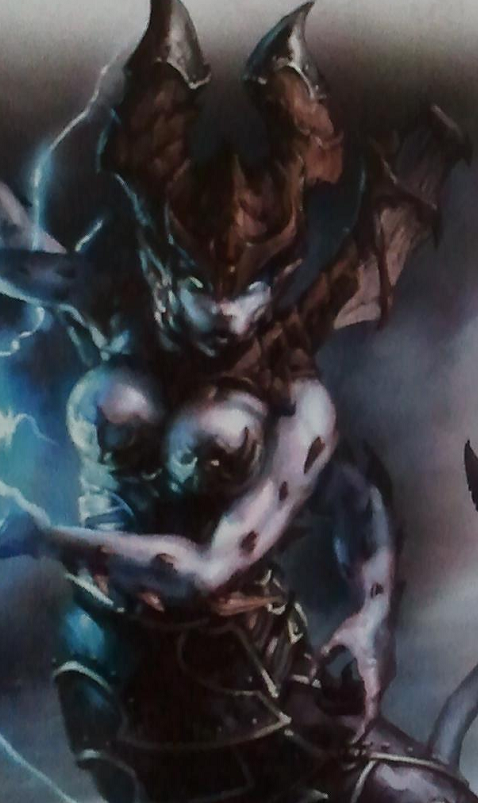
The Succubus is a new kind of Nyss, a product of the long reach of the blight. They mature rapidly from birth, and they have far greater sorcerous potential than most Nyss women. They are of the strongest bloodlines, and a few of those are culled for the purpose of becoming succubi, brought to the spawning pools and bathed in warlocks' blood. When they emerge, they are no longer wholly Nyss, and each is attuned to the warlock whose blood transformed them. They are as loyal as dragonspawn, empowered to amplify their warlock's magic, and with their every thought, they follow the will of their masters.
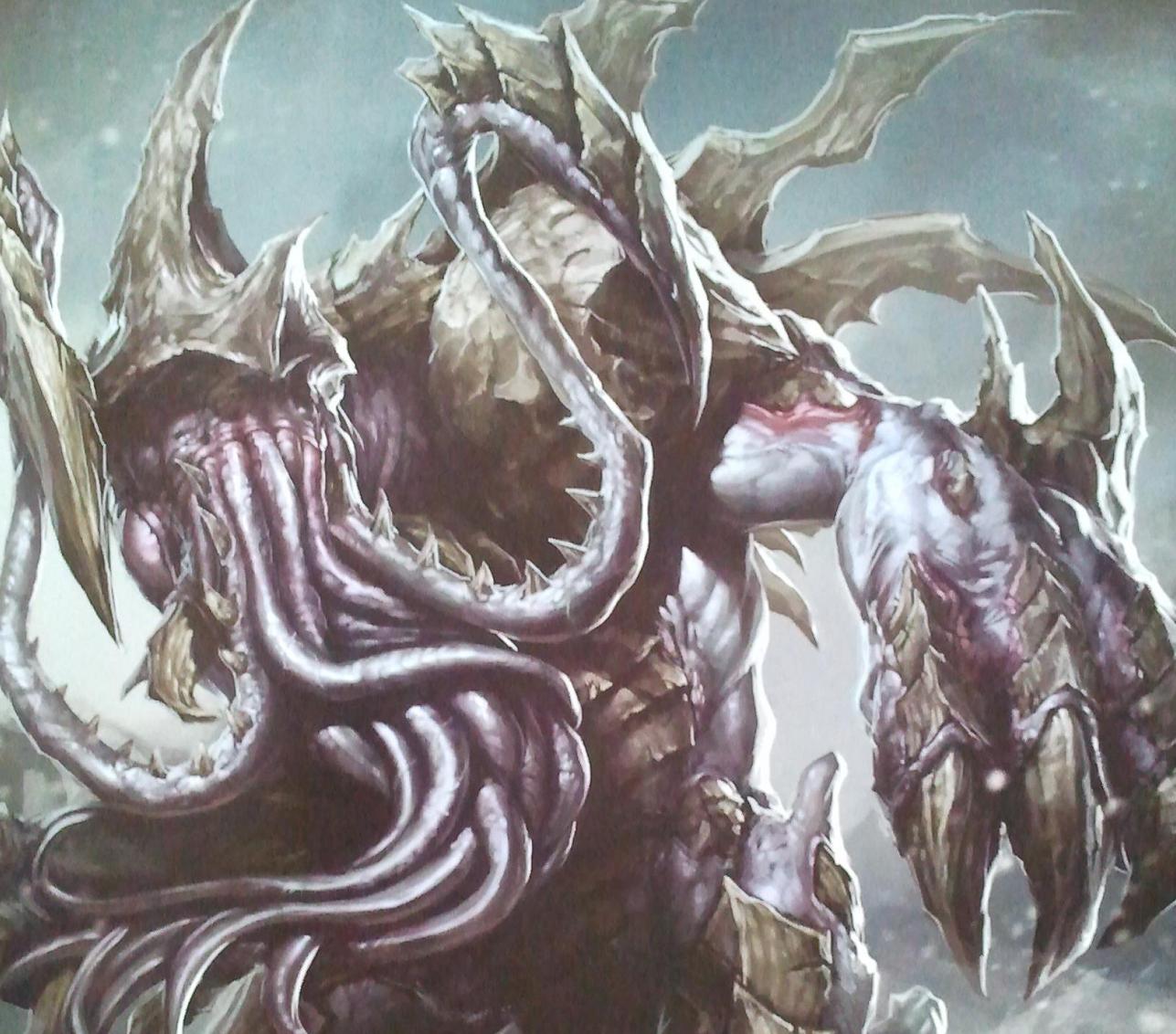
Proteus is the greatest creation of Abyslonia, the most skilled in creating dragonspawn. Everblight spoke to her as she spawned it, guiding her will. Its birth nearly killed her, using every drop of her blood, and it was only by a supreme act of will that she survived to see it grow from her blood and that of a dozen sacrifices. Its thrashing tentacles and terrible maw are the hunger of Everblight given form. Its armored body ripples with muscle, spines and claws. It is as confusing as it is horrifying, its head covered in grabbing tentacles. It wraps these around its victims, dragging them back to its body and flaying them alive, feasting on them to heal itself even as it kills.
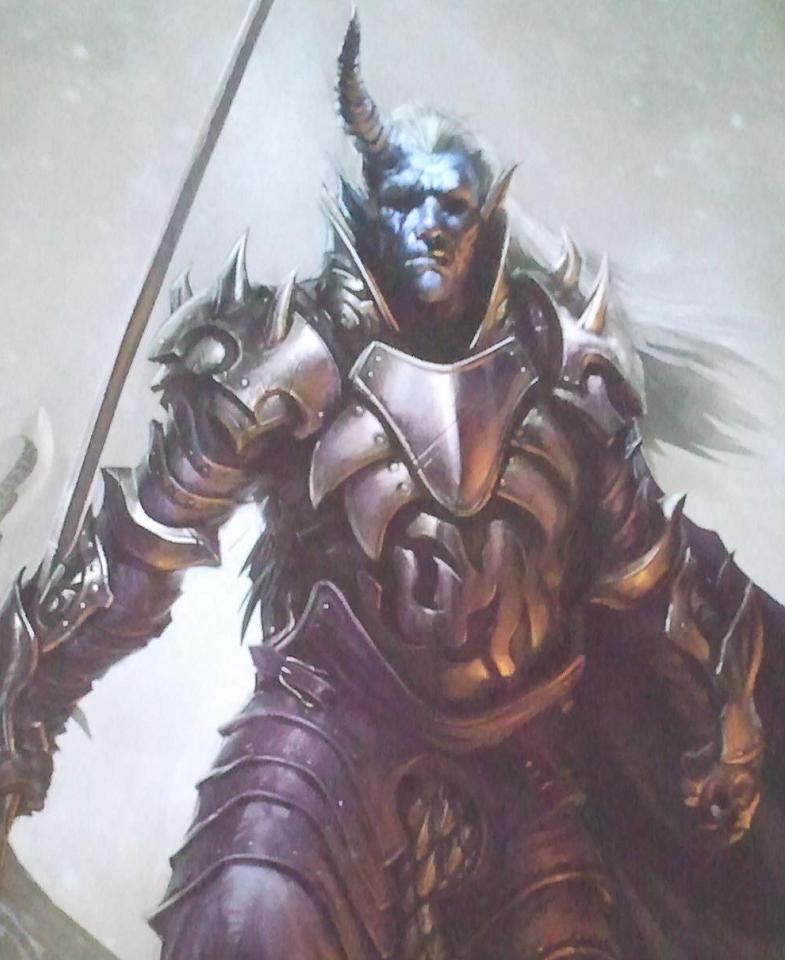
The Nyss legionnaires are led by Captain Farilor and Standard . Farilor, Bladeguard of the Prophet, wields them like a weapon, directing them for the glory of Thagrosh. Under him, the legionnaires will ignore even the greatest wounds to cut down foes. He was born to Maelwyrr Aeryn shard, a small but respected one for their guardianship of the Fane of Nyssor. Farilor knew he would have great responsibilities, working diligently to prepare for them. All of Maelwyrr Aeryn was shocked when he failed his testing and was denied priesthood. He left the shard in shame, considering suicide, but his drive to serve was too deep. Instead, he joined the ryssovass order, seeking new purpose in defense. He served well and with discipline, and while his family would not accept him, they considered him peerless. When Vayl betrayed the Nyss, the ryssovass were first to be blighted, for they were too dangerous to ignore. No blighted legionnaire was more devoted than Farilor, who rose to lead. He sees Thagrosh as savior of the Nyss and Everblight as their rightful god, demanding nothing less than perfection from the Messiah's honor guard.
Next time: Pigs and gators.
Hordes: Domination
Original SA post Hordes: Domination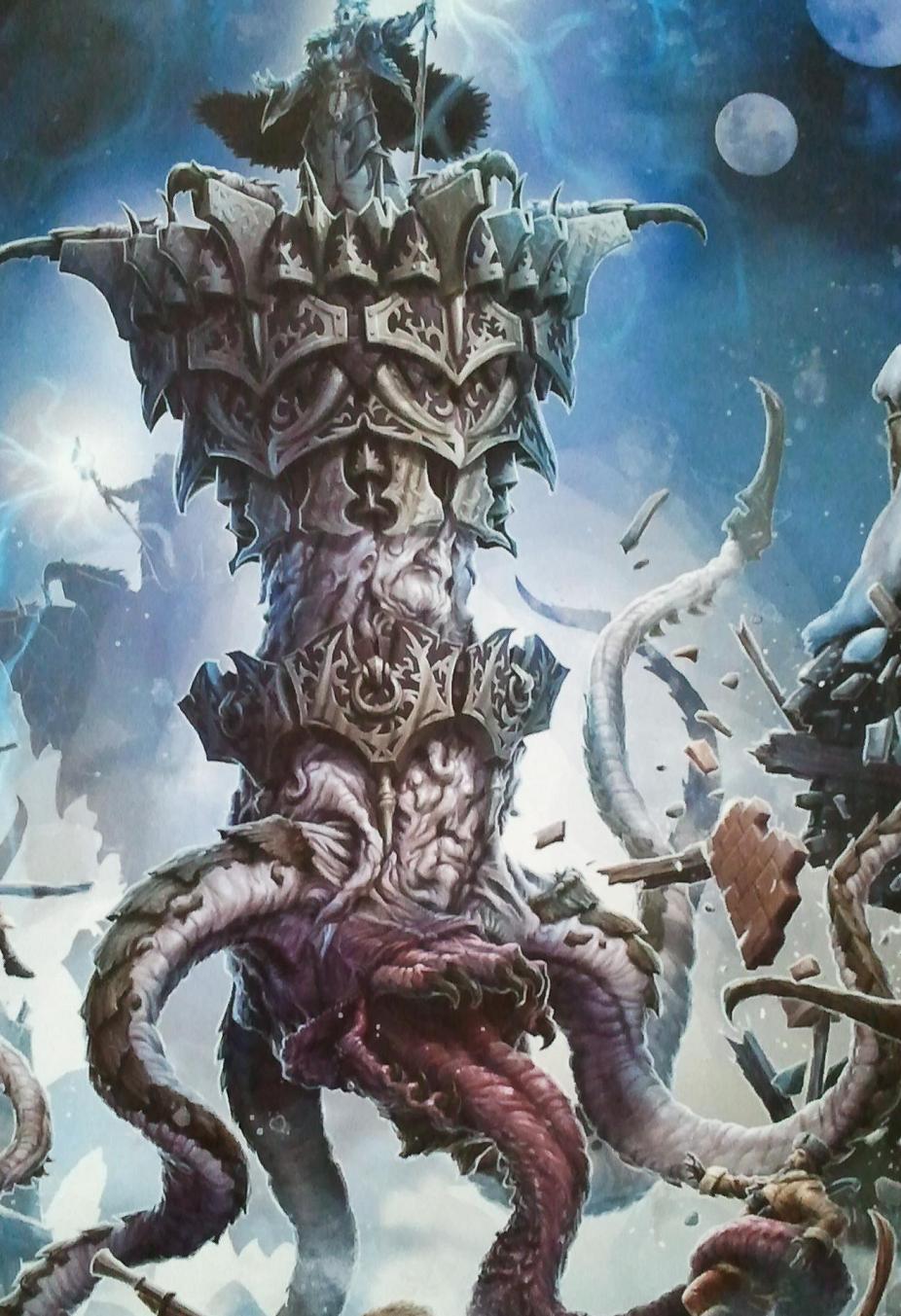
A Throne of Everblight is an immense battle engine, meant to manifest the dragon's will. It is controlled by a sorceress chosen personally by Vayl Hallyr to manifest Everblight's glory, and the harriers, seraphim and angelii of the Legion flock to the Thrones, circling them. They move forward over any ground, ignoring defenses. The sorceresses atop the thrones hurl blighted sorcery on those foolish enough to fight, freezing the enemy and tearing them apart with the blight. As they reach the enemy lines, the thrones' great tongues lash out and devour foes. Everblight dreamed up the thrones millenia ago, in the time of Morrdh, as a testament to his own glory, but he never had the chance to make them. It was not until he devoured the athanc of Pyromalfic that he had enough power to unleash these creations. The first was born of the deepest spawning pool, using the blood of Vayl, Saeryn and Abyslonia together. The creature that erupted forth was not dragonspawn, but something new, roaring as it surged from the dark womb, showering everyone with gore. Its tendrils tore at the sacrifices laid out for it, stuffing them into its maw. These creations respond only to Nyss sorceresses, and Vayl chose her best lieutenants for the privilege of guiding them into battle. As each throne merges fro mthe spawning pools, a sorceress comes forth to lead them.
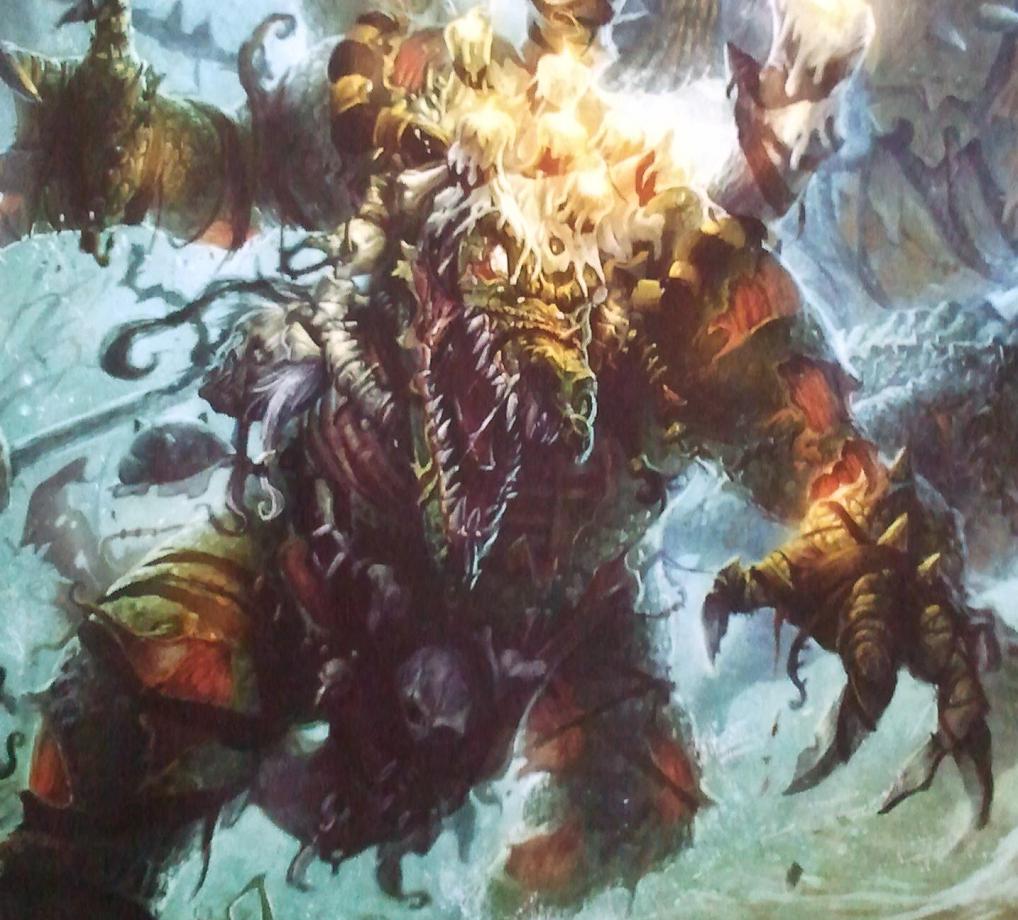
Maelok the Dreadbound will work for the Circle Orboros, the Legion of Everblight, the Skorne and the Trollbloods. He is an undead gatorman, a terror not only to his foes but even the Blindwater Congregation. The ritual that animates this bokor's corpse has left him an empty husk commanded by Calaban the Gravewalker. Maelok barely remembers his life and barely notices the destruction he causes. While he is hollow, his magic is terribly effective, and his army embodies the cold death of the fens. He was once a respected bokor of the Bloodsmeath, revered for his wisdom and strength. When he heard of Barnabas and his efforts to unite the gatormen, he opposed the warmonger. Even as he did, however, he was approached by Calaban, his long rival. Maelok had more necromantic power, but Calaban more influence, though they'd rarely fought directly. Calaban spoke persuasively of putting aside their differences to defeat Barnabas, and Maelok accepted, not realizing his peer's treachery. As he began a ritual to summon the dead, Calaban struck against him, siphoning the power for himself. They fought, and even with his stolen power, Calaban was barely able to slay Maelok. He immediately captured Maelok's soul and bound it, using his power to animate the corpse. Since then, Maelok has endured a tortured unlife. When he is not serving Calaban's will, he sits idle and dead. His few remaining emotions revolve around his hatred of his master and his dreams of devouring him. His gimmick is curses and necromancy, and his feat lets his allies become ghostly and incorporeal as well as buffing undead allies.
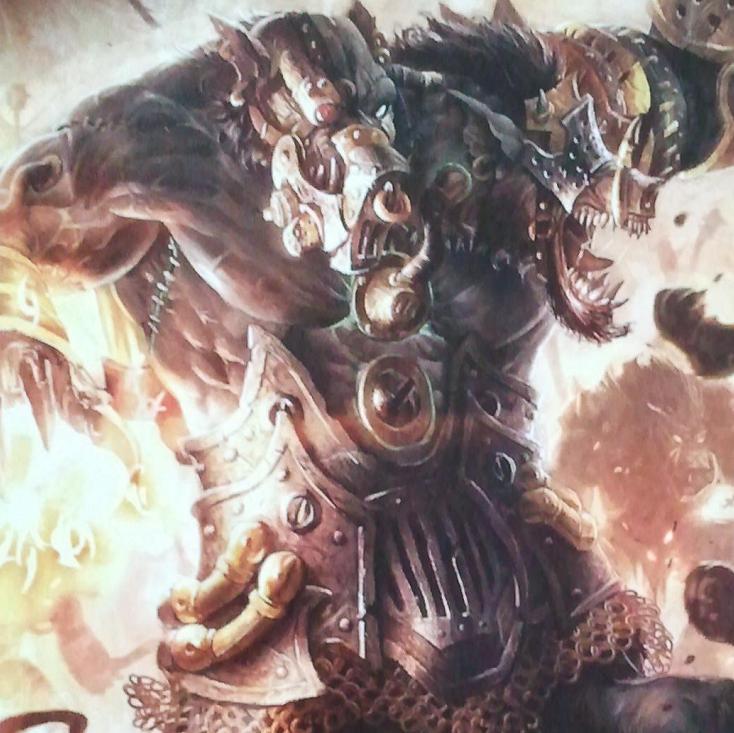
Sturm and Drang are the creations of Dr. Arkadius, linked together by psychic feedback that drives them into a battle frenzy. They will work for the Circle Orboros, the Legion of Everblight, the Skorne and the Trollbloods. They are engineered to dominate and control, with perfect command over the war hogs of the farrow and potent magic. Even Arkadius is unnerved by what was originally an experiment in artificially stimulating the psychic output of lesser beings. He placed two strong wills in opposition. Sturm was a megalomaniacal, domineering farrow while Drang was a crazed berserker. Arkadius linked them with parts of other pigs and mechanika, and by surgery and alchemical conditioning, he used their tension to catapult their mental power to amazing levels. After the pair nearly destroyed the lab where they were joined, Arkadius instituted controls, both surgical and alchemical, to add a layer of dementia to Sturm while reducing Drang to simpleminded psychosis. They have proven devastating on the battlefield, and only Arkadius knows how to calm them until they are needed. Their gimmick is having two statblocks - when Sturm is in control, they're a magical blaster, while when Drang is in control, they are a physical powerhouse. Their feat drastically weakens warbeasts and warjacks near them.
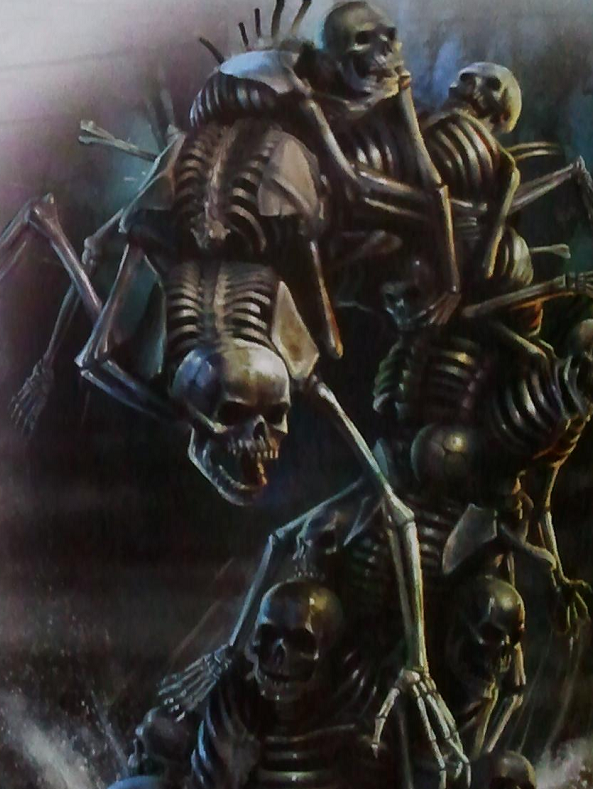
The Boneswarm is a serpentine mass of bones and swamp muck, created by the suffering of death given form and fueled by fear and pain. They tear at the living, to drown them in the swamps. They occasionally generate spontaneously at sites of atrocity, but more often they are made by the necromantic rites of the gatorman bokors and witch doctors, conducted via bloody sacrifice in the deep marshes. The lingering spirits coalesce around the bones, animating them into a beast of suffering enslaved to a bokor's will. Their animus weakens enemy attacks.
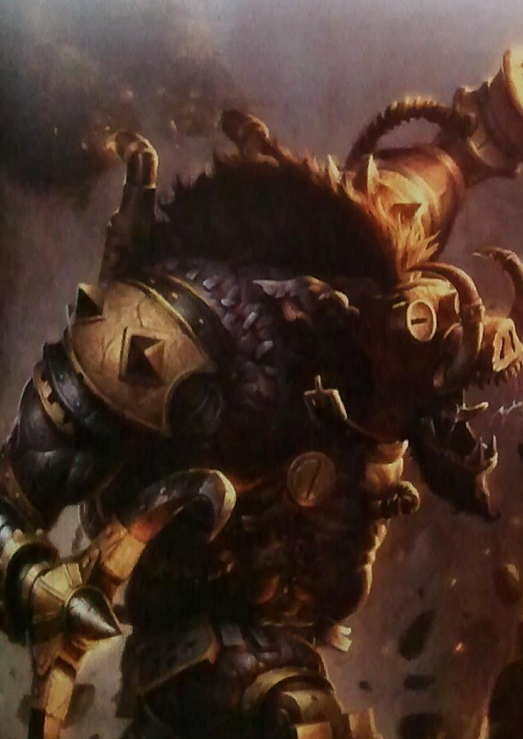
The Road Hog os an immense beast of the Thornfall Alliance, wielding gouts of flame and mechano-claws. They are great hogs with weapons grafted to their flesh. Their lower limbs are removed, replaced by mechanikal legs of extreme swiftness. The bursts of speed they can put on are impressive, but very painful to the creatures themselves - something Arkadius doesn't care about it. It's a trivial cost compared to the carnage they cause on the foe. Their animus grants some of that speed to others.
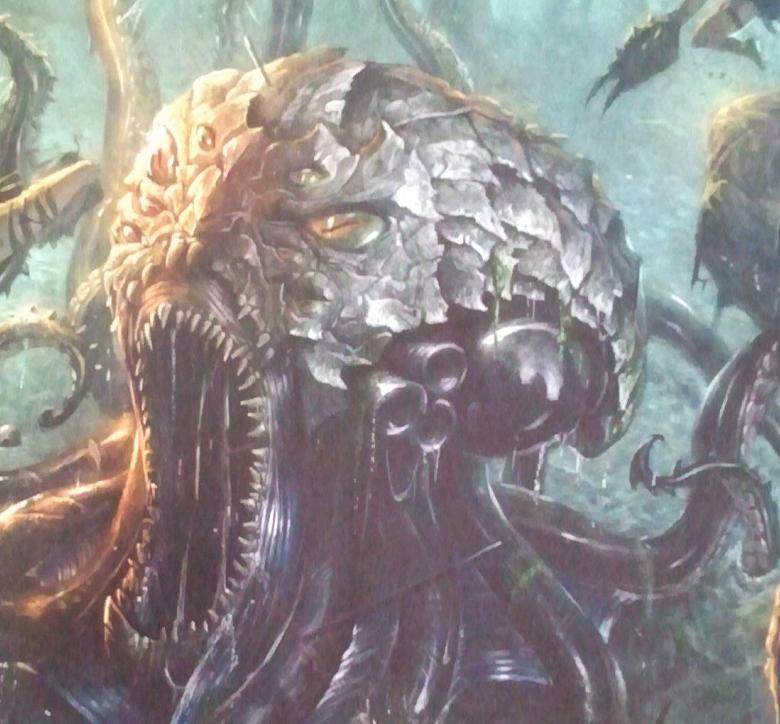
A Swamp Horror is a creature from the swamps near Corvis, a monstrous tentacled beast that gras onto prey and drags them into its gaping maw, then disappears into the depths. The gatormen have coexisted uneasily with these horrors for a long time. They eat just about anything, even gatormen, and most tribes just avoid them. Few will go into their hgunting grounds except in times of dire need, and fewer still will fight the horrors. The minds of these immense mollusks are alien and unnatural, and only the most exceptional bokors and shamans can subdue them. These gatormen happily take the swamp horrors into combat, and they serve as symbols of status and power. The swamp horrors move easily on their immense tentacles, if slowly. They seize onto any prey that gets near, pulling them ever closer to their jaws. Their animus grants extra reach to melee attacks.
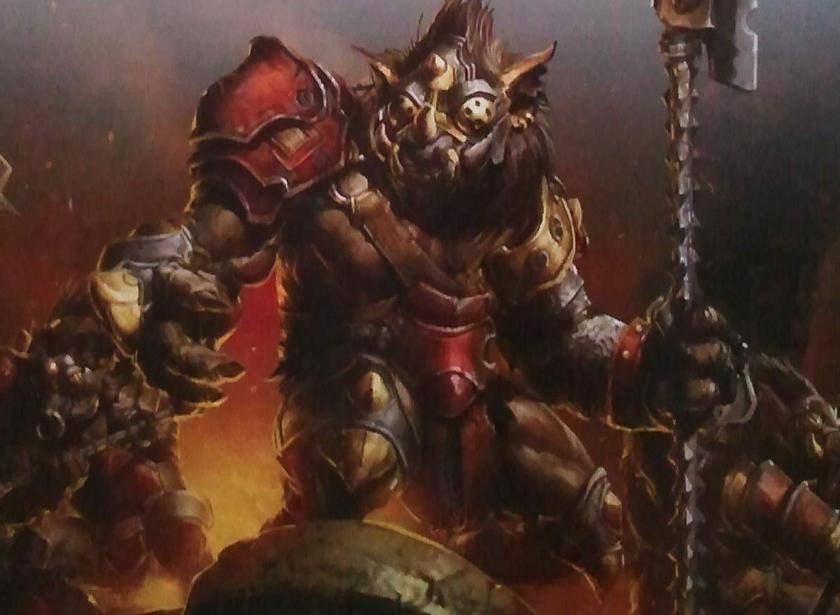
Farrow Slaughterhousers will work for the Circle Orboros, the Legion of Everblight, the Skorne and the Trollbloods. They are a vicious assault force, leading Lord Carver's charges in the Thornfall Alliance. They have embraced the ideas of Lord Carver and his destiny of conquest. Spurred on by his rants, they enjoy little more than tearing humans apart. Individual slaughterhousers are chosen for size, enthusiasm and viciousness, then given heavy pole cleavers to kill with. They are experts with these wepaons, especially at killing those already wounded.
Next time: A big pig.
Hordes: Domination
Original SA post Hordes: Domination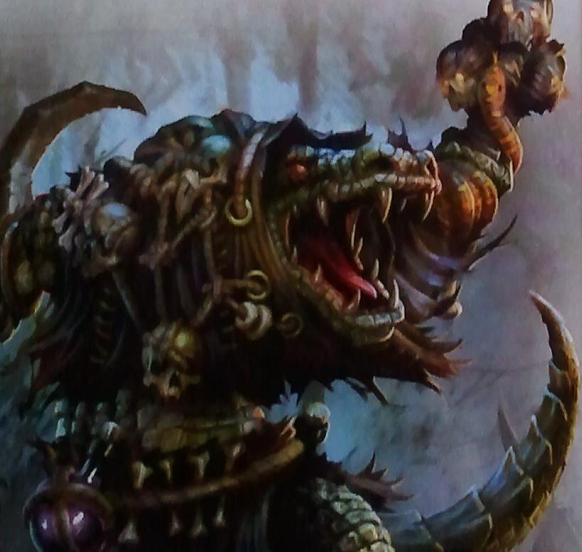
A Gatorman Witch Doctor will work for the Circle Orboros, the Legion of Everblight, the Skorne or the Trollbloods. They serve the greatest bokors, working with their communities and aiding with their dark magic. Each one is a potent mystic and necromancer, wielding the knife edge between life and death. Often, they see their allies as nothing more than tools to be moved between these states. Gatorman forces often include a witch doctor, as the bokors are expected to help in battle. In combat, they gather their totems that are used to power their spells, tearing the trophies directly from the bodies of their foes. They use their sacral blades and dark incantations to command the immense beasts they control.
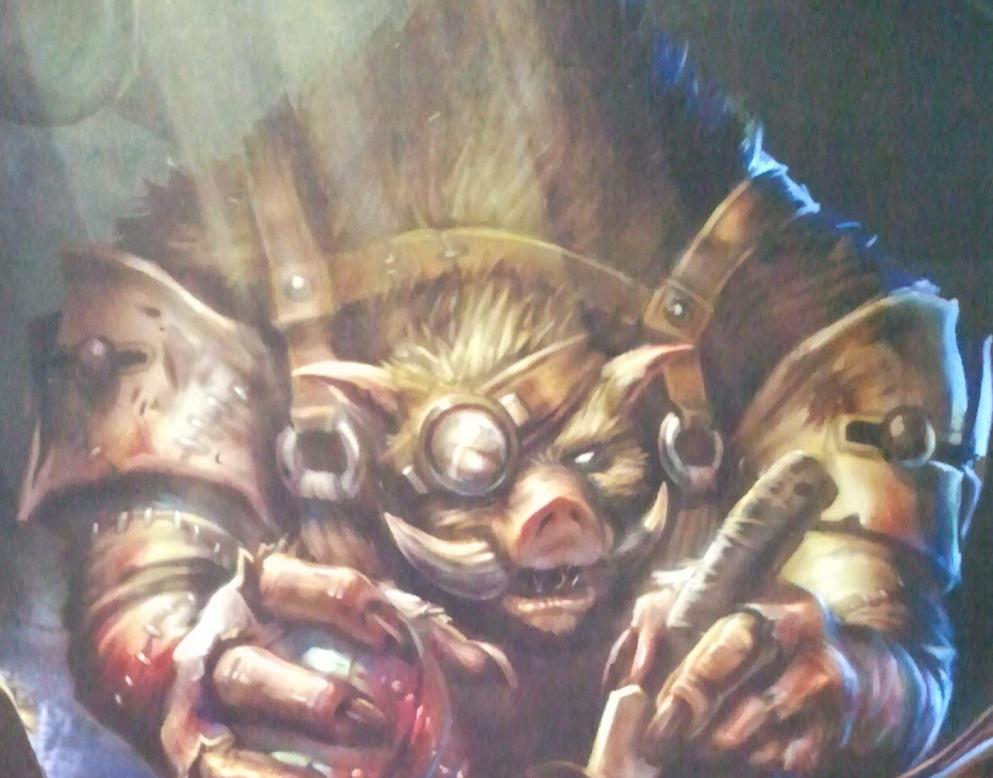
Targ is a farrow surgeon, wandering battlefields to heal the owunded warbeasts with an obsessive intensity. He'll work for the Circle Orboros, the Legion of Everblight, the Skorne and the Trollbloods. He ignores bullets and explosions, calmly using Arkadius' stimulants on the war hogs or patching up their gaping wounds with needle and thread. He has assisted Dr. Arkadius on so many modifications that the beasts are conditioned to recognize his hunched form as an extension of Arkadius, obeying him easily. He often herds new beasts to Carver or others of the Thornfall Alliance that need them. He stood out from other farrow early on, both for his deformity and his inquisitive, single-minded personality. He often followed shamans and others that got his interest, mimicking them. Some thought him daft or worthy of mockery, others beat him, and only his raw strength kept him from total victimization. Gew were willing to put up with him, though, and he was finally banished just before he reached maturity. For years, he lived on the fringes of farrow society, surviving on what he could scavenge and trap. He might have died in misery were it not for Dr. Arkadius. Targ's tribe was one of the first conquered by Lord Carver and Arkadius, and he was mesmerized by the war hogs, taking to shadowing Arkadius and emulating him. This annoyed other farrow, but Arkadius found it flattering. He took an interest in the cripplied farrow and wondered what he might make out of Targ. It was only when Targ stole some surgical tools and began to try and sew up injured warbeasts that Arkadius took him as an assistant. He originally intended to experiment on Targ, but discovered he enjoyed talking to him and found him a good listener. None can say if Targ actually understands the doctor's lectures or is just too focused to object. To Targ, the drone may offer a pleasing respite from barked orders. Whatever his mind truly holds, he is very dexterous and able to replicate basic surgical procedure, especially the sewing of flesh. He has no aversion to blood and is fascinated by internal organs and complex machines. He seeks out every chance to practice his skills, oblivious to the danger of the battlefield. So far, his luck has held, and he's survived even as others die around him, always returning for Arkadius' next lecture.
The End!
Next up: Warmachine: Colossals.
Warmachine: Colossals
Original SA post Warmachine: Colossals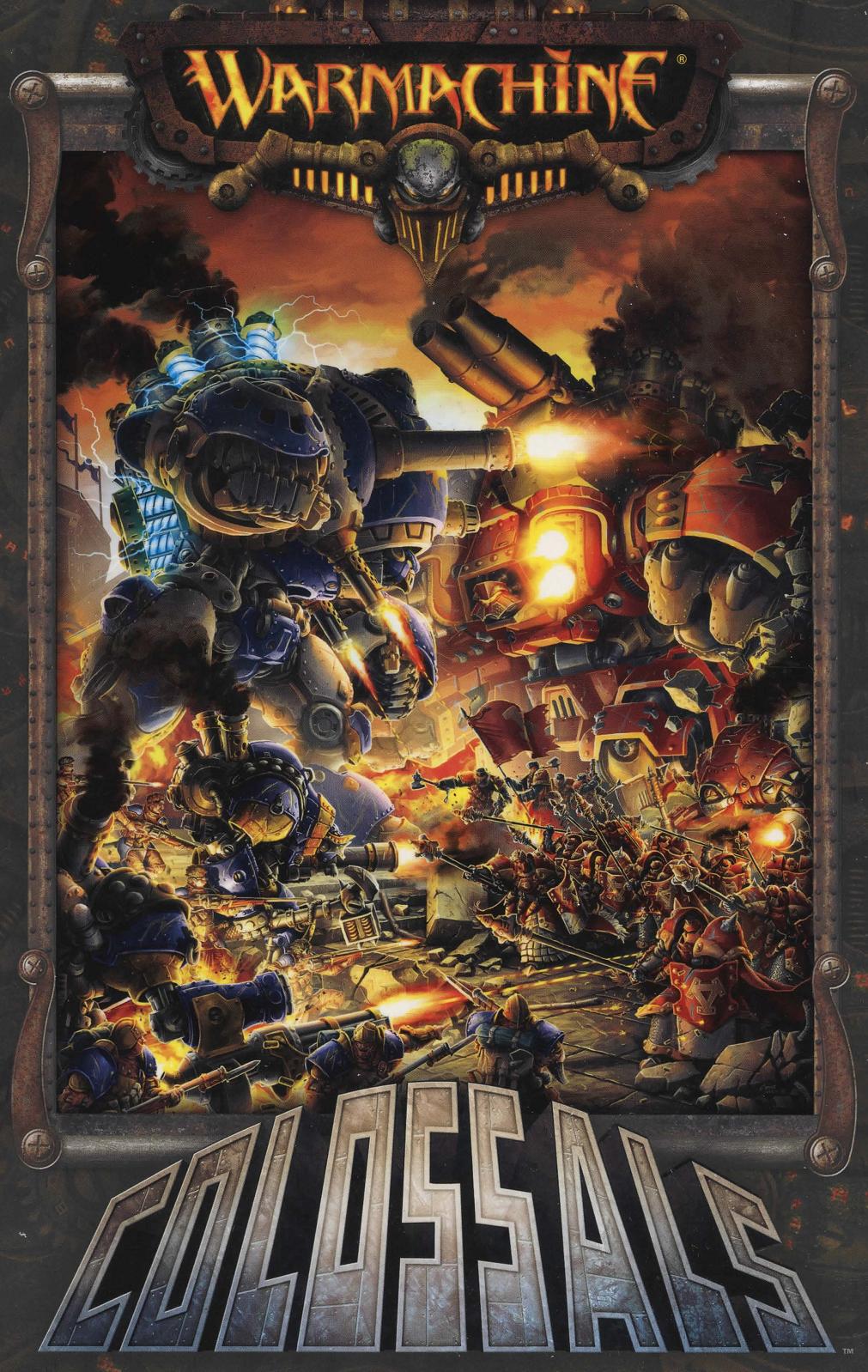
So, as you might guess, the thing about Colossals is Colossals. They're like warjacks, but bigger and tougher. To the point that they get two health grids, for their left and right halves. They also can't be disrupted like normal warjacks and can never get controlled by the enemy. You're paying a premium, after all. There are also the Unbound rules, basically for really gigantic fights that can have so many units that you might have formations of like three of the same warjack.
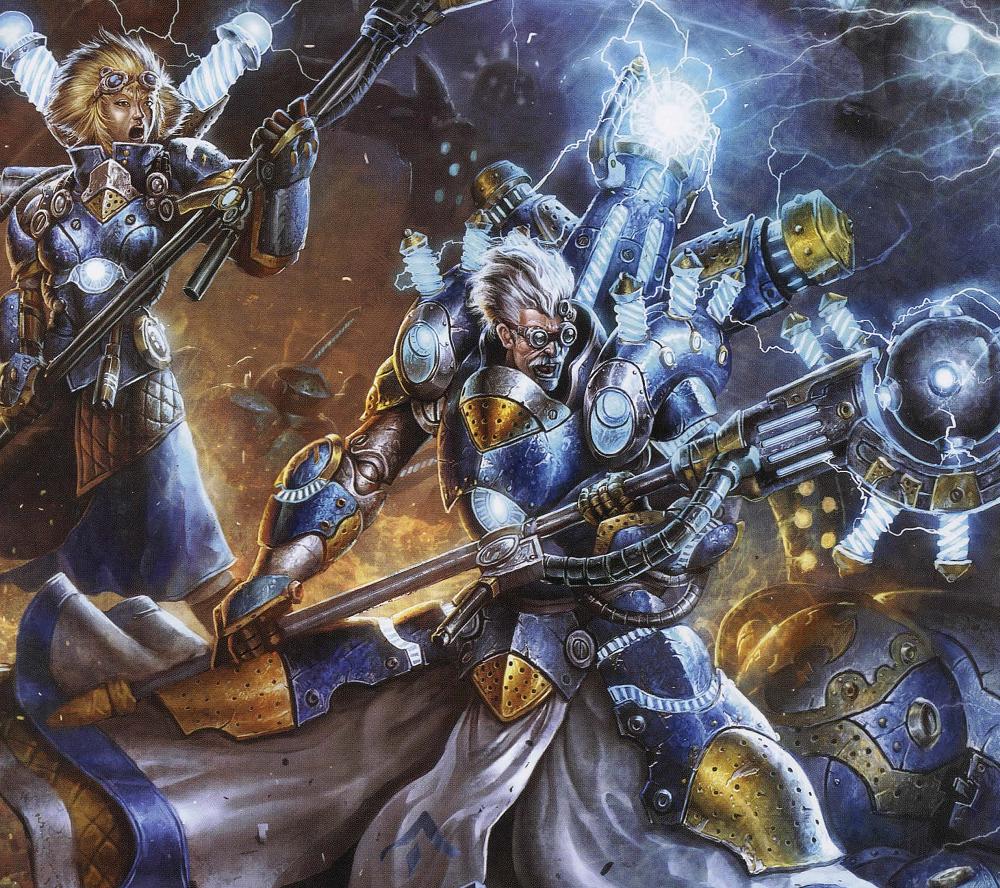
Artificier General Nemo is joined by Stormchaser Adept Caitlin Finch , and together they are the second Epic Nemo, IE, his third incarnation. Nemo will always be remembered as one of Cygnar's greatest geniuses, advancing mechanika more than anyone since Kerwin and shattering all kinds of preconceptions. As the war has grown more desperate, Leto has given him the power to do whatever is necessary to improve the Army. All modern weapons using storm chambers and galvanic power draw on his work, and if not for him, there might not even be stormsmiths or storm knights. However, his greatest achievement is the idea that led to the modern colossal. Had Cygnar's leadership followed through on Nemo's Stormwall project with the urgency he demanded, they might have made decisive strikes against their ofes before similar machines could be fielded. As a result of this lost opportunity, Nemo has been given greater latitude by Leto and the War Council, in the hope that future developments might not be delayed by bureaucracy. His new title brings great authority, and he has the right to take the nation's best minds to fill his army and workshops. Nemo is deeply concerned with the next generation, and he's mentored and fought alongside most of them over the past five decades. Unfortunately, he's also outlived many of them, and he feels deep grief at their deaths before reaching their full potential. His uncompromising and irascible nature have affected many other warcasters, who look to him for advice. In fact, it can be argued that he molded the ideal of the modern Cygnaran warcaster, particularly serving as a bastion of reason, morality and support for Coleman Stryker and Victoria Haley. While he's long been an informal consultant, his new title gives him direct authority over all stormsmiths, overseeing them via the storm chasers, the top ranking active field stormsmiths. They join major battles on many fronts, and one of their best is also the youngest: Caitlin Finch.
Nemo quickly saw Finch as one of the best minds of her generation when she came to his attention while developing the Squire prototype. She developed a unique mechanikal improvement that helped with warcaster spell targeting, and since then, she has assisted Nemo, her duties greatly expanded. She is reserved and occasionally arrogant, but Nemo sees this as healthy ambition, even if her stubborn adherence to protocol irritates him. She is devoted to him and delights in the chance to test devices in the field with him, showing immense courage in her use of electrical weapons. Nemo splits his time between the front lines and research, and he's busier than ever. Despite this, he's aware that he is growing old and has only a limited time to pass on his vision for Cygnar. Despite Finch's warnings that he should leave the fighting to younger men, he continues to fight wherever Cygnar needs him, drawing on decades of experience. His gimmick is electrical buffs, and his feat boosts allied electrical damage near him.
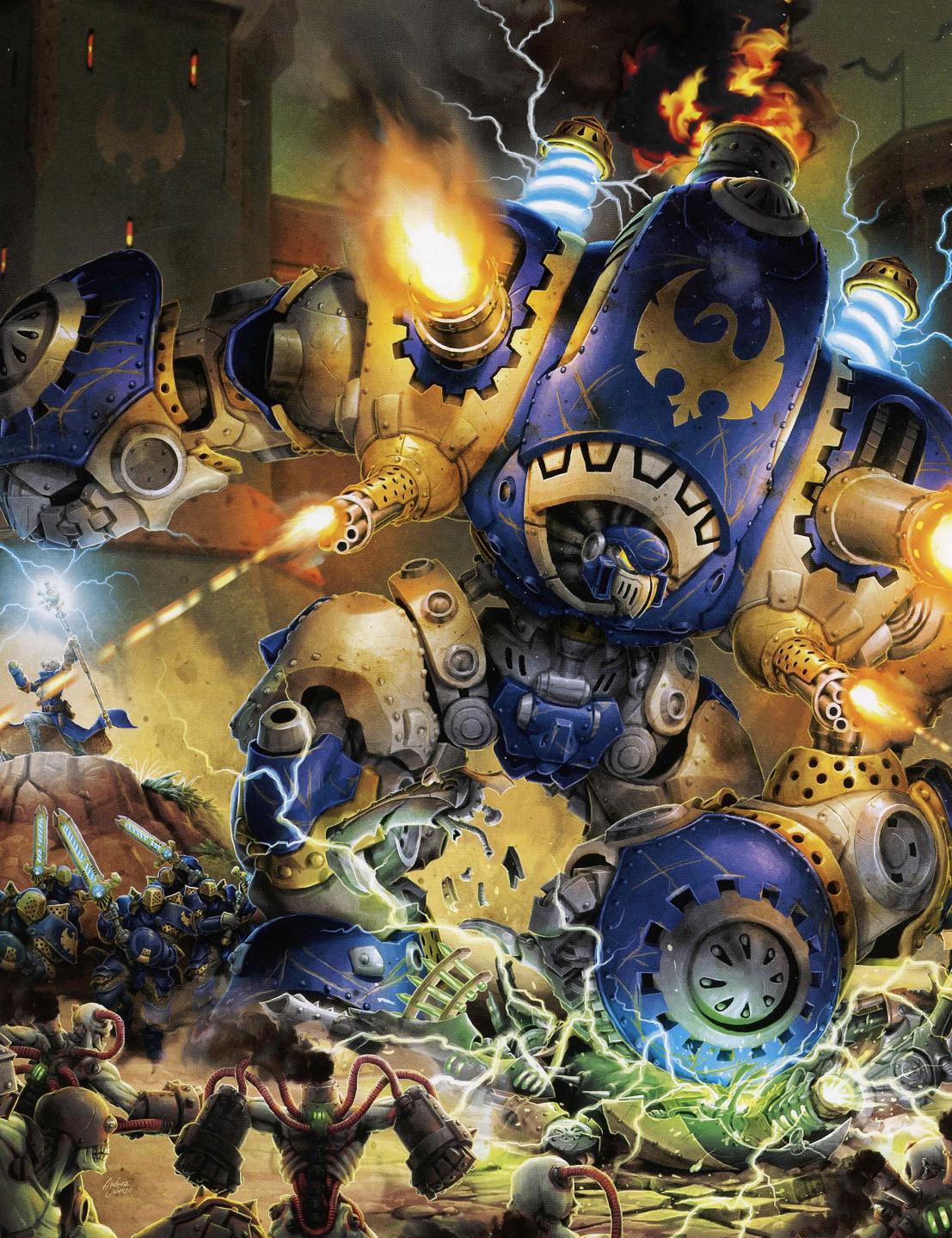
The Stormwall and its accompanying Lightning Pods are the result of Nemo's research. The Stormwall stands 28 feet tall and weighs 60 tons, towering over Cygnar's foes. It was born from Nemo's inspiurations after his recovery from wounds suffered at Temple Garrodh, where he found the functioning cerebral matrix of a colossal left forgotten since the last battles against the Orgoth. He imagined the potential of a modern colossal using modern innovations, begging the war council to support him. The cost provoked great deliberation, and Nemo fought for the porject long and hard. Even as he pushed for it, he worked on the schematics, leaving Dominic Darius to review his plans and help shape the machine. In particular, Darius saw the benefit of reliable ammo-fed systems, convincing Nemo to use coal-based power rather than storm chambers alone. Nemo worked with the Fraternal Order of Wizardry to make a cortex capable of controlling multiple weapons systems, desinging a new cortex grade: the arcanum supernum, a powerful and large design making use of the colossal's immense interior. The construction was delayed, however, and Khadoran agents learned of the project, stealing schematics of key components, including hte cortex. The Khadorans made their own colossal with immense speed, thanks to the emopress' absolute power. It was this which got the Royal Assembly to provide funding, but it was still too late to perserve any advantage. Once production was committed, the design synergy was brilliantly executed. The Stormwall's largest parts are powered by a steam engine that is the most efficient and powerful ever made in Cygnar. The electrical weapons draw on large galvanic chambers, and the combination of the two power sources means Stormwall can go longer between refuels than any Cygnaran heavy warjack save the Thunderhead. It carries experimental lightning pods, launching them using explosive charges. These pods open on impact to form conduits for voltaic energy, and even after their initial blast, they serve as a strategic asset for nearby stormcallers to triangulate with. The Stormwall's other weapons are also impressive. The metal storm cannons and main guns require immense amounts of ammo - it carries enough for a small garrison. In action, it unleashes huge torrents of bullets and cannon shells, along with immense electrical power via its voltaic fists.
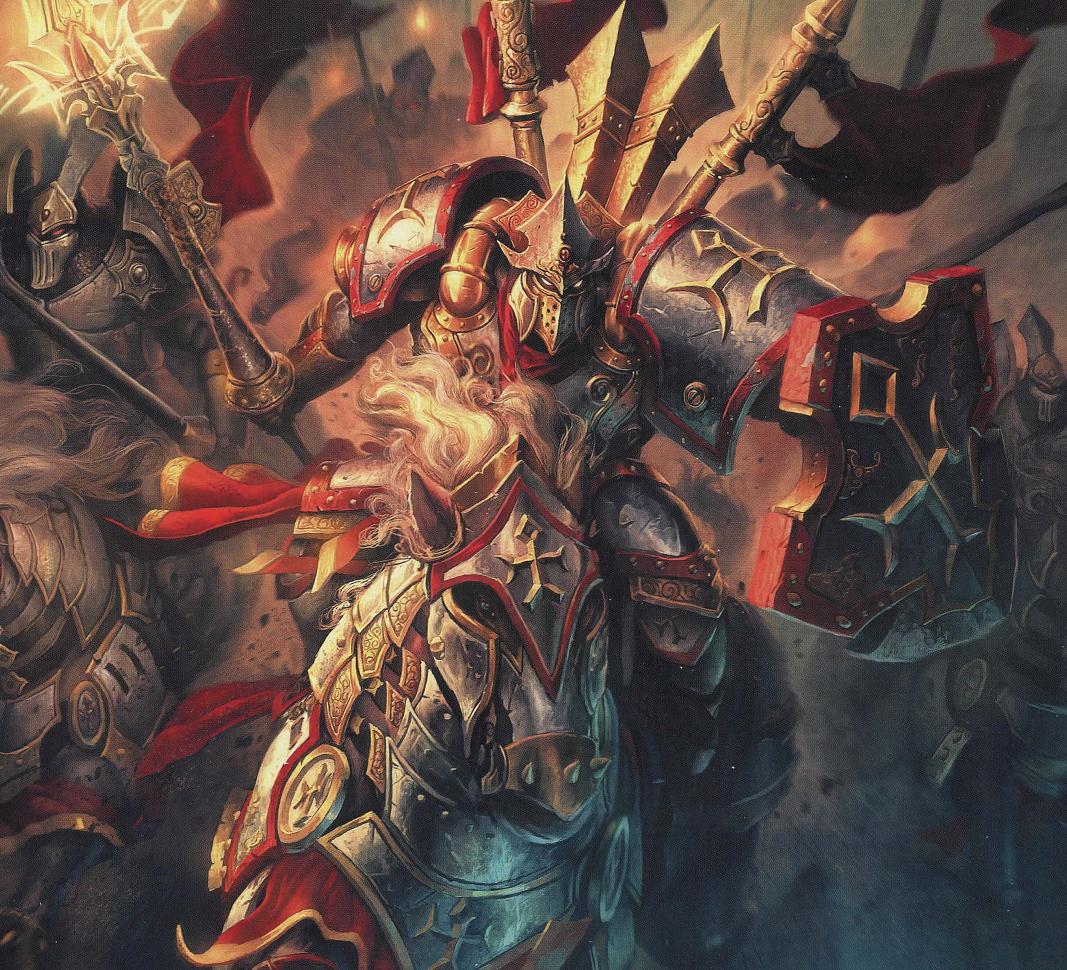
Intercessor Kreoss is the second Epic Kreoss, and I believe the first mounted warcaster. He is the mightiest crusader of the Protectorate, and now that he is intercessor, he leads the greatest army of the faithful ever gathered. After Voyle's death, he led the Northern Crusade in the stead of Severius. His compassion and resolve made him popular even beyond the Exemplars, and his sense of honor has never interfered with his loyalty. He is a pillar of the hierarhc. After his return to Leryn from the defense of Menite temples in Llael, Severius gathered the Northern Crusade to witness Kreoss' elevation to intercessor, a long unused title that demonstrates his implicit trust in Kreoss, who may now act on his behalf. If Severius dies, Kreoss has the futy of maintaining the stability of the Protectorate by keeping the martial orders from turning on each other and ensuring the Great Crusades continue and the theocracy remains unified at any cost. Even with his tactical brilliance, Kreoss prefers to lead personally from his great steed, Agon, with a handpicked vanguard of Exemplar vengers. He finds the mist critical point, riding to fight there with his spear, Conviction, as Menoth's judgment. His gimmick is troop buffs, and his feat ends enemy magic and lets him cast free spells.
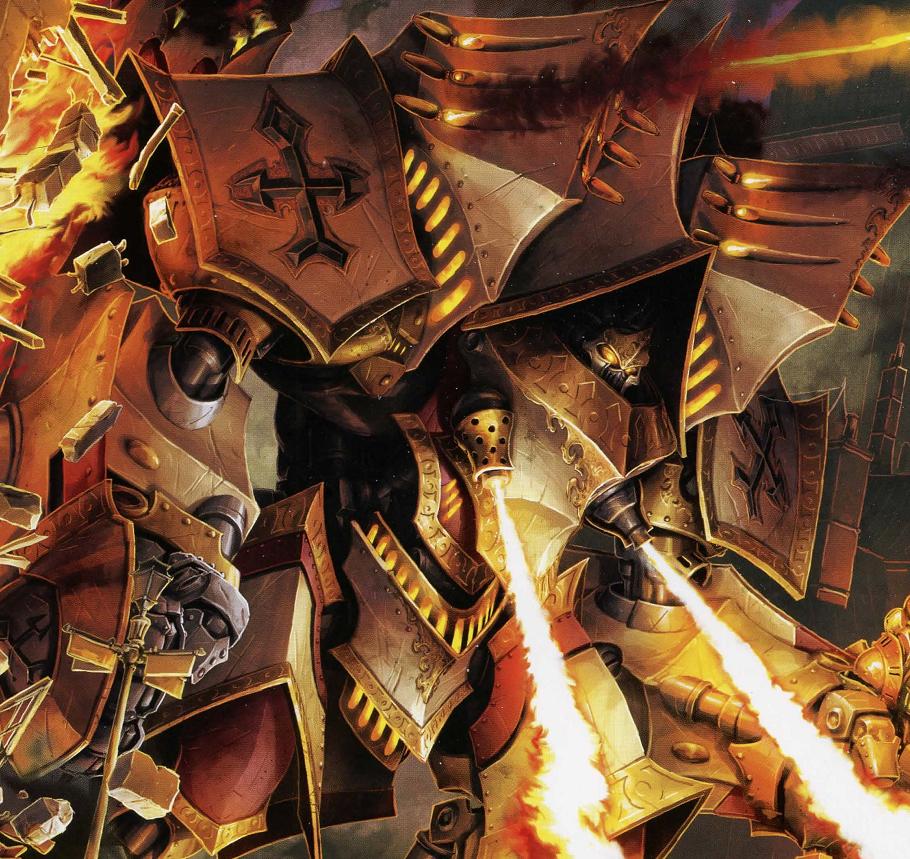
The Judicator stands 34 feet tall and 75 tons. It channels Menoth's wrath into fiery punishment, and every inch of it bears prayers to Menoth - even the rockets it fires. It is slow but unstoppable. The vision that led to its creation came to the Harbinger in the days after the conquest of Leryn. She foresaw a conflict wreathed in smoke and fire, with immense machines bearing enemy banners. Where they fought, the earth was sundered. She knew these machines must be defended against. She communicated her vision to the hierarch, and while the Synod was at first reluctant, Severius understood the seriousness. He had Visgoth Ark Razek and his artificers create the weapons needed, which required the construction of the Foundry of the Sacred Flame. It took endless resources, but the great building was erected east of Imer in mere months. Many laborers died to make it so, and the manufacture of the Judicator began even as the first choirs came to bless the place. The Protectorate lacks the industrial resources of Cygnar or Khador and has fewer mechaniks, so they could not make a colossal-grade cortex similar to those nations'. Instead, they prayed for inspiration. They followed principles developed during the fabrication of the Vessel of Judgment, outfitting the Judicator with a holy reliquary containing the remains of a battle priest, to serve as a divine reservoir. These would be humbler servants of immense loyalty, connected to the cortex by a mechanikal conduit to fill the machine with spiritual power and guide it in battle. While they cannot be made in great numbers, each Judicator can be sent to the battles the Harbinger senses are their destiny, as proof of Menoth's favor. They are too large to be made even inside the Foundry, so the final stages are done outdoors, with choirs singing benedictions as the heartfire is stoked. The shoulders bear dozens of rockets, firing without concern for accuracy. The machine also sprays Menoth's Fury down into trenches and uses its fists to crush what few survivors remain. If innocents die in its wrath, they will find solace in the City of Man.
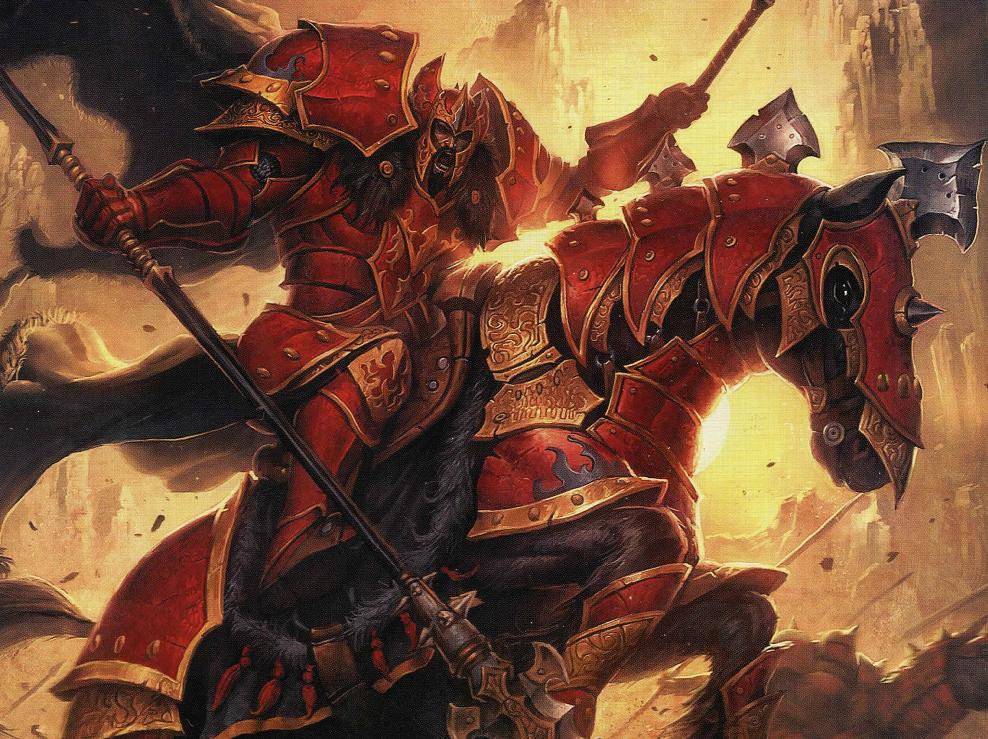
Vladimir Tzepesci, Great Prince of Umbrey is the second Epic Vlad and also the second mounted warcaster. For the first time in generations, he leads the united lands of Umnbrey as rightful lord. He has reclaimed his family birthright, wielding the weapons of the ancient Tzepesci horselords. While the Umbrean lands have been Khadoran since the conquest of Llael, their fate was uncertain. Many nobles and kayazy wanted them, but Vladimir persisted even as he fought for Ayn Vanar. He won the loyalty of all Umbreans under him, Khadoran or Llaelese. Em,press Vanar declared that any noble who would be considered for Umbrey lands must fight to defend them against enemies. Only Vladimir would risk his life against Cryx and the Sul-Menites, and so by her decree, the stwo smaller volozkya and the Llaelese duchy that had once been Umbrey were joined into one volozkya of great size, beholden to Tzepesci. He defended Umbrey virtually alone, and if he failed, he alone would bear the shame. He has gathered his vassals and a great Umbrean army for the job, and his soldiers know they fight for their own destiny as well as their families and lands. Vladimir rides his warhorse, Vsada, at the head of an elite guard of heavy cavalry, wielding the weapons of his ancient namesake, who united Umbrey four centuries ago. He wields a hunting spear in one hand and the mace Huntsman in the other, using dark sorcery in abttle to secure his ancient birthright. His gimmick is speed and mobility contorl, and his feat boosts warjack and cavalry modbility.
Next time: No, we didn't take a right turn into 40K, I swear.
Warmachine: Colossals
Original SA post Warmachine: Colossals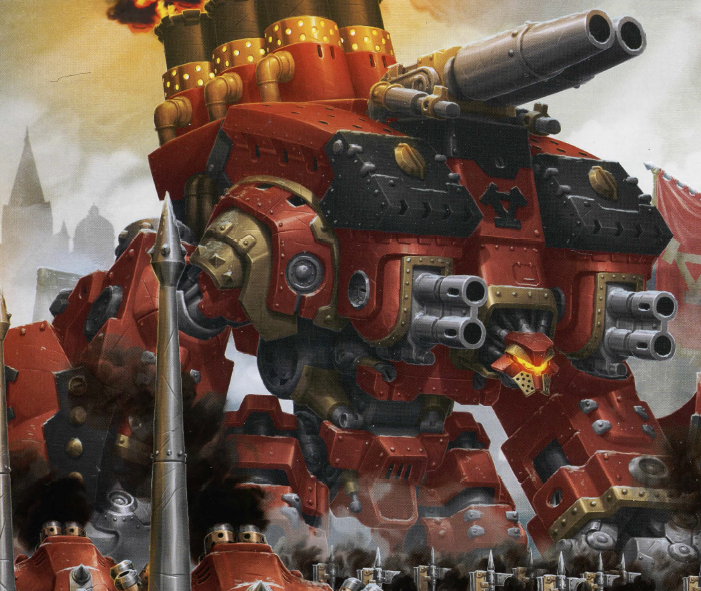
The Conquest is 31 feet tall and nearly 101 tons. It is a mountain of steel, covered in powerful weapons. It is slow, thanks to its vast amounts of armor, but it has more firepower than an artillery battery. It began as a triumph of the Prikaz Chancellory, whose agents discovered the Cygnaran Stormwall project. The schematics were found and brought to Grand Vizier Simonyev Blaustavya, who realized that a new colossal was under construction. It took little for him to convince the supreme kommandants and the Empress to build one of their own, before cygnar could complete theirs. Plans for Conquest were prepared in a matter of weeks, using all the political clout the Vizier and Empress had to stop any opposition. The Greylords Covenant, Khadoran Mechaniks Assembly and several kayazy vied for recognition in supporting the project, and while all received some credit, the KMA was ultimately recognized as the main architect, largely due to Blaustavya. He arranged for the parts to be made in many factories at once, most notably in Ohk, Khardov and Korsk. He also modified the arcanum supernum cortex to account for Khador's lack of rare metals, making it less sophisticated but much cheaper and faster to build. The trick was making weapons potent enough without needing the same degree of cortex sophistication. Ultimately, the mechaniks used the same principal as the Khadoran ironhull naval guns, whose turrets fired in tandem, using recoil to load each other. This proved crucial in the design of the main guns, as it meant the cortex didn't need to regulate reloads. These guns were supplemented by two sets of twin-linked cannons on the shoulders, able to lay down a heavy barrage with a high rate of fire. It became clear quickly that materials would be a problem, and thousands went without coal that winter to see Conquest finished. Hundreds died, but it was a necessary sacrifice. And it did pay off - the first operational Conquest was finished weeks before the first Stormwall. It was deployed to the front lines, bringing unrivaled firepower. Of course, it also takes unrivaled amounts of coal and water, and often villages will have their entire fuel supplies requisitioned to fuel a Conquest. It's a small price for the dominance of its potent guns.
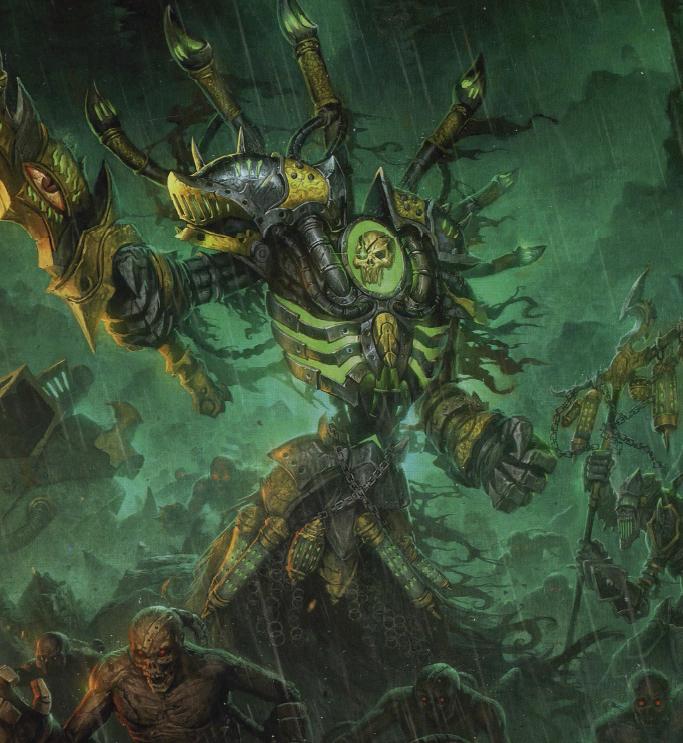
Asphyxious the Hellbringer is never without Vociferon . He's the second Epic Asphyxious, and he's carved out a small subterranean empire as part of his bid to become Toruk's leading general. Even the Cryxian lords that hate him have been forced to ask his aid. Since the moment he became a lich lord, he has tried to become Toruk's greatest servant. Once, he was just a minion to Lich Lord Daeamortus, but now, he shapes Cryx. Even his defeats have advanced him, for he has tenacity and the ability to exploit anything to his advantage. His greatest work is surely the necrofactorium beneath the Thornwood, second only to the capital city of Skell. Thanks to his dark pacts with the cephalyx, Asphyxious has directed the excavations for years now, guiding it to connect to deep, hidden tunnels. What payment the cephalyx have been promised is a mystery still, save for the countless living slaves they've been given. Once the tunnels were done, Asphyxious installed a vast abattoir and factory complex, using the dead of the battlefields to fuel them. The latest of his obstacles was Lich Lord Morbus, who tried to seize control of the necrofactoriums, so Asphyxious got Deneghra to lure him to his final death at the hands of Cygnar, establishing himself as the true master of the Thornwood factories. He will make any sacrifice to further his aims, and he sees getting rid of the inept or incautious as improving Toruk's forces. His work has resulted in the construction of several Krakens, which he will unleash when his enemies think him cornered.
As Toruk's war on the dragons approaches, the other lich lords must make deals with Asphyxious if they want his resources for their armies. The armies of the Thornwood are no mere battalions now - they are great hosts of undead power, meant to weaken dragons that Toruk might consume them. Should the rest of Caen burn, that's just fine. To aid him, Asphyxious has crafted the skarlock Vociferon, a conduit for souls. Vociferon was carefully made and blighted, benefitting from Asphyxious' mastery of the thrall runes. It carries a battle standard of death and decay, collecting souls of all who die near it. It has sanction to speak for Asphyxious and command his forces. Asphyxious' gimmick is magical blasting, and his feat heals him and buffs him when foes use magic.
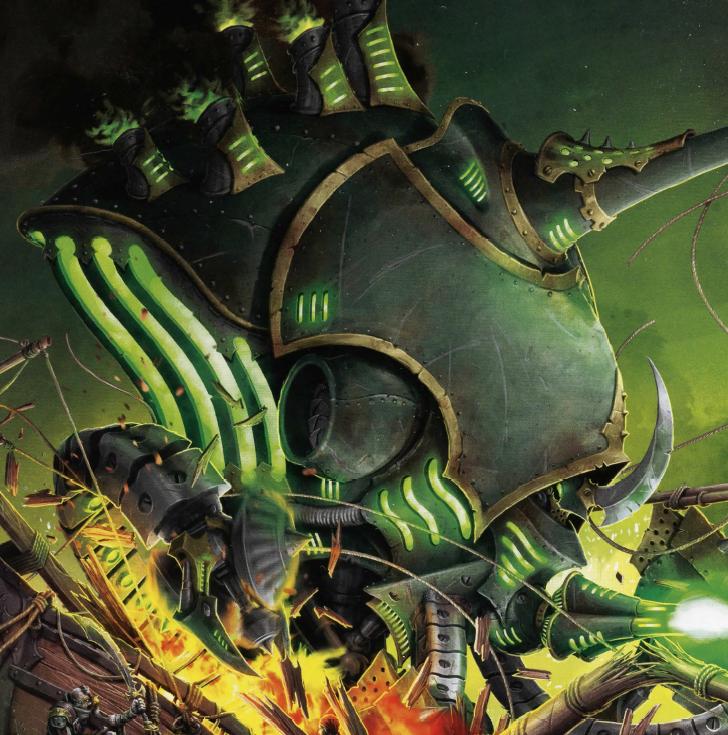
The Kraken stands 27 feet tall and weighs 85 tons. It is one of the most terrifying necromechanikal tools ever seen, using grasping tentacles to snatch up humans and stuff them into its greasy orifices. These captured foes have but a moment of terror before their souls are extracted and their bodies consumed to fuel the machine. Cryx has had the secret of colossals for centuries, using the Kraken very sparingly. The first was built in the decades after the final defeat of the Orgoth, using secrets stolen from dead arcanists and mechaniks. It was designed, however, to be more agile, smaller and better able to traverse terrain than other colossals of the time, innovations centuries ahead of the mainland. The use of necrotite as a fuel also drastically reduced the machine's weight, making it surprisingly fast for its size. For centuries, the Kraken was kept secret as part of Toruk's longterm plans. Lich Lord Scopulous, head of the reserve forces, was loath to lend them out at all except for missions of total destruction of isolated targets. More than a few ships thought sunk in storms were, in fact, destroyed by a Kraken's harvest, but witnesses thought they were a kind of sea monster. Now, however, it is time for them to be unveiled. Asphyxious has built several under the Thornwood, and Scopulous has finally relented and allowed his Krakens to be deployed. It uses its long hellblaster cannon to tear holes in the foe, with its flayer cannon cutting down any survivors as it comes forward to grab new prey or tear apart warjacks with its tendrils. Not every victim it consumes dies immediately, however - an unlucky few are kept alive to be returned to the machine's dark masters.
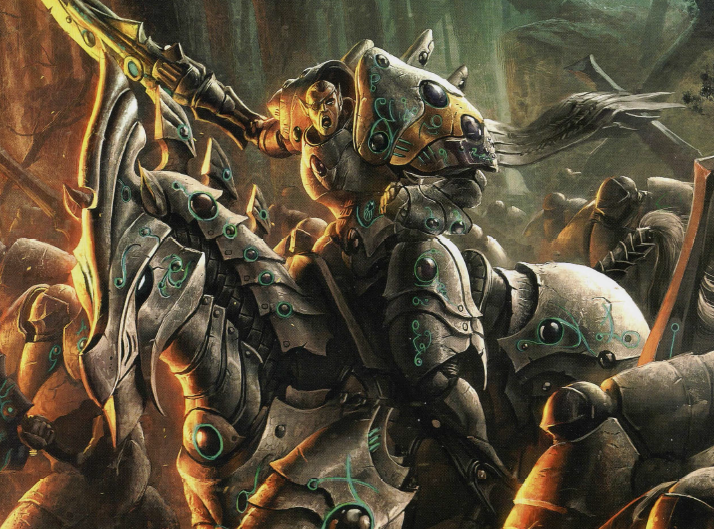
Vyros, Incissar of the Dawnguard is Epic Vyros. He has given his people new hope and the greatest victory they have ever had, punishing those who would defile the gods and freeing Nyssor. He has downplayed the work of House Ossyan in this, becoming the hero of the hour. The hallytyr gave him the honor of overseeing the rites to inter Nyssor within the fane beneath Iryss, once Scyrah's original fane. Precisely what his return means is uncertain, but it's proven that the Retribution delivers on its promises. Consul Calcyr Nyarr has formally given up all military leadership to Vyros - mostly symbolic, since Vyros was already doing that, but still. His growing political power is facilitating his work for the Retribution, and he is already planning the next attack. That the Retribution is now blatantly using Hyperions is due to his status as well as the cooperation between Houses Nyarr and Shyeel. These colossals, once used only to defend the borders, now prepare for war. The Dawnguard enjoy increased standing as the backbone of the heavy infantry under Vyros' command. He leads from his mount, Solarys, and to the Iosans, he is unstoppable. His gimmick is buffs, and his feat lets him move his units around when his allies die.
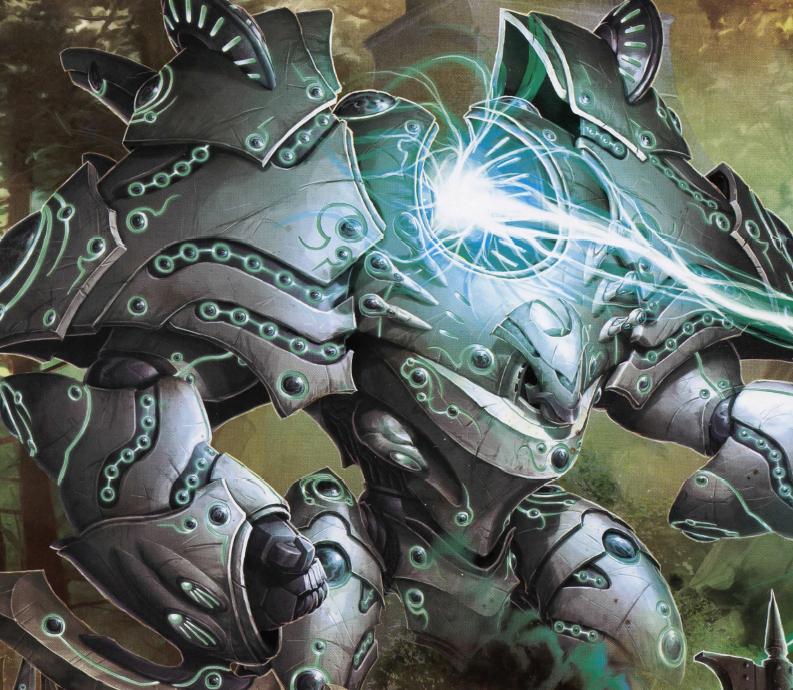
The Hyperion is 30 and a half feet tall and weighs 66 tons. It is the most potent weapon ever made by Ios. It uses its thresher cannons and bladed fists to clear a path to heavily armored foes or entrenchments, and few have survived what comes next. The field generator gathers power with an eerie whine, and just before the starburst cannon fires, all sound suddenly ceases entirely. A discharge of warped energy emanates from the chassis, too fast to spot. The blinding sphere it causes eventually fades into a zone of total annihilation, having erased everything within it from existence. These machines were made centuries ago, to fight the dragon Ethrunbal. Thousands died before it could be subdued, and the city of Issyrah was abandoned. House Shyeel developed a new weapon in case a dragon ever again threatened Ios. It required countless experiments with unconventional energies, and it was found that the fundamental forces of nature could be altered to produce immense force using energies related to those with which the gods forged the stars. The earliest successes were too large to go in any myrmidon, and it took decades to make smaller constructs that could use this energy. After the first test, one of the designers is said to have been so shaken he wanted to abandon the project entirely, and he was quietly retired from public view. The chassis and hull were built in tandem with the final stages of the starburst cannon, as they had to be large enough to accomodate the generators needed to power the machine and manipulate the protective field into the starburst effect. Given the totality with which the cannon used the generators, it was decided that it also needed an independent weapons system. The thresher cannons, unlike most Shyeel weapons, fire kinetic projectiles similar to normal firearms. Several Hyperions were built, but they were kept in reserve, deployed only in the final days of the War of the Houses against House Vyre. They ended the war, but at the cost of several ancient buildings and hundreds of civilian lives. Those that survived the blasts were left crippled, as any flesh caught in them ceased to exist. The use of starburst technology within Ios was forbidden after that, and the Hyperions were deployed at the border. Now that the Retribution is taking power, legal shackles have fallen away. Vyros took the Hyperions from the borders to fight for the Retribution, and the hallytyr consuls were forced not to object, due to the liberation of Nyssor.
Next time: Mercenaries
Warmachine: Colossals
Original SA post Warmachine: Colossals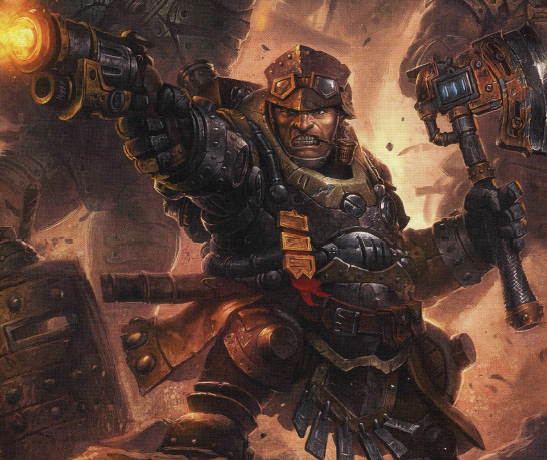
General Ossrum Dhurg is a brilliant leader who fears only that his death will not be in battle. He'll work for Cygnar, Khador or the Protectorate of Menoth. In his prime, he earned fame for his improvisation and adaptability over time-honored tactics, preferring to take the fight to the enemy and choose his ground. His men both respect and adore him, because he never asks them to do what he would not do himself. He was born to the Great Clan Dhurg, one of the thirteen founding clans of Rhul, and was always a professional soldier. Eventually, he rose to command of Hammerfall Fortress, distinguishing himself by beating back Khadoran incursions. His disdain for traditional tactics and preference for boldness meant his reputation was mixed, with his juniors admiring him but often his superiors got annoyed him. Still, the Dhurg stone lord took notice, awarding him the title of general, which did not help the animosity of other clan lords. As he has grown old, he sees his best chance for glory in the wars of humans. The money matters little - it all goes back to Clan Dhurg anyway. Ossrum continually checks his forces to ensure they remain fit and well taken care of, and anyone hiring him is getting an army equal to any in Immoren. His gimmick is ranged combat buffs, and his feat boosts Rhulic armor and speed.
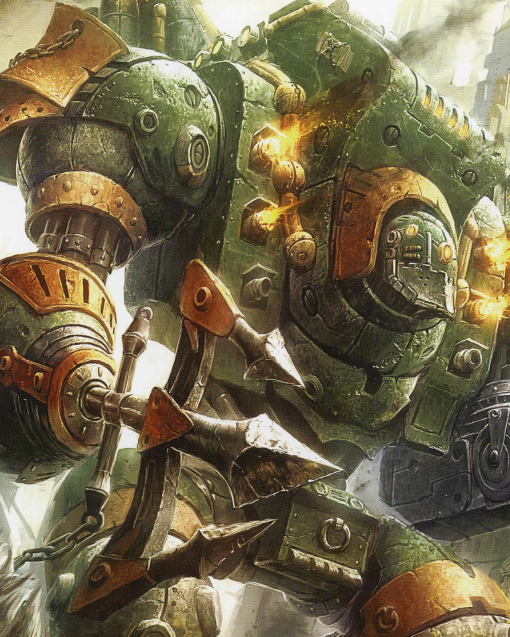
The Galleon is 33 feet tall and 71 tons. It is a naval ironhull on legs, with cannons comparable to a small ship. Its cannonfire ceases only when it uses its immense cargo claw to toss warjacks like rag dolls or when it fires its trident to reel in foes. It's a very expensive machine, but for the mercenaries that can afford it, it's well worth it. Only Black Anchor Heavy Industries could hope to make it, costing them immense resources, man-hours and the work of many skilled mechaniks. Originally Black Anchor Shipwrights, they were based out of the Cygnaran city of Clockers Cove decades ago, making hybrid sail/steamships. They soon got talented and ambitious mechaniks, including Steam and Iron Worker Union members who'd worked for the Cygnaran Armory, Engines West and Rohannor Steamworks. They got a reputation among merchants and privateers for solving engineering challenges and producing blockade-runners, built for speed but also heavily armed. Clockers Cove, a relatively lawless port, was the perfect staging ground for their work, and they made a lot of money for their discretion, serving clients like Bartolo Montador. Their refit of the Calamitas paved the way for their next big project. Their facilities grew, and they expanded into repairing steamjacks and outfitting labor 'jacks with weapons. Soon, the warjack side of the business became dominant, and they renamed themselves to reflect the new focus. Their competence got them several backers, including wealthy Ordic houses, so they began truly ambitious projects. They learned of the colossals being made in Khador and Cygnar, and they decided to take a gamble and see if they could make their own - the most ambitious project ever done by a private interest. They refitted an entire drydock to do it, making arrangements with the Fraternal Order of Wizardry to get a limited run of oversized arcanum cortexes, normally used for heavy 'jacks. They used their experience with maritime engineering to outfit the Galleon, and its guns are identical in weight to those used on Black Anchor frigates, while the heavy trident shares design elements with the harpoon cannons of commercial whalers. Since their first test run, they've drawn some attention from groups like the Cygnaran Reconnaissance Service, who spotted the first Galleon being loaded onto an Ordic vessel connected to the Four Star Syndicate.
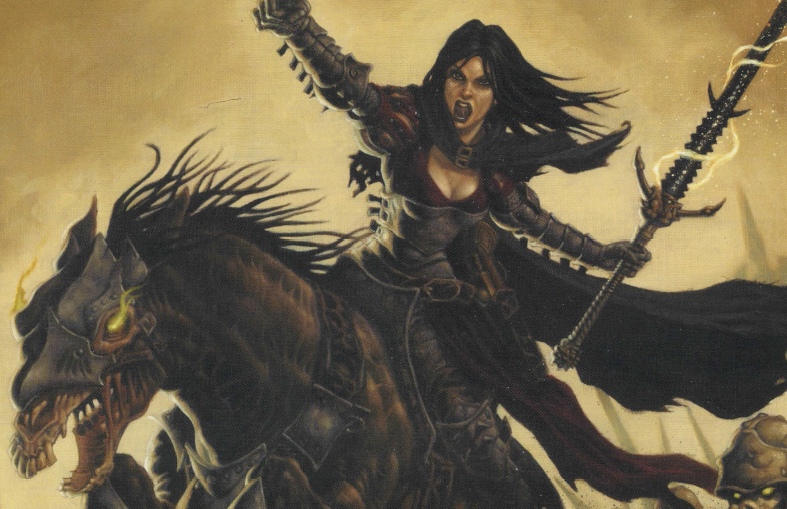
Alexia, Mistress of the Witchfire is Epic Alexia. She'll work for Cygnar or Khador, but not in any force containing Morrowans. Alexia Ciannor's name is known across the Iron Kingdoms, renowned for her pitiless fighting, her blasphemy and her immense sorcerous power. Where she goes, chaos follows, and those she helps fear her as much as those she fights. Her mastery of Witchfire's power has increased in a scant few years, and now the dead gladly rise to serve her will. Since the Longest Night of 603 AR, her infamy has only grown. Those few who knew her before say she's grown even madder, haunted by the ghost of her mother and her coven, and perhaps even more ghosts who died by Witchfire's blade. Her motives have grown less comprehensible as she makes her way across the land, mounted on an undead steed. She just appears before battles, joining the fight for no clear reason, taking sides for no clear reason, and taking her pay in coin and corpses. To what end she raises her thralls for is unclear, but it's clear that either her mastery of Witchfire has grown...or perhaps its mastery of her. The Morrowan priests and witch hunters who follow her trail have begun to wonder if, perhaps, she is part of some greater design, if her desire to resurrect her mother is just a diversion in some game in which Alexia is but a pawn.
The End!
Next time: Gargantuans.
Hordes: Gargantuans
Original SA post Hordes: Gargantuans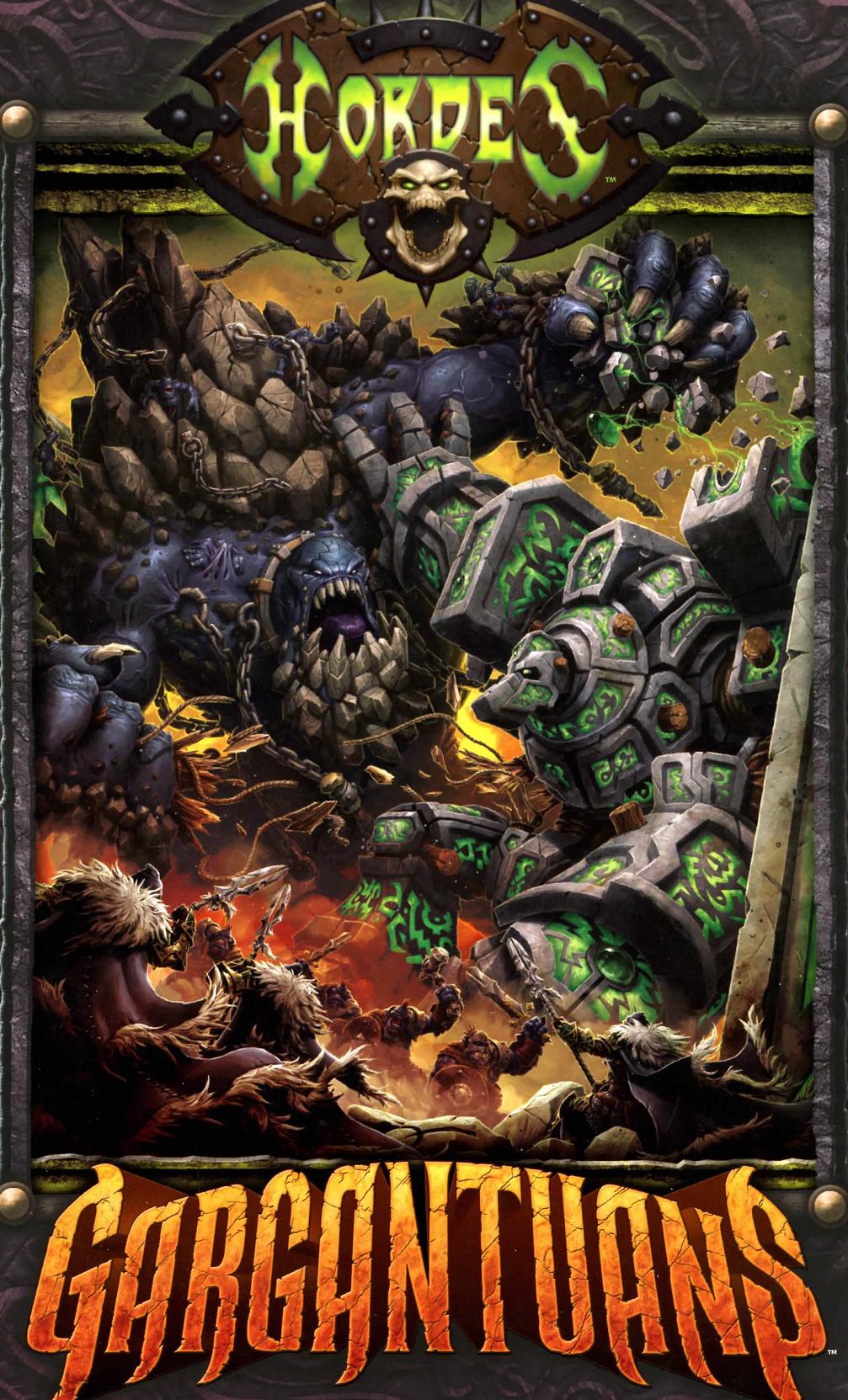
Gargantuans is the Hordes version of Colossals. A Gargantuan is a Colossal except a warbeast, basically. We also get introduced to Warlock Units - basically, a warlock that comes with a handful of other guys that hang around them, are fearless and are considered part of their battlegroup, which normally applies only to warbeasts.
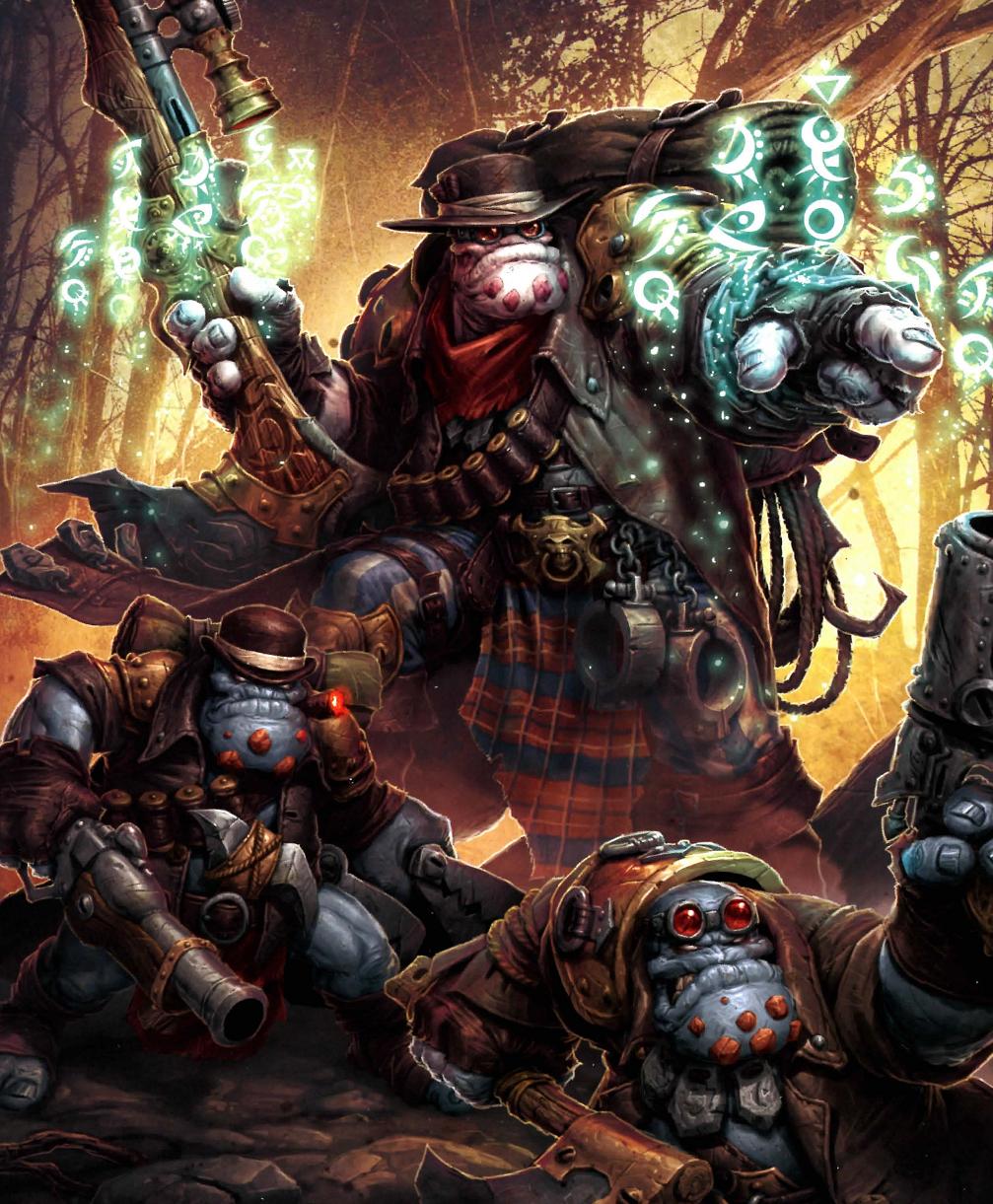
The Hunters Grim are the first warlock unit, consisting of Epic Grim Angus and his two pyg buddies, Muggs and Krump. Angus is one of the best trackers in the world, and he works to eliminate the scouts and spies of the enemies of the kriels. When Ironhide or Grissel Bloodsong need something done in the most remote regions, they turn to Angus, who will do anything to get the job done. His responsibilities have expanded as the leaders of the united kriels see his true value, and he gets along especially well with Madrak and Grissel. He remains an outsider, however, a fact he embraces. It is his outside perspective, after all, that makes him especially valuable to those that listen to his opinions. He has no interest in staying with kin beyond those who can survive in the wilds and keep their mouths shut. He's especially fond of pygs, as they don't talk much and understand that survival means looking out for each other. Ultimately, Grim's pragmatic. He's worked very closely with griseel in protecting the kriels, and he understands what it takes to survive. Ancient myths like those that surround Madrak and Doomshaper just don't matter to him.
Grim is assisted at all times by the core of his team, Muggs and Krump. They are clever, cunning hunters who have learned Grim's system of hand signs, fighting easily even in total silence. They have passed their expertise on to other pygs in the hunting band and are good at keeping them in line so Grim can focus on the job. Both pygs are great assets, trusted with many vital tasks, including hunting, skinning, cooking, maintaing equipment and even doing simple weapons repair. Grim's taught Muggs how to use his snare gun and gifted it to the pyg, while Krump is a capable snare trapper even mid-battle. Both are extremely courageous, especially for pygs. They are devoted to Grim and occasionally emulate him, especially Muggs, whose devotion can overcome his good sense. He often apes Grim's mannerisms, while Krump is more inclined to seriousness, mirror Grim's quiet intensity. Together, the Hunters Grim are more than the sum of their parts, working together to bring down any target. They are the eyes and ears of the united kriels. The gimmick this time aorund is trapping and stealth, and Grim's feat lets him buff ranged attacks heavily.
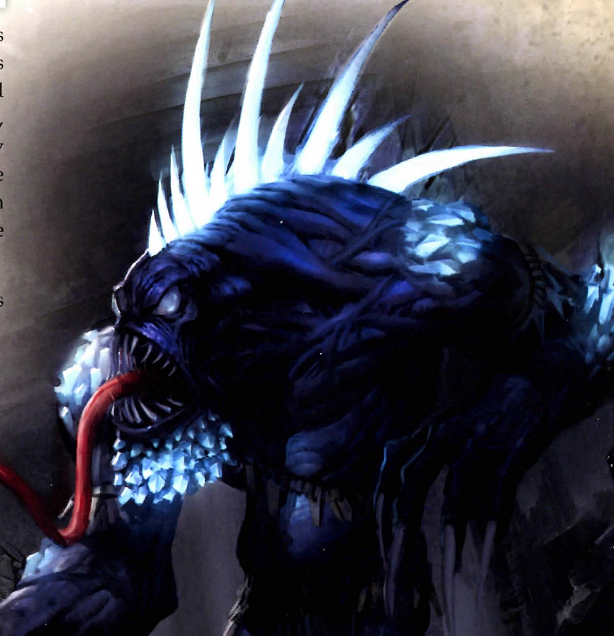
The Night Troll is found in the dark mountains of the Iron Kingdoms, rarely seen but terrifying. Their presence is marked by a glow in a cave mouth, luring in the unwary. They are adapted to life in the dark caverns of the mountains and the tunnels beneath ancinet ruins. Their eyes are atrophied, but all other senses are sharpened. By day, they sleep, awakening at sunset to lurk in the cavern mouths, their quills pulsing with an otherworldly glow to draw in animals and travelers. The mesmerizing patterns of luminescence overcome the instincts of their victims, who approach without care ofr their safety and are consumed alive. Trollkin consider the night trolls valuable, despite their habits being problematic. They are nocturnal, so must be forced to fight in daylight, and they tend to be temperamental about it. Their tempers and hunting methods do make them lethal allies, though, and a foe hypnotized by their light is easily shredded by their venomous, paralyzing claws. And yes, their animus lets them force foes to approach them.
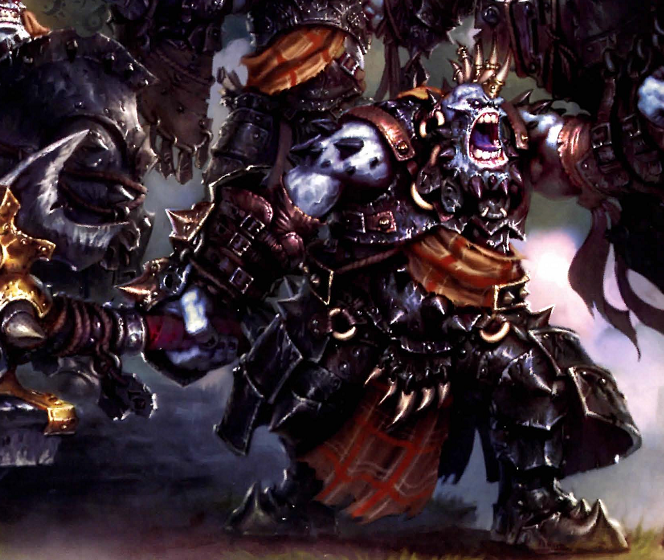
The Trollkin Warders are champions sworn to defend all trollkin, particularly those least able to defend themselves. They are dedicated by ritual, sharing a deep bond, and they never leave a comrade behind. To harm one enrages all. Not all champions have the restraint needed to become warders, but those who see greater honor in defending against a terrible foe embrace the role. They band together with great ceremony, swearing oaths of brotherhood and partaking in the kulgat bond. When they take up arms, they do so with zeal, shouting their oaths and battle cries to challenge any who would harm their kin, patron or fellow warriors.
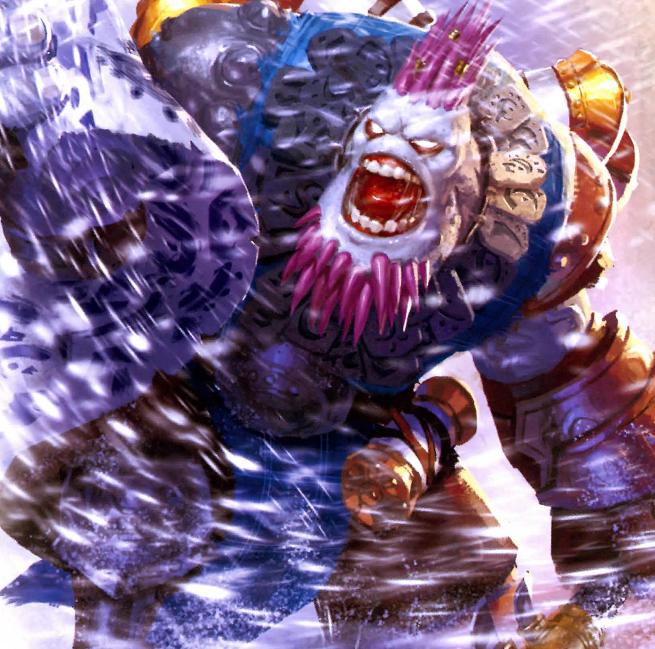
A Trollkin Sorcerer is a warrior as well as a loremaster. They assist their fellows in battle with their magic, marching with them to protect them from other wizards or to hurl elemental power. Most are recognized at birth by their white skin and red eyes, as most sorcerers are albinos. The shamans say that Dhunia marks them so they may be raised with the strength of character needed to wield their power responsibly. Though most sorcerers are instructed by their elders, their power ultimately comes from within and is usually associated with the leements around their region of birth, often the cold winds of winter, which can be used both to attack and defend.
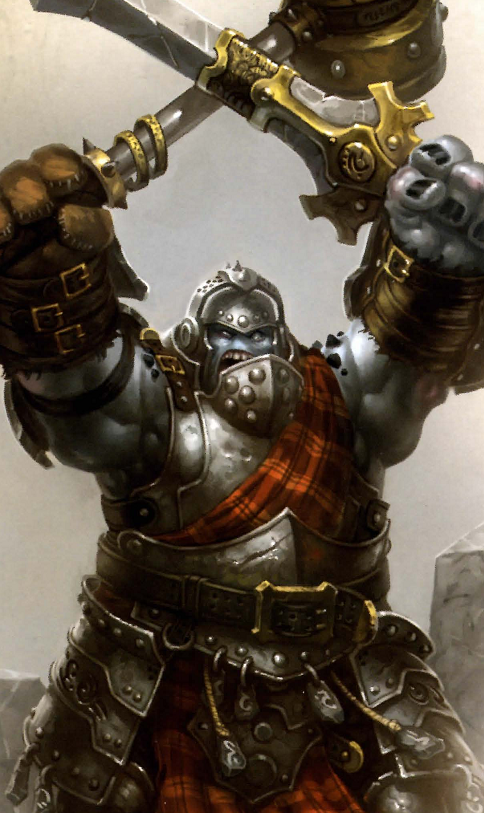
A Fennblade Kithkar is always a veteran of many battles, leading the Fennblades to victory again and again. They are brilliant commanders, able to coordinate their fellows with immense precision, and a band of Fennblades led by a kithkar fights with the discipline of a trained unit and the heart of legendary warriors. Still, even with these leadership skills, it is their bond with the Fennblades that is their best weapon. They have often fought with their bands for years, knowing each as well or better than their families. They can anticipate the actions of these warriors, trusting them with their own lives. The Fennblades obey their kithkars without question, trusting them to lead to victory without unneeded losses. They know that if one of them dies, nothing can stop the kithkar's vengeance.
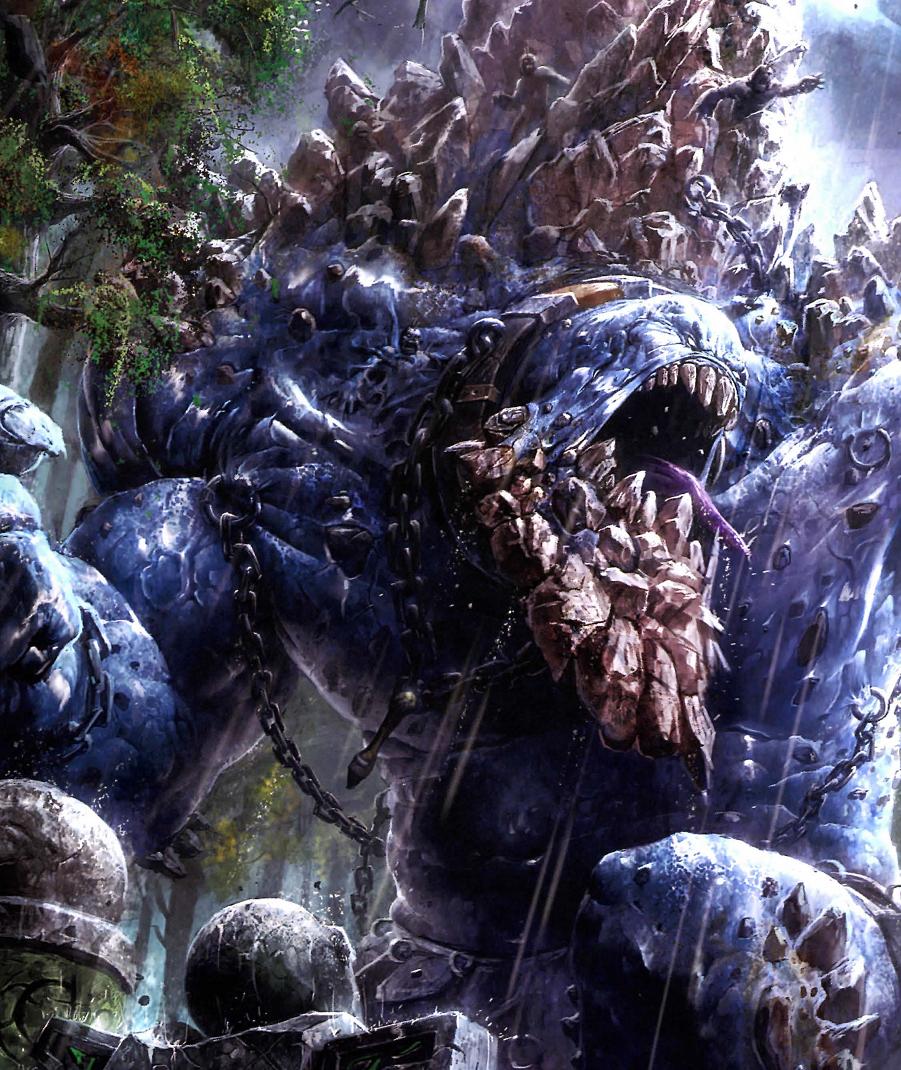
A Mountain King is the purest essence of troll: hunger, rage and primal strength. They shake the ground with their tread and shatter stone with but a roar. They walk Caen once more after millennia of sleep, seeking to satisfy their unending hungers. Troolkin legend describes them fearfully and with reverence. These tales come from long before the Molgur and the learning of the runes, from a time of plenty for the trollkin. They respected and feared the trolls, and they kept their distance from the mountain kings, the greatest of trolls, ancient already in those long-forgotten days. The stories say these destructive, terrible mountain kings were the first trolls to emerge from the earth, given life by the violent joining of Dhunia and the Devourer Wurm. They kept to the mountains, far from where the trollkin settled at first. In time, however, they spread, intruding on mountain king territory. This enraged the kings beyond all comprehension. They incited each other with furious howls, and even the most remote came forth to kill. They smashed and devoured all in their path, their hunger destroying any sense of kinship. Trollkin myth suggests that the Gnarls and Thornwood were once one immense forest until the mountain kings stripped the region between them bear of every bit of life, every animal, every stone and every tree. The trollkin saw that these great trolls would devour not only them, but all the world. An ancient epic talks of a gathering of great chieftains, warriors and shamans who sought a way to subdue the kings. They succeeded, but the means they used are poorly recorded and even more poorly understood. What is known is that the shamans found a way to forge spiritual chains to restrain these beasts, entombing them in their peaks. Many died to bring them to these barrows, marking them with great rune-covered stones as a warning to future generations not to disturb them. At first, the kings stormed beneath the soil, consuming stones and causing earthquakes as they struggled against their chains. Eventually, they fell into a restless sleep, dreaming of hunting and food. When they stirred, avalanches plagued the slopes. Sleep was their only escape from hunger. As time passed, they faded into myth. Few trollkin believed they existed, and it was not proven until, in desperation, Madrak Ironhide and Hoarluk Doomshaper sought to harness their might. It was at no small cost, but they succeeded, reawakening the first mountain kings and bringing them down, out of the Wyrmwall, to satisfy their hungers. Doomshaper speaks of other mountain kings to free, but the trollkin struggle to control those they already have. They make little distinction between friend and foe, and even the best shamans must be careful, using the enchanted chains that still dangle from the forms to keep them from eating everything between battles. They are primeval beasts, so tied to the essence of creation that their very flesh continuously spawns whelps, which they ignore until they are too hungry. A mountain king is a terrifying creature, with a fathomless urge to consume, an urge that grows ever stronger as they are injured. Even the trollkin find them terrible to behold, wondering at the price they have paid to survive. Their animus boosts special attacks.
Next time: For once, the Circle is less destructive and terrifying than that.
Hordes: Gargantuans
Original SA post Hordes: Gargantuans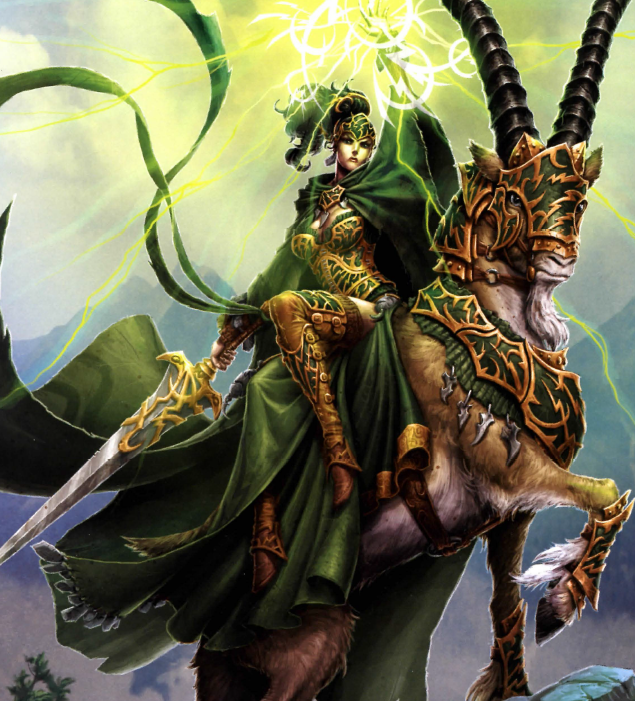
Morvahna the Dawnshadow is Epic Morvahna. she stands on the balance of light and darkness, between life and death, to oversee nature's cycles. More than most, she understands blood magic and sacrifice. She is one of the shrewdest of the Circle, with great influence over others. Some of her rivals cannot see past her ambition, but she has devoted her life to destroying the Circle's foes - especially the Legion of Everblight. Her machinations have suffered by her inability to eliminate her main rival, Krueger the Stormlord, but that has only made her adapt to new tactics. She has seen how infighting divides the Circle, and so she has shifted to subtler means, coordinating attacks on the Legion. While her ambition remains, she now takes on alliances she would never have considered before. She rides into battle atop a Skirovik mountain goat, wielding the power of blood. Her gimmick is debuffs and using her own life as a resource. Her feat allows her to hurt herself in order to resurrect allied troops.
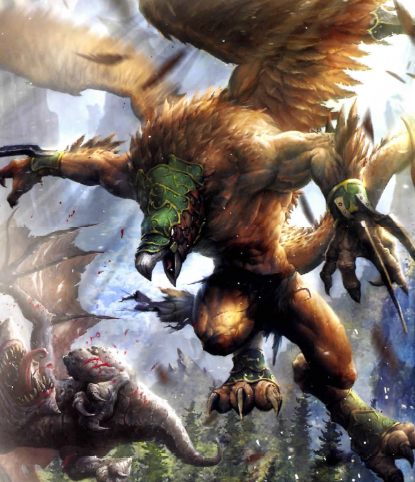
The Razorwing Griffon dives into the enemy from the sky, like a thresher upon a field of grain. The master beast handlers of the Circle spend years training them before the blades are strapped to their limbs. Griffons are naturally disobedient beasts, and a druid training them must be patient and tough. Once they're certain the training has taken, they arm the griffons with resilient metal blades on their leading feathers and gauntlets over their natural claws. The final lessons are not easy, as the griffon must go against its hunting instincts. They naturally want to dive and grab prey, not sweep across the ground cutting it down. They are taught to expect fresh kills as rewards after battle, with better food the more foes they kill. Their animus boosts special attacks.
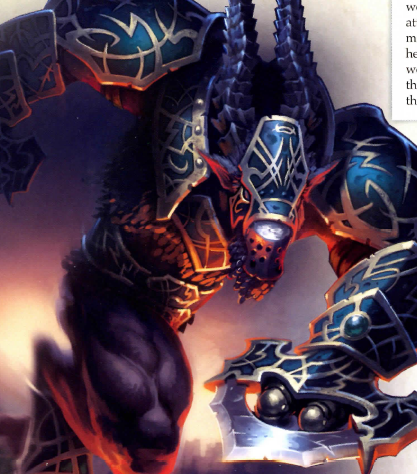
The Rip Horn Satyr is an intimidating, vicious beast, more cunning than other satyrs but no less fierce. They close quickly with foes, smashing into their lines, then brutally attack with their bladed gauntlets for any survivors. Relatively few rip horns exist in the wilds compared to other satyr breeds. They are able to use simple tools and build crude structures, and the druids see them as highly intelligent by satyr standards. They are chosen to accompany druids to war, given simple bladed gauntlets and taught to use them over the mere brute force that most satyrs prefer. While they learn well, their natural stubbornness and belligerence can be problems. However, the druids are careful never to breed those traits out, as the rip horns are valued not only for their cunning but their easy violence.
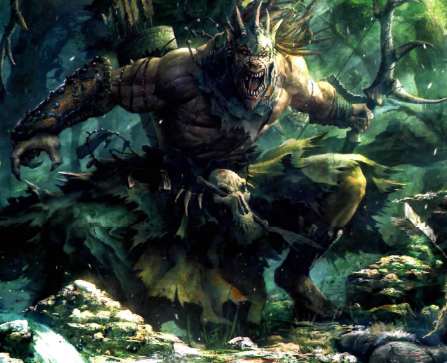
A Tharn Blood Pack is a band of the cruelest Tharn warriors, who range far ahead of the main attack. They move easily through any foliage despite their immense size, taking aim with bows too large for any normal human. They fire arrows the size of small javelins, silently choosing their victims and moving between them with ease. Like all Tharn, they revere the Devourer Wurm, and their hunts are ritual sacrifices. They shed their own blood before battle, chanting oaths to dedicate it to the Wurm, and they relish the fear of their prey, sadistically gloating over their kills.
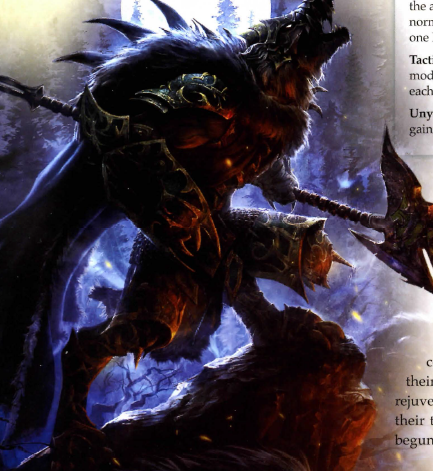
A Warpborn Alpha will sometimes lead the skinwalkers. They are ravenous, brutal fighters who feast on their foes. The warpborn follow them without hesitation, knowing they will find either victory or glorious death. Few skinwalkers live long enough to become alphas, but those that do tend to survive for years, even decades. They kill in the name of the Wurm, and songs are sung in their names. They must always be ready to prove their strength in honorable combat, and they are able to unleash terrifying howls to inspire their fellow hunters. The constant testing makes sure they are respected and strong. They wield their axes with terrifying speed, cutting down anyone nearby and slaking their thirst in blood.
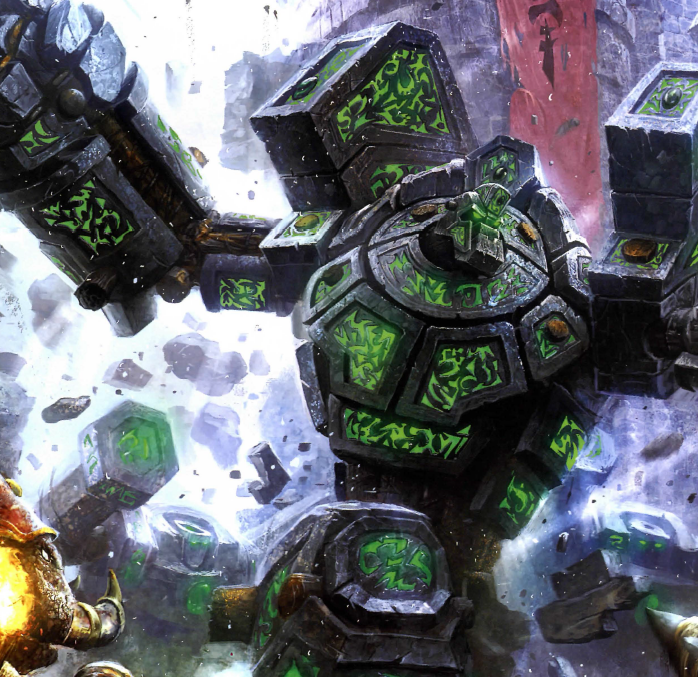
A Woldwrath is one of the greatest weapons of the Circle. They are towering monuments to the genius of the woldcrafters, tapping into the fury of Orboros. They are raised to life by bloody rituals atop massive leyline conjunctions, channeling the vast energies in the earth. Their attacks are presaged by voltaic energies in the clouds and along the runes they bear, and the aftermath of their storms leaves their foes charred and broken. The art of the wold was perfected millenia ago, but the first woldwraths were not made until Toruk was driven to the Scharde. Before then, the Circle controlled the islands, using them as part of the ley line network. The speed with which they were destroyed led to the development of the woldwraths. They not only siphon ley power, but store it in reserve to be used against the foe. They were meant to fight dragons, and only a handful were made. When the Orgoth came, the blackclads were not ready, seeking to avoid them whenever possible, but the Orgoth sought out their sites for their own dark rituals. The woldwraths were useful in these unrecorded battles, particularly at Nine Stones, in what would become Cygnar, where five woldwraths fought an entire Orgoth army. They ultimately lost, however, and many sites were taken. When the Orgoth began to weaken, the woldwraths were again fielded against them, taking back the lost sites. Now, they are needed once more. Old ones are being reactivated, and new ones made. Like all wolds, the rituals are exacting and tremendous power is needed. The wood and stone used to make them must be imbued with living blood at a major nexus during a key astronomical conjunction, and fresh blood is harvested from battles for this purpose. Once given the semblance of sentience, they serve as mobile standing stones to help facilitate the use of ley lines as well as terrible foes in battle, discharging lightning so greatly that they cause thunderstorms.
Next time: the Skorne get a puppy!
Hordes: Gargantuans
Original SA post Hordes: Gargantuans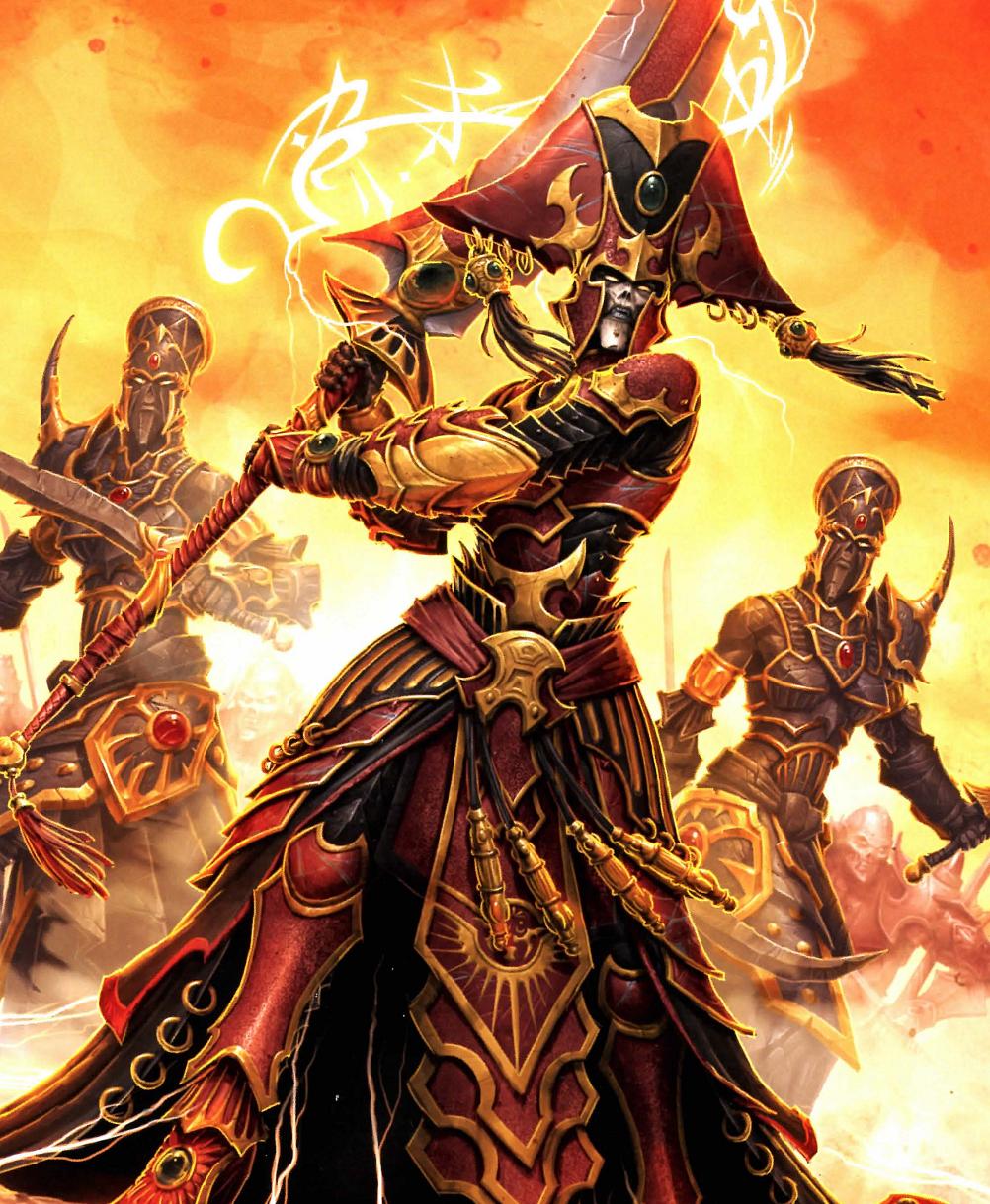
Makeda and the Exalted Court are the second Epic Makeda, a warlock unit. After seizing the throne, Makeda formalized her rule at the Abyssal Fortress, summoning the greatest leaders of the empire to attend her. She knew she must demonstrate strength and tradition. To signify that she was now more than just head of House Balaash, she set aside her house weapons, the swords of Balaash. Only a weapon of immense power could take their place, however, and in all the empire, there was but one: the Talon of Murzoul. Makeda commanded it be brought west to her. The weapon itself is the most ancient of the skorne, connected to the first archdominar, over four thousand years ago. The exalted Murzoul brought the skorne together in their first city, Malphas, beneath the Shroudfalls. Even then, the sword was a relic of power and signifiance, its blade taken from the Lyossan ruins near the Abyss, finer than any that the skorne could forge. When Murzoul received exaltation on his death, his sacral stone was placed in the pommel of the sword, empowering it with his spirit. It was passed down to the archdominars of Malphas ever since, drinking deeply of skorne blood. The current ruler of Malphas instantly surrendered the sword to Makeda in a vow of obedience. She sees it as the perfect weapon to represent her rule.
When the dominars came to see Makeda, they found her escorted by several exalted guardians. She far exceeded her predecessor, calling on the extollers to bring honor to her rule and bloodline. They reviewed the House Balaash stones, selecting the greatest heroes to give new life to as ancestral guardians. These are Makeda's inner guard, tireless and loyal warriors and protectors who accompany her into battle in pairs. Their presence is a tangible sign of ancestral approval. It is said that some of these exalted spoke to the extollers for the first time when given the chance to join Makeda's exalted court, showing an unusual interest in current events, and none can question that Makeda's conquest is not only for the living but the dead, as well. Makeda led her exalted back to the west, assuring her own immortality as an exalted. She embodies skorne history, the hoksune code and the pride of her people, and many hope that as an exalted, she will eventually rule the empire in perpetuity. On her return, Makeda turned the skorne towards their ancient foes: the elves of Ios. Thanks to ancestral prophecies, she knows that their borders are weaker now than they have ever been, as the Iosan forces are busy abroad. This is a great omen and opportunity. Makeda will use all of her power to destroy Ios and render the western nations' power to nothingness.
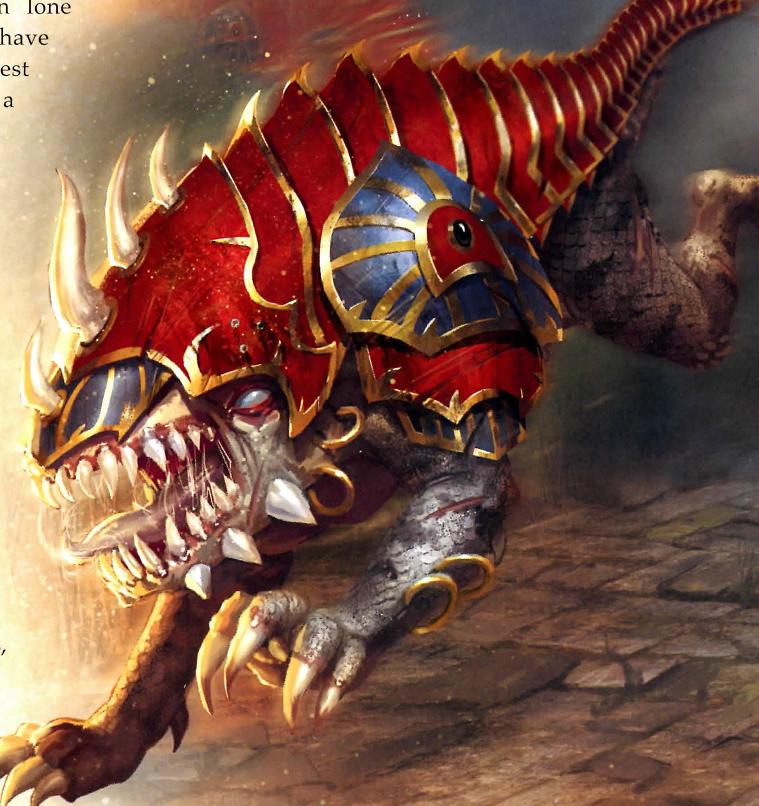
The Reptile Hound is an ancient beast of the skorne, a vicious pack hunter raised by the skorne to fight. They are lesser warbeasts for the skorne. Even the most resilient beasts cannot regenerate faster than reptile hounds can kill them - a pack in concert can swiftly reduce anything to bones. The Bloodstone Marches breed terrifying creatures, and even the smallest are deadly. Reptile hound packs commonly appear in the desert, preying on anything they find. They are popular pets for the skorne as a result of this ferocity, bred both as status symbols and weapons. Their animus allows them to shred through toughness.
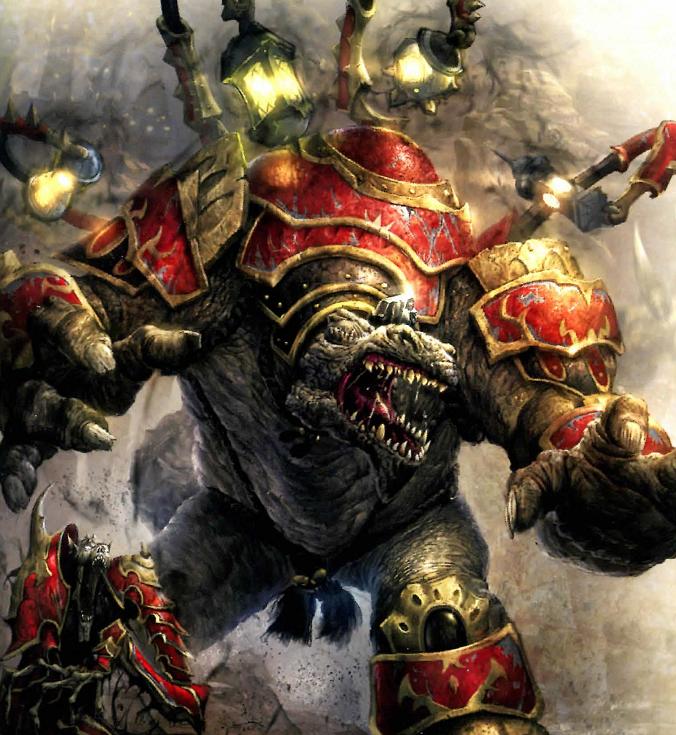
Despoiler is a testament to Mordikaar's mortitheurgical power, as much an implement of the Void as a beast. It is driven mad by the shrieking of the damned, fighting in a frenzy to smash its foes. It doesn't realize that their deaths only fuel the chaos in its mind. It might be taken for a suicidal urge, but Despoiler is dimly aware that death would be no release. It relishes violence for its own sake. Mordikaar has made it into an occult weapon, the focus of a thousand rites to turn it into a gateway to the Void. Its power can fuel magic, and it dwells within the tension between Caen and the Void. Its animus greatly increases the cost of magic near it.
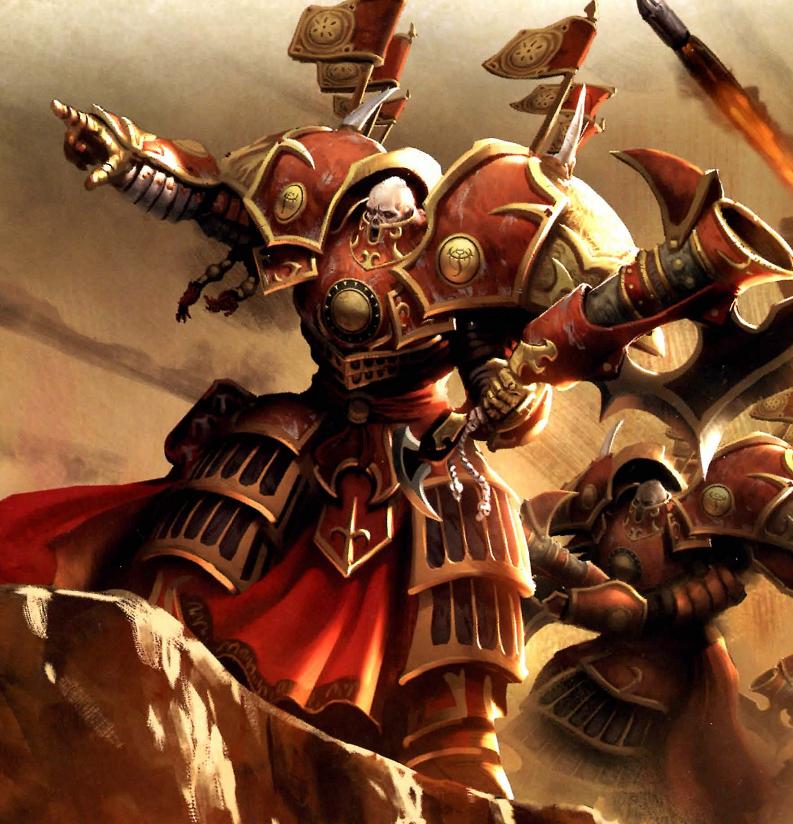
The Cataphract Incindiarii are a recently founded martial discipline. They are patient, opening fire on their foes only when the dakar orders and never before, to maximize destruction. They discharge chymical rockets, which set fire to man and beast alike. Any survivors find themselves cut down by the blades of the master Cataphracts, who exult in the chance to show their understanding of hoksune. Makeda refused to allow tradition to limit victory, adapting the Cataphracts to wield these weapons. The incindus, the weapon is called, designed by skorne chymsits to be worthy of the Cataphracts. Despite their power, many incindiarii still prefer close combat to their use.
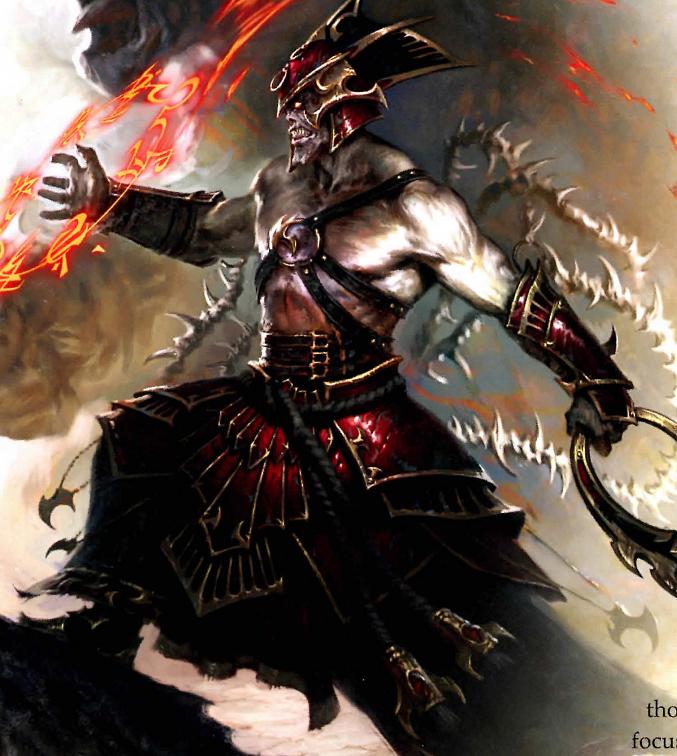
A Morthitheurge Willbreaker is a master of torture and meditation, manipulating the energies of pain and fear. They are able to reach into the minds of others, turning them into pawns. They can very easily turn foes against each other or make them fail to defend themselves. They are the finest mortitheurges in the empire, easily able to manipulate the minds of dull beasts. However, their greatest achievement is in compelling the minds of other people by their understanding of agony. In battle, they hunt for soldiers whose minds are weakened by a narrow focus, leaving them vulnerable. With magic powered by death, they snatch control of the victim's mind, imposing their own will on them.
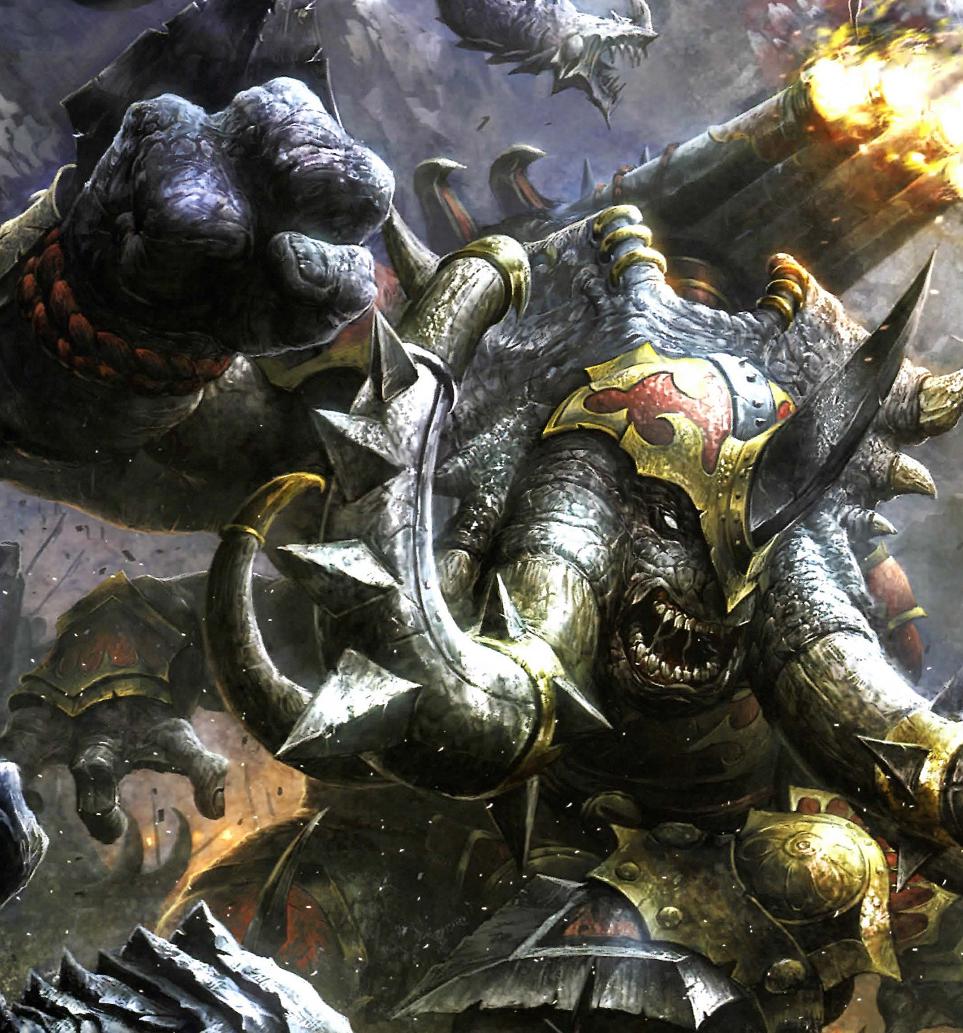
A Mammoth cannot be truly tamed. Even experienced handlers consider their capture to be one of the greatest challenges. Besides raw strength and an ornery nature, they are immensely powerful and tough to wound. They hail from the Valley of Kornash in the Northern Tor, bordered by mountains and the Blasted Desert. It is a relatively lush area, but largely unworked thanks to the mammoth herds and the other creatures of the area. While distant cousins of the smaller titans, they differ in more than just size - most obviously in the form of the immense armored crests growing from their heads. They are believed to have a common ancestor, but their aggression and omnivorous diet means their lineage grew separately. Their range overlaps with that of the hydra, and the two species fight often. It's hard to tell which is the predator. The risk of capturing and housing a mammoth is means most houses can't afford them at all, especially with the damage they cause to their handlers. They are pretty much impossible to breed in captivity, too, so they must be taken wild. Powerful soporifics are used to restrain them, along with harnesses for pain hooks and blades. When even these fail, as they often do, the mammoths can awaken prematurely to destroy anything nearby. When Vinter ruled the skorne, he forbade them to bring any mammoths with them to the west, claiming the bridge across the Abyss could not carry them. This was later found to be false after Makeda took over, that Vinter had feared the mammoths would be too much for humanity to deal with. Since learning this, Makeda has authorized their use. Under direction of Dominar Rasheth, House Telarr has been fueling the need for mammoths, using new chymical mixtures and excruciation techniques. Rasheth knows well the profit and influence he can earn this way. Mammoths have long been used as platforms for the immense cannons of the skorne. Training them to aim and fire them is much harder than with titans, but they can carry immense ordnance. Under Makeda's direction, they have developed a multibarreled, self-reloading mechanism representing an unprecedented level of sophistication. Their rate of fire exceeds the coordination of the mammoths, but they can lay down an earthshattering blast on the enemy. Left to themselves, the mammoths prefer close combat, smashing foes with their fists and tusks.
Next time: Giant flying monsters